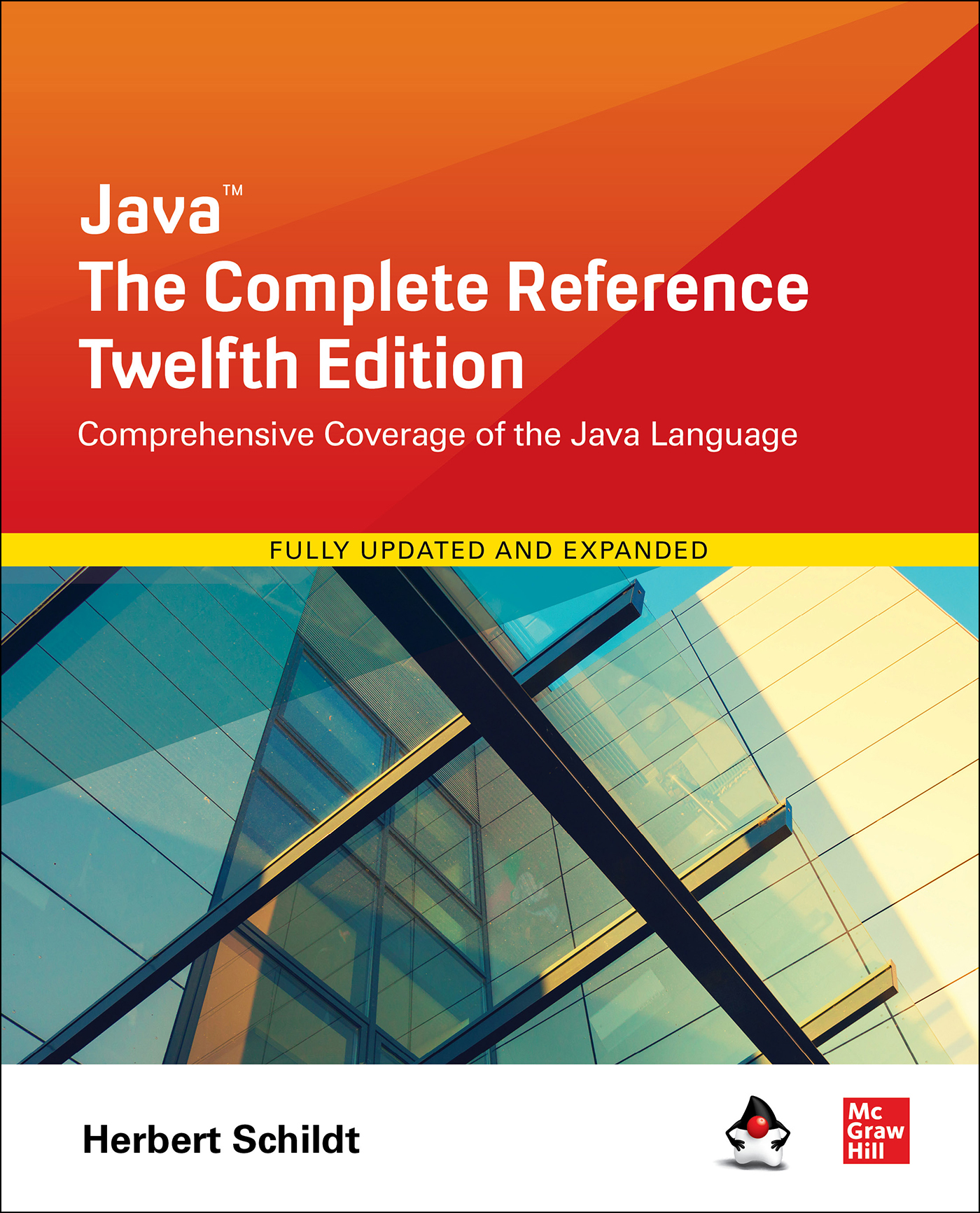

Best-selling author Herbert Schildt has written extensively about programming for over three decades and is a leading authority on the Java language. Called “one of the world’s foremost authors of books about programming” by International Developer magazine, his books have sold millions of copies worldwide and have been translated into all major foreign languages. He is the author of numerous books on Java, including Java: A Beginner’s Guide, Herb Schildt’s Java Programming Cookbook, Introducing JavaFX 8 Programming, and Swing: A Beginner’s Guide. He has also written extensively about C, C++, and C#. Featured as one of the rock star programmers in Ed Burns’ book Secrets of the Rock Star Programmers: Riding the IT Crest, Schildt is interested in all facets of computing, but his primary focus is computer languages. Schildt holds both BA and MCS degrees from the University of Illinois. His website is www.HerbSchildt.com.
Dr. Danny Coward has worked on all editions of the Java platform. He led the definition of Java Servlets into the first version of the Java EE platform and beyond, web services into the Java ME platform, and the strategy and planning for Java SE 7. He founded JavaFX technology and, most recently, designed the largest addition to the Java EE 7 standard, the Java WebSocket API. From coding in Java, to designing APIs with industry experts, to serving for several years as an executive to the Java Community Process, he has a uniquely broad perspective into multiple aspects of Java technology. In addition, he is the author of two books on Java programming: Java WebSocket Programming and Java EE 7: The Big Picture. Most recently, he has been applying his knowledge of Java to helping scale massive Java-based services for one of the world’s most successful software companies. Dr. Coward holds a bachelor’s, master’s, and doctorate in mathematics from the University of Oxford.
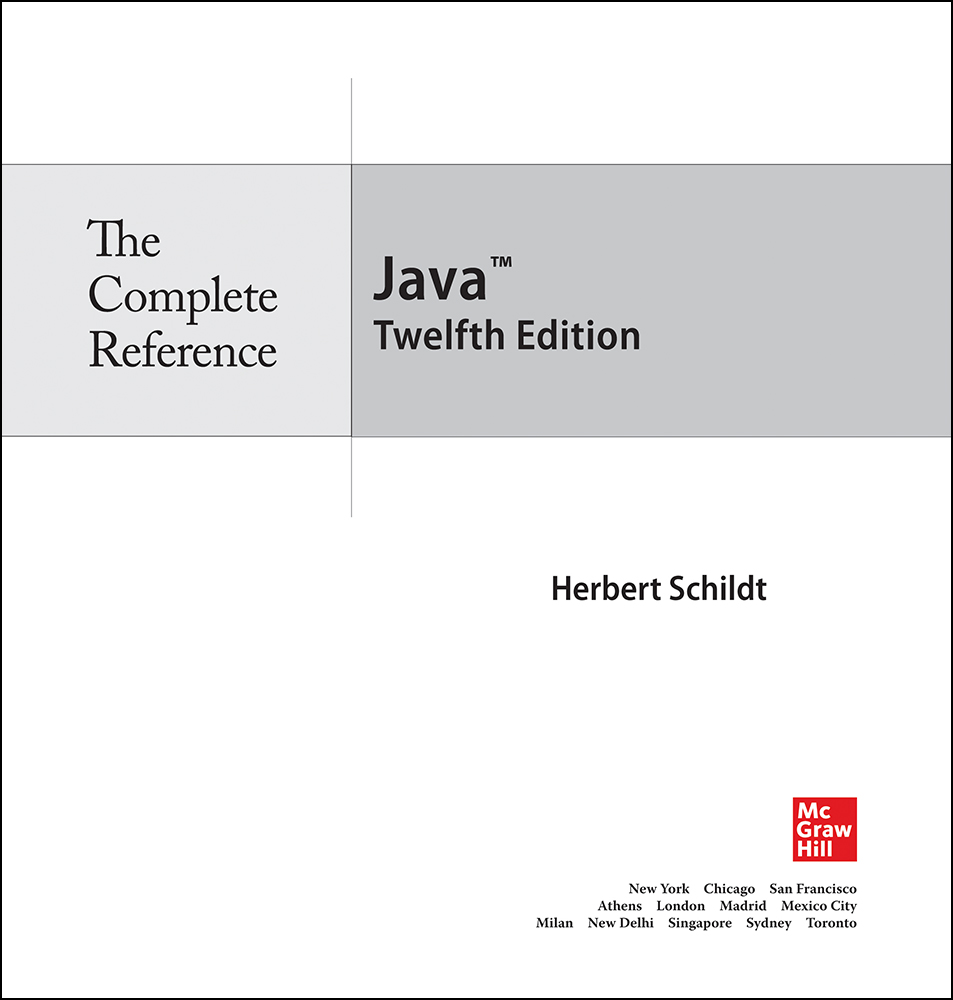
Copyright © 2022 by McGraw Hill. All rights reserved. Except as permitted under the United States Copyright Act of 1976, no part of this publication may be reproduced or distributed in any form or by any means, or stored in a database or retrieval system, without the prior written permission of the publisher.
ISBN: 978-1-26-046342-2
MHID: 1-26-046342-7
The material in this eBook also appears in the print version of this title: ISBN: 978-1-26-046341-5, MHID: 1-26-046341-9.
eBook conversion by codeMantra
Version 1.0
All trademarks are trademarks of their respective owners. Rather than put a trademark symbol after every occurrence of a trademarked name, we use names in an editorial fashion only, and to the benefit of the trademark owner, with no intention of infringement of the trademark. Where such designations appear in this book, they have been printed with initial caps.
McGraw-Hill Education eBooks are available at special quantity discounts to use as premiums and sales promotions or for use in corporate training programs. To contact a representative, please visit the Contact Us page at www.mhprofessional.com.
Information has been obtained by McGraw Hill from sources believed to be reliable. However, because of the possibility of human or mechanical error by our sources, McGraw Hill, or others, McGraw Hill does not guarantee the accuracy, adequacy, or completeness of any information and is not responsible for any errors or omissions or the results obtained from the use of such information.
Oracle Corporation does not make any representations or warranties as to the accuracy, adequacy, or completeness of any information contained in this Work, and is not responsible for any errors or omissions.
TERMS OF USE
This is a copyrighted work and McGraw-Hill Education and its licensors reserve all rights in and to the work. Use of this work is subject to these terms. Except as permitted under the Copyright Act of 1976 and the right to store and retrieve one copy of the work, you may not decompile, disassemble, reverse engineer, reproduce, modify, create derivative works based upon, transmit, distribute, disseminate, sell, publish or sublicense the work or any part of it without McGraw-Hill Education’s prior consent. You may use the work for your own noncommercial and personal use; any other use of the work is strictly prohibited. Your right to use the work may be terminated if you fail to comply with these terms.
THE WORK IS PROVIDED “AS IS.” McGRAW-HILL EDUCATION AND ITS LICENSORS MAKE NO GUARANTEES OR WARRANTIES AS TO THE ACCURACY, ADEQUACY OR COMPLETENESS OF OR RESULTS TO BE OBTAINED FROM USING THE WORK, INCLUDING ANY INFORMATION THAT CAN BE ACCESSED THROUGH THE WORK VIA HYPERLINK OR OTHERWISE, AND EXPRESSLY DISCLAIM ANY WARRANTY, EXPRESS OR IMPLIED, INCLUDING BUT NOT LIMITED TO IMPLIED WARRANTIES OF MERCHANTABILITY OR FITNESS FOR A PARTICULAR PURPOSE. McGraw-Hill Education and its licensors do not warrant or guarantee that the functions contained in the work will meet your requirements or that its operation will be uninterrupted or error free. Neither McGraw-Hill Education nor its licensors shall be liable to you or anyone else for any inaccuracy, error or omission, regardless of cause, in the work or for any damages resulting therefrom. McGraw-Hill Education has no responsibility for the content of any information accessed through the work. Under no circumstances shall McGraw-Hill Education and/or its licensors be liable for any indirect, incidental, special, punitive, consequential or similar damages that result from the use of or inability to use the work, even if any of them has been advised of the possibility of such damages. This limitation of liability shall apply to any claim or cause whatsoever whether such claim or cause arises in contract, tort or otherwise.
1 The History and Evolution of Java
3 Data Types, Variables, and Arrays
7 A Closer Look at Methods and Classes
12 Enumerations, Autoboxing, and Annotations
13 I/O, Try-with-Resources, and Other Topics
17 Switch Expressions, Records, and Other Recently Added Features
20 java.util Part 1: The Collections Framework
21 java.util Part 2: More Utility Classes
22 Input/Output: Exploring java.io
26 Introducing the AWT: Working with Windows, Graphics, and Text
27 Using AWT Controls, Layout Managers, and Menus
31 Regular Expressions and Other Packages
PART III Introducing GUI Programming with Swing
A Using Java’s Documentation Comments
Chapter 1 The History and Evolution of Java
The Birth of Modern Programming: C
How Java Impacted the Internet
Servlets: Java on the Server Side
Interpreted and High Performance
A Closer Look at the First Sample Program
Chapter 3 Data Types, Variables, and Arrays
Java Is a Strongly Typed Language
The Scope and Lifetime of Variables
Automatic Type Promotion in Expressions
Alternative Array Declaration Syntax
Introducing Type Inference with Local Variables
The Basic Arithmetic Operators
Arithmetic Compound Assignment Operators
Bitwise Operator Compound Assignments
Short-Circuit Logical Operators
The For-Each Version of the for Loop
Local Variable Type Inference in a for Loop
Assigning Object Reference Variables
Adding a Method to the Box Class
Adding a Method That Takes Parameters
Chapter 7 A Closer Look at Methods and Classes
A Closer Look at Argument Passing
Introducing Nested and Inner Classes
Varargs: Variable-Length Arguments
Local Variable Type Inference with Reference Types
A Superclass Variable Can Reference a Subclass Object
Using super to Call Superclass Constructors
Creating a Multilevel Hierarchy
When Constructors Are Executed
Using final to Prevent Overriding
Using final to Prevent Inheritance
Local Variable Type Inference and Inheritance
Chapter 9 Packages and Interfaces
Finding Packages and CLASSPATH
Use static Methods in an Interface
Final Thoughts on Packages and Interfaces
Exception-Handling Fundamentals
Displaying a Description of an Exception
Creating Your Own Exception Subclasses
Three Additional Exception Features
Chapter 11 Multithreaded Programming
The Thread Class and the Runnable Interface
Suspending, Resuming, and Stopping Threads
Using a Factory Method to Create and Start a Thread
Chapter 12 Enumerations, Autoboxing, and Annotations
The values( ) and valueOf( ) Methods
Java Enumerations Are Class Types
Autoboxing/Unboxing Occurs in Expressions
Autoboxing/Unboxing Boolean and Character Values
Autoboxing/Unboxing Helps Prevent Errors
Obtaining Annotations at Run Time by Use of Reflection
The AnnotatedElement Interface
Chapter 13 I/O, Try-with-Resources, and Other Topics
Byte Streams and Character Streams
The transient and volatile Modifiers
Assertion Enabling and Disabling Options
Invoking Overloaded Constructors Through this( )
A Word About Value-Based Classes
Generics Work Only with Reference Types
Generic Types Differ Based on Their Type Arguments
How Generics Improve Type Safety
A Generic Class with Two Type Parameters
The General Form of a Generic Class
Run-Time Type Comparisons Within a Generic Hierarchy
Overriding Methods in a Generic Class
Local Variable Type Inference and Generics
Type Parameters Can’t Be Instantiated
Restrictions on Static Members
Introducing Lambda Expressions
Lambda Expression Fundamentals
Some Lambda Expression Examples
Passing Lambda Expressions as Arguments
Lambda Expressions and Exceptions
Lambda Expressions and Variable Capture
Method References to static Methods
Method References to Instance Methods
Method References with Generics
Predefined Functional Interfaces
Compile and Run the First Module Example
A Closer Look at requires and exports
java.base and the Platform Modules
Legacy Code and the Unnamed Module
Exporting to a Specific Module
Service and Service Provider Basics
A Module-Based Service Example
Three Specialized Module Features
Introducing jlink and Module JAR Files
Linking Files in an Exploded Directory
A Brief Word About Layers and Automatic Modules
Chapter 17 Switch Expressions, Records, and Other Recently Added Features
Introducing the switch Expression and the yield Statement
Introducing the Arrow in a case Statement
A Closer Look at the Arrow case
Another switch Expression Example
Understanding Leading Whitespace
Use Double Quotes in a Text Block
Escape Sequences in Text Blocks
Another Record Constructor Example
Pattern Matching with instanceof
Pattern Variables in a Logical AND Expression
Pattern Matching in Other Statements
String Concatenation with Other Data Types
String Conversion and toString( )
equals( ) and equalsIgnoreCase( )
Data Conversion Using valueOf( )
Changing the Case of Characters Within a String
Additional StringBuffer Methods
Chapter 19 Exploring java.lang
Understanding isInfinite( ) and isNaN( )
Byte, Short, Integer, and Long
Additions to Character for Unicode Code Point Support
Using currentTimeMillis( ) to Time Program Execution
System.Logger and System.LoggerFinder
Using clone( ) and the Cloneable Interface
Thread, ThreadGroup, and Runnable
ThreadLocal and InheritableThreadLocal
StackWalker and StackWalker.StackFrame
The Thread.UncaughtExceptionHandler Interface
Chapter 20 java.util Part 1: The Collections Framework
Accessing a Collection via an Iterator
The For-Each Alternative to Iterators
Storing User-Defined Classes in Collections
The Legacy Classes and Interfaces
Parting Thoughts on Collections
Chapter 21 java.util Part 2: More Utility Classes
Optional, OptionalDouble, OptionalInt, and OptionalLong
Formatting Strings and Characters
Specifying a Minimum Field Width
The ResourceBundle, ListResourceBundle, and PropertyResourceBundle Classes
Miscellaneous Utility Classes and Interfaces
java.util.concurrent, java.util.concurrent.atomic, and java.util.concurrent.locks
Chapter 22 Input/Output: Exploring java.io
The I/O Classes and Interfaces
The AutoCloseable, Closeable, and Flushable Interfaces
DataOutputStream and DataInputStream
The FileSystem, FileSystems, and FileStore Classes
Use NIO for Path and File System Operations
The java.net Networking Classes and Interfaces
Things to Explore in java.net.http
The AdjustmentListener Interface
The ComponentListener Interface
The ContainerListener Interface
The MouseMotionListener Interface
The MouseWheelListener Interface
The WindowFocusListener Interface
Using the Delegation Event Model
Chapter 26 Introducing the AWT: Working with Windows, Graphics, and Text
Setting the Window’s Dimensions
Setting the Foreground and Background Colors
Creating a Frame-Based Application
Demonstrating the Drawing Methods
Setting the Current Graphics Color
Determining the Available Fonts
Managing Text Output Using FontMetrics
Chapter 27 Using AWT Controls, Layout Managers, and Menus
A Word About Overriding paint( )
Image Fundamentals: Creating, Loading, and Displaying
Chapter 29 The Concurrency Utilities
Parallel Programming via the Fork/Join Framework
The Divide-and-Conquer Strategy
A Simple First Fork/Join Example
Understanding the Impact of the Level of Parallelism
An Example that Uses RecursiveTask<V>
Executing a Task Asynchronously
Determining a Task’s Completion Status
The Concurrency Utilities Versus Java’s Traditional Approach
More to Explore in the Stream API
Chapter 31 Regular Expressions and Other Packages
Demonstrating Pattern Matching
Remote Method Invocation (RMI)
A Simple Client/Server Application Using RMI
Formatting Date and Time with java.text
The java.time Time and Date API
Other Things to Explore in java.time
Part III Introducing GUI Programming with Swing
Swing Components Are Lightweight
Swing Supports a Pluggable Look and Feel
Chapter 34 Introducing Swing Menus
An Overview of JMenuBar, JMenu, and JMenuItem
Add Mnemonics and Accelerators to Menu Items
Add Images and Tooltips to Menu Items
Use JRadioButtonMenuItem and JCheckBoxMenuItem
Put the Entire MenuDemo Program Together
Continuing Your Exploration of Swing
Design Patterns for Properties
Bound and Constrained Properties
Chapter 36 Introducing Servlets
Create and Compile the Servlet Source Code
Start a Web Browser and Request the Servlet
The jakarta.servlet.http Package
The HttpServletRequest Interface
The HttpServletResponse Interface
Handling HTTP Requests and Responses
Appendix A Using Java’s Documentation Comments
The General Form of a Documentation Comment
An Example that Uses Documentation Comments
Evaluate Expressions and Use Built-in Variables
Appendix C Compile and Run Simple Single-File Programs in One Step
Java is one of the world’s most important and widely used computer languages. Furthermore, it has held that distinction for many years. Unlike some other computer languages whose influence has waned with the passage of time, Java’s has grown stronger.
Java leapt to the forefront of Internet programming with its first release. Each subsequent version has solidified that position. Today, it is still the first and best choice for developing web-based applications. It is also a powerful, general-purpose programming language suitable for a wide variety of purposes. Simply put: much of the modern world runs on Java code. Java really is that important.
A key reason for Java’s success is its agility. Since its original 1.0 release, Java has continually adapted to changes in the programming environment and to changes in the way that programmers program. Most importantly, it has not just followed the trends, it has helped create them. Java’s ability to accommodate the fast rate of change in the computing world is a crucial part of why it has been and continues to be so successful.
Since this book was first published in 1996, it has gone through several editions, each reflecting the ongoing evolution of Java. This is the twelfth edition, and it has been updated for Java SE 17 (JDK 17). As a result, this edition of the book contains a substantial amount of new material, updates, and changes. Of special interest are the discussions of the following key features that have been added to the Java language since the previous edition of this book:
• Enhancements to switch
• Records
• Pattern matching with instanceof
• Sealed classes and interfaces
• Text blocks
Collectively, these constitute a substantial set of new features that significantly expand the range, scope, and expressiveness of the language. The switch enhancements add power and flexibility to this foundational control statement. The inclusion of records offers an efficient way to aggregate data. The addition of pattern matching to instanceof enables a more streamlined and resilient approach to a common programming task. Sealed classes and interfaces give you fine-grained control over inheritance. Text blocks let you enter multiline string literals, greatly simplifying the process of inserting such strings into your source code. Collectively, these new features fundamentally expand the ways in which you can design and implement solutions.
This book is for all programmers, whether you are a novice or an experienced pro. The beginner will find its carefully paced discussions and many examples especially helpful. Its in-depth coverage of Java’s more advanced features and libraries will appeal to the pro. For both, it offers a lasting resource and handy reference.
This book is a comprehensive guide to the Java language, describing its syntax, keywords, and fundamental programming principles. Significant portions of the Java API library are also examined. The book is divided into four parts, each focusing on a different aspect of the Java programming environment.
Part I presents an in-depth tutorial of the Java language. It begins with the basics, including such things as data types, operators, control statements, and classes. It then moves on to inheritance, packages, interfaces, exception handling, and multithreading. Next, it describes annotations, enumerations, autoboxing, generics, modules, and lambda expressions. I/O is also introduced. The final chapter in Part I covers several recently added features: records, sealed classes and interfaces, the enhanced switch, pattern matching with instanceof, and text blocks.
Part II examines key aspects of Java’s standard API library. Topics include strings, I/O, networking, the standard utilities, the Collections Framework, the AWT, event handling, imaging, concurrency (including the Fork/Join Framework), regular expressions, and the stream library.
Part III offers three chapters that introduce Swing.
Part IV contains two chapters that show examples of Java in action. The first discusses Java Beans. The second presents an introduction to servlets.
I want to give special thanks to Patrick Naughton, Joe O’Neil, and Danny Coward.
Patrick Naughton was one of the creators of the Java language. He also helped write the first edition of this book. For example, among many other contributions, much of the material in Chapters 22, 24, and 28 was initially provided by Patrick. His insights, expertise, and energy contributed greatly to the success of that book.
During the preparation of the second and third editions of this book, Joe O’Neil provided initial drafts for the material now found in Chapters 31, 33, 35, and 36 of this edition. Joe helped on several of my books, and his input has always been top-notch.
Danny Coward is the technical editor for this edition of the book. Danny has worked on several of my books, and his advice, insights, and suggestions have always been of great value and much appreciated.
I also want to thank my wife Sherry for all of her contributions to this book, and to my other books as well. Her thoughtful advice, proofreading, and indexing have always contributed greatly to a successful outcome of each project.
HERBERT SCHILDT
Java: The Complete Reference is your gateway to the Herb Schildt series of Java programming books. Here are others that you will find of interest:
Herb Schildt’s Java Programming Cookbook
Java: A Beginner’s Guide
Introducing JavaFX 8 Programming
Swing: A Beginner’s Guide
The Art of Java
To fully understand Java, one must understand the reasons behind its creation, the forces that shaped it, and the legacy that it inherits. Like the successful computer languages that came before, Java is a blend of the best elements of its rich heritage combined with the innovative concepts required by its unique mission. While the remaining chapters of this book describe the practical aspects of Java—including its syntax, key libraries, and applications—this chapter explains how and why Java came about, what makes it so important, and how it has evolved over the years.
Although Java has become inseparably linked with the online environment of the Internet, it is important to remember that Java is first and foremost a programming language. Computer language innovation and development occur for two fundamental reasons:
• To adapt to changing environments and uses
• To implement refinements and improvements in the art of programming
As you will see, the development of Java was driven by both elements in nearly equal measure.
Java is related to C++, which is a direct descendant of C. Much of the character of Java is inherited from these two languages. From C, Java derives its syntax. Many of Java’s object-oriented features were influenced by C++. In fact, several of Java’s defining characteristics come from—or are responses to—its predecessors. Moreover, the creation of Java was deeply rooted in the process of refinement and adaptation that has been occurring in computer programming languages for the past several decades. For these reasons, this section reviews the sequence of events and forces that led to Java. As you will see, each innovation in language design was driven by the need to solve a fundamental problem that the preceding languages could not solve. Java is no exception.
The C language shook the computer world. Its impact should not be underestimated, because it fundamentally changed the way programming was approached and thought about. The creation of C was a direct result of the need for a structured, efficient, high-level language that could replace assembly code when creating systems programs. As you may know, when a computer language is designed, trade-offs are often made, such as the following:
• Ease-of-use versus power
• Safety versus efficiency
• Rigidity versus extensibility
Prior to C, programmers usually had to choose between languages that optimized one set of traits or the other. For example, although FORTRAN could be used to write fairly efficient programs for scientific applications, it was not very good for system code. And while BASIC was easy to learn, it wasn’t very powerful, and its lack of structure made its usefulness questionable for large programs. Assembly language can be used to produce highly efficient programs, but it is not easy to learn or use effectively. Further, debugging assembly code can be quite difficult.
Another compounding problem was that early computer languages such as BASIC, COBOL, and FORTRAN were not designed around structured principles. Instead, they relied upon the GOTO as a primary means of program control. As a result, programs written using these languages tended to produce “spaghetti code”—a mass of tangled jumps and conditional branches that make a program virtually impossible to understand. While languages like Pascal are structured, they were not designed for efficiency, and failed to include certain features necessary to make them applicable to a wide range of programs. (Specifically, given the standard dialects of Pascal available at the time, it was not practical to consider using Pascal for systems-level code.)
So, just prior to the invention of C, no one language had reconciled the conflicting attributes that had dogged earlier efforts. Yet the need for such a language was pressing. By the early 1970s, the computer revolution was beginning to take hold, and the demand for software was rapidly outpacing programmers’ ability to produce it. A great deal of effort was being expended in academic circles in an attempt to create a better computer language. But, and perhaps most importantly, a secondary force was beginning to be felt. Computer hardware was finally becoming common enough that a critical mass was being reached. No longer were computers kept behind locked doors. For the first time, programmers were gaining virtually unlimited access to their machines. This allowed the freedom to experiment. It also allowed programmers to begin to create their own tools. On the eve of C’s creation, the stage was set for a quantum leap forward in computer languages.
Invented and first implemented by Dennis Ritchie on a DEC PDP-11 running the UNIX operating system, C was the result of a development process that started with an older language called BCPL, developed by Martin Richards. BCPL influenced a language called B, invented by Ken Thompson, which led to the development of C in the 1970s. For many years, the de facto standard for C was the one supplied with the UNIX operating system and described in The C Programming Language by Brian Kernighan and Dennis Ritchie (Prentice-Hall, 1978). C was formally standardized in December 1989, when the American National Standards Institute (ANSI) standard for C was adopted.
The creation of C is considered by many to have marked the beginning of the modern age of computer languages. It successfully synthesized the conflicting attributes that had so troubled earlier languages. The result was a powerful, efficient, structured language that was relatively easy to learn. It also included one other, nearly intangible aspect: it was a programmer’s language. Prior to the invention of C, computer languages were generally designed either as academic exercises or by bureaucratic committees. C is different. It was designed, implemented, and developed by real, working programmers, reflecting the way that they approached the job of programming. Its features were honed, tested, thought about, and rethought by the people who actually used the language. The result was a language that programmers liked to use. Indeed, C quickly attracted many followers who had a near-religious zeal for it. As such, it found wide and rapid acceptance in the programmer community. In short, C is a language designed by and for programmers. As you will see, Java inherited this legacy.
During the late 1970s and early 1980s, C became the dominant computer programming language, and it is still widely used today. Since C is a successful and useful language, you might ask why a need for something else existed. The answer is complexity. Throughout the history of programming, the increasing complexity of programs has driven the need for better ways to manage that complexity. C++ is a response to that need. To better understand why managing program complexity is fundamental to the creation of C++, consider the following.
Approaches to programming have changed dramatically since the invention of the computer. For example, when computers were first invented, programming was done by manually toggling in the binary machine instructions by use of the front panel. As long as programs were just a few hundred instructions long, this approach worked. As programs grew, assembly language was invented so that a programmer could deal with larger, increasingly complex programs by using symbolic representations of the machine instructions. As programs continued to grow, high-level languages were introduced that gave the programmer more tools with which to handle complexity.
The first widespread language was, of course, FORTRAN. While FORTRAN was an impressive first step, at the time it was hardly a language that encouraged clear and easy-to-understand programs. The 1960s gave birth to structured programming. This is the method of programming championed by languages such as C. The use of structured languages enabled programmers to write, for the first time, moderately complex programs fairly easily. However, even with structured programming methods, once a project reaches a certain size, its complexity exceeds what a programmer can manage. By the early 1980s, many projects were pushing the structured approach past its limits. To solve this problem, a new way to program was invented, called object-oriented programming (OOP). Object-oriented programming is discussed in detail later in this book, but here is a brief definition: OOP is a programming methodology that helps organize complex programs through the use of inheritance, encapsulation, and polymorphism.
In the final analysis, although C is one of the world’s great programming languages, there is a limit to its ability to handle complexity. Once the size of a program exceeds a certain point, it becomes so complex that it is difficult to grasp as a totality. While the precise size at which this occurs differs, depending upon both the nature of the program and the programmer, there is always a threshold at which a program becomes unmanageable. C++ added features that enabled this threshold to be broken, allowing programmers to comprehend and manage larger programs.
C++ was invented by Bjarne Stroustrup in 1979, while he was working at Bell Laboratories in Murray Hill, New Jersey. Stroustrup initially called the new language “C with Classes.” However, in 1983, the name was changed to C++. C++ extends C by adding object-oriented features. Because C++ is built on the foundation of C, it includes all of C’s features, attributes, and benefits. This is a crucial reason for the success of C++ as a language. The invention of C++ was not an attempt to create a completely new programming language. Instead, it was an enhancement to an already highly successful one.
By the end of the 1980s and the early 1990s, object-oriented programming using C++ took hold. Indeed, for a brief moment it seemed as if programmers had finally found the perfect language. Because C++ blended the high efficiency and stylistic elements of C with the object-oriented paradigm, it was a language that could be used to create a wide range of programs. However, just as in the past, forces were brewing that would, once again, drive computer language evolution forward. Within a few years, the World Wide Web and the Internet would reach critical mass. This event would precipitate another revolution in programming.
Java was conceived by James Gosling, Patrick Naughton, Chris Warth, Ed Frank, and Mike Sheridan at Sun Microsystems, Inc. in 1991. It took 18 months to develop the first working version. This language was initially called “Oak,” but was renamed “Java” in 1995. Between the initial implementation of Oak in the fall of 1992 and the public announcement of Java in the spring of 1995, many more people contributed to the design and evolution of the language. Bill Joy, Arthur van Hoff, Jonathan Payne, Frank Yellin, and Tim Lindholm were key contributors to the maturing of the original prototype.
Somewhat surprisingly, the original impetus for Java was not the Internet! Instead, the primary motivation was the need for a platform-independent (that is, architecture-neutral) language that could be used to create software to be embedded in various consumer electronic devices, such as microwave ovens and remote controls. As you can probably guess, many different types of CPUs are used as controllers. The trouble with C and C++ (and most other languages at the time) is that they are designed to be compiled for a specific target. Although it is possible to compile a C++ program for just about any type of CPU, to do so requires a full C++ compiler targeted for that CPU. The problem is that compilers are expensive and time-consuming to create. An easier—and more cost-efficient—solution was needed. In an attempt to find such a solution, Gosling and others began work on a portable, platform-independent language that could be used to produce code that would run on a variety of CPUs under differing environments. This effort ultimately led to the creation of Java.
About the time that the details of Java were being worked out, a second, and ultimately more important, factor was emerging that would play a crucial role in the future of Java. This second force was, of course, the World Wide Web. Had the Web not taken shape at about the same time that Java was being implemented, Java might have remained a useful but obscure language for programming consumer electronics. However, with the emergence of the World Wide Web, Java was propelled to the forefront of computer language design, because the Web, too, demanded portable programs.
Most programmers learn early in their careers that portable programs are as elusive as they are desirable. While the quest for a way to create efficient, portable (platform-independent) programs is nearly as old as the discipline of programming itself, it had taken a back seat to other, more pressing problems. Further, because (at that time) much of the computer world had divided itself into the three competing camps of Intel, Macintosh, and UNIX, most programmers stayed within their fortified boundaries, and the urgent need for portable code was reduced. However, with the advent of the Internet and the Web, the old problem of portability returned with a vengeance. After all, the Internet consists of a diverse, distributed universe populated with various types of computers, operating systems, and CPUs. Even though many kinds of platforms are attached to the Internet, users would like them all to be able to run the same program. What was once an irritating but low-priority problem had become a high-profile necessity.
By 1993, it became obvious to members of the Java design team that the problems of portability frequently encountered when creating code for embedded controllers are also found when attempting to create code for the Internet. In fact, the same problem that Java was initially designed to solve on a small scale could also be applied to the Internet on a large scale. This realization caused the focus of Java to switch from consumer electronics to Internet programming. So, while the desire for an architecture-neutral programming language provided the initial spark, the Internet ultimately led to Java’s large-scale success.
As mentioned earlier, Java derives much of its character from C and C++. This is by intent. The Java designers knew that using the familiar syntax of C and echoing the object-oriented features of C++ would make their language appealing to the legions of experienced C/C++ programmers. In addition to the surface similarities, Java shares some of the other attributes that helped make C and C++ successful. First, Java was designed, tested, and refined by real, working programmers. It is a language grounded in the needs and experiences of the people who devised it. Thus, Java is a programmer’s language. Second, Java is cohesive and logically consistent. Third, except for those constraints imposed by the Internet environment, Java gives you, the programmer, full control. If you program well, your programs reflect it. If you program poorly, your programs reflect that, too. Put differently, Java is not a language with training wheels. It is a language for professional programmers.
Because of the similarities between Java and C++, it is tempting to think of Java as simply the “Internet version of C++.” However, to do so would be a large mistake. Java has significant practical and philosophical differences. While it is true that Java was influenced by C++, it is not an enhanced version of C++. For example, Java is neither upwardly nor downwardly compatible with C++. Of course, the similarities with C++ are significant, and if you are a C++ programmer, then you will feel right at home with Java. One other point: Java was not designed to replace C++. Java was designed to solve a certain set of problems. C++ was designed to solve a different set of problems. Both will coexist for many years to come.
As mentioned at the start of this chapter, computer languages evolve for two reasons: to adapt to changes in environment and to implement advances in the art of programming. The environmental change that prompted Java was the need for platform-independent programs destined for distribution on the Internet. However, Java also embodies changes in the way that people approach the writing of programs. For example, Java enhanced and refined the object-oriented paradigm used by C++, added integrated support for multithreading, and provided a library that simplified Internet access. In the final analysis, though, it was not the individual features of Java that made it so remarkable. Rather, it was the language as a whole. Java was the perfect response to the demands of the then newly emerging, highly distributed computing universe. Java was to Internet programming what C was to system programming: a revolutionary force that changed the world.
The reach and power of Java continues to be felt throughout the world of computer language development. Many of its innovative features, constructs, and concepts have become part of the baseline for any new language. The success of Java is simply too important to ignore.
Perhaps the most important example of Java’s influence is C#. Created by Microsoft to support the .NET Framework, C# is closely related to Java. For example, both share the same general syntax, support distributed programming, and utilize the same object model. There are, of course, differences between Java and C#, but the overall “look and feel” of these languages is very similar. This “cross-pollination” from Java to C# is the strongest testimonial to date that Java redefined the way we think about and use a computer language.
The Internet helped catapult Java to the forefront of programming, and Java, in turn, had a profound effect on the Internet. In addition to simplifying web programming in general, Java innovated a new type of networked program called the applet that changed the way the online world thought about content. Java also addressed some of the thorniest issues associated with the Internet: portability and security. Let’s look more closely at each of these.
At the time of Java’s creation, one of its most exciting features was the applet. An applet is a special kind of Java program that is designed to be transmitted over the Internet and automatically executed inside a Java-compatible web browser. If the user clicks a link that contains an applet, the applet will download and run in the browser. Applets were intended to be small programs. They were typically used to display data provided by the server, handle user input, or provide simple functions, such as a loan calculator, that execute locally, rather than on the server. In essence, the applet allowed some functionality to be moved from the server to the client.
The creation of the applet was important because, at the time, it expanded the universe of objects that could move about freely in cyberspace. In general, there are two very broad categories of objects that are transmitted between the server and the client: passive information and dynamic, active programs. For example, when you read your e-mail, you are viewing passive data. Even when you download a program, the program’s code is still only passive data until you execute it. By contrast, the applet is a dynamic, self-executing program. Such a program is an active agent on the client computer, yet it is initiated by the server.
In the early days of Java, applets were a crucial part of Java programming. They illustrated the power and benefits of Java, added an exciting dimension to web pages, and enabled programmers to explore the full extent of what was possible with Java. Although it is likely that there are still applets in use today, over time they became less important. For reasons that will be explained, beginning with JDK 9, the phase-out of applets began, with applet support being removed by JDK 11.
As desirable as dynamic, networked programs are, they can also present serious problems in the areas of security and portability. Obviously, a program that downloads and executes on the client computer must be prevented from doing harm. It must also be able to run in a variety of different environments and under different operating systems. As you will see, Java solved these problems in an effective and elegant way. Let’s look a bit more closely at each, beginning with security.
As you are likely aware, every time you download a “normal” program, you are taking a risk, because the code you are downloading might contain a virus, Trojan horse, or other harmful code. At the core of the problem is the fact that malicious code can cause its damage because it has gained unauthorized access to system resources. For example, a virus program might gather private information, such as credit card numbers, bank account balances, and passwords, by searching the contents of your computer’s local file system. In order for Java to enable programs to be safely downloaded and executed on the client computer, it was necessary to prevent them from launching such an attack.
Java achieved this protection by enabling you to confine an application to the Java execution environment and prevent it from accessing other parts of the computer. (You will see how this is accomplished shortly.) The ability to download programs with a degree of confidence that no harm will be done may have been the single most innovative aspect of Java.
Portability is a major aspect of the Internet because there are many different types of computers and operating systems connected to it. If a Java program were to be run on virtually any computer connected to the Internet, there needed to be some way to enable that program to execute on different systems. In other words, a mechanism that allows the same application to be downloaded and executed by a wide variety of CPUs, operating systems, and browsers is required. It is not practical to have different versions of the application for different computers. The same application code must work on all computers. Therefore, some means of generating portable executable code was needed. As you will soon see, the same mechanism that helps ensure security also helps create portability.
The key that allowed Java to solve both the security and the portability problems just described is that the output of a Java compiler is not executable code. Rather, it is bytecode. Bytecode is a highly optimized set of instructions designed to be executed by what is called the Java Virtual Machine (JVM), which is part of the Java Runtime Environment (JRE). In essence, the original JVM was designed as an interpreter for bytecode. This may come as a bit of a surprise since many modern languages are designed to be compiled into executable code because of performance concerns. However, the fact that a Java program is executed by the JVM helps solve the major problems associated with web-based programs. Here is why.
Translating a Java program into bytecode makes it much easier to run a program in a wide variety of environments because only the JVM needs to be implemented for each platform. Once a JRE exists for a given system, any Java program can run on it. Remember, although the details of the JVM will differ from platform to platform, all understand the same Java bytecode. If a Java program were compiled to native code, then different versions of the same program would have to exist for each type of CPU connected to the Internet. This is, of course, not a feasible solution. Thus, the execution of bytecode by the JVM is the easiest way to create truly portable programs.
The fact that a Java program is executed by the JVM also helps to make it secure. Because the JVM is in control, it manages program execution. Thus, it is possible for the JVM to create a restricted execution environment, called the sandbox, that contains the program, preventing unrestricted access to the machine. Safety is also enhanced by certain restrictions that exist in the Java language.
In general, when a program is compiled to an intermediate form and then interpreted by a virtual machine, it runs slower than it would run if compiled to executable code. However, with Java, the differential between the two is not so great. Because bytecode has been highly optimized, the use of bytecode enables the JVM to execute programs much faster than you might expect.
Although Java was designed as an interpreted language, there is nothing about Java that prevents on-the-fly compilation of bytecode into native code in order to boost performance. For this reason, the HotSpot technology was introduced not long after Java’s initial release. HotSpot provides a Just-In-Time (JIT) compiler for bytecode. When a JIT compiler is part of the JVM, selected portions of bytecode are compiled into executable code in real time, on a piece-by-piece, demand basis. It is important to understand that an entire Java program is not compiled into executable code all at once. Instead, a JIT compiler compiles code as it is needed, during execution. Furthermore, not all sequences of bytecode are compiled—only those that will benefit from compilation. The remaining code is simply interpreted. However, the just-in-time approach still yields a significant performance boost. Even when dynamic compilation is applied to bytecode, the portability and safety features still apply, because the JVM is still in charge of the execution environment.
One other point: There has been experimentation with an ahead-of-time compiler for Java. Such a compiler can be used to compile bytecode into native code prior to execution by the JVM, rather than on-the-fly. Some previous versions of the JDK supplied an experimental ahead-of-time compiler; however, JDK 17 has removed it. Ahead-of-time compilation is a specialized feature, and it does not replace Java’s traditional approach just described. Because of the highly specialized nature of ahead-of-time compilation, it is not discussed further in this book.
At the time of this writing, it has been more than two decades since Java’s original release. Over those years, many changes have taken place. At the time of Java’s creation, the Internet was a new and exciting innovation; web browsers were undergoing rapid development and refinement; the modern form of the smart phone had not yet been invented; and the near ubiquitous use of computers was still a few years off. As you would expect, Java has also changed and so, too, has the way that Java is used. Perhaps nothing illustrates the ongoing evolution of Java better than the applet.
As explained previously, in the early years of Java, applets were a crucial part of Java programming. They not only added excitement to a web page, they were also a highly visible part of Java, which added to its charisma. However, applets rely on a Java browser plug-in. Thus, for an applet to work, the browser must support it. Over the past few years, support for the Java browser plug-in has been waning. Simply put, without browser support, applets are not viable. Because of this, beginning with JDK 9, the phase-out of applets was begun, with support for applets being deprecated. In the language of Java, deprecated means that a feature is still available but flagged as obsolete. Thus, a deprecated feature should not be used for new code. The phase-out became complete with the release of JDK 11 because run-time support for applets was removed. Beginning with JDK 17, the entire Applet API was deprecated for removal.
As a point of interest, a few years after Java’s creation an alternative to applets was added to Java. Called Java Web Start, it enabled an application to be dynamically downloaded from a web page. It was a deployment mechanism that was especially useful for larger Java applications that were not appropriate for applets. The difference between an applet and a Web Start application is that a Web Start application runs on its own, not inside the browser. Thus, it looks much like a “normal” application. It does, however, require that a stand-alone JRE that supports Web Start is available on the host system. Beginning with JDK 11, Java Web Start support has been removed.
Given that neither applets nor Java Web Start are supported by modern versions of Java, you might wonder what mechanism should be used to deploy a Java application. At the time of this writing, part of the answer is to use the jlink tool added by JDK 9. It can create a complete run-time image that includes all necessary support for your program, including the JRE. Another part of the answer is the jpackage tool. Added by JDK 16, it can be used to create a ready-to-install application. Although a detailed discussion of deployment strategies is outside the scope of this book, it is something that you will want to pay close attention to going forward.
Another major change has recently occurred in Java, but it does not involve changes to the language or the run-time environment. Rather, it relates to the way that Java releases are scheduled. In the past, major Java releases were typically separated by two or more years. However, subsequent to the release of JDK 9, the time between major Java releases has been decreased. Today, it is anticipated that a major release will occur on a strict time-based schedule, with the expected time between such releases being just six months.
Each six-month release, now called a feature release, will include those features ready at the time of the release. This increased release cadence enables new features and enhancements to be available to Java programmers in a timely fashion. Furthermore, it allows Java to respond quickly to the demands of an ever-changing programming environment. Simply put, the faster release schedule promises to be a very positive development for Java programmers.
At three-year intervals, it is anticipated that a long-term support (LTS) release will take place. An LTS release will be supported (and thus remain viable) for a period of time longer than six months. The first LTS release was JDK 11. The second LTS release was JDK 17, for which this book has been updated. Because of the stability that an LTS release offers, it is likely that its feature set will define a baseline of functionality for a number of years. Consult Oracle for the latest information concerning long-term support and the LTS release schedule.
Currently, feature releases are scheduled for March and September of each year. As a result, JDK 10 was released in March 2018, which was six months after the release of JDK 9. The next release (JDK 11) was in September 2018. JDK 11 was an LTS release. This was followed by JDK 12 In March 2019, JDK 13 in September 2019, and so on. At the time of this writing, the latest release is JDK 17, which is an LTS release. Again, it is anticipated that every six months a new feature release will take place. Of course, you will want to consult the latest release schedule information.
At the time of this writing, there are a number of new Java features on the horizon. Because of the faster release schedule, it is very likely that several of them will be added to Java over the next few years. You will want to review the information and release notes provided by each six-month release in detail. It is truly an exciting time to be a Java programmer!
Client side code is just one half of the client/server equation. Not long after the initial release of Java, it became obvious that Java would also be useful on the server side. One result was the servlet. A servlet is a small program that executes on the server.
Servlets are used to create dynamically generated content that is then served to the client. For example, an online store might use a servlet to look up the price for an item in a database. The price information is then used to dynamically generate a web page that is sent to the browser. Although dynamically generated content was available through mechanisms such as CGI (Common Gateway Interface), the servlet offered several advantages, including increased performance.
Because servlets (like all Java programs) are compiled into bytecode and executed by the JVM, they are highly portable. Thus, the same servlet can be used in a variety of different server environments. The only requirements are that the server support the JVM and a servlet container. Today, server-side code in general constitutes a major use of Java.
No discussion of Java’s history is complete without a look at the Java buzzwords. Although the fundamental forces that necessitated the invention of Java are portability and security, other factors also played an important role in molding the final form of the language. The key considerations were summed up by the Java team in the following list of buzzwords:
• Simple
• Secure
• Portable
• Object-oriented
• Robust
• Multithreaded
• Architecture-neutral
• Interpreted
• High performance
• Distributed
• Dynamic
Two of these buzzwords have already been discussed: secure and portable. Let’s examine what each of the others implies.
Java was designed to be easy for the professional programmer to learn and use effectively. Assuming that you have some programming experience, you will not find Java hard to master. If you already understand the basic concepts of object-oriented programming, learning Java will be even easier. Best of all, if you are an experienced C++ programmer, moving to Java will require very little effort. Because Java inherits the C/C++ syntax and many of the object-oriented features of C++, most programmers have little trouble learning Java.
Although influenced by its predecessors, Java was not designed to be source-code compatible with any other language. This allowed the Java team the freedom to design with a blank slate. One outcome of this was a clean, usable, pragmatic approach to objects. Borrowing liberally from many seminal object-software environments of the last few decades, Java managed to strike a balance between the purist’s “everything is an object” paradigm and the pragmatist’s “stay out of my way” model. The object model in Java is simple and easy to extend, while primitive types, such as integers, were kept as high-performance nonobjects.
The multiplatformed environment of the Web places extraordinary demands on a program, because the program must execute reliably in a variety of systems. Thus, the ability to create robust programs was given a high priority in the design of Java. To gain reliability, Java restricts you in a few key areas to force you to find your mistakes early in program development. At the same time, Java frees you from having to worry about many of the most common causes of programming errors. Because Java is a strictly typed language, it checks your code at compile time. However, it also checks your code at run time. Many hard-to-track-down bugs that often turn up in hard-to-reproduce run-time situations are simply impossible to create in Java. Knowing that what you have written will behave in a predictable way under diverse conditions is a key feature of Java.
To better understand how Java is robust, consider two of the main reasons for program failure: memory management mistakes and mishandled exceptional conditions (that is, run-time errors). Memory management can be a difficult, tedious task in traditional programming environments. For example, in C/C++, the programmer will often manually allocate and free dynamic memory. This sometimes leads to problems, because programmers will either forget to free memory that has been previously allocated or, worse, try to free some memory that another part of their code is still using. Java virtually eliminates these problems by managing memory allocation and deallocation for you. (In fact, deallocation is completely automatic, because Java provides garbage collection for unused objects.) Exceptional conditions in traditional environments often arise in situations such as division by zero or “file not found,” and they must be managed with clumsy and hard-to-read constructs. Java helps in this area by providing object-oriented exception handling. In a well-written Java program, all run-time errors can—and should—be managed by your program.
Java was designed to meet the real-world requirement of creating interactive, networked programs. To accomplish this, Java supports multithreaded programming, which allows you to write programs that do many things simultaneously. The Java run-time system comes with an elegant yet sophisticated solution for multiprocess synchronization that enables you to construct smoothly running interactive systems. Java’s easy-to-use approach to multithreading allows you to think about the specific behavior of your program, not the multitasking subsystem.
A central issue for the Java designers was that of code longevity and portability. At the time of Java’s creation, one of the main problems facing programmers was that no guarantee existed that if you wrote a program today, it would run tomorrow—even on the same machine. Operating system upgrades, processor upgrades, and changes in core system resources can all combine to make a program malfunction. The Java designers made several hard decisions in the Java language and the Java Virtual Machine in an attempt to alter this situation. Their goal was “write once; run anywhere, any time, forever.” To a great extent, this goal was accomplished.
As described earlier, Java enables the creation of cross-platform programs by compiling into an intermediate representation called Java bytecode. This code can be executed on any system that implements the Java Virtual Machine. Most previous attempts at cross-platform solutions have done so at the expense of performance. As explained earlier, the Java bytecode was carefully designed so that it would be easy to translate directly into native machine code for very high performance by using a just-in-time compiler. Java run-time systems that provide this feature lose none of the benefits of the platform-independent code.
Java is designed for the distributed environment of the Internet because it handles TCP/IP protocols. In fact, accessing a resource using a URL is not much different from accessing a file. Java also supports Remote Method Invocation (RMI). This feature enables a program to invoke methods across a network.
Java programs carry with them substantial amounts of run-time type information that is used to verify and resolve accesses to objects at run time. This makes it possible to dynamically link code in a safe and expedient manner. This is crucial to the robustness of the Java environment, in which small fragments of bytecode may be dynamically updated on a running system.
The initial release of Java was nothing short of revolutionary, but it did not mark the end of Java’s era of rapid innovation. Unlike most other software systems that usually settle into a pattern of small, incremental improvements, Java continued to evolve at an explosive pace. Soon after the release of Java 1.0, the designers of Java had already created Java 1.1. The features added by Java 1.1 were more significant and substantial than the increase in the minor revision number would have you think. Java 1.1 added many new library elements, redefined the way events are handled, and reconfigured many features of the 1.0 library. It also deprecated (rendered obsolete) several features originally defined by Java 1.0. Thus, Java 1.1 both added to and subtracted from attributes of its original specification.
The next major release of Java was Java 2, where the “2” indicates “second generation.” The creation of Java 2 was a watershed event, marking the beginning of Java’s “modern age.” The first release of Java 2 carried the version number 1.2. It may seem odd that the first release of Java 2 used the 1.2 version number. The reason is that it originally referred to the internal version number of the Java libraries, but then was generalized to refer to the entire release. With Java 2, Sun repackaged the Java product as J2SE (Java 2 Platform Standard Edition), and the version numbers began to be applied to that product.
Java 2 added support for a number of new features, such as Swing and the Collections Framework, and it enhanced the Java Virtual Machine and various programming tools. Java 2 also contained a few deprecations. The most important affected the Thread class in which the methods suspend( ), resume( ), and stop( ) were deprecated.
J2SE 1.3 was the first major upgrade to the original Java 2 release. For the most part, it added to existing functionality and “tightened up” the development environment. In general, programs written for version 1.2 and those written for version 1.3 are source-code compatible. Although version 1.3 contained a smaller set of changes than the preceding three major releases, it was nevertheless important.
The release of J2SE 1.4 further enhanced Java. This release contained several important upgrades, enhancements, and additions. For example, it added the new keyword assert, chained exceptions, and a channel-based I/O subsystem. It also made changes to the Collections Framework and the networking classes. In addition, numerous small changes were made throughout. Despite the significant number of new features, version 1.4 maintained nearly 100 percent source-code compatibility with prior versions.
The next release of Java was J2SE 5, and it was revolutionary. Unlike most of the previous Java upgrades, which offered important, but measured improvements, J2SE 5 fundamentally expanded the scope, power, and range of the language. To grasp the magnitude of the changes that J2SE 5 made to Java, consider the following list of its major new features:
• Generics
• Annotations
• Autoboxing and auto-unboxing
• Enumerations
• Enhanced, for-each style for loop
• Variable-length arguments (varargs)
• Static import
• Formatted I/O
• Concurrency utilities
This is not a list of minor tweaks or incremental upgrades. Each item in the list represented a significant addition to the Java language. Some, such as generics, the enhanced for, and varargs, introduced new syntax elements. Others, such as autoboxing and auto-unboxing, altered the semantics of the language. Annotations added an entirely new dimension to programming. In all cases, the impact of these additions went beyond their direct effects. They changed the very character of Java itself.
The importance of these new features is reflected in the use of the version number “5.” The next version number for Java would normally have been 1.5. However, the new features were so significant that a shift from 1.4 to 1.5 just didn’t seem to express the magnitude of the change. Instead, Sun elected to increase the version number to 5 as a way of emphasizing that a major event was taking place. Thus, it was named J2SE 5, and the developer’s kit was called JDK 5. However, in order to maintain consistency, Sun decided to use 1.5 as its internal version number, which is also referred to as the developer version number. The “5” in J2SE 5 is called the product version number.
The next release of Java was called Java SE 6. Sun once again decided to change the name of the Java platform. First, notice that the “2” was dropped. Thus, the platform was now named Java SE, and the official product name was Java Platform, Standard Edition 6. The Java Development Kit was called JDK 6. As with J2SE 5, the 6 in Java SE 6 is the product version number. The internal, developer version number is 1.6.
Java SE 6 built on the base of J2SE 5, adding incremental improvements. Java SE 6 added no major features to the Java language proper, but it did enhance the API libraries, added several new packages, and offered improvements to the run time. It also went through several updates during its (in Java terms) long life cycle, with several upgrades added along the way. In general, Java SE 6 served to further solidify the advances made by J2SE 5.
Java SE 7 was the next release of Java, with the Java Development Kit being called JDK 7, and an internal version number of 1.7. Java SE 7 was the first major release of Java after Sun Microsystems was acquired by Oracle. Java SE 7 contained many new features, including significant additions to the language and the API libraries. Upgrades to the Java run-time system that support non-Java languages were also included, but it is the language and library additions that were of most interest to Java programmers.
The new language features were developed as part of Project Coin. The purpose of Project Coin was to identify a number of small changes to the Java language that would be incorporated into JDK 7. Although these features were collectively referred to as “small,” the effects of these changes have been quite large in terms of the code they impact. In fact, for many programmers, these changes may well have been the most important new features in Java SE 7. Here is a list of the language features added by JDK 7:
• A String can now control a switch statement.
• Binary integer literals.
• Underscores in numeric literals.
• An expanded try statement, called try-with-resources, that supports automatic resource management. (For example, streams can be closed automatically when they are no longer needed.)
• Type inference (via the diamond operator) when constructing a generic instance.
• Enhanced exception handling in which two or more exceptions can be caught by a single catch (multi-catch) and better type checking for exceptions that are rethrown.
• Although not a syntax change, the compiler warnings associated with some types of varargs methods were improved, and you have more control over the warnings.
As you can see, even though the Project Coin features were considered small changes to the language, their benefits were much larger than the qualifier “small” would suggest. In particular, the try-with-resources statement has profoundly affected the way that stream-based code is written. Also, the ability to use a String to control a switch statement was a long-desired improvement that simplified coding in many situations.
Java SE 7 made several additions to the Java API library. Two of the most important were the enhancements to the NIO Framework and the addition of the Fork/Join Framework. NIO (which originally stood for New I/O) was added to Java in version 1.4. However, the changes added by Java SE 7 fundamentally expanded its capabilities. So significant were the changes, that the term NIO.2 is often used.
The Fork/Join Framework provides important support for parallel programming. Parallel programming is the name commonly given to the techniques that make effective use of computers that contain more than one processor, including multicore systems. The advantage that multicore environments offer is the prospect of significantly increased program performance. The Fork/Join Framework addressed parallel programming by:
• Simplifying the creation and use of tasks that can execute concurrently
• Automatically making use of multiple processors
Therefore, by using the Fork/Join Framework, you can easily create scaleable applications that automatically take advantage of the processors available in the execution environment. Of course, not all algorithms lend themselves to parallelization, but for those that do, a significant improvement in execution speed can be obtained.
The next release of Java was Java SE 8, with the developer’s kit being called JDK 8. It has an internal version number of 1.8. JDK 8 was a significant upgrade to the Java language because of the inclusion of a far-reaching new language feature: the lambda expression. The impact of lambda expressions was, and will continue to be, profound, changing both the way that programming solutions are conceptualized and how Java code is written. As explained in detail in Chapter 15, lambda expressions add functional programming features to Java. In the process, lambda expressions can simplify and reduce the amount of source code needed to create certain constructs, such as some types of anonymous classes. The addition of lambda expressions also caused a new operator (the –>) and a new syntax element to be added to the language.
The inclusion of lambda expressions has also had a wide-ranging effect on the Java libraries, with new features being added to take advantage of them. One of the most important was the new stream API, which is packaged in java.util.stream. The stream API supports pipeline operations on data and is optimized for lambda expressions. Another new package was java.util.function. It defines a number of functional interfaces, which provide additional support for lambda expressions. Other new lambda-related features are found throughout the API library.
Another lambda-inspired feature affects interface. Beginning with JDK 8, it is now possible to define a default implementation for a method specified by an interface. If no implementation for a default method is created, then the default defined by the interface is used. This feature enables interfaces to be gracefully evolved over time because a new method can be added to an interface without breaking existing code. It can also streamline the implementation of an interface when the defaults are appropriate. Other new features in JDK 8 include a new time and date API, type annotations, and the ability to use parallel processing when sorting an array, among others.
The next release of Java was Java SE 9. The developer’s kit was called JDK 9. With the release of JDK 9, the internal version number is also 9. JDK 9 represented a major Java release, incorporating significant enhancements to both the Java language and its libraries. Like the JDK 5 and JDK 8 releases, JDK 9 affected the Java language and its API libraries in fundamental ways.
The primary new JDK 9 feature was modules, which enable you to specify the relationship and dependencies of the code that comprises an application. Modules also add another dimension to Java’s access control features. The inclusion of modules caused a new syntax element and several keywords to be added to Java. Furthermore, a tool called jlink was added to the JDK, which enables a programmer to create a run-time image of an application that contains only the necessary modules. A new file type, called JMOD, was created. Modules also have a profound affect on the API library because, beginning with JDK 9, the library packages are now organized into modules.
Although modules constitute a major Java enhancement, they are conceptually simple and straightforward. Furthermore, because pre-module legacy code is fully supported, modules can be integrated into the development process on your timeline. There is no need to immediately change any preexisting code to handle modules. In short, modules added substantial functionality without altering the essence of Java.
In addition to modules, JDK 9 included many other new features. One of particular interest is JShell, which is a tool that supports interactive program experimentation and learning. (An introduction to JShell is found in Appendix B.) Another interesting upgrade is support for private interface methods. Their inclusion further enhanced JDK 8’s support for default methods in interfaces. JDK 9 added a search feature to the javadoc tool and a new tag called @index to support it. As with previous releases, JDK 9 contained a number of enhancements to Java’s API libraries.
As a general rule, in any Java release, it is the new features that receive the most attention. However, there was one high-profile aspect of Java that was deprecated by JDK 9: applets. Beginning with JDK 9, applets were no longer recommended for new projects. As explained earlier in this chapter, because of waning browser support for applets (and other factors), JDK 9 deprecated the entire applet API.
The next release of Java was Java SE 10 (JDK 10). As explained earlier, beginning with JDK 10, Java releases are anticipated to occur on a strict time-based schedule, with the time between major releases expected to be just six months. As a result, JDK 10 was released in March 2018, which was six months after the release of JDK 9. The primary new language feature added by JDK 10 was support for local variable type inference. With local variable type inference, it is now possible to let the type of a local variable be inferred from the type of its initializer, rather than being explicitly specified. To support this new capability, the context-sensitive keyword var was added to Java. Type inference can streamline code by eliminating the need to redundantly specify a variable’s type when it can be inferred from its initializer. It can also simplify declarations in cases in which the type is difficult to discern or cannot be explicitly specified. Local variable type inference has become a common part of the contemporary programming environment. Its inclusion in Java helps keep Java up-to-date with evolving trends in language design. Along with a number of other changes, JDK 10 also redefined the Java version string, changing the meaning of the version numbers so that they better align with the new time-based release schedule.
The next version of Java was Java SE 11 (JDK 11). It was released in September 2018, which was six months after JDK 10. JDK 11 was an LTS release. The primary new language feature in JDK 11 was support for the use of var in a lambda expression. Along with a number of tweaks and updates to the API in general, JDK 11 added a new networking API, which will be of interest to a wide range of developers. Called the HTTP Client API, it is packaged in java.net.http, and it provides enhanced, updated, and improved networking support for HTTP clients. Also, another execution mode was added to the Java launcher that enables it to directly execute simple single-file programs. JDK 11 also removed some features. Perhaps of the greatest interest because of its historical significance is the removal of support for applets. Recall that applets were first deprecated by JDK 9. With the release of JDK 11, applet support has been removed. Support for another deployment-related technology called Java Web Start was also removed from JDK 11. As the execution environment has continued to evolve, both applets and Java Web Start were rapidly losing relevance. Another key change in JDK 11 is that JavaFX was no longer included in the JDK. Instead, this GUI framework has become a separate open-source project. Because these features are no longer part of the JDK, they are not discussed in this book.
Between the JDK 11 LTS and the next LTS release (JDK 17) were five feature releases: JDK 12 through JDK 16. JDK 12 and JDK 13 did not add any new language features. JDK 14 added support for the switch expression, which is a switch that produces a value. Other enhancements to switch were also included. Text blocks, which are essentially string literals that can span more than one line, were added by JDK 15. JDK 16 enhanced instanceof with pattern matching and added a new type of class called a record along with the new context-sensitive keyword record. A record provides a convenient means of aggregating data. JDK 16 also supplied a new application packaging tool called jpackage.
At the time of this writing, Java SE 17 (JDK 17) is the latest version of Java. As mentioned, it is the second LTS Java release. Thus, it is of particular importance. Its major new feature is the ability to seal classes and interfaces. Sealing gives you control over the inheritance of a class and the inheritance and implementation of an interface. To this end, it adds the context-sensitive keywords sealed, permits, and non-sealed, which is the first hyphenated Java keyword. JDK 17 marks the applet API as deprecated for removal. As explained, support of applets was removed several years ago. However, the applet API was simply deprecated, which allowed vestigial code that relied on this API to still compile. With the release of JDK 17, the applet API is now subject to removal by a future release.
One other point about the evolution of Java: Beginning in 2006, the process of open-sourcing Java began. Today, open-source implementations of the JDK are available. Open-sourcing further contributes to the dynamic nature of Java development. In the final analysis, Java’s legacy of innovation is secure. Java remains the vibrant, nimble language that the programming world has come to expect.
The material in this book has been updated through JDK 17. Many new Java features, updates, and additions are described throughout. As the preceding discussion has highlighted, however, the history of Java programming is marked by dynamic change. You will want to review the new features in each subsequent Java release. Simply put: The evolution of Java continues!
Since the beginning, Java has been at the center of a culture of innovation. Its original release redefined programming for the Internet. The Java Virtual Machine (JVM) and bytecode changed the way we think about security and portability. Portable code made the Web come alive. The Java Community Process (JCP) redefined the way that new ideas are assimilated into the language. The world of Java has never stood still for very long. JDK 17 is the latest release in Java’s ongoing, dynamic history.
As in all other computer languages, the elements of Java do not exist in isolation. Rather, they work together to form the language as a whole. However, this interrelatedness can make it difficult to describe one aspect of Java without involving several others. Often a discussion of one feature implies prior knowledge of another. For this reason, this chapter presents a quick overview of several key features of Java. The material described here will give you a foothold that will allow you to write and understand simple programs. Most of the topics discussed will be examined in greater detail in the remaining chapters of Part I.
Object-oriented programming (OOP) is at the core of Java. In fact, all Java programs are to at least some extent object-oriented. OOP is so integral to Java that it is best to understand its basic principles before you begin writing even simple Java programs. Therefore, this chapter begins with a discussion of the theoretical aspects of OOP.
All computer programs consist of two elements: code and data. Furthermore, a program can be conceptually organized around its code or around its data. That is, some programs are written around “what is happening” and others are written around “who is being affected.” These are the two paradigms that govern how a program is constructed. The first way is called the process-oriented model. This approach characterizes a program as a series of linear steps (that is, code). The process-oriented model can be thought of as code acting on data. Procedural languages such as C employ this model to considerable success. However, as mentioned in Chapter 1, problems with this approach appear as programs grow larger and more complex.
To manage increasing complexity, the second approach, called object-oriented programming, was conceived. Object-oriented programming organizes a program around its data (that is, objects) and a set of well-defined interfaces to that data. An object-oriented program can be characterized as data controlling access to code. As you will see, by switching the controlling entity to data, you can achieve several organizational benefits.
An essential element of object-oriented programming is abstraction. Humans manage complexity through abstraction. For example, people do not think of a car as a set of tens of thousands of individual parts. They think of it as a well-defined object with its own unique behavior. This abstraction allows people to use a car to drive to the grocery store without being overwhelmed by the complexity of the individual parts. They can ignore the details of how the engine, transmission, and braking systems work. Instead, they are free to utilize the object as a whole.
A powerful way to manage abstraction is through the use of hierarchical classifications. This allows you to layer the semantics of complex systems, breaking them into more manageable pieces. From the outside, the car is a single object. Once inside, you see that the car consists of several subsystems: steering, brakes, sound system, seat belts, heating, cellular phone, and so on. In turn, each of these subsystems is made up of more specialized units. For instance, the sound system might consist of a radio, a CD player, and/or MP3 player. The point is that you manage the complexity of the car (or any other complex system) through the use of hierarchical abstractions.
Hierarchical abstractions of complex systems can also be applied to computer programs. The data from a traditional process-oriented program can be transformed by abstraction into its component objects. A sequence of process steps can become a collection of messages between these objects. Thus, each of these objects describes its own unique behavior. You can treat these objects as concrete entities that respond to messages telling them to do something. This is the essence of object-oriented programming.
Object-oriented concepts form the heart of Java just as they form the basis for human understanding. It is important that you understand how these concepts translate into programs. As you will see, object-oriented programming is a powerful and natural paradigm for creating programs that survive the inevitable changes accompanying the life cycle of any major software project, including conception, growth, and aging. For example, once you have well-defined objects and clean, reliable interfaces to those objects, you can gracefully decommission or replace parts of an older system without fear.
All object-oriented programming languages provide mechanisms that help you implement the object-oriented model. They are encapsulation, inheritance, and polymorphism. Let’s take a look at these concepts now.
Encapsulation is the mechanism that binds together code and the data it manipulates, and keeps both safe from outside interference and misuse. One way to think about encapsulation is as a protective wrapper that prevents the code and data from being arbitrarily accessed by other code defined outside the wrapper. Access to the code and data inside the wrapper is tightly controlled through a well-defined interface. To relate this to the real world, consider the automatic transmission on an automobile. It encapsulates hundreds of bits of information about your engine, such as how much you are accelerating, the pitch of the surface you are on, and the position of the shift lever. You, as the user, have only one method of affecting this complex encapsulation: by moving the gear-shift lever. You can’t affect the transmission by using the turn signal or windshield wipers, for example. Thus, the gear-shift lever is a well-defined (indeed, unique) interface to the transmission. Further, what occurs inside the transmission does not affect objects outside the transmission. For example, shifting gears does not turn on the headlights! Because an automatic transmission is encapsulated, dozens of car manufacturers can implement one in any way they please. However, from the driver’s point of view, they all work the same. This same idea can be applied to programming. The power of encapsulated code is that everyone knows how to access it and thus can use it regardless of the implementation details—and without fear of unexpected side effects.
In Java, the basis of encapsulation is the class. Although the class will be examined in great detail later in this book, the following brief discussion will be helpful now. A class defines the structure and behavior (data and code) that will be shared by a set of objects. Each object of a given class contains the structure and behavior defined by the class, as if it were stamped out by a mold in the shape of the class. For this reason, objects are sometimes referred to as instances of a class. Thus, a class is a logical construct; an object has physical reality.
When you create a class, you will specify the code and data that constitute that class. Collectively, these elements are called members of the class. Specifically, the data defined by the class are referred to as member variables or instance variables. The code that operates on that data is referred to as member methods or just methods. (If you are familiar with C/C++, it may help to know that what a Java programmer calls a method, a C/C++ programmer calls a function.) In properly written Java programs, the methods define how the member variables can be used. This means that the behavior and interface of a class are defined by the methods that operate on its instance data.
Since the purpose of a class is to encapsulate complexity, there are mechanisms for hiding the complexity of the implementation inside the class. Each method or variable in a class may be marked private or public. The public interface of a class represents everything that external users of the class need to know, or may know. The private methods and data can only be accessed by code that is a member of the class. Therefore, any other code that is not a member of the class cannot access a private method or variable. Since the private members of a class may only be accessed by other parts of your program through the class’ public methods, you can ensure that no improper actions take place. Of course, this means that the public interface should be carefully designed not to expose too much of the inner workings of a class (see Figure 2-1).
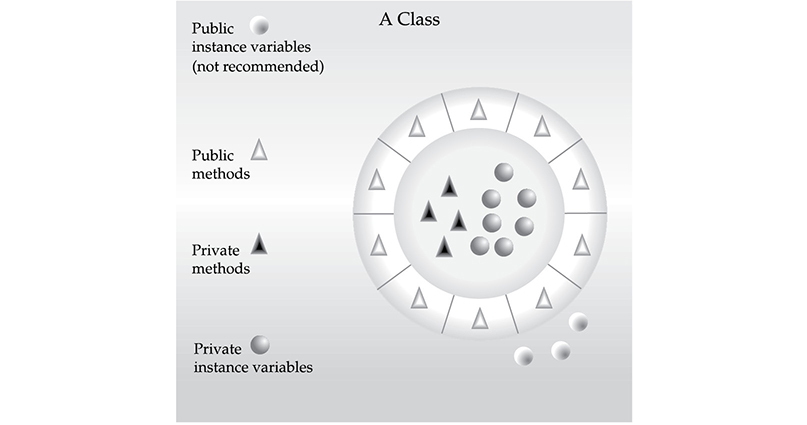
Figure 2-1 Encapsulation: public methods can be used to protect private data.
Inheritance is the process by which one object acquires the properties of another object. This is important because it supports the concept of hierarchical classification. As mentioned earlier, most knowledge is made manageable by hierarchical (that is, top-down) classifications. For example, a Golden Retriever is part of the classification dog, which in turn is part of the mammal class, which is under the larger class animal. Without the use of hierarchies, each object would need to define all of its characteristics explicitly. However, by use of inheritance, an object need only define those qualities that make it unique within its class. It can inherit its general attributes from its parent. Thus, it is the inheritance mechanism that makes it possible for one object to be a specific instance of a more general case. Let’s take a closer look at this process.
Most people naturally view the world as made up of objects that are related to each other in a hierarchical way, such as animals, mammals, and dogs. If you wanted to describe animals in an abstract way, you would say they have some attributes, such as size, intelligence, and type of skeletal system. Animals also have certain behavioral aspects; they eat, breathe, and sleep. This description of attributes and behavior is the class definition for animals.
If you wanted to describe a more specific class of animals, such as mammals, they would have more specific attributes, such as type of teeth and mammary glands. This is known as a subclass of animals, where animals are referred to as mammals’ superclass.
Since mammals are simply more precisely specified animals, they inherit all of the attributes from animals. A deeply inherited subclass inherits all of the attributes from each of its ancestors in the class hierarchy.
Inheritance interacts with encapsulation as well. If a given class encapsulates some attributes, then any subclass will have the same attributes plus any that it adds as part of its specialization (see Figure 2-2). This is a key concept that lets object-oriented programs grow in complexity linearly rather than geometrically. A new subclass inherits all of the attributes of all of its ancestors. It does not have unpredictable interactions with the majority of the rest of the code in the system.
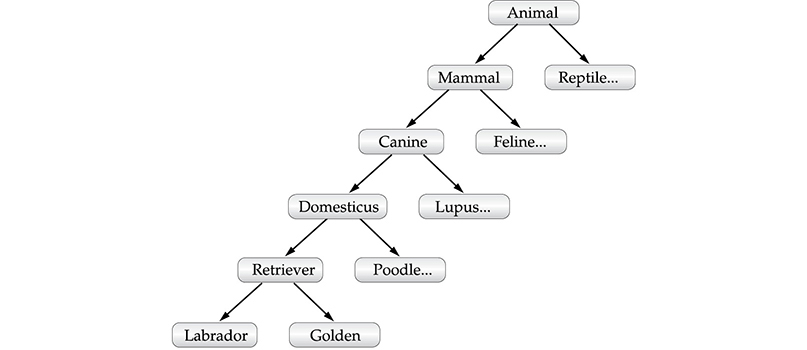
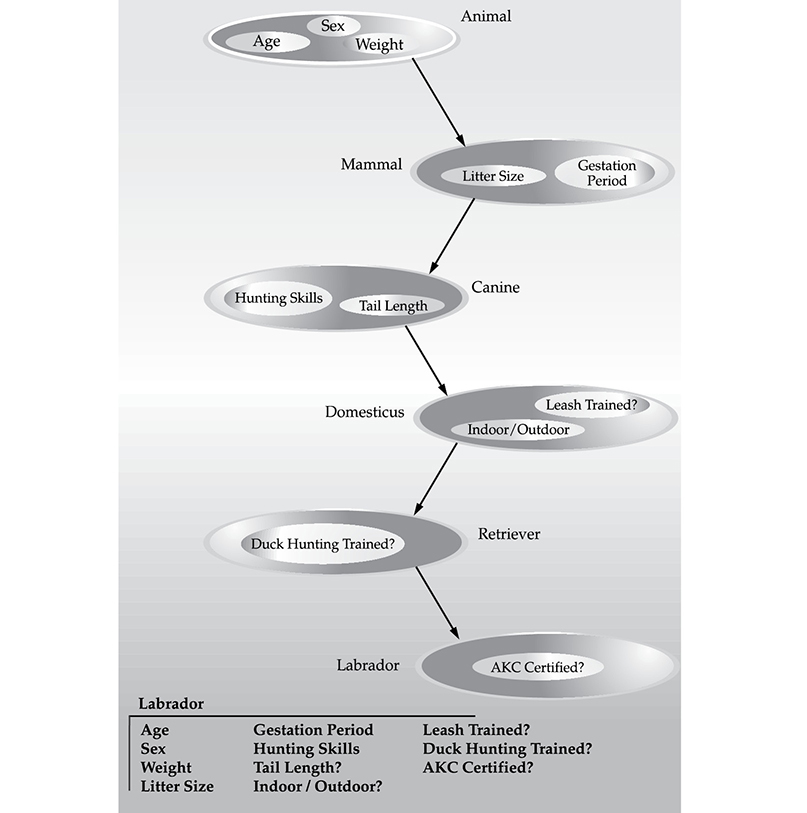
Figure 2-2 Labrador inherits the encapsulation of all its superclasses.
Polymorphism (from Greek, meaning “many forms”) is a feature that allows one interface to be used for a general class of actions. The specific action is determined by the exact nature of the situation. Consider a stack (which is a last-in, first-out list). You might have a program that requires three types of stacks. One stack is used for integer values, one for floating-point values, and one for characters. The algorithm that implements each stack is the same, even though the data being stored differs. In a non–object-oriented language, you would be required to create three different sets of stack routines, with each set using different names. However, because of polymorphism, in Java you can specify a general set of stack routines that all share the same names.
More generally, the concept of polymorphism is often expressed by the phrase “one interface, multiple methods.” This means that it is possible to design a generic interface to a group of related activities. This helps reduce complexity by allowing the same interface to be used to specify a general class of action. It is the compiler’s job to select the specific action (that is, method) as it applies to each situation. You, the programmer, do not need to make this selection manually. You need only remember and utilize the general interface.
Extending the dog analogy, a dog’s sense of smell is polymorphic. If the dog smells a cat, it will bark and run after it. If the dog smells its food, it will salivate and run to its bowl. The same sense of smell is at work in both situations. The difference is what is being smelled, that is, the type of data being operated upon by the dog’s nose! This same general concept can be implemented in Java as it applies to methods within a Java program.
When properly applied, polymorphism, encapsulation, and inheritance combine to produce a programming environment that supports the development of far more robust and scaleable programs than does the process-oriented model. A well-designed hierarchy of classes is the basis for reusing the code in which you have invested time and effort developing and testing. Encapsulation allows you to migrate your implementations over time without breaking the code that depends on the public interface of your classes. Polymorphism allows you to create clean, sensible, readable, and resilient code.
Of the two real-world examples, the automobile more completely illustrates the power of object-oriented design. Dogs are fun to think about from an inheritance standpoint, but cars are more like programs. All drivers rely on inheritance to drive different types (subclasses) of vehicles. Whether the vehicle is a school bus, a Mercedes sedan, a Porsche, or the family minivan, drivers can all more or less find and operate the steering wheel, the brakes, and the accelerator. After a bit of gear grinding, most people can even manage the difference between a stick shift and an automatic, because they fundamentally understand their common superclass, the transmission.
People interface with encapsulated features on cars all the time. The brake and gas pedals hide an incredible array of complexity with an interface so simple you can operate them with your feet! The implementation of the engine, the style of brakes, and the size of the tires have no effect on how you interface with the class definition of the pedals.
The final attribute, polymorphism, is clearly reflected in the ability of car manufacturers to offer a wide array of options on basically the same vehicle. For example, you can get an antilock braking system or traditional brakes, power or rack-and-pinion steering, and a 4-, 6-, or 8-cylinder engine, or an EV. Either way, you will still press the brake pedal to stop, turn the steering wheel to change direction, and press the accelerator when you want to move. The same interface can be used to control a number of different implementations.
As you can see, it is through the application of encapsulation, inheritance, and polymorphism that the individual parts are transformed into the object known as a car. The same is also true of computer programs. By the application of object-oriented principles, the various parts of a complex program can be brought together to form a cohesive, robust, maintainable whole.
As mentioned at the start of this section, every Java program is object-oriented. Or, put more precisely, every Java program involves encapsulation, inheritance, and polymorphism. Although the short example programs shown in the rest of this chapter and in the next few chapters may not seem to exhibit all of these features, they are nevertheless present. As you will see, many of the features supplied by Java are part of its built-in class libraries, which do make extensive use of encapsulation, inheritance, and polymorphism.
Now that the basic object-oriented underpinning of Java has been discussed, let’s look at some actual Java programs. Let’s start by compiling and running the short sample program shown here. As you will see, this involves a little more work than you might imagine.
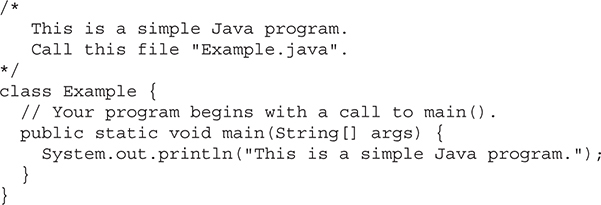
Note The descriptions that follow use the standard Java SE Development Kit (JDK), which is available from Oracle. (Open source versions are also available.) If you are using an integrated development environment (IDE), then you will need to follow a different procedure for compiling and executing Java programs. In this case, consult your IDE’s documentation for details.
For some computer languages, the name of the file that holds the source code to a program is immaterial. However, this is not the case with Java. The first thing that you must learn about Java is that the name you give to a source file is very important. For this example, the name of the source file should be Example.java. Let’s see why.
In Java, a source file is officially called a compilation unit. It is a text file that contains (among other things) one or more class definitions. (For now, we will be using source files that contain only one class.) The Java compiler requires that a source file use the .java filename extension.
As you can see by looking at the program, the name of the class defined by the program is also Example. This is not a coincidence. In Java, all code must reside inside a class. By convention, the name of the main class should match the name of the file that holds the program. You should also make sure that the capitalization of the filename matches the class name. The reason for this is that Java is case-sensitive. At this point, the convention that filenames correspond to class names may seem arbitrary. However, this convention makes it easier to maintain and organize your programs. Furthermore, as you will see later in this book, in some cases, it is required.
To compile the Example program, execute the compiler, javac, specifying the name of the source file on the command line, as shown here:
C:\>javac Example.java
The javac compiler creates a file called Example.class that contains the bytecode version of the program. As discussed earlier, the Java bytecode is the intermediate representation of your program that contains instructions the Java Virtual Machine will execute. Thus, the output of javac is not code that can be directly executed.
To actually run the program, you must use the Java application launcher called java. To do so, pass the class name Example as a command-line argument, as shown here:
C:\>java Example
When the program is run, the following output is displayed:
This is a simple Java program.
When Java source code is compiled, each individual class is put into its own output file named after the class and using the .class extension. This is why it is a good idea to give your Java source files the same name as the class they contain—the name of the source file will match the name of the .class file. When you execute java as just shown, you are actually specifying the name of the class that you want to execute. It will automatically search for a file by that name that has the .class extension. If it finds the file, it will execute the code contained in the specified class.
Note Beginning with JDK 11, Java provides a way to run some types of simple programs directly from a source file, without explicitly invoking javac. This technique, which can be useful in some situations, is described in Appendix C. For the purposes of this book, it is assumed that you are using the normal compilation process just described.
Although Example.java is quite short, it includes several key features that are common to all Java programs. Let’s closely examine each part of the program.
The program begins with the following lines:

This is a comment. Like most other programming languages, Java lets you enter a remark into a program’s source file. The contents of a comment are ignored by the compiler. Instead, a comment describes or explains the operation of the program to anyone who is reading its source code. In this case, the comment describes the program and reminds you that the source file should be called Example.java. Of course, in real applications, comments generally explain how some part of the program works or what a specific feature does.
Java supports three styles of comments. The one shown at the top of the program is called a multiline comment. This type of comment must begin with /* and end with */. Anything between these two comment symbols is ignored by the compiler. As the name suggests, a multiline comment may be several lines long.
The next line of code in the program is shown here:
class Example {
This line uses the keyword class to declare that a new class is being defined. Example is an identifier that is the name of the class. The entire class definition, including all of its members, will be between the opening curly brace ({) and the closing curly brace (}). For the moment, don’t worry too much about the details of a class except to note that in Java, all program activity occurs within one. This is one reason why all Java programs are (at least a little bit) object-oriented.
The next line in the program is the single-line comment, shown here:
// Your program begins with a call to main().
This is the second type of comment supported by Java. A single-line comment begins with a // and ends at the end of the line. As a general rule, programmers use multiline comments for longer remarks and single-line comments for brief, line-by-line descriptions. The third type of comment, a documentation comment, will be discussed in the “Comments” section later in this chapter.
The next line of code is shown here:
public static void main(String[] args) {
This line begins the main( ) method. As the comment preceding it suggests, this is the line at which the program will begin executing. As a general rule, a Java program begins execution by calling main( ). The full meaning of each part of this line cannot be given now, since it involves a detailed understanding of Java’s approach to encapsulation. However, since most of the examples in the first part of this book will use this line of code, let’s take a brief look at each part now.
The public keyword is an access modifier, which allows the programmer to control the visibility of class members. When a class member is preceded by public, then that member may be accessed by code outside the class in which it is declared. (The opposite of public is private, which prevents a member from being used by code defined outside of its class.) In this case, main( ) must be declared as public, since it must be called by code outside of its class when the program is started. The keyword static allows main( ) to be called without having to instantiate a particular instance of the class. This is necessary since main( ) is called by the Java Virtual Machine before any objects are made. The keyword void simply tells the compiler that main( ) does not return a value. As you will see, methods may also return values. If all this seems a bit confusing, don’t worry. All of these concepts will be discussed in detail in subsequent chapters.
As stated, main( ) is the method called when a Java application begins. Keep in mind that Java is case-sensitive. Thus, Main is different from main. It is important to understand that the Java compiler will compile classes that do not contain a main( ) method. But java has no way to run these classes. So, if you had typed Main instead of main, the compiler would still compile your program. However, java would report an error because it would be unable to find the main( ) method.
Any information that you need to pass to a method is received by variables specified within the set of parentheses that follow the name of the method. These variables are called parameters. If there are no parameters required for a given method, you still need to include the empty parentheses. In main( ), there is only one parameter, albeit a complicated one. String[ ] args declares a parameter named args, which is an array of instances of the class String. (Arrays are collections of similar objects.) Objects of type String store character strings. In this case, args receives any command-line arguments present when the program is executed. This program does not make use of this information, but other programs shown later in this book will.
The last character on the line is the {. This signals the start of main( )’s body. All of the code that comprises a method will occur between the method’s opening curly brace and its closing curly brace.
One other point: main( ) is simply a starting place for your program. A complex program will have dozens of classes, only one of which will need to have a main( ) method to get things started. Furthermore, for some types of programs, you won’t need main( ) at all. However, for most of the programs shown in this book, main( ) is required.
The next line of code is shown here. Notice that it occurs inside main( ).
System.out.println("This is a simple Java program.");
This line outputs the string "This is a simple Java program." followed by a new line on the screen. Output is actually accomplished by the built-in println( ) method. In this case, println( ) displays the string which is passed to it. As you will see, println( ) can be used to display other types of information, too. The line begins with System.out. While too complicated to explain in detail at this time, briefly, System is a predefined class that provides access to the system, and out is the output stream that is connected to the console.
As you have probably guessed, console output (and input) is not used frequently in most real-world Java applications. Since most modern computing environments are graphical in nature, console I/O is used mostly for simple utility programs, demonstration programs, and server-side code. Later in this book, you will learn other ways to generate output using Java. But for now, we will continue to use the console I/O methods.
Notice that the println( ) statement ends with a semicolon. Many statements in Java end with a semicolon. As you will see, the semicolon is an important part of the Java syntax.
The first } in the program ends main( ), and the last } ends the Example class definition.
Perhaps no other concept is more fundamental to a programming language than that of a variable. As you may know, a variable is a named memory location that may be assigned a value by your program. The value of a variable may be changed during the execution of the program. The next program shows how a variable is declared and how it is assigned a value. The program also illustrates some new aspects of console output. As the comments at the top of the program state, you should call this file Example2.java.
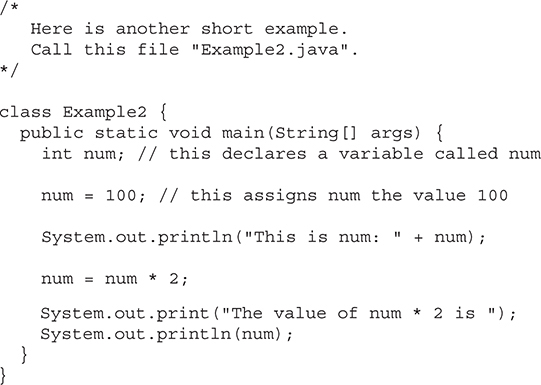
When you run this program, you will see the following output:
This is num: 100
The value of num * 2 is 200
Let’s take a close look at why this output is generated. The first new line in the program is shown here:
int num; // this declares a variable called num
This line declares an integer variable called num. Java (like many other languages) requires that variables be declared before they are used.
Following is the general form of a variable declaration:
type var-name;
Here, type specifies the type of variable being declared, and var-name is the name of the variable. If you want to declare more than one variable of the specified type, you may use a comma-separated list of variable names. Java defines several data types, including integer, character, and floating-point. The keyword int specifies an integer type.
In the program, the line
num = 100; // this assigns num the value 100
assigns to num the value 100. In Java, the assignment operator is a single equal sign.
The next line of code outputs the value of num preceded by the string "This is num:".
System.out.println("This is num: " + num);
In this statement, the plus sign causes the value of num to be appended to the string that precedes it, and then the resulting string is output. (Actually, num is first converted from an integer into its string equivalent and then concatenated with the string that precedes it. This process is described in detail later in this book.) This approach can be generalized. Using the + operator, you can join together as many items as you want within a single println( ) statement.
The next line of code assigns num the value of num times 2. Like most other languages, Java uses the * operator to indicate multiplication. After this line executes, num will contain the value 200.
Here are the next two lines in the program:
System.out.print ("The value of num * 2 is ");
System.out.println (num);
Several new things are occurring here. First, the built-in method print( ) is used to display the string "The value of num * 2 is ". This string is not followed by a newline. This means that when the next output is generated, it will start on the same line. The print( ) method is just like println( ), except that it does not output a newline character after each call. Now look at the call to println( ). Notice that num is used by itself. Both print( ) and println( ) can be used to output values of any of Java’s built-in types.
Although Chapter 5 will look closely at control statements, two are briefly introduced here so that they can be used in example programs in Chapters 3 and 4. They will also help illustrate an important aspect of Java: blocks of code.
The Java if statement works much like the IF statement in any other language. It determines the flow of execution based on whether some condition is true or false. Its simplest form is shown here:
if(condition) statement;
Here, condition is a Boolean expression. (A Boolean expression is one that evaluates to either true or false.) If condition is true, then the statement is executed. If condition is false, then the statement is bypassed. Here is an example:
if(num < 100) System.out.println("num is less than 100");
In this case, if num contains a value that is less than 100, the conditional expression is true, and println( ) will execute. If num contains a value greater than or equal to 100, then the println( ) method is bypassed.
As you will see in Chapter 4, Java defines a full complement of relational operators which may be used in a conditional expression. Here are a few:

Notice that the test for equality is the double equal sign.
Here is a program that illustrates the if statement:
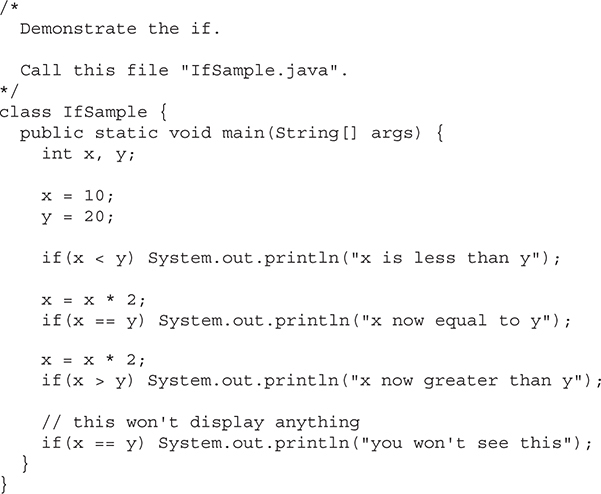
The output generated by this program is shown here:
x is less than y
x now equal to y
x now greater than y
Notice one other thing in this program. The line
int x, y;
declares two variables, x and y, by use of a comma-separated list.
Loop statements are an important part of nearly any programming language because they provide a way to repeatedly execute some task. As you will see in Chapter 5, Java supplies a powerful assortment of loop constructs. Perhaps the most versatile is the for loop. The simplest form of the for loop is shown here:
for(initialization; condition; iteration) statement;
In its most common form, the initialization portion of the loop sets a loop control variable to an initial value. The condition is a Boolean expression that tests the loop control variable. If the outcome of that test is true, statement executes and the for loop continues to iterate. If it is false, the loop terminates. The iteration expression determines how the loop control variable is changed each time the loop iterates. Here is a short program that illustrates the for loop:
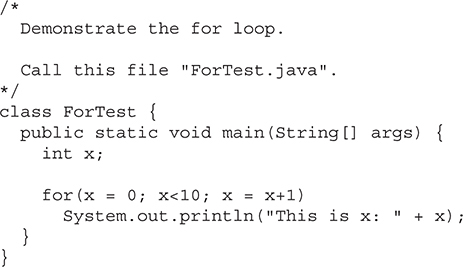
This program generates the following output:
This is x: 0
This is x: 1
This is x: 2
This is x: 3
This is x: 4
This is x: 5
This is x: 6
This is x: 7
This is x: 8
This is x: 9
In this example, x is the loop control variable. It is initialized to zero in the initialization portion of the for. At the start of each iteration (including the first one), the conditional test x < 10 is performed. If the outcome of this test is true, the println( ) statement is executed, and then the iteration portion of the loop is executed, which increases x by 1. This process continues until the conditional test is false.
As a point of interest, in professionally written Java programs you will almost never see the iteration portion of the loop written as shown in the preceding program. That is, you will seldom see statements like this:
x = x + 1;
The reason is that Java includes a special increment operator which performs this operation more efficiently. The increment operator is ++. (That is, two plus signs back to back.) The increment operator increases its operand by one. By use of the increment operator, the preceding statement can be written like this:
x++;
Thus, the for in the preceding program will usually be written like this:
for(x = 0; x<10; x++)
You might want to try this. As you will see, the loop still runs exactly the same as it did before.
Java also provides a decrement operator, which is specified as – –. This operator decreases its operand by one.
Java allows two or more statements to be grouped into blocks of code, also called code blocks. This is done by enclosing the statements between opening and closing curly braces. Once a block of code has been created, it becomes a logical unit that can be used any place that a single statement can. For example, a block can be a target for Java’s if and for statements. Consider this if statement:

Here, if x is less than y, then both statements inside the block will be executed. Thus, the two statements inside the block form a logical unit, and one statement cannot execute without the other also executing. The key point here is that whenever you need to logically link two or more statements, you do so by creating a block.
Let’s look at another example. The following program uses a block of code as the target of a for loop.
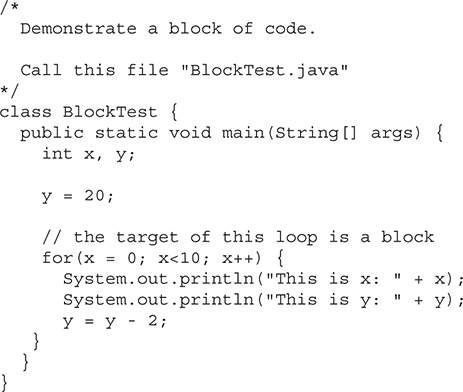
The output generated by this program is shown here:
This is x: 0
This is y: 20
This is x: 1
This is y: 18
This is x: 2
This is y: 16
This is x: 3
This is y: 14
This is x: 4
This is y: 12
This is x: 5
This is y: 10
This is x: 6
This is y: 8
This is x: 7
This is y: 6
This is x: 8
This is y: 4
This is x: 9
This is y: 2
In this case, the target of the for loop is a block of code and not just a single statement. Thus, each time the loop iterates, the three statements inside the block will be executed. This fact is, of course, evidenced by the output generated by the program.
As you will see later in this book, blocks of code have additional properties and uses. However, the main reason for their existence is to create logically inseparable units of code.
Now that you have seen several short Java programs, it is time to more formally describe the atomic elements of Java. Java programs are a collection of whitespace, identifiers, literals, comments, operators, separators, and keywords. The operators are described in the next chapter. The others are described next.
Java is a free-form language. This means that you do not need to follow any special indentation rules. For instance, the Example program could have been written all on one line or in any other strange way you felt like typing it, as long as there was at least one whitespace character between each token that was not already delineated by an operator or separator. In Java, whitespace includes a space, tab, newline, or form feed.
Identifiers are used to name things, such as classes, variables, and methods. An identifier may be any descriptive sequence of uppercase and lowercase letters, numbers, or the underscore and dollar-sign characters. (The dollar-sign character is not intended for general use.) They must not begin with a number, lest they be confused with a numeric literal. Again, Java is case-sensitive, so VALUE is a different identifier than Value. Some examples of valid identifiers are

Invalid identifier names include these:

Note Beginning with JDK 9, the underscore cannot be used by itself as an identifier.
A constant value in Java is created by using a literal representation of it. For example, here are some literals:

Left to right, the first literal specifies an integer, the next is a floating-point value, the third is a character constant, and the last is a string. A literal can be used anywhere a value of its type is allowed.
As mentioned, there are three types of comments defined by Java. You have already seen two: single-line and multiline. The third type is called a documentation comment. This type of comment is used to produce an HTML file that documents your program. The documentation comment begins with a /** and ends with a */. Documentation comments are explained in Appendix A.
In Java, there are a few characters that are used as separators. The most commonly used separator in Java is the semicolon. As you have seen, it is often used to terminate statements. The separators are shown in the following table:
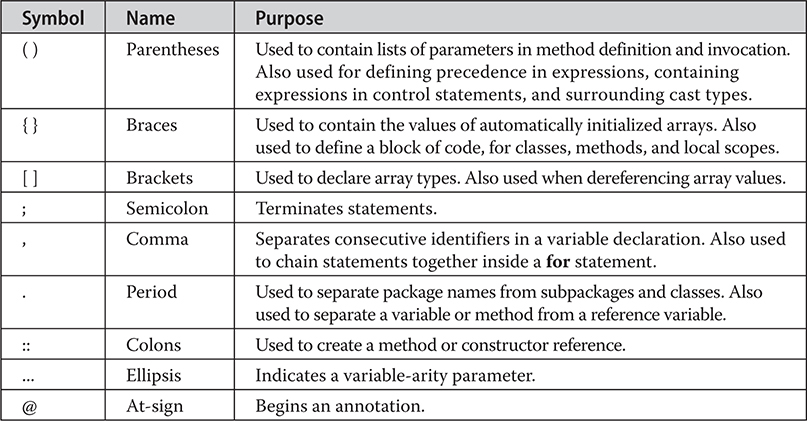
There are 67 keywords currently defined in the Java language (see Table 2-1). These keywords, combined with the syntax of the operators and separators, form the foundation of the Java language. In general, keywords cannot be used as identifiers, meaning that they cannot be used as names for a variable, class, or method. However, 16 of the keywords are context-sensitive, which means that they are only keywords when used with the feature to which they relate. They support features added to Java over the past few years. Ten relate to modules: exports, module, open, opens, provides, requires, to, transitive, uses, and with. Records are declared by record; sealed classes and interfaces use sealed, non-sealed, and permits; yield is used by the enhanced switch; and var supports local variable type inference. Because they are context-sensitive, existing programs were unaffected by their addition. Also, beginning with JDK 9, an underscore by itself is considered a keyword in order to prevent its use as the name of something in your program. Beginning with JDK 17, strictfp has been rendered obsolete because it has no effect.
The keywords const and goto are reserved but not used. In the early days of Java, several other keywords were reserved for possible future use. However, the current specification for Java defines only the keywords shown in Table 2-1.
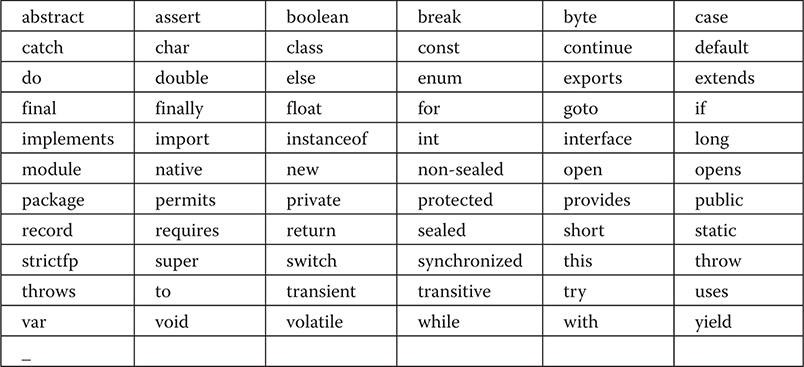
Table 2-1 Java Keywords
In addition to the keywords, Java reserves three other names that have been part of Java from the start: true, false, and null. These are values defined by Java. You may not use these words for the names of variables, classes, and so on.
The sample programs shown in this chapter make use of two of Java’s built-in methods: println( ) and print( ). As mentioned, these methods are available through System.out.System is a class predefined by Java that is automatically included in your programs. In the larger view, the Java environment relies on several built-in class libraries that contain many built-in methods that provide support for such things as I/O, string handling, networking, and graphics. The standard classes also provide support for a graphical user interface (GUI). Thus, Java as a totality is a combination of the Java language itself, plus its standard classes. As you will see, the class libraries provide much of the functionality that comes with Java. Indeed, part of becoming a Java programmer is learning to use the standard Java classes. Throughout Part I of this book, various elements of the standard library classes and methods are described as needed. In Part II, several class libraries are described in detail.
This chapter examines three of Java’s most fundamental elements: data types, variables, and arrays. As with all modern programming languages, Java supports several types of data. You may use these types to declare variables and to create arrays. As you will see, Java’s approach to these items is clean, efficient, and cohesive.
It is important to state at the outset that Java is a strongly typed language. Indeed, part of Java’s safety and robustness comes from this fact. Let’s see what this means. First, every variable has a type, every expression has a type, and every type is strictly defined. Second, all assignments, whether explicit or via parameter passing in method calls, are checked for type compatibility. There are no automatic coercions or conversions of conflicting types as in some languages. The Java compiler checks all expressions and parameters to ensure that the types are compatible. Any type mismatches are errors that must be corrected before the compiler will finish compiling the class.
Java defines eight primitive types of data: byte, short, int, long, char, float, double, and boolean. The primitive types are also commonly referred to as simple types, and both terms will be used in this book. These can be put in four groups:
• Integers This group includes byte, short, int, and long, which are for whole-valued signed numbers.
• Floating-point numbers This group includes float and double, which represent numbers with fractional precision.
• Characters This group includes char, which represents symbols in a character set, like letters and numbers.
• Boolean This group includes boolean, which is a special type for representing true/false values.
You can use these types as-is, or to construct arrays or your own class types. Thus, they form the basis for all other types of data that you can create.
The primitive types represent single values—not complex objects. Although Java is otherwise completely object-oriented, the primitive types are not. They are analogous to the simple types found in most other non–object-oriented languages. The reason for this is efficiency. Making the primitive types into objects would have degraded performance too much.
The primitive types are defined to have an explicit range and mathematical behavior. Languages such as C and C++ allow the size of an integer to vary based upon the dictates of the execution environment. However, Java is different. Because of Java’s portability requirement, all data types have a strictly defined range. For example, an int is always 32 bits, regardless of the particular platform. This allows programs to be written that are guaranteed to run without porting on any machine architecture. While strictly specifying the size of an integer may cause a small loss of performance in some environments, it is necessary in order to achieve portability.
Let’s look at each type of data in turn.
Java defines four integer types: byte, short, int, and long. All of these are signed, positive and negative values. Java does not support unsigned, positive-only integers. Many other computer languages support both signed and unsigned integers. However, Java’s designers felt that unsigned integers were unnecessary. Specifically, they felt that the concept of unsigned was used mostly to specify the behavior of the high-order bit, which defines the sign of an integer value. As you will see in Chapter 4, Java manages the meaning of the high-order bit differently, by adding a special “unsigned right shift” operator. Thus, the need for an unsigned integer type was eliminated.
The width of an integer type should not be thought of as the amount of storage it consumes, but rather as the behavior it defines for variables and expressions of that type. The Java run-time environment is free to use whatever size it wants, as long as the types behave as you declared them. The width and ranges of these integer types vary widely, as shown in this table:

Let’s look at each type of integer.
The smallest integer type is byte. This is a signed 8-bit type that has a range from –128 to 127. Variables of type byte are especially useful when you’re working with a stream of data from a network or file. They are also useful when you’re working with raw binary data that may not be directly compatible with Java’s other built-in types.
Byte variables are declared by use of the byte keyword. For example, the following declares two byte variables called b and c:
byte b, c;
short is a signed 16-bit type. It has a range from –32,768 to 32,767. It is probably the least-used Java type. Here are some examples of short variable declarations:
short s;
short t;
The most commonly used integer type is int. It is a signed 32-bit type that has a range from –2,147,483,648 to 2,147,483,647. In addition to other uses, variables of type int are commonly employed to control loops and to index arrays. Although you might think that using a byte or short would be more efficient than using an int in situations in which the larger range of an int is not needed, this may not be the case. The reason is that when byte and short values are used in an expression, they are promoted to int when the expression is evaluated. (Type promotion is described later in this chapter.) Therefore, int is often the best choice when an integer is needed.
long is a signed 64-bit type and is useful for those occasions where an int type is not large enough to hold the desired value. The range of a long is quite large. This makes it useful when big, whole numbers are needed. For example, here is a program that computes the number of miles that light will travel in a specified number of days:
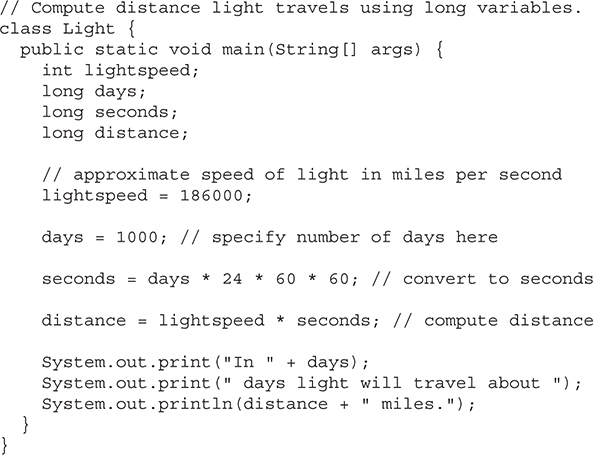
This program generates the following output:
In 1000 days light will travel about 16070400000000 miles.
Clearly, the result could not have been held in an int variable.
Floating-point numbers, also known as real numbers, are used when evaluating expressions that require fractional precision. For example, calculations such as square root, or transcendentals such as sine and cosine, result in a value whose precision requires a floating-point type. Java implements the standard (IEEE–754) set of floating-point types and operators. There are two kinds of floating-point types, float and double, which represent single- and double-precision numbers, respectively. Their width and ranges are shown here:

Each of these floating-point types is examined next.
The type float specifies a single-precision value that uses 32 bits of storage. Single precision is faster on some processors and takes half as much space as double precision, but will become imprecise when the values are either very large or very small. Variables of type float are useful when you need a fractional component, but don’t require a large degree of precision. For example, float can be useful when representing dollars and cents.
Here are some example float variable declarations:
float hightemp, lowtemp;
Double precision, as denoted by the double keyword, uses 64 bits to store a value. Double precision is actually faster than single precision on some modern processors that have been optimized for high-speed mathematical calculations. All transcendental math functions, such as sin( ), cos( ), and sqrt( ), return double values. When you need to maintain accuracy over many iterative calculations, or are manipulating large-valued numbers, double is the best choice.
Here is a short program that uses double variables to compute the area of a circle:
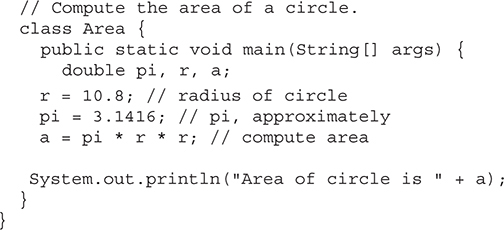
In Java, the data type used to store characters is char. A key point to understand is that Java uses Unicode to represent characters. Unicode defines a fully international character set that can represent all of the characters found in all human languages. It is a unification of dozens of character sets, such as Latin, Greek, Arabic, Cyrillic, Hebrew, Katakana, Hangul, and many more. At the time of Java’s creation, Unicode required 16 bits. Thus, in Java char is a 16-bit type. The range of a char is 0 to 65,535. There are no negative chars. The standard set of characters known as ASCII still ranges from 0 to 127 as always, and the extended 8-bit character set, ISO-Latin-1, ranges from 0 to 255. Since Java is designed to allow programs to be written for worldwide use, it makes sense that it would use Unicode to represent characters. Of course, the use of Unicode is somewhat inefficient for languages such as English, German, Spanish, or French, whose characters can easily be contained within 8 bits. But such is the price that must be paid for global portability.
Note More information about Unicode can be found at http://www.unicode.org.
Here is a program that demonstrates char variables:
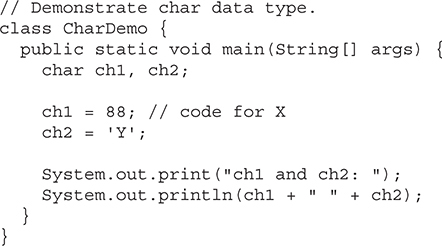
This program displays the following output:
ch1 and ch2: X Y
Notice that ch1 is assigned the value 88, which is the ASCII (and Unicode) value that corresponds to the letter X. As mentioned, the ASCII character set occupies the first 127 values in the Unicode character set. For this reason, all the “old tricks” that you may have used with characters in other languages will work in Java, too.
Although char is designed to hold Unicode characters, it can also be used as an integer type on which you can perform arithmetic operations. For example, you can add two characters together, or increment the value of a character variable. Consider the following program:
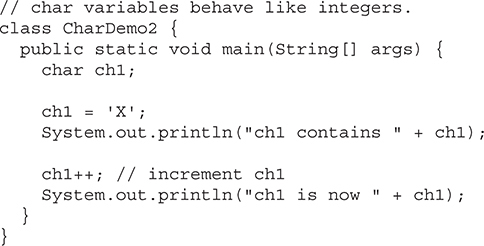
The output generated by this program is shown here:
ch1 contains X
ch1 is now Y
In the program, ch1 is first given the value X. Next, ch1 is incremented. This results in ch1 containing Y, the next character in the ASCII (and Unicode) sequence.
Note In the formal specification for Java, char is referred to as an integral type, which means that it is in the same general category as int, short, long, and byte. However, because its principal use is for representing Unicode characters, char is commonly considered to be in a category of its own.
Java has a primitive type, called boolean, for logical values. It can have only one of two possible values, true or false. This is the type returned by all relational operators, as in the case of a < b. boolean is also the type required by the conditional expressions that govern the control statements such as if and for.
Here is a program that demonstrates the boolean type:
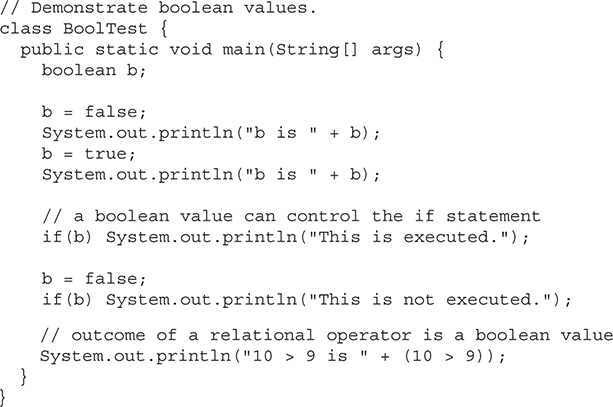
The output generated by this program is shown here:
b is false
b is true
This is executed.
10 > 9 is true
There are three interesting things to notice about this program. First, as you can see, when a boolean value is output by println( ), "true" or "false" is displayed. Second, the value of a boolean variable is sufficient, by itself, to control the if statement. There is no need to write an if statement like this:
if(b == true) …
Third, the outcome of a relational operator, such as <, is a boolean value. This is why the expression 10>9 displays the value "true." Further, the extra set of parentheses around 10>9 is necessary because the + operator has a higher precedence than the >.
Literals were mentioned briefly in Chapter 2. Now that the built-in types have been formally described, let’s take a closer look at them.
Integers are probably the most commonly used type in the typical program. Any whole number value is an integer literal. Examples are 1, 2, 3, and 42. These are all decimal values, meaning they are describing a base 10 number. Two other bases that can be used in integer literals are octal (base eight) and hexadecimal (base 16). Octal values are denoted in Java by a leading zero. Normal decimal numbers cannot have a leading zero. Thus, the seemingly valid value 09 will produce an error from the compiler, since 9 is outside of octal’s 0 to 7 range. A more common base for numbers used by programmers is hexadecimal, which matches cleanly with modulo 8 word sizes, such as 8, 16, 32, and 64 bits. You signify a hexadecimal constant with a leading zero-x, (0x or 0X). The range of a hexadecimal digit is 0 to 15, so A through F (or a through f ) are substituted for 10 through 15.
Integer literals create an int value, which in Java is a 32-bit integer value. Since Java is strongly typed, you might be wondering how it is possible to assign an integer literal to one of Java’s other integer types, such as byte or long, without causing a type mismatch error. Fortunately, such situations are easily handled. When a literal value is assigned to a byte or short variable, no error is generated if the literal value is within the range of the target type. An integer literal can always be assigned to a long variable. However, to specify a long literal, you will need to explicitly tell the compiler that the literal value is of type long. You do this by appending an upper- or lowercase L to the literal. For example, 0x7ffffffffffffffL or 9223372036854775807L is the largest long. An integer can also be assigned to a char as long as it is within range.
You can also specify integer literals using binary. To do so, prefix the value with 0b or 0B. For example, this specifies the decimal value 10 using a binary literal:
int x = 0b1010;
Among other uses, the addition of binary literals makes it easier to enter values used as bitmasks. In such a case, the decimal (or hexadecimal) representation of the value does not visually convey its meaning relative to its use. The binary literal does.
You can embed one or more underscores in an integer literal. Doing so makes it easier to read large integer literals. When the literal is compiled, the underscores are discarded. For example, given
int x = 123_456_789;
the value given to x will be 123,456,789. The underscores will be ignored. Underscores can only be used to separate digits. They cannot come at the beginning or the end of a literal. It is, however, permissible for more than one underscore to be used between two digits. For example, this is valid:
int x = 123___456___789;
The use of underscores in an integer literal is especially useful when encoding such things as telephone numbers, customer ID numbers, part numbers, and so on. They are also useful for providing visual groupings when specifying binary literals. For example, binary values are often visually grouped in four-digits units, as shown here:
int x = 0b1101_0101_0001_1010;
Floating-point numbers represent decimal values with a fractional component. They can be expressed in either standard or scientific notation. Standard notation consists of a whole number component followed by a decimal point followed by a fractional component. For example, 2.0, 3.14159, and 0.6667 represent valid standard-notation floating-point numbers. Scientific notation uses a standard-notation, floating-point number plus a suffix that specifies a power of 10 by which the number is to be multiplied. The exponent is indicated by an E or e followed by a decimal number, which can be positive or negative. Examples include 6.022E23, 314159E–05, and 2e+100.
Floating-point literals in Java default to double precision. To specify a float literal, you must append an F or f to the constant. You can also explicitly specify a double literal by appending a D or d. Doing so is, of course, redundant. The default double type consumes 64 bits of storage, while the smaller float type requires only 32 bits.
Hexadecimal floating-point literals are also supported, but they are rarely used. They must be in a form similar to scientific notation, but a P or p, rather than an E or e, is used. For example, 0x12.2P2 is a valid floating-point literal. The value following the P, called the binary exponent, indicates the power-of-two by which the number is multiplied. Therefore, 0x12.2P2 represents 72.5.
You can embed one or more underscores in a floating-point literal. This feature works the same as it does for integer literals, which were just described. Its purpose is to make it easier to read large floating-point literals. When the literal is compiled, the underscores are discarded. For example, given
double num = 9_423_497_862.0;
the value given to num will be 9,423,497,862.0. The underscores will be ignored. As is the case with integer literals, underscores can only be used to separate digits. They cannot come at the beginning or the end of a literal. It is, however, permissible for more than one underscore to be used between two digits. It is also permissible to use underscores in the fractional portion of the number. For example,
double num = 9_423_497.1_0_9;
is legal. In this case, the fractional part is .109.
Boolean literals are simple. There are only two logical values that a boolean value can have, true and false. The values of true and false do not convert into any numerical representation. The true literal in Java does not equal 1, nor does the false literal equal 0. In Java, the Boolean literals can only be assigned to variables declared as boolean or used in expressions with Boolean operators.
Characters in Java are indices into the Unicode character set. They are 16-bit values that can be converted into integers and manipulated with the integer operators, such as the addition and subtraction operators. A literal character is represented inside a pair of single quotes. All of the visible ASCII characters can be directly entered inside the quotes, such as 'a', 'z', and '@'. For characters that are impossible to enter directly, there are several escape sequences that allow you to enter the character you need, such as ' \' ' for the single-quote character itself and ' \n' for the newline character. There is also a mechanism for directly entering the value of a character in octal or hexadecimal. For octal notation, use the backslash followed by the three-digit number. For example, ' \141' is the letter 'a'. For hexadecimal, you enter a backslash-u ( \u), then exactly four hexadecimal digits. For example, ' \u0061' is the ISO-Latin-1 'a' because the top byte is zero. ' \ua432 ' is a Japanese Katakana character. Table 3-1 shows the character escape sequences.
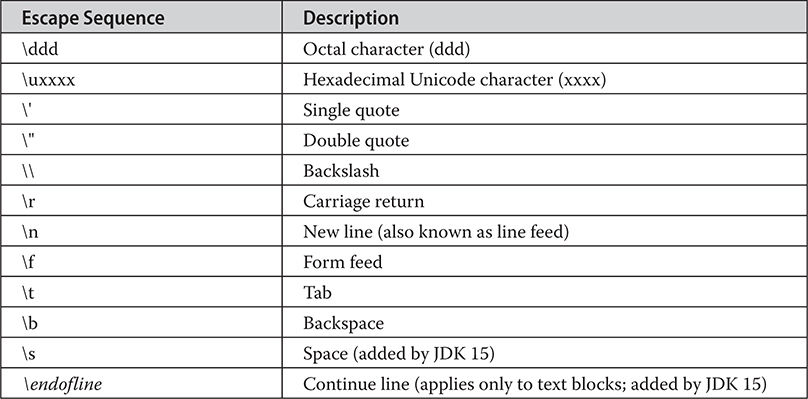
Table 3-1 Character Escape Sequences
String literals in Java are specified like they are in most other languages—by enclosing a sequence of characters between a pair of double quotes. Examples of string literals are
"Hello World"
"two\nlines"
" \"This is in quotes\""
The escape sequences and octal/hexadecimal notations that were defined for character literals work the same way inside of string literals. One important thing to note about Java string literals is that they must begin and end on the same line, even if the line wraps. For string literals there is no line-continuation escape sequence as there is in some other languages. (It is useful to point out that beginning with JDK 15, Java added a feature called a text block, which gives you more control and flexibility when multiple lines of text are needed. See Chapter 17.)
Note As you may know, in some other languages strings are implemented as arrays of characters. However, this is not the case in Java. Strings are actually object types. As you will see later in this book, because Java implements strings as objects, Java includes extensive string-handling capabilities that are both powerful and easy to use.
The variable is the basic unit of storage in a Java program. A variable is defined by the combination of an identifier, a type, and an optional initializer. In addition, all variables have a scope, which defines their visibility, and a lifetime. These elements are examined next.
In Java, all variables must be declared before they can be used. The basic form of a variable declaration is shown here:
type identifier [ = value ][, identifier [= value ] …];
Here, type is one of Java’s atomic types, or the name of a class or interface. (Class and interface types are discussed later in Part I of this book.) The identifier is the name of the variable. You can initialize the variable by specifying an equal sign and a value. Keep in mind that the initialization expression must result in a value of the same (or compatible) type as that specified for the variable. To declare more than one variable of the specified type, use a comma-separated list.
Here are several examples of variable declarations of various types. Note that some include an initialization.

The identifiers that you choose have nothing intrinsic in their names that indicates their type. Java allows any properly formed identifier to have any declared type.
Although the preceding examples have used only constants as initializers, Java allows variables to be initialized dynamically, using any expression valid at the time the variable is declared.
For example, here is a short program that computes the length of the hypotenuse of a right triangle given the lengths of its two opposing sides:
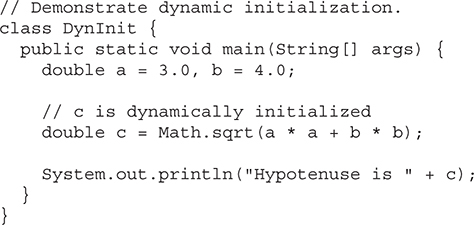
Here, three local variables—a, b, and c—are declared. The first two, a and b, are initialized by constants. However, c is initialized dynamically to the length of the hypotenuse (using the Pythagorean theorem). The program uses another of Java’s built-in methods, sqrt( ), which is a member of the Math class, to compute the square root of its argument. The key point here is that the initialization expression may use any element valid at the time of the initialization, including calls to methods, other variables, or literals.
So far, all of the variables used have been declared at the start of the main( ) method. However, Java allows variables to be declared within any block. As explained in Chapter 2, a block is begun with an opening curly brace and ended by a closing curly brace. A block defines a scope. Thus, each time you start a new block, you are creating a new scope. A scope determines what objects are visible to other parts of your program. It also determines the lifetime of those objects.
It is not uncommon to think in terms of two general categories of scopes: global and local. However, these traditional scopes do not fit well with Java’s strict, object-oriented model. While it is possible to create what amounts to being a global scope, it is by far the exception, not the rule. In Java, the two major scopes are those defined by a class and those defined by a method. Even this distinction is somewhat artificial. However, since the class scope has several unique properties and attributes that do not apply to the scope defined by a method, this distinction makes some sense. Because of the differences, a discussion of class scope (and variables declared within it) is deferred until Chapter 6, when classes are described. For now, we will only examine the scopes defined by or within a method.
The scope defined by a method begins with its opening curly brace. However, if that method has parameters, they too are included within the method’s scope. A method’s scope ends with its closing curly brace. This block of code is called the method body.
As a general rule, variables declared inside a scope are not visible (that is, accessible) to code that is defined outside that scope. Thus, when you declare a variable within a scope, you are localizing that variable and protecting it from unauthorized access and/or modification. Indeed, the scope rules provide the foundation for encapsulation. A variable declared within a block is called a local variable.
Scopes can be nested. For example, each time you create a block of code, you are creating a new, nested scope. When this occurs, the outer scope encloses the inner scope. This means that objects declared in the outer scope will be visible to code within the inner scope. However, the reverse is not true. Objects declared within the inner scope will not be visible outside it.
To understand the effect of nested scopes, consider the following program:
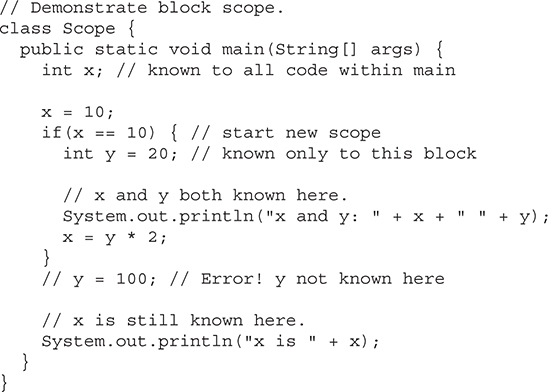
As the comments indicate, the variable x is declared at the start of main( )’s scope and is accessible to all subsequent code within main( ). Within the if block, y is declared. Since a block defines a scope, y is only visible to other code within its block. This is why outside of its block, the line y = 100; is commented out. If you remove the leading comment symbol, a compile-time error will occur, because y is not visible outside of its block. Within the if block, x can be used because code within a block (that is, a nested scope) has access to variables declared by an enclosing scope.
Within a block, variables can be declared at any point, but are valid only after they are declared. Thus, if you define a variable at the start of a method, it is available to all of the code within that method. Conversely, if you declare a variable at the end of a block, it is effectively useless, because no code will have access to it. For example, this fragment is invalid because count cannot be used prior to its declaration:
// This fragment is wrong!
count = 100; // oops! cannot use count before it is declared!
int count;
Here is another important point to remember: variables are created when their scope is entered, and destroyed when their scope is left. This means that a variable will not hold its value once it has gone out of scope. Therefore, variables declared within a method will not hold their values between calls to that method. Also, a variable declared within a block will lose its value when the block is left. Thus, the lifetime of a variable is confined to its scope.
If a variable declaration includes an initializer, then that variable will be reinitialized each time the block in which it is declared is entered. For example, consider the next program:
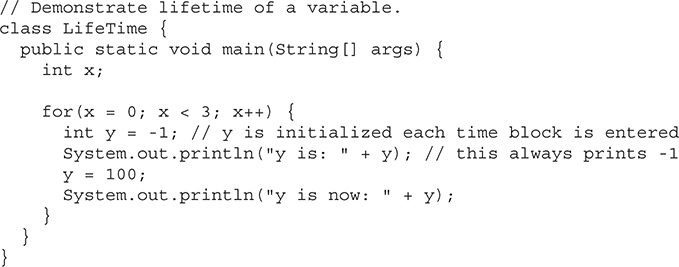
The output generated by this program is shown here:
y is: -1
y is now: 100
y is: -1
y is now: 100
y is: -1
y is now: 100
As you can see, y is reinitialized to –1 each time the inner for loop is entered. Even though it is subsequently assigned the value 100, this value is lost.
One last point: Although blocks can be nested, you cannot declare a variable to have the same name as one in an outer scope. For example, the following program is illegal:

If you have previous programming experience, then you already know that it is fairly common to assign a value of one type to a variable of another type. If the two types are compatible, then Java will perform the conversion automatically. For example, it is always possible to assign an int value to a long variable. However, not all types are compatible, and thus, not all type conversions are implicitly allowed. For instance, there is no automatic conversion defined from double to byte. Fortunately, it is still possible to obtain a conversion between incompatible types. To do so, you must use a cast, which performs an explicit conversion between incompatible types. Let’s look at both automatic type conversions and casting.
When one type of data is assigned to another type of variable, an automatic type conversion will take place if the following two conditions are met:
• The two types are compatible.
• The destination type is larger than the source type.
When these two conditions are met, a widening conversion takes place. For example, the int type is always large enough to hold all valid byte values, so no explicit cast statement is required.
For widening conversions, the numeric types, including integer and floating-point types, are compatible with each other. However, there are no automatic conversions from the numeric types to char or boolean. Also, char and boolean are not compatible with each other.
As mentioned earlier, Java also performs an automatic type conversion when storing a literal integer constant into variables of type byte, short, long, or char.
Although the automatic type conversions are helpful, they will not fulfill all needs. For example, what if you want to assign an int value to a byte variable? This conversion will not be performed automatically, because a byte is smaller than an int. This kind of conversion is sometimes called a narrowing conversion, since you are explicitly making the value narrower so that it will fit into the target type.
To create a conversion between two incompatible types, you must use a cast. A cast is simply an explicit type conversion. It has this general form:
(target-type) value
Here, target-type specifies the desired type to convert the specified value to. For example, the following fragment casts an int to a byte. If the integer’s value is larger than the range of a byte, it will be reduced modulo (the remainder of an integer division by the) byte’s range.
int a;
byte b;
// …
b = (byte) a;
A different type of conversion will occur when a floating-point value is assigned to an integer type: truncation. As you know, integers do not have fractional components. Thus, when a floating-point value is assigned to an integer type, the fractional component is lost. For example, if the value 1.23 is assigned to an integer, the resulting value will simply be 1. The 0.23 will have been truncated. Of course, if the size of the whole number component is too large to fit into the target integer type, then that value will be reduced modulo the target type’s range.
The following program demonstrates some type conversions that require casts:
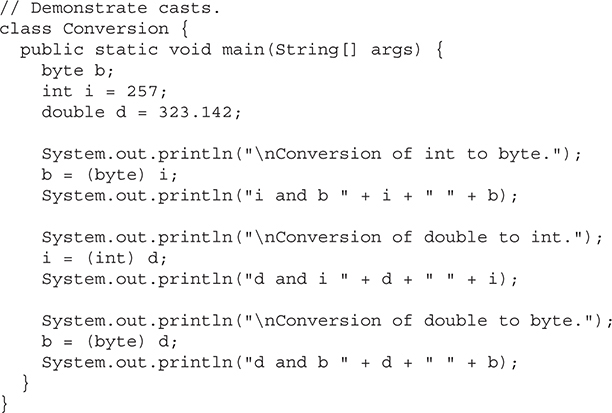
This program generates the following output:
Conversion of int to byte.
i and b 257 1
Conversion of double to int.
d and i 323.142 323
Conversion of double to byte.
d and b 323.142 67
Let’s look at each conversion. When the value 257 is cast into a byte variable, the result is the remainder of the division of 257 by 256 (the range of a byte), which is 1 in this case. When the d is converted to an int, its fractional component is lost. When d is converted to a byte, its fractional component is lost, and the value is reduced modulo 256, which in this case is 67.
In addition to assignments, there is another place where certain type conversions may occur: in expressions. To see why, consider the following. In an expression, the precision required of an intermediate value will sometimes exceed the range of either operand. For example, examine the following expression:
byte a = 40;
byte b = 50;
byte c = 100;
int d = a * b / c;
The result of the intermediate term a * b easily exceeds the range of either of its byte operands. To handle this kind of problem, Java automatically promotes each byte, short, or char operand to int when evaluating an expression. This means that the subexpression a*b is performed using integers—not bytes. Thus, 2,000, the result of the intermediate expression, 50 * 40, is legal even though a and b are both specified as type byte.
As useful as the automatic promotions are, they can cause confusing compile-time errors. For example, this seemingly correct code causes a problem:
byte b = 50;
b = b * 2; // Error! Cannot assign an int to a byte!
The code is attempting to store 50 * 2, a perfectly valid byte value, back into a byte variable. However, because the operands were automatically promoted to int when the expression was evaluated, the result has also been promoted to int. Thus, the result of the expression is now of type int, which cannot be assigned to a byte without the use of a cast. This is true even if, as in this particular case, the value being assigned would still fit in the target type.
In cases where you understand the consequences of overflow, you should use an explicit cast, such as
byte b = 50;
b = (byte)(b * 2);
which yields the correct value of 100.
Java defines several type promotion rules that apply to expressions. They are as follows: First, all byte, short, and char values are promoted to int, as just described. Then, if one operand is a long, the whole expression is promoted to long. If one operand is a float, the entire expression is promoted to float. If any of the operands are double, the result is double.
The following program demonstrates how each value in the expression gets promoted to match the second argument to each binary operator:
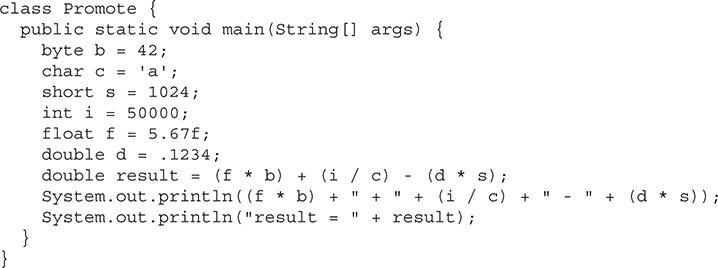
Let’s look closely at the type promotions that occur in this line from the program:
double result = (f * b) + (i / c) - (d * s);
In the first subexpression, f * b, b is promoted to a float and the result of the subexpression is float. Next, in the subexpression i/c, c is promoted to int, and the result is of type int. Then, in d * s, the value of s is promoted to double, and the type of the subexpression is double. Finally, these three intermediate values, float, int, and double, are considered. The outcome of float plus an int is a float. Then the resultant float minus the last double is promoted to double, which is the type for the final result of the expression.
An array is a group of like-typed variables that are referred to by a common name. Arrays of any type can be created and may have one or more dimensions. A specific element in an array is accessed by its index. Arrays offer a convenient means of grouping related information.
A one-dimensional array is, essentially, a list of like-typed variables. To create an array, you first must create an array variable of the desired type. The general form of a one-dimensional array declaration is
type[ ] var-name;
Here, type declares the element type (also called the base type) of the array. The element type determines the data type of each element that comprises the array. Thus, the element type for the array determines what type of data the array will hold. For example, the following declares an array named month_days with the type “array of int”:
int[] month_days;
Although this declaration establishes the fact that month_days is an array variable, no array actually exists. To link month_days with an actual, physical array of integers, you must allocate one using new and assign it to month_days. new is a special operator that allocates memory.
You will look more closely at new in a later chapter, but you need to use it now to allocate memory for arrays. The general form of new as it applies to one-dimensional arrays appears as follows:
array-var = new type [size];
Here, type specifies the type of data being allocated, size specifies the number of elements in the array, and array-var is the array variable that is linked to the array. That is, to use new to allocate an array, you must specify the type and number of elements to allocate. The elements in the array allocated by new will automatically be initialized to zero (for numeric types), false (for boolean), or null (for reference types, which are described in a later chapter). This example allocates a 12-element array of integers and links them to month_days:
month_days = new int[12];
After this statement executes, month_days will refer to an array of 12 integers. Further, all elements in the array will be initialized to zero.
Let’s review: Obtaining an array is a two-step process. First, you must declare a variable of the desired array type. Second, you must allocate the memory that will hold the array, using new, and assign it to the array variable. Thus, in Java all arrays are dynamically allocated. If the concept of dynamic allocation is unfamiliar to you, don’t worry. It will be described at length later in this book.
Once you have allocated an array, you can access a specific element in the array by specifying its index within square brackets. All array indexes start at zero. For example, this statement assigns the value 28 to the second element of month_days:
month_days[1] = 28;
The next line displays the value stored at index 3:
System.out.println(month_days[3]);
Putting together all the pieces, here is a program that creates an array of the number of days in each month:
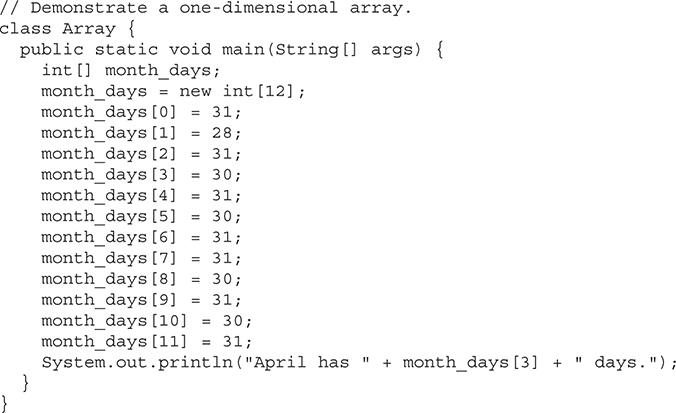
When you run this program, it prints the number of days in April. As mentioned, Java array indexes start with zero, so the number of days in April is month_days[3] or 30.
It is possible to combine the declaration of the array variable with the allocation of the array itself, as shown here:
int[] month_days = new int[12];
This is the way that you will normally see it done in professionally written Java programs.
Arrays can be initialized when they are declared. The process is much the same as that used to initialize the simple types. An array initializer is a list of comma-separated expressions surrounded by curly braces. The commas separate the values of the array elements. The array will automatically be created large enough to hold the number of elements you specify in the array initializer. There is no need to use new. For example, to store the number of days in each month, the following code creates an initialized array of integers:

When you run this program, you see the same output as that generated by the previous version.
Java strictly checks to make sure you do not accidentally try to store or reference values outside of the range of the array. The Java run-time system will check that all array indexes are in the correct range. For example, the run-time system will check the value of each index into month_days to make sure that it is between 0 and 11 inclusive. If you try to access elements outside the range of the array (negative numbers or numbers greater than the length of the array), you will cause a run-time error.
Here is one more example that uses a one-dimensional array. It finds the average of a set of numbers.
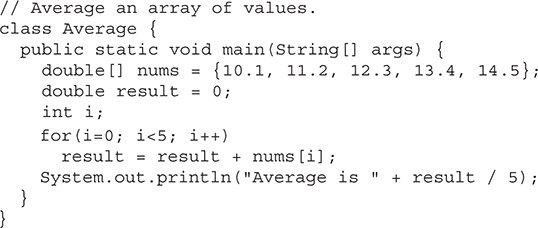
In Java, multidimensional arrays are implemented as arrays of arrays. To declare a multidimensional array variable, specify each additional index using another set of square brackets. For example, the following declares a two-dimensional array variable called twoD:
int[][] twoD = new int[4][5];
This allocates a 4 by 5 array and assigns it to twoD. Internally, this matrix is implemented as an array of arrays of int. Conceptually, this array will look like the one shown in Figure 3-1.
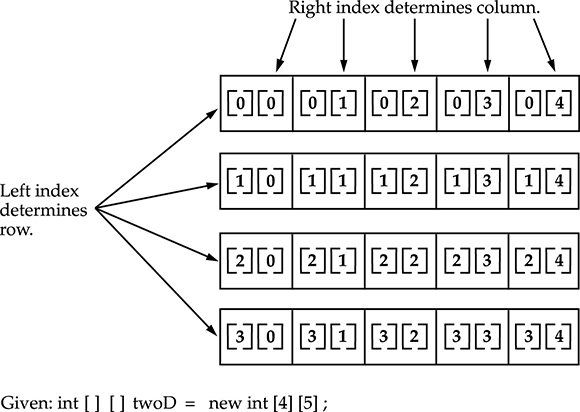
Figure 3-1 A conceptual view of a 4 by 5, two-dimensional array
The following program numbers each element in the array from left to right, top to bottom, and then displays these values:
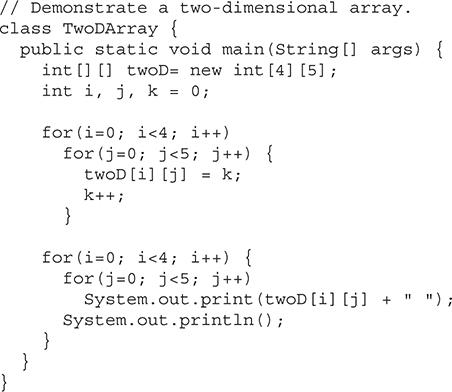
This program generates the following output:
0 1 2 3 4
5 6 7 8 9
10 11 12 13 14
15 16 17 18 19
When you allocate memory for a multidimensional array, you need only specify the memory for the first (leftmost) dimension. You can allocate the remaining dimensions separately. For example, this following code allocates memory for the first dimension of twoD when it is declared. It allocates the second dimension separately.
int[][] twoD = new int[4][];
twoD[0] = new int[5];
twoD[1] = new int[5];
twoD[2] = new int[5];
twoD[3] = new int[5];
While there is no advantage to individually allocating the second dimension arrays in this situation, there may be in others. For example, when you allocate dimensions individually, you do not need to allocate the same number of elements for each dimension. As stated earlier, since multidimensional arrays are actually arrays of arrays, the length of each array is under your control. For example, the following program creates a two-dimensional array in which the sizes of the second dimension are unequal:
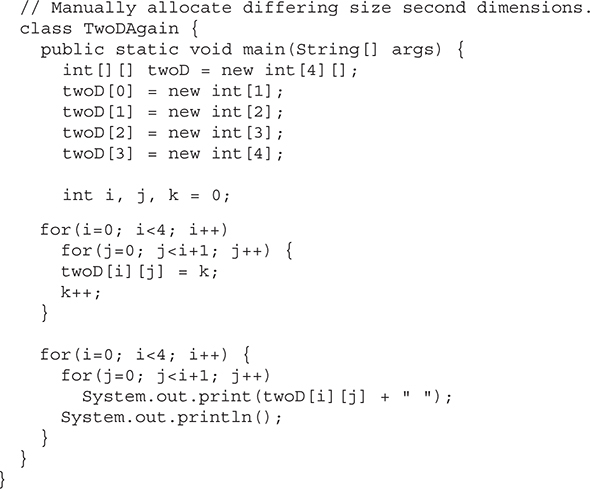
This program generates the following output:
0
1 2
3 4 5
6 7 8 9
The array created by this program looks like this:
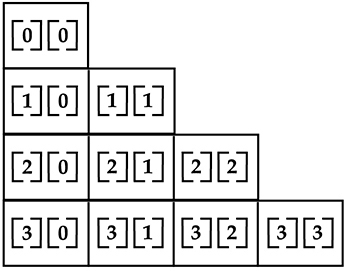
The use of uneven (or irregular) multidimensional arrays may not be appropriate for many applications, because it runs contrary to what people expect to find when a multidimensional array is encountered. However, irregular arrays can be used effectively in some situations. For example, if you need a very large two-dimensional array that is sparsely populated (that is, one in which not all of the elements will be used), then an irregular array might be a perfect solution.
It is possible to initialize multidimensional arrays. To do so, simply enclose each dimension’s initializer within its own set of curly braces. The following program creates a matrix where each element contains the product of the row and column indexes. Also notice that you can use expressions as well as literal values inside of array initializers.
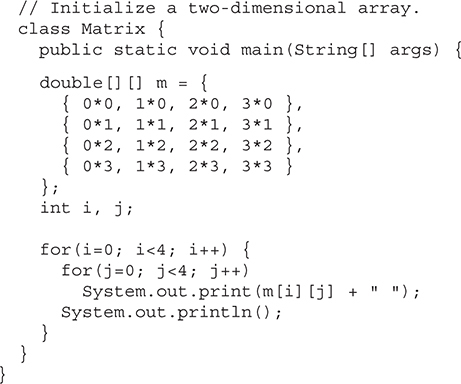
When you run this program, you will get the following output:
0.0 0.0 0.0 0.0
0.0 1.0 2.0 3.0
0.0 2.0 4.0 6.0
0.0 3.0 6.0 9.0
As you can see, each row in the array is initialized as specified in the initialization lists.
Let’s look at one more example that uses a multidimensional array. The following program creates a 3 by 4 by 5, three-dimensional array. It then loads each element with the product of its indexes. Finally, it displays these products.
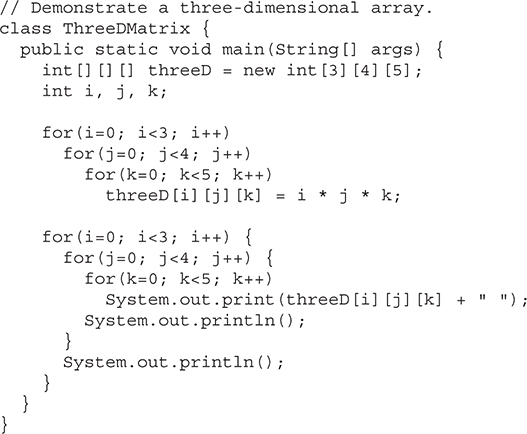
This program generates the following output:
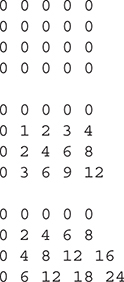
There is a second form that may be used to declare an array:
type var-name[ ];
Here, the square brackets follow the array variable name, and not the type specifier. For example, the following two declarations are equivalent:
int al[] = new int[3];
int[] a2 = new int[3];
The following declarations are also equivalent:
char twod1[][] = new char[3][4];
char[][] twod2 = new char[3][4];
This alternative declaration form offers convenience when converting code from C/C++ to Java. It also lets you declare both array and non-array variables in a single declaration statement. Today, the alternative form of array declaration is less commonly used, but it is still important that you are familiar with it because both forms of array declaration are legal in Java.
Not long ago, a new feature called local variable type inference was added to the Java language. To begin, let’s review two important aspects of variables. First, all variables in Java must be declared prior to their use. Second, a variable can be initialized with a value when it is declared. Furthermore, when a variable is initialized, the type of the initializer must be the same as (or convertible to) the declared type of the variable. Thus, in principle, it would not be necessary to specify an explicit type for an initialized variable because it could be inferred by the type of its initializer. Of course, in the past, such inference was not supported, and all variables required an explicitly declared type, whether they were initialized or not. Today, that situation has changed.
Beginning with JDK 10, it is now possible to let the compiler infer the type of a local variable based on the type of its initializer, thus avoiding the need to explicitly specify the type. Local variable type inference offers a number of advantages. For example, it can streamline code by eliminating the need to redundantly specify a variable’s type when it can be inferred from its initializer. It can simplify declarations in cases in which the type name is quite lengthy, such as can be the case with some class names. It can also be helpful when a type is difficult to discern or cannot be denoted. (An example of a type that cannot be denoted is the type of an anonymous class, discussed in Chapter 25.) Furthermore, local variable type inference has become a common part of the contemporary programming environment. Its inclusion in Java helps keep Java up-to-date with evolving trends in language design. To support local variable type inference, the context-sensitive keyword var was added.
To use local variable type inference, the variable must be declared with var as the type name and it must include an initializer. For example, in the past you would declare a local double variable called avg that is initialized with the value 10.0, as shown here:
double avg = 10.0;
Using type inference, this declaration can now also be written like this:
var avg = 10.0;
In both cases, avg will be of type double. In the first case, its type is explicitly specified. In the second, its type is inferred as double because the initializer 10.0 is of type double.
As mentioned, var is context-sensitive. When it is used as the type name in the context of a local variable declaration, it tells the compiler to use type inference to determine the type of the variable being declared based on the type of the initializer. Thus, in a local variable declaration, var is a placeholder for the actual, inferred type. However, when used in most other places, var is simply a user-defined identifier with no special meaning. For example, the following declaration is still valid:
int var = 1; // In this case, var is simply a user-defined identifier.
In this case, the type is explicitly specified as int and var is the name of the variable being declared. Even though it is context-sensitive, there are a few places in which the use of var is illegal. It cannot be used as the name of a class, for example.
The following program puts the preceding discussion into action:
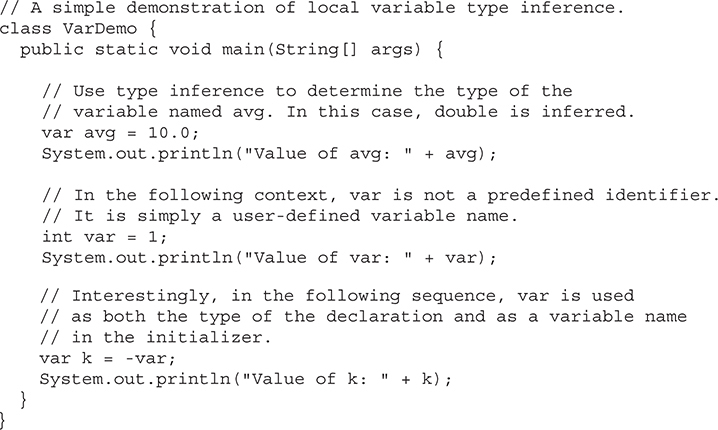
Here is the output:
Value of avg: 10.0
Value of var: 1
Value of k: -1
The preceding example uses var to declare only simple variables, but you can also use var to declare an array. For example:
var myArray = new int[10]; // This is valid.
Notice that neither var nor myArray has brackets. Instead, the type of myArray is inferred to be int[ ]. Furthermore, you cannot use brackets on the left side of a var declaration. Thus, both of these declarations are invalid:
var[] myArray = new int[10]; // Wrong
var myArray[] = new int[10]; // Wrong
In the first line, an attempt is made to bracket var. In the second, an attempt is made to bracket myArray. In both cases, the use of the brackets is wrong because the type is inferred from the type of the initializer.
It is important to emphasize that var can be used to declare a variable only when that variable is initialized. For example, the following statement is incorrect:
var counter; // Wrong! Initializer required.
Also, remember that var can be used only to declare local variables. It cannot be used when declaring instance variables, parameters, or return types, for example.
Although the preceding discussion and examples have introduced the basics of local variable type inference, they haven’t shown its full power. As you will see in Chapter 7, local variable type inference is especially effective in shortening declarations that involve long class names. It can also be used with generic types (see Chapter 14), in a try-with-resources statement (see Chapter 13), and with a for loop (see Chapter 5).
In addition to those mentioned in the preceding discussion, several other restrictions apply to the use of var. Only one variable can be declared at a time; a variable cannot use null as an initializer; and the variable being declared cannot be used by the initializer expression. Although you can declare an array type using var, you cannot use var with an array initializer. For example, this is valid:
var myArray = new int[10]; // This is valid.
but this is not:
var myArray = { 1, 2, 3 }; // Wrong
As mentioned earlier, var cannot be used as the name of a class. It also cannot be used as the name of other reference types, including an interface, enumeration, or annotation, or as the name of a generic type parameter, all of which are described later in this book. Here are two other restrictions that relate to Java features described in subsequent chapters but mentioned here in the interest of completeness. Local variable type inference cannot be used to declare the exception type caught by a catch statement. Also, neither lambda expressions nor method references can be used as initializers.
Note At the time of this writing, a number of readers of this book will be using Java environments that don’t support local variable type inference. So that as many of the code examples as possible will compile and run for all readers, local variable type inference will not be used by most of the programs in the remainder of this edition of the book. Using the full declaration syntax also makes it very clear at a glance what type of variable is being created, which is important for the example code. Of course, going forward, you should consider the use of local variable type inference where appropriate in your own code.
As you may have noticed, in the preceding discussion of data types and arrays there has been no mention of strings or a string data type. This is not because Java does not support such a type—it does. It is just that Java’s string type, called String, is not a primitive type. Nor is it simply an array of characters. Rather, String defines an object, and a full description of it requires an understanding of several object-related features. As such, it will be covered later in this book, after objects are described. However, so that you can use simple strings in example programs, the following brief introduction is in order.
The String type is used to declare string variables. You can also declare arrays of strings. A quoted string constant can be assigned to a String variable. A variable of type String can be assigned to another variable of type String. You can use an object of type String as an argument to println( ). For example, consider the following fragment:
String str = "this is a test";
System.out.println(str);
Here, str is an object of type String. It is assigned the string "this is a test". This string is displayed by the println( ) statement.
As you will see later, String objects have many special features and attributes that make them quite powerful and easy to use. However, for the next few chapters, you will be using them only in their simplest form.
Java provides a rich operator environment. Most of its operators can be divided into the following four groups: arithmetic, bitwise, relational, and logical. Java also defines some additional operators that handle certain special situations. This chapter describes all of Java’s operators except for the type comparison operator instanceof, which is examined in Chapter 13 and the arrow operator (–>), which is described in Chapter 15.
Arithmetic operators are used in mathematical expressions in the same way that they are used in algebra. The following table lists the arithmetic operators:
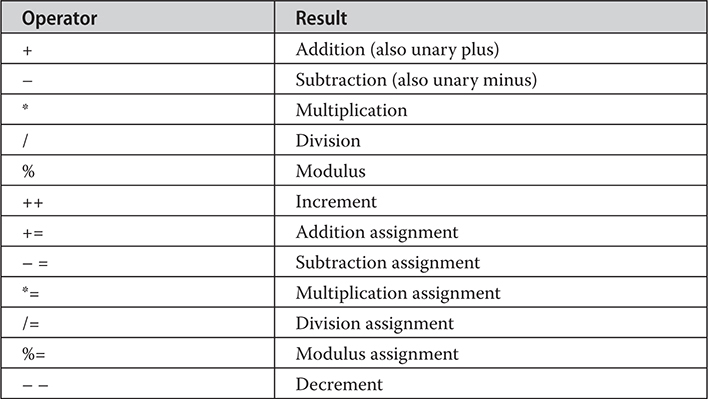
The operands of the arithmetic operators must be of a numeric type. You cannot use them on boolean types, but you can use them on char types, since the char type in Java is, essentially, a subset of int.
The basic arithmetic operations—addition, subtraction, multiplication, and division—all behave as you would expect for all numeric types. The unary minus operator negates its single operand. The unary plus operator simply returns the value of its operand. Remember that when the division operator is applied to an integer type, there will be no fractional component attached to the result.
The following simple example program demonstrates the arithmetic operators. It also illustrates the difference between floating-point division and integer division.
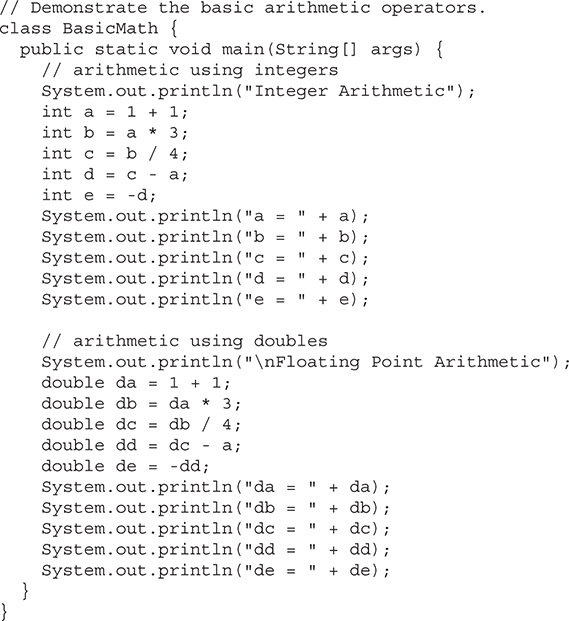
When you run this program, you will see the following output:
Integer Arithmetic
a = 2
b = 6
c = 1
d = -1
e = 1
Floating Point Arithmetic
da = 2.0
db = 6.0
dc = 1.5
dd = -0.5
de = 0.5
The modulus operator, %, returns the remainder of a division operation. It can be applied to floating-point types as well as integer types. The following example program demonstrates the %:
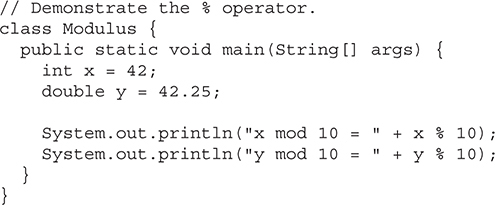
When you run this program, you will get the following output:
x mod 10 = 2
y mod 10 = 2.25
Java provides special operators that can be used to combine an arithmetic operation with an assignment. As you probably know, statements like the following are quite common in programming:
a = a + 4;
In Java, you can rewrite this statement as shown here:
a += 4;
This version uses the += compound assignment operator. Both statements perform the same action: they increase the value of a by 4.
Here is another example,
a = a % 2;
which can be expressed as
a %= 2;
In this case, the %= obtains the remainder of a /2 and puts that result back into a.
There are compound assignment operators for all of the arithmetic, binary operators. Thus, any statement of the form
var = var op expression;
can be rewritten as
var op= expression;
The compound assignment operators provide two benefits. First, they save you a bit of typing, because they are “shorthand” for their equivalent long forms. Second, in some cases they are more efficient than are their equivalent long forms. For these reasons, you will often see the compound assignment operators used in professionally written Java programs.
Here is a sample program that shows several op= assignments in action:
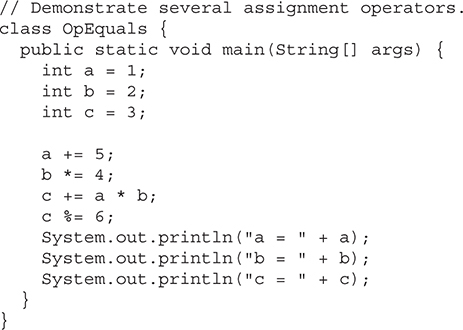
The output of this program is shown here:
a = 6
b = 8
c = 3
The ++ and the – – are Java’s increment and decrement operators. They were introduced in Chapter 2. Here they will be discussed in detail. As you will see, they have some special properties that make them quite interesting. Let’s begin by reviewing precisely what the increment and decrement operators do.
The increment operator increases its operand by one. The decrement operator decreases its operand by one. For example, this statement:
x = x + 1;
can be rewritten like this by use of the increment operator:
x++;
Similarly, this statement:
x = x - 1;
is equivalent to
x--;
These operators are unique in that they can appear both in postfix form, where they follow the operand as just shown, and prefix form, where they precede the operand. In the foregoing examples, there is no difference between the prefix and postfix forms. However, when the increment and/or decrement operators are part of a larger expression, then a subtle, yet powerful, difference between these two forms appears. In the prefix form, the operand is incremented or decremented before the value is obtained for use in the expression. In postfix form, the previous value is obtained for use in the expression, and then the operand is modified. For example:
x = 42;
y = ++x;
In this case, y is set to 43 as you would expect, because the increment occurs before x is assigned to y. Thus, the line y = ++x; is the equivalent of these two statements:
x = x + 1;
y = x;
However, when written like this,
x = 42;
y = x++;
the value of x is obtained before the increment operator is executed, so the value of y is 42. Of course, in both cases x is set to 43. Here, the line y = x++; is the equivalent of these two statements:
y = x;
x = x + 1;
The following program demonstrates the increment operator.
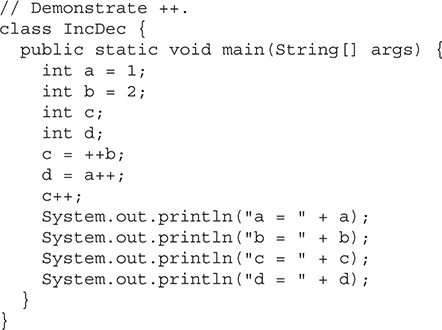
The output of this program follows:
a = 2
b = 3
c = 4
d = 1
Java defines several bitwise operators that can be applied to the integer types: long, int, short, char, and byte. These operators act upon the individual bits of their operands. They are summarized in the following table:
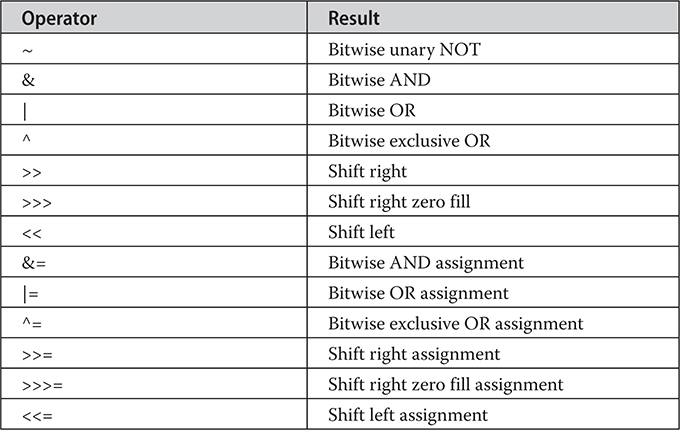
Since the bitwise operators manipulate the bits within an integer: it is important to understand what effects such manipulations may have on a value. Specifically, it is useful to know how Java stores integer values and how it represents negative numbers. So, before continuing, let’s briefly review these two topics.
All of the integer types are represented by binary numbers of varying bit widths. For example, the byte value for 42 in binary is 00101010, where each position represents a power of two, starting with 20 at the rightmost bit. The next bit position to the left would be 21, or 2, continuing toward the left with 22, or 4, then 8, 16, 32, and so on. So 42 has 1 bits set at positions 1, 3, and 5 (counting from 0 at the right); thus, 42 is the sum of 21 + 23 + 25, which is 2 + 8 + 32.
All of the integer types (except char) are signed integers. This means that they can represent negative values as well as positive ones. Java uses an encoding known as two’s complement, which means that negative numbers are represented by inverting (changing 1’s to 0’s and vice versa) all of the bits in a value, then adding 1 to the result. For example, –42 is represented by inverting all of the bits in 42, or 00101010, which yields 11010101, then adding 1, which results in 11010110, or –42. To decode a negative number, first invert all of the bits, then add 1. For example, –42, or 11010110 inverted, yields 00101001, or 41, so when you add 1 you get 42.
The reason Java (and most other computer languages) uses two’s complement is easy to see when you consider the issue of zero crossing. Assuming a byte value, zero is represented by 00000000. In one’s complement, simply inverting all of the bits creates 11111111, which creates negative zero. The trouble is that negative zero is invalid in integer math. This problem is solved by using two’s complement to represent negative values. When using two’s complement, 1 is added to the complement, producing 100000000. This produces a 1 bit too far to the left to fit back into the byte value, resulting in the desired behavior, where –0 is the same as 0, and 11111111 is the encoding for –1. Although we used a byte value in the preceding example, the same basic principle applies to all of Java’s integer types.
Because Java uses two’s complement to store negative numbers—and because all integers are signed values in Java—applying the bitwise operators can easily produce unexpected results. For example, turning on the high-order bit will cause the resulting value to be interpreted as a negative number, whether this is what you intended or not. To avoid unpleasant surprises, just remember that the high-order bit determines the sign of an integer no matter how that high-order bit gets set.
The bitwise logical operators are &, |, ^, and ~. The following table shows the outcome of each operation. In the discussion that follows, keep in mind that the bitwise operators are applied to each individual bit within each operand.

Also called the bitwise complement, the unary NOT operator, ~, inverts all of the bits of its operand. For example, the number 42, which has the following bit pattern:
00101010
becomes
11010101
after the NOT operator is applied.
The AND operator, &, produces a 1 bit if both operands are also 1. A zero is produced in all other cases. Here is an example:

The OR operator, |, combines bits such that if either of the bits in the operands is a 1, then the resultant bit is a 1, as shown here:

The XOR operator, ^, combines bits such that if exactly one operand is 1, then the result is 1. Otherwise, the result is zero. The following example shows the effect of the ^. This example also demonstrates a useful attribute of the XOR operation. Notice how the bit pattern of 42 is inverted wherever the second operand has a 1 bit. Wherever the second operand has a 0 bit, the first operand is unchanged. You will find this property useful when performing some types of bit manipulations.

The following program demonstrates the bitwise logical operators:
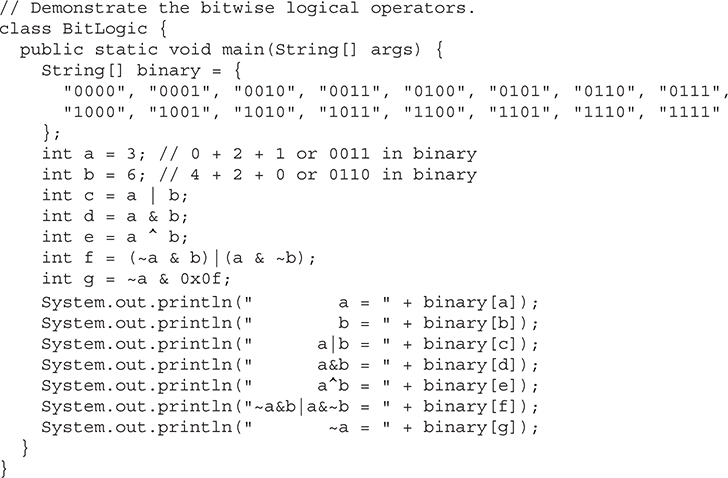
In this example, a and b have bit patterns that present all four possibilities for two binary digits: 0-0, 0-1, 1-0, and 1-1. You can see how the | and & operate on each bit by the results in c and d. The values assigned to e and f are the same and illustrate how the ^ works. The string array named binary holds the human-readable, binary representation of the numbers 0 through 15. In this example, the array is indexed to show the binary representation of each result. The array is constructed such that the correct string representation of a binary value n is stored in binary[n]. The value of ~a is ANDed with 0x0f (0000 1111 in binary) in order to reduce its value to less than 16, so it can be printed by use of the binary array. Here is the output from this program:
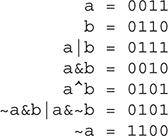
The left shift operator, <<, shifts all of the bits in a value to the left a specified number of times. It has this general form:
value << num
Here, num specifies the number of positions to left-shift the value in value. That is, the << moves all of the bits in the specified value to the left by the number of bit positions specified by num. For each shift left, the high-order bit is shifted out (and lost), and a zero is brought in on the right. This means that when a left shift is applied to an int operand, bits are lost once they are shifted past bit position 31. If the operand is a long, then bits are lost after bit position 63.
Java’s automatic type promotions produce unexpected results when you are shifting byte and short values. As you know, byte and short values are promoted to int when an expression is evaluated. Furthermore, the result of such an expression is also an int. This means that the outcome of a left shift on a byte or short value will be an int, and the bits shifted left will not be lost until they shift past bit position 31. Furthermore, a negative byte or short value will be sign-extended when it is promoted to int. Thus, the high-order bits will be filled with 1’s. For these reasons, to perform a left shift on a byte or short implies that you must discard the high-order bytes of the int result. For example, if you left-shift a byte value, that value will first be promoted to int and then shifted. This means that you must discard the top three bytes of the result if what you want is the result of a shifted byte value. The easiest way to do this is to simply cast the result back into a byte. The following program demonstrates this concept:
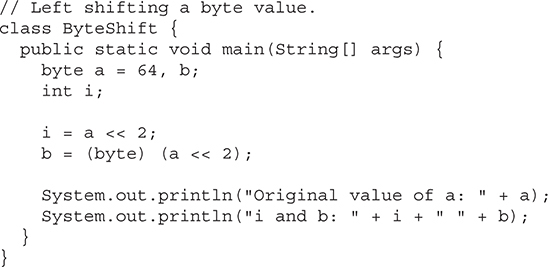
The output generated by this program is shown here:
Original value of a: 64
i and b: 256 0
Since a is promoted to int for the purposes of evaluation, left-shifting the value 64 (0100 0000) twice results in i containing the value 256 (1 0000 0000). However, the value in b contains 0 because after the shift, the low-order byte is now zero. Its only 1 bit has been shifted out.
Since each left shift has the effect of doubling the original value, programmers frequently use this fact as an efficient alternative to multiplying by 2. But you need to watch out. If you shift a 1 bit into the high-order position (bit 31 or 63), the value will become negative. The following program illustrates this point:
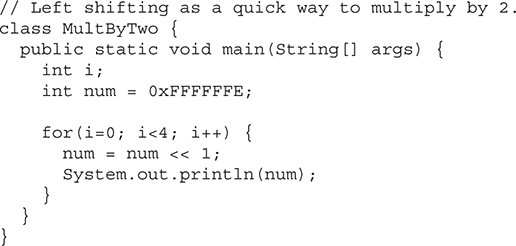
The program generates the following output:
536870908
1073741816
2147483632
-32
The starting value was carefully chosen so that after being shifted left 4 bit positions, it would produce –32. As you can see, when a 1 bit is shifted into bit 31, the number is interpreted as negative.
The right shift operator, >>, shifts all of the bits in a value to the right a specified number of times. Its general form is shown here:
value >> num
Here, num specifies the number of positions to right-shift the value in value. That is, the >> moves all of the bits in the specified value to the right the number of bit positions specified by num.
The following code fragment shifts the value 32 to the right by two positions, resulting in a being set to 8:
int a = 32;
a = a >> 2; // a now contains 8
When a value has bits that are “shifted off,” those bits are lost. For example, the next code fragment shifts the value 35 to the right two positions, which causes the two low-order bits to be lost, resulting again in a being set to 8:
int a = 35;
a = a >> 2; // a contains 8
Looking at the same operation in binary shows more clearly how this happens:

Each time you shift a value to the right, it divides that value by two—and discards any remainder. In some cases, you can take advantage of this for high-performance integer division by 2.
When you are shifting right, the top (leftmost) bits exposed by the right shift are filled in with the previous contents of the top bit. This is called sign extension and serves to preserve the sign of negative numbers when you shift them right. For example, –8 >> 1 is –4, which, in binary, is

It is interesting to note that if you shift –1 right, the result always remains –1, since sign extension keeps bringing in more ones in the high-order bits.
Sometimes it is not desirable to sign-extend values when you are shifting them to the right. For example, the following program converts a byte value to its hexadecimal string representation. Notice that the shifted value is masked by ANDing it with 0x0f to discard any sign-extended bits so that the value can be used as an index into the array of hexadecimal characters.
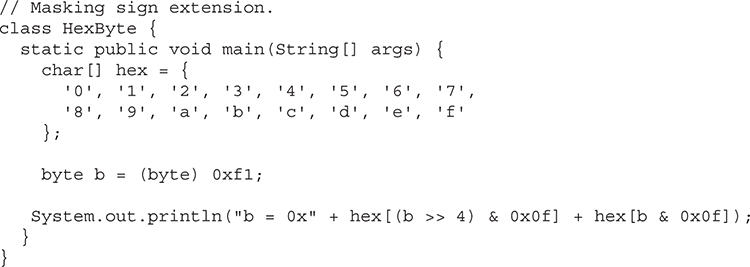
Here is the output of this program:
b = 0xf1
As you have just seen, the >> operator automatically fills the high-order bit with its previous contents each time a shift occurs. This preserves the sign of the value. However, sometimes this is undesirable. For example, if you are shifting something that does not represent a numeric value, you may not want sign extension to take place. This situation is common when you are working with pixel-based values and graphics. In these cases, you will generally want to shift a zero into the high-order bit no matter what its initial value was. This is known as an unsigned shift. To accomplish this, you will use Java’s unsigned, shift-right operator, >>>, which always shifts zeros into the high-order bit.
The following code fragment demonstrates the >>>. Here, a is set to –1, which sets all 32 bits to 1 in binary. This value is then shifted right 24 bits, filling the top 24 bits with zeros, ignoring normal sign extension. This sets a to 255.
int a = -1;
a = a >>> 24;
Here is the same operation in binary form to further illustrate what is happening:
11111111 11111111 11111111 11111111 –1 in binary as an int
>>>24
00000000 00000000 00000000 11111111 255 in binary as an int
The >>> operator is often not as useful as you might like, since it is only meaningful for 32- and 64-bit values. Remember, smaller values are automatically promoted to int in expressions. This means that sign extension occurs and that the shift will take place on a 32-bit rather than on an 8- or 16-bit value. That is, one might expect an unsigned right shift on a byte value to zero-fill beginning at bit 7. But this is not the case, since it is a 32-bit value that is actually being shifted. The following program demonstrates this effect:
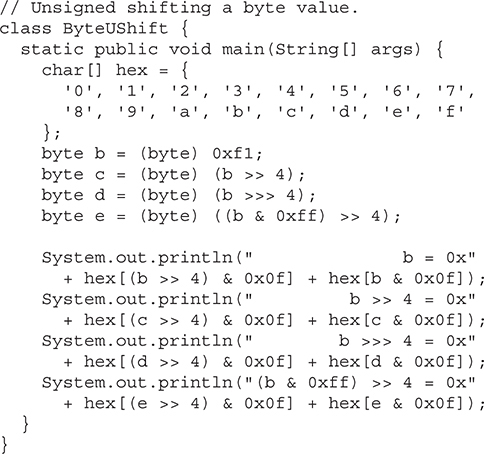
The following output of this program shows how the >>> operator appears to do nothing when dealing with bytes. The variable b is set to an arbitrary negative byte value for this demonstration. Then c is assigned the byte value of b shifted right by four, which is 0xff because of the expected sign extension. Then d is assigned the byte value of b unsigned shifted right by four, which you might have expected to be 0x0f, but is actually 0xff because of the sign extension that happened when b was promoted to int before the shift. The last expression sets e to the byte value of b masked to 8 bits using the AND operator, then shifted right by four, which produces the expected value of 0x0f. Notice that the unsigned shift right operator was not used for d, since the state of the sign bit after the AND was known.

All of the binary bitwise operators have a compound form similar to that of the algebraic operators, which combines the assignment with the bitwise operation. For example, the following two statements, which shift the value in a right by four bits, are equivalent:
a = a >> 4;
a >>= 4;
Likewise, the following two statements, which result in a being assigned the bitwise expression a OR b, are equivalent:
a = a | b;
a |= b;
The following program creates a few integer variables and then uses compound bitwise operator assignments to manipulate the variables:
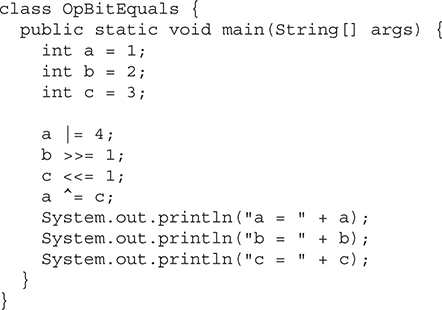
The output of this program is shown here:
a = 3
b = 1
c = 6
The relational operators determine the relationship that one operand has to the other. Specifically, they determine equality and ordering. The relational operators are shown here:
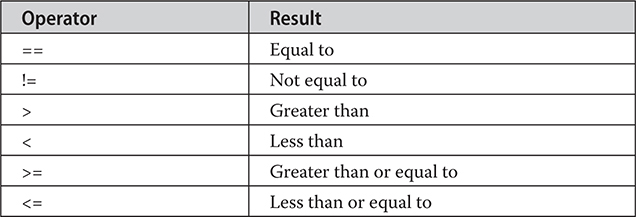
The outcome of these operations is a boolean value. The relational operators are most frequently used in the expressions that control the if statement and the various loop statements.
Any type in Java, including integers, floating-point numbers, characters, and Booleans can be compared using the equality test, ==, and the inequality test, !=. Notice that in Java equality is denoted with two equal signs, not one. (Remember: a single equal sign is the assignment operator.) Only numeric types can be compared using the ordering operators. That is, only integer, floating-point, and character operands may be compared to see which is greater or less than the other.
As stated, the result produced by a relational operator is a boolean value. For example, the following code fragment is perfectly valid:
int a = 4;
int b = 1;
boolean c = a < b;
In this case, the result of a<b (which is false) is stored in c.
If you are coming from a C/C++ background, please note the following. In C/C++, these types of statements are very common:
int done;
//...
if(!done)... // Valid in C/C++
if(done)... // but not in Java.
In Java, these statements must be written like this:
if(done == 0)... // This is Java-style.
if(done != 0)...
The reason is that Java does not define true and false in the same way as C/C++. In C/C++, true is any nonzero value and false is zero. In Java, true and false are nonnumeric values that do not relate to zero or nonzero. Therefore, to test for zero or nonzero, you must explicitly employ one or more of the relational operators.
The Boolean logical operators shown here operate only on boolean operands. All of the binary logical operators combine two boolean values to form a resultant boolean value.
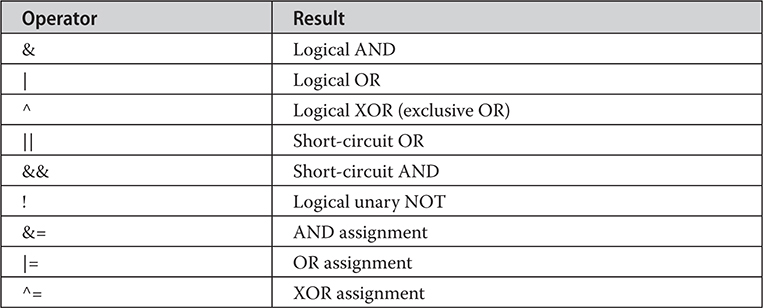

The logical Boolean operators, &, |, and ^, operate on boolean values in the same way that they operate on the bits of an integer. The logical ! operator inverts the Boolean state: !true == false and !false == true. The following table shows the effect of each logical operation:

Here is a program that is almost the same as the BitLogic example shown earlier, but it operates on boolean logical values instead of binary bits:
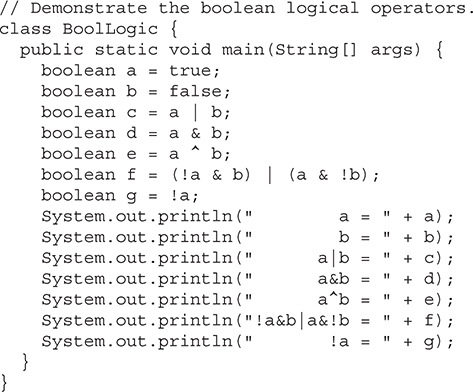
After running this program, you will see that the same logical rules apply to boolean values as they did to bits. As you can see from the following output, the string representation of a Java boolean value is one of the literal values true or false:
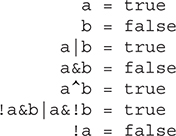
Java provides two interesting Boolean operators not found in some other computer languages. These are secondary versions of the Boolean AND and OR operators, and are commonly known as short-circuit logical operators. As you can see from the preceding table, the OR operator results in true when A is true, no matter what B is. Similarly, the AND operator results in false when A is false, no matter what B is. If you use the || and && forms, rather than the | and & forms of these operators, Java will not bother to evaluate the right-hand operand when the outcome of the expression can be determined by the left operand alone. This is very useful when the right-hand operand depends on the value of the left one in order to function properly. For example, the following code fragment shows how you can take advantage of short-circuit logical evaluation to be sure that a division operation will be valid before evaluating it:
if (denom != 0 && num / denom > 10)
Since the short-circuit form of AND (&&) is used, there is no risk of causing a run-time exception when denom is zero. If this line of code were written using the single & version of AND, both sides would be evaluated, causing a run-time exception when denom is zero.
It is standard practice to use the short-circuit forms of AND and OR in cases involving Boolean logic, leaving the single-character versions exclusively for bitwise operations. However, there are exceptions to this rule. For example, consider the following statement:
if(c==1 & e++ < 100) d = 100;
Here, using a single & ensures that the increment operation will be applied to e whether c is equal to 1 or not.
Note The formal specification for Java refers to the short-circuit operators as the conditional-and and the conditional-or.
You have been using the assignment operator since Chapter 2. Now it is time to take a formal look at it. The assignment operator is the single equal sign, =. The assignment operator works in Java much as it does in any other computer language. It has this general form:
var = expression;
Here, the type of var must be compatible with the type of expression.
The assignment operator does have one interesting attribute that you may not be familiar with: it allows you to create a chain of assignments. For example, consider this fragment:
int x, y, z;
x = y = z = 100; // set x, y, and z to 100
This fragment sets the variables x, y, and z to 100 using a single statement. This works because the = is an operator that yields the value of the right-hand expression. Thus, the value of z = 100 is 100, which is then assigned to y, which in turn is assigned to x. Using a “chain of assignment” is an easy way to set a group of variables to a common value.
Java includes a special ternary (three-way) operator that can replace certain types of if-then-else statements. This operator is the ?. It can seem somewhat confusing at first, but the ? can be used very effectively once mastered. The ? has this general form:
expression1 ? expression2 : expression3
Here, expression1 can be any expression that evaluates to a boolean value. If expression1 is true, then expression2 is evaluated; otherwise, expression3 is evaluated. The result of the ? operation is that of the expression evaluated. Both expression2 and expression3 are required to return the same (or compatible) type, which can’t be void.
Here is an example of the way that the ? is employed:
ratio = denom == 0 ? 0 : num / denom;
When Java evaluates this assignment expression, it first looks at the expression to the left of the question mark. If denom equals zero, then the expression between the question mark and the colon is evaluated and used as the value of the entire ? expression. If denom does not equal zero, then the expression after the colon is evaluated and used for the value of the entire ? expression. The result produced by the ? operator is then assigned to ratio.
Here is a program that demonstrates the ? operator. It uses it to obtain the absolute value of a variable.
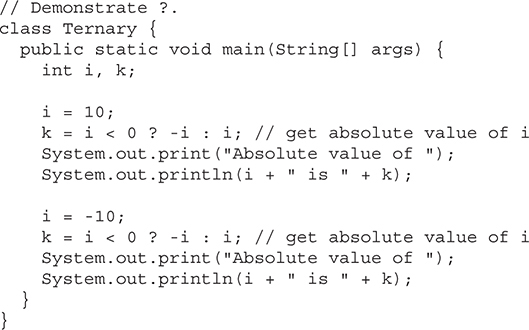
The output generated by the program is shown here:
Absolute value of 10 is 10
Absolute value of -10 is 10
Table 4-1 shows the order of precedence for Java operators, from highest to lowest. Operators in the same row are equal in precedence. In binary operations, the order of evaluation is left to right (except for assignment, which evaluates right to left). Although they are technically separators, the [ ], ( ), and . can also act like operators. In that capacity, they would have the highest precedence. Also, notice the arrow operator (->). It is used in lambda expressions.
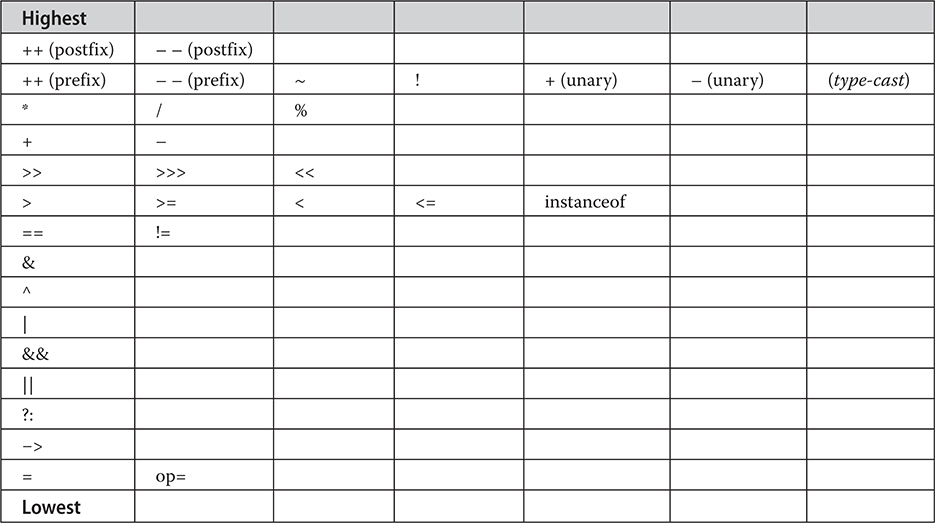
Table 4-1 The Precedence of the Java Operators
Parentheses raise the precedence of the operations that are inside them. This is often necessary to obtain the result you desire. For example, consider the following expression:
a >> b + 3
This expression first adds 3 to b and then shifts a right by that result. That is, this expression can be rewritten using redundant parentheses like this:
a >> (b + 3)
However, if you want to first shift a right by b positions and then add 3 to that result, you will need to parenthesize the expression like this:
(a >> b) + 3
In addition to altering the normal precedence of an operator, parentheses can sometimes be used to help clarify the meaning of an expression. For anyone reading your code, a complicated expression can be difficult to understand. Adding redundant but clarifying parentheses to complex expressions can help prevent confusion later. For example, which of the following expressions is easier to read?
a | 4 + c >> b & 7
(a | (((4 + c) >> b) & 7))
One other point: parentheses (redundant or not) do not degrade the performance of your program. Therefore, adding parentheses to reduce ambiguity does not negatively affect your program.
A programming language uses control statements to cause the flow of execution to advance and branch based on changes to the state of a program. Java’s program control statements can be put into the following categories: selection, iteration, and jump. Selection statements allow your program to choose different paths of execution based upon the outcome of an expression or the state of a variable. Iteration statements enable program execution to repeat one or more statements (that is, iteration statements form loops). Jump statements allow your program to execute in a nonlinear fashion. All of Java’s control statements are examined here.
Java supports two selection statements: if and switch. These statements allow you to control the flow of your program’s execution based upon conditions known only during run time. You will be pleasantly surprised by the power and flexibility contained in these two statements.
The if statement was introduced in Chapter 2. It is examined in detail here. The if statement is Java’s conditional branch statement. It can be used to route program execution through two different paths. Here is the general form of the if statement:
if (condition) statement1;
else statement2;
Here, each statement may be a single statement or a compound statement enclosed in curly braces (that is, a block). The condition is any expression that returns a boolean value. The else clause is optional.
The if works like this: If the condition is true, then statement1 is executed. Otherwise, statement2 (if it exists) is executed. In no case will both statements be executed. For example, consider the following:
int a, b;
//...
if(a < b) a = 0;
else b = 0;
Here, if a is less than b, then a is set to zero. Otherwise, b is set to zero. In no case are they both set to zero.
Most often, the expression used to control the if will involve the relational operators. However, this is not technically necessary. It is possible to control the if using a single boolean variable, as shown in this code fragment:
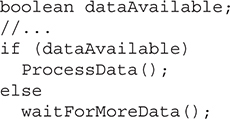
Remember, only one statement can appear directly after the if or the else. If you want to include more statements, you’ll need to create a block, as in this fragment:
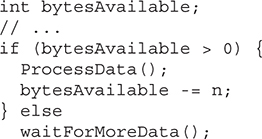
Here, both statements within the if block will execute if bytesAvailable is greater than zero.
Some programmers find it convenient to include the curly braces when using the if, even when there is only one statement in each clause. This makes it easy to add another statement at a later date, and you don’t have to worry about forgetting the braces. In fact, forgetting to define a block when one is needed is a common cause of errors. For example, consider the following code fragment:
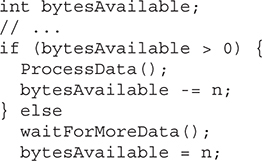
It seems clear that the statement bytesAvailable = n; was intended to be executed inside the else clause, because of the indentation level. However, as you recall, whitespace is insignificant to Java, and there is no way for the compiler to know what was intended. This code will compile without complaint, but it will behave incorrectly when run. The preceding example is fixed in the code that follows:
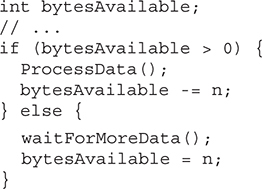
A nested if is an if statement that is the target of another if or else. Nested ifs are very common in programming. When you nest ifs, the main thing to remember is that an else statement always refers to the nearest if statement that is within the same block as the else and that is not already associated with an else. Here is an example:

As the comments indicate, the final else is not associated with if(j<20) because it is not in the same block (even though it is the nearest if without an else). Rather, the final else is associated with if(i==10). The inner else refers to if(k>100) because it is the closest if within the same block.
A common programming construct that is based upon a sequence of nested ifs is the if-else-if ladder. It looks like this:
if(condition)
statement;
else if(condition)
statement;
else if(condition)
statement;
.
.
.
else
statement;
The if statements are executed from the top down. As soon as one of the conditions controlling the if is true, the statement associated with that if is executed, and the rest of the ladder is bypassed. If none of the conditions is true, then the final else statement will be executed. The final else acts as a default condition; that is, if all other conditional tests fail, then the last else statement is performed. If there is no final else and all other conditions are false, then no action will take place.
Here is a program that uses an if-else-if ladder to determine which season a particular month is in.
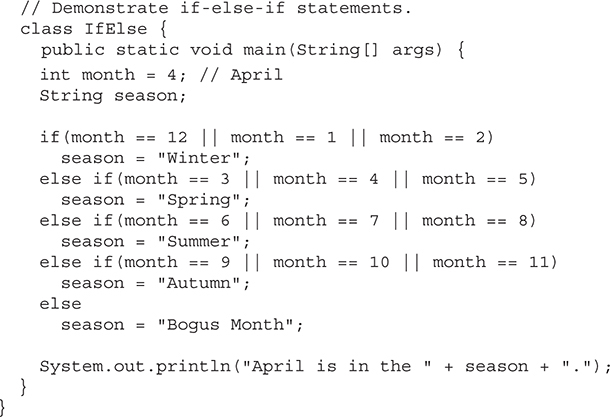
Here is the output produced by the program:
April is in the Spring.
You might want to experiment with this program before moving on. As you will find, no matter what value you give month, one and only one assignment statement within the ladder will be executed.
The switch statement is Java’s multiway branch statement. It provides an easy way to dispatch execution to different parts of your code based on the value of an expression. As such, it often provides a better alternative than a large series of if-else-if statements.
At the outset, it is necessary to state that beginning with JDK 14, the switch has been significantly enhanced and expanded with several new features that go far beyond its traditional form. The traditional form of switch has been part of Java from the beginning and is, therefore, in widespread use. Furthermore, it is the form that will work in all Java development environments and for all readers. Because of the substantial nature of the recent switch enhancements, they are described in Chapter 17, in the context of other recent additions to Java. Here, the traditional form of the switch is examined. Here is the general form of a traditional switch statement:
switch (expression) {
case value1:
// statement sequence
break;
case value2:
// statement sequence
break;
.
.
.
case valueN :
// statement sequence
break;
default:
// default statement sequence
}
For versions of Java prior to JDK 7, expression must resolve to type byte, short, int, char, or an enumeration. (Enumerations are described in Chapter 12.) Today, expression can also be of type String. Each value specified in the case statements must be a unique constant expression (such as a literal value). Duplicate case values are not allowed. The type of each value must be compatible with the type of expression.
The traditional switch statement works like this: The value of the expression is compared with each of the values in the case statements. If a match is found, the code sequence following that case statement is executed. If none of the constants matches the value of the expression, then the default statement is executed. However, the default statement is optional. If no case matches and no default is present, then no further action is taken.
The break statement is used inside the switch to terminate a statement sequence. When a break statement is encountered, execution branches to the first line of code that follows the entire switch statement. This has the effect of “jumping out” of the switch.
Here is a simple example that uses a switch statement:
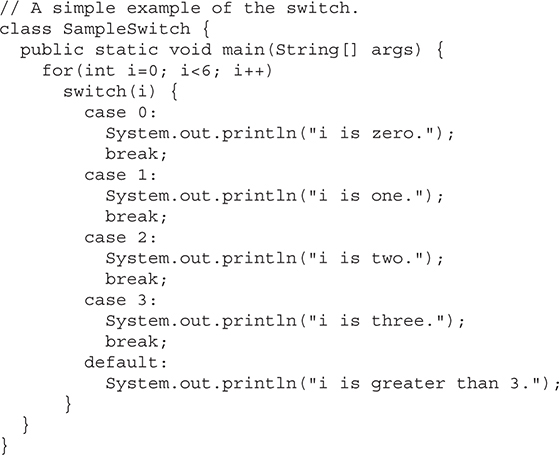
The output produced by this program is shown here:
i is zero.
i is one.
i is two.
i is three.
i is greater than 3.
i is greater than 3.
As you can see, each time through the loop, the statements associated with the case constant that matches i are executed. All others are bypassed. After i is greater than 3, no case statements match, so the default statement is executed.
The break statement is optional. If you omit the break, execution will continue on into the next case. It is sometimes desirable to have multiple cases without break statements between them. For example, consider the following program:
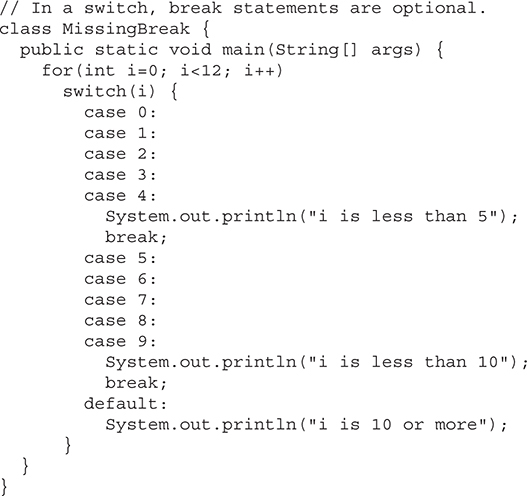
This program generates the following output:
i is less than 5
i is less than 5
i is less than 5
i is less than 5
i is less than 5
i is less than 10
i is less than 10
i is less than 10
i is less than 10
i is less than 10
i is 10 or more
i is 10 or more
As you can see, execution falls through each case until a break statement (or the end of the switch) is reached.
While the preceding example is, of course, contrived for the sake of illustration, omitting the break statement has many practical applications in real programs. To sample its more realistic usage, consider the following rewrite of the season example shown earlier. This version uses a switch to provide a more efficient implementation.
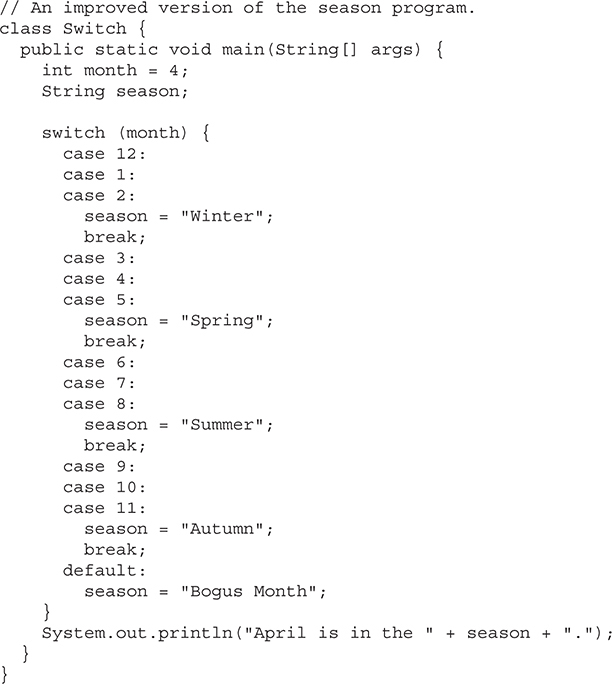
As mentioned, you can also use a string to control a switch statement. For example,
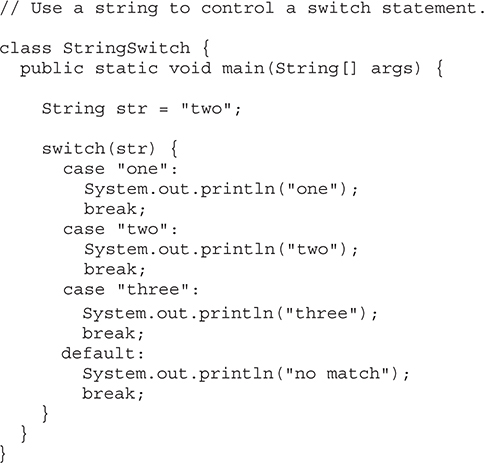
As you would expect, the output from the program is
two
The string contained in str (which is "two" in this program) is tested against the case constants. When a match is found (as it is in the second case), the code sequence associated with that sequence is executed.
Being able to use strings in a switch statement streamlines many situations. For example, using a string-based switch is an improvement over using the equivalent sequence of if/else statements. However, switching on strings can be more expensive than switching on integers. Therefore, it is best to switch on strings only in cases in which the controlling data is already in string form. In other words, don’t use strings in a switch unnecessarily.
You can use a switch as part of the statement sequence of an outer switch. This is called a nested switch. Since a switch statement defines its own block, no conflicts arise between the case constants in the inner switch and those in the outer switch. For example, the following fragment is perfectly valid:
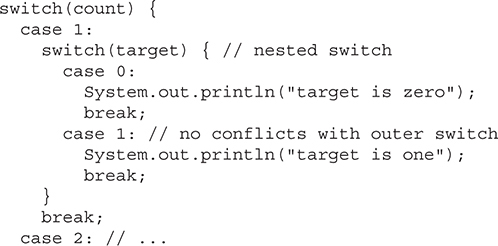
Here, the case 1: statement in the inner switch does not conflict with the case 1: statement in the outer switch. The count variable is compared only with the list of cases at the outer level. If count is 1, then target is compared with the inner list cases.
In summary, there are three important features of the switch statement to note:
• The switch differs from the if in that switch can only test for equality, whereas if can evaluate any type of Boolean expression. That is, the switch looks only for a match between the value of the expression and one of its case constants.
• No two case constants in the same switch can have identical values. Of course, a switch statement and an enclosing outer switch can have case constants in common.
• A switch statement is usually more efficient than a set of nested ifs.
The last point is particularly interesting because it gives insight into how the Java compiler works. When it compiles a switch statement, the Java compiler will inspect each of the case constants and create a “jump table” that it will use for selecting the path of execution depending on the value of the expression. Therefore, if you need to select among a large group of values, a switch statement will run much faster than the equivalent logic coded using a sequence of if-elses. The compiler can do this because it knows that the case constants are all the same type and simply must be compared for equality with the switch expression. The compiler has no such knowledge of a long list of if expressions.
Remember Recently, the capabilities and features of switch have been substantially expanded beyond those offered by the traditional switch just described. Refer to Chapter 17 for details on the enhanced switch.
Java’s iteration statements are for, while, and do-while. These statements create what we commonly call loops. As you probably know, a loop repeatedly executes the same set of instructions until a termination condition is met. As you will see, Java has a loop to fit any programming need.
The while loop is Java’s most fundamental loop statement. It repeats a statement or block while its controlling expression is true. Here is its general form:
while(condition) {
// body of loop
}
The condition can be any Boolean expression. The body of the loop will be executed as long as the conditional expression is true. When condition becomes false, control passes to the next line of code immediately following the loop. The curly braces are unnecessary if only a single statement is being repeated.
Here is a while loop that counts down from 10, printing exactly ten lines of "tick":
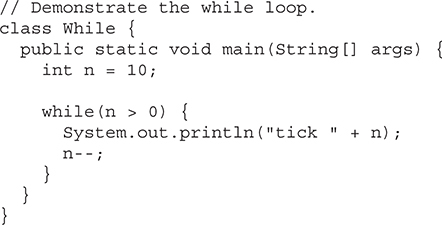
When you run this program, it will “tick” ten times:
tick 10
tick 9
tick 8
tick 7
tick 6
tick 5
tick 4
tick 3
tick 2
tick 1
Since the while loop evaluates its conditional expression at the top of the loop, the body of the loop will not execute even once if the condition is false to begin with. For example, in the following fragment, the call to println() is never executed:

The body of the while (or any other of Java’s loops) can be empty. This is because a null statement (one that consists only of a semicolon) is syntactically valid in Java. For example, consider the following program:
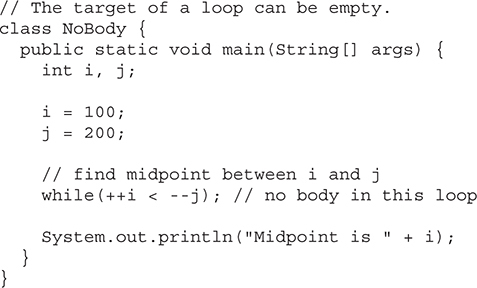
This program finds the midpoint between i and j. It generates the following output:
Midpoint is 150
Here is how this while loop works. The value of i is incremented, and the value of j is decremented. These values are then compared with one another. If the new value of i is still less than the new value of j, then the loop repeats. If i is equal to or greater than j, the loop stops. Upon exit from the loop, i will hold a value that is midway between the original values of i and j. (Of course, this procedure only works when i is less than j to begin with.) As you can see, there is no need for a loop body; all of the action occurs within the conditional expression, itself. In professionally written Java code, short loops are frequently coded without bodies when the controlling expression can handle all of the details itself.
As you just saw, if the conditional expression controlling a while loop is initially false, then the body of the loop will not be executed at all. However, sometimes it is desirable to execute the body of a loop at least once, even if the conditional expression is false to begin with. In other words, there are times when you would like to test the termination expression at the end of the loop rather than at the beginning. Fortunately, Java supplies a loop that does just that: the do-while. The do-while loop always executes its body at least once, because its conditional expression is at the bottom of the loop. Its general form is
do {
// body of loop
} while (condition);
Each iteration of the do-while loop first executes the body of the loop and then evaluates the conditional expression. If this expression is true, the loop will repeat. Otherwise, the loop terminates. As with all of Java’s loops, condition must be a Boolean expression.
Here is a reworked version of the “tick” program that demonstrates the do-while loop. It generates the same output as before.
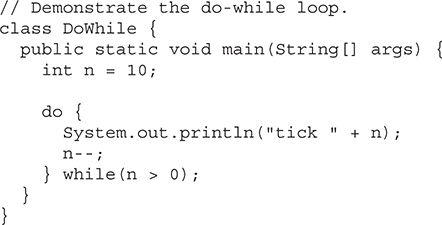
The loop in the preceding program, while technically correct, can be written more efficiently as follows:

In this example, the expression (– –n > 0) combines the decrement of n and the test for zero into one expression. Here is how it works. First, the – –n statement executes, decrementing n and returning the new value of n. This value is then compared with zero. If it is greater than zero, the loop continues; otherwise, it terminates.
The do-while loop is especially useful when you process a menu selection, because you will usually want the body of a menu loop to execute at least once. Consider the following program, which implements a very simple help system for Java’s selection and iteration statements:
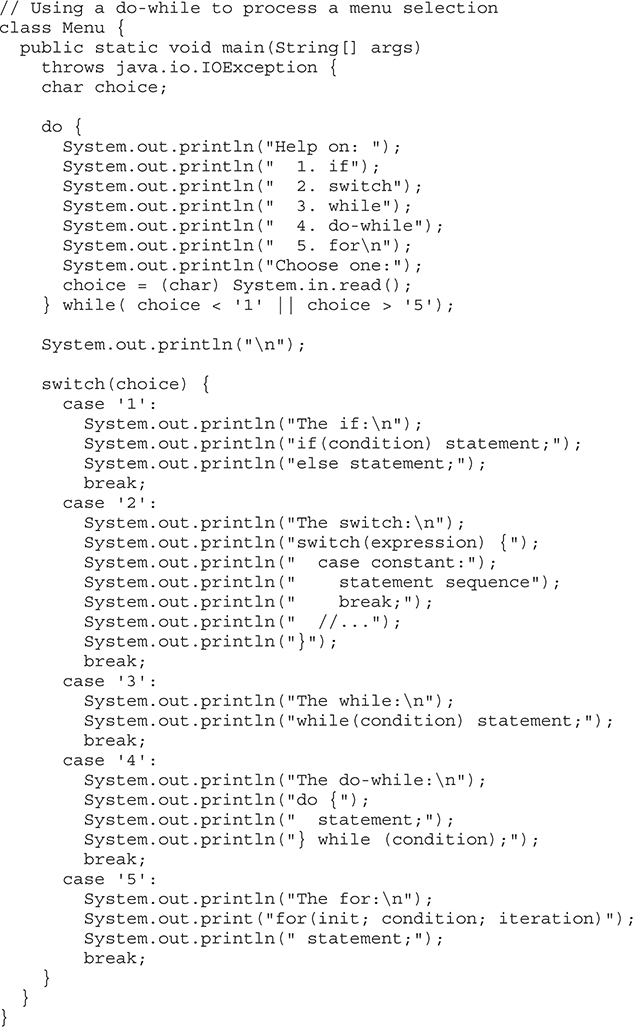
Here is a sample run produced by this program:
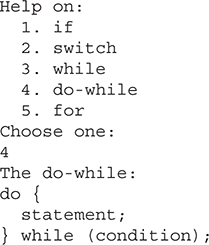
In the program, the do-while loop is used to verify that the user has entered a valid choice. If not, then the user is reprompted. Since the menu must be displayed at least once, the do-while is the perfect loop to accomplish this.
A few other points about this example: Notice that characters are read from the keyboard by calling System.in.read( ). This is one of Java’s console input functions. Although Java’s console I/O methods won’t be discussed in detail until Chapter 13, System.in.read( ) is used here to obtain the user’s choice. It reads characters from standard input (returned as integers, which is why the return value was cast to char). By default, standard input is line buffered, so you must press ENTER before any characters that you type will be sent to your program.
Java’s console input can be a bit awkward to work with. Further, most real-world Java programs will use a graphical user interface (GUI). For these reasons, not much use of console input has been made in this book. However, it is useful in this context. One other point to consider: Because System.in.read( ) is being used, the program must specify the throws java.io.IOException clause. This line is necessary to handle input errors. It is part of Java’s exception handling features, which are discussed in Chapter 10.
You were introduced to a simple form of the for loop in Chapter 2. As you will see, it is a powerful and versatile construct.
There are two forms of the for loop. The first is the traditional form that has been in use since the original version of Java. The second is the newer “for-each” form, added by JDK 5. Both types of for loops are discussed here, beginning with the traditional form.
Here is the general form of the traditional for statement:
for(initialization; condition; iteration) {
// body
}
If only one statement is being repeated, there is no need for the curly braces.
The for loop operates as follows. When the loop first starts, the initialization portion of the loop is executed. Generally, this is an expression that sets the value of the loop control variable, which acts as a counter that controls the loop. It is important to understand that the initialization expression is executed only once. Next, condition is evaluated. This must be a Boolean expression. It usually tests the loop control variable against a target value. If this expression is true, then the body of the loop is executed. If it is false, the loop terminates. Next, the iteration portion of the loop is executed. This is usually an expression that increments or decrements the loop control variable. The loop then iterates, first evaluating the conditional expression, then executing the body of the loop, and then executing the iteration expression with each pass. This process repeats until the controlling expression is false.
Here is a version of the “tick” program that uses a for loop:
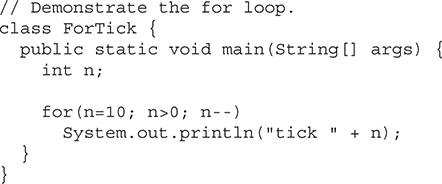
Often the variable that controls a for loop is needed only for the purposes of the loop and is not used elsewhere. When this is the case, it is possible to declare the variable inside the initialization portion of the for. For example, here is the preceding program recoded so that the loop control variable n is declared as an int inside the for:
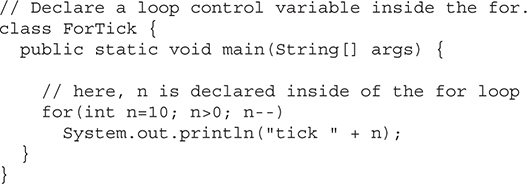
When you declare a variable inside a for loop, there is one important point to remember: the scope of that variable ends when the for statement does. (That is, the scope of the variable is limited to the for loop.) Outside the for loop, the variable will cease to exist. If you need to use the loop control variable elsewhere in your program, you will not be able to declare it inside the for loop.
When the loop control variable will not be needed elsewhere, most Java programmers declare it inside the for. For example, here is a simple program that tests for prime numbers. Notice that the loop control variable, i, is declared inside the for since it is not needed elsewhere.
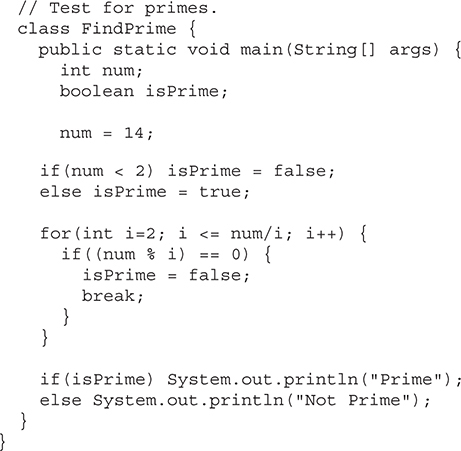
There will be times when you will want to include more than one statement in the initialization and iteration portions of the for loop. For example, consider the loop in the following program:
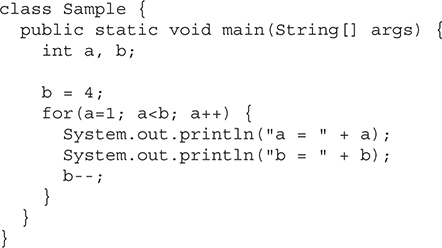
As you can see, the loop is controlled by the interaction of two variables. Since the loop is governed by two variables, it would be useful if both could be included in the for statement, itself, instead of b being handled manually. Fortunately, Java provides a way to accomplish this. To allow two or more variables to control a for loop, Java permits you to include multiple statements in both the initialization and iteration portions of the for. Each statement is separated from the next by a comma.
Using the comma, the preceding for loop can be more efficiently coded, as shown here:
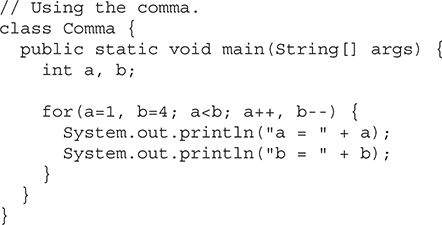
In this example, the initialization portion sets the values of both a and b. The two comma-separated statements in the iteration portion are executed each time the loop repeats. The program generates the following output:
a = 1
b = 4
a = 2
b = 3
The for loop supports a number of variations that increase its power and applicability. The reason it is so flexible is that its three parts—the initialization, the conditional test, and the iteration—do not need to be used for only those purposes. In fact, the three sections of the for can be used for any purpose you desire. Let’s look at some examples.
One of the most common variations involves the conditional expression. Specifically, this expression does not need to test the loop control variable against some target value. In fact, the condition controlling the for can be any Boolean expression. For example, consider the following fragment:
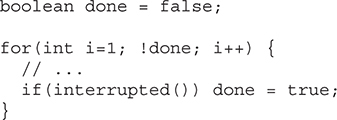
In this example, the for loop continues to run until the boolean variable done is set to true. It does not test the value of i.
Here is another interesting for loop variation. Either the initialization or the iteration expression or both may be absent, as in this next program:
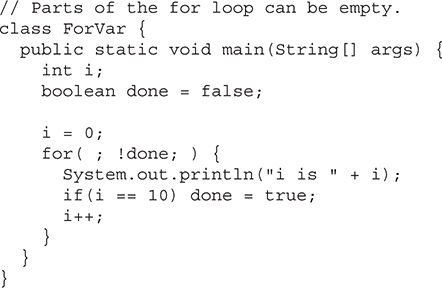
Here, the initialization and iteration expressions have been moved out of the for. Thus, parts of the for are empty. While this is of no value in this simple example—indeed, it would be considered quite poor style—there can be times when this type of approach makes sense. For example, if the initial condition is set through a complex expression elsewhere in the program or if the loop control variable changes in a nonsequential manner determined by actions that occur within the body of the loop, it may be appropriate to leave these parts of the for empty.
Here is one more for loop variation. You can intentionally create an infinite loop (a loop that never terminates) if you leave all three parts of the for empty. For example:

This loop will run forever because there is no condition under which it will terminate. Although there are some programs, such as operating system command processors, that require an infinite loop, most “infinite loops” are really just loops with special termination requirements. As you will soon see, there is a way to terminate a loop—even an infinite loop like the one shown—that does not make use of the normal loop conditional expression.
A second form of for implements a “for-each” style loop. As you may know, contemporary language theory has embraced the for-each concept, and it has become a standard feature that programmers have come to expect. A for-each style loop is designed to cycle through a collection of objects, such as an array, in strictly sequential fashion, from start to finish. In Java, the for-each style of for is also referred to as the enhanced for loop.
The general form of the for-each version of the for is shown here:
for(type itr-var : collection) statement-block
Here, type specifies the type and itr-var specifies the name of an iteration variable that will receive the elements from a collection, one at a time, from beginning to end. The collection being cycled through is specified by collection. There are various types of collections that can be used with the for, but the only type used in this chapter is the array. (Other types of collections that can be used with the for, such as those defined by the Collections Framework, are discussed later in this book.) With each iteration of the loop, the next element in the collection is retrieved and stored in itr-var. The loop repeats until all elements in the collection have been obtained.
Because the iteration variable receives values from the collection, type must be the same as (or compatible with) the elements stored in the collection. Thus, when iterating over arrays, type must be compatible with the element type of the array.
To understand the motivation behind a for-each style loop, consider the type of for loop that it is designed to replace. The following fragment uses a traditional for loop to compute the sum of the values in an array:
int[] nums = { 1, 2, 3, 4, 5, 6, 7, 8, 9, 10 };
int sum = 0;
for(int i=0; i < 10; i++) sum += nums[i];
To compute the sum, each element in nums is read, in order, from start to finish. Thus, the entire array is read in strictly sequential order. This is accomplished by manually indexing the nums array by i, the loop control variable.
The for-each style for automates the preceding loop. Specifically, it eliminates the need to establish a loop counter, specify a starting and ending value, and manually index the array. Instead, it automatically cycles through the entire array, obtaining one element at a time, in sequence, from beginning to end. For example, here is the preceding fragment rewritten using a for-each version of the for:
int[] nums = { 1, 2, 3, 4, 5, 6, 7, 8, 9, 10 };
int sum = 0;
for(int x: nums) sum += x;
With each pass through the loop, x is automatically given a value equal to the next element in nums. Thus, on the first iteration, x contains 1; on the second iteration, x contains 2; and so on. Not only is the syntax streamlined, but it also prevents boundary errors.
Here is an entire program that demonstrates the for-each version of the for just described:
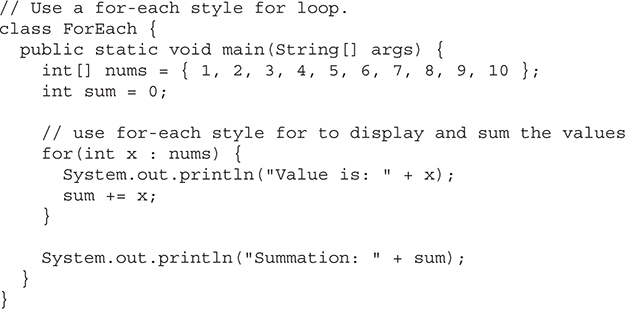
The output from the program is shown here:
Value is: 1
Value is: 2
Value is: 3
Value is: 4
Value is: 5
Value is: 6
Value is: 7
Value is: 8
Value is: 9
Value is: 10
Summation: 55
As this output shows, the for-each style for automatically cycles through an array in sequence from the lowest index to the highest.
Although the for-each for loop iterates until all elements in an array have been examined, it is possible to terminate the loop early by using a break statement. For example, this program sums only the first five elements of nums:
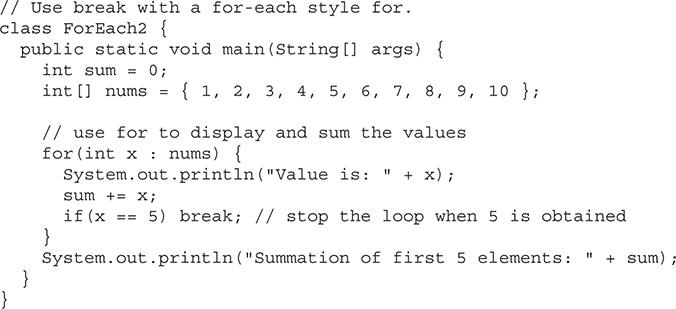
This is the output produced:
Value is: 1
Value is: 2
Value is: 3
Value is: 4
Value is: 5
Summation of first 5 elements: 15
As is evident, the for loop stops after the fifth element has been obtained. The break statement can also be used with Java’s other loops, and it is discussed in detail later in this chapter.
There is one important point to understand about the for-each style loop. Its iteration variable is “read-only” as it relates to the underlying array. An assignment to the iteration variable has no effect on the underlying array. In other words, you can’t change the contents of the array by assigning the iteration variable a new value. For example, consider this program:
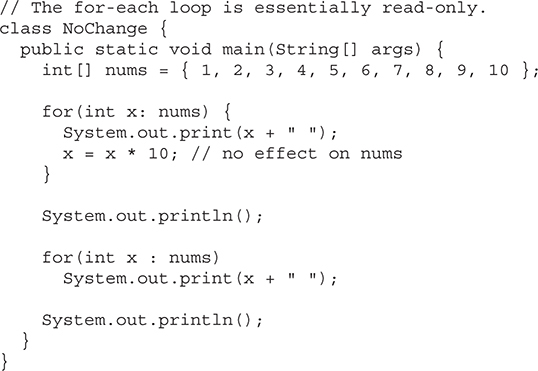
The first for loop increases the value of the iteration variable by a factor of 10. However, this assignment has no effect on the underlying array nums, as the second for loop illustrates. The output, shown here, proves this point:
1 2 3 4 5 6 7 8 9 10
1 2 3 4 5 6 7 8 9 10
The enhanced version of the for also works on multidimensional arrays. Remember, however, that in Java, multidimensional arrays consist of arrays of arrays. (For example, a two-dimensional array is an array of one-dimensional arrays.) This is important when iterating over a multidimensional array, because each iteration obtains the next array, not an individual element. Furthermore, the iteration variable in the for loop must be compatible with the type of array being obtained. For example, in the case of a two-dimensional array, the iteration variable must be a reference to a one-dimensional array. In general, when using the for-each for to iterate over an array of N dimensions, the objects obtained will be arrays of N–1 dimensions. To understand the implications of this, consider the following program. It uses nested for loops to obtain the elements of a two-dimensional array in row-order, from first to last.
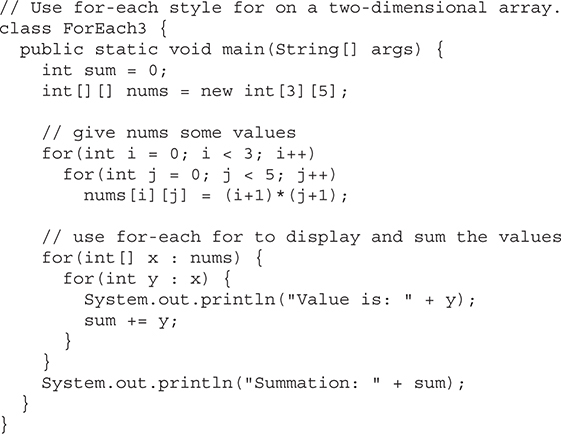
The output from this program is shown here:
Value is: 1
Value is: 2
Value is: 3
Value is: 4
Value is: 5
Value is: 2
Value is: 4
Value is: 6
Value is: 8
Value is: 10
Value is: 3
Value is: 6
Value is: 9
Value is: 12
Value is: 15
Summation: 90
In the program, pay special attention to this line:
for(int[] x: nums) {
Notice how x is declared. It is a reference to a one-dimensional array of integers. This is necessary because each iteration of the for obtains the next array in nums, beginning with the array specified by nums[0]. The inner for loop then cycles through each of these arrays, displaying the values of each element.
Since the for-each style for can only cycle through an array sequentially, from start to finish, you might think that its use is limited, but this is not true. A large number of algorithms require exactly this mechanism. One of the most common is searching. For example, the following program uses a for loop to search an unsorted array for a value. It stops if the value is found.
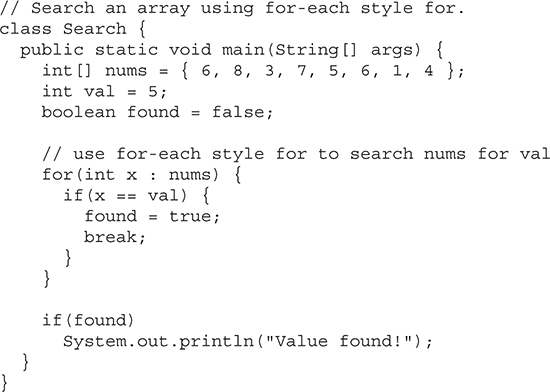
The for-each style for is an excellent choice in this application because searching an unsorted array involves examining each element in sequence. (Of course, if the array were sorted, a binary search could be used, which would require a different style loop.) Other types of applications that benefit from for-each style loops include computing an average, finding the minimum or maximum of a set, looking for duplicates, and so on.
Although we have been using arrays in the examples in this chapter, the for-each style for is especially useful when operating on collections defined by the Collections Framework, which is described in Part II. More generally, the for can cycle through the elements of any collection of objects, as long as that collection satisfies a certain set of constraints, which are described in Chapter 20.
As explained in Chapter 3, JDK 10 introduced a feature called local variable type inference, which allows the type of a local variable to be inferred from the type of its initializer. To use local variable type inference, the type of the variable is specified as var and the variable must be initialized. Local variable type inference can be used in a for loop when declaring and initializing the loop control variable inside a traditional for loop, or when specifying the iteration variable in a for-each for. The following program shows an example of each case:
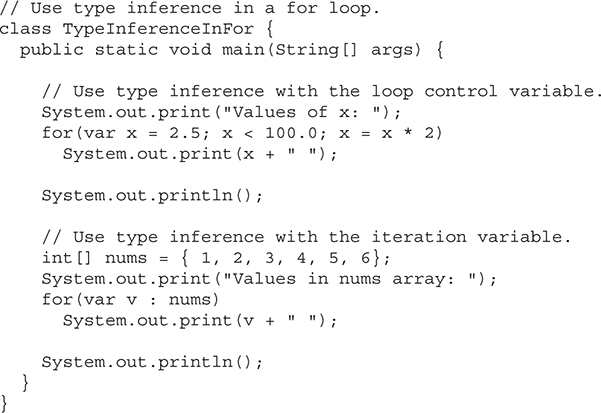
The output is shown here:
Values of x: 2.5 5.0 10.0 20.0 40.0 80.0
Values in nums array: 1 2 3 4 5 6
In this example, loop control variable x in this line:
for(var x = 2.5; x < 100.0; x = x * 2)
is inferred to be type double because that is the type of its initializer. Iteration variable v is this line:
for(var v : nums)
inferred to be of type int because that is the element type of the array nums.
One last point: Because a number of readers will be working in environments that predate JDK 10, local variable type inference will not be used by most of the for loops in the remainder of this edition of this book. You should, of course, consider it for new code that you write.
Like all other programming languages, Java allows loops to be nested. That is, one loop may be inside another. For example, here is a program that nests for loops:
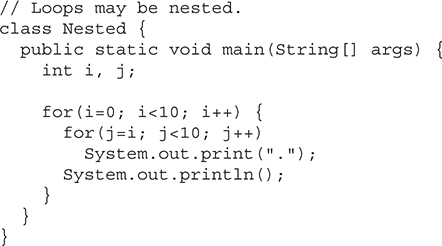
The output produced by this program is shown here:
..........
.........
........
.......
......
.....
....
...
..
.
Java supports three jump statements: break, continue, and return. These statements transfer control to another part of your program. Each is examined here.
Note In addition to the jump statements discussed here, Java supports one other way that you can change your program’s flow of execution: through exception handling. Exception handling provides a structured method by which run-time errors can be trapped and handled by your program. It is supported by the keywords try, catch, throw, throws, and finally. In essence, the exception handling mechanism allows your program to perform a nonlocal branch. Since exception handling is a large topic, it is discussed in its own chapter, Chapter 10.
In Java, the break statement has three uses. First, as you have seen, it terminates a statement sequence in a switch statement. Second, it can be used to exit a loop. Third, it can be used as a “civilized” form of goto. The last two uses are explained here.
By using break, you can force immediate termination of a loop, bypassing the conditional expression and any remaining code in the body of the loop. When a break statement is encountered inside a loop, the loop is terminated and program control resumes at the next statement following the loop. Here is a simple example:
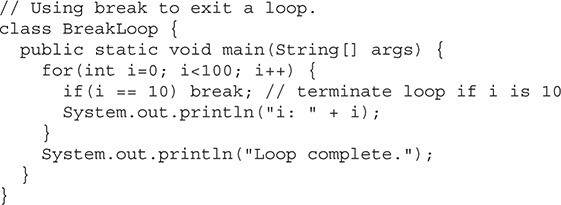
This program generates the following output:
i: 0
i: 1
i: 2
i: 3
i: 4
i: 5
i: 6
i: 7
i: 8
i: 9
Loop complete.
As you can see, although the for loop is designed to run from 0 to 99, the break statement causes it to terminate early, when i equals 10.
The break statement can be used with any of Java’s loops, including intentionally infinite loops. For example, here is the preceding program coded by use of a while loop. The output from this program is the same as just shown.
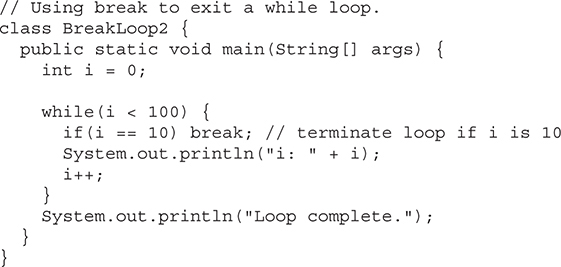
When used inside a set of nested loops, the break statement will only break out of the innermost loop. For example:
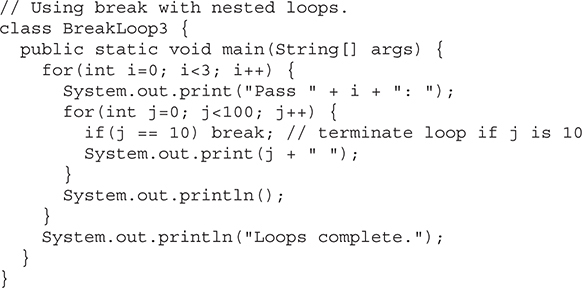
This program generates the following output:
Pass 0: 0 1 2 3 4 5 6 7 8 9
Pass 1: 0 1 2 3 4 5 6 7 8 9
Pass 2: 0 1 2 3 4 5 6 7 8 9
Loops complete.
As you can see, the break statement in the inner loop only causes termination of that loop. The outer loop is unaffected.
Here are two other points to remember about break. First, more than one break statement may appear in a loop. However, be careful. Too many break statements have the tendency to destructure your code. Second, the break that terminates a switch statement affects only that switch statement and not any enclosing loops.
Remember break was not designed to provide the normal means by which a loop is terminated. The loop’s conditional expression serves this purpose. The break statement should be used to cancel a loop only when some sort of special situation occurs.
In addition to its uses with the switch statement and loops, the break statement can also be employed by itself to provide a “civilized” form of the goto statement. Java does not have a goto statement because it provides a way to branch in an arbitrary and unstructured manner. This usually makes goto-ridden code hard to understand and hard to maintain. It also prohibits certain compiler optimizations. There are, however, a few places where the goto is a valuable and legitimate construct for flow control. For example, the goto can be useful when you are exiting from a deeply nested set of loops. To handle such situations, Java defines an expanded form of the break statement. By using this form of break, you can, for example, break out of one or more blocks of code. These blocks need not be part of a loop or a switch. They can be any block. Further, you can specify precisely where execution will resume, because this form of break works with a label. As you will see, break gives you the benefits of a goto without its problems.
The general form of the labeled break statement is shown here:
break label;
Most often, label is the name of a label that identifies a block of code. This can be a stand-alone block of code but it can also be a block that is the target of another statement. When this form of break executes, control is transferred out of the named block. The labeled block must enclose the break statement, but it does not need to be the immediately enclosing block. This means, for example, that you can use a labeled break statement to exit from a set of nested blocks. But you cannot use break to transfer control out of a block that does not enclose the break statement.
To name a block, put a label at the start of it. A label is any valid Java identifier followed by a colon. Once you have labeled a block, you can then use this label as the target of a break statement. Doing so causes execution to resume at the end of the labeled block. For example, the following program shows three nested blocks, each with its own label. The break statement causes execution to jump forward, past the end of the block labeled second, skipping the two println( ) statements.
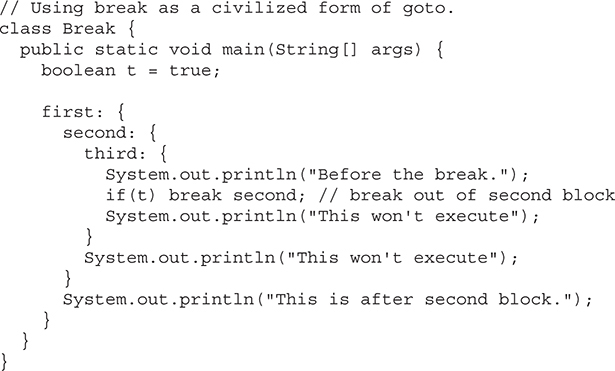
Running this program generates the following output:
Before the break.
This is after second block.
One of the most common uses for a labeled break statement is to exit from nested loops. For example, in the following program, the outer loop executes only once:
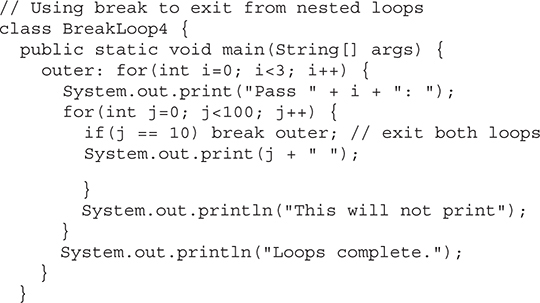
This program generates the following output:
Pass 0: 0 1 2 3 4 5 6 7 8 9 Loops complete.
As you can see, when the inner loop breaks to the outer loop, both loops have been terminated. Notice that this example labels the for statement, which has a block of code as its target.
Keep in mind that you cannot break to any label which is not defined for an enclosing block. For example, the following program is invalid and will not compile:
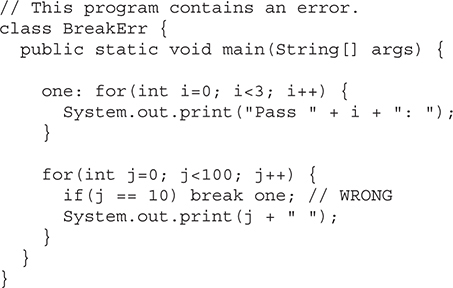
Since the loop labeled one does not enclose the break statement, it is not possible to transfer control out of that block.
Sometimes it is useful to force an early iteration of a loop. That is, you might want to continue running the loop but stop processing the remainder of the code in its body for this particular iteration. This is, in effect, a goto just past the body of the loop, to the loop’s end. The continue statement performs such an action. In while and do-while loops, a continue statement causes control to be transferred directly to the conditional expression that controls the loop. In a for loop, control goes first to the iteration portion of the for statement and then to the conditional expression. For all three loops, any intermediate code is bypassed.
Here is an example program that uses continue to cause two numbers to be printed on each line:
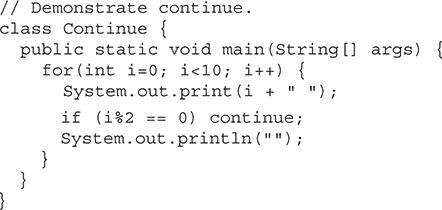
This code uses the % operator to check if i is even. If it is, the loop continues without printing a newline. Here is the output from this program:
0 1
2 3
4 5
6 7
8 9
As with the break statement, continue may specify a label to describe which enclosing loop to continue. Here is an example program that uses continue to print a triangular multiplication table for 0 through 9:
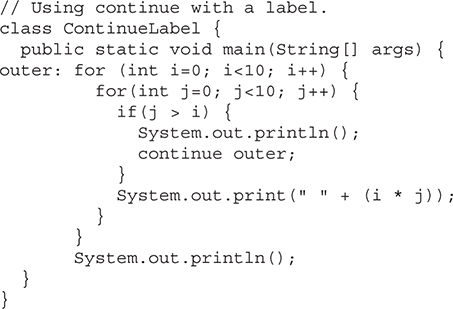
The continue statement in this example terminates the loop counting j and continues with the next iteration of the loop counting i. Here is the output of this program:
0
0 1
0 2 4
0 3 6 9
0 4 8 12 16
0 5 10 15 20 25
0 6 12 18 24 30 36
0 7 14 21 28 35 42 49
0 8 16 24 32 40 48 56 64
0 9 18 27 36 45 54 63 72 81
Good uses of continue are rare. One reason is that Java provides a rich set of loop statements which fit most applications. However, for those special circumstances in which early iteration is needed, the continue statement provides a structured way to accomplish it.
The last control statement is return. The return statement is used to explicitly return from a method. That is, it causes program control to transfer back to the caller of the method. As such, it is categorized as a jump statement. Although a full discussion of return must wait until methods are discussed in Chapter 6, a brief look at return is presented here.
At any time in a method, the return statement can be used to cause execution to branch back to the caller of the method. Thus, the return statement immediately terminates the method in which it is executed. The following example illustrates this point. Here, return causes execution to return to the Java run-time system, since it is the run-time system that calls main( ):
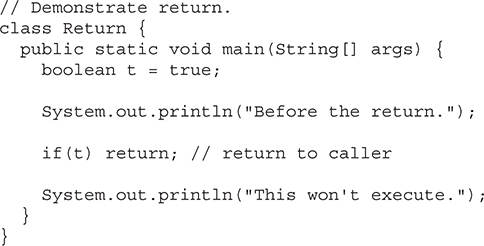
The output from this program is shown here:
Before the return.
As you can see, the final println( ) statement is not executed. As soon as return is executed, control passes back to the caller.
One last point: In the preceding program, the if(t) statement is necessary. Without it, the Java compiler would flag an “unreachable code” error because the compiler would know that the last println( ) statement would never be executed. To prevent this error, the if statement is used here to trick the compiler for the sake of this demonstration.
The class is at the core of Java. It is the logical construct upon which the entire Java language is built because it defines the shape and nature of an object. As such, the class forms the basis for object-oriented programming in Java. Any concept you wish to implement in a Java program must be encapsulated within a class.
Because the class is so fundamental to Java, this and the next few chapters will be devoted to it. Here, you will be introduced to the basic elements of a class and learn how a class can be used to create objects. You will also learn about methods, constructors, and the this keyword.
Classes have been used since the beginning of this book. However, until now, only the most rudimentary form of a class has been shown. The classes created in the preceding chapters primarily exist simply to encapsulate the main( ) method, which has been used to demonstrate the basics of the Java syntax. As you will see, classes are substantially more powerful than the limited ones presented so far.
Perhaps the most important thing to understand about a class is that it defines a new data type. Once defined, this new type can be used to create objects of that type. Thus, a class is a template for an object, and an object is an instance of a class. Because an object is an instance of a class, you will often see the two words object and instance used interchangeably.
When you define a class, you declare its exact form and nature. You do this by specifying the data that it contains and the code that operates on that data. While very simple classes may contain only code or only data, most real-world classes contain both. As you will see, a class’ code defines the interface to its data.
A class is declared by use of the class keyword. The classes that have been used up to this point are actually very limited examples of its complete form. Classes can (and usually do) get much more complex. A simplified general form of a class definition is shown here:
class classname {
type instance-variable1;
type instance-variable2;
// ...
type instance-variableN;
type methodname1(parameter-list) {
// body of method
}
type methodname2(parameter-list) {
// body of method
}
// ...
type methodnameN(parameter-list) {
// body of method
}
}
The data, or variables, defined within a class are called instance variables. The code is contained within methods. Collectively, the methods and variables defined within a class are called members of the class. In most classes, the instance variables are acted upon and accessed by the methods defined for that class. Thus, as a general rule, it is the methods that determine how a class’ data can be used.
Variables defined within a class are called instance variables because each instance of the class (that is, each object of the class) contains its own copy of these variables. Thus, the data for one object is separate and unique from the data for another. We will come back to this point shortly, but it is an important concept to learn early.
All methods have the same general form as main( ), which we have been using thus far. However, most methods will not be specified as static or public. Notice that the general form of a class does not specify a main( ) method. Java classes do not need to have a main( )method. You only specify one if that class is the starting point for your program. Further, some kinds of Java applications don’t require a main( ) method at all.
Let’s begin our study of the class with a simple example. Here is a class called Box that defines three instance variables: width, height, and depth. Currently, Box does not contain any methods (but some will be added soon).
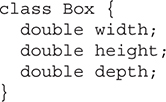
As stated, a class defines a new type of data. In this case, the new data type is called Box. You will use this name to declare objects of type Box. It is important to remember that a class declaration only creates a template; it does not create an actual object. Thus, the preceding code does not cause any objects of type Box to come into existence.
To actually create a Box object, you will use a statement like the following:
Box mybox = new Box(); // create a Box object called mybox
After this statement executes, mybox will refer to an instance of Box. Thus, it will have “physical” reality. For the moment, don’t worry about the details of this statement.
As mentioned earlier, each time you create an instance of a class, you are creating an object that contains its own copy of each instance variable defined by the class. Thus, every Box object will contain its own copies of the instance variables width, height, and depth. To access these variables, you will use the dot (.) operator. The dot operator links the name of the object with the name of an instance variable. For example, to assign the width variable of mybox the value 100, you would use the following statement:
mybox.width = 100;
This statement tells the compiler to assign the copy of width that is contained within the mybox object the value of 100. In general, you use the dot operator to access both the instance variables and the methods within an object. One other point: Although commonly referred to as the dot operator, the formal specification for Java categorizes the . as a separator. However, since the use of the term “dot operator” is widespread, it is used in this book.
Here is a complete program that uses the Box class:
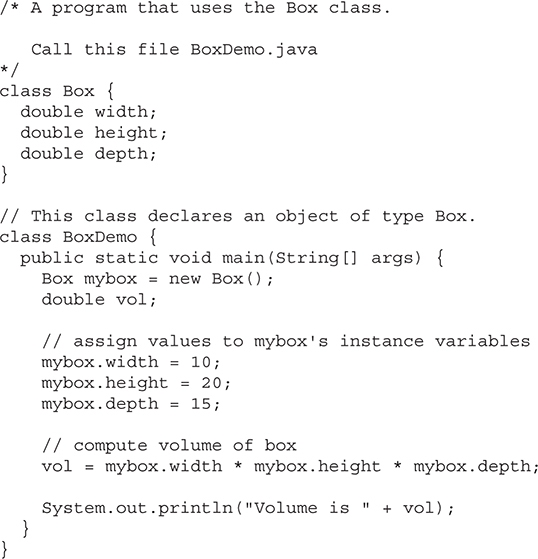
You should call the file that contains this program BoxDemo.java, because the main( ) method is in the class called BoxDemo, not the class called Box. When you compile this program, you will find that two .class files have been created, one for Box and one for BoxDemo. The Java compiler automatically puts each class into its own .class file. It is not necessary for both the Box and the BoxDemo class to actually be in the same source file. You could put each class in its own file, called Box.java and BoxDemo.java, respectively.
To run this program, you must execute BoxDemo.class. When you do, you will see the following output:
Volume is 3000.0
As stated earlier, each object has its own copies of the instance variables. This means that if you have two Box objects, each has its own copy of depth, width, and height. It is important to understand that changes to the instance variables of one object have no effect on the instance variables of another. For example, the following program declares two Box objects:
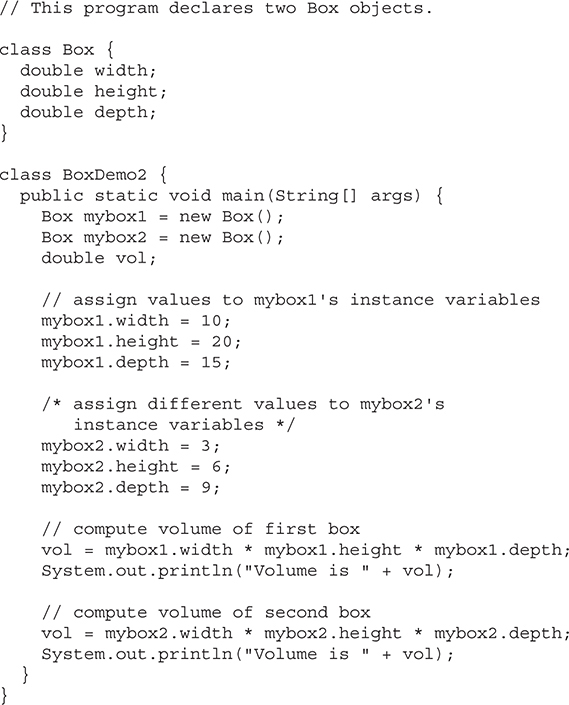
The output produced by this program is shown here:
Volume is 3000.0
Volume is 162.0
As you can see, mybox1’s data is completely separate from the data contained in mybox2.
As just explained, when you create a class, you are creating a new data type. You can use this type to declare objects of that type. However, obtaining objects of a class is a two-step process. First, you must declare a variable of the class type. This variable does not define an object. Instead, it is simply a variable that can refer to an object. Second, you must acquire an actual, physical copy of the object and assign it to that variable. You can do this using the new operator. The new operator dynamically allocates (that is, allocates at run time) memory for an object and returns a reference to it. This reference is, essentially, the address in memory of the object allocated by new. This reference is then stored in the variable. Thus, in Java, all class objects must be dynamically allocated. Let’s look at the details of this procedure.
In the preceding sample programs, a line similar to the following is used to declare an object of type Box:
Box mybox = new Box();
This statement combines the two steps just described. It can be rewritten like this to show each step more clearly:
Box mybox; // declare reference to object
mybox = new Box(); // allocate a Box object
The first line declares mybox as a reference to an object of type Box. At this point, mybox does not yet refer to an actual object. The next line allocates an object and assigns a reference to it to mybox. After the second line executes, you can use mybox as if it were a Box object. But in reality, mybox simply holds, in essence, the memory address of the actual Box object. The effect of these two lines of code is depicted in Figure 6-1.
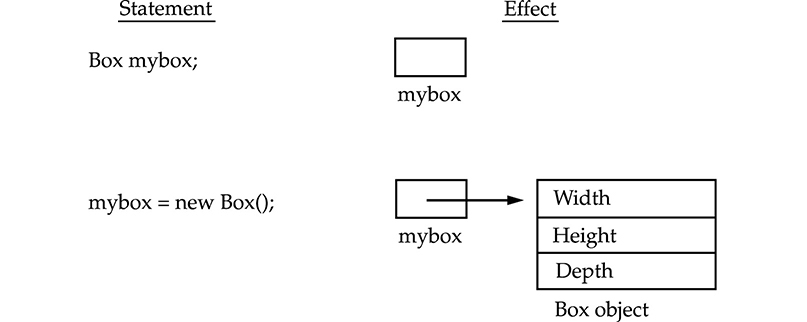
Figure 6-1 Declaring an object of type Box
As just explained, the new operator dynamically allocates memory for an object. In the context of an assignment, it has this general form:
class-var = new classname ( );
Here, class-var is a variable of the class type being created. The classname is the name of the class that is being instantiated. The class name followed by parentheses specifies the constructor for the class. A constructor defines what occurs when an object of a class is created. Constructors are an important part of all classes and have many significant attributes. Most real-world classes explicitly define their own constructors within their class definition. However, if no explicit constructor is specified, then Java will automatically supply a default constructor. This is the case with Box. For now, we will use the default constructor. Soon, you will see how to define your own constructors.
At this point, you might be wondering why you do not need to use new for such things as integers or characters. The answer is that Java’s primitive types are not implemented as objects. Rather, they are implemented as “normal” variables. This is done in the interest of efficiency. As you will see, objects have many features and attributes that require Java to treat them differently than it treats the primitive types. By not applying the same overhead to the primitive types that applies to objects, Java can implement the primitive types more efficiently. Later, you will see object versions of the primitive types that are available for your use in those situations in which complete objects of these types are needed.
It is important to understand that new allocates memory for an object during run time. The advantage of this approach is that your program can create as many or as few objects as it needs during the execution of your program. However, since memory is finite, it is possible that new will not be able to allocate memory for an object because insufficient memory exists. If this happens, a run-time exception will occur. (You will learn how to handle exceptions in Chapter 10.) For the sample programs in this book, you won’t need to worry about running out of memory, but you will need to consider this possibility in real-world programs that you write.
Let’s once again review the distinction between a class and an object. A class creates a new data type that can be used to create objects. That is, a class creates a logical framework that defines the relationship between its members. When you declare an object of a class, you are creating an instance of that class. Thus, a class is a logical construct. An object has physical reality. (That is, an object occupies space in memory.) It is important to keep this distinction clearly in mind.
Object reference variables act differently than you might expect when an assignment takes place. For example, what do you think the following fragment does?
Box b1 = new Box();
Box b2 = b1;
You might think that b2 is being assigned a reference to a copy of the object referred to by b1. That is, you might think that b1 and b2 refer to separate and distinct objects. However, this would be wrong. Instead, after this fragment executes, b1 and b2 will both refer to the same object. The assignment of b1 to b2 did not allocate any memory or copy any part of the original object. It simply makes b2 refer to the same object as does b1. Thus, any changes made to the object through b2 will affect the object to which b1 is referring, since they are the same object.
This situation is depicted here:

Although b1 and b2 both refer to the same object, they are not linked in any other way. For example, a subsequent assignment to b1 will simply unhook b1 from the original object without affecting the object or affecting b2. For example:
Box b1 = new Box();
Box b2 = b1;
// ...
b1 = null;
Here, b1 has been set to null, but b2 still points to the original object.
Remember When you assign one object reference variable to another object reference variable, you are not creating a copy of the object, you are only making a copy of the reference.
As mentioned at the beginning of this chapter, classes usually consist of two things: instance variables and methods. The topic of methods is a large one because Java gives them so much power and flexibility. In fact, much of the next chapter is devoted to methods. However, there are some fundamentals that you need to learn now so that you can begin to add methods to your classes.
This is the general form of a method:
type name(parameter-list) {
// body of method
}
Here, type specifies the type of data returned by the method. This can be any valid type, including class types that you create. If the method does not return a value, its return type must be void. The name of the method is specified by name. This can be any legal identifier other than those already used by other items within the current scope. The parameter-list is a sequence of type and identifier pairs separated by commas. Parameters are essentially variables that receive the value of the arguments passed to the method when it is called. If the method has no parameters, then the parameter list will be empty.
Methods that have a return type other than void return a value to the calling routine using the following form of the return statement:
return value;
Here, value is the value returned.
In the next few sections, you will see how to create various types of methods, including those that take parameters and those that return values.
Although it is perfectly fine to create a class that contains only data, it rarely happens. Most of the time, you will use methods to access the instance variables defined by the class. In fact, methods define the interface to most classes. This allows the class implementor to hide the specific layout of internal data structures behind cleaner method abstractions. In addition to defining methods that provide access to data, you can also define methods that are used internally by the class itself.
Let’s begin by adding a method to the Box class. It may have occurred to you while looking at the preceding programs that the computation of a box’s volume was something that was best handled by the Box class rather than the BoxDemo class. After all, since the volume of a box is dependent upon the size of the box, it makes sense to have the Box class compute it. To do this, you must add a method to Box, as shown here:
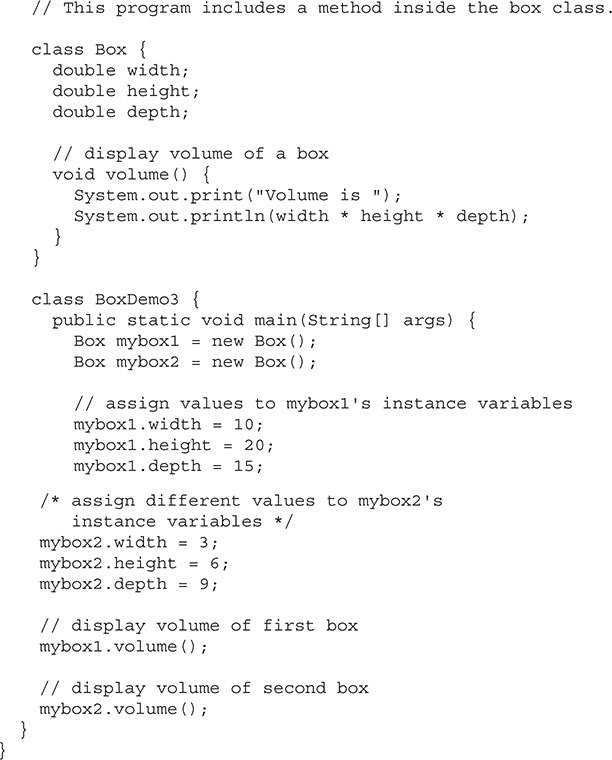
This program generates the following output, which is the same as the previous version.
Volume is 3000.0
Volume is 162.0
Look closely at the following two lines of code:
mybox1.volume();
mybox2.volume();
The first line here invokes the volume( ) method on mybox1. That is, it calls volume( ) relative to the mybox1 object, using the object’s name followed by the dot operator. Thus, the call to mybox1.volume( ) displays the volume of the box defined by mybox1, and the call to mybox2.volume( ) displays the volume of the box defined by mybox2. Each time volume( ) is invoked, it displays the volume for the specified box.
If you are unfamiliar with the concept of calling a method, the following discussion will help clear things up. When mybox1.volume( ) is executed, the Java run-time system transfers control to the code defined inside volume( ). After the statements inside volume( ) have executed, control is returned to the calling routine, and execution resumes with the line of code following the call. In the most general sense, a method is Java’s way of implementing subroutines.
There is something very important to notice inside the volume( ) method: the instance variables width, height, and depth are referred to directly, without preceding them with an object name or the dot operator. When a method uses an instance variable that is defined by its class, it does so directly, without explicit reference to an object and without use of the dot operator. This is easy to understand if you think about it. A method is always invoked relative to some object of its class. Once this invocation has occurred, the object is known. Thus, within a method, there is no need to specify the object a second time. This means that width, height, and depth inside volume( ) implicitly refer to the copies of those variables found in the object that invokes volume( ).
Let’s review: When an instance variable is accessed by code that is not part of the class in which that instance variable is defined, it must be done through an object, by use of the dot operator. However, when an instance variable is accessed by code that is part of the same class as the instance variable, that variable can be referred to directly. The same thing applies to methods.
While the implementation of volume( ) does move the computation of a box’s volume inside the Box class where it belongs, it is not the best way to do it. For example, what if another part of your program wanted to know the volume of a box, but not display its value? A better way to implement volume( ) is to have it compute the volume of the box and return the result to the caller. The following example, an improved version of the preceding program, does just that:
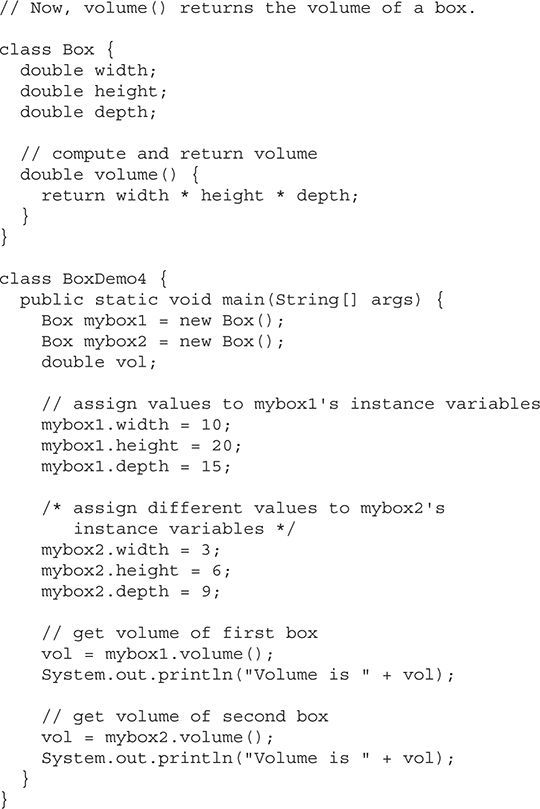
As you can see, when volume( ) is called, it is put on the right side of an assignment statement. On the left is a variable, in this case vol, that will receive the value returned by volume( ). Thus, after
vol = mybox1.volume();
executes, the value of mybox1.volume( ) is 3,000 and this value then is stored in vol.
There are two important things to understand about returning values:
• The type of data returned by a method must be compatible with the return type specified by the method. For example, if the return type of some method is boolean, you could not return an integer.
• The variable receiving the value returned by a method (such as vol, in this case) must also be compatible with the return type specified for the method.
One more point: The preceding program can be written a bit more efficiently because there is actually no need for the vol variable. The call to volume( ) could have been used in the println( ) statement directly, as shown here:
System.out.println("Volume is" + mybox1.volume());
In this case, when println( ) is executed, mybox1.volume( ) will be called automatically and its value will be passed to println( ).
While some methods don’t need parameters, most do. Parameters allow a method to be generalized. That is, a parameterized method can operate on a variety of data and/or be used in a number of slightly different situations. To illustrate this point, let’s use a very simple example. Here is a method that returns the square of the number 10:

While this method does, indeed, return the value of 10 squared, its use is very limited. However, if you modify the method so that it takes a parameter, as shown next, then you can make square( ) much more useful.

Now, square( ) will return the square of whatever value it is called with. That is, square( ) is now a general-purpose method that can compute the square of any integer value, rather than just 10.
Here is an example:
int x, y;
x = square(5); // x equals 25
x = square(9); // x equals 81
y = 2;
x = square(y); // x equals 4
In the first call to square( ), the value 5 will be passed into parameter i. In the second call, i will receive the value 9. The third invocation passes the value of y, which is 2 in this example. As these examples show, square( ) is able to return the square of whatever data it is passed.
It is important to keep the two terms parameter and argument straight. A parameter is a variable defined by a method that receives a value when the method is called. For example, in square( ), i is a parameter. An argument is a value that is passed to a method when it is invoked. For example, square(100) passes 100 as an argument. Inside square( ), the parameter i receives that value.
You can use a parameterized method to improve the Box class. In the preceding examples, the dimensions of each box had to be set separately by use of a sequence of statements, such as:
mybox1.width = 10;
mybox1.height = 20;
mybox1.depth = 15;
While this code works, it is troubling for two reasons. First, it is clumsy and error prone. For example, it would be easy to forget to set a dimension. Second, in well-designed Java programs, instance variables should be accessed only through methods defined by their class. In the future, you can change the behavior of a method, but you can’t change the behavior of an exposed instance variable.
Thus, a better approach to setting the dimensions of a box is to create a method that takes the dimensions of a box in its parameters and sets each instance variable appropriately. This concept is implemented by the following program:
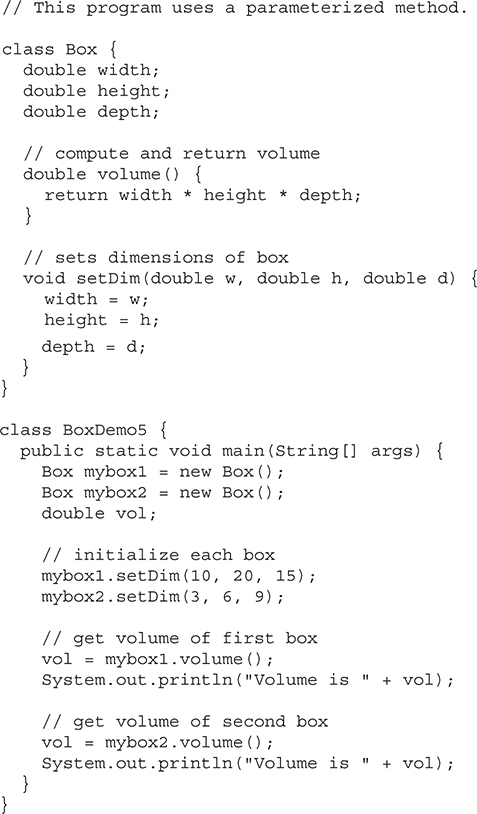
As you can see, the setDim( ) method is used to set the dimensions of each box. For example, when
mybox1.setDim(10, 20, 15);
is executed, 10 is copied into parameter w, 20 is copied into h, and 15 is copied into d. Inside setDim( ) the values of w, h, and d are then assigned to width, height, and depth, respectively.
For many readers, the concepts presented in the preceding sections will be familiar. However, if such things as method calls, arguments, and parameters are new to you, then you might want to take some time to experiment before moving on. The concepts of the method invocation, parameters, and return values are fundamental to Java programming.
It can be tedious to initialize all of the variables in a class each time an instance is created. Even when you add convenience methods like setDim( ), it would be simpler and more concise to have all of the setup done at the time the object is first created. Because the requirement for initialization is so common, Java allows objects to initialize themselves when they are created. This automatic initialization is performed through the use of a constructor.
A constructor initializes an object immediately upon creation. It has the same name as the class in which it resides and is syntactically similar to a method. Once defined, the constructor is automatically called when the object is created, before the new operator completes. Constructors look a little strange because they have no return type, not even void. This is because the implicit return type of a class’ constructor is the class type itself. It is the constructor’s job to initialize the internal state of an object so that the code creating an instance will have a fully initialized, usable object immediately.
You can rework the Box example so that the dimensions of a box are automatically initialized when an object is constructed. To do so, replace setDim( ) with a constructor. Let’s begin by defining a simple constructor that sets the dimensions of each box to the same values. This version is shown here:
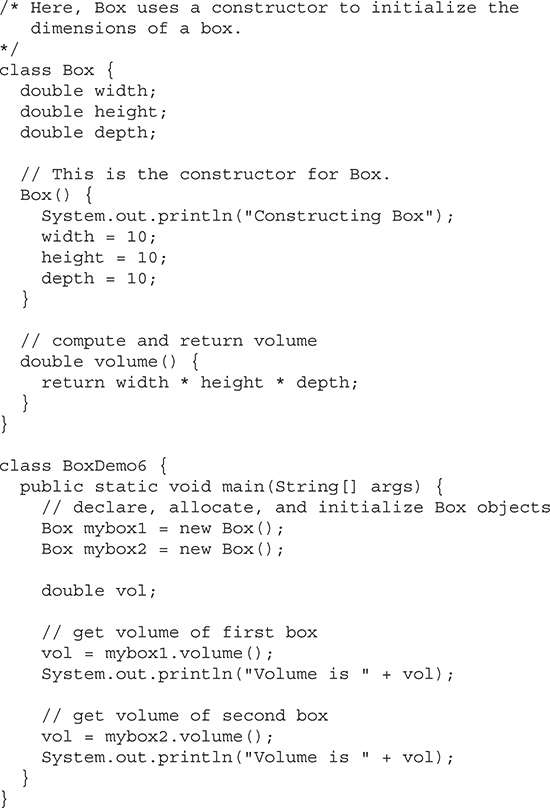
When this program is run, it generates the following results:
Constructing Box
Constructing Box
Volume is 1000.0
Volume is 1000.0
As you can see, both mybox1 and mybox2 were initialized by the Box( ) constructor when they were created. Since the constructor gives all boxes the same dimensions, 10 by 10 by 10, both mybox1 and mybox2 will have the same volume. The println( ) statement inside Box( ) is for the sake of illustration only. Most constructors will not display anything. They will simply initialize an object.
Before moving on, let’s reexamine the new operator. As you know, when you allocate an object, you use the following general form:
class-var = new classname ( );
Now you can understand why the parentheses are needed after the class name. What is actually happening is that the constructor for the class is being called. Thus, in the line
Box mybox1 = new Box();
new Box( ) is calling the Box( ) constructor. When you do not explicitly define a constructor for a class, then Java creates a default constructor for the class. This is why the preceding line of code worked in earlier versions of Box that did not define a constructor. When using the default constructor, all non-initialized instance variables will have their default values, which are zero, null, and false, for numeric types, reference types, and boolean, respectively. The default constructor is often sufficient for simple classes, but it usually won’t do for more sophisticated ones. Once you define your own constructor, the default constructor is no longer used.
While the Box( ) constructor in the preceding example does initialize a Box object, it is not very useful—all boxes have the same dimensions. What is needed is a way to construct Box objects of various dimensions. The easy solution is to add parameters to the constructor. As you can probably guess, this makes it much more useful. For example, the following version of Box defines a parameterized constructor that sets the dimensions of a box as specified by those parameters. Pay special attention to how Box objects are created.
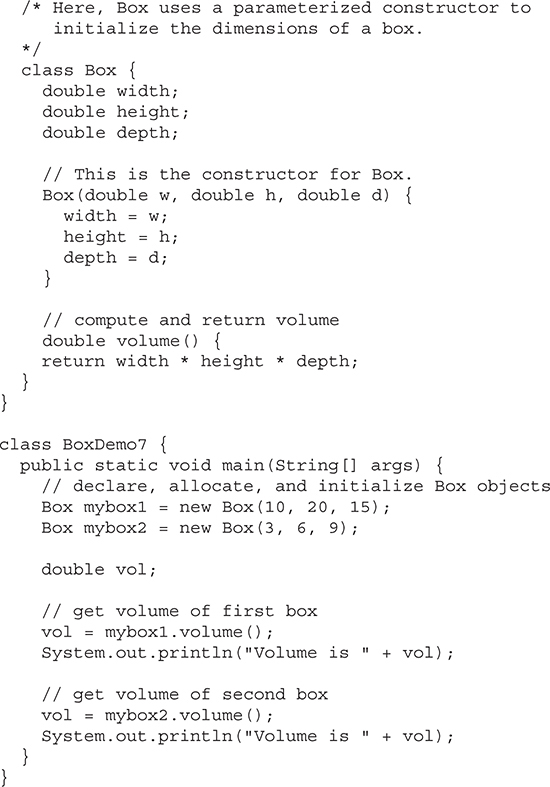
The output from this program is shown here:
Volume is 3000.0
Volume is 162.0
As you can see, each object is initialized as specified in the parameters to its constructor. For example, in the following line,
Box mybox1 = new Box(10, 20, 15);
the values 10, 20, and 15 are passed to the Box( ) constructor when new creates the object. Thus, mybox1’s copy of width, height, and depth will contain the values 10, 20, and 15, respectively.
Sometimes a method will need to refer to the object that invoked it. To allow this, Java defines the this keyword. this can be used inside any method to refer to the current object. That is, this is always a reference to the object on which the method was invoked. You can use this anywhere a reference to an object of the current class’ type is permitted.
To better understand what this refers to, consider the following version of Box( ):

This version of Box( ) operates exactly like the earlier version. The use of this is redundant, but perfectly correct. Inside Box( ), this will always refer to the invoking object. While it is redundant in this case, this is useful in other contexts, one of which is explained in the next section.
As you know, it is illegal in Java to declare two local variables with the same name inside the same or enclosing scopes. Interestingly, you can have local variables, including formal parameters to methods, which overlap with the names of the class’ instance variables. However, when a local variable has the same name as an instance variable, the local variable hides the instance variable. This is why width, height, and depth were not used as the names of the parameters to the Box( ) constructor inside the Box class. If they had been, then width, for example, would have referred to the formal parameter, hiding the instance variable width. While it is usually easier to simply use different names, there is another way around this situation. Because this lets you refer directly to the object, you can use it to resolve any namespace collisions that might occur between instance variables and local variables. For example, here is another version of Box( ), which uses width, height, and depth for parameter names and then uses this to access the instance variables by the same name:

A word of caution: The use of this in such a context can sometimes be confusing, and some programmers are careful not to use local variables and formal parameter names that hide instance variables. Of course, other programmers believe the contrary—that it is a good convention to use the same names for clarity, and use this to overcome the instance variable hiding. It is a matter of taste which approach you adopt.
Since objects are dynamically allocated by using the new operator, you might be wondering how such objects are destroyed and their memory released for later reallocation. In some languages, such as traditional C++, dynamically allocated objects must be manually released by use of a delete operator. Java takes a different approach; it handles deallocation for you automatically. The technique that accomplishes this is called garbage collection. It works like this: when no references to an object exist, that object is assumed to be no longer needed, and the memory occupied by the object can be reclaimed. There is no need to explicitly destroy objects. Garbage collection only occurs sporadically (if at all) during the execution of your program. It will not occur simply because one or more objects exist that are no longer used. Furthermore, different Java run-time implementations will take varying approaches to garbage collection, but for the most part, you should not have to think about it while writing your programs.
While the Box class is useful to illustrate the essential elements of a class, it is of little practical value. To show the real power of classes, this chapter will conclude with a more sophisticated example. As you recall from the discussion of object-oriented programming (OOP) presented in Chapter 2, one of OOP’s most important benefits is the encapsulation of data and the code that manipulates that data. As you have seen, the class is the mechanism by which encapsulation is achieved in Java. By creating a class, you are creating a new data type that defines both the nature of the data being manipulated and the routines used to manipulate it. Further, the methods define a consistent and controlled interface to the class’ data. Thus, you can use the class through its methods without having to worry about the details of its implementation or how the data is actually managed within the class. In a sense, a class is like a “data engine.” No knowledge of what goes on inside the engine is required to use the engine through its controls. In fact, since the details are hidden, its inner workings can be changed as needed. As long as your code uses the class through its methods, internal details can change without causing side effects outside the class.
To see a practical application of the preceding discussion, let’s develop one of the archetypal examples of encapsulation: the stack. A stack stores data using first-in, last-out ordering. That is, a stack is like a stack of plates on a table—the first plate put down on the table is the last plate to be used. Stacks are controlled through two operations traditionally called push and pop. To put an item on top of the stack, you will use push. To take an item off the stack, you will use pop. As you will see, it is easy to encapsulate the entire stack mechanism.
Here is a class called Stack that implements a stack for up to ten integers:
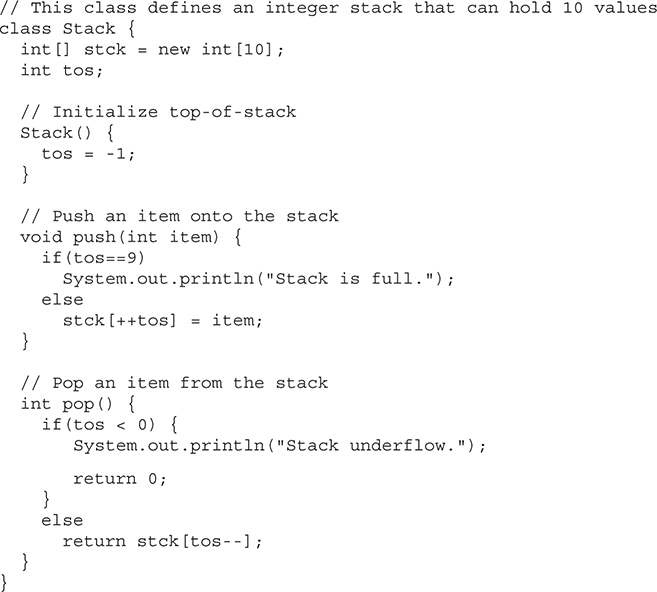
As you can see, the Stack class defines two data items, two methods, and a constructor. The stack of integers is held by the array stck. This array is indexed by the variable tos, which always contains the index of the top of the stack. The Stack( ) constructor initializes tos to –1, which indicates an empty stack. The method push( ) puts an item on the stack. To retrieve an item, call pop( ). Since access to the stack is through push( ) and pop( ), the fact that the stack is held in an array is actually not relevant to using the stack. For example, the stack could be held in a more complicated data structure, such as a linked list, yet the interface defined by push( ) and pop( ) would remain the same.
The class TestStack, shown here, demonstrates the Stack class. It creates two integer stacks, pushes some values onto each, and then pops them off.
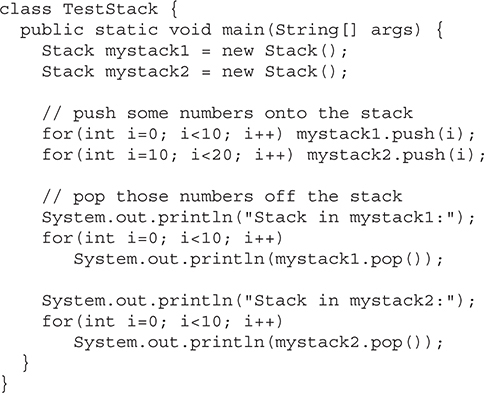
This program generates the following output:
Stack in mystack1:
9
8
7
6
5
4
3
2
1
0
Stack in mystack2:
19
18
17
16
15
14
13
12
11
10
As you can see, the contents of each stack are separate.
One last point about the Stack class. As it is currently implemented, it is possible for the array that holds the stack, stck, to be altered by code outside of the Stack class. This leaves Stack open to misuse or mischief. In the next chapter, you will see how to remedy this situation.
This chapter continues the discussion of methods and classes begun in the preceding chapter. It examines several topics relating to methods, including overloading, parameter passing, and recursion. The chapter then returns to the class, discussing access control, the use of the keyword static, and one of Java’s most important built-in classes: String.
In Java, it is possible to define two or more methods within the same class that share the same name, as long as their parameter declarations are different. When this is the case, the methods are said to be overloaded, and the process is referred to as method overloading. Method overloading is one of the ways that Java supports polymorphism. If you have never used a language that allows the overloading of methods, then the concept may seem strange at first. But as you will see, method overloading is one of Java’s most exciting and useful features.
When an overloaded method is invoked, Java uses the type and/or number of arguments as its guide to determine which version of the overloaded method to actually call. Thus, overloaded methods must differ in the type and/or number of their parameters. While overloaded methods may have different return types, the return type alone is insufficient to distinguish two versions of a method. When Java encounters a call to an overloaded method, it simply executes the version of the method whose parameters match the arguments used in the call.
Here is a simple example that illustrates method overloading:
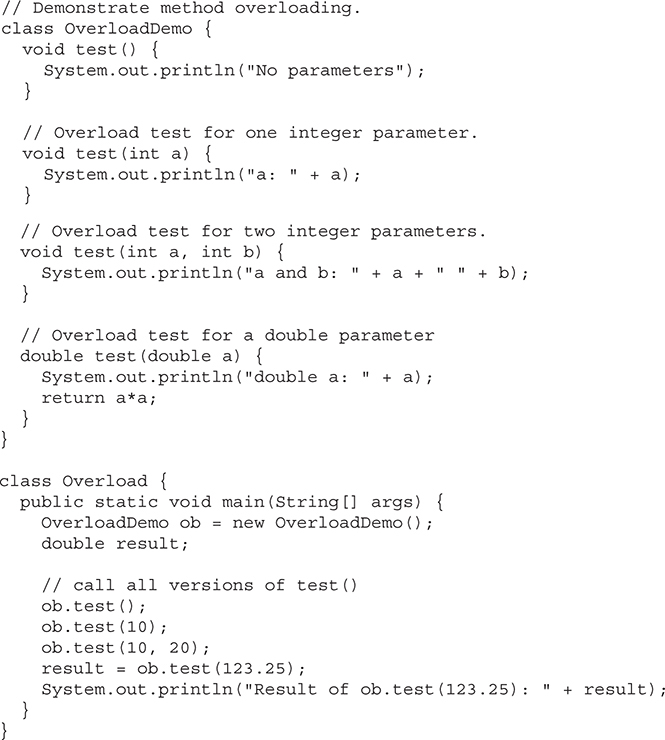
This program generates the following output:
No parameters
a: 10
a and b: 10 20
double a: 123.25
Result of ob.test(123.25): 15190.5625
As you can see, test( ) is overloaded four times. The first version takes no parameters, the second takes one integer parameter, the third takes two integer parameters, and the fourth takes one double parameter. The fact that the fourth version of test( ) also returns a value is of no consequence relative to overloading, since return types do not play a role in overload resolution.
When an overloaded method is called, Java looks for a match between the arguments used to call the method and the method’s parameters. However, this match need not always be exact. In some cases, Java’s automatic type conversions can play a role in overload resolution. For example, consider the following program:
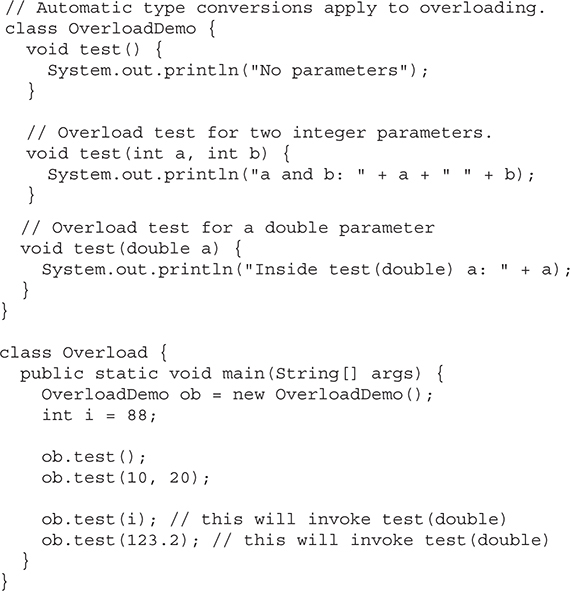
This program generates the following output:
No parameters
a and b: 10 20
Inside test(double) a: 88.0
Inside test(double) a: 123.2
As you can see, this version of OverloadDemo does not define test(int). Therefore, when test( ) is called with an integer argument inside Overload, no matching method is found. However, Java can automatically convert an integer into a double, and this conversion can be used to resolve the call. Therefore, after test(int) is not found, Java elevates i to double and then calls test(double). Of course, if test(int) had been defined, it would have been called instead. Java will employ its automatic type conversions only if no exact match is found.
Method overloading supports polymorphism because it is one way that Java implements the “one interface, multiple methods” paradigm. To understand how, consider the following. In languages that do not support method overloading, each method must be given a unique name. However, frequently you will want to implement essentially the same method for different types of data. Consider the absolute value function. In languages that do not support overloading, there are usually three or more versions of this function, each with a slightly different name. For instance, in C, the function abs( ) returns the absolute value of an integer, labs( ) returns the absolute value of a long integer, and fabs( ) returns the absolute value of a floating-point value. Since C does not support overloading, each function has its own name, even though all three functions do essentially the same thing. This makes the situation more complex, conceptually, than it actually is. Although the underlying concept of each function is the same, you still have three names to remember. This situation does not occur in Java, because each absolute value method can use the same name. Indeed, Java’s standard class library includes an absolute value method, called abs( ). This method is overloaded by Java’s Math class to handle all numeric types. Java determines which version of abs( ) to call based upon the type of argument.
The value of overloading is that it allows related methods to be accessed by use of a common name. Thus, the name abs represents the general action that is being performed. It is left to the compiler to choose the right specific version for a particular circumstance. You, the programmer, need only remember the general operation being performed. Through the application of polymorphism, several names have been reduced to one. Although this example is fairly simple, if you expand the concept, you can see how overloading can help you manage greater complexity.
When you overload a method, each version of that method can perform any activity you desire. There is no rule stating that overloaded methods must relate to one another. However, from a stylistic point of view, method overloading implies a relationship. Thus, while you can use the same name to overload unrelated methods, you should not. For example, you could use the name sqr to create methods that return the square of an integer and the square root of a floating-point value. But these two operations are fundamentally different. Applying method overloading in this manner defeats its original purpose. In practice, you should only overload closely related operations.
In addition to overloading normal methods, you can also overload constructor methods. In fact, for most real-world classes that you create, overloaded constructors will be the norm, not the exception. To understand why, let’s return to the Box class developed in the preceding chapter. Following is the latest version of Box:
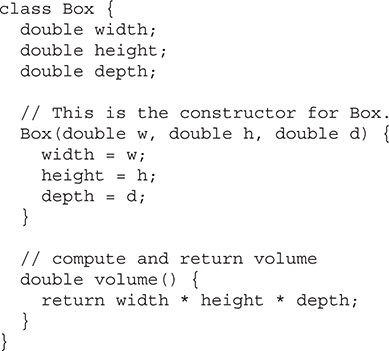
As you can see, the Box( ) constructor requires three parameters. This means that all declarations of Box objects must pass three arguments to the Box( ) constructor. For example, the following statement is currently invalid:
Box ob = new Box();
Since Box( ) requires three arguments, it’s an error to call it without them. This raises some important questions. What if you simply wanted a box and did not care (or know) what its initial dimensions were? Or, what if you want to be able to initialize a cube by specifying only one value that would be used for all three dimensions? As the Box class is currently written, these other options are not available to you.
Fortunately, the solution to these problems is quite easy: simply overload the Box constructor so that it handles the situations just described. Here is a program that contains an improved version of Box that does just that:
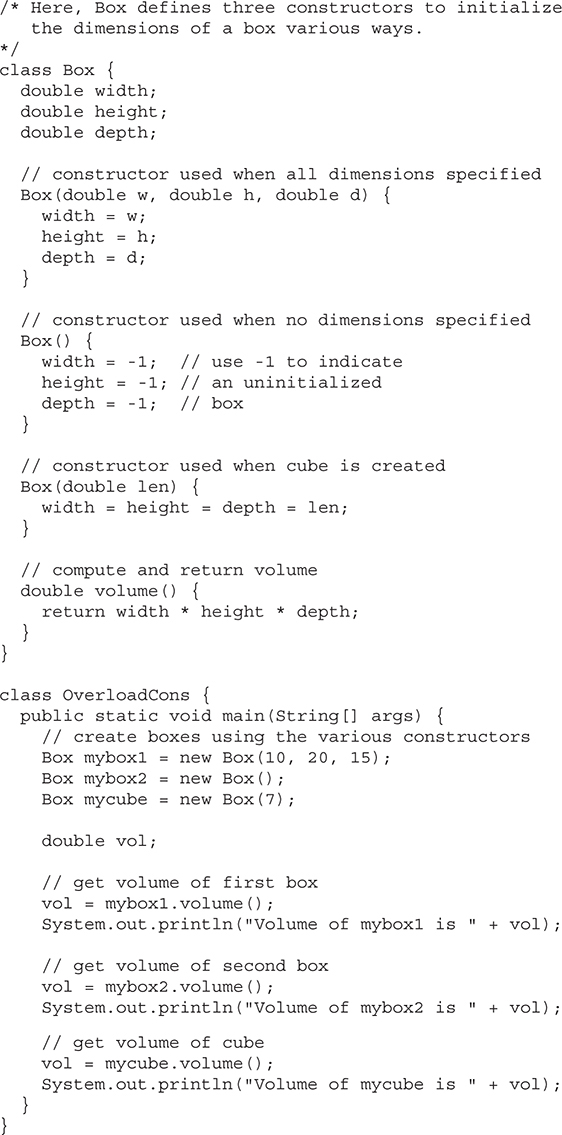
The output produced by this program is shown here:
Volume of mybox1 is 3000.0
Volume of mybox2 is -1.0
Volume of mycube is 343.0
As you can see, the proper overloaded constructor is called based upon the arguments specified when new is executed.
So far, we have only been using simple types as parameters to methods. However, it is both correct and common to pass objects to methods. For example, consider the following short program:
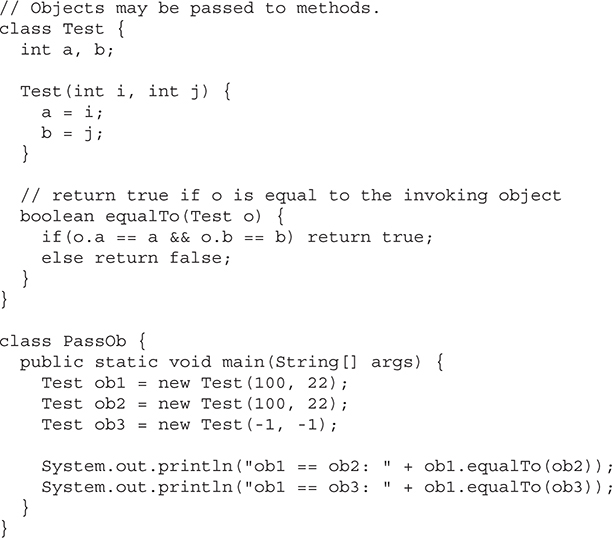
This program generates the following output:
ob1 == ob2: true
ob1 == ob3: false
As you can see, the equalTo( ) method inside Test compares two objects for equality and returns the result. That is, it compares the invoking object with the one that it is passed. If they contain the same values, then the method returns true. Otherwise, it returns false. Notice that the parameter o in equalTo( ) specifies Test as its type. Although Test is a class type created by the program, it is used in just the same way as Java’s built-in types.
One of the most common uses of object parameters involves constructors. Frequently, you will want to construct a new object so that it is initially the same as some existing object. To do this, you must define a constructor that takes an object of its class as a parameter. For example, the following version of Box allows one object to initialize another:
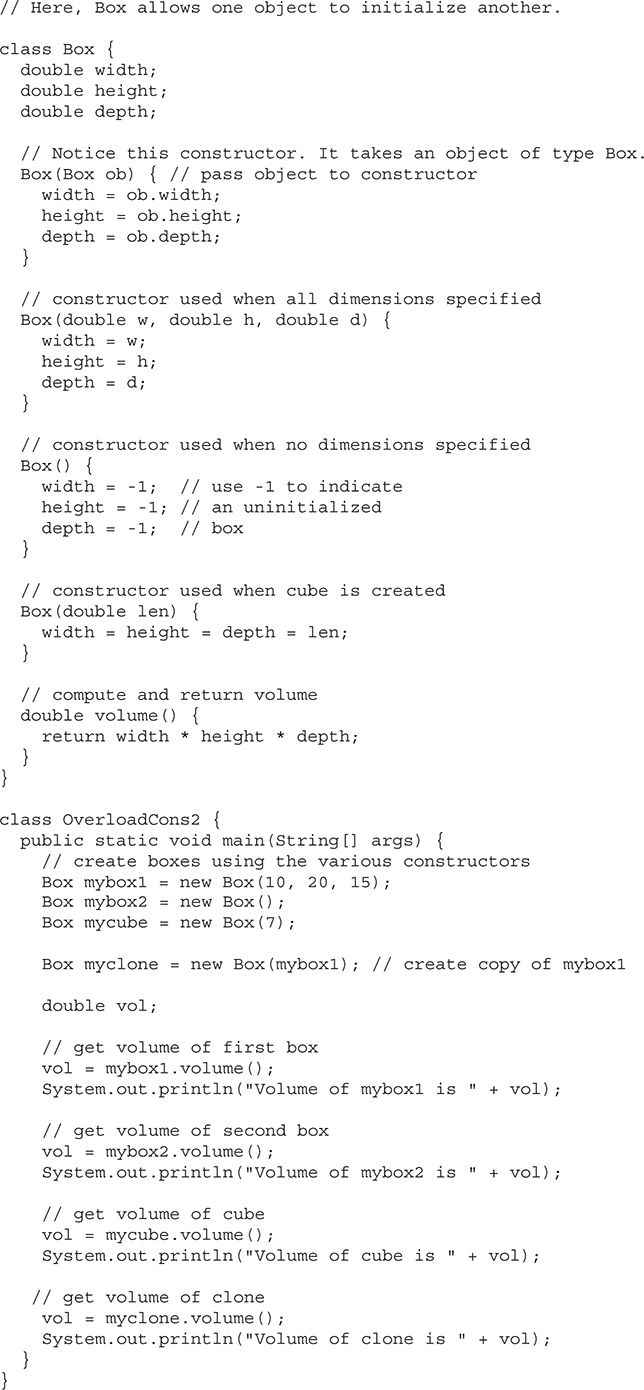
As you will see when you begin to create your own classes, providing many forms of constructors is usually required to allow objects to be constructed in a convenient and efficient manner.
In general, there are two ways that a computer language can pass an argument to a subroutine. The first way is call-by-value. This approach copies the value of an argument into the formal parameter of the subroutine. Therefore, changes made to the parameter of the subroutine have no effect on the argument. The second way an argument can be passed is call-by-reference. In this approach, a reference to an argument (not the value of the argument) is passed to the parameter. Inside the subroutine, this reference is used to access the actual argument specified in the call. This means that changes made to the parameter will affect the argument used to call the subroutine. As you will see, although Java uses call-by-value to pass all arguments, the precise effect differs between whether a primitive type or a reference type is passed.
When you pass a primitive type to a method, it is passed by value. Thus, a copy of the argument is made, and what occurs to the parameter that receives the argument has no effect outside the method. For example, consider the following program:
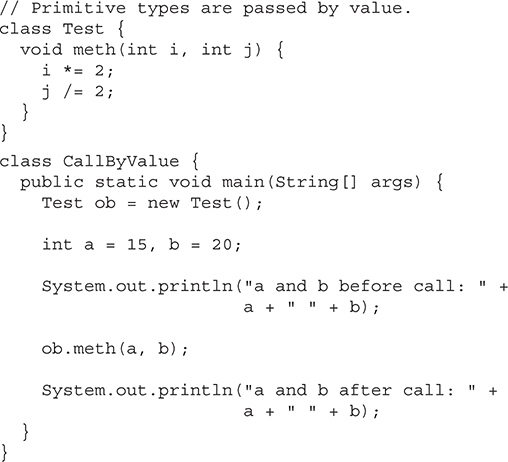
The output from this program is shown here:
a and b before call: 15 20
a and b after call: 15 20
As you can see, the operations that occur inside meth( ) have no effect on the values of a and b used in the call; their values here did not change to 30 and 10.
When you pass an object to a method, the situation changes dramatically, because objects are passed by what is effectively call-by-reference. Keep in mind that when you create a variable of a class type, you are only creating a reference to an object. Thus, when you pass this reference to a method, the parameter that receives it will refer to the same object as that referred to by the argument. This effectively means that objects act as if they are passed to methods by use of call-by-reference. Changes to the object inside the method do affect the object used as an argument. For example, consider the following program:
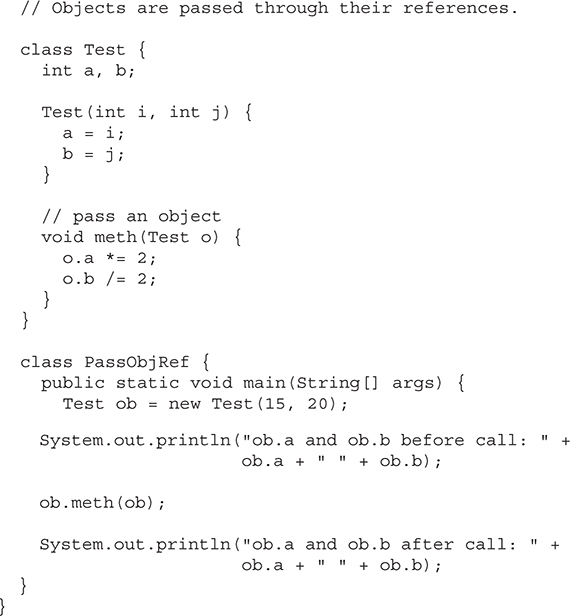
This program generates the following output:
ob.a and ob.b before call: 15 20
ob.a and ob.b after call: 30 10
As you can see, in this case, the actions inside meth( ) have affected the object used as an argument.
Remember When an object reference is passed to a method, the reference itself is passed by use of call-by-value. However, since the value being passed refers to an object, the copy of that value will still refer to the same object that its corresponding argument does.
A method can return any type of data, including class types that you create. For example, in the following program, the incrByTen( ) method returns an object in which the value of a is ten greater than it is in the invoking object.
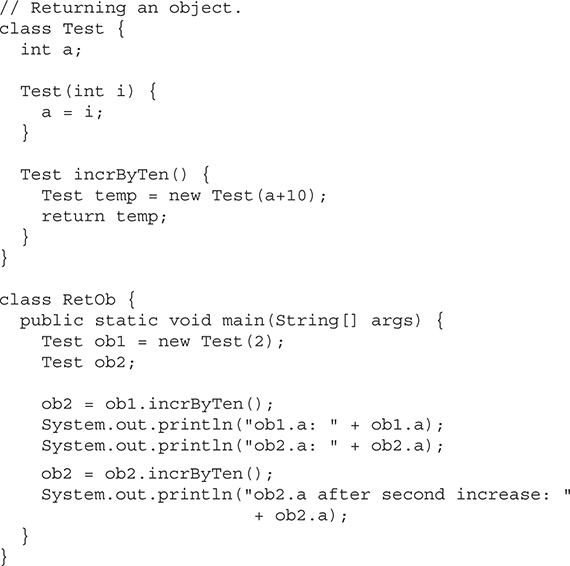
The output generated by this program is shown here:
ob1.a: 2
ob2.a: 12
ob2.a after second increase: 22
As you can see, each time incrByTen( ) is invoked, a new object is created, and a reference to it is returned to the calling routine.
The preceding program makes another important point: Since all objects are dynamically allocated using new, you don’t need to worry about an object going out-of-scope because the method in which it was created terminates. The object will continue to exist as long as there is a reference to it somewhere in your program. When there are no references to it, the object will be reclaimed the next time garbage collection takes place.
Java supports recursion. Recursion is the process of defining something in terms of itself. As it relates to Java programming, recursion is the attribute that allows a method to call itself. A method that calls itself is said to be recursive.
The classic example of recursion is the computation of the factorial of a number. The factorial of a number N is the product of all the whole numbers between 1 and N. For example, 3 factorial is 1 × 2 × 3 ×, or 6. Here is how a factorial can be computed by use of a recursive method:
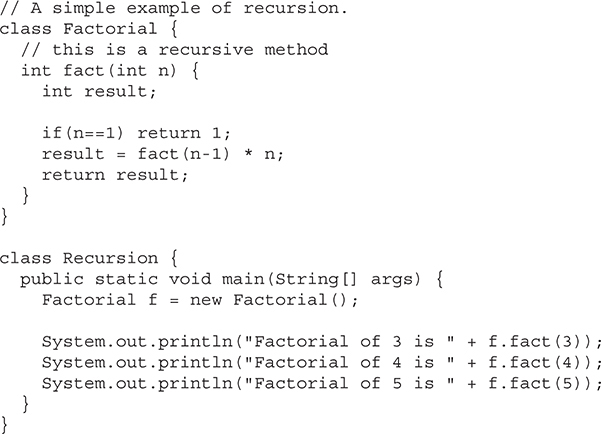
The output from this program is shown here:
Factorial of 3 is 6
Factorial of 4 is 24
Factorial of 5 is 120
If you are unfamiliar with recursive methods, then the operation of fact( ) may seem a bit confusing. Here is how it works. When fact( ) is called with an argument of 1, the function returns 1; otherwise, it returns the product of fact(n–1)*n. To evaluate this expression, fact( ) is called with n–1. This process repeats until n equals 1 and the calls to the method begin returning.
To better understand how the fact( ) method works, let’s go through a short example. When you compute the factorial of 3, the first call to fact( ) will cause a second call to be made with an argument of 2. This invocation will cause fact( ) to be called a third time with an argument of 1. This call will return 1, which is then multiplied by 2 (the value of n in the second invocation). This result (which is 2) is then returned to the original invocation of fact( ) and multiplied by 3 (the original value of n). This yields the answer, 6. You might find it interesting to insert println( ) statements into fact( ), which will show at what level each call is and what the intermediate answers are.
When a method calls itself, new local variables and parameters are allocated storage on the stack, and the method code is executed with these new variables from the start. As each recursive call returns, the old local variables and parameters are removed from the stack, and execution resumes at the point of the call inside the method. Recursive methods could be said to “telescope” out and back.
Recursive versions of many routines may execute a bit more slowly than the iterative equivalent because of the added overhead of the additional method calls. A large number of recursive calls to a method could cause a stack overrun. Because storage for parameters and local variables is on the stack and each new call creates a new copy of these variables, it is possible that the stack could be exhausted. If this occurs, the Java run-time system will cause an exception. However, this is typically not an issue unless a recursive routine runs wild.
The main advantage to recursive methods is that they can be used to create clearer and simpler versions of several algorithms than can their iterative relatives. For example, the QuickSort sorting algorithm is quite difficult to implement in an iterative way. Also, some types of AI-related algorithms are most easily implemented using recursive solutions.
When writing recursive methods, you must have an if statement somewhere to force the method to return without the recursive call being executed. If you don’t do this, once you call the method, it will never return. This is a very common error in working with recursion. Use println( ) statements liberally during development so that you can watch what is going on and abort execution if you see that you have made a mistake.
Here is one more example of recursion. The recursive method printArray( ) prints the first i elements in the array values.
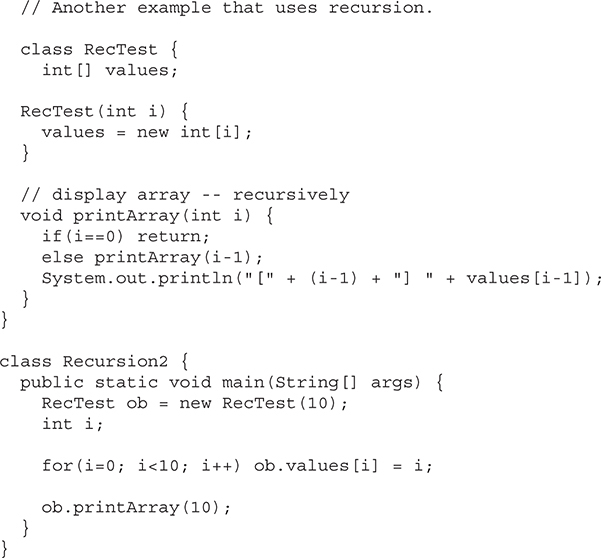
This program generates the following output:
[0] 0
[1] 1
[2] 2
[3] 3
[4] 4
[5] 5
[6] 6
[7] 7
[8] 8
[9] 9
As you know, encapsulation links data with the code that manipulates it. However, encapsulation provides another important attribute: access control. Through encapsulation, you can control what parts of a program can access the members of a class. By controlling access, you can prevent misuse. For example, allowing access to data only through a well-defined set of methods, you can prevent the misuse of that data. Thus, when correctly implemented, a class creates a “black box” which may be used, but the inner workings of which are not open to tampering. However, the classes that were presented earlier do not completely meet this goal. For example, consider the Stack class shown at the end of Chapter 6. While it is true that the methods push( ) and pop( ) do provide a controlled interface to the stack, this interface is not enforced. That is, it is possible for another part of the program to bypass these methods and access the stack directly. Of course, in the wrong hands, this could lead to trouble. In this section, you will be introduced to the mechanism by which you can precisely control access to the various members of a class.
How a member can be accessed is determined by the access modifier attached to its declaration. Java supplies a rich set of access modifiers. Some aspects of access control are related mostly to inheritance or packages. (A package is, essentially, a grouping of classes.) These parts of Java’s access control mechanism will be discussed in subsequent chapters. Here, let’s begin by examining access control as it applies to a single class. Once you understand the fundamentals of access control, the rest will be easy.
Note The modules feature added by JDK 9 can also impact accessibility. Modules are described in Chapter 16.
Java’s access modifiers are public, private, and protected. Java also defines a default access level. protected applies only when inheritance is involved. The other access modifiers are described next.
Let’s begin by defining public and private. When a member of a class is modified by public, then that member can be accessed by any other code. When a member of a class is specified as private, then that member can only be accessed by other members of its class. Now you can understand why main( ) has always been preceded by the public modifier. It is called by code that is outside the program—that is, by the Java run-time system. When no access modifier is used, then by default the member of a class is public within its own package, but cannot be accessed outside of its package. (Packages are discussed in Chapter 9.)
In the classes developed so far, all members of a class have used the default access mode. However, this is not what you will typically want to be the case. Usually, you will want to restrict access to the data members of a class—allowing access only through methods. Also, there will be times when you will want to define methods that are private to a class.
An access modifier precedes the rest of a member’s type specification. That is, it must begin a member’s declaration statement. Here is an example:
public int i;
private double j;
private int myMethod(int a, char b) { //...
To understand the effects of public and private access, consider the following program:
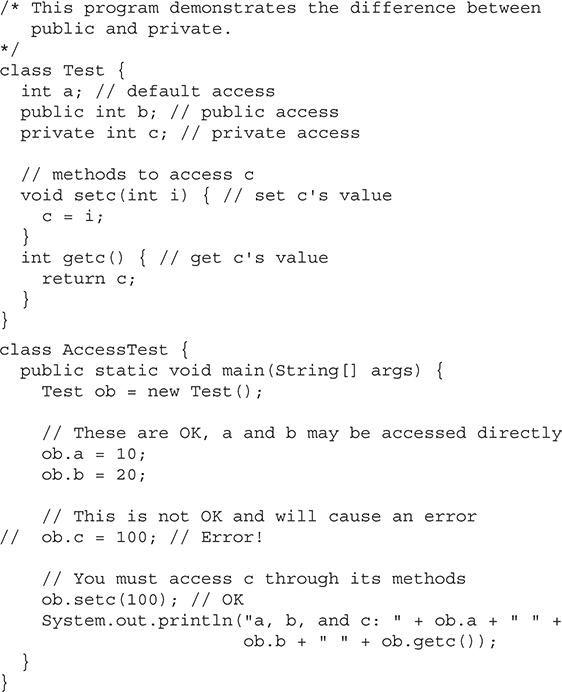
As you can see, inside the Test class, a uses default access, which for this example is the same as specifying public. b is explicitly specified as public. Member c is given private access. This means that it cannot be accessed by code outside of its class. So, inside the AccessTest class, c cannot be used directly. It must be accessed through its public methods: setc( ) and getc( ). If you were to remove the comment symbol from the beginning of the following line,
// ob.c = 100; // Error!
then you would not be able to compile this program because of the access violation.
To see how access control can be applied to a more practical example, consider the following improved version of the Stack class shown at the end of Chapter 6.
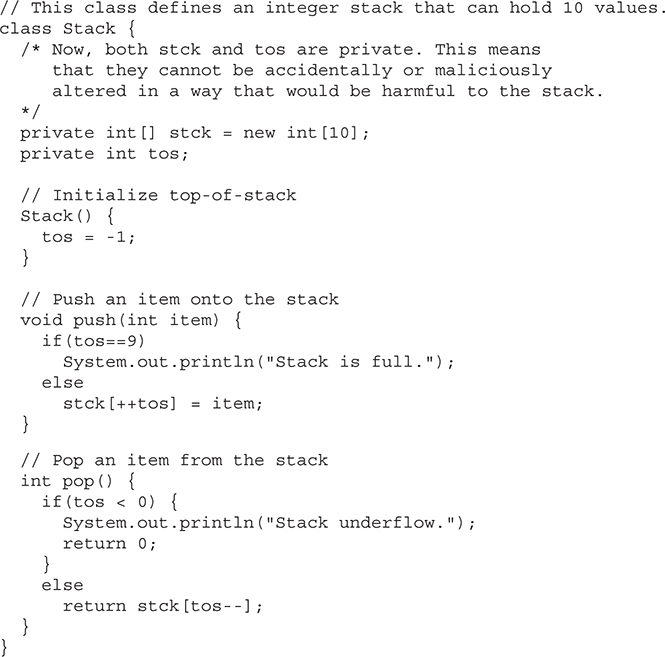
As you can see, now both stck, which holds the stack, and tos, which is the index of the top of the stack, are specified as private. This means that they cannot be accessed or altered except through push( ) and pop( ). Making tos private, for example, prevents other parts of your program from inadvertently setting it to a value that is beyond the end of the stck array.
The following program demonstrates the improved Stack class. Try removing the commented-out lines to prove to yourself that the stck and tos members are, indeed, inaccessible.
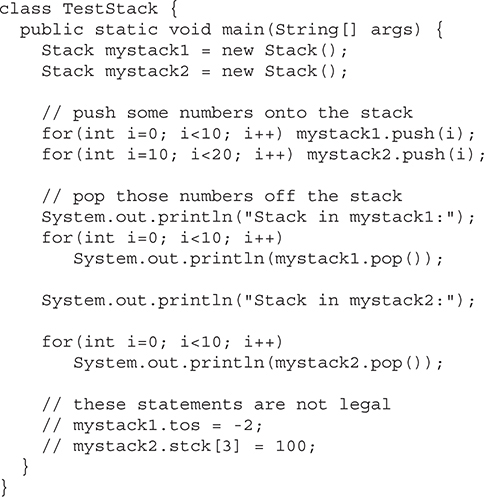
Although methods will usually provide access to the data defined by a class, this does not always have to be the case. It is perfectly proper to allow an instance variable to be public when there is good reason to do so. For example, most of the simple classes in this book were created with little concern about controlling access to instance variables for the sake of simplicity. However, in most real-world classes, you will need to allow operations on data only through methods. The next chapter will return to the topic of access control. As you will see, it is particularly important when inheritance is involved.
There will be times when you will want to define a class member that will be used independently of any object of that class. Normally, a class member must be accessed only in conjunction with an object of its class. However, it is possible to create a member that can be used by itself, without reference to a specific instance. To create such a member, precede its declaration with the keyword static. When a member is declared static, it can be accessed before any objects of its class are created, and without reference to any object. You can declare both methods and variables to be static. The most common example of a static member is main( ). main( ) is declared as static because it must be called before any objects exist.
Instance variables declared as static are, essentially, global variables. When objects of its class are declared, no copy of a static variable is made. Instead, all instances of the class share the same static variable.
Methods declared as static have several restrictions:
• They can only directly call other static methods of their class.
• They can only directly access static variables of their class.
• They cannot refer to this or super in any way. (The keyword super relates to inheritance and is described in the next chapter.)
If you need to do computation in order to initialize your static variables, you can declare a static block that gets executed exactly once, when the class is first loaded. The following example shows a class that has a static method, some static variables, and a static initialization block:
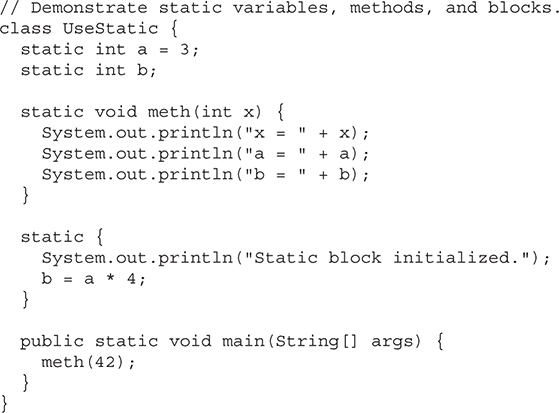
As soon as the UseStatic class is loaded, all of the static statements are run. First, a is set to 3, then the static block executes, which prints a message and then initializes b to a*4 or 12. Then main( ) is called, which calls meth( ), passing 42 to x. The three println( ) statements refer to the two static variables a and b, as well as to the parameter x.
Here is the output of the program:
Static block initialized.
x = 42
a = 3
b = 12
Outside of the class in which they are defined, static methods and variables can be used independently of any object. To do so, you need only specify the name of their class followed by the dot operator. For example, if you wish to call a static method from outside its class, you can do so using the following general form:
classname.method( )
Here, classname is the name of the class in which the static method is declared. As you can see, this format is similar to that used to call non-static methods through object-reference variables. A static variable can be accessed in the same way—by use of the dot operator on the name of the class. This is how Java implements a controlled version of global methods and global variables.
Here is an example. Inside main( ), the static method callme( ) and the static variable b are accessed through their class name StaticDemo.
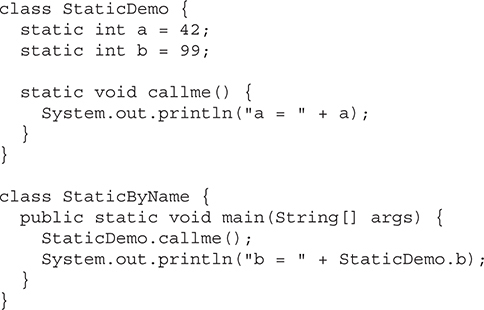
Here is the output of this program:
a = 42
b = 99
A field can be declared as final. Doing so prevents its contents from being modified, making it, essentially, a constant. This means that you must initialize a final field when it is declared. You can do this in one of two ways: First, you can give it a value when it is declared. Second, you can assign it a value within a constructor. The first approach is probably the most common. Here is an example:
final int FILE_NEW = 1;
final int FILE_OPEN = 2;
final int FILE_SAVE = 3;
final int FILE_SAVEAS = 4;
final int FILE_QUIT = 5;
Subsequent parts of your program can now use FILE_OPEN, etc., as if they were constants, without fear that a value has been changed. It is a common coding convention to choose all uppercase identifiers for final fields, as this example shows.
In addition to fields, both method parameters and local variables can be declared final. Declaring a parameter final prevents it from being changed within the method. Declaring a local variable final prevents it from being assigned a value more than once.
The keyword final can also be applied to methods, but its meaning is substantially different than when it is applied to variables. This additional usage of final is explained in the next chapter, when inheritance is described.
Arrays were introduced earlier in this book, before classes had been discussed. Now that you know about classes, an important point can be made about arrays: they are implemented as objects. Because of this, there is a special array attribute that you will want to take advantage of. Specifically, the size of an array—that is, the number of elements that an array can hold—is found in its length instance variable. All arrays have this variable, and it will always hold the size of the array. Here is a program that demonstrates this property:
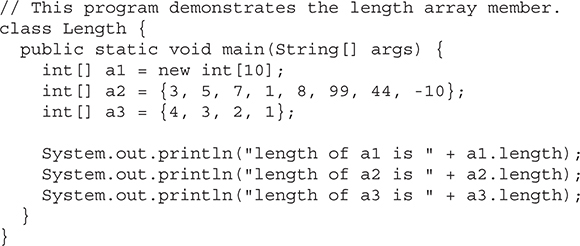
This program displays the following output:
length of a1 is 10
length of a2 is 8
length of a3 is 4
As you can see, the size of each array is displayed. Keep in mind that the value of length has nothing to do with the number of elements that are actually in use. It only reflects the number of elements that the array is designed to hold.
You can put the length member to good use in many situations. For example, here is an improved version of the Stack class. As you might recall, the earlier versions of this class always created a ten-element stack. The following version lets you create stacks of any size. The value of stck.length is used to prevent the stack from overflowing.
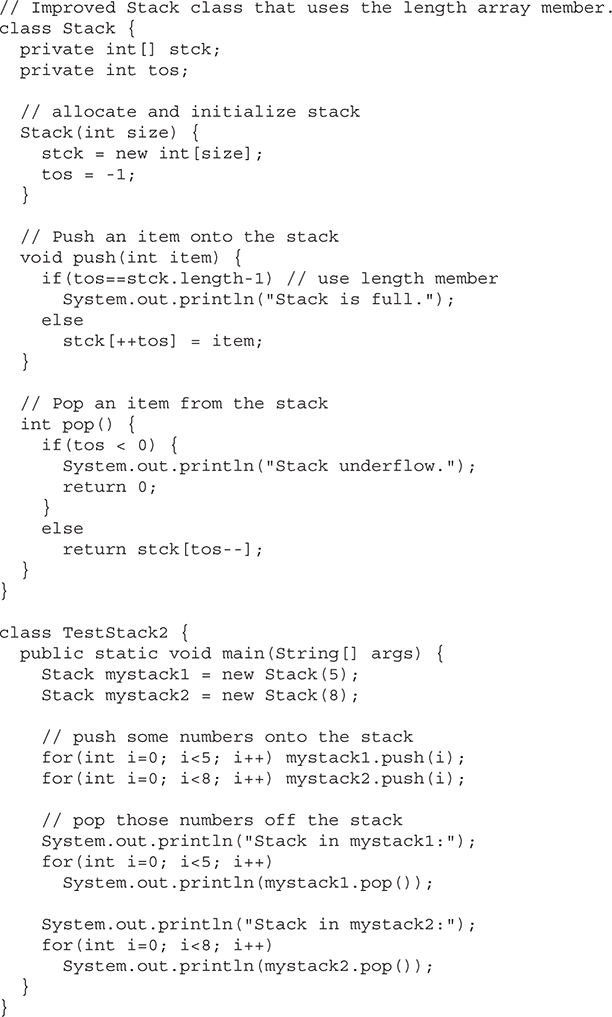
Notice that the program creates two stacks: one five elements deep and the other eight elements deep. As you can see, the fact that arrays maintain their own length information makes it easy to create stacks of any size.
It is possible to define a class within another class; such classes are known as nested classes. The scope of a nested class is bounded by the scope of its enclosing class. Thus, if class B is defined within class A, then B does not exist independently of A. A nested class has access to the members, including private members, of the class in which it is nested. However, the enclosing class does not have access to the members of the nested class. A nested class that is declared directly within its enclosing class scope is a member of its enclosing class. It is also possible to declare a nested class that is local to a block.
There are two types of nested classes: static and non-static. A static nested class is one that has the static modifier applied. Because it is static, it must access the non-static members of its enclosing class through an object. That is, it cannot refer to non-static members of its enclosing class directly.
The second type of nested class is the inner class. An inner class is a non-static nested class. It has access to all of the variables and methods of its outer class and may refer to them directly in the same way that other non-static members of the outer class do.
The following program illustrates how to define and use an inner class. The class named Outer has one instance variable named outer_x, one instance method named test( ), and defines one inner class called Inner.
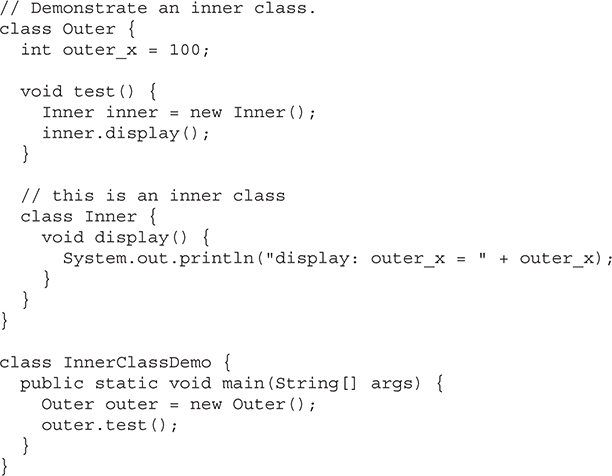
Output from this application is shown here:
display: outer_x = 100
In the program, an inner class named Inner is defined within the scope of class Outer. Therefore, any code in class Inner can directly access the variable outer_x. An instance method named display( ) is defined inside Inner. This method displays outer_x on the standard output stream. The main( ) method of InnerClassDemo creates an instance of class Outer and invokes its test( ) method. That method creates an instance of class Inner and the display( ) method is called.
It is important to realize that an instance of Inner can be created only in the context of class Outer. The Java compiler generates an error message otherwise. In general, an inner class instance is often created by code within its enclosing scope, as the example does.
As explained, an inner class has access to all of the members of its enclosing class, but the reverse is not true. Members of the inner class are known only within the scope of the inner class and may not be used by the outer class. For example,
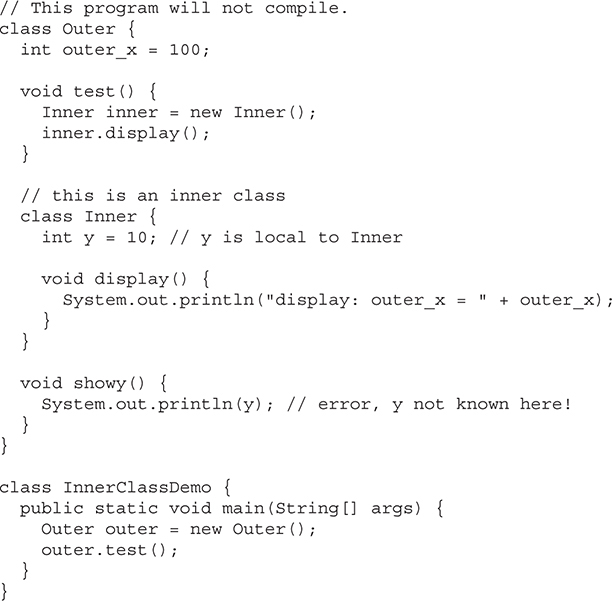
Here, y is declared as an instance variable of Inner. Thus, it is not known outside of that class and it cannot be used by showy( ).
Although we have been focusing on inner classes declared as members within an outer class scope, it is possible to define inner classes within any block scope. For example, you can define a nested class within the block defined by a method or even within the body of a for loop, as this next program shows:
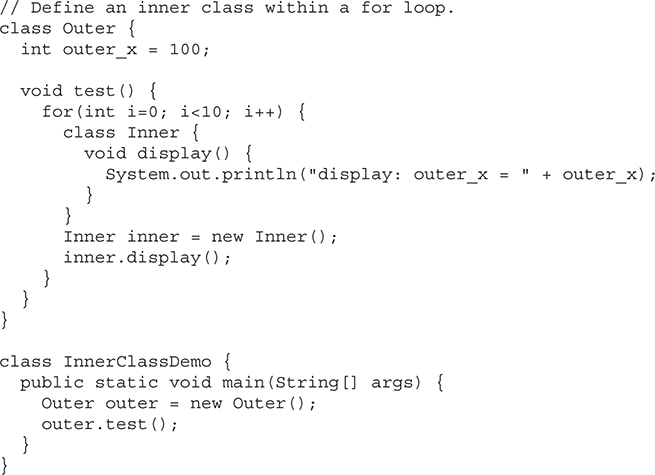
The output from this version of the program is shown here:
display: outer_x = 100
display: outer_x = 100
display: outer_x = 100
display: outer_x = 100
display: outer_x = 100
display: outer_x = 100
display: outer_x = 100
display: outer_x = 100
display: outer_x = 100
display: outer_x = 100
While nested classes are not applicable to all situations, they are particularly helpful when handling events. We will return to the topic of nested classes in Chapter 25. There you will see how inner classes can be used to simplify the code needed to handle certain types of events. You will also learn about anonymous inner classes, which are inner classes that don’t have a name.
One point of interest: Nested classes were not allowed by the original 1.0 specification for Java. They were added by Java 1.1.
Although the String class will be examined in depth in Part II of this book, a short exploration of it is warranted now, because we will be using strings in some of the example programs shown toward the end of Part I. String is probably the most commonly used class in Java’s class library. The obvious reason for this is that strings are a very important part of programming.
The first thing to understand about strings is that every string you create is actually an object of type String. Even string constants are actually String objects. For example, in the statement
System.out.println("This is a String, too");
the string "This is a String, too" is a String object.
The second thing to understand about strings is that objects of type String are immutable; once a String object is created, its contents cannot be altered. While this may seem like a serious restriction, it is not, for two reasons:
• If you need to change a string, you can always create a new one that contains the modifications.
• Java defines peer classes of String, called StringBuffer and StringBuilder, which allow strings to be altered, so all of the normal string manipulations are still available in Java. (StringBuffer and StringBuilder are described in Part II of this book.)
Strings can be constructed in a variety of ways. The easiest is to use a statement like this:
String myString = "this is a test";
Once you have created a String object, you can use it anywhere that a string is allowed. For example, this statement displays myString:
System.out.println(myString);
Java defines one operator for String objects: +. It is used to concatenate two strings. For example, this statement
String myString = "I" + " like " + "Java.";
results in myString containing "I like Java."
The following program demonstrates the preceding concepts:
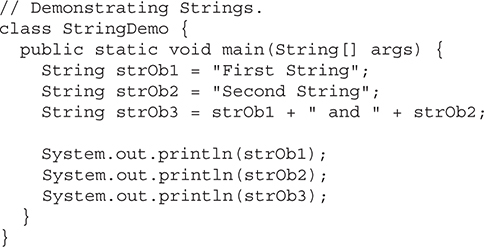
The output produced by this program is shown here:
First String
Second String
First String and Second String
The String class contains several methods that you can use. Here are a few. You can test two strings for equality by using equals( ). You can obtain the length of a string by calling the length( ) method. You can obtain the character at a specified index within a string by calling charAt( ). The general forms of these three methods are shown here:
boolean equals(secondStr)
int length( )
char charAt(index)
Here is a program that demonstrates these methods:
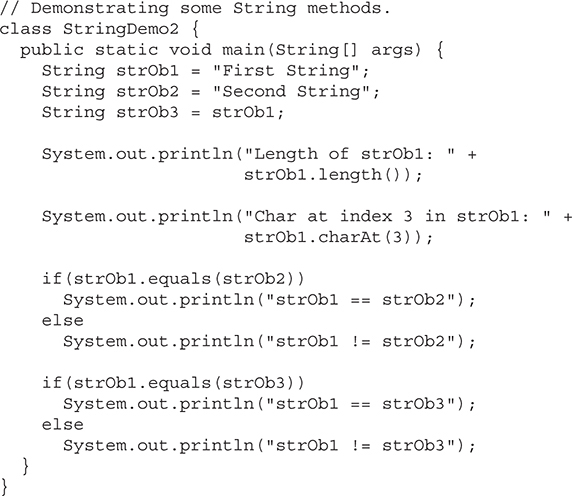
This program generates the following output:
Length of strOb1: 12
Char at index 3 in strOb1: s
strOb1 != strOb2
strOb1 == strOb3
Of course, you can have arrays of strings, just like you can have arrays of any other type of object. For example:
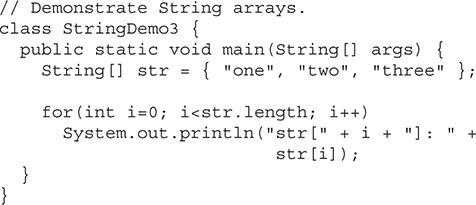
Here is the output from this program:
str[0]: one
str[1]: two
str[2]: three
As you will see in the following section, string arrays play an important part in many Java programs.
Sometimes you will want to pass information into a program when you run it. This is accomplished by passing command-line arguments to main( ). A command-line argument is the information that directly follows the program’s name on the command line when it is executed. To access the command-line arguments inside a Java program is quite easy—they are stored as strings in a String array passed to the args parameter of main( ). The first command-line argument is stored at args[0], the second at args[1], and so on. For example, the following program displays all of the command-line arguments that it is called with:
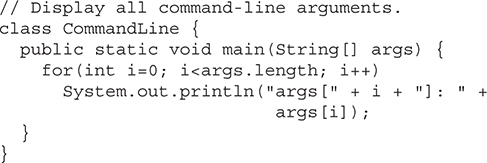
Try executing this program, as shown here:
java CommandLine this is a test 100 -1
When you do, you will see the following output:
args[0]: this
args[1]: is
args[2]: a
args[3]: test
args[4]: 100
args[5]: -1
Remember All command-line arguments are passed as strings. You must convert numeric values to their internal forms manually, as explained in Chapter 19.
Modern versions of Java include a feature that simplifies the creation of methods that need to take a variable number of arguments. This feature is called varargs and it is short for variable-length arguments. A method that takes a variable number of arguments is called a variable-arity method, or simply a varargs method.
Situations that require that a variable number of arguments be passed to a method are not unusual. For example, a method that opens an Internet connection might take a user name, password, filename, protocol, and so on, but supply defaults if some of this information is not provided. In this situation, it would be convenient to pass only the arguments to which the defaults did not apply. Another example is the printf( ) method that is part of Java’s I/O library. As you will see in Chapter 22, it takes a variable number of arguments, which it formats and then outputs.
In the early days of Java, variable-length arguments could be handled two ways, neither of which was particularly pleasing. First, if the maximum number of arguments was small and known, then you could create overloaded versions of the method, one for each way the method could be called. Although this works and is suitable for some cases, it applies to only a narrow class of situations.
In cases where the maximum number of potential arguments was larger, or unknowable, a second approach was used in which the arguments were put into an array, and then the array was passed to the method. This approach, which you may still find in older legacy code, is illustrated by the following program:
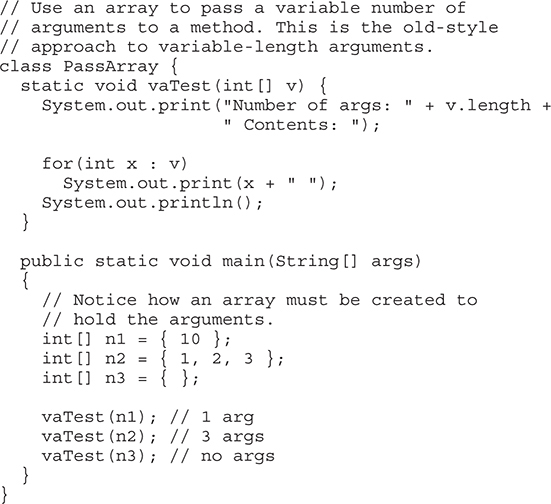
The output from the program is shown here:
Number of args: 1 Contents: 10
Number of args: 3 Contents: 1 2 3
Number of args: 0 Contents:
In the program, the method vaTest( ) is passed its arguments through the array v. This old-style approach to variable-length arguments does enable vaTest( ) to take an arbitrary number of arguments. However, it requires that these arguments be manually packaged into an array prior to calling vaTest( ). Not only is it tedious to construct an array each time vaTest( ) is called, it is potentially error-prone. The varargs feature offers a simpler, better option.
A variable-length argument is specified by three periods (…). For example, here is how vaTest( ) is written using a vararg:
static void vaTest(int ... v) {
This syntax tells the compiler that vaTest( ) can be called with zero or more arguments. As a result, v is implicitly declared as an array of type int[ ]. Thus, inside vaTest( ), v is accessed using the normal array syntax. Here is the preceding program rewritten using a vararg:
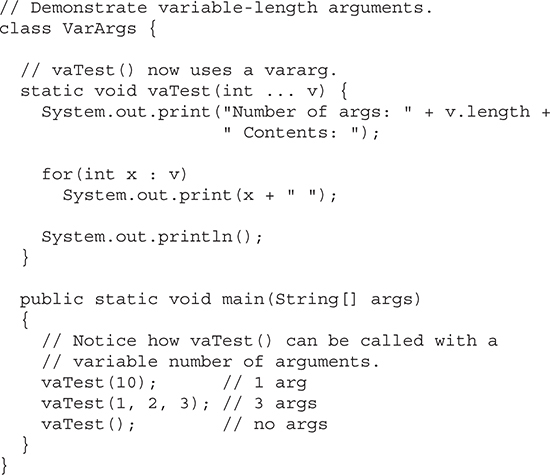
The output from the program is the same as the original version.
There are two important things to notice about this program. First, as explained, inside vaTest( ), v is operated on as an array. This is because v is an array. The … syntax simply tells the compiler that a variable number of arguments will be used, and that these arguments will be stored in the array referred to by v. Second, in main( ), vaTest( ) is called with different numbers of arguments, including no arguments at all. The arguments are automatically put in an array and passed to v. In the case of no arguments, the length of the array is zero.
A method can have “normal” parameters along with a variable-length parameter. However, the variable-length parameter must be the last parameter declared by the method. For example, this method declaration is perfectly acceptable:
int doIt(int a, int b, double c, int ... vals) {
In this case, the first three arguments used in a call to doIt( ) are matched to the first three parameters. Then, any remaining arguments are assumed to belong to vals.
Remember, the varargs parameter must be last. For example, the following declaration is incorrect:
int doIt(int a, int b, double c, int ... vals, boolean stopFlag) { // Error!
Here, there is an attempt to declare a regular parameter after the varargs parameter, which is illegal.
There is one more restriction to be aware of: there must be only one varargs parameter. For example, this declaration is also invalid:
int doIt(int a, int b, double c, int ... vals, double ... morevals) { // Error!
The attempt to declare the second varargs parameter is illegal.
Here is a reworked version of the vaTest( ) method that takes a regular argument and a variable-length argument:
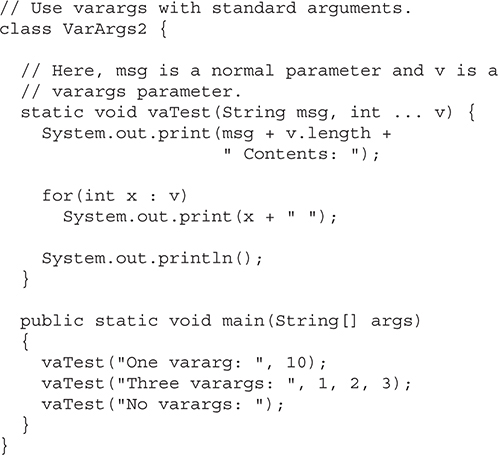
The output from this program is shown here:
One vararg: 1 Contents: 10
Three varargs: 3 Contents: 1 2 3
No varargs: 0 Contents:
You can overload a method that takes a variable-length argument. For example, the following program overloads vaTest( ) three times:
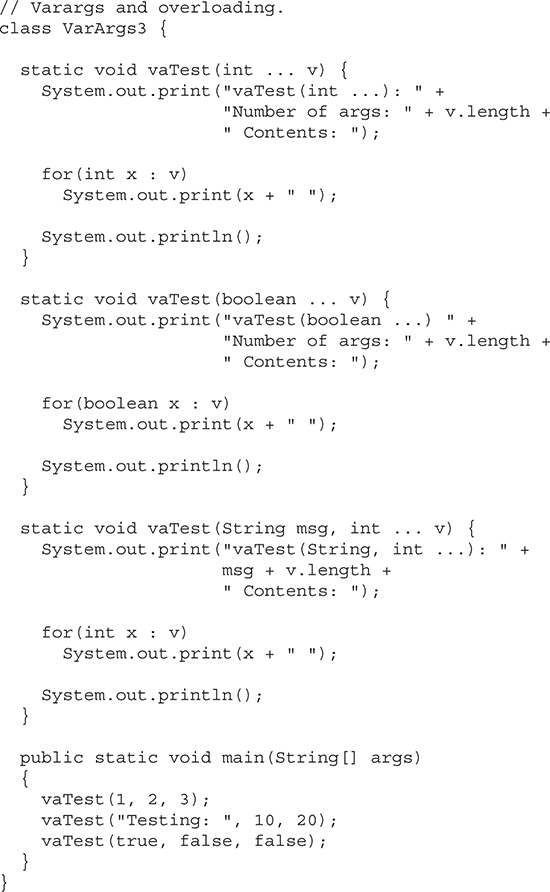
The output produced by this program is shown here:
vaTest(int ...): Number of args: 3 Contents: 1 2 3
vaTest(String, int ...): Testing: 2 Contents: 10 20
vaTest(boolean ...) Number of args: 3 Contents: true false false
This program illustrates both ways that a varargs method can be overloaded. First, the types of its vararg parameter can differ. This is the case for vaTest(int ...) and vaTest(boolean ...). Remember, the ... causes the parameter to be treated as an array of the specified type. Therefore, just as you can overload methods by using different types of array parameters, you can overload vararg methods by using different types of varargs. In this case, Java uses the type difference to determine which overloaded method to call.
The second way to overload a varargs method is to add one or more normal parameters. This is what was done with vaTest(String, int ...). In this case, Java uses both the number of arguments and the type of the arguments to determine which method to call.
Note A varargs method can also be overloaded by a non-varargs method. For example, vaTest(int x) is a valid overload of vaTest( ) in the foregoing program. This version is invoked only when one int argument is present. When two or more int arguments are passed, the varargs version vaTest (int…v) is used.
Somewhat unexpected errors can result when overloading a method that takes a variable-length argument. These errors involve ambiguity because it is possible to create an ambiguous call to an overloaded varargs method. For example, consider the following program:
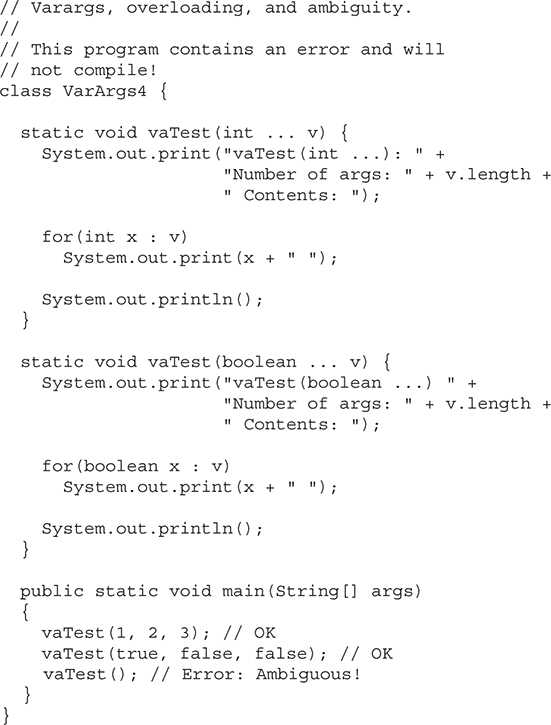
In this program, the overloading of vaTest( ) is perfectly correct. However, this program will not compile because of the following call:
vaTest(); // Error: Ambiguous!
Because the vararg parameter can be empty, this call could be translated into a call to vaTest(int …) or vaTest(boolean …). Both are equally valid. Thus, the call is inherently ambiguous.
Here is another example of ambiguity. The following overloaded versions of vaTest( ) are inherently ambiguous even though one takes a normal parameter:
static void vaTest(int ... v) { // ...
static void vaTest(int n, int ... v) { // ...
Although the parameter lists of vaTest( ) differ, there is no way for the compiler to resolve the following call:
vaTest(1)
Does this translate into a call to vaTest(int …), with one varargs argument, or into a call to vaTest(int, int …) with no varargs arguments? There is no way for the compiler to answer this question. Thus, the situation is ambiguous.
Because of ambiguity errors like those just shown, sometimes you will need to forego overloading and simply use two different method names. Also, in some cases, ambiguity errors expose a conceptual flaw in your code, which you can remedy by more carefully crafting a solution.
As you saw in Chapter 3, beginning with JDK 10, Java supports local variable type inference. Recall that when using local variable type inference, the type of the variable is specified as var and the variable must be initialized. Earlier examples have shown type inference with primitive types, but it can also be used with reference types. In fact, type inference with reference types constitutes a primary use. Here is a simple example that declares a String variable called myStr:
var myStr = "This is a string";
Because a quoted string is used as an initializer, the type String is inferred.
As explained in Chapter 3, one of the benefits of local variable type inference is its ability to streamline code, and it is with reference types where such streamlining is most apparent. The reason for this is that many class types in Java have rather long names. For example, in Chapter 13, you will learn about the FileInputStream class, which is used to open a file for input operations. In the past, you would declare and initialize a FileInputStream using a traditional declaration like the one shown here:
FileInputStream fin = new FileInputStream("test.txt");
With the use of var, it can now be written like this:
var fin = new FileInputStream("test.txt");
Here, fin is inferred to be of type FileInputStream because that is the type of its initializer. There is no need to explicitly repeat the type name. As a result, this declaration of fin is substantially shorter than writing it the traditional way. Thus, the use of var streamlines the declaration. This benefit becomes even more apparent in more complex declarations, such as those involving generics. In general, the streamlining attribute of local variable type inference helps lessen the tedium of entering long type names into your program.
Of course, the streamlining aspect of local variable type inference must be used carefully to avoid reducing the readability of your program and, thus, obscuring its meaning. For example, consider a declaration such as the one shown here:
var x = o.getNext();
In this case, it may not be immediately clear to someone reading your code what the type of x is. In essence, local variable type inference is a feature that you should use wisely.
As you would expect, you can also use local variable type inference with user-defined classes, as the following program illustrates. It creates a class called MyClass and then uses local variable type inference to declare and initialize an object of that class.
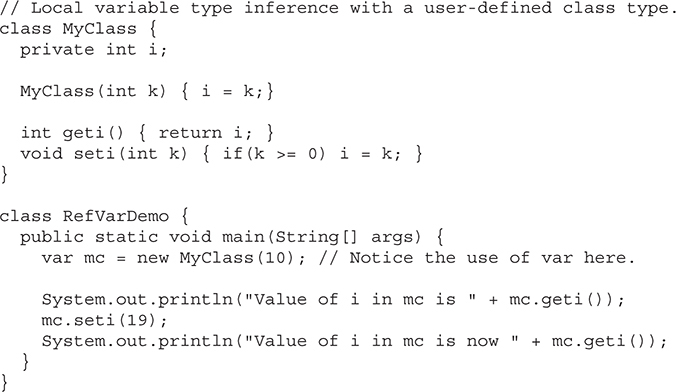
The output of the program is shown here:
Value of i in mc is 10
Value of i in mc is now 19
In the program, pay special attention to this line
var mc = new MyClass(10); // Notice the use of var here.
Here, the type of mc will be inferred as MyClass because that is the type of the initializer, which is a new MyClass object.
As explained earlier in this book, for the benefit of readers working in Java environments that do not support local variable type inference, it will not be used by most examples in the remainder of this edition of this book. This way, the majority of examples will compile and run for the largest number of readers.
Inheritance is one of the cornerstones of object-oriented programming because it allows the creation of hierarchical classifications. Using inheritance, you can create a general class that defines traits common to a set of related items. This class can then be inherited by other, more specific classes, each adding those things that are unique to it. In the terminology of Java, a class that is inherited is called a superclass. The class that does the inheriting is called a subclass. Therefore, a subclass is a specialized version of a superclass. It inherits all of the members defined by the superclass and adds its own, unique elements.
To inherit a class, you simply incorporate the definition of one class into another by using the extends keyword. To see how, let’s begin with a short example. The following program creates a superclass called A and a subclass called B. Notice how the keyword extends is used to create a subclass of A.
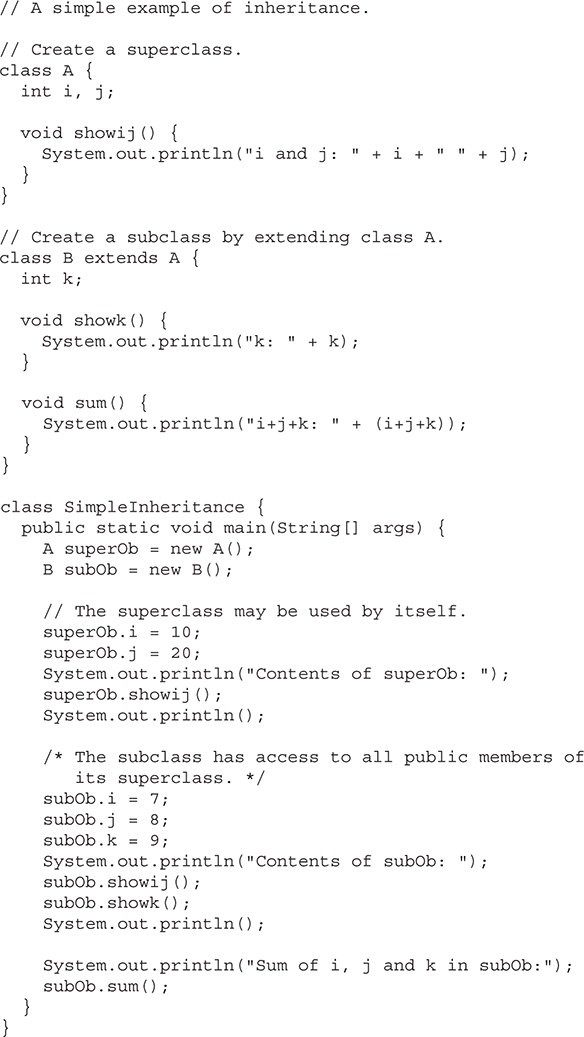
The output from this program is shown here:
Contents of superOb:
i and j: 10 20
Contents of subOb:
i and j: 7 8
k: 9
Sum of i, j and k in subOb:
i+j+k: 24
As you can see, the subclass B includes all of the members of its superclass, A. This is why subOb can access i and j and call showij( ). Also, inside sum( ), i and j can be referred to directly, as if they were part of B.
Even though A is a superclass for B, it is also a completely independent, stand-alone class. Being a superclass for a subclass does not mean that the superclass cannot be used by itself. Further, a subclass can be a superclass for another subclass.
The general form of a class declaration that inherits a superclass is shown here:
class subclass-name extends superclass-name {
// body of class
}
You can only specify one superclass for any subclass that you create. Java does not support the inheritance of multiple superclasses into a single subclass. You can, as stated, create a hierarchy of inheritance in which a subclass becomes a superclass of another subclass. However, no class can be a superclass of itself.
Although a subclass includes all of the members of its superclass, it cannot access those members of the superclass that have been declared as private. For example, consider the following simple class hierarchy:
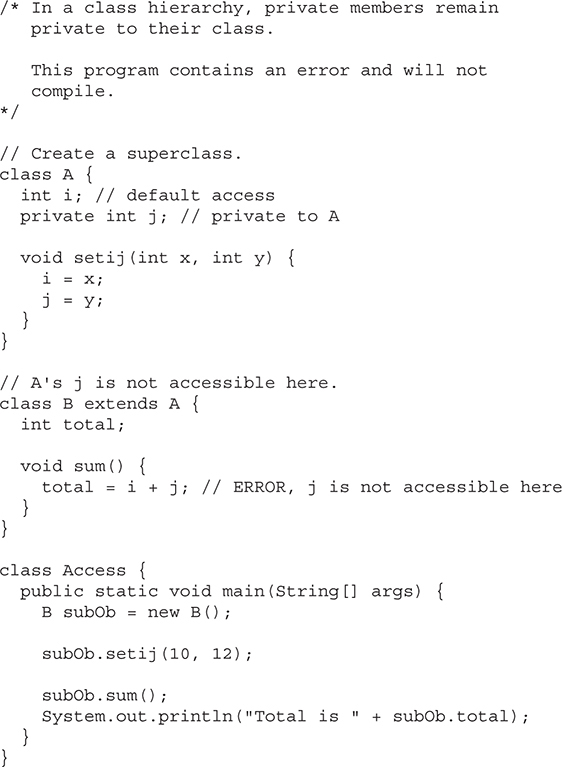
This program will not compile because the use of j inside the sum( ) method of B causes an access violation. Since j is declared as private, it is only accessible by other members of its own class. Subclasses have no access to it.
Remember A class member that has been declared as private will remain private to its class. It is not accessible by any code outside its class, including subclasses.
Let’s look at a more practical example that will help illustrate the power of inheritance. Here, the final version of the Box class developed in the preceding chapter will be extended to include a fourth component called weight. Thus, the new class will contain a box’s width, height, depth, and weight.
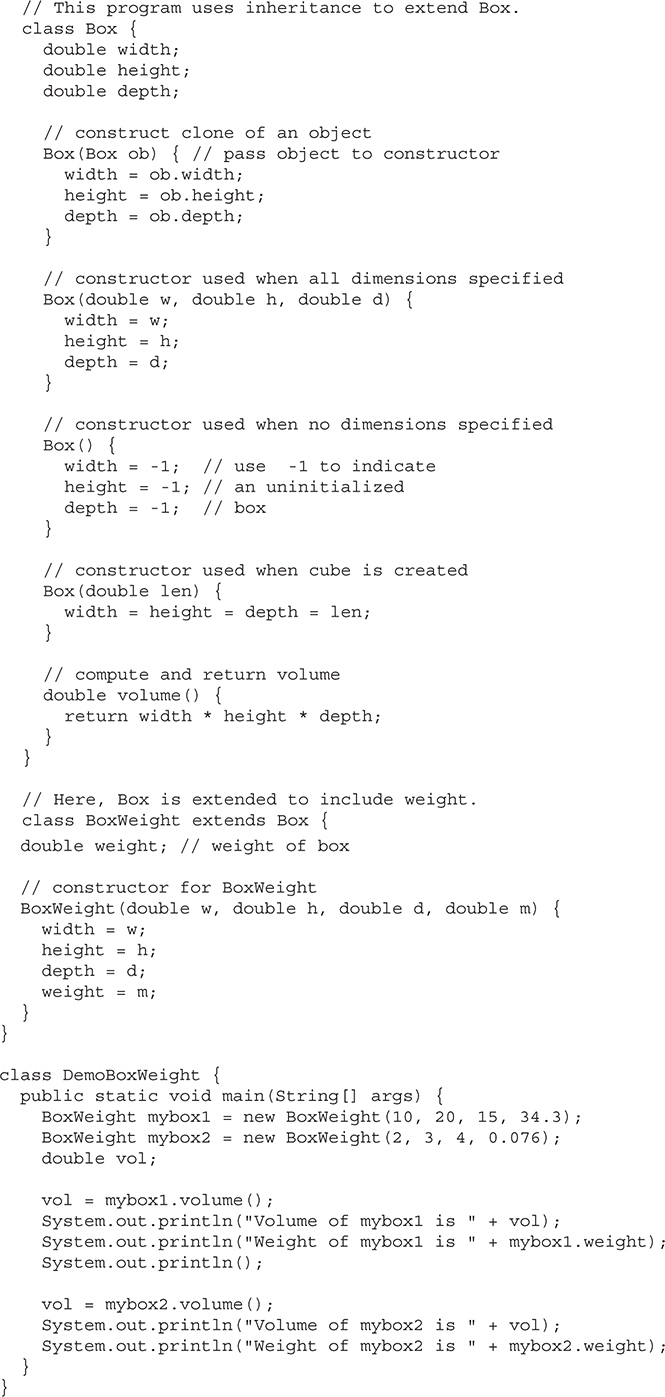
The output from this program is shown here:
Volume of mybox1 is 3000.0
Weight of mybox1 is 34.3
Volume of mybox2 is 24.0
Weight of mybox2 is 0.076
BoxWeight inherits all of the characteristics of Box and adds to them the weight component. It is not necessary for BoxWeight to re-create all of the features found in Box. It can simply extend Box to meet its own purposes.
A major advantage of inheritance is that once you have created a superclass that defines the attributes common to a set of objects, it can be used to create any number of more specific subclasses. Each subclass can precisely tailor its own classification. For example, the following class inherits Box and adds a color attribute:
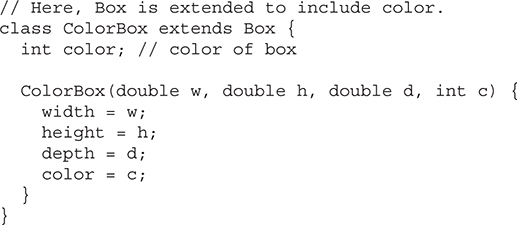
Remember, once you have created a superclass that defines the general aspects of an object, that superclass can be inherited to form specialized classes. Each subclass simply adds its own unique attributes. This is the essence of inheritance.
A reference variable of a superclass can be assigned a reference to any subclass derived from that superclass. You will find this aspect of inheritance quite useful in a variety of situations. For example, consider the following:
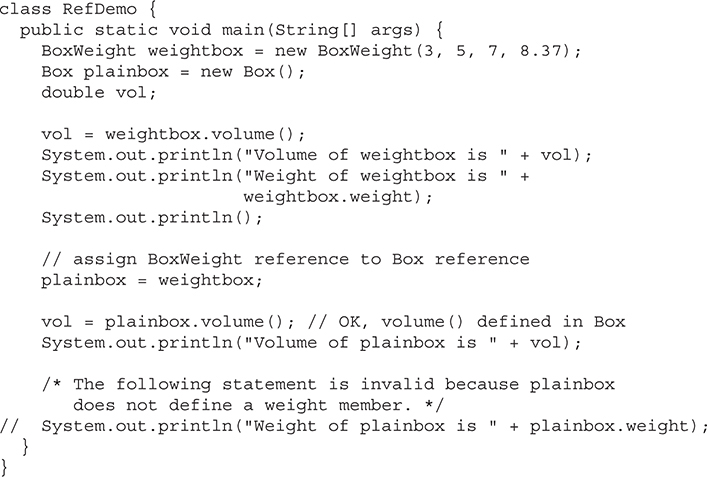
Here, weightbox is a reference to BoxWeight objects, and plainbox is a reference to Box objects. Since BoxWeight is a subclass of Box, it is permissible to assign plainbox a reference to the weightbox object.
It is important to understand that it is the type of the reference variable—not the type of the object that it refers to—that determines what members can be accessed. That is, when a reference to a subclass object is assigned to a superclass reference variable, you will have access only to those parts of the object defined by the superclass. This is why plainbox can’t access weight even when it refers to a BoxWeight object. If you think about it, this makes sense, because the superclass has no knowledge of what a subclass adds to it. This is why the last line of code in the preceding fragment is commented out. It is not possible for a Box reference to access the weight field, because Box does not define one.
Although the preceding may seem a bit esoteric, it has some important practical applications—two of which are discussed later in this chapter.
In the preceding examples, classes derived from Box were not implemented as efficiently or as robustly as they could have been. For example, the constructor for BoxWeight explicitly initializes the width, height, and depth fields of Box. Not only does this duplicate code found in its superclass, which is inefficient, but it implies that a subclass must be granted access to these members. However, there will be times when you will want to create a superclass that keeps the details of its implementation to itself (that is, that keeps its data members private). In this case, there would be no way for a subclass to directly access or initialize these variables on its own. Since encapsulation is a primary attribute of OOP, it is not surprising that Java provides a solution to this problem. Whenever a subclass needs to refer to its immediate superclass, it can do so by use of the keyword super.
super has two general forms. The first calls the superclass’ constructor. The second is used to access a member of the superclass that has been hidden by a member of a subclass. Each use is examined here.
A subclass can call a constructor defined by its superclass by use of the following form of super:
super(arg-list);
Here, arg-list specifies any arguments needed by the constructor in the superclass. super( ) must always be the first statement executed inside a subclass’ constructor.
To see how super( ) is used, consider this improved version of the BoxWeight class:

Here, BoxWeight( ) calls super( ) with the arguments w, h, and d. This causes the Box constructor to be called, which initializes width, height, and depth using these values. BoxWeight no longer initializes these values itself. It only needs to initialize the value unique to it: weight. This leaves Box free to make these values private if desired.
In the preceding example, super( ) was called with three arguments. Since constructors can be overloaded, super( ) can be called using any form defined by the superclass. The constructor executed will be the one that matches the arguments. For example, here is a complete implementation of BoxWeight that provides constructors for the various ways that a box can be constructed. In each case, super( ) is called using the appropriate arguments. Notice that width, height, and depth have been made private within Box.
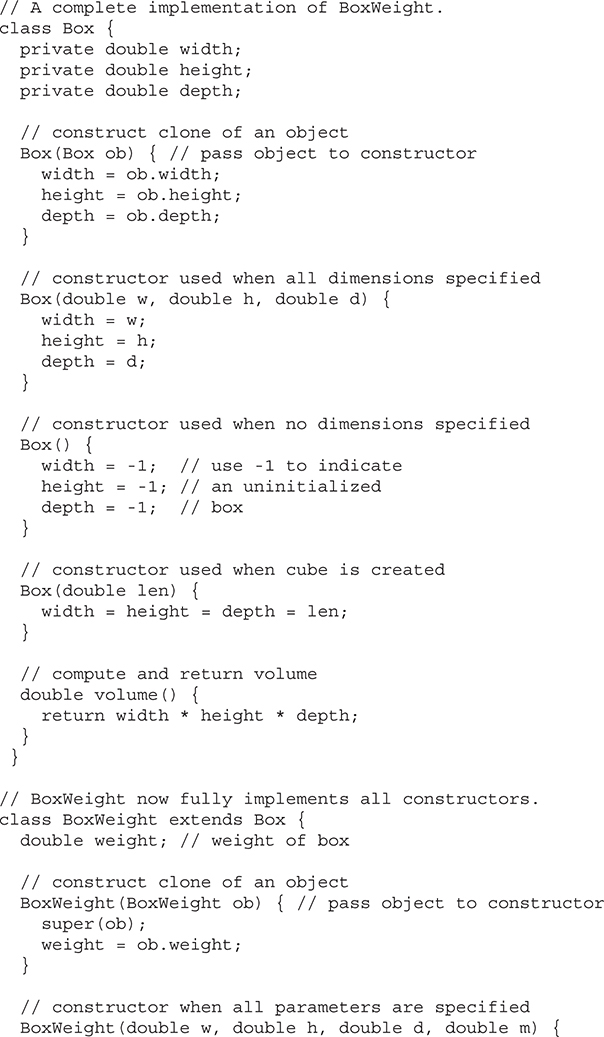
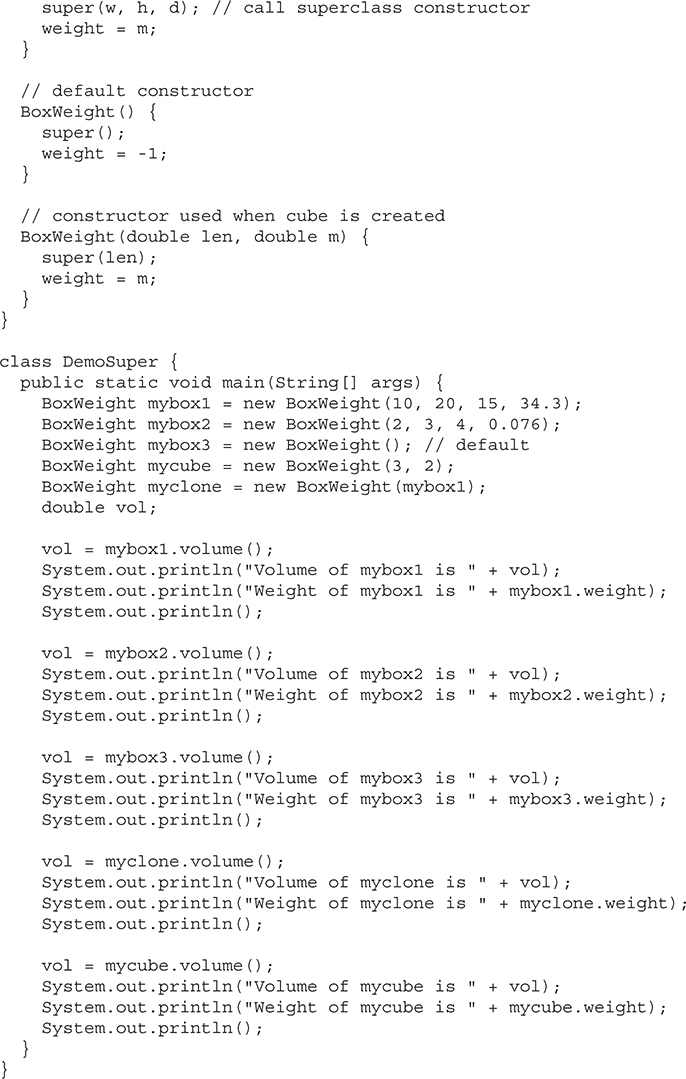
This program generates the following output:
Volume of mybox1 is 3000.0
Weight of mybox1 is 34.3
Volume of mybox2 is 24.0
Weight of mybox2 is 0.076
Volume of mybox3 is -1.0
Weight of mybox3 is -1.0
Volume of myclone is 3000.0
Weight of myclone is 34.3
Volume of mycube is 27.0
Weight of mycube is 2.0
Pay special attention to this constructor in BoxWeight:

Notice that super( ) is passed an object of type BoxWeight—not of type Box. This still invokes the constructor Box(Box ob). As mentioned earlier, a superclass variable can be used to reference any object derived from that class. Thus, we are able to pass a BoxWeight object to the Box constructor. Of course, Box only has knowledge of its own members.
Let’s review the key concepts behind super( ). When a subclass calls super( ), it is calling the constructor of its immediate superclass. Thus, super( ) always refers to the superclass immediately above the calling class. This is true even in a multileveled hierarchy. Also, super( ) must always be the first statement executed inside a subclass constructor.
The second form of super acts somewhat like this, except that it always refers to the superclass of the subclass in which it is used. This usage has the following general form:
super.member
Here, member can be either a method or an instance variable.
This second form of super is most applicable to situations in which member names of a subclass hide members by the same name in the superclass. Consider this simple class hierarchy:
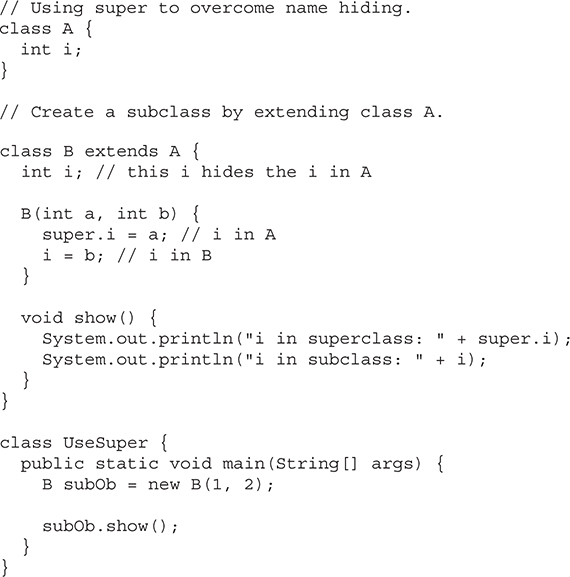
This program displays the following:
i in superclass: 1
i in subclass: 2
Although the instance variable i in B hides the i in A, super allows access to the i defined in the superclass. As you will see, super can also be used to call methods that are hidden by a subclass.
Up to this point, we have been using simple class hierarchies that consist of only a superclass and a subclass. However, you can build hierarchies that contain as many layers of inheritance as you like. As mentioned, it is perfectly acceptable to use a subclass as a superclass of another. For example, given three classes called A, B, and C, C can be a subclass of B, which is a subclass of A. When this type of situation occurs, each subclass inherits all of the traits found in all of its superclasses. In this case, C inherits all aspects of B and A. To see how a multilevel hierarchy can be useful, consider the following program. In it, the subclass BoxWeight is used as a superclass to create the subclass called Shipment. Shipment inherits all of the traits of BoxWeight and Box, and adds a field called cost, which holds the cost of shipping such a parcel.

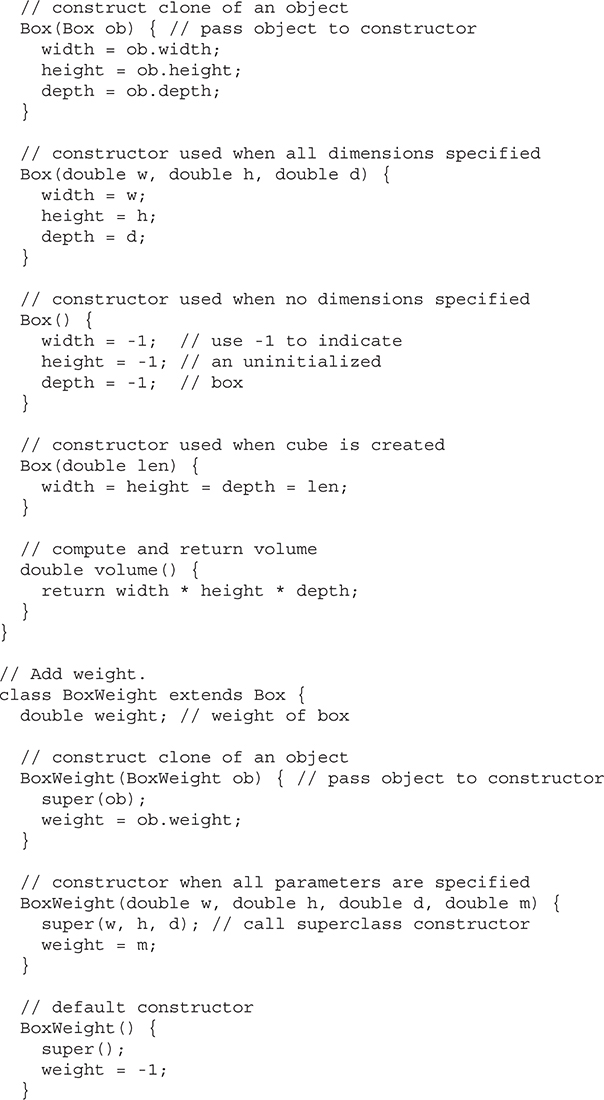
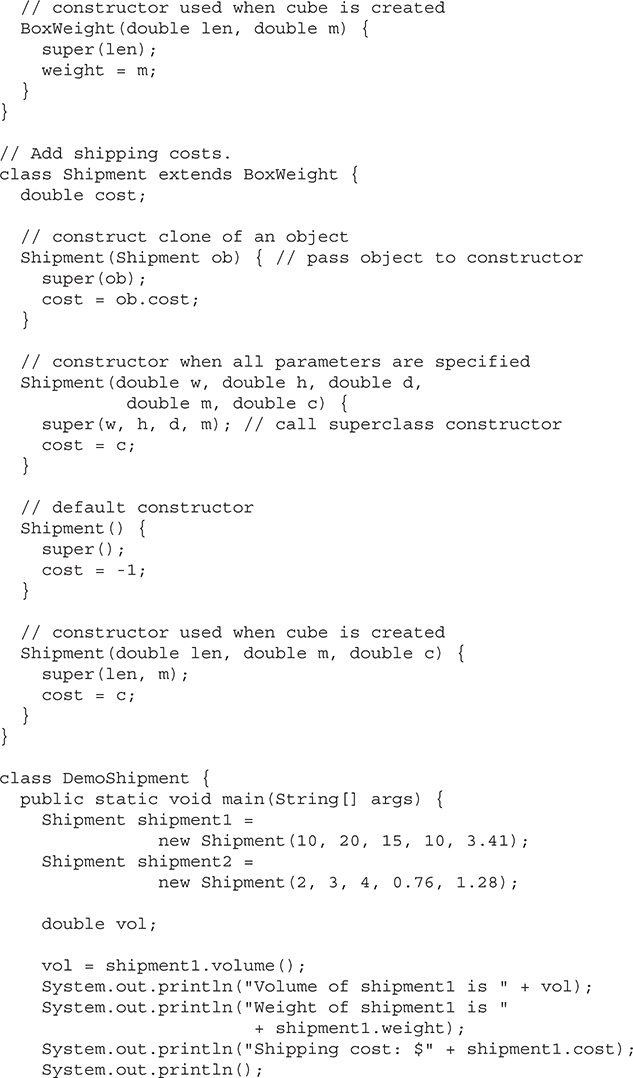

The output of this program is shown here:
Volume of shipment1 is 3000.0
Weight of shipment1 is 10.0
Shipping cost: $3.41
Volume of shipment2 is 24.0
Weight of shipment2 is 0.76
Shipping cost: $1.28
Because of inheritance, Shipment can make use of the previously defined classes of Box and BoxWeight, adding only the extra information it needs for its own, specific application. This is part of the value of inheritance; it allows the reuse of code.
This example illustrates one other important point: super( ) always refers to the constructor in the closest superclass. The super( ) in Shipment calls the constructor in BoxWeight. The super( ) in BoxWeight calls the constructor in Box. In a class hierarchy, if a superclass constructor requires arguments, then all subclasses must pass those arguments “up the line.” This is true whether or not a subclass needs arguments of its own.
Note In the preceding program, the entire class hierarchy, including Box, BoxWeight, and Shipment, is shown all in one file. This is for your convenience only. In Java, all three classes could have been placed into their own files and compiled separately. In fact, using separate files is the norm, not the exception, in creating class hierarchies.
When a class hierarchy is created, in what order are the constructors for the classes that make up the hierarchy executed? For example, given a subclass called B and a superclass called A, is A’s constructor executed before B’s, or vice versa? The answer is that in a class hierarchy, constructors complete their execution in order of derivation, from superclass to subclass. Further, since super( ) must be the first statement executed in a subclass’ constructor, this order is the same whether or not super( ) is used. If super( ) is not used, then the default or parameterless constructor of each superclass will be executed. The following program illustrates when constructors are executed:
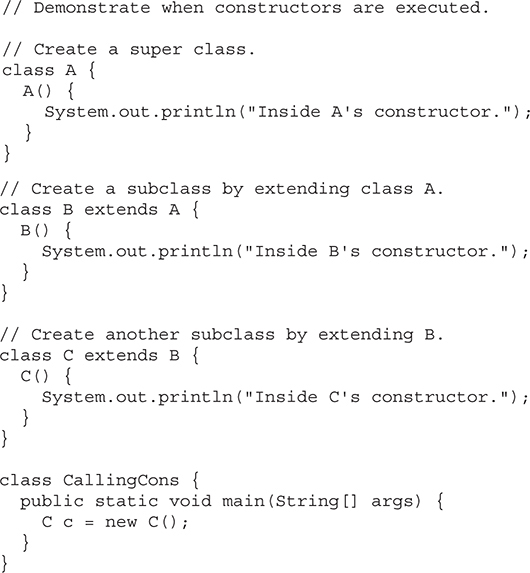
The output from this program is shown here:
Inside A's constructor
Inside B's constructor
Inside C's constructor
As you can see, the constructors are executed in order of derivation.
If you think about it, it makes sense that constructors complete their execution in order of derivation. Because a superclass has no knowledge of any subclass, any initialization it needs to perform is separate from and possibly prerequisite to any initialization performed by the subclass. Therefore, it must complete its execution first.
In a class hierarchy, when a method in a subclass has the same name and type signature as a method in its superclass, then the method in the subclass is said to override the method in the superclass. When an overridden method is called through its subclass, it will always refer to the version of that method defined by the subclass. The version of the method defined by the superclass will be hidden. Consider the following:
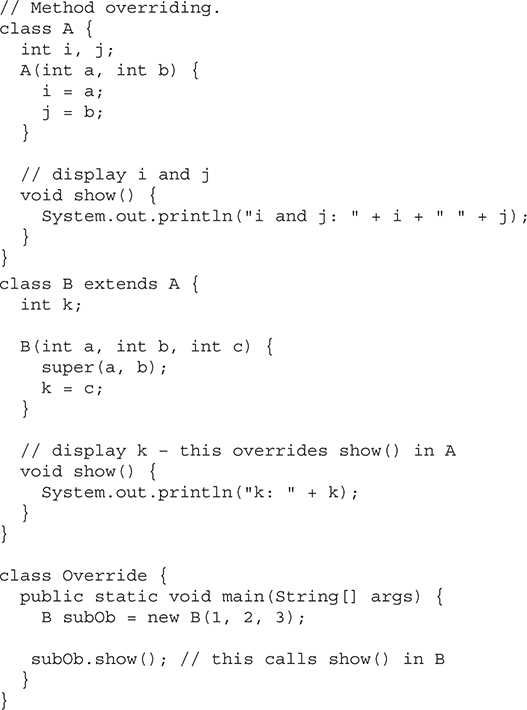
The output produced by this program is shown here:
k: 3
When show( ) is invoked on an object of type B, the version of show( ) defined within B is used. That is, the version of show( ) inside B overrides the version declared in A.
If you wish to access the superclass version of an overridden method, you can do so by using super. For example, in this version of B, the superclass version of show( ) is invoked within the subclass’ version. This allows all instance variables to be displayed.
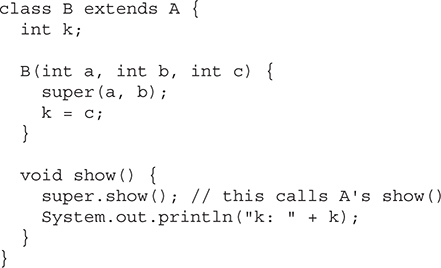
If you substitute this version of A into the previous program, you will see the following output:
i and j: 1 2
k: 3
Here, super.show( ) calls the superclass version of show( ).
Method overriding occurs only when the names and the type signatures of the two methods are identical. If they are not, then the two methods are simply overloaded. For example, consider this modified version of the preceding example:
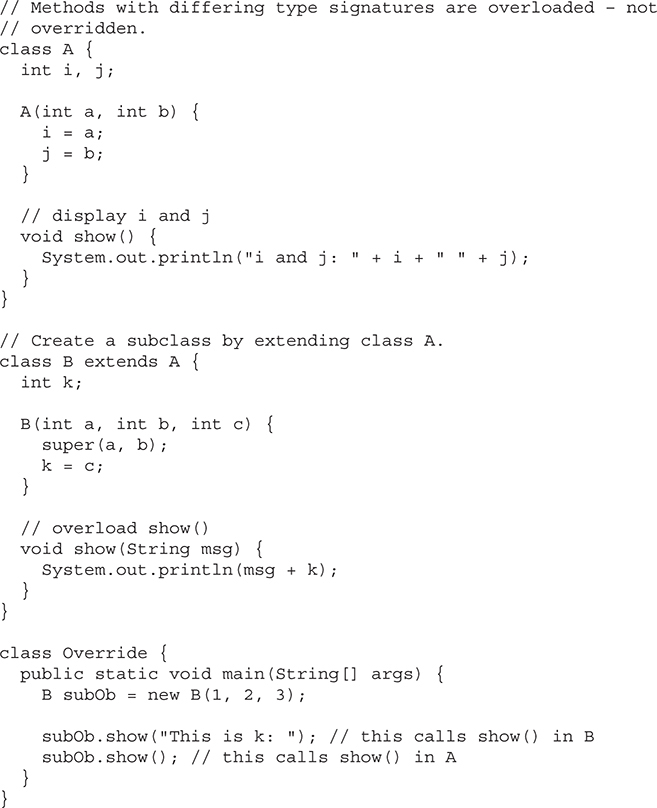
The output produced by this program is shown here:
This is k: 3
i and j: 1 2
The version of show( ) in B takes a string parameter. This makes its type signature different from the one in A, which takes no parameters. Therefore, no overriding (or name hiding) takes place. Instead, the version of show( ) in B simply overloads the version of show( ) in A.
While the examples in the preceding section demonstrate the mechanics of method overriding, they do not show its power. Indeed, if there were nothing more to method overriding than a name space convention, then it would be, at best, an interesting curiosity, but of little real value. However, this is not the case. Method overriding forms the basis for one of Java’s most powerful concepts: dynamic method dispatch. Dynamic method dispatch is the mechanism by which a call to an overridden method is resolved at run time, rather than compile time. Dynamic method dispatch is important because this is how Java implements run-time polymorphism.
Let’s begin by restating an important principle: a superclass reference variable can refer to a subclass object. Java uses this fact to resolve calls to overridden methods at run time. Here is how. When an overridden method is called through a superclass reference, Java determines which version of that method to execute based upon the type of the object being referred to at the time the call occurs. Thus, this determination is made at run time. When different types of objects are referred to, different versions of an overridden method will be called. In other words, it is the type of the object being referred to (not the type of the reference variable) that determines which version of an overridden method will be executed. Therefore, if a superclass contains a method that is overridden by a subclass, then when different types of objects are referred to through a superclass reference variable, different versions of the method are executed.
Here is an example that illustrates dynamic method dispatch:
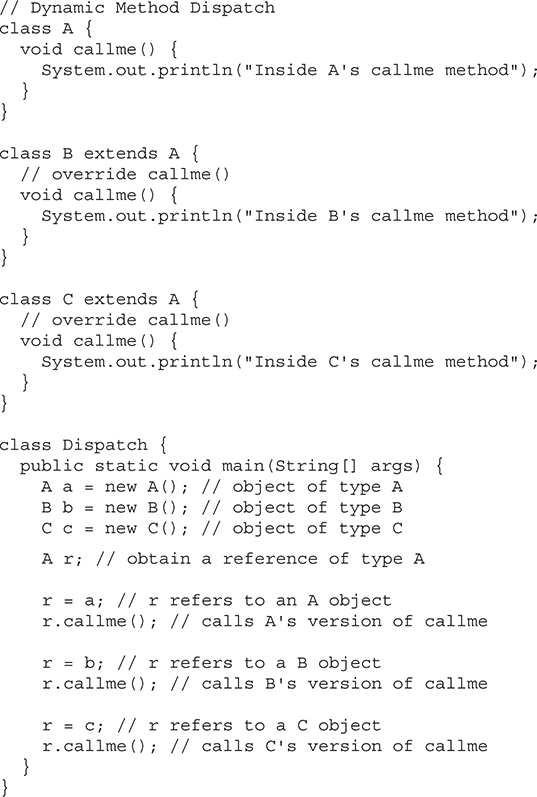
The output from the program is shown here:
Inside A's callme method
Inside B's callme method
Inside C's callme method
This program creates one superclass called A and two subclasses of it, called B and C. Subclasses B and C override callme( ) declared in A. Inside the main( ) method, objects of type A, B, and C are declared. Also, a reference of type A, called r, is declared. The program then in turn assigns a reference to each type of object to r and uses that reference to invoke callme( ). As the output shows, the version of callme( ) executed is determined by the type of object being referred to at the time of the call. Had it been determined by the type of the reference variable, r, you would see three calls to A’s callme( ) method.
Note Readers familiar with C++ or C# will recognize that overridden methods in Java are similar to virtual functions in those languages.
As stated earlier, overridden methods allow Java to support run-time polymorphism. Polymorphism is essential to object-oriented programming for one reason: it allows a general class to specify methods that will be common to all of its derivatives, while allowing subclasses to define the specific implementation of some or all of those methods. Overridden methods are another way that Java implements the “one interface, multiple methods” aspect of polymorphism.
Part of the key to successfully applying polymorphism is understanding that the superclasses and subclasses form a hierarchy which moves from lesser to greater specialization. Used correctly, the superclass provides all elements that a subclass can use directly. It also defines those methods that the derived class must implement on its own. This allows the subclass the flexibility to define its own methods, yet still enforces a consistent interface. Thus, by combining inheritance with overridden methods, a superclass can define the general form of the methods that will be used by all of its subclasses.
Dynamic, run-time polymorphism is one of the most powerful mechanisms that object-oriented design brings to bear on code reuse and robustness. The ability of existing code libraries to call methods on instances of new classes without recompiling while maintaining a clean abstract interface is a profoundly powerful tool.
Let’s look at a more practical example that uses method overriding. The following program creates a superclass called Figure that stores the dimensions of a two-dimensional object. It also defines a method called area( ) that computes the area of an object. The program derives two subclasses from Figure. The first is Rectangle and the second is Triangle. Each of these subclasses overrides area( ) so that it returns the area of a rectangle and a triangle, respectively.
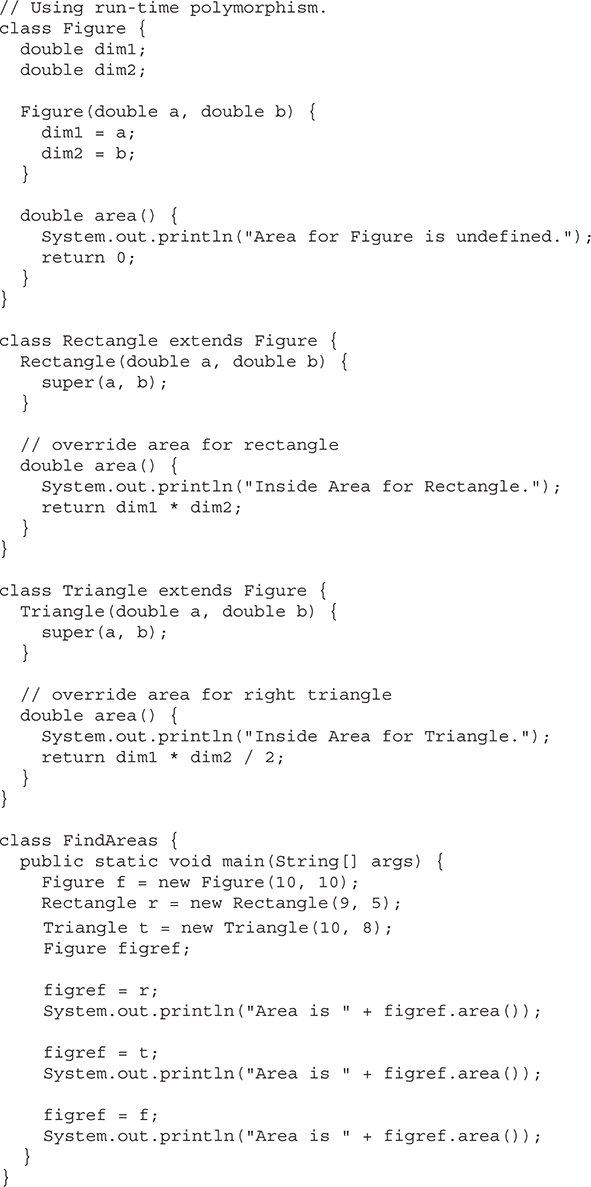
The output from the program is shown here:
Inside Area for Rectangle.
Area is 45
Inside Area for Triangle.
Area is 40
Area for Figure is undefined.
Area is 0
Through the dual mechanisms of inheritance and run-time polymorphism, it is possible to define one consistent interface that is used by several different, yet related, types of objects. In this case, if an object is derived from Figure, then its area can be obtained by calling area( ). The interface to this operation is the same no matter what type of figure is being used.
There are situations in which you will want to define a superclass that declares the structure of a given abstraction without providing a complete implementation of every method. That is, sometimes you will want to create a superclass that only defines a generalized form that will be shared by all of its subclasses, leaving it to each subclass to fill in the details. Such a class determines the nature of the methods that the subclasses must implement. One way this situation can occur is when a superclass is unable to create a meaningful implementation for a method. This is the case with the class Figure used in the preceding example. The definition of area( ) is simply a placeholder. It will not compute and display the area of any type of object.
As you will see as you create your own class libraries, it is not uncommon for a method to have no meaningful definition in the context of its superclass. You can handle this situation two ways. One way, as shown in the previous example, is to simply have it report a warning message. While this approach can be useful in certain situations—such as debugging—it is not usually appropriate. You may have methods that must be overridden by the subclass in order for the subclass to have any meaning. Consider the class Triangle. It has no meaning if area( ) is not defined. In this case, you want some way to ensure that a subclass does, indeed, override all necessary methods. Java’s solution to this problem is the abstract method.
You can require that certain methods be overridden by subclasses by specifying the abstract type modifier. These methods are sometimes referred to as subclasser responsibility because they have no implementation specified in the superclass. Thus, a subclass must override them—it cannot simply use the version defined in the superclass. To declare an abstract method, use this general form:
abstract type name(parameter-list);
As you can see, no method body is present.
Any class that contains one or more abstract methods must also be declared abstract. To declare a class abstract, you simply use the abstract keyword in front of the class keyword at the beginning of the class declaration. There can be no objects of an abstract class. That is, an abstract class cannot be directly instantiated with the new operator. Such objects would be useless, because an abstract class is not fully defined. Also, you cannot declare abstract constructors, or abstract static methods. Any subclass of an abstract class must either implement all of the abstract methods in the superclass, or be declared abstract itself.
Here is a simple example of a class with an abstract method, followed by a class which implements that method:
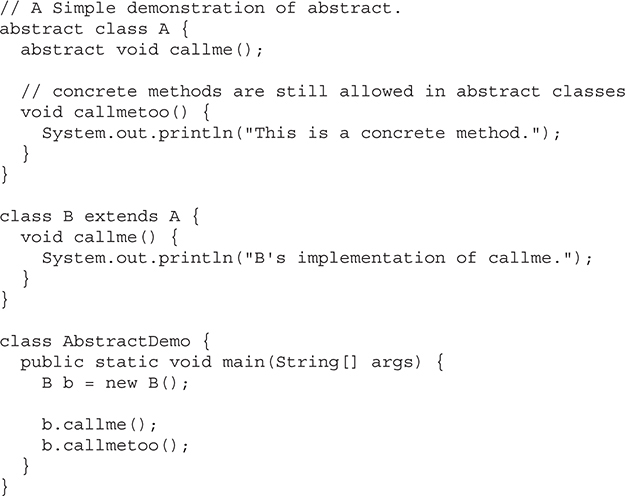
Notice that no objects of class A are declared in the program. As mentioned, it is not possible to instantiate an abstract class. One other point: class A implements a concrete method called callmetoo( ). This is perfectly acceptable. Abstract classes can include as much implementation as they see fit.
Although abstract classes cannot be used to instantiate objects, they can be used to create object references, because Java’s approach to run-time polymorphism is implemented through the use of superclass references. Thus, it must be possible to create a reference to an abstract class so that it can be used to point to a subclass object. You will see this feature put to use in the next example.
Using an abstract class, you can improve the Figure class shown earlier. Since there is no meaningful concept of area for an undefined two-dimensional figure, the following version of the program declares area( ) as abstract inside Figure. This, of course, means that all classes derived from Figure must override area( ).
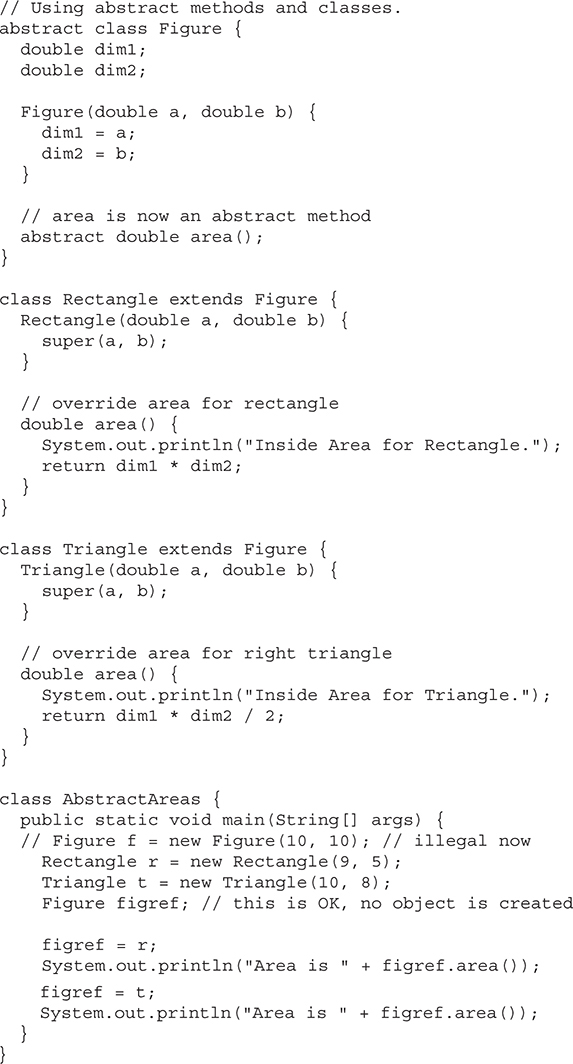
As the comment inside main( ) indicates, it is no longer possible to declare objects of type Figure, since it is now abstract. And, all subclasses of Figure must override area( ). To prove this to yourself, try creating a subclass that does not override area( ). You will receive a compile-time error.
Although it is not possible to create an object of type Figure, you can create a reference variable of type Figure. The variable figref is declared as a reference to Figure, which means that it can be used to refer to an object of any class derived from Figure. As explained, it is through superclass reference variables that overridden methods are resolved at run time.
The keyword final has three uses. First, it can be used to create the equivalent of a named constant. This use was described in the preceding chapter. The other two uses of final apply to inheritance. Both are examined here.
While method overriding is one of Java’s most powerful features, there will be times when you will want to prevent it from occurring. To disallow a method from being overridden, specify final as a modifier at the start of its declaration. Methods declared as final cannot be overridden. The following fragment illustrates final:
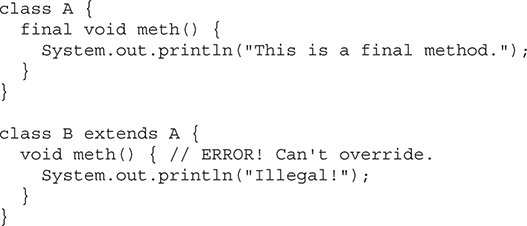
Because meth( ) is declared as final, it cannot be overridden in B. If you attempt to do so, a compile-time error will result.
Methods declared as final can sometimes provide a performance enhancement: The compiler is free to inline calls to them because it “knows” they will not be overridden by a subclass. When a small final method is called, often the Java compiler can copy the bytecode for the subroutine directly inline with the compiled code of the calling method, thus eliminating the costly overhead associated with a method call. Inlining is an option only with final methods. Normally, Java resolves calls to methods dynamically, at run time. This is called late binding. However, since final methods cannot be overridden, a call to one can be resolved at compile time. This is called early binding.
Sometimes you will want to prevent a class from being inherited. To do this, precede the class declaration with final. Declaring a class as final implicitly declares all of its methods as final, too. As you might expect, it is illegal to declare a class as both abstract and final since an abstract class is incomplete by itself and relies upon its subclasses to provide complete implementations.
Here is an example of a final class:
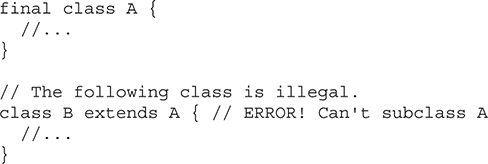
As the comments imply, it is illegal for B to inherit A since A is declared as final.
Note Beginning with JDK 17, the ability to seal a class was added to Java. Sealing offers fine grained control over inheritance. Sealing is described in Chapter 17.
As explained in Chapter 3, JDK 10 added local variable type inference to the Java language, which is supported by the context-sensitive keyword var. It is important to have a clear understanding of how type inference works within an inheritance hierarchy. Recall that a superclass reference can refer to a derived class object, and this feature is part of Java’s support for polymorphism. However, it is critical to remember that, when using local variable type inference, the inferred type of a variable is based on the declared type of its initializer. Therefore, if the initializer is of the superclass type, that will be the inferred type of the variable. It does not matter if the actual object being referred to by the initializer is an instance of a derived class. For example, consider this program:
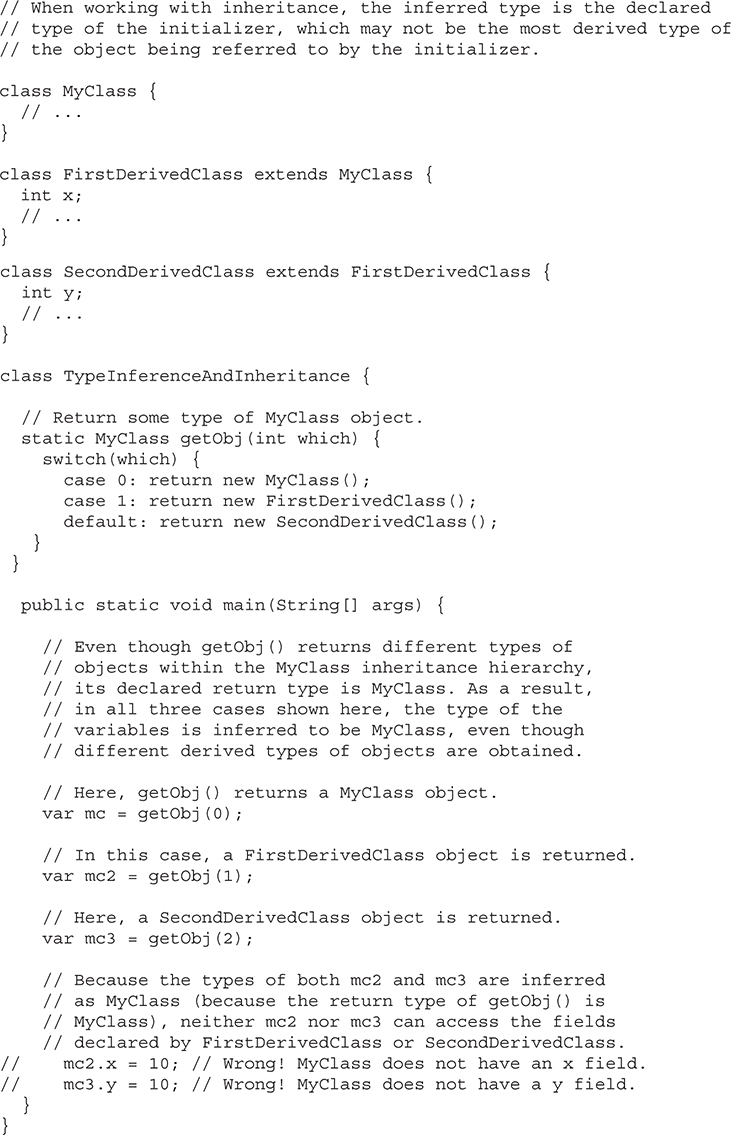
In the program, a hierarchy is created that consists of three classes, at the top of which is MyClass. FirstDerivedClass is a subclass of MyClass, and SecondDerivedClass is a subclass of FirstDerivedClass. The program then uses type inference to create three variables, called mc, mc2, and mc3 by calling getObj( ). The getObj( ) method has a return type of MyClass (the superclass), but returns objects of type MyClass, FirstDerivedClass, or SecondDerivedClass, depending on the argument that it is passed. As the output shows, the inferred type is determined by the return type of getObj( ), not by the actual type of the object obtained. Thus, all three variables will be of type MyClass.
There is one special class, Object, defined by Java. All other classes are subclasses of Object. That is, Object is a superclass of all other classes. This means that a reference variable of type Object can refer to an object of any other class. Also, since arrays are implemented as classes, a variable of type Object can also refer to any array.
Object defines the following methods, which means that they are available in every object.
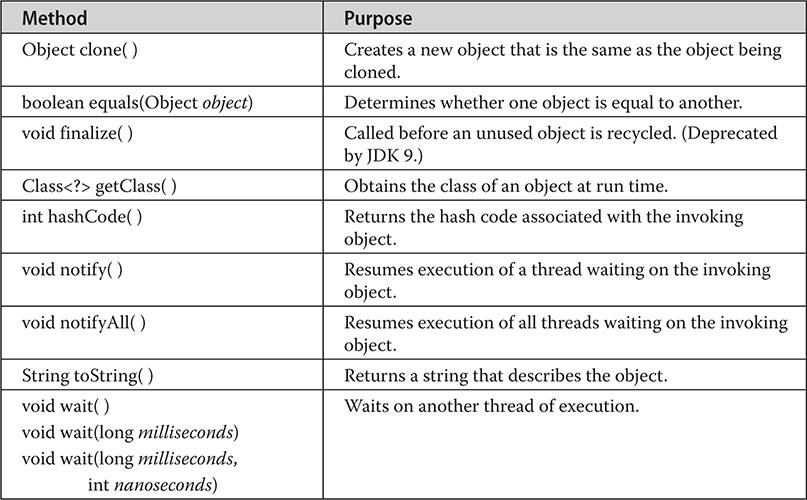
The methods getClass( ), notify( ), notifyAll( ), and wait( ) are declared as final. You may override the others. These methods are described elsewhere in this book. However, notice two methods now: equals( ) and toString( ). The equals( ) method compares two objects. It returns true if the objects are equal, and false otherwise. The precise definition of equality can vary, depending on the type of objects being compared. The toString( ) method returns a string that contains a description of the object on which it is called. Also, this method is automatically called when an object is output using println( ). Many classes override this method. Doing so allows them to tailor a description specifically for the types of objects that they create.
One last point: Notice the unusual syntax in the return type for getClass( ). This relates to Java’s generics feature, which is described in Chapter 14.
This chapter examines two of Java’s most innovative features: packages and interfaces. Packages are containers for classes. They are used to keep the class name space compartmentalized. For example, a package allows you to create a class named List, which you can store in your own package without concern that it will collide with some other class named List stored elsewhere. Packages are stored in a hierarchical manner and are explicitly imported into new class definitions. As you will see in Chapter 16, packages also play an important role with modules.
In previous chapters, you have seen how methods define the interface to the data in a class. Through the use of the interface keyword, Java allows you to fully abstract an interface from its implementation. Using interface, you can specify a set of methods that can be implemented by one or more classes. In its traditional form, the interface, itself, does not actually define any implementation. Although they are similar to abstract classes, interfaces have an additional capability: A class can implement more than one interface. By contrast, a class can only inherit a single superclass (abstract or otherwise).
In the preceding chapters, the name of each example class was taken from the same name space. This means that a unique name had to be used for each class to avoid name collisions. After a while, without some way to manage the name space, you could run out of convenient, descriptive names for individual classes. You also need some way to be assured that the name you choose for a class will be reasonably unique and not collide with class names chosen by other programmers. (Imagine a small group of programmers fighting over who gets to use the name “Foobar” as a class name. Or, imagine the entire Internet community arguing over who first named a class “Espresso.”) Thankfully, Java provides a mechanism for partitioning the class name space into more manageable chunks. This mechanism is the package. The package is both a naming and a visibility control mechanism. You can define classes inside a package that are not accessible by code outside that package. You can also define class members that are exposed only to other members of the same package. This allows your classes to have intimate knowledge of each other, but not expose that knowledge to the rest of the world.
To create a package is quite easy: simply include a package command as the first statement in a Java source file. Any classes declared within that file will belong to the specified package. The package statement defines a name space in which classes are stored. If you omit the package statement, the class names are put into the default package, which has no name. (This is why you haven’t had to worry about packages before now.) While the default package is fine for short, sample programs, it is inadequate for real applications. Most of the time, you will define a package for your code.
This is the general form of the package statement:
package pkg;
Here, pkg is the name of the package. For example, the following statement creates a package called mypackage:
package mypackage;
Typically, Java uses file system directories to store packages, and that is the approach assumed by the examples in this book. For example, the .class files for any classes you declare to be part of mypackage must be stored in a directory called mypackage. Remember that case is significant, and the directory name must match the package name exactly.
More than one file can include the same package statement. The package statement simply specifies to which package the classes defined in a file belong. It does not exclude other classes in other files from being part of that same package. Most real-world packages are spread across many files.
You can create a hierarchy of packages. To do so, simply separate each package name from the one above it by use of a period. The general form of a multileveled package statement is shown here:
package pkg1[.pkg2[.pkg3]];
A package hierarchy must be reflected in the file system of your Java development system. For example, a package declared as
package a.b.c;
needs to be stored in a\b\c in a Windows environment. Be sure to choose your package names carefully. You cannot rename a package without renaming the directory in which the classes are stored.
As just explained, packages are typically mirrored by directories. This raises an important question: How does the Java run-time system know where to look for packages that you create? As it relates to the examples in this chapter, the answer has three parts. First, by default, the Java run-time system uses the current working directory as its starting point. Thus, if your package is in a subdirectory of the current directory, it will be found. Second, you can specify a directory path or paths by setting the CLASSPATH environmental variable. Third, you can use the -classpath option with java and javac to specify the path to your classes. It is useful to point out that, beginning with JDK 9, a package can be part of a module, and thus found on the module path. However, a discussion of modules and module paths is deferred until Chapter 16. For now, we will use only class paths.
For example, consider the following package specification:
package mypack;
In order for a program to find mypack, the program can be executed from a directory immediately above mypack, or the CLASSPATH must be set to include the path to mypack, or the -classpath option must specify the path to mypack when the program is run via java.
When the second two options are used, the class path must not include mypack, itself. It must simply specify the path to mypack. For example, in a Windows environment, if the path to mypack is
C:\MyPrograms\Java\mypack
then the class path to mypack is
C:\MyPrograms\Java
The easiest way to try the examples shown in this book is to simply create the package directories below your current development directory, put the .class files into the appropriate directories, and then execute the programs from the development directory. This is the approach used in the following example.
Keeping the preceding discussion in mind, you can try this simple package:
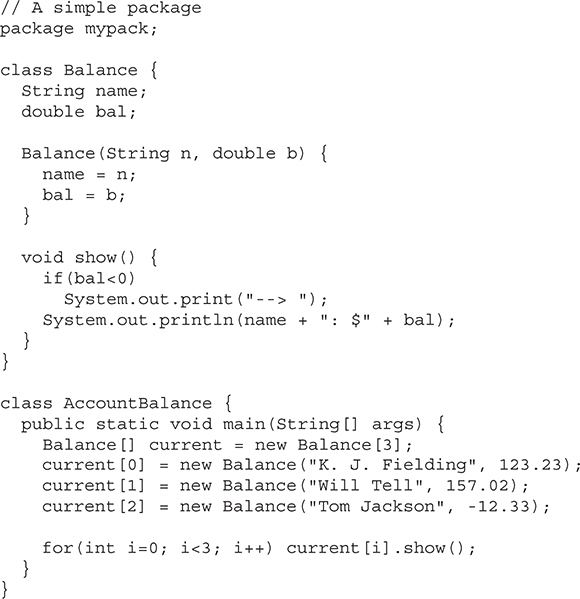
Call this file AccountBalance.java and put it in a directory called mypack.
Next, compile the file. Make sure that the resulting .class file is also in the mypack directory. Then, try executing the AccountBalance class, using the following command line:
java mypack.AccountBalance
Remember, you will need to be in the directory above mypack when you execute this command. (Alternatively, you can use one of the other two options described in the preceding section to specify the path mypack.)
As explained, AccountBalance is now part of the package mypack. This means that it cannot be executed by itself. That is, you cannot use this command line:
java AccountBalance
AccountBalance must be qualified with its package name.
In the preceding chapters, you learned about various aspects of Java’s access control mechanism and its access modifiers. For example, you already know that access to a private member of a class is granted only to other members of that class. Packages add another dimension to access control. As you will see, Java provides many levels of protection to allow fine-grained control over the visibility of variables and methods within classes, subclasses, and packages.
Classes and packages are both means of encapsulating and containing the name space and scope of variables and methods. Packages act as containers for classes and other subordinate packages. Classes act as containers for data and code. The class is Java’s smallest unit of abstraction. As it relates to the interplay between classes and packages, Java addresses four categories of visibility for class members:
• Subclasses in the same package
• Non-subclasses in the same package
• Subclasses in different packages
• Classes that are neither in the same package nor subclasses
The three access modifiers, private, public, and protected, provide a variety of ways to produce the many levels of access required by these categories. Table 9-1 sums up the interactions.

Table 9-1 Class Member Access
While Java’s access control mechanism may seem complicated, we can simplify it as follows. Anything declared public can be accessed from different classes and different packages. Anything declared private cannot be seen outside of its class. When a member does not have an explicit access specification, it is visible to subclasses as well as to other classes in the same package. This is the default access. If you want to allow an element to be seen outside your current package, but only to classes that subclass your class directly, then declare that element protected.
Table 9-1 applies only to members of classes. A non-nested class has only two possible access levels: default and public. When a class is declared as public, it is accessible outside its package. If a class has default access, then it can only be accessed by other code within its same package. When a class is public, it must be the only public class declared in the file, and the file must have the same name as the class.
Note The modules feature can also affect accessibility. Modules are described in Chapter 16.
The following example shows all combinations of the access control modifiers. This example has two packages and five classes. Remember that the classes for the two different packages need to be stored in directories named after their respective packages—in this case, p1 and p2.
The source for the first package defines three classes: Protection, Derived, and SamePackage. The first class defines four int variables in each of the legal protection modes. The variable n is declared with the default protection, n_pri is private, n_pro is protected, and n_pub is public.
Each subsequent class in this example will try to access the variables in an instance of this class. The lines that will not compile due to access restrictions are commented out. Before each of these lines is a comment listing the places from which this level of protection would allow access.
The second class, Derived, is a subclass of Protection in the same package, p1. This grants Derived access to every variable in Protection except for n_pri, the private one. The third class, SamePackage, is not a subclass of Protection, but is in the same package and also has access to all but n_pri.
This is file Protection.java:
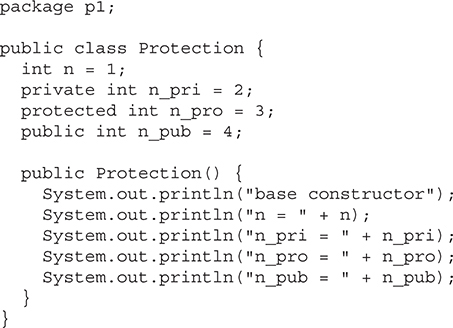
This is file Derived.java:
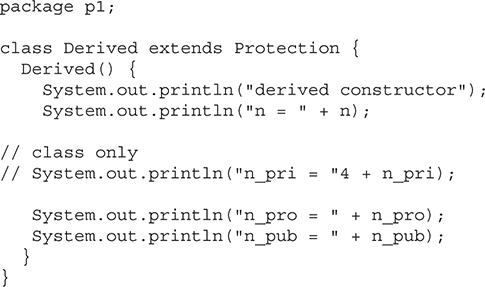
This is file SamePackage.java:
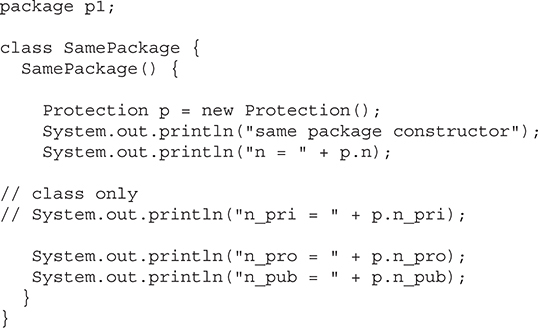
Following is the source code for the other package, p2. The two classes defined in p2 cover the other two conditions that are affected by access control. The first class, Protection2, is a subclass of p1.Protection. This grants access to all of p1.Protection’s variables except for n_pri (because it is private) and n, the variable declared with the default protection. Remember, the default only allows access from within the class or the package, not extra-package subclasses. Finally, the class OtherPackage has access to only one variable, n_pub, which was declared public.
This is file Protection2.java:
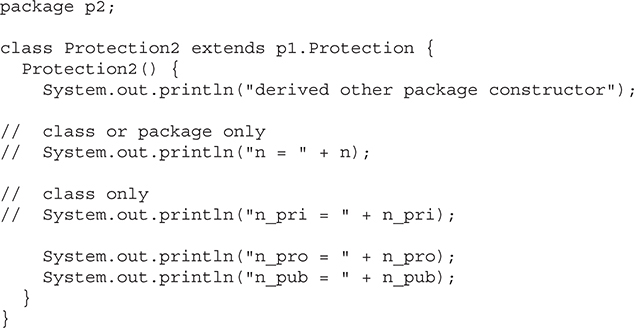
This is file OtherPackage.java:
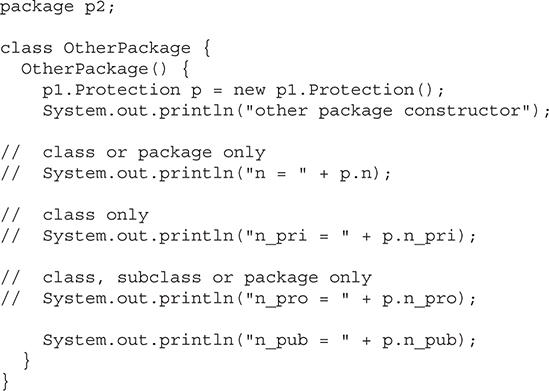
If you want to try these two packages, here are two test files you can use. The one for package p1 is shown here:
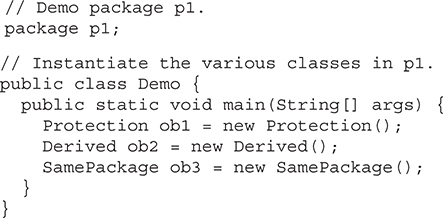
The test file for p2 is shown next:
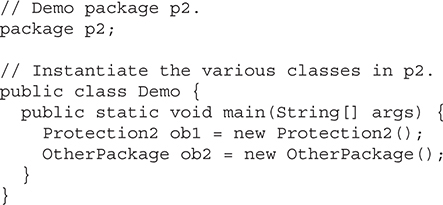
Given that packages exist and are a good mechanism for compartmentalizing diverse classes from each other, it is easy to see why all of the built-in Java classes are stored in packages. There are no core Java classes in the unnamed default package; all of the standard classes are stored in some named package. Since classes within packages must be fully qualified with their package name or names, it could become tedious to type in the long dot-separated package path name for every class you want to use. For this reason, Java includes the import statement to bring certain classes, or entire packages, into visibility. Once imported, a class can be referred to directly, using only its name. The import statement is a convenience to the programmer and is not technically needed to write a complete Java program. If you are going to refer to a few dozen classes in your application, however, the import statement will save a lot of typing.
In a Java source file, import statements occur immediately following the package statement (if it exists) and before any class definitions. This is the general form of the import statement:
import pkg1 [.pkg2].(classname | *);
Here, pkg1 is the name of a top-level package, and pkg2 is the name of a subordinate package inside the outer package separated by a dot (.). There is no practical limit on the depth of a package hierarchy, except that imposed by the file system. Finally, you specify either an explicit classname or a star (*), which indicates that the Java compiler should import the entire package. This code fragment shows both forms in use:
import java.util.Date;
import java.io.*;
All of the standard Java SE classes included with Java begin with the name java. The basic language functions are stored in a package called java.lang. Normally, you have to import every package or class that you want to use, but since Java is useless without much of the functionality in java.lang, it is implicitly imported by the compiler for all programs. This is equivalent to the following line being at the top of all of your programs:
import java.lang.*;
If a class with the same name exists in two different packages that you import using the star form, the compiler will remain silent, unless you try to use one of the classes. In that case, you will get a compile-time error and have to explicitly name the class specifying its package.
It must be emphasized that the import statement is optional. Any place you use a class name, you can use its fully qualified name, which includes its full package hierarchy. For example, this fragment uses an import statement:
import java.util.*;
class MyDate extends Date {
}
The same example without the import statement looks like this:
class MyDate extends java.util.Date {
}
In this version, Date is fully-qualified.
As shown in Table 9-1, when a package is imported, only those items within the package declared as public will be available to non-subclasses in the importing code. For example, if you want the Balance class of the package mypack shown earlier to be available as a stand-alone class for general use outside of mypack, then you will need to declare it as public and put it into its own file, as shown here:
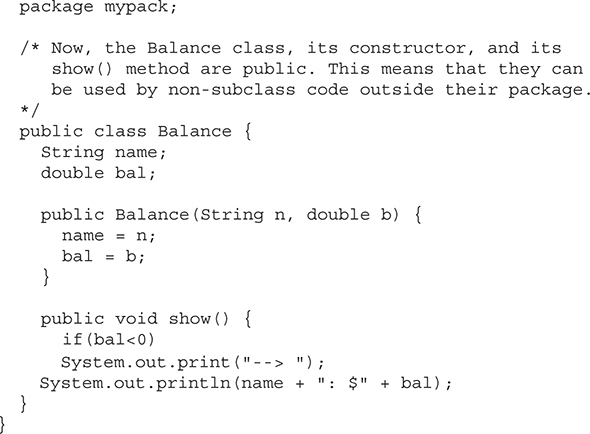
As you can see, the Balance class is now public. Also, its constructor and its show( ) method are public, too. This means that they can be accessed by any type of code outside the mypack package. For example, here TestBalance imports mypack and is then able to make use of the Balance class:
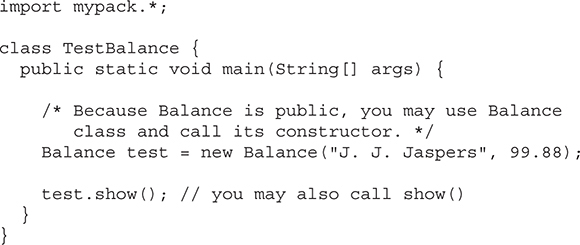
As an experiment, remove the public specifier from the Balance class and then try compiling TestBalance. As explained, errors will result.
Using the keyword interface, you can fully abstract a class’ interface from its implementation. That is, using interface, you can specify what a class must do, but not how it does it. Interfaces are syntactically similar to classes, but they lack instance variables, and, as a general rule, their methods are declared without any body. In practice, this means that you can define interfaces that don’t make assumptions about how they are implemented. Once it is defined, any number of classes can implement an interface. Also, one class can implement any number of interfaces.
To implement an interface, a class must provide the complete set of methods required by the interface. However, each class is free to determine the details of its own implementation. By providing the interface keyword, Java allows you to fully utilize the “one interface, multiple methods” aspect of polymorphism.
Interfaces are designed to support dynamic method resolution at run time. Normally, in order for a method to be called from one class to another, both classes need to be present at compile time so the Java compiler can check to ensure that the method signatures are compatible. This requirement by itself makes for a static and nonextensible classing environment. Inevitably in a system like this, functionality gets pushed up higher and higher in the class hierarchy so that the mechanisms will be available to more and more subclasses. Interfaces are designed to avoid this problem. They disconnect the definition of a method or set of methods from the inheritance hierarchy. Since interfaces are in a different hierarchy from classes, it is possible for classes that are unrelated in terms of the class hierarchy to implement the same interface. This is where the real power of interfaces is realized.
An interface is defined much like a class. This is a simplified general form of an interface:
access interface name {
return-type method-name1(parameter-list);
return-type method-name2(parameter-list);
type final-varname1 = value;
type final-varname2 = value;
//...
return-type method-nameN(parameter-list);
type final-varnameN = value;
}
When no access modifier is included, then default access results, and the interface is only available to other members of the package in which it is declared. When it is declared as public, the interface can be used by code outside its package. In this case, the interface must be the only public interface declared in the file, and the file must have the same name as the interface. name is the name of the interface, and can be any valid identifier. Notice that the methods that are declared have no bodies. They end with a semicolon after the parameter list. They are, essentially, abstract methods. Each class that includes such an interface must implement all of the methods.
Before continuing an important point needs to be made. JDK 8 added a feature to interface that made a significant change to its capabilities. Prior to JDK 8, an interface could not define any implementation whatsoever. This is the type of interface that the preceding simplified form shows, in which no method declaration supplies a body. Thus, prior to JDK 8, an interface could define only “what,” but not “how.” JDK 8 changed this. Beginning with JDK 8, it is possible to add a default implementation to an interface method. Furthermore, JDK 8 also added static interface methods, and beginning with JDK 9, an interface can include private methods. Thus, it is now possible for interface to specify some behavior. However, such methods constitute what are, in essence, special-use features, and the original intent behind interface still remains. Therefore, as a general rule, you will still often create and use interfaces in which no use is made of these new features. For this reason, we will begin by discussing the interface in its traditional form. The newer interface features are described at the end of this chapter.
As the general form shows, variables can be declared inside interface declarations. They are implicitly final and static, meaning they cannot be changed by the implementing class. They must also be initialized. All methods and variables are implicitly public.
Here is an example of an interface definition. It declares a simple interface that contains one method called callback( ) that takes a single integer parameter.

Once an interface has been defined, one or more classes can implement that interface. To implement an interface, include the implements clause in a class definition, and then create the methods required by the interface. The general form of a class that includes the implements clause looks like this:
class classname [extends superclass] [implements interface [,interface...]] {
// class-body
}
If a class implements more than one interface, the interfaces are separated with a comma. If a class implements two interfaces that declare the same method, then the same method will be used by clients of either interface. The methods that implement an interface must be declared public. Also, the type signature of the implementing method must match exactly the type signature specified in the interface definition.
Here is a small example class that implements the Callback interface shown earlier:

Notice that callback( ) is declared using the public access modifier.
Remember When you implement an interface method, it must be declared as public.
It is both permissible and common for classes that implement interfaces to define additional members of their own. For example, the following version of Client implements callback( ) and adds the method nonIfaceMeth( ):
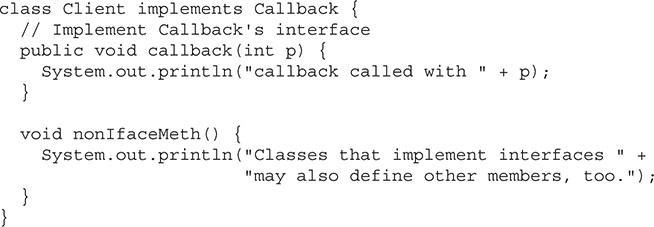
You can declare variables as object references that use an interface rather than a class type. Any instance of any class that implements the declared interface can be referred to by such a variable. When you call a method through one of these references, the correct version will be called based on the actual instance of the interface being referred to. This is one of the key features of interfaces. The method to be executed is looked up dynamically at run time, allowing classes to be created later than the code which calls methods on them. The calling code can dispatch through an interface without having to know anything about the “callee.” This process is similar to using a superclass reference to access a subclass object, as described in Chapter 8.
The following example calls the callback( ) method via an interface reference variable:

The output of this program is shown here:
callback called with 42
Notice that variable c is declared to be of the interface type Callback, yet it was assigned an instance of Client. Although c can be used to access the callback( ) method, it cannot access any other members of the Client class. An interface reference variable has knowledge only of the methods declared by its interface declaration. Thus, c could not be used to access nonIfaceMeth( ) since it is defined by Client but not Callback.
While the preceding example shows, mechanically, how an interface reference variable can access an implementation object, it does not demonstrate the polymorphic power of such a reference. To sample this usage, first create the second implementation of Callback, shown here:

Now, try the following class:
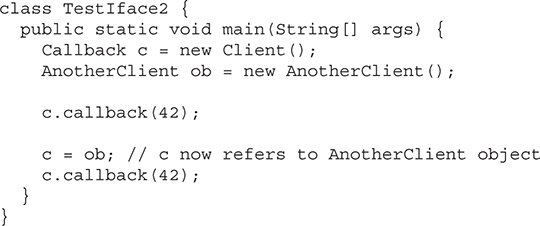
The output from this program is shown here:
callback called with 42
Another version of callback
p squared is 1764
As you can see, the version of callback( ) that is called is determined by the type of object that c refers to at run time. While this is a very simple example, you will see another, more practical one shortly.
If a class includes an interface but does not fully implement the methods required by that interface, then that class must be declared as abstract. For example:

Here, the class Incomplete does not implement callback( ) and must be declared as abstract. Any class that inherits Incomplete must implement callback( ) or be declared abstract itself.
An interface can be declared a member of a class or another interface. Such an interface is called a member interface or a nested interface. A nested interface can be declared as public, private, or protected. This differs from a top-level interface, which must either be declared as public or use the default access level, as previously described. When a nested interface is used outside of its enclosing scope, it must be qualified by the name of the class or interface of which it is a member. Thus, outside of the class or interface in which a nested interface is declared, its name must be fully qualified.
Here is an example that demonstrates a nested interface:
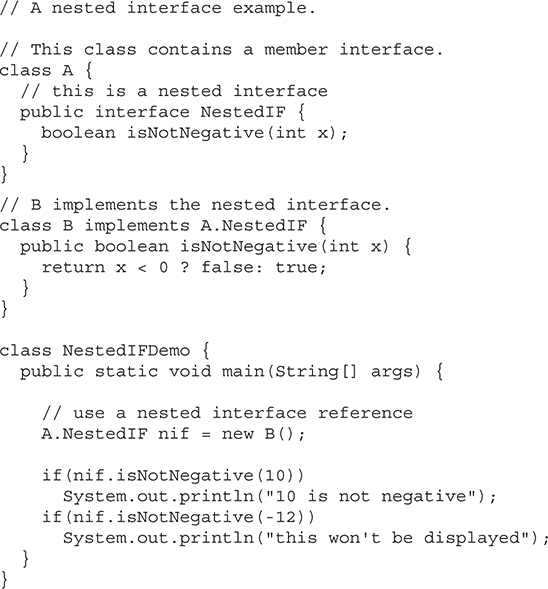
Notice that A defines a member interface called NestedIF and that it is declared public. Next, B implements the nested interface by specifying
implements A.NestedIF
Notice that the name is fully qualified by the enclosing class’ name. Inside the main( ) method, an A.NestedIF reference called nif is created, and it is assigned a reference to a B object. Because B implements A.NestedIF, this is legal.
To understand the power of interfaces, let’s look at a more practical example. In earlier chapters, you developed a class called Stack that implemented a simple fixed-size stack. However, there are many ways to implement a stack. For example, the stack can be of a fixed size or it can be “growable.” The stack can also be held in an array, a linked list, a binary tree, and so on. No matter how the stack is implemented, the interface to the stack remains the same. That is, the methods push( ) and pop( ) define the interface to the stack independently of the details of the implementation. Because the interface to a stack is separate from its implementation, it is easy to define a stack interface, leaving it to each implementation to define the specifics. Let’s look at two examples.
First, here is the interface that defines an integer stack. Put this in a file called IntStack.java. This interface will be used by both stack implementations.

The following program creates a class called FixedStack that implements a fixed-length version of an integer stack:
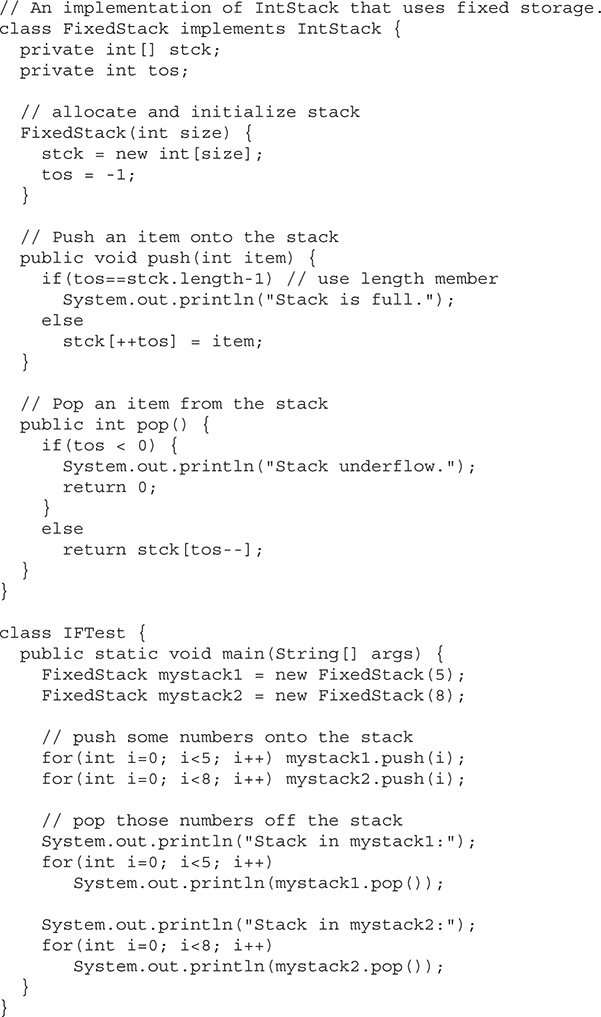
Following is another implementation of IntStack that creates a dynamic stack by use of the same interface definition. In this implementation, each stack is constructed with an initial length. If this initial length is exceeded, then the stack is increased in size. Each time more room is needed, the size of the stack is doubled.
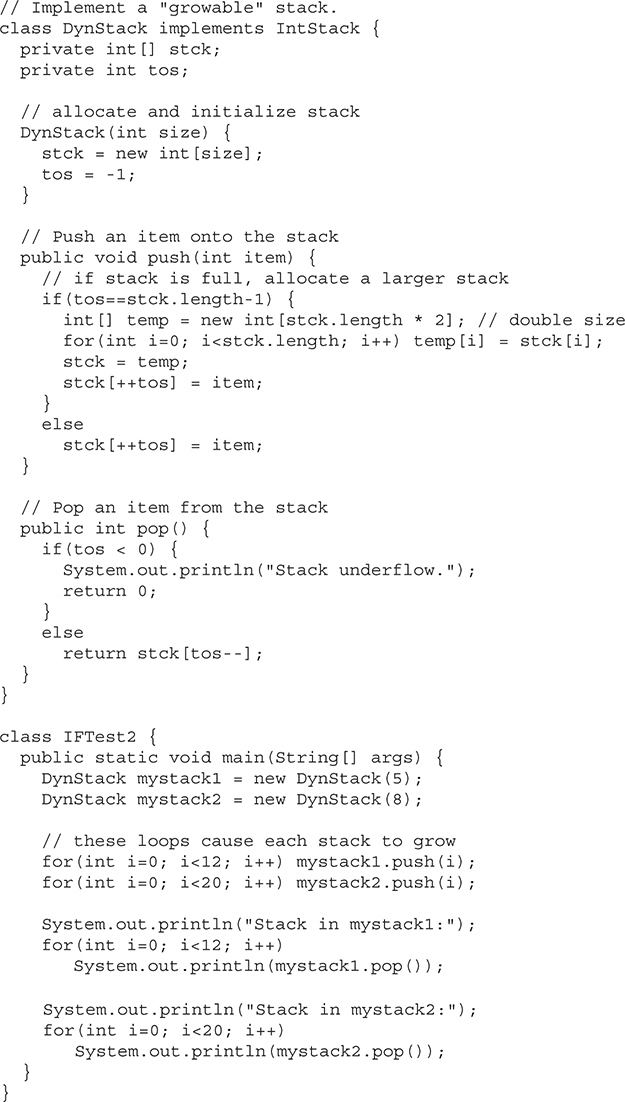
The following class uses both the FixedStack and DynStack implementations. It does so through an interface reference. This means that calls to push( ) and pop( ) are resolved at run time rather than at compile time.
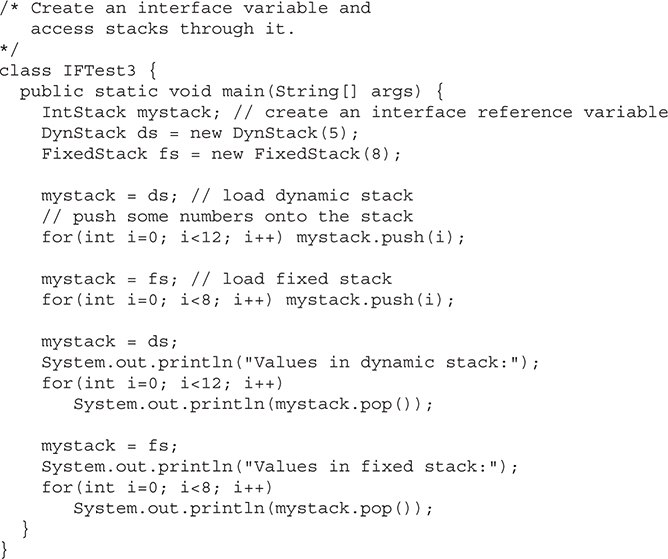
In this program, mystack is a reference to the IntStack interface. Thus, when it refers to ds, it uses the versions of push( ) and pop( ) defined by the DynStack implementation. When it refers to fs, it uses the versions of push( ) and pop( ) defined by FixedStack. As explained, these determinations are made at run time. Accessing multiple implementations of an interface through an interface reference variable is the most powerful way that Java achieves run-time polymorphism.
You can use interfaces to import shared constants into multiple classes by simply declaring an interface that contains variables that are initialized to the desired values. When you include that interface in a class (that is, when you “implement” the interface), all of those variable names will be in scope as constants. If an interface contains no methods, then any class that includes such an interface doesn’t actually implement anything. It is as if that class were importing the constant fields into the class name space as final variables. The next example uses this technique to implement an automated “decision maker”:
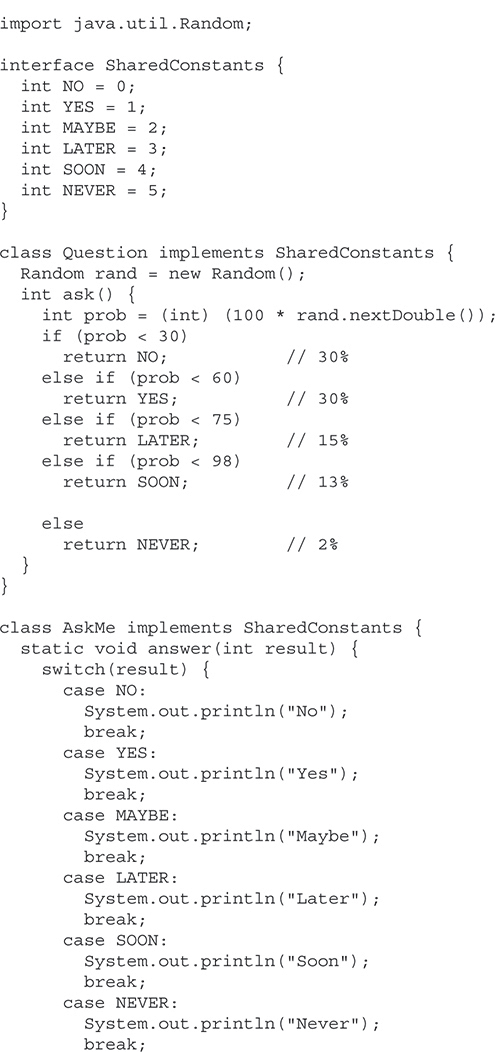
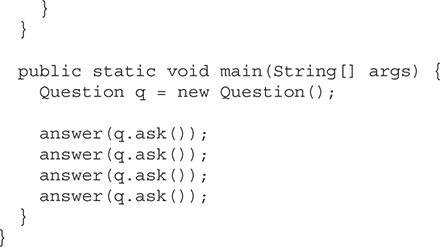
Notice that this program makes use of one of Java’s standard classes: Random. This class provides pseudorandom numbers. It contains several methods that allow you to obtain random numbers in the form required by your program. In this example, the method nextDouble( ) is used. It returns random numbers in the range 0.0 to 1.0.
In this sample program, the two classes, Question and AskMe, both implement the SharedConstants interface where NO, YES, MAYBE, SOON, LATER, and NEVER are defined. Inside each class, the code refers to these constants as if each class had defined or inherited them directly. Here is the output of a sample run of this program. Note that the results are different each time it is run.
Later
Soon
No
Yes
Note The technique of using an interface to define shared constants, as just described, is controversial. It is described here for completeness.
One interface can inherit another by use of the keyword extends. The syntax is the same as for inheriting classes. When a class implements an interface that inherits another interface, it must provide implementations for all methods required by the interface inheritance chain. Following is an example:
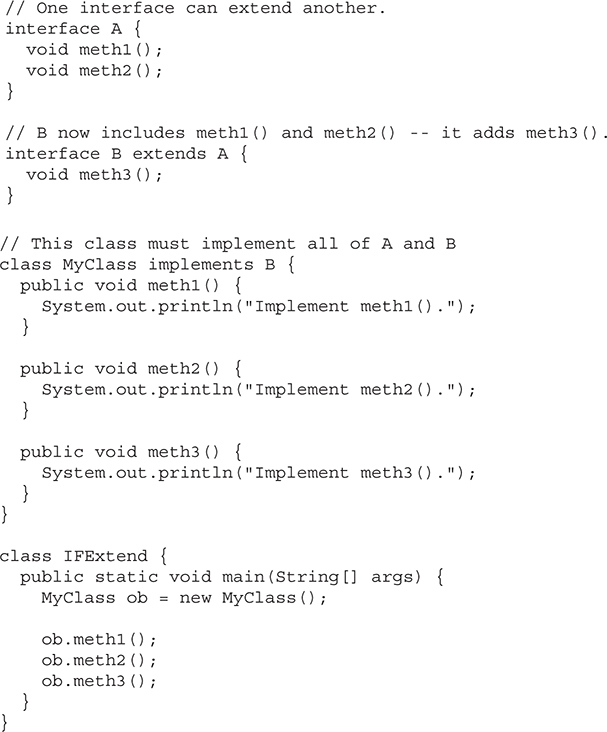
As an experiment, you might want to try removing the implementation for meth1( ) in MyClass. This will cause a compile-time error. As stated earlier, any class that implements an interface must implement all methods required by that interface, including any that are inherited from other interfaces.
As explained earlier, prior to JDK 8, an interface could not define any implementation whatsoever. This meant that for all previous versions of Java, the methods specified by an interface were abstract, containing no body. This is the traditional form of an interface and is the type of interface that the preceding discussions have used. The release of JDK 8 changed this by adding a new capability to interface called the default method. A default method lets you define a default implementation for an interface method. In other words, by use of a default method, it is possible for an interface method to provide a body, rather than being abstract. During its development, the default method was also referred to as an extension method, and you will likely see both terms used.
A primary motivation for the default method was to provide a means by which interfaces could be expanded without breaking existing code. Recall that there must be implementations for all methods defined by an interface. In the past, if a new method were added to a popular, widely used interface, then the addition of that method would break existing code because no implementation would be found for that new method. The default method solves this problem by supplying an implementation that will be used if no other implementation is explicitly provided. Thus, the addition of a default method will not cause preexisting code to break.
Another motivation for the default method was the desire to specify methods in an interface that are, essentially, optional, depending on how the interface is used. For example, an interface might define a group of methods that act on a sequence of elements. One of these methods might be called remove( ), and its purpose is to remove an element from the sequence. However, if the interface is intended to support both modifiable and nonmodifiable sequences, then remove( ) is essentially optional because it won’t be used by nonmodifiable sequences. In the past, a class that implemented a nonmodifiable sequence would have had to define an empty implementation of remove( ), even though it was not needed. Today, a default implementation for remove( ) can be specified in the interface that does nothing (or throws an exception). Providing this default prevents a class used for nonmodifiable sequences from having to define its own, placeholder version of remove( ). Thus, by providing a default, the interface makes the implementation of remove( ) by a class optional.
It is important to point out that the addition of default methods does not change a key aspect of interface: its inability to maintain state information. An interface still cannot have instance variables, for example. Thus, the defining difference between an interface and a class is that a class can maintain state information, but an interface cannot. Furthermore, it is still not possible to create an instance of an interface by itself. It must be implemented by a class. Therefore, even though, beginning with JDK 8, an interface can define default methods, the interface must still be implemented by a class if an instance is to be created.
One last point: As a general rule, default methods constitute a special-purpose feature. Interfaces that you create will still be used primarily to specify what and not how. However, the inclusion of the default method gives you added flexibility.
An interface default method is defined similar to the way a method is defined by a class. The primary difference is that the declaration is preceded by the keyword default. For example, consider this simple interface:
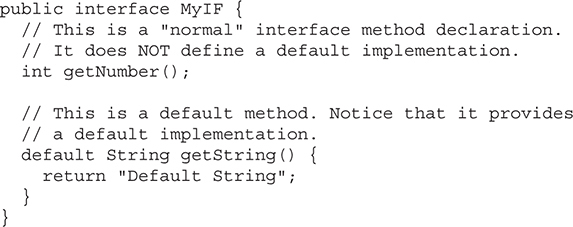
MyIF declares two methods. The first, getNumber( ), is a standard interface method declaration. It defines no implementation whatsoever. The second method is getString( ), and it does include a default implementation. In this case, it simply returns the string "Default String". Pay special attention to the way getString( ) is declared. Its declaration is preceded by the default modifier. This syntax can be generalized. To define a default method, precede its declaration with default.
Because getString( ) includes a default implementation, it is not necessary for an implementing class to override it. In other words, if an implementing class does not provide its own implementation, the default is used. For example, the MyIFImp class shown next is perfectly valid:

The following code creates an instance of MyIFImp and uses it to call both getNumber( ) and getString( ).
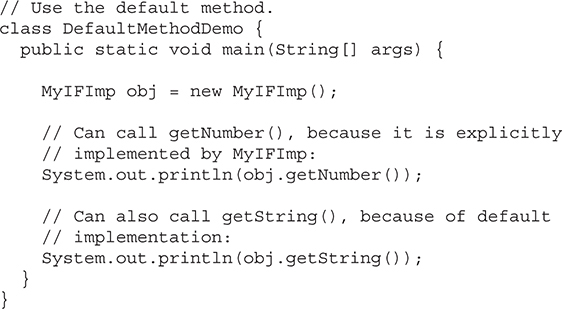
The output is shown here:
100
Default String
As you can see, the default implementation of getString( ) was automatically used. It was not necessary for MyIFImp to define it. Thus, for getString( ), implementation by a class is optional. (Of course, its implementation by a class will be required if the class uses getString( ) for some purpose beyond that supported by its default.)
It is both possible and common for an implementing class to define its own implementation of a default method. For example, MyIFImp2 overrides getString( ):

Now, when getString( ) is called, a different string is returned.
Although the preceding shows the mechanics of using default methods, it doesn’t illustrate their usefulness in a more practical setting. To do this, let’s once again return to the IntStack interface shown earlier in this chapter. For the sake of discussion, assume that IntStack is widely used and many programs rely on it. Further assume that we now want to add a method to IntStack that clears the stack, enabling the stack to be re-used. Thus, we want to evolve the IntStack interface so that it defines new functionality, but we don’t want to break any preexisting code. In the past, this would be impossible, but with the inclusion of default methods, it is now easy to do. For example, the IntStack interface can be enhanced like this:

Here, the default behavior of clear( ) simply displays a message indicating that it is not implemented. This is acceptable because no preexisting class that implements IntStack would ever call clear( ) because it was not defined by the earlier version of IntStack. However, clear( ) can be implemented by a new class that implements IntStack. Furthermore, clear( ) needs to be defined by a new implementation only if it is used. Thus, the default method gives you
• a way to gracefully evolve interfaces over time, and
• a way to provide optional functionality without requiring that a class provide a placeholder implementation when that functionality is not needed.
One other point: In real-world code, clear( ) would have thrown an exception, rather than displaying an error message. Exceptions are described in the next chapter. After working through that material, you might want to try modifying clear( ) so that its default implementation throws an UnsupportedOperationException.
As explained earlier in this book, Java does not support the multiple inheritance of classes. Now that an interface can include default methods, you might be wondering if an interface can provide a way around this restriction. The answer is, essentially, no. Recall that there is still a key difference between a class and an interface: a class can maintain state information (especially through the use of instance variables), but an interface cannot.
The preceding notwithstanding, default methods do offer a bit of what one would normally associate with the concept of multiple inheritance. For example, you might have a class that implements two interfaces. If each of these interfaces provides default methods, then some behavior is inherited from both. Thus, to a limited extent, default methods do support multiple inheritance of behavior. As you might guess, in such a situation, it is possible that a name conflict will occur.
For example, assume that two interfaces called Alpha and Beta are implemented by a class called MyClass. What happens if both Alpha and Beta provide a method called reset( ) for which both declare a default implementation? Is the version by Alpha or the version by Beta used by MyClass? Or, consider a situation in which Beta extends Alpha. Which version of the default method is used? Or, what if MyClass provides its own implementation of the method? To handle these and other similar types of situations, Java defines a set of rules that resolves such conflicts.
First, in all cases, a class implementation takes priority over an interface default implementation. Thus, if MyClass provides an override of the reset( ) default method, MyClass’ version is used. This is the case even if MyClass implements both Alpha and Beta. In this case, both defaults are overridden by MyClass’ implementation.
Second, in cases in which a class implements two interfaces that both have the same default method, but the class does not override that method, then an error will result. Continuing with the example, if MyClass implements both Alpha and Beta, but does not override reset( ), then an error will occur.
In cases in which one interface inherits another, with both defining a common default method, the inheriting interface’s version of the method takes precedence. Therefore, continuing the example, if Beta extends Alpha, then Beta’s version of reset( ) will be used.
It is possible to explicitly refer to a default implementation in an inherited interface by using this form of super. Its general form is shown here:
InterfaceName.super.methodName( )
For example, if Beta wants to refer to Alpha’s default for reset( ), it can use this statement:
Alpha.super.reset();
Another capability added to interface by JDK 8 is the ability to define one or more static methods. Like static methods in a class, a static method defined by an interface can be called independently of any object. Thus, no implementation of the interface is necessary, and no instance of the interface is required, in order to call a static method. Instead, a static method is called by specifying the interface name, followed by a period, followed by the method name. Here is the general form:
InterfaceName.staticMethodName
Notice that this is similar to the way that a static method in a class is called.
The following shows an example of a static method in an interface by adding one to MyIF, shown in the previous section. The static method is getDefaultNumber( ). It returns zero.
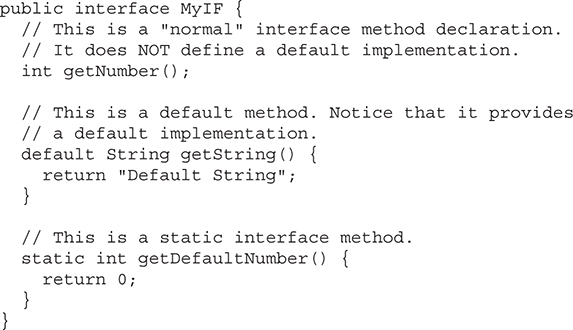
The getDefaultNumber( ) method can be called, as shown here:
int defNum = MyIF.getDefaultNumber();
As mentioned, no implementation or instance of MyIF is required to call getDefaultNumber( ) because it is static.
One last point: static interface methods are not inherited by either an implementing class or a subinterface.
Beginning with JDK 9, an interface can include a private method. A private interface method can be called only by a default method or another private method defined by the same interface. Because a private interface method is specified private, it cannot be used by code outside the interface in which it is defined. This restriction includes subinterfaces because a private interface method is not inherited by a subinterface.
The key benefit of a private interface method is that it lets two or more default methods use a common piece of code, thus avoiding code duplication. For example, here is another version of the IntStack interface that has two default methods called popNElements( ) and skipAndPopNElements( ). The first returns an array that contains the top N elements on the stack. The second skips a specified number of elements and then returns an array that contains the next N elements. Both use a private method called getElements( ) to obtain an array of the specified number of elements from the stack.
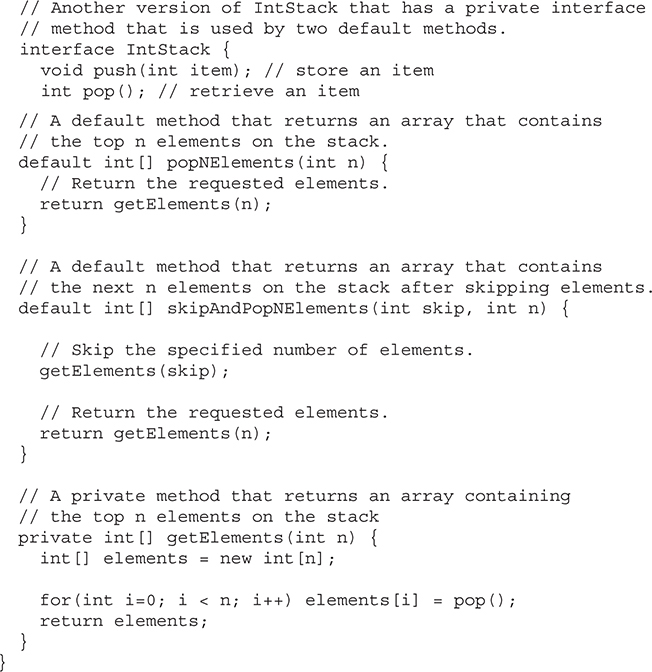
Notice that both popNElements( ) and skipAndPopNElements( ) use the private getElements( ) method to obtain the array to return. This prevents both methods from having to duplicate the same code sequence. Keep in mind that because getElements( ) is private, it cannot be called by code outside IntStack. Thus, its use is limited to the default methods inside IntStack. Also, because getElements( ) uses the pop( ) method to obtain stack elements, it will automatically call the implementation of pop( ) provided by the IntStack implementation. Thus, getElements( ) will work for any stack class that implements IntStack.
Although the private interface method is a feature that you will seldom need, in those cases in which you do need it, you will find it quite useful.
Although the examples we’ve included in this book do not make frequent use of packages or interfaces, both of these tools are an important part of the Java programming environment. Virtually all real programs that you write in Java will be contained within packages. A number will probably implement interfaces as well. It is important, therefore, that you be comfortable with their usage.
This chapter examines Java’s exception-handling mechanism. An exception is an abnormal condition that arises in a code sequence at run time. In other words, an exception is a run-time error. In computer languages that do not support exception handling, errors must be checked and handled manually—typically through the use of error codes, and so on. This approach is as cumbersome as it is troublesome. Java’s exception handling avoids these problems and, in the process, brings run-time error management into the object-oriented world.
A Java exception is an object that describes an exceptional (that is, error) condition that has occurred in a piece of code. When an exceptional condition arises, an object representing that exception is created and thrown in the method that caused the error. That method may choose to handle the exception itself, or pass it on. Either way, at some point, the exception is caught and processed. Exceptions can be generated by the Java run-time system, or they can be manually generated by your code. Exceptions thrown by Java relate to fundamental errors that violate the rules of the Java language or the constraints of the Java execution environment. Manually generated exceptions are typically used to report some error condition to the caller of a method.
Java exception handling is managed via five keywords: try, catch, throw, throws, and finally. Briefly, here is how they work. Program statements that you want to monitor for exceptions are contained within a try block. If an exception occurs within the try block, it is thrown. Your code can catch this exception (using catch) and handle it in some rational manner. System-generated exceptions are automatically thrown by the Java run-time system. To manually throw an exception, use the keyword throw. Any exception that is thrown out of a method must be specified as such by a throws clause. Any code that absolutely must be executed after a try block completes is put in a finally block.
This is the general form of an exception-handling block:
try {
// block of code to monitor for errors
}
catch (ExceptionType1 exOb) {
// exception handler for ExceptionType1
}
catch (ExceptionType2 exOb) {
// exception handler for ExceptionType2
}
// ...
finally {
// block of code to be executed after try block ends
}
Here, ExceptionType is the type of exception that has occurred. The remainder of this chapter describes how to apply this framework.
Note There is another form of the try statement that supports automatic resource management. This form of try, called try-with-resources, is described in Chapter 13 in the context of managing files because files are some of the most commonly used resources.
All exception types are subclasses of the built-in class Throwable. Thus, Throwable is at the top of the exception class hierarchy. Immediately below Throwable are two subclasses that partition exceptions into two distinct branches. One branch is headed by Exception. This class is used for exceptional conditions that user programs should catch. This is also the class that you will subclass to create your own custom exception types. There is an important subclass of Exception, called RuntimeException. Exceptions of this type are automatically defined for the programs that you write and include things such as division by zero and invalid array indexing.
The other branch is topped by Error, which defines exceptions that are not expected to be caught under normal circumstances by your program. Exceptions of type Error are used by the Java run-time system to indicate errors having to do with the run-time environment, itself. Stack overflow is an example of such an error. This chapter will not be dealing with exceptions of type Error, because these are typically created in response to catastrophic failures that cannot usually be handled by your program.
The top-level exception hierarchy is shown here:
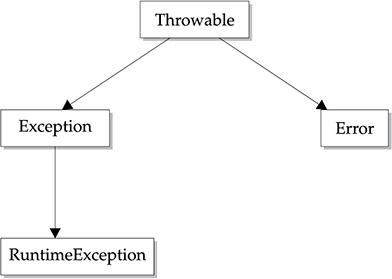
Before you learn how to handle exceptions in your program, it is useful to see what happens when you don’t handle them. This small program includes an expression that intentionally causes a divide-by-zero error:

When the Java run-time system detects the attempt to divide by zero, it constructs a new exception object and then throws this exception. This causes the execution of Exc0 to stop, because once an exception has been thrown, it must be caught by an exception handler and dealt with immediately. In this example, we haven’t supplied any exception handlers of our own, so the exception is caught by the default handler provided by the Java run-time system. Any exception that is not caught by your program will ultimately be processed by the default handler. The default handler displays a string describing the exception, prints a stack trace from the point at which the exception occurred, and terminates the program.
Here is the exception generated when this example is executed:

Notice how the class name, Exc0; the method name, main; the filename, Exc0.java; and the line number, 4, are all included in the simple stack trace. Also, notice that the type of exception thrown is a subclass of Exception called ArithmeticException, which more specifically describes what type of error happened. As discussed later in this chapter, Java supplies several built-in exception types that match the various sorts of run-time errors that can be generated. One other point: The exact output you see when running this and other example programs in this chapter that use Java’s built-in exceptions may vary slightly from what is shown because of differences between JDKs.
The stack trace will always show the sequence of method invocations that led up to the error. For example, here is another version of the preceding program that introduces the same error but in a method separate from main( ):
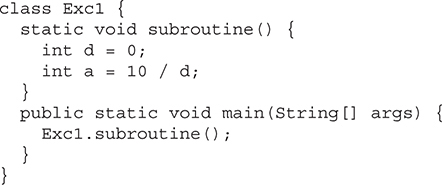
The resulting stack trace from the default exception handler shows how the entire call stack is displayed:

As you can see, the bottom of the stack is main’s line 7, which is the call to subroutine( ), which caused the exception at line 4. The call stack is quite useful for debugging, because it pinpoints the precise sequence of steps that led to the error.
Although the default exception handler provided by the Java run-time system is useful for debugging, you will usually want to handle an exception yourself. Doing so provides two benefits. First, it allows you to fix the error. Second, it prevents the program from automatically terminating. Most users would be confused (to say the least) if your program stopped running and printed a stack trace whenever an error occurred! Fortunately, it is quite easy to prevent this.
To guard against and handle a run-time error, simply enclose the code that you want to monitor inside a try block. Immediately following the try block, include a catch clause that specifies the exception type that you wish to catch. To illustrate how easily this can be done, the following program includes a try block and a catch clause that processes the ArithmeticException generated by the division-by-zero error:
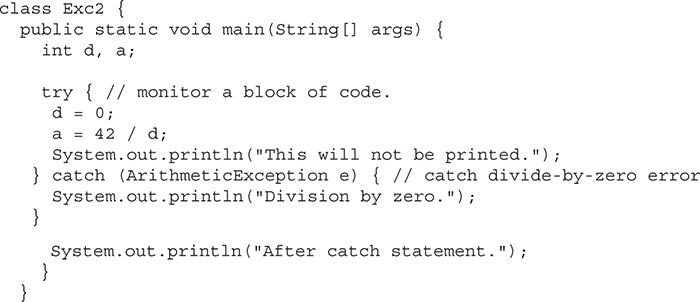
This program generates the following output:
Division by zero.
After catch statement.
Notice that the call to println( ) inside the try block is never executed. Once an exception is thrown, program control transfers out of the try block into the catch block. Put differently, catch is not “called,” so execution never “returns” to the try block from a catch. Thus, the line "This will not be printed." is not displayed. Once the catch statement has executed, program control continues with the next line in the program following the entire try / catch mechanism.
A try and its catch statement form a unit. The scope of the catch clause is restricted to those statements specified by the immediately preceding try statement. A catch statement cannot catch an exception thrown by another try statement (except in the case of nested try statements, described shortly). The statements that are protected by try must be surrounded by curly braces. (That is, they must be within a block.) You cannot use try on a single statement.
The goal of most well-constructed catch clauses should be to resolve the exceptional condition and then continue on as if the error had never happened. For example, in the next program each iteration of the for loop obtains two random integers. Those two integers are divided by each other, and the result is used to divide the value 12345. The final result is put into a. If either division operation causes a divide-by-zero error, it is caught, the value of a is set to zero, and the program continues.
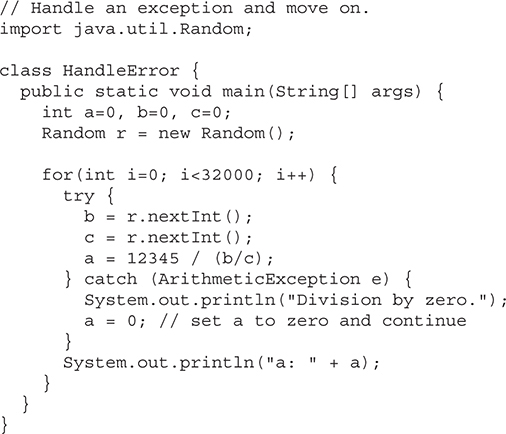
Throwable overrides the toString( ) method (defined by Object) so that it returns a string containing a description of the exception. You can display this description in a println( ) statement by simply passing the exception as an argument. For example, the catch block in the preceding program can be rewritten like this:

When this version is substituted in the program, and the program is run, each divide-by-zero error displays the following message:
Exception: java.lang.ArithmeticException: / by zero
While it is of no particular value in this context, the ability to display a description of an exception is valuable in other circumstances—particularly when you are experimenting with exceptions or when you are debugging.
In some cases, more than one exception could be raised by a single piece of code. To handle this type of situation, you can specify two or more catch clauses, each catching a different type of exception. When an exception is thrown, each catch statement is inspected in order, and the first one whose type matches that of the exception is executed. After one catch statement executes, the others are bypassed, and execution continues after the try / catch block. The following example traps two different exception types:
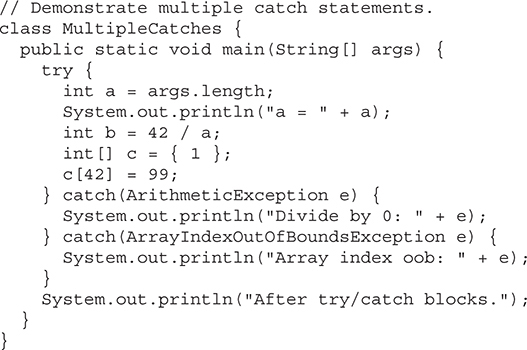
This program will cause a division-by-zero exception if it is started with no command-line arguments, since a will equal zero. It will survive the division if you provide a command-line argument, setting a to something larger than zero. But it will cause an ArrayIndexOutOfBoundsException, since the int array c has a length of 1, yet the program attempts to assign a value to c[42].
Here is the output generated by running it both ways:
C:\>java MultipleCatches
a = 0
Divide by 0: java.lang.ArithmeticException: / by zero
After try/catch blocks.
C:\>java MultipleCatches TestArg
a = 1
Array index oob: java.lang.ArrayIndexOutOfBoundsException:
Index 42 out of bounds for length 1
After try/catch blocks.
When you use multiple catch statements, it is important to remember that exception subclasses must come before any of their superclasses. This is because a catch statement that uses a superclass will catch exceptions of that type plus any of its subclasses. Thus, a subclass would never be reached if it came after its superclass. Further, in Java, unreachable code is an error. For example, consider the following program:
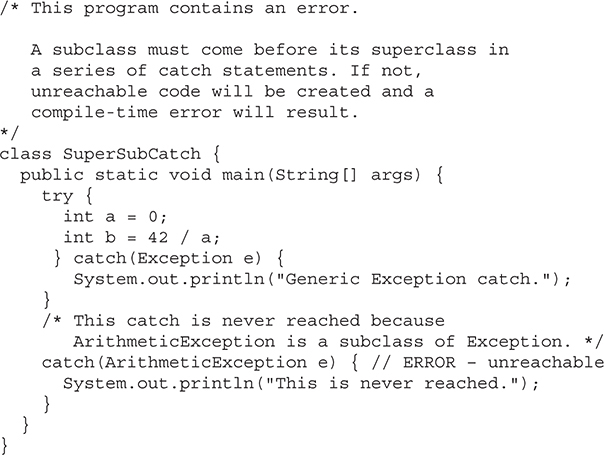
If you try to compile this program, you will receive an error message stating that the second catch statement is unreachable because the exception has already been caught. Since ArithmeticException is a subclass of Exception, the first catch statement will handle all Exception-based errors, including ArithmeticException. This means that the second catch statement will never execute. To fix the problem, reverse the order of the catch statements.
The try statement can be nested. That is, a try statement can be inside the block of another try. Each time a try statement is entered, the context of that exception is pushed on the stack. If an inner try statement does not have a catch handler for a particular exception, the stack is unwound and the next try statement’s catch handlers are inspected for a match. This continues until one of the catch statements succeeds, or until all of the nested try statements are exhausted. If no catch statement matches, then the Java run-time system will handle the exception. Here is an example that uses nested try statements:
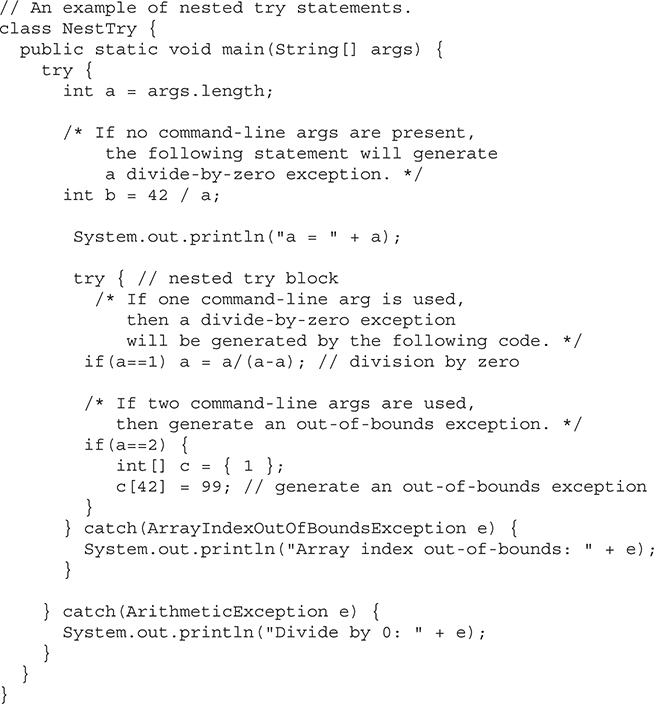
As you can see, this program nests one try block within another. The program works as follows. When you execute the program with no command-line arguments, a divide-by-zero exception is generated by the outer try block. Execution of the program with one command-line argument generates a divide-by-zero exception from within the nested try block. Since the inner block does not catch this exception, it is passed on to the outer try block, where it is handled. If you execute the program with two command-line arguments, an array boundary exception is generated from within the inner try block. Here are sample runs that illustrate each case:
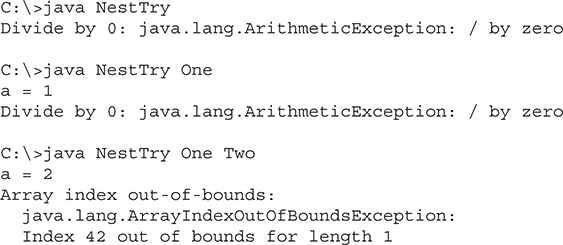
Nesting of try statements can occur in less obvious ways when method calls are involved. For example, you can enclose a call to a method within a try block. Inside that method is another try statement. In this case, the try within the method is still nested inside the outer try block, which calls the method. Here is the previous program recoded so that the nested try block is moved inside the method nesttry( ):
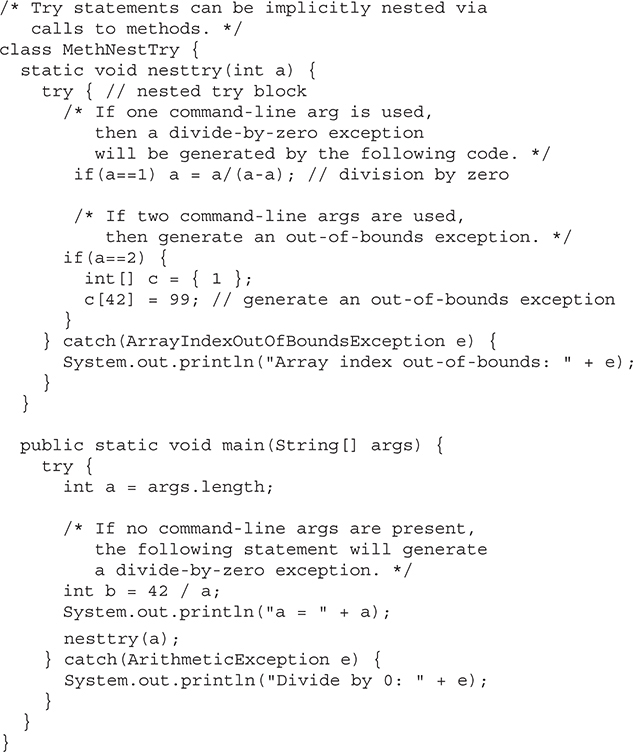
The output of this program is identical to that of the preceding example.
So far, you have only been catching exceptions that are thrown by the Java run-time system. However, it is possible for your program to throw an exception explicitly, using the throw statement. The general form of throw is shown here:
throw ThrowableInstance;
Here, ThrowableInstance must be an object of type Throwable or a subclass of Throwable. Primitive types, such as int or char, as well as non-Throwable classes, such as String and Object, cannot be used as exceptions. There are two ways you can obtain a Throwable object: using a parameter in a catch clause or creating one with the new operator.
The flow of execution stops immediately after the throw statement; any subsequent statements are not executed. The nearest enclosing try block is inspected to see if it has a catch statement that matches the type of exception. If it does find a match, control is transferred to that statement. If not, then the next enclosing try statement is inspected, and so on. If no matching catch is found, then the default exception handler halts the program and prints the stack trace.
Here is a sample program that creates and throws an exception. The handler that catches the exception rethrows it to the outer handler.
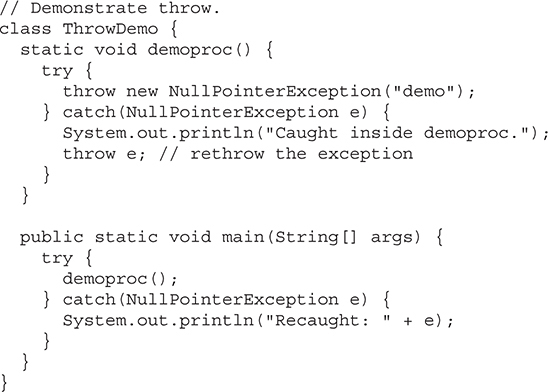
This program gets two chances to deal with the same error. First, main( ) sets up an exception context and then calls demoproc( ). The demoproc( ) method then sets up another exception-handling context and immediately throws a new instance of NullPointerException, which is caught on the next line. The exception is then rethrown. Here is the resulting output:
Caught inside demoproc.
Recaught: java.lang.NullPointerException: demo
The program also illustrates how to create one of Java’s standard exception objects. Pay close attention to this line:
throw new NullPointerException("demo");
Here, new is used to construct an instance of NullPointerException. Many of Java’s built-in run-time exceptions have at least two constructors: one with no parameter and one that takes a string parameter. When the second form is used, the argument specifies a string that describes the exception. This string is displayed when the object is used as an argument to print( ) or println( ). It can also be obtained by a call to getMessage( ), which is defined by Throwable.
If a method is capable of causing an exception that it does not handle, it must specify this behavior so that callers of the method can guard themselves against that exception. You do this by including a throws clause in the method’s declaration. A throws clause lists the types of exceptions that a method might throw. This is necessary for all exceptions, except those of type Error or RuntimeException, or any of their subclasses. All other exceptions that a method can throw must be declared in the throws clause. If they are not, a compile-time error will result.
This is the general form of a method declaration that includes a throws clause:
type method-name(parameter-list) throws exception-list
{
// body of method
}
Here, exception-list is a comma-separated list of the exceptions that a method can throw.
Following is an example of an incorrect program that tries to throw an exception that it does not catch. Because the program does not specify a throws clause to declare this fact, the program will not compile.
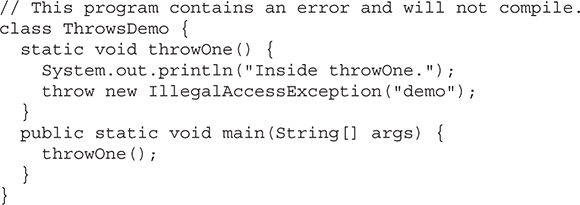
To make this example compile, you need to make two changes. First, you need to declare that throwOne( ) throws IllegalAccessException. Second, main( ) must define a try / catch statement that catches this exception.
The corrected example is shown here:
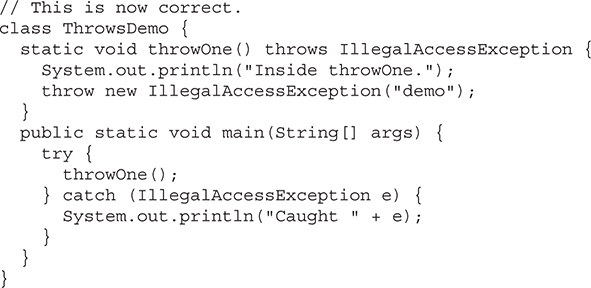
Here is the output generated by running this example program:
inside throwOne
caught java.lang.IllegalAccessException: demo
When exceptions are thrown, execution in a method takes a rather abrupt, nonlinear path that alters the normal flow through the method. Depending upon how the method is coded, it is even possible for an exception to cause the method to return prematurely. This could be a problem in some methods. For example, if a method opens a file upon entry and closes it upon exit, then you will not want the code that closes the file to be bypassed by the exception-handling mechanism. The finally keyword is designed to address this contingency.
finally creates a block of code that will be executed after a try /catch block has completed and before the code following the try/catch block. The finally block will execute whether or not an exception is thrown. If an exception is thrown, the finally block will execute even if no catch statement matches the exception. Any time a method is about to return to the caller from inside a try/catch block, via an uncaught exception or an explicit return statement, the finally clause is also executed just before the method returns. This can be useful for closing file handles and freeing up any other resources that might have been allocated at the beginning of a method with the intent of disposing of them before returning. The finally clause is optional. However, each try statement requires at least one catch or a finally clause.
Here is an example program that shows three methods that exit in various ways, none without executing their finally clauses:
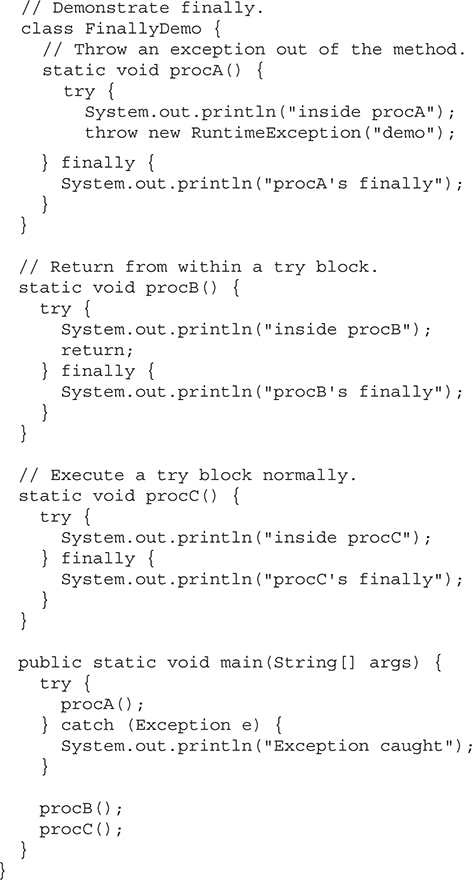
In this example, procA( ) prematurely breaks out of the try by throwing an exception. The finally clause is executed on the way out. procB( )’s try statement is exited via a return statement. The finally clause is executed before procB( ) returns. In procC( ), the try statement executes normally, without error. However, the finally block is still executed.
Remember If a finally block is associated with a try, the finally block will be executed upon conclusion of the try.
Here is the output generated by the preceding program:
inside procA
procA's finally
Exception caught
inside procB
procB's finally
inside procC
procC's finally
Inside the standard package java.lang, Java defines several exception classes. A few have been used by the preceding examples. The most general of these exceptions are subclasses of the standard type RuntimeException. As previously explained, these exceptions need not be included in any method’s throws list. In the language of Java, these are called unchecked exceptions because the compiler does not check to see if a method handles or throws these exceptions. The unchecked exceptions defined in java.lang are listed in Table 10-1. Table 10-2 lists those exceptions defined by java.lang that must be included in a method’s throws list if that method can generate one of these exceptions and does not handle it itself. These are called checked exceptions. In addition to the exceptions in java.lang, Java defines several more that relate to its other standard packages.
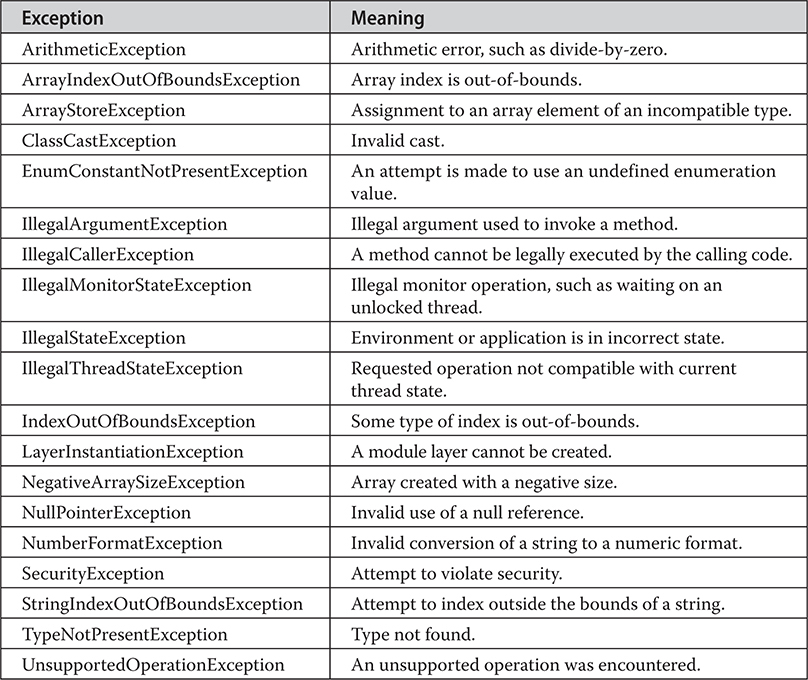
Table 10-1 Java’s Unchecked RuntimeException Subclasses Defined in java.lang
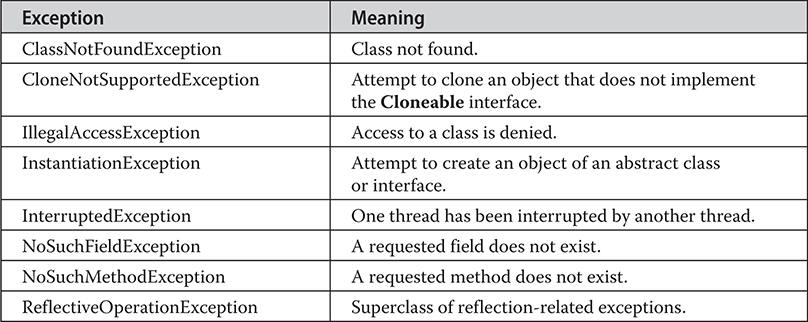
Table 10-2 Java’s Checked Exceptions Defined in java.lang
Although Java’s built-in exceptions handle most common errors, you will probably want to create your own exception types to handle situations specific to your applications. This is quite easy to do: just define a subclass of Exception (which is, of course, a subclass of Throwable). Your subclasses don’t need to actually implement anything—it is their existence in the type system that allows you to use them as exceptions.
The Exception class does not define any methods of its own. It does, of course, inherit those methods provided by Throwable. Thus, all exceptions, including those that you create, have the methods defined by Throwable available to them. They are shown in Table 10-3. You may also wish to override one or more of these methods in exception classes that you create.
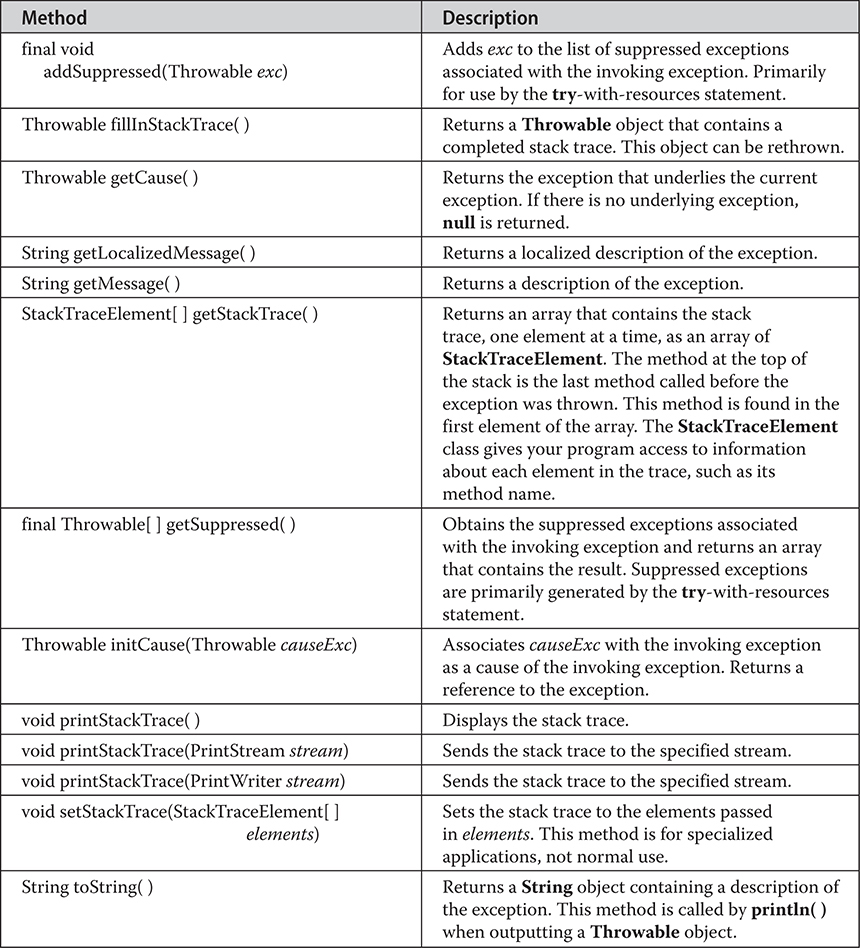
Table 10-3 The Methods Defined by Throwable
Exception defines four public constructors. Two support chained exceptions, described in the next section. The other two are shown here:
Exception( )
Exception(String msg)
The first form creates an exception that has no description. The second form lets you specify a description of the exception.
Although specifying a description when an exception is created is often useful, sometimes it is better to override toString( ). Here’s why: The version of toString( ) defined by Throwable (and inherited by Exception) first displays the name of the exception followed by a colon, which is then followed by your description. By overriding toString( ), you can prevent the exception name and colon from being displayed. This makes for a cleaner output, which is desirable in some cases.
The following example declares a new subclass of Exception and then uses that subclass to signal an error condition in a method. It overrides the toString( ) method, allowing a carefully tailored description of the exception to be displayed.
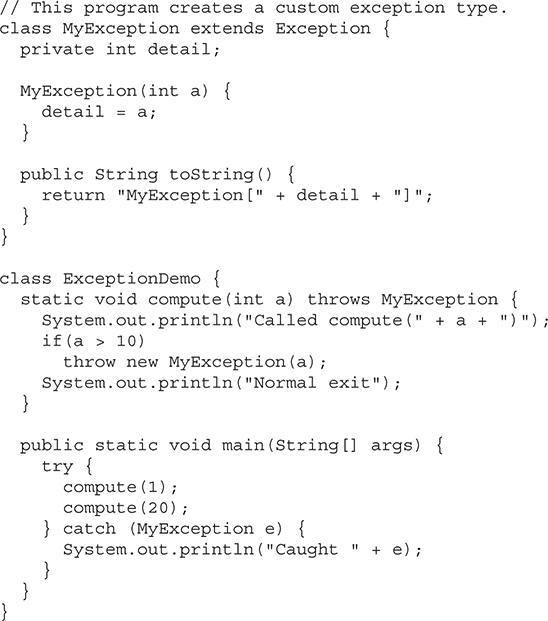
This example defines a subclass of Exception called MyException. This subclass is quite simple: It has only a constructor plus an overridden toString( ) method that displays the value of the exception. The ExceptionDemo class defines a method named compute( ) that throws a MyException object. The exception is thrown when compute( )’s integer parameter is greater than 10. The main( ) method sets up an exception handler for MyException, then calls compute( ) with a legal value (less than 10) and an illegal one to show both paths through the code. Here is the result:
Called compute(1)
Normal exit
Called compute(20)
Caught MyException[20]
A number of years ago, a feature was incorporated into the exception subsystem: chained exceptions. The chained exception feature allows you to associate another exception with an exception. This second exception describes the cause of the first exception. For example, imagine a situation in which a method throws an ArithmeticException because of an attempt to divide by zero. However, the actual cause of the problem was that an I/O error occurred, which caused the divisor to be set improperly. Although the method must certainly throw an ArithmeticException, since that is the error that occurred, you might also want to let the calling code know that the underlying cause was an I/O error. Chained exceptions let you handle this, and any other situation in which layers of exceptions exist.
To allow chained exceptions, two constructors and two methods were added to Throwable. The constructors are shown here:
Throwable(Throwable causeExc)
Throwable(String msg, Throwable causeExc)
In the first form, causeExc is the exception that causes the current exception. That is, causeExc is the underlying reason that an exception occurred. The second form allows you to specify a description at the same time that you specify a cause exception. These two constructors have also been added to the Error, Exception, and RuntimeException classes.
The chained exception methods supported by Throwable are getCause( ) and initCause( ). These methods are shown in Table 10-3 and are repeated here for the sake of discussion.
Throwable getCause( )
Throwable initCause(Throwable causeExc)
The getCause( ) method returns the exception that underlies the current exception. If there is no underlying exception, null is returned. The initCause( ) method associates causeExc with the invoking exception and returns a reference to the exception. Thus, you can associate a cause with an exception after the exception has been created. However, the cause exception can be set only once. This means that you can call initCause( ) only once for each exception object. Furthermore, if the cause exception was set by a constructor, then you can’t set it again using initCause( ). In general, initCause( ) is used to set a cause for legacy exception classes that don’t support the two additional constructors described earlier.
Here is an example that illustrates the mechanics of handling chained exceptions:
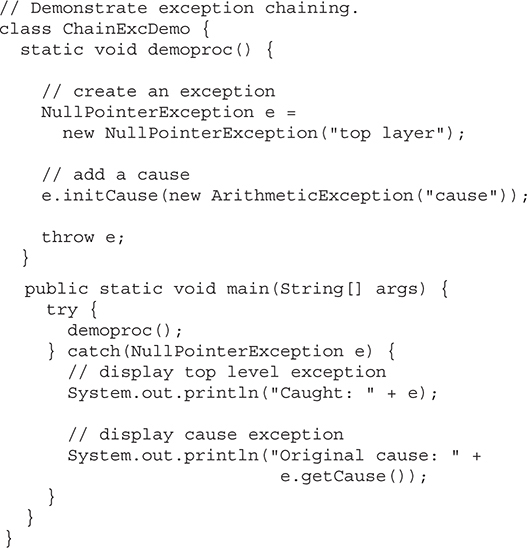
The output from the program is shown here:
Caught: java.lang.NullPointerException: top layer
Original cause: java.lang.ArithmeticException: cause
In this example, the top-level exception is NullPointerException. To it is added a cause exception, ArithmeticException. When the exception is thrown out of demoproc( ), it is caught by main( ). There, the top-level exception is displayed, followed by the underlying exception, which is obtained by calling getCause( ).
Chained exceptions can be carried on to whatever depth is necessary. Thus, the cause exception can, itself, have a cause. Be aware that overly long chains of exceptions may indicate poor design.
Chained exceptions are not something that every program will need. However, in cases in which knowledge of an underlying cause is useful, they offer an elegant solution.
Beginning with JDK 7, three interesting and useful features have been part of the exception system. The first automates the process of releasing a resource, such as a file, when it is no longer needed. It is based on an expanded form of the try statement called try-with-resources, and is described in Chapter 13 when files are introduced. The second feature is called multi-catch, and the third is sometimes referred to as final rethrow or more precise rethrow. These two features are described here.
The multi-catch feature allows two or more exceptions to be caught by the same catch clause. It is not uncommon for two or more exception handlers to use the same code sequence even though they respond to different exceptions. Instead of having to catch each exception type individually, you can use a single catch clause to handle all of the exceptions without code duplication.
To use a multi-catch, separate each exception type in the catch clause with the OR operator. Each multi-catch parameter is implicitly final. (You can explicitly specify final, if desired, but it is not necessary.) Because each multi-catch parameter is implicitly final, it can’t be assigned a new value.
Here is a catch statement that uses the multi-catch feature to catch both ArithmeticException and ArrayIndexOutOfBoundsException:
catch(ArithmeticException | ArrayIndexOutOfBoundsException e) {
The following program shows the multi-catch feature in action:
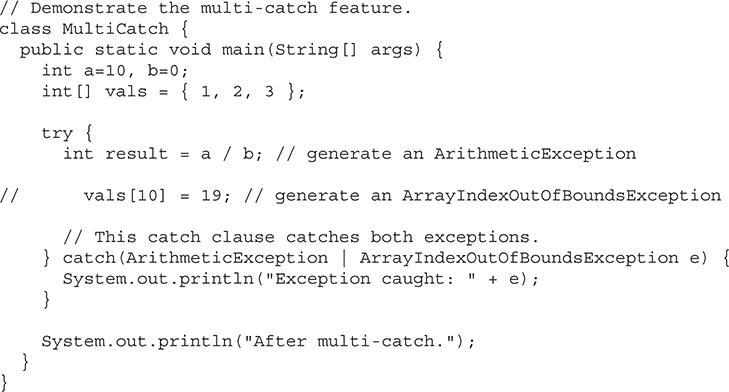
The program will generate an ArithmeticException when the division by zero is attempted. If you comment out the division statement and remove the comment symbol from the next line, an ArrayIndexOutOfBoundsException is generated. Both exceptions are caught by the single catch statement.
The more precise rethrow feature restricts the type of exceptions that can be rethrown to only those checked exceptions that the associated try block throws, that are not handled by a preceding catch clause, and that are a subtype or supertype of the parameter. Although this capability might not be needed often, it is now available for use. For the more precise rethrow feature to be in force, the catch parameter must be either effectively final, which means that it must not be assigned a new value inside the catch block, or explicitly declared final.
Exception handling provides a powerful mechanism for controlling complex programs that have many dynamic run-time characteristics. It is important to think of try, throw, and catch as clean ways to handle errors and unusual boundary conditions in your program’s logic. Instead of using error return codes to indicate failure, use Java’s exception handling capabilities. Thus, when a method can fail, have it throw an exception. This is a cleaner way to handle failure modes.
One last point: Java’s exception-handling statements should not be considered a general mechanism for nonlocal branching. If you do so, it will only confuse your code and make it hard to maintain.
Java provides built-in support for multithreaded programming. A multithreaded program contains two or more parts that can run concurrently. Each part of such a program is called a thread, and each thread defines a separate path of execution. Thus, multithreading is a specialized form of multitasking.
You are almost certainly acquainted with multitasking because it is supported by virtually all modern operating systems. However, there are two distinct types of multitasking: process-based and thread-based. It is important to understand the difference between the two. For many readers, process-based multitasking is the more familiar form. A process is, in essence, a program that is executing. Thus, process-based multitasking is the feature that allows your computer to run two or more programs concurrently. For example, process-based multitasking enables you to run the Java compiler at the same time that you are using a text editor or visiting a web site. In process-based multitasking, a program is the smallest unit of code that can be dispatched by the scheduler.
In a thread-based multitasking environment, the thread is the smallest unit of dispatchable code. This means that a single program can perform two or more tasks simultaneously. For instance, a text editor can format text at the same time that it is printing, as long as these two actions are being performed by two separate threads. Thus, process-based multitasking deals with the “big picture,” and thread-based multitasking handles the details.
Multitasking threads require less overhead than multitasking processes. Processes are heavyweight tasks that require their own separate address spaces. Interprocess communication is expensive and limited. Context switching from one process to another is also costly. Threads, on the other hand, are lighter weight. They share the same address space and cooperatively share the same heavyweight process. Interthread communication is inexpensive, and context switching from one thread to the next is lower in cost. While Java programs make use of process-based multitasking environments, process-based multitasking is not under Java’s direct control. However, multithreaded multitasking is.
Multithreading enables you to write efficient programs that make maximum use of the processing power available in the system. One important way multithreading achieves this is by keeping idle time to a minimum. This is especially important for the interactive, networked environment in which Java operates because idle time is common. For example, the transmission rate of data over a network is much slower than the rate at which the computer can process it. Even local file system resources are read and written at a much slower pace than they can be processed by the CPU. And, of course, user input is much slower than the computer. In a single-threaded environment, your program has to wait for each of these tasks to finish before it can proceed to the next one—even though most of the time the program is idle, waiting for input. Multithreading helps you reduce this idle time because another thread can run when one is waiting.
If you have programmed for operating systems such as Windows, then you are already familiar with multithreaded programming. However, the fact that Java manages threads makes multithreading especially convenient because many of the details are handled for you.
The Java run-time system depends on threads for many things, and all the class libraries are designed with multithreading in mind. In fact, Java uses threads to enable the entire environment to be asynchronous. This helps reduce inefficiency by preventing the waste of CPU cycles.
The value of a multithreaded environment is best understood in contrast to its counterpart. Single-threaded systems use an approach called an event loop with polling. In this model, a single thread of control runs in an infinite loop, polling a single event queue to decide what to do next. Once this polling mechanism returns with, say, a signal that a network file is ready to be read, then the event loop dispatches control to the appropriate event handler. Until this event handler returns, nothing else can happen in the program. This wastes CPU time. It can also result in one part of a program dominating the system and preventing any other events from being processed. In general, in a single-threaded environment, when a thread blocks (that is, suspends execution) because it is waiting for some resource, the entire program stops running.
The benefit of Java’s multithreading is that the main loop/polling mechanism is eliminated. One thread can pause without stopping other parts of your program. For example, the idle time created when a thread reads data from a network or waits for user input can be utilized elsewhere. Multithreading allows animation loops to sleep for a second between each frame without causing the whole system to pause. When a thread blocks in a Java program, only the single thread that is blocked pauses. All other threads continue to run.
As most readers know, over the past few years, multicore systems have become commonplace. Of course, single-core systems are still in widespread use. It is important to understand that Java’s multithreading features work in both types of systems. In a single-core system, concurrently executing threads share the CPU, with each thread receiving a slice of CPU time. Therefore, in a single-core system, two or more threads do not actually run at the same time, but idle CPU time is utilized. However, in multicore systems, it is possible for two or more threads to actually execute simultaneously. In many cases, this can further improve program efficiency and increase the speed of certain operations.
Note In addition to the multithreading features described in this chapter, you will also want to explore the Fork/Join Framework. It provides a powerful means of creating multithreaded applications that automatically scale to make best use of multicore environments. The Fork/Join Framework is part of Java’s support for parallel programming, which is the name commonly given to the techniques that optimize some types of algorithms for parallel execution in systems that have more than one CPU. For a discussion of the Fork/Join Framework and other concurrency utilities, see Chapter 29. Java’s traditional multithreading capabilities are described here.
Threads exist in several states. Here is a general description. A thread can be running. It can be ready to run as soon as it gets CPU time. A running thread can be suspended, which temporarily halts its activity. A suspended thread can then be resumed, allowing it to pick up where it left off. A thread can be blocked when waiting for a resource. At any time, a thread can be terminated, which halts its execution immediately. Once terminated, a thread cannot be resumed.
Java assigns to each thread a priority that determines how that thread should be treated with respect to the others. Thread priorities are integers that specify the relative priority of one thread to another. As an absolute value, a priority is meaningless; a higher-priority thread doesn’t run any faster than a lower-priority thread if it is the only thread running. Instead, a thread’s priority is used to decide when to switch from one running thread to the next. This is called a context switch. The rules that determine when a context switch takes place are simple:
• A thread can voluntarily relinquish control. This occurs when explicitly yielding, sleeping, or when blocked. In this scenario, all other threads are examined, and the highest-priority thread that is ready to run is given the CPU.
• A thread can be preempted by a higher-priority thread. In this case, a lower-priority thread that does not yield the processor is simply preempted—no matter what it is doing—by a higher-priority thread. Basically, as soon as a higher-priority thread wants to run, it does. This is called preemptive multitasking.
In cases where two threads with the same priority are competing for CPU cycles, the situation is a bit complicated. For some operating systems, threads of equal priority are time-sliced automatically in round-robin fashion. For other types of operating systems, threads of equal priority must voluntarily yield control to their peers. If they don’t, the other threads will not run.
Caution Portability problems can arise from the differences in the way that operating systems context-switch threads of equal priority.
Because multithreading introduces an asynchronous behavior to your programs, there must be a way for you to enforce synchronicity when you need it. For example, if you want two threads to communicate and share a complicated data structure, such as a linked list, you need some way to ensure that they don’t conflict with each other. That is, you must prevent one thread from writing data while another thread is in the middle of reading it. For this purpose, Java implements an elegant twist on an age-old model of interprocess synchronization: the monitor. The monitor is a control mechanism first defined by C.A.R. Hoare. You can think of a monitor as a very small box that can hold only one thread. Once a thread enters a monitor, all other threads must wait until that thread exits the monitor. In this way, a monitor can be used to protect a shared asset from being manipulated by more than one thread at a time.
In Java, there is no class “Monitor”; instead, each object has its own implicit monitor that is automatically entered when one of the object’s synchronized methods is called. Once a thread is inside a synchronized method, no other thread can call any other synchronized method on the same object. This enables you to write very clear and concise multithreaded code, because synchronization support is built into the language.
After you divide your program into separate threads, you need to define how they will communicate with each other. When programming with some other languages, you must depend on the operating system to establish communication between threads. This, of course, adds overhead. By contrast, Java provides a clean, low-cost way for two or more threads to talk to each other, via calls to predefined methods that all objects have. Java’s messaging system allows a thread to enter a synchronized method on an object, and then wait there until some other thread explicitly notifies it to come out.
Java’s multithreading system is built upon the Thread class, its methods, and its companion interface, Runnable. Thread encapsulates a thread of execution. Since you can’t directly refer to the ethereal state of a running thread, you will deal with it through its proxy, the Thread instance that spawned it. To create a new thread, your program will either extend Thread or implement the Runnable interface.
The Thread class defines several methods that help manage threads. Several of those used in this chapter are shown here:

Thus far, all the examples in this book have used a single thread of execution. The remainder of this chapter explains how to use Thread and Runnable to create and manage threads, beginning with the one thread that all Java programs have: the main thread.
When a Java program starts up, one thread begins running immediately. This is usually called the main thread of your program, because it is the one that is executed when your program begins. The main thread is important for two reasons:
• It is the thread from which other “child” threads will be spawned.
• Often, it must be the last thread to finish execution because it performs various shutdown actions.
Although the main thread is created automatically when your program is started, it can be controlled through a Thread object. To do so, you must obtain a reference to it by calling the method currentThread( ), which is a public static member of Thread. Its general form is shown here:
static Thread currentThread( )
This method returns a reference to the thread in which it is called. Once you have a reference to the main thread, you can control it just like any other thread.
Let’s begin by reviewing the following example:
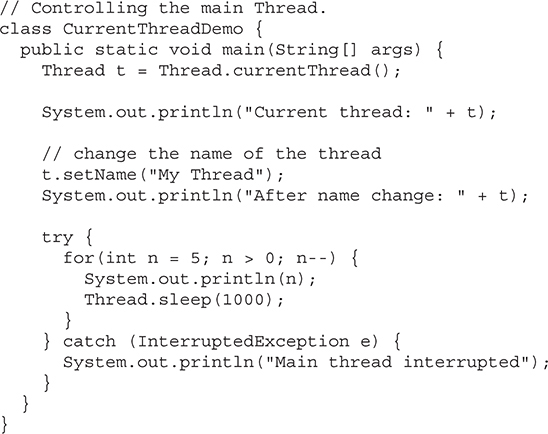
In this program, a reference to the current thread (the main thread, in this case) is obtained by calling currentThread( ), and this reference is stored in the local variable t. Next, the program displays information about the thread. The program then calls setName( ) to change the internal name of the thread. Information about the thread is then redisplayed. Next, a loop counts down from five, pausing one second between each line. The pause is accomplished by the sleep( ) method. The argument to sleep( ) specifies the delay period in milliseconds. Notice the try/catch block around this loop. The sleep( ) method in Thread might throw an InterruptedException. This would happen if some other thread wanted to interrupt this sleeping one. This example just prints a message if it gets interrupted. In a real program, you would need to handle this differently. Here is the output generated by this program:
Current thread: Thread[main,5,main]
After name change: Thread[My Thread,5,main]
5
4
3
2
1
Notice the output produced when t is used as an argument to println( ). This displays, in order: the name of the thread, its priority, and the name of its group. By default, the name of the main thread is main. Its priority is 5, which is the default value, and main is also the name of the group of threads to which this thread belongs. A thread group is a data structure that controls the state of a collection of threads as a whole. After the name of the thread is changed, t is again output. This time, the new name of the thread is displayed.
Let’s look more closely at the methods defined by Thread that are used in the program. The sleep( ) method causes the thread from which it is called to suspend execution for the specified period of milliseconds. Its general form is shown here:
static void sleep(long milliseconds) throws InterruptedException
The number of milliseconds to suspend is specified in milliseconds. This method may throw an InterruptedException.
The sleep( ) method has a second form, shown next, which allows you to specify the period in terms of milliseconds and nanoseconds:
static void sleep(long milliseconds, int nanoseconds) throws InterruptedException
This second form is useful only in environments that allow timing periods as short as nanoseconds.
As the preceding program shows, you can set the name of a thread by using setName( ). You can obtain the name of a thread by calling getName( ) (but note that this is not shown in the program). These methods are members of the Thread class and are declared like this:
final void setName(String threadName)
final String getName( )
Here, threadName specifies the name of the thread.
In the most general sense, you create a thread by instantiating an object of type Thread. Java defines two ways in which this can be accomplished:
• You can implement the Runnable interface.
• You can extend the Thread class, itself.
The following two sections look at each method, in turn.
The easiest way to create a thread is to create a class that implements the Runnable interface. Runnable abstracts a unit of executable code. You can construct a thread on any object that implements Runnable. To implement Runnable, a class need only implement a single method called run( ), which is declared like this:
public void run( )
Inside run( ), you will define the code that constitutes the new thread. It is important to understand that run( ) can call other methods, use other classes, and declare variables, just like the main thread can. The only difference is that run( ) establishes the entry point for another, concurrent thread of execution within your program. This thread will end when run( ) returns.
After you create a class that implements Runnable, you will instantiate an object of type Thread from within that class. Thread defines several constructors. The one that we will use is shown here:
Thread(Runnable threadOb, String threadName)
In this constructor, threadOb is an instance of a class that implements the Runnable interface. This defines where execution of the thread will begin. The name of the new thread is specified by threadName.
After the new thread is created, it will not start running until you call its start( ) method, which is declared within Thread. In essence, start( ) initiates a call to run( ). The start( ) method is shown here:
void start( )
Here is an example that creates a new thread and starts it running:
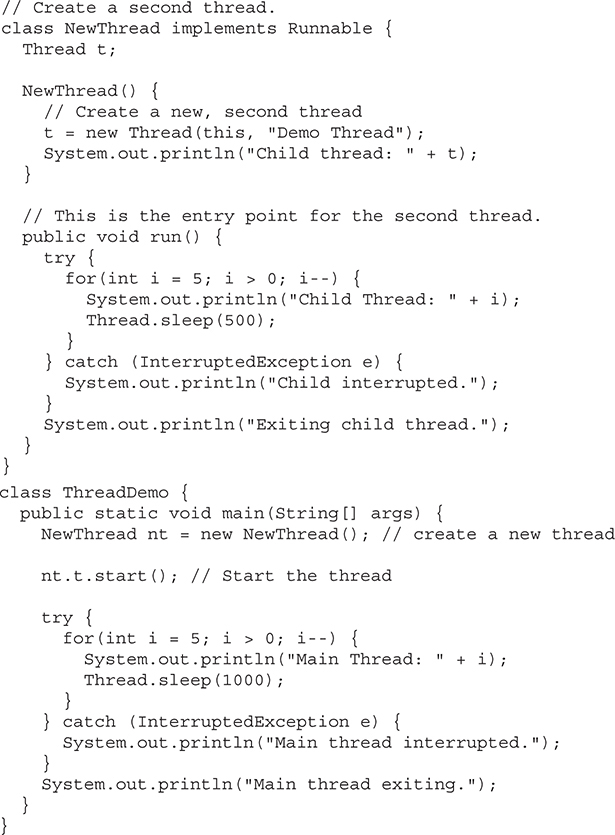
Inside NewThread’s constructor, a new Thread object is created by the following statement:
t = new Thread(this, "Demo Thread");
Passing this as the first argument indicates that you want the new thread to call the run( ) method on this object. Inside main( ), start( ) is called, which starts the thread of execution beginning at the run( ) method. This causes the child thread’s for loop to begin. Next the main thread enters its for loop. Both threads continue running, sharing the CPU in single-core systems, until their loops finish. The output produced by this program is as follows.(Your output may vary based upon the specific execution environment.)
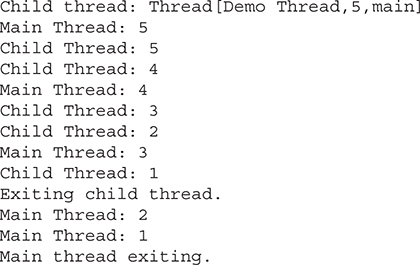
As mentioned earlier, in a multithreaded program, it is often useful for the main thread to be the last thread to finish running. The preceding program ensures that the main thread finishes last, because the main thread sleeps for 1,000 milliseconds between iterations, but the child thread sleeps for only 500 milliseconds. This causes the child thread to terminate earlier than the main thread. Shortly, you will see a better way to wait for a thread to finish.
The second way to create a thread is to create a new class that extends Thread, and then to create an instance of that class. The extending class must override the run( ) method, which is the entry point for the new thread. As before, a call to start( ) begins execution of the new thread. Here is the preceding program rewritten to extend Thread:
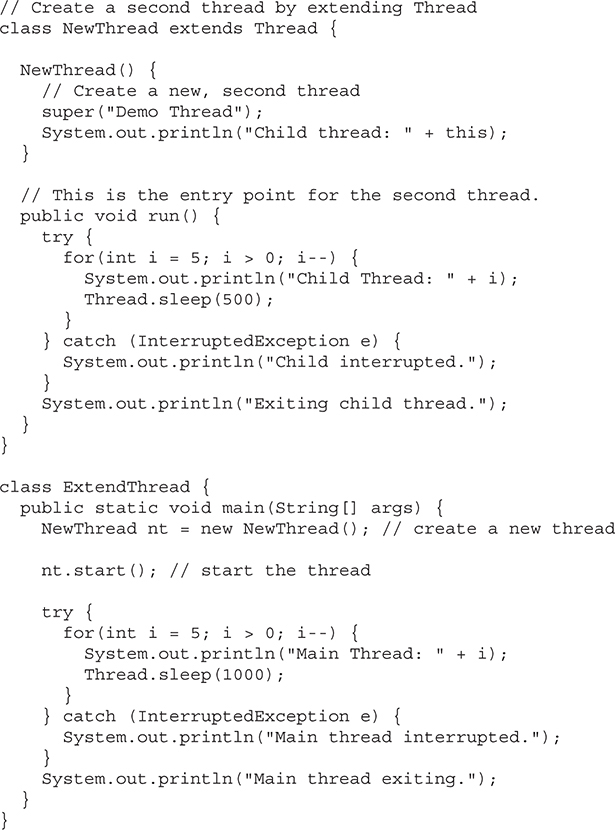
This program generates the same output as the preceding version. As you can see, the child thread is created by instantiating an object of NewThread, which is derived from Thread.
Notice the call to super( ) inside NewThread. This invokes the following form of the Thread constructor:
public Thread(String threadName)
Here, threadName specifies the name of the thread.
At this point, you might be wondering why Java has two ways to create child threads, and which approach is better. The answers to these questions turn on the same point. The Thread class defines several methods that can be overridden by a derived class. Of these methods, the only one that must be overridden is run( ). This is, of course, the same method required when you implement Runnable. Many Java programmers feel that classes should be extended only when they are being enhanced or adapted in some way. So, if you will not be overriding any of Thread’s other methods, it is probably best simply to implement Runnable. Also, by implementing Runnable, your thread class does not need to inherit Thread, making it free to inherit a different class. Ultimately, which approach to use is up to you. However, throughout the rest of this chapter, we will create threads by using classes that implement Runnable.
So far, you have been using only two threads: the main thread and one child thread. However, your program can spawn as many threads as it needs. For example, the following program creates three child threads:
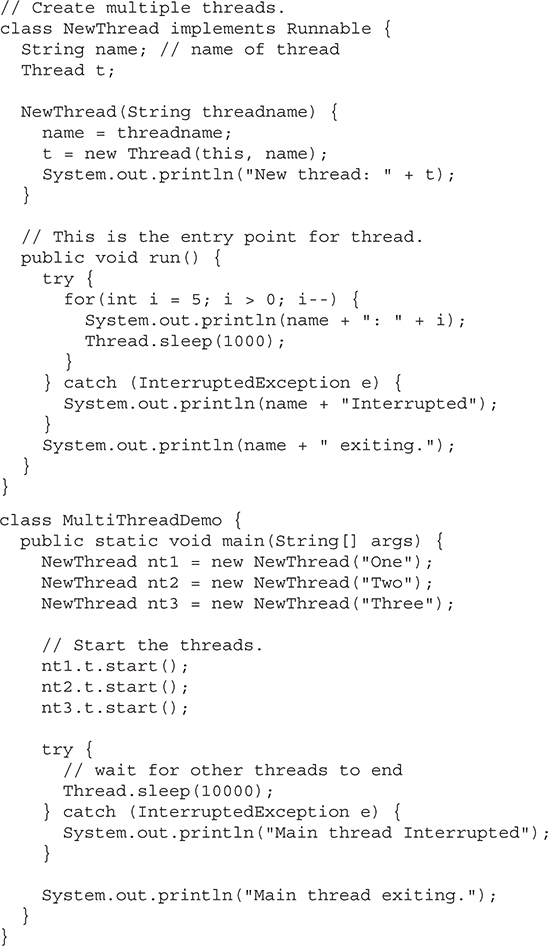
Sample output from this program is shown here. (Your output may vary based upon the specific execution environment.)
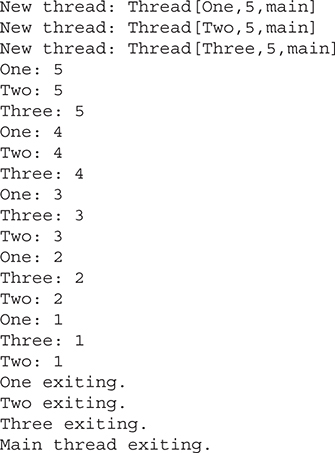
As you can see, once started, all three child threads share the CPU. Notice the call to sleep(10000) in main( ). This causes the main thread to sleep for ten seconds and ensures that it will finish last.
As mentioned, often you will want the main thread to finish last. In the preceding examples, this is accomplished by calling sleep( ) within main( ), with a long enough delay to ensure that all child threads terminate prior to the main thread. However, this is hardly a satisfactory solution, and it also raises a larger question: How can one thread know when another thread has ended? Fortunately, Thread provides a means by which you can answer this question.
Two ways exist to determine whether a thread has finished. First, you can call isAlive( ) on the thread. This method is defined by Thread, and its general form is shown here:
final boolean isAlive( )
The isAlive( ) method returns true if the thread upon which it is called is still running. It returns false otherwise.
While isAlive( ) is occasionally useful, the method that you will more commonly use to wait for a thread to finish is called join( ), shown here:
final void join( ) throws InterruptedException
This method waits until the thread on which it is called terminates. Its name comes from the concept of the calling thread waiting until the specified thread joins it. Additional forms of join( ) allow you to specify a maximum amount of time that you want to wait for the specified thread to terminate.
Here is an improved version of the preceding example that uses join( ) to ensure that the main thread is the last to stop. It also demonstrates the isAlive( ) method.
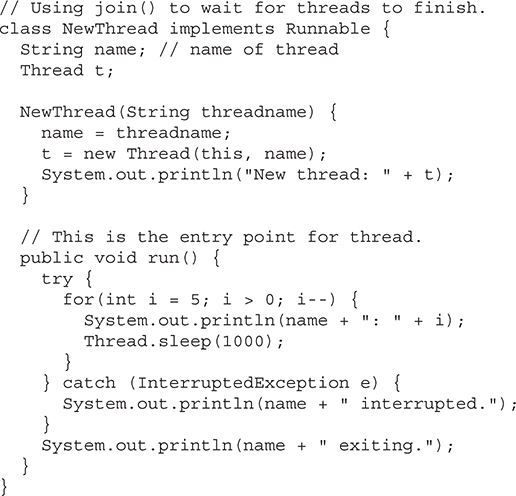
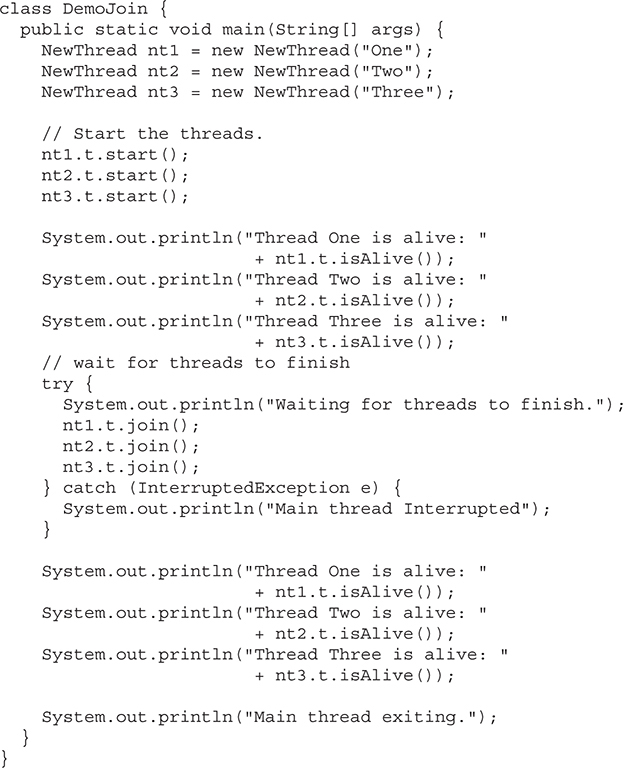
Sample output from this program is shown here. (Your output may vary based upon the specific execution environment.)
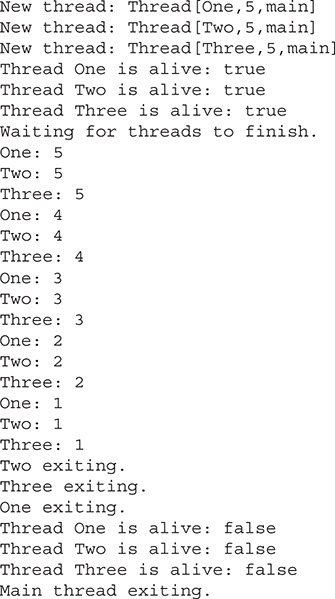
As you can see, after the calls to join( ) return, the threads have stopped executing.
Thread priorities are used by the thread scheduler to decide when each thread should be allowed to run. In theory, over a given period of time, higher-priority threads get more CPU time than lower-priority threads. In practice, the amount of CPU time that a thread gets often depends on several factors besides its priority. (For example, how an operating system implements multitasking can affect the relative availability of CPU time.) A higher-priority thread can also preempt a lower-priority one. For instance, when a lower-priority thread is running and a higher-priority thread resumes (from sleeping or waiting on I/O, for example), it will preempt the lower-priority thread.
In theory, threads of equal priority should get equal access to the CPU. But you need to be careful. Remember, Java is designed to work in a wide range of environments. Some of those environments implement multitasking fundamentally differently than others. For safety, threads that share the same priority should yield control once in a while. This ensures that all threads have a chance to run under a nonpreemptive operating system. In practice, even in nonpreemptive environments, most threads still get a chance to run, because most threads inevitably encounter some blocking situation, such as waiting for I/O. When this happens, the blocked thread is suspended and other threads can run. But, if you want smooth multithreaded execution, you are better off not relying on this. Also, some types of tasks are CPU-intensive. Such threads dominate the CPU. For these types of threads, you want to yield control occasionally so that other threads can run.
To set a thread’s priority, use the setPriority( ) method, which is a member of Thread. This is its general form:
final void setPriority(int level)
Here, level specifies the new priority setting for the calling thread. The value of level must be within the range MIN_PRIORITY and MAX_PRIORITY. Currently, these values are 1 and 10, respectively. To return a thread to default priority, specify NORM_PRIORITY, which is currently 5. These priorities are defined as static final variables within Thread.
You can obtain the current priority setting by calling the getPriority( ) method of Thread, shown here:
final int getPriority( )
Implementations of Java may have radically different behavior when it comes to scheduling. Most of the inconsistencies arise when you have threads that are relying on preemptive behavior, instead of cooperatively giving up CPU time. The safest way to obtain predictable, cross-platform behavior with Java is to use threads that voluntarily give up control of the CPU.
When two or more threads need access to a shared resource, they need some way to ensure that the resource will be used by only one thread at a time. The process by which this is achieved is called synchronization. As you will see, Java provides unique, language-level support for it.
Key to synchronization is the concept of the monitor. A monitor is an object that is used as a mutually exclusive lock. Only one thread can own a monitor at a given time. When a thread acquires a lock, it is said to have entered the monitor. All other threads attempting to enter the locked monitor will be suspended until the first thread exits the monitor. These other threads are said to be waiting for the monitor. A thread that owns a monitor can reenter the same monitor if it so desires.
You can synchronize your code in either of two ways. Both involve the use of the synchronized keyword, and both are examined here.
Synchronization is easy in Java, because all objects have their own implicit monitor associated with them. To enter an object’s monitor, just call a method that has been modified with the synchronized keyword. While a thread is inside a synchronized method, all other threads that try to call it (or any other synchronized method) on the same instance have to wait. To exit the monitor and relinquish control of the object to the next waiting thread, the owner of the monitor simply returns from the synchronized method.
To understand the need for synchronization, let’s begin with a simple example that does not use it—but should. The following program has three simple classes. The first one, Callme, has a single method named call( ). The call( ) method takes a String parameter called msg. This method tries to print the msg string inside of square brackets. The interesting thing to notice is that after call( ) prints the opening bracket and the msg string, it calls Thread.sleep(1000), which pauses the current thread for one second.
The constructor of the next class, Caller, takes a reference to an instance of the Callme class and a String, which are stored in target and msg, respectively. The constructor also creates a new thread that will call this object’s run( ) method. The run( ) method of Caller calls the call( ) method on the target instance of Callme, passing in the msg string. Finally, the Synch class starts by creating a single instance of Callme, and three instances of Caller, each with a unique message string. The same instance of Callme is passed to each Caller.
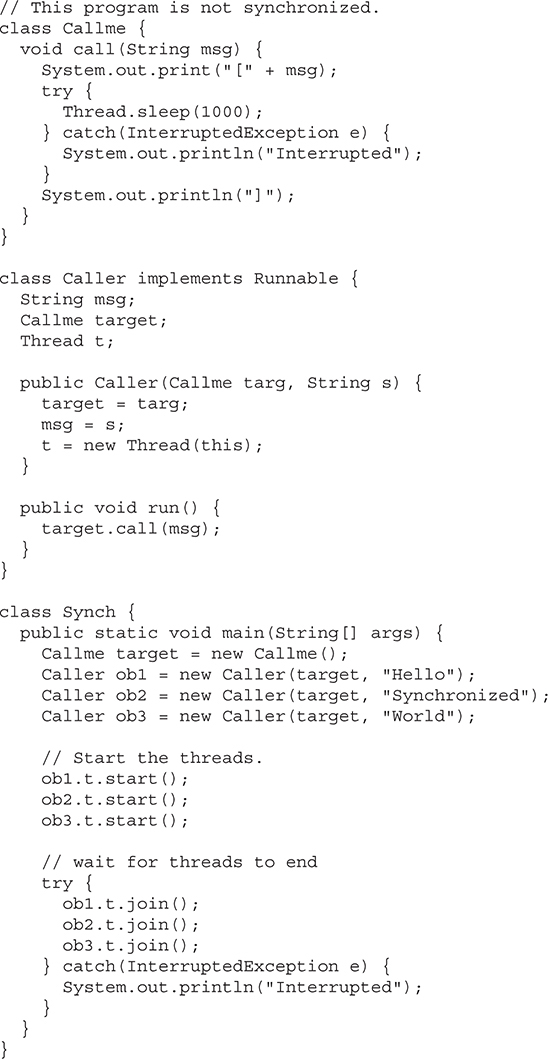
Here is the output produced by this program:

As you can see, by calling sleep( ), the call( ) method allows execution to switch to another thread. This results in the mixed-up output of the three message strings. In this program, nothing exists to stop all three threads from calling the same method, on the same object, at the same time. This is known as a race condition, because the three threads are racing each other to complete the method. This example used sleep( ) to make the effects repeatable and obvious. In most situations, a race condition is more subtle and less predictable, because you can’t be sure when the context switch will occur. This can cause a program to run right one time and wrong the next.
To fix the preceding program, you must serialize access to call( ). That is, you must restrict its access to only one thread at a time. To do this, you simply need to precede call( )’s definition with the keyword synchronized, as shown here:

This prevents other threads from entering call( ) while another thread is using it. After synchronized has been added to call( ), the output of the program is as follows:

Any time that you have a method, or group of methods, that manipulates the internal state of an object in a multithreaded situation, you should use the synchronized keyword to guard the state from race conditions. Remember, once a thread enters any synchronized method on an instance, no other thread can enter any other synchronized method on the same instance. However, nonsynchronized methods on that instance will continue to be callable.
While creating synchronized methods within classes that you create is an easy and effective means of achieving synchronization, it will not work in all cases. To understand why, consider the following. Imagine that you want to synchronize access to objects of a class that was not designed for multithreaded access. That is, the class does not use synchronized methods. Further, this class was not created by you, but by a third party, and you do not have access to the source code. Thus, you can’t add synchronized to the appropriate methods within the class. How can access to an object of this class be synchronized? Fortunately, the solution to this problem is quite easy: You simply put calls to the methods defined by this class inside a synchronized block.
This is the general form of the synchronized statement:
synchronized(objRef) {
// statements to be synchronized
}
Here, objRef is a reference to the object being synchronized. A synchronized block ensures that a call to a synchronized method that is a member of objRef’s class occurs only after the current thread has successfully entered objRef’s monitor.
Here is an alternative version of the preceding example, using a synchronized block within the run( ) method:
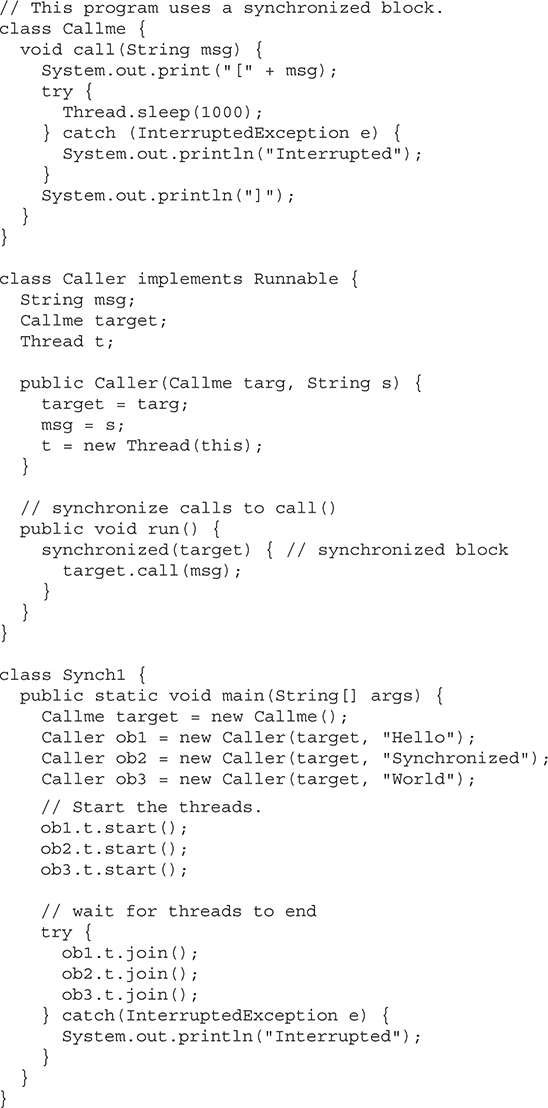
Here, the call( ) method is not modified by synchronized. Instead, the synchronized statement is used inside Caller’s run( ) method. This causes the same correct output as the preceding example, because each thread waits for the prior one to finish before proceeding.
The preceding examples unconditionally blocked other threads from asynchronous access to certain methods. This use of the implicit monitors in Java objects is powerful, but you can achieve a more subtle level of control through interprocess communication. As you will see, this is especially easy in Java.
As discussed earlier, multithreading replaces event loop programming by dividing your tasks into discrete, logical units. Threads also provide a secondary benefit: they do away with polling. Polling is usually implemented by a loop that is used to check some condition repeatedly. Once the condition is true, appropriate action is taken. This wastes CPU time. For example, consider the classic queuing problem, where one thread is producing some data and another is consuming it. To make the problem more interesting, suppose that the producer has to wait until the consumer is finished before it generates more data. In a polling system, the consumer would waste many CPU cycles while it waited for the producer to produce. Once the producer was finished, it would start polling, wasting more CPU cycles waiting for the consumer to finish, and so on. Clearly, this situation is undesirable.
To avoid polling, Java includes an elegant interprocess communication mechanism via the wait( ), notify( ), and notifyAll( ) methods. These methods are implemented as final methods in Object, so all classes have them. All three methods can be called only from within a synchronized context. Although conceptually advanced from a computer science perspective, the rules for using these methods are actually quite simple:
• wait( ) tells the calling thread to give up the monitor and go to sleep until some other thread enters the same monitor and calls notify( ) or notifyAll( ).
• notify( ) wakes up a thread that called wait( ) on the same object.
• notifyAll( ) wakes up all the threads that called wait( ) on the same object. One of the threads will be granted access.
These methods are declared within Object, as shown here:
final void wait( ) throws InterruptedException
final void notify( )
final void notify All( )
Additional forms of wait( ) exist that allow you to specify a period of time to wait.
Before working through an example that illustrates interthread communication, an important point needs to be made. Although wait( ) normally waits until notify( ) or notifyAll( ) is called, there is a possibility that in very rare cases the waiting thread could be awakened due to a spurious wakeup. In this case, a waiting thread resumes without notify( ) or notifyAll( ) having been called. (In essence, the thread resumes for no apparent reason.) Because of this remote possibility, the Java API documentation recommends that calls to wait( ) should take place within a loop that checks the condition on which the thread is waiting. The following example shows this technique.
Let’s now work through an example that uses wait( ) and notify( ). To begin, consider the following sample program that incorrectly implements a simple form of the producer/consumer problem. It consists of four classes: Q, the queue that you’re trying to synchronize; Producer, the threaded object that is producing queue entries; Consumer, the threaded object that is consuming queue entries; and PC, the tiny class that creates the single Q, Producer, and Consumer.
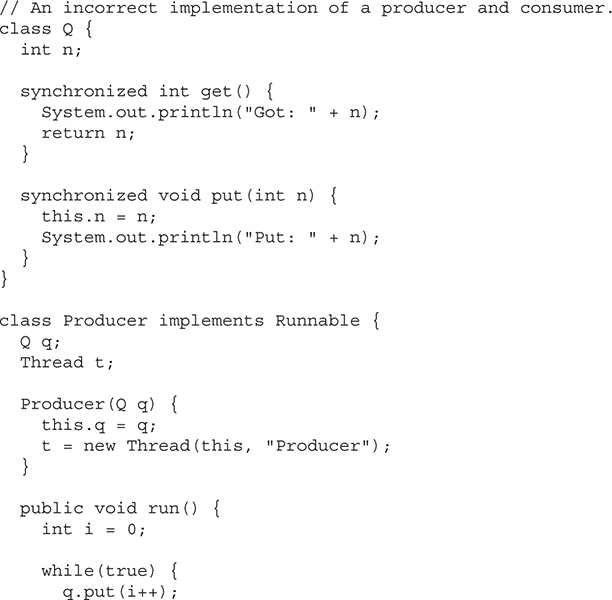
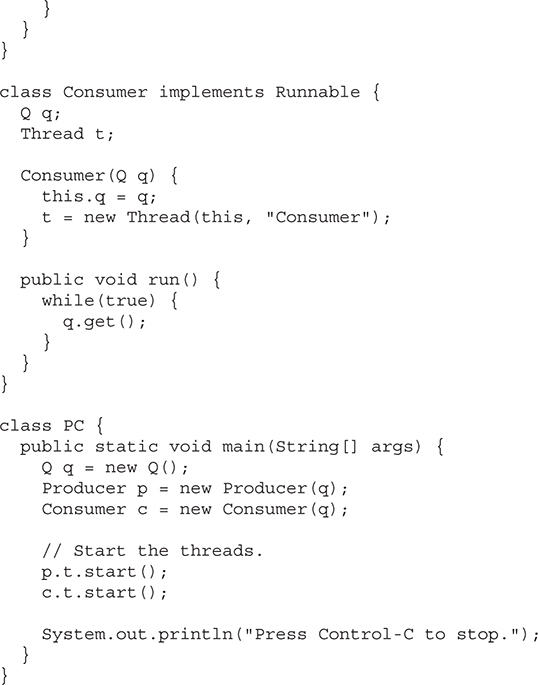
Although the put( ) and get( ) methods on Q are synchronized, nothing stops the producer from overrunning the consumer, nor will anything stop the consumer from consuming the same queue value twice. Thus, you get the erroneous output shown here (the exact output will vary with processor speed and task load):

As you can see, after the producer put 1, the consumer started and got the same 1 five times in a row. Then, the producer resumed and produced 2 through 7 without letting the consumer have a chance to consume them.
The proper way to write this program in Java is to use wait( ) and notify( ) to signal in both directions, as shown here:
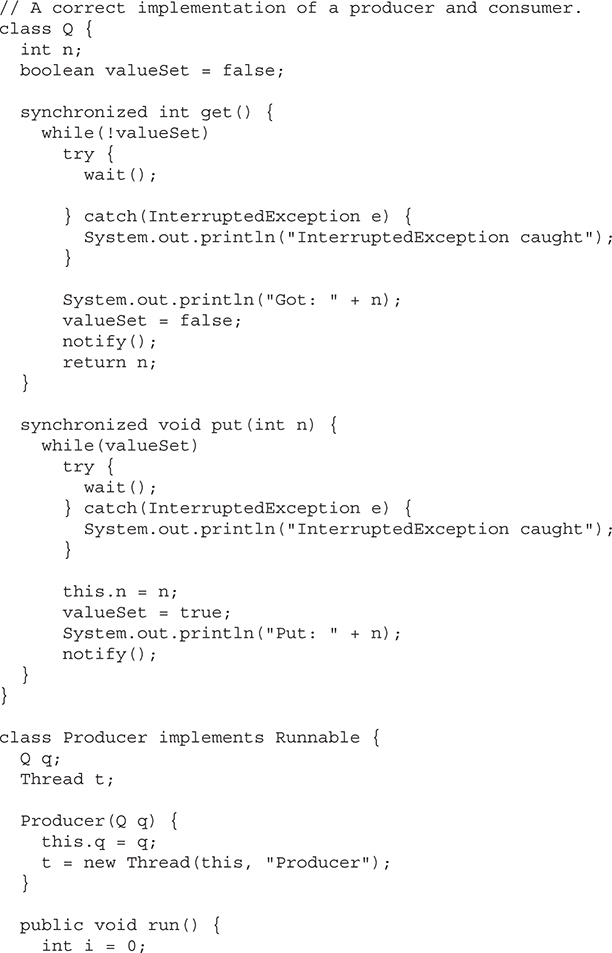
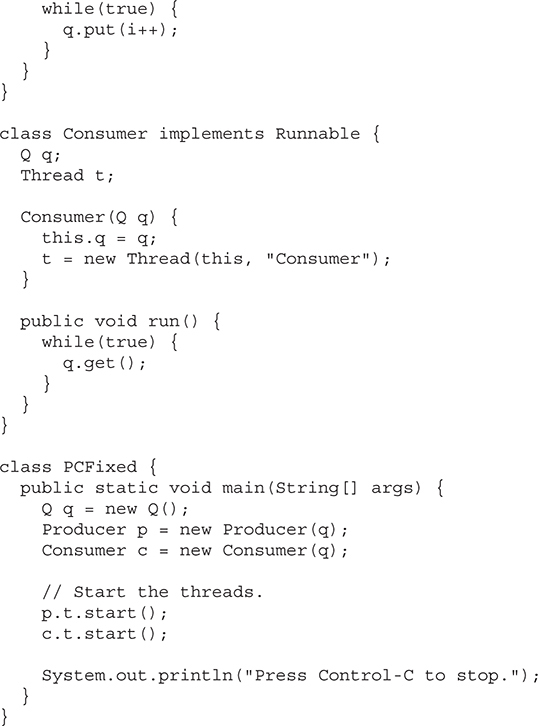
Inside get( ), wait( ) is called. This causes its execution to suspend until Producer notifies you that some data is ready. When this happens, execution inside get( ) resumes. After the data has been obtained, get( ) calls notify( ). This tells Producer that it is okay to put more data in the queue. Inside put( ), wait( ) suspends execution until Consumer has removed the item from the queue. When execution resumes, the next item of data is put in the queue, and notify( ) is called. This tells Consumer that it should now remove it.
Here is some output from this program, which shows the clean synchronous behavior:

A special type of error that you need to avoid that relates specifically to multitasking is deadlock, which occurs when two threads have a circular dependency on a pair of synchronized objects. For example, suppose one thread enters the monitor on object X and another thread enters the monitor on object Y. If the thread in X tries to call any synchronized method on Y, it will block as expected. However, if the thread in Y, in turn, tries to call any synchronized method on X, the thread waits forever, because to access X, it would have to release its own lock on Y so that the first thread could complete. Deadlock is a difficult error to debug for two reasons:
• In general, it occurs only rarely, when the two threads time-slice in just the right way.
• It may involve more than two threads and two synchronized objects. (That is, deadlock can occur through a more convoluted sequence of events than just described.)
To understand deadlock fully, it is useful to see it in action. The next example creates two classes, A and B, with methods foo( ) and bar( ), respectively, which pause briefly before trying to call a method in the other class. The main class, named Deadlock, creates an A and a B instance, and then calls deadlockStart( ) to start a second thread that sets up the deadlock condition. The foo( ) and bar( ) methods use sleep( ) as a way to force the deadlock condition to occur.
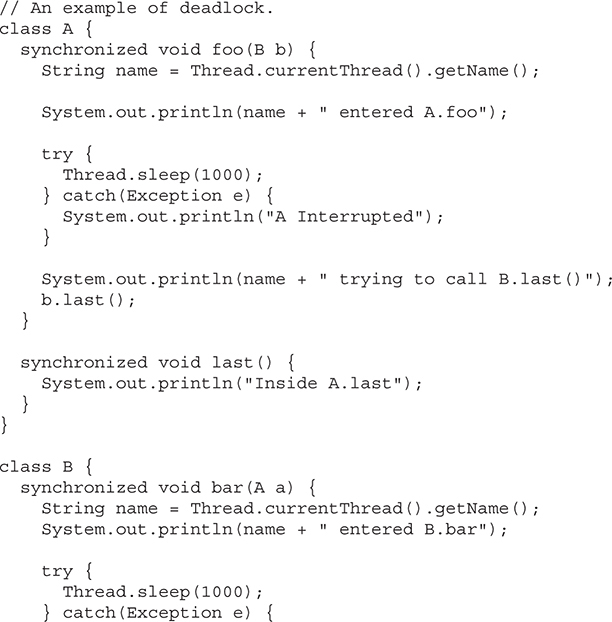
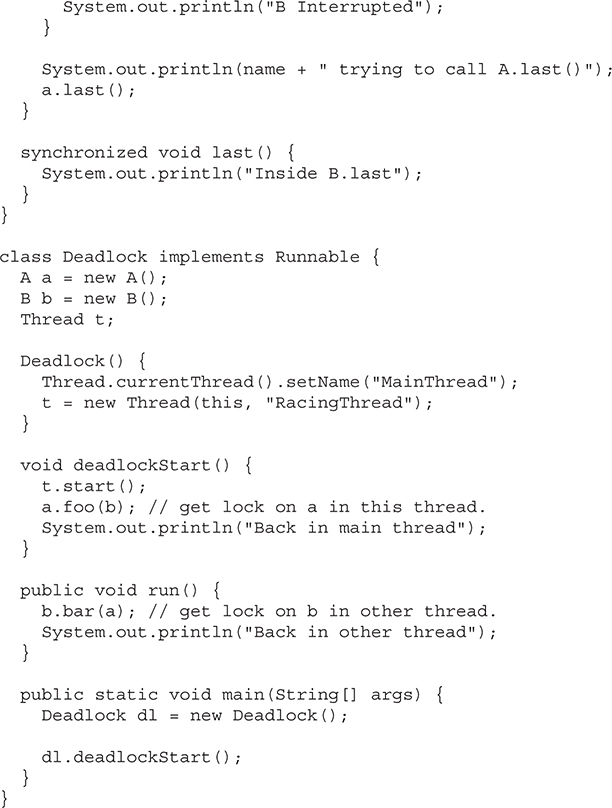
When you run this program, you will see the output shown here, although whether A.foo( ) or B.bar( ) executes first will vary based on the specific execution environment.

Because the program has deadlocked, you need to press CTRL-C to end the program. You can see a full thread and monitor cache dump by pressing CTRL-BREAK on a PC. You will see that RacingThread owns the monitor on b, while it is waiting for the monitor on a. At the same time, MainThread owns a and is waiting to get b. This program will never complete. As this example illustrates, if your multithreaded program locks up occasionally, deadlock is one of the first conditions that you should check for.
Sometimes, suspending execution of a thread is useful. For example, a separate thread can be used to display the time of day. If the user doesn’t want a clock, then its thread can be suspended. Whatever the case, suspending a thread is a simple matter. Once suspended, restarting the thread is also a simple matter.
The mechanisms to suspend, stop, and resume threads differ between early versions of Java, such as Java 1.0, and more modern versions, beginning with Java 2. Prior to Java 2, a program used suspend( ), resume( ), and stop( ), which are methods defined by Thread, to pause, restart, and stop the execution of a thread. Although these methods seem to be a perfectly reasonable and convenient approach to managing the execution of threads, they must not be used for new Java programs. Here’s why. The suspend( ) method of the Thread class was deprecated by Java 2 several years ago. This was done because suspend( ) can sometimes cause serious system failures. Assume that a thread has obtained locks on critical data structures. If that thread is suspended at that point, those locks are not relinquished. Other threads that may be waiting for those resources can be deadlocked.
The resume( ) method is also deprecated. It does not cause problems, but cannot be used without the suspend( ) method as its counterpart.
The stop( ) method of the Thread class, too, was deprecated by Java 2. This was done because this method can sometimes cause serious system failures. Assume that a thread is writing to a critically important data structure and has completed only part of its changes. If that thread is stopped at that point, that data structure might be left in a corrupted state. The trouble is that stop( ) causes any lock the calling thread holds to be released. Thus, the corrupted data might be used by another thread that is waiting on the same lock.
Because you can’t now use the suspend( ), resume( ), or stop( ) methods to control a thread, you might be thinking that no way exists to pause, restart, or terminate a thread. But, fortunately, this is not true. Instead, a thread must be designed so that the run( ) method periodically checks to determine whether that thread should suspend, resume, or stop its own execution. Typically, this is accomplished by establishing a flag variable that indicates the execution state of the thread. As long as this flag is set to “running,” the run( ) method must continue to let the thread execute. If this variable is set to “suspend,” the thread must pause. If it is set to “stop,” the thread must terminate. Of course, a variety of ways exist in which to write such code, but the central theme will be the same for all programs.
The following example illustrates how the wait( ) and notify( ) methods that are inherited from Object can be used to control the execution of a thread. Let us consider its operation. The NewThread class contains a boolean instance variable named suspendFlag, which is used to control the execution of the thread. It is initialized to false by the constructor. The run( ) method contains a synchronized statement block that checks suspendFlag. If that variable is true, the wait( ) method is invoked to suspend the execution of the thread. The mysuspend( ) method sets suspendFlag to true. The myresume( ) method sets suspendFlag to false and invokes notify( ) to wake up the thread. Finally, the main( ) method has been modified to invoke the mysuspend( ) and myresume( ) methods.
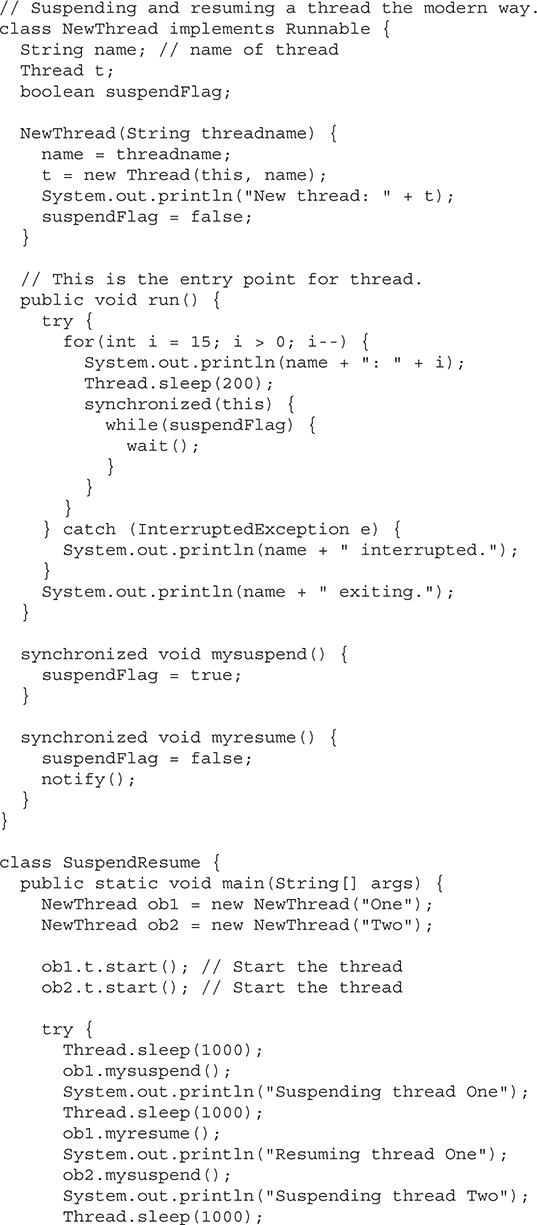
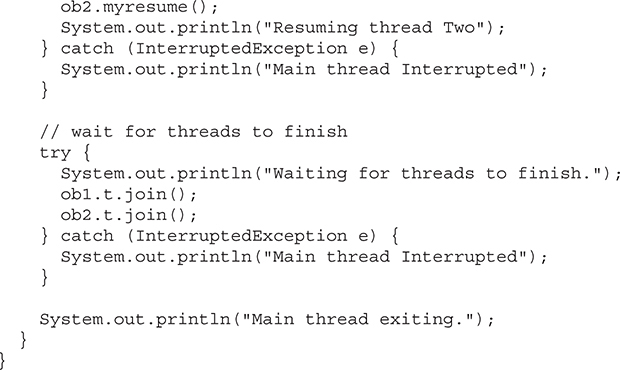
When you run the program, you will see the threads suspend and resume. Later in this book, you will see more examples that use the modern mechanism of thread control. Although this mechanism may not appear as simple to use as the old way, nevertheless, it is the way required to ensure that run-time errors don’t occur. It is the approach that must be used for all new code.
As mentioned earlier in this chapter, a thread can exist in a number of different states. You can obtain the current state of a thread by calling the getState( ) method defined by Thread. It is shown here:
Thread.State getState( )
It returns a value of type Thread.State that indicates the state of the thread at the time at which the call was made. State is an enumeration defined by Thread. (An enumeration is a list of named constants. It is discussed in detail in Chapter 12.) Here are the values that can be returned by getState( ):
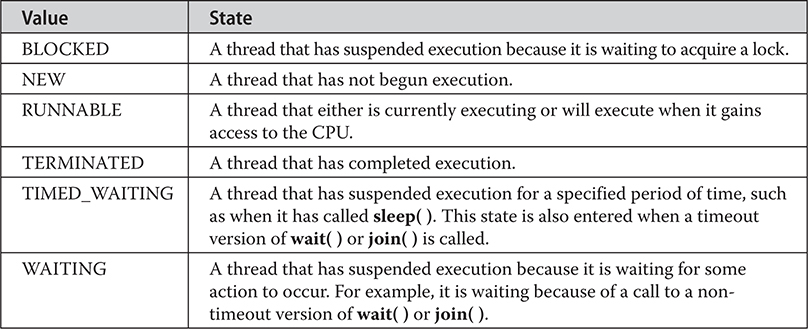
Figure 11-1 diagrams how the various thread states relate.
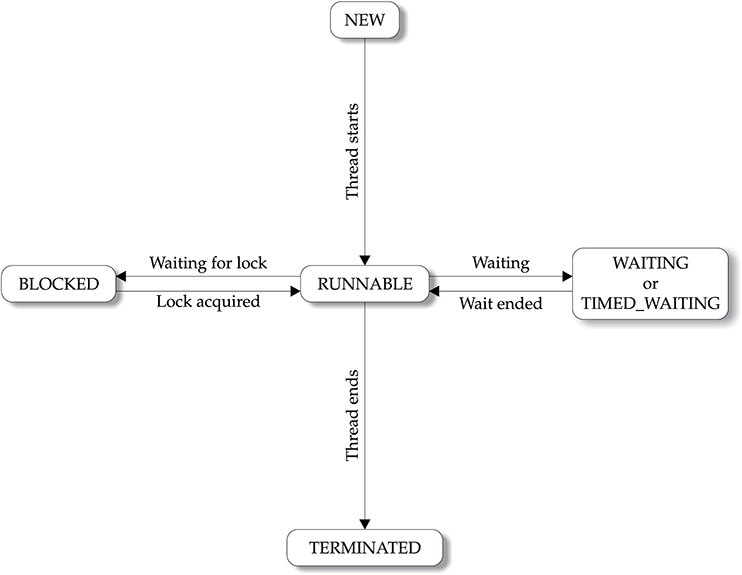
Figure 11-1 Thread states
Given a Thread instance, you can use getState( ) to obtain the state of a thread. For example, the following sequence determines if a thread called thrd is in the RUNNABLE state at the time getState( ) is called:
Thread.State ts = thrd.getState();
if(ts == Thread.State.RUNNABLE) // ...
It is important to understand that a thread’s state may change after the call to getState( ). Thus, depending on the circumstances, the state obtained by calling getState( ) may not reflect the actual state of the thread only a moment later. For this (and other) reasons, getState( ) is not intended to provide a means of synchronizing threads. It’s primarily used for debugging or for profiling a thread’s run-time characteristics.
In some cases, it is not necessary to separate the creation of a thread from the start of its execution. In other words, sometimes it is convenient to create and start a thread at the same time. One way to do this is to use a static factory method. A factory method is a method that returns an object of a class. Typically, factory methods are static methods of a class. They are used for a variety of reasons, such as to set an object to some initial state prior to use, to configure a specific type of object, or in some cases to enable an object to be reused. As it relates to creating and starting a thread, a factory method will create the thread, call start( ) on the thread, and then return a reference to the thread. With this approach, you can create and start a thread through a single method call, thus streamlining your code.
For example, assuming the ThreadDemo program shown near the start of this chapter, adding the following factory method to NewThread enables you to create and start a thread in a single step:

Using createAndStart( ), you can now replace this sequence:

with
NewThread nt = NewThread.createAndStart();
Now the thread is created and started in one step.
In cases in which you don’t need to keep a reference to the executing thread, you can sometimes create and start a thread with one line of code, without the use of a factory method. For example, again assuming the ThreadDemo program, the following creates and starts a NewThread thread:
new NewThread().t.start();
However, in real-world applications, you will usually need to keep a reference to the thread, so the factory method is often a good choice.
The key to utilizing Java’s multithreading features effectively is to think concurrently rather than serially. For example, when you have two subsystems within a program that can execute concurrently, make them individual threads. With the careful use of multithreading, you can create very efficient programs. A word of caution is in order, however: If you create too many threads, you can actually degrade the performance of your program rather than enhance it. Remember, some overhead is associated with context switching. If you create too many threads, more CPU time will be spent changing contexts than executing your program! One last point: To create compute-intensive applications that can automatically scale to make use of the available processors in a multicore system, consider using the Fork/Join Framework, which is described in Chapter 29.
This chapter examines three features that were not originally part of Java, but over time each has become a near indispensable aspect of Java programming: enumerations, autoboxing, and annotations. Originally added by JDK 5, each is a feature upon which Java programmers have come to rely because each offers a streamlined approach to handling common programming tasks. This chapter also discusses Java’s type wrappers and introduces reflection.
In its simplest form, an enumeration is a list of named constants that define a new data type and its legal values. Thus, an enumeration object can hold only a value that was declared in the list. Other values are not allowed. In other words, an enumeration gives you a way to explicitly specify the only values that a data type can legally have. Enumerations are commonly used to define a set of values that represent a collection of items. For example, you might use an enumeration to represent the error codes that can result from some operation, such as success, failed, or pending; or a list of the states that a device might be in, such as running, stopped, or paused. In early versions of Java, such values were defined using final variables, but enumerations offer a far superior approach.
Although Java enumerations might, at first glance, appear similar to enumerations in other languages, this similarity may be only skin deep because, in Java, an enumeration defines a class type. By making enumerations into classes, the capabilities of the enumeration are greatly expanded. For example, in Java, an enumeration can have constructors, methods, and instance variables. Because of their power and flexibility, enumerations are widely used throughout the Java API library.
An enumeration is created using the enum keyword. For example, here is a simple enumeration that lists various apple varieties:

The identifiers Jonathan, GoldenDel, and so on, are called enumeration constants. Each is implicitly declared as a public, static final member of Apple. Furthermore, their type is the type of the enumeration in which they are declared, which is Apple in this case. Thus, in the language of Java, these constants are called self-typed, in which “self” refers to the enclosing enumeration.
Once you have defined an enumeration, you can create a variable of that type. However, even though enumerations define a class type, you do not instantiate an enum using new. Instead, you declare and use an enumeration variable in much the same way as you do one of the primitive types. For example, this declares ap as a variable of enumeration type Apple:
Apple ap;
Because ap is of type Apple, the only values that it can be assigned (or can contain) are those defined by the enumeration. For example, this assigns ap the value RedDel:
ap = Apple.RedDel;
Notice that the symbol RedDel is preceded by Apple.
Two enumeration constants can be compared for equality by using the = = relational operator. For example, this statement compares the value in ap with the GoldenDel constant:
if(ap == Apple.GoldenDel) // ...
An enumeration value can also be used to control a switch statement. Of course, all of the case statements must use constants from the same enum as that used by the switch expression. For example, this switch is perfectly valid:

Notice that in the case statements, the names of the enumeration constants are used without being qualified by their enumeration type name. That is, Winesap, not Apple.Winesap, is used. This is because the type of the enumeration in the switch expression has already implicitly specified the enum type of the case constants. There is no need to qualify the constants in the case statements with their enum type name. In fact, attempting to do so will cause a compilation error.
When an enumeration constant is displayed, such as in a println( ) statement, its name is output. For example, given this statement:
System.out.println(Apple.Winesap);
the name Winesap is displayed.
The following program puts together all of the pieces and demonstrates the Apple enumeration:
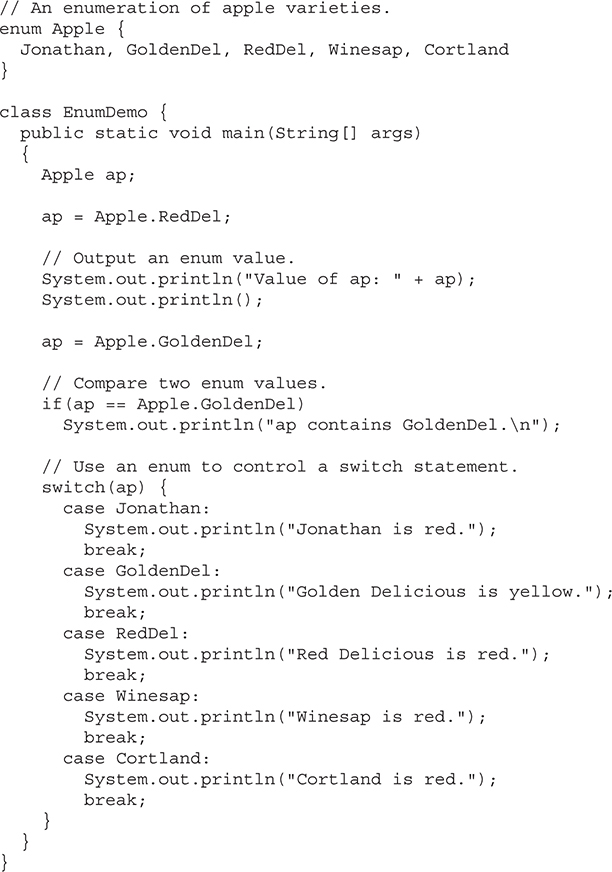
The output from the program is shown here:
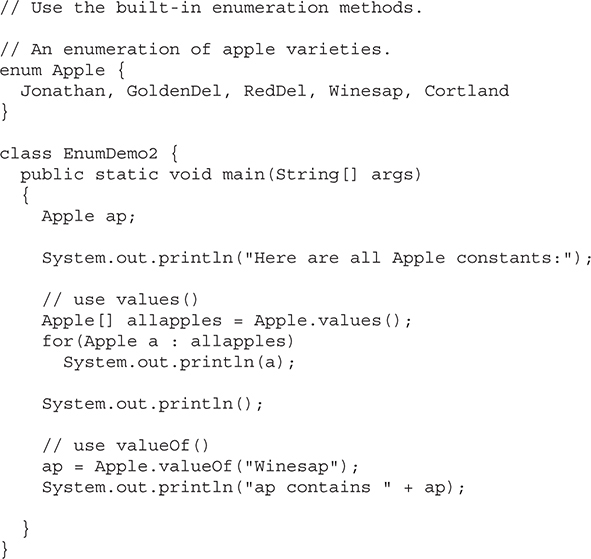
All enumerations automatically contain two predefined methods: values( ) and valueOf( ). Their general forms are shown here:
public static enum-type [ ] values( )
public static enum-type valueOf(String str )
The values( ) method returns an array that contains a list of the enumeration constants. The valueOf( ) method returns the enumeration constant whose value corresponds to the string passed in str. In both cases, enum-type is the type of the enumeration. For example, in the case of the Apple enumeration shown earlier, the return type of Apple.valueOf("Winesap") is Winesap.
The following program demonstrates the values( ) and valueOf( ) methods:
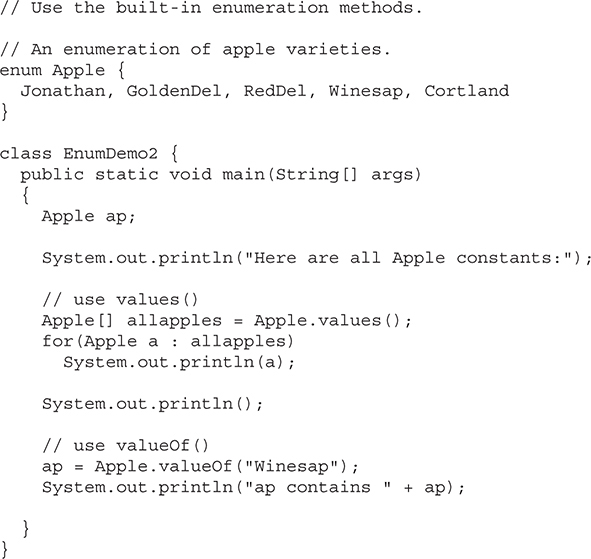
The output from the program is shown here:
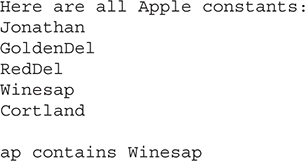
Notice that this program uses a for-each style for loop to cycle through the array of constants obtained by calling values( ). For the sake of illustration, the variable allapples was created and assigned a reference to the enumeration array. However, this step is not necessary because the for could have been written as shown here, eliminating the need for the allapples variable:

Now, notice how the value corresponding to the name Winesap was obtained by calling valueOf( ).
ap = Apple.valueOf("Winesap");
As explained, valueOf( ) returns the enumeration value associated with the name of the constant represented as a string.
As mentioned, a Java enumeration is a class type. Although you don’t instantiate an enum using new, it otherwise has much the same capabilities as other classes. The fact that enum defines a class gives the Java enumeration extraordinary power. For example, you can give them constructors, add instance variables and methods, and even implement interfaces.
It is important to understand that each enumeration constant is an object of its enumeration type. Thus, when you define a constructor for an enum, the constructor is called when each enumeration constant is created. Also, each enumeration constant has its own copy of any instance variables defined by the enumeration. For example, consider the following version of Apple:

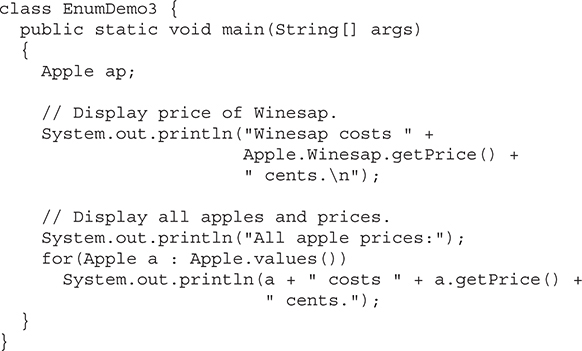
The output is shown here:

This version of Apple adds three things. The first is the instance variable price, which is used to hold the price of each variety of apple. The second is the Apple constructor, which is passed the price of an apple. The third is the method getPrice( ), which returns the value of price.
When the variable ap is declared in main( ), the constructor for Apple is called once for each constant that is specified. Notice how the arguments to the constructor are specified, by putting them inside parentheses after each constant, as shown here:
Jonathan(10), GoldenDel(9), RedDel(12), Winesap(15), Cortland(8);
These values are passed to the p parameter of Apple( ), which then assigns this value to price. Again, the constructor is called once for each constant.
Because each enumeration constant has its own copy of price, you can obtain the price of a specified type of apple by calling getPrice( ). For example, in main( ) the price of a Winesap is obtained by the following call:
Apple.Winesap.getPrice( )
The prices of all varieties are obtained by cycling through the enumeration using a for loop. Because there is a copy of price for each enumeration constant, the value associated with one constant is separate and distinct from the value associated with another constant. This is a powerful concept, which is only available when enumerations are implemented as classes, as Java does.
Although the preceding example contains only one constructor, an enum can offer two or more overloaded forms, just as can any other class. For example, this version of Apple provides a default constructor that initializes the price to –1, to indicate that no price data is available:
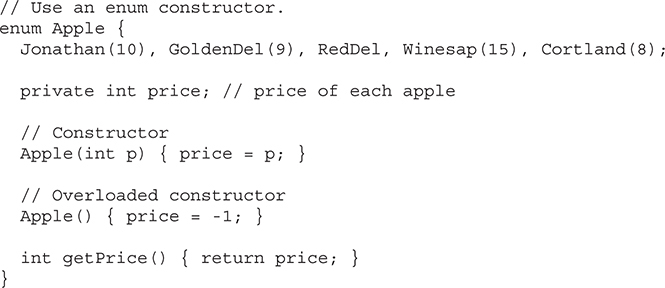
Notice that in this version, RedDel is not given an argument. This means that the default constructor is called, and RedDel’s price variable is given the value –1.
Here are two restrictions that apply to enumerations. First, an enumeration can’t inherit another class. Second, an enum cannot be a superclass. This means that an enum can’t be extended. Otherwise, enum acts much like any other class type. The key is to remember that each of the enumeration constants is an object of the class in which it is defined.
Although you can’t inherit a superclass when declaring an enum, all enumerations automatically inherit one: java.lang.Enum. This class defines several methods that are available for use by all enumerations. The Enum class is described in detail in Part II, but three of its methods warrant a discussion at this time.
You can obtain a value that indicates an enumeration constant’s position in the list of constants. This is called its ordinal value, and it is retrieved by calling the ordinal( ) method, shown here:
final int ordinal( )
It returns the ordinal value of the invoking constant. Ordinal values begin at zero. Thus, in the Apple enumeration, Jonathan has an ordinal value of zero, GoldenDel has an ordinal value of 1, RedDel has an ordinal value of 2, and so on.
You can compare the ordinal value of two constants of the same enumeration by using the compareTo( ) method. It has this general form:
final int compareTo(enum-type e)
Here, enum-type is the type of the enumeration, and e is the constant being compared to the invoking constant. Remember, both the invoking constant and e must be of the same enumeration. If the invoking constant has an ordinal value less than e’s, then compareTo( ) returns a negative value. If the two ordinal values are the same, then zero is returned. If the invoking constant has an ordinal value greater than e’s, then a positive value is returned.
You can compare for equality an enumeration constant with any other object by using equals( ), which overrides the equals( ) method defined by Object. Although equals( ) can compare an enumeration constant to any other object, those two objects will be equal only if they both refer to the same constant, within the same enumeration. Simply having ordinal values in common will not cause equals( ) to return true if the two constants are from different enumerations.
Remember, you can compare two enumeration references for equality by using = =.
The following program demonstrates the ordinal( ), compareTo( ), and equals( ) methods:
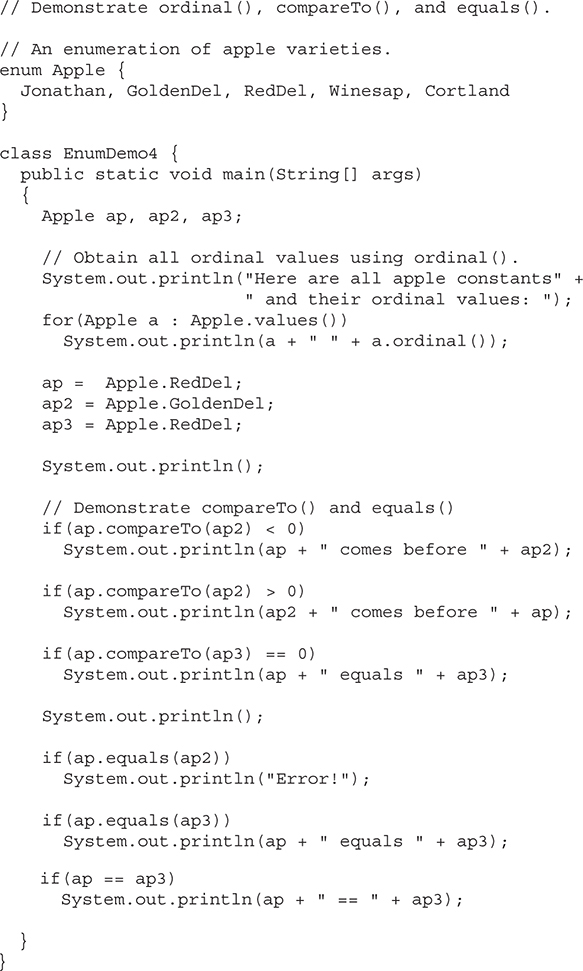
The output from the program is shown here:
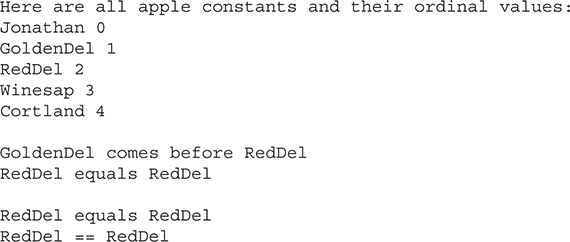
Before moving on, we will look at a different example that uses an enum. In Chapter 9, an automated “decision maker” program was created. In that version, variables called NO, YES, MAYBE, LATER, SOON, and NEVER were declared within an interface and used to represent the possible answers. While there is nothing technically wrong with that approach, the enumeration is a better choice. Here is an improved version of that program that uses an enum called Answers to define the answers. You should compare this version to the original in Chapter 9.
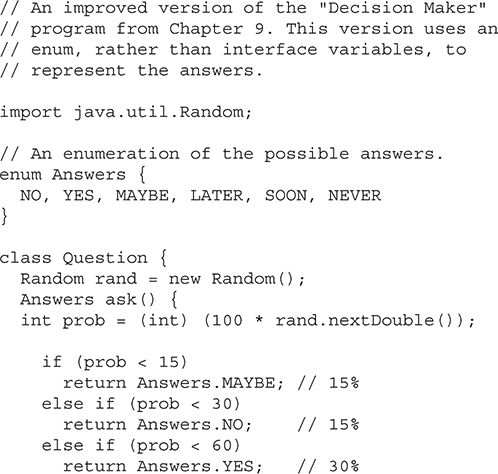
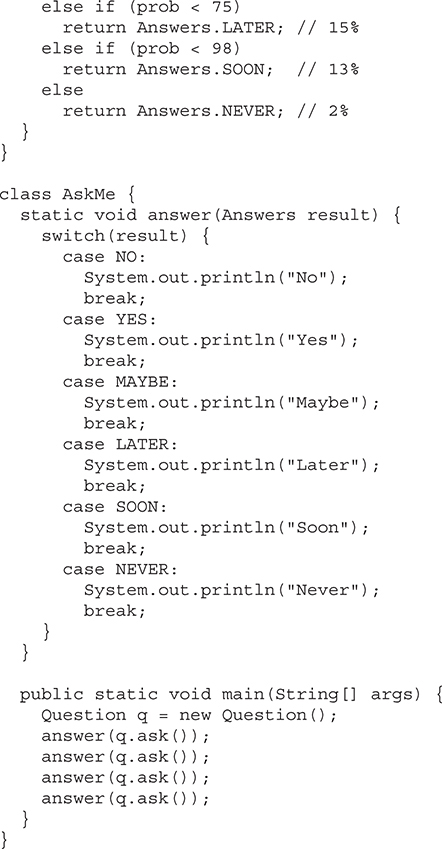
As you know, Java uses primitive types (also called simple types), such as int or double, to hold the basic data types supported by the language. Primitive types, rather than objects, are used for these quantities for the sake of performance. Using objects for these values would add an unacceptable overhead to even the simplest of calculations. Thus, the primitive types are not part of the object hierarchy, and they do not inherit Object.
Despite the performance benefit offered by the primitive types, there are times when you will need an object representation. For example, you can’t pass a primitive type by reference to a method. Also, many of the standard data structures implemented by Java operate on objects, which means that you can’t use these data structures to store primitive types. To handle these (and other) situations, Java provides type wrappers, which are classes that encapsulate a primitive type within an object. The type wrapper classes are described in detail in Part II, but they are introduced here because they relate directly to Java’s autoboxing feature.
The type wrappers are Double, Float, Long, Integer, Short, Byte, Character, and Boolean. These classes offer a wide array of methods that allow you to fully integrate the primitive types into Java’s object hierarchy. Each is briefly examined next.
Character is a wrapper around a char. The constructor for Character is
Character(char ch)
Here, ch specifies the character that will be wrapped by the Character object being created.
However, beginning with JDK 9, the Character constructor was deprecated, and beginning with JDK 16, it has been deprecated for removal. Today, it is strongly recommended that you use the static method valueOf( ) to obtain a Character object. It is shown here:
static Character valueOf(char ch)
It returns a Character object that wraps ch.
To obtain the char value contained in a Character object, call charValue( ), shown here:
char charValue( )
It returns the encapsulated character.
Boolean is a wrapper around boolean values. It defines these constructors:
Boolean(boolean boolValue)
Boolean(String boolString)
In the first version, boolValue must be either true or false. In the second version, if boolString contains the string "true" (in uppercase or lowercase), then the new Boolean object will be true. Otherwise, it will be false.
However, beginning with JDK 9, the Boolean constructors were deprecated, and beginning with JDK 16, they have been deprecated for removal. Today, it is strongly recommended that you use the static method valueOf( ) to obtain a Boolean object. It has the two versions shown here:
static Boolean valueOf(boolean boolValue)
static Boolean valueOf(String boolString)
Each returns a Boolean object that wraps the indicated value.
To obtain a boolean value from a Boolean object, use booleanValue( ), shown here:
boolean booleanValue( )
It returns the boolean equivalent of the invoking object.
By far, the most commonly used type wrappers are those that represent numeric values. These are Byte, Short, Integer, Long, Float, and Double. All of the numeric type wrappers inherit the abstract class Number. Number declares methods that return the value of an object in each of the different number formats. These methods are shown here:
byte byteValue( )
double doubleValue( )
float floatValue( )
int intValue( )
long longValue( )
short shortValue( )
For example, doubleValue( ) returns the value of an object as a double, floatValue( ) returns the value as a float, and so on. These methods are implemented by each of the numeric type wrappers.
All of the numeric type wrappers define constructors that allow an object to be constructed from a given value, or a string representation of that value. For example, here are the constructors defined for Integer:
Integer(int num)
Integer(String str)
If str does not contain a valid numeric value, then a NumberFormatException is thrown.
However, beginning with JDK 9, the numeric type-wrapper constructors were deprecated, and beginning with JDK 16, they have been deprecated for removal. Today, it is strongly recommended that you use one of the valueOf( ) methods to obtain a wrapper object. The valueOf( ) method is a static member of all of the numeric wrapper classes and all numeric classes support forms that convert a numeric value or a string into an object. For example, here are two of the forms supported by Integer:
static Integer valueOf(int val)
static Integer valueOf(String valStr) throws NumberFormatException
Here, val specifies an integer value and valStr specifies a string that represents a properly formatted numeric value in string form. Each returns an Integer object that wraps the specified value. Here is an example:
Integer iOb = Integer.valueOf(100);
After this statement executes, the value 100 is represented by an Integer instance. Thus, iOb wraps the value 100 within an object. In addition to the forms valueOf( ) just shown, the integer wrappers, Byte, Short, Integer, and Long, also supply a form that lets you specify a radix.
All of the type wrappers override toString( ). It returns the human-readable form of the value contained within the wrapper. This allows you to output the value by passing a type wrapper object to println( ), for example, without having to convert it into its primitive type.
The following program demonstrates how to use a numeric type wrapper to encapsulate a value and then extract that value.
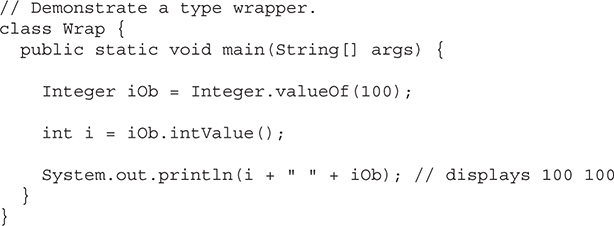
This program wraps the integer value 100 inside an Integer object called iOb. The program then obtains this value by calling intValue( ) and stores the result in i.
The process of encapsulating a value within an object is called boxing. Thus, in the program, this line boxes the value 100 into an Integer:
Integer iOb = Integer.valueOf(100);
The process of extracting a value from a type wrapper is called unboxing. For example, the program unboxes the value in iOb with this statement:
int i = iOb.intValue();
The same general procedure used by the preceding program to box and unbox values has been available for use since the original version of Java. However, today, Java provides a more streamlined approach, which is described next.
Modern versions of Java have included two important features: autoboxing and auto-unboxing. Autoboxing is the process by which a primitive type is automatically encapsulated (boxed) into its equivalent type wrapper whenever an object of that type is needed. There is no need to explicitly construct an object. Auto-unboxing is the process by which the value of a boxed object is automatically extracted (unboxed) from a type wrapper when its value is needed. There is no need to call a method such as intValue( ) or doubleValue( ).
Autoboxing and auto-unboxing greatly streamline the coding of several algorithms, removing the tedium of manually boxing and unboxing values. They also help prevent errors. Moreover, they are very important to generics, which operate only on objects. Finally, autoboxing makes working with the Collections Framework (described in Part II) much easier.
With autoboxing, it is not necessary to manually construct an object in order to wrap a primitive type. You need only assign that value to a type-wrapper reference. Java automatically constructs the object for you. For example, here is the modern way to construct an Integer object that has the value 100:
Integer iOb = 100; // autobox an int
Notice that the object is not explicitly boxed. Java handles this for you, automatically.
To unbox an object, simply assign that object reference to a primitive-type variable. For example, to unbox iOb, you can use this line:
int i = iOb; // auto-unbox
Java handles the details for you.
Here is the preceding program rewritten to use autoboxing/unboxing:
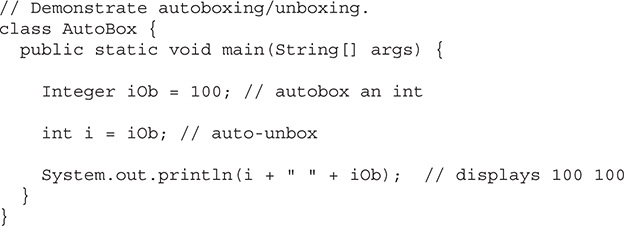
In addition to the simple case of assignments, autoboxing automatically occurs whenever a primitive type must be converted into an object; auto-unboxing takes place whenever an object must be converted into a primitive type. Thus, autoboxing/unboxing might occur when an argument is passed to a method, or when a value is returned by a method. For example, consider this:
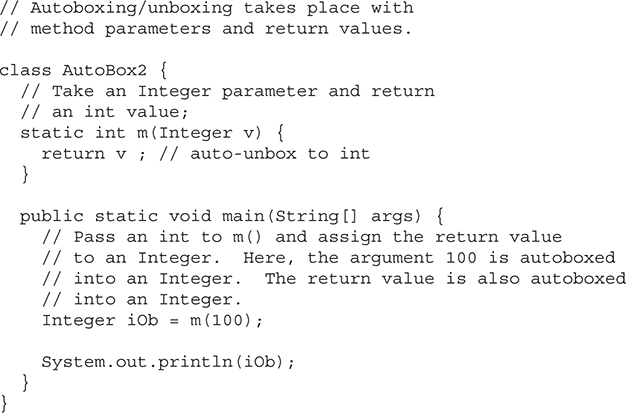
This program displays the following result:
100
In the program, notice that m( ) specifies an Integer parameter and returns an int result. Inside main( ), m( ) is passed the value 100. Because m( ) is expecting an Integer, this value is automatically boxed. Then, m( ) returns the int equivalent of its argument. This causes v to be auto-unboxed. Next, this int value is assigned to iOb in main( ), which causes the int return value to be autoboxed.
In general, autoboxing and unboxing take place whenever a conversion into an object or from an object is required. This applies to expressions. Within an expression, a numeric object is automatically unboxed. The outcome of the expression is reboxed, if necessary. For example, consider the following program:
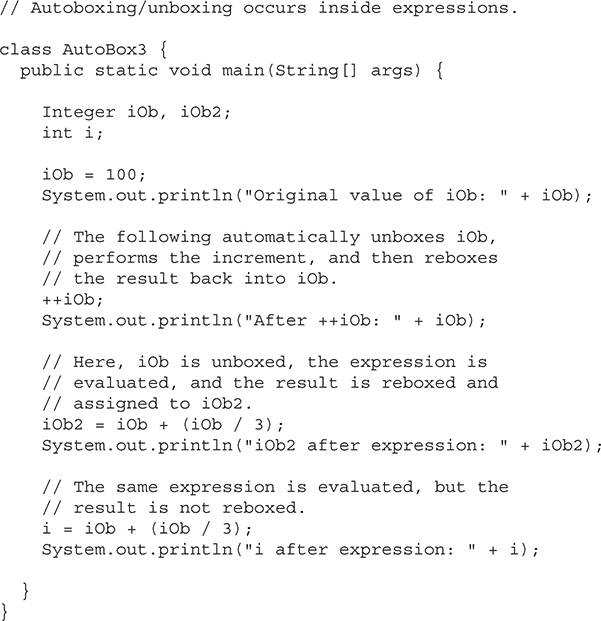
The output is shown here:

In the program, pay special attention to this line:
++iOb;
This causes the value in iOb to be incremented. It works like this: iOb is unboxed, the value is incremented, and the result is reboxed.
Auto-unboxing also allows you to mix different types of numeric objects in an expression. Once the values are unboxed, the standard type promotions and conversions are applied. For example, the following program is perfectly valid:
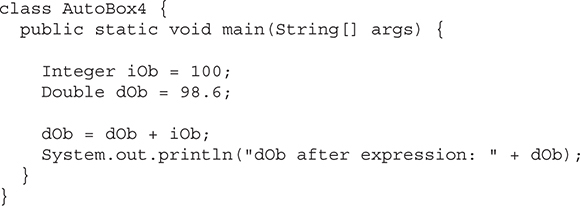
The output is shown here:
dOb after expression: 198.6
As you can see, both the Double object dOb and the Integer object iOb participated in the addition, and the result was reboxed and stored in dOb.
Because of auto-unboxing, you can use Integer numeric objects to control a switch statement. For example, consider this fragment:
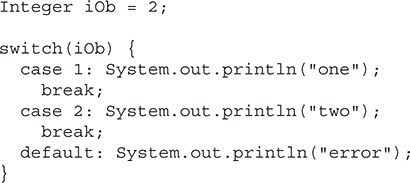
When the switch expression is evaluated, iOb is unboxed and its int value is obtained.
As the examples in the programs show, because of autoboxing/unboxing, using numeric objects in an expression is both intuitive and easy. In the early days of Java, such code would have involved casts and calls to methods such as intValue( ).
As described earlier, Java also supplies wrappers for boolean and char. These are Boolean and Character. Autoboxing/unboxing applies to these wrappers, too. For example, consider the following program:
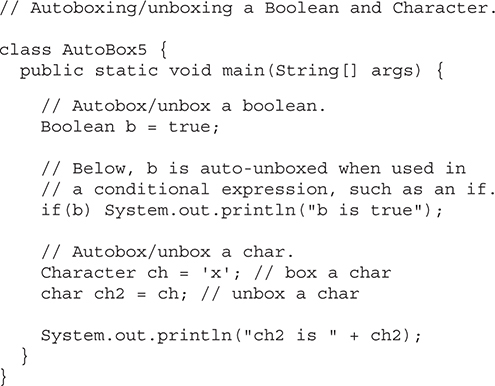
The output is shown here:
b is true
ch2 is x
The most important thing to notice about this program is the auto-unboxing of b inside the if conditional expression. As you should recall, the conditional expression that controls an if must evaluate to type boolean. Because of auto-unboxing, the boolean value contained within b is automatically unboxed when the conditional expression is evaluated. Thus, with autoboxing/unboxing, a Boolean object can be used to control an if statement.
Because of auto-unboxing, a Boolean object can now also be used to control any of Java’s loop statements. When a Boolean is used as the conditional expression of a while, for, or do/while, it is automatically unboxed into its boolean equivalent. For example, this is perfectly valid code:

In addition to the convenience that it offers, autoboxing/unboxing can also help prevent errors. For example, consider the following program:
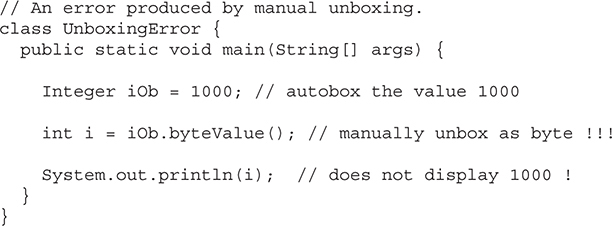
This program displays not the expected value of 1000, but –24! The reason is that the value inside iOb is manually unboxed by calling byteValue( ), which causes the truncation of the value stored in iOb, which is 1,000. This results in the garbage value of –24 being assigned to i. Auto-unboxing prevents this type of error because the value in iOb will always auto-unbox into a value compatible with int.
In general, because autoboxing always creates the proper object, and auto-unboxing always produces the proper value, there is no way for the process to produce the wrong type of object or value. In the rare instances where you want a type different than that produced by the automated process, you can still manually box and unbox values. Of course, the benefits of autoboxing/unboxing are lost. In general, you should employ autoboxing/unboxing. It is the way that modern Java code is written.
Because of autoboxing and auto-unboxing, some might be tempted to use objects such as Integer or Double exclusively, abandoning primitives altogether. For example, with autoboxing/unboxing it is possible to write code like this:
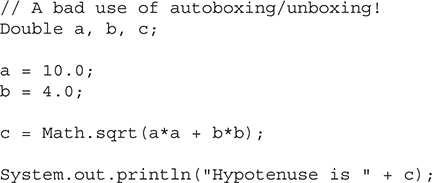
In this example, objects of type Double hold values that are used to calculate the hypotenuse of a right triangle. Although this code is technically correct and does, in fact, work properly, it is a very bad use of autoboxing/unboxing. It is far less efficient than the equivalent code written using the primitive type double. The reason is that each autobox and auto-unbox adds overhead that is not present if the primitive type is used.
In general, you should restrict your use of the type wrappers to only those cases in which an object representation of a primitive type is required. Autoboxing/unboxing was not added to Java as a “back door” way of eliminating the primitive types.
Java provides a feature that enables you to embed supplemental information into a source file. This information, called an annotation, does not change the actions of a program. Thus, an annotation leaves the semantics of a program unchanged. However, this information can be used by various tools during both development and deployment. For example, an annotation might be processed by a source-code generator. The term metadata is also used to refer to this feature, but the term annotation is the most descriptive and more commonly used.
An annotation is created through a mechanism based on the interface. Let’s begin with an example. Here is the declaration for an annotation called MyAnno:
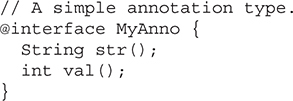
First, notice the @ that precedes the keyword interface. This tells the compiler that an annotation type is being declared. Next, notice the two members str( ) and val( ). All annotations consist solely of method declarations. However, you don’t provide bodies for these methods. Instead, Java implements these methods. Moreover, the methods act much like fields, as you will see.
An annotation cannot include an extends clause. However, all annotation types automatically extend the Annotation interface. Thus, Annotation is a super-interface of all annotations. It is declared within the java.lang.annotation package. It overrides hashCode( ), equals( ), and toString( ), which are defined by Object. It also specifies annotationType( ), which returns a Class object that represents the invoking annotation.
Once you have declared an annotation, you can use it to annotate something. Initially, annotations could be used only on declarations, and that is where we will begin. (JDK 8 added the ability to annotate type use, and this is described later in this chapter. However, the same basic techniques apply to both kinds of annotations.) Any type of declaration can have an annotation associated with it. For example, classes, methods, fields, parameters, and enum constants can be annotated. Even an annotation can be annotated. In all cases, the annotation precedes the rest of the declaration.
When you apply an annotation, you give values to its members. For example, here is an example of MyAnno being applied to a method declaration:

This annotation is linked with the method myMeth( ). Look closely at the annotation syntax. The name of the annotation, preceded by an @, is followed by a parenthesized list of member initializations. To give a member a value, that member’s name is assigned a value. Therefore, in the example, the string "Annotation Example" is assigned to the str member of MyAnno. Notice that no parentheses follow str in this assignment. When an annotation member is given a value, only its name is used. Thus, annotation members look like fields in this context.
Before exploring annotations further, it is necessary to discuss annotation retention policies. A retention policy determines at what point an annotation is discarded. Java defines three such policies, which are encapsulated within the java.lang.annotation.RetentionPolicy enumeration. They are SOURCE, CLASS, and RUNTIME.
An annotation with a retention policy of SOURCE is retained only in the source file and is discarded during compilation.
An annotation with a retention policy of CLASS is stored in the .class file during compilation. However, it is not available through the JVM during run time.
An annotation with a retention policy of RUNTIME is stored in the .class file during compilation and is available through the JVM during run time. Thus, RUNTIME retention offers the greatest annotation persistence.
Note An annotation on a local variable declaration is not retained in the .class file.
A retention policy is specified for an annotation by using one of Java’s built-in annotations: @Retention. Its general form is shown here:
@Retention(retention-policy)
Here, retention-policy must be one of the previously discussed enumeration constants. If no retention policy is specified for an annotation, then the default policy of CLASS is used.
The following version of MyAnno uses @Retention to specify the RUNTIME retention policy. Thus, MyAnno will be available to the JVM during program execution.

Although annotations are designed mostly for use by other development or deployment tools, if they specify a retention policy of RUNTIME, then they can be queried at run time by any Java program through the use of reflection. Reflection is the feature that enables information about a class to be obtained at run time. The reflection API is contained in the java.lang.reflect package. There are a number of ways to use reflection, and we won’t examine them all here. We will, however, walk through a few examples that apply to annotations.
The first step to using reflection is to obtain a Class object that represents the class whose annotations you want to obtain. Class is one of Java’s built-in classes and is defined in java.lang. It is described in detail in Part II. There are various ways to obtain a Class object. One of the easiest is to call getClass( ), which is a method defined by Object. Its general form is shown here:
final Class<?> getClass( )
It returns the Class object that represents the invoking object.
Note Notice the <?> that follows Class in the declaration of getClass( ) just shown. This is related to Java’s generics feature. getClass( ) and several other reflection-related methods discussed in this chapter make use of generics. Generics are described in Chapter 14. However, an understanding of generics is not needed to grasp the fundamental principles of reflection.
After you have obtained a Class object, you can use its methods to obtain information about the various items declared by the class, including its annotations. If you want to obtain the annotations associated with a specific item declared within a class, you must first obtain an object that represents that item. For example, Class supplies (among others) the getMethod( ), getField( ), and getConstructor( ) methods, which obtain information about a method, field, and constructor, respectively. These methods return objects of type Method, Field, and Constructor.
To understand the process, let’s work through an example that obtains the annotations associated with a method. To do this, you first obtain a Class object that represents the class, and then call getMethod( ) on that Class object, specifying the name of the method. getMethod( ) has this general form:
Method getMethod(String methName, Class<?> ... paramTypes)
The name of the method is passed in methName. If the method has arguments, then Class objects representing those types must also be specified by paramTypes. Notice that paramTypes is a varargs parameter. This means that you can specify as many parameter types as needed, including zero. getMethod( ) returns a Method object that represents the method. If the method can’t be found, NoSuchMethodException is thrown.
From a Class, Method, Field, or Constructor object, you can obtain a specific annotation associated with that object by calling getAnnotation( ). Its general form is shown here:
<A extends Annotation> getAnnotation(Class<A> annoType)
Here, annoType is a Class object that represents the annotation in which you are interested. The method returns a reference to the annotation. Using this reference, you can obtain the values associated with the annotation’s members. The method returns null if the annotation is not found, which will be the case if the annotation does not have RUNTIME retention.
Here is a program that assembles all of the pieces shown earlier and uses reflection to display the annotation associated with a method:
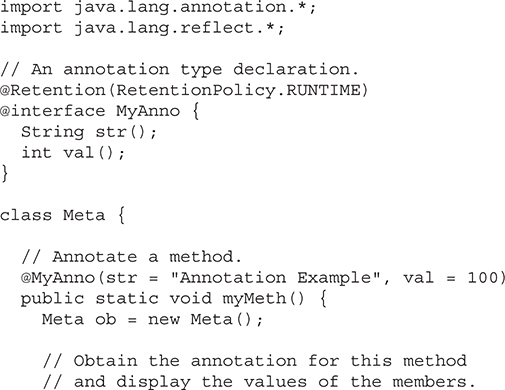
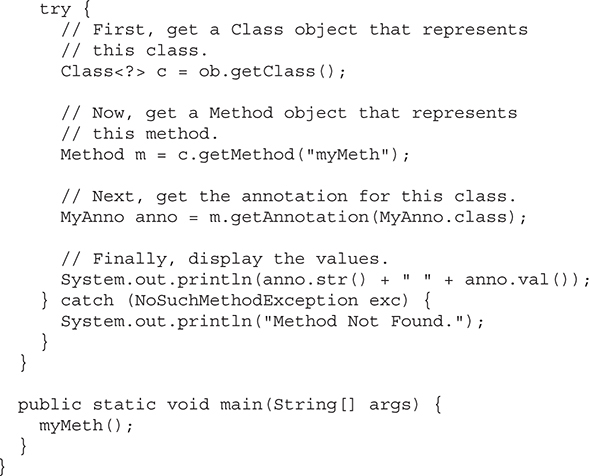
The output from the program is shown here:
Annotation Example 100
This program uses reflection as described to obtain and display the values of str and val in the MyAnno annotation associated with myMeth( ) in the Meta class. There are two things to pay special attention to. First, in this line
MyAnno anno = m.getAnnotation(MyAnno.class);
notice the expression MyAnno.class. This expression evaluates to a Class object of type MyAnno, the annotation. This construct is called a class literal. You can use this type of expression whenever a Class object of a known class is needed. For example, this statement could have been used to obtain the Class object for Meta:
Class<?> c = Meta.class;
Of course, this approach only works when you know the class name of an object in advance, which might not always be the case. In general, you can obtain a class literal for classes, interfaces, primitive types, and arrays. (Remember, the <?> syntax relates to Java’s generics feature. It is described in Chapter 14.)
The second point of interest is the way the values associated with str and val are obtained when they are output by the following line:
System.out.println(anno.str() + " " + anno.val());
Notice that they are invoked using the method-call syntax. This same approach is used whenever the value of an annotation member is required.
In the preceding example, myMeth( ) has no parameters. Thus, when getMethod( ) was called, only the name myMeth was passed. However, to obtain a method that has parameters, you must specify class objects representing the types of those parameters as arguments to getMethod( ). For example, here is a slightly different version of the preceding program:
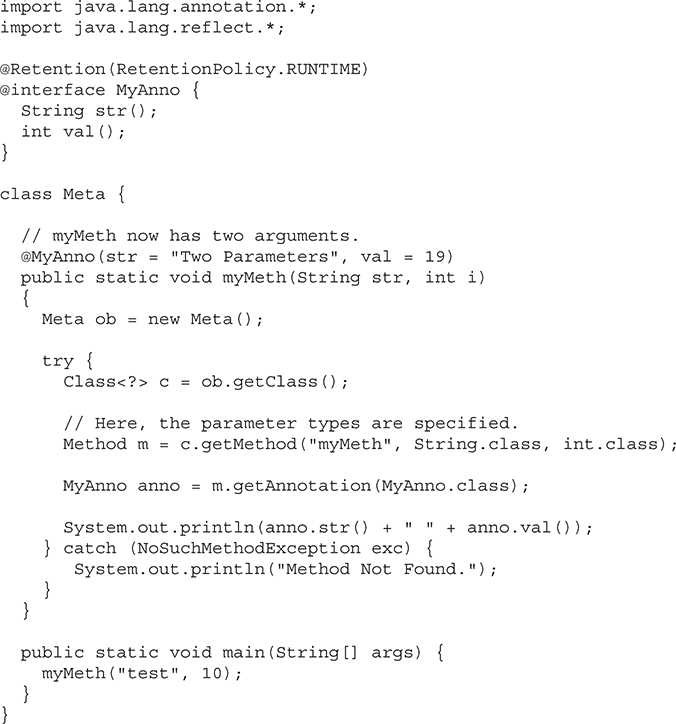
The output from this version is shown here:
Two Parameters 19
In this version, myMeth( ) takes a String and an int parameter. To obtain information about this method, getMethod( ) must be called as shown here:
Method m = c.getMethod("myMeth", String.class, int.class);
Here, the Class objects representing String and int are passed as additional arguments.
You can obtain all annotations that have RUNTIME retention that are associated with an item by calling getAnnotations( ) on that item. It has this general form:
Annotation[ ] getAnnotations( )
It returns an array of the annotations. getAnnotations( ) can be called on objects of type Class, Method, Constructor, and Field, among others.
Here is another reflection example that shows how to obtain all annotations associated with a class and with a method. It declares two annotations. It then uses those annotations to annotate a class and a method.
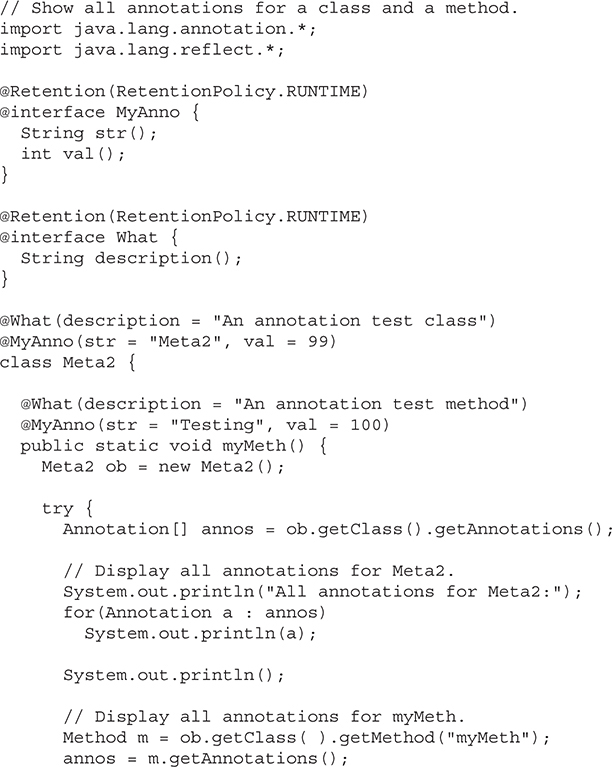
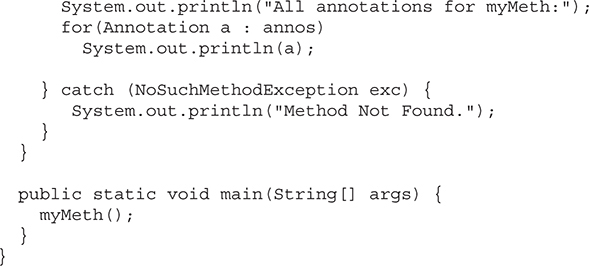
The output is shown here:

The program uses getAnnotations( ) to obtain an array of all annotations associated with the Meta2 class and with the myMeth( ) method. As explained, getAnnotations( ) returns an array of Annotation objects. Recall that Annotation is a super-interface of all annotation interfaces and that it overrides toString( ) in Object. Thus, when a reference to an Annotation is output, its toString( ) method is called to generate a string that describes the annotation, as the preceding output shows.
The methods getAnnotation( ) and getAnnotations( ) used by the preceding examples are defined by the AnnotatedElement interface, which is defined in java.lang.reflect. This interface supports reflection for annotations and is implemented by the classes Method, Field, Constructor, Class, and Package, among others.
In addition to getAnnotation( ) and getAnnotations( ), AnnotatedElement defines several other methods. Two have been available since annotations were initially added to Java. The first is getDeclaredAnnotations( ), which has this general form:
Annotation[ ] getDeclaredAnnotations( )
It returns all non-inherited annotations present in the invoking object. The second is isAnnotationPresent( ), which has this general form:
default boolean isAnnotationPresent(Class<? extends Annotation> annoType)
It returns true if the annotation specified by annoType is associated with the invoking object. It returns false otherwise. To these, JDK 8 added getDeclaredAnnotation( ), getAnnotationsByType( ), and getDeclaredAnnotationsByType( ). Of these, the last two automatically work with a repeated annotation.(Repeated annotations are discussed at the end of this chapter.)
You can give annotation members default values that will be used if no value is specified when the annotation is applied. A default value is specified by adding a default clause to a member’s declaration. It has this general form:
type member( ) default value ;
Here, value must be of a type compatible with type.
Here is @MyAnno rewritten to include default values:

This declaration gives a default value of "Testing" to str and 9000 to val. This means that neither value needs to be specified when @MyAnno is used. However, either or both can be given values if desired. Therefore, following are the four ways that @MyAnno can be used:

The following program demonstrates the use of default values in an annotation.
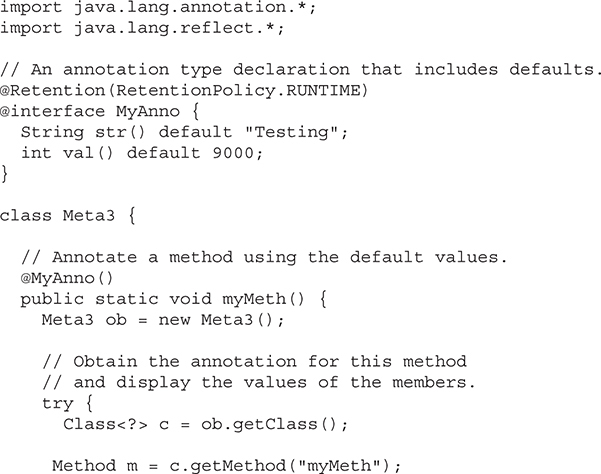
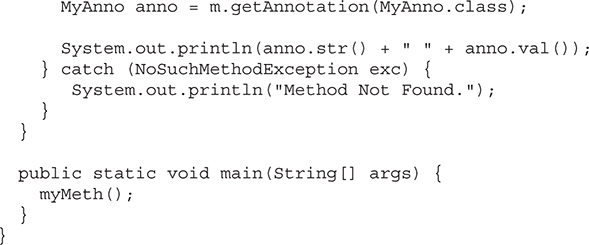
The output is shown here:
Testing 9000
A marker annotation is a special kind of annotation that contains no members. Its sole purpose is to mark an item. Thus, its presence as an annotation is sufficient. The best way to determine if a marker annotation is present is to use the method isAnnotationPresent( ), which is defined by the AnnotatedElement interface.
Here is an example that uses a marker annotation. Because a marker interface contains no members, simply determining whether it is present or absent is sufficient.
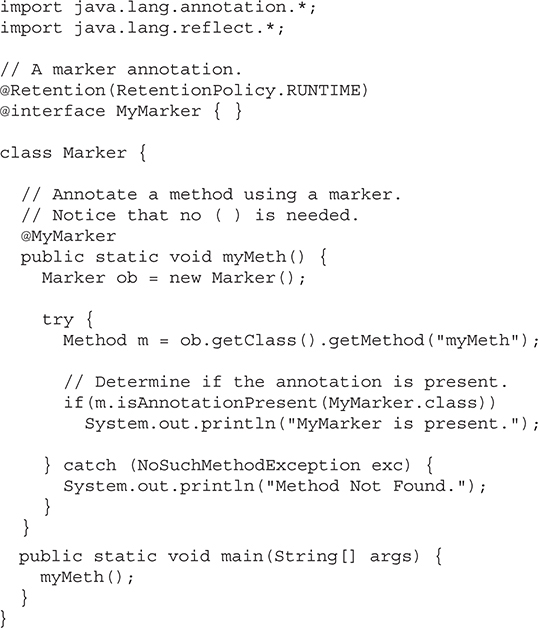
The output, shown here, confirms that @MyMarker is present:
MyMarker is present.
In the program, notice that you do not need to follow @MyMarker with parentheses when it is applied. Thus, @MyMarker is applied simply by using its name, like this:
@MyMarker
It is not wrong to supply an empty set of parentheses, but they are not needed.
A single-member annotation contains only one member. It works like a normal annotation except that it allows a shorthand form of specifying the value of the member. When only one member is present, you can simply specify the value for that member when the annotation is applied—you don’t need to specify the name of the member. However, in order to use this shorthand, the name of the member must be value.
Here is an example that creates and uses a single-member annotation:
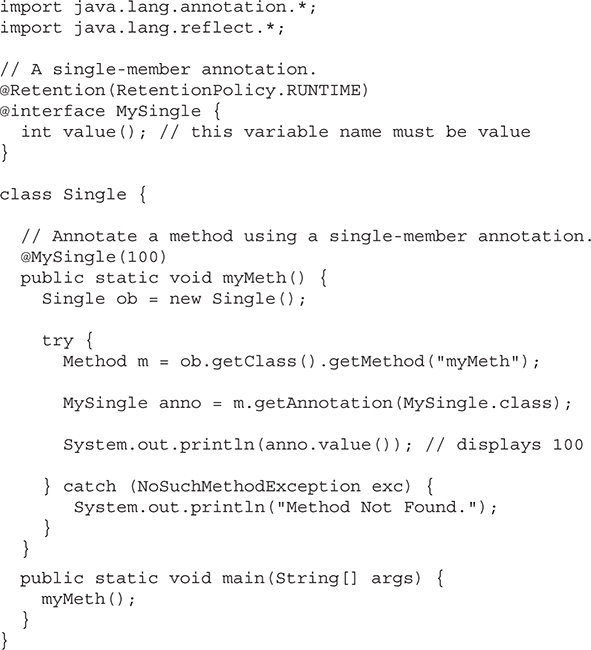
As expected, this program displays the value 100. In the program, @MySingle is used to annotate myMeth( ), as shown here:
@MySingle(100)
Notice that value = need not be specified.
You can use the single-value syntax when applying an annotation that has other members, but those other members must all have default values. For example, here the value xyz is added, with a default value of zero:

In cases in which you want to use the default for xyz, you can apply @SomeAnno, as shown next, by simply specifying the value of value by using the single-member syntax.
@SomeAnno(88)
In this case, xyz defaults to zero, and value gets the value 88. Of course, to specify a different value for xyz requires that both members be explicitly named, as shown here:
@SomeAnno(value = 88, xyz = 99)
Remember, whenever you are using a single-member annotation, the name of that member must be value.
Java defines many built-in annotations. Most are specialized, but nine are general purpose. Of these, four are imported from java.lang.annotation: @Retention, @Documented, @Target, and @Inherited. Five—@Override, @Deprecated, @FunctionalInterface, @SafeVarargs, and @SuppressWarnings—are included in java.lang. Each is described here.
Note java.lang.annotation also includes the annotations Repeatable and Native. Repeatable supports repeatable annotations, as described later in this chapter. Native annotates a field that can be accessed by native code.
@Retention is designed to be used only as an annotation to another annotation. It specifies the retention policy as described earlier in this chapter.
The @Documented annotation is a marker interface that tells a tool that an annotation is to be documented. It is designed to be used only as an annotation to an annotation declaration.
The @Target annotation specifies the types of items to which an annotation can be applied. It is designed to be used only as an annotation to another annotation. @Target takes one argument, which is an array of constants of the ElementType enumeration. This argument specifies the types of declarations to which the annotation can be applied. The constants are shown here along with the type of declaration to which they correspond:
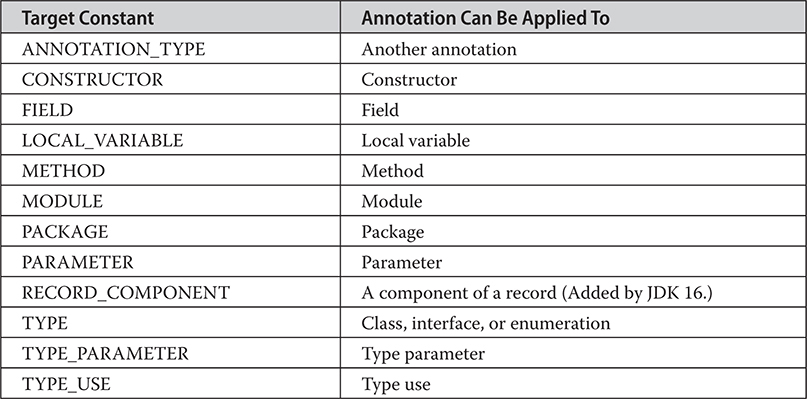
You can specify one or more of these values in a @Target annotation. To specify multiple values, you must specify them within a braces-delimited list. For example, to specify that an annotation applies only to fields and local variables, you can use this @Target annotation:
@Target( { ElementType.FIELD, ElementType.LOCAL_VARIABLE } )
If you don't use @Target, then the annotation can be used on any declaration. For this reason, it is often a good idea to explicitly specify the target or targets so as to clearly indicate the intended uses of an annotation.
@Inherited is a marker annotation that can be used only on another annotation declaration. Furthermore, it affects only annotations that will be used on class declarations. @Inherited causes the annotation for a superclass to be inherited by a subclass. Therefore, when a request for a specific annotation is made to the subclass, if that annotation is not present in the subclass, then its superclass is checked. If that annotation is present in the superclass, and if it is annotated with @Inherited, then that annotation will be returned.
@Override is a marker annotation that can be used only on methods. A method annotated with @Override must override a method from a superclass. If it doesn’t, a compile-time error will result. It is used to ensure that a superclass method is actually overridden, and not simply overloaded.
@Deprecated indicates that a declaration is obsolete and not recommended for use. Beginning with JDK 9, @Deprecated also allows you to specify the Java version in which the deprecation occurred and whether the deprecated element is slated for removal.
@FunctionalInterface is a marker annotation designed for use on interfaces. It indicates that the annotated interface is a functional interface. A functional interface is an interface that contains one and only one abstract method. Functional interfaces are used by lambda expressions. (See Chapter 15 for details on functional interfaces and lambda expressions.) If the annotated interface is not a functional interface, a compilation error will be reported. It is important to understand that @FunctionalInterface is not needed to create a functional interface. Any interface with exactly one abstract method is, by definition, a functional interface. Thus, @FunctionalInterface is purely informational.
@SafeVarargs is a marker annotation that can be applied to methods and constructors. It indicates that no unsafe actions related to a varargs parameter occur. It is used to suppress unchecked warnings on otherwise safe code as it relates to non-reifiable vararg types and parameterized array instantiation. (A non-reifiable type is, essentially, a generic type. Generics are described in Chapter 14.) It must be applied only to vararg methods or constructors. Methods must also be static, final, or private.
@SuppressWarnings specifies that one or more warnings that might be issued by the compiler are to be suppressed. The warnings to suppress are specified by name, in string form.
As mentioned earlier, annotations were originally allowed only on declarations. However, for modern versions of Java, annotations can also be specified in most cases in which a type is used. This expanded aspect of annotations is called type annotation. For example, you can annotate the return type of a method, the type of this within a method, a cast, array levels, an inherited class, and a throws clause. You can also annotate generic types, including generic type parameter bounds and generic type arguments. (See Chapter 14 for a discussion of generics.)
Type annotations are important because they enable tools to perform additional checks on code to help prevent errors. Understand that, as a general rule, javac will not perform these checks, itself. A separate tool is used for this purpose, although such a tool might operate as a compiler plug-in.
A type annotation must include ElementType.TYPE_USE as a target. (Recall that valid annotation targets are specified using the @Target annotation, as previously described.) A type annotation applies to the type that the annotation precedes. For example, assuming some type annotation called @TypeAnno, the following is legal:
void myMeth() throws @TypeAnno NullPointerException { // ...
Here, @TypeAnno annotates NullPointerException in the throws clause.
You can also annotate the type of this (called the receiver). As you know, this is an implicit argument to all instance methods and it refers to the invoking object. To annotate its type requires the use of another feature that was not originally part of Java. Beginning with JDK 8, you can explicitly declare this as the first parameter to a method. In this declaration, the type of this must be the type of its class; for example:
class SomeClass {
int myMeth(SomeClass this, int i, int j) { // ...
Here, because myMeth( ) is a method defined by SomeClass, the type of this is SomeClass. Using this declaration, you can now annotate the type of this. For example, again assuming that @TypeAnno is a type annotation, the following is legal:
int myMeth(@TypeAnno SomeClass this, int i, int j) { // ...
It is important to understand that it is not necessary to declare this unless you are annotating it. (If this is not declared, it is still implicitly passed, as it always has been.) Also, explicitly declaring this does not change any aspect of the method’s signature because this is implicitly declared, by default. Again, you will declare this only if you want to apply a type annotation to it. If you do declare this, it must be the first parameter.
The following program shows a number of the places that a type annotation can be used. It defines several annotations, of which several are for type annotation. The names and targets of the annotations are shown here:

Notice that @EmptyOK, @Recommended, and @What are not type annotations. They are included for comparison purposes. Of special interest is @What, which is used to annotate a generic type parameter declaration. The comments in the program describe each use.
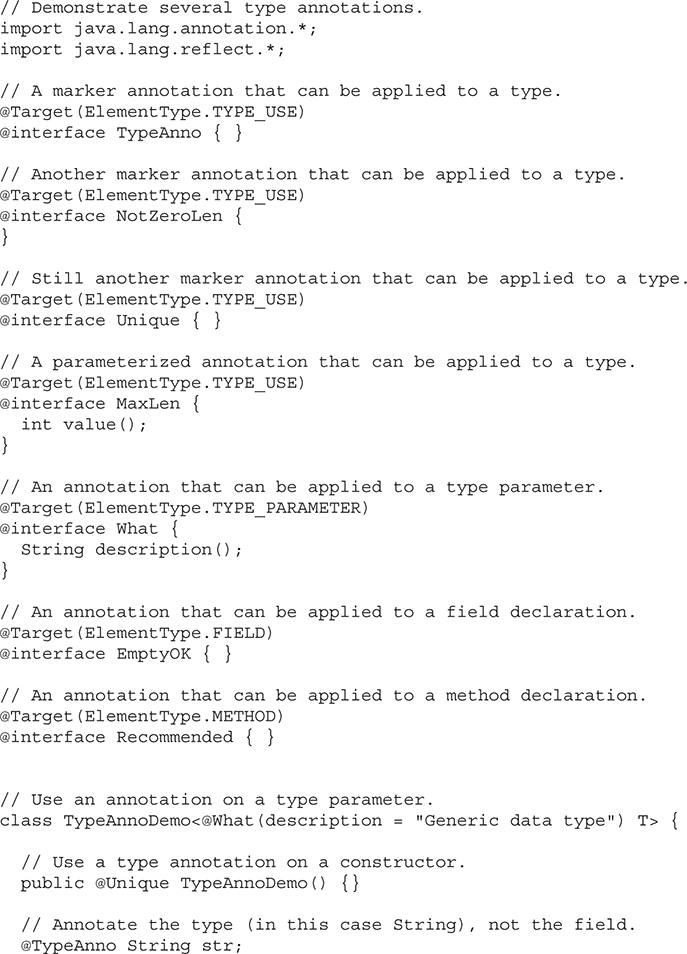
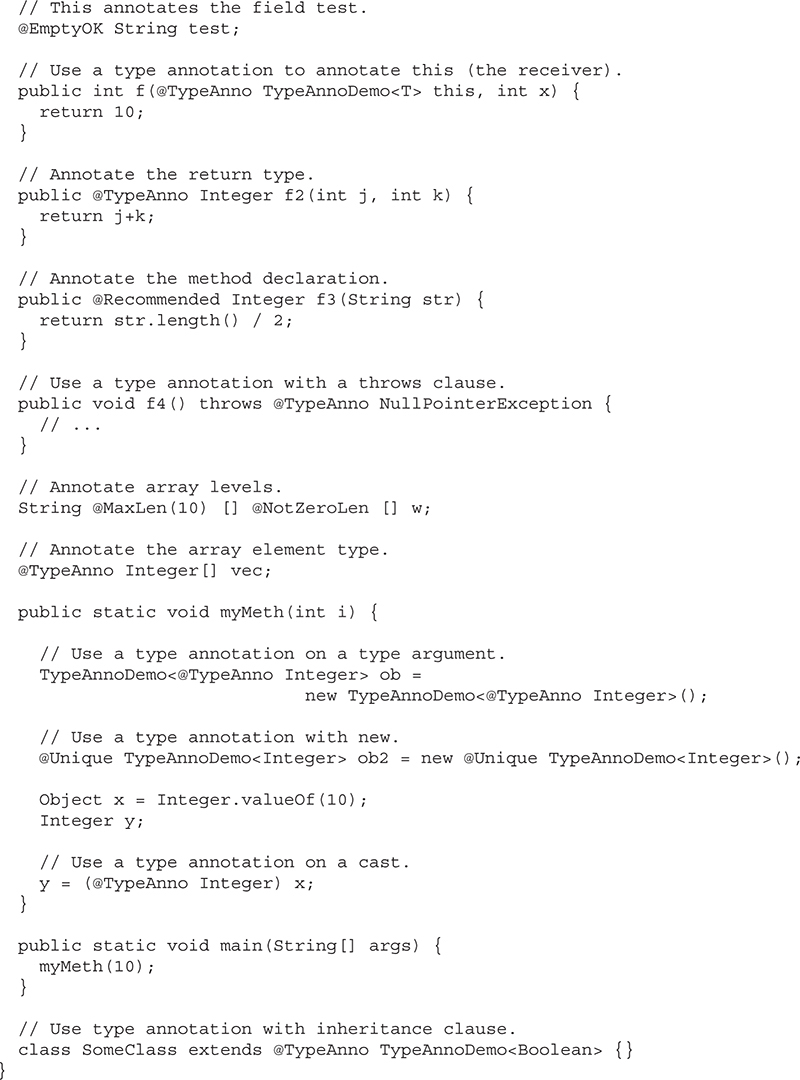
Although what most of the annotations in the preceding program refer to is clear, four uses require a bit of discussion. The first is the annotation of a method return type versus the annotation of a method declaration. In the program, pay special attention to these two method declarations:
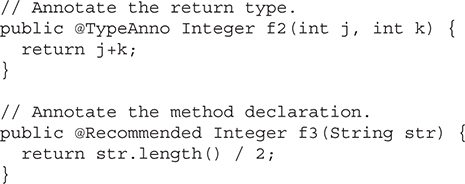
Notice that in both cases, an annotation precedes the method’s return type (which is Integer). However, the two annotations annotate two different things. In the first case, the @TypeAnno annotation annotates f2( )’s return type. This is because @TypeAnno has its target specified as ElementType.TYPE_USE, which means that it can be used to annotate type uses. In the second case, @Recommended annotates the method declaration, itself. This is because @Recommended has its target specified as ElementType.METHOD. As a result, @Recommended applies to the declaration, not the return type. Therefore, the target specification is used to eliminate what, at first glance, appears to be ambiguity between the annotation of a method declaration and the annotation of the method’s return type.
One other thing about annotating a method return type: You cannot annotate a return type of void.
The second point of interest are the field annotations, shown here:

Here, @TypeAnno annotates the type String, but @EmptyOK annotates the field test. Even though both annotations precede the entire declaration, their targets are different, based on the target element type. If the annotation has the ElementType.TYPE_USE target, then the type is annotated. If it has ElementType.FIELD as a target, then the field is annotated. Thus, the situation is similar to that just described for methods, and no ambiguity exists. The same mechanism also disambiguates annotations on local variables.
Next, notice how this (the receiver) is annotated here:
public int f(@TypeAnno TypeAnnoDemo<T> this, int x) {
Here, this is specified as the first parameter and is of type TypeAnnoDemo (which is the class of which f( ) is a member). As explained, an instance method declaration can explicitly specify the this parameter for the sake of applying a type annotation.
Finally, look at how array levels are annotated by the following statement:
String @MaxLen(10) [] @NotZeroLen [] w;
In this declaration, @MaxLen annotates the type of the first level and @NotZeroLen annotates the type of the second level. In this declaration
@TypeAnno Integer[] vec;
the element type Integer is annotated.
Beginning with JDK 8, an annotation can be repeated on the same element. This is called repeating annotations. For an annotation to be repeatable, it must be annotated with the @Repeatable annotation, defined in java.lang.annotation. Its value field specifies the container type for the repeatable annotation. The container is specified as an annotation for which the value field is an array of the repeatable annotation type. Thus, to create a repeatable annotation, you must create a container annotation and then specify that annotation type as an argument to the @Repeatable annotation.
To access the repeated annotations using a method such as getAnnotation( ), you will use the container annotation, not the repeatable annotation. The following program shows this approach. It converts the version of MyAnno shown previously into a repeatable annotation and demonstrates its use.
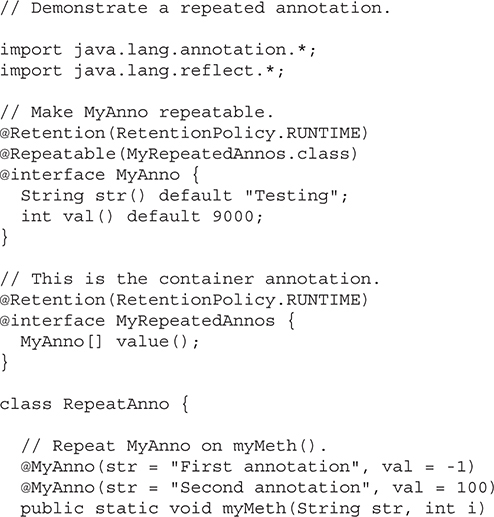
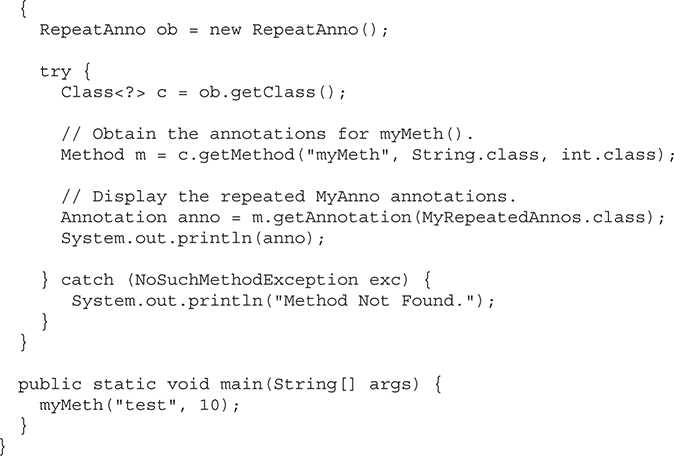
The output is shown here:

As explained, in order for MyAnno to be repeatable, it must be annotated with the @Repeatable annotation, which specifies its container annotation. The container annotation is called MyRepeatedAnnos. The program accesses the repeated annotations by calling getAnnotation( ), passing in the class of the container annotation, not the repeatable annotation, itself. As the output shows, the repeated annotations are separated by a comma. They are not returned individually.
Another way to obtain the repeated annotations is to use one of the methods in AnnotatedElement that can operate directly on a repeated annotation. These are getAnnotationsByType( ) and getDeclaredAnnotationsByType( ). Here, we will use the former. It is shown here:
default <T extends Annotation> T[ ] getAnnotationsByType(Class<T> annoType)
It returns an array of the annotations of annoType associated with the invoking object. If no annotations are present, the array will be of zero length. Here is an example. Assuming the preceding program, the following sequence uses getAnnotationsByType( ) to obtain the repeated MyAnno annotations:

Here, the repeated annotation type, which is MyAnno, is passed to getAnnotationsByType( ). The returned array contains all of the instances of MyAnno associated with myMeth( ), which, in this example, is two. Each repeated annotation can be accessed via its index in the array. In this case, each MyAnno annotation is displayed via a for-each loop.
There are a number of restrictions that apply to annotation declarations. First, no annotation can inherit another. Second, all methods declared by an annotation must be without parameters. Furthermore, they must return one of the following:
• A primitive type, such as int or double
• An object of type String or Class
• An object of an enum type
• An object of another annotation type
• An array of a legal type.
Annotations cannot be generic. In other words, they cannot take type parameters. (Generics are described in Chapter 14.) Finally, annotation methods cannot specify a throws clause.
This chapter introduces one of Java’s most important packages, java.io, which supports Java’s basic I/O (input/output) system, including file I/O. Support for I/O comes from Java’s core API libraries, not from language keywords. For this reason, an in-depth discussion of this topic is found in Part II of this book, which examines several of Java’s API packages. Here, the foundation of this important subsystem is introduced so that you can see how it fits into the larger context of the Java programming and execution environment. This chapter also examines the try-with-resources statement and several more Java keywords: transient, volatile, instanceof, native, strictfp, and assert. It concludes by discussing static import and describing another use for the this keyword.
As you may have noticed while reading the preceding 12 chapters, not much use has been made of I/O in the example programs. In fact, aside from print( ) and println( ), none of the I/O methods have been used significantly. The reason is simple: most real applications of Java are not text-based, console programs. Rather, they are either graphically oriented programs that rely on one of Java’s graphical user interface (GUI) frameworks, such as Swing, for user interaction, or they are Web applications. Although text-based, console programs are excellent as teaching examples, they do not, as a general rule, constitute an important use for Java in the real world. Also, Java’s support for console I/O is limited and somewhat awkward to use—even in simple example programs. Text-based console I/O is just not that useful in real-world Java programming.
The preceding paragraph notwithstanding, Java does provide strong, flexible support for I/O as it relates to files and networks. Java’s I/O system is cohesive and consistent. In fact, once you understand its fundamentals, the rest of the I/O system is easy to master. A general overview of I/O is presented here. A detailed description is found in Chapters 22 and 23.
Java programs perform I/O through streams. A stream is an abstraction that either produces or consumes information. A stream is linked to a physical device by the Java I/O system. All streams behave in the same manner, even if the actual physical devices to which they are linked differ. Thus, the same I/O classes and methods can be applied to different types of devices. This means that an input stream can abstract many different kinds of input: from a disk file, a keyboard, or a network socket. Likewise, an output stream may refer to the console, a disk file, or a network connection. Streams are a clean way to deal with input/output without having every part of your code understand the difference between a keyboard and a network, for example. Java implements streams within class hierarchies defined in the java.io package.
Note In addition to the stream-based I/O defined in java.io, Java also provides buffer- and channel-based I/O, which is defined in java.nio and its subpackages. They are described in Chapter 23.
Java defines two types of I/O streams: byte and character. Byte streams provide a convenient means for handling input and output of bytes. Byte streams are used, for example, when reading or writing binary data. Character streams provide a convenient means for handling input and output of characters. They use Unicode and, therefore, can be internationalized. Also, in some cases, character streams are more efficient than byte streams.
The original version of Java (Java 1.0) did not include character streams and, thus, all I/O was byte-oriented. Character streams were added by Java 1.1, and certain byte-oriented classes and methods were deprecated. Although old code that doesn’t use character streams is becoming increasingly rare, it may still be encountered from time to time. As a general rule, old code should be updated to take advantage of character streams where appropriate.
One other point: at the lowest level, all I/O is still byte-oriented. The character-based streams simply provide a convenient and efficient means for handling characters.
An overview of both byte-oriented streams and character-oriented streams is presented in the following sections.
Byte streams are defined by using two class hierarchies. At the top are two abstract classes: InputStream and OutputStream. Each of these abstract classes has several concrete subclasses that handle the differences among various devices, such as disk files, network connections, and even memory buffers. The non-deprecated byte stream classes in java.io are shown in Table 13-1. A few of these classes are discussed later in this section. Others are described in Part II of this book. Remember, to use the stream classes, you must import java.io.
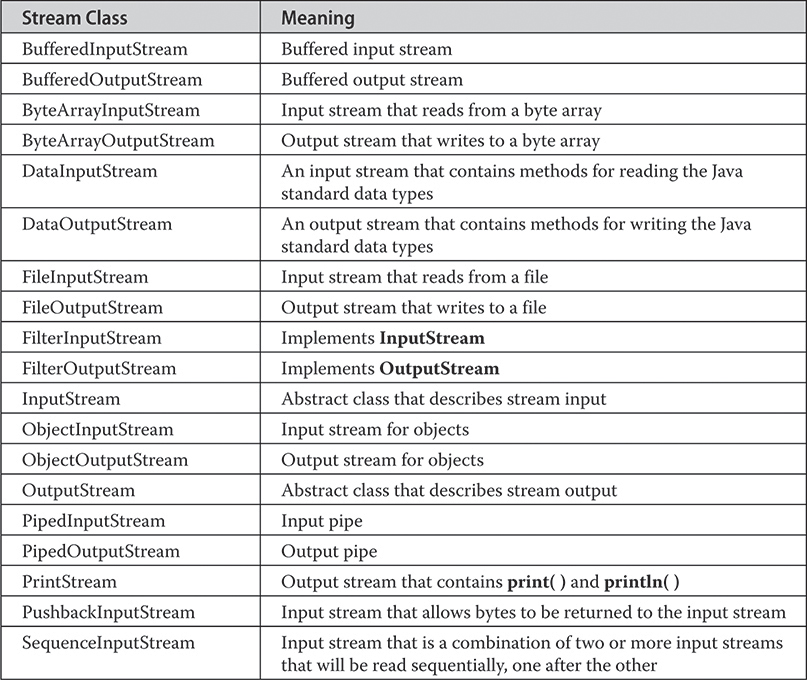
Table 13-1 The Non-Deprecated Byte Stream Classes in java.io
The abstract classes InputStream and OutputStream define several key methods that the other stream classes implement. Two of the most important are read( ) and write( ), which, respectively, read and write bytes of data. Each has a form that is abstract and must be overridden by derived stream classes.
Character streams are defined by using two class hierarchies. At the top are two abstract classes: Reader and Writer. These abstract classes handle Unicode character streams. Java has several concrete subclasses of each of these. The character stream classes in java.io are shown in Table 13-2.
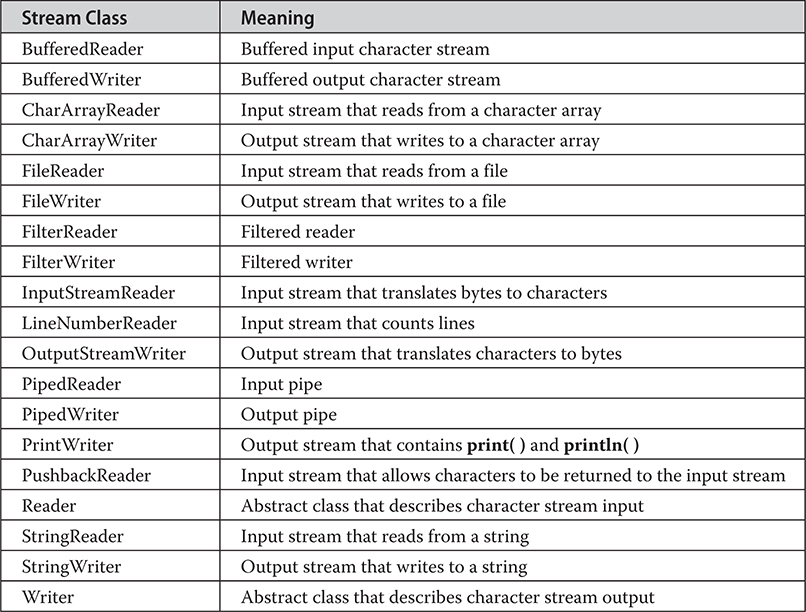
Table 13-2 The Character Stream I/O Classes in java.io
The abstract classes Reader and Writer define several key methods that the other stream classes implement. Two of the most important methods are read( ) and write( ), which read and write characters of data, respectively. Each has a form that is abstract and must be overridden by derived stream classes.
As you know, all Java programs automatically import the java.lang package. This package defines a class called System, which encapsulates several aspects of the run-time environment. For example, using some of its methods, you can obtain the current time and the settings of various properties associated with the system. System also contains three predefined stream variables: in, out, and err. These fields are declared as public, static, and final within System. This means that they can be used by any other part of your program and without reference to a specific System object.
System.out refers to the standard output stream. By default, this is the console. System.in refers to standard input, which is the keyboard by default. System.err refers to the standard error stream, which also is the console by default. However, these streams may be redirected to any compatible I/O device.
System.in is an object of type InputStream; System.out and System.err are objects of type PrintStream. These are byte streams, even though they are typically used to read and write characters from and to the console. As you will see, you can wrap these within character-based streams, if desired.
The preceding chapters have been using System.out in their examples. You can use System.err in much the same way. As explained in the next section, use of System.in is a little more complicated.
In the early days of Java, the only way to perform console input was to use a byte stream. Today, using a byte stream to read console input is still often acceptable, such as when used in example programs. However, for commercial applications, the preferred method of reading console input is to use a character-oriented stream. This makes your program easier to internationalize and maintain.
In Java, console input is accomplished (either directly or indirectly) by reading from System.in. One way to obtain a character-based stream that is attached to the console is to wrap System.in in a BufferedReader. The BufferedReader class supports a buffered input stream. A commonly used constructor is shown here:
BufferedReader(Reader inputReader)
Here, inputReader is the stream that is linked to the instance of BufferedReader that is being created. Reader is an abstract class. One of its concrete subclasses is InputStreamReader, which converts bytes to characters.
Beginning with JDK 17, the precise way you obtain an InputStreamReader linked to System.in has changed. In the past, it was common to use the following InputStreamReader constructor for this purpose:
InputStreamReader(InputStream inputStream)
Because System.in refers to an object of type InputStream, it can be used for inputStream. Thus, in the past, the following line of code shows a commonly used approach to creating a BufferedReader connected to the keyboard:
BufferedReader br = new BufferedReader(new InputStreamReader(System.in));
After this statement executes, br is a character-based stream that is linked to the console through System.in.
However, beginning with JDK 17, it is now recommended to explicitly specify the charset associated with the console when creating the InputStreamReader. A charset defines the way that bytes are mapped to characters. Normally, when a charset is not specified, the default charset of the JVM is used. However, in the case of the console, the charset used for console input may differ from this default charset. Thus, it is now recommended that this form of InputStreamReader constructor be used:
InputStreamReader(InputStream inputStream, Charset charset)
For charset, use the charset associated with the console. This charset is returned by charset( ), which is a new method added by JDK 17 to the Console class. (See Chapter 22.) You obtain a Console object by calling System.console( ). It returns a reference to the console, or null if no console is present. Therefore, today the following sequence shows one way to wrap System.in in a BufferedReader:

Of course, in cases in which you know that a console will be present, the sequence can be shortened to:

Because a console is (obviously) required to run the examples in this book, this is the form we will use.
One other point: It is also possible to obtain a Reader that is already associated with the console by use of the reader( ) method defined by Console. However, we will use the InputStreamReader approach as just described because it explicitly demonstrates the way that byte streams and character streams can interact.
To read a character from a BufferedReader, use read( ). The version of read( ) that we will be using is
int read( ) throws IOException
Each time that read( ) is called, it reads a character from the input stream and returns it as an integer value. It returns –1 when an attempt is made to read at the end of the stream. As you can see, it can throw an IOException.
The following program demonstrates read( ) by reading characters from the console until the user types a "q." Notice that any I/O exceptions that might be generated are simply thrown out of main( ). Such an approach is common when reading from the console in simple example programs such as those shown in this book, but in more sophisticated applications, you can handle the exceptions explicitly.
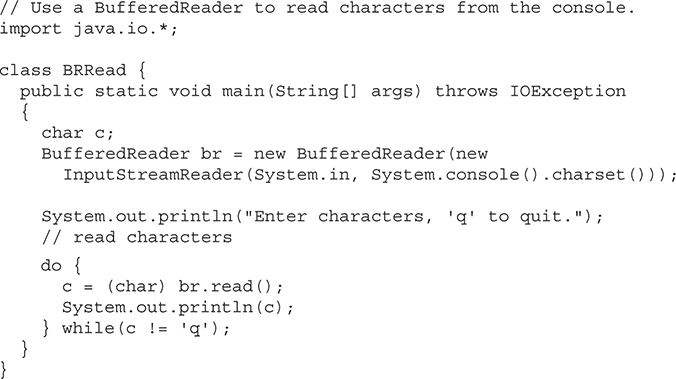
Here is a sample run:
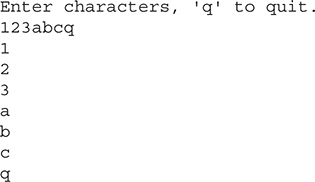
This output may look a little different from what you expected because System.in is line buffered, by default. This means that no input is actually passed to the program until you press ENTER. As you can guess, this does not make read( ) particularly valuable for interactive console input.
To read a string from the keyboard, use the version of readLine( ) that is a member of the BufferedReader class. Its general form is shown here:
String readLine( ) throws IOException
As you can see, it returns a String object.
The following program demonstrates BufferedReader and the readLine( ) method; the program reads and displays lines of text until you enter the word "stop":
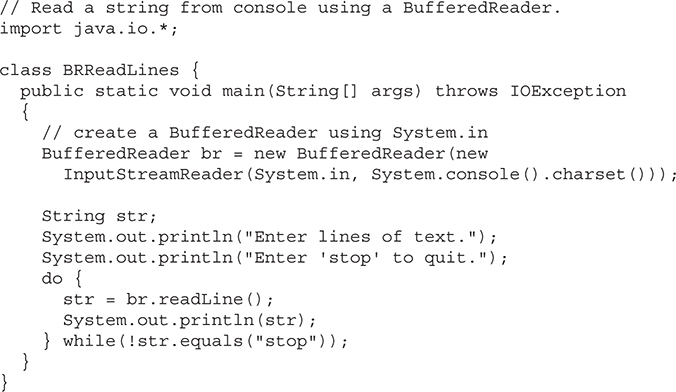
The next example creates a tiny text editor. It creates an array of String objects and then reads in lines of text, storing each line in the array. It will read up to 100 lines or until you enter "stop." It uses a BufferedReader to read from the console.
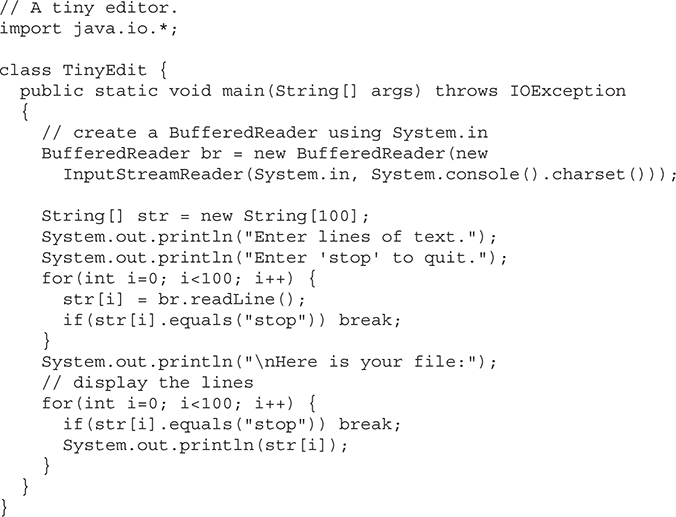
Here is a sample run:
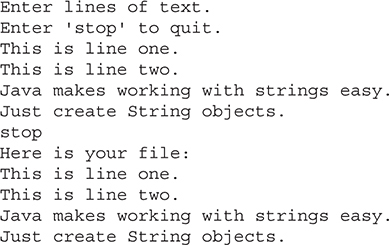
Console output is most easily accomplished with print( ) and println( ), described earlier, which are used in most of the examples in this book. These methods are defined by the class PrintStream (which is the type of object referenced by System.out). Even though System.out is a byte stream, using it for simple program output is still acceptable. However, a character-based alternative is described in the next section.
Because PrintStream is an output stream derived from OutputStream, it also implements the low-level method write( ). Thus, write( ) can be used to write to the console. The simplest form of write( ) defined by PrintStream is shown here:
void write(int byteval)
This method writes the byte specified by byteval. Although byteval is declared as an integer, only the low-order eight bits are written. Here is a short example that uses write( ) to output the character "A" followed by a newline to the screen:
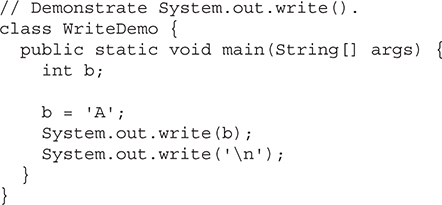
You will not often use write( ) to perform console output (although doing so might be useful in some situations) because print( ) and println( ) are substantially easier to use.
Although using System.out to write to the console is acceptable, its use is probably best for debugging purposes or for sample programs, such as those found in this book. For real-world programs, the recommended method of writing to the console when using Java is through a PrintWriter stream. PrintWriter is one of the character-based classes. Using a character-based class for console output makes internationalizing your program easier.
PrintWriter defines several constructors. The one we will use is shown here:
PrintWriter(OutputStream outputStream, boolean flushingOn)
Here, outputStream is an object of type OutputStream, and flushingOn controls whether Java flushes the output stream every time a println( ) method (among others) is called. If flushingOn is true, flushing automatically takes place. If false, flushing is not automatic.
PrintWriter supports the print( ) and println( ) methods. Thus, you can use these methods in the same way as you used them with System.out. If an argument is not a simple type, the PrintWriter methods call the object’s toString( ) method and then display the result.
To write to the console by using a PrintWriter, specify System.out for the output stream and automatic flushing. For example, this line of code creates a PrintWriter that is connected to console output:
PrintWriter pw = new PrintWriter(System.out, true);
The following application illustrates using a PrintWriter to handle console output:
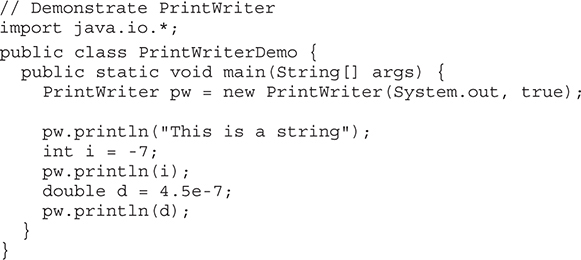
The output from this program is shown here:

Remember, there is nothing wrong with using System.out to write simple text output to the console when you are learning Java or debugging your programs. However, using a PrintWriter makes your real-world applications easier to internationalize. Because no advantage is gained by using a PrintWriter in the sample programs shown in this book, we will continue to use System.out to write to the console.
Java provides a number of classes and methods that allow you to read and write files. Before we begin, it is important to state that the topic of file I/O is quite large and file I/O is examined in detail in Part II. The purpose of this section is to introduce the basic techniques that read from and write to a file. Although byte streams are used, these techniques can be adapted to the character-based streams.
Two of the most often-used stream classes are FileInputStream and FileOutputStream, which create byte streams linked to files. To open a file, you simply create an object of one of these classes, specifying the name of the file as an argument to the constructor. Although both classes support additional constructors, the following are the forms that we will be using:
FileInputStream(String fileName) throws FileNotFoundException
FileOutputStream(String fileName) throws FileNotFoundException
Here, fileName specifies the name of the file that you want to open. When you create an input stream, if the file does not exist, then FileNotFoundException is thrown. For output streams, if the file cannot be opened or created, then FileNotFoundException is thrown. FileNotFoundException is a subclass of IOException. When an output file is opened, any preexisting file by the same name is destroyed.
Note In situations in which a security manager is present, several of the file classes, including FileInputStream and FileOutputStream, will throw a SecurityException if a security violation occurs when attempting to open a file. By default, applications run via java do not use a security manager. For that reason, the I/O examples in this book do not need to watch for a possible SecurityException. However, other types of applications may use the security manager, and file I/O performed by such an application could generate a SecurityException. In that case, you will need to appropriately handle this exception. Be aware that JDK 17 deprecates the security manager for removal.
When you are done with a file, you must close it. This is done by calling the close( ) method, which is implemented by both FileInputStream and FileOutputStream. It is shown here:
void close( ) throws IOException
Closing a file releases the system resources allocated to the file, allowing them to be used by another file. Failure to close a file can result in “memory leaks” because of unused resources remaining allocated.
Note The close( ) method is specified by the AutoCloseable interface in java.lang. AutoCloseable is inherited by the Closeable interface in java.io. Both interfaces are implemented by the stream classes, including FileInputStream and FileOutputStream.
Before moving on, it is important to point out that there are two basic approaches that you can use to close a file when you are done with it. The first is the traditional approach, in which close( ) is called explicitly when the file is no longer needed. This is the approach used by all versions of Java prior to JDK 7 and is, therefore, found in all pre-JDK 7 legacy code. The second is to use the try-with-resources statement added by JDK 7, which automatically closes a file when it is no longer needed. In this approach, no explicit call to close( ) is executed. Since you may still encounter pre-JDK 7 legacy code, it is important that you know and understand the traditional approach. Furthermore, the traditional approach could still be the best approach in some situations. Therefore, we will begin with it. The automated approach is described in the following section.
To read from a file, you can use a version of read( ) that is defined within FileInputStream. The one that we will use is shown here:
int read( ) throws IOException
Each time that it is called, it reads a single byte from the file and returns the byte as an integer value. read( ) returns –1 when an attempt is made to read at the end of the stream. It can throw an IOException.
The following program uses read( ) to input and display the contents of a file that contains ASCII text. The name of the file is specified as a command-line argument.
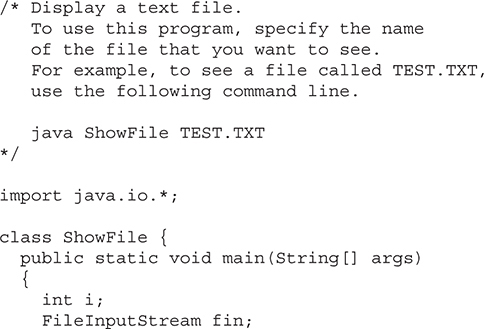
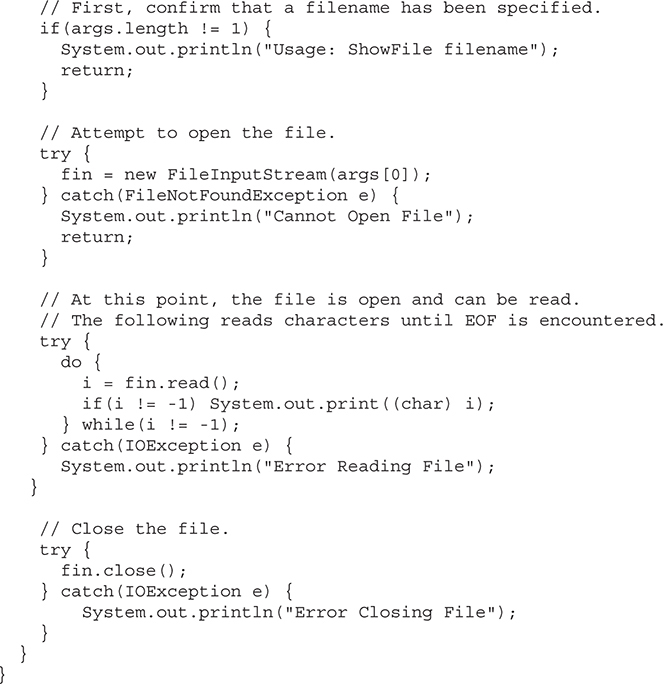
In the program, notice the try/catch blocks that handle the I/O errors that might occur. Each I/O operation is monitored for exceptions, and if an exception occurs, it is handled. Be aware that in simple programs or example code, it is common to see I/O exceptions simply thrown out of main( ), as was done in the earlier console I/O examples. Also, in some real-world code, it can be helpful to let an exception propagate to a calling routine to let the caller know that an I/O operation failed. However, most of the file I/O examples in this book handle all I/O exceptions explicitly, as shown, for the sake of illustration.
Although the preceding example closes the file stream after the file is read, there is a variation that is often useful. The variation is to call close( ) within a finally block. In this approach, all of the methods that access the file are contained within a try block, and the finally block is used to close the file. This way, no matter how the try block terminates, the file is closed. Assuming the preceding example, here is how the try block that reads the file can be recoded:

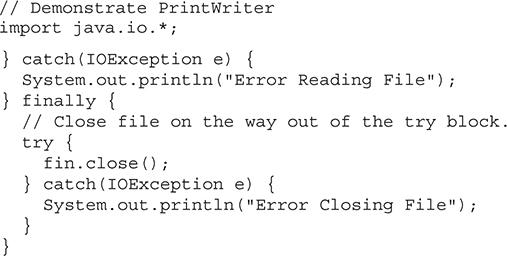
Although not an issue in this case, one advantage to this approach in general is that if the code that accesses a file terminates because of some non-I/O related exception, the file is still closed by the finally block.
Sometimes it’s easier to wrap the portions of a program that open the file and access the file within a single try block (rather than separating the two) and then use a finally block to close the file. For example, here is another way to write the ShowFile program:
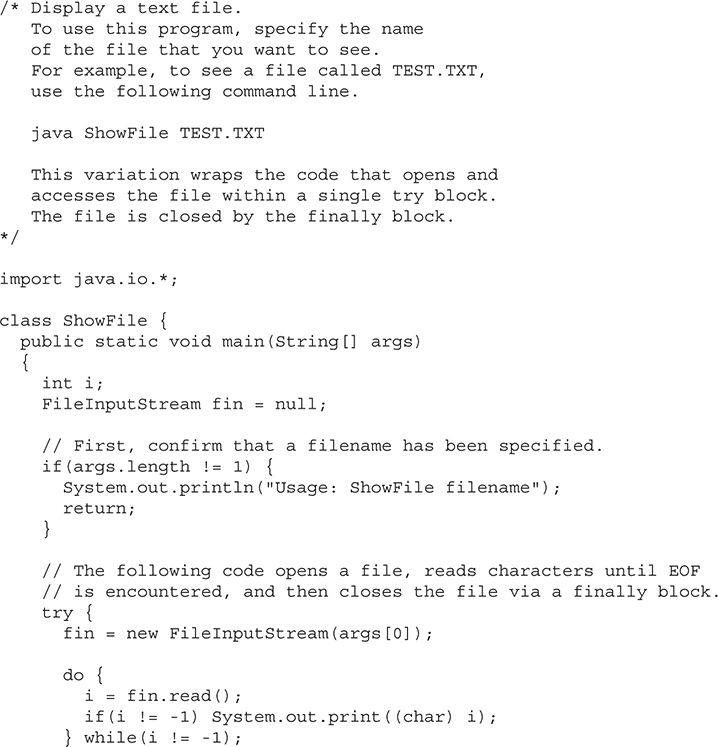
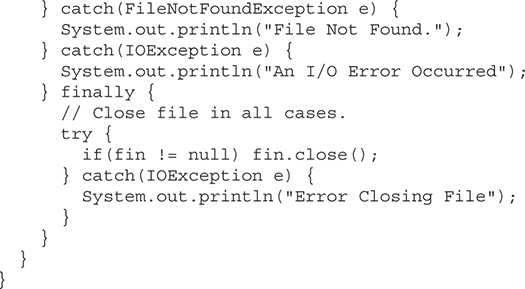
In this approach, notice that fin is initialized to null. Then, in the finally block, the file is closed only if fin is not null. This works because fin will be non-null only if the file is successfully opened. Thus, close( ) is not called if an exception occurs while opening the file.
It is possible to make the try/catch sequence in the preceding example a bit more compact. Because FileNotFoundException is a subclass of IOException, it need not be caught separately. For example, here is the sequence recoded to eliminate catching FileNotFoundException. In this case, the standard exception message, which describes the error, is displayed.
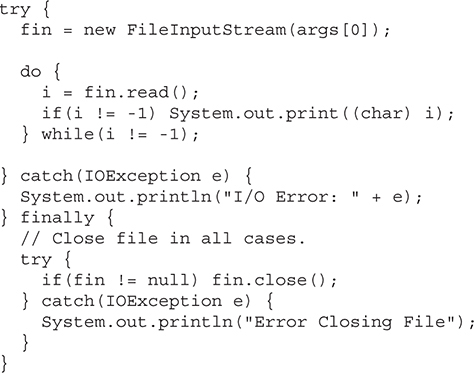
In this approach, any error, including an error opening the file, is simply handled by the single catch statement. Because of its compactness, this approach is used by many of the I/O examples in this book. Be aware, however, that this approach is not appropriate in cases in which you want to deal separately with a failure to open a file, such as might be caused if a user mistypes a filename. In such a situation, you might want to prompt for the correct name, for example, before entering a try block that accesses the file.
To write to a file, you can use the write( ) method defined by FileOutputStream. Its simplest form is shown here:
void write(int byteval) throws IOException
This method writes the byte specified by byteval to the file. Although byteval is declared as an integer, only the low-order eight bits are written to the file. If an error occurs during writing, an IOException is thrown. The next example uses write( ) to copy a file:
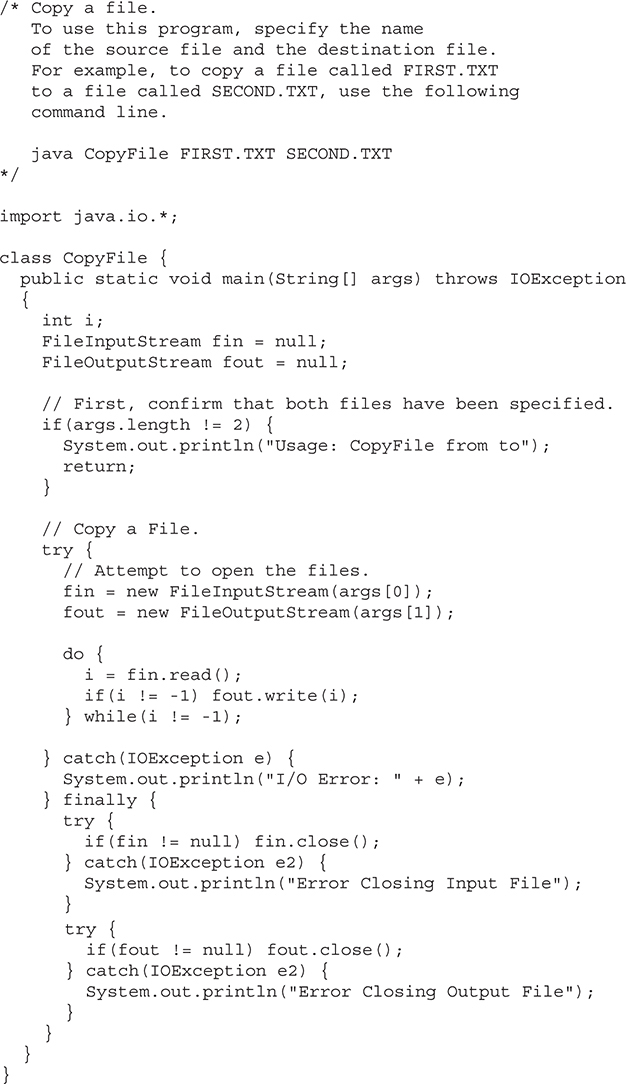
In the program, notice that two separate try blocks are used when closing the files. This ensures that both files are closed, even if the call to fin.close( ) throws an exception.
In general, notice that all potential I/O errors are handled in the preceding two programs by the use of exceptions. This differs from some computer languages that use error codes to report file errors. Not only do exceptions make file handling cleaner, but they also enable Java to easily differentiate the end-of-file condition from file errors when input is being performed.
In the preceding section, the example programs have made explicit calls to close( ) to close a file once it is no longer needed. As mentioned, this is the way files were closed when using versions of Java prior to JDK 7. Although this approach is still valid and useful, JDK 7 added a feature that offers another way to manage resources, such as file streams, by automating the closing process. This feature, sometimes referred to as automatic resource management, or ARM for short, is based on an expanded version of the try statement. The principal advantage of automatic resource management is that it prevents situations in which a file (or other resource) is inadvertently not released after it is no longer needed. As explained, forgetting to close a file can result in memory leaks, and could lead to other problems.
Automatic resource management is based on an expanded form of the try statement. Here is its general form:
try (resource-specification) {
// use the resource
}
Typically, resource-specification is a statement that declares and initializes a resource, such as a file stream. It consists of a variable declaration in which the variable is initialized with a reference to the object being managed. When the try block ends, the resource is automatically released. In the case of a file, this means that the file is automatically closed. (Thus, there is no need to call close( ) explicitly.) Of course, this form of try can also include catch and finally clauses. This form of try is called the try-with-resources statement.
Note Beginning with JDK 9, it is also possible for the resource specification of the try to consist of a variable that has been declared and initialized earlier in the program. However, that variable must be effectively final, which means that it has not been assigned a new value after being given its initial value.
The try-with-resources statement can be used only with those resources that implement the AutoCloseable interface defined by java.lang. This interface defines the close( ) method. AutoCloseable is inherited by the Closeable interface in java.io. Both interfaces are implemented by the stream classes. Thus, try-with-resources can be used when working with streams, including file streams.
As a first example of automatically closing a file, here is a reworked version of the ShowFile program that uses it:
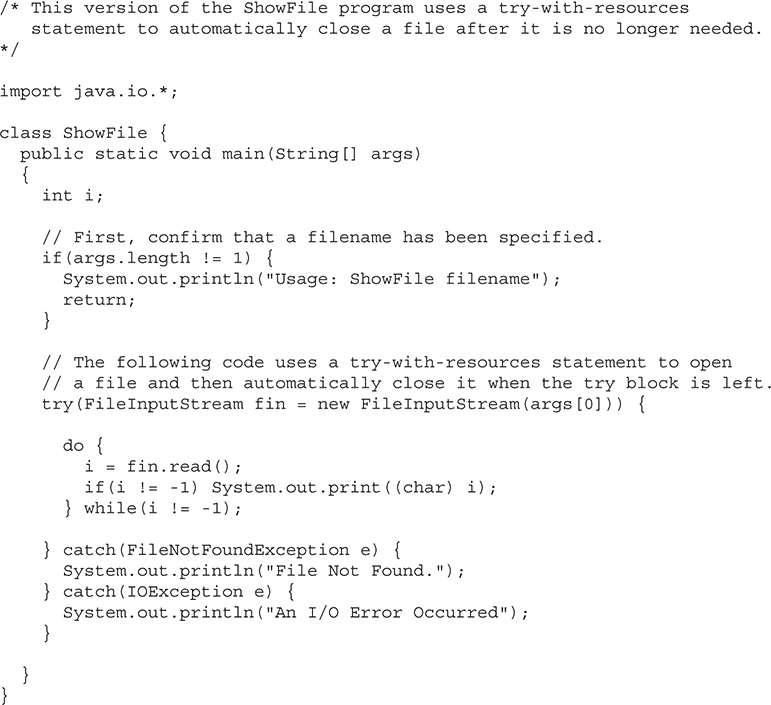
In the program, pay special attention to how the file is opened within the try statement:
try(FileInputStream fin = new FileInputStream(args[0])) {
Notice how the resource-specification portion of the try declares a FileInputStream called fin, which is then assigned a reference to the file opened by its constructor. Thus, in this version of the program, the variable fin is local to the try block, being created when the try is entered. When the try is left, the stream associated with fin is automatically closed by an implicit call to close( ). You don’t need to call close( ) explicitly, which means that you can’t forget to close the file. This is a key advantage of using try-with-resources.
It is important to understand that a resource declared in the try statement is implicitly final. This means that you can’t assign to the resource after it has been created. Also, the scope of the resource is limited to the try-with-resources statement.
Before moving on it is useful to mention that beginning with JDK 10, you can use local variable type inference to specify the type of the resource declared in a try-with-resources statement. To do so, specify the type as var. When this is done, the type of the resource is inferred from its initializer. For example, the try statement in the preceding program can now be written like this:
try(var fin = new FileInputStream(args[0])) {
Here, fin is inferred to be of type FileInputStream because that is the type of its initializer. Because a number of readers will be working in Java environments that predate JDK 10, try-with-resource statements in the remainder of this book will not make use of type inference so that the code works for as many readers as possible. Of course, going forward, you should consider using type inference in your own code.
You can manage more than one resource within a single try statement. To do so, simply separate each resource specification with a semicolon. The following program shows an example. It reworks the CopyFile program shown earlier so that it uses a single try-with-resources statement to manage both fin and fout.
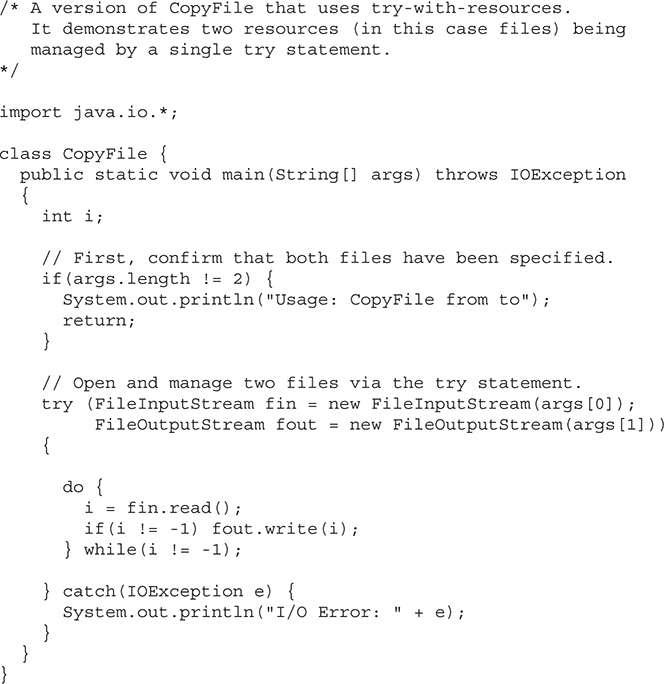
In this program, notice how the input and output files are opened within the try block:

After this try block ends, both fin and fout will have been closed. If you compare this version of the program to the previous version, you will see that it is much shorter. The ability to streamline source code is a side-benefit of automatic resource management.
There is one other aspect to try-with-resources that needs to be mentioned. In general, when a try block executes, it is possible that an exception inside the try block will lead to another exception that occurs when the resource is closed in a finally clause. In the case of a “normal” try statement, the original exception is lost, being preempted by the second exception. However, when using try-with-resources, the second exception is suppressed. It is not, however, lost. Instead, it is added to the list of suppressed exceptions associated with the first exception. The list of suppressed exceptions can be obtained by using the getSuppressed( ) method defined by Throwable.
Because of the benefits that the try-with-resources statement offers, it will be used by many, but not all, of the example programs in this edition of this book. Some of the examples will still use the traditional approach to closing a resource. There are several reasons for this. First, you may encounter legacy code that still relies on the traditional approach. It is important that all Java programmers be fully versed in, and comfortable with, the traditional approach when maintaining this older code. Second, it is possible that some programmers will continue to work in a pre-JDK 7 environment for a period of time. In such situations, the expanded form of try is not available. Finally, there may be cases in which explicitly closing a resource is more appropriate than the automated approach. For these reasons, some of the examples in this book will continue to use the traditional approach, explicitly calling close( ). In addition to illustrating the traditional technique, these examples can also be compiled and run by all readers in all environments.
Remember A few examples in this book use the traditional approach to closing files as a means of illustrating this technique, which is widely used in legacy code. However, for new code, you will usually want to use the automated approach supported by the try-with-resources statement just described.
Java defines two interesting type modifiers: transient and volatile. These modifiers are used to handle somewhat specialized situations.
When an instance variable is declared as transient, its value need not persist when an object is stored. For example:

Here, if an object of type T is written to a persistent storage area, the contents of a would not be saved, but the contents of b would.
The volatile modifier tells the compiler that the variable modified by volatile can be changed unexpectedly by other parts of your program. One of these situations involves multithreaded programs. In a multithreaded program, sometimes two or more threads share the same variable. For efficiency considerations, each thread can keep its own, private copy of such a shared variable. The real (or master) copy of the variable is updated at various times, such as when a synchronized method is entered. While this approach works fine, it may be inefficient at times. In some cases, all that really matters is that the master copy of a variable always reflects its current state. To ensure this, simply specify the variable as volatile, which tells the compiler that it must always use the master copy of a volatile variable (or, at least, always keep any private copies up-to-date with the master copy, and vice versa). Also, accesses to the shared variable must be executed in the precise order indicated by the program.
Sometimes, knowing the type of an object during run time is useful. For example, you might have one thread of execution that generates various types of objects, and another thread that processes these objects. In this situation, it might be useful for the processing thread to know the type of each object when it receives it. Another situation in which knowledge of an object’s type at run time is important involves casting. In Java, an invalid cast causes a run-time error. Many invalid casts can be caught at compile time. However, casts involving class hierarchies can produce invalid casts that can be detected only at run time. For example, a superclass called A can produce two subclasses, called B and C. Thus, casting a B object into type A or casting a C object into type A is legal, but casting a B object into type C (or vice versa) isn’t legal. Because an object of type A can refer to objects of either B or C, how can you know, at run time, what type of object is actually being referred to before attempting the cast to type C? It could be an object of type A, B, or C. If it is an object of type B, a run-time exception will be thrown. Java provides the run-time operator instanceof to answer this question.
Before we begin, it is necessary to state that instanceof was significantly enhanced by JDK 17 with a powerful new feature based on pattern matching. Here, the traditional form of instanceof is introduced. The enhanced form is covered in Chapter 17.
The traditional instanceof operator has this general form:
objref instanceof type
Here, objref is a reference to an instance of a class, and type is a class type. If objref is of the specified type or can be cast into the specified type, then the instanceof operator evaluates to true. Otherwise, its result is false. Thus, instanceof is the means by which your program can obtain run-time type information about an object.
The following program demonstrates instanceof:
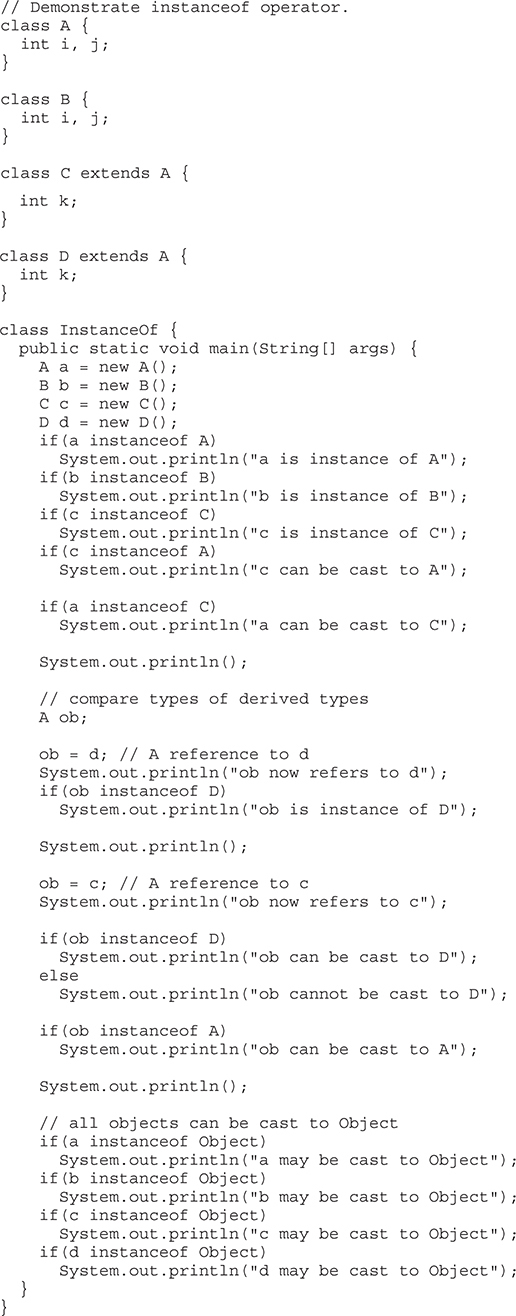
The output from this program is shown here:
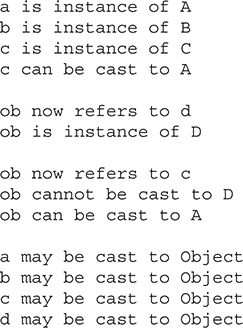
The instanceof operator isn’t needed by most simple programs, because, often, you know the type of object with which you are working. However, it can be very useful when you’re writing generalized routines that operate on objects of a complex class hierarchy or that are created from code outside your direct control. As you will see, the pattern matching enhancements described in Chapter 17 streamline its use.
With the creation of Java 2 several years ago, the floating-point computation model was relaxed slightly. Specifically, the new model did not require the truncation of certain intermediate values that occur during a computation. This prevented overflow or underflow in some cases. By modifying a class, a method, or interface with strictfp, you could ensure that floating-point calculations (and thus all truncations) took place precisely as they did in earlier versions of Java. When a class was modified by strictfp, all the methods in the class were also modified by strictfp automatically. However, beginning with JDK 17, all floating-point computations are now strict, and strictfp is obsolete and no longer required. Its use will now generate a warning message.
For versions of Java prior to JDK 17, the following example illustrates strictfp. It tells Java to use the original floating-point model for calculations in all methods defined within MyClass:
strictfp class MyClass { //...
Frankly, most programmers never needed to use strictfp, because it affected only a very small class of problems.
Remember Beginning with JDK 17, stricfp has been rendered obsolete and its use will now generate a warning message.
Although it is rare, occasionally you may want to call a subroutine that is written in a language other than Java. Typically, such a subroutine exists as executable code for the CPU and environment in which you are working—that is, native code. For example, you may want to call a native code subroutine to achieve faster execution time. Or, you may want to use a specialized, third-party library, such as a statistical package. However, because Java programs are compiled to bytecode, which is then interpreted (or compiled on-the-fly) by the Java run-time system, it would seem impossible to call a native code subroutine from within your Java program. Fortunately, this conclusion is false. Java provides the native keyword, which is used to declare native code methods. Once declared, these methods can be called from inside your Java program just as you call any other Java method.
To declare a native method, precede the method with the native modifier, but do not define any body for the method. For example:
public native int meth() ;
After you declare a native method, you must write the native method and follow a rather complex series of steps to link it with your Java code. Consult the Java documentation for current details.
Another interesting keyword is assert. It is used during program development to create an assertion, which is a condition that should be true during the execution of the program. For example, you might have a method that should always return a positive integer value. You might test this by asserting that the return value is greater than zero using an assert statement. At run time, if the condition is true, no other action takes place. However, if the condition is false, then an AssertionError is thrown. Assertions are often used during testing to verify that some expected condition is actually met. They are not usually used for released code.
The assert keyword has two forms. The first is shown here:
assert condition;
Here, condition is an expression that must evaluate to a Boolean result. If the result is true, then the assertion is true and no other action takes place. If the condition is false, then the assertion fails and a default AssertionError object is thrown.
The second form of assert is shown here:
assert condition: expr ;
In this version, expr is a value that is passed to the AssertionError constructor. This value is converted to its string format and displayed if an assertion fails. Typically, you will specify a string for expr, but any non-void expression is allowed as long as it defines a reasonable string conversion.
Here is an example that uses assert. It verifies that the return value of getnum( ) is positive.
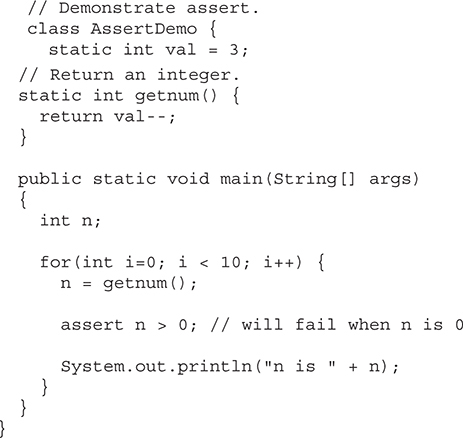
To enable assertion checking at run time, you must specify the -ea option. For example, to enable assertions for AssertDemo, execute it using this line:
java -ea AssertDemo
After compiling and running as just described, the program creates the following output:

In main( ), repeated calls are made to the method getnum( ), which returns an integer value. The return value of getnum( ) is assigned to n and then tested using this assert statement:
assert n > 0; // will fail when n is 0
This statement will fail when n equals 0, which it will after the fourth call. When this happens, an exception is thrown.
As explained, you can specify the message displayed when an assertion fails. For example, if you substitute
assert n > 0 : "n is not positive!";
for the assertion in the preceding program, then the following output will be generated:

One important point to understand about assertions is that you must not rely on them to perform any action actually required by the program. The reason is that normally, released code will be run with assertions disabled. For example, consider this variation of the preceding program:
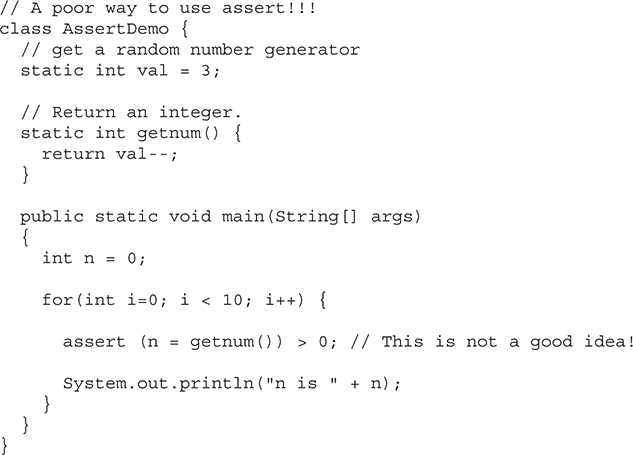
In this version of the program, the call to getnum( ) is moved inside the assert statement. Although this works fine if assertions are enabled, it will cause a malfunction when assertions are disabled, because the call to getnum( ) will never be executed! In fact, n must now be initialized, because the compiler will recognize that it might not be assigned a value by the assert statement.
Assertions can be quite useful because they streamline the type of error checking that is common during development. For example, prior to assert, if you wanted to verify that n was positive in the preceding program, you had to use a sequence of code similar to this:

With assert, you need only one line of code. Furthermore, you don’t have to remove the assert statements from your released code.
When executing code, you can disable all assertions by using the -da option. You can enable or disable a specific package (and all of its subpackages) by specifying its name followed by three periods after the -ea or -da option. For example, to enable assertions in a package called MyPack, use
-ea:MyPack...
To disable assertions in MyPack, use
-da:MyPack...
You can also specify a class with the -ea or -da option. For example, this enables AssertDemo individually:
-ea:AssertDemo
Java includes a feature called static import that expands the capabilities of the import keyword. By following import with the keyword static, an import statement can be used to import the static members of a class or interface. When using static import, it is possible to refer to static members directly by their names, without having to qualify them with the name of their class. This simplifies and shortens the syntax required to use a static member.
To understand the usefulness of static import, let’s begin with an example that does not use it. The following program computes the hypotenuse of a right triangle. It uses two static methods from Java’s built-in math class Math, which is part of java.lang. The first is Math.pow( ), which returns a value raised to a specified power. The second is Math.sqrt( ), which returns the square root of its argument.
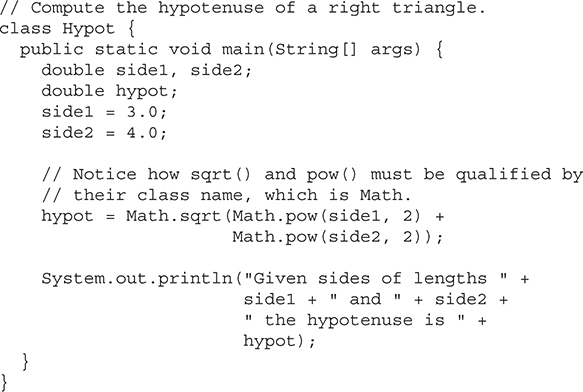
Because pow( ) and sqrt( ) are static methods, they must be called through the use of their class’ name, Math. This results in a somewhat unwieldy hypotenuse calculation:

As this simple example illustrates, having to specify the class name each time pow( ) or sqrt( ) (or any of Java’s other math methods, such as sin( ), cos( ), and tan( )) is used can grow tedious.
You can eliminate the tedium of specifying the class name through the use of static import, as shown in the following version of the preceding program:
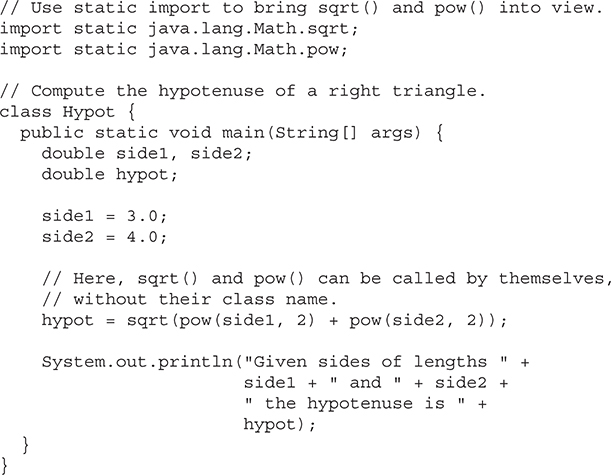
In this version, the names sqrt and pow are brought into view by these static import statements:
import static java.lang.Math.sqrt;
import static java.lang.Math.pow;
After these statements, it is no longer necessary to qualify sqrt( ) or pow( ) with their class name. Therefore, the hypotenuse calculation can more conveniently be specified, as shown here:
hypot = sqrt(pow(side1, 2) + pow(side2, 2));
As you can see, this form is considerably more readable.
There are two general forms of the import static statement. The first, which is used by the preceding example, brings into view a single name. Its general form is shown here:
import static pkg.type-name.static-member-name ;
Here, type-name is the name of a class or interface that contains the desired static member. Its full package name is specified by pkg. The name of the member is specified by static-member-name.
The second form of static import imports all static members of a given class or interface. Its general form is shown here:
import static pkg.type-name.*;
If you will be using many static methods or fields defined by a class, then this form lets you bring them into view without having to specify each individually. Therefore, the preceding program could have used this single import statement to bring both pow( ) and sqrt( ) (and all other static members of Math ) into view:
import static java.lang.Math.*;
Of course, static import is not limited just to the Math class or just to methods. For example, this brings the static field System.out into view:
import static java.lang.System.out;
After this statement, you can output to the console without having to qualify out with System, as shown here:
out.println("After importing System.out, you can use out directly.");
Whether importing System.out as just shown is a good idea is subject to debate. Although it does shorten the statement, it is no longer instantly clear to anyone reading the program that the out being referred to is System.out.
One other point: in addition to importing the static members of classes and interfaces defined by the Java API, you can also use static import to import the static members of classes and interfaces that you create.
As convenient as static import can be, it is important not to abuse it. Remember, the reason that Java organizes its libraries into packages is to avoid namespace collisions. When you import static members, you are bringing those members into the current namespace. Thus, you are increasing the potential for namespace conflicts and inadvertent name hiding. If you are using a static member once or twice in the program, it’s best not to import it. Also, some static names, such as System.out, are so recognizable that you might not want to import them. Static import is designed for those situations in which you are using a static member repeatedly, such as when performing a series of mathematical computations. In essence, you should use, but not abuse, this feature.
When working with overloaded constructors, it is sometimes useful for one constructor to invoke another. In Java, this is accomplished by using another form of the this keyword. The general form is shown here:
this(arg-list)
When this( ) is executed, the overloaded constructor that matches the parameter list specified by arg-list is executed first. Then, if there are any statements inside the original constructor, they are executed. The call to this( ) must be the first statement within the constructor.
To understand how this( ) can be used, let’s work through a short example. First, consider the following class that does not use this( ):
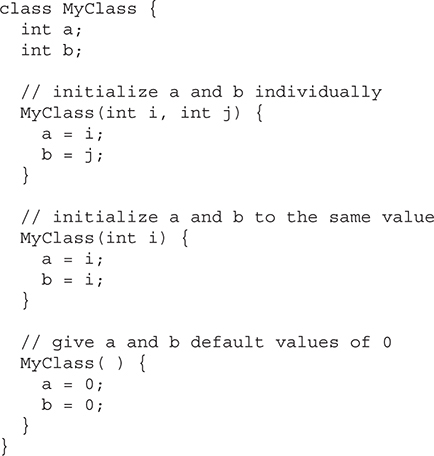
This class contains three constructors, each of which initializes the values of a and b. The first is passed individual values for a and b. The second is passed just one value, which is assigned to both a and b. The third gives a and b default values of zero.
By using this( ), it is possible to rewrite MyClass as shown here:
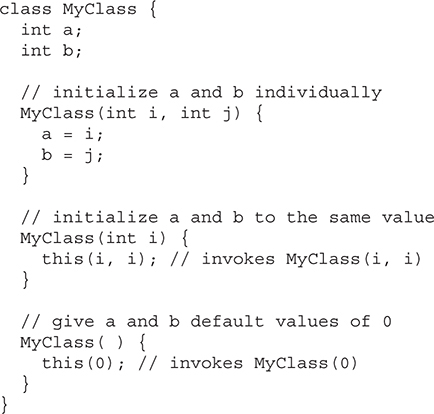
In this version of MyClass, the only constructor that actually assigns values to the a and b fields is MyClass(int, int). The other two constructors simply invoke that constructor (either directly or indirectly) through this( ). For example, consider what happens when this statement executes:
MyClass mc = new MyClass(8);
The call to MyClass(8) causes this(8, 8) to be executed, which translates into a call to MyClass(8, 8), because this is the version of the MyClass constructor whose parameter list matches the arguments passed via this( ). Now, consider the following statement, which uses the default constructor:
MyClass mc2 = new MyClass();
In this case, this(0) is called. This causes MyClass(0) to be invoked because it is the constructor with the matching parameter list. Of course, MyClass(0) then calls MyClass(0,0) as just described.
One reason why invoking overloaded constructors through this( ) can be useful is that it can prevent the unnecessary duplication of code. In many cases, reducing duplicate code decreases the time it takes to load your class because often the object code is smaller. This is especially important for programs delivered via the Internet in which load times are an issue. Using this( ) can also help structure your code when constructors contain a large amount of duplicate code.
However, you need to be careful. Constructors that call this( ) will execute a bit slower than those that contain all of their initialization code inline. This is because the call and return mechanism used when the second constructor is invoked adds overhead. If your class will be used to create only a handful of objects, or if the constructors in the class that call this( ) will be seldom used, then this decrease in run-time performance is probably insignificant. However, if your class will be used to create a large number of objects (on the order of thousands) during program execution, then the negative impact of the increased overhead could be meaningful. Because object creation affects all users of your class, there will be cases in which you must carefully weigh the benefits of faster load time against the increased time it takes to create an object.
Here is another consideration: for very short constructors, such as those used by MyClass, there is often little difference in the size of the object code whether this( ) is used or not. (Actually, there are cases in which no reduction in the size of the object code is achieved.) This is because the bytecode that sets up and returns from the call to this( ) adds instructions to the object file. Therefore, in these types of situations, even though duplicate code is eliminated, using this( ) will not obtain significant savings in terms of load time. However, the added cost in terms of overhead to each object’s construction will still be incurred. Therefore, this( ) is most applicable to constructors that contain large amounts of initialization code, not those that simply set the value of a handful of fields.
There are two restrictions you need to keep in mind when using this( ). First, you cannot use any instance variable of the constructor’s class in a call to this( ). Second, you cannot use super( ) and this( ) in the same constructor because each must be the first statement in the constructor.
Beginning with JDK 8, Java has included the concept of a value-based class, and a number of classes in the Java API have been classified as value-based. Value-based classes are defined by various rules and restrictions. Here are some examples. They must be final, and their instance variables must also be final. If equals( ) determines that two instances of a value-based class are equal, one instance can be used in place of the other. Also, two equal but separately obtained instances of a value-based class may, in fact, be the same object. Very importantly, you should avoid using instances of a value-based class for synchronization. Additional rules and restrictions apply. Furthermore, the definition of value-based classes has evolved somewhat over time. Consult the Java documentation for the latest details on value-based classes, including which classes in the API library are documented as value-based.
Since the original 1.0 release in 1995, many new features have been added to Java. One that has had a profound and long-lasting impact is generics. Introduced by JDK 5, generics changed Java in two important ways. First, it added a new syntactical element to the language. Second, it caused changes to many of the classes and methods in the core API. Today, generics are an integral part of Java programming, and a solid understanding of this important feature is required. It is examined here in detail.
Through the use of generics, it is possible to create classes, interfaces, and methods that will work in a type-safe manner with various kinds of data. Many algorithms are logically the same no matter what type of data they are being applied to. For example, the mechanism that supports a stack is the same whether that stack is storing items of type Integer, String, Object, or Thread. With generics, you can define an algorithm once, independently of any specific type of data, and then apply that algorithm to a wide variety of data types without any additional effort. The expressive power generics added to the language fundamentally changed the way that Java code is written.
Perhaps the one feature of Java that was most significantly affected by generics is the Collections Framework. The Collections Framework is part of the Java API and is described in detail in Chapter 20, but a brief mention is useful now. A collection is a group of objects. The Collections Framework defines several classes, such as lists and maps, that manage collections. The collection classes had always been able to work with any type of object. The benefit that generics added is the ability to use the collection classes with complete type safety. Thus, in addition to being a powerful language element on its own, generics also enabled an existing feature to be substantially improved. This is another reason why generics were such an important addition to Java.
This chapter describes the syntax, theory, and use of generics. It also shows how generics provide type safety for some previously difficult cases. Once you have completed this chapter, you will want to examine Chapter 20, which covers the Collections Framework. There you will find many examples of generics at work.
At its core, the term generics means parameterized types. Parameterized types are important because they enable you to create classes, interfaces, and methods in which the type of data upon which they operate is specified as a parameter. Using generics, it is possible to create a single class, for example, that automatically works with different types of data. A class, interface, or method that operates on a parameterized type is called generic, as in generic class or generic method.
It is important to understand that Java has always given you the ability to create generalized classes, interfaces, and methods by operating through references of type Object. Because Object is the superclass of all other classes, an Object reference can refer to any type object. Thus, in pre-generics code, generalized classes, interfaces, and methods used Object references to operate on various types of objects. The problem was that they could not do so with type safety.
Generics added the type safety that was lacking. They also streamlined the process, because it is no longer necessary to explicitly employ casts to translate between Object and the type of data that is actually being operated upon. With generics, all casts are automatic and implicit. Thus, generics expanded your ability to reuse code and let you do so safely and easily.
CAUTION A Warning to C++ Programmers: Although generics are similar to templates in C++, they are not the same. There are some fundamental differences between the two approaches to generic types. If you have a background in C++, it is important not to jump to conclusions about how generics work in Java.
Let’s begin with a simple example of a generic class. The following program defines two classes. The first is the generic class Gen, and the second is GenDemo, which uses Gen.
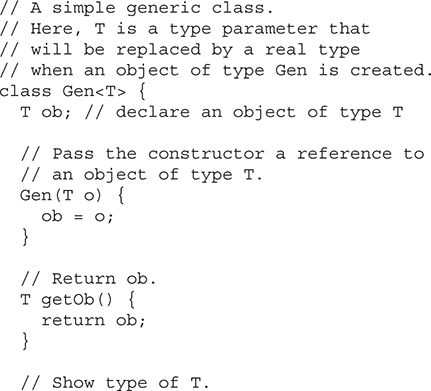
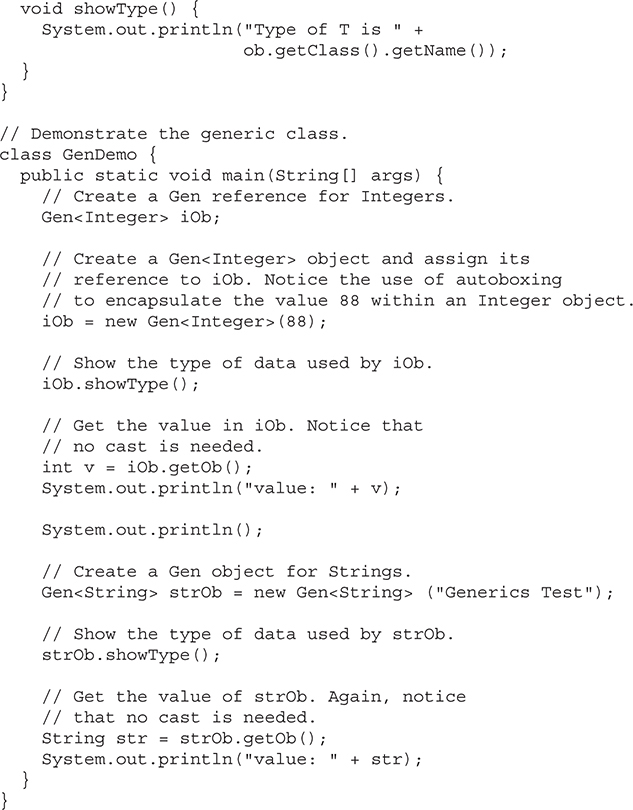
The output produced by the program is shown here:

Let’s examine this program carefully.
First, notice how Gen is declared by the following line:
class Gen<T> {
Here, T is the name of a type parameter. This name is used as a placeholder for the actual type that will be passed to Gen when an object is created. Thus, T is used within Gen whenever the type parameter is needed. Notice that T is contained within < >. This syntax can be generalized. Whenever a type parameter is being declared, it is specified within angle brackets. Because Gen uses a type parameter, Gen is a generic class, which is also called a parameterized type.
In the declaration of Gen, there is no special significance to the name T. Any valid identifier could have been used, but T is traditional. Furthermore, it is recommended that type parameter names be single-character capital letters. Other commonly used type parameter names are V and E. One other point about type parameter names: Beginning with JDK 10, you cannot use var as the name of a type parameter.
Next, T is used to declare an object called ob, as shown here:
T ob; // declare an object of type T
As explained, T is a placeholder for the actual type that will be specified when a Gen object is created. Thus, ob will be an object of the type passed to T. For example, if type String is passed to T, then in that instance, ob will be of type String.
Now consider Gen’s constructor:

Notice that its parameter, o, is of type T. This means that the actual type of o is determined by the type passed to T when a Gen object is created. Also, because both the parameter o and the member variable ob are of type T, they will both be of the same actual type when a Gen object is created.
The type parameter T can also be used to specify the return type of a method, as is the case with the getOb( ) method, shown here:

Because ob is also of type T, its type is compatible with the return type specified by getOb( ).
The showType( ) method displays the type of T by calling getName( ) on the Class object returned by the call to getClass( ) on ob. The getClass( ) method is defined by Object and is thus a member of all class types. It returns a Class object that corresponds to the type of the class of the object on which it is called. Class defines the getName( ) method, which returns a string representation of the class name.
The GenDemo class demonstrates the generic Gen class. It first creates a version of Gen for integers, as shown here:
Gen<Integer> iOb;
Look closely at this declaration. First, notice that the type Integer is specified within the angle brackets after Gen. In this case, Integer is a type argument that is passed to Gen’s type parameter, T. This effectively creates a version of Gen in which all references to T are translated into references to Integer. Thus, for this declaration, ob is of type Integer, and the return type of getOb( ) is of type Integer.
Before moving on, it’s necessary to state that the Java compiler does not actually create different versions of Gen, or of any other generic class. Although it’s helpful to think in these terms, it is not what actually happens. Instead, the compiler removes all generic type information, substituting the necessary casts, to make your code behave as if a specific version of Gen were created. Thus, there is really only one version of Gen that actually exists in your program. The process of removing generic type information is called erasure, and we will return to this topic later in this chapter.
The next line assigns to iOb a reference to an instance of an Integer version of the Gen class:
iOb = new Gen<Integer>(88);
Notice that when the Gen constructor is called, the type argument Integer is also specified. This is because the type of the object (in this case iOb) to which the reference is being assigned is of type Gen<Integer>. Thus, the reference returned by new must also be of type Gen<Integer>. If it isn’t, a compile-time error will result. For example, the following assignment will cause a compile-time error:
iOb = new Gen<Double>(88.0); // Error!
Because iOb is of type Gen<Integer>, it can’t be used to refer to an object of Gen<Double>. This type checking is one of the main benefits of generics because it ensures type safety.
Note As you will see later in this chapter, it is possible to shorten the syntax used to create an instance of a generic class. In the interest of clarity, we will use the full syntax at this time.
As the comments in the program state, the assignment
iOb = new Gen<Integer>(88);
makes use of autoboxing to encapsulate the value 88, which is an int, into an Integer. This works because Gen<Integer> creates a constructor that takes an Integer argument. Because an Integer is expected, Java will automatically box 88 inside one. Of course, the assignment could also have been written explicitly, like this:
iOb = new Gen<Integer>(Integer.valueOf(88));
However, there would be no benefit to using this version.
The program then displays the type of ob within iOb, which is Integer. Next, the program obtains the value of ob by use of the following line:
int v = iOb.getOb();
Because the return type of getOb( ) is T, which was replaced by Integer when iOb was declared, the return type of getOb( ) is also Integer, which unboxes into int when assigned to v (which is an int). Thus, there is no need to cast the return type of getOb( ) to Integer. Of course, it’s not necessary to use the auto-unboxing feature. The preceding line could have been written like this, too:
int v = iOb.getOb().intValue();
However, the auto-unboxing feature makes the code more compact.
Next, GenDemo declares an object of type Gen<String>:
Gen<String> strOb = new Gen<String>("Generics Test");
Because the type argument is String, String is substituted for T inside Gen. This creates (conceptually) a String version of Gen, as the remaining lines in the program demonstrate.
When declaring an instance of a generic type, the type argument passed to the type parameter must be a reference type. You cannot use a primitive type, such as int or char. For example, with Gen, it is possible to pass any class type to T, but you cannot pass a primitive type to a type parameter. Therefore, the following declaration is illegal:
Gen<int> intOb = new Gen<int>(53); // Error, can't use primitive type
Of course, not being able to specify a primitive type is not a serious restriction because you can use the type wrappers (as the preceding example did) to encapsulate a primitive type. Further, Java’s autoboxing and auto-unboxing mechanism makes the use of the type wrapper transparent.
A key point to understand about generic types is that a reference of one specific version of a generic type is not type compatible with another version of the same generic type. For example, assuming the program just shown, the following line of code is in error and will not compile:
iOb = strOb; // Wrong!
Even though both iOb and strOb are of type Gen<T>, they are references to different types because their type arguments differ. This is part of the way that generics add type safety and prevent errors.
At this point, you might be asking yourself the following question: Given that the same functionality found in the generic Gen class can be achieved without generics, by simply specifying Object as the data type and employing the proper casts, what is the benefit of making Gen generic? The answer is that generics automatically ensure the type safety of all operations involving Gen. In the process, they eliminate the need for you to enter casts and to type-check code by hand.
To understand the benefits of generics, first consider the following program that creates a non-generic equivalent of Gen:
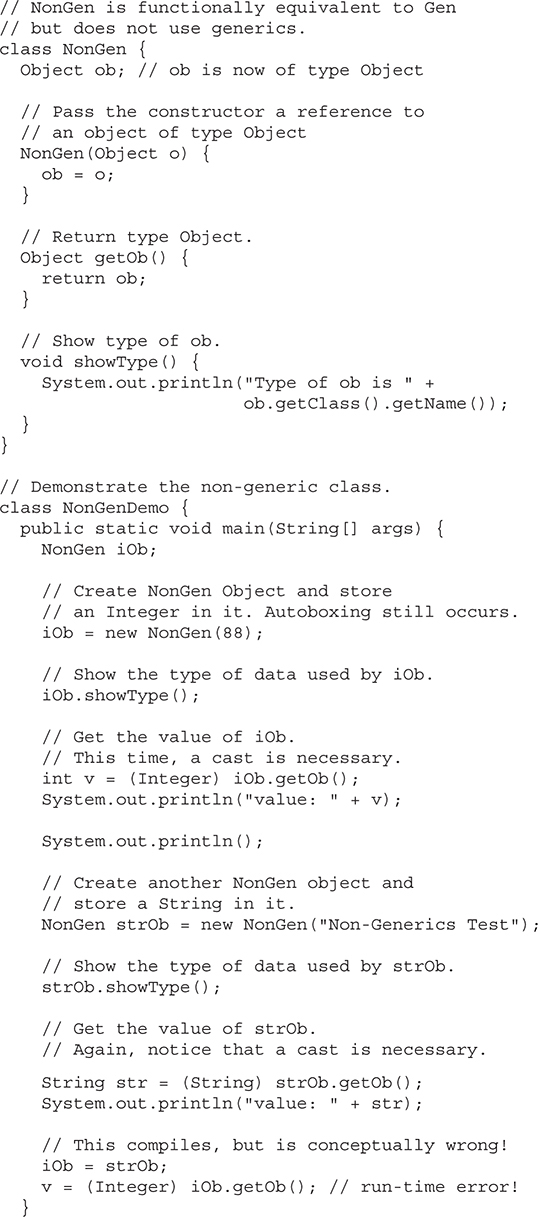
There are several things of interest in this version. First, notice that NonGen replaces all uses of T with Object. This makes NonGen able to store any type of object, as can the generic version. However, it also prevents the Java compiler from having any real knowledge about the type of data actually stored in NonGen, which is bad for two reasons. First, explicit casts must be employed to retrieve the stored data. Second, many kinds of type mismatch errors cannot be found until run time. Let’s look closely at each problem.
Notice this line:
int v = (Integer) iOb.getOb();
Because the return type of getOb( ) is Object, the cast to Integer is necessary to enable that value to be auto-unboxed and stored in v. If you remove the cast, the program will not compile. With the generic version, this cast was implicit. In the non-generic version, the cast must be explicit. This is not only an inconvenience, but also a potential source of error.
Now, consider the following sequence from near the end of the program:

Here, strOb is assigned to iOb. However, strOb refers to an object that contains a string, not an integer. This assignment is syntactically valid because all NonGen references are the same, and any NonGen reference can refer to any other NonGen object. However, the statement is semantically wrong, as the next line shows. Here, the return type of getOb( ) is cast to Integer, and then an attempt is made to assign this value to v. The trouble is that iOb now refers to an object that stores a String, not an Integer. Unfortunately, without the use of generics, the Java compiler has no way to know this. Instead, a run-time exception occurs when the cast to Integer is attempted. As you know, it is extremely bad to have run-time exceptions occur in your code!
The preceding sequence can’t occur when generics are used. If this sequence were attempted in the generic version of the program, the compiler would catch it and report an error, thus preventing a serious bug that results in a run-time exception. The ability to create type-safe code in which type-mismatch errors are caught at compile time is a key advantage of generics. Although using Object references to create “generic” code has always been possible, that code was not type safe, and its misuse could result in run-time exceptions. Generics prevent this from occurring. In essence, through generics, run-time errors are converted into compile-time errors. This is a major advantage.
You can declare more than one type parameter in a generic type. To specify two or more type parameters, simply use a comma-separated list. For example, the following TwoGen class is a variation of the Gen class that has two type parameters:
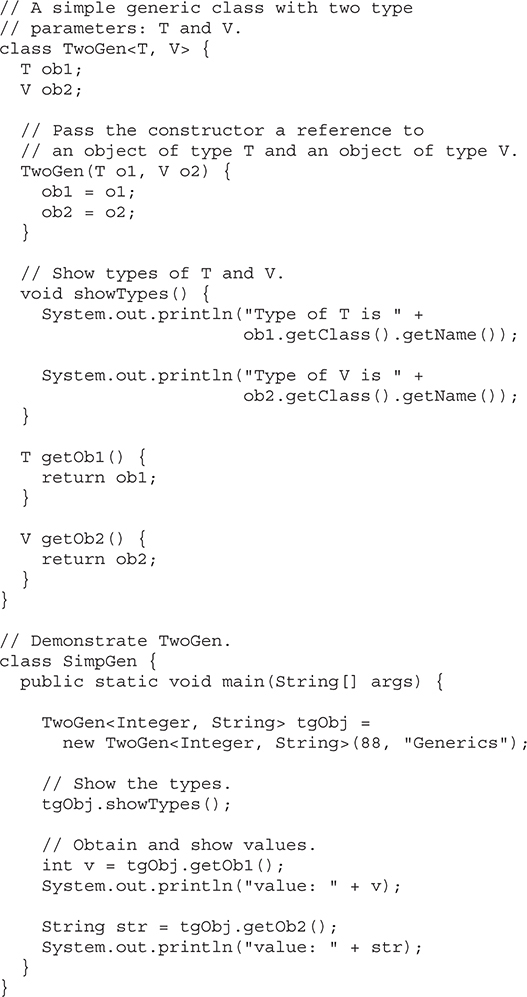
The output from this program is shown here:

Notice how TwoGen is declared:
class TwoGen<T, V> {
It specifies two type parameters: T and V, separated by a comma. Because it has two type parameters, two type arguments must be passed to TwoGen when an object is created, as shown next:

In this case, Integer is substituted for T, and String is substituted for V.
Although the two type arguments differ in this example, it is possible for both types to be the same. For example, the following line of code is valid:
TwoGen<String, String> x = new TwoGen<String, String> ("A", "B");
In this case, both T and V would be of type String. Of course, if the type arguments were always the same, then two type parameters would be unnecessary.
The generics syntax shown in the preceding examples can be generalized. Here is the syntax for declaring a generic class:
class class-name<type-param-list > { // …
Here is the full syntax for declaring a reference to a generic class and instance creation:
class-name<type-arg-list > var-name =
new class-name<type-arg-list >(cons-arg-list);
In the preceding examples, the type parameters could be replaced by any class type. This is fine for many purposes, but sometimes it is useful to limit the types that can be passed to a type parameter. For example, assume that you want to create a generic class that contains a method that returns the average of an array of numbers. Furthermore, you want to use the class to obtain the average of an array of any type of number, including integers, floats, and doubles. Thus, you want to specify the type of the numbers generically, using a type parameter. To create such a class, you might try something like this:
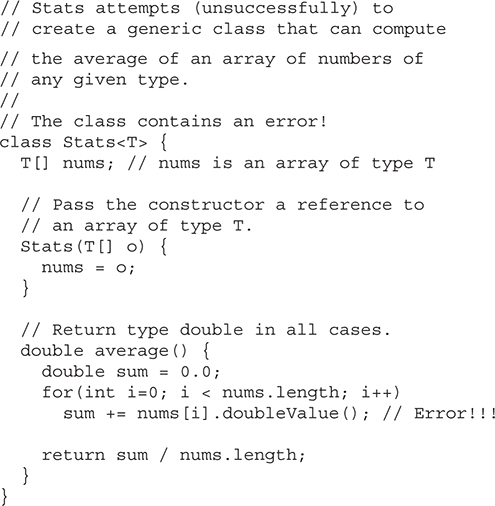
In Stats, the average( ) method attempts to obtain the double version of each number in the nums array by calling doubleValue( ). Because all numeric classes, such as Integer and Double, are subclasses of Number, and Number defines the doubleValue( ) method, this method is available to all numeric wrapper classes. The trouble is that the compiler has no way to know that you are intending to create Stats objects using only numeric types. Thus, when you try to compile Stats, an error is reported that indicates that the doubleValue( ) method is unknown. To solve this problem, you need some way to tell the compiler that you intend to pass only numeric types to T. Furthermore, you need some way to ensure that only numeric types are actually passed.
To handle such situations, Java provides bounded types. When specifying a type parameter, you can create an upper bound that declares the superclass from which all type arguments must be derived. This is accomplished through the use of an extends clause when specifying the type parameter, as shown here:
<T extends superclass>
This specifies that T can only be replaced by superclass, or subclasses of superclass. Thus, superclass defines an inclusive, upper limit.
You can use an upper bound to fix the Stats class shown earlier by specifying Number as an upper bound, as shown here:
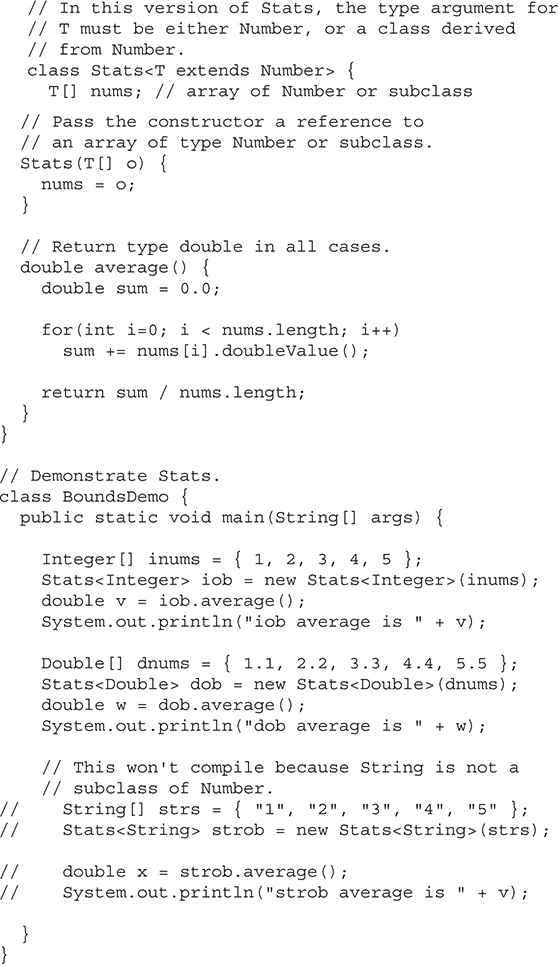
The output is shown here:
Average is 3.0
Average is 3.3
Notice how Stats is now declared by this line:
class Stats<T extends Number> {
Because the type T is now bounded by Number, the Java compiler knows that all objects of type T can call doubleValue( ) because it is a method declared by Number. This is, by itself, a major advantage. However, as an added bonus, the bounding of T also prevents nonnumeric Stats objects from being created. For example, if you try removing the comments from the lines at the end of the program, and then try recompiling, you will receive compile-time errors because String is not a subclass of Number.
In addition to using a class type as a bound, you can also use an interface type. In fact, you can specify multiple interfaces as bounds. Furthermore, a bound can include both a class type and one or more interfaces. In this case, the class type must be specified first. When a bound includes an interface type, only type arguments that implement that interface are legal. When specifying a bound that has a class and an interface, or multiple interfaces, use the & operator to connect them. This creates an intersection type. For example,
class Gen<T extends MyClass & MyInterface> { // ...
Here, T is bounded by a class called MyClass and an interface called MyInterface. Thus, any type argument passed to T must be a subclass of MyClass and implement MyInterface. As a point of interest, you can also use a type intersection in a cast.
As useful as type safety is, sometimes it can get in the way of perfectly acceptable constructs. For example, given the Stats class shown at the end of the preceding section, assume that you want to add a method called isSameAvg( ) that determines if two Stats objects contain arrays that yield the same average, no matter what type of numeric data each object holds. For example, if one object contains the double values 1.0, 2.0, and 3.0, and the other object contains the integer values 2, 1, and 3, then the averages will be the same. One way to implement isSameAvg( ) is to pass it a Stats argument, and then compare the average of that argument against the invoking object, returning true only if the averages are the same. For example, you want to be able to call isSameAvg( ), as shown here:
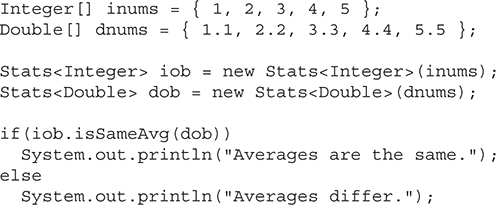
At first, creating isSameAvg( ) seems like an easy problem. Because Stats is generic and its average( ) method can work on any type of Stats object, it seems that creating isSameAvg( ) would be straightforward. Unfortunately, trouble starts as soon as you try to declare a parameter of type Stats. Because Stats is a parameterized type, what do you specify for Stats’ type parameter when you declare a parameter of that type?
At first, you might think of a solution like this, in which T is used as the type parameter:
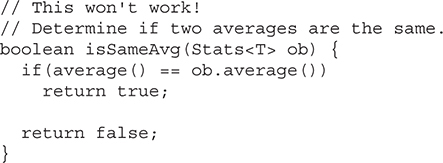
The trouble with this attempt is that it will work only with other Stats objects whose type is the same as the invoking object. For example, if the invoking object is of type Stats<Integer>, then the parameter ob must also be of type Stats<Integer>. It can’t be used to compare the average of an object of type Stats<Double> with the average of an object of type Stats<Short>, for example. Therefore, this approach won’t work except in a very narrow context and does not yield a general (that is, generic) solution.
To create a generic isSameAvg( ) method, you must use another feature of Java generics: the wildcard argument. The wildcard argument is specified by the ?, and it represents an unknown type. Using a wildcard, here is one way to write the isSameAvg( ) method:
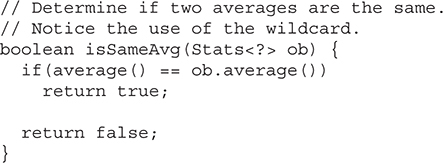
Here, Stats<?> matches any Stats object, allowing any two Stats objects to have their averages compared. The following program demonstrates this:
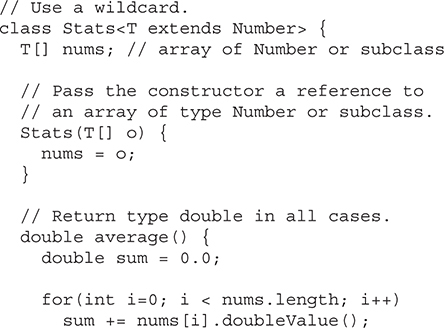
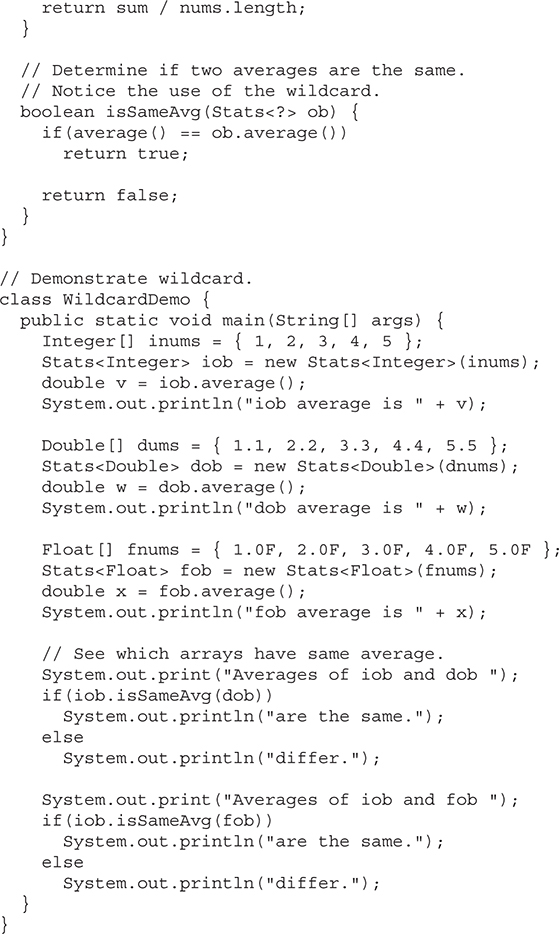
The output is shown here:

One last point: It is important to understand that the wildcard does not affect what type of Stats objects can be created. This is governed by the extends clause in the Stats declaration. The wildcard simply matches any valid Stats object.
Wildcard arguments can be bounded in much the same way that a type parameter can be bounded. A bounded wildcard is especially important when you are creating a generic type that will operate on a class hierarchy. To understand why, let’s work through an example. Consider the following hierarchy of classes that encapsulate coordinates:
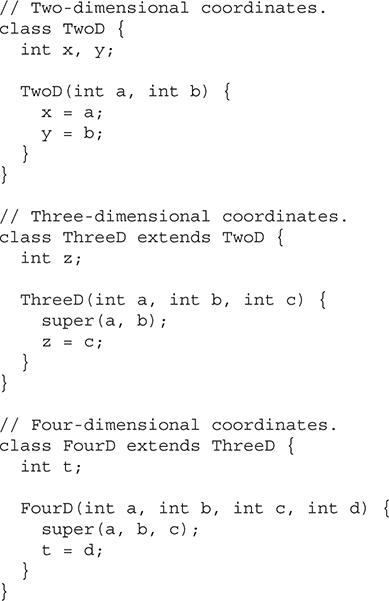
At the top of the hierarchy is TwoD, which encapsulates a two-dimensional, XY coordinate. TwoD is inherited by ThreeD, which adds a third dimension, creating an XYZ coordinate. ThreeD is inherited by FourD, which adds a fourth dimension (time), yielding a four-dimensional coordinate.
Shown next is a generic class called Coords, which stores an array of coordinates:

Notice that Coords specifies a type parameter bounded by TwoD. This means that any array stored in a Coords object will contain objects of type TwoD or one of its subclasses.
Now, assume that you want to write a method that displays the X and Y coordinates for each element in the coords array of a Coords object. Because all types of Coords objects have at least two coordinates (X and Y), this is easy to do using a wildcard, as shown here:

Because Coords is a bounded generic type that specifies TwoD as an upper bound, all objects that can be used to create a Coords object will be arrays of type TwoD, or of classes derived from TwoD. Thus, showXY( ) can display the contents of any Coords object.
However, what if you want to create a method that displays the X, Y, and Z coordinates of a ThreeD or FourD object? The trouble is that not all Coords objects will have three coordinates, because a Coords<TwoD> object will only have X and Y. Therefore, how do you write a method that displays the X, Y, and Z coordinates for Coords<ThreeD> and Coords<FourD> objects, while preventing that method from being used with Coords<TwoD> objects? The answer is the bounded wildcard argument.
A bounded wildcard specifies either an upper bound or a lower bound for the type argument. This enables you to restrict the types of objects upon which a method will operate. The most common bounded wildcard is the upper bound, which is created using an extends clause in much the same way it is used to create a bounded type.
Using a bounded wildcard, it is easy to create a method that displays the X, Y, and Z coordinates of a Coords object, if that object actually has those three coordinates. For example, the following showXYZ( ) method shows the X, Y, and Z coordinates of the elements stored in a Coords object, if those elements are actually of type ThreeD (or are derived from ThreeD):

Notice that an extends clause has been added to the wildcard in the declaration of parameter c. It states that the ? can match any type as long as it is ThreeD, or a class derived from ThreeD. Thus, the extends clause establishes an upper bound that the ? can match. Because of this bound, showXYZ( ) can be called with references to objects of type Coords<ThreeD> or Coords<FourD>, but not with a reference of type Coords<TwoD>. Attempting to call showXZY( ) with a Coords<TwoD> reference results in a compile-time error, thus ensuring type safety.
Here is an entire program that demonstrates the actions of a bounded wildcard argument:
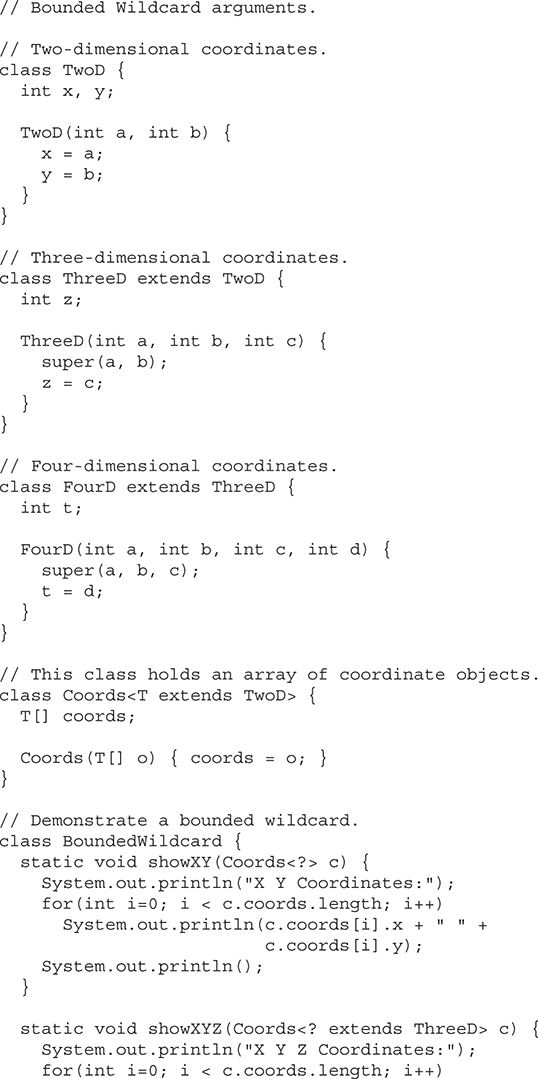
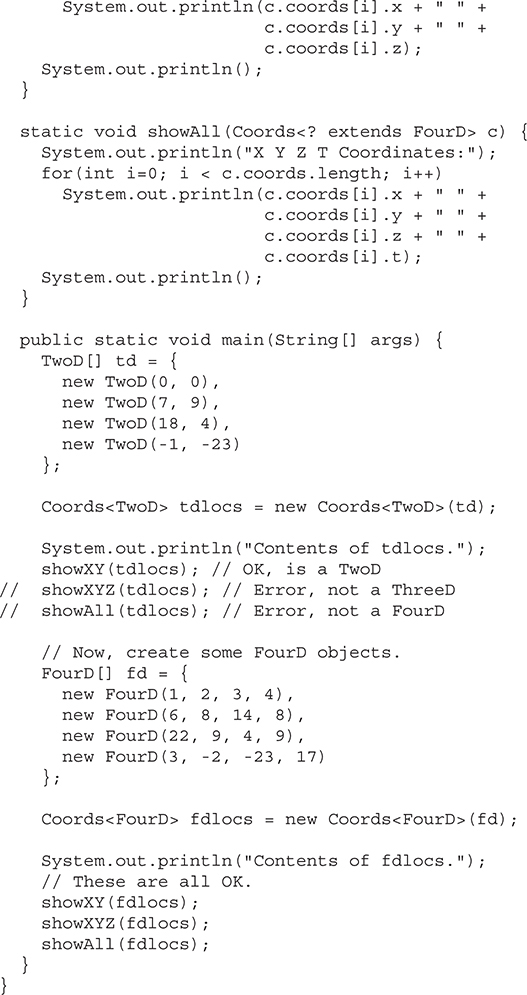
The output from the program is shown here:
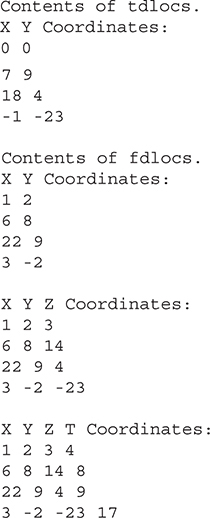
Notice these commented-out lines:

Because tdlocs is a Coords(TwoD) object, it cannot be used to call showXYZ( ) or showAll( ) because bounded wildcard arguments in their declarations prevent it. To prove this to yourself, try removing the comment symbols, and then attempt to compile the program. You will receive compilation errors because of the type mismatches.
In general, to establish an upper bound for a wildcard, use the following type of wildcard expression:
<? extends superclass>
where superclass is the name of the class that serves as the upper bound. Remember, this is an inclusive clause because the class forming the upper bound (that is, specified by superclass) is also within bounds.
You can also specify a lower bound for a wildcard by adding a super clause to a wildcard declaration. Here is its general form:
<? super subclass>
In this case, only classes that are superclasses of subclass are acceptable arguments. This is an inclusive clause.
As the preceding examples have shown, methods inside a generic class can make use of a class’ type parameter and are, therefore, automatically generic relative to the type parameter. However, it is possible to declare a generic method that uses one or more type parameters of its own. Furthermore, it is possible to create a generic method that is enclosed within a non-generic class.
Let’s begin with an example. The following program declares a non-generic class called GenMethDemo and a static generic method within that class called isIn( ). The isIn( ) method determines if an object is a member of an array. It can be used with any type of object and array as long as the array contains objects that are compatible with the type of the object being sought.
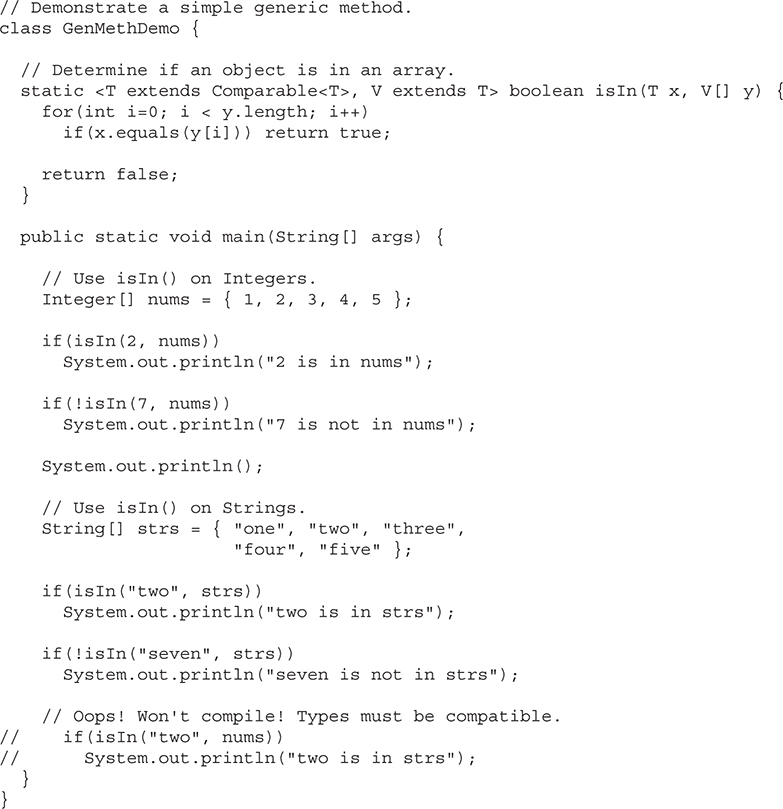
The output from the program is shown here:

Let’s examine isIn( ) closely. First, notice how it is declared by this line:
static <T extends Comparable<T>, V extends T> boolean isIn(T x, V[] y) {
The type parameters are declared before the return type of the method. Also note that T extends Comparable<T>. Comparable is an interface declared in java.lang. A class that implements Comparable defines objects that can be ordered. Thus, requiring an upper bound of Comparable ensures that isIn( ) can be used only with objects that are capable of being compared. Comparable is generic, and its type parameter specifies the type of objects that it compares. (Shortly, you will see how to create a generic interface.) Next, notice that the type V is upper-bounded by T. Thus, V must either be the same as type T, or a subclass of T. This relationship enforces that isIn( ) can be called only with arguments that are compatible with each other. Also notice that isIn( ) is static, enabling it to be called independently of any object. Understand, though, that generic methods can be either static or non-static. There is no restriction in this regard.
Now, notice how isIn( ) is called within main( ) by use of the normal call syntax, without the need to specify type arguments. This is because the types of the arguments are automatically discerned, and the types of T and V are adjusted accordingly. For example, in the first call:
if(isIn(2, nums))
the type of the first argument is Integer (due to autoboxing), which causes Integer to be substituted for T. The base type of the second argument is also Integer, which makes Integer a substitute for V, too. In the second call, String types are used, and the types of T and V are replaced by String.
Although type inference will be sufficient for most generic method calls, you can explicitly specify the type argument if needed. For example, here is how the first call to isIn( ) looks when the type arguments are specified:
GenMethDemo.<Integer, Integer>isIn(2, nums)
Of course, in this case, there is nothing gained by specifying the type arguments. Furthermore, JDK 8 improved type inference as it relates to methods. As a result, today there are fewer cases in which explicit type arguments are needed.
Now, notice the commented-out code, shown here:

If you remove the comments and then try to compile the program, you will receive an error. The reason is that the type parameter V is bounded by T in the extends clause in V’s declaration. This means that V must be either type T, or a subclass of T. In this case, the first argument is of type String, making T into String, but the second argument is of type Integer, which is not a subclass of String. This causes a compile-time type-mismatch error. This ability to enforce type safety is one of the most important advantages of generic methods.
The syntax used to create isIn( ) can be generalized. Here is the syntax for a generic method:
<type-param-list > ret-type meth-name (param-list) { // …
In all cases, type-param-list is a comma-separated list of type parameters. Notice that for a generic method, the type parameter list precedes the return type.
It is possible for constructors to be generic, even if their class is not. For example, consider the following short program:
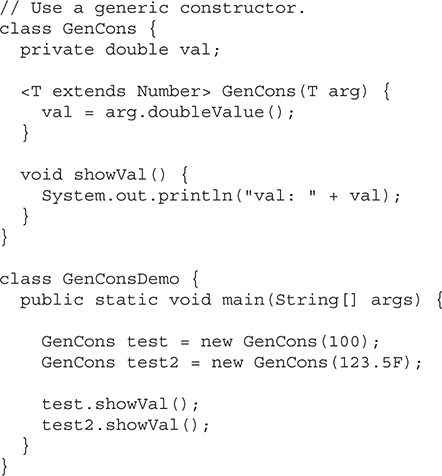
The output is shown here:

Because GenCons( ) specifies a parameter of a generic type, which must be a subclass of Number, GenCons( ) can be called with any numeric type, including Integer, Float, or Double. Therefore, even though GenCons is not a generic class, its constructor is generic.
In addition to generic classes and methods, you can also have generic interfaces. Generic interfaces are specified just like generic classes. Here is an example. It creates an interface called MinMax that declares the methods min( ) and max( ), which are expected to return the minimum and maximum value of some set of objects.
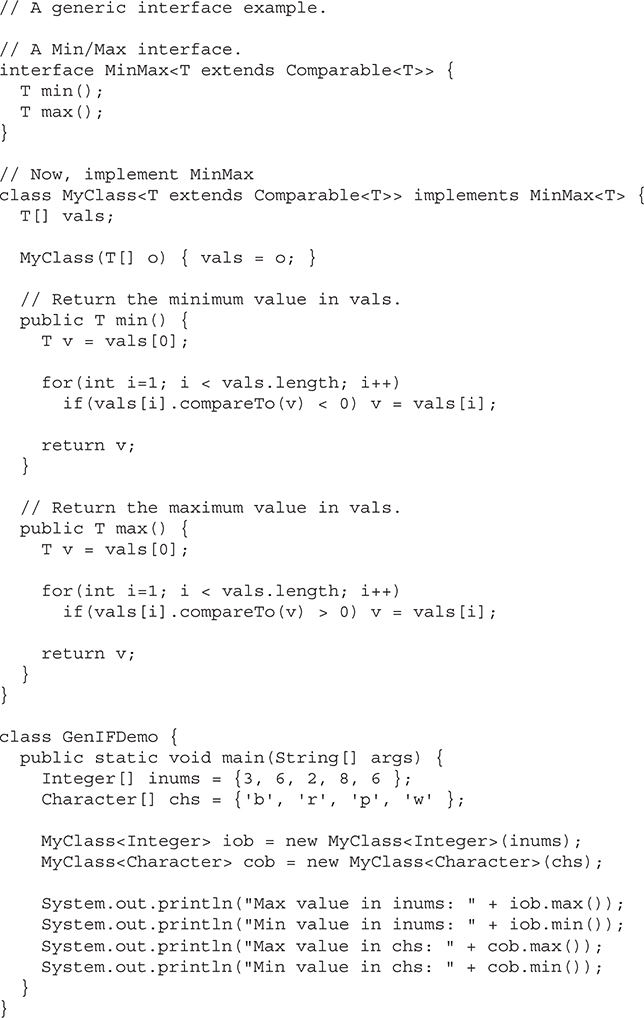
The output is shown here:

Although most aspects of this program should be easy to understand, a couple of key points need to be made. First, notice that MinMax is declared like this:
interface MinMax<T extends Comparable<T>> {
In general, a generic interface is declared in the same way as is a generic class. In this case, the type parameter is T, and its upper bound is Comparable. As explained earlier, Comparable is an interface defined by java.lang that specifies how objects are compared. Its type parameter specifies the type of the objects being compared.
Next, MinMax is implemented by MyClass. Notice the declaration of MyClass, shown here:
class MyClass<T extends Comparable<T>> implements MinMax<T> {
Pay special attention to the way that the type parameter T is declared by MyClass and then passed to MinMax. Because MinMax requires a type that implements Comparable, the implementing class (MyClass in this case) must specify the same bound. Furthermore, once this bound has been established, there is no need to specify it again in the implements clause. In fact, it would be wrong to do so. For example, this line is incorrect and won’t compile:

Once the type parameter has been established, it is simply passed to the interface without further modification.
In general, if a class implements a generic interface, then that class must also be generic, at least to the extent that it takes a type parameter that is passed to the interface. For example, the following attempt to declare MyClass is in error:
class MyClass implements MinMax<T> { // Wrong!
Because MyClass does not declare a type parameter, there is no way to pass one to MinMax. In this case, the identifier T is simply unknown, and the compiler reports an error. Of course, if a class implements a specific type of generic interface, such as shown here:
class MyClass implements MinMax<Integer> { // OK
then the implementing class does not need to be generic.
The generic interface offers two benefits. First, it can be implemented for different types of data. Second, it allows you to put constraints (that is, bounds) on the types of data for which the interface can be implemented. In the MinMax example, only types that implement the Comparable interface can be passed to T.
Here is the generalized syntax for a generic interface:
interface interface-name<type-param-list> { // …
Here, type-param-list is a comma-separated list of type parameters. When a generic interface is implemented, you must specify the type arguments, as shown here:
class class-name<type-param-list>
implements interface-name<type-arg-list> {
Because support for generics did not exist prior to JDK 5, it was necessary to provide some transition path from old, pre-generics code. Furthermore, this transition path had to enable pre-generics code to remain functional while at the same time being compatible with generics. In other words, pre-generics code had to be able to work with generics, and generic code had to be able to work with pre-generics code.
To handle the transition to generics, Java allows a generic class to be used without any type arguments. This creates a raw type for the class. This raw type is compatible with legacy code, which has no knowledge of generics. The main drawback to using the raw type is that the type safety of generics is lost.
Here is an example that shows a raw type in action:
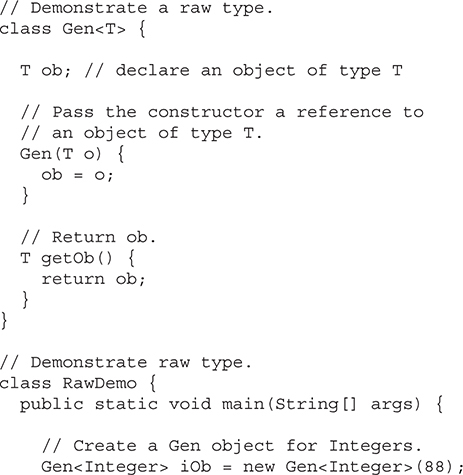
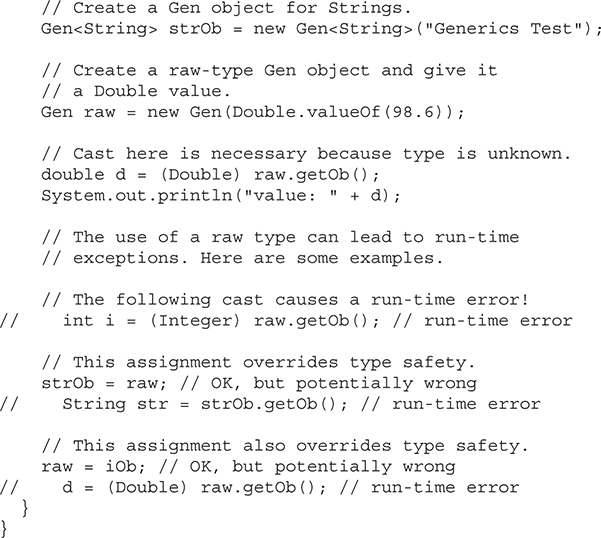
This program contains several interesting things. First, a raw type of the generic Gen class is created by the following declaration:
Gen raw = new Gen(Double.valueOf(98.6));
Notice that no type arguments are specified. In essence, this creates a Gen object whose type T is replaced by Object.
A raw type is not type safe. Thus, a variable of a raw type can be assigned a reference to any type of Gen object. The reverse is also allowed; a variable of a specific Gen type can be assigned a reference to a raw Gen object. However, both operations are potentially unsafe because the type checking mechanism of generics is circumvented.
This lack of type safety is illustrated by the commented-out lines at the end of the program. Let’s examine each case. First, consider the following situation:
// int i = (Integer) raw.getOb(); // run-time error
In this statement, the value of ob inside raw is obtained, and this value is cast to Integer. The trouble is that raw contains a Double value, not an integer value. However, this cannot be detected at compile time because the type of raw is unknown. Thus, this statement fails at run time.
The next sequence assigns to a strOb (a reference of type Gen<String>) a reference to a raw Gen object:

The assignment, itself, is syntactically correct, but questionable. Because strOb is of type Gen<String>, it is assumed to contain a String. However, after the assignment, the object referred to by strOb contains a Double. Thus, at run time, when an attempt is made to assign the contents of strOb to str, a run-time error results because strOb now contains a Double. Thus, the assignment of a raw reference to a generic reference bypasses the type-safety mechanism.
The following sequence inverts the preceding case:

Here, a generic reference is assigned to a raw reference variable. Although this is syntactically correct, it can lead to problems, as illustrated by the second line. In this case, raw now refers to an object that contains an Integer object, but the cast assumes that it contains a Double. This error cannot be prevented at compile time. Rather, it causes a run-time error.
Because of the potential for danger inherent in raw types, javac displays unchecked warnings when a raw type is used in a way that might jeopardize type safety. In the preceding program, these lines generate unchecked warnings:

In the first line, it is the call to the Gen constructor without a type argument that causes the warning. In the second line, it is the assignment of a raw reference to a generic variable that generates the warning.
At first, you might think that this line should also generate an unchecked warning, but it does not:
raw = iOb; // OK, but potentially wrong
No compiler warning is issued because the assignment does not cause any further loss of type safety than had already occurred when raw was created.
One final point: You should limit the use of raw types to those cases in which you must mix legacy code with newer, generic code. Raw types are simply a transitional feature and not something that should be used for new code.
Generic classes can be part of a class hierarchy in just the same way as a non-generic class. Thus, a generic class can act as a superclass or be a subclass. The key difference between generic and non-generic hierarchies is that in a generic hierarchy, any type arguments needed by a generic superclass must be passed up the hierarchy by all subclasses. This is similar to the way that constructor arguments must be passed up a hierarchy.
Here is a simple example of a hierarchy that uses a generic superclass:
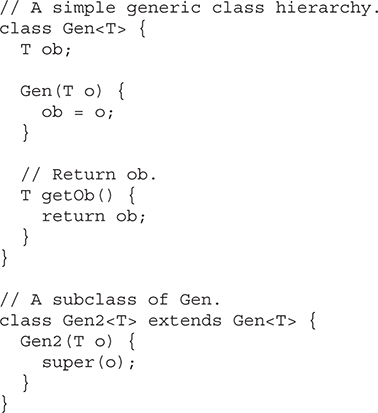
In this hierarchy, Gen2 extends the generic class Gen. Notice how Gen2 is declared by the following line:
class Gen2<T> extends Gen<T> {
The type parameter T is specified by Gen2 and is also passed to Gen in the extends clause. This means that whatever type is passed to Gen2 will also be passed to Gen. For example, this declaration,
Gen2<Integer> num = new Gen2<Integer>(100);
passes Integer as the type parameter to Gen. Thus, the ob inside the Gen portion of Gen2 will be of type Integer.
Notice also that Gen2 does not use the type parameter T except to support the Gen superclass. Thus, even if a subclass of a generic superclass would otherwise not need to be generic, it still must specify the type parameter(s) required by its generic superclass.
Of course, a subclass is free to add its own type parameters, if needed. For example, here is a variation on the preceding hierarchy in which Gen2 adds a type parameter of its own:
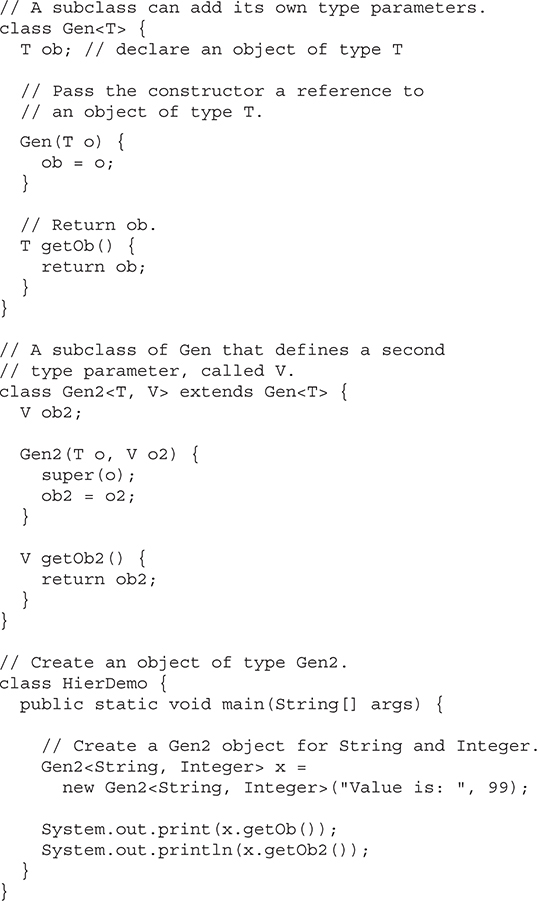
Notice the declaration of this version of Gen2, which is shown here:
class Gen2<T, V> extends Gen<T> {
Here, T is the type passed to Gen, and V is the type that is specific to Gen2. V is used to declare an object called ob2, and as a return type for the method getOb2( ). In main( ), a Gen2 object is created in which type parameter T is String, and type parameter V is Integer. The program displays the following, expected, result:
Value is: 99
It is perfectly acceptable for a non-generic class to be the superclass of a generic subclass. For example, consider this program:
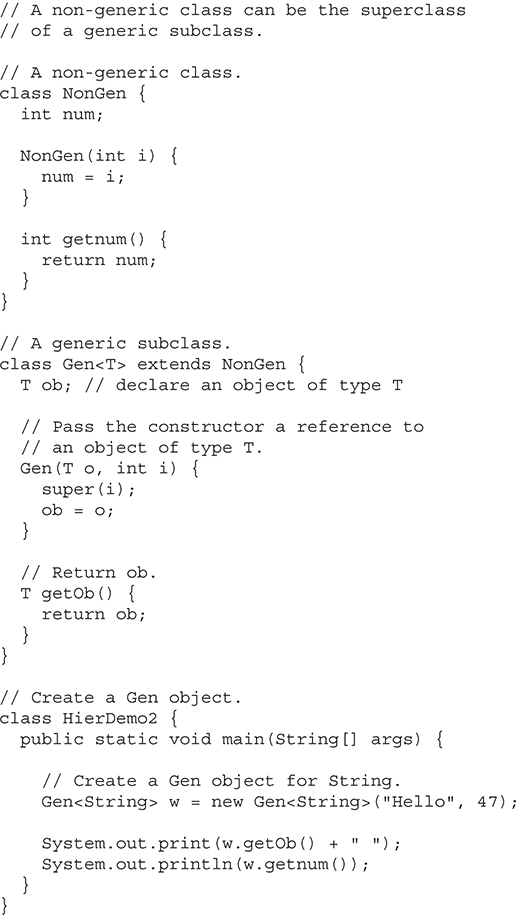
The output from the program is shown here:
Hello 47
In the program, notice how Gen inherits NonGen in the following declaration:
class Gen<T> extends NonGen {
Because NonGen is not generic, no type argument is specified. Thus, even though Gen declares the type parameter T, it is not needed by (nor can it be used by) NonGen. Thus, NonGen is inherited by Gen in the normal way. No special conditions apply.
Recall the run-time type information operator instanceof that was introduced in Chapter 13. As explained, instanceof determines if an object is an instance of a class. It returns true if an object is of the specified type or can be cast to the specified type. The instanceof operator can be applied to objects of generic classes. The following class demonstrates some of the type compatibility implications of a generic hierarchy:
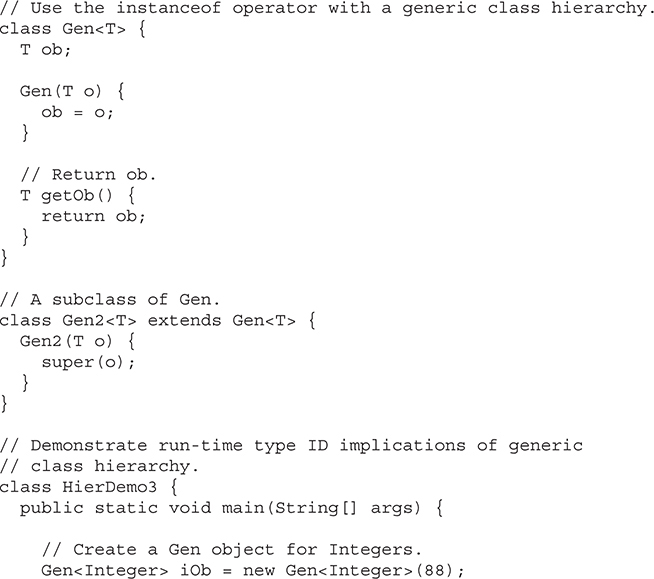
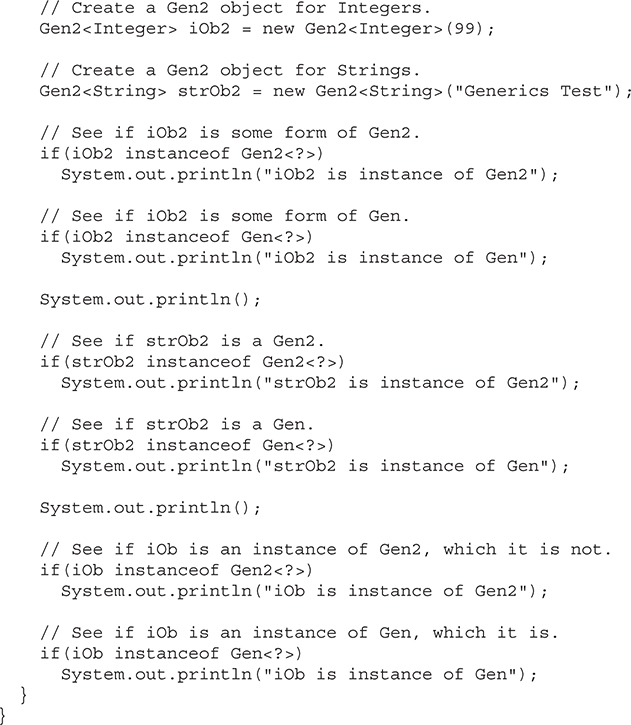
The output from the program is shown here:
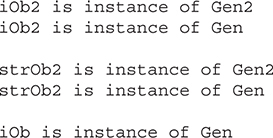
In this program, Gen2 is a subclass of Gen, which is generic on type parameter T. In main( ), three objects are created. The first is iOb, which is an object of type Gen<Integer>. The second is iOb2, which is an instance of Gen2<Integer>. Finally, strOb2 is an object of type Gen2<String>.
Then, the program performs these instanceof tests on the type of iOb2:

As the output shows, both succeed. In the first test, iOb2 is checked against Gen2<?>. This test succeeds because it simply confirms that iOb2 is an object of some type of Gen2 object. The use of the wildcard enables instanceof to determine if iOb2 is an object of any type of Gen2. Next, iOb2 is tested against Gen<?>, the superclass type. This is also true because iOb2 is some form of Gen, the superclass. The next few lines in main( ) show the same sequence (and same results) for strOb2.
Next, iOb, which is an instance of Gen<Integer> (the superclass), is tested by these lines:

The first if fails because iOb is not some type of Gen2 object. The second test succeeds because iOb is some type of Gen object.
You can cast one instance of a generic class into another only if the two are otherwise compatible and their type arguments are the same. For example, assuming the foregoing program, this cast is legal:
(Gen<Integer>) iOb2 // legal
because iOb2 includes an instance of Gen<Integer>. But, this cast:
(Gen<Long>) iOb2 // illegal
is not legal because iOb2 is not an instance of Gen<Long>.
A method in a generic class can be overridden just like any other method. For example, consider this program in which the method getOb( ) is overridden:
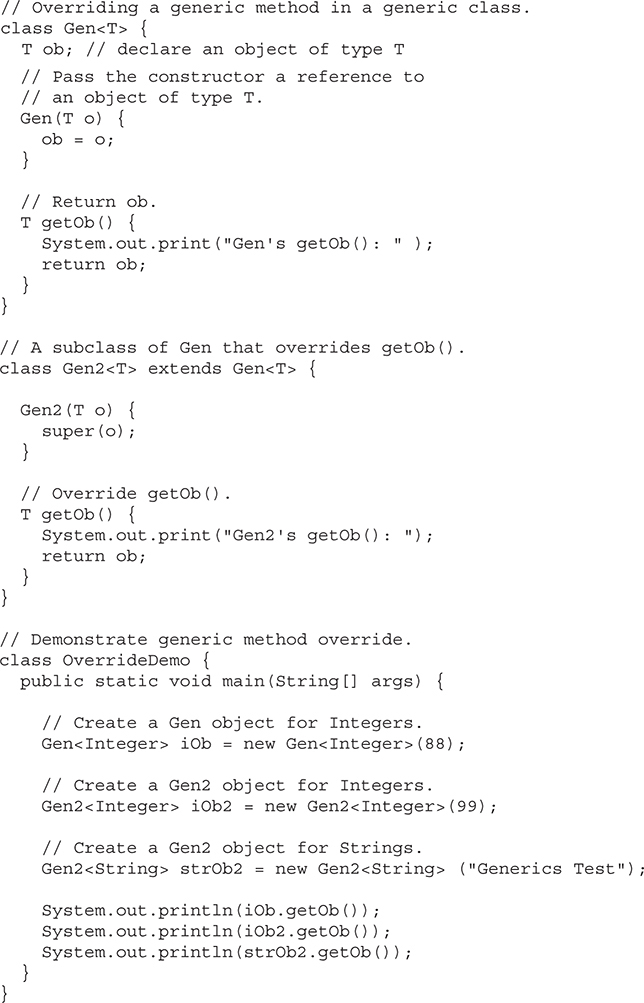
The output is shown here:

As the output confirms, the overridden version of getOb( ) is called for objects of type Gen2, but the superclass version is called for objects of type Gen.
Beginning with JDK 7, it became possible to shorten the syntax used to create an instance of a generic type. To begin, consider the following generic class:
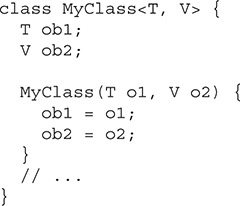
Prior to JDK 7, to create an instance of MyClass, you would have needed to use a statement similar to the following:

Here, the type arguments (which are Integer and String) are specified twice: first, when mcOb is declared, and second, when a MyClass instance is created via new. Since generics were introduced by JDK 5, this is the form required by all versions of Java prior to JDK 7. Although there is nothing wrong, per se, with this form, it is a bit more verbose than it needs to be. In the new clause, the type of the type arguments can be readily inferred from the type of mcOb; therefore, there is really no reason that they need to be specified a second time. To address this situation, JDK 7 added a syntactic element that lets you avoid the second specification.
Today the preceding declaration can be rewritten as shown here:
MyClass<Integer, String> mcOb = new MyClass<>(98, "A String");
Notice that the instance creation portion simply uses <>, which is an empty type argument list. This is referred to as the diamond operator. It tells the compiler to infer the type arguments needed by the constructor in the new expression. The principal advantage of this type-inference syntax is that it shortens what are sometimes quite long declaration statements.
The preceding can be generalized. When type inference is used, the declaration syntax for a generic reference and instance creation has this general form:
class-name<type-arg-list > var-name = new class-name <>(cons-arg-list);
Here, the type argument list of the constructor in the new clause is empty.
Type inference can also be applied to parameter passing. For example, if the following method is added to MyClass,

then the following call is legal:
if(mcOb.isSame(new MyClass<>(1, "test"))) System.out.println("Same");
In this case, the type arguments for the argument passed to isSame( ) can be inferred from the parameter’s type.
Most of the examples in this book will continue to use the full syntax when declaring instances of generic classes. This way, the examples will work with any Java compiler that supports generics. Using the full-length syntax also makes it very clear precisely what is being created, which is important in example code shown in a book. However, in your own code, the use of the type-inference syntax will streamline your declarations.
As just explained, type inference is already supported for generics through the use of the diamond operator. However, you can also use the local variable type inference feature added by JDK 10 with a generic class. For example, assuming MyClass used in the preceding section, this declaration:

can be rewritten like this using local variable type inference:
var mcOb = new MyClass<Integer, String>(98, "A String");
In this case, the type of mcOb is inferred to be MyClass<Integer, String> because that is the type of its initializer. Also notice that the use of var results in a shorter declaration than would be the case otherwise. In general, generic type names can often be quite long and (in some cases) complicated. The use of var is another way to substantially shorten such declarations. For the same reasons as just explained for the diamond operator, the remaining examples in this book will continue to use the full generic syntax, but in your own code the use of local variable type inference can be quite helpful.
Usually, it is not necessary to know the details about how the Java compiler transforms your source code into object code. However, in the case of generics, some general understanding of the process is important because it explains why the generic features work as they do—and why their behavior is sometimes a bit surprising. For this reason, a brief discussion of how generics are implemented in Java is in order.
An important constraint that governed the way that generics were added to Java was the need for compatibility with previous versions of Java. Simply put, generic code had to be compatible with preexisting, non-generic code. Thus, any changes to the syntax of the Java language, or to the JVM, had to avoid breaking older code. The way Java implements generics while satisfying this constraint is through the use of erasure.
In general, here is how erasure works. When your Java code is compiled, all generic type information is removed (erased). This means replacing type parameters with their bound type, which is Object if no explicit bound is specified, and then applying the appropriate casts (as determined by the type arguments) to maintain type compatibility with the types specified by the type arguments. The compiler also enforces this type compatibility. This approach to generics means that no type parameters exist at run time. They are simply a source-code mechanism.
Occasionally, the compiler will need to add a bridge method to a class to handle situations in which the type erasure of an overriding method in a subclass does not produce the same erasure as the method in the superclass. In this case, a method is generated that uses the type erasure of the superclass, and this method calls the method that has the type erasure specified by the subclass. Of course, bridge methods only occur at the bytecode level, are not seen by you, and are not available for your use.
Although bridge methods are not something that you will normally need to be concerned with, it is still instructive to see a situation in which one is generated. Consider the following program:
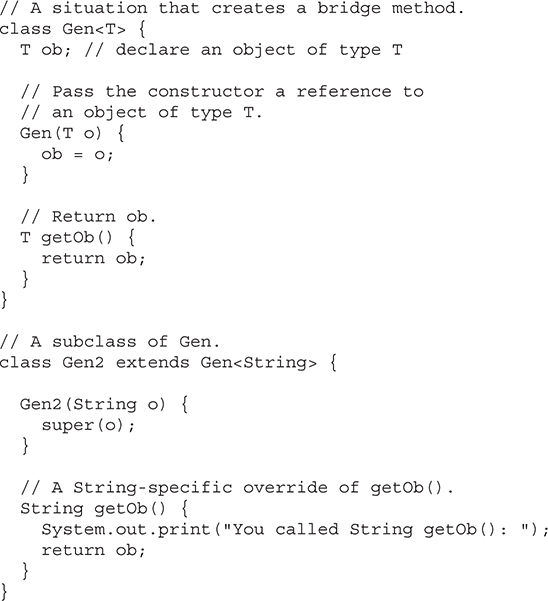
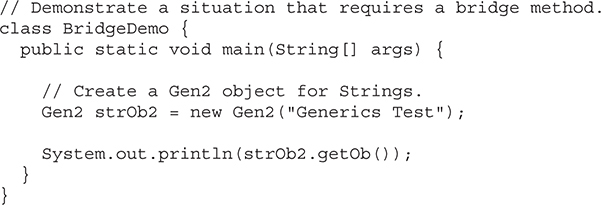
In the program, the subclass Gen2 extends Gen, but does so using a String-specific version of Gen, as its declaration shows:
class Gen2 extends Gen<String> {
Furthermore, inside Gen2, getOb( ) is overridden with String specified as the return type:

All of this is perfectly acceptable. The only trouble is that because of type erasure, the expected form of getOb( ) will be
Object getOb() { // ...
To handle this problem, the compiler generates a bridge method with the preceding signature that calls the String version. Thus, if you examine the class file for Gen2 by using javap, you will see the following methods:

As you can see, the bridge method has been included. (The comment was added by the author and not by javap, and the precise output you see may vary based on the version of Java that you are using.)
There is one last point to make about this example. Notice that the only difference between the two getOb( ) methods is their return type. Normally, this would cause an error, but because this does not occur in your source code, it does not cause a problem and is handled correctly by the JVM.
The inclusion of generics gives rise to another type of error that you must guard against: ambiguity. Ambiguity errors occur when erasure causes two seemingly distinct generic declarations to resolve to the same erased type, causing a conflict. Here is an example that involves method overloading:
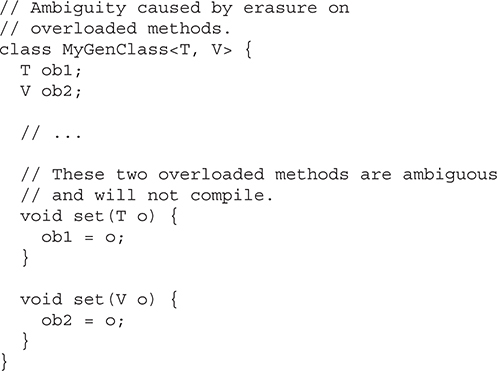
Notice that MyGenClass declares two generic types: T and V. Inside MyGenClass, an attempt is made to overload set( ) based on parameters of type T and V. This looks reasonable because T and V appear to be different types. However, there are two ambiguity problems here.
First, as MyGenClass is written, there is no requirement that T and V actually be different types. For example, it is perfectly correct (in principle) to construct a MyGenClass object as shown here:
MyGenClass<String, String> obj = new MyGenClass<String, String>()
In this case, both T and V will be replaced by String. This makes both versions of set( ) identical, which is, of course, an error.
The second and more fundamental problem is that the type erasure of set( ) reduces both versions to the following:
void set(Object o) { // ...
Thus, the overloading of set( ) as attempted in MyGenClass is inherently ambiguous.
Ambiguity errors can be tricky to fix. For example, if you know that V will always be some type of Number, you might try to fix MyGenClass by rewriting its declaration as shown here:
class MyGenClass<T, V extends Number> { // almost OK!
This change causes MyGenClass to compile, and you can even instantiate objects like the one shown here:
MyGenClass<String, Number> x = new MyGenClass<String, Number>();
This works because Java can accurately determine which method to call. However, ambiguity returns when you try this line:
MyGenClass<Number, Number> x = new MyGenClass<Number, Number>();
In this case, since both T and V are Number, which version of set( ) is to be called? The call to set( ) is now ambiguous.
Frankly, in the preceding example, it would be much better to use two separate method names, rather than trying to overload set( ). Often, the solution to ambiguity involves the restructuring of the code, because ambiguity frequently means that you have a conceptual error in your design.
There are a few restrictions that you need to keep in mind when using generics. They involve creating objects of a type parameter, static members, exceptions, and arrays. Each is examined here.
It is not possible to create an instance of a type parameter. For example, consider this class:
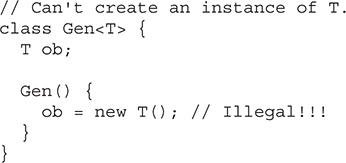
Here, it is illegal to attempt to create an instance of T. The reason should be easy to understand: the compiler does not know what type of object to create. T is simply a placeholder.
No static member can use a type parameter declared by the enclosing class. For example, both of the static members of this class are illegal:
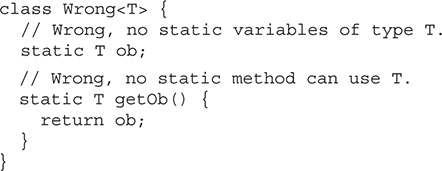
Although you can’t declare static members that use a type parameter declared by the enclosing class, you can declare static generic methods, which define their own type parameters, as was done earlier in this chapter.
There are two important generics restrictions that apply to arrays. First, you cannot instantiate an array whose element type is a type parameter. Second, you cannot create an array of type-specific generic references. The following short program shows both situations:
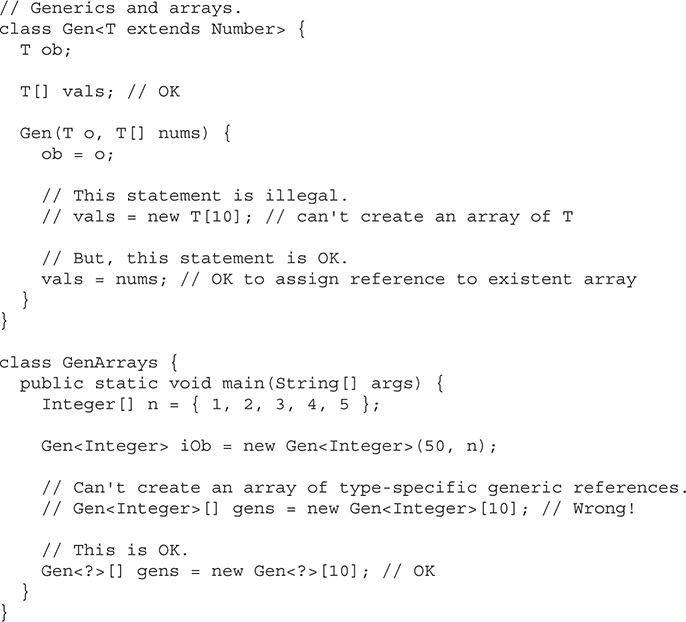
As the program shows, it’s valid to declare a reference to an array of type T, as this line does:
T[] vals; // OK
But, you cannot instantiate an array of T, as this commented-out line attempts:
// vals = new T[10]; // can't create an array of T
The reason you can’t create an array of T is that there is no way for the compiler to know what type of array to actually create.
However, you can pass a reference to a type-compatible array to Gen( ) when an object is created and assign that reference to vals, as the program does in this line:
vals = nums; // OK to assign reference to existent array
This works because the array passed to Gen has a known type, which will be the same type as T at the time of object creation.
Inside main( ), notice that you can’t declare an array of references to a specific generic type. That is, this line
// Gen<Integer>[] gens = new Gen<Integer>[10]; // Wrong!
won’t compile.
You can create an array of references to a generic type if you use a wildcard, however, as shown here:
Gen<?>[] gens = new Gen<?>[10]; // OK
This approach is better than using an array of raw types, because at least some type checking will still be enforced.
A generic class cannot extend Throwable. This means that you cannot create generic exception classes.
During Java’s ongoing development and evolution, many features have been added since its original 1.0 release. However, two stand out because they have profoundly reshaped the language, fundamentally changing the way that code is written. The first was the addition of generics, added by JDK 5. (See Chapter 14.) The second is the lambda expression, which is the subject of this chapter.
Added by JDK 8, lambda expressions (and their related features) significantly enhanced Java because of two primary reasons. First, they added new syntax elements that increased the expressive power of the language. In the process, they streamlined the way that certain common constructs are implemented. Second, the addition of lambda expressions resulted in new capabilities being incorporated into the API library. Among these new capabilities are the ability to more easily take advantage of the parallel processing capabilities of multicore environments, especially as it relates to the handling of for-each style operations, and the new stream API, which supports pipeline operations on data. The addition of lambda expressions also provided the catalyst for other new Java features, including the default method (described in Chapter 9), which lets you define default behavior for an interface method, and the method reference (described here), which lets you refer to a method without executing it.
In the final analysis, in much the same way that generics reshaped Java several years ago, lambda expressions continue to reshape Java today. Simply put, lambda expressions will impact virtually all Java programmers. They truly are that important.
Key to understanding Java’s implementation of lambda expressions are two constructs. The first is the lambda expression, itself. The second is the functional interface. Let’s begin with a simple definition of each.
A lambda expression is, essentially, an anonymous (that is, unnamed) method. However, this method is not executed on its own. Instead, it is used to implement a method defined by a functional interface. Thus, a lambda expression results in a form of anonymous class. Lambda expressions are also commonly referred to as closures.
A functional interface is an interface that contains one and only one abstract method. Normally, this method specifies the intended purpose of the interface. Thus, a functional interface typically represents a single action. For example, the standard interface Runnable is a functional interface because it defines only one method: run( ). Therefore, run( ) defines the action of Runnable. Furthermore, a functional interface defines the target type of a lambda expression. Here is a key point: a lambda expression can be used only in a context in which its target type is specified. One other thing: a functional interface is sometimes referred to as a SAM type, where SAM stands for Single Abstract Method.
Note A functional interface may specify any public method defined by Object, such as equals( ), without affecting its “functional interface” status. The public Object methods are considered implicit members of a functional interface because they are automatically implemented by an instance of a functional interface.
Let’s now look more closely at both lambda expressions and functional interfaces.
The lambda expression introduced a new syntax element and operator into the Java language. The new operator, sometimes referred to as the lambda operator or the arrow operator, is –>. It divides a lambda expression into two parts. The left side specifies any parameters required by the lambda expression. (If no parameters are needed, an empty parameter list is used.) On the right side is the lambda body, which specifies the actions of the lambda expression. The –> can be verbalized as “becomes” or “goes to.”
Java defines two types of lambda bodies. One consists of a single expression, and the other type consists of a block of code. We will begin with lambdas that define a single expression. Lambdas with block bodies are discussed later in this chapter.
At this point, it will be helpful to look at a few examples of lambda expressions before continuing. Let’s begin with what is probably the simplest type of lambda expression you can write. It evaluates to a constant value and is shown here:
() -> 123.45
This lambda expression takes no parameters, thus the parameter list is empty. It returns the constant value 123.45. Therefore, it is similar to the following method:
double myMeth() { return 123.45; }
Of course, the method defined by a lambda expression does not have a name.
A slightly more interesting lambda expression is shown here:
() -> Math.random() * 100
This lambda expression obtains a pseudo-random value from Math.random( ), multiplies it by 100, and returns the result. It, too, does not require a parameter.
When a lambda expression requires a parameter, it is specified in the parameter list on the left side of the lambda operator. Here is a simple example:
(n) -> (n % 2)==0
This lambda expression returns true if the value of parameter n is even. Although it is possible to explicitly specify the type of a parameter, such as n in this case, often you won’t need to do so because in many cases its type can be inferred. Like a named method, a lambda expression can specify as many parameters as needed.
As stated, a functional interface is an interface that specifies only one abstract method. If you have been programming in Java for some time, you might at first think that all interface methods are implicitly abstract. Although this was true prior to JDK 8, the situation has changed. As explained in Chapter 9, beginning with JDK 8, it is possible to specify a default implementation for a method declared in an interface. Private and static interface methods also supply an implementation. As a result, today, an interface method is abstract only if it does not specify an implementation. Because non-default, non-static, non-private interface methods are implicitly abstract, there is no need to use the abstract modifier (although you can specify it, if you like).
Here is an example of a functional interface:

In this case, the method getValue( ) is implicitly abstract, and it is the only method defined by MyNumber. Thus, MyNumber is a functional interface, and its function is defined by getValue( ).
As mentioned earlier, a lambda expression is not executed on its own. Rather, it forms the implementation of the abstract method defined by the functional interface that specifies its target type. As a result, a lambda expression can be specified only in a context in which a target type is defined. One of these contexts is created when a lambda expression is assigned to a functional interface reference. Other target type contexts include variable initialization, return statements, and method arguments, to name a few.
Let’s work through an example that shows how a lambda expression can be used in an assignment context. First, a reference to the functional interface MyNumber is declared:
// Create a reference to a MyNumber instance.
MyNumber myNum;
Next, a lambda expression is assigned to that interface reference:
// Use a lambda in an assignment context.
myNum = () -> 123.45;
When a lambda expression occurs in a target type context, an instance of a class is automatically created that implements the functional interface, with the lambda expression defining the behavior of the abstract method declared by the functional interface. When that method is called through the target, the lambda expression is executed. Thus, a lambda expression gives us a way to transform a code segment into an object.
In the preceding example, the lambda expression becomes the implementation for the getValue( ) method. As a result, the following displays the value 123.45:
// Call getValue(), which is implemented by the previously assigned
// lambda expression.
System.out.println(myNum.getValue());
Because the lambda expression assigned to myNum returns the value 123.45, that is the value obtained when getValue( ) is called.
In order for a lambda expression to be used in a target type context, the type of the abstract method and the type of the lambda expression must be compatible. For example, if the abstract method specifies two int parameters, then the lambda must specify two parameters whose type either is explicitly int or can be implicitly inferred as int by the context. In general, the type and number of the lambda expression’s parameters must be compatible with the method’s parameters; the return types must be compatible; and any exceptions thrown by the lambda expression must be acceptable to the method.
With the preceding discussion in mind, let’s look at some simple examples that illustrate the basic lambda expression concepts. The first example puts together the pieces shown in the foregoing section.

Sample output from the program is shown here:

As mentioned, the lambda expression must be compatible with the abstract method that it is intended to implement. For this reason, the commented-out line at the end of the preceding program is illegal because a value of type String is not compatible with double, which is the return type required by getValue( ).
The next example shows the use of a parameter with a lambda expression:
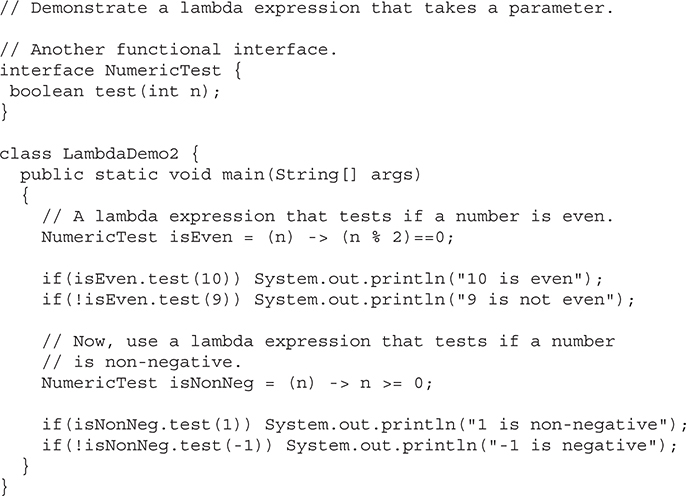
The output from this program is shown here:

This program demonstrates a key fact about lambda expressions that warrants close examination. Pay special attention to the lambda expression that performs the test for evenness. It is shown again here:
(n) -> (n % 2)==0
Notice that the type of n is not specified. Rather, its type is inferred from the context. In this case, its type is inferred from the parameter type of test( ) as defined by the NumericTest interface, which is int. It is also possible to explicitly specify the type of a parameter in a lambda expression. For example, this is also a valid way to write the preceding:
(int n) -> (n % 2)==0
Here, n is explicitly specified as int. Usually it is not necessary to explicitly specify the type, but you can in those situations that require it. Beginning with JDK 11, you can also use var to explicitly indicate local variable type inference for a lambda expression parameter.
This program demonstrates another important point about lambda expressions: A functional interface reference can be used to execute any lambda expression that is compatible with it. Notice that the program defines two different lambda expressions that are compatible with the test( ) method of the functional interface NumericTest. The first, called isEven, determines if a value is even. The second, called isNonNeg, checks if a value is non-negative. In each case, the value of the parameter n is tested. Because each lambda expression is compatible with test( ), each can be executed through a NumericTest reference.
One other point before moving on. When a lambda expression has only one parameter, it is not necessary to surround the parameter name with parentheses when it is specified on the left side of the lambda operator. For example, this is also a valid way to write the lambda expression used in the program:
n -> (n % 2)==0
For consistency, this book will surround all lambda expression parameter lists with parentheses, even those containing only one parameter. Of course, you are free to adopt a different style.
The next program demonstrates a lambda expression that takes two parameters. In this case, the lambda expression tests if one number is a factor of another.
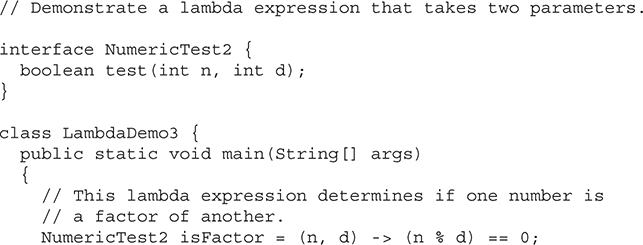

The output is shown here:
2 is a factor of 10
3 is not a factor of 10
In this program, the functional interface NumericTest2 defines the test( ) method:
boolean test(int n, int d);
In this version, test( ) specifies two parameters. Thus, for a lambda expression to be compatible with test( ), the lambda expression must also specify two parameters. Notice how they are specified:
(n, d) -> (n % d) == 0
The two parameters, n and d, are specified in the parameter list, separated by commas. This example can be generalized. Whenever more than one parameter is required, the parameters are specified, separated by commas, in a parenthesized list on the left side of the lambda operator.
Here is an important point about multiple parameters in a lambda expression: If you need to explicitly declare the type of a parameter, then all of the parameters must have declared types. For example, this is legal:
(int n, int d) -> (n % d) == 0
But this is not:
(int n, d) -> (n % d) == 0
The body of the lambdas shown in the preceding examples consist of a single expression. These types of lambda bodies are referred to as expression bodies, and lambdas that have expression bodies are sometimes called expression lambdas. In an expression body, the code on the right side of the lambda operator must consist of a single expression. While expression lambdas are quite useful, sometimes the situation will require more than a single expression. To handle such cases, Java supports a second type of lambda expression in which the code on the right side of the lambda operator consists of a block of code that can contain more than one statement. This type of lambda body is called a block body. Lambdas that have block bodies are sometimes referred to as block lambdas.
A block lambda expands the types of operations that can be handled within a lambda expression because it allows the body of the lambda to contain multiple statements. For example, in a block lambda you can declare variables, use loops, specify if and switch statements, create nested blocks, and so on. A block lambda is easy to create. Simply enclose the body within braces as you would any other block of statements.
Aside from allowing multiple statements, block lambdas are used much like the expression lambdas just discussed. One key difference, however, is that you must explicitly use a return statement to return a value. This is necessary because a block lambda body does not represent a single expression.
Here is an example that uses a block lambda to compute and return the factorial of an int value:
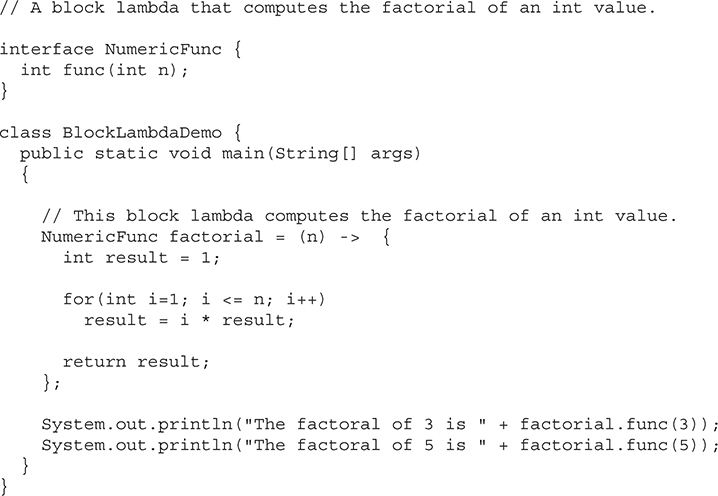
The output is shown here:

In the program, notice that the block lambda declares a variable called result, uses a for loop, and has a return statement. These are legal inside a block lambda body. In essence, the block body of a lambda is similar to a method body. One other point. When a return statement occurs within a lambda expression, it simply causes a return from the lambda. It does not cause an enclosing method to return.
Another example of a block lambda is shown in the following program. It reverses the characters in a string.
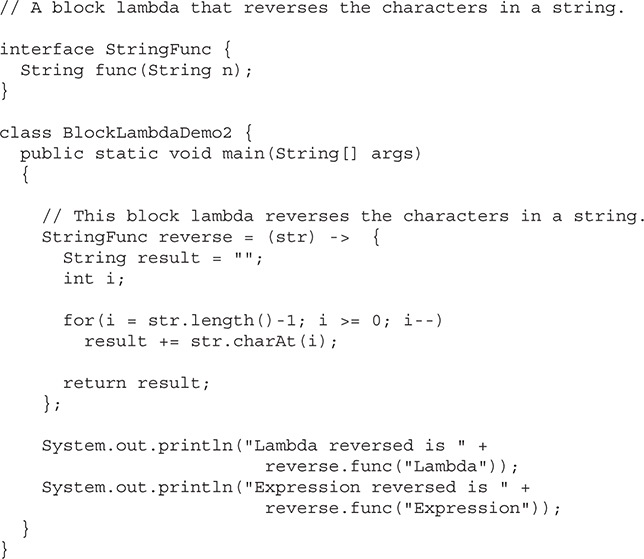
The output is shown here:
Lambda reversed is adbmaL
Expression reversed is noisserpxE
In this example, the functional interface StringFunc declares the func( ) method. This method takes a parameter of type String and has a return type of String. Thus, in the reverse lambda expression, the type of str is inferred to be String. Notice that the charAt( ) method is called on str. This is legal because of the inference that str is of type String.
A lambda expression, itself, cannot specify type parameters. Thus, a lambda expression cannot be generic. (Of course, because of type inference, all lambda expressions exhibit some “generic-like” qualities.) However, the functional interface associated with a lambda expression can be generic. In this case, the target type of the lambda expression is determined, in part, by the type argument or arguments specified when a functional interface reference is declared.
To understand the value of generic functional interfaces, consider this. The two examples in the previous section used two different functional interfaces, one called NumericFunc and the other called StringFunc. However, both defined a method called func( ) that took one parameter and returned a result. In the first case, the type of the parameter and return type was int. In the second case, the parameter and return type was String. Thus, the only difference between the two methods was the type of data they required. Instead of having two functional interfaces whose methods differ only in their data types, it is possible to declare one generic interface that can be used to handle both circumstances. The following program shows this approach:
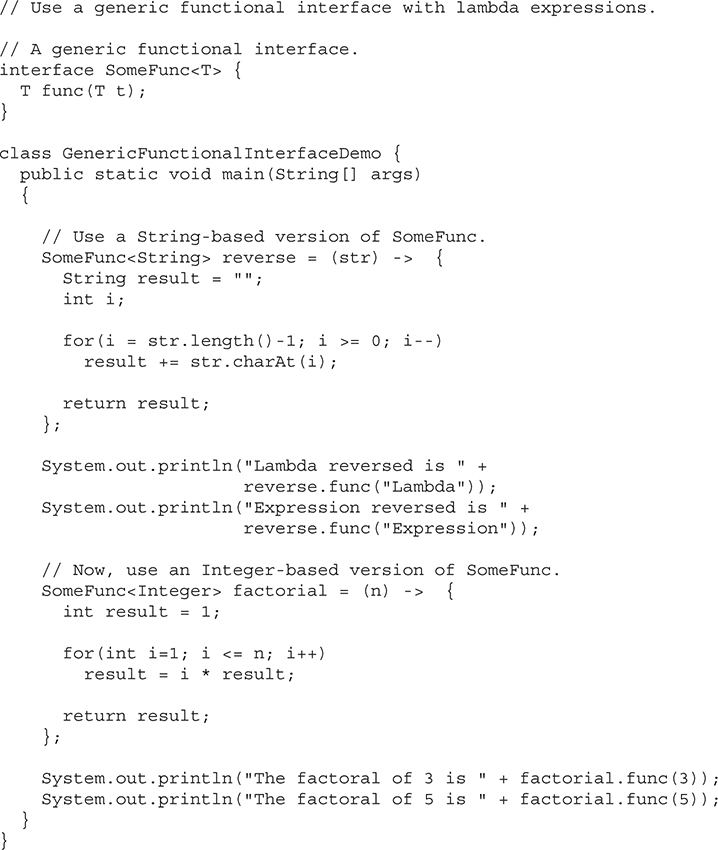
The output is shown here:

In the program, the generic functional interface SomeFunc is declared as shown here:

Here, T specifies both the return type and the parameter type of func( ). This means that it is compatible with any lambda expression that takes one parameter and returns a value of the same type.
The SomeFunc interface is used to provide a reference to two different types of lambdas. The first uses type String. The second uses type Integer. Thus, the same functional interface can be used to refer to the reverse lambda and the factorial lambda. Only the type argument passed to SomeFunc differs.
As explained earlier, a lambda expression can be used in any context that provides a target type. One of these is when a lambda expression is passed as an argument. In fact, passing a lambda expression as an argument is a common use of lambdas. Moreover, it is a very powerful use because it gives you a way to pass executable code as an argument to a method. This greatly enhances the expressive power of Java.
To pass a lambda expression as an argument, the type of the parameter receiving the lambda expression argument must be of a functional interface type compatible with the lambda. Although using a lambda expression as an argument is straightforward, it is still helpful to see it in action. The following program demonstrates the process:
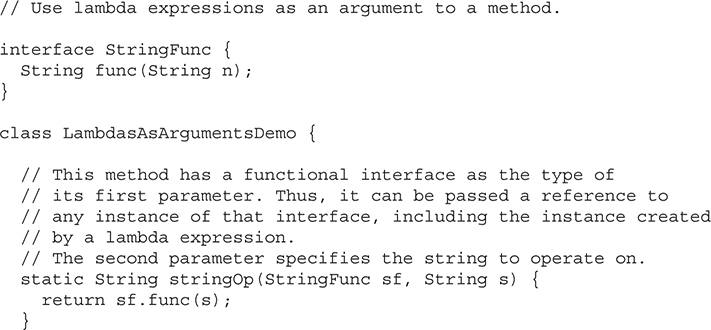
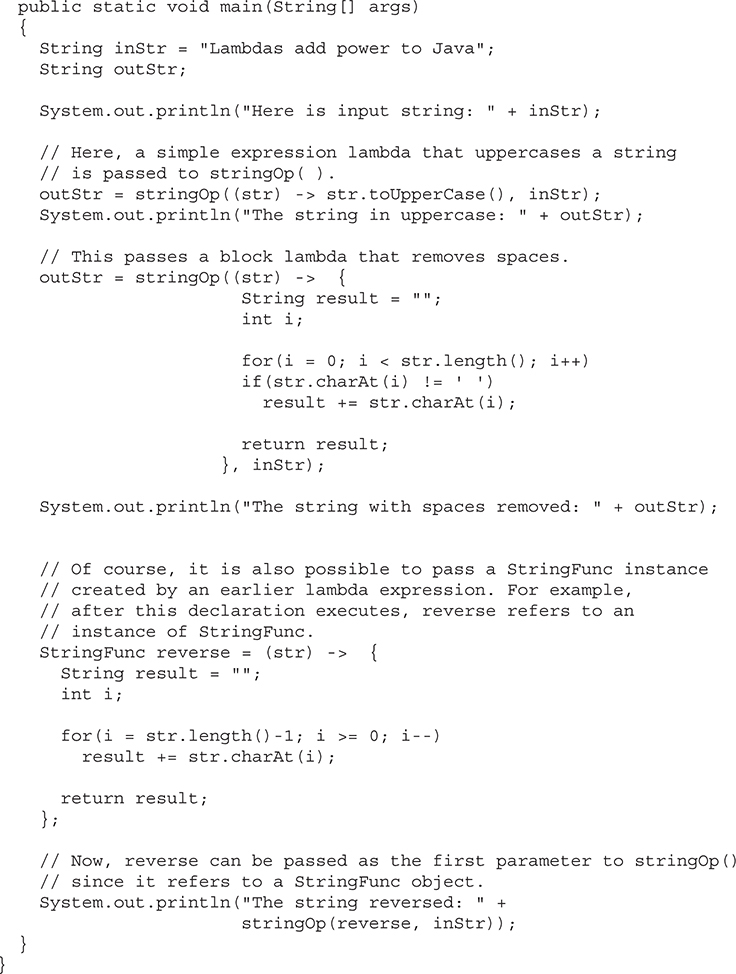
The output is shown here:

In the program, first notice the stringOp( ) method. It has two parameters. The first is of type StringFunc, which is a functional interface. Thus, this parameter can receive a reference to any instance of StringFunc, including one created by a lambda expression. The second argument of stringOp( ) is of type String, and this is the string operated on.
Next, notice the first call to stringOp( ), shown again here:
outStr = stringOp((str) -> str.toUpperCase(), inStr);
Here, a simple expression lambda is passed as an argument. When this occurs, an instance of the functional interface StringFunc is created and a reference to that object is passed to the first parameter of stringOp( ). Thus, the lambda code, embedded in a class instance, is passed to the method. The target type context is determined by the type of parameter. Because the lambda expression is compatible with that type, the call is valid. Embedding simple lambdas, such as the one just shown, inside a method call is often a convenient technique—especially when the lambda expression is intended for a single use.
Next, the program passes a block lambda to stringOp( ). This lambda removes spaces from a string. It is shown again here:
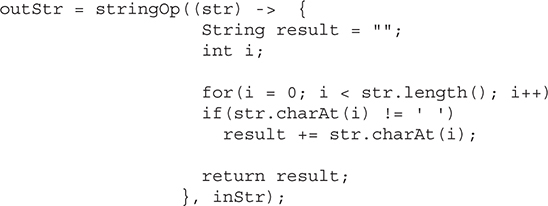
Although this uses a block lambda, the process of passing the lambda expression is the same as just described for the simple expression lambda. In this case, however, some programmers will find the syntax a bit awkward.
When a block lambda seems overly long to embed in a method call, it is an easy matter to assign that lambda to a functional interface variable, as the previous examples have done. Then, you can simply pass that reference to the method. This technique is shown at the end of the program. There, a block lambda is defined that reverses a string. This lambda is assigned to reverse, which is a reference to a StringFunc instance. Thus, reverse can be used as an argument to the first parameter of stringOp( ). The program then calls stringOp( ), passing in reverse and the string on which to operate. Because the instance obtained by the evaluation of each lambda expression is an implementation of StringFunc, each can be used as the first parameter to stringOp( ).
One last point: In addition to variable initialization, assignment, and argument passing, the following also constitute target type contexts: casts, the ? operator, array initializers, return statements, and lambda expressions, themselves.
A lambda expression can throw an exception. However, it if throws a checked exception, then that exception must be compatible with the exception(s) listed in the throws clause of the abstract method in the functional interface. Here is an example that illustrates this fact. It computes the average of an array of double values. If a zero-length array is passed, however, it throws the custom exception EmptyArrayException. As the example shows, this exception is listed in the throws clause of func( ) declared inside the DoubleNumericArrayFunc functional interface.
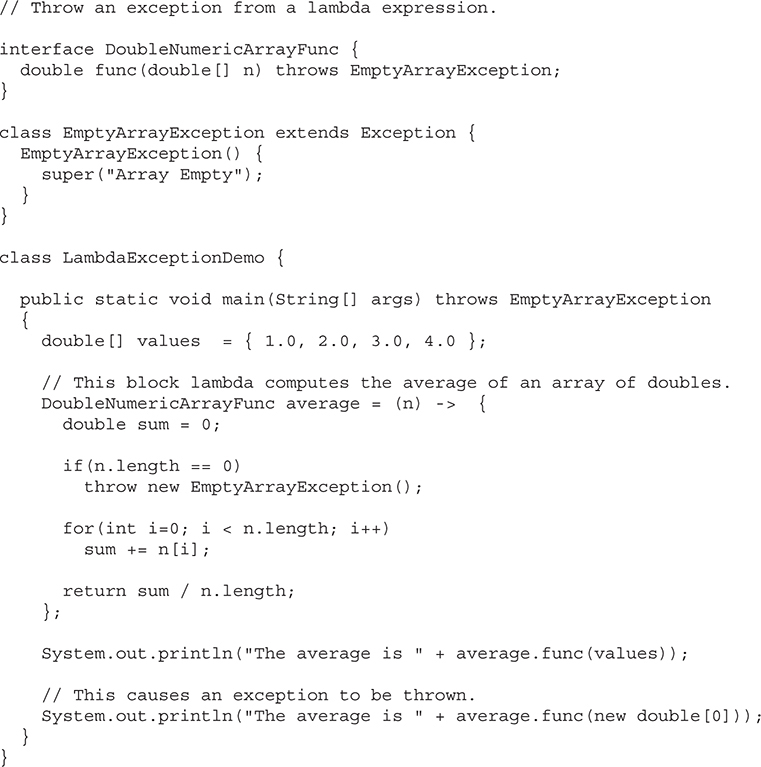
The first call to average.func( ) returns the value 2.5. The second call, which passes a zero-length array, causes an EmptyArrayException to be thrown. Remember, the inclusion of the throws clause in func( ) is necessary. Without it, the program will not compile because the lambda expression will no longer be compatible with func( ).
This example demonstrates another important point about lambda expressions. Notice that the parameter specified by func( ) in the functional interface DoubleNumericArrayFunc is an array. However, the parameter to the lambda expression is simply n, rather than n[ ]. Remember, the type of a lambda expression parameter will be inferred from the target context. In this case, the target context is double[ ], thus the type of n will be double[ ]. It is not necessary (or legal) to specify it as n[ ]. It would be legal to explicitly declare it as double[ ] n, but doing so gains nothing in this case.
Variables defined by the enclosing scope of a lambda expression are accessible within the lambda expression. For example, a lambda expression can use an instance or static variable defined by its enclosing class. A lambda expression also has access to this (both explicitly and implicitly), which refers to the invoking instance of the lambda expression’s enclosing class. Thus, a lambda expression can obtain or set the value of an instance or static variable and call a method defined by its enclosing class.
However, when a lambda expression uses a local variable from its enclosing scope, a special situation is created that is referred to as a variable capture. In this case, a lambda expression may only use local variables that are effectively final. An effectively final variable is one whose value does not change after it is first assigned. There is no need to explicitly declare such a variable as final, although doing so would not be an error. (The this parameter of an enclosing scope is automatically effectively final, and lambda expressions do not have a this of their own.)
It is important to understand that a local variable of the enclosing scope cannot be modified by the lambda expression. Doing so would remove its effectively final status, thus rendering it illegal for capture.
The following program illustrates the difference between effectively final and mutable local variables:
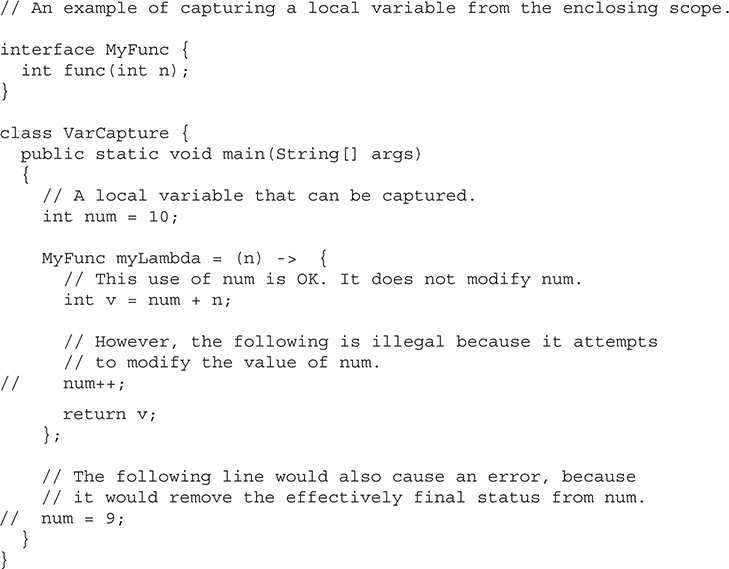
As the comments indicate, num is effectively final and can, therefore, be used inside myLambda. However, if num were to be modified, either inside the lambda or outside of it, num would lose its effectively final status. This would cause an error, and the program would not compile.
It is important to emphasize that a lambda expression can use and modify an instance variable from its invoking class. It just can’t use a local variable of its enclosing scope unless that variable is effectively final.
There is an important feature related to lambda expressions called the method reference. A method reference provides a way to refer to a method without executing it. It relates to lambda expressions because it, too, requires a target type context that consists of a compatible functional interface. When evaluated, a method reference also creates an instance of the functional interface.
There are different types of method references. We will begin with method references to static methods.
To create a static method reference, use this general syntax:
ClassName::methodName
Notice that the class name is separated from the method name by a double colon. The :: is a separator that was added to Java by JDK 8 expressly for this purpose. This method reference can be used anywhere in which it is compatible with its target type.
The following program demonstrates a static method reference:
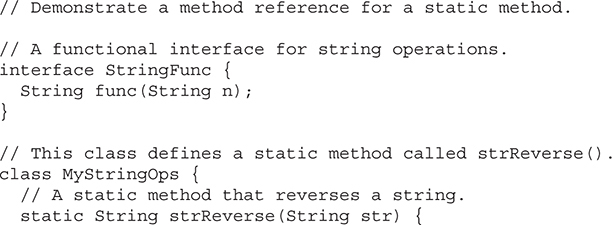
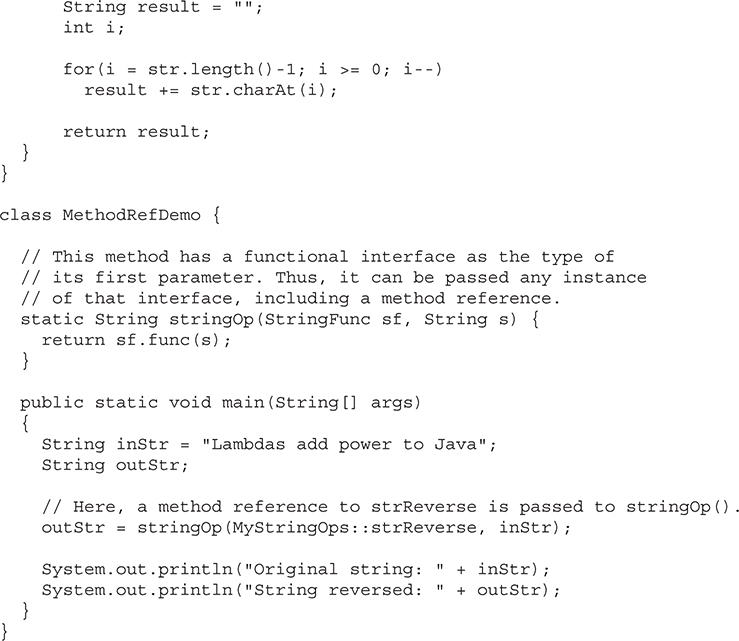
The output is shown here:
Original string: Lambdas add power to Java
String reversed: avaJ ot rewop dda sadbmaL
In the program, pay special attention to this line:
outStr = stringOp(MyStringOps::strReverse, inStr);
Here, a reference to the static method strReverse( ), declared inside MyStringOps, is passed as the first argument to stringOp( ). This works because strReverse is compatible with the StringFunc functional interface. Thus, the expression MyStringOps::strReverse evaluates to a reference to an object in which strReverse provides the implementation of func( ) in StringFunc.
To pass a reference to an instance method on a specific object, use this basic syntax:
objRef::methodName
As you can see, the syntax is similar to that used for a static method, except that an object reference is used instead of a class name. Here is the previous program rewritten to use an instance method reference:
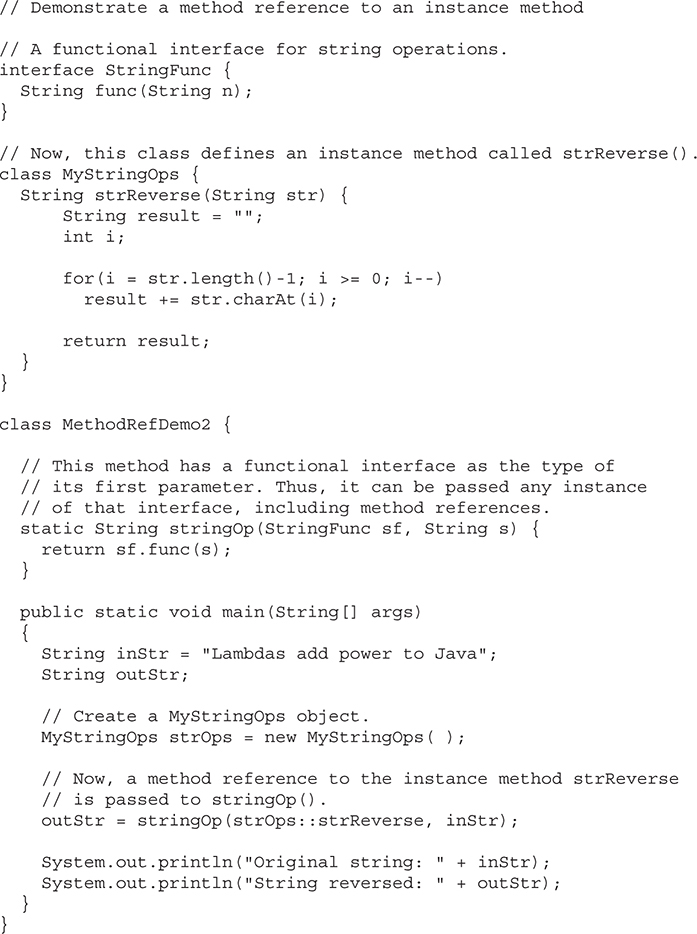
This program produces the same output as the previous version.
In the program, notice that strReverse( ) is now an instance method of MyStringOps. Inside main( ), an instance of MyStringOps called strOps is created. This instance is used to create the method reference to strReverse in the call to stringOp, as shown again, here:
outStr = stringOp(strOps::strReverse, inStr);
In this example, strReverse( ) is called on the strOps object.
It is also possible to handle a situation in which you want to specify an instance method that can be used with any object of a given class—not just a specified object. In this case, you will create a method reference as shown here:
ClassName::instanceMethodName
Here, the name of the class is used instead of a specific object, even though an instance method is specified. With this form, the first parameter of the functional interface matches the invoking object and the second parameter matches the parameter specified by the method. Here is an example. It defines a method called counter( ) that counts the number of objects in an array that satisfy the condition defined by the func( ) method of the MyFunc functional interface. In this case, it counts instances of the HighTemp class.
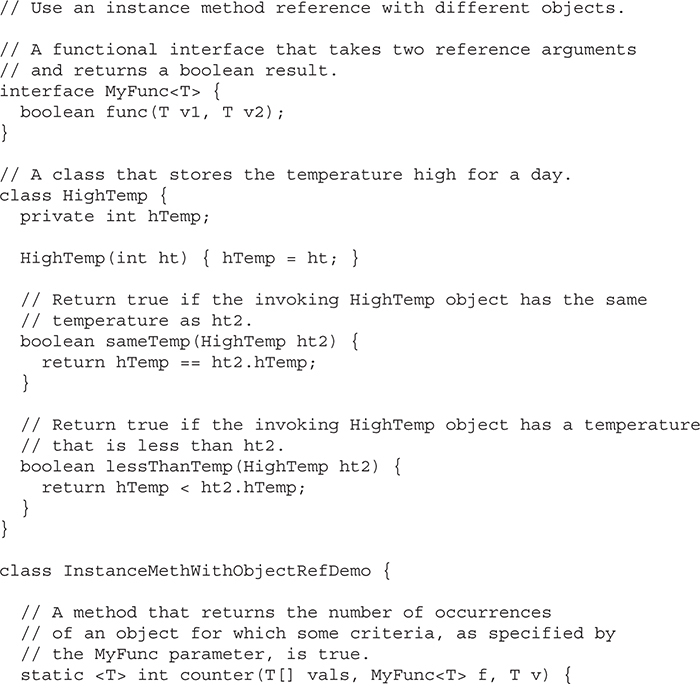
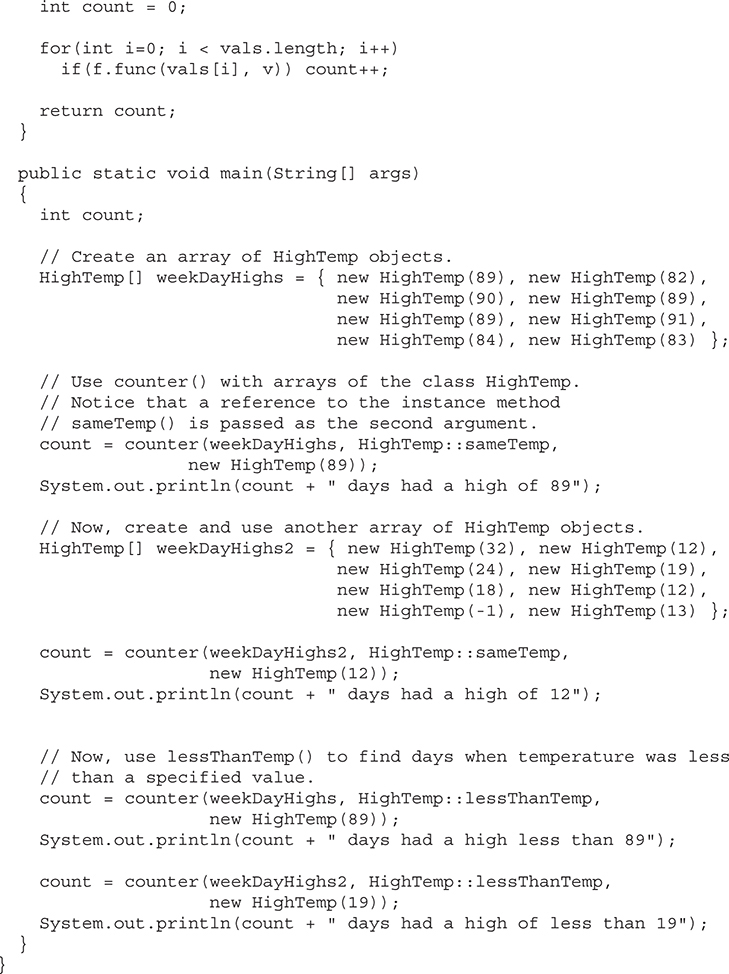
The output is shown here:

In the program, notice that HighTemp has two instance methods: sameTemp( ) and lessThanTemp( ). The first returns true if two HighTemp objects contain the same temperature. The second returns true if the temperature of the invoking object is less than that of the passed object. Each method has a parameter of type HighTemp and each method returns a boolean result. Thus, each is compatible with the MyFunc functional interface because the invoking object type can be mapped to the first parameter of func( ) and the argument mapped to func( )’s second parameter. Thus, when the expression
HighTemp::sameTemp
is passed to the counter( ) method, an instance of the functional interface MyFunc is created in which the parameter type of the first parameter is that of the invoking object of the instance method, which is HighTemp. The type of the second parameter is also HighTemp because that is the type of the parameter to sameTemp( ). The same is true for the lessThanTemp( ) method.
One other point: you can refer to the superclass version of a method by use of super, as shown here:
super::name
The name of the method is specified by name. Another form is
typeName.super::name
where typeName refers to an enclosing class or super interface.
You can use method references with generic classes and/or generic methods. For example, consider the following program:
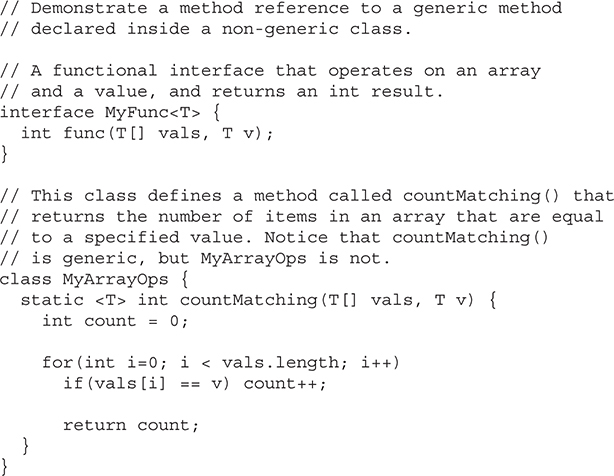
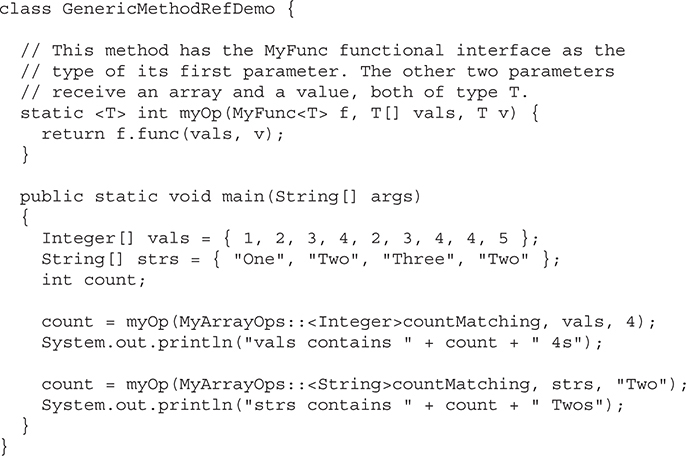
The output is shown here:
vals contains 3 4s
strs contains 2 Twos
In the program, MyArrayOps is a non-generic class that contains a generic method called countMatching( ). The method returns a count of the elements in an array that match a specified value. Notice how the generic type argument is specified. For example, its first call in main( ), shown here:
count = myOp(MyArrayOps::<Integer>countMatching, vals, 4);
passes the type argument Integer. Notice that it occurs after the ::. This syntax can be generalized: When a generic method is specified as a method reference, its type argument comes after the :: and before the method name. It is important to point out, however, that explicitly specifying the type argument is not required in this situation (and many others) because the type argument would have been automatically inferred. In cases in which a generic class is specified, the type argument follows the class name and precedes the ::.
Although the preceding examples show the mechanics of using method references, they don’t show their real benefits. One place method references can be quite useful is in conjunction with the Collections Framework, which is described later in Chapter 20. However, for completeness, a short, but effective, example that uses a method reference to help determine the largest element in a collection is included here. (If you are unfamiliar with the Collections Framework, return to this example after you have worked through Chapter 20.)
One way to find the largest element in a collection is to use the max( ) method defined by the Collections class. For the version of max( ) used here, you must pass a reference to the collection and an instance of an object that implements the Comparator<T> interface. This interface specifies how two objects are compared. It defines only one abstract method, called compare( ), that takes two arguments, each the type of the objects being compared. It must return greater than zero if the first argument is greater than the second, zero if the two arguments are equal, and less than zero if the first object is less than the second.
In the past, to use max( ) with user-defined objects, an instance of Comparator<T> had to be obtained by first explicitly implementing it by a class, and then creating an instance of that class. This instance was then passed as the comparator to max( ). Beginning with JDK 8, it is now possible to simply pass a reference to a comparison method to max( ) because doing so automatically implements the comparator. The following simple example shows the process by creating an ArrayList of MyClass objects and then finding the one in the list that has the highest value (as defined by the comparison method).
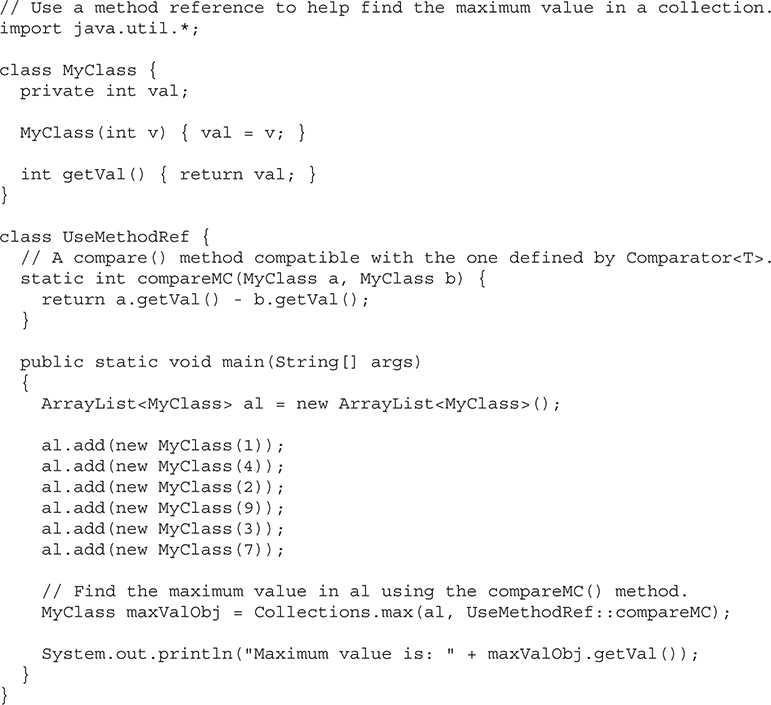
The output is shown here:
Maximum value is: 9
In the program, notice that MyClass neither defines any comparison method of its own, nor does it implement Comparator. However, the maximum value of a list of MyClass items can still be obtained by calling max( ) because UseMethodRef defines the static method compareMC( ), which is compatible with the compare( ) method defined by Comparator. Therefore, there is no need to explicitly implement and create an instance of Comparator.
Similar to the way that you can create references to methods, you can create references to constructors. Here is the general form of the syntax that you will use:
classname::new
This reference can be assigned to any functional interface reference that defines a method compatible with the constructor. Here is a simple example:
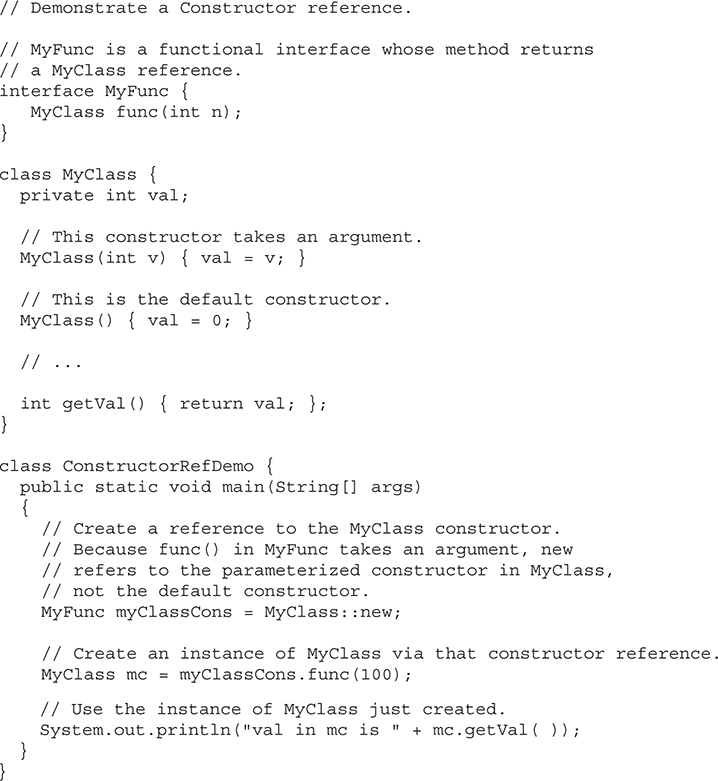
The output is shown here:
val in mc is 100
In the program, notice that the func( ) method of MyFunc returns a reference of type MyClass and has an int parameter. Next, notice that MyClass defines two constructors. The first specifies a parameter of type int. The second is the default, parameterless constructor. Now, examine the following line:
MyFunc myClassCons = MyClass::new;
Here, the expression MyClass::new creates a constructor reference to a MyClass constructor. In this case, because MyFunc’s func( ) method takes an int parameter, the constructor being referred to is MyClass(int v) because it is the one that matches. Also notice that the reference to this constructor is assigned to a MyFunc reference called myClassCons. After this statement executes, myClassCons can be used to create an instance of MyClass, as this line shows:
MyClass mc = myClassCons.func(100);
In essence, myClassCons has become another way to call MyClass(int v).
Constructor references to generic classes are created in the same fashion. The only difference is that the type argument can be specified. This works the same as it does for using a generic class to create a method reference: simply specify the type argument after the class name. The following illustrates this by modifying the previous example so that MyFunc and MyClass are generic.
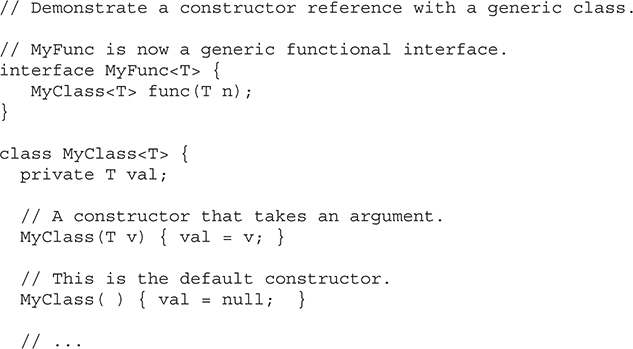
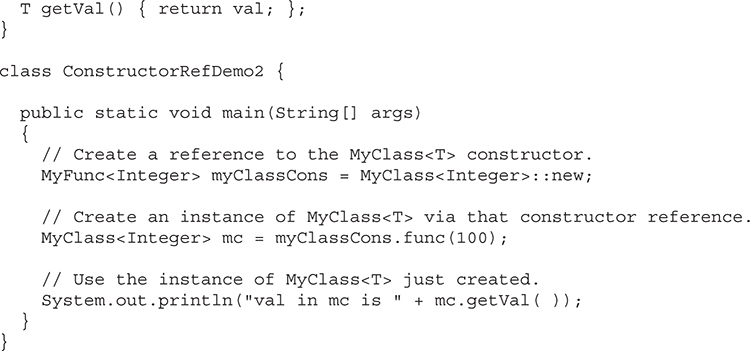
This program produces the same output as the previous version. The difference is that now both MyFunc and MyClass are generic. Thus, the sequence that creates a constructor reference can include a type argument (although one is not always needed), as shown here:
MyFunc<Integer> myClassCons = MyClass<Integer>::new;
Because the type argument Integer has already been specified when myClassCons is created, it can be used to create a MyClass<Integer> object, as the next line shows:
MyClass<Integer> mc = myClassCons.func(100);
Although the preceding examples demonstrate the mechanics of using a constructor reference, no one would use a constructor reference as just shown because nothing is gained. Furthermore, having what amounts to two names for the same constructor creates a confusing situation (to say the least). However, to give you the flavor of a more practical usage, the following program uses a static method, called myClassFactory( ), that is a factory for objects of any type of MyFunc objects. It can be used to create any type of object that has a constructor compatible with its first parameter.
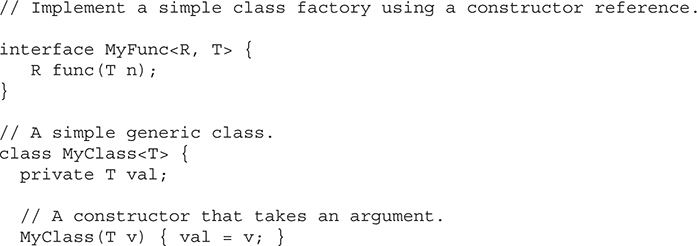
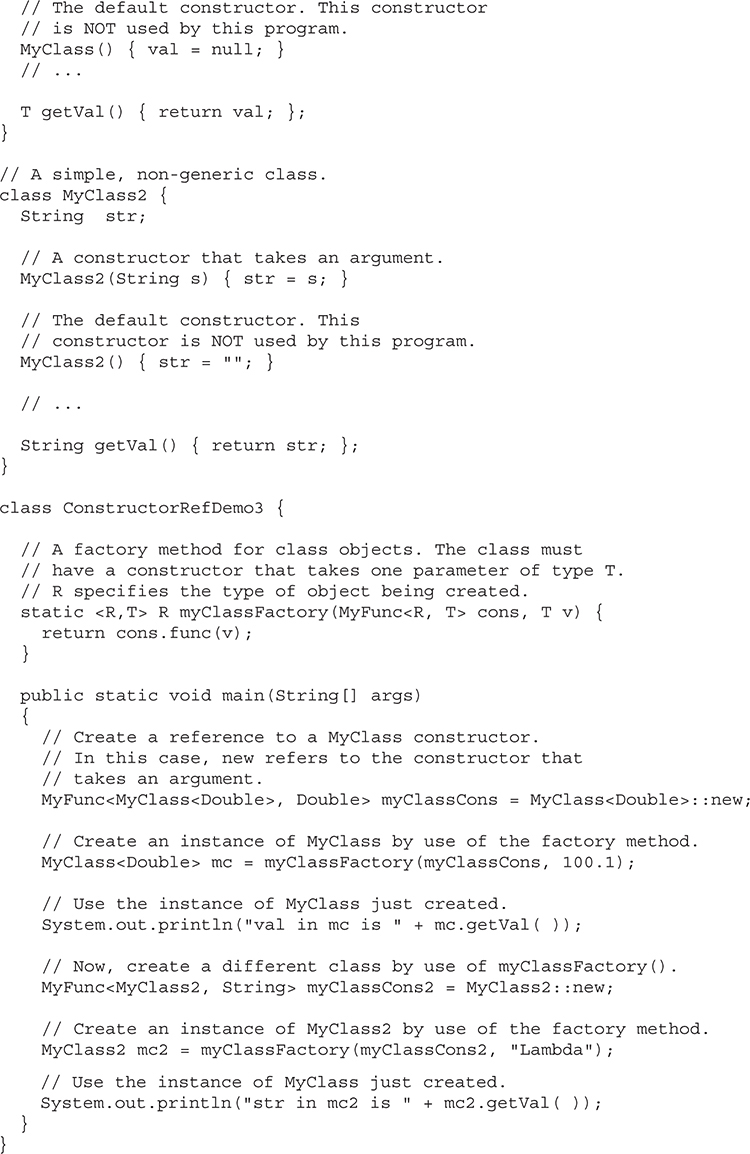
The output is shown here:
val in mc is 100.1
str in mc2 is Lambda
As you can see, myClassFactory( ) is used to create objects of type MyClass<Double> and MyClass2. Although both classes differ, for example MyClass is generic and MyClass2 is not, both can be created by myClassFactory( ) because they both have constructors that are compatible with func( ) in MyFunc. This works because myClassFactory( ) is passed the constructor for the object that it builds. You might want to experiment with this program a bit, trying different classes that you create. Also try creating instances of different types of MyClass objects. As you will see, myClassFactory( ) can create any type of object whose class has a constructor that is compatible with func( ) in MyFunc. Although this example is quite simple, it hints at the power that constructor references bring to Java.
Before moving on, it is important to mention a second form of the constructor reference syntax that is used for arrays. To create a constructor reference for an array, use this construct:
type[]::new
Here, type specifies the type of object being created. For example, assuming the form of MyClass as shown in the first constructor reference example (ConstructorRefDemo) and given the MyArrayCreator interface shown here:

the following creates a two-element array of MyClass objects and gives each element an initial value:

Here, the call to func(2) causes a two-element array to be created. In general, a functional interface must contain a method that takes a single int parameter if it is to be used to refer to an array constructor.
Up to this point, the examples in this chapter have defined their own functional interfaces so that the fundamental concepts behind lambda expressions and functional interfaces could be clearly illustrated. However, in many cases, you won’t need to define your own functional interface because the package called java.util.function provides several predefined ones. Although we will look at them more closely in Part II, here is a sampling:
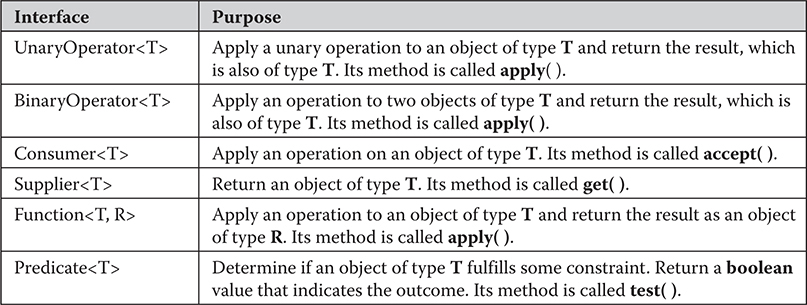
The following program shows the Function interface in action by using it to rework the earlier example called BlockLambdaDemo that demonstrated block lambdas by implementing a factorial example. That example created its own functional interface called NumericFunc, but the built-in Function interface could have been used, as this version of the program illustrates:
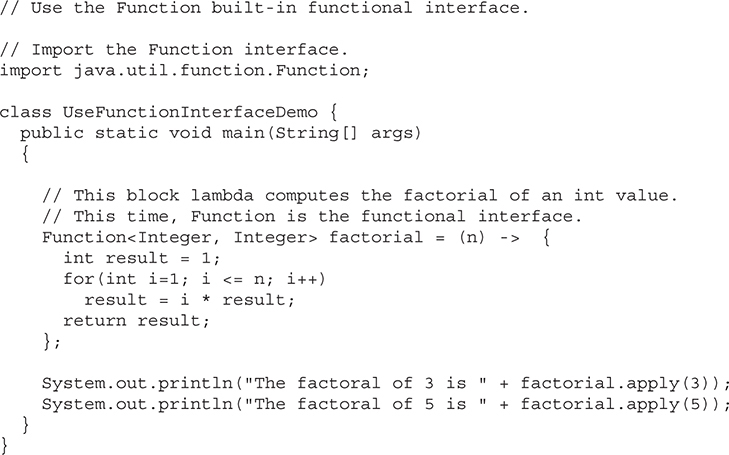
It produces the same output as previous versions of the program.
JDK 9 introduced a new and important feature called modules. Modules give you a way to describe the relationships and dependencies of the code that comprises an application. Modules also let you control which parts of a module are accessible to other modules and which are not. Through the use of modules you can create more reliable, scalable programs.
As a general rule, modules are most helpful to large applications because they help reduce the management complexity often associated with a large software system. However, small programs also benefit from modules because the Java API library has now been organized into modules. Thus, it is now possible to specify which parts of the API are required by your program and which are not. This makes it possible to deploy programs with a smaller run-time footprint, which is especially important when creating code for small devices, such as those intended to be part of the Internet of Things (IoT).
Support for modules is provided both by language elements, including several keywords, and by enhancements to javac, java, and other JDK tools. Furthermore, new tools and file formats were introduced. As a result, the JDK and the run-time system were substantially upgraded to support modules. In short, modules constitute a major addition to, and evolution of, the Java language.
In its most fundamental sense, a module is a grouping of packages and resources that can be collectively referred to by the module’s name. A module declaration specifies the name of a module and defines the relationship a module and its packages have to other modules. Module declarations are program statements in a Java source file and are supported by several module-related keywords. They are shown here:

It is important to understand that these keywords are recognized as keywords only in the context of a module declaration. Otherwise, they are interpreted as identifiers in other situations. Thus, the keyword module could, for example, also be used as a parameter name, although such a use is certainly not recommended. However, making the module-related keywords context-sensitive prevents problems with pre-existing code that may use one or more of them as identifiers.
A module declaration is contained in a file called module-info.java. Thus, a module is defined in a Java source file. This file is then compiled by javac into a class file and is known as its module descriptor. The module-info.java file must contain only a module definition. It cannot contain other types of declarations.
A module declaration begins with the keyword module. Here is its general form:
module moduleName {
// module definition
}
The name of the module is specified by moduleName, which must be a valid Java identifier or a sequence of identifiers separated by periods. The module definition is specified within the braces. Although a module definition may be empty (which results in a declaration that simply names the module), typically it specifies one or more clauses that define the characteristics of the module.
At the foundation of a module’s capabilities are two key features. The first is a module’s ability to specify that it requires another module. In other words, one module can specify that it depends on another. A dependence relationship is specified by use of a requires statement. By default, the presence of the required module is checked at both compile time and at run time. The second key feature is a module’s ability to control which, if any, of its packages are accessible by another module. This is accomplished by use of the exports keyword. The public and protected types within a package are accessible to other modules only if they are explicitly exported. Here we will develop an example that introduces both of these features.
The following example creates a modular application that demonstrates some simple mathematical functions. Although this application is purposely very small, it illustrates the core concepts and procedures required to create, compile, and run module-based code. Furthermore, the general approach shown here also applies to larger, real-world applications. It is strongly recommended that you work through the example on your computer, carefully following each step.
Note This chapter shows the process of creating, compiling, and running module-based code by use of the command-line tools. This approach has two advantages. First, it works for all Java programmers because no IDE is required. Second, it very clearly shows the fundamentals of the module system, including how it utilizes directories. To follow along, you will need to manually create a number of directories and ensure that each file is placed in its proper directory. As you might expect, when creating real-world, module-based applications you will likely find a module-aware IDE easier to use because, typically, it will automate much of the process. However, learning the fundamentals of modules using the command-line tools ensures that you have a solid understanding of the topic.
The application defines two modules. The first module is called appstart. It contains a package called appstart.mymodappdemo that defines the application’s entry point in a class called MyModAppDemo. Thus, MyModAppDemo contains the application’s main( ) method. The second module is called appfuncs. It contains a package called appfuncs.simplefuncs that includes the class SimpleMathFuncs. This class defines three static methods that implement some simple mathematical functions. The entire application will be contained in a directory tree that begins at mymodapp.
Before continuing, a few words about module names are appropriate. First, in the examples that follow, the name of a module (such as appfuncs) is the prefix of the name of a package (such as appfuncs.simplefuncs) that it contains. This is not required, but is used here as a way of clearly indicating to what module a package belongs. In general, when learning about and experimenting with modules, short, simple names, such as those used in this chapter, are helpful, and you can use any sort of convenient names that you like. However, when creating modules suitable for distribution, you must be careful with the names you choose because you will want those names to be unique. At the time of this writing, the suggested way to achieve this is to use the reverse domain name method. In this method, the reverse domain name of the domain that “owns” the project is used as a prefix for the module. For example, a project associated with herbschildt.com would use com.herbschildt as the module prefix. (The same goes for package names.) Because naming conventions may evolve over time, you will want to check the Java documentation for current recommendations.
Let’s now begin. Start by creating the necessary source code directories by following these steps:
1. Create a directory called mymodapp. This is the top-level directory for the entire application.
2. Under mymodapp, create a subdirectory called appsrc. This is the top-level directory for the application’s source code.
3. Under appsrc, create the subdirectory appstart. Under this directory, create a subdirectory also called appstart. Under this directory, create the directory mymodappdemo. Thus, beginning with appsrc, you will have created this tree:
appsrc\appstart\appstart\mymodappdemo
4. Also under appsrc, create the subdirectory appfuncs. Under this directory, create a subdirectory also called appfuncs. Under this directory, create the directory called simplefuncs. Thus, beginning with appsrc, you will have created this tree:
appsrc\appfuncs\appfuncs\simplefuncs
Your directory tree should look like that shown here.
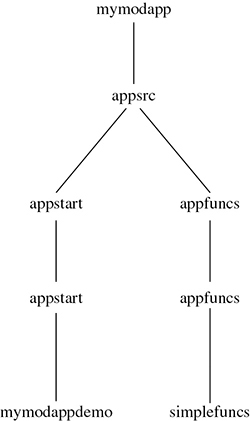
After you have set up these directories, you can create the application’s source files.
This example will use four source files. Two are the source files that define the application. The first is SimpleMathFuncs.java, shown here. Notice that SimpleMathFuncs is packaged in appfuncs.simplefuncs.
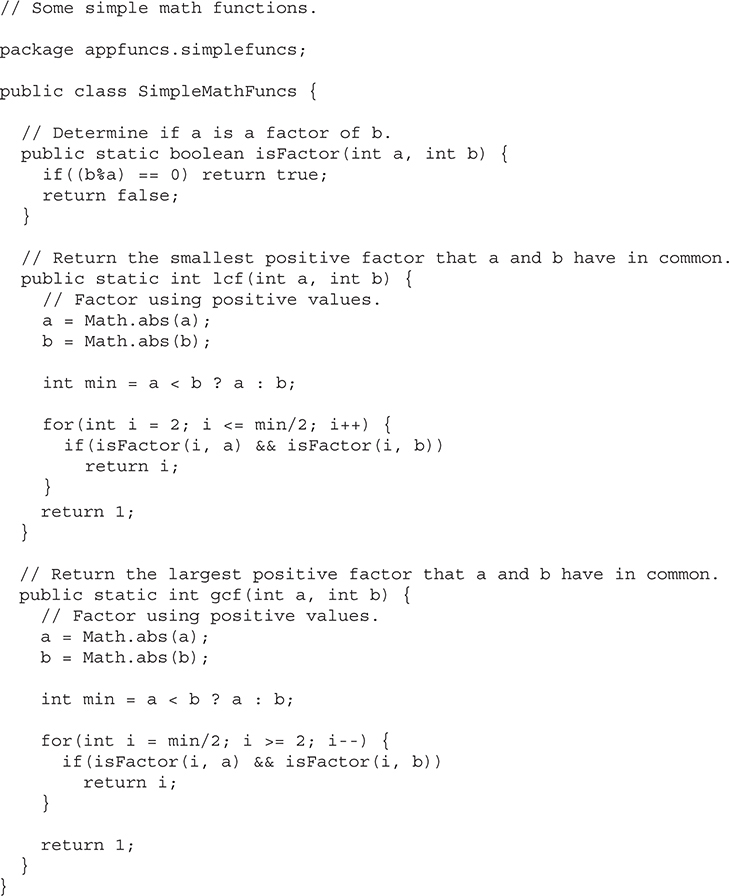
SimpleMathFuncs defines three simple static math functions. The first, isFactor( ), returns true if a is a factor of b. The lcf( ) method returns the smallest factor common to both a and b. In other words, it returns the least common factor of a and b. The gcf( ) method returns the greatest common factor of a and b. In both cases, 1 is returned if no common factors are found. This file must be put in the following directory:
appsrc\appfuncs\appfuncs\simplefuncs
This is the appfuncs.simplefuncs package directory.
The second source file is MyModAppDemo.java, shown next. It uses the methods in SimpleMathFuncs. Notice that it is packaged in appstart.mymodappdemo. Also note that it imports the SimpleMathFuncs class because it depends on SimpleMathFuncs for its operation.
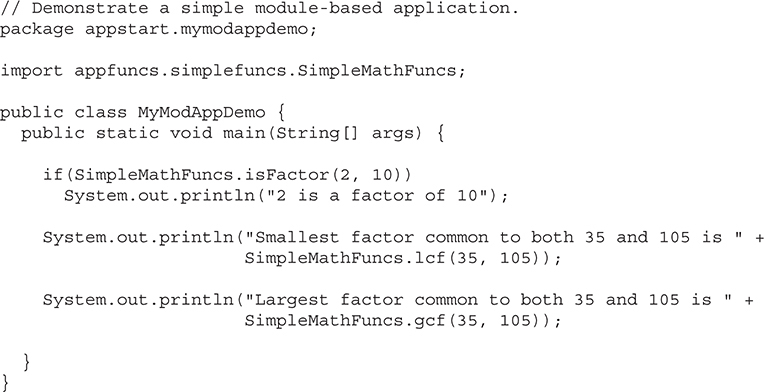
This file must be put in the following directory:
appsrc\appstart\appstart\mymodappdemo
This is the directory for the appstart.mymodappdemo package.
Next, you will need to add module-info.java files for each module. These files contain the module definitions. First, add this one, which defines the appfuncs module:

Notice that appfuncs exports the package appfuncs.simplefuncs, which makes it accessible to other modules. This file must be put into this directory:
appsrc\appfuncs
Thus, it goes in the appfuncs module directory, which is above the package directories.
Finally, the module-info.java file for the appstart module is shown next. Notice that appstart requires the module appfuncs.

This file must be put into its module directory:
appsrc\appstart
Before examining the requires, exports, and module statements more closely, let’s first compile and run this example. Be sure that you have correctly created the directories and entered each file into its proper directory, as just explained.
Beginning with JDK 9, javac has been updated to support modules. Thus, like all other Java programs, module-based programs are compiled using javac. The process is easy, with the primary difference being that you will usually explicitly specify a module path. A module path tells the compiler where the compiled files will be located. When following along with this example, be sure that you execute the javac commands from the mymodapp directory in order for the paths to be correct. Recall that mymodapp is the top-level directory for the entire module application.
To begin, compile SimpleMathFuncs.java using this command:

Remember, this command must be executed from the mymodapp directory. Notice the use of the -d option. This tells javac where to put the output .class file. For the examples in this chapter, the top of the directory tree for compiled code is appmodules. This command will create the output package directories for appfuncs.simplefuncs under appmodules\appfuncs as needed.
Next, here is the javac command that compiles the module-info.java file for the appfuncs module:
javac -d appmodules\appfuncs appsrc\appfuncs\module-info.java
This puts the module-info.class file into the appmodules\appfuncs directory.
Although the preceding two-step process works, it was shown primarily for the sake of discussion. It is usually easier to compile a module’s module-info.java file and its source files in one command line. Here, the preceding two javac commands are combined into one:

In this case, each compiled file is put in its proper module or package directory.
Now, compile module-info.java and MyModAppDemo.java for the appstart module, using this command:

Notice the --module-path option. It specifies the module path, which is the path on which the compiler will look for the user-defined modules required by the module-info.java file. In this case, it will look for the appfuncs module because it is needed by the appstart module. Also, notice that it specifies the output directory as appmodules\appstart. This means that the module-info.class file will be in the appmodules\appstart module directory and MyModAppDemo.class will be in the appmodules\appstart\appstart\mymodappdemo package directory.
Once you have completed the compilation, you can run the application with this java command:
java --module-path appmodules -m appstart/appstart.mymodappdemo.MyModAppDemo
Here, the --module-path option specifies the path to the application’s modules. As mentioned, appmodules is the directory at the top of the compiled modules tree. The -m option specifies the class that contains the entry point of the application and, in this case, the name of the class that contains the main( ) method. When you run the program, you will see the following output:

The preceding module-based example relies on the two foundational features of the module system: the ability to specify a dependence and the ability to satisfy that dependence. These capabilities are specified through the use of the requires and exports statements within a module declaration. Each merits a closer examination at this time.
Here is the form of the requires statement used in the example:
requires moduleName;
Here, moduleName specifies the name of a module that is required by the module in which the requires statement occurs. This means that the required module must be present in order for the current module to compile. In the language of modules, the current module is said to read the module specified in the requires statement. When more than one module is required, it must be specified in its own requires statement. Thus, a module declaration may include several different requires statements. In general, the requires statement gives you a way to ensure that your program has access to the modules that it needs.
Here is the general form of the exports statement used in the example:
exports packageName;
Here, packageName specifies the name of the package that is exported by the module in which this statement occurs. A module can export as many packages as needed, with each one specified in a separate exports statement. Thus, a module may have several exports statements.
When a module exports a package, it makes all of the public and protected types in the package accessible to other modules. Furthermore, the public and protected members of those types are also accessible. However, if a package within a module is not exported, then it is private to that module, including all of its public types. For example, even though a class is declared as public within a package, if that package is not explicitly exported by an exports statement, then that class is not accessible to other modules. It is important to understand that the public and protected types of a package, whether exported or not, are always accessible within that package’s module. The exports statement simply makes them accessible to outside modules. Thus, any nonexported package is only for the internal use of its module.
The key to understanding requires and exports is that they work together. If one module depends on another, then it must specify that dependence with requires. The module on which another depends must explicitly export (i.e., make accessible) the packages that the dependent module needs. If either side of this dependence relationship is missing, the dependent module will not compile. As it relates to the foregoing example, MyModAppDemo uses the functions in SimpleMathFuncs. As a result, the appstart module declaration contains a requires statement that names the appfuncs module. The appfuncs module declaration exports the appfuncs.simplefuncs package, thus making the public types in the SimpleMathFuncs class available. Since both sides of the dependence relationship have been fulfilled, the application can compile and run. If either is missing, the compilation will fail.
It is important to emphasize that requires and exports statements must occur only within a module statement. Furthermore, a module statement must occur by itself in a file called module-info.java.
As mentioned at the start of this chapter, beginning with JDK 9 the Java API packages have been incorporated into modules. In fact, the modularization of the API is one of the primary benefits realized by the addition of the modules. Because of their special role, the API modules are referred to as platform modules, and their names all begin with the prefix java. Here are some examples: java.base, java.desktop, and java.xml. By modularizing the API, it becomes possible to deploy an application with only the packages that it requires, rather than the entire Java Runtime Environment (JRE). Because of the size of the full JRE, this is a very important improvement.
The fact that all of the Java API library packages are now in modules gives rise to the following question: How can the main( ) method in MyModAppDemo in the preceding example use System.out.println( ) without specifying a requires statement for the module that contains the System class? Obviously, the program will not compile and run unless System is present. The same question also applies to the use of the Math class in SimpleMathFuncs. The answer to this question is found in java.base.
Of the platform modules, the most important is java.base. It includes and exports those packages fundamental to Java, such as java.lang, java.io, and java.util, among many others. Because of its importance, java.base is automatically accessible to all modules. Furthermore, all other modules automatically require java.base. There is no need to include a requires java.base statement in a module declaration. (As a point of interest, it is not wrong to explicitly specify java.base, it’s just not necessary.) Thus, in much the same way that java.lang is automatically available to all programs without the use of an import statement, the java.base module is automatically accessible to all module-based programs without explicitly requesting it.
Because java.base contains the java.lang package, and java.lang contains the System class, MyModAppDemo in the preceding example can automatically use System.out.println( ) without an explicit requires statement. The same applies to the use of the Math class in SimpleMathFuncs, because the Math class is also in java.lang. As you will see when you begin to create your own module-based applications, many of the API classes you will commonly need are in the packages included in java.base. Thus, the automatic inclusion of java.base simplifies the creation of module-based code because Java’s core packages are automatically accessible.
One last point: Beginning with JDK 9, the documentation for the Java API now tells you the name of the module in which a package is contained. If the module is java.base, then you can use the contents of that package directly. Otherwise, your module declaration must include a requires clause for the desired module.
Another question may have occurred to you when working through the first example module program. Because Java now supports modules, and the API packages are also contained in modules, why do all of the other programs in the preceding chapters compile and run without error even though they do not use modules? More generally, since there is now over 20 years of Java code in existence and (at the time of this writing) the vast majority of that code does not use modules, how is it possible to compile, run, and maintain that legacy code with a JDK 9 or later compiler? Given Java’s original philosophy of “write once, run everywhere,” this is a very important question because backward capability must be maintained. As you will see, Java answers this question by providing an elegant, nearly transparent means of ensuring backward compatibility with pre-existing code.
Support for legacy code is provided by two key features. The first is the unnamed module. When you use code that is not part of a named module, it automatically becomes part of the unnamed module. The unnamed module has two important attributes. First, all of the packages in the unnamed module are automatically exported. Second, the unnamed module can access any and all other modules. Thus, when a program does not use modules, all API modules in the Java platform are automatically accessible through the unnamed module.
The second key feature that supports legacy code is the automatic use of the class path, rather than the module path. When you compile a program that does not use modules, the class path mechanism is employed, just as it has been since Java’s original release. As a result, the program is compiled and run in the same way it was prior to the advent of modules.
Because of the unnamed module and the automatic use of the class path, there was no need to declare any modules for the sample programs shown elsewhere in this book. They run properly whether you compile them with a modern compiler or an earlier one, such as JDK 8. Thus, even though modules are a feature that has significant impact on Java, compatibility with legacy code is maintained. This approach also provides a smooth, nonintrusive, nondisruptive transition path to modules. Thus, it enables you to move a legacy application to modules at your own pace. Furthermore, it allows you to avoid the use of modules when they are not needed.
Before moving on, an important point needs to be made. For the types of example programs used elsewhere in this book, and for example programs in general, there is no benefit in using modules. Modularizing them would simply add clutter and complicate them for no reason or benefit. Furthermore, for many simple programs, there is no need to contain them in modules. For the reasons stated at the start of this chapter, modules are often of the greatest benefit when creating commercial programs. Therefore, no examples outside this chapter will use modules. This also allows the examples to be compiled and run in a pre–JDK 9 environment, which is important to readers using an older version of Java. Thus, except for the examples in this chapter, the examples in this book work for both pre-module and post-module JDKs.
The basic form of the exports statement makes a package accessible to any and all other modules. This is often exactly what you want. However, in some specialized development situations, it can be desirable to make a package accessible to only a specific set of modules, not all other modules. For example, a library developer might want to export a support package to certain other modules within the library, but not make it available for general use. Adding a to clause to the exports statement provides a means by which this can be accomplished.
In an exports statement, the to clause specifies a list of one or more modules that have access to the exported package. Furthermore, only those modules named in the to clause will have access. In the language of modules, the to clause creates what is known as a qualified export.
The form of exports that includes to is shown here:
exports packageName to moduleNames;
Here, moduleNames is a comma-separated list of modules to which the exporting module grants access.
You can try the to clause by changing the module-info.java file for the appfuncs module, as shown here:

Now, simplefuncs is exported only to appstart and to no other modules. After making this change, you can recompile the application by using this javac command:

After compiling, you can run the application as shown earlier.
This example also uses another module-related feature. Look closely at the preceding javac command. First, notice that it specifies the --module-source-path option. The module source path specifies the top of the module source tree. The --module-source-path option automatically compiles the files in the tree under the specified directory, which is appsrc in this example. The --module-source-path option must be used with the -d option to ensure that the compiled modules are stored in their proper directories under appmodules. This form of javac is called multi-module mode because it enables more than one module to be compiled at a time. The multi-module compilation mode is especially helpful here because the to clause refers to a specific module, and the requiring module must have access to the exported package. Thus, in this case, both appstart and appfuncs are needed to avoid warnings and/or errors during compilation. Multi-module mode avoids this problem because both modules are being compiled at the same time.
The multi-module mode of javac has another advantage. It automatically finds and compiles all source files for the application, creating the necessary output directories. Because of the advantages that multi-module compilation mode offers, it will be used for the subsequent examples.
Note As a general rule, qualified export is a special case feature. Most often, your modules will either provide unqualified export of a package or not export the package at all, keeping it inaccessible. As such, qualified export is discussed here primarily for the sake of completeness. Also, qualified export by itself does not prevent the exported package from being misused by malicious code in a module that masquerades as the targeted module. The security techniques required to prevent this from happening are beyond the scope of this book. Consult the Oracle documentation for details on security in this regard, and Java security details in general.
Consider a situation in which there are three modules, A, B, and C, that have the following dependences:
• A requires B.
• B requires C.
Given this situation, it is clear that since A depends on B and B depends on C, A has an indirect dependence on C. As long as A does not directly use any of the contents of C, then you can simply have A require B in its module-info file, and have B export the packages required by A in its module-info file, as shown here:
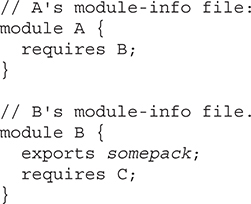
Here, somepack is a placeholder for the package exported by B and used by A. Although this works as long as A does not need to use anything defined in C, a problem occurs if A does want to access a type in C. In this case, there are two solutions.
The first solution is to simply add a requires C statement to A’s file, as shown here:

This solution certainly works, but if B will be used by many modules, you must add requires C to all module definitions that require B. This is not only tedious, it is also error prone. Fortunately, there is a better solution. You can create an implied dependence on C. Implied dependence is also referred to as implied readability.
To create an implied dependence, add the transitive keyword after requires in the clause that requires the module upon which an implied readability is needed. In the case of this example, you would change B’s module-info file as shown here:
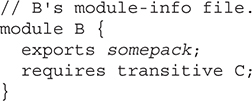
Here, C is now required as transitive. After making this change, any module that depends on B will also, automatically, depend on C. Thus, A would automatically have access to C.
You can experiment with requires transitive by reworking the preceding modular application example so that the isFactor( ) method is removed from the SimpleMathFuncs class in the appfuncs.simplefuncs package and put into a new class, module, and package. The new class will be called SupportFuncs, the module will be called appsupport, and the package will be called appsupport.supportfuncs. The appfuncs module will then add a dependence on the appsupport module by use of requires transitive. This will enable both the appfuncs and appstart modules to access it without appstart having to provide its own requires statement. This works because appstart receives access to it through an appfuncs requires transitive statement. The following describes the process in detail.
To begin, create the source directories that support the new appsupport module. First, create appsupport under the appsrc directory. This is the module directory for the support functions. Under appsupport, create the package directory by adding the appsupport subdirectory followed by the supportfuncs subdirectory. Thus, the directory tree for appsupport should now look like this:
appsrc\appsupport\appsupport\supportfuncs
Once the directories have been established, create the SupportFuncs class. Notice that SupportFuncs is part of the appsupport.supportfuncs package. Therefore, you must put it in the appsupport.supportfuncs package directory.
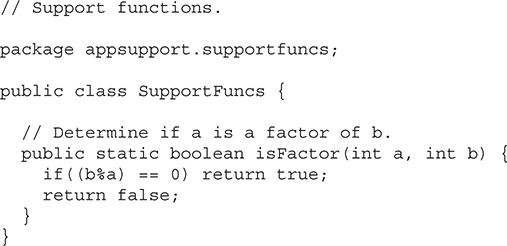
Notice that isFactor( ) is now part of SupportFuncs, rather than SimpleMathFuncs.
Next, create the module-info.java file for the appsupport module and put it in appsrc\appsupport directory.

As you can see, it exports the appsupport.supportfuncs package.
Because isFactor( ) is now part of Supportfuncs, remove it from SimpleMathFuncs. Thus, SimpleMathFuncs.java will now look like this:
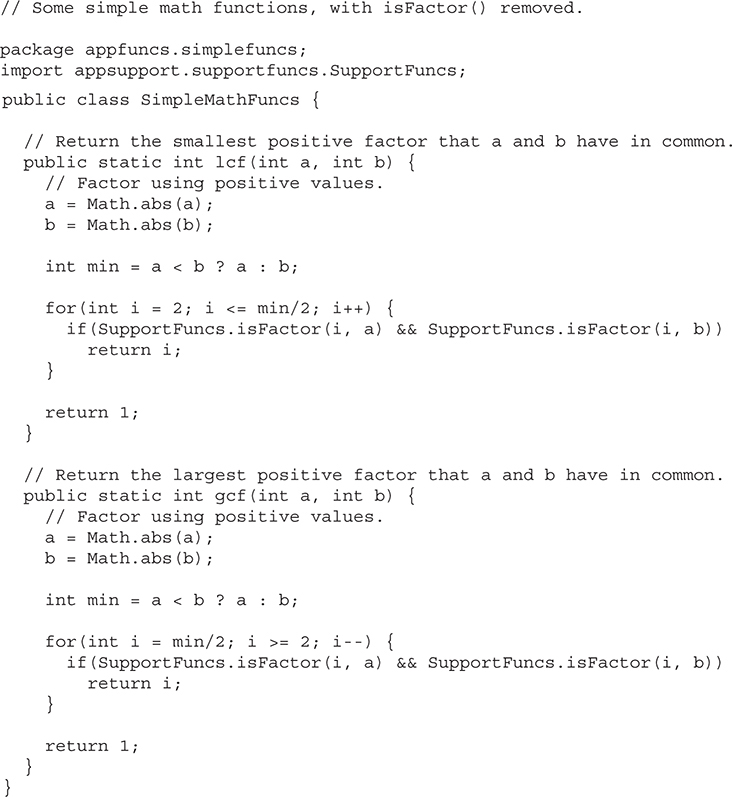
Notice that now the SupportFuncs class is imported and calls to isFactor( ) are referred to through the class name SupportFuncs.
Next, change the module-info.java file for appfuncs so that in its requires statement, appsupport is specified as transitive, as shown here:

Because appfuncs requires appsupport as transitive, there is no need for the module-info.java file for appstart to also require it. Its dependence on appsupport is implied. Thus, no changes to the module-info.java file for appstart are needed.
Finally, update MyModAppDemo.java to reflect these changes. Specifically, it must now import the SupportFuncs class and specify it when invoking isFactor( ), as shown here:
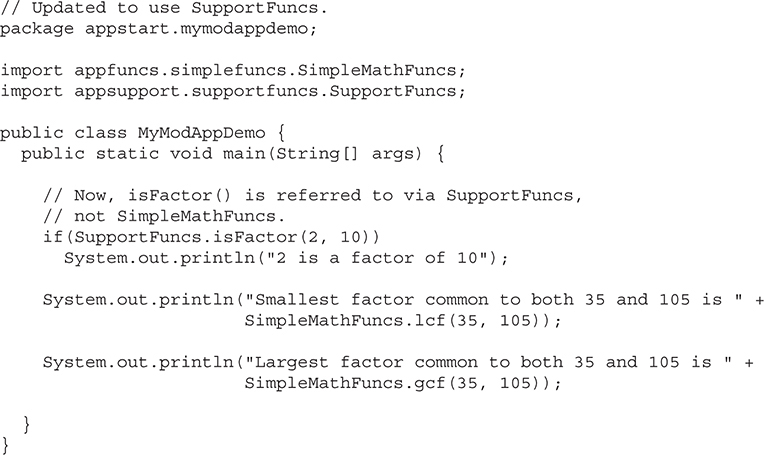
Once you have completed all of the preceding steps, you can recompile the entire program using this multi-module compilation command:

As explained earlier, the multi-module compilation will automatically create the parallel module subdirectories, under the appmodules directory.
You can run the program using this command:
java --module-path appmodules -m appstart/appstart.mymodappdemo.MyModAppDemo
It will produce the same output as the previous version. However, this time three different modules are required.
To prove that the transitive modifier is actually required by the application, remove it from the module-info.java file for appfuncs. Then, try to compile the program. As you will see, an error will result because appsupport is no longer accessible by appstart.
Here is another experiment. In the module-info file for appsupport, try exporting the appsupport.supportfuncs package to only appfuncs by use of a qualified export, as shown here:
exports appsupport.supportfuncs to appfuncs;
Next, attempt to compile the program. As you see, the program will not compile because now the support function isFactor( ) is not available to MyModAppDemo, which is in the appstart module. As explained previously, a qualified export restricts access to a package to only those modules specified by the to clause.
One final point, because of a special exception in the Java language syntax, in a requires statement, if transitive is immediately followed by a separator (such as a semicolon), it is interpreted as an identifier (for example, as a module name) rather than a keyword.
In programming, it is often useful to separate what must be done from how it is done. As you learned in Chapter 9, one way this is accomplished in Java is through the use of interfaces. The interface specifies the what, and the implementing class specifies the how. This concept can be expanded so that the implementing class is provided by code that is outside your program, through the use of a plug-in. Using such an approach, the capabilities of an application can be enhanced, upgraded, or altered by simply changing the plug-in. The core of the application itself remains unchanged. One way that Java supports a pluggable application architecture is through the use of services and service providers. Because of their importance, especially in large, commercial applications, Java’s module system provides support for them.
Before we begin, it is necessary to state that applications that use services and service providers are typically fairly sophisticated. Therefore, you may find that you do not often need the service-based module features. However, because support for services constitutes a rather significant part of the module system, it is important that you have a general understanding of how these features work. Also, a simple example is presented that illustrates the core techniques needed to use them.
In Java, a service is a program unit whose functionality is defined by an interface or abstract class. Thus, a service specifies in a general way some form of program activity. A concrete implementation of a service is supplied by a service provider. In other words, a service defines the form of some action, and the service provider supplies that action.
As mentioned, services are often used to support a pluggable architecture. For example, a service might be used to support the translation of one language into another. In this case, the service supports translation in general. The service provider supplies a specific translation, such as German to English or French to Chinese. Because all service providers implement the same interface, different translators can be used to translate different languages without having to change the core of the application. You can simply change the service provider.
Service providers are supported by the ServiceLoader class. ServiceLoader is a generic class packaged in java.util. It is declared like this:
class ServiceLoader<S>
Here, S specifies the service type. Service providers are loaded by the load( ) method. It has several forms; the one we will use is shown here:
public static <S> ServiceLoader<S> load(Class <S> serviceType)
Here, serviceType specifies the Class object for the desired service type. Recall that Class is a class that encapsulates information about a class. There are a variety of ways to obtain a Class instance. The way we will use here involves a class literal. Recall that a class literal has this general form:
className.class
Here, className specifies the name of the class.
When load( ) is called, it returns a ServiceLoader instance for the application. This object supports iteration and can be cycled through by use of a for-each for loop. Therefore, to find a specific provider, simply search for it using a loop.
Modules support services through the use of the keywords provides, uses, and with. Essentially, a module specifies that it provides a service with a provides statement. A module indicates that it requires a service with a uses statement. The specific type of service provider is declared by with. When used together, they enable you to specify a module that provides a service, a module that needs that service, and the specific implementation of that service. Furthermore, the module system ensures that the service and service providers are available and will be found.
Here is the general form of provides:
provides serviceType with implementationTypes;
Here, serviceType specifies the type of the service, which is often an interface, although abstract classes are also used. A comma-separated list of the implementation types is specified by implementationTypes. Therefore, to provide a service, the module indicates both the name of the service and its implementation.
Here is the general form of the uses statement:
uses serviceType;
Here, serviceType specifies the type of the service required.
To demonstrate the use of services we will add a service to the modular application example that we have been evolving. For simplicity, we will begin with the first version of the application shown at the start of this chapter. To it we will add two new modules. The first is called userfuncs. It will define interfaces that support functions that perform binary operations in which each argument is an int and the result is an int. The second module is called userfuncsimp, and it contains concrete implementations of the interfaces.
Begin by creating the necessary source directories.
1. Under the appsrc directory add directories called userfuncs and userfuncsimp.
2. Under userfuncs, add the subdirectory also called userfuncs. Under that directory, add the subdirectory binaryfuncs. Thus, beginning with appsrc, you will have created this tree:
appsrc\userfuncs\userfuncs\binaryfuncs
3. Under userfuncsimp, add the subdirectory also called userfuncsimp. Under that directory, add the subdirectory binaryfuncsimp. Thus, beginning with appsrc, you will have created this tree:
appsrc\userfuncsimp\userfuncsimp\binaryfuncsimp
This example expands the original version of the application by providing support for functions beyond those built into the application. Recall that the SimpleMathFuncs class supplies three built-in functions: isFactor( ), lcf( ), and gcf( ). Although it would be possible to add more functions to this class, doing so requires modifying and recompiling the application. By implementing services, it becomes possible to “plug in” new functions at run time, without modifying the application, and that is what this example will do. In this case, the service supplies functions that take two int arguments and return an int result. Of course, other types of functions can be supported if additional interfaces are provided, but support for binary integer functions is sufficient for our purposes and keeps the source code size of the example manageable.
Two service-related interfaces are needed. One specifies the form of an action, and the other specifies the form of the provider of that action. Both go in the binaryfuncs directory, and both are in the userfuncs.binaryfuncs package. The first, called BinaryFunc, declares the form of a binary function. It is shown here:
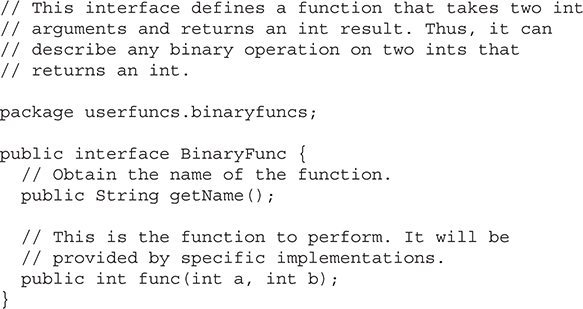
BinaryFunc declares the form of an object that can implement a binary integer function. This is specified by the func( ) method. The name of the function is obtainable from getName( ). The name will be used to determine what type of function is implemented. This interface is implemented by a class that supplies a binary function.
The second interface declares the form of the service provider. It is called BinFuncProvider and is shown here:
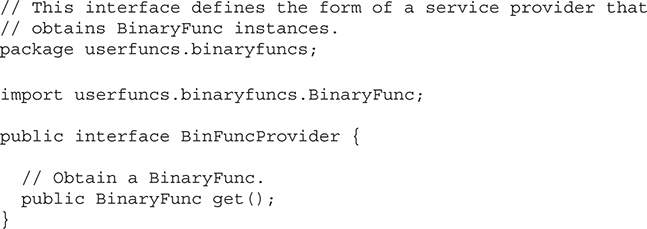
BinFuncProvider declares only one method, get( ), which is used to obtain an instance of BinaryFunc. This interface must be implemented by a class that wants to provide instances of BinaryFunc.
In this example, two concrete implementations of BinaryFunc are supported. The first is AbsPlus, which returns the sum of the absolute values of its arguments. The second is AbsMinus, which returns the result of subtracting the absolute value of the second argument from the absolute value of the first argument. These are provided by the classes AbsPlusProvider and AbsMinusProvider. The source code for these classes must be stored in the binaryfuncsimp directory, and they are all part of the userfuncsimp.binaryfuncsimp package.
The code for AbsPlus is shown here:
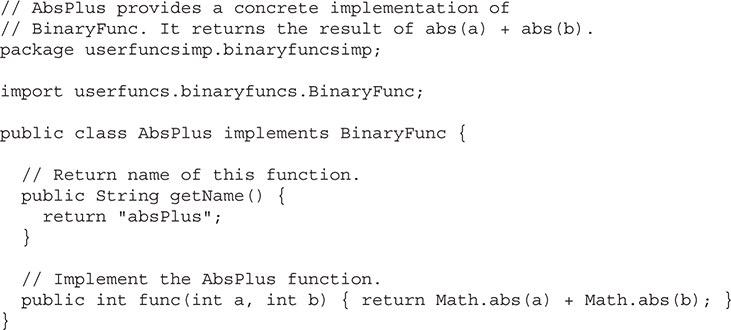
AbsPlus implements func( ) such that it returns the result of adding the absolute values of a and b. Notice that getName( ) returns the "absPlus" string. It identifies this function.
The AbsMinus class is shown next:
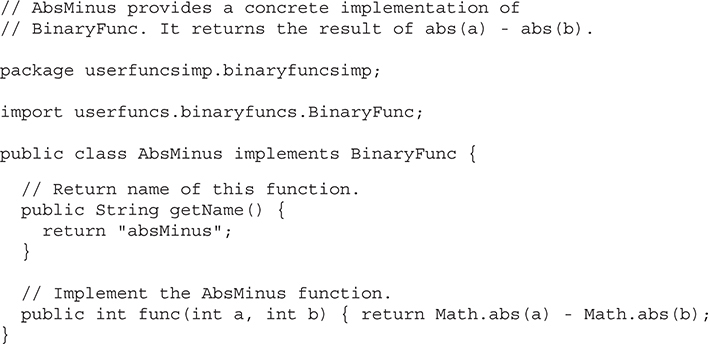
Here, func( ) is implemented to return the difference between the absolute values of a and b, and the string "absMinus" is returned by getName( ).
To obtain an instance of AbsPlus, the AbsPlusProvider is used. It implements BinFuncProvider and is shown here:
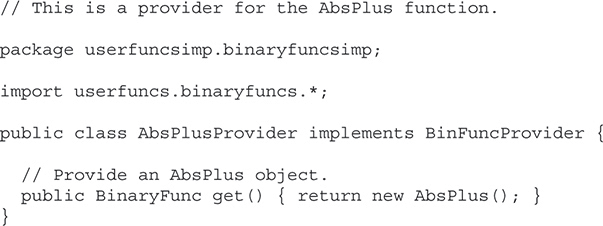
The get( ) method simply returns a new AbsPlus( ) object. Although this provider is very simple, it is important to point out that some service providers will be much more complex.
The provider for AbsMinus is called AbsMinusProvider and is shown next:
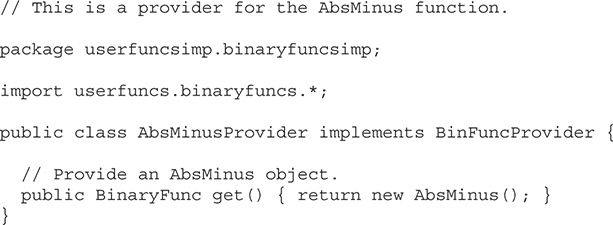
Its get( ) method returns an object of AbsMinus.
Next, two module definition files are needed. The first is for the userfuncs module. It is shown here:

This code must be contained in a module-info.java file that is in the userfuncs module directory. Notice that it exports the userfuncs.binaryfuncs package. This is the package that defines the BinaryFunc and BinFuncProvider interfaces.
The second module-info.java file is shown next. It defines the module that contains the implementations. It goes in the userfuncsimp module directory.

This module requires userfuncs because that is where BinaryFunc and BinFuncProvider are contained, and those interfaces are needed by the implementations. The module provides BinFuncProvider implementations with the classes AbsPlusProvider and AbsMinusProvider.
To demonstrate the use of the services, the main( ) method of MyModAppDemo is expanded to use AbsPlus and AbsMinus. It does so by loading them at run time by use of ServiceLoader.load( ). Here is the updated code:
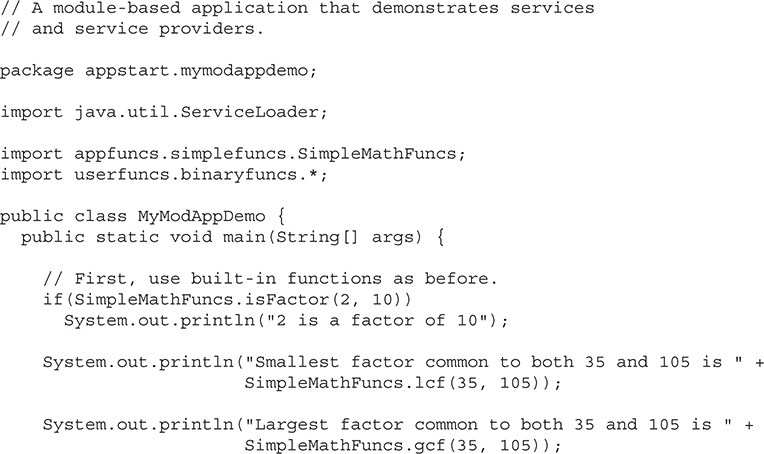
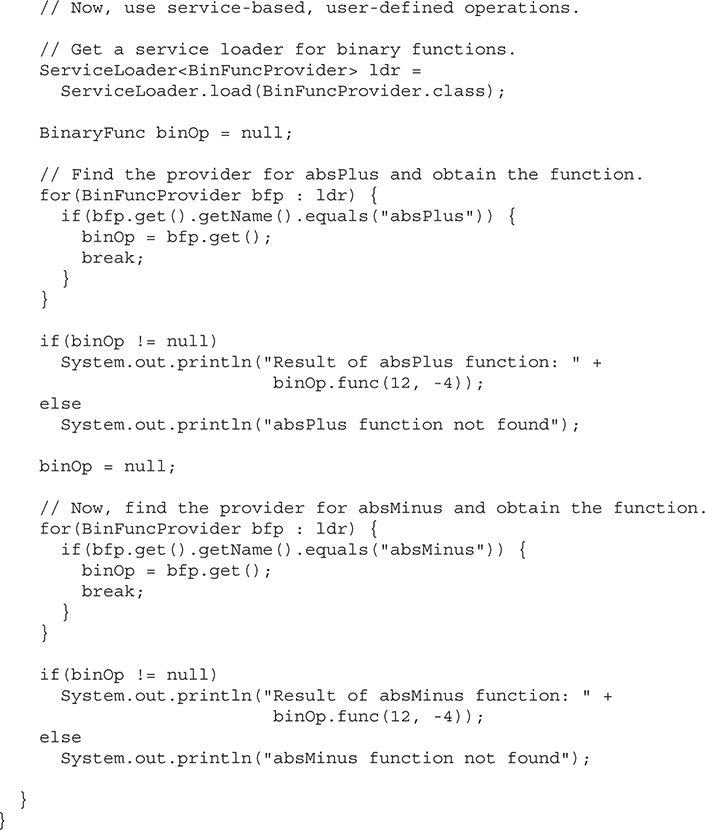
Let’s take a close look at how a service is loaded and executed by the preceding code. First, a service loader for services of type BinFuncProvider is created with this statement:

Notice that the type parameter to ServiceLoader is BinFuncProvider. This is also the type used in the call to load( ). This means that providers that implement this interface will be found. Thus, after this statement executes, BinFuncProvider classes in the module will be available through ldr. In this case, both AbsPlusProvider and AbsMinusProvider will be available.
Next, a reference of type BinaryFunc called binOp is declared and initialized to null. It will be used to refer to an implementation that supplies a specific type of binary function. Next, the following loop searches ldr for one that has the "absPlus" name.

Here, a for-each loop iterates through ldr. Inside the loop, the name of the function supplied by the provider is checked. If it matches "absPlus", that function is assigned to binOp by calling the provider’s get( ) method.
Finally, if the function is found, as it will be in this example, it is executed by this statement:

In this case, because binOp refers to an instance of AbsPlus, the call to func( ) performs an absolute value addition. A similar sequence is used to find and execute AbsMinus.
Because MyModAppDemo now uses BinFuncProvider, its module definition file must include a uses statement that specifies this fact. Recall that MyModAppDemo is in the appstart module. Therefore, you must change the module-info.java file for appstart as shown here:
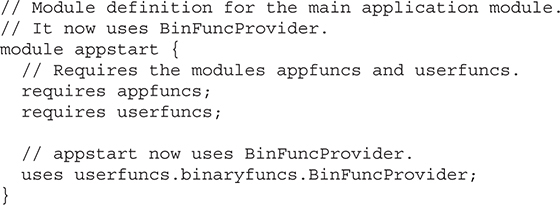
Once you have performed all of the preceding steps, you can compile and run the example by executing the following commands:

Here is the output:

As the output shows, the binary functions were located and executed. It is important to emphasize that if either the provides statement in the userfuncsimp module or the uses statement in the appstart module were missing, the application would fail.
One last point: The preceding example was kept very simple in order to clearly illustrate module support for services, but much more sophisticated uses are possible. For example, you might use a service to provide a sort( ) method that sorts a file. Various sorting algorithms could be supported and made available through the service. The specific sort could then be chosen based on the desired run-time characteristics, the nature and/or size of the data, and whether random access to the data is supported. You might want to try implementing such a service as a way to further experiment with services in modules.
A term you are likely to encounter when working with modules is module graph. During compilation, the compiler resolves the dependence relationships between modules by creating a module graph that represents the dependences. The process ensures that all dependences are resolved, including those that occur indirectly. For example, if module A requires module B, and B requires module C, then the module graph will contain module C even if A does not use it directly.
Module graphs can be depicted visually in a drawing to illustrate the relationship between modules. Here is a simple example. Assume six modules called A, B, C, D, E, and F. Further assume that A requires B and C, B requires D and E, and C requires F. The following visually depicts this relationship. (Because java.base is automatically included, it is not shown in the diagram.)
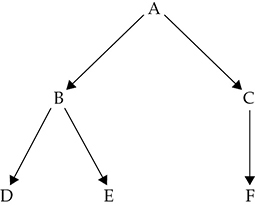
In Java, the arrows point from the dependent module to the required module. Thus, a drawing of a module graph depicts what modules have access to what other modules. Frankly, only the smallest applications can have their module graphs visually represented because of the complexity typically involved in many commercial applications.
The preceding discussions have described the key features of modules supported by the Java language, and they are the features on which you will typically rely when creating your own modules. However, there are three additional module-related features that can be quite useful in certain circumstances. These are the open module, the opens statement, and the use of requires static. Each of these features is designed to handle a specialized situation, and each constitutes a fairly advanced aspect of the module system. That said, it is important for all Java programmers to have a general understanding of their purpose.
As you learned earlier in this chapter, by default, the types in a module’s packages are accessible only if they are explicitly exported via an exports statement. While this is usually what you will want, there can be circumstances in which it is useful to enable run-time access to all packages in the module, whether a package is exported or not. To allow this, you can create an open module. An open module is declared by preceding the module keyword with the open modifier, as shown here:
open module moduleName {
// module definition
}
In an open module, types in all its packages are accessible at run time. Understand, however, that only those packages that are explicitly exported are available at compile time. Thus, the open modifier affects only run-time accessibility. The primary reason for an open module is to enable the packages in the module to be accessed through reflection. As explained in Chapter 12, reflection is the feature that lets a program analyze code at run time.
It is possible for a module to open a specific package for run-time access by other modules and for reflective access rather than opening an entire module. To do so, use the opens statement, shown here:
opens packageName;
Here, packageName specifies the package to open. It is also possible to include a to clause, which names those modules for which the package is opened.
It is important to understand opens does not grant compile-time access. It is used only to open a package for run-time and reflective access. However, you can both export and open a module. One other point: an opens statement cannot be used in an open module. Remember, all packages in an open module are already open.
As you know, requires specifies a dependence that, by default, is enforced both during compilation and at run time. However, it is possible to relax this requirement in such a way that a module is not required at run time. This is accomplished by use of the static modifier in a requires statement. For example, this specifies that mymod is required for compilation, but not at run time:
requires static mymod;
In this case, the addition of static makes mymod optional at run time. This can be helpful in a situation in which a program can utilize functionality if it is present, but not require it.
As the preceding discussions have shown, modules represent a substantial enhancement to the Java language. The module system also supports enhancements at run time. One of the most important is the ability to create a run-time image that is specifically tailored to your application. To accomplish this, you can use a JDK tool called jlink. It combines a group of modules into an optimized run-time image. You can use jlink to link modular JAR files, JMOD files, or even modules in their unarchived, “exploded directory” form.
Let’s look first at using jlink to create a run-time image from unarchived modules. That is, the files are contained in their raw form in a fully expanded (i.e., exploded) directory. Assuming a Windows environment, the following command links the modules for the first example in this chapter. It must be executed from a directory directly above mymodapp.

Let’s look closely at this command. First, the option --launcher tells jlink to create a command that starts the application. It specifies the name of the application and the path to the main class. In this case, the main class is MyModAppDemo. The --module-path option specifies the path to the required modules. The first is the path to the platform modules; the second is the path to the application modules. Notice the use of the environmental variable JAVA_HOME. It represents the path to the standard JDK directory. For example, in a standard Windows installation, the path will typically be something similar to "C:\program files"\java\jdk-17\jmods, but the use of JAVA_HOME is both shorter and able to work no matter in what directory the JDK was installed. The --add-modules option specifies the module or modules to add. Notice that only appstart is specified. This is because jlink automatically resolves all dependencies and includes all required modules. Finally, --output specifies the output directory.
After you run the preceding command, a directory called mylinkedmodapp will have been created that contains the run-time image. In its bin directory, you will find a launcher file called MyModApp that you can use to run the application. For example, in Windows, this will be a batch file that executes the program.
Although linking modules from their exploded directory is convenient, when working on real-world code you will often be using JAR files. (Recall that JAR stands for Java ARchive. It is a file format typically used for application deployment.) In the case of modular code, you will be using modular JAR files. A modular JAR file is one that contains a module-info.class file. Beginning with JDK 9, the jar tool has the ability to create modular JAR files. For example, it can now recognize a module path. Once you have created modular JAR files, you can use jlink to link them into a run-time image. To understand the process, let’s work through an example. Again assuming the first example in this chapter, here are the jar commands that create modular JAR files for the MyModAppDemo program. Each must be executed from a directory directly above mymodapp. Also, you will need to create a directory called applib under mymodapp.

Here, --create tells jar to create a new JAR file. The --file option specifies the name of the JAR file. The files to include are specified by the -C option. The class that contains main( ) is specified by the --main-class option. After running these commands, the JAR files for the application will be in the applib directory under mymodapp.
Given the modular JAR files just created, here is the command that links them:

Here, the module path to the JAR files is specified, not the path to the exploded directories. Otherwise, the jlink command is the same as before.
As a point of interest, you can use the following command to run the application directly from the JAR files. It must be executed from a directory directly above mymodapp.
java -p mymodapp\applib -m appstart
Here, -p specifies the module path and -m specifies the module that contains the program’s entry point.
The jlink tool can also link files that use the newer JMOD format introduced by JDK 9. JMOD files can include things that are not applicable to a JAR file. They are created by the new jmod tool. Although most applications will still use module JAR files, JMOD files will be of value in specialized situations. As a point of interest, beginning with JDK 9 the platform modules are contained in JMOD files.
Note jlink can also be used by the recently added jpackage tool. This tool can create a natively installable application.
When learning about modules you are likely to encounter reference to two additional module-related features. These are layers and automatic modules. Both are designed for specialized, advanced work with modules or when migrating preexisting applications. Although it is likely that most programmers will not need to make use of these features, a brief description of each is given here in the interest of completeness.
A module layer associates the modules in a module graph with a class loader. Thus, different layers can use different class loaders. Layers enable certain specialized types of applications to be more easily constructed.
An automatic module is created by specifying a nonmodular JAR file on the module path, with its name being automatically derived. (It is also possible to explicitly specify a name for an automatic module in the manifest file.) Automatic modules enable normal modules to have a dependence on code in the automatic module. Automatic modules are provided as an aid in migration from pre-modular code to fully modular code. Thus, they are primarily a transitional feature.
The preceding discussions have introduced and demonstrated the core elements of Java’s module system. These are the features about which every Java programmer should have at least a basic understanding. As you might guess, the module system provides additional features that give you fine-grained control over the creation and use of modules. For example, both javac and java have many more options related to modules than described in this chapter. Because modules are a significant addition to Java, it is likely that the module system will evolve over time. You will want to watch for enhancements to this innovative aspect of Java.
A key attribute of Java has been its ability to adapt to the increasing demands of the modern computing environment. Over the years, Java has incorporated many new features, each responding to changes in the computing environment or to innovations in computer language design. This ongoing process has enabled Java to remain one of the world’s most important and popular computer languages. As explained earlier, this book has been updated for JDK 17, which is a long-term support (LTS) version of Java. JDK 17 incorporates a number of new language features that have been added to Java since the previous LTS version, which was JDK 11. A few of the smaller additions have been described in the preceding chapters. In this chapter, several major additions are examined. They are
• Enhancements to switch
• Text blocks
• Records
• Patterns in instanceof
• Sealed classes and interfaces
Here is a brief description of each. The switch has been enhanced in a number of ways, the most impacting of which is the switch expression. A switch expression enables a switch to produce a value. Text blocks allow a string literal to occupy more than a single line. Supported by the new keyword record, records enable you to create a class that is specifically designed to hold a group of values. A second form of instanceof has been added that uses a type pattern. With this form, you can specify a variable that receives an instance of the type being tested if instanceof succeeds. It is now possible to specify a sealed class or interface. A sealed class can be inherited by only explicitly specified subclasses. A sealed interface can be implemented by only explicitly specified classes or extended by only explicitly specified interfaces. Thus, sealing a class or interface gives you fine-grained control over its inheritance and implementation.
The switch statement has been part of Java since the start. It is a crucial element of Java’s program control statements and provides for a multiway branch. Moreover, switch is so fundamental to programming that it is found in one form or another in other popular programming languages. The traditional form of switch was described in Chapter 5. This is the form of switch that has always been part of Java. Beginning with JDK 14, switch has been substantially enhanced with the addition of four new features, shown here:
• The switch expression
• The yield statement
• Support for a list of case constants
• The case with an arrow
Each new feature is examined in detail in the discussions that follow, but here is a brief description: The switch expression is, essentially, a switch that produces a value. Thus, a switch expression can be used on the right side of an assignment, for example. The yield statement specifies a value that is produced by a switch expression. It is now possible to have more than one case constant in a case statement through the use of a list of constants. A second form of case has been added that uses an arrow (->) instead of a colon. The arrow gives case new capabilities.
Collectively, the enhancements to switch represent a fairly significant change to the Java language. Not only do they provide new capabilities, but in some situations, they also offer superior alternatives to traditional approaches. Because of this, a solid understanding of the “how” and “why” behind the new switch features is important.
One of the best ways to understand the switch enhancements is to start with an example that uses a traditional switch and then gradually incorporate each new feature. This way, the use and benefit of the enhancements will be clearly apparent. To begin, imagine some device that produces integer codes that indicate various events and you want to associate a priority level with each event code. Most events will have a normal priority, but a few will have a higher priority. Here is a program that uses a traditional switch statement to supply a priority level given an event code:
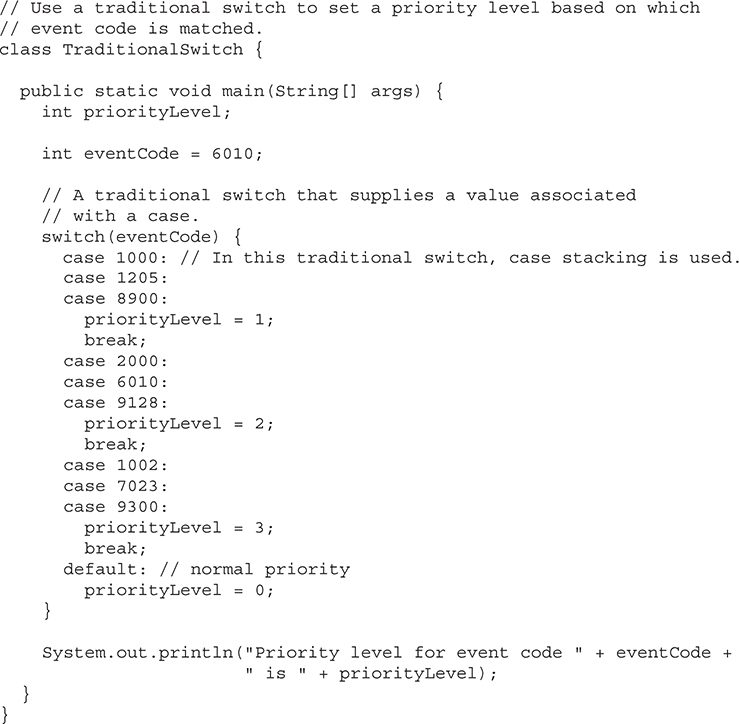
The output is shown here:
Priority level for event code 6010 is 2
There is certainly nothing wrong with using a traditional switch as shown in the program, and this is the way Java code has been written for more than two decades. However, as the following sections will show, in many cases, the traditional switch can be improved by use of the enhanced switch features.
We begin with one of the easiest ways to modernize a traditional switch: by use of a list of case constants. In the past, when two constants were both handled by the same code sequence, case stacking was employed, and this is the approach used by the preceding program. For example, here are how the cases for 1000, 1205, and 8900 are handled:

The stacking of case statements enable all three case statements to use the same code sequence to set priorityLevel to 1. As explained in Chapter 5, in a traditional-style switch, the stacking of cases is made possible because execution falls through each case until a break is encountered. Although this approach works, a more elegant solution can be achieved by use of a case constant list.
Beginning with JDK 14, you can specify more than one case constant in a single case. To do so, simply separate each constant with a comma. For example, here is a more compact way to code the case for 1000, 1205, and 8900:

Here is the entire switch, rewritten to use lists of case constants:
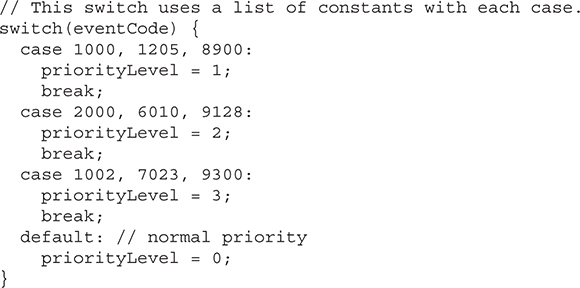
As you can see, the number of case statements has been reduced by six, making the switch easier to read and a bit more manageable. Although support for a case constant list does not by itself add any fundamentally new functionality to the switch, it does help streamline your code. In many situations, it also offers an easy way to improve existing code—especially when extensive case-stacking was previously employed. Thus, it is a feature that you can put to work immediately, with minimal code rewriting.
Of the enhancements to switch, the one that will have the most profound impact is the switch expression. A switch expression is, essentially, a switch that returns a value. Thus, it has all of the capabilities of a traditional switch statement, plus the ability to produce a result. This added capability makes the switch expression one of the more important additions to Java in recent years.
One way to supply the value of a switch expression is with the new yield statement. It has this general form:
yield value;
Here, value is the value produced by the switch, and it can be any expression compatible with the type of value required. A key point to understand about yield is that it immediately terminates the switch. Thus, it works somewhat like break, with the added capability of supplying a value. It is important to point out that yield is a context-sensitive keyword. This means that outside its use in a switch expression, yield is simply an identifier with no special meaning. However, if you use a method called yield( ), it must be qualified. For example, if yield( ) is a non-static method within its class, you must use this.yield( ).
It is very easy to specify a switch expression. Simply use the switch in a context in which a value is required, such as on the right side of an assignment statement, an argument to a method, or a return value. For example, this line indicates that a switch expression is being employed:
int x = switch(y) { // ...
Here, the switch result is being assigned to the x variable. A key point about using a switch expression is that each case (plus default) must produce a value (unless it throws an exception). In other words, each path through a switch expression must produce a result.
The addition of the switch expression simplifies the coding of situations in which each case sets the value of some variable. Such situations can occur in a number of different ways. For example, each case might set a boolean variable that indicates the success or failure of some action taken by the switch. Often, however, setting a variable is the primary purpose of the switch, as is the case with the switch used by the preceding program. Its job is to produce the priority level associated with an event code. With a traditional switch statement, each case statement must individually assign a value to the variable, and this variable becomes the de facto result of the switch. This is the approach used by the preceding programs, in which the value of the variable priorityLevel is set by each case. Although this approach has been used in Java programs for decades, the switch expression offers a better solution because the desired value is produced by the switch itself.
The following version of the program puts the preceding discussion into action by changing the switch statement into a switch expression:
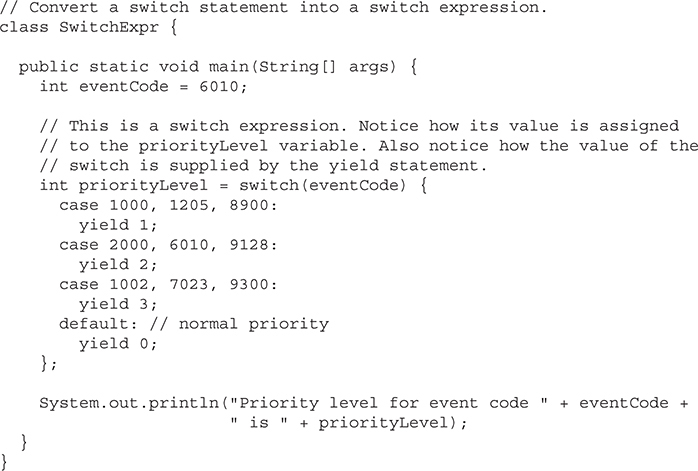
Look closely at the switch in the program. Notice that it differs in important ways from the one used in the previous examples. Instead of each case assigning a value to priorityLevel individually, this version assigns the outcome of the switch itself to the priorityLevel variable. Thus, only one assignment to priorityLevel is required, and the length of the switch is reduced. Using a switch expression also ensures that each case yields a value, thus avoiding the possibility of forgetting to give priorityLevel a value in one of the cases. Notice that the value of the switch is produced by the yield statement inside each case. As explained, yield causes immediate termination of the switch, so no fall-through from case to case will occur. Thus, no break statement is required, or allowed. One other thing to notice is the semicolon after the closing brace of the switch. Because this switch is used in an assignment, it must be terminated by a semicolon.
There is an important restriction that applies to a switch expression: the case statements must handle all of the values that might occur. Thus, a switch expression must be exhaustive. For example, if its controlling expression is of type int, then all int values must be handled by the switch. This would, of course, constitute a very large number of case statements! For this reason, most switch expressions will have a default statement. The exception to this rule is when an enumeration is used, and each value of the enumeration is matched by a case.
Although the use of yield in the preceding program is a perfectly valid way to specify a value for a switch expression, it is not the only way to do so. In many situations, an easier way to supply a value is through the use of a new form of the case that substitutes -> for the colon in a case. For example, this line:
case 'X': // ...
can be rewritten using the arrow like this:
case 'X' -> // ...
To avoid confusion, in this discussion we will refer to a case with an arrow as an arrow case and the traditional, colon-based form as a colon case. Although both forms will match the character X, the precise action of each style of case statement differs in three very important ways.
First, one arrow case does not fall through to the next case. Thus, there is no need to use break. Execution simply terminates at the end of an arrow case. Although the fall-through nature of a traditional colon-based case has always been part of Java, fall-through has been criticized because it can be a source for bugs, such as when the programmer forgets to add a break statement to prevent fall-through when fall-through is not desired. The arrow case avoids this situation. Second, the arrow case provides a “shorthand” way to supply a value when used in a switch expression. For this reason, the arrow case is often used in switch expressions. Third, the target of an arrow case must be either an expression, a block, or throw an exception. It cannot be a statement sequence, as is allowed with a traditional case. Thus, the arrow case will have one of these general forms:
case constant -> expression;
case constant -> { block-of-statements }
case constant -> throw …
Of course, the first two forms represent the primary uses.
Arguably, the most common use of an arrow case is in a switch expression, and the most common target of the arrow case is an expression. Thus, it is here that we will begin. When the target of an arrow case is an expression, the value of that expression becomes the value of the switch expression when that case is matched. Thus, it provides a very efficient alternative to the yield statement in many situations. For example, here is the first case in the event code example rewritten to use an arrow case:
case 1000, 1205, 8900 -> 1;
Here, the value of the expression (which is 1) automatically becomes the value produced by the switch when this case is matched. In other words, the expression becomes the value yielded by the switch. Notice that this statement is quite compact, yet clearly expresses the intent to supply a value.
In the following program, the entire switch expression has been completely rewritten to use the arrow case:

This produces the same output as before. Looking at the code, it is easy to see why this form of the arrow case is so appropriate for many types of switch expressions. It is compact and eliminates the need for a separate yield statement. Because the arrow case does not fall through, there is no need for a break statement. Each case terminates by yielding the value of its expression. Furthermore, if you compare this final version of the switch to the original, traditional switch shown at the start of this discussion, it is readily apparent how streamlined and expressive this version is. In combination, the switch enhancements offer a truly impressive way to improve the clarity and resiliency of your code.
The arrow case provides considerable flexibility. First, when using its expression form, the expression can be of any type. For example, the following is a valid case statement:
case -1 –> getErrorCode();
Here, the result of the call to getErrorCode( ) becomes the value of the enclosing switch expression. Here is another example:
case 0 -> normalCompletion = true;
In this case, the result of the assignment, which is true, becomes the value yielded. The key point is that any valid expression can be used as the target of the arrow case as long as it is compatible with the type required by the switch.
As mentioned, the target of the -> can also be a block of code. You will need to use a block as the target of an arrow case whenever you need more than a single expression. For example, each case in this version of the event code program sets the value of a boolean variable called stopNow to indicate if immediate termination is required and then yields the priority level.
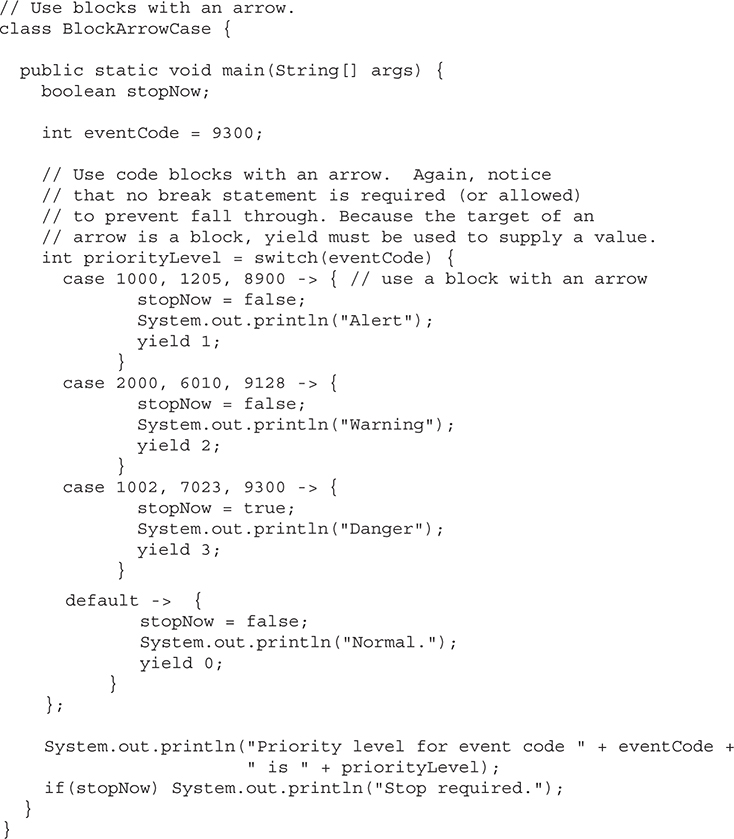
Here is the output:
Danger
Priority level for event code 9300 is 3
Stop required.
As this example shows, when using a block, you must use yield to supply a value to a switch expression. Furthermore, even though block targets are used, each path through the switch expression must still provide a value.
Although the preceding program provides a simple illustration of a block target of an arrow case, it also raises an interesting question. Notice that each case in the switch sets the value of two variables. The first is priorityLevel, which is the value yielded. The second is stopNow. Is there a way for a switch expression to yield more than one value? In a direct sense, the answer is “no” because only one value can be produced by the switch. However, it is possible to encapsulate two or more values within a class and yield an object of that class. Beginning with JDK 16, Java provides an especially streamlined and efficient way to accomplish this: the record. Described later in this chapter, a record aggregates two or more values into a single logical unit. As it relates to this example, a record could hold both the priorityLevel and the stopNow values, and this record could be yielded by the switch as a unit. Thus, a record offers a convenient way for a switch to yield more than a single value.
Although the arrow case is very helpful in a switch expression, it is important to emphasize that it is not limited to that use. The arrow case can also be used in a switch statement, which enables you to write switches in which no case fall-through can occur. In this situation, no yield statement is required (or allowed), and no value is produced by the switch. In essence, it works much like a traditional switch but without the fall-through. Here is an example:
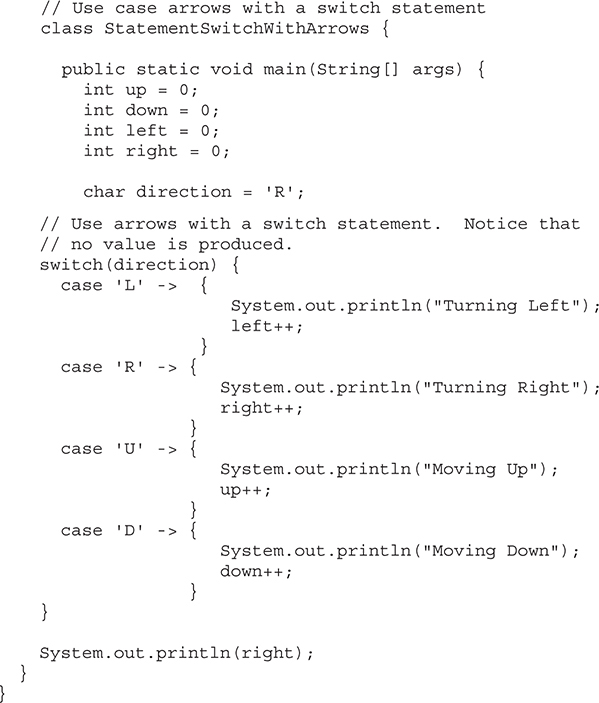
In this program, the switch is a statement, not an expression. This is because of two reasons. First, no value is produced. Second, it is not exhaustive because no default statement is included. (Recall that switch expressions must be exhaustive, but not switch statements.) Notice, however, that because no fall-through occurs with an arrow case, no break statement is needed. As a point of interest, because each case increases the value of a different variable, it would not be possible to transform this switch into an expression. What value would it produce? All four cases increment a different variable.
One last point: you cannot mix arrow cases with traditional, colon cases in the same switch. You must choose one or the other. For example, this sequence is invalid:
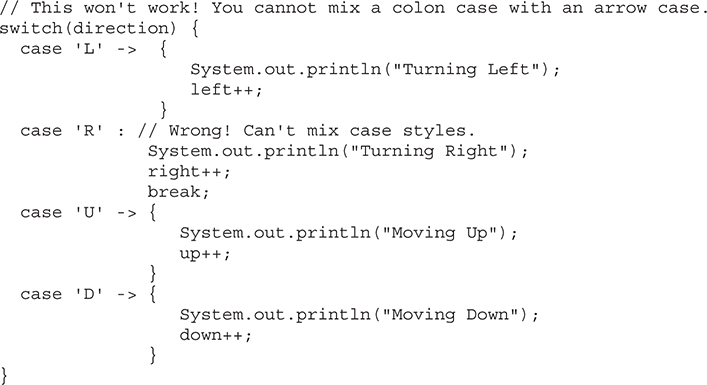
To conclude this overview of the switch enhancements, another example is presented. It uses a switch expression to determine whether a letter is an English-language vowel. It makes use of all of the new switch features. Pay special attention to the way Y is handled. In English, Y can be a vowel or a consonant. The program lets you specify which way you want the Y interpreted by the way the yIsVowel variable is set. To handle this special case, a block is used as the target of the ->.
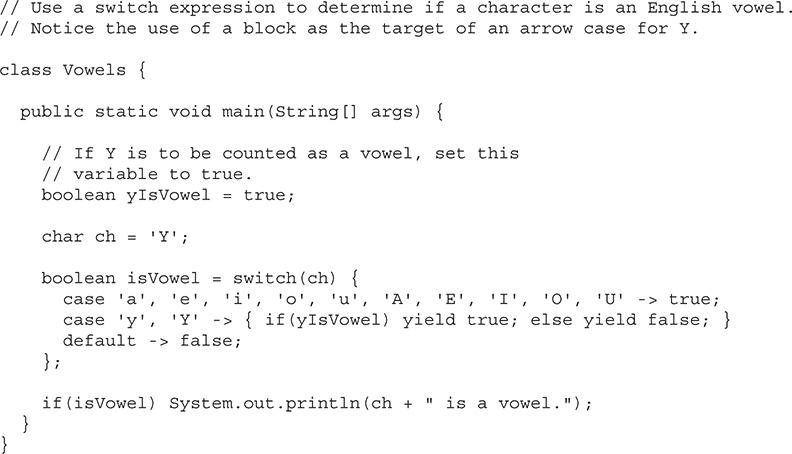
As an experiment, try rewriting this program using a traditional switch. As you will find, doing so results in a much longer, less manageable version. The new switch enhancements often provide a superior approach.
Beginning with JDK 15, Java provides support for text blocks. A text block is a new kind of literal that is comprised of a sequence of characters that can occupy more than one line. A text block reduces the tedium programmers often face when creating long string literals because newline characters can be used in a text block without the need for the \n escape sequence. Furthermore, tab and double quote characters can also be entered directly, without using an escape sequence, and the indentation of a multiline string can be preserved. Although text blocks may, at first, seem to be a relatively small addition to Java, they may well become one of the most popular features.
A text block is supported by a new delimiter, which is three double-quote characters: """. A text block is created by enclosing a string within a set of these delimiters. Specifically, a text block begins immediately following the newline after the opening """. Thus, the line containing the opening delimiter must end with a newline. The text block begins on the next line. A text block ends at the first character of the closing """. Here is a simple example:
"""
Text blocks make
multiple lines easy.
"""
This example creates a string in which the line "Text blocks make" is separated from "multiple lines easy." by a newline. It is not necessary to use the \n escape sequence to obtain the newline. Thus, the text block automatically preserves the newlines in the text. Again, the text block begins after the newline following the opening delimiter and ends at the start of the closing delimiter. Therefore, the newline after the second line is also preserved.
It is important to emphasize that even though a text block uses the """ delimiter, it is of type String. Thus, the preceding text block could be assigned to a String variable, as shown here:
String str = """
Text blocks make
multiple lines easy.
""";
When str is output using this statement:
System.out.println(str);
the following is displayed:
Text blocks make
multiple lines easy.
Notice something else about this example. Because the last line ends with a newline, that newline will also be in the resulting string. If you don’t want a trailing newline, then put the closing delimiter at the end of the last line, like this:
String str = """
Text blocks make
multiple lines easy."""; // now, no newline at the end
In the preceding example, the text in the block was placed flush left. However, this is not required. You can have leading whitespace in a text block. There are two primary reasons that you might want leading whitespace. First, it will enable the text to be better aligned with the indentation level of the code around it. Second, it supports one or more levels of indentation within the text block itself.
In general, leading whitespace in a text block is automatically removed. However, the number of leading whitespaces to remove from each line is determined by the number of leading whitespaces in the line with the least indentation. For example, if all lines are flush left, then no whitespace is removed. If all lines are indented two spaces, then two spaces are removed from each line. However, if one line is indented two spaces, the next four spaces, and the third six spaces, then only two spaces are removed from the start of each line. This removes unwanted leading space while preserving the indentation of text within the block. This mechanism is illustrated by the following program:
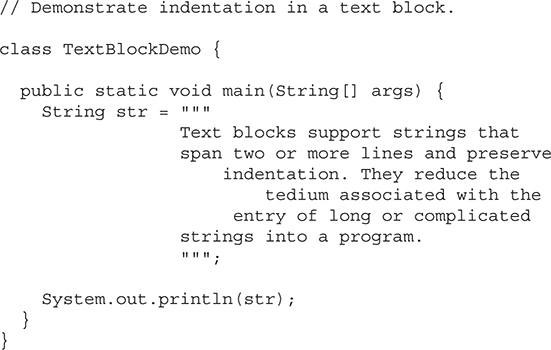
This program produces the following output:

As you can see, leading whitespace has been removed up to, but not beyond, the level of the leftmost lines. Thus, the text block can be indented in the program to better fit the indentation level of the code, with the leading whitespace removed when the string is created. However, any whitespace after the indentation level of the block is preserved.
One other key point: The closing """ participates in determining the amount of whitespace to remove because it, too, can set the indentation level. Thus, if the closing delimiter is flush left, no whitespace is removed. Otherwise, whitespace is removed up to the first text character or when the closing delimiter is encountered. For example, consider this sequence:
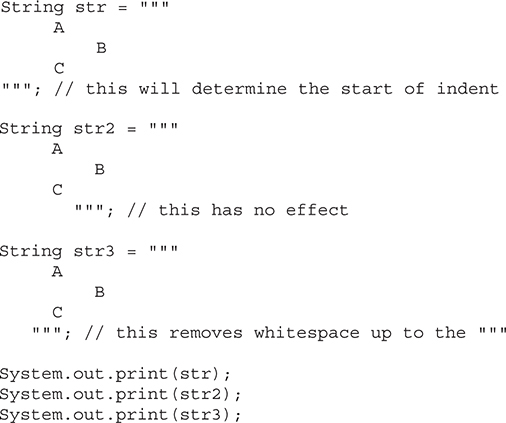
This sequence displays the following:
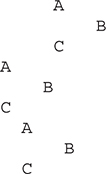
Pay special attention to the placement of the closing delimiter for str2. Because the number of preceding spaces for the lines containing A and C are fewer than that preceding the """, the closing delimiter has no effect on the number of spaces removed.
Another major advantage to text blocks is the ability to use double quotes without the need for the \" escape sequence. In a text block, double quotes are treated like any other character. For example, consider the following program:
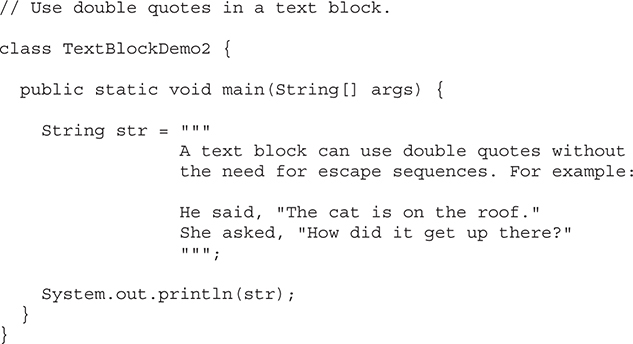
The output is shown here:
A text block can use double quotes without
the need for escape sequences. For example:
He said, "The cat is on the roof."
She asked, "How did it get up there?"
As you can see, there was no need to use the \" escape sequence. Furthermore, because double quotes are treated as “normal” characters, there is also no need for them to be balanced within a text block. For example
"""
""xyz"
"""
is perfectly acceptable. Just remember that three double quotes as a unit defines the text block delimiter.
The escape sequences, such as \n or \t, can be used in a text block. However, because double quotes, newlines, and tabs can be entered directly, they will not often be needed. That said, with the addition of text blocks, two new escape sequences were added to Java. The first is \s, which specifies a space. Thus, it can be used to indicate trailing spaces. The second is \endofline. Because the \ must be followed by a line terminator, it must be used only at the end of the line. In a text block, the \ prevents a newline character from being included at the end of its line. Thus, the \ is essentially a line continuation indicator. For example,
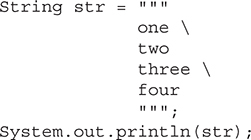
Because the newline is suppressed after one and three, the output will be as shown here:
one two
three four
It is important to point out that \endofline can only be used in a text block. It cannot be used to continue a traditional string literal, for example.
One final point before leaving the topic of text blocks: Because text blocks provide a better, easier way to enter many types of strings into your program, it is anticipated that they will be widely used by the Java programmer community. It is likely that you will begin to encounter them in code that you work on, or use them in code that you create. Just remember, your JDK release must be at least 15 or later.
Beginning with JDK 16, Java supports a special-purpose class called a record. A record is designed to provide an efficient, easy-to-use way to hold a group of values. For example, you might use a record to hold a set of coordinates; bank account numbers and balances; the length, width, and height of a shipping container; and so on. Because it holds a group of values, a record is commonly referred to as an aggregate type. However, the record is more than simply a means of grouping data, because records also have some of the capabilities of a class. In addition, a record has unique features that simplify its declaration and streamline access to its values. As a result, records make it much easier to work with groups of data. Records are supported by the new context-sensitive keyword record.
One of the central motivations for records is the reduction of the effort required to create a class whose primary purpose is to organize two or more values into a single unit. Although it has always been possible to use class for this purpose, doing so can entail writing a number of lines of code for constructors, getter methods, and possibly (depending on use) overriding one or more of the methods inherited from Object. As you will see, by creating a data aggregate by using record, these elements are handled automatically for you, greatly simplifying your code. Another reason for the addition of records is to enable a program to clearly indicate that the intended purpose of a class is to hold a grouping of data, rather than act as a full-featured class. Because of these advantages, records are a much welcomed addition to Java.
As stated, a record is a narrowly focused, specialized class. It is declared by use of the record context-sensitive keyword. As such, record is a keyword only in the context of a record declaration. Otherwise, it is treated as a user-defined identifier with no special meaning. Thus, the addition of record does not impact or break existing code.
The general form of a basic record declaration is shown here:
record recordName(component-list) {
// optional body statements
}
As the general form shows, a record declaration has significant differences from a class declaration. First, notice that the record name is immediately followed by a comma-separated list of parameter declarations called a component list. This list defines the data that the record will hold. Second, notice that the body is optional. This is made possible because the compiler will automatically provide the elements necessary to store the data; construct a record; create getter methods to access the data; and override toString( ), equals( ), and hashCode( ) inherited from Object. As a result, for many uses of a record, no body is required because the record declaration itself fully defines the record.
Here is an example of a simple record declaration:
record Employee(String name, int idNum) {}
Here, the record name is Employee and it has two components: the string name and the integer idNum. It specifies no statements in its body, so its body is empty. As the names imply, such a record could be used to store the name and ID number of an employee.
Given the Employee declaration just shown, a number of elements are automatically created. First, private final fields for name and idNum are declared as type String and int, respectively. Second, public read-only accessor methods (getter methods) that have the same names and types as the record components name and idNum are provided. Therefore, these getter methods are called name( ) and idNum( ). In general, each record component will have a corresponding private final field and a read-only public getter method automatically created by the compiler.
Another element created automatically by the compiler will be the record’s canonical constructor. This constructor has a parameter list that contains the same elements, in the same order, as the component list in the record declaration. The values passed to the constructor are automatically assigned to the corresponding fields in the record. In a record, the canonical constructor takes the place of the default constructor used by a class.
A record is instantiated by use of new, just the way you create an instance of a class. For example, this creates a new Employee object, with the name "Doe, John" and ID number 1047:
Employee emp = new Employee("Doe, John", 1047);
After this declaration executes, the private fields name and idNum for emp will contain the values "Doe, John" and 1047, respectively. Therefore, you can use the following statement to display the information associated with emp:

The resulting output is shown here:
The employee ID for Doe, John is 1047
A key point about a record is that its data is held in private final fields and only getter methods are provided. Thus, the data that a record holds is immutable. In other words, once you construct a record, its contents cannot be changed. However, if a record holds a reference to some object, you can make a change to that object, but you cannot change to what object the reference in the record refers. Thus, in Java terms, records are said to be shallowly immutable.
The following program puts the preceding discussion into action. Records are often used as elements in a list. For example, a business might maintain a list of Employee records to store an employee’s name along with his or her corresponding ID number. The following program shows a simple example of such usage. It creates a small array of Employee records. It then cycles through the array, displaying the contents of each record.
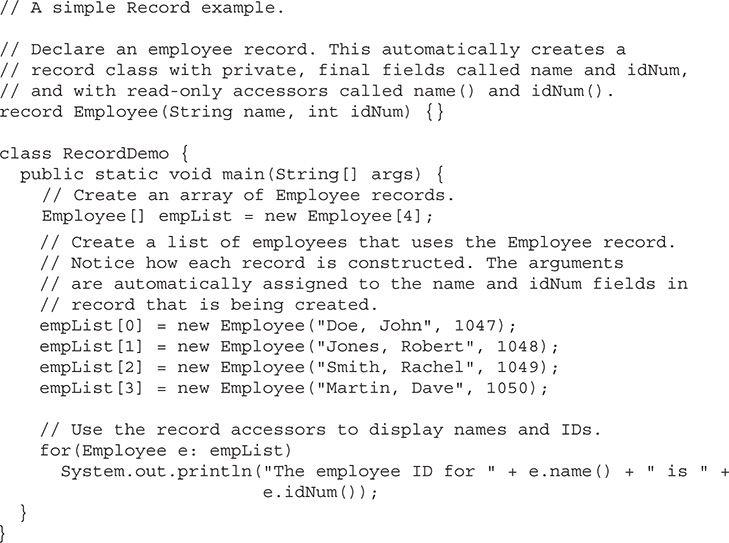
The output is shown here:
The employee ID for Doe, John is 1047
The employee ID for Jones, Robert is 1048
The employee ID for Smith, Rachel is 1049
The employee ID for Martin, Dave is 1050
Before continuing, it is important to mention some key points related to records. First, a record cannot inherit another class. However, all records implicitly inherit java.lang.Record, which specifies abstract overrides of the equals( ), hashCode( ), and toString( ) methods declared by Object. Implicit implementations of these methods are automatically created, based on the record declaration. A record type cannot be extended. Thus, all record declarations are considered final. Although a record cannot extend another class, it can implement one or more interfaces. With the exception of equals, you cannot use the names of methods defined by Object as names for a record’s components. Aside from the fields associated with a record’s components, any other fields must be static. Finally, a record can be generic.
Although you will often find that the automatically supplied canonical constructor is precisely what you want, you can also declare one or more of your own constructors. You can also define your own implementation of the canonical constructor. You might want to declare a record constructor for a number of reasons. For example, the constructor could check that a value is within a required range, verify that a value is in the proper format, ensure that an object implements optional functionality, or confirm that an argument is not null. For a record, there are two general types of constructors that you can explicitly create: canonical and non-canonical, and there are some differences between the two. The creation of each type is examined here, beginning with defining your own implementation of the canonical constructor.
Although the canonical constructor has a specific, predefined form, there are two ways that you can code your own implementation. First, you can explicitly declare the full form of the canonical constructor. Second, you can use what is called a compact record constructor. Each approach is examined here, beginning with the full form.
To define your own implementation of a canonical constructor, simply do so as you would with any other constructor, specifying the record’s name and its parameter list. It is important to emphasize that for the canonical constructor, the types and parameter names must be the same as those specified by the record declaration. This is because the parameter names are linked to the automatically created fields and accessor methods defined by the record declaration. Thus, they must agree in both type and name. Furthermore, each component must be fully initialized upon completion of the constructor. The following restrictions also apply: the constructor must be at least as accessible as its record declaration Thus, if the access modifier for the record is public, the constructor must also be specified public. A constructor cannot be generic, and it cannot include a throws clause. It also cannot invoke another constructor defined for the record.
Here is an example of the Employee record that explicitly defines the canonical constructor. It uses this constructor to remove any leading or trailing whitespace from a name. This ensures that names are stored in a consistent manner.

In the constructor, leading and/or trailing whitespace is removed by a call to trim( ). Defined by the String class, trim( ) deletes all leading and trailing whitespace from a string and returns the result. (If there are no leading or trailing spaces, the original string is returned unaltered.) The resulting string is assigned to the field this.name. Thus, no Employee record name will contain leading or trailing spaces. Next, the value of idNum is assigned to this.idNum. Because the identifiers name and idNum are the same for both fields corresponding to the Employee components and for the names used by the canonical constructor’s parameters, the field names must be qualified by this.
Although there is certainly nothing wrong with creating a canonical constructor as just shown, there is often an easier way: through the use of a compact constructor. A compact record constructor is declared by specifying the name of the record, but without parameters. The compact constructor implicitly has parameters that are the same as the record’s components, and its components are automatically assigned the values of the arguments passed to the constructor. Within the compact constructor you can, however, alter one or more of the arguments prior to their value being assigned to the record.
The following example converts the previous canonical constructor into its compact form:

Here, the result of trim( ) is called on the name parameter (which is implicitly declared by the compact constructor) and the result is assigned back to the name parameter. At the end of the compact constructor, the value of name is automatically assigned to its corresponding field. The value of the implicit idNum parameter is also assigned to its corresponding field at the end of the constructor. Because the parameters are implicitly assigned to their corresponding fields when the constructor ends, there is no need to initialize the fields explicitly. Moreover, it would not be legal to do so.
Here is a reworked version of the previous program that demonstrates the compact canonical constructor:
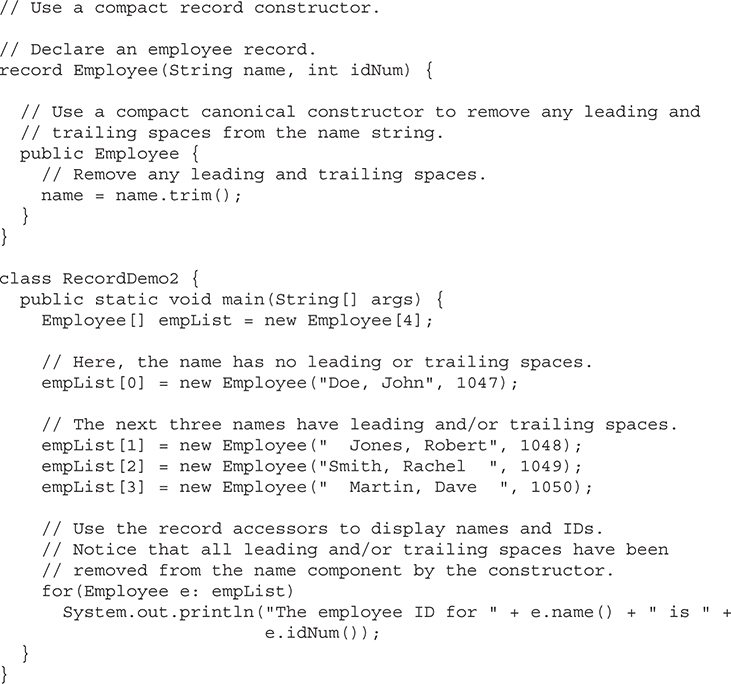
The output is shown here:
The employee ID for Doe, John is 1047
The employee ID for Jones, Robert is 1048
The employee ID for Smith, Rachel is 1049
The employee ID for Martin, Dave is 1050
As you can see, the names have been standardized with leading and trailing spaces removed. To prove to yourself that the call to trim( ) is necessary to achieve this result, simply remove the compact constructor, recompile, and run the program. The leading and trailing spaces will still be in the names.
Although the canonical constructor will often be sufficient, you can declare other constructors. The key requirement is that any non-canonical constructor must first call another constructor in the record via this. The constructor invoked will often be the canonical constructor. Doing this ultimately ensures that all fields are assigned. Declaring a non-canonical constructor enables you to create special-case records. For example, you might use such a constructor to create a record in which one or more of the components is given a default placeholder value.
The following program declares a non-canonical constructor for Employee that initializes the name to a known value, but gives the idNum field the special value pendingID (which is –1) to indicate an ID value is not available when the record is created:
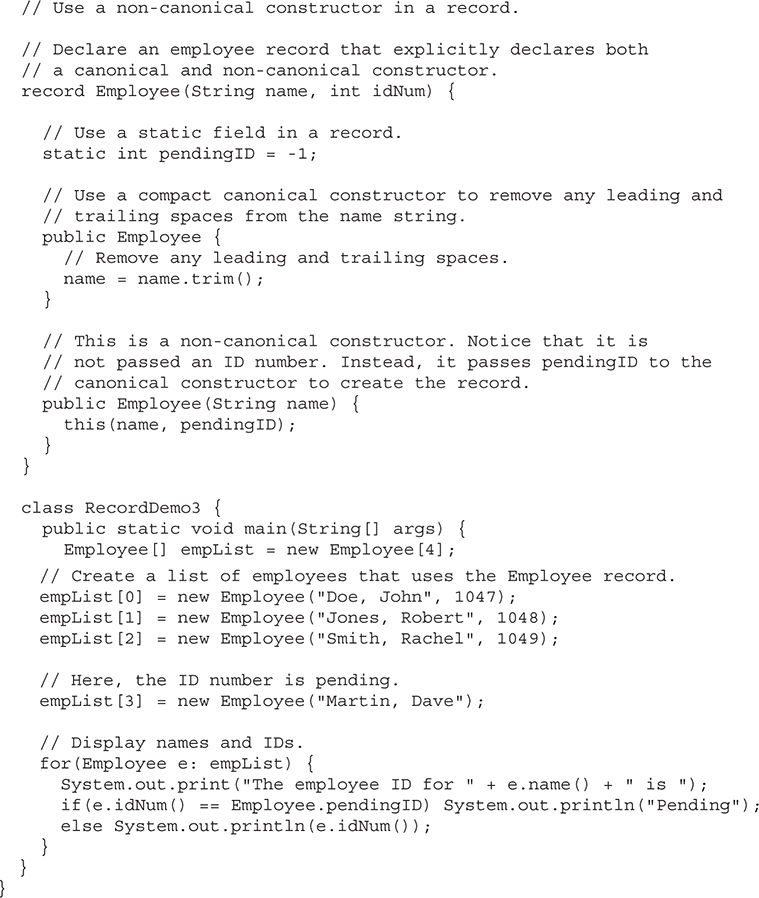
Pay special attention to the way that the record for Martin, Dave is created by use of the non-canonical constructor. That constructor passes the name argument to the canonical constructor, but specifies the value pendingID as the idNum value. This enables a placeholder record to be created without having to specify an ID number. One other point: Notice that the value pendingID is declared as a static field in Employee. As explained earlier, instance fields are not allowed in a record declaration, but a static field is legal.
Notice that this version of Employee declares both a canonical constructor and a non-canonical constructor. This is perfectly valid. A record can define as many different constructors as its needs, as long as all adhere to the rules defined for record.
It is important to emphasize that records are immutable. As it relates to this example, it means that when an ID value for Martin, Dave is obtained, the old record must be replaced by a new record that contains the ID number. It is not possible to alter the record to update the ID. The immutability of records is a primary attribute.
Before leaving the topic of record constructors, we will look at one more example. Because a record is used to aggregate data, a common use of a record constructor is to verify the validity or applicability of an argument. For example, before constructing the record, the constructor may need to determine if a value is out of range, in an improper format, or otherwise unsuitable for use. If an invalid condition is found, the constructor could create a default or error instance. However, often it would be better for the constructor to throw an exception. This way, the user of the record would immediately be aware of the error and could take steps to correct it.
In the preceding Employee record examples, names have been specified using the common convention of lastname, firstname, such as Doe, John. However, there was no mechanism to verify or enforce that this format was being used. The following version of the compact canonical constructor provides a limited check that the name has the format lastname, firstname. It does so by confirming that there is one and only one comma in the name and that there is at least one character (other than space) before and after the comma. Although a far more thorough, careful verification would be needed by a real-world program, this minimal check is sufficient to serve as an example of the validation role a record constructor might play.
Here is a version of the Employee record in which the compact canonical constructor throws an exception if the name component does not meet the minimal criteria required for the lastname, firstname format:
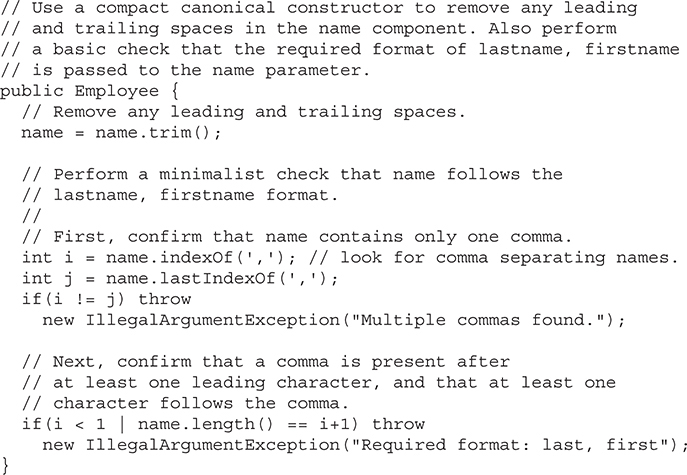
When using this constructor, the following statement is still correct:
empList[0] = new Employee("Doe, John", 1047);
However, the following three are invalid and will result in an exception:
// No comma between last and first name.
empList[1] = new Employee("Jones Robert", 1048);
// Extra commas.
empList[1] = new Employee("Jones, ,Robert", 1048);
// Missing last name.
empList[1] = new Employee(", Robert", 1048);
As an aside, you might find it interesting to think of ways that you can improve the ability of the constructor to verify that the name uses the proper format. For example, you might want to explore an approach that uses a regular expression. (See Chapter 31.)
Although it is seldom necessary, it is possible to create your own implementation of a getter method. When you declare the getter, the implicit version is no longer supplied. One possible reason you might want to declare your own getter is to throw an exception if some condition is not met. For example, if a record holds a filename and a URL, the getter for the filename might throw a FileNotFoundException if the file is not present at the URL. There is a very important requirement, however, that applies to creating your getters: they must adhere to the principle that a record is immutable. Thus, a getter that returns an altered value is semantically questionable (and should be avoided) even though such code would be syntactically correct.
If you do declare a getter implementation, there are a number of rules that apply. A getter must have the same return type and name as the component that it obtains. It must also be explicitly declared public. (Thus, default accessibility is not sufficient for a getter declaration in a record.) No throws clause is allowed in a getter declaration. Finally, a getter must be non-generic and non-static.
A better alternative to overriding a getter in cases in which you want to obtain a modified value of a component is to declare a separate method with its own name. For example, assuming the Employee record, you might want to obtain only the last name from the name component. Using the standard getter to do this would entail modifying the value obtained from the component. Doing this is a bad idea because it would violate the immutability aspect of the record. However, you could declare another method, called lastName( ), that returns only the last name. The following program demonstrates this approach. It also uses the format-checking constructor from the previous section to ensure that names are stored as lastname, firstname.
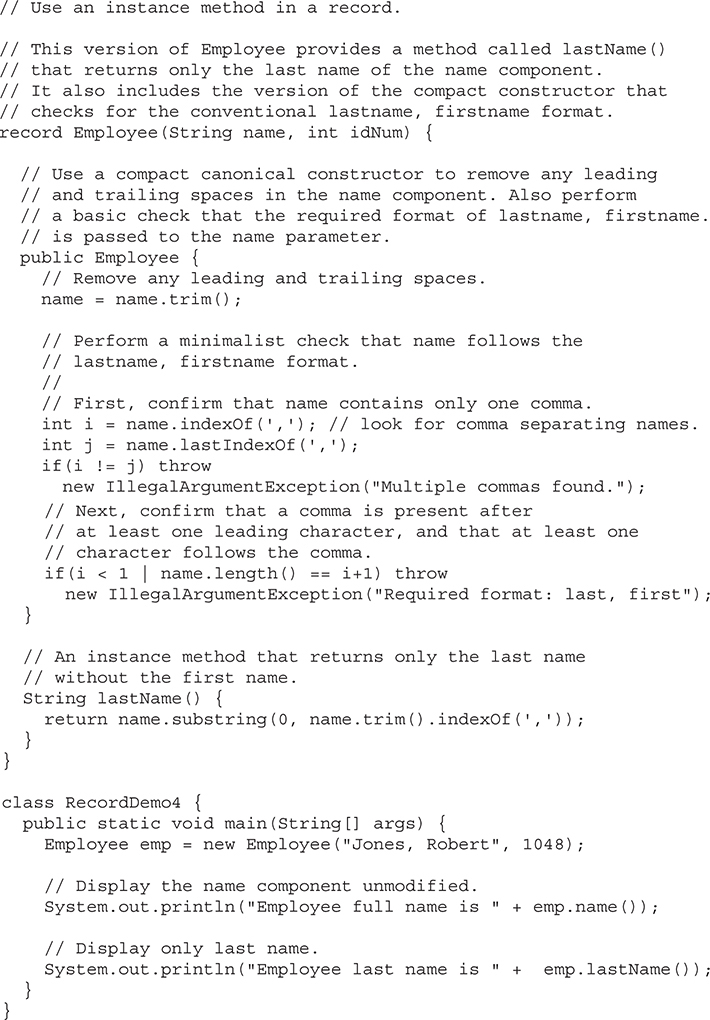
The output is shown here:
Employee full name is Jones, Robert
Employee last name is Jones
As the output shows, the implicit getter for the name component returns the name unaltered. The instance method lastName( ) obtains only the last name. With this approach, the immutable attribute of the Employee record is preserved, while still providing a convenient means of obtaining the last name.
The traditional form of the instanceof operator was introduced in Chapter 13. As explained there, instanceof evaluates to true if an object is of a specified type, or can be cast to that type. Beginning with JDK 16, a second form of the instanceof operator has been added to Java that supports the new pattern matching feature. In general terms, pattern matching defines a mechanism that determines if a value fits a general form. As it relates to instanceof, pattern matching is used to test the type of a value (which must be a reference type) against a specified type. This kind of pattern is called a type pattern. If the pattern matches, a pattern variable will receive a reference to the object matched by the pattern.
The pattern matching form of instanceof is shown here:
objref instanceof type pattern-var
If instanceof succeeds, pattern-var will be created and contain a reference to the object that matches the pattern. If it fails, pattern-var is never created. This form of instanceof succeeds if the object referred to by objref can be cast to type and the static type of objref is not a subtype of type.
For example, the following fragment creates a Number reference called myOb that refers to an Integer object. (Recall that Number is a superclass of all numeric primitive-type wrappers.) It then uses the instanceof operator to confirm that the object referred to by myOb is an Integer, which it will be in this example. This results in an object called iObj of type Integer being instantiated that contains the matched value.

As the comments indicate, iObj is known only within the scope of the if clause. It is not known outside of the if. It also would not be known within an else clause, should one have been included. It is crucial to understand that the pattern variable iObj is created only if the pattern matching succeeds.
The primary advantage of the pattern matching form of instanceof is that it reduces the amount of code that was typically needed by the traditional form of instanceof. For example, consider this functionally equivalent version of the preceding example that uses the traditional approach:

With the traditional form, a separate declaration statement and explicit cast are required to create the iObj variable. The pattern matching form of instanceof streamlines the process.
An instanceof can be used in a logical AND expression. However, you need to remember that the pattern variable is only in scope after it has been created. For example, the following if succeeds only when myOb refers to an Integer and its value is nonnegative. Pay special attention to the expression in the if:

The iObj pattern variable is created only if the left side of the && (the part that contains the instanceof operator) is true. Notice that iObj is also used by the right side. This is possible because the short-circuit form of the AND logical operator is used, and the right side is evaluated only if the left succeeds. Thus, if the right-side operand is evaluated, iObj will be in scope. However, if you tried to write the preceding statement using the & operator like this:

a compilation error would occur because iObj will not be in scope if the left side fails. Recall that the & operator causes both sides of the expression to be evaluated, but iObj is only in scope if the left side is true. This error is caught by the compiler. A related situation occurs with this fragment:

This fragment compiles because the if block will execute only when both sides of the && are true. Thus, the use of iObj in the if block is valid. However, a compilation error will result if you tried to use the & rather than the &&, as shown here:
if((count < 100) & myOb instanceof Integer iObj) { // Error!
In this case, the compiler cannot know whether or not iObj will be in scope in the if block because the right side of the & will not necessarily be evaluated.
One other point: A logical expression cannot introduce the same pattern variable more than once. For example, in a logical AND, it is an error if both operands create the same pattern variable.
Although a frequent use of the pattern matching form of instanceof is in an if statement, it is by no means limited to that use. It can also be employed in the conditional portion of the loop statements. As an example, imagine that you are processing a collection of objects, perhaps contained in an array. Furthermore, at the start of the array are several strings, and you want to process those strings, but not any of the remaining objects in the list. The following sequence accomplishes this task with a for loop in which the condition uses instanceof to confirm that an object in the array is a String and to obtain that string for processing within the loop. Thus, pattern matching is used to control the execution of a for loop and to obtain the next value for processing.
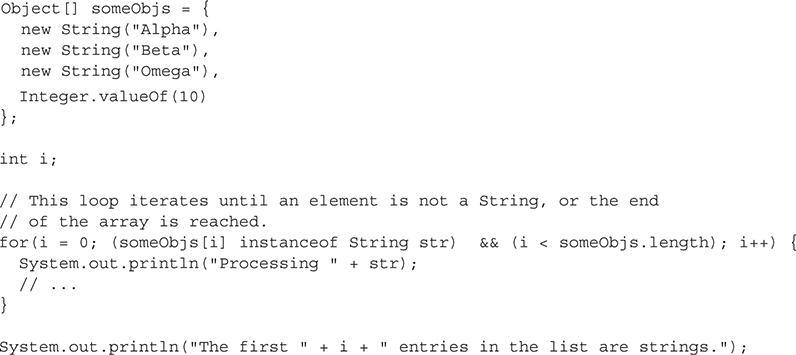
The output from this fragment is shown here:
Processing Alpha
Processing Beta
Processing Omega
The first 3 entries in the list are strings.
The pattern matching form of instanceof can also be useful in a while loop. For example, here is the preceding for loop, recoded as a while:

Although it is technically possible to use the pattern matching instanceof in the conditional portion of a do loop, such use is severely limited because the pattern variable cannot be used in body of the loop because it will not be in scope until the instanceof operator is executed.
Beginning with JDK 17, it is possible to declare a class that can be inherited by only specific subclasses. Such a class is called sealed. Prior to the advent of sealed classes, inheritance was an “all or nothing” situation. A class could either be extended by any subclass or marked as final, which prevented its inheritance entirely. Sealed classes fall between these two extremes because they enable you to specify precisely what subclasses a superclass will allow. In similar fashion, it is also possible to declare a sealed interface in which you specify only those classes that implement the interface and/or those interfaces that extend the sealed interface. Together, sealed classes and interfaces give you significantly greater control over inheritance, which can be especially important when designing class libraries.
To declare a sealed class, precede the declaration with sealed. Then, after the class name, include a permits clause that specifies the allowed subclasses. Both sealed and permits are context-sensitive keywords that have special meaning only in a class or interface declaration. Outside of a class or interface declaration, sealed and permits are unrestricted and have no special meaning. Here is a simple example of a sealed class:

Here, the sealed class is called MySealedClass. It allows only two subclasses: Alpha and Beta. If any other class attempts to inherit MySealedClass, a compile-time error will occur.
Here are Alpha and Beta, the two subclasses of MySealedClass:

Notice that each is specified as final. In general, a subclass of a sealed class must be declared as either final, sealed, or non-sealed. Let’s look at each option. First, in this example, each subclass is declared final. This means that the only subclasses of MySealedClass are Alpha and Beta, and no subclasses of either of those can be created. Therefore, the inheritance chain ends with Alpha and Beta.
To indicate that a subclass is itself sealed, it must be declared sealed and its permitted subclasses must be specified. For example, this version of Alpha permits Gamma:

Of course, the class Gamma must then itself be declared either sealed, final, or non-sealed.
At first it might seem a bit surprising, but you can unseal a subclass of a sealed class by declaring it non-sealed. This context-sensitive keyword was added by JDK 17. It unlocks the subclass, enabling it to be inherited by any other class. For example, Beta could be coded like this:

Now, any class may inherit Beta. However, the only direct subclasses of MySealedClass remain Alpha and Beta. A primary reason for non-sealed is to enable a superclass to specify a limited set of direct subclasses that provide a baseline of well-defined functionality but allow those subclasses to be freely extended.
If a class is specified in a permits clause for a sealed class, then that class must directly extend the sealed class. Otherwise, a compile-time error will result. Thus, a sealed class and its subclasses define a mutually dependent logical unit. Additionally, it is illegal to declare a class that does not extend a sealed class as non-sealed.
A key requirement of a sealed class is that every subclass that it permits must be accessible. Furthermore, if a sealed class is contained in a named module, then each subclass must also be in the same named module. In this case, a subclass can be in a different package from the sealed class. If the sealed class is in the unnamed module, then the sealed class and all permitted subclasses must be in the same package.
In the preceding discussion, the superclass MySealedClass and its subclasses Alpha and Beta would have been stored in separate files because they are all public classes. However, it is also possible for a sealed class and its subclasses to be stored in a single file (formally, a compilation unit) as long as the subclasses have default package access. In cases such as this, no permits clause is required for a sealed class. For example, here all three classes are in the same file:
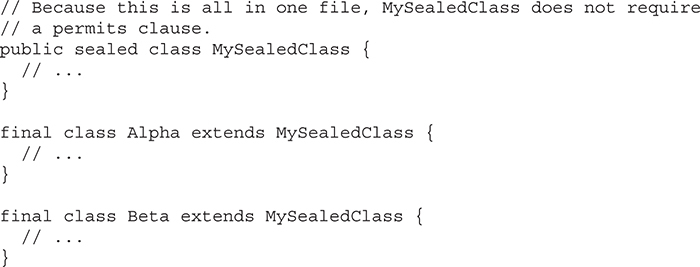
One last point: An abstract class can also be sealed. There is no restriction in this regard.
A sealed interface is declared in the same way as a sealed class, by the use of sealed. A sealed interface uses its permits clause to specify the classes allowed to implement it and/or the interfaces allowed to extend it. Thus, a class that is not part of the permits clause cannot implement a sealed interface, and an interface not included in the permits clause cannot extend it.
Here is a simple example of a sealed interface that permits only the classes Alpha and Beta to implement it:

A class that implements a sealed interface must itself be specified as either final, sealed, or non-sealed. For example, here Alpha is marked non-sealed and Beta is specified as final:

Here is a key point: Any class specified in a sealed interface’s permits clause must implement the interface. Thus, a sealed interface and its implementing classes form a logical unit.
A sealed interface can also specify which other interfaces can extend the sealed interface. For example, here, MySealedIF specifies that MyIF is permitted to extend it:

Because MyIF is part of the MySealedIF permits clause, it must be marked as either non-sealed or sealed and it must extend MySealedIF. For example,

As you might expect, it is possible for a class to inherit a sealed class and implement a sealed interface. For example, here Alpha inherits MySealedClass and implements MySealedIF:

In the preceding examples, each class and interface are declared public. Thus, each is in its own file. However, as is the case with sealed classes, it is also possible for a sealed interface and its implementing classes (and extending interfaces) to be stored in a single file as long as the classes and interfaces have default package access. In cases such as this, no permits clause is required for a sealed interface. For example, here MySealedIF does not include a permits clause because Alpha and Beta are declared in the same file in the unnamed module:
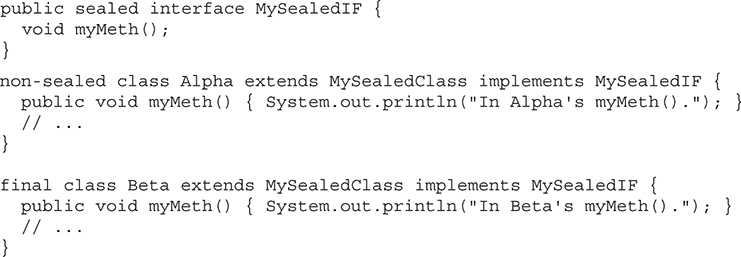
One final point: Sealed classes and interfaces are most applicable to developers of API libraries in which subclasses and subinterfaces must be strictly controlled.
Beginning with JDK 12, Java releases may, and often do, include preview features. A preview feature is a new, fully developed enhancement to Java. However, a preview feature is not yet formally part of Java. Instead, a feature is previewed to allow programmers time to experiment with the feature and, if desired, communicate their thoughts and opinions prior to the feature being made permanent. This process enables a new feature to be improved or optimized based on actual developer use. As a result, a preview feature is subject to change. It can even be withdrawn. This means that a preview feature should not be used for code that you intend to publicly release That said, it is expected that most preview features will ultimately become part of Java, possibly after a period of refinement. Preview features chart the course of Java’s future direction.
JDK 17 includes one preview feature: Pattern Matching for switch (JEP 406). It adds pattern matching capabilities to switch. As described earlier in this chapter, pattern matching was first introduced by the enhancement of instanceof in JDK 16. Adding pattern matching to switch continues the process. Because this is a preview feature that is subject to change, it is not discussed further in this book.
Java releases may also include incubator modules, which preview a new API or tool that is undergoing development. Like a preview feature, an incubator feature is subject to change. Furthermore, an incubator feature can be removed in the future. Thus, there is no guarantee that an incubating module will formally become part of Java in the future. Incubator features give developers an opportunity to experiment with the API or tool, and possibly supply feedback. JDK 17 includes two incubator modules. The first is Foreign Function and Memory API (JEP 412). The second is Vector API (JEP 414).
It is important to emphasize that preview features and incubator modules can be introduced in any Java release. Therefore, you will want to watch for them in each new version of Java. They give you a chance to try a new enhancement before it potentially becomes a formal part of Java. Perhaps more importantly, preview features and incubator modules give you advance information on where Java’s development is headed.
A brief overview of Java’s string handling was presented in Chapter 7. In this chapter, it is described in detail. As is the case in most other programming languages, in Java a string is a sequence of characters. But, unlike some other languages that implement strings as character arrays, Java implements strings as objects of type String.
Implementing strings as built-in objects allows Java to provide a full complement of features that make string handling convenient. For example, Java has methods to compare two strings, search for a substring, concatenate two strings, and change the case of letters within a string. Also, String objects can be constructed a number of ways, making it easy to obtain a string when needed.
Somewhat unexpectedly, when you create a String object, you are creating a string that cannot be changed. That is, once a String object has been created, you cannot change the characters that comprise that string. At first, this may seem to be a serious restriction. However, such is not the case. You can still perform all types of string operations. The difference is that each time you need an altered version of an existing string, a new String object is created that contains the modifications. The original string is left unchanged. This approach is used because fixed, immutable strings can be implemented more efficiently than changeable ones. For those cases in which a modifiable string is desired, Java provides two options: StringBuffer and StringBuilder. Both hold strings that can be modified after they are created.
The String, StringBuffer, and StringBuilder classes are defined in java.lang. Thus, they are available to all programs automatically. All are declared final, which means that none of these classes may be subclassed. This allows certain optimizations that increase performance to take place on common string operations. All three implement the CharSequence interface.
One last point: To say that the strings within objects of type String are unchangeable means that the contents of the String instance cannot be changed after it has been created. However, a variable declared as a String reference can be changed to point at some other String object at any time.
The String class supports several constructors. To create an empty String, call the default constructor. For example,
String s = new String();
will create an instance of String with no characters in it.
Frequently, you will want to create strings that have initial values. The String class provides a variety of constructors to handle this. To create a String initialized by an array of characters, use the constructor shown here:
String(char[ ] chars)
Here is an example:
char[] chars = { 'a', 'b', 'c' };
String s = new String(chars);
This constructor initializes s with the string "abc".
You can specify a subrange of a character array as an initializer using the following constructor:
String(char[ ] chars, int startIndex, int numChars)
Here, startIndex specifies the index at which the subrange begins, and numChars specifies the number of characters to use. Here is an example:
char[] chars = { 'a', 'b', 'c', 'd', 'e', 'f' };
String s = new String(chars, 2, 3);
This initializes s with the characters cde.
You can construct a String object that contains the same character sequence as another String object using this constructor:
String(String strObj)
Here, strObj is a String object. Consider this example:
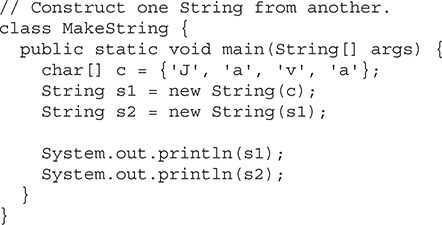
The output from this program is as follows:
Java
Java
As you can see, s1 and s2 contain the same string.
Even though Java’s char type uses 16 bits to represent the basic Unicode character set, the typical format for strings on the Internet uses arrays of 8-bit bytes constructed from the ASCII character set. Because 8-bit ASCII strings are common, the String class provides constructors that initialize a string when given a byte array. Two forms are shown here:
String(byte[ ] chrs)
String(byte[ ] chrs, int startIndex, int numChars)
Here, chrs specifies the array of bytes. The second form allows you to specify a subrange. In each of these constructors, the byte-to-character conversion is done by using the default character encoding of the platform. The following program illustrates these constructors:
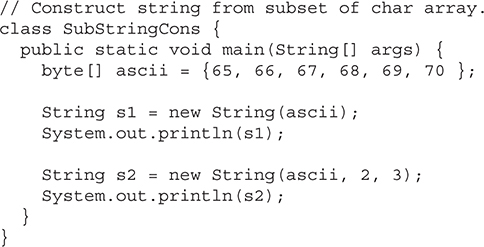
This program generates the following output:
ABCDEF
CDE
Extended versions of the byte-to-string constructors are also defined in which you can specify the character encoding that determines how bytes are converted to characters. However, you will often want to use the default encoding provided by the platform.
Note The contents of the array are copied whenever you create a String object from an array. If you modify the contents of the array after you have created the string, the String will be unchanged.
You can construct a String from a StringBuffer by using the constructor shown here:
String(StringBuffer strBufObj)
You can construct a String from a StringBuilder by using this constructor:
String(StringBuilder strBuildObj)
The following constructor supports the extended Unicode character set:
String(int[ ] codePoints, int startIndex, int numChars)
Here, codePoints is an array that contains Unicode code points. The resulting string is constructed from the range that begins at startIndex and runs for numChars.
There are also constructors that let you specify a Charset.
Note A discussion of Unicode code points and how they are handled by Java is found in Chapter 19.
The length of a string is the number of characters that it contains. To obtain this value, call the length( ) method, shown here:
int length( )
The following fragment prints "3", since there are three characters in the string s:
char[] chars = { 'a', 'b', 'c' };
String s = new String(chars);
System.out.println(s.length());
Because strings are a common and important part of programming, Java has added special support for several string operations within the syntax of the language. These operations include the automatic creation of new String instances from string literals, concatenation of multiple String objects by use of the + operator, and the conversion of other data types to a string representation. There are explicit methods available to perform all of these functions, but Java does them automatically as a convenience for the programmer and to add clarity.
The earlier examples showed how to explicitly create a String instance from an array of characters by using the new operator. However, there is an easier way to do this using a string literal. For each string literal in your program, Java automatically constructs a String object. Thus, you can use a string literal to initialize a String object. For example, the following code fragment creates two equivalent strings:
char[] chars = { 'a', 'b', 'c' };
String s1 = new String(chars);
String s2 = "abc"; // use string literal
Because a String object is created for every string literal, you can use a string literal any place you can use a String object. For example, you can call methods directly on a quoted string as if it were an object reference, as the following statement shows. It calls the length( ) method on the string "abc". As expected, it prints "3".
System.out.println("abc".length());
In general, Java does not allow operators to be applied to String objects. The one exception to this rule is the + operator, which concatenates two strings, producing a String object as the result. This allows you to chain together a series of + operations. For example, the following fragment concatenates three strings:
String age = "9";
String s = "He is " + age + " years old.";
System.out.println(s);
This displays the string "He is 9 years old."
One practical use of string concatenation is found when you are creating very long strings. Instead of letting long strings wrap around within your source code, you can break them into smaller pieces, using the + to concatenate them. Here is an example:
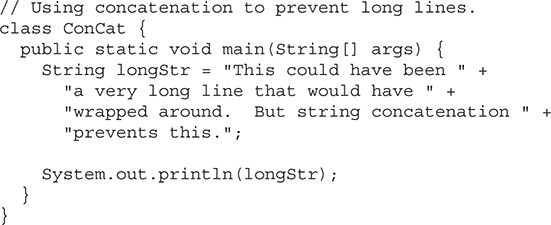
You can concatenate strings with other types of data. For example, consider this slightly different version of the earlier example:
int age = 9;
String s = "He is " + age + " years old.";
System.out.println(s);
In this case, age is an int rather than another String, but the output produced is the same as before. This is because the int value in age is automatically converted into its string representation within a String object. This string is then concatenated as before. The compiler will convert an operand to its string equivalent whenever the other operand of the + is an instance of String.
Be careful when you mix other types of operations with string concatenation expressions, however. You might get surprising results. Consider the following:
String s = "four: " + 2 + 2;
System.out.println(s);
This fragment displays
four: 22
rather than the
four: 4
that you probably expected. Here’s why. Operator precedence causes the concatenation of "four" with the string equivalent of 2 to take place first. This result is then concatenated with the string equivalent of 2 a second time. To complete the integer addition first, you must use parentheses, like this:
String s = "four: " + (2 + 2);
Now s contains the string "four: 4".
One way to convert data into its string representation is by calling one of the overloaded versions of the string conversion method valueOf( ) defined by String. valueOf( ) is overloaded for all the primitive types and for type Object. For the primitive types, valueOf( ) returns a string that contains the human-readable equivalent of the value with which it is called. For objects, valueOf( ) calls the toString( ) method on the object. We will look more closely at valueOf( ) later in this chapter. Here, let’s examine the toString( ) method, because it is the means by which you can determine the string representation for objects of classes that you create.
Every class implements toString( ) because it is defined by Object. However, the default implementation of toString( ) is seldom sufficient. For most important classes that you create, you will want to override toString( ) and provide your own string representations. Fortunately, this is easy to do. The toString( ) method has this general form:
String toString( )
To implement toString( ), simply return a String object that contains the human-readable string that appropriately describes an object of your class.
By overriding toString( ) for classes that you create, you allow them to be fully integrated into Java’s programming environment. For example, they can be used in print( ) and println( ) statements and in concatenation expressions. The following program demonstrates this by overriding toString( ) for the Box class:
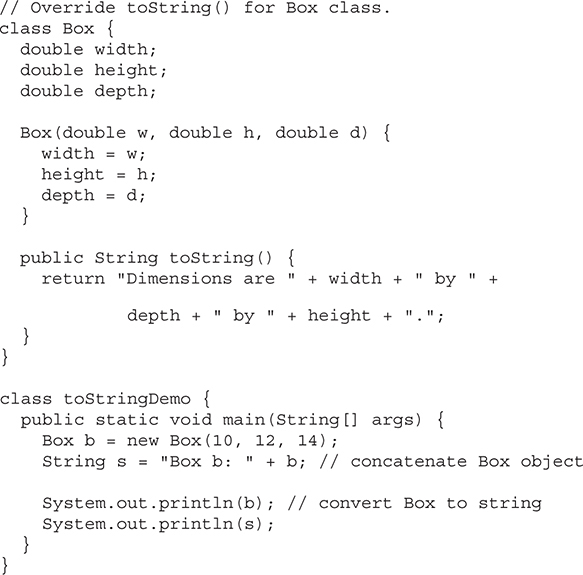
The output of this program is shown here:
Dimensions are 10.0 by 14.0 by 12.0
Box b: Dimensions are 10.0 by 14.0 by 12.0
As you can see, Box’s toString( ) method is automatically invoked when a Box object is used in a concatenation expression or in a call to println( ).
The String class provides a number of ways in which characters can be extracted from a String object. Several are examined here. Although the characters that comprise a string within a String object cannot be indexed as if they were a character array, many of the String methods employ an index (or offset) into the string for their operation. Like arrays, the string indexes begin at zero.
To extract a single character from a String, you can refer directly to an individual character via the charAt( ) method. It has this general form:
char charAt(int where)
Here, where is the index of the character that you want to obtain. The value of where must be nonnegative and specify a location within the string. charAt( ) returns the character at the specified location. For example,
char ch;
ch = "abc".charAt(1);
assigns the value b to ch.
If you need to extract more than one character at a time, you can use the getChars( ) method. It has this general form:
void getChars(int sourceStart, int sourceEnd, char[ ] target, int targetStart)
Here, sourceStart specifies the index of the beginning of the substring, and sourceEnd specifies an index that is one past the end of the desired substring. Thus, the substring contains the characters from sourceStart through sourceEnd–1. The array that will receive the characters is specified by target. The index within target at which the substring will be copied is passed in targetStart. Care must be taken to assure that the target array is large enough to hold the number of characters in the specified substring.
The following program demonstrates getChars( ):
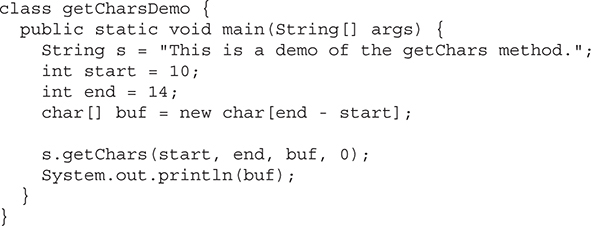
Here is the output of this program:
demo
There is an alternative to getChars( ) that stores the characters in an array of bytes. This method is called getBytes( ), and it uses the default character-to-byte conversions provided by the platform. Here is its simplest form:
byte[ ] getBytes( )
Other forms of getBytes( ) are also available. getBytes( ) is most useful when you are exporting a String value into an environment that does not support 16-bit Unicode characters.
If you want to convert all the characters in a String object into a character array, the easiest way is to call toCharArray( ). It returns an array of characters for the entire string. It has this general form:
char[ ] toCharArray( )
This function is provided as a convenience, since it is possible to use getChars( ) to achieve the same result.
The String class includes a number of methods that compare strings or substrings within strings. Several are examined here.
To compare two strings for equality, use equals( ). It has this general form:
boolean equals(Object str)
Here, str is the String object being compared with the invoking String object. It returns true if the strings contain the same characters in the same order, and false otherwise. The comparison is case-sensitive.
To perform a comparison that ignores case differences, call equalsIgnoreCase( ). When it compares two strings, it considers A-Z to be the same as a-z. It has this general form:
boolean equalsIgnoreCase(String str)
Here, str is the String object being compared with the invoking String object. It, too, returns true if the strings contain the same characters in the same order, and false otherwise.
Here is an example that demonstrates equals( ) and equalsIgnoreCase( ):
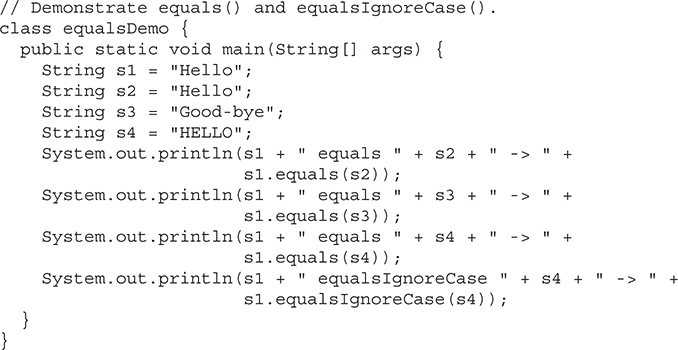
The output from the program is shown here:
Hello equals Hello -> true
Hello equals Good-bye -> false
Hello equals HELLO -> false
Hello equalsIgnoreCase HELLO -> true
The regionMatches( ) method compares a specific region inside a string with another specific region in another string. There is an overloaded form that allows you to ignore case in such comparisons. Here are the general forms for these two methods:
boolean regionMatches(int startIndex, String str2,
int str2StartIndex, int numChars)
boolean regionMatches(boolean ignoreCase,
int startIndex, String str2,
int str2StartIndex, int numChars)
For both versions, startIndex specifies the index at which the region begins within the invoking String object. The String being compared is specified by str2. The index at which the comparison will start within str2 is specified by str2StartIndex. The length of the substring being compared is passed in numChars. In the second version, if ignoreCase is true, the case of the characters is ignored. Otherwise, case is significant.
String defines two methods that are, more or less, specialized forms of regionMatches( ). The startsWith( ) method determines whether a given String begins with a specified string. Conversely, endsWith( ) determines whether the String in question ends with a specified string. They have the following general forms:
boolean startsWith(String str)
boolean endsWith(String str)
Here, str is the String being tested. If the string matches, true is returned. Otherwise, false is returned. For example,
"Foobar".endsWith("bar")
and
"Foobar".startsWith("Foo")
are both true.
A second form of startsWith( ), shown here, lets you specify a starting point:
boolean startsWith(String str, int startIndex)
Here, startIndex specifies the index into the invoking string at which point the search will begin. For example,
"Foobar".startsWith("bar", 3)
returns true.
It is important to understand that the equals( ) method and the == operator perform two different operations. As just explained, the equals( ) method compares the characters inside a String object. The == operator compares two object references to see whether they refer to the same instance. The following program shows how two different String objects can contain the same characters, but references to these objects will not compare as equal:
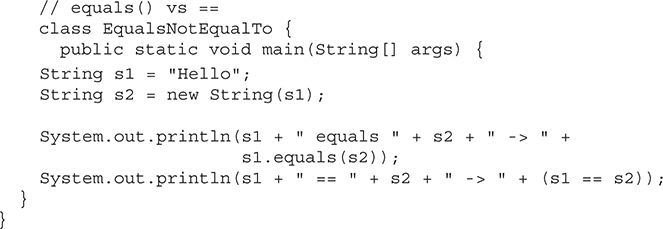
The variable s1 refers to the String instance created by "Hello". The object referred to by s2 is created with s1 as an initializer. Thus, the contents of the two String objects are identical, but they are distinct objects. This means that s1 and s2 do not refer to the same objects and are, therefore, not ==, as is shown here by the output of the preceding example:
Hello equals Hello -> true
Hello == Hello -> false
Often, it is not enough to simply know whether two strings are identical. For sorting applications, you need to know which is less than, equal to, or greater than the next. A string is less than another if it comes before the other in dictionary order. A string is greater than another if it comes after the other in dictionary order. The method compareTo( ) serves this purpose. It is specified by the Comparable<T> interface, which String implements. It has this general form:
int compareTo(String str)
Here, str is the String being compared with the invoking String. The result of the comparison is returned and is interpreted as shown here:

Here is a sample program that sorts an array of strings. The program uses compareTo( ) to determine sort ordering for a bubble sort:
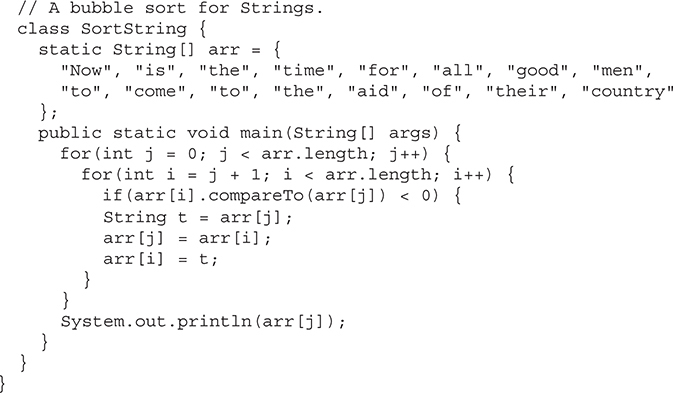
The output of this program is the list of words:
Now
aid
all
come
country
for
good
is
men
of
the
the
their
time
to
to
As you can see from the output of this example, compareTo( ) takes into account uppercase and lowercase letters. The word "Now" came out before all the others because it begins with an uppercase letter, which means it has a lower value in the ASCII character set.
If you want to ignore case differences when comparing two strings, use compareToIgnoreCase( ), as shown here:
int compareToIgnoreCase(String str)
This method returns the same results as compareTo( ), except that case differences are ignored. You might want to try substituting it into the previous program. After doing so, "Now" will no longer be first.
The String class provides two methods that allow you to search a string for a specified character or substring:
• indexOf( ) Searches for the first occurrence of a character or substring.
• lastIndexOf( ) Searches for the last occurrence of a character or substring.
These two methods are overloaded in several different ways. In all cases, the methods return the index at which the character or substring was found, or –1 on failure.
To search for the first occurrence of a character, use
int indexOf(int ch)
To search for the last occurrence of a character, use
int lastIndexOf(int ch)
Here, ch is the character being sought.
To search for the first or last occurrence of a substring, use
int indexOf(String str)
int lastIndexOf(String str)
Here, str specifies the substring.
You can specify a starting point for the search using these forms:
int indexOf(int ch, int startIndex)
int lastIndexOf(int ch, int startIndex)
int indexOf(String str, int startIndex)
int lastIndexOf(String str, int startIndex)
Here, startIndex specifies the index at which point the search begins. For indexOf( ), the search runs from startIndex to the end of the string. For lastIndexOf( ), the search runs from startIndex to zero.
The following example shows how to use the various index methods to search inside of a String:
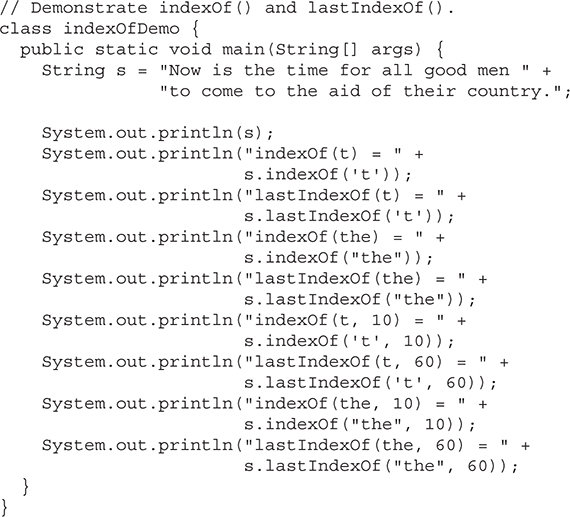
Here is the output of this program:
Now is the time for all good men to come to the aid of their country.
indexOf(t) = 7
lastIndexOf(t) = 65
indexOf(the) = 7
lastIndexOf(the) = 55
indexOf(t, 10) = 11
lastIndexOf(t, 60) = 55
indexOf(the, 10) = 44
lastIndexOf(the, 60) = 55
Because String objects are immutable, whenever you want to modify a String, you must either copy it into a StringBuffer or StringBuilder, or use a String method that constructs a new copy of the string with your modifications complete. A sampling of these methods are described here.
You can extract a substring using substring( ). It has two forms. The first is
String substring(int startIndex)
Here, startIndex specifies the index at which the substring will begin. This form returns a copy of the substring that begins at startIndex and runs to the end of the invoking string.
The second form of substring( ) allows you to specify both the beginning and ending index of the substring:
String substring(int startIndex, int endIndex)
Here, startIndex specifies the beginning index, and endIndex specifies the stopping point. The string returned contains all the characters from the beginning index, up to, but not including, the ending index.
The following program uses substring( ) to replace all instances of one substring with another within a string:
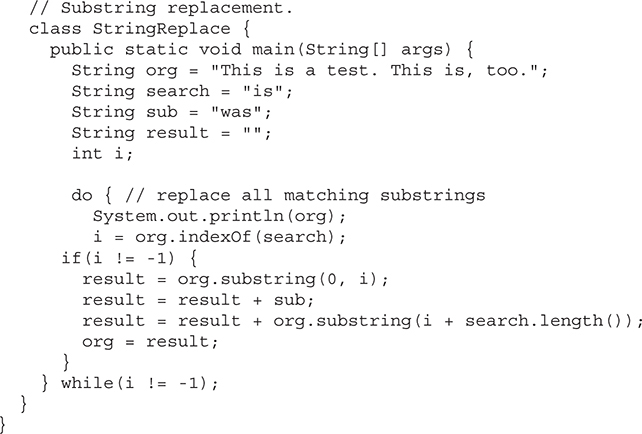
The output from this program is shown here:
This is a test. This is, too.
Thwas is a test. This is, too.
Thwas was a test. This is, too.
Thwas was a test. Thwas is, too.
Thwas was a test. Thwas was, too.
You can concatenate two strings using concat( ), shown here:
String concat(String str)
This method creates a new object that contains the invoking string with the contents of str appended to the end. concat( ) performs the same function as +. For example,
String s1 = "one";
String s2 = s1.concat("two");
puts the string "onetwo" into s2. It generates the same result as the following sequence:
String s1 = "one";
String s2 = s1 + "two";
The replace( ) method has two forms. The first replaces all occurrences of one character in the invoking string with another character. It has the following general form:
String replace(char original, char replacement)
Here, original specifies the character to be replaced by the character specified by replacement. The resulting string is returned. For example,
String s = "Hello".replace('l', 'w');
puts the string "Hewwo" into s.
The second form of replace( ) replaces one character sequence with another. It has this general form:
String replace(CharSequence original, CharSequence replacement)
The trim( ) method returns a copy of the invoking string from which any leading and trailing spaces have been removed. As it relates to this method, spaces consist of those characters with a value of 32 or less. The trim( ) method has this general form:
String trim( )
Here is an example:
String s = " Hello World ".trim();
This puts the string "Hello World" into s.
The trim( ) method is quite useful when you process user commands. For example, the following program prompts the user for the name of a state and then displays that state’s capital. It uses trim( ) to remove any leading or trailing spaces that may have inadvertently been entered by the user.
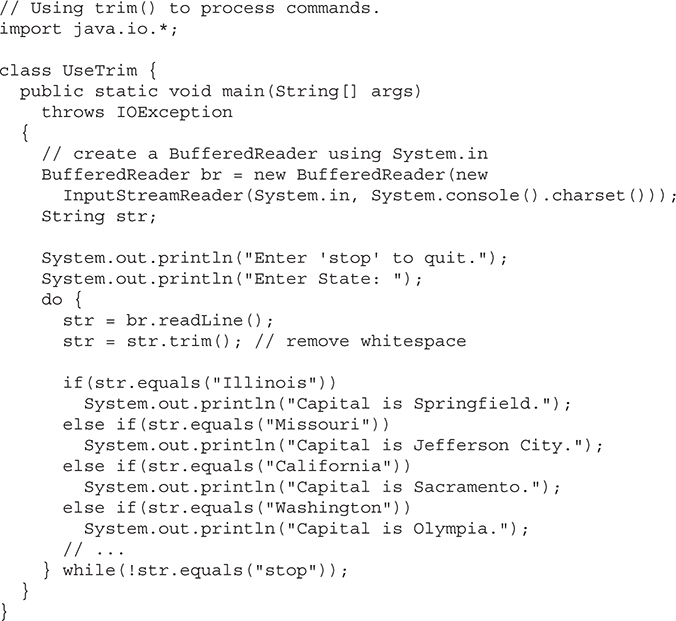
Beginning with JDK 11, Java also provides the methods strip( ), stripLeading( ), and stripTrailing( ). The strip( ) method removes all whitespace characters (as defined by Java) from the beginning and end of the invoking string and returns the result. Such whitespace characters include, among others, spaces, tabs, carriage returns, and line feeds.
The methods stripLeading( ) and stripTrailing( ) delete whitespace characters from the start or end, respectively, of the invoking string and return the result. JDK 15 added the methods stripIndent( ), which removes extraneous whitespace while retaining menaningful indentation, and translateEscapes( ), which replaces escape sequences with their character equivalents.
The valueOf( ) method converts data from its internal format into a human-readable form. It is a static method that is overloaded within String for all of Java’s built-in types so that each type can be converted properly into a string. valueOf( ) is also overloaded for type Object, so an object of any class type you create can also be used as an argument. (Recall that Object is a superclass for all classes.) Here are a few of its forms:
static String valueOf(double num)
static String valueOf(long num)
static String valueOf(Object ob)
static String valueOf(char[ ] chars)
As discussed earlier, valueOf( ) can be called when a string representation of some other type of data is needed. You can call this method directly with any data type and get a reasonable String representation. All of the simple types are converted to their common String representation. Any object that you pass to valueOf( ) will return the result of a call to the object’s toString( ) method. In fact, you could just call toString( ) directly and get the same result.
For most arrays, valueOf( ) returns a rather cryptic string, which indicates that it is an array of some type. For arrays of char, however, a String object is created that contains the characters in the char array. There is a special version of valueOf( ) that allows you to specify a subset of a char array. It has this general form:
static String valueOf(char[ ] chars, int startIndex, int numChars)
Here, chars is the array that holds the characters, startIndex is the index into the array of characters at which the desired substring begins, and numChars specifies the length of the substring.
The method toLowerCase( ) converts all the characters in a string from uppercase to lowercase. The toUpperCase( ) method converts all the characters in a string from lowercase to uppercase. Nonalphabetical characters, such as digits, are unaffected. Here are the simplest forms of these methods:
String toLowerCase( )
String toUpperCase( )
Both methods return a String object that contains the uppercase or lowercase equivalent of the invoking String. The default locale governs the conversion in both cases.
Here is an example that uses toLowerCase( ) and toUpperCase( ):
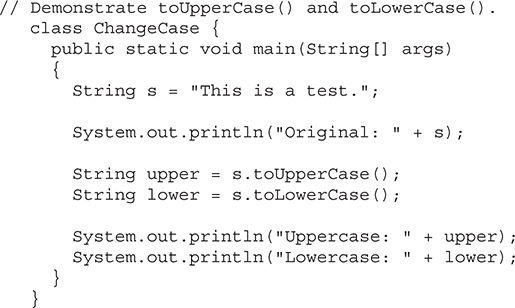
The output produced by the program is shown here:
Original: This is a test.
Uppercase: THIS IS A TEST.
Lowercase: this is a test.
One other point: Overloaded versions of toLowerCase( ) and toUpperCase( ) that let you specify a Locale object to govern the conversion are also supplied. Specifying the locale can be quite important in some cases and can help internationalize your application.
The join( ) method is used to concatenate two or more strings, separating each string with a delimiter, such as a space or a comma. It has two forms. Its first is shown here:
static String join(CharSequence delim, CharSequence . . . strs)
Here, delim specifies the delimiter used to separate the character sequences specified by strs. Because String implements the CharSequence interface, strs can be a list of strings. (See Chapter 19 for information on CharSequence.) The following program demonstrates this version of join( ):
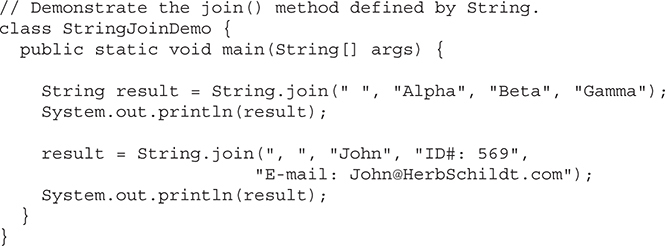
The output is shown here:
Alpha Beta Gamma
John, ID#: 569, E-mail: John@HerbSchildt.com
In the first call to join( ), a space is inserted between each string. In the second call, the delimiter is a comma followed by a space. This illustrates that the delimiter need not be just a single character.
The second form of join( ) lets you join a list of strings obtained from an object that implements the Iterable interface. Iterable is implemented by the Collections Framework classes described in Chapter 20, among others. See Chapter 19 for information on Iterable.
In addition to those methods discussed earlier, String has many other methods. Several are summarized in the following table:
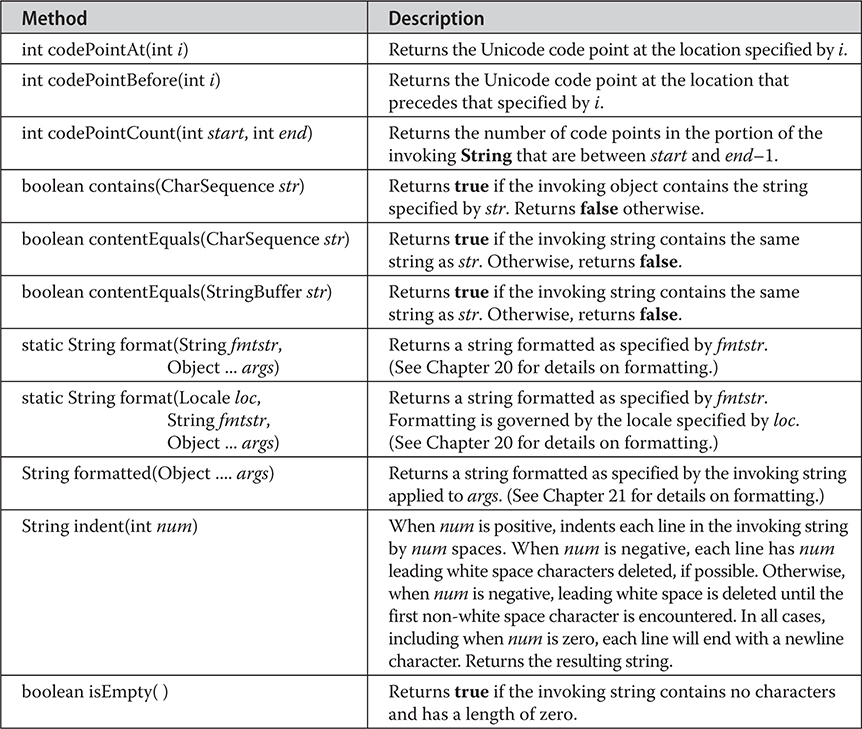
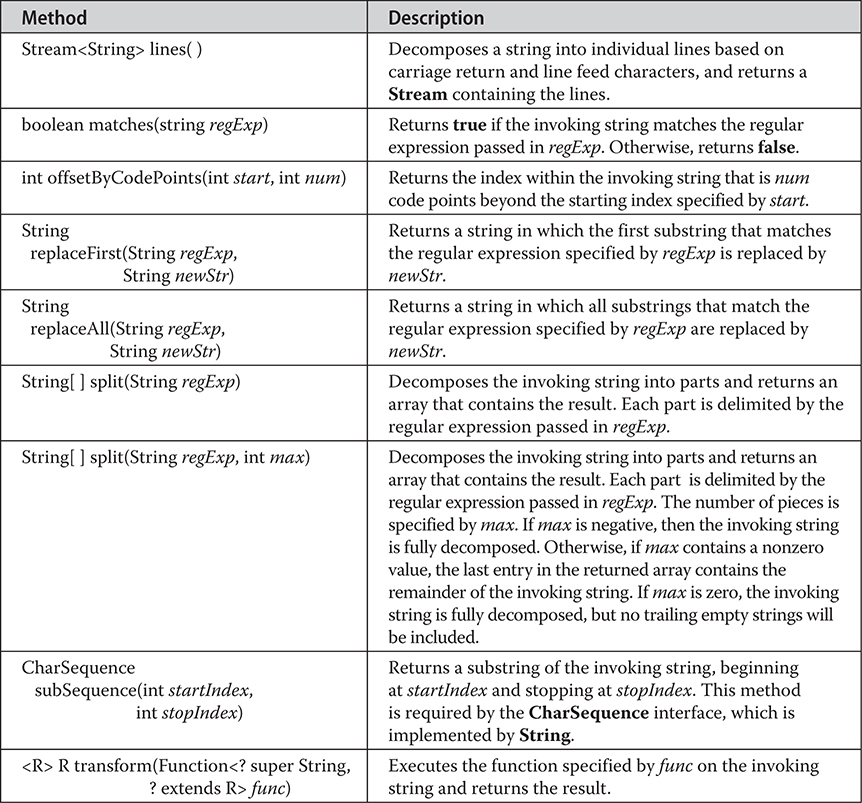
Notice that several of these methods work with regular expressions. Regular expressions are described in Chapter 31. One other point: Beginning with JDK 12, String implements the Constable and ConstantDesc interfaces.
StringBuffer supports a modifiable string. As you know, String represents fixed-length, immutable character sequences. In contrast, StringBuffer represents growable and writable character sequences. StringBuffer may have characters and substrings inserted in the middle or appended to the end. StringBuffer will automatically grow to make room for such additions and often has more characters preallocated than are actually needed, to allow room for growth.
StringBuffer defines these four constructors:
StringBuffer( )
StringBuffer(int size)
StringBuffer(String str)
StringBuffer(CharSequence chars)
The default constructor (the one with no parameters) reserves room for 16 characters without reallocation. The second version accepts an integer argument that explicitly sets the size of the buffer. The third version accepts a String argument that sets the initial contents of the StringBuffer object and reserves room for 16 more characters without reallocation. StringBuffer allocates room for 16 additional characters when no specific buffer length is requested, because reallocation is a costly process in terms of time. Also, frequent reallocations can fragment memory. By allocating room for a few extra characters, StringBuffer reduces the number of reallocations that take place. The fourth constructor creates an object that contains the character sequence contained in chars and reserves room for 16 more characters.
The current length of a StringBuffer can be found via the length( ) method, while the total allocated capacity can be found through the capacity( ) method. They have the following general forms:
int length( )
int capacity( )
Here is an example:
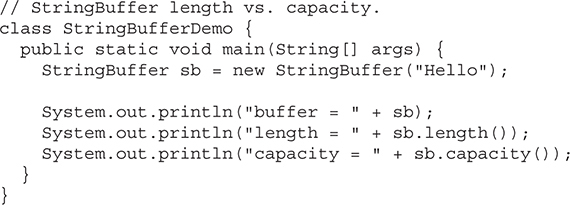
Here is the output of this program, which shows how StringBuffer reserves extra space for additional manipulations:
buffer = Hello
length = 5
capacity = 21
Since sb is initialized with the string "Hello" when it is created, its length is 5. Its capacity is 21 because room for 16 additional characters is automatically added.
If you want to preallocate room for a certain number of characters after a StringBuffer has been constructed, you can use ensureCapacity( ) to set the size of the buffer. This is useful if you know in advance that you will be appending a large number of small strings to a StringBuffer. ensureCapacity( ) has this general form:
void ensureCapacity(int minCapacity)
Here, minCapacity specifies the minimum size of the buffer. (A buffer larger than minCapacity may be allocated for reasons of efficiency.)
To set the length of the string within a StringBuffer object, use setLength( ). Its general form is shown here:
void setLength(int len)
Here, len specifies the length of the string. This value must be nonnegative.
When you increase the size of the string, null characters are added to the end. If you call setLength( ) with a value less than the current value returned by length( ), then the characters stored beyond the new length will be lost. The setCharAtDemo sample program in the following section uses setLength( ) to shorten a StringBuffer.
The value of a single character can be obtained from a StringBuffer via the charAt( ) method. You can set the value of a character within a StringBuffer using setCharAt( ). Their general forms are shown here:
char charAt(int where)
void setCharAt(int where, char ch)
For charAt( ), where specifies the index of the character being obtained. For setCharAt( ), where specifies the index of the character being set, and ch specifies the new value of that character. For both methods, where must be nonnegative and must not specify a location beyond the end of the string.
The following example demonstrates charAt( ) and setCharAt( ):
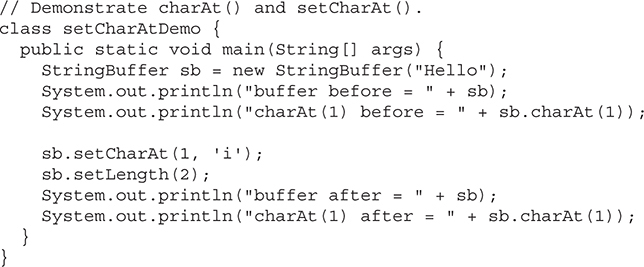
Here is the output generated by this program:
buffer before = Hello
charAt(1) before = e
buffer after = Hi
charAt(1) after = i
To copy a substring of a StringBuffer into an array, use the getChars( ) method. It has this general form:
void getChars(int sourceStart, int sourceEnd, char[ ] target, int targetStart)
Here, sourceStart specifies the index of the beginning of the substring, and sourceEnd specifies an index that is one past the end of the desired substring. This means that the substring contains the characters from sourceStart through sourceEnd–1. The array that will receive the characters is specified by target. The index within target at which the substring will be copied is passed in targetStart. Care must be taken to assure that the target array is large enough to hold the number of characters in the specified substring.
The append( ) method concatenates the string representation of any other type of data to the end of the invoking StringBuffer object. It has several overloaded versions. Here are a few of its forms:
StringBuffer append(String str)
StringBuffer append(int num)
StringBuffer append(Object obj)
First, the string representation of each parameter is obtained. Then, the result is appended to the current StringBuffer object. The buffer itself is returned by each version of append( ). This allows subsequent calls to be chained together, as shown in the following example:
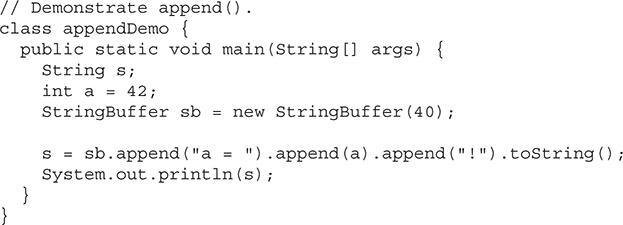
The output of this example is shown here:
a = 42!
The insert( ) method inserts one string into another. It is overloaded to accept values of all the primitive types, plus Strings, Objects, and CharSequences. Like append( ), it obtains the string representation of the value it is called with. This string is then inserted into the invoking StringBuffer object. These are a few of its forms:
StringBuffer insert(int index, String str)
StringBuffer insert(int index, char ch)
StringBuffer insert(int index, Object obj)
Here, index specifies the index at which point the string will be inserted into the invoking StringBuffer object.
The following sample program inserts "like" between "I" and "Java":
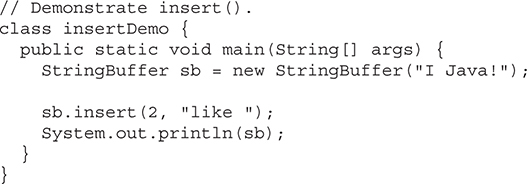
The output of this example is shown here:
I like Java!
You can reverse the characters within a StringBuffer object using reverse( ), shown here:
StringBuffer reverse( )
This method returns the reverse of the object on which it was called. The following program demonstrates reverse( ):
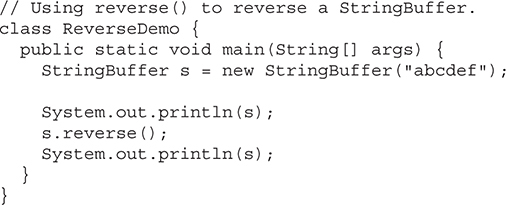
Here is the output produced by the program:
abcdef
fedcba
You can delete characters within a StringBuffer by using the methods delete( ) and deleteCharAt( ). These methods are shown here:
StringBuffer delete(int startIndex, int endIndex)
StringBuffer deleteCharAt(int loc)
The delete( ) method deletes a sequence of characters from the invoking object. Here, startIndex specifies the index of the first character to remove, and endIndex specifies an index one past the last character to remove. Thus, the substring deleted runs from startIndex to endIndex–1. The resulting StringBuffer object is returned.
The deleteCharAt( ) method deletes the character at the index specified by loc. It returns the resulting StringBuffer object.
Here is a program that demonstrates the delete( ) and deleteCharAt( ) methods:
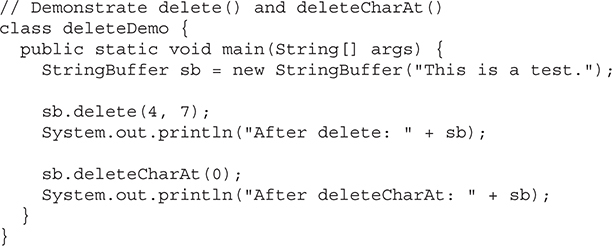
The following output is produced:
After delete: This a test.
After deleteCharAt: his a test.
You can replace one set of characters with another set inside a StringBuffer object by calling replace( ). Its signature is shown here:
StringBuffer replace(int startIndex, int endIndex, String str)
The substring being replaced is specified by the indexes startIndex and endIndex. Thus, the substring at startIndex through endIndex–1 is replaced. The replacement string is passed in str. The resulting StringBuffer object is returned.
The following program demonstrates replace( ):

Here is the output:
After replace: This was a test.
You can obtain a portion of a StringBuffer by calling substring( ). It has the following two forms:
String substring(int startIndex)
String substring(int startIndex, int endIndex)
The first form returns the substring that starts at startIndex and runs to the end of the invoking StringBuffer object. The second form returns the substring that starts at startIndex and runs through endIndex–1. These methods work just like those defined for String that were described earlier.
In addition to those methods just described, StringBuffer supplies others. Several are summarized in the following table:
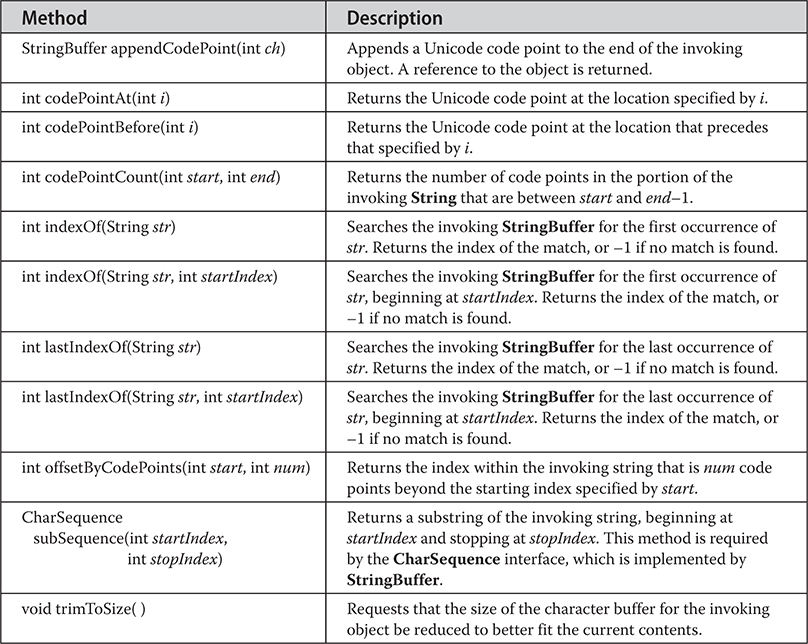
The following program demonstrates indexOf( ) and lastIndexOf( ):
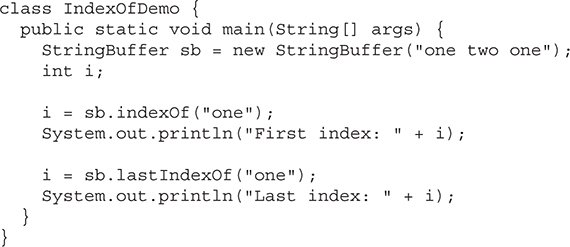
The output is shown here:
First index: 0
Last index: 8
StringBuilder is similar to StringBuffer except for one important difference: it is not synchronized, which means that it is not thread-safe. The advantage of StringBuilder is faster performance. However, in cases in which a mutable string will be accessed by multiple threads, and no external synchronization is employed, you must use StringBuffer rather than StringBuilder.
This chapter discusses classes and interfaces defined by java.lang. As you know, java.lang is automatically imported into all programs. It contains classes and interfaces that are fundamental to virtually all of Java programming. It is Java’s most widely used package. Beginning with JDK 9, all of java.lang is part of the java.base module.
java.lang includes the following classes:
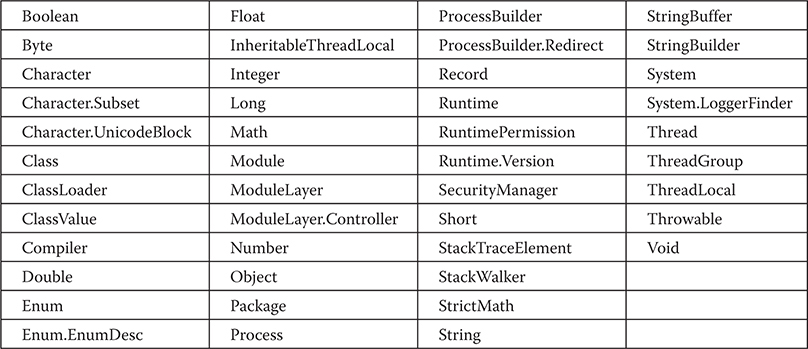
java.lang defines the following interfaces:

Several of the classes contained in java.lang contain deprecated methods, many dating back to Java 1.0. Deprecated methods are still provided by Java to support legacy code but are not recommended for new code. Because of this, in most cases the deprecated methods are not discussed here.
As mentioned in Part I of this book, Java uses primitive types, such as int and char, for performance reasons. These data types are not part of the object hierarchy. They are passed by value to methods and cannot be directly passed by reference. Also, there is no way for two methods to refer to the same instance of an int. At times, you will need to create an object representation for one of these primitive types. For example, there are collection classes discussed in Chapter 20 that deal only with objects; to store a primitive type in one of these classes, you need to wrap the primitive type in a class. To address this need, Java provides classes that correspond to each of the primitive types. In essence, these classes encapsulate, or wrap, the primitive types within a class. Thus, they are commonly referred to as type wrappers. The type wrappers were introduced in Chapter 12. They are examined in detail here.
Before we begin, an important point needs to be mentioned. Beginning with JDK 16, the primitive type wrapper classes are now documented as value-based. As such, various rules and restrictions apply. For example, you should avoid using instances of a value-based class for synchronization. See Chapter 13 for additional information on value-based classes.
The abstract class Number defines a superclass that is implemented by the classes that wrap the numeric types byte, short, int, long, float, and double. Number has abstract methods that return the value of the object in each of the different number formats. For example, doubleValue( ) returns the value as a double, floatValue( ) returns the value as a float, and so on. These methods are shown here:
byte byteValue( )
double doubleValue( )
float floatValue( )
int intValue( )
long longValue( )
short shortValue( )
The values returned by these methods might be rounded, truncated, or result in a “garbage” value due to the effects of a narrowing conversion.
Number has concrete subclasses that hold explicit values of each primitive numeric type: Double, Float, Byte, Short, Integer, and Long.
Double and Float are wrappers for floating-point values of type double and float, respectively. The constructors for Float are shown here:
Float(double num)
Float(float num)
Float(String str) throws NumberFormatException
Float objects can be constructed with values of type float or double. They can also be constructed from the string representation of a floating-point number. Beginning with JDK 9, these constructors have been deprecated, and beginning with JDK 16, they have been deprecated for removal. The valueOf( ) method is the strongly recommended alternative.
The constructors for Double are shown here:
Double(double num)
Double(String str) throws NumberFormatException
Double objects can be constructed with a double value or a string containing a floating-point value. Beginning with JDK 9, these constructors have been deprecated, and beginning with JDK 16, they have been deprecated for removal. The valueOf( ) method is the strongly recommended alternative.
The commonly used methods defined by Float include those shown in Table 19-1. The commonly used methods defined by Double include those shown in Table 19-2. Beginning with JDK 12, Float and Double also implement the Constable and ConstantDesc interfaces. Both Float and Double define the following constants:
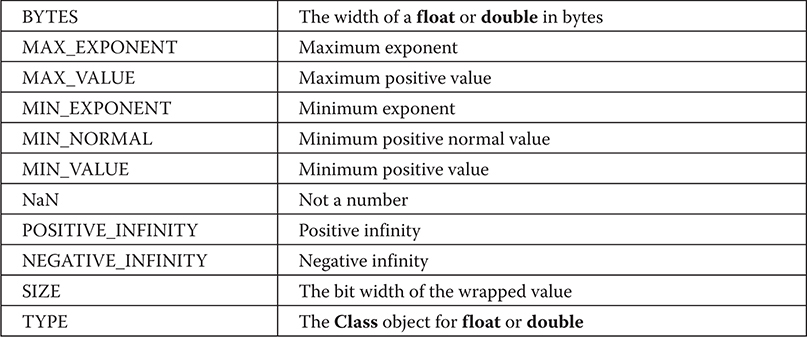
The following example creates two Double objects—one by using a double value and the other by passing a string that can be parsed as a double:

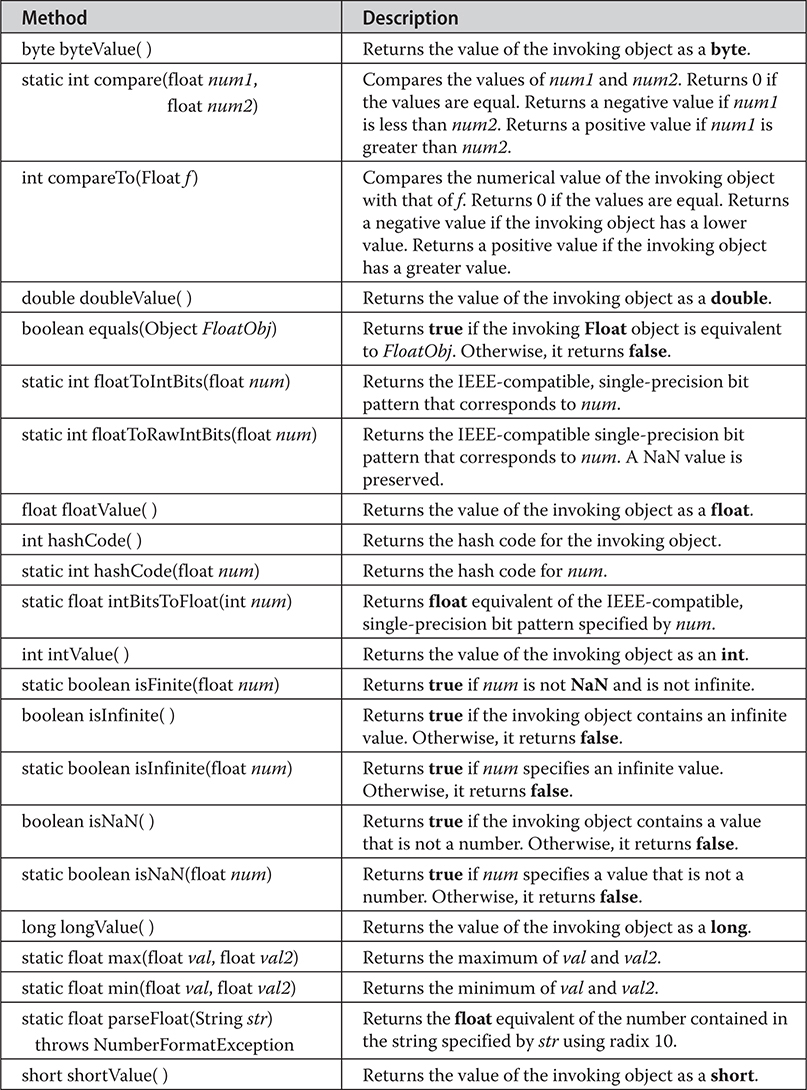
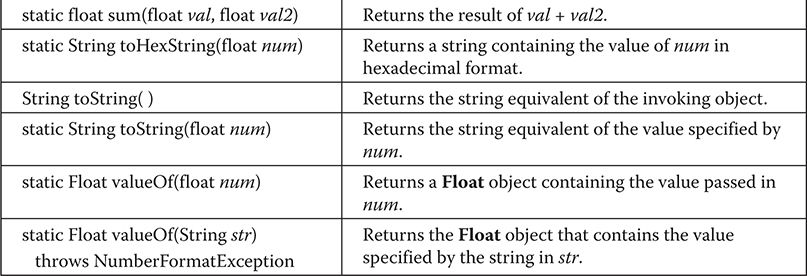
Table 19-1 Commonly Used Methods Defined by Float
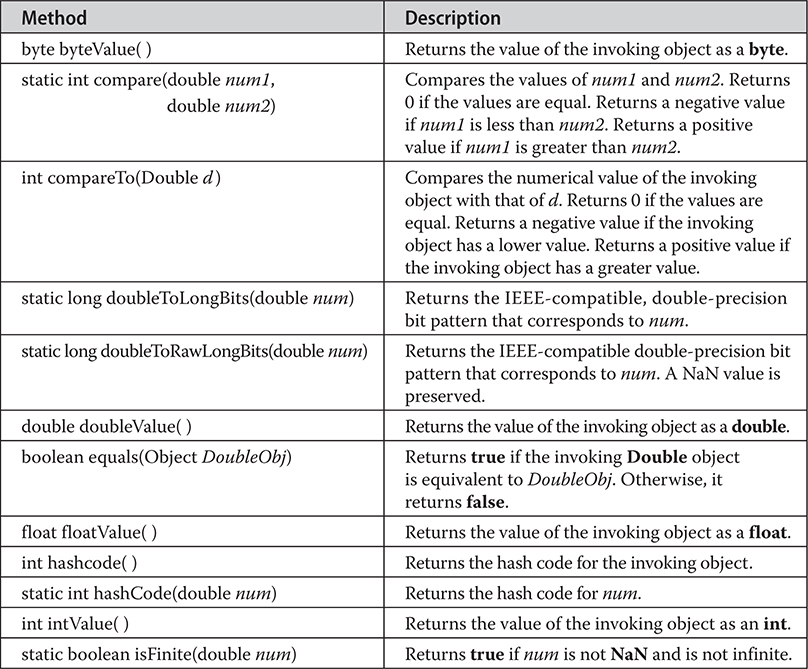
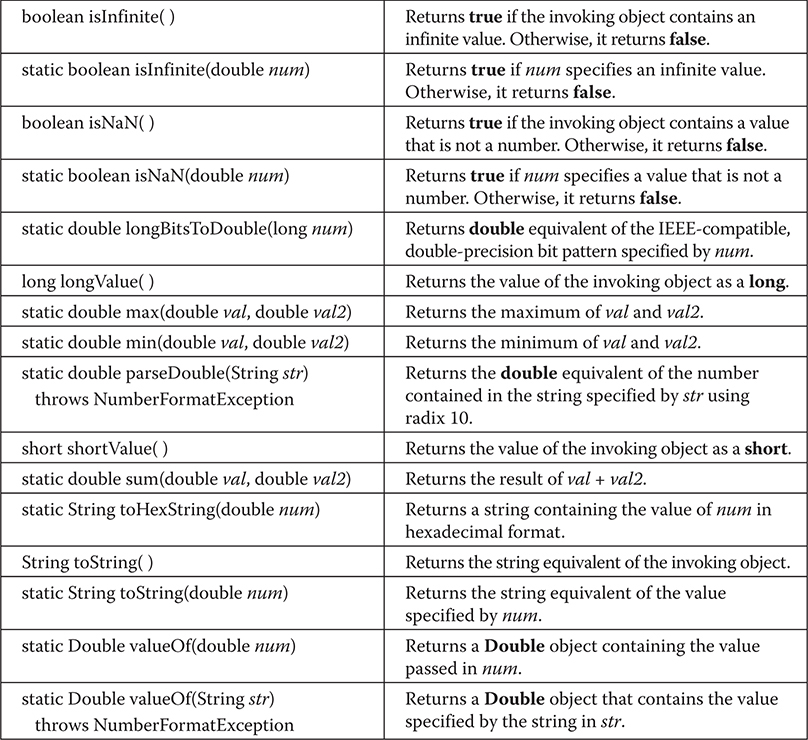
Table 19-2 Commonly Used Methods Defined by Double
As you can see from the following output, both versions of valueOf( ) created identical Double instances, as shown by the equals( ) method returning true:
3.14159 = 3.14159 –> true
Float and Double provide the methods isInfinite( ) and isNaN( ), which help when manipulating two special double and float values. These methods test for two unique values: infinity and NaN (not a number). isInfinite( ) returns true if the value being tested is infinitely large or small in magnitude. isNaN( ) returns true if the value being tested is not a number.
The following example creates two Double objects; one is infinite, and the other is not a number:

This program generates the following output:
Infinity: true, false
NaN: false, true
The Byte, Short, Integer, and Long classes are wrappers for byte, short, int, and long integer types, respectively. Their constructors are shown here:
Byte(byte num)
Byte(String str) throws NumberFormatException
Short(short num)
Short(String str) throws NumberFormatException
Integer(int num)
Integer(String str) throws NumberFormatException
Long(long num)
Long(String str) throws NumberFormatException
As you can see, these objects can be constructed from numeric values or from strings that contain valid whole number values. Beginning with JDK 9, these constructors have been deprecated, and beginning with JDK 16, they have been deprecated for removal. The valueOf( ) method is the strongly recommended alternative.
The commonly used methods defined by these classes are shown in Tables 19-3 through 19-6. As you can see, they define methods for parsing integers from strings and converting strings back into integers. Variants of these methods allow you to specify the radix, or numeric base, for conversion. Common radixes are 2 for binary, 8 for octal, 10 for decimal, and 16 for hexadecimal. Beginning with JDK 12, Integer and Long also implement the Constable and ConstantDesc interfaces. Beginning with JDK 15, Byte and Short also implement Constable.
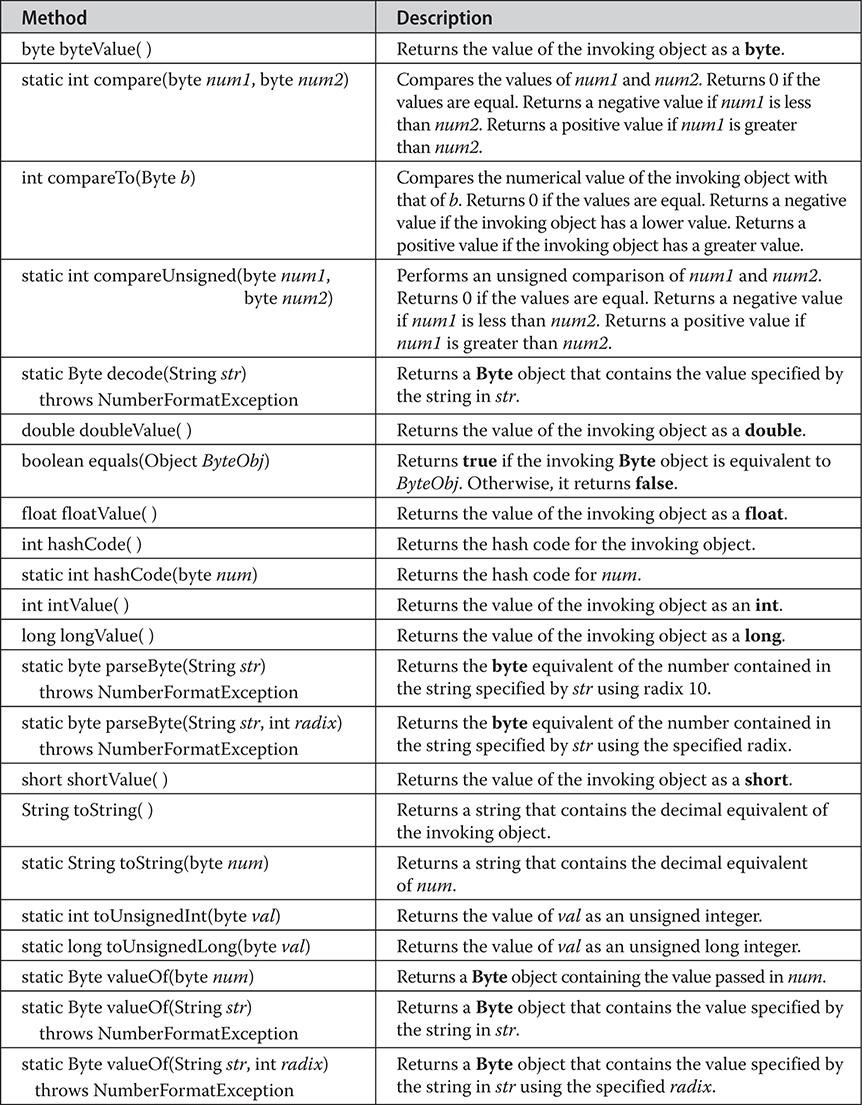
Table 19-3 Commonly Used Methods Defined by Byte
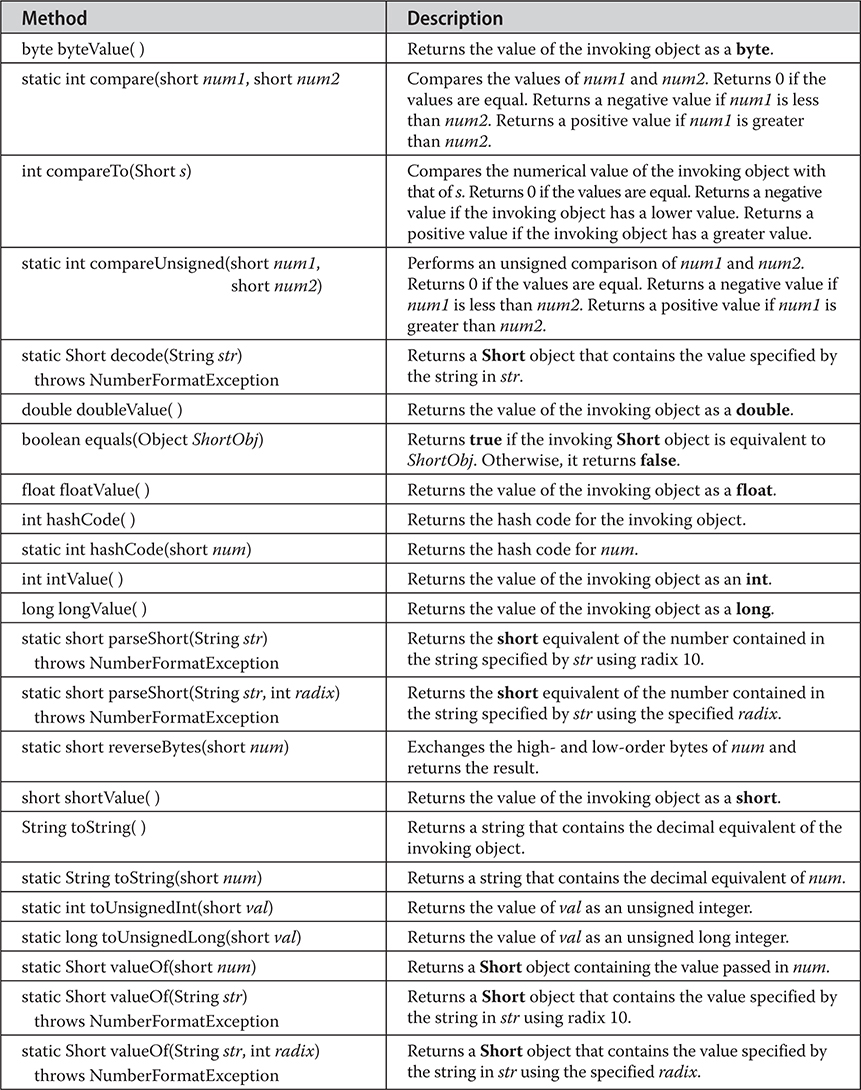
Table 19-4 Commonly Used Methods Defined by Short
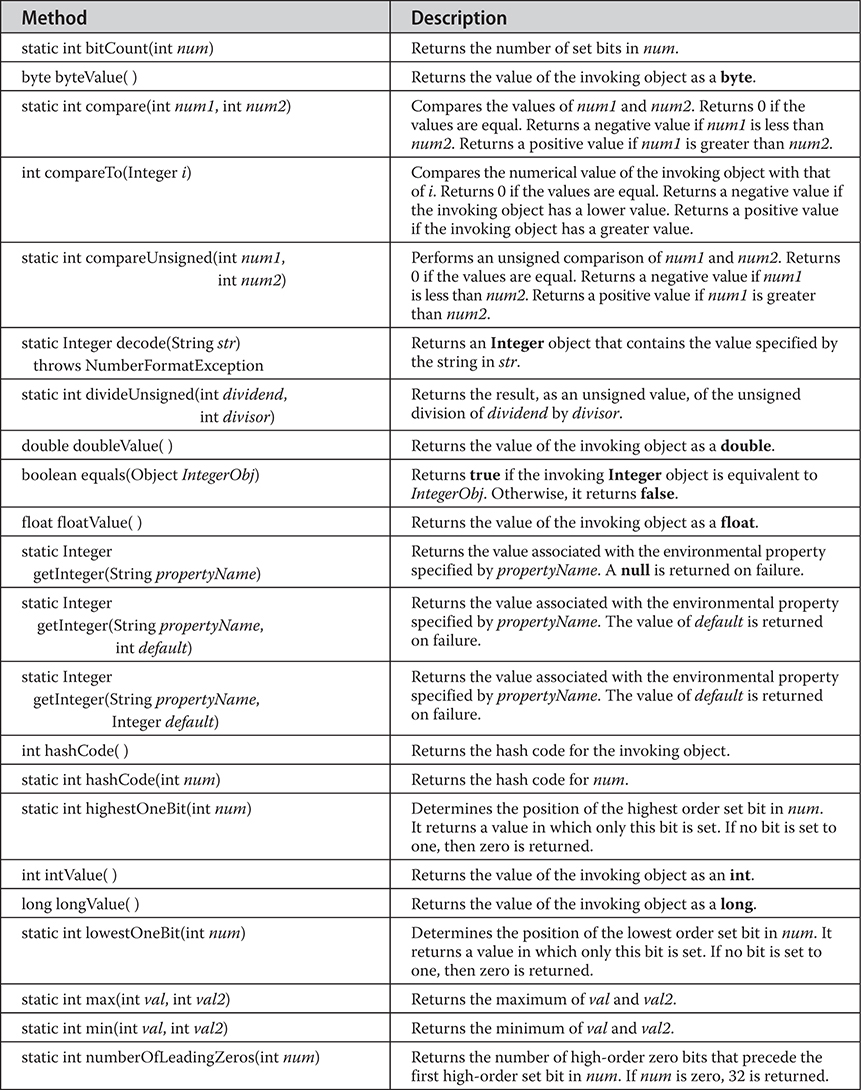
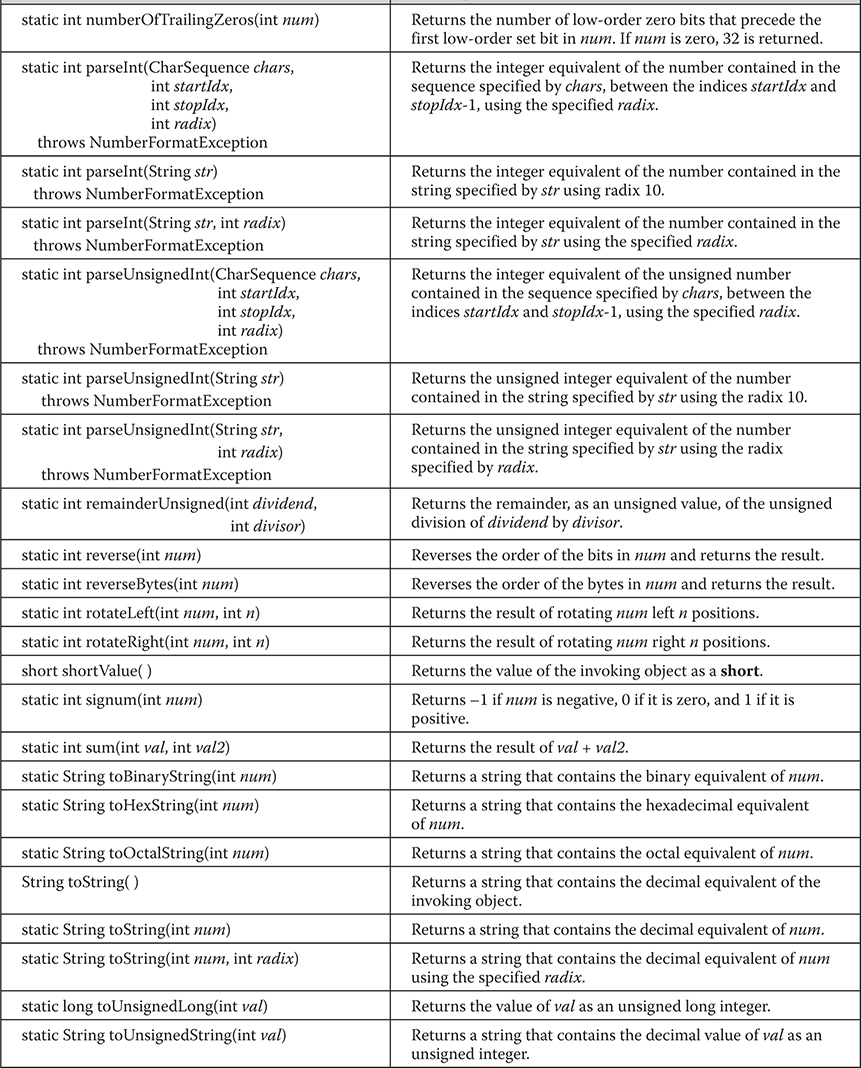

Table 19-5 Commonly Used Methods Defined by Integer
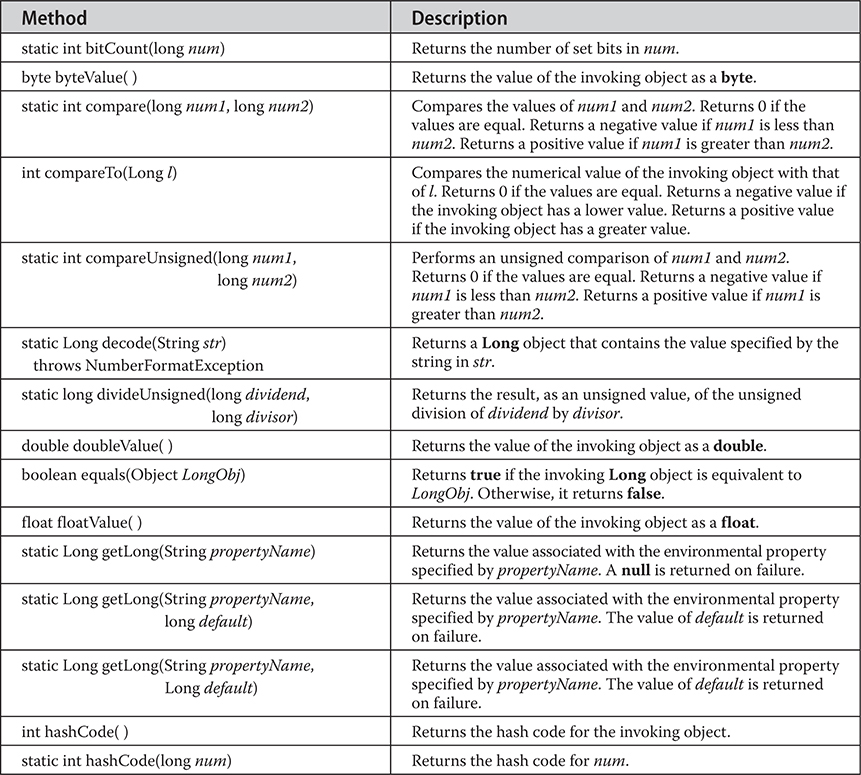
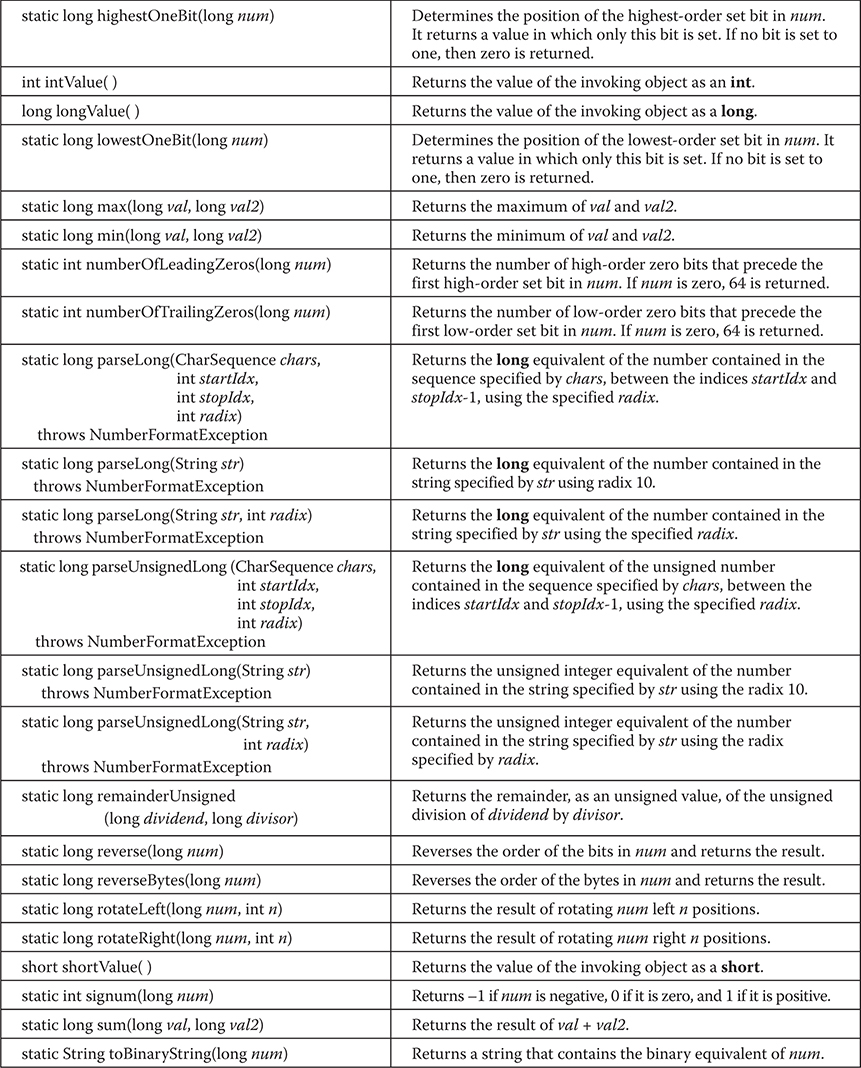
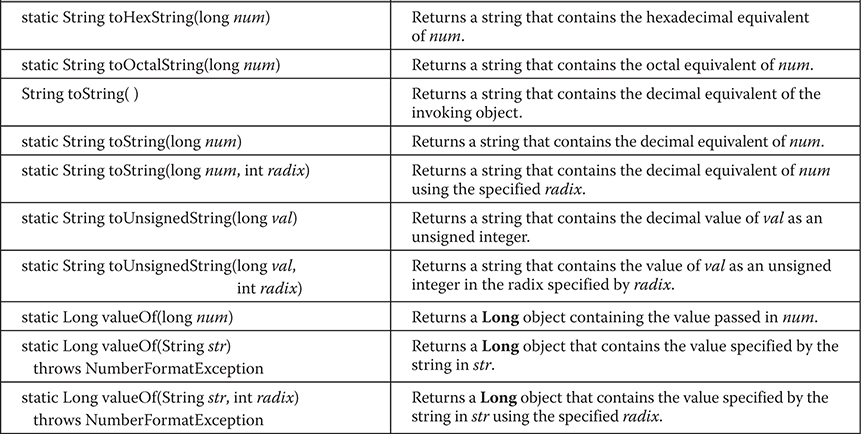
Table 19-6 Commonly Used Methods Defined by Long
The following constants are defined:

One of the most common programming chores is converting the string representation of a number into its internal, binary format. Fortunately, Java provides an easy way to accomplish this. The Byte, Short, Integer, and Long classes provide the parseByte( ), parseShort( ), parseInt( ), and parseLong( ) methods, respectively. These methods return the byte, short, int, or long equivalent of the numeric string with which they are called. (Similar methods also exist for the Float and Double classes.)
The following program demonstrates parseInt( ). It sums a list of integers entered by the user. It reads the integers using readLine( ) and uses parseInt( ) to convert these strings into their int equivalents.
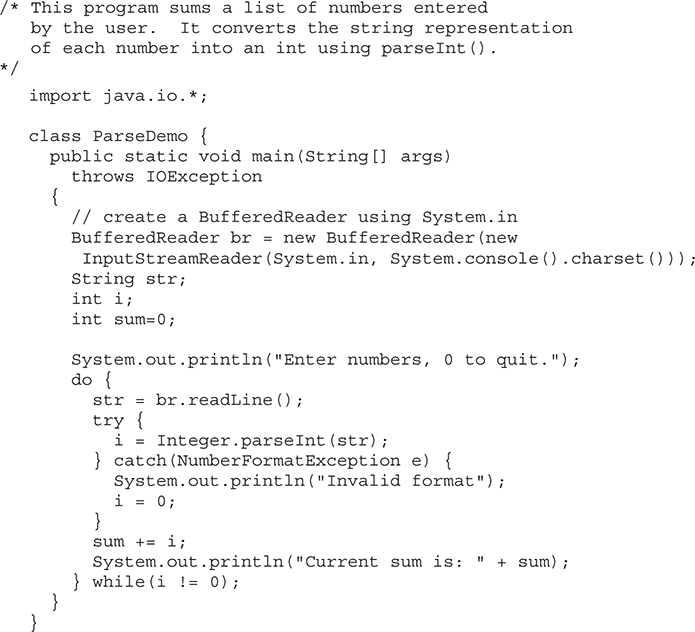
To convert a whole number into a decimal string, use the versions of toString( ) defined in the Byte, Short, Integer, or Long classes. The Integer and Long classes also provide the methods toBinaryString( ), toHexString( ), and toOctalString( ), which convert a value into a binary, hexadecimal, or octal string, respectively.
The following program demonstrates binary, hexadecimal, and octal conversion:
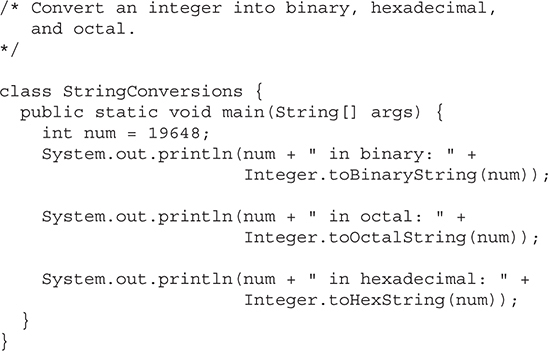
The output of this program is shown here:
19648 in binary: 100110011000000
19648 in octal: 46300
19648 in hexadecimal: 4cc0
Character is a simple wrapper around a char. The constructor for Character is
Character(char ch)
Here, ch specifies the character that will be wrapped by the Character object being created. Beginning with JDK 9, this constructor has been deprecated, and beginning with JDK 16, it has been deprecated for removal. The valueOf( ) method is the strongly recommended alternative.
To obtain the char value contained in a Character object, call charValue( ), shown here:
char charValue( )
It returns the character.
The Character class defines several constants, including the following:

Character includes several static methods that categorize characters and alter their case. A sampling is shown in Table 19-7. The following example demonstrates several of these methods:
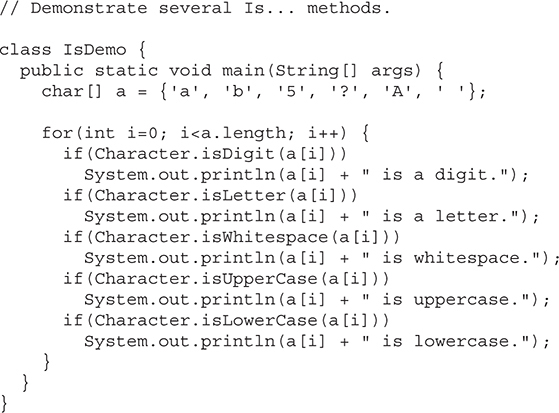
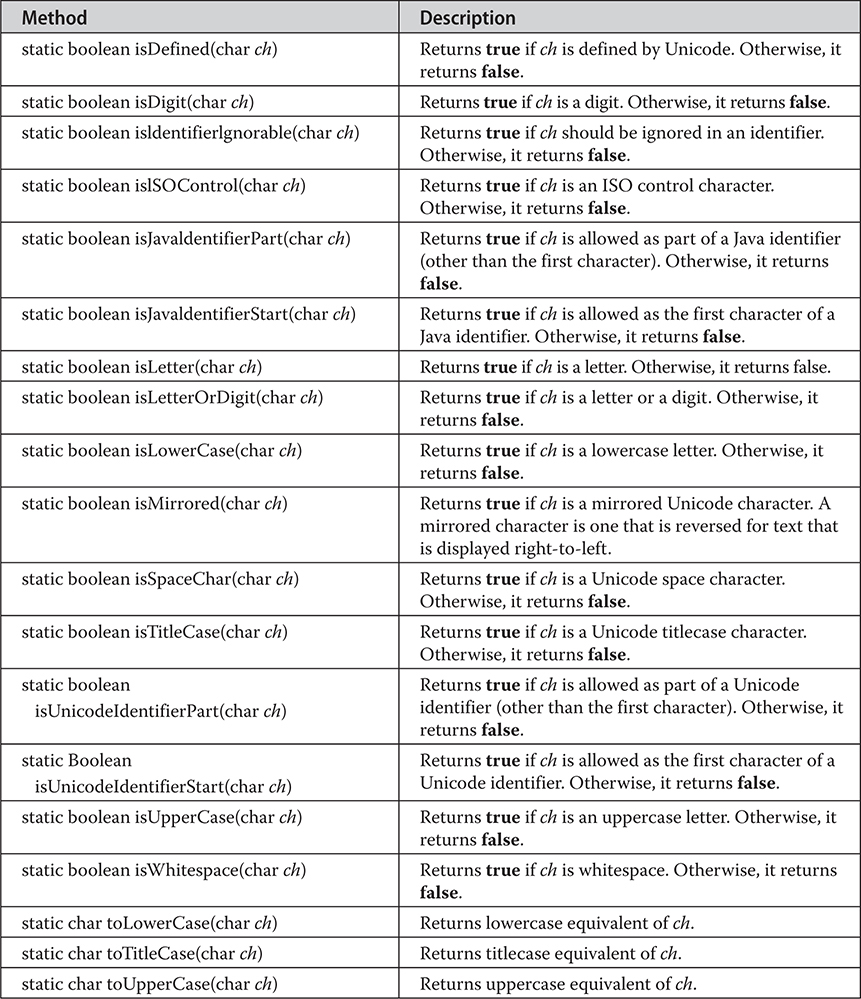
Table 19-7 Various Character Methods
The output from this program is shown here:
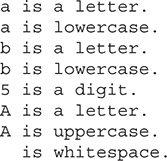
Character defines two methods, forDigit( ) and digit( ), that enable you to convert between integer values and the digits they represent. They are shown here:
static char forDigit(int num, int radix)
static int digit(char digit, int radix)
forDigit( ) returns the digit character associated with the value of num. The radix of the conversion is specified by radix. digit( ) returns the integer value associated with the specified character (which is presumably a digit) according to the specified radix. (There is a second form of digit( ) that takes a code point. See the following section for a discussion of code points.)
Another method defined by Character is compareTo( ), which has the following form:
int compareTo(Character c)
It returns zero if the invoking object and c have the same value. It returns a negative value if the invoking object has a lower value. Otherwise, it returns a positive value.
Character includes a method called getDirectionality( ) which can be used to determine the direction of a character. Several constants are defined that describe directionality. Most programs will not need to use character directionality.
Character also overrides equals( ) and hashCode( ), and provides a number of other methods. Beginning with JDK 15, Character also implements the Constable interface.
Two other character-related classes are Character.Subset, used to describe a subset of Unicode, and Character.UnicodeBlock, which contains Unicode character blocks.
A number of years ago, major additions were made to Character that support 32-bit Unicode characters. In the early days of Java, all Unicode characters could be held by 16 bits, which is the size of a char (and the size of the value encapsulated within a Character), because those values ranged from 0 to FFFF. However, the Unicode character set has been expanded, and more than 16 bits are required. Characters can now range from 0 to 10FFFF.
Here are three important terms. A code point is a character in the range 0 to 10FFFF. Characters that have values greater than FFFF are called supplemental characters. The basic multilingual plane (BMP) are those characters between 0 and FFFF.
The expansion of the Unicode character set caused a fundamental problem for Java. Because a supplemental character has a value greater than a char can hold, some means of handling the supplemental characters was needed. Java addressed this problem in two ways. First, Java uses two chars to represent a supplemental character. The first char is called the high surrogate, and the second is called the low surrogate. Methods, such as codePointAt( ), were provided to translate between code points and supplemental characters.
Secondly, Java overloaded several preexisting methods in the Character class. The overloaded forms use int rather than char data. Because an int is large enough to hold any character as a single value, it can be used to store any character. For example, all of the methods in Table 19-7 have overloaded forms that operate on int. Here is a sampling:
static boolean isDigit(int cp)
static boolean isLetter(int cp)
static int toLowerCase(int cp)
In addition to the methods overloaded to accept code points, Character adds methods that provide additional support for code points. A sampling is shown in Table 19-8.
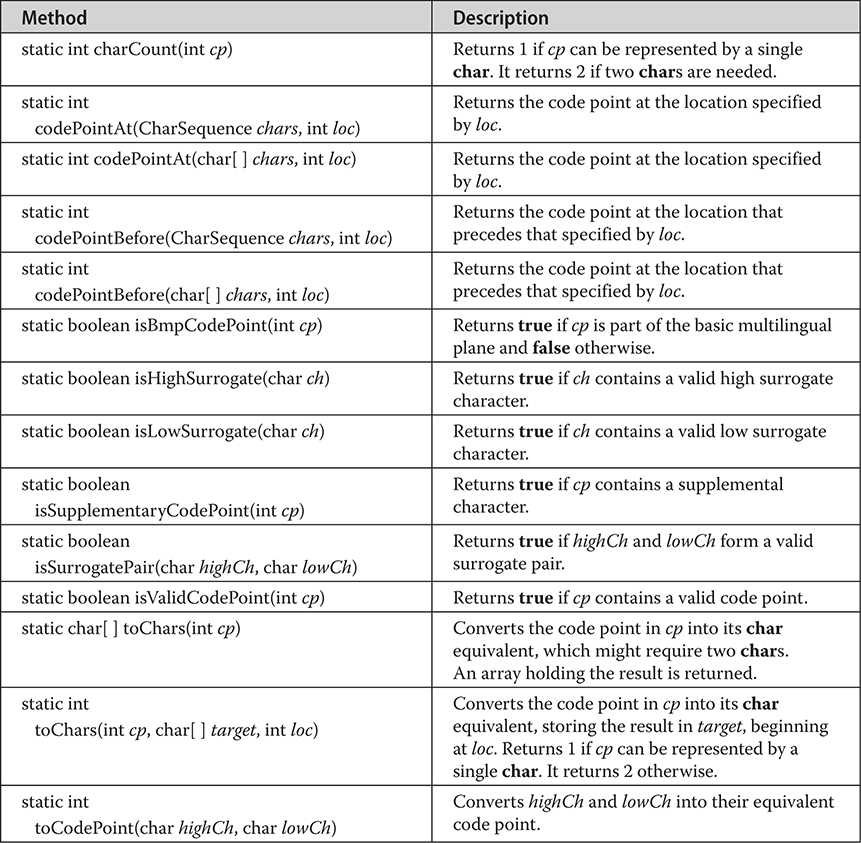
Table 19-8 A Sampling of Methods That Provide Support for 32-Bit Unicode Code Points
Boolean is a very thin wrapper around boolean values, which is useful mostly when you want to pass a boolean variable by reference. It contains the constants TRUE and FALSE, which define true and false Boolean objects. Boolean also defines the TYPE field, which is the Class object for boolean. Boolean defines these constructors:
Boolean(boolean boolValue)
Boolean(String boolString)
In the first version, boolValue must be either true or false. In the second version, if boolString contains the string "true" (in uppercase or lowercase), then the new Boolean object will be true. Otherwise, it will be false. Beginning with JDK 9, these constructors have been deprecated, and beginning with JDK 16, they have been deprecated for removal. The valueOf( ) method is the strongly recommended alternative.
Commonly used methods defined by Boolean are shown in Table 19-9. Beginning with JDK 15, Boolean also implements the Constable special purpose interface.
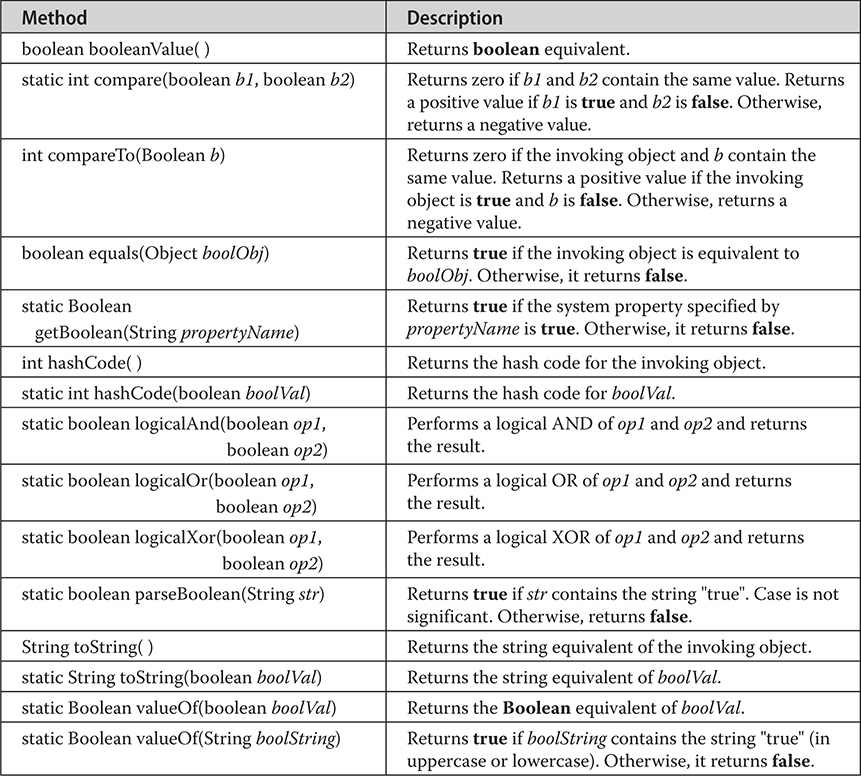
Table 19-9 Commonly Used Methods Defined by Boolean
The Void class has one field, TYPE, which holds a reference to the Class object for type void. You do not create instances of this class.
The abstract Process class encapsulates a process—that is, an executing program. It is used primarily as a superclass for the type of objects created by exec( ) in the Runtime class, or by start( ) in the ProcessBuilder class. A sampling of the Process methods are shown in Table 19-10. Beginning with JDK 9, you can obtain a handle to the process in the form of a ProcessHandle instance, and you can obtain information about the process encapsulated in a ProcessHandle.Info instance. These offer additional control and information about a process. One particularly interesting piece of information is the amount of CPU time that a process receives. This is obtained by calling totalCpuDuration( ) defined by ProcessHandle.Info. Another especially helpful piece of information is obtained by calling isAlive( ) on a ProcessHandle. It will return true if the process is still executing. Beginning with JDK 17, Process also provides the methods inputReader( ), errorReader( ), and outputWriter( ).
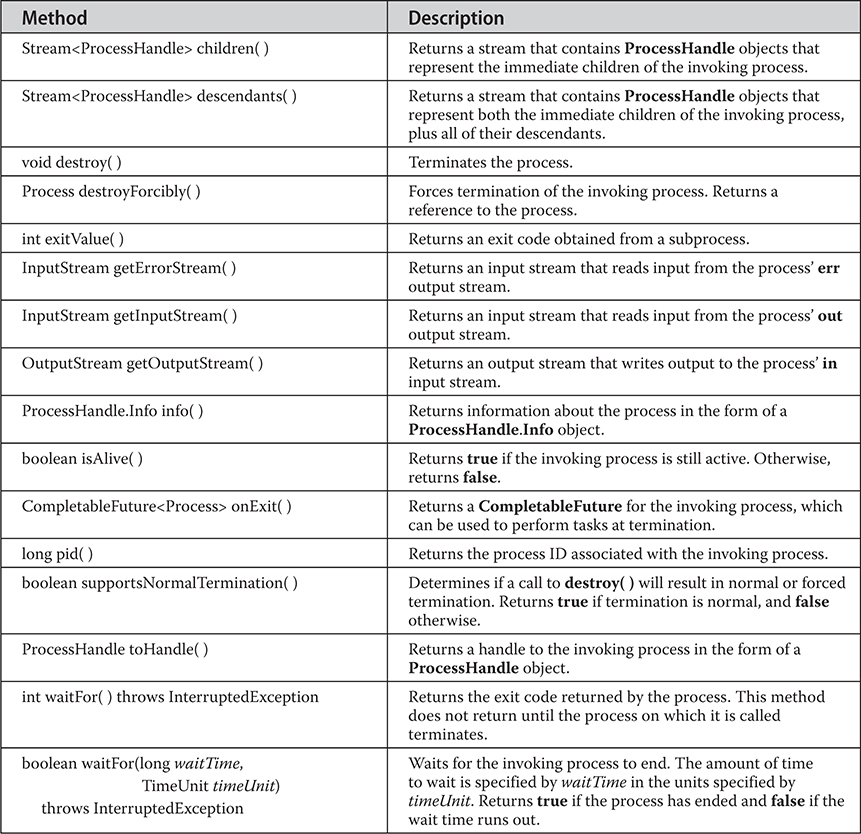
Table 19-10 A Sampling of the Methods Defined by Process
The Runtime class encapsulates the run-time environment. You cannot instantiate a Runtime object. However, you can get a reference to the current Runtime object by calling the static method Runtime.getRuntime( ). Once you obtain a reference to the current Runtime object, you can call several methods that control the state and behavior of the Java Virtual Machine. Untrusted code typically cannot call any of the Runtime methods without raising a SecurityException. A sampling of methods defined by Runtime are shown in Table 19-11.
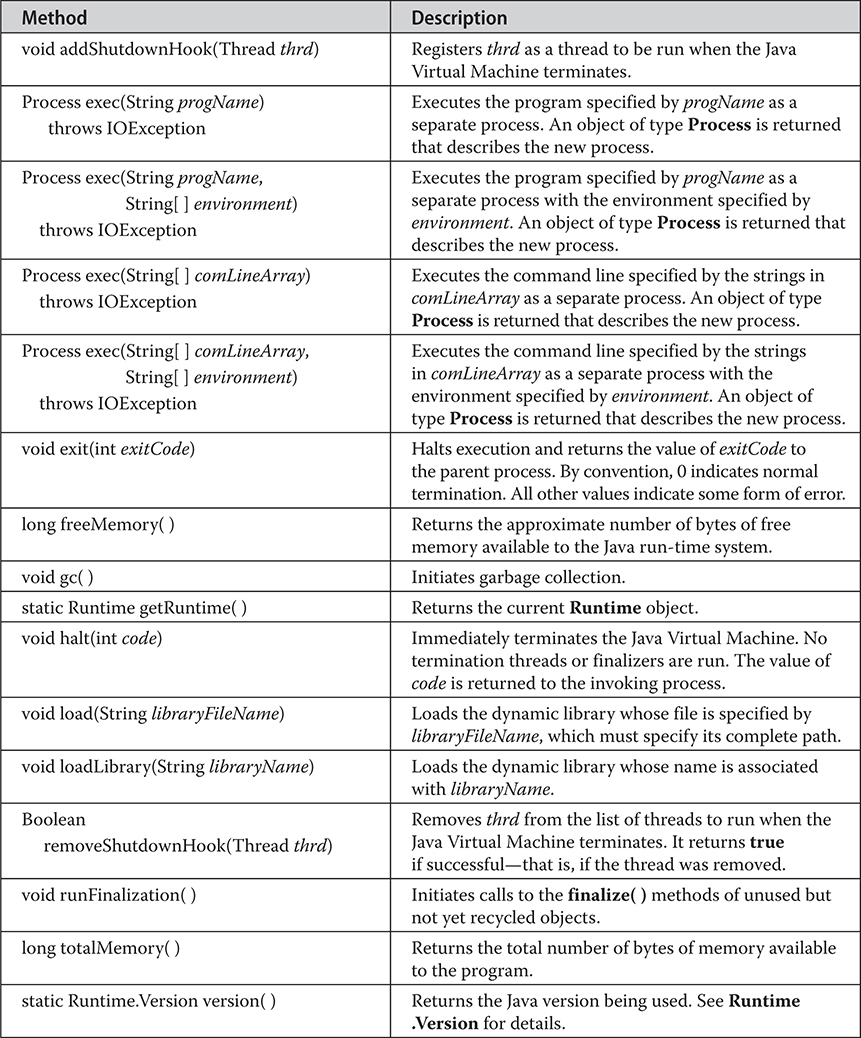
Table 19-11 A Sampling of Methods Defined by Runtime
Let’s look at one of the more interesting uses of the Runtime class: executing additional processes.
In safe environments, you can use Java to execute other heavyweight processes (that is, programs) on your multitasking operating system. Several forms of the exec( ) method allow you to name the program you want to run as well as its input parameters. The exec( ) method returns a Process object, which can then be used to control how your Java program interacts with this new running process. Because Java can run on a variety of platforms and under a variety of operating systems, exec( ) is inherently environment-dependent.
The following example uses exec( ) to launch notepad, Windows’ simple text editor. Obviously, this example must be run under the Windows operating system.
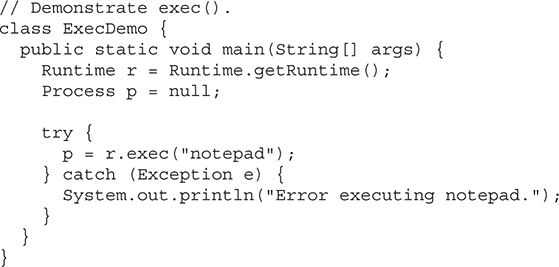
There are several alternative forms of exec( ), but the one shown in the example is often sufficient. The Process object returned by exec( ) can be manipulated by Process’ methods after the new program starts running. You can kill the subprocess with the destroy( ) method. The waitFor( ) method causes your program to wait until the subprocess finishes. The exitValue( ) method returns the value returned by the subprocess when it is finished. This is typically 0 if no problems occur. Here is the preceding exec( ) example modified to wait for the running process to exit:
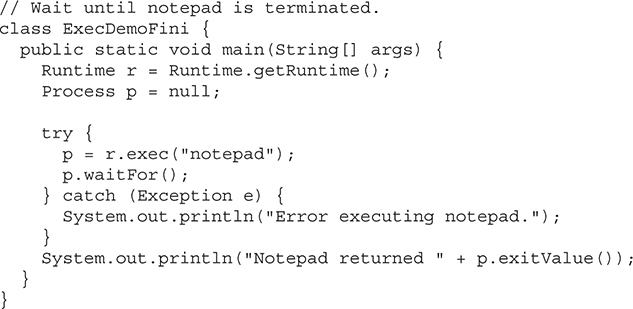
While a subprocess is running, you can write to and read from its standard input and output. The getOutputStream( ) and getInputStream( ) methods return the handles to standard in and out of the subprocess. Alternatively, beginning with JDK 17, you can also use outputWriter( ) and inputReader( ) to obtain a writer and reader. (I/O is examined in detail in Chapter 22.)
Runtime.Version encapsulates version information (which includes the version number) pertaining to the Java environment. You can obtain an instance of Runtime.Version for the current platform by calling Runtime.version( ). Originally added by JDK 9, Runtime.Version was substantially changed with the release of JDK 10 to better accommodate the faster, time-based release cadence. As discussed earlier in this book, starting with JDK 10, a feature release is anticipated to occur on a strict schedule, with the time between feature releases expected to be six months. Runtime.Version is a value-based class. (See Chapter 13 for a description of value-based classes.)
In the past, the JDK version number used the well-known major.minor approach. This mechanism did not, however, provide a good fit with the time-based release schedule. As a result, a different meaning was given to the elements of a version number. Today, the first four elements specify counters, which occur in the following order: feature release counter, interim release counter, update release counter, and patch release counter. Each number is separated by a period. However, trailing zeros, along with their preceding periods, are removed. Although additional elements may also be included, only the meaning of the first four are predefined.
The feature release counter specifies the number of the release. This counter is updated with each feature release. To smooth the transition from the previous version scheme, the feature release counter began at 10. Thus, the feature release counter for JDK 10 is 10, the one for JDK 11 is 11, and so on.
The interim release counter indicates the number of a release that occurs between feature releases. At the time of this writing, the value of the interim release counter will be zero because interim releases are not expected to be part of the increased release cadence. (It is defined for possible future use.) An interim release will not cause breaking changes to the JDK feature set. The update release counter indicates the number of a release that addresses security and possibly other problems. The patch release counter specifies a number of a release that addresses a serious flaw that must be fixed as soon as possible. With each new feature release, the interim, update, and patch counters are reset to zero.
It is useful to point out that the version number just described is a necessary component of the version string, but optional elements may also be included in the string. For example, a version string may include information for a pre-release version. Optional elements follow the version number in the version string.
Beginning with JDK 10, Runtime.Version was updated to include the following methods that support the new feature, interim, update, and patch counter values:
int feature( )
int interim( )
int update( )
int patch( )
Each returns an integer value that represents the indicated value. Here is a short program that demonstrates their use:
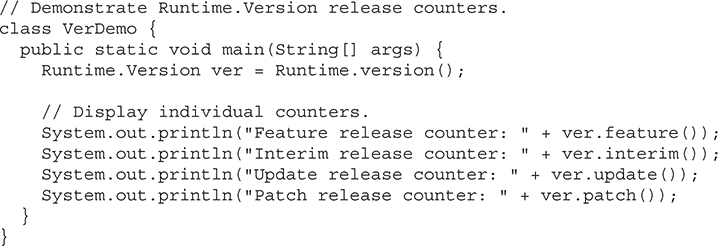
As a result of the change to time-based releases, the following methods in Runtime.Version have been deprecated: major( ), minor( ), and security( ). Previously, these returned the major version number, the minor version number, and the security update number. These values have been superseded by the feature, interim, and update numbers, as just described.
In addition to the methods just discussed, Runtime.Version has methods that obtain various pieces of optional data. For example, you can obtain the build number, if present, by calling build( ). Pre-release information, if present, is returned by pre( ). Other optional information may also be present and is obtained by calling optional( ). You can compare versions by using compareTo( ) or compareToIgnoreOptional( ). You can use equals( ) and equalsIgnoreOptional( ) to determine version equality. The version( ) method returns a list of the version numbers. You can convert a valid version string into a Runtime.Version object by calling parse( ).
ProcessBuilder provides another way to start and manage processes (that is, programs). As explained earlier, all processes are represented by the Process class, and a process can be started by Runtime.exec( ). ProcessBuilder offers more control over the processes. For example, you can set the current working directory.
ProcessBuilder defines these constructors:
ProcessBuilder(List<String> args)
ProccessBuilder(String ... args)
Here, args is a list of arguments that specify the name of the program to be executed along with any required command-line arguments. In the first constructor, the arguments are passed in a List. In the second, they are specified through a varargs parameter. Table 19-12 describes the methods defined by ProcessBuilder.
In Table 19-12, notice the methods that use the ProcessBuilder.Redirect class. This abstract class encapsulates an I/O source or target linked to a subprocess. Among other things, these methods enable you to redirect the source or target of I/O operations. For example, you can redirect to a file by calling to( ), redirect from a file by calling from( ), and append to a file by calling appendTo( ). A File object linked to the file can be obtained by calling file( ). These methods are shown here:
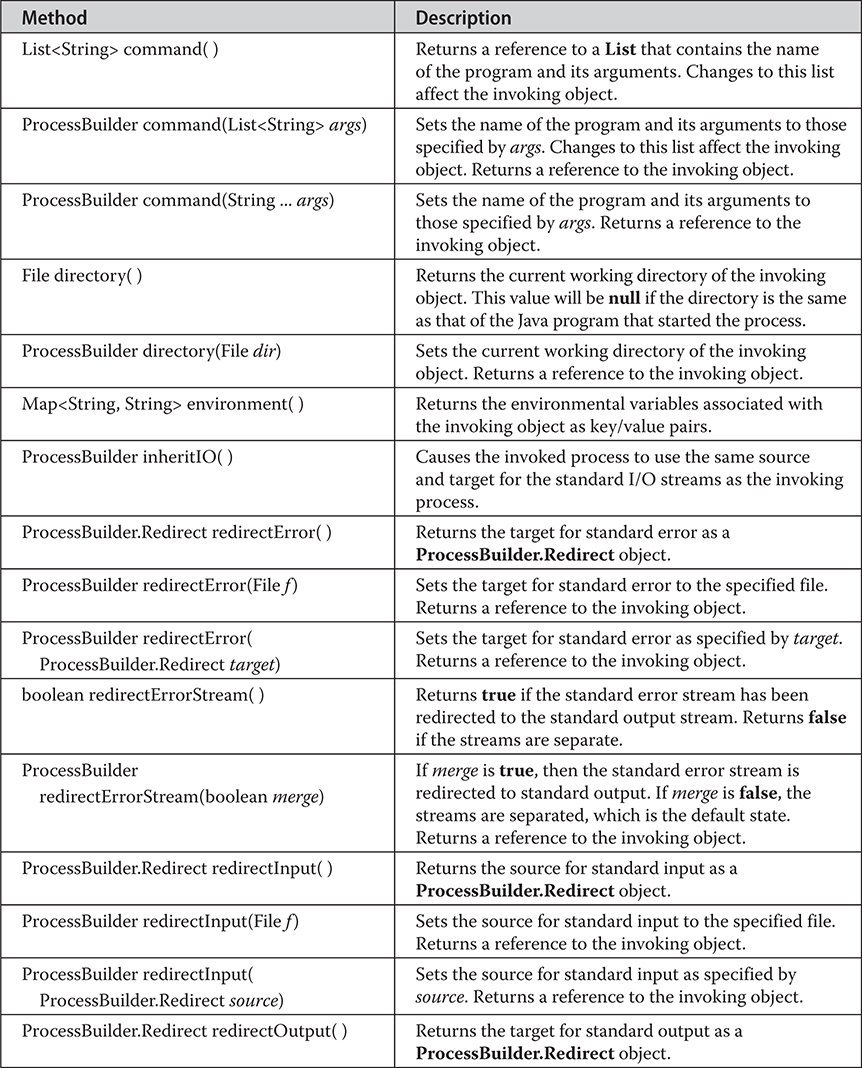

Table 19-12 The Methods Defined by ProcessBuilder
static ProcessBuilder.Redirect to(File f )
static ProcessBuilder.Redirect from(File f )
static ProcessBuilder.Redirect appendTo(File f )
File file( )
Another method supported by ProcessBuilder.Redirect is type( ), which returns a value of the enumeration type ProcessBuilder.Redirect.Type. This enumeration describes the type of the redirection. It defines these values: APPEND, INHERIT, PIPE, READ, or WRITE. ProcessBuilder.Redirect also defines the constants INHERIT, PIPE, and DISCARD.
To create a process using ProcessBuilder, simply create an instance of ProcessBuilder, specifying the name of the program and any needed arguments. To begin execution of the program, call start( ) on that instance. Here is an example that executes the Windows text editor notepad. Notice that it specifies the name of the file to edit as an argument.
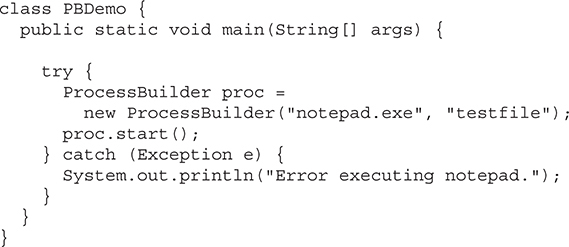
The System class holds a collection of static methods and variables. The standard input, output, and error output of the Java run time are stored in the in, out, and err variables. The non-deprecated methods defined by System are shown in Table 19-13. Many of the methods throw a SecurityException if the operation is not permitted by the security manager. Be aware, however, that JDK 17 deprecates for removal the security manager.
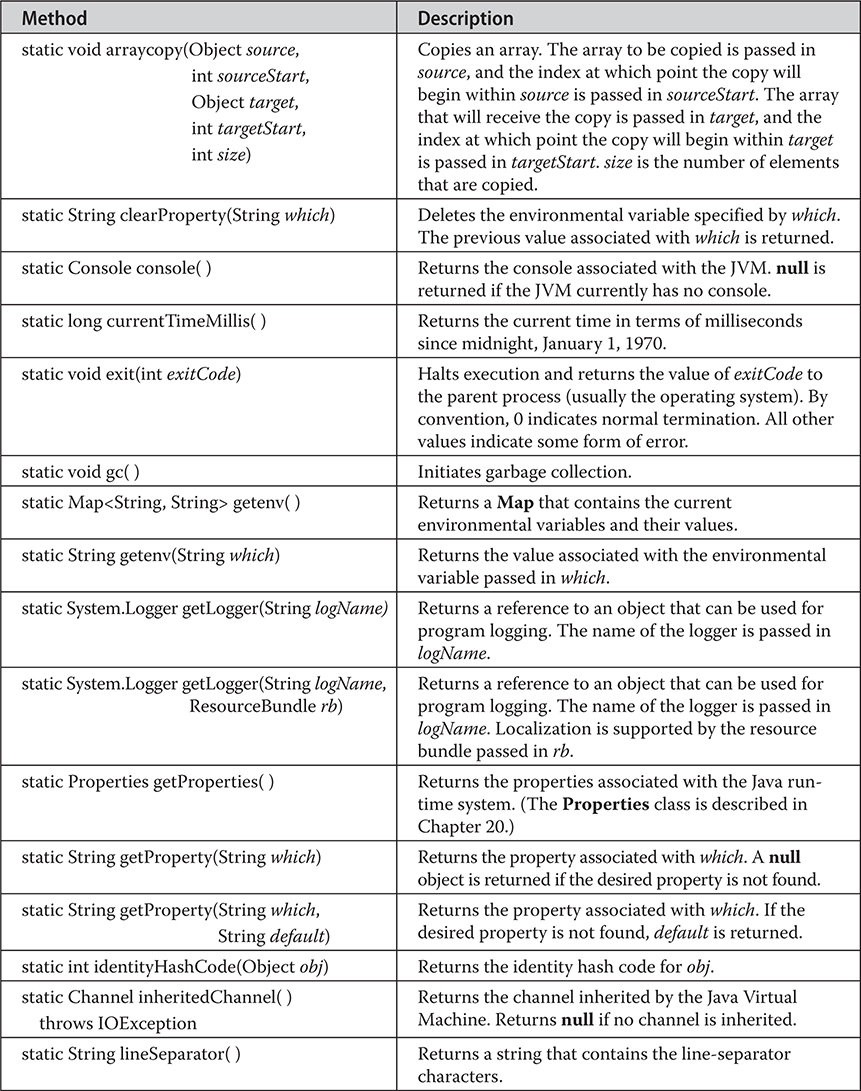
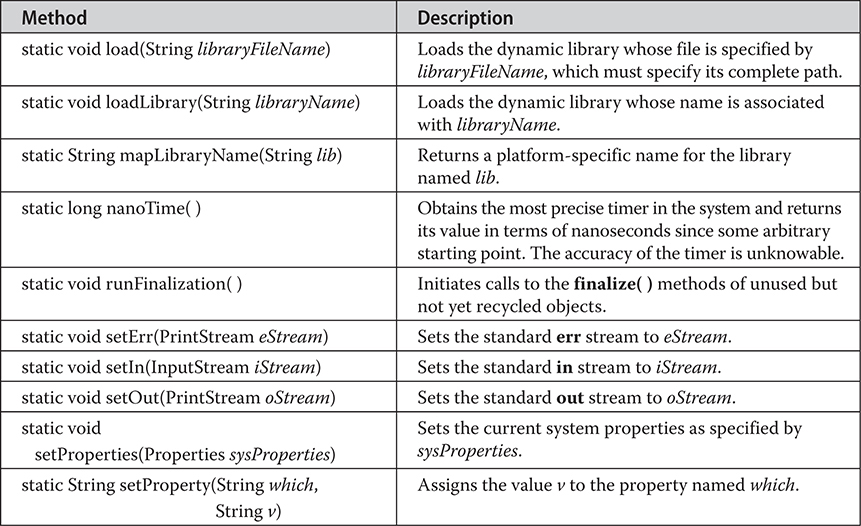
Table 19-13 The Methods Defined by System
Let’s look at some common uses of System.
One use of the System class that you might find particularly interesting is to use the currentTimeMillis( ) method to time how long various parts of your program take to execute. The currentTimeMillis( ) method returns the current time in terms of milliseconds since midnight, January 1, 1970. To time a section of your program, store this value just before beginning the section in question. Immediately upon completion, call currentTimeMillis( ) again. The elapsed time will be the ending time minus the starting time. The following program demonstrates this:
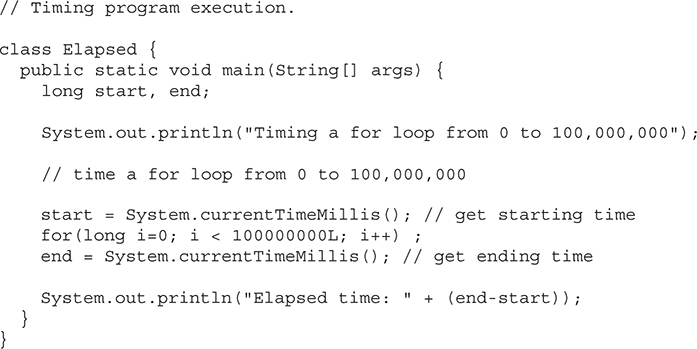
Here is a sample run (remember that your results probably will differ):
Timing a for loop from 0 to 100,000,000
Elapsed time: 10
If your system has a timer that offers nanosecond precision, then you could rewrite the preceding program to use nanoTime( ) rather than currentTimeMillis( ). For example, here is the key portion of the program rewritten to use nanoTime( ):
start = System.nanoTime(); // get starting time
for(long i=0; i < 100000000L; i++) ;
end = System.nanoTime(); // get ending time
The arraycopy( ) method can be used to copy quickly an array of any type from one place to another. This is much faster than the equivalent loop written out longhand in Java. Here is an example of two arrays being copied by the arraycopy( ) method. First, a is copied to b. Next, all of a’s elements are shifted down by one. Then, b is shifted up by one.
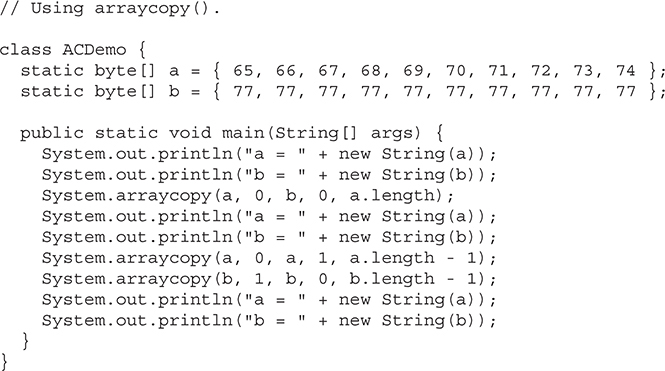
As you can see from the following output, you can copy using the same source and destination in either direction:
a = ABCDEFGHIJ
b = MMMMMMMMMM
a = ABCDEFGHIJ
b = ABCDEFGHIJ
a = AABCDEFGHI
b = BCDEFGHIJJ
At the time of this writing, the following properties are available.
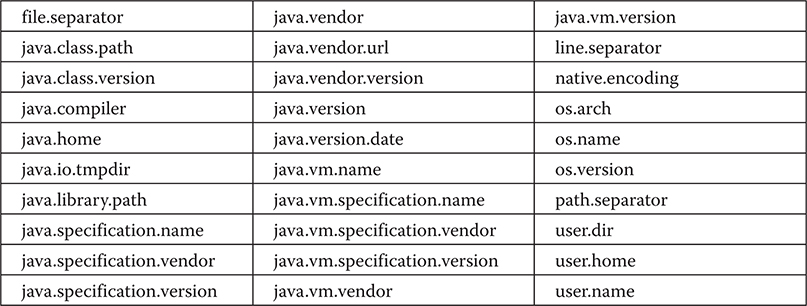
You can obtain the values of various environment variables by calling the System.getProperty( ) method. For example, the following program displays the path to the current user directory:

The System.Logger interface and System.LoggerFinder class support a program log. A logger can be found by use of System.getLogger( ). System.Logger provides the interface to the logger.
As mentioned in Part I, Object is a superclass of all other classes. Object defines the methods shown in Table 19-14, which are available to every object.
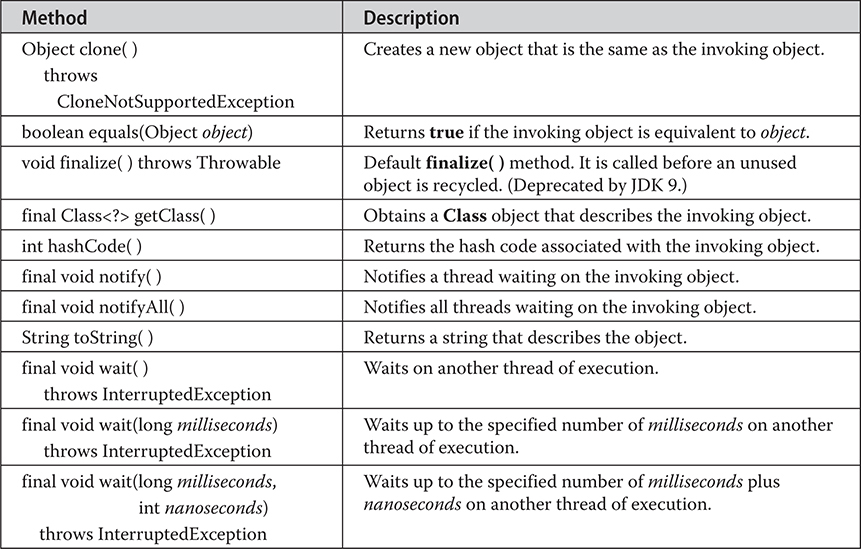
Table 19-14 The Methods Defined by Object
Most of the methods defined by Object are discussed elsewhere in this book. However, one deserves special attention: clone( ). The clone( ) method generates a duplicate copy of the object on which it is called. Only classes that implement the Cloneable interface can be cloned.
The Cloneable interface defines no members. It is used to indicate that a class allows an exact copy of an object (that is, a clone) to be made. If you try to call clone( ) on a class that does not implement Cloneable, a CloneNotSupportedException is thrown. When a clone is made, the constructor for the object being cloned is not called. As implemented by Object, a clone is simply an exact copy of the original.
Cloning is a potentially dangerous action, because it can cause unintended side effects. For example, if the object being cloned contains a reference variable called obRef, then when the clone is made, obRef in the clone will refer to the same object as does obRef in the original. If the clone makes a change to the contents of the object referred to by obRef, then it will be changed for the original object, too. Here is another example: If an object opens an I/O stream and is then cloned, two objects will be capable of operating on the same stream. Further, if one of these objects closes the stream, the other object might still attempt to write to it, causing an error. In some cases, you will need to override the clone( ) method defined by Object to handle these types of problems.
Because cloning can cause problems, clone( ) is declared as protected inside Object. This means that it must either be called from within a method defined by the class that implements Cloneable, or it must be explicitly overridden by that class so that it is public. Let’s look at an example of each approach.
The following program implements Cloneable and defines the method cloneTest( ), which calls clone( ) in Object:
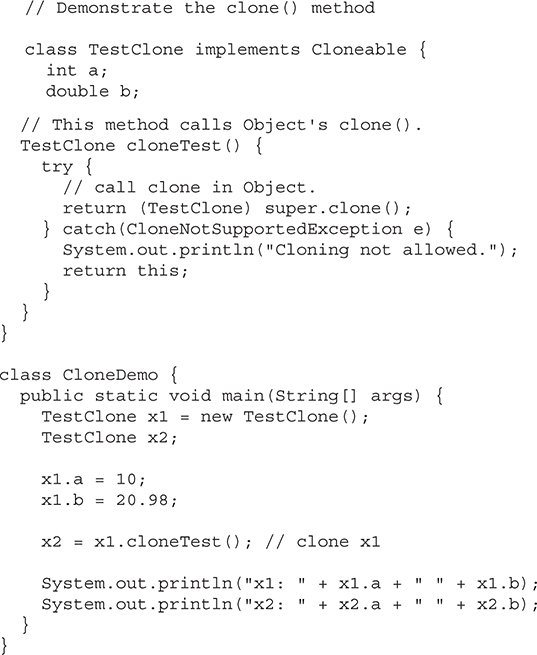
Here, the method cloneTest( ) calls clone( ) in Object and returns the result. Notice that the object returned by clone( ) must be cast into its appropriate type (TestClone).
The following example overrides clone( ) so that it can be called from code outside of its class. To do this, its access specifier must be public, as shown here:
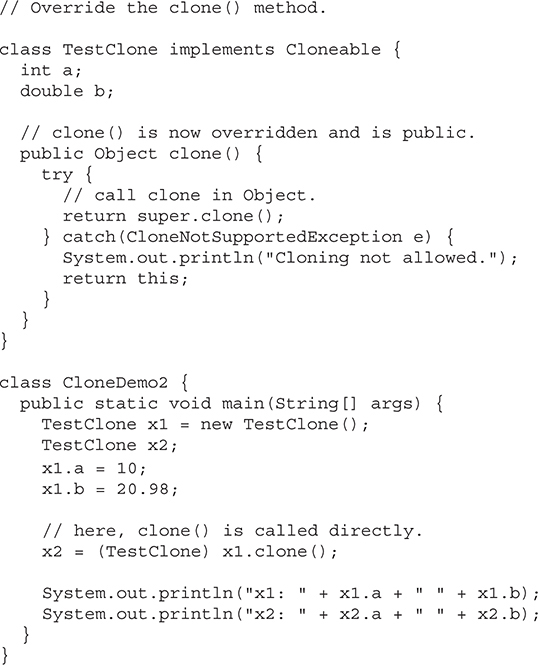
The side effects caused by cloning are sometimes difficult to see at first. It is easy to think that a class is safe for cloning when it actually is not. In general, you should not implement Cloneable for any class without good reason.
Class encapsulates the run-time state of a class or interface. Objects of type Class are created automatically, when classes are loaded. You cannot explicitly declare a Class object. Generally, you obtain a Class object by calling the getClass( ) method defined by Object. Class is a generic class that is declared as shown here:
class Class<T>
Here, T is the type of the class or interface represented. A sampling of methods defined by Class is shown in Table 19-15. In the table, notice the getModule( ) method. It is part of the support for the modules feature added by JDK 9. Class implements several interfaces, including Constable and TypeDescriptor.
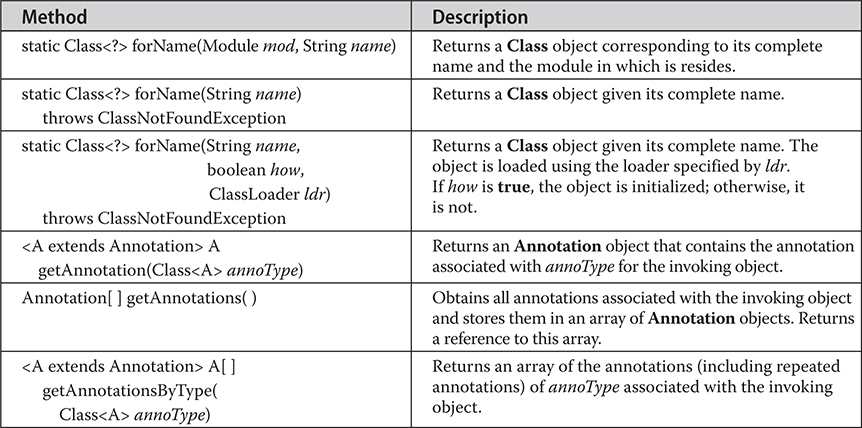
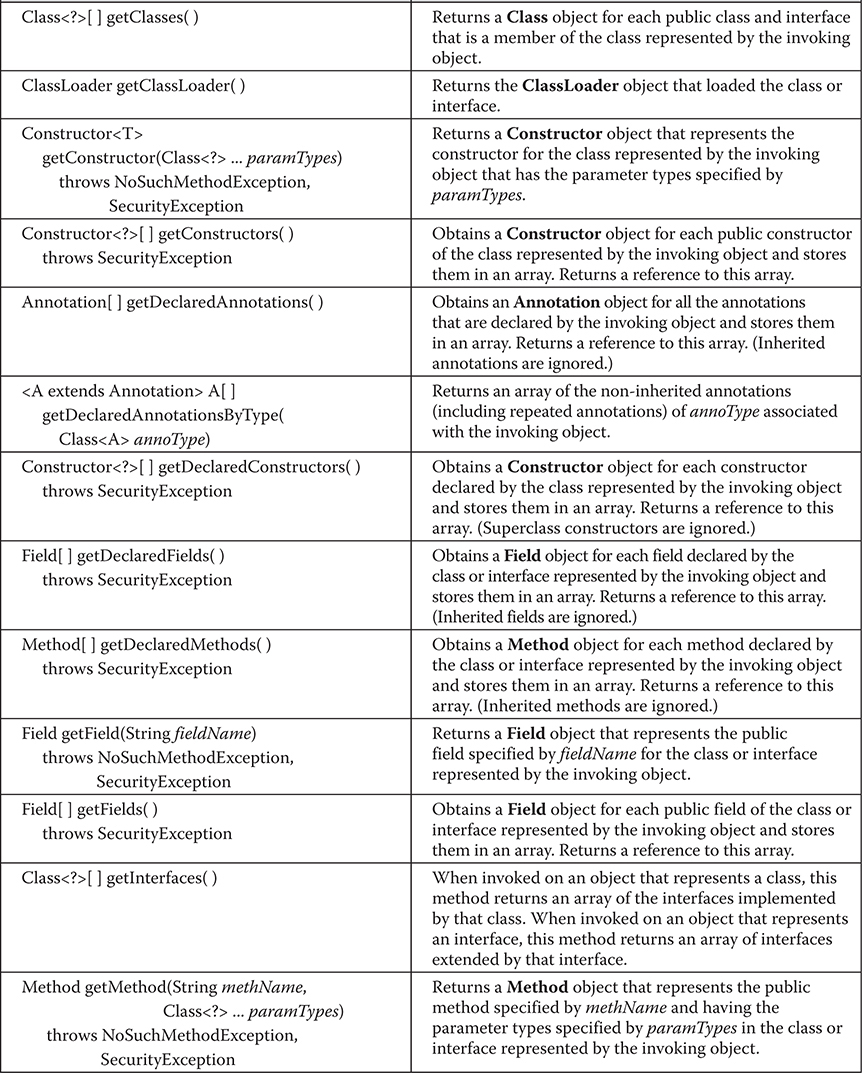
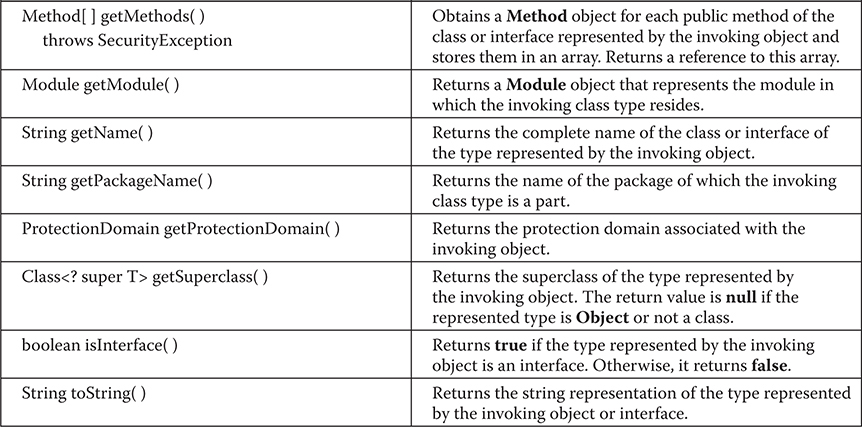
Table 19-15 A Sampling of Methods Defined by Class
The methods defined by Class are often useful in situations where run-time type information about an object is required. As Table 19-15 shows, methods are provided that allow you to determine additional information about a particular class, such as its public constructors, fields, and methods. Among other things, this is important for the Java Beans functionality, which is discussed later in this book.
The following program demonstrates getClass( ) (inherited from Object) and getSuperclass( ) (from Class):
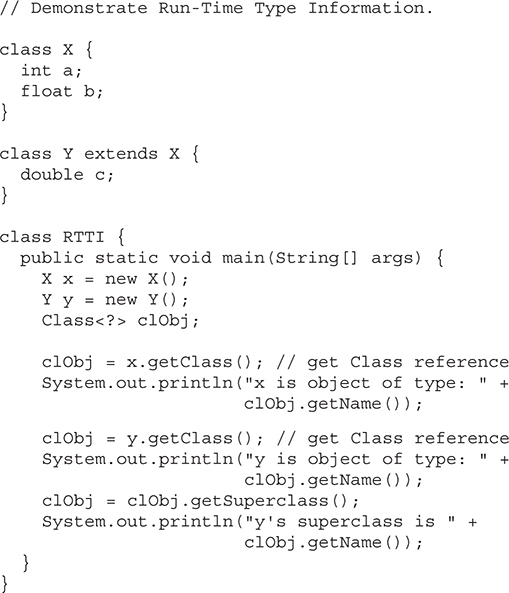
The output from this program is shown here:
x is object of type: X
y is object of type: Y
y’s superclass is X
Beginning with JDK 16, Class has included methods that support records. These are getRecordComponents( ), which obtains information about a record’s components, and isRecord( ), which returns true if the invoking Class represents a record. Beginning with JDK 17, Class has included methods that support sealed classes and interfaces. They are isSealed( ), which returns true if the invoking Class is a sealed, and getPermittedSubclasses( ), which obtains an array of Class instances of the subclasses or subinterfaces permitted by the invoking Class. Records and sealed classes and interfaces are discussed Chapter 17.
Before moving on, it is useful to mention another Class capability that you may find interesting. Beginning with JDK 11, Class provides three methods that relate to a nest. A nest is a group of classes and/or interfaces nested within an outer class or interface. The nest concept enables the JVM to more efficiently handle certain situations involving access between nest members. It is important to state that a nest is not a source code mechanism, and it does not change the Java language or how it defines accessibility. Nests relate specifically to how the compiler and JVM work. However, it is now possible to obtain a nest’s top-level class/interface, which is called the nest host, by use of getNestHost( ). You can determine if one class/interface is a member of the same nest as another by use of isNestMateOf( ). Finally, you can get an array containing a list of the nest members by calling getNestMembers( ). You may find these methods useful when using reflection, for example.
The abstract class ClassLoader defines how classes are loaded. Your application can create subclasses that extend ClassLoader, implementing its methods. Doing so allows you to load classes in some way other than the way they are normally loaded by the Java run-time system. However, this is not something that you will normally need to do.
The Math class contains all the floating-point functions that are used for geometry and trigonometry, as well as several general-purpose methods. Math defines two double constants: E (approximately 2.72) and PI (approximately 3.14).
The following methods accept a double parameter for an angle in radians and return the result of their respective trigonometric function:

The next methods take as a parameter the result of a trigonometric function and return, in radians, the angle that would produce that result. They are the inverse of their non-arc companions.

The next methods compute the hyperbolic sine, cosine, and tangent of an angle:

Math defines the following exponential methods:
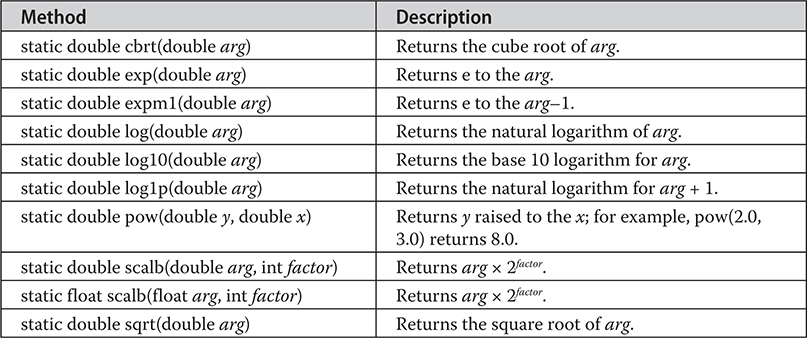
The Math class defines several methods that provide various types of rounding operations. They are shown in Table 19-16. Notice the two ulp( ) methods at the end of the table. In this context, ulp stands for units in the last place. It indicates the distance between a value and the next higher value. It can be used to help assess the accuracy of a result.
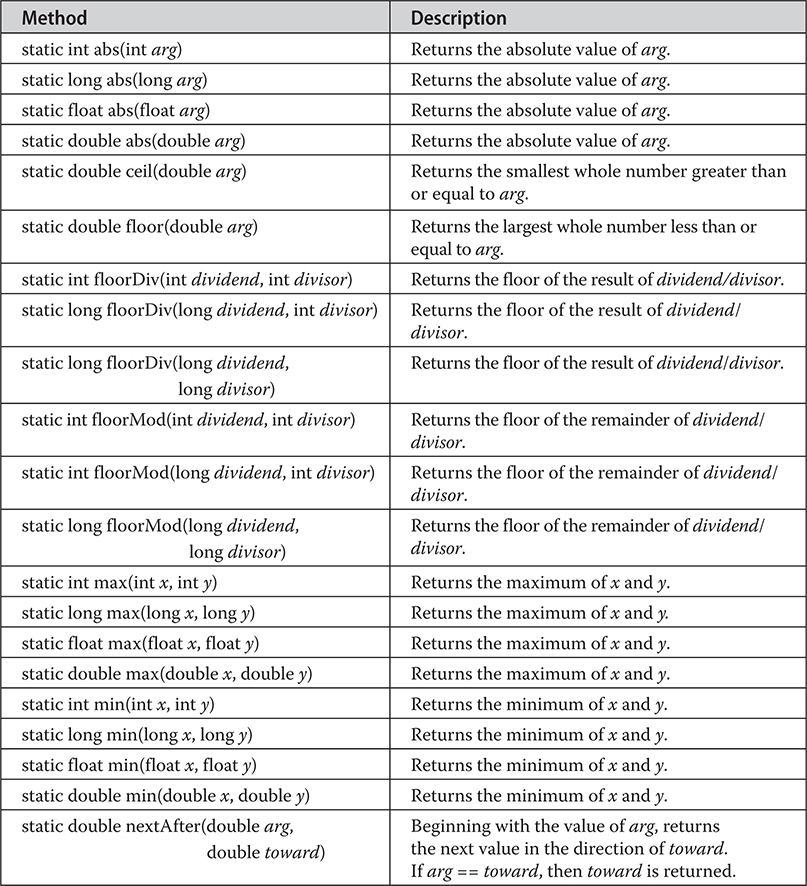
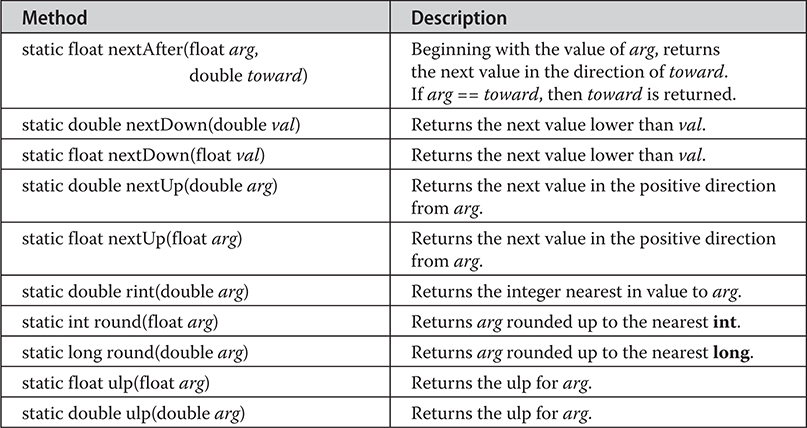
Table 19-16 The Rounding Methods Defined by Math
In addition to the methods just shown, Math defines several other methods, which are shown in Table 19-17. Notice that several of the methods use the suffix Exact. They throw an ArithmeticException if overflow occurs. Thus, these methods give you an easy way to watch various operations for overflow.
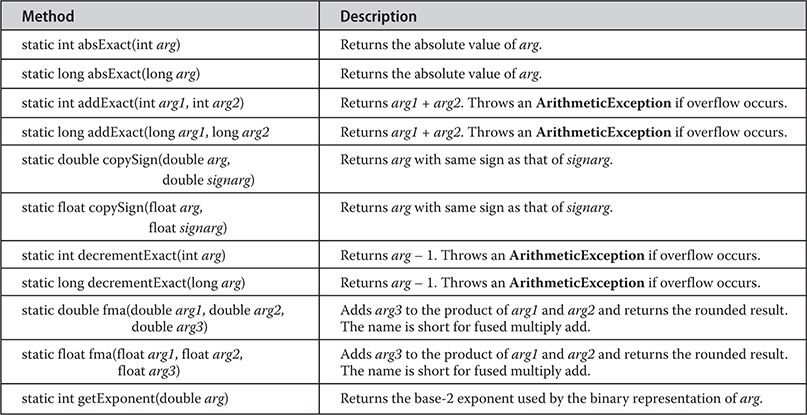
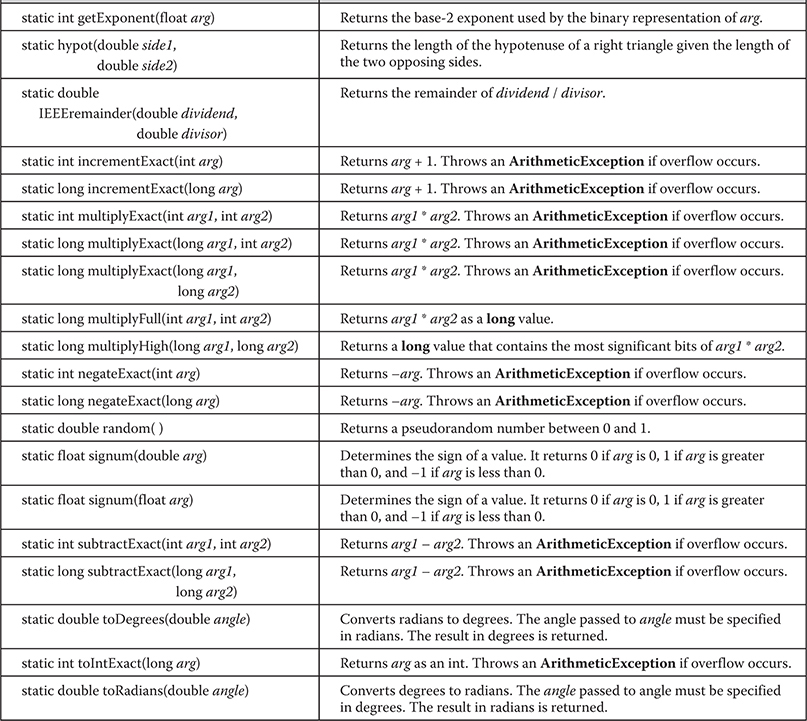
Table 19-17 Other Methods Defined by Math
The following program demonstrates toRadians( ) and toDegrees( ):
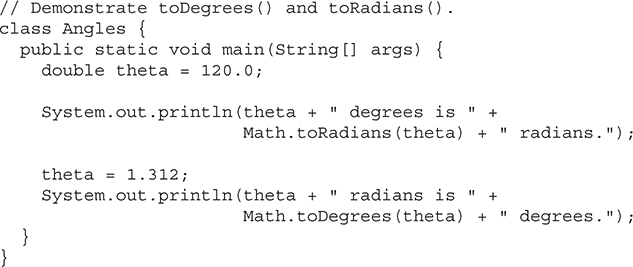
The output is shown here:
120.0 degrees is 2.0943951023931953 radians.
1.312 radians is 75.17206272116401 degrees.
The StrictMath class defines a complete set of mathematical methods that parallel those in Math. The difference is that the StrictMath version is guaranteed to generate precisely identical results across all Java implementations, whereas the methods in Math are given more latitude in order to improve performance. It is important to point out that beginning with JDK 17, all math computations are now strict.
The Compiler class supports the creation of Java environments in which Java bytecode is compiled into executable code rather than interpreted. It is not for normal programming use and has been deprecated for removal.
The Runnable interface and the Thread and ThreadGroup classes support multithreaded programming. Each is examined next.
Note An overview of the techniques used to manage threads, implement the Runnable interface, and create multithreaded programs is presented in Chapter 11.
The Runnable interface must be implemented by any class that will initiate a separate thread of execution. Runnable only defines one abstract method, called run( ), which is the entry point to the thread. It is defined like this:
void run( )
Threads that you create must implement this method.
Thread creates a new thread of execution. It implements Runnable and defines a number of constructors. Several are shown here:
Thread( )
Thread(Runnable threadOb)
Thread(Runnable threadOb, String threadName)
Thread(String threadName)
Thread(ThreadGroup groupOb, Runnable threadOb)
Thread(ThreadGroup groupOb, Runnable threadOb, String threadName)
Thread(ThreadGroup groupOb, String threadName)
threadOb is an instance of a class that implements the Runnable interface and defines where execution of the thread will begin. The name of the thread is specified by threadName. When a name is not specified, one is created by the Java Virtual Machine. groupOb specifies the thread group to which the new thread will belong. When no thread group is specified, by default the new thread belongs to the same group as the parent thread.
The following constants are defined by Thread:
MAX_PRIORITY
MIN_PRIORITY
NORM_PRIORITY
As expected, these constants specify the maximum, minimum, and default thread priorities.
The non-deprecated methods defined by Thread are shown in Table 19-18. Thread also includes the deprecated methods stop( ), suspend( ), and resume( ). However, as explained in Chapter 11, these were deprecated because they were inherently unstable. Also deprecated are countStackFrames( ), because it calls suspend( ), and destroy( ), because it can cause deadlock. Furthermore, beginning with JDK 11, destroy( ) and one version of stop( ) have now been removed from Thread. Also, JDK 17 deprecated checkAccess( ) for removal.
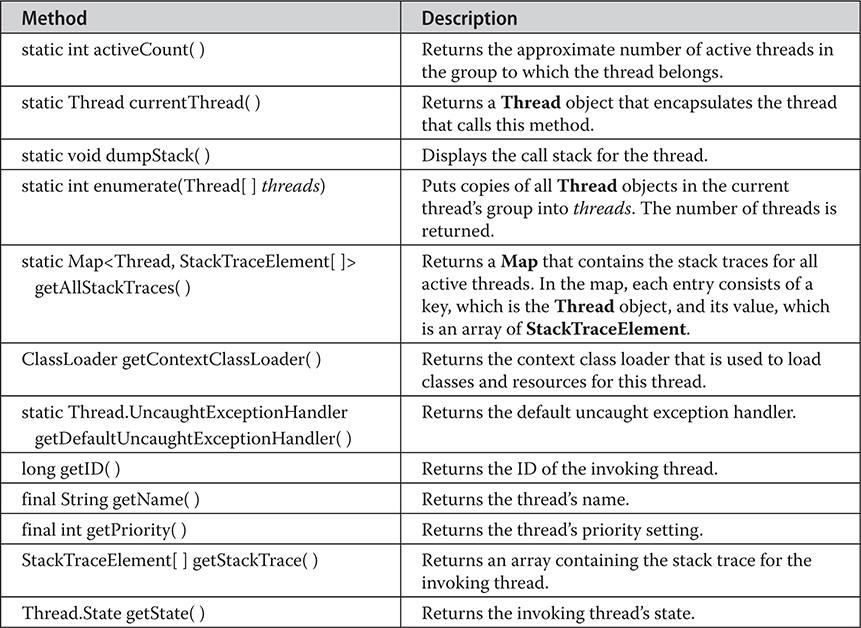
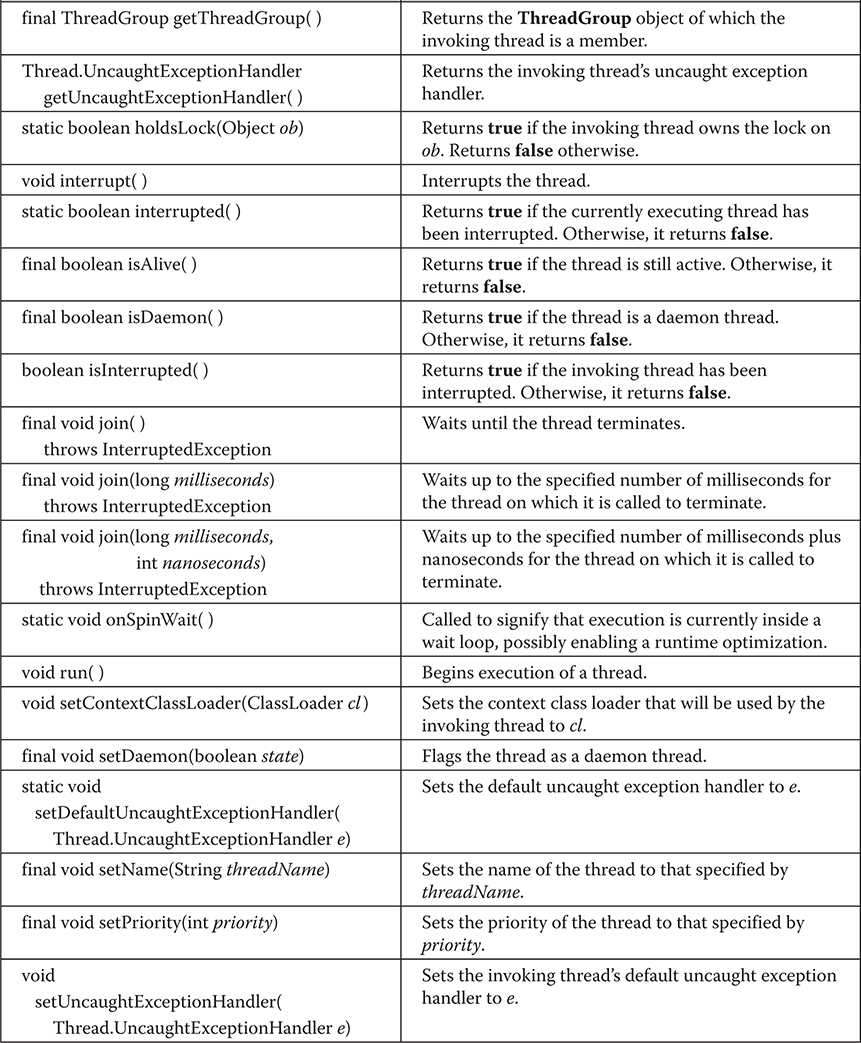

Table 19-18 The Non-Deprecated Methods Defined by Thread
ThreadGroup creates a group of threads. It defines these two constructors:
ThreadGroup(String groupName)
ThreadGroup(ThreadGroup parentOb, String groupName)
For both forms, groupName specifies the name of the thread group. The first version creates a new group that has the current thread as its parent. In the second form, the parent is specified by parentOb. The non-deprecated methods defined by ThreadGroup are shown in Table 19-19.
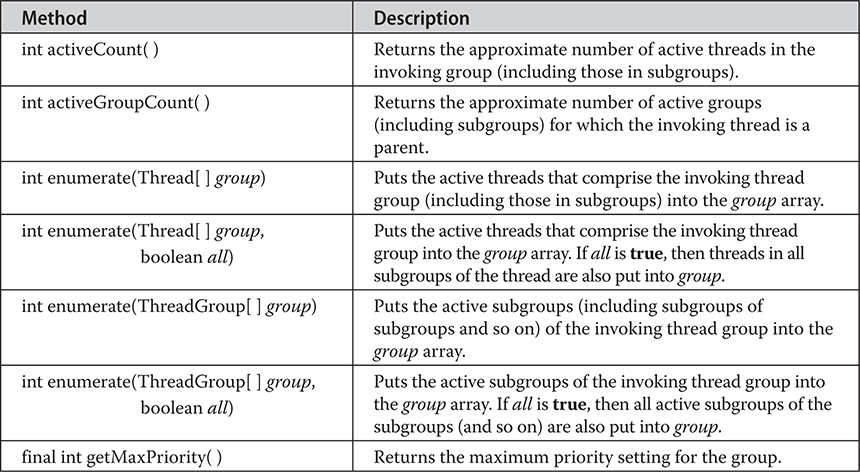
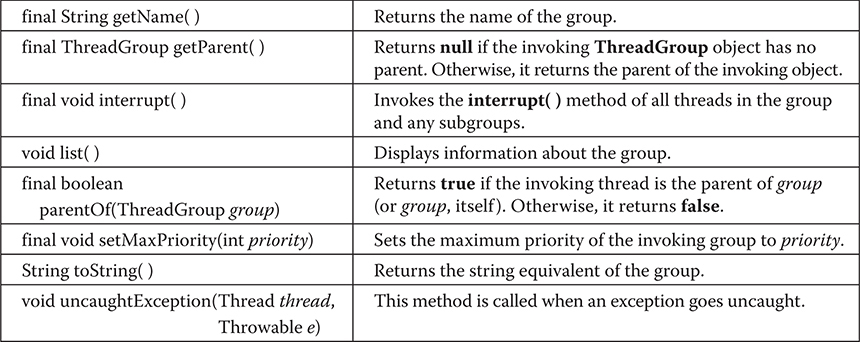
Table 19-19 The Non-Deprecated Methods Defined by ThreadGroup
Thread groups offer a convenient way to manage groups of threads as a unit. This is particularly valuable in situations in which you want to suspend and resume a number of related threads. For example, imagine a program in which one set of threads is used for printing a document, another set is used to display the document on the screen, and another set saves the document to a disk file. If printing is aborted, you will want an easy way to stop all threads related to printing. Thread groups offer this convenience. The following program, which creates two thread groups of two threads each, illustrates this usage:
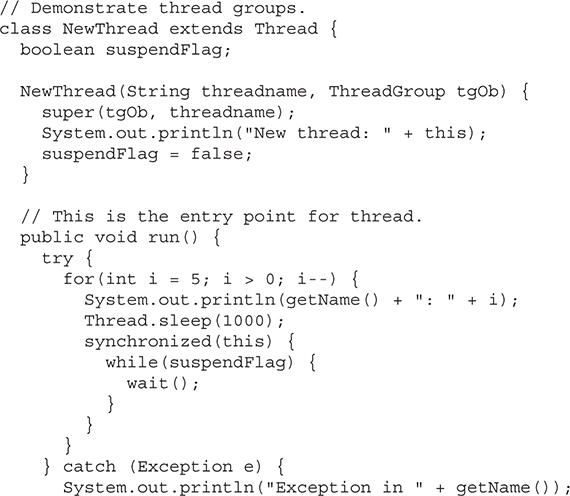

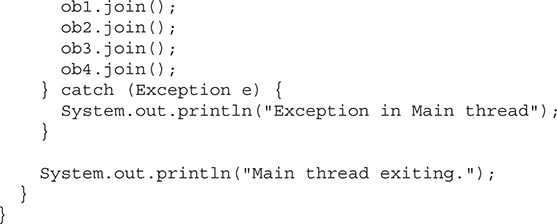
Sample output from this program is shown here (the precise output you see may differ):
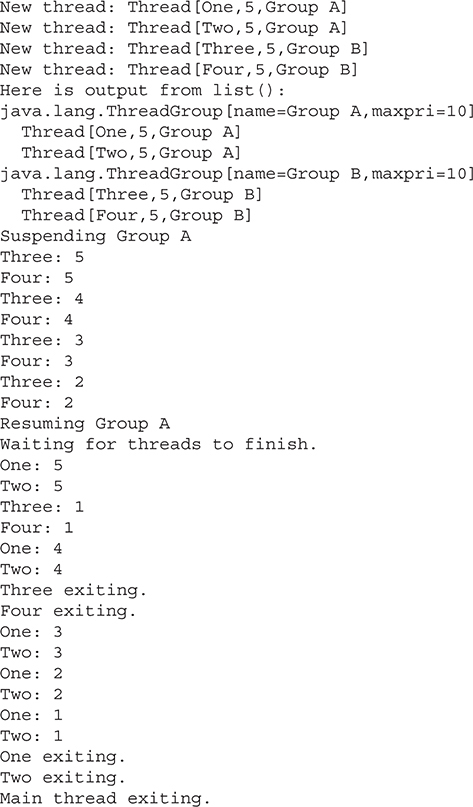
Inside the program, notice that thread group A is suspended for four seconds. As the output confirms, this causes threads One and Two to pause, but threads Three and Four continue running. After the four seconds, threads One and Two are resumed. Notice how thread group A is suspended and resumed. First, the threads in group A are obtained by calling enumerate( ) on group A. Then, each thread is suspended by iterating through the resulting array. To resume the threads in A, the list is again traversed and each thread is resumed.
Java defines two additional thread-related classes in java.lang:
• ThreadLocal Used to create thread local variables. Each thread will have its own copy of a thread local variable.
• InheritableThreadLocal Creates thread local variables that may be inherited.
Package encapsulates information about a package. The methods defined by Package are shown in Table 19-20. The following program demonstrates Package, displaying the packages about which the program currently is aware:
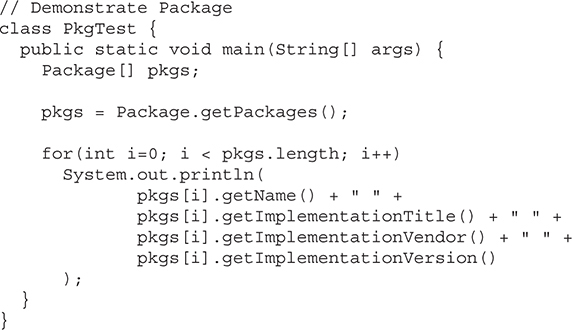

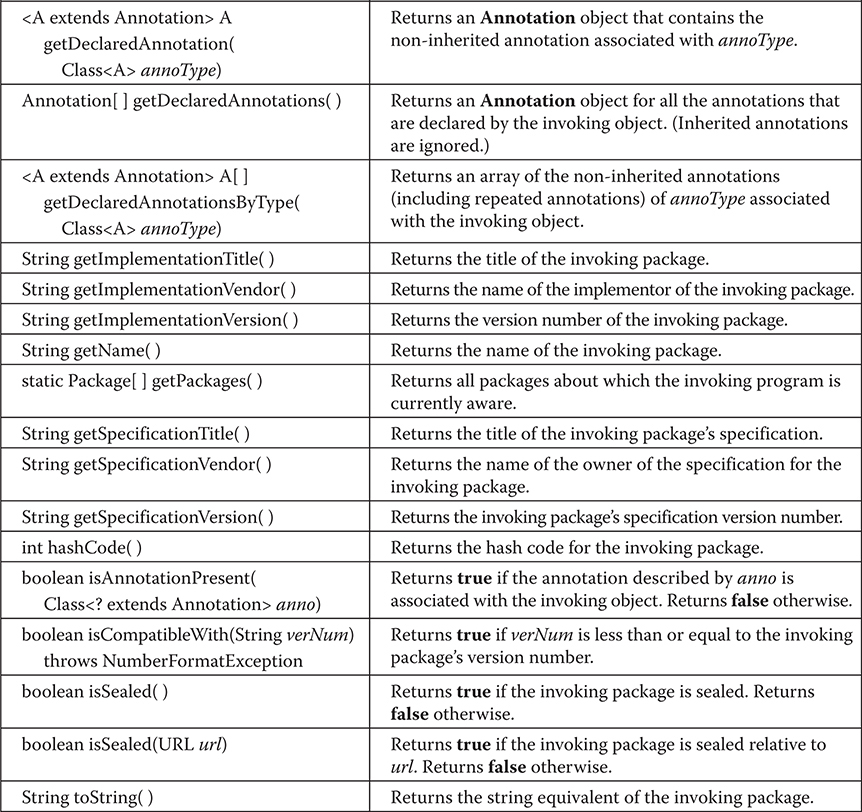
Table 19-20 The Methods Defined by Package
Added by JDK 9, the Module class encapsulates a module. Using a Module instance you can add various access rights to a module, determine access rights, or obtain information about a module. For example, to export a package to a specified module, call addExports( ); to open a package to a specified module, call addOpens( ); to read another module, call addReads( ); and to add a service requirement, call addUses( ). You can determine if a module can access another by calling canRead( ). To determine if a module uses a service, call canUse( ). Although these methods will be most useful in specialized situations, Module defines several others that may be of more general interest.
For example, you can obtain the name of a module by calling getName( ). If called from within a named module, the name is returned. If called from the unnamed module, null is returned. You can obtain a Set of the packages in a module by calling getPackages( ). A module descriptor, in the form of a ModuleDescriptor instance, is returned by getDescriptor( ). (ModuleDescriptor is a class declared in java.lang.module.) You can determine if a package is exported or opened by the invoking module by calling isExported( ) or isOpen( ). Use isNamed( ) to determine if a module is named or unnamed. Other methods include getAnnotation( ), getDeclaredAnnotations( ), getLayer( ), getClassLoader( ), and getResourceAsStream( ). The toString( ) method is also overridden for Module.
Assuming the modules defined by the examples in Chapter 16, you can easily experiment with the Module class. For example, try adding the following lines to the MyModAppDemo class:
Module myMod = MyModAppDemo.class.getModule();
System.out.println("Module is " + myMod.getName());
System.out.print("Packages: ");
for(String pkg : myMod.getPackages()) System.out.println(pkg + " ");
Here, the methods getName( ) and getPackages( ) are used. Notice that a Module instance is obtained by calling getModule( ) on the Class instance for MyModAppDemo. When run, these lines produce the following output:
Module is appstart
Packages: appstart.mymodappdemo
ModuleLayer, added by JDK 9, encapsulates a module layer. The nested class ModuleLayer.Controller, also added by JDK 9, is the controller for a module layer. In general, these classes are for specialized applications.
RuntimePermission relates to Java’s security mechanism.
The Throwable class supports Java’s exception-handling system and is the class from which all exception classes are derived. It is discussed in Chapter 10.
SecurityManager has been deprecated for removal by JDK 17. Consult the Java documentation for the latest details.
The StackTraceElement class describes a single stack frame, which is an individual element of a stack trace when an exception occurs. Each stack frame represents an execution point, which includes such things as the name of the class, the name of the method, the name of the file, and the source-code line number. Beginning with JDK 9, module information is also included. StackTraceElement defines two constructors, but typically you won’t need to use them because an array of StackTraceElements is returned by various methods, such as the getStackTrace( ) method of the Throwable and Thread classes.
The methods supported by StackTraceElement are shown in Table 19-21. These methods give you programmatic access to a stack trace.
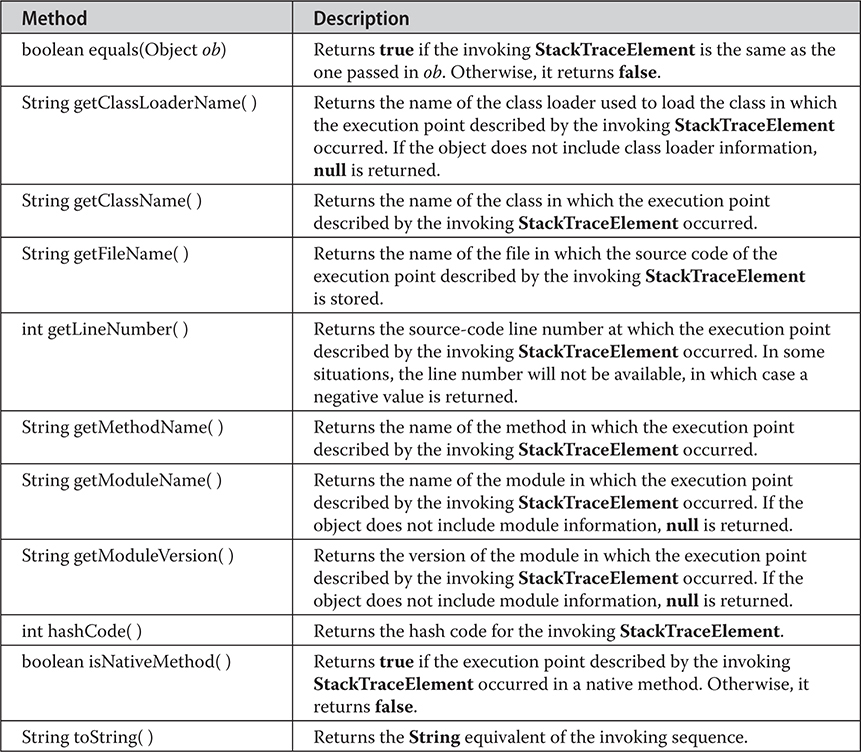
Table 19-21 The Methods Defined by StackTraceElement
Added by JDK 9, the StackWalker class and the StackWalker.StackFrame interface support stack walking operations. A StackWalker instance is obtained by use of the static getInstance( ) method defined by StackWalker. Stack walking is initiated by calling the walk( ) method of StackWalker. Each stack frame is encapsulated as a StackWalker.StackFrame object. The StackWalker.Option enumeration was also added.
As described in Chapter 12, an enumeration is a list of named constants. (Recall that an enumeration is created by using the keyword enum.) All enumerations automatically inherit Enum. Enum is a generic class that is declared as shown here:
class Enum<E extends Enum<E>>
Here, E stands for the enumeration type. Enum has no public constructors.
Enum defines several commonly used methods, which are shown in Table 19-22. Beginning with JDK 12, Enum also implements the Constable interface, which specifies the describeConstable( ) method. JDK 12 also added the Enum.EnumDesc class.
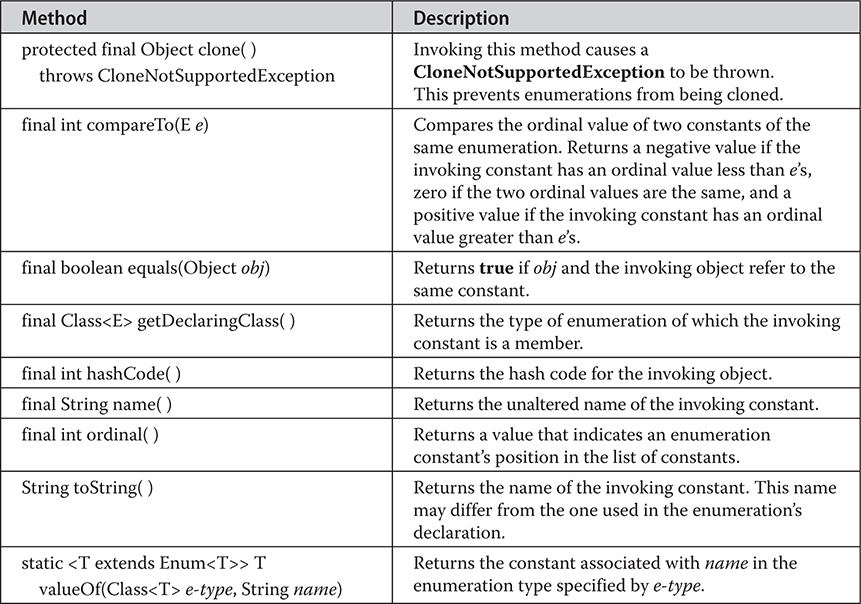
Table 19-22 Commonly Used Methods Defined by Enum
Added by JDK 16, Record is the superclass for all records. In other words, all records automatically inherit Record. It defines no methods of its own, but overrides equals( ), hashCode( ), and toString( ), which are inherited from Object. Records are discussed in Chapter 17.
ClassValue can be used to associate a value with a type. It is a generic class defined like this:
Class ClassValue<T>
It is designed for highly specialized uses, not for normal programming.
The CharSequence interface defines methods that grant read-only access to a sequence of characters. These methods are shown in Table 19-23. This interface is implemented by String, StringBuffer, and StringBuilder, among others.
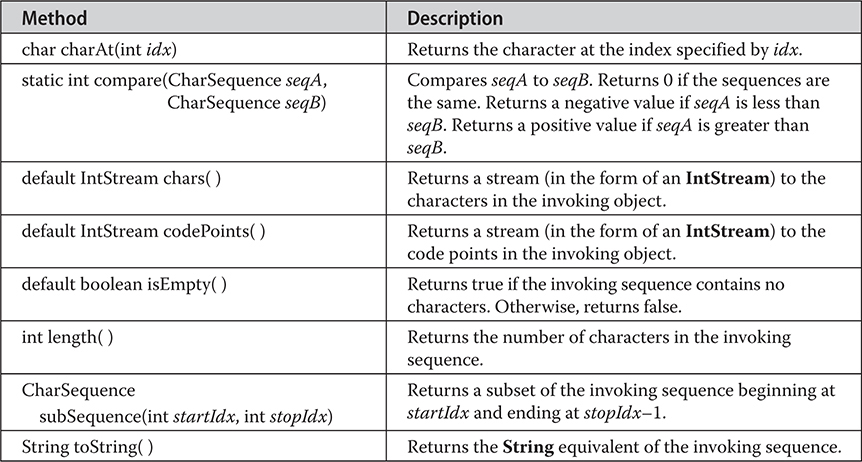
Table 19-23 The Methods Defined by CharSequence
Objects of classes that implement Comparable can be ordered. In other words, classes that implement Comparable contain objects that can be compared in some meaningful manner. Comparable is generic and is declared like this:
interface Comparable<T>
Here, T represents the type of objects being compared.
The Comparable interface declares one method that is used to determine what Java calls the natural ordering of instances of a class. The signature of the method is shown here:
int compareTo(T obj)
This method compares the invoking object with obj. It returns 0 if the values are equal. A negative value is returned if the invoking object has a lower value. Otherwise, a positive value is returned.
This interface is implemented by several of the classes already reviewed in this book, such as Byte, Character, Double, Float, Long, Short, String, Integer, and Enum.
An object of a class that implements Appendable can have a character or character sequences appended to it. Appendable defines these three methods:
Appendable append(char ch) throws IOException
Appendable append(CharSequence chars) throws IOException
Appendable append(CharSequence chars, int begin, int end) throws IOException
In the first form, the character ch is appended to the invoking object. In the second form, the character sequence chars is appended to the invoking object. The third form allows you to indicate a portion (the characters running from begin through end–1) of the sequence specified by chars. In all cases, a reference to the invoking object is returned.
Iterable must be implemented by any class whose objects will be used by the for-each version of the for loop. In other words, in order for an object to be used within a for-each style for loop, its class must implement Iterable. Iterable is a generic interface that has this declaration:
interface Iterable<T>
Here, T is the type of the object being iterated. It defines one abstract method, iterator( ), which is shown here:
Iterator<T> iterator( )
It returns an iterator to the elements contained in the invoking object.
Iterable also defines two default methods. The first is called forEach( ):
default void forEach(Consumer<? super T> action)
For each element being iterated, forEach( ) executes the code specified by action. (Consumer is a functional interface defined in java.util.function. See Chapter 21.)
The second default method is spliterator( ), shown next:
default Spliterator<T> spliterator( )
It returns a Spliterator to the sequence being iterated. (See Chapters 20 and 30 for details on spliterators.)
Note Iterators are described in detail in Chapter 20.
The Readable interface indicates that an object can be used as a source for characters. It defines one method called read( ), which is shown here:
int read(CharBuffer buf ) throws IOException
This method reads characters into buf. It returns the number of characters read, or –1 if an EOF is encountered.
AutoCloseable provides support for the try-with-resources statement, which implements what is sometimes referred to as automatic resource management (ARM). The try-with-resources statement automates the process of releasing a resource (such as a stream) when it is no longer needed. (See Chapter 13 for details.) Only objects of classes that implement AutoCloseable can be used with try-with-resources. The AutoCloseable interface defines only the close( ) method, which is shown here:
void close( ) throws Exception
This method closes the invoking object, releasing any resources that it may hold. It is automatically called at the end of a try-with-resources statement, thus eliminating the need to explicitly invoke close( ). AutoCloseable is implemented by several classes, including all of the I/O classes that open a stream that can be closed.
The static Thread.UncaughtExceptionHandler interface is implemented by classes that want to handle uncaught exceptions. It is implemented by ThreadGroup. It declares only one method, which is shown here:
void uncaughtException(Thread thrd, Throwable exc)
Here, thrd is a reference to the thread that generated the exception and exc is a reference to the exception.
Java defines several subpackages of java.lang. Except as otherwise noted, these packages are in the java.base module.
• java.lang.annotation
• java.lang.constant
• java.lang.instrument
• java.lang.invoke
• java.lang.management
• java.lang.module
• java.lang.ref
• java.lang.reflect
Each is briefly described here.
Java’s annotation facility is supported by java.lang.annotation. It defines the Annotation interface, the ElementType and RetentionPolicy enumerations, and several predefined annotations. Annotations are described in Chapter 12.
java.lang.constant is a specialized package that supports descriptors for constants. It is typically used by applications that access bytecode and it was added by JDK 12.
java.lang.instrument defines features that can be used to add instrumentation to various aspects of program execution. It defines the Instrumentation and ClassFileTransformer interfaces, and the ClassDefinition class. This package is in the java.instrument module.
java.lang.invoke supports dynamic language features. It includes classes such as CallSite, MethodHandle, and MethodType.
The java.lang.management package provides management support for the JVM and the execution environment. Using the features in java.lang.management, you can observe and manage various aspects of program execution. This package is in the java.management module.
The java.lang.module package supports modules. It includes classes such as ModuleDescriptor and ModuleReference, and the interfaces ModuleFinder and ModuleReader.
You learned earlier that the garbage collection facilities in Java automatically determine when no references exist to an object. The object is then assumed to be no longer needed and its memory is reclaimed. The classes in the java.lang.ref package provide more flexible control over the garbage collection process.
Reflection is the ability of a program to analyze code at run time. The java.lang.reflect package provides the ability to obtain information about the fields, constructors, methods, and modifiers of a class. Among other reasons, you need this information to build software tools that enable you to work with Java Beans components. The tools use reflection to determine dynamically the characteristics of a component. Reflection was introduced in Chapter 12 and is also examined in Chapter 31.
java.lang.reflect defines several classes, including Method, Field, and Constructor. It also defines several interfaces, including AnnotatedElement, Member, and Type. In addition, the java.lang.reflect package includes the Array class that enables you to create and access arrays dynamically.
This chapter begins our examination of java.util. This important package contains a large assortment of classes and interfaces that support a broad range of functionality. For example, java.util has classes that generate pseudorandom numbers, manage date and time, support events, manipulate sets of bits, tokenize strings, and handle formatted data. The java.util package also contains one of Java’s most powerful subsystems: the Collections Framework. The Collections Framework is a sophisticated hierarchy of interfaces and classes that provide state-of-the-art technology for managing groups of objects. It merits close attention by all programmers. Beginning with JDK 9, java.util is part of the java.base module.
Because java.util contains a wide array of functionality, it is quite large. Here is a list of its top-level classes:
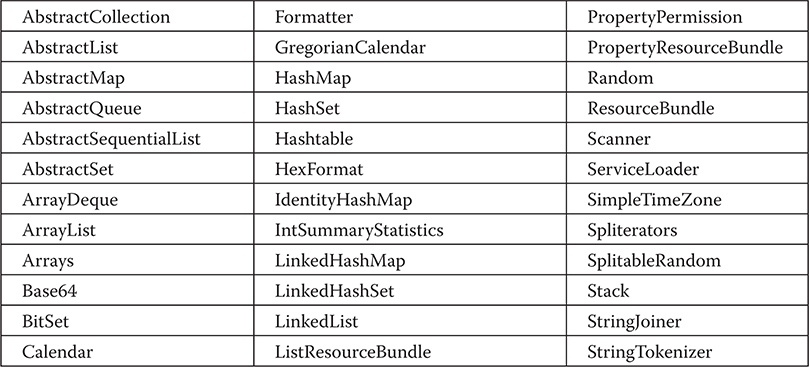
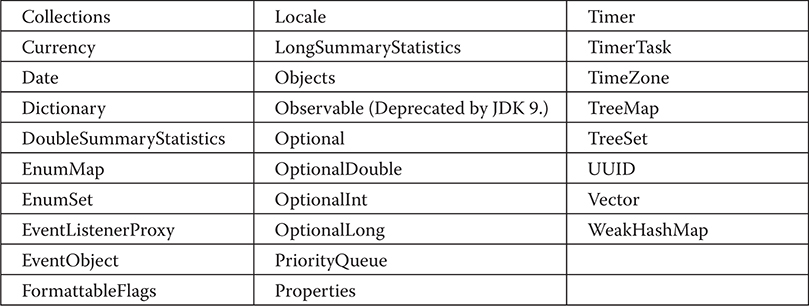
The interfaces defined by java.util are shown next:
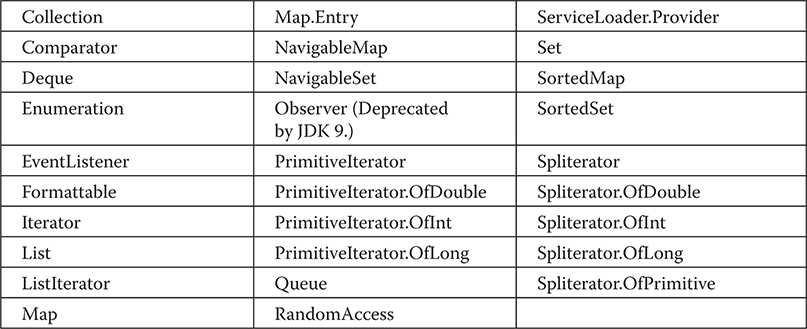
Because of its size, the description of java.util is broken into two chapters. This chapter examines those members of java.util that are part of the Collections Framework. Chapter 21 discusses its other classes and interfaces.
The Java Collections Framework standardizes the way in which groups of objects are handled by your programs. Collections were not part of the original Java release, but were added by J2SE 1.2. Prior to the Collections Framework, Java provided ad hoc classes such as Dictionary, Vector, Stack, and Properties to store and manipulate groups of objects. Although these classes were quite useful, they lacked a central, unifying theme. The way that you used Vector was different from the way that you used Properties, for example. Also, this early, ad hoc approach was not designed to be easily extended or adapted. Collections were an answer to these (and other) problems.
The Collections Framework was designed to meet several goals. First, the framework had to be high-performance. The implementations for the fundamental collections (dynamic arrays, linked lists, trees, and hash tables) are highly efficient. You seldom, if ever, need to code one of these “data engines” manually. Second, the framework had to allow different types of collections to work in a similar manner and with a high degree of interoperability. Third, extending and/or adapting a collection had to be easy. Toward this end, the entire Collections Framework is built upon a set of standard interfaces. Several standard implementations (such as LinkedList, HashSet, and TreeSet) of these interfaces are provided that you may use as-is. You may also implement your own collection, if you choose. Various special-purpose implementations are created for your convenience, and some partial implementations are provided that make creating your own collection class easier. Finally, mechanisms were added that allow the integration of standard arrays into the Collections Framework.
Algorithms are another important part of the collection mechanism. Algorithms operate on collections and are defined as static methods within the Collections class. Thus, they are available for all collections. Each collection class need not implement its own versions. The algorithms provide a standard means of manipulating collections.
Another item closely associated with the Collections Framework is the Iterator interface. An iterator offers a general-purpose, standardized way of accessing the elements within a collection, one at a time. Thus, an iterator provides a means of enumerating the contents of a collection. Because each collection provides an iterator, the elements of any collection class can be accessed through the methods defined by Iterator. Thus, with only small changes, the code that cycles through a set can also be used to cycle through a list, for example.
JDK 8 added another type of iterator called a spliterator. In brief, spliterators are iterators that provide support for parallel iteration. The interfaces that support spliterators are Spliterator and several nested interfaces that support primitive types. Also available are iterator interfaces designed for use with primitive types, such as PrimitiveIterator and PrimitiveIterator.OfDouble.
In addition to collections, the framework defines several map interfaces and classes. Maps store key/value pairs. Although maps are part of the Collections Framework, they are not “collections” in the strict use of the term. You can, however, obtain a collection-view of a map. Such a view contains the elements from the map stored in a collection. Thus, you can process the contents of a map as a collection, if you choose.
The collection mechanism was retrofitted to some of the original classes defined by java.util so that they too could be integrated into the new system. It is important to understand that although the addition of collections altered the architecture of many of the original utility classes, it did not cause the deprecation of any. Collections simply provide a better way of doing several things.
Note If you are familiar with C++, then you will find it helpful to know that the Java collections technology is similar in spirit to the Standard Template Library (STL) defined by C++. What C++ calls a container, Java calls a collection. However, there are significant differences between the Collections Framework and the STL. It is important to not jump to conclusions.
The Collections Framework defines several core interfaces. This section provides an overview of each interface. Beginning with the collection interfaces is necessary because they determine the fundamental nature of the collection classes. Put differently, the concrete classes simply provide different implementations of the standard interfaces. The interfaces that underpin collections are summarized in the following table:
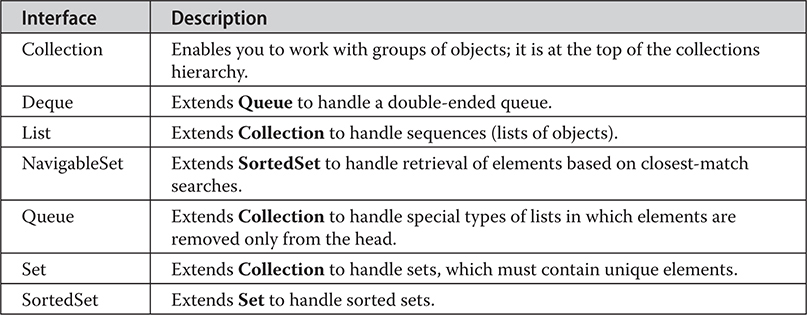
In addition to the collection interfaces, collections also use the Comparator, RandomAccess, Iterator, ListIterator, and Spliterator interfaces, which are described in depth later in this chapter. Briefly, Comparator defines how two objects are compared; Iterator, ListIterator, and Spliterator enumerate the objects within a collection. By implementing RandomAccess, a list indicates that it supports efficient, random access to its elements.
To provide the greatest flexibility in their use, the collection interfaces allow some methods to be optional. The optional methods enable you to modify the contents of a collection. Collections that support these methods are called modifiable. Collections that do not allow their contents to be changed are called unmodifiable. If an attempt is made to use one of these methods on an unmodifiable collection, an UnsupportedOperationException is thrown. All the built-in collections are modifiable.
The following sections examine the collection interfaces.
The Collection interface is the foundation upon which the Collections Framework is built because it must be implemented by any class that defines a collection. Collection is a generic interface that has this declaration:
interface Collection<E>
Here, E specifies the type of objects that the collection will hold. Collection extends the Iterable interface. This means that all collections can be cycled through by use of the for-each style for loop. (Recall that only classes that implement Iterable can be cycled through by the for.)
Collection declares the core methods that all collections will have. These methods are summarized in Table 20-1. Because all collections implement Collection, familiarity with its methods is necessary for a clear understanding of the framework. Several of these methods can throw an UnsupportedOperationException. As explained, this occurs if a collection cannot be modified. A ClassCastException is generated when one object is incompatible with another, such as when an attempt is made to add an incompatible object to a collection. A NullPointerException is thrown if an attempt is made to store a null object and null elements are not allowed in the collection. An IllegalArgumentException is thrown if an invalid argument is used. An IllegalStateException is thrown if an attempt is made to add an element to a fixed-length collection that is full.
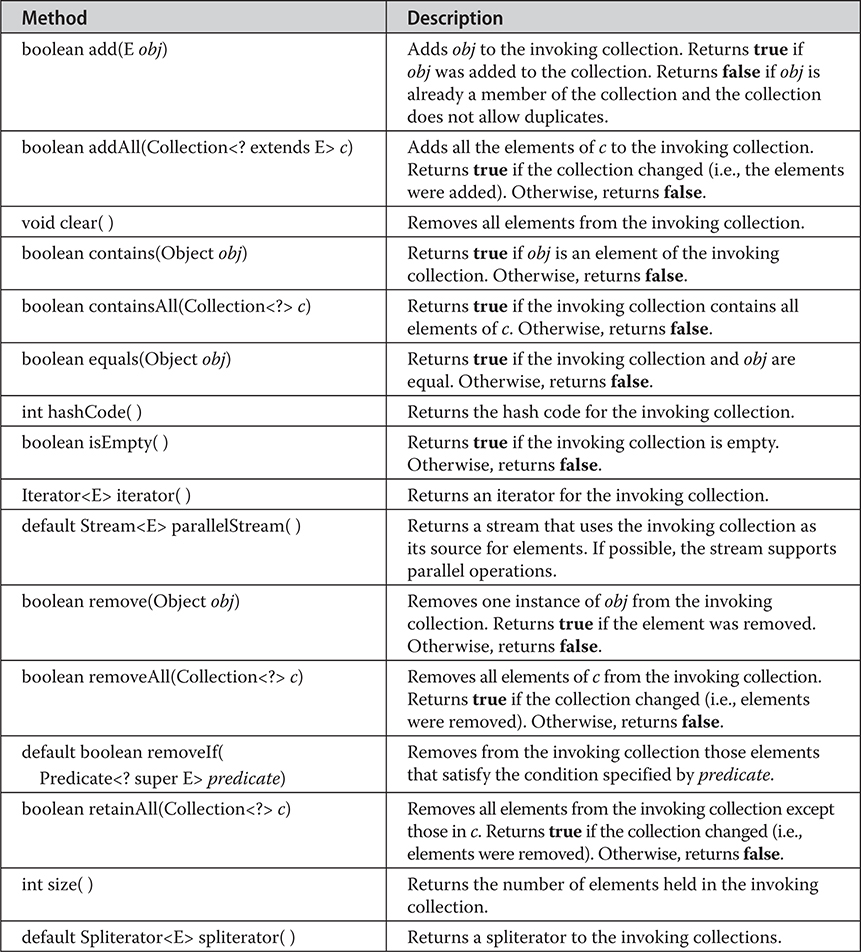
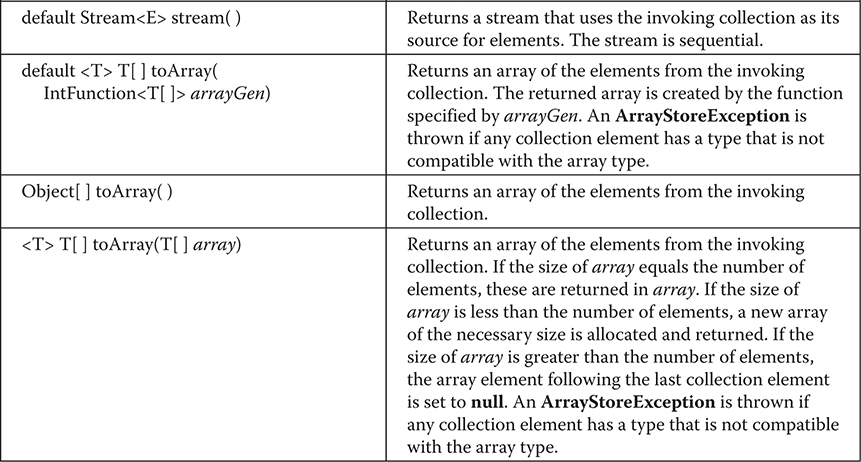
Table 20-1 The Methods Declared by Collection
Objects are added to a collection by calling add( ). Notice that add( ) takes an argument of type E, which means that objects added to a collection must be compatible with the type of data expected by the collection. You can add the entire contents of one collection to another by calling addAll( ).
You can remove an object by using remove( ). To remove a group of objects, call removeAll( ). You can remove all elements except those of a specified group by calling retainAll( ). To remove an element only if it statisfies some condition, you can use removeIf( ). To empty a collection, call clear( ).
You can determine whether a collection contains a specific object by calling contains( ). To determine whether one collection contains all the members of another, call containsAll( ). You can determine when a collection is empty by calling isEmpty( ). The number of elements currently held in a collection can be determined by calling size( ).
The toArray( ) methods return an array that contains the elements stored in the collection. The first returns an array of Object. The second returns an array of elements that have the same type as the array specified as a parameter. Normally, the second form is more convenient because it returns the desired array type. Beginning with JDK 11, a third form has been added that lets you specify a function that obtains the array. These methods are more important than it might at first seem. Often, processing the contents of a collection by using array-like syntax is advantageous. By providing a pathway between collections and arrays, you can have the best of both worlds.
Two collections can be compared for equality by calling equals( ). The precise meaning of “equality” may differ from collection to collection. For example, you can implement equals( ) so that it compares the values of elements stored in the collection. Alternatively, equals( ) can compare references to those elements.
Another important method is iterator( ), which returns an iterator to a collection. The spliterator( ) method returns a spliterator to the collection. Iterators are frequently used when working with collections. Finally, the stream( ) and parallelStream( ) methods return a Stream that uses the collection as a source of elements. (See Chapter 30 for a detailed discussion of the Stream interface.)
The List interface extends Collection and declares the behavior of a collection that stores a sequence of elements. Elements can be inserted or accessed by their position in the list, using a zero-based index. A list may contain duplicate elements. List is a generic interface that has this declaration:
interface List<E>
Here, E specifies the type of objects that the list will hold.
In addition to the methods defined by Collection, List defines some of its own, which are summarized in Table 20-2. Note again that several of these methods will throw an UnsupportedOperationException if the list cannot be modified, and a ClassCastException is generated when one object is incompatible with another, such as when an attempt is made to add an incompatible object to a list. Also, several methods will throw an IndexOutOfBoundsException if an invalid index is used. A NullPointerException is thrown if an attempt is made to store a null object and null elements are not allowed in the list. An IllegalArgumentException is thrown if an invalid argument is used.
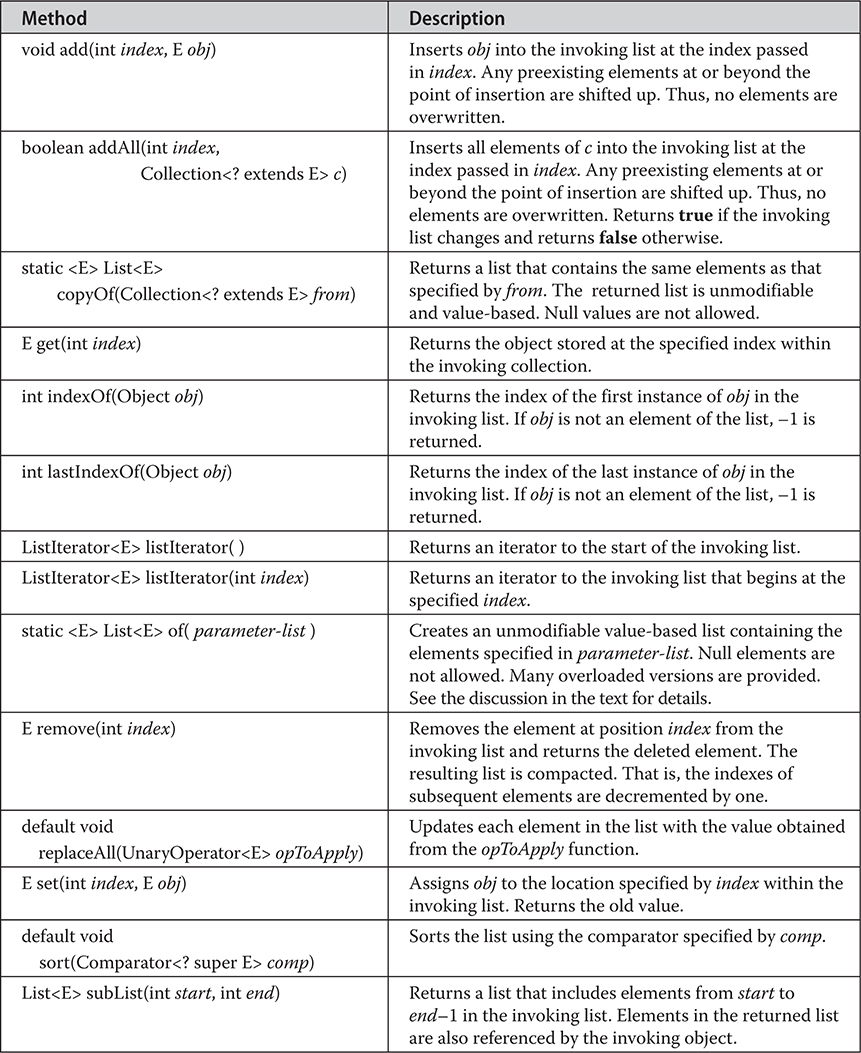
Table 20-2 The Methods Declared by List
To the versions of add( ) and addAll( ) defined by Collection, List adds the methods add(int, E) and addAll(int, Collection). These methods insert elements at the specified index. Also, the semantics of add(E) and addAll(Collection) defined by Collection are changed by List so that they add elements to the end of the list. You can modify each element in the collection by using replaceAll( ).
To obtain the object stored at a specific location, call get( ) with the index of the object. To assign a value to an element in the list, call set( ), specifying the index of the object to be changed. To find the index of an object, use indexOf( ) or lastIndexOf( ).
You can obtain a sublist of a list by calling subList( ), specifying the beginning and ending indexes of the sublist. As you can imagine, subList( ) makes list processing quite convenient. One way to sort a list is with the sort( ) method defined by List.
Beginning with JDK 9, List includes the of( ) factory method, which has a number of overloads. Each version returns an unmodifiable, value-based collection that is comprised of the arguments that it is passed. The primary purpose of of( ) is to provide a convenient, efficient way to create a small List collection. There are 12 overloads of of( ). One takes no arguments and creates an empty list. It is shown here:
static <E> List<E> of( )
Ten overloads take from 1 to 10 arguments and create a list that contains the specified elements. They are shown here:
static <E> List<E> of(E obj1)
static <E> List<E> of(E obj1, E obj2)
static <E> List<E> of(E obj, E obj2, E obj3)
...
static <E> List<E> of(E ob1, E obj2, E obj3, E obj4, E obj5,
E obj6, E obj7, E obj8, E obj9, E obj10)
The final of( ) overload specifies a varargs parameter that takes an arbitrary number of elements or an array of elements. It is shown here:
static <E> List<E> of(E ... objs)
For all versions, null elements are not allowed. In all cases, the List implementation is unspecified.
The Set interface defines a set. It extends Collection and specifies the behavior of a collection that does not allow duplicate elements. Therefore, the add( ) method returns false if an attempt is made to add duplicate elements to a set. With two exceptions, it does not specify any additional methods of its own. Set is a generic interface that has this declaration:
interface Set<E>
Here, E specifies the type of objects that the set will hold.
Beginning with JDK 9, Set includes the of( ) factory method, which has a number of overloads. Each version returns an unmodifiable, value-based collection that is comprised of the arguments that it is passed. The primary purpose of of( ) is to provide a convenient, efficient way to create a small Set collection. There are 12 overloads of of( ). One takes no arguments and creates an empty set. It is shown here:
static <E> Set<E> of( )
Ten overloads take from 1 to 10 arguments and create a list that contains the specified elements. They are shown here:
static <E> Set<E> of(E obj1)
static <E> Set<E> of(E obj1, E obj2)
static <E> Set<E> of(E obj, E obj2, E obj3)
...
static <E> Set<E> of(E ob1, E obj2, E obj3, E obj4, E obj5,
E obj6, E obj7, E obj8, E obj9, E obj10)
The final of( ) overload specifies a varargs parameter that takes an arbitrary number of elements or an array of elements. It is shown here:
static <E> Set<E> of(E ... objs)
For all versions, null elements are not allowed. In all cases, the Set implementation is unspecified.
Beginning with JDK 10, Set includes the static copyOf( ) method shown here:
static <E> Set<E> copyOf(Collection <? extends E> from)
It returns a set that contains the same elements as from. Null values are not allowed. The returned set is unmodifiable and value-based.
The SortedSet interface extends Set and declares the behavior of a set sorted in ascending order. SortedSet is a generic interface that has this declaration:
interface SortedSet<E>
Here, E specifies the type of objects that the set will hold.
In addition to those methods provided by Set, the SortedSet interface declares the methods summarized in Table 20-3. Several methods throw a NoSuchElementException when no items are contained in the invoking set. A ClassCastException is thrown when an object is incompatible with the elements in a set. A NullPointerException is thrown if an attempt is made to use a null object and null is not allowed in the set. An IllegalArgumentException is thrown if an invalid argument is used.
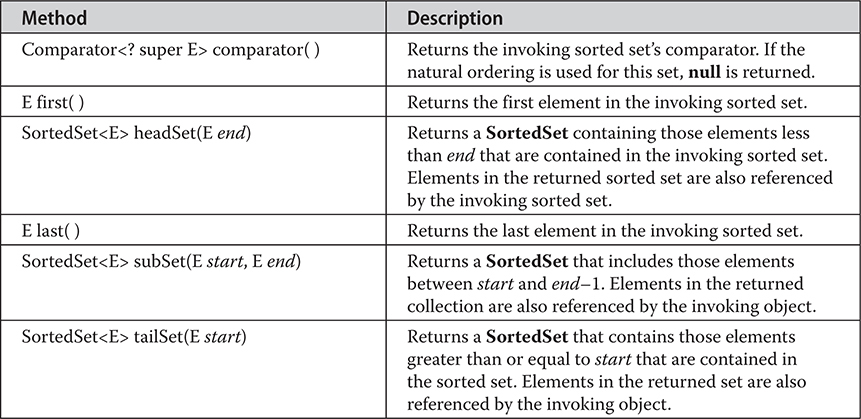
Table 20-3 The Methods Declared by SortedSet
SortedSet defines several methods that make set processing more convenient. To obtain the first object in the set, call first( ). To get the last element, use last( ). You can obtain a subset of a sorted set by calling subSet( ), specifying the first and last object in the set. If you need the subset that starts with the first element in the set, use headSet( ). If you want the subset that ends the set, use tailSet( ).
The NavigableSet interface extends SortedSet and declares the behavior of a collection that supports the retrieval of elements based on the closest match to a given value or values. NavigableSet is a generic interface that has this declaration:
interface NavigableSet<E>
Here, E specifies the type of objects that the set will hold. In addition to the methods that it inherits from SortedSet, NavigableSet adds those summarized in Table 20-4. A ClassCastException is thrown when an object is incompatible with the elements in the set. A NullPointerException is thrown if an attempt is made to use a null object and null is not allowed in the set. An IllegalArgumentException is thrown if an invalid argument is used.
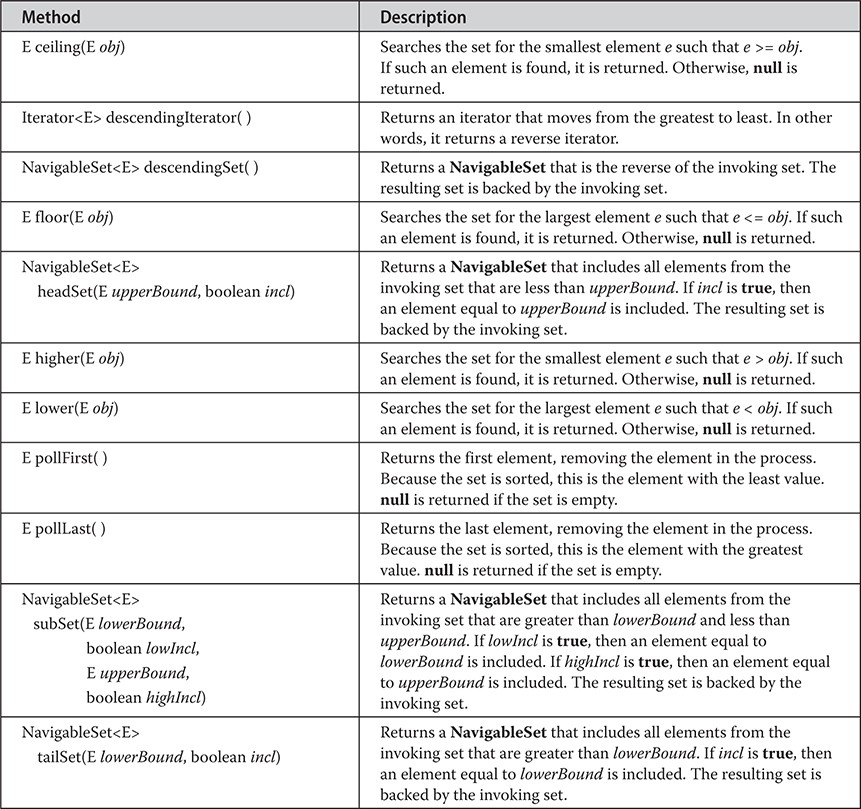
Table 20-4 The Methods Declared by NavigableSet
The Queue interface extends Collection and declares the behavior of a queue, which is often a first-in, first-out list. However, there are types of queues in which the ordering is based upon other criteria. Queue is a generic interface that has this declaration:
interface Queue<E>
Here, E specifies the type of objects that the queue will hold. The methods declared by Queue are shown in Table 20-5.
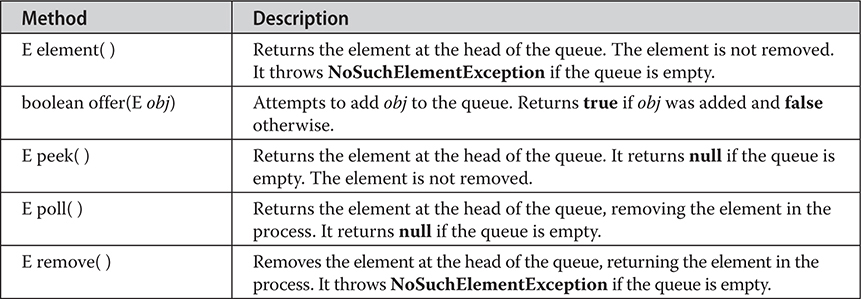
Table 20-5 The Methods Declared by Queue
Several methods throw a ClassCastException when an object is incompatible with the elements in the queue. A NullPointerException is thrown if an attempt is made to store a null object and null elements are not allowed in the queue. An IllegalArgumentException is thrown if an invalid argument is used. An IllegalStateException is thrown if an attempt is made to add an element to a fixed-length queue that is full. A NoSuchElementException is thrown if an attempt is made to remove an element from an empty queue.
Despite its simplicity, Queue offers several points of interest. First, elements can only be removed from the head of the queue. Second, there are two methods that obtain and remove elements: poll( ) and remove( ). The difference between them is that poll( ) returns null if the queue is empty, but remove( ) throws an exception. Third, there are two methods, element( ) and peek( ), that obtain but don’t remove the element at the head of the queue. They differ only in that element( ) throws an exception if the queue is empty, but peek( ) returns null. Finally, notice that offer( ) only attempts to add an element to a queue. Because some queues have a fixed length and might be full, offer( ) can fail.
The Deque interface extends Queue and declares the behavior of a double-ended queue. Double-ended queues can function as standard, first-in, first-out queues or as last-in, first-out stacks. Deque is a generic interface that has this declaration:
interface Deque<E>
Here, E specifies the type of objects that the deque will hold. In addition to the methods that it inherits from Queue, Deque adds those methods summarized in Table 20-6. Several methods throw a ClassCastException when an object is incompatible with the elements in the deque. A NullPointerException is thrown if an attempt is made to store a null object and null elements are not allowed in the deque. An IllegalArgumentException is thrown if an invalid argument is used. An IllegalStateException is thrown if an attempt is made to add an element to a fixed-length deque that is full. A NoSuchElementException is thrown if an attempt is made to remove an element from an empty deque.
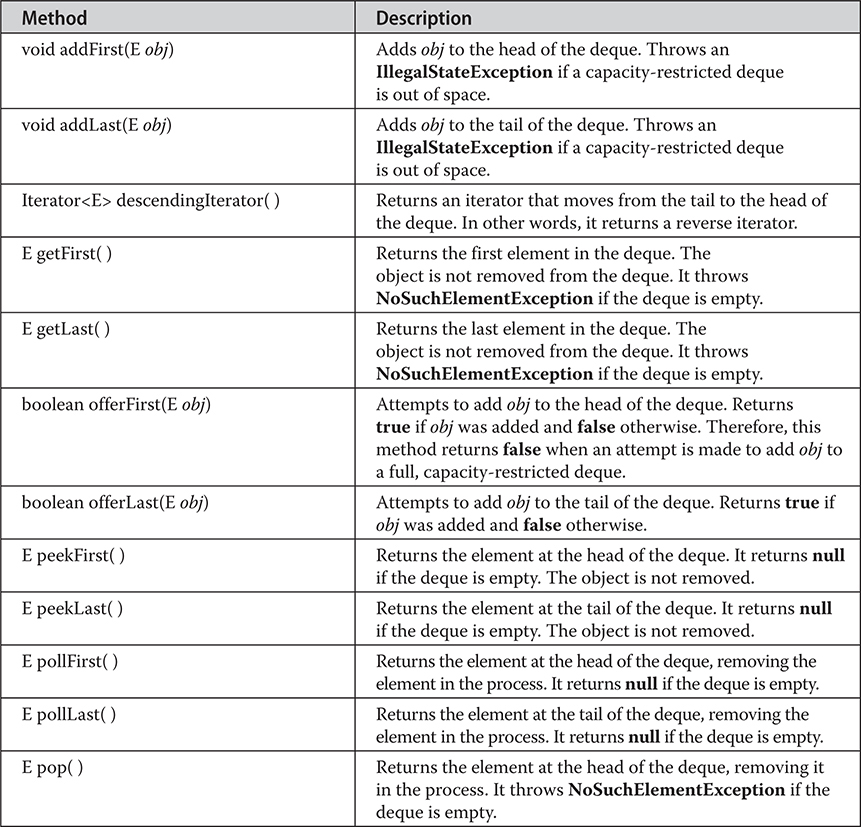
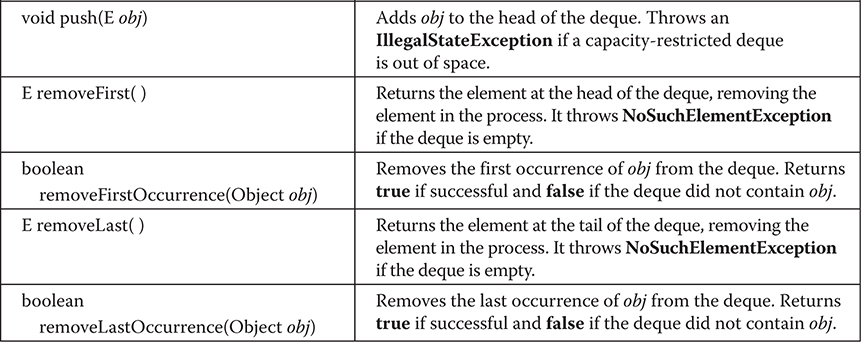
Table 20-6 The Methods Declared by Deque
Notice that Deque includes the methods push( ) and pop( ). These methods enable a Deque to function as a stack. Also, notice the descendingIterator( ) method. It returns an iterator that returns elements in reverse order. In other words, it returns an iterator that moves from the end of the collection to the start. A Deque implementation can be capacity-restricted, which means that only a limited number of elements can be added to the deque. When this is the case, an attempt to add an element to the deque can fail. Deque allows you to handle such a failure in two ways. First, methods such as addFirst( ) and addLast( ) throw an IllegalStateException if a capacity-restricted deque is full. Second, methods such as offerFirst( ) and offerLast( ) return false if the element cannot be added.
Now that you are familiar with the collection interfaces, you are ready to examine the standard classes that implement them. Some of the classes provide full implementations that can be used as-is. Others are abstract, providing skeletal implementations that are used as starting points for creating concrete collections. As a general rule, the collection classes are not synchronized, but as you will see later in this chapter, it is possible to obtain synchronized versions.
The core collection classes are summarized in the following table:
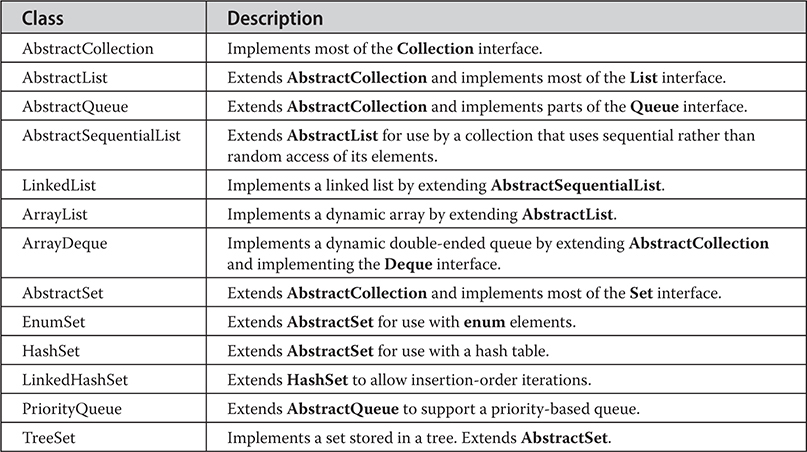
The following sections examine the concrete collection classes and illustrate their use.
Note In addition to the collection classes, several legacy classes, such as Vector, Stack, and Hashtable, have been reengineered to support collections. These are examined later in this chapter.
The ArrayList class extends AbstractList and implements the List interface. ArrayList is a generic class that has this declaration:
class ArrayList<E>
Here, E specifies the type of objects that the list will hold.
ArrayList supports dynamic arrays that can grow as needed. In Java, standard arrays are of a fixed length. After arrays are created, they cannot grow or shrink, which means that you must know in advance how many elements an array will hold. But, sometimes, you may not know until run time precisely how large an array you need. To handle this situation, the Collections Framework defines ArrayList. In essence, an ArrayList is a variable-length array of object references. That is, an ArrayList can dynamically increase or decrease in size. Array lists are created with an initial size. When this size is exceeded, the collection is automatically enlarged. When objects are removed, the array can be shrunk.
Note Dynamic arrays are also supported by the legacy class Vector, which is described later in this chapter.
ArrayList has the constructors shown here:
ArrayList( )
ArrayList(Collection<? extends E> c)
ArrayList(int capacity)
The first constructor builds an empty array list. The second constructor builds an array list that is initialized with the elements of the collection c. The third constructor builds an array list that has the specified initial capacity. The capacity is the size of the underlying array that is used to store the elements. The capacity grows automatically as elements are added to an array list.
The following program shows a simple use of ArrayList. An array list is created for objects of type String, and then several strings are added to it. (Recall that a quoted string is translated into a String object.) The list is then displayed. Some of the elements are removed and the list is displayed again.
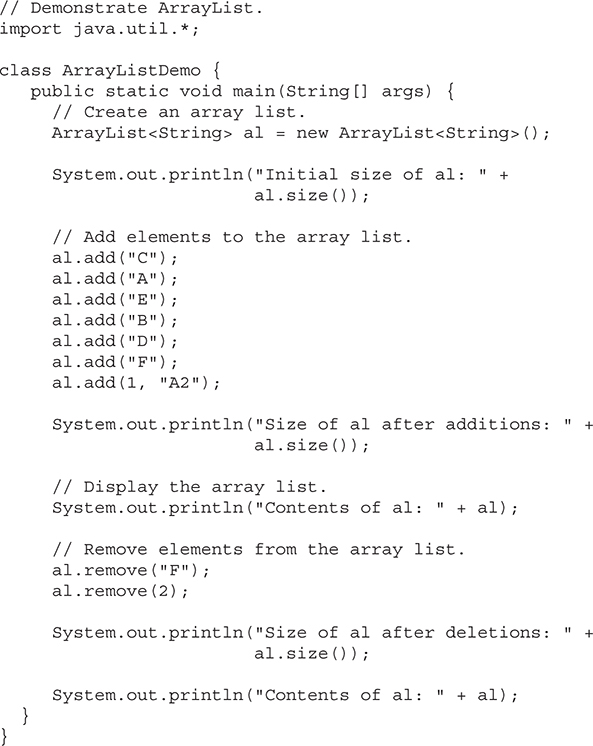
The output from this program is shown here:
Initial size of al: 0
Size of al after additions: 7
Contents of al: [C, A2, A, E, B, D, F]
Size of al after deletions: 5
Contents of al: [C, A2, E, B, D]
Notice that a1 starts out empty and grows as elements are added to it. When elements are removed, its size is reduced.
In the preceding example, the contents of a collection are displayed using the default conversion provided by toString( ), which was inherited from AbstractCollection. Although it is sufficient for short, sample programs, you seldom use this method to display the contents of a real-world collection. Usually, you provide your own output routines. But, for the next few examples, the default output created by toString( ) is sufficient.
Although the capacity of an ArrayList object increases automatically as objects are stored in it, you can increase the capacity of an ArrayList object manually by calling ensureCapacity( ). You might want to do this if you know in advance that you will be storing many more items in the collection than it can currently hold. By increasing its capacity once, at the start, you can prevent several reallocations later. Because reallocations are costly in terms of time, preventing unnecessary ones improves performance. The signature for ensureCapacity( ) is shown here:
void ensureCapacity(int cap)
Here, cap specifies the new minimum capacity of the collection.
Conversely, if you want to reduce the size of the array that underlies an ArrayList object so that it is precisely as large as the number of items that it is currently holding, call trimToSize( ), shown here:
void trimToSize( )
When working with ArrayList, you will sometimes want to obtain an actual array that contains the contents of the list. You can do this by calling toArray( ), which is defined by Collection. Several reasons exist why you might want to convert a collection into an array, such as:
• To obtain faster processing times for certain operations
• To pass an array to a method that is not overloaded to accept a collection
• To integrate collection-based code with legacy code that does not understand collections
Whatever the reason, converting an ArrayList to an array is a trivial matter.
As explained earlier, there are three versions of toArray( ), which are shown again here for your convenience:
object[ ] toArray( )
<T> T[ ] toArray(T[ ] array)
default <T> T[ ] toArray(IntFunction<T[ ]> arrayGen)
The first returns an array of Object. The second and third forms return an array of elements that have the same type as T. Here, we will use the second form because of its convenience. The following program shows it in action.
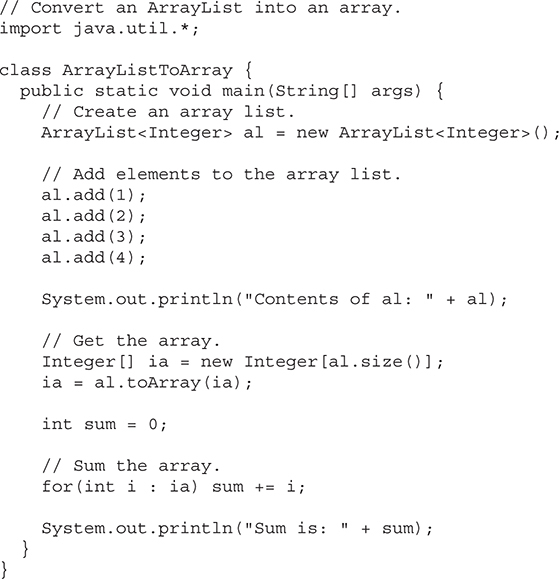
The output from the program is shown here:
Contents of al: [1, 2, 3, 4]
Sum is: 10
The program begins by creating a collection of integers. Next, toArray( ) is called and it obtains an array of Integers. Then, the contents of that array are summed by use of a for-each style for loop.
There is something else of interest in this program. As you know, collections can store only references, not values of primitive types. However, autoboxing makes it possible to pass values of type int to add( ) without having to manually wrap them within an Integer, as the program shows. Autoboxing causes them to be automatically wrapped. In this way, autoboxing significantly improves the ease with which collections can be used to store primitive values.
The LinkedList class extends AbstractSequentialList and implements the List, Deque, and Queue interfaces. It provides a linked-list data structure. LinkedList is a generic class that has this declaration:
class LinkedList<E>
Here, E specifies the type of objects that the list will hold. LinkedList has the two constructors shown here:
LinkedList( )
LinkedList(Collection<? extends E> c)
The first constructor builds an empty linked list. The second constructor builds a linked list that is initialized with the elements of the collection c.
Because LinkedList implements the Deque interface, you have access to the methods defined by Deque. For example, to add elements to the start of a list, you can use addFirst( ) or offerFirst( ). To add elements to the end of the list, use addLast( ) or offerLast( ). To obtain the first element, you can use getFirst( ) or peekFirst( ). To obtain the last element, use getLast( ) or peekLast( ). To remove the first element, use removeFirst( ) or pollFirst( ). To remove the last element, use removeLast( ) or pollLast( ).
The following program illustrates LinkedList:
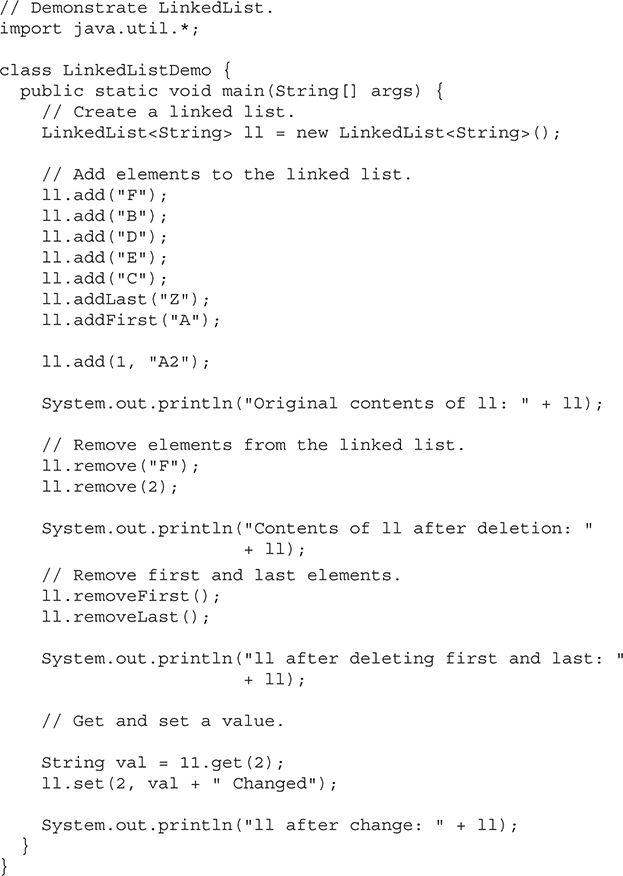
The output from this program is shown here:
Original contents of ll: [A, A2, F, B, D, E, C, Z]
Contents of ll after deletion: [A, A2, D, E, C, Z]
ll after deleting first and last: [A2, D, E, C]
ll after change: [A2, D, E Changed, C]
Because LinkedList implements the List interface, calls to add(E) append items to the end of the list, as do calls to addLast( ). To insert items at a specific location, use the add(int, E) form of add( ), as illustrated by the call to add(1, "A2") in the example.
Notice how the third element in ll is changed by employing calls to get( ) and set( ). To obtain the current value of an element, pass get( ) the index at which the element is stored. To assign a new value to that index, pass set( ) the index and its new value.
HashSet extends AbstractSet and implements the Set interface. It creates a collection that uses a hash table for storage. HashSet is a generic class that has this declaration:
class HashSet<E>
Here, E specifies the type of objects that the set will hold.
As most readers likely know, a hash table stores information by using a mechanism called hashing. In hashing, the informational content of a key is used to determine a unique value, called its hash code. The hash code is then used as the index at which the data associated with the key is stored. The transformation of the key into its hash code is performed automatically—you never see the hash code itself. Also, your code can’t directly index the hash table. The advantage of hashing is that it allows the execution time of add( ), contains( ), remove( ), and size( ) to remain constant even for large sets.
The following constructors are defined:
HashSet( )
HashSet(Collection<? extends E> c)
HashSet(int capacity)
HashSet(int capacity, float fillRatio)
The first form constructs a default hash set. The second form initializes the hash set by using the elements of c. The third form initializes the capacity of the hash set to capacity. (The default capacity is 16.) The fourth form initializes both the capacity and the fill ratio (also called load factor) of the hash set from its arguments. The fill ratio must be between 0.0 and 1.0, and it determines how full the hash set can be before it is resized upward. Specifically, when the number of elements is greater than the capacity of the hash set multiplied by its fill ratio, the hash set is expanded. For constructors that do not take a fill ratio, 0.75 is used.
HashSet does not define any additional methods beyond those provided by its superclasses and interfaces.
It is important to note that HashSet does not guarantee the order of its elements, because the process of hashing doesn’t usually lend itself to the creation of sorted sets. If you need sorted storage, then another collection, such as TreeSet, is a better choice.
Here is an example that demonstrates HashSet:
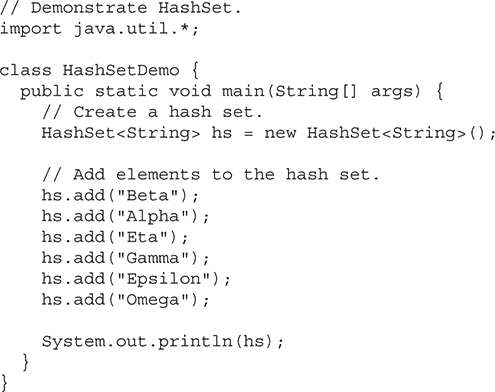
The following is the output from this program:
[Gamma, Eta, Alpha, Epsilon, Omega, Beta]
As explained, the elements are not stored in sorted order, and the precise output may vary.
The LinkedHashSet class extends HashSet and adds no members of its own. It is a generic class that has this declaration:
class LinkedHashSet<E>
Here, E specifies the type of objects that the set will hold. Its constructors parallel those in HashSet.
LinkedHashSet maintains a linked list of the entries in the set, in the order in which they were inserted. This allows insertion-order iteration over the set. That is, when cycling through a LinkedHashSet using an iterator, the elements will be returned in the order in which they were inserted. This is also the order in which they are contained in the string returned by toString( ) when called on a LinkedHashSet object. To see the effect of LinkedHashSet, try substituting LinkedHashSet for HashSet in the preceding program. The output will be
[Beta, Alpha, Eta, Gamma, Epsilon, Omega]
which is the order in which the elements were inserted.
TreeSet extends AbstractSet and implements the NavigableSet interface. It creates a collection that uses a tree for storage. Objects are stored in sorted, ascending order. Access and retrieval times are quite fast, which makes TreeSet an excellent choice when storing large amounts of sorted information that must be found quickly.
TreeSet is a generic class that has this declaration:
class TreeSet<E>
Here, E specifies the type of objects that the set will hold.
TreeSet has the following constructors:
TreeSet( )
TreeSet(Collection<? extends E> c)
TreeSet(Comparator<? super E> comp)
TreeSet(SortedSet<E> ss)
The first form constructs an empty tree set that will be sorted in ascending order according to the natural order of its elements. The second form builds a tree set that contains the elements of c. The third form constructs an empty tree set that will be sorted according to the comparator specified by comp. (Comparators are described later in this chapter.) The fourth form builds a tree set that contains the elements of ss.
Here is an example that demonstrates a TreeSet:
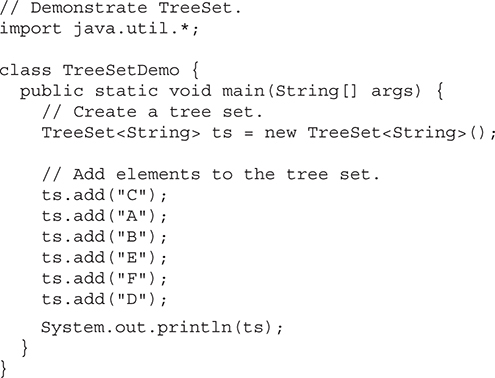
The output from this program is shown here:
[A, B, C, D, E, F]
As explained, because TreeSet stores its elements in a tree, they are automatically arranged in sorted order, as the output confirms.
Because TreeSet implements the NavigableSet interface, you can use the methods defined by NavigableSet to retrieve elements of a TreeSet. For example, assuming the preceding program, the following statement uses subSet( ) to obtain a subset of ts that contains the elements between C (inclusive) and F (exclusive). It then displays the resulting set.
System.out.println(ts.subSet("C", "F"));
The output from this statement is shown here:
[C, D, E]
You might want to experiment with the other methods defined by NavigableSet.
PriorityQueue extends AbstractQueue and implements the Queue interface. It creates a queue that is prioritized based on the queue’s comparator. PriorityQueue is a generic class that has this declaration:
class PriorityQueue<E>
Here, E specifies the type of objects stored in the queue. PriorityQueues are dynamic, growing as necessary.
PriorityQueue defines the seven constructors shown here:
PriorityQueue( )
PriorityQueue(int capacity)
PriorityQueue(Comparator<? super E> comp)
PriorityQueue(int capacity, Comparator<? super E> comp)
PriorityQueue(Collection<? extends E> c)
PriorityQueue(PriorityQueue<? extends E> c)
PriorityQueue(SortedSet<? extends E> c)
The first constructor builds an empty queue. Its starting capacity is 11. The second constructor builds a queue that has the specified initial capacity. The third constructor specifies a comparator, and the fourth builds a queue with the specified capacity and comparator. The last three constructors create queues that are initialized with the elements of the collection passed in c. In all cases, the capacity grows automatically as elements are added.
If no comparator is specified when a PriorityQueue is constructed, then the default comparator for the type of data stored in the queue is used. The default comparator will order the queue in ascending order. Thus, the head of the queue will be the smallest value. However, by providing a custom comparator, you can specify a different ordering scheme. For example, when storing items that include a time stamp, you could prioritize the queue such that the oldest items are first in the queue.
You can obtain a reference to the comparator used by a PriorityQueue by calling its comparator( ) method, shown here:
Comparator<? super E> comparator( )
It returns the comparator. If natural ordering is used for the invoking queue, null is returned.
One word of caution: Although you can iterate through a PriorityQueue using an iterator, the order of that iteration is undefined. To properly use a PriorityQueue, you must call methods such as offer( ) and poll( ), which are defined by the Queue interface.
The ArrayDeque class extends AbstractCollection and implements the Deque interface. It adds no methods of its own. ArrayDeque creates a dynamic array and has no capacity restrictions. (The Deque interface supports implementations that restrict capacity, but does not require such restrictions.) ArrayDeque is a generic class that has this declaration:
class ArrayDeque<E>
Here, E specifies the type of objects stored in the collection.
ArrayDeque defines the following constructors:
ArrayDeque( )
ArrayDeque(int size)
ArrayDeque(Collection<? extends E> c)
The first constructor builds an empty deque. Its starting capacity is 16. The second constructor builds a deque that has the specified initial capacity. The third constructor creates a deque that is initialized with the elements of the collection passed in c. In all cases, the capacity grows as needed to handle the elements added to the deque.
The following program demonstrates ArrayDeque by using it to create a stack:
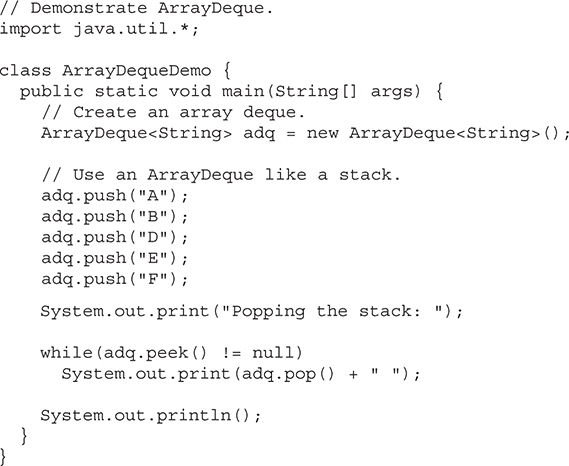
The output is shown here:
Popping the stack: F E D B A
EnumSet extends AbstractSet and implements Set. It is specifically for use with elements of an enum type. It is a generic class that has this declaration:
class EnumSet<E extends Enum<E>>
Here, E specifies the elements. Notice that E must extend Enum<E>, which enforces the requirement that the elements must be of the specified enum type.
EnumSet defines no constructors. Instead, it uses the factory methods shown in Table 20-7 to create objects. All methods can throw NullPointerException. The copyOf( ) and range( ) methods can also throw IllegalArgumentException. Notice that the of( ) method is overloaded a number of times. This is in the interest of efficiency. Passing a known number of arguments can be faster than using a vararg parameter when the number of arguments is small.
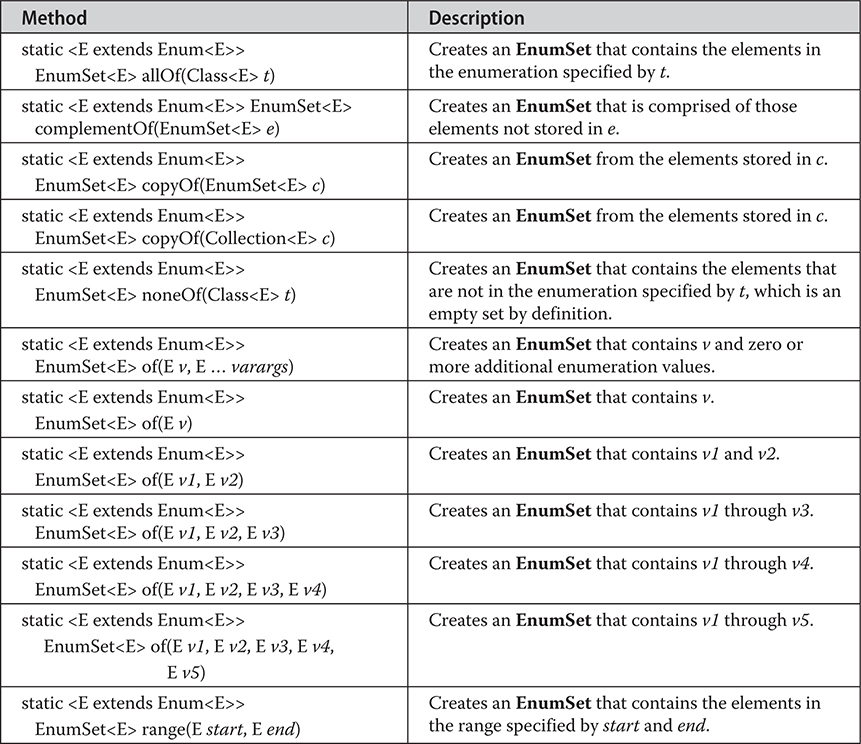
Table 20-7 The Methods Declared by EnumSet
Often, you will want to cycle through the elements in a collection. For example, you might want to display each element. One way to do this is to employ an iterator, which is an object that implements either the Iterator or the ListIterator interface. Iterator enables you to cycle through a collection, obtaining or removing elements. ListIterator extends Iterator to allow bidirectional traversal of a list, and the modification of elements. Iterator and ListIterator are generic interfaces which are declared as shown here:
interface Iterator<E>
interface ListIterator<E>
Here, E specifies the type of objects being iterated. The Iterator interface declares the methods shown in Table 20-8. The methods declared by ListIterator (along with those inherited from Iterator) are shown in Table 20-9. In both cases, operations that modify the underlying collection are optional. For example, remove( ) will throw UnsupportedOperationException when used with a read-only collection. Various other exceptions are possible.
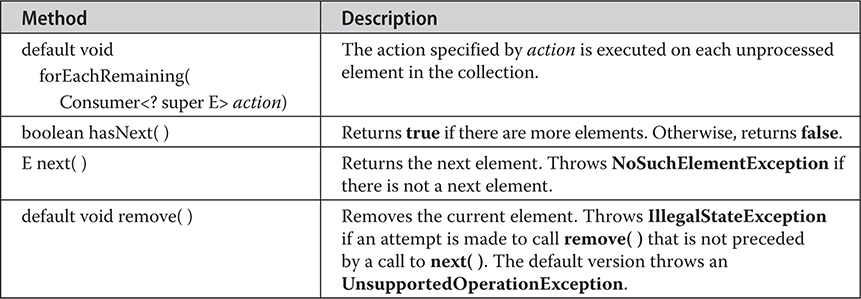
Table 20-8 The Methods Declared by Iterator
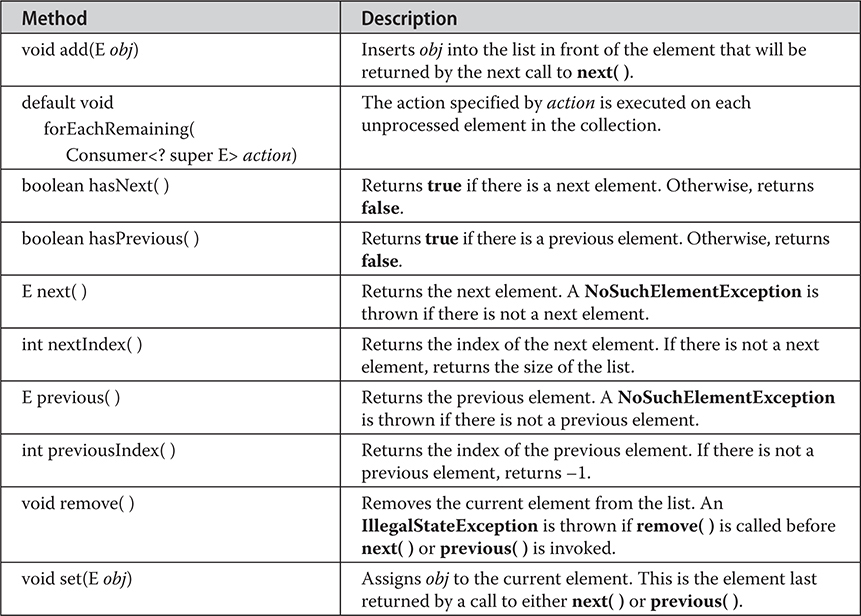
Table 20-9 The Methods Provided by ListIterator
Note You can also use a Spliterator to cycle through a collection. Spliterator works differently than does Iterator, and it is described later in this chapter.
Before you can access a collection through an iterator, you must obtain one. Each of the collection classes provides an iterator( ) method that returns an iterator to the start of the collection. By using this iterator object, you can access each element in the collection, one element at a time. In general, to use an iterator to cycle through the contents of a collection, follow these steps:
1. Obtain an iterator to the start of the collection by calling the collection’s iterator( ) method.
2. Set up a loop that makes a call to hasNext( ). Have the loop iterate as long as hasNext( ) returns true.
3. Within the loop, obtain each element by calling next( ).
For collections that implement List, you can also obtain an iterator by calling listIterator( ). As explained, a list iterator gives you the ability to access the collection in either the forward or backward direction and lets you modify an element. Otherwise, ListIterator is used just like Iterator.
The following example implements these steps, demonstrating both the Iterator and ListIterator interfaces. It uses an ArrayList object, but the general principles apply to any type of collection. Of course, ListIterator is available only to those collections that implement the List interface.
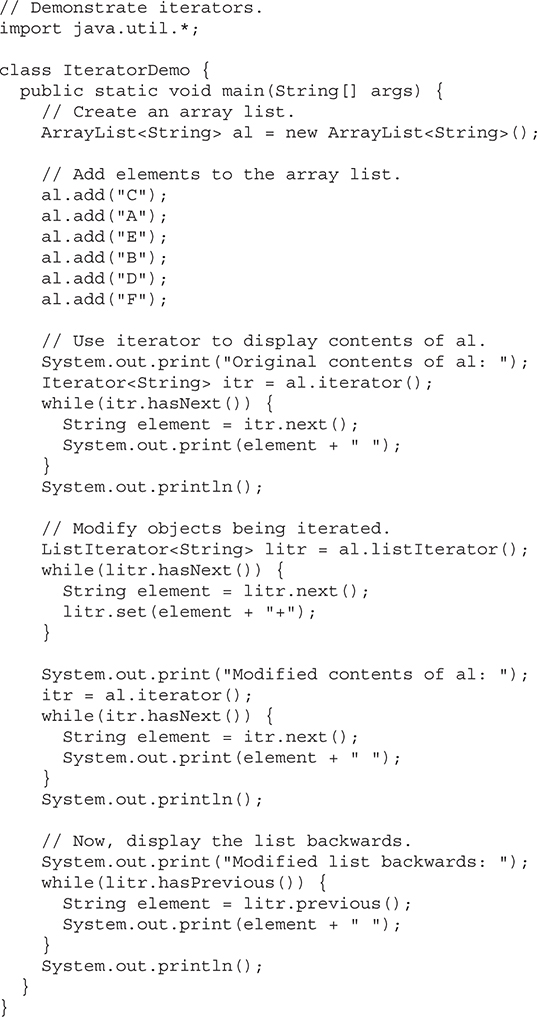
The output is shown here:
Original contents of al: C A E B D F
Modified contents of al: C+ A+ E+ B+ D+ F+
Modified list backwards: F+ D+ B+ E+ A+ C+
Pay special attention to how the list is displayed in reverse. After the list is modified, litr points to the end of the list. (Remember, litr.hasNext( ) returns false when the end of the list has been reached.) To traverse the list in reverse, the program continues to use litr, but this time it checks to see whether it has a previous element. As long as it does, that element is obtained and displayed.
If you won’t be modifying the contents of a collection or obtaining elements in reverse order, then the for-each version of the for loop is often a more convenient alternative to cycling through a collection than is using an iterator. Recall that the for can cycle through any collection of objects that implement the Iterable interface. Because all of the collection classes implement this interface, they can all be operated upon by the for.
The following example uses a for loop to sum the contents of a collection:
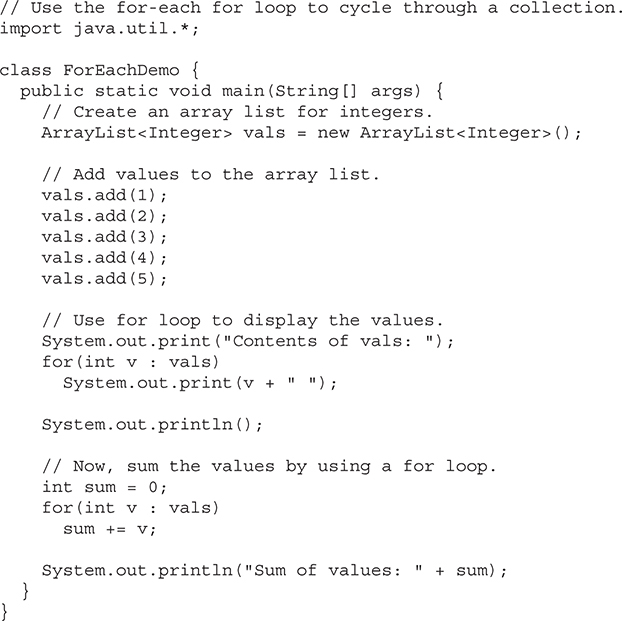
The output from the program is shown here:
Contents of vals: 1 2 3 4 5
Sum of values: 15
As you can see, the for loop is substantially shorter and simpler to use than the iterator-based approach. However, it can only be used to cycle through a collection in the forward direction, and you can’t modify the contents of the collection.
JDK 8 added another type of iterator called a spliterator that is defined by the Spliterator interface. A spliterator cycles through a sequence of elements, and in this regard, it is similar to the iterators just described. However, the techniques required to use it differ. Furthermore, it offers substantially more functionality than does either Iterator or ListIterator. Perhaps the most important aspect of Spliterator is its ability to provide support for parallel iteration of portions of the sequence. Thus, Spliterator supports parallel programming. (See Chapter 29 for information on concurrency and parallel programming.) However, you can use Spliterator even if you won’t be using parallel execution. One reason you might want to do so is because it offers a streamlined approach that combines the hasNext and next operations into one method.
Spliterator is a generic interface that is declared like this:
interface Spliterator<T>
Here, T is the type of elements being iterated. Spliterator declares the methods shown in Table 20-10.
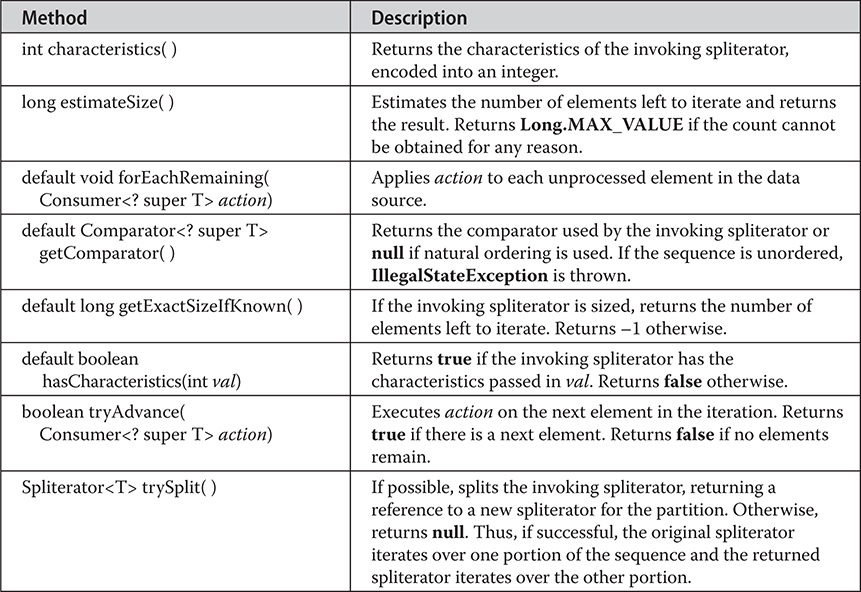
Table 20-10 The Methods Declared by Spliterator
Using Spliterator for basic iteration tasks is quite easy: simply call tryAdvance( ) until it returns false. If you will be applying the same action to each element in the sequence, forEachRemaining( ) offers a streamlined alternative. In both cases, the action that will occur with each iteration is defined by what the Consumer object does with each element. Consumer is a functional interface that applies an action to an object. It is a generic functional interface declared in java.util.function. (See Chapter 21 for information on java.util.function.) Consumer specifies only one abstract method, accept( ), which is shown here:
void accept(T objRef)
In the case of tryAdvance( ), each iteration passes the next element in the sequence to objRef. Often, the easiest way to implement Consumer is by use of a lambda expression.
The following program provides a simple example of Spliterator. Notice that the program demonstrates both tryAdvance( ) and forEachRemaining( ). Also notice how these methods combine the actions of Iterator’s next( ) and hasNext( ) methods into a single call.

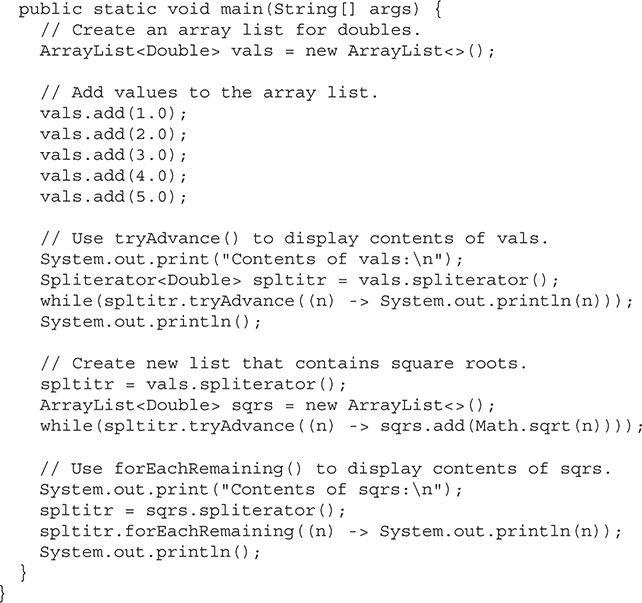
The output is shown here:
Contents of vals:
1.0
2.0
3.0
4.0
5.0
Contents of sqrs:
1.0
1.4142135623730951
1.7320508075688772
2.0
2.23606797749979
Although this program demonstrates the mechanics of using Spliterator, it does not reveal its full power. As mentioned, Spliterator’s maximum benefit is found in situations that involve parallel processing.
In Table 20-10, notice the methods characteristics( ) and hasCharacteristics( ). Each Spliterator has a set of attributes, called characteristics, associated with it. These are defined by static int fields in Spliterator, such as SORTED, DISTINCT, SIZED, and IMMUTABLE, to name a few. You can obtain the characteristics by calling characteristics( ). You can determine if a characteristic is present by calling hasCharacteristics( ). Often, you won’t need to access a Spliterator’s characteristics, but in some cases, they can aid in creating efficient, resilient code.
Note For a further discussion of Spliterator, see Chapter 30, where it is used in the context of the stream API. For a discussion of lambda expressions, see Chapter 15. See Chapter 29 for a discussion of parallel programming and concurrency.
There are several nested subinterfaces of Spliterator designed for use with the primitive types double, int, and long. These are called Spliterator.OfDouble, Spliterator.OfInt, and Spliterator.OfLong. There is also a generalized version called Spliterator.OfPrimitive( ), which offers additional flexibility and serves as a superinterface of the aforementioned ones.
For the sake of simplicity, the foregoing examples have stored built-in objects, such as String or Integer, in a collection. Of course, collections are not limited to the storage of built-in objects. Quite the contrary. The power of collections is that they can store any type of object, including objects of classes that you create. For example, consider the following example that uses a LinkedList to store mailing addresses:
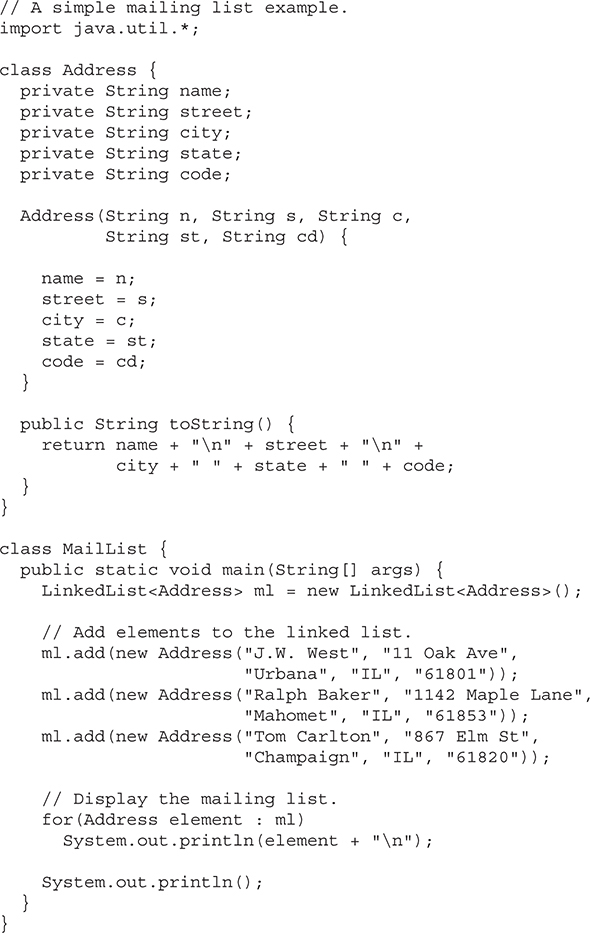
The output from the program is shown here:
J.W. West
11 Oak Ave
Urbana IL 61801
Ralph Baker
1142 Maple Lane
Mahomet IL 61853
Tom Carlton
867 Elm St
Champaign IL 61820
Aside from storing a user-defined class in a collection, another important thing to notice about the preceding program is that it is quite short. When you consider that it sets up a linked list that can store, retrieve, and process mailing addresses in about 50 lines of code, the power of the Collections Framework begins to become apparent. As most readers know, if all of this functionality had to be coded manually, the program would be several times longer. Collections offer off-the-shelf solutions to a wide variety of programming problems. You should use them whenever the situation presents itself.
The RandomAccess interface contains no members. However, by implementing this interface, a collection signals that it supports efficient random access to its elements. Although a collection might support random access, it might not do so efficiently. By checking for the RandomAccess interface, client code can determine at run time whether a collection is suitable for certain types of random access operations—especially as they apply to large collections. (You can use instanceof to determine if a class implements an interface.) RandomAccess is implemented by ArrayList and by the legacy Vector class, among others.
A map is an object that stores associations between keys and values, or key/value pairs. Given a key, you can find its value. Both keys and values are objects. The keys must be unique, but the values may be duplicated. Some maps can accept a null key and null values, others cannot.
There is one key point about maps that is important to mention at the outset: they don’t implement the Iterable interface. This means that you cannot cycle through a map using a for-each style for loop. Furthermore, you can’t obtain an iterator to a map. However, as you will soon see, you can obtain a collection-view of a map, which does allow the use of either the for loop or an iterator.
Because the map interfaces define the character and nature of maps, this discussion of maps begins with them. The following interfaces support maps:

Each interface is examined next, in turn.
The Map interface maps unique keys to values. A key is an object that you use to retrieve a value at a later date. Given a key and a value, you can store the value in a Map object. After the value is stored, you can retrieve it by using its key. Map is generic and is declared as shown here:
interface Map<K, V>
Here, K specifies the type of keys, and V specifies the type of values.
The methods declared by Map are summarized in Table 20-11. Several methods throw a ClassCastException when an object is incompatible with the elements in a map. A NullPointerException is thrown if an attempt is made to use a null object and null is not allowed in the map. An UnsupportedOperationException is thrown when an attempt is made to change an unmodifiable map. An IllegalArgumentException is thrown if an invalid argument is used.
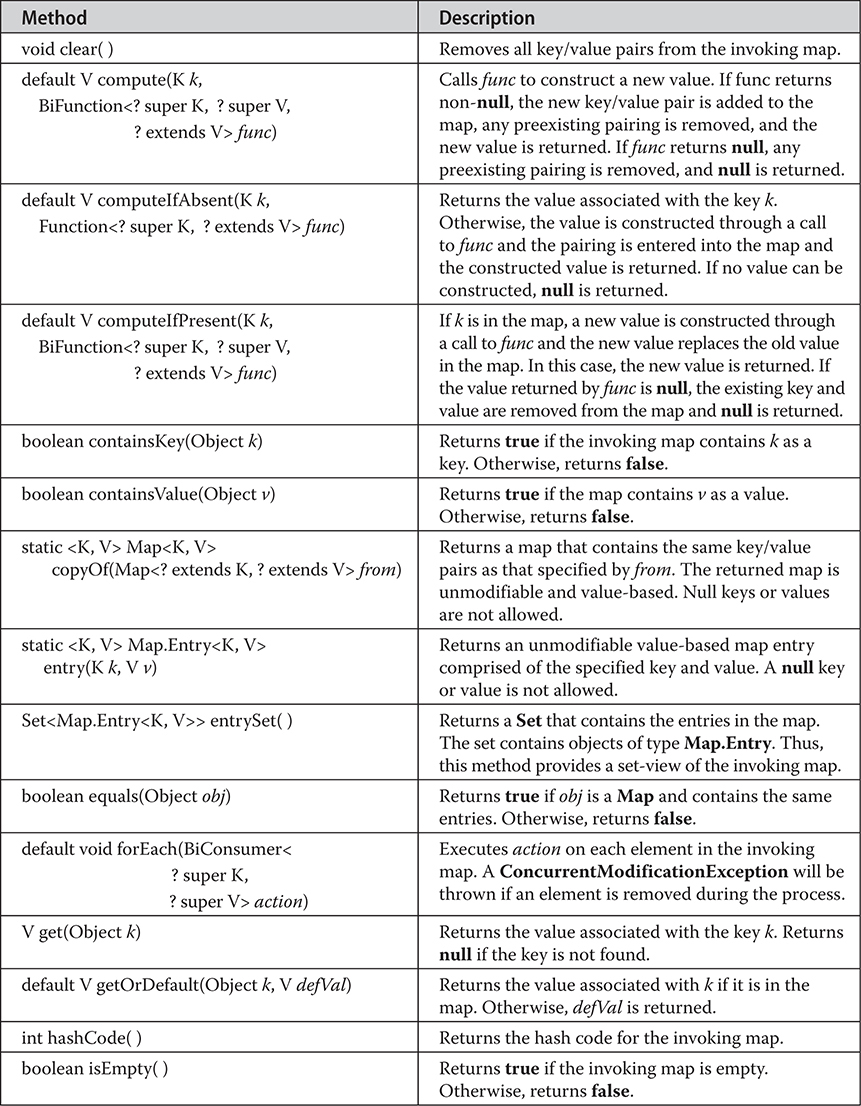
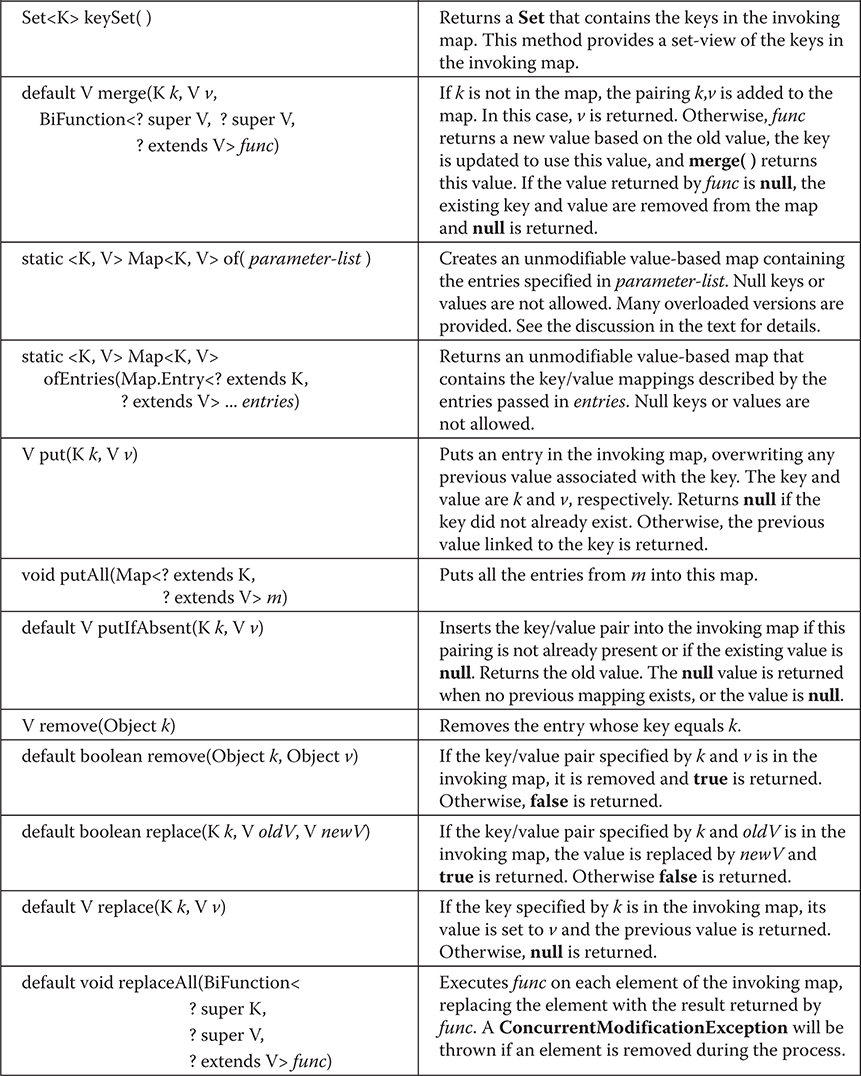

Table 20-11 The Methods Declared by Map
Maps revolve around two basic operations: get( ) and put( ). To put a value into a map, use put( ), specifying the key and the value. To obtain a value, call get( ), passing the key as an argument. The value is returned.
As mentioned earlier, although part of the Collections Framework, maps are not, themselves, collections because they do not implement the Collection interface. However, you can obtain a collection-view of a map. To do this, you can use the entrySet( ) method. It returns a Set that contains the elements in the map. To obtain a collection-view of the keys, use keySet( ). To get a collection-view of the values, use values( ). For all three collection-views, the collection is backed by the map. Changing one affects the other. Collection-views are the means by which maps are integrated into the larger Collections Framework.
Beginning with JDK 9, Map includes the of( ) factory method, which has a number of overloads. Each version returns an unmodifiable, value-based map that is comprised of the arguments that it is passed. The primary purpose of of( ) is to provide a convenient, efficient way to create a small Map. There are 11 overloads of of( ). One takes no arguments and creates an empty map. It is shown here:
static <K, V> Map<K, V> of( )
Ten overloads take from 1 to 10 arguments and create a list that contains the specified elements. They are shown here:
static <K, V> Map<K, V> of(K k1, V v1)
static <K, V> Map<K, V> of(K k1, V v1, K k2, V v2)
static <K, V> Map<K, V> of(K k1, V v1, K k2, V v2, K k3, V v3)
...
static <K, V> Map<K, V> of(K k1, V v1, K k2, V v2, K k3, V v3, K k4, V v4,
K k5, V v5, K k6, V v6, K k7, V v7, K k8, V v8,
K k9, V v9, K k10, V v10)
For all versions, null keys and/or values are not allowed. In all cases, the Map implementation is unspecified.
The SortedMap interface extends Map. It ensures that the entries are maintained in ascending order based on the keys. SortedMap is generic and is declared as shown here:
interface SortedMap<K, V>
Here, K specifies the type of keys, and V specifies the type of values.
The methods added by SortedMap are summarized in Table 20-12. Several methods throw a NoSuchElementException when no items are in the invoking map. A ClassCastException is thrown when an object is incompatible with the elements in a map. A NullPointerException is thrown if an attempt is made to use a null object when null is not allowed in the map. An IllegalArgumentException is thrown if an invalid argument is used.
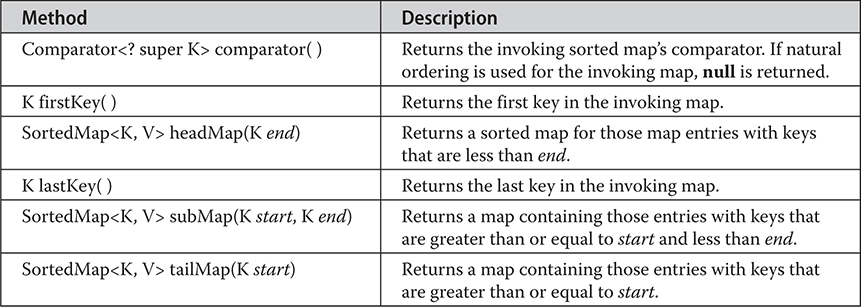
Table 20-12 The Methods Declared by SortedMap
Sorted maps allow very efficient manipulations of submaps (in other words, subsets of a map). To obtain a submap, use headMap( ), tailMap( ), or subMap( ). The submap returned by these methods is backed by the invoking map. Changing one changes the other. To get the first key in the set, call firstKey( ). To get the last key, use lastKey( ).
The NavigableMap interface extends SortedMap and declares the behavior of a map that supports the retrieval of entries based on the closest match to a given key or keys. NavigableMap is a generic interface that has this declaration:
interface NavigableMap<K,V>
Here, K specifies the type of the keys, and V specifies the type of the values associated with the keys. In addition to the methods that it inherits from SortedMap, NavigableMap adds those summarized in Table 20-13. Several methods throw a ClassCastException when an object is incompatible with the keys in the map. A NullPointerException is thrown if an attempt is made to use a null object and null keys are not allowed in the set. An IllegalArgumentException is thrown if an invalid argument is used.
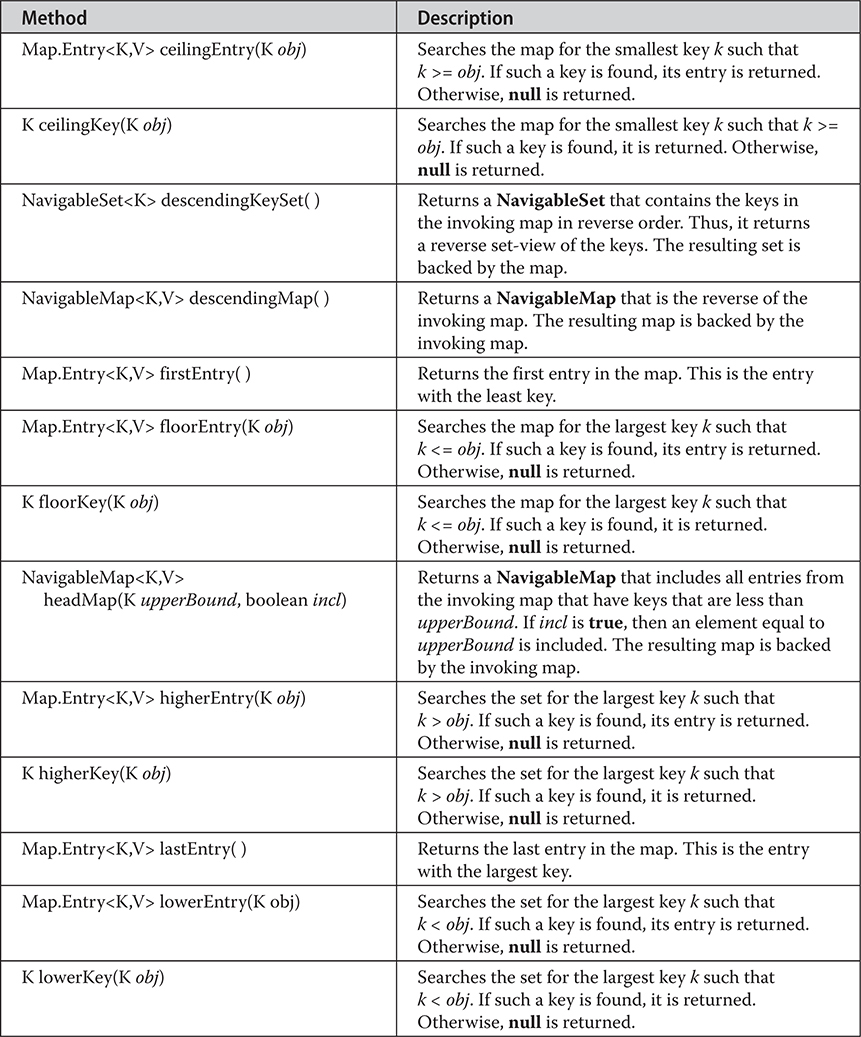
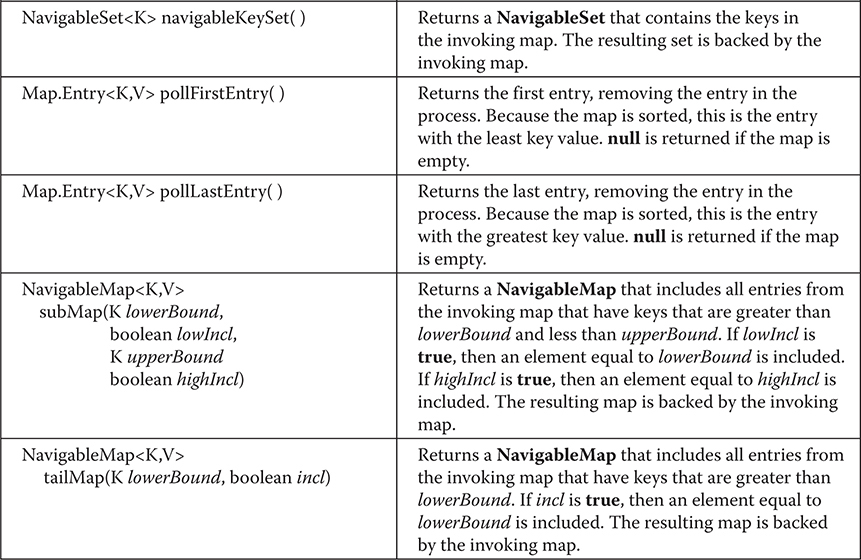
Table 20-13 The Methods Declared by NavigableMap
The Map.Entry interface enables you to work with a map entry. For example, recall that the entrySet( ) method declared by the Map interface returns a Set containing the map entries. Each of these set elements is a Map.Entry object. Map.Entry is generic and is declared like this:
interface Map.Entry<K, V>
Here, K specifies the type of keys, and V specifies the type of values. Table 20-14 summarizes the non-static methods declared by Map.Entry. It also has three static methods. The first is comparingByKey( ), which returns a Comparator that compares entries by key. The second is comparingByValue( ), which returns a Comparator that compares entries by value. The third is copyOf( ), added by JDK 17. It returns an unmodifiable value-based object that is a copy of the invoking object, but is not a part of a map.
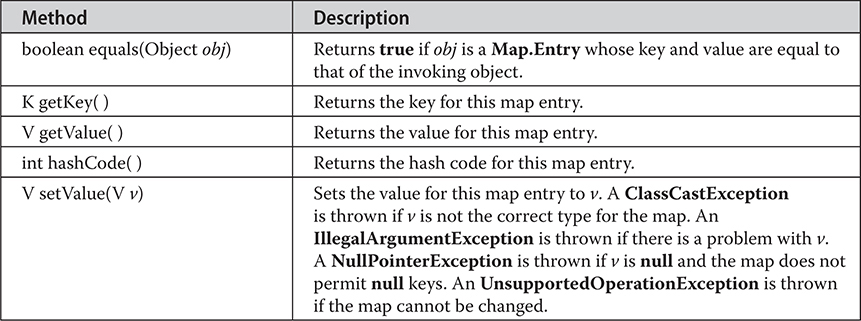
Table 20-14 The Non-Static Methods Declared by Map.Entry
Several classes provide implementations of the map interfaces. The classes that can be used for maps are summarized here:
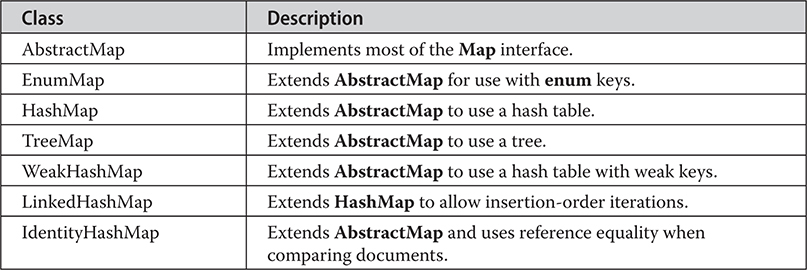
Notice that AbstractMap is a superclass for all concrete map implementations.
WeakHashMap implements a map that uses “weak keys,” which allows an element in a map to be garbage-collected when its key is otherwise unused. This class is not discussed further here. The other map classes are described next.
The HashMap class extends AbstractMap and implements the Map interface. It uses a hash table to store the map. This allows the execution time of get( ) and put( ) to remain constant even for large sets. HashMap is a generic class that has this declaration:
class HashMap<K, V>
Here, K specifies the type of keys, and V specifies the type of values.
The following constructors are defined:
HashMap( )
HashMap(Map<? extends K, ? extends V> m)
HashMap(int capacity)
HashMap(int capacity, float fillRatio)
The first form constructs a default hash map. The second form initializes the hash map by using the elements of m. The third form initializes the capacity of the hash map to capacity. The fourth form initializes both the capacity and fill ratio of the hash map by using its arguments. The meaning of capacity and fill ratio is the same as for HashSet, described earlier. The default capacity is 16. The default fill ratio is 0.75.
HashMap implements Map and extends AbstractMap. It does not add any methods of its own.
You should note that a hash map does not guarantee the order of its elements. Therefore, the order in which elements are added to a hash map is not necessarily the order in which they are read by an iterator.
The following program illustrates HashMap. It maps names to account balances. Notice how a set-view is obtained and used.
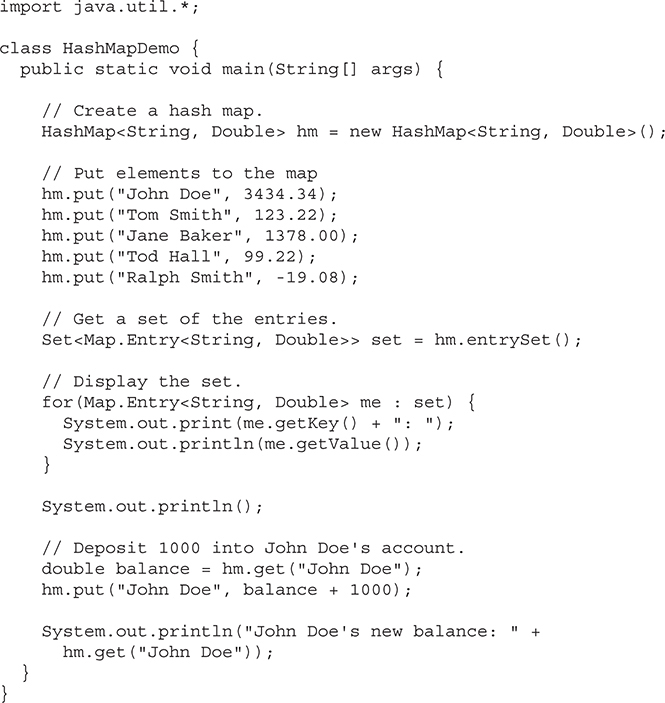
Output from this program is shown here (the precise order may vary):
Ralph Smith: -19.08
Tom Smith: 123.22
John Doe: 3434.34
Tod Hall: 99.22
Jane Baker: 1378.0
John Doe's new balance: 4434.34
The program begins by creating a hash map and then adds the mapping of names to balances. Next, the contents of the map are displayed by using a set-view, obtained by calling entrySet( ). The keys and values are displayed by calling the getKey( ) and getValue( ) methods that are defined by Map.Entry. Pay close attention to how the deposit is made into John Doe’s account. The put( ) method automatically replaces any preexisting value that is associated with the specified key with the new value. Thus, after John Doe’s account is updated, the hash map will still contain just one "John Doe" account.
The TreeMap class extends AbstractMap and implements the NavigableMap interface. It creates maps stored in a tree structure. A TreeMap provides an efficient means of storing key/value pairs in sorted order and allows rapid retrieval. You should note that, unlike a hash map, a tree map guarantees that its elements will be sorted in ascending key order. TreeMap is a generic class that has this declaration:
class TreeMap<K, V>
Here, K specifies the type of keys, and V specifies the type of values.
The following TreeMap constructors are defined:
TreeMap( )
TreeMap(Comparator<? super K> comp)
TreeMap(Map<? extends K, ? extends V> m)
TreeMap(SortedMap<K, ? extends V> sm)
The first form constructs an empty tree map that will be sorted by using the natural order of its keys. The second form constructs an empty tree-based map that will be sorted by using the Comparator comp. (Comparators are discussed later in this chapter.) The third form initializes a tree map with the entries from m, which will be sorted by using the natural order of the keys. The fourth form initializes a tree map with the entries from sm, which will be sorted in the same order as sm.
TreeMap has no map methods beyond those specified by the NavigableMap interface and the AbstractMap class.
The following program reworks the preceding example so that it uses TreeMap:
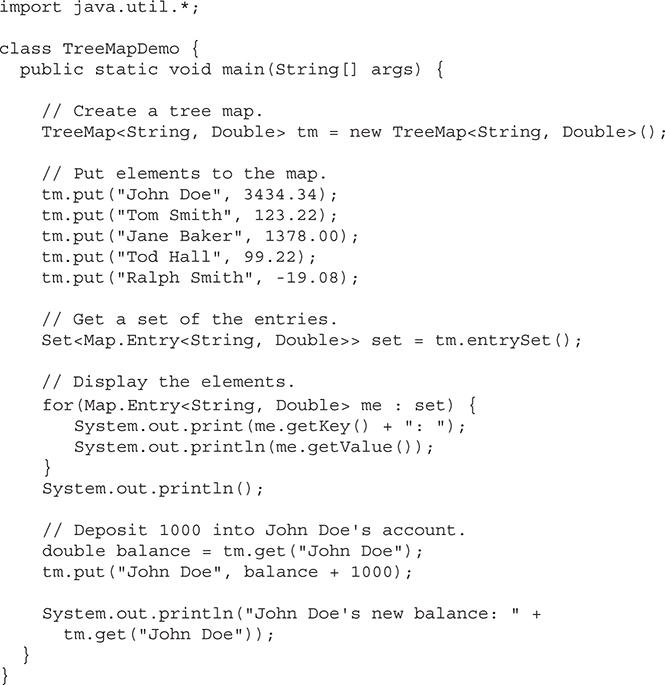
The following is the output from this program:
Jane Baker: 1378.0
John Doe: 3434.34
Ralph Smith: -19.08
Todd Hall: 99.22
Tom Smith: 123.22
John Doe's current balance: 4434.34
Notice that TreeMap sorts the keys. However, in this case, they are sorted by first name instead of last name. You can alter this behavior by specifying a comparator when the map is created, as described shortly.
LinkedHashMap extends HashMap. It maintains a linked list of the entries in the map, in the order in which they were inserted. This allows insertion-order iteration over the map. That is, when iterating through a collection-view of a LinkedHashMap, the elements will be returned in the order in which they were inserted. You can also create a LinkedHashMap that returns its elements in the order in which they were last accessed. LinkedHashMap is a generic class that has this declaration:
class LinkedHashMap<K, V>
Here, K specifies the type of keys, and V specifies the type of values.
LinkedHashMap defines the following constructors:
LinkedHashMap( )
LinkedHashMap(Map<? extends K, ? extends V> m)
LinkedHashMap(int capacity)
LinkedHashMap(int capacity, float fillRatio)
LinkedHashMap(int capacity, float fillRatio, boolean Order)
The first form constructs a default LinkedHashMap. The second form initializes the LinkedHashMap with the elements from m. The third form initializes the capacity. The fourth form initializes both capacity and fill ratio. The meaning of capacity and fill ratio are the same as for HashMap. The default capacity is 16. The default ratio is 0.75. The last form allows you to specify whether the elements will be stored in the linked list by insertion order, or by order of last access. If Order is true, then access order is used. If Order is false, then insertion order is used.
LinkedHashMap adds only one method to those defined by HashMap. This method is removeEldestEntry( ), and it is shown here:
protected boolean removeEldestEntry(Map.Entry<K, V> e)
This method is called by put( ) and putAll( ). The oldest entry is passed in e. By default, this method returns false and does nothing. However, if you override this method, then you can have the LinkedHashMap remove the oldest entry in the map. To do this, have your override return true. To keep the oldest entry, return false.
IdentityHashMap extends AbstractMap and implements the Map interface. It is similar to HashMap except that it uses reference equality when comparing elements. IdentityHashMap is a generic class that has this declaration:
class IdentityHashMap<K, V>
Here, K specifies the type of key, and V specifies the type of value. The API documentation explicitly states that IdentityHashMap is not for general use.
EnumMap extends AbstractMap and implements Map. It is specifically for use with keys of an enum type. It is a generic class that has this declaration:
class EnumMap<K extends Enum<K>, V>
Here, K specifies the type of key, and V specifies the type of value. Notice that K must extend Enum<K>, which enforces the requirement that the keys must be of an enum type.
EnumMap defines the following constructors:
EnumMap(Class<K> kType)
EnumMap(Map<K, ? extends V> m)
EnumMap(EnumMap<K, ? extends V> em)
The first constructor creates an empty EnumMap of type kType. The second creates an EnumMap map that contains the same entries as m. The third creates an EnumMap initialized with the values in em.
EnumMap defines no methods of its own.
Both TreeSet and TreeMap store elements in sorted order. However, it is the comparator that defines precisely what “sorted order” means. By default, these classes store their elements by using what Java refers to as “natural ordering,” which is usually the ordering that you would expect (A before B, 1 before 2, and so forth). If you want to order elements a different way, then specify a Comparator when you construct the set or map. Doing so gives you the ability to govern precisely how elements are stored within sorted collections and maps.
Comparator is a generic interface that has this declaration:
interface Comparator<T>
Here, T specifies the type of objects being compared.
Prior to JDK 8, the Comparator interface defined only two methods: compare( ) and equals( ). The compare( ) method, shown here, compares two elements for order:
int compare(T obj1, T obj2)
obj1 and obj2 are the objects to be compared. Normally, this method returns zero if the objects are equal. It returns a positive value if obj1 is greater than obj2. Otherwise, a negative value is returned. The method can throw a ClassCastException if the types of the objects are not compatible for comparison. By implementing compare( ), you can alter the way that objects are ordered. For example, to sort in reverse order, you can create a comparator that reverses the outcome of a comparison.
The equals( ) method, shown here, tests whether an object equals the invoking comparator:
boolean equals(object obj)
Here, obj is the object to be tested for equality. The method returns true if obj and the invoking object are both Comparator objects and use the same ordering. Otherwise, it returns false. Overriding equals( ) is not necessary, and most simple comparators will not do so.
For many years, the preceding two methods were the only methods defined by Comparator. With the release of JDK 8, the situation dramatically changed. JDK 8 added significant new functionality to Comparator through the use of default and static interface methods. Each is described here.
You can obtain a comparator that reverses the ordering of the comparator on which it is called by using reversed( ), shown here:
default Comparator<T> reversed( )
It returns the reverse comparator. For example, assuming a comparator that uses natural ordering for the characters A through Z, a reverse order comparator would put B before A, C before B, and so on.
A method related to reversed( ) is reverseOrder( ), shown next:
static <T extends Comparable<? super T>> Comparator<T> reverseOrder( )
It returns a comparator that reverses the natural order of the elements. Conversely, you can obtain a comparator that uses natural ordering by calling the static method naturalOrder( ), shown next:
static <T extends Comparable<? super T>> Comparator<T> naturalOrder( )
If you want a comparator that can handle null values, use nullsFirst( ) or nullsLast( ), shown here:
static <T> Comparator<T> nullsFirst(Comparator<? super T> comp)
static <T> Comparator<T> nullsLast(Comparator<? super T> comp)
The nullsFirst( ) method returns a comparator that views null values as less than other values. The nullsLast( ) method returns a comparator that views null values as greater than other values. In both cases, if the two values being compared are non-null, comp performs the comparison. If comp is passed null, then all non-null values are viewed as equivalent.
Another default method is thenComparing( ). It returns a comparator that performs a second comparison when the outcome of the first comparison indicates that the objects being compared are equal. Thus, it can be used to create a “compare by X then compare by Y” sequence. For example, when comparing cities, the first comparison might compare names, with the second comparison comparing states. (Therefore, Springfield, Illinois, would come before Springfield, Missouri, assuming normal, alphabetical order.) The thenComparing( ) method has three forms. The first, shown here, lets you specify the second comparator by passing an instance of Comparator:
default Comparator<T> thenComparing(Comparator<? super T> thenByComp)
Here, thenByComp specifies the comparator that is called if the first comparison returns equal.
The next versions of thenComparing( ) let you specify the standard functional interface Function (defined by java.util.function). They are shown here:
default <U extends Comparable<? super U> Comparator<T>
thenComparing(Function<? super T, ? extends U> getKey)
default <U> Comparator<T>
thenComparing(Function<? super T, ? extends U> getKey,
Comparator<? super U> keyComp)
In both, getKey refers to function that obtains the next comparison key, which is used if the first comparison returns equal. In the second version, keyComp specifies the comparator used to compare keys. (Here, and in subsequent uses, U specifies the type of the key.)
Comparator also adds the following specialized versions of “then comparing” methods for the primitive types:
default Comparator<T>
thenComparingDouble(ToDoubleFunction<? super T> getKey)
default Comparator<T>
thenComparingInt(ToIntFunction<? super T> getKey)
default Comparator<T>
thenComparingLong(ToLongFunction<? super T> getKey)
In all methods, getKey refers to a function that obtains the next comparison key.
Finally, Comparator has a method called comparing( ). It returns a comparator that obtains its comparison key from a function passed to the method. There are two versions of comparing( ), shown here:
static <T, U extends Comparable<? super U>> Comparator<T>
comparing(Function<? super T, ? extends U> getKey)
static <T, U> Comparator<T>
comparing(Function<? super T, ? extends U> getKey,
Comparator<? super U> keyComp)
In both, getKey refers to a function that obtains the next comparison key. In the second version, keyComp specifies the comparator used to compare keys. Comparator also adds the following specialized versions of these methods for the primitive types:
static <T> Comparator<T>
comparingDouble(ToDoubleFunction<? super T> getKey)
static <T> Comparator<T>
comparingInt(ToIntFunction<? super T> getKey)
static <T> Comparator<T>
comparingLong(ToLongFunction<? super T> getKey)
In all methods, getKey refers to a function that obtains the next comparison key.
The following is an example that demonstrates the power of a custom comparator. It implements the compare( ) method for strings that operates in reverse of normal. Thus, it causes a tree set to be sorted in reverse order.
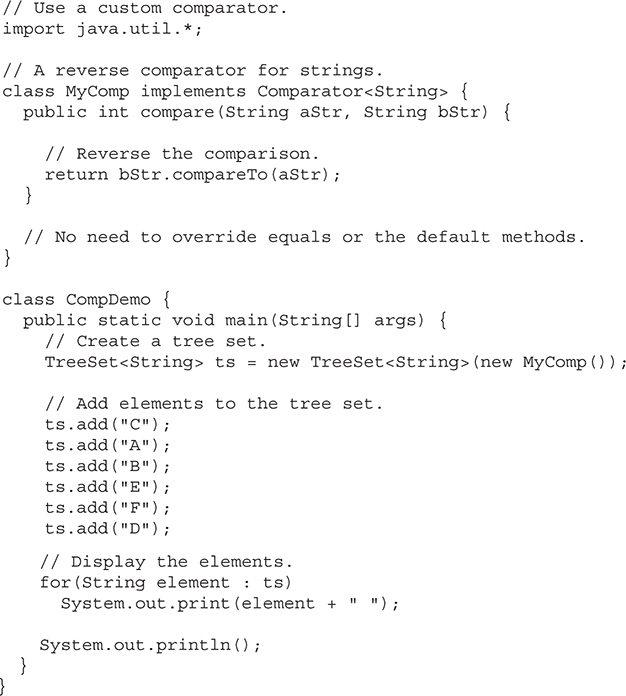
As the following output shows, the tree is now sorted in reverse order:
F E D C B A
Look closely at the MyComp class, which implements Comparator by implementing compare( ). (As explained earlier, overriding equals( ) is neither necessary nor common. It is also not necessary to override the default methods.) Inside compare( ), the String method compareTo( ) compares the two strings. However, bStr—not aStr—invokes compareTo( ). This causes the outcome of the comparison to be reversed.
Although the way in which the reverse order comparator is implemented by the preceding program is perfectly adequate, there is another way to approach a solution. It is now possible to simply call reversed( ) on a natural-order comparator. It will return an equivalent comparator, except that it runs in reverse. For example, assuming the preceding program, you can rewrite MyComp as a natural-order comparator, as shown here:

Next, you can use the following sequence to create a TreeSet that orders its string elements in reverse:
MyComp mc = new MyComp(); // Create a comparator
// Pass a reverse order version of MyComp to TreeSet.
TreeSet<String> ts = new TreeSet<String>(mc.reversed());
If you plug this new code into the preceding program, it will produce the same results as before. In this case, there is no advantage gained by using reversed( ). However, in cases in which you need to create both a natural-order comparator and a reversed comparator, then using reversed( ) gives you an easy way to obtain the reverse-order comparator without having to code it explicitly.
It is not actually necessary to create the MyComp class in the preceding examples because a lambda expression can be easily used instead. For example, you can remove the MyComp class entirely and create the string comparator by using this statement:
// Use a lambda expression to implement Comparator<String>.
Comparator<String> mc = (aStr, bStr) -> aStr.compareTo(bStr);
One other point: in this simple example, it would also be possible to specify a reverse comparator via a lambda expression directly in the call to the TreeSet( ) constructor, as shown here:

By making these changes, the program is substantially shortened, as its final version shown here illustrates:
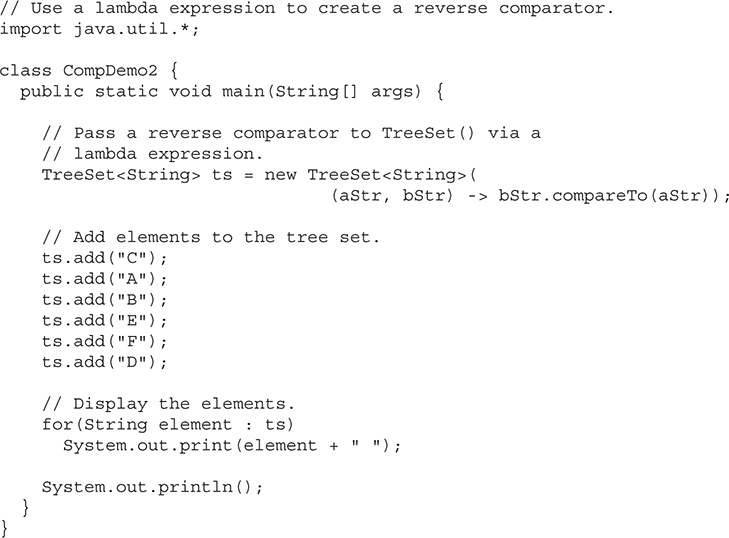
For a more practical example that uses a custom comparator, the following program is an updated version of the TreeMap program shown earlier that stores account balances. In the previous version, the accounts were sorted by name, but the sorting began with the first name. The following program sorts the accounts by last name. To do so, it uses a comparator that compares the last name of each account. This results in the map being sorted by last name.
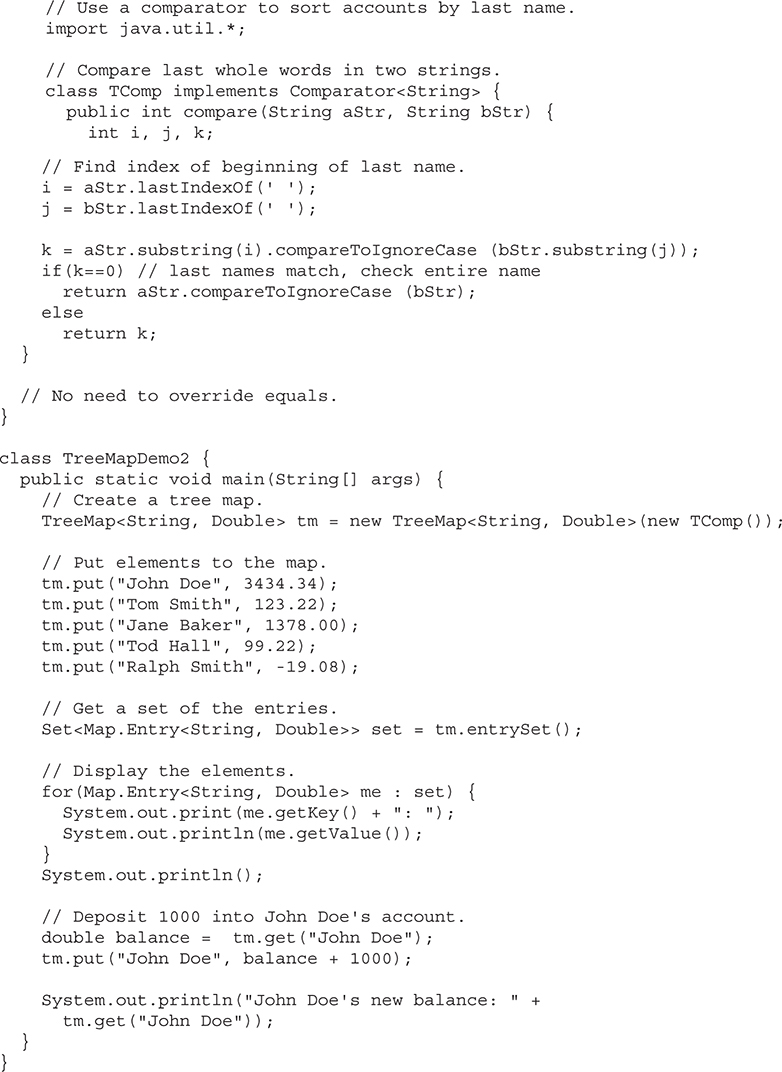
Here is the output; notice that the accounts are now sorted by last name:
Jane Baker: 1378.0
John Doe: 3434.34
Todd Hall: 99.22
Ralph Smith: -19.08
Tom Smith: 123.22
John Doe's new balance: 4434.34
The comparator class TComp compares two strings that hold first and last names. It does so by first comparing last names. To do this, it finds the index of the last space in each string and then compares the substrings of each element that begin at that point. In cases where last names are equivalent, the first names are then compared. This yields a tree map that is sorted by last name, and within last name by first name. You can see this because Ralph Smith comes before Tom Smith in the output.
There is another way that you could code the preceding program so the map is sorted by last name and then by first name. This approach uses the thenComparing( ) method. Recall that thenComparing( ) lets you specify a second comparator that will be used if the invoking comparator returns equal. This approach is put into action by the following program, which reworks the preceding example to use thenComparing( ):
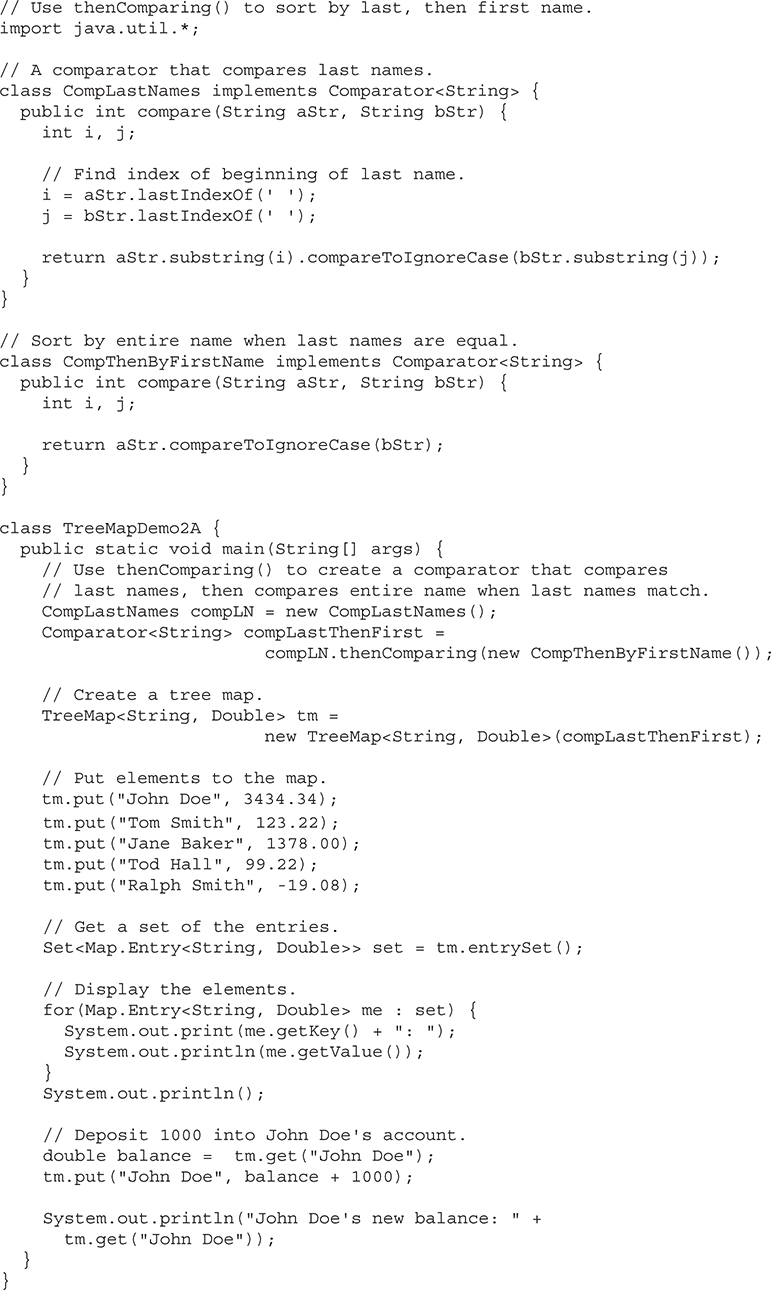
This version produces the same output as before. It differs only in how it accomplishes its job. To begin, notice that a comparator called CompLastNames is created. This comparator compares only the last names. A second comparator, called CompThenByFirstName, compares the entire name, starting with the first name. Next, the TreeMap is created by the following sequence:

Here, the primary comparator is compLN. It is an instance of CompLastNames. On it is called thenComparing( ), passing in an instance of CompThenByFirstName. The result is assigned to the comparator called compLastThenFirst. This comparator is used to construct the TreeMap, as shown here:

Now, whenever the last names of the items being compared are equal, the entire name, beginning with the first name, is used to order the two. This means that names are ordered based on last name, and within last names, by first names.
One last point: in the interest of clarity, this example explicitly creates two comparator classes called CompLastNames and ThenByFirstNames, but lambda expressions could have been used instead. You might want to try this on your own. Just follow the same general approach described for the CompDemo2 example shown earlier.
The Collections Framework defines several algorithms that can be applied to collections and maps. These algorithms are defined as static methods within the Collections class. They are summarized in Table 20-15.
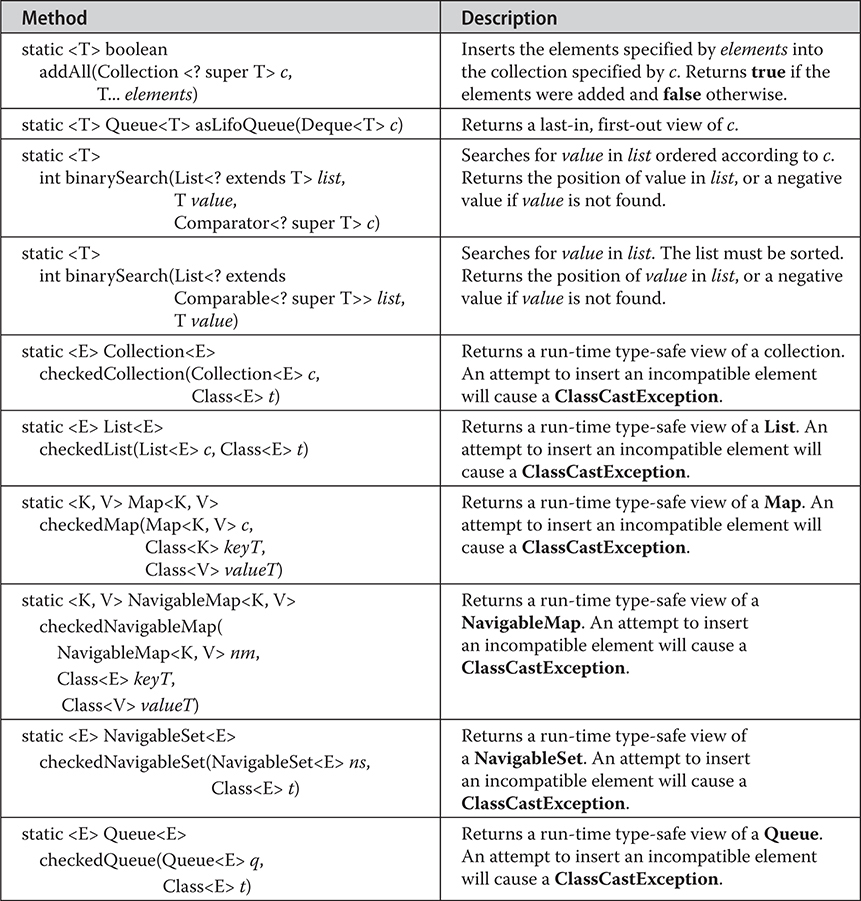
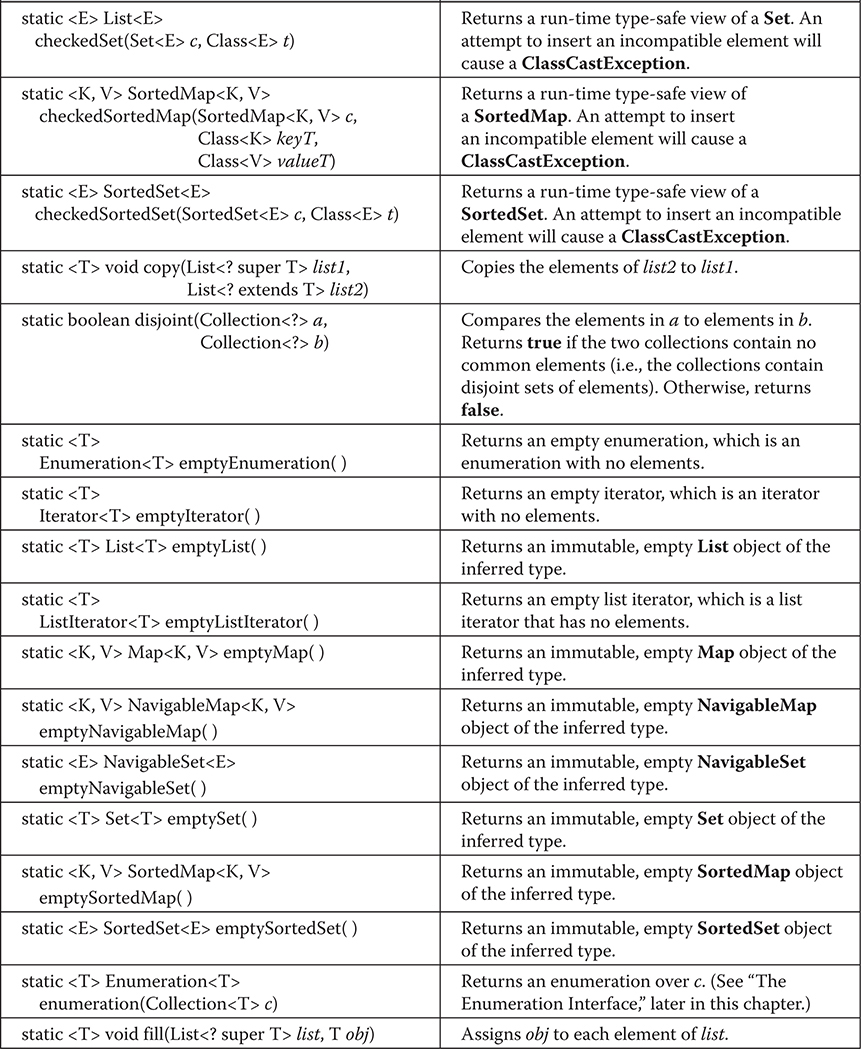
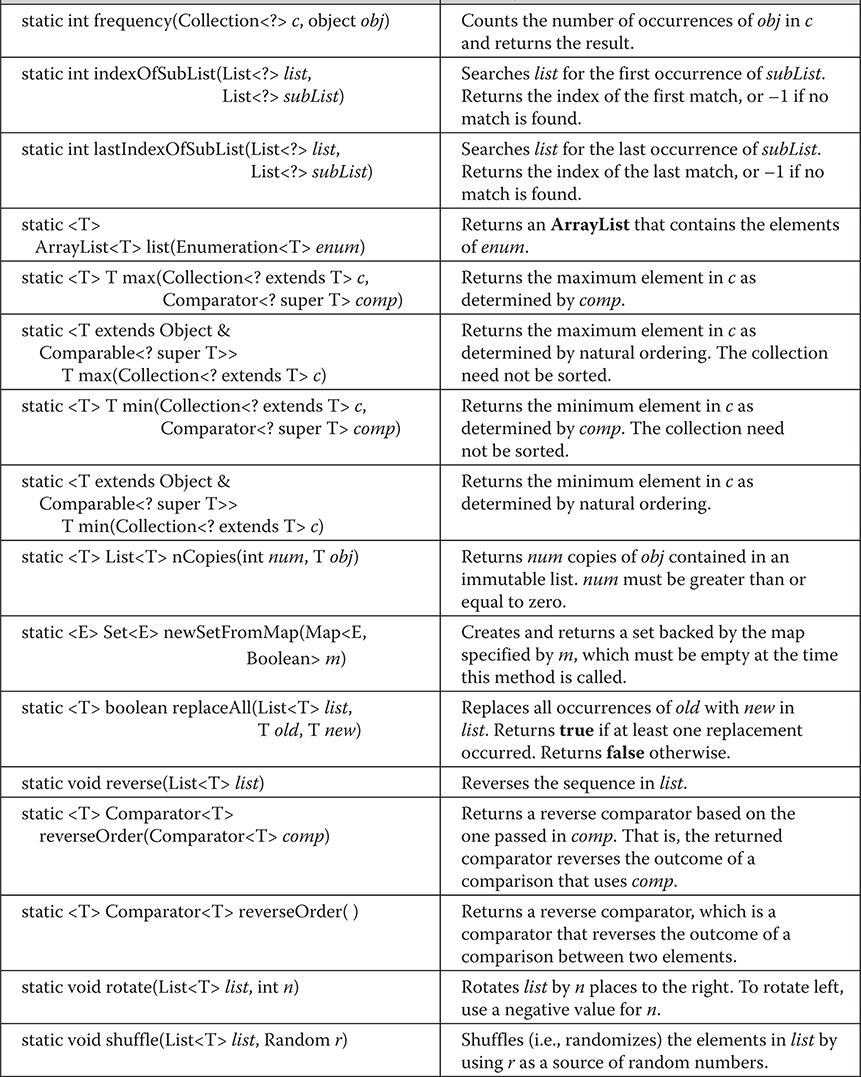
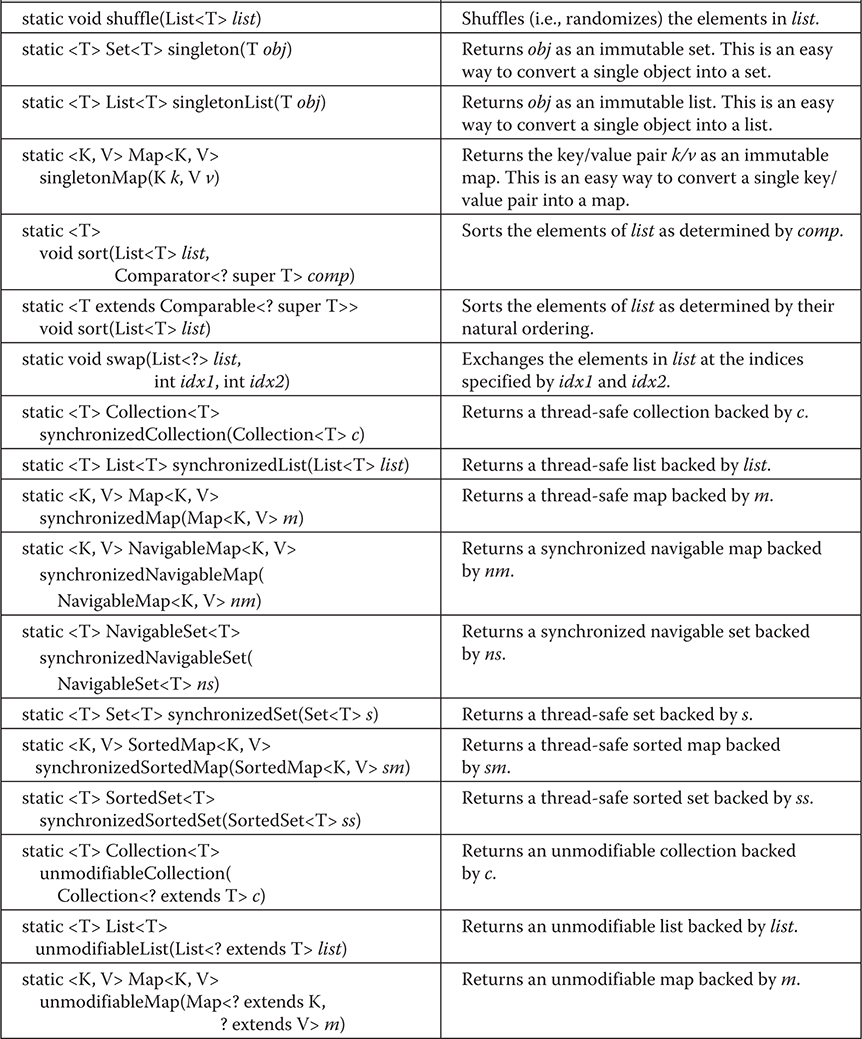
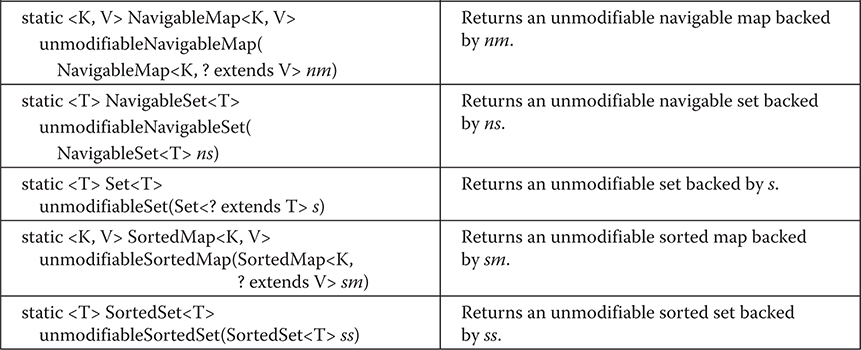
Table 20-15 The Algorithms Defined by Collections
Several of the methods can throw a ClassCastException, which occurs when an attempt is made to compare incompatible types, or an UnsupportedOperationException, which occurs when an attempt is made to modify an unmodifiable collection. Other exceptions are possible, depending on the method.
One thing to pay special attention to is the set of checked methods, such as checkedCollection( ), which returns what the API documentation refers to as a “dynamically typesafe view” of a collection. This view is a reference to the collection that monitors insertions into the collection for type compatibility at run time. An attempt to insert an incompatible element will cause a ClassCastException. Using such a view is especially helpful during debugging because it ensures that the collection always contains valid elements. Related methods include checkedSet( ), checkedList( ), checkedMap( ), and so on. They obtain a type-safe view for the indicated collection.
Notice that several methods, such as synchronizedList( ) and synchronizedSet( ), are used to obtain synchronized (thread-safe) copies of the various collections. As a general rule, the standard collections implementations are not synchronized. You must use the synchronization algorithms to provide synchronization. One other point: iterators to synchronized collections must be used within synchronized blocks.
The set of methods that begins with unmodifiable returns views of the various collections that cannot be modified. These will be useful when you want to grant some process read—but not write—capabilities on a collection.
Collections defines three static variables: EMPTY_SET, EMPTY_LIST, and EMPTY_MAP. All are immutable.
The following program demonstrates some of the algorithms. It creates and initializes a linked list. The reverseOrder( ) method returns a Comparator that reverses the comparison of Integer objects. The list elements are sorted according to this comparator and then are displayed. Next, the list is randomized by calling shuffle( ), and then its minimum and maximum values are displayed.
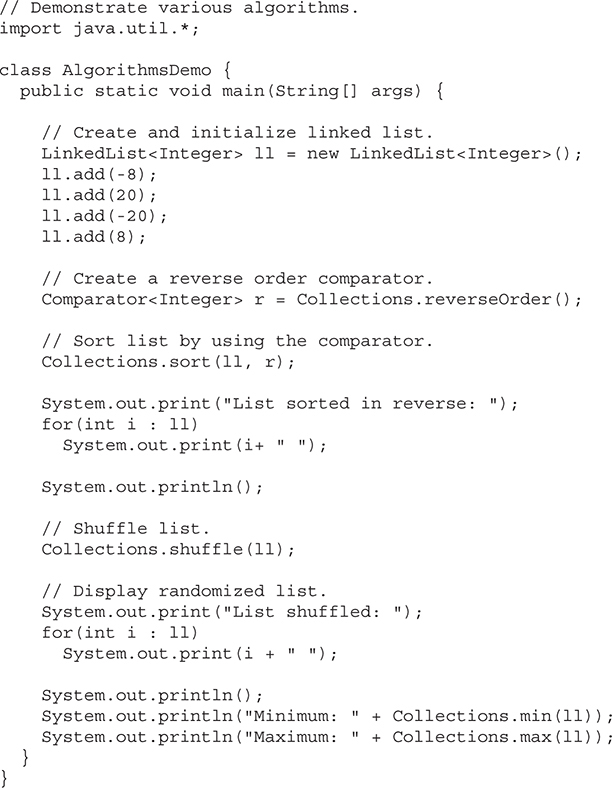
Output from this program is shown here:
List sorted in reverse: 20 8 -8 -20
List shuffled: 20 -20 8 -8
Minimum: -20
Maximum: 20
Notice that min( ) and max( ) operate on the list after it has been shuffled. Neither requires a sorted list for its operation.
The Arrays class provides various static utility methods that are useful when working with arrays. These methods help bridge the gap between collections and arrays. Each method defined by Arrays is examined in this section.
The asList( ) method returns a List that is backed by a specified array. In other words, both the list and the array refer to the same location. It has the following signature:
static <T> List asList(T... array)
Here, array is the array that contains the data.
The binarySearch( ) method uses a binary search to find a specified value. This method must be applied to sorted arrays. Here are some of its forms. (Additional forms let you search a subrange):
static int binarySearch(byte[ ] array, byte value)
static int binarySearch(char[ ] array, char value)
static int binarySearch(double[ ] array, double value)
static int binarySearch(float[ ] array, float value)
static int binarySearch(int[ ] array, int value)
static int binarySearch(long[ ] array, long value)
static int binarySearch(short[ ] array, short value)
static int binarySearch(Object[ ] array, Object value)
static <T> int binarySearch(T[ ] array, T value, Comparator<? super T> c)
Here, array is the array to be searched, and value is the value to be located. The last two forms throw a ClassCastException if array contains elements that cannot be compared (for example, Double and StringBuffer) or if value is not compatible with the types in array. In the last form, the Comparator c is used to determine the order of the elements in array. In all cases, if value exists in array, the index of the element is returned. Otherwise, a negative value is returned.
The copyOf( ) method returns a copy of an array and has the following forms:
static boolean[ ] copyOf(boolean[ ] source, int len)
static byte[ ] copyOf(byte[ ] source, int len)
static char[ ] copyOf(char[ ] source, int len)
static double[ ] copyOf(double[ ] source, int len)
static float[ ] copyOf(float[ ] source, int len)
static int[ ] copyOf(int[ ] source, int len)
static long[ ] copyOf(long[ ] source, int len)
static short[ ] copyOf(short[ ] source, int len)
static <T> T[ ] copyOf(T[ ] source, int len)
static <T,U> T[ ] copyOf(U[ ] source, int len, Class<? extends T[ ]> resultT)
The original array is specified by source, and the length of the copy is specified by len. If the copy is longer than source, then the copy is padded with zeros (for numeric arrays), nulls (for object arrays), or false (for boolean arrays). If the copy is shorter than source, then the copy is truncated. In the last form, the type of resultT becomes the type of the array returned. If len is negative, a NegativeArraySizeException is thrown. If source is null, a NullPointerException is thrown. If resultT is incompatible with the type of source, an ArrayStoreException is thrown.
The copyOfRange( ) method returns a copy of a range within an array and has the following forms:
static boolean[ ] copyOfRange(boolean[ ] source, int start, int end)
static byte[ ] copyOfRange(byte[ ] source, int start, int end)
static char[ ] copyOfRange(char[ ] source, int start, int end)
static double[ ] copyOfRange(double[ ] source, int start, int end)
static float[ ] copyOfRange(float[ ] source, int start, int end)
static int[ ] copyOfRange(int[ ] source, int start, int end)
static long[ ] copyOfRange(long[ ] source, int start, int end)
static short[ ] copyOfRange(short[ ] source, int start, int end)
static <T> T[ ] copyOfRange(T[ ] source, int start, int end)
static <T,U> T[ ] copyOfRange(U[ ] source, int start, int end,
Class<? extends T[ ]> resultT)
The original array is specified by source. The range to copy is specified by the indices passed via start and end. The range runs from start to end – 1. If the range is longer than source, then the copy is padded with zeros (for numeric arrays), nulls (for object arrays), or false (for boolean arrays). In the last form, the type of resultT becomes the type of the array returned. If start is negative or greater than the length of source, an ArrayIndexOutOfBoundsException is thrown. If start is greater than end, an IllegalArgumentException is thrown. If source is null, a NullPointerException is thrown. If resultT is incompatible with the type of source, an ArrayStoreException is thrown.
The equals( ) method returns true if two arrays are equivalent. Otherwise, it returns false. Here are a number of its forms. Several more versions are available that let you specify a range, a generic array type, and/or a comparator.
static boolean equals(boolean[ ] array1, boolean[ ] array2)
static boolean equals(byte[ ] array1, byte[ ] array2)
static boolean equals(char[ ] array1, char[ ] array2)
static boolean equals(double[ ] array1, double[ ] array2)
static boolean equals(float[ ] array1, float[ ] array2)
static boolean equals(int[ ] array1, int[ ] array2)
static boolean equals(long[ ] array1, long[ ] array2)
static boolean equals(short[ ] array1, short[ ] array2)
static boolean equals(Object[ ] array1, Object[ ] array2)
Here, array1 and array2 are the two arrays that are compared for equality.
The deepEquals( ) method can be used to determine if two arrays, which might contain nested arrays, are equal. It has this declaration:
static boolean deepEquals(Object[ ] a, Object[ ] b)
It returns true if the arrays passed in a and b contain the same elements. If a and b contain nested arrays, then the contents of those nested arrays are also checked. It returns false if the arrays, or any nested arrays, differ.
The fill( ) method assigns a value to all elements in an array. In other words, it fills an array with a specified value. The fill( ) method has two versions. The first version, which has the following forms, fills an entire array:
static void fill(boolean[ ] array, boolean value)
static void fill(byte[ ] array, byte value)
static void fill(char[ ] array, char value)
static void fill(double[ ] array, double value)
static void fill(float[ ] array, float value)
static void fill(int[ ] array, int value)
static void fill(long[ ] array, long value)
static void fill(short[ ] array, short value)
static void fill(Object[ ] array, Object value)
Here, value is assigned to all elements in array. The second version of the fill( ) method assigns a value to a subset of an array.
The sort( ) method sorts an array so that it is arranged in ascending order. The sort( ) method has two versions. The first version, shown here, sorts the entire array:
static void sort(byte[ ] array)
static void sort(char[ ] array)
static void sort(double[ ] array)
static void sort(float[ ] array)
static void sort(int[ ] array)
static void sort(long[ ] array)
static void sort(short[ ] array)
static void sort(Object[ ] array)
static <T> void sort(T[ ] array, Comparator<? super T> c)
Here, array is the array to be sorted. In the last form, c is a Comparator that is used to order the elements of array. The last two forms can throw a ClassCastException if elements of the array being sorted are not comparable. The second version of sort( ) enables you to specify a range within an array that you want to sort.
One quite powerful method in Arrays is parallelSort( ) because it sorts, into ascending order, portions of an array in parallel and then merges the results. This approach can greatly speed up sorting times. Like sort( ), there are two basic types of parallelSort( ), each with several overloads. The first type sorts the entire array. It is shown here:
static void parallelSort(byte[ ] array)
static void parallelSort(char[ ] array)
static void parallelSort(double[ ] array)
static void parallelSort(float[ ] array)
static void parallelSort(int[ ] array)
static void parallelSort(long[ ] array)
static void parallelSort(short[ ] array)
static <T extends Comparable<? super T>> void parallelSort(T[ ] array)
static <T> void parallelSort(T[ ] array, Comparator<? super T> c)
Here, array is the array to be sorted. In the last form, c is a comparator that is used to order the elements in the array. The last two forms can throw a ClassCastException if the elements of the array being sorted are not comparable. The second version of parallelSort( ) enables you to specify a range within the array that you want to sort.
Arrays supports spliterators by including the spliterator( ) method. It has two basic forms. The first type returns a spliterator to an entire array. It is shown here:
static Spliterator.OfDouble spliterator(double[ ] array)
static Spliterator.OfInt spliterator(int[ ] array)
static Spliterator.OfLong spliterator(long[ ] array)
static <T> Spliterator spliterator(T[ ] array)
Here, array is the array that the spliterator will cycle through. The second version of spliterator( ) enables you to specify a range to iterate within the array.
Arrays supports the Stream interface by including the stream( ) method. It has two forms. The first is shown here:
static DoubleStream stream(double[ ] array)
static IntStream stream(int[ ] array)
static LongStream stream(long[ ] array)
static <T> Stream stream(T[ ] array)
Here, array is the array to which the stream will refer. The second version of stream( ) enables you to specify a range within the array.
Another two methods are related: setAll( ) and parallelSetAll( ). Both assign values to all of the elements, but parallelSetAll( ) works in parallel. Here is an example of each:
static void setAll(double[ ] array,
IntToDoubleFunction<? extends T> genVal)
static void parallelSetAll(double[ ] array,
IntToDoubleFunction<? extends T> genVal)
Several overloads exist for each of these that handle types int, long, and generic.
One of the more intriguing methods defined by Arrays is called parallelPrefix( ), and it modifies an array so that each element contains the cumulative result of an operation applied to all previous elements. For example, if the operation is multiplication, then on return, the array elements will contain the values associated with the running product of the original values. It has several overloads. Here is one example:
static void parallelPrefix(double[ ] array, DoubleBinaryOperator func)
Here, array is the array being acted upon, and func specifies the operation applied. (DoubleBinaryOperator is a functional interface defined in java.util.function.) Many other versions are provided, including those that operate on types int, long, and generic, and those that let you specify a range within the array on which to operate.
JDK 9 added three comparison methods to Arrays. They are compare( ), compareUnsigned( ), and mismatch( ). Each has several overloads and each has versions that let you define a range to compare. Here is a brief description of each. The compare( ) method compares two arrays. It returns zero if they are the same, a positive value if the first array is greater than the second, and negative if the first array is less than the second. To perform an unsigned comparison of two arrays that hold integer values, use compareUnsigned( ). To find the location of the first mismatch between two arrays, use mismatch( ). It returns the index of the mismatch, or –1 if the arrays are equivalent.
Arrays also provides toString( ) and hashCode( ) for the various types of arrays. In addition, deepToString( ) and deepHashCode( ) are provided, which operate effectively on arrays that contain nested arrays.
The following program illustrates how to use some of the methods of the Arrays class:
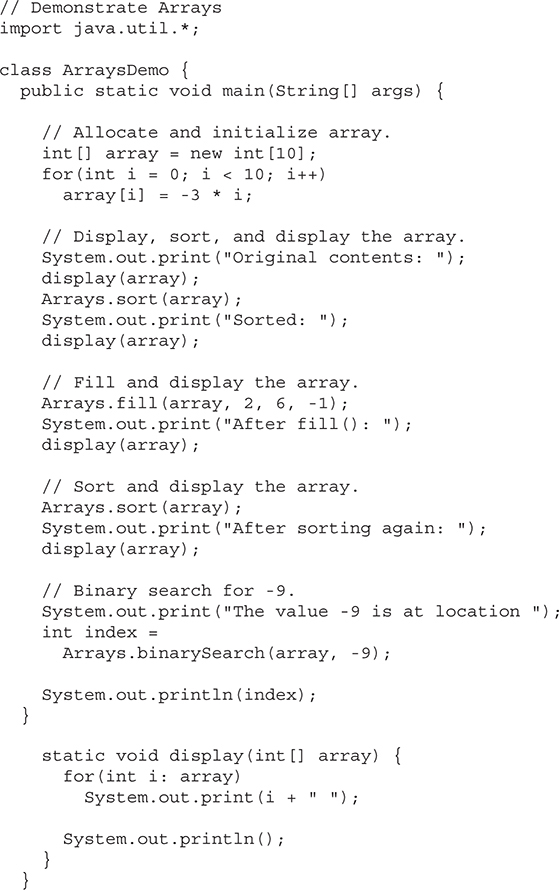
The following is the output from this program:
Original contents: 0 -3 -6 -9 -12 -15 -18 -21 -24 -27
Sorted: -27 -24 -21 -18 -15 -12 -9 -6 -3 0
After fill(): -27 -24 -1 -1 -1 -1 -9 -6 -3 0
After sorting again: -27 -24 -9 -6 -3 -1 -1 -1 -1 0
The value -9 is at location 2
As explained at the start of this chapter, early versions of java.util did not include the Collections Framework. Instead, it defined several classes and an interface that provided an ad hoc method of storing objects. When collections were added (by J2SE 1.2), several of the original classes were reengineered to support the collection interfaces. Thus, they are now technically part of the Collections Framework. However, where a modern collection duplicates the functionality of a legacy class, you will usually want to use the newer collection class.
One other point: none of the modern collection classes described in this chapter are synchronized, but all the legacy classes are synchronized. This distinction may be important in some situations. Of course, you can easily synchronize collections by using one of the algorithms provided by Collections.
The legacy classes defined by java.util are shown here:

There is one legacy interface called Enumeration. The following sections examine Enumeration and each of the legacy classes, in turn.
The Enumeration interface defines the methods by which you can enumerate (obtain one at a time) the elements in a collection of objects. This legacy interface has been superseded by Iterator. Although not deprecated, Enumeration is considered obsolete for new code. However, it is used by several methods defined by the legacy classes (such as Vector and Properties) and is used by several other API classes. It was retrofitted for generics by JDK 5. It has this declaration:
interface Enumeration<E>
where E specifies the type of element being enumerated.
Enumeration specifies the following two abstract methods:
boolean hasMoreElements( )
E nextElement( )
When implemented, hasMoreElements( ) must return true while there are still more elements to extract, and false when all the elements have been enumerated. nextElement( ) returns the next object in the enumeration. That is, each call to nextElement( ) obtains the next object in the enumeration. It throws NoSuchElementException when the enumeration is complete.
JDK 9 added a default method to Enumeration called asIterator( ). It is shown here:
default Iterator<E> asIterator( )
It returns an iterator to the elements in the enumeration. As such, it provides an easy way to convert an old-style Enumeration into a modern Iterator. Furthermore, if a portion of the elements in the enumeration have already been read prior to calling asIterator( ), the returned iterator accesses only the remaining elements.
Vector implements a dynamic array. It is similar to ArrayList, but with two differences: Vector is synchronized, and it contains many legacy methods that duplicate the functionality of methods defined by the Collections Framework. With the advent of collections, Vector was reengineered to extend AbstractList and to implement the List interface. With the release of JDK 5, it was retrofitted for generics and reengineered to implement Iterable. This means that Vector is fully compatible with collections, and a Vector can have its contents iterated by the enhanced for loop.
Vector is declared like this:
class Vector<E>
Here, E specifies the type of element that will be stored.
Here are the Vector constructors:
Vector( )
Vector(int size)
Vector(int size, int incr)
Vector(Collection<? extends E> c)
The first form creates a default vector, which has an initial size of 10. The second form creates a vector whose initial capacity is specified by size. The third form creates a vector whose initial capacity is specified by size and whose increment is specified by incr. The increment specifies the number of elements to allocate each time that a vector is resized upward. The fourth form creates a vector that contains the elements of collection c.
All vectors start with an initial capacity. After this initial capacity is reached, the next time that you attempt to store an object in the vector, the vector automatically allocates space for that object plus extra room for additional objects. By allocating more than just the required memory, the vector reduces the number of allocations that must take place as the vector grows. This reduction is important, because allocations are costly in terms of time. The amount of extra space allocated during each reallocation is determined by the increment that you specify when you create the vector. If you don’t specify an increment, the vector’s size is doubled by each allocation cycle.
Vector defines these protected data members:
int capacityIncrement;
int elementCount;
Object[ ] elementData;
The increment value is stored in capacityIncrement. The number of elements currently in the vector is stored in elementCount. The array that holds the vector is stored in elementData.
In addition to the collections methods specified by List, Vector defines several legacy methods, which are summarized in Table 20-16.
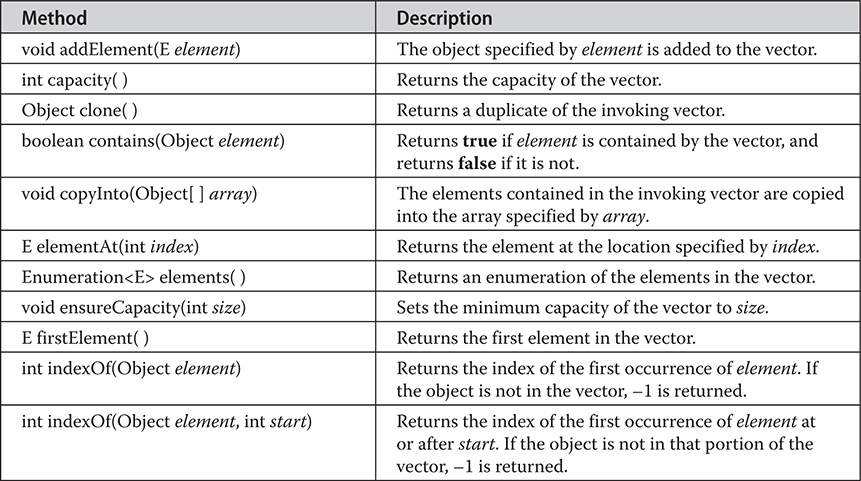
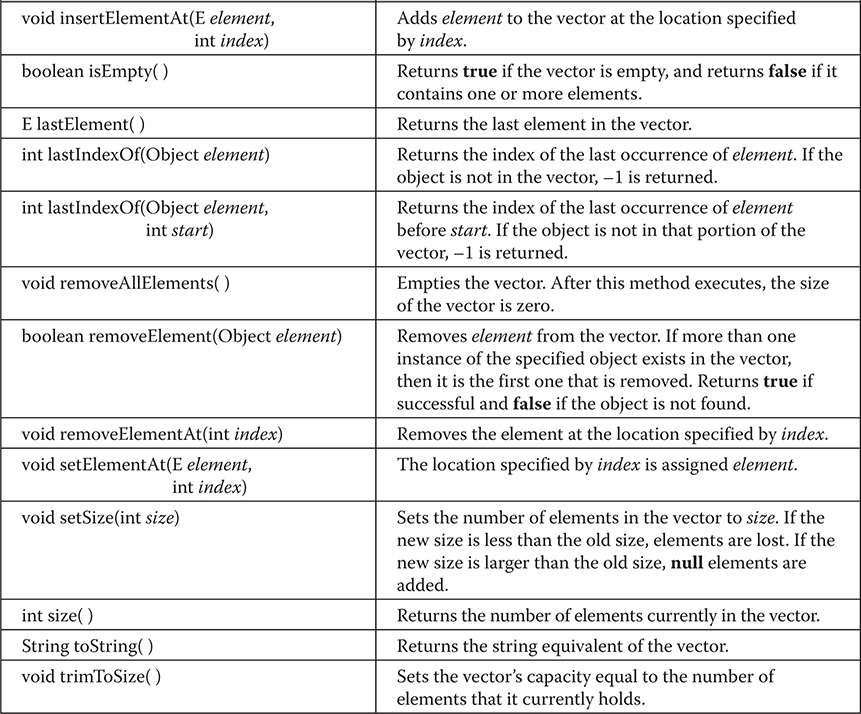
Table 20-16 The Legacy Methods Defined by Vector
Because Vector implements List, you can use a vector just like you use an ArrayList instance. You can also manipulate one using its legacy methods. For example, after you instantiate a Vector, you can add an element to it by calling addElement( ). To obtain the element at a specific location, call elementAt( ). To obtain the first element in the vector, call firstElement( ). To retrieve the last element, call lastElement( ). You can obtain the index of an element by using indexOf( ) and lastIndexOf( ). To remove an element, call removeElement( ) or removeElementAt( ).
The following program uses a vector to store various types of numeric objects. It demonstrates several of the legacy methods defined by Vector. It also demonstrates the Enumeration interface.
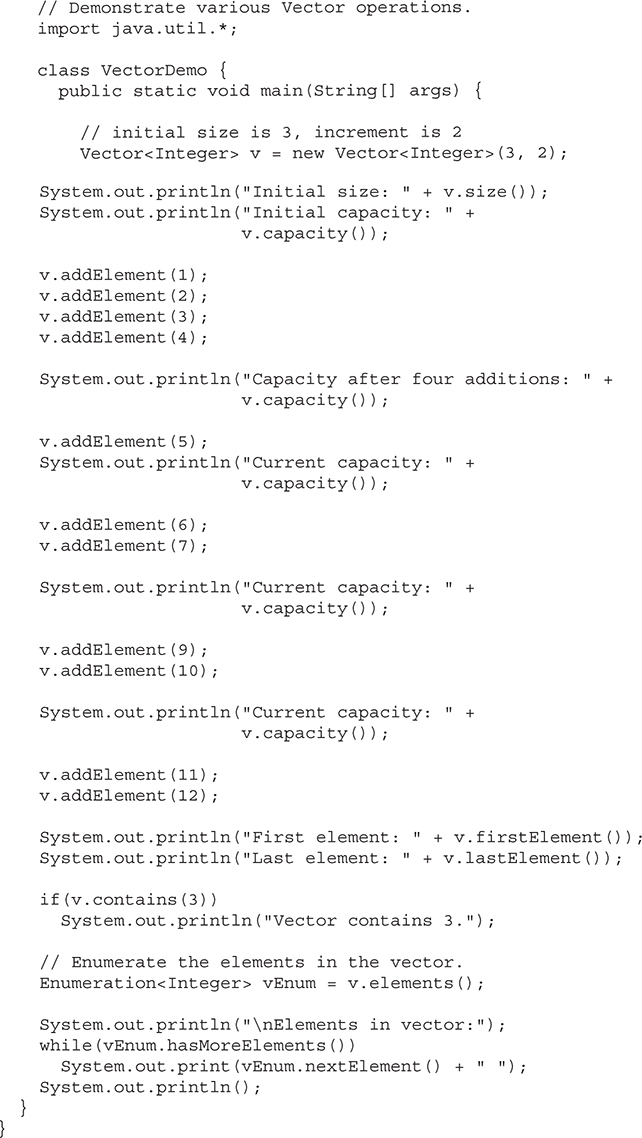
The output from this program is shown here:
Initial size: 0
Initial capacity: 3
Capacity after four additions: 5
Current capacity: 5
Current capacity: 7
Current capacity: 9
First element: 1
Last element: 12
Vector contains 3.
Elements in vector:
1 2 3 4 5 6 7 9 10 11 12
Instead of relying on an enumeration to cycle through the objects (as the preceding program does), you can use an iterator. For example, the following iterator-based code can be substituted into the program:

You can also use a for-each for loop to cycle through a Vector, as the following version of the preceding code shows:

Because the Enumeration interface is not recommended for new code, you will usually use an iterator or a for-each for loop to enumerate the contents of a vector. Of course, legacy code will employ Enumeration. Fortunately, enumerations and iterators work in nearly the same manner.
Stack is a subclass of Vector that implements a standard last-in, first-out stack. Stack only defines the default constructor, which creates an empty stack. With the release of JDK 5, Stack was retrofitted for generics and is declared as shown here:
class Stack<E>
Here, E specifies the type of element stored in the stack.
Stack includes all the methods defined by Vector and adds several of its own, shown in Table 20-17.

Table 20-17 The Methods Defined by Stack
To put an object on the top of the stack, call push( ). To remove and return the top element, call pop( ). You can use peek( ) to return, but not remove, the top object. An EmptyStackException is thrown if you call pop( ) or peek( ) when the invoking stack is empty. The empty( ) method returns true if nothing is on the stack. The search( ) method determines whether an object exists on the stack and returns the number of pops that are required to bring it to the top of the stack. Here is an example that creates a stack, pushes several Integer objects onto it, and then pops them off again:
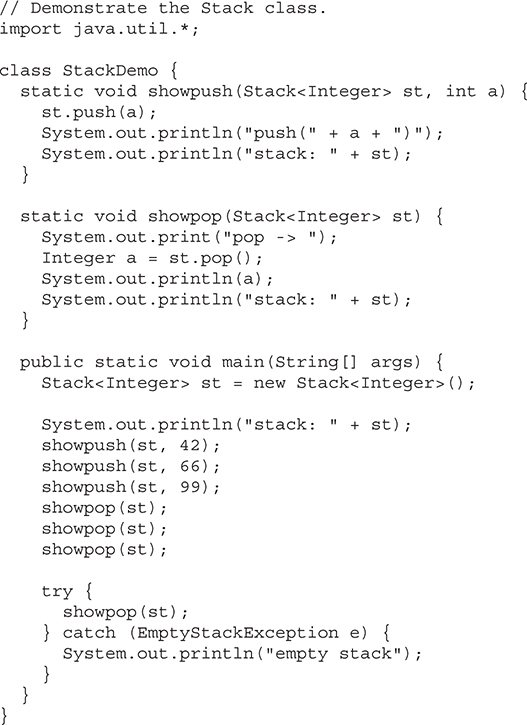
The following is the output produced by the program; notice how the exception handler for EmptyStackException is used so that you can gracefully handle a stack underflow:
stack: [ ]
push(42)
stack: [42]
push(66)
stack: [42, 66]
push(99)
stack: [42, 66, 99]
pop -> 99
stack: [42, 66]
pop -> 66
stack: [42]
pop -> 42
stack: [ ]
pop -> empty stack
One other point: although Stack is not deprecated, ArrayDeque is a better choice.
Dictionary is an abstract class that represents a key/value storage repository and operates much like Map. Given a key and value, you can store the value in a Dictionary object. Once the value is stored, you can retrieve it by using its key. Thus, like a map, a dictionary can be thought of as a list of key/value pairs. Although not currently deprecated, Dictionary is classified as obsolete, because it is fully superseded by Map. However, Dictionary is still in use and thus is discussed here.
With the advent of JDK 5, Dictionary was made generic. It is declared as shown here:
class Dictionary<K, V>
Here, K specifies the type of keys, and V specifies the type of values. The abstract methods defined by Dictionary are listed in Table 20-18.
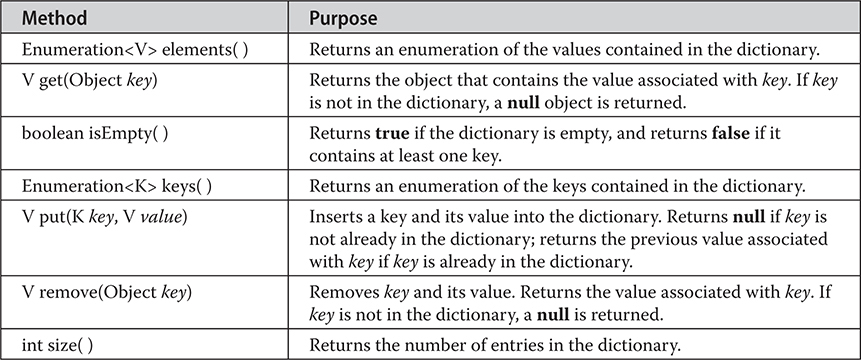
Table 20-18 The Abstract Methods Defined by Dictionary
To add a key and a value, use the put( ) method. Use get( ) to retrieve the value of a given key. The keys and values can each be returned as an Enumeration by the keys( ) and elements( ) methods, respectively. The size( ) method returns the number of key/value pairs stored in a dictionary, and isEmpty( ) returns true when the dictionary is empty. You can use the remove( ) method to delete a key/value pair.
Remember The Dictionary class is obsolete. You should implement the Map interface to obtain
key/value storage functionality.
Hashtable was part of the original java.util and is a concrete implementation of a Dictionary. However, with the advent of collections, Hashtable was reengineered to also implement the Map interface. Thus, Hashtable is integrated into the Collections Framework. It is similar to HashMap, but is synchronized.
Like HashMap, Hashtable stores key/value pairs in a hash table. However, neither keys nor values can be null. When using a Hashtable, you specify an object that is used as a key, and the value that you want linked to that key. The key is then hashed, and the resulting hash code is used as the index at which the value is stored within the table.
Hashtable was made generic by JDK 5. It is declared like this:
class Hashtable<K, V>
Here, K specifies the type of keys, and V specifies the type of values.
A hash table can only store keys that override the hashCode( ) and equals( ) methods that are defined by Object. The hashCode( ) method must compute and return the hash code for the object. Of course, equals( ) compares two objects. Fortunately, many of Java’s built-in classes already implement the hashCode( ) method. For example, a common type of Hashtable uses a String object as the key. String implements both hashCode( ) and equals( ).
The Hashtable constructors are shown here:
Hashtable( )
Hashtable(int size)
Hashtable(int size, float fillRatio)
Hashtable(Map<? extends K, ? extends V> m)
The first version is the default constructor. The second version creates a hash table that has an initial size specified by size. (The default size is 11.) The third version creates a hash table that has an initial size specified by size and a fill ratio specified by fillRatio. This ratio (also referred to as a load factor) must be between 0.0 and 1.0, and it determines how full the hash table can be before it is resized upward. Specifically, when the number of elements is greater than the capacity of the hash table multiplied by its fill ratio, the hash table is expanded. If you do not specify a fill ratio, then 0.75 is used. Finally, the fourth version creates a hash table that is initialized with the elements in m. The default load factor of 0.75 is used.
In addition to the methods defined by the Map interface, which Hashtable now implements, Hashtable defines the legacy methods listed in Table 20-19. Several methods throw NullPointerException if an attempt is made to use a null key or value.
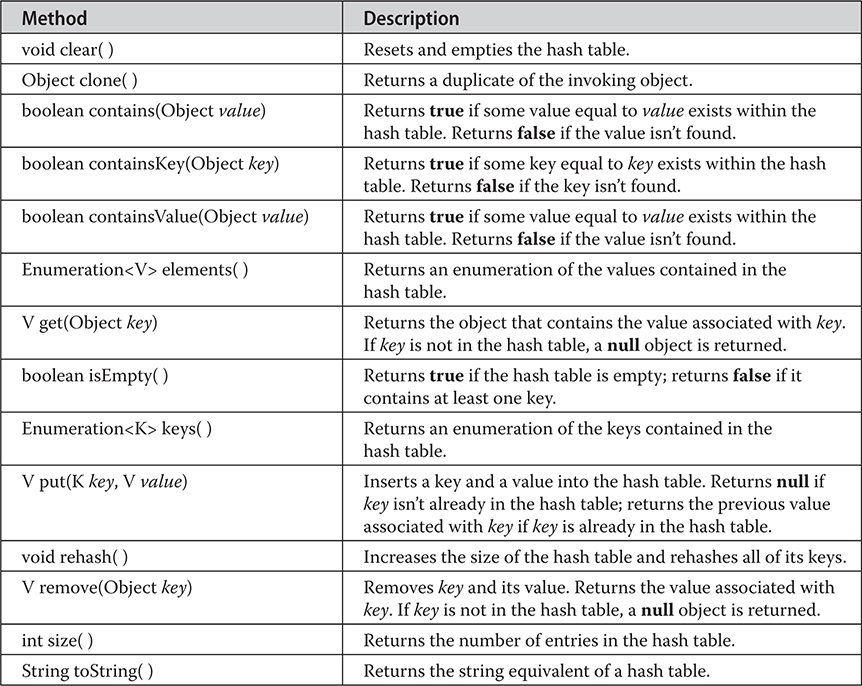
Table 20-19 The Legacy Methods Defined by Hashtable
The following example reworks the bank account program, shown earlier, so that it uses a Hashtable to store the names of bank depositors and their current balances:
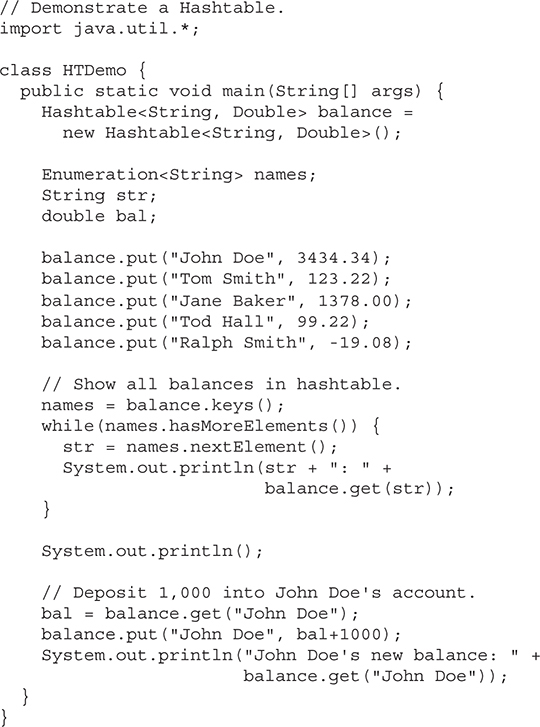
The output from this program is shown here:
Todd Hall: 99.22
Ralph Smith: -19.08
John Doe: 3434.34
Jane Baker: 1378.0
Tom Smith: 123.22
John Doe's new balance: 4434.34
One important point: Like the map classes, Hashtable does not directly support iterators. Thus, the preceding program uses an enumeration to display the contents of balance. However, you can obtain set-views of the hash table, which permits the use of iterators. To do so, you simply use one of the collection-view methods defined by Map, such as entrySet( ) or keySet( ). For example, you can obtain a set-view of the keys and cycle through them using either an iterator or an enhanced for loop. Here is a reworked version of the program that shows this technique:
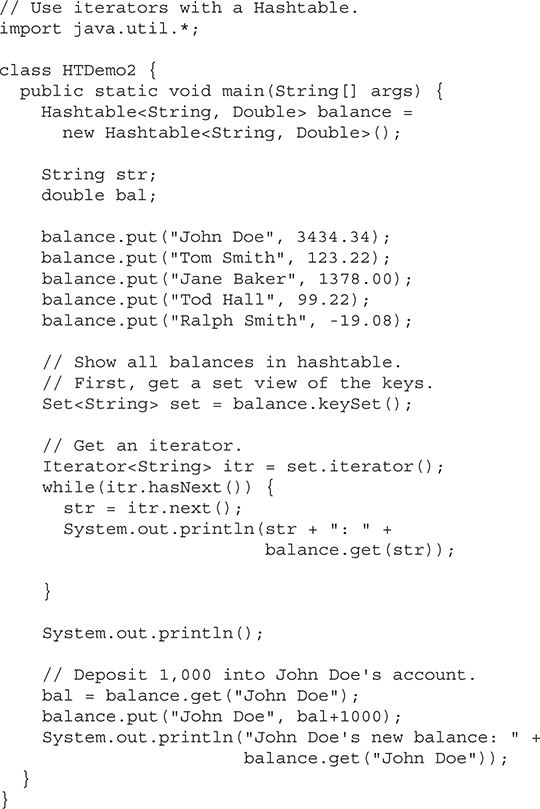
Properties is a subclass of Hashtable. It is used to maintain lists of values in which the key is a String and the value is also a String. The Properties class is used by some other Java classes. For example, it is the type of object returned by System.getProperties( ) when obtaining environmental values. Although the Properties class, itself, is not generic, several of its methods are.
Properties defines the following protected volatile instance variable:
Properties defaults;
This variable holds a default property list associated with a Properties object. Properties defines these constructors:
Properties( )
Properties(Properties propDefault)
Properties(int capacity)
The first version creates a Properties object that has no default values. The second creates an object that uses propDefault for its default values. In both cases, the property list is empty. The third constructor lets you specify an initial capacity for the property list. In all cases, the list will grow as needed.
In addition to the methods that Properties inherits from Hashtable, Properties defines the methods listed in Table 20-20. Properties also contains one deprecated method: save( ). This was replaced by store( ) because save( ) did not handle errors correctly.
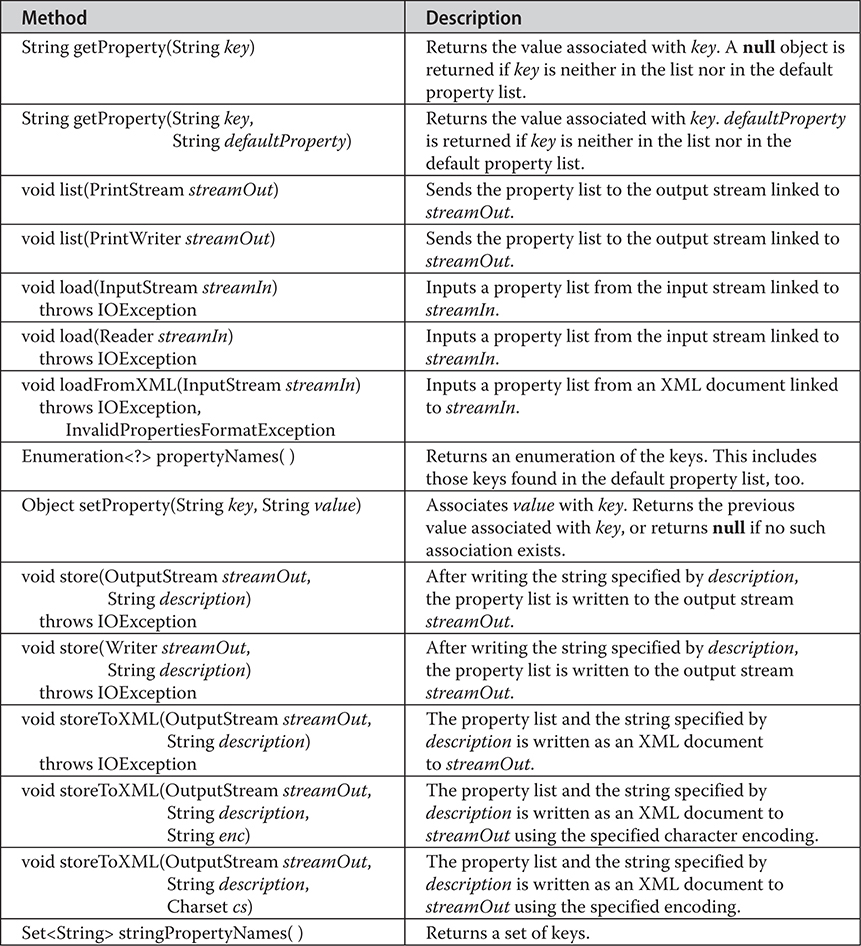
Table 20-20 The Methods Defined by Properties
One useful capability of the Properties class is that you can specify a default property that will be returned if no value is associated with a certain key. For example, a default value can be specified along with the key in the getProperty( ) method—such as getProperty("name" ,"default value"). If the "name" value is not found, then "default value" is returned. When you construct a Properties object, you can pass another instance of Properties to be used as the default properties for the new instance. In this case, if you call getProperty("foo") on a given Properties object, and "foo" does not exist, Java looks for "foo" in the default Properties object. This allows for arbitrary nesting of levels of default properties.
The following example demonstrates Properties. It creates a property list in which the keys are the names of states and the values are the names of their capitals. Notice that the attempt to find the capital for Florida includes a default value.
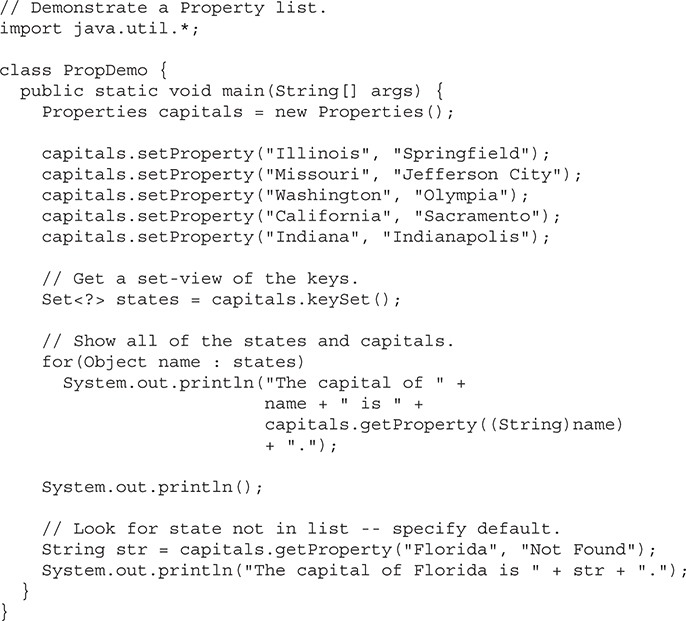
The output from this program is shown here:
The capital of Missouri is Jefferson City.
The capital of Illinois is Springfield.
The capital of Indiana is Indianapolis.
The capital of California is Sacramento.
The capital of Washington is Olympia.
The capital of Florida is Not Found.
Since Florida is not in the list, the default value is used.
Although it is perfectly valid to use a default value when you call getProperty( ), as the preceding example shows, there is a better way of handling default values for most applications of property lists. For greater flexibility, specify a default property list when
constructing a Properties object. The default list will be searched if the desired key is not found in the main list. For example, the following is a slightly reworked version of the preceding program, with a default list of states specified. Now, when Florida is sought, it will be found in the default list:
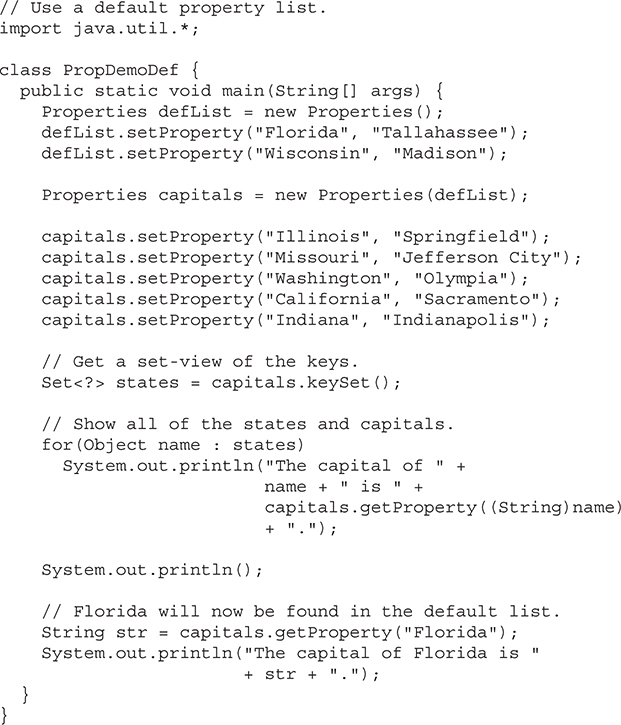
One of the most useful aspects of Properties is that the information contained in a Properties object can be easily stored to or loaded from disk with the store( ) and load( ) methods. At any time, you can write a Properties object to a stream or read it back. This makes property lists especially convenient for implementing simple databases. For example, the following program uses a property list to create a simple computerized telephone book that stores names and phone numbers. To find a person’s number, you enter his or her name. The program uses the store( ) and load( ) methods to store and retrieve the list. When the program executes, it first tries to load the list from a file called phonebook.dat. If this file exists, the list is loaded. You can then add to the list. If you do, the new list is saved when you terminate the program. Notice how little code is required to implement a small, but functional, computerized phone book.
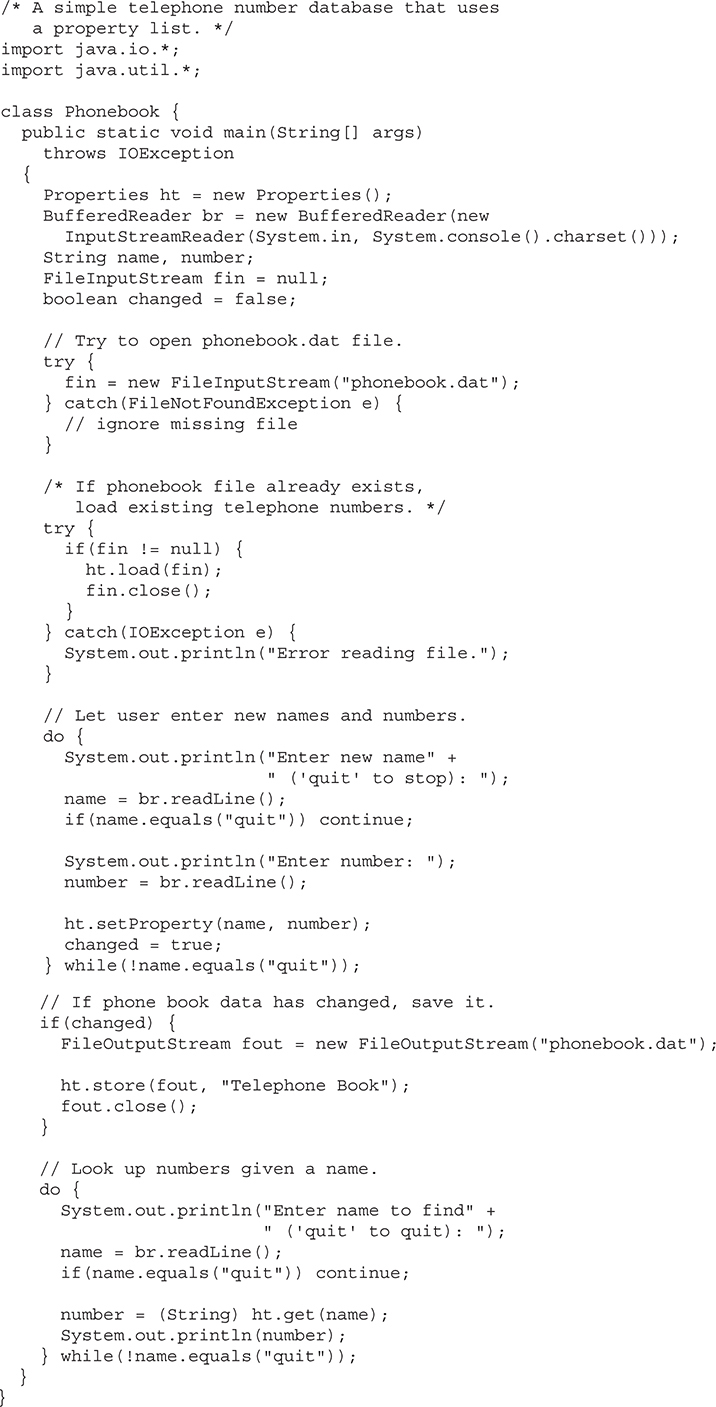
The Collections Framework gives you, the programmer, a powerful set of well-engineered solutions to some of programming’s most common tasks. Consider using a collection the next time you need to store and retrieve information. Remember, collections need not be reserved for only the “large jobs,” such as corporate databases, mailing lists, or inventory systems. They are also effective when applied to smaller jobs. For example, a TreeMap might make an excellent collection to hold the directory structure of a set of files. A TreeSet could be quite useful for storing project-management information. Frankly, the types of problems that will benefit from a collections-based solution are limited only by your imagination. One last point: In Chapter 30, the stream API is discussed. Because streams are integrated with collections, consider using a stream when operating on a collection.
This chapter continues our discussion of java.util by examining those classes and interfaces that are not part of the Collections Framework. These include classes that support timers, work with dates, compute random numbers, and bundle resources. Also covered are the Formatter and Scanner classes which make it easy to write and read formatted data, and the Optional class, which simplifies handling situations in which a value may be absent. Finally, the subpackages of java.util are summarized at the end of this chapter. Of particular interest is java.util.function, which defines several standard functional interfaces. One last point: the Observer interface and the Observable class packaged in java.util. have been deprecated since JDK 9. For this reason they are not discussed here.
The processing of text often consists of parsing a formatted input string. Parsing is the division of text into a set of discrete parts, or tokens, which in a certain sequence can convey a semantic meaning. The StringTokenizer class provides the first step in this parsing process, often called the lexer (lexical analyzer) or scanner. StringTokenizer implements the Enumeration interface. Therefore, given an input string, you can enumerate the individual tokens contained in it using StringTokenizer. Before we begin, it is important to point out that StringTokenizer is described here primarily for the benefit of those programmers working with legacy code. For new code, regular expressions, discussed in Chapter 31, offer a more modern alternative.
To use StringTokenizer, you specify an input string and a string that contains delimiters. Delimiters are characters that separate tokens. Each character in the delimiters string is considered a valid delimiter—for example, ",;:" sets the delimiters to a comma, semicolon, and colon. The default set of delimiters consists of the whitespace characters: space, tab, form feed, newline, and carriage return.
The StringTokenizer constructors are shown here:
StringTokenizer(String str)
StringTokenizer(String str, String delimiters)
StringTokenizer(String str, String delimiters, boolean delimAsToken)
In all versions, str is the string that will be tokenized. In the first version, the default delimiters are used. In the second and third versions, delimiters is a string that specifies the delimiters. In the third version, if delimAsToken is true, then the delimiters are also returned as tokens when the string is parsed. Otherwise, the delimiters are not returned. Delimiters are not returned as tokens by the first two forms.
Once you have created a StringTokenizer object, the nextToken( ) method is used to extract consecutive tokens. The hasMoreTokens( ) method returns true while there are more tokens to be extracted. Since StringTokenizer implements Enumeration, the hasMoreElements( ) and nextElement( ) methods are also implemented, and they act the same as hasMoreTokens( ) and nextToken( ), respectively. The StringTokenizer methods are shown in Table 21-1.
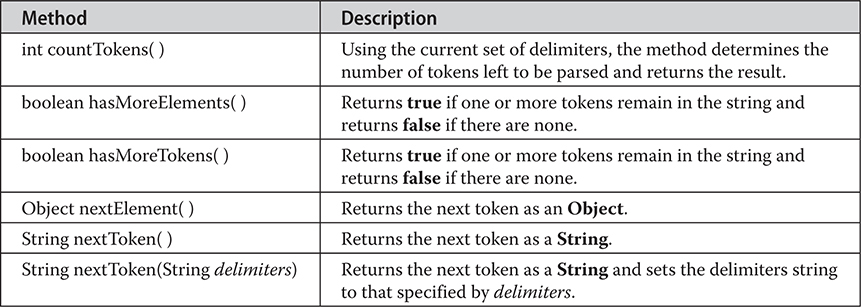
Table 21-1 The Methods Defined by StringTokenizer
Here is an example that creates a StringTokenizer to parse "key=value" pairs. Consecutive sets of "key=value" pairs are separated by a semicolon.
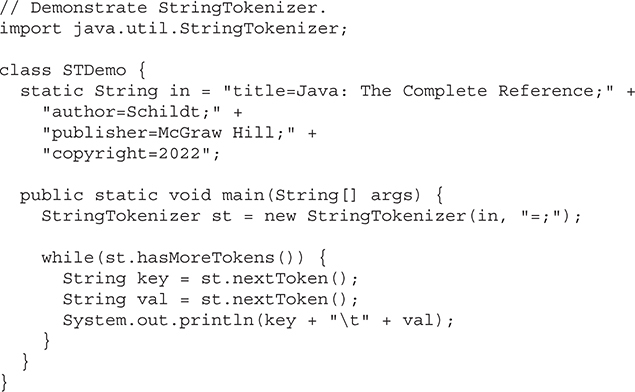
The output from this program is shown here:
title Java: The Complete Reference
author Schildt
publisher McGraw Hill
copyright 2022
A BitSet class creates a special type of array that holds bit values in the form of boolean values. This array can increase in size as needed. This makes it similar to a vector of bits. The BitSet constructors are shown here:
BitSet( )
BitSet(int size)
The first version creates a default object. The second version allows you to specify its initial size (that is, the number of bits that it can hold). All bits are initialized to false.
BitSet defines the methods listed in Table 21-2.
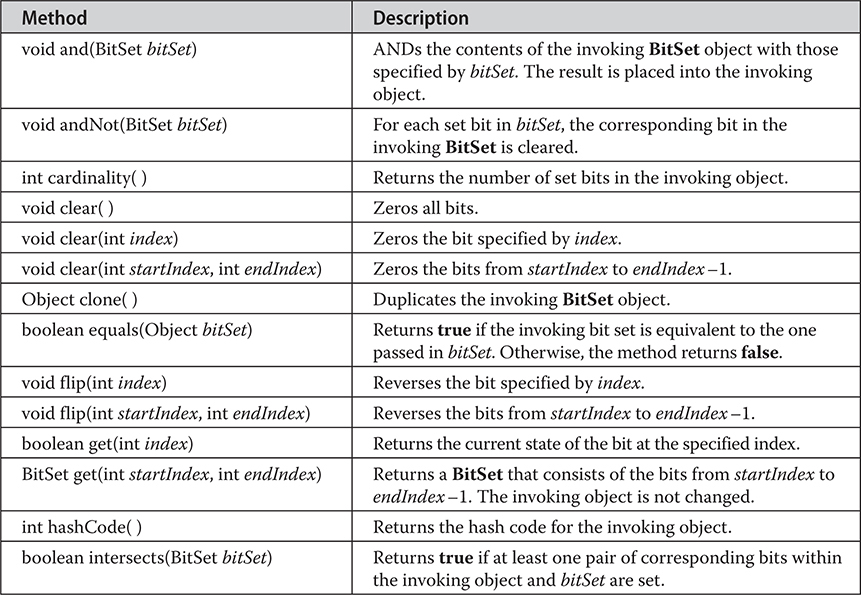
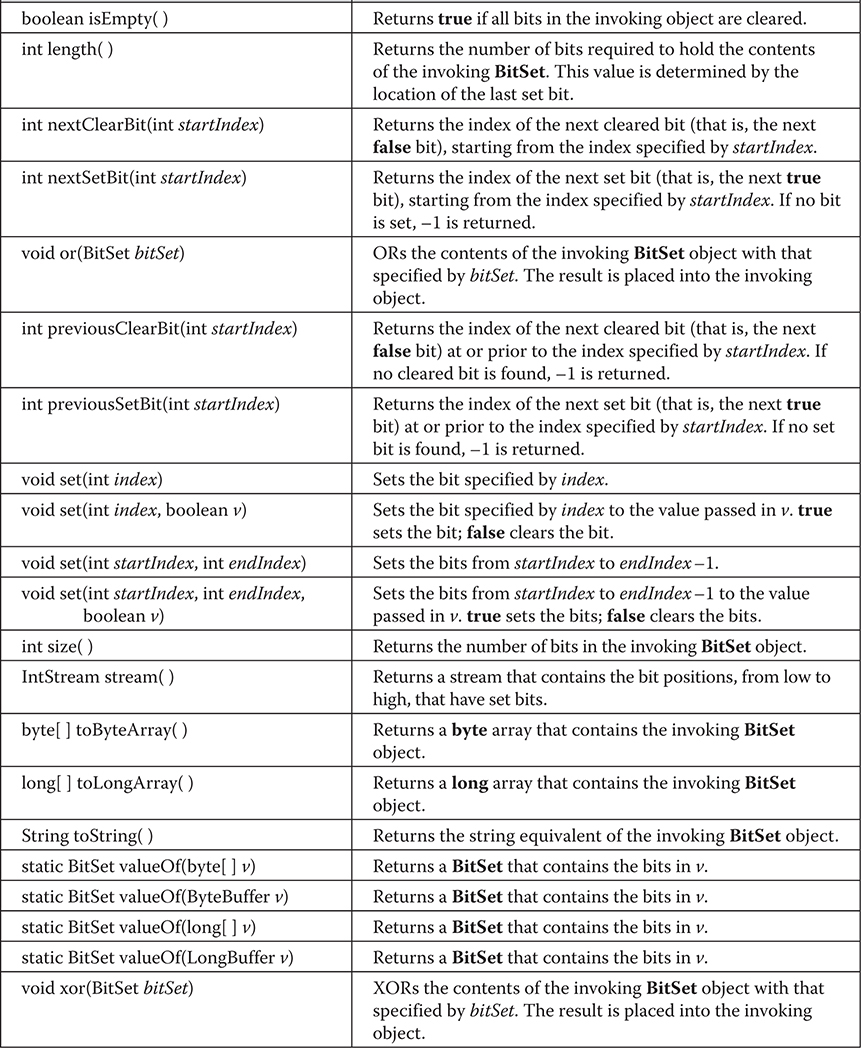
Table 21-2 The Methods Defined by BitSet
Here is an example that demonstrates BitSet:
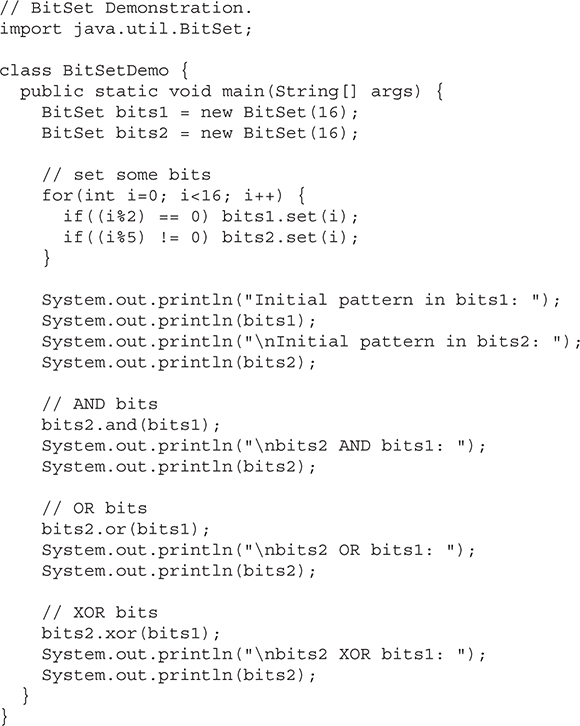
The output from this program is shown here. When toString( ) converts a BitSet object to its string equivalent, each set bit is represented by its bit position. Cleared bits are not shown.
Initial pattern in bits1:
{0, 2, 4, 6, 8, 10, 12, 14}
Initial pattern in bits2:
{1, 2, 3, 4, 6, 7, 8, 9, 11, 12, 13, 14}
bits2 AND bits1:
{2, 4, 6, 8, 12, 14}
bits2 OR bits1:
{0, 2, 4, 6, 8, 10, 12, 14}
bits2 XOR bits1:
{}
Beginning with JDK 8, the classes called Optional, OptionalDouble, OptionalInt, and OptionalLong offer a way to handle situations in which a value may or may not be present. In the past, you would normally use the value null to indicate that no value is present. However, this can lead to null pointer exceptions if an attempt is made to dereference a null reference. As a result, frequent checks for a null value were necessary to avoid generating an exception. These classes provide a better way to handle such situations. One other point: These classes are value-based. (See Chapter 13 for a description of value-based classes.)
The first and most general of these classes is Optional. For this reason, it is the primary focus of this discussion. It is shown here:
class Optional<T>
Here, T specifies the type of value stored. It is important to understand that an Optional instance can either contain a value of type T or be empty. In other words, an Optional object does not necessarily contain a value. Optional does not define any constructors, but it does define several methods that let you work with Optional objects. For example, you can determine if a value is present, obtain the value if it is present, obtain a default value when no value is present, and construct an Optional value. The Optional methods are shown in Table 21-3.
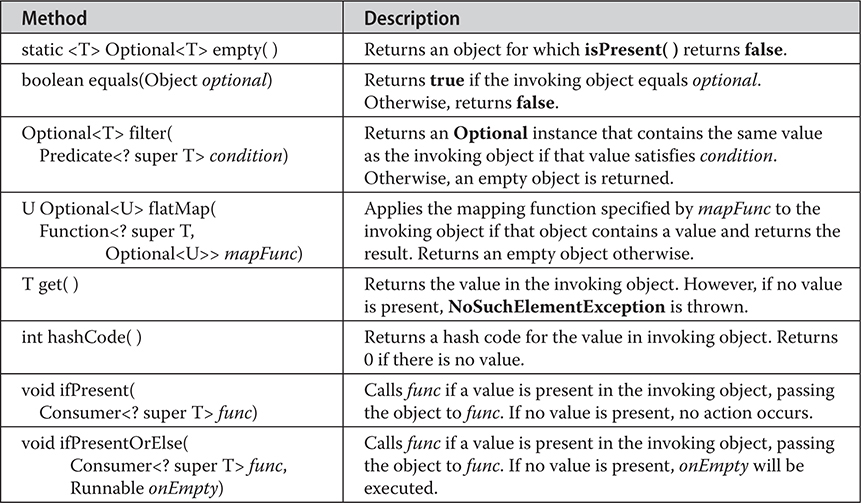
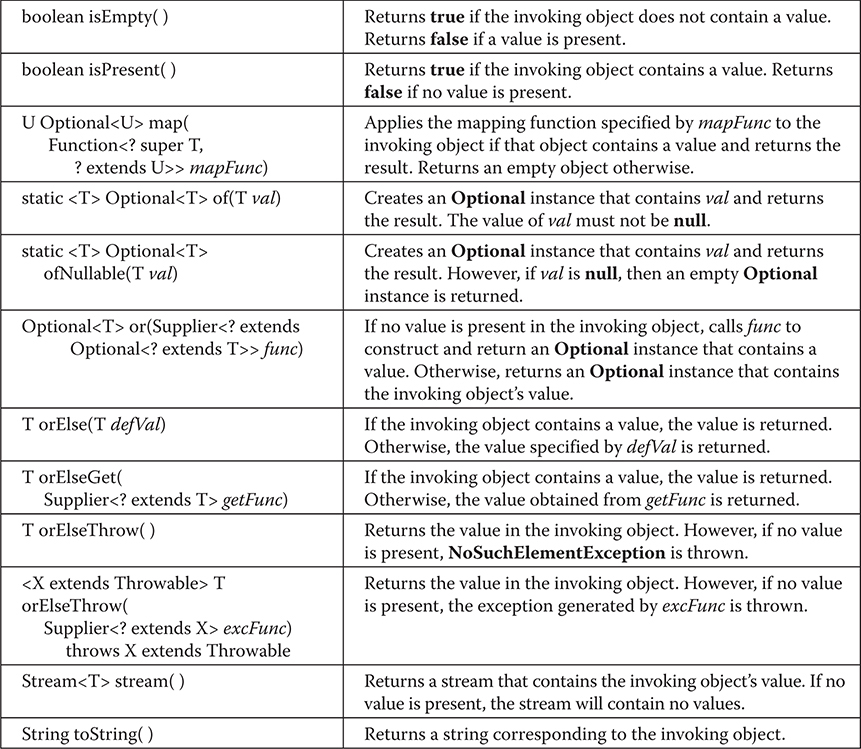
Table 21-3 The Methods Defined by Optional
The best way to understand Optional is to work through an example that uses its core methods. At the foundation of Optional are isPresent( ) and get( ). You can determine if a value is present by calling isPresent( ). If a value is available, it will return true. Otherwise, false is returned. If a value is present in an Optional instance, you can obtain it by calling get( ). However, if you call get( ) on an object that does not contain a value, NoSuchElementException is thrown. For this reason, you should always first confirm that a value is present before calling get( ) on an Optional object. Beginning with JDK 10, the parameterless version of orElseThrow( ) can be used instead of get( ), and its name adds clarity to the operation. However, the examples in this book will use get( ) so that the code will compile for readers using earlier versions of Java.
Of course, having to call two methods to retrieve a value adds overhead to each access. Fortunately, Optional defines methods that combine the check for a value with the retrieval of the value. One such method is orElse( ). If the object on which it is called contains a value, the value is returned. Otherwise, a default value is returned.
Optional does not define any constructors. Instead, you will use one of its methods to create an instance. For example, you can create an Optional instance with a specified value by using of( ). You can create an instance of Optional that does not contain a value by using empty( ).
The following program demonstrates these methods:
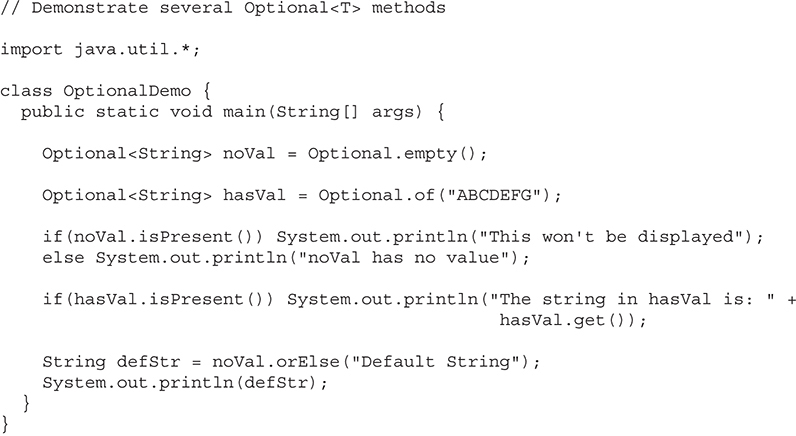
The output is shown here:
noVal has no value
The string in hasVal is: ABCDEFG
Default String
As the output shows, a value can be obtained from an Optional object only if one is present. This basic mechanism enables Optional to prevent null pointer exceptions.
The OptionalDouble, OptionalInt, and OptionalLong classes work much like Optional, except that they are designed expressly for use on double, int, and long values, respectively. As such, they specify the methods getAsDouble( ), getAsInt( ), and getAsLong( ), respectively, rather than get( ). Also, they do not support the filter( ), ofNullable( ), map( ), flatMap( ), and or( ) methods.
The Date class encapsulates the current date and time. Before beginning our examination of Date, it is important to point out that it has changed substantially from its original version defined by Java 1.0. When Java 1.1 was released, many of the functions carried out by the original Date class were moved into the Calendar and DateFormat classes, and as a result, many of the original 1.0 Date methods were deprecated. Since the deprecated 1.0 methods should not be used for new code, they are not described here.
Date supports the following non-deprecated constructors:
Date( )
Date(long millisec)
The first constructor initializes the object with the current date and time. The second constructor accepts one argument that equals the number of milliseconds that have elapsed since midnight, January 1, 1970. The non-deprecated methods defined by Date are shown in Table 21-4. Date also implements the Comparable interface.
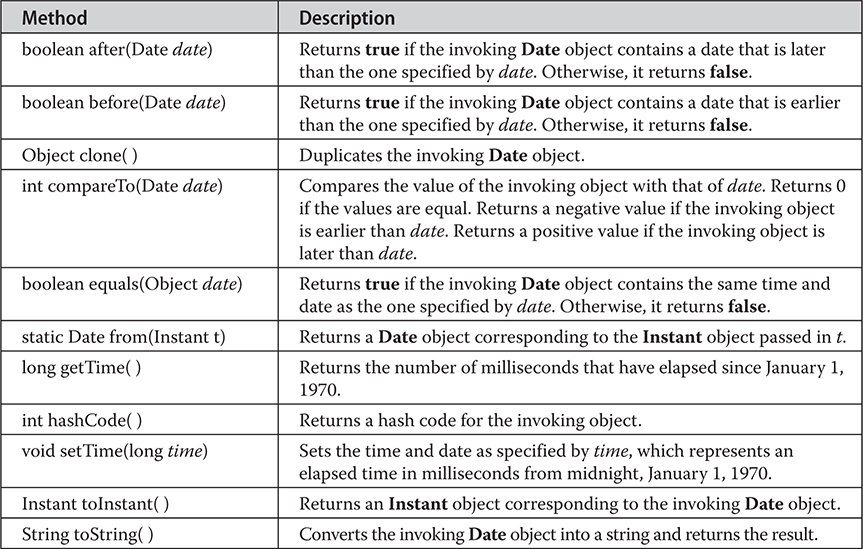
Table 21-4 The Nondeprecated Methods Defined by Date
As you can see by examining Table 21-4, the non-deprecated Date features do not allow you to obtain the individual components of the date or time. As the following program demonstrates, you can only obtain the date and time in terms of milliseconds, in its default string representation as returned by toString( ), or as an Instant object. To obtain more-detailed information about the date and time, you will use the Calendar class.
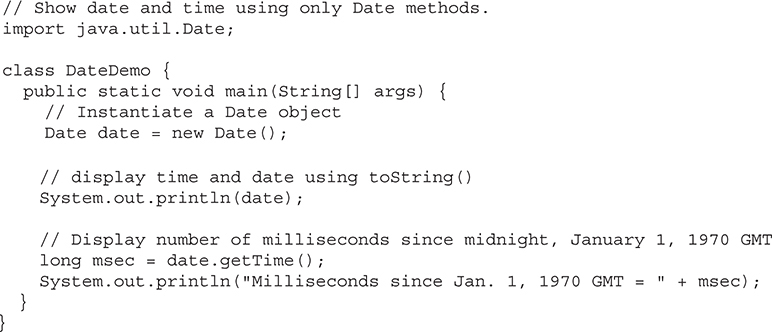
Sample output is shown here:
Sat Jan 01 10:52:44 CST 2022
Milliseconds since Jan. 1, 1970 GMT = 1641056951341
The abstract Calendar class provides a set of methods that allows you to convert a time in milliseconds to a number of useful components. Some examples of the type of information that can be provided are year, month, day, hour, minute, and second. It is intended that subclasses of Calendar will provide the specific functionality to interpret time information according to their own rules. This is one aspect of the Java class library that enables you to write programs that can operate in international environments. An example of such a subclass is GregorianCalendar.
Note Another date and time API is found in java.time. See Chapter 31.
Calendar provides no public constructors. Calendar defines several protected instance variables. areFieldsSet is a boolean that indicates if the time components have been set. fields is an array of ints that holds the components of the time. isSet is a boolean array that indicates if a specific time component has been set. time is a long that holds the current time for this object. isTimeSet is a boolean that indicates if the current time has been set.
A sampling of methods defined by Calendar are shown in Table 21-5.

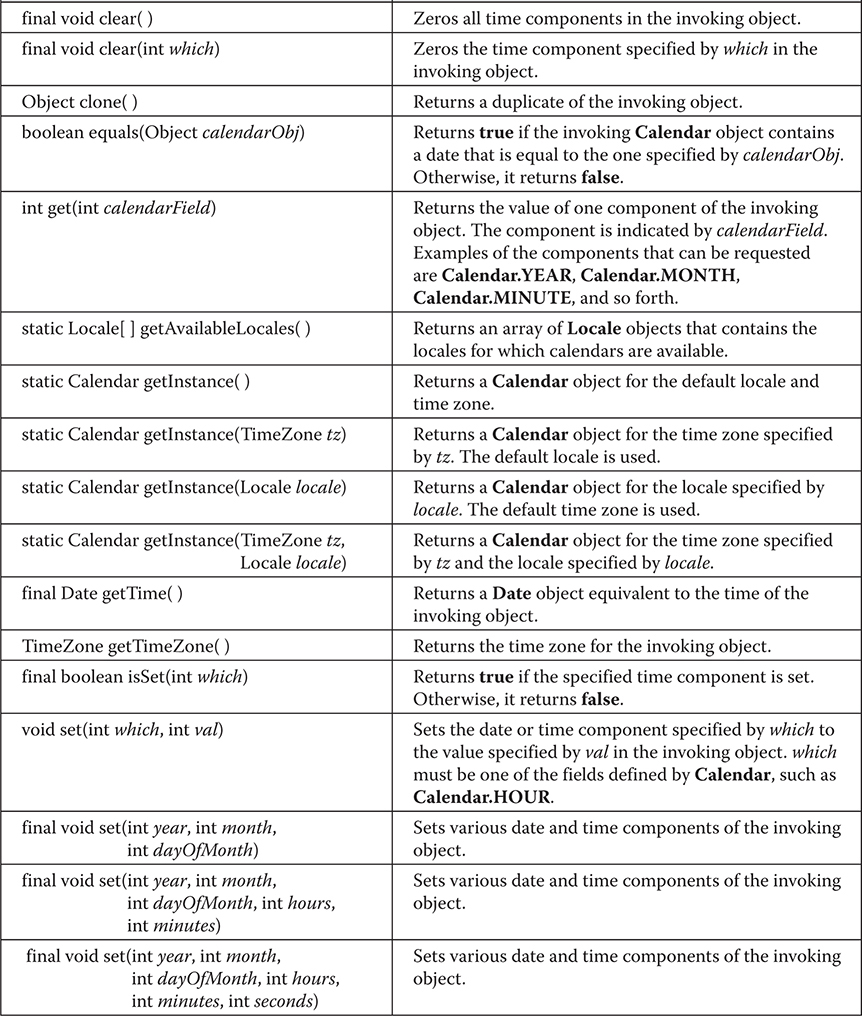

Table 21-5 A Sampling of the Methods Defined by Calendar
Calendar defines the following int constants, which are used when you get or set components of the calendar.

The following program demonstrates several Calendar methods:
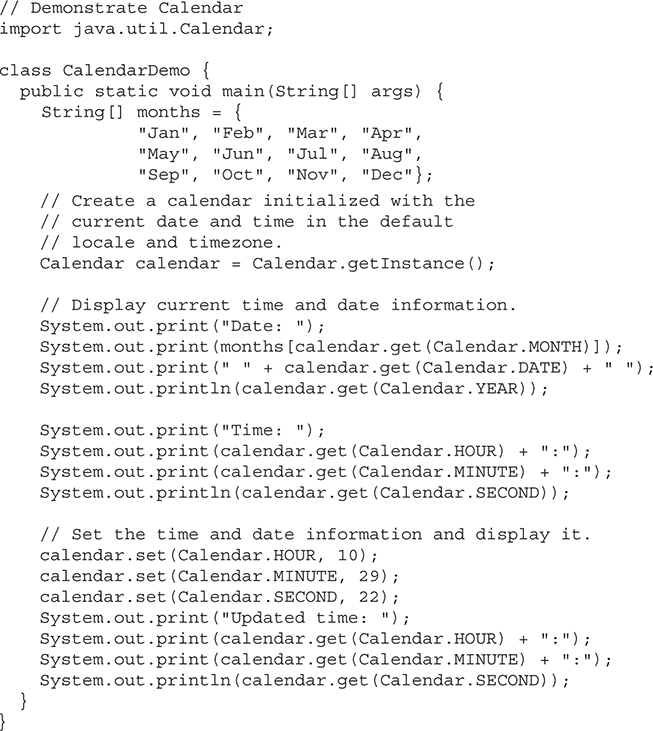
Sample output is shown here:
Date: Jan 1 2022
Time: 11:29:39
Updated time: 10:29:22
GregorianCalendar is a concrete implementation of a Calendar that implements the normal Gregorian calendar with which you are familiar. The getInstance( ) method of Calendar will typically return a GregorianCalendar initialized with the current date and time in the default locale and time zone.
GregorianCalendar defines two fields: AD and BC. These represent the two eras defined by the Gregorian calendar.
There are also several constructors for GregorianCalendar objects. The default, GregorianCalendar( ), initializes the object with the current date and time in the default locale and time zone. Three more constructors offer increasing levels of specificity:
GregorianCalendar(int year, int month, int dayOfMonth)
GregorianCalendar(int year, int month, int dayOfMonth, int hours,
int minutes)
GregorianCalendar(int year, int month, int dayOfMonth, int hours,
int minutes, int seconds)
All three versions set the day, month, and year. Here, year specifies the year. The month is specified by month, with zero indicating January. The day of the month is specified by dayOfMonth. The first version sets the time to midnight. The second version also sets the hours and the minutes. The third version adds seconds.
You can also construct a GregorianCalendar object by specifying the locale and/or time zone. The following constructors create objects initialized with the current date and time using the specified time zone and/or locale:
GregorianCalendar(Locale locale)
GregorianCalendar(TimeZone timeZone)
GregorianCalendar(TimeZone timeZone, Locale locale)
GregorianCalendar provides an implementation of all the abstract methods in Calendar. It also provides some additional methods. Perhaps the most interesting is isLeapYear( ), which tests if the year is a leap year. Its form is
boolean isLeapYear(int year)
This method returns true if year is a leap year and false otherwise. Two other methods of interest are from( ) and toZonedDateTime( ), which support the date and time API added by JDK 8 and packaged in java.time.
The following program demonstrates GregorianCalendar:
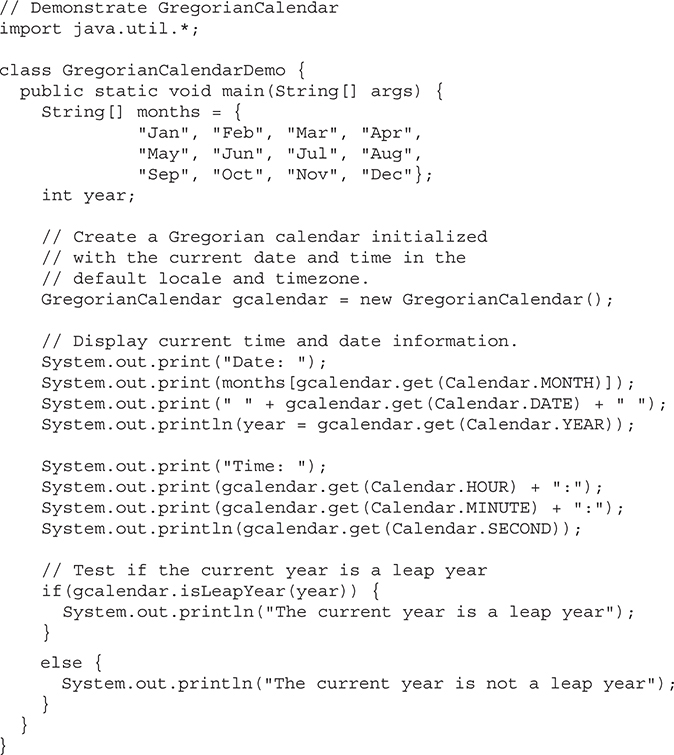
Sample output is shown here:
Date: Jan 1 2022
Time: 1:45:5
The current year is not a leap year
Another time-related class is TimeZone. The abstract TimeZone class allows you to work with time zone offsets from Greenwich mean time (GMT), also referred to as Coordinated Universal Time (UTC). It also computes daylight saving time. TimeZone only supplies the default constructor.
A sampling of methods defined by TimeZone is given in Table 21-6.
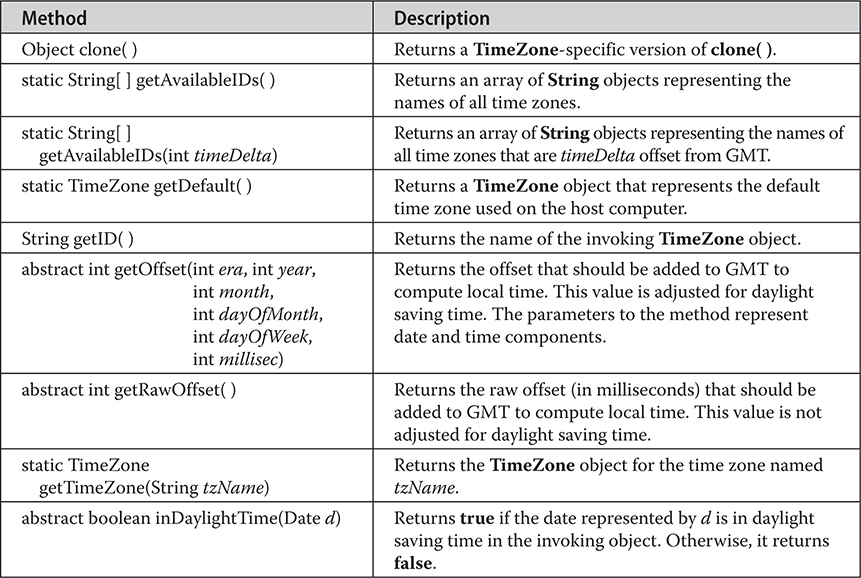

Table 21-6 A Sampling of the Methods Defined by TimeZone
The SimpleTimeZone class is a convenient subclass of TimeZone. It implements TimeZone's abstract methods and allows you to work with time zones for a Gregorian calendar. It also computes daylight saving time.
SimpleTimeZone defines four constructors. One is
SimpleTimeZone(int timeDelta, String tzName)
This constructor creates a SimpleTimeZone object. The offset relative to Greenwich mean time (GMT) is timeDelta. The time zone is named tzName.
The second SimpleTimeZone constructor is
SimpleTimeZone(int timeDelta, String tzId, int dstMonth0,
int dstDayInMonth0, int dstDay0, int time0,
int dstMonth1, int dstDayInMonth1, int dstDay1,
int time1)
Here, the offset relative to GMT is specified in timeDelta. The time zone name is passed in tzId. The start of daylight saving time is indicated by the parameters dstMonth0, dstDayInMonth0, dstDay0, and time0. The end of daylight saving time is indicated by the parameters dstMonth1, dstDayInMonth1, dstDay1, and time1.
The third SimpleTimeZone constructor is
SimpleTimeZone(int timeDelta, String tzId, int dstMonth0,
int dstDayInMonth0, int dstDay0, int time0,
int dstMonth1, int dstDayInMonth1,
int dstDay1, int time1, int dstDelta)
Here, dstDelta is the number of milliseconds saved during daylight saving time.
The fourth SimpleTimeZone constructor is:
SimpleTimeZone(int timeDelta, String tzId, int dstMonth0,
int dstDayInMonth0, int dstDay0, int time0,
int time0mode, int dstMonth1, int dstDayInMonth1,
int dstDay1, int time1, int time1mode, int dstDelta)
Here, time0mode specifies the mode of the starting time, and time1mode specifies the mode of the ending time. Valid mode values include:

The time mode indicates how the time values are interpreted. The default mode used by the other constructors is WALL_TIME.
The Locale class is instantiated to produce objects that describe a geographical or cultural region. It is one of several classes that provide you with the ability to write programs that can execute in different international environments. For example, the formats used to display dates, times, and numbers are different in various regions.
Internationalization is a large topic that is beyond the scope of this book. However, many programs will only need to deal with its basics, which include setting the current locale.
The Locale class defines the following constants that are useful for dealing with several common locales:

For example, the expression Locale.CANADA represents the Locale object for Canada.
The constructors for Locale are
Locale(String language)
Locale(String language, String country)
Locale(String language, String country, String variant)
These constructors build a Locale object to represent a specific language and in the case of the last two, country. These values must contain standard language and country codes. Auxiliary variant information can be provided in variant.
Locale defines several methods. One of the most important is setDefault( ), shown here:
static void setDefault(Locale localeObj)
This sets the default locale used by the JVM to that specified by localeObj.
Some other interesting methods are the following:
final String getDisplayCountry( )
final String getDisplayLanguage( )
final String getDisplayName( )
These return human-readable strings that can be used to display the name of the country, the name of the language, and the complete description of the locale.
The default locale can be obtained using getDefault( ), shown here:
static Locale getDefault( )
JDK 7 added significant upgrades to the Locale class that support Internet Engineering Task Force (IETF) BCP 47, which defines tags for identifying languages, and Unicode Technical Standard (UTS) 35, which defines the Locale Data Markup Language (LDML). Support for BCP 47 and UTS 35 caused several features to be added to Locale, including several new methods and the Locale.Builder class. Among others, new methods include getScript( ), which obtains the locale’s script, and toLanguageTag( ), which obtains a string that contains the locale’s language tag. The Locale.Builder class constructs Locale instances. It ensures that a locale specification is well-formed as defined by BCP 47. (The Locale constructors do not provide such a check.) Several new methods were also added to Locale by JDK 8. Among these are methods that support filtering, extensions, and lookups. JDK 9 added a method called getISOCountries( ), which returns a collection of country codes for a given Locale.IsoCountryCode enumeration value.
Calendar and GregorianCalendar are examples of classes that operate in a locale-sensitive manner. DateFormat and SimpleDateFormat also depend on the locale.
The Random class is a generator of pseudorandom numbers. These are called pseudorandom numbers because they are simply uniformly distributed sequences. Beginning with JDK 17, Random implements the new RandomGenerator interface, which provides a standardized interface for random value generators.
Random defines the following constructors:
Random( )
Random(long seed)
The first version creates a number generator that uses a reasonably unique seed. The second form allows you to specify a seed value manually.
If you initialize a Random object with a seed, you define the starting point for the random sequence. If you use the same seed to initialize another Random object, you will extract the same random sequence. If you want to generate different sequences, specify different seed values. One way to do this is to use the current time to seed a Random object. This approach reduces the possibility of getting repeated sequences.
The core public methods provided by Random are shown in Table 21-7. These are the methods that have been available in Random for several years (many since Java 1.0) and are widely used.
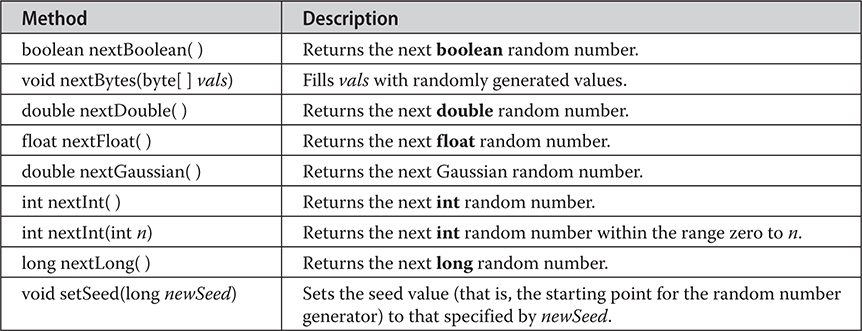
Table 21-7 The Core Methods Defined by Random
As you can see, there are seven types of random numbers that you can extract from a Random object. Random Boolean values are available from nextBoolean( ). Random bytes can be obtained by calling nextBytes( ). Integers can be extracted via the nextInt( ) method. Long integers can be obtained with nextLong( ). The nextFloat( ) and nextDouble( ) methods return float and double values, respectively, between 0.0 and 1.0. Finally, nextGaussian( ) returns a double value centered at 0.0 with a standard deviation of 1.0. This is what is known as a bell curve.
Here is an example that demonstrates the sequence produced by nextGaussian( ). It obtains 100 random Gaussian values and averages these values. The program also counts the number of values that fall within two standard deviations, plus or minus, using increments of 0.5 for each category. The result is graphically displayed sideways on the screen.
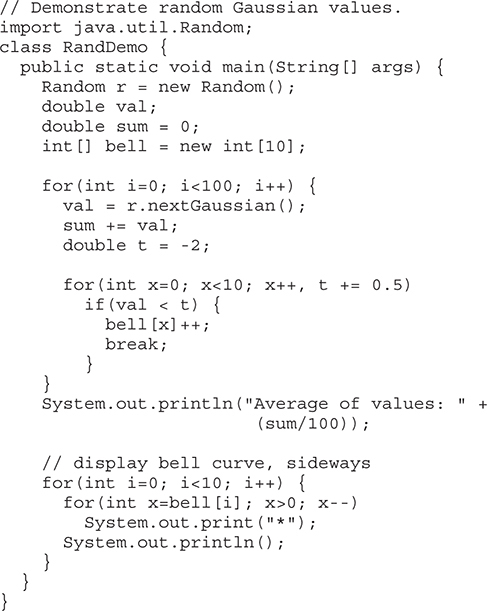
Here is a sample program run. As you can see, a bell-like distribution of numbers is obtained.
Average of values: 0.0702235271133344
**
*******
******
***************
******************
*****************
*************
**********
********
***
It is useful to point out that JDK 8 added three methods to Random that support the stream API (see Chapter 30). They are called doubles( ), ints( ), and longs( ), and each returns a reference to a stream that contains a sequence of pseudorandom values of the specified type. Each method defines several overloads. Here are their simplest forms:
DoubleStream doubles( )
IntStream ints( )
LongStream longs( )
The doubles( ) method returns a stream that contains pseudorandom double values. (The range of these values will be less than 1.0 but greater than or equal to 0.0.) The ints( ) method returns a stream that contains pseudorandom int values. The longs( ) method returns a stream that contains pseudorandom long values. For these three methods, the stream returned is effectively infinite. Several overloads of each method are provided that let you specify the size of the stream, an origin, and an upper bound.
An interesting and useful feature offered by java.util is the ability to schedule a task for execution at some future time. The classes that support this are Timer and TimerTask. Using these classes, you can create a thread that runs in the background, waiting for a specific time. When the time arrives, the task linked to that thread is executed. Various options allow you to schedule a task for repeated execution, and to schedule a task to run on a specific date. Although it was always possible to manually create a task that would be executed at a specific time using the Thread class, Timer and TimerTask greatly simplify this process.
Timer and TimerTask work together. Timer is the class that you will use to schedule a task for execution. The task being scheduled must be an instance of TimerTask. Thus, to schedule a task, you will first create a TimerTask object and then schedule it for execution using an instance of Timer.
TimerTask implements the Runnable interface; thus, it can be used to create a thread of execution. Its constructor is shown here:
protected TimerTask( )
TimerTask defines the methods shown in Table 21-8. Notice that run( ) is abstract, which means that it must be overridden. The run( ) method, defined by the Runnable interface, contains the code that will be executed. Thus, the easiest way to create a timer task is to extend TimerTask and override run( ).

Table 21-8 The Methods Defined by TimerTask
Once a task has been created, it is scheduled for execution by an object of type Timer. The constructors for Timer are shown here:
Timer( )
Timer(boolean DThread)
Timer(String tName)
Timer(String tName, boolean DThread)
The first version creates a Timer object that runs as a normal thread. The second uses a daemon thread if DThread is true. A daemon thread will execute only as long as the rest of the program continues to execute. The third and fourth constructors allow you to specify a name for the Timer thread. The methods defined by Timer are shown in Table 21-9.
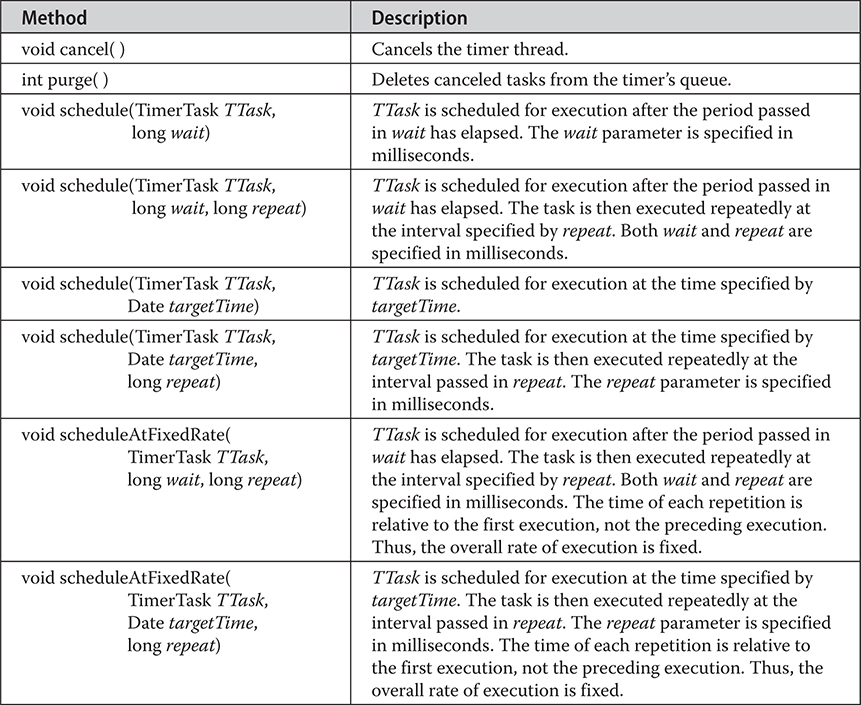
Table 21-9 The Methods Defined by Timer
Once a Timer has been created, you will schedule a task by calling schedule( ) on the Timer that you created. As Table 21-9 shows, there are several forms of schedule( ) which allow you to schedule tasks in a variety of ways.
If you create a non-daemon task, then you will want to call cancel( ) to end the task when your program ends. If you don’t do this, then your program may "hang" for a period of time.
The following program demonstrates Timer and TimerTask. It defines a timer task whose run( ) method displays the message "Timer task executed." This task is scheduled to run once every half second after an initial delay of one second.
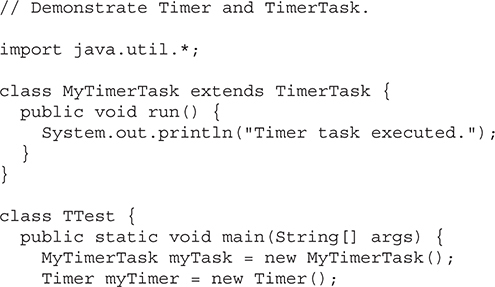
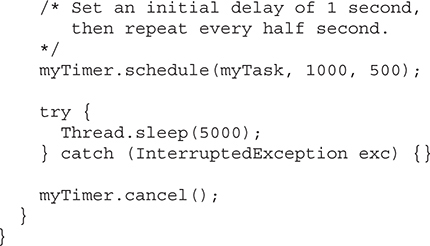
The Currency class encapsulates information about a currency. It defines no constructors. The methods supported by Currency are shown in Table 21-10. The following program demonstrates Currency:
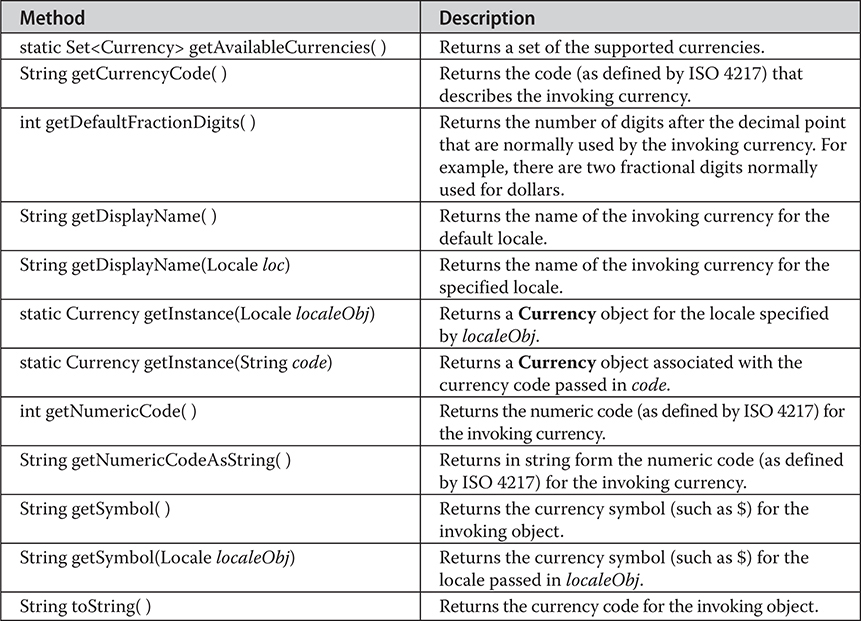
Table 21-10 The Methods Defined by Currency
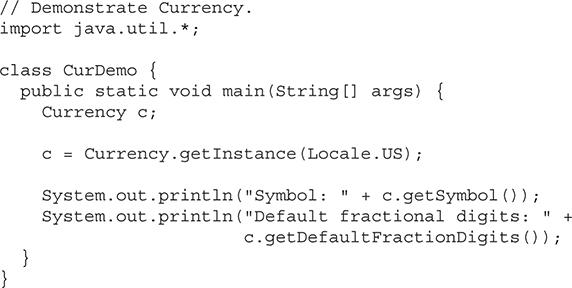
The output is shown here:
Symbol: $
Default fractional digits: 2
At the core of Java’s support for creating formatted output is the Formatter class. It provides format conversions that let you display numbers, strings, and time and date in virtually any format you like. It operates in a manner similar to the C/C++ printf( ) function, which means that if you are familiar with C/C++, then learning to use Formatter will be very easy. It also further streamlines the conversion of C/C++ code to Java. If you are not familiar with C/C++, it is still quite easy to format data.
Note Although Java’s Formatter class operates in a manner very similar to the C/C++ printf( ) function, there are some differences, and some new features. Therefore, if you have a C/C++ background, a careful reading is advised.
Before you can use Formatter to format output, you must create a Formatter object. In general, Formatter works by converting the binary form of data used by a program into formatted text. It stores the formatted text in a buffer, the contents of which can be obtained by your program whenever they are needed. It is possible to let Formatter supply this buffer automatically, or you can specify the buffer explicitly when a Formatter object is created. It is also possible to have Formatter output its buffer to a file.
The Formatter class defines many constructors, which enable you to construct a Formatter in a variety of ways. Here is a sampling:
Formatter( )
Formatter(Appendable buf)
Formatter(Appendable buf, Locale loc)
Formatter(String filename)
throws FileNotFoundException
Formatter(String filename, String charset)
throws FileNotFoundException, UnsupportedEncodingException
Formatter(File outF)
throws FileNotFoundException
Formatter(OutputStream outStrm)
Here, buf specifies a buffer for the formatted output. If buf is null, then Formatter automatically allocates a StringBuilder to hold the formatted output. The loc parameter specifies a locale. If no locale is specified, the default locale is used. The filename parameter specifies the name of a file that will receive the formatted output. The charset parameter specifies the character set. If no character set is specified, then the default character set is used. The outF parameter specifies a reference to an open file that will receive output. The outStrm parameter specifies a reference to an output stream that will receive output. When using a file, output is also written to the file.
Perhaps the most widely used constructor is the first, which has no parameters. It automatically uses the default locale and allocates a StringBuilder to hold the formatted output.
Formatter defines the methods shown in Table 21-11.
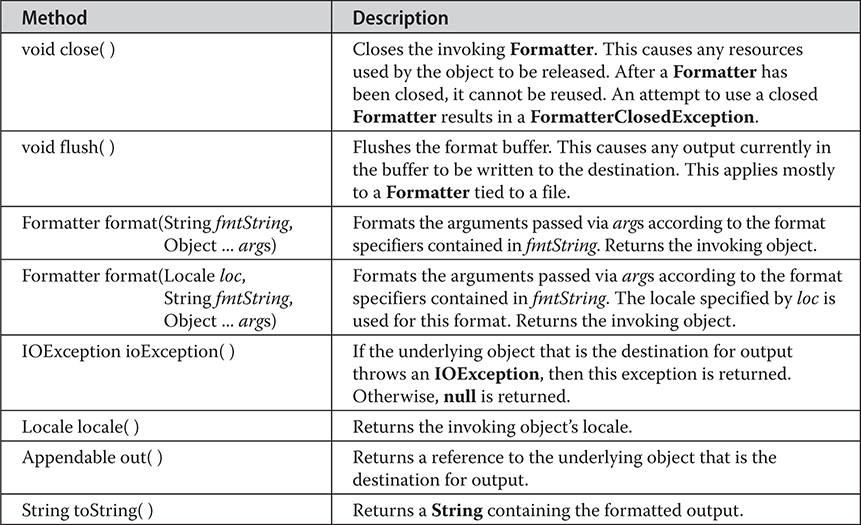
Table 21-11 The Methods Defined by Formatter
After you have created a Formatter, you can use it to create a formatted string. To do so, use the format( ) method. The version we will use is shown here:
Formatter format(String fmtString, Object ... args)
The fmtSring consists of two types of items. The first type is composed of characters that are simply copied to the output buffer. The second type contains format specifiers that define the way the subsequent arguments are displayed.
In its simplest form, a format specifier begins with a percent sign followed by the format conversion specifier. All format conversion specifiers consist of a single character. For example, the format specifier for floating-point data is %f. In general, there must be the same number of arguments as there are format specifiers, and the format specifiers and the arguments are matched in order from left to right. For example, consider this fragment:
Formatter fmt = new Formatter();
fmt.format("Formatting %s is easy %d %f", "with Java", 10, 98.6);
This sequence creates a Formatter that contains the following string:
Formatting with Java is easy 10 98.600000
In this example, the format specifiers, %s, %d, and %f, are replaced with the arguments that follow the format string. Thus, %s is replaced by “with Java”, %d is replaced by 10, and %f is replaced by 98.6. All other characters are simply used as-is. As you might guess, the format specifier %s specifies a string, and %d specifies an integer value. As mentioned earlier, the %f specifies a floating-point value.
The format( ) method accepts a wide variety of format specifiers, which are shown in Table 21-12. Notice that many specifiers have both upper- and lowercase forms. When an uppercase specifier is used, then letters are shown in uppercase. Otherwise, the upper- and lowercase specifiers perform the same conversion. It is important to understand that Java type-checks each format specifier against its corresponding argument. If the argument doesn’t match, an IllegalFormatException is thrown.
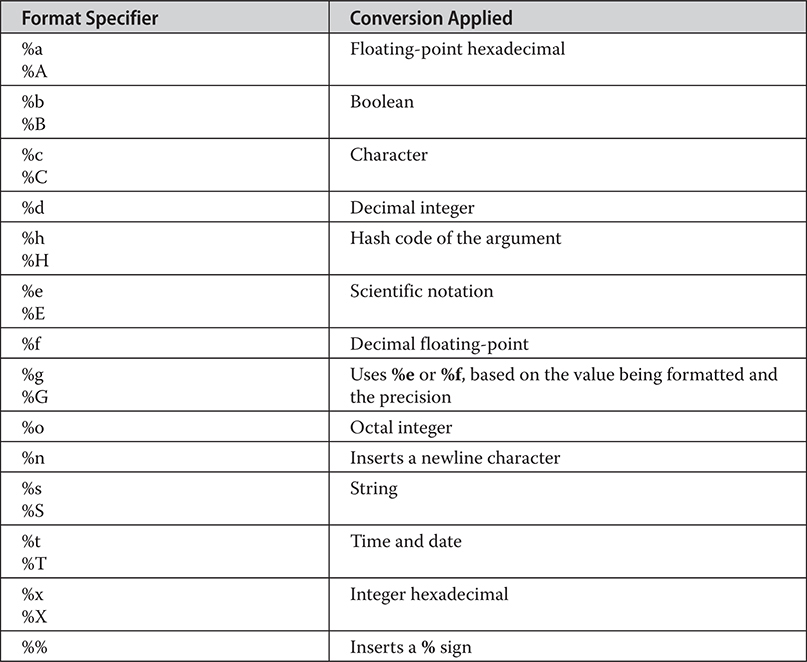
Table 21-12 The Format Specifiers
Once you have formatted a string, you can obtain it by calling toString( ). For example, continuing with the preceding example, the following statement obtains the formatted string contained in fmt:
String str = fmt.toString();
Of course, if you simply want to display the formatted string, there is no reason to first assign it to a String object. When a Formatter object is passed to println( ), for example, its toString( ) method is automatically called.
Here is a short program that puts together all of the pieces, showing how to create and display a formatted string:
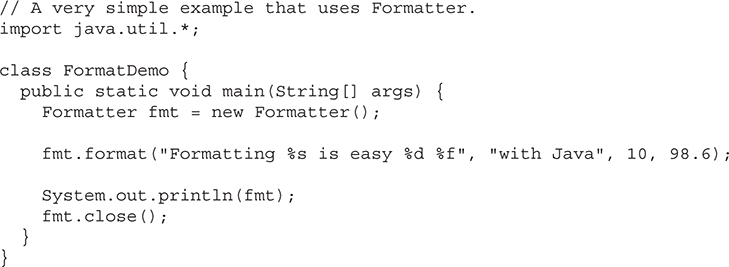
One other point: You can obtain a reference to the underlying output buffer by calling out( ). It returns a reference to an Appendable object.
Now that you know the general mechanism used to create a formatted string, the remainder of this section discusses in detail each conversion. It also describes various options, such as justification, minimum field width, and precision.
To format an individual character, use %c. This causes the matching character argument to be output, unmodified. To format a string, use %s.
To format an integer in decimal format, use %d. To format a floating-point value in decimal format, use %f. To format a floating-point value in scientific notation, use %e. Numbers represented in scientific notation take this general form:
x.dddddde+/–yy
The %g format specifier causes Formatter to use either %f or %e, based on the value being formatted and the precision, which is 6 by default. The following program demonstrates the effect of the %f and %e format specifiers:
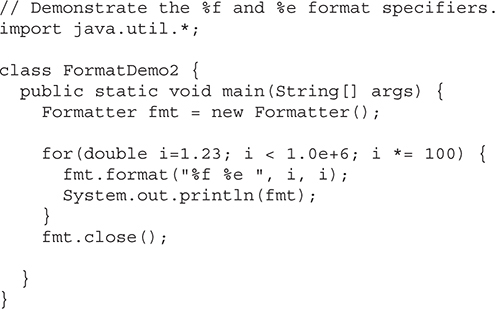
It produces the following output:
1.230000 1.230000e+00
1.230000 1.230000e+00 123.000000 1.230000e+02
1.230000 1.230000e+00 123.000000 1.230000e+02 12300.000000 1.230000e+04
You can display integers in octal or hexadecimal format by using %o and %x, respectively. For example, this fragment:
fmt.format("Hex: %x, Octal: %o", 196, 196);
produces this output:
Hex: c4, Octal: 304
You can display floating-point values in hexadecimal format by using %a. The format produced by %a appears a bit strange at first glance. This is because its representation uses a form similar to scientific notation that consists of a hexadecimal significand and a decimal exponent of powers of 2. Here is the general format:
0x1.sigpexp
Here, sig contains the fractional portion of the significand and exp contains the exponent. The p indicates the start of the exponent. For example, this call:
fmt.format("%a", 512.0);
produces this output:
0x1.0p9
One of the more powerful conversion specifiers is %t. It lets you format time and date information. The %t specifier works a bit differently than the others because it requires the use of a suffix to describe the portion and precise format of the time or date desired. The suffixes are shown in Table 21-13. For example, to display minutes, you would use %tM, where M indicates minutes in a two-character field. The argument corresponding to the %t specifier must be of type Calendar, Date, Long, long, or TemporalAccessor.


Table 21-13 The Time and Date Format Suffixes
Here is a program that demonstrates several of the formats:
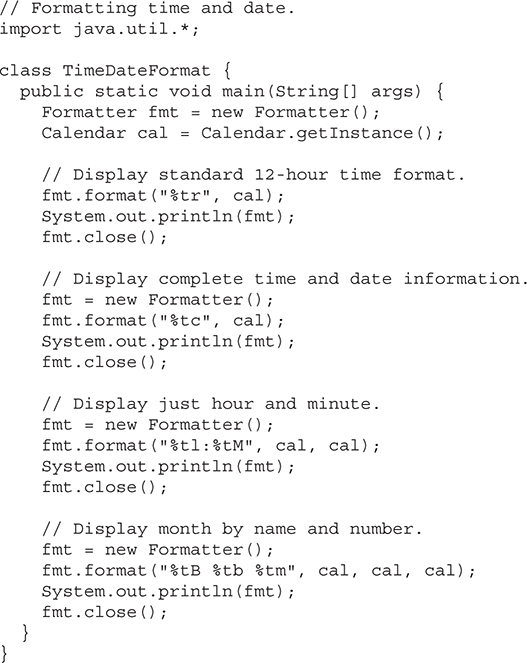
Sample output is shown here:
03:15:34 PM
Sat Jan 01 15:15:34 CST 2022
3:15
January Jan 01
The %n and%% format specifiers differ from the others in that they do not match an argument. Instead, they are simply escape sequences that insert a character into the output sequence. The %n inserts a newline. The %% inserts a percent sign. Neither of these characters can be entered directly into the format string. Of course, you can also use the standard escape sequence \n to embed a newline character.
Here is an example that demonstrates the %n and %% format specifiers:
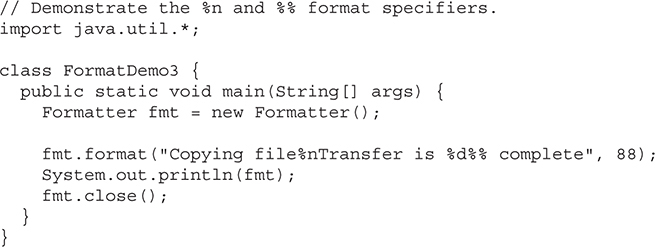
It displays the following output:
Copying file
Transfer is 88% complete
An integer placed between the % sign and the format conversion code acts as a minimum field-width specifier. This pads the output with spaces to ensure that it reaches a certain minimum length. If the string or number is longer than that minimum, it will still be printed in full. The default padding is done with spaces. If you want to pad with 0’s, place a 0 before the field-width specifier. For example, %05d will pad a number of less than five digits with 0’s so that its total length is five. The field-width specifier can be used with all format specifiers except %n.
The following program demonstrates the minimum field-width specifier by applying it to the %f conversion:
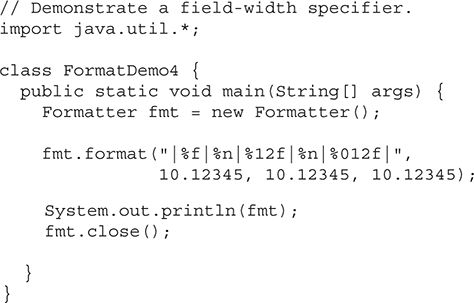
This program produces the following output:

The first line displays the number 10.12345 in its default width. The second line displays that value in a 12-character field. The third line displays the value in a 12-character field, padded with leading zeros.
The minimum field-width modifier is often used to produce tables in which the columns line up. For example, the next program produces a table of squares and cubes for the numbers between 1 and 10:
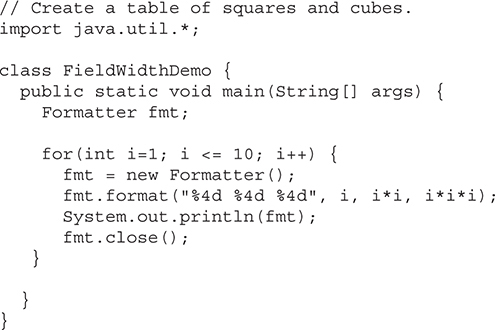
Its output is shown here:
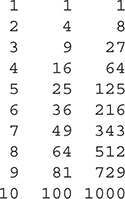
A precision specifier can be applied to the %f, %e, %g, and %s format specifiers, among others. It follows the minimum field-width specifier (if there is one) and consists of a period followed by an integer. Its exact meaning depends upon the type of data to which it is applied.
When you apply the precision specifier to floating-point data using the %f or %e specifiers, it determines the number of decimal places displayed. For example, %10.4f displays a number at least ten characters wide with four decimal places. When using %g, the precision determines the number of significant digits. The default precision is 6.
Applied to strings, the precision specifier specifies the maximum field length. For example, %5.7s displays a string of at least five and not exceeding seven characters long. If the string is longer than the maximum field width, the end characters will be truncated.
The following program illustrates the precision specifier:
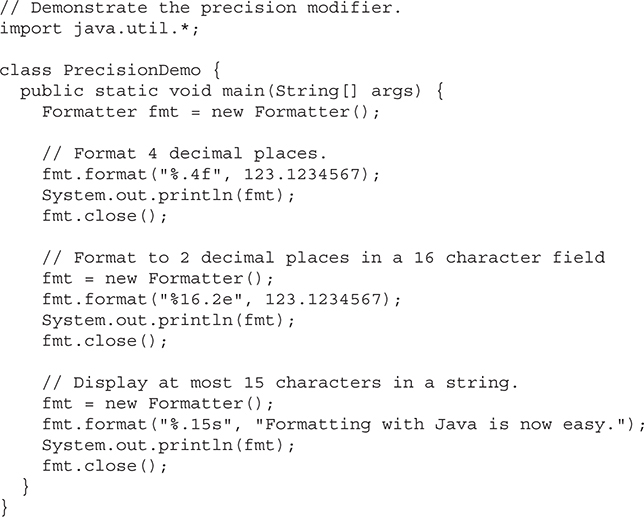
It produces the following output:

Formatter recognizes a set of format flags that lets you control various aspects of a conversion. All format flags are single characters, and a format flag follows the % in a format specification. The flags are shown here:

Not all flags apply to all format specifiers. The following sections explain each in detail.
By default, all output is right-justified. That is, if the field width is larger than the data printed, the data will be placed on the right edge of the field. You can force output to be left-justified by placing a minus sign directly after the %. For instance, %–10.2f left-justifies a floating-point number with two decimal places in a 10-character field. For example, consider this program:
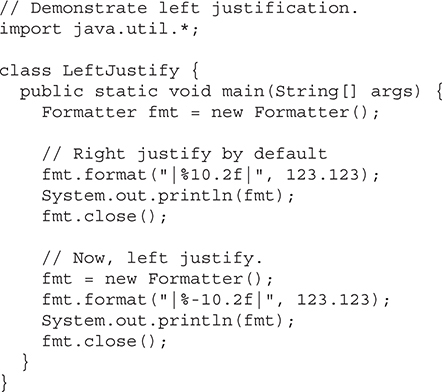
It produces the following output:

As you can see, the second line is left-justified within a 10-character field.
To cause a + sign to be shown before positive numeric values, add the + flag. For example,
fmt.format("%+d", 100);
creates this string:
+100
When creating columns of numbers, it is sometimes useful to output a space before positive values so that positive and negative values line up. To do this, add the space flag. For example,
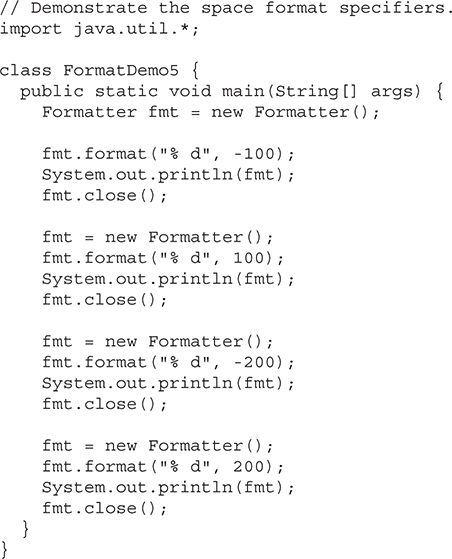
The output is shown here:

Notice that the positive values have a leading space, which causes the digits in the column to line up properly.
To show negative numeric output inside parentheses, rather than with a leading –, use the ( flag. For example,
fmt.format("%(d", -100);
creates this string:
(100)
The 0 flag causes output to be padded with zeros rather than spaces.
When displaying large numbers, it is often useful to add grouping separators, which in English are commas. For example, the value 1234567 is more easily read when formatted as 1,234,567. To add grouping specifiers, use the comma (,) flag. For example,
fmt.format("%,.2f", 4356783497.34);
creates this string:
4,356,783,497.34
The # can be applied to %o, %x, %e, and %f. For %e, and %f, the # ensures that there will be a decimal point even if there are no decimal digits. If you precede the %x format specifier with a #, the hexadecimal number will be printed with a 0x prefix. Preceding the %o specifier with # causes the number to be printed with a leading zero.
As mentioned earlier, several of the format specifiers have uppercase versions that cause the conversion to use uppercase where appropriate. The following table describes the effect.
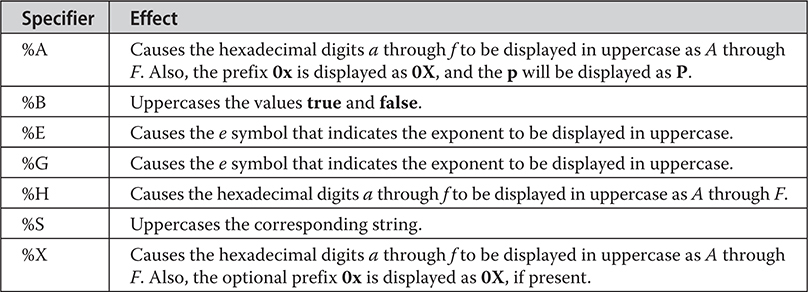
For example, this call:
fmt.format("%X", 250);
creates this string:
FA
This call:
fmt.format("%E", 123.1234);
creates this string:
1.231234E+02
Formatter includes a very useful feature that lets you specify the argument to which a format specifier applies. Normally, format specifiers and arguments are matched in order, from left to right. That is, the first format specifier matches the first argument, the second format specifier matches the second argument, and so on. However, by using an argument index, you can explicitly control which argument a format specifier matches.
An argument index immediately follows the % in a format specifier. It has the following format:
n$
where n is the index of the desired argument, beginning with 1. For example, consider this example:
fmt.format("%3$d %1$d %2$d", 10, 20, 30);
It produces this string:
30 10 20
In this example, the first format specifier matches 30, the second matches 10, and the third matches 20. Thus, the arguments are used in an order other than strictly left to right.
One advantage of argument indexes is that they enable you to reuse an argument without having to specify it twice. For example, consider this line:
fmt.format("%d in hex is %1$x", 255);
It produces the following string:
255 in hex is ff
As you can see, the argument 255 is used by both format specifiers.
There is a convenient shorthand called a relative index that enables you to reuse the argument matched by the preceding format specifier. Simply specify < for the argument index. For example, the following call to format( ) produces the same results as the previous example:
fmt.format("%d in hex is %<x", 255);
Relative indexes are especially useful when creating custom time and date formats. Consider the following example:
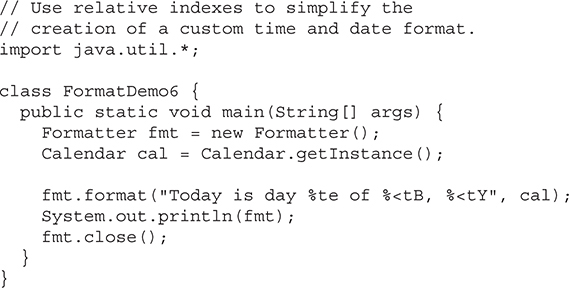
Here is sample output:
Today is day 1 of January, 2022
Because of relative indexing, the argument cal need only be passed once, rather than three times.
In general, you should close a Formatter when you are done using it. Doing so frees any resources that it was using. This is especially important when formatting to a file, but it can be important in other cases, too. As the previous examples have shown, one way to close a Formatter is to explicitly call close( ). However, Formatter also implements the AutoCloseable interface. This means that it supports the try-with-resources statement. Using this approach, the Formatter is automatically closed when it is no longer needed.
The try-with-resources statement is described in Chapter 13, in connection with files, because files are some of the most commonly used resources that must be closed. However, the same basic techniques apply here. For example, here is the first Formatter example reworked to use automatic resource management:
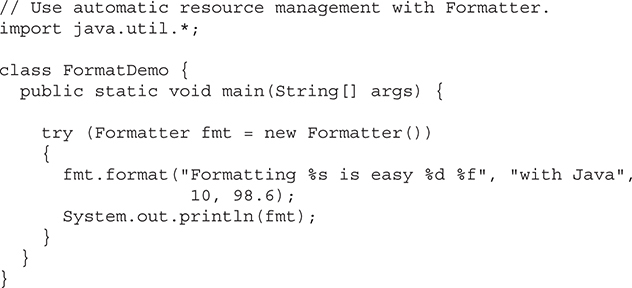
The output is the same as before.
Although there is nothing technically wrong with using Formatter directly (as the preceding examples have done) when creating output that will be displayed on the console, there is a more convenient alternative: the printf( ) method. The printf( ) method automatically uses Formatter to create a formatted string. It then displays that string on System.out, which is the console by default. The printf( ) method is defined by both PrintStream and PrintWriter. The printf( ) method is described in Chapter 22.
Scanner is the complement of Formatter. It reads formatted input and converts it into its binary form. Scanner can be used to read input from the console, a file, a string, or any source that implements the Readable interface or ReadableByteChannel. For example, you can use Scanner to read a number from the keyboard and assign its value to a variable. As you will see, given its power, Scanner is surprisingly easy to use.
Scanner defines many constructors. A sampling is shown in Table 21-14. In general, a Scanner can be created for a String, an InputStream, a File, a Path, or any object that implements the Readable or ReadableByteChannel interfaces. Here are some examples.
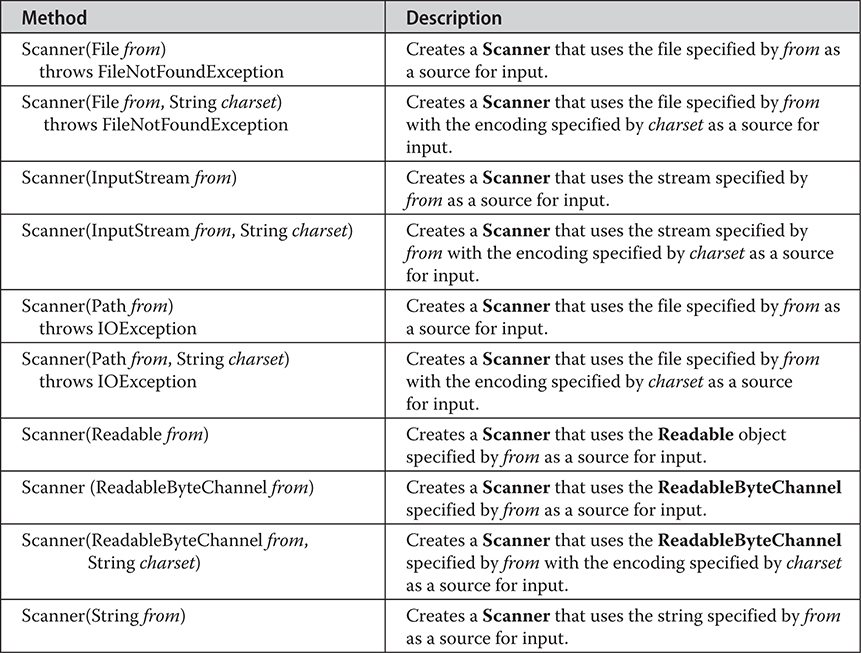
Table 21-14 A Sampling of Scanner Constructors
The following sequence creates a Scanner that reads the file Test.txt:
FileReader fin = new FileReader("Test.txt");
Scanner src = new Scanner(fin);
This works because FileReader implements the Readable interface. Thus, the call to the constructor resolves to Scanner(Readable).
This next line creates a Scanner that reads from standard input, which is the keyboard by default:
Scanner conin = new Scanner(System.in);
This works because System.in is an object of type InputStream. Thus, the call to the constructor maps to Scanner(InputStream).
The next sequence creates a Scanner that reads from a string.
String instr = "10 99.88 scanning is easy.";
Scanner conin = new Scanner(instr);
Once you have created a Scanner, it is a simple matter to use it to read formatted input. In general, a Scanner reads tokens from the underlying source that you specified when the Scanner was created. As it relates to Scanner, a token is a portion of input that is delineated by a set of delimiters, which is whitespace by default. A token is read by matching it with a particular regular expression, which defines the format of the data. Although Scanner allows you to define the specific type of expression that its next input operation will match, it includes many predefined patterns, which match the primitive types, such as int and double, and strings. Thus, often you won’t need to specify a pattern to match.
In general, to use Scanner, follow this procedure:
1. Determine if a specific type of input is available by calling one of Scanner’s
hasNextX methods, where X is the type of data desired.
2. If input is available, read it by calling one of Scanner’s nextX methods.
3. Repeat the process until input is exhausted.
4. Close the Scanner by calling close( ).
As the preceding indicates, Scanner defines two sets of methods that enable you to read input. The first are the hasNextX methods, which are shown in Table 21-15. These methods determine if the specified type of input is available. For example, calling hasNextInt( ) returns true only if the next token to be read is an integer. If the desired data is available, then you read it by calling one of Scanner’s nextX methods, which are shown in Table 21-16. For example, to read the next integer, call nextInt( ). The following sequence shows how to read a list of integers from the keyboard.
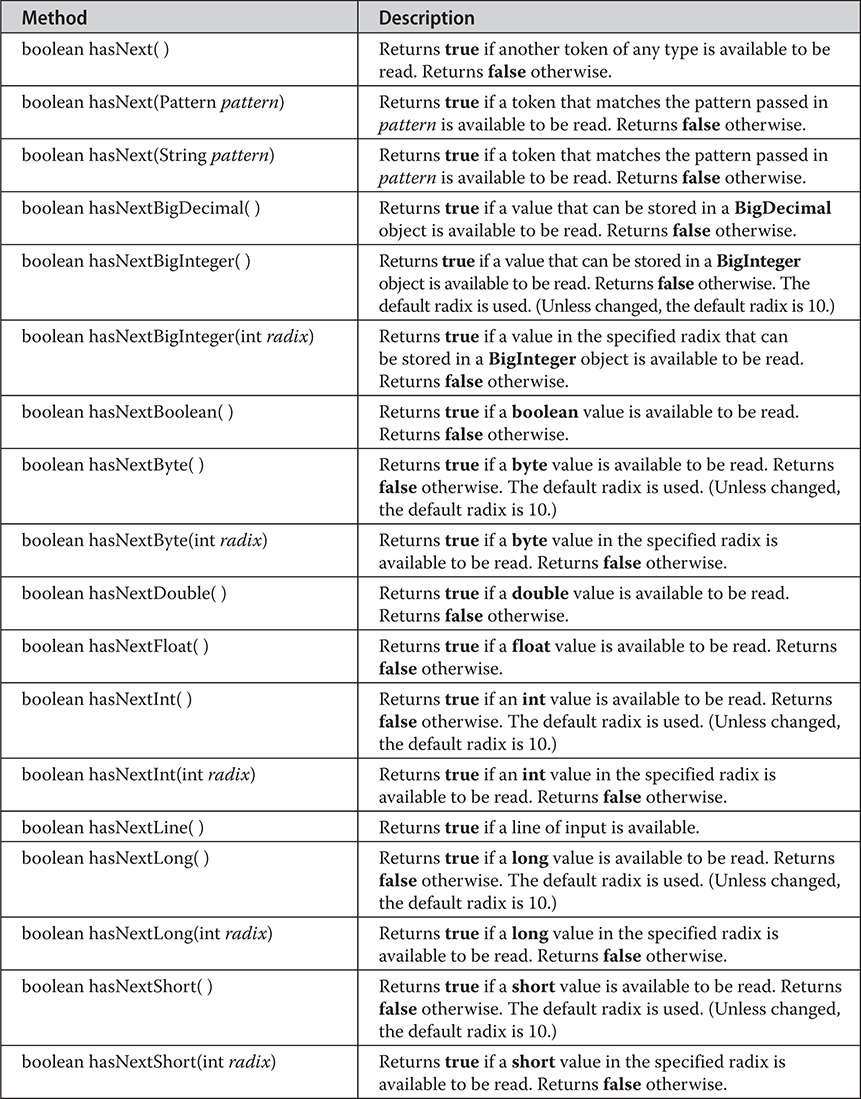
Table 21-15 The Scanner hasNext Methods
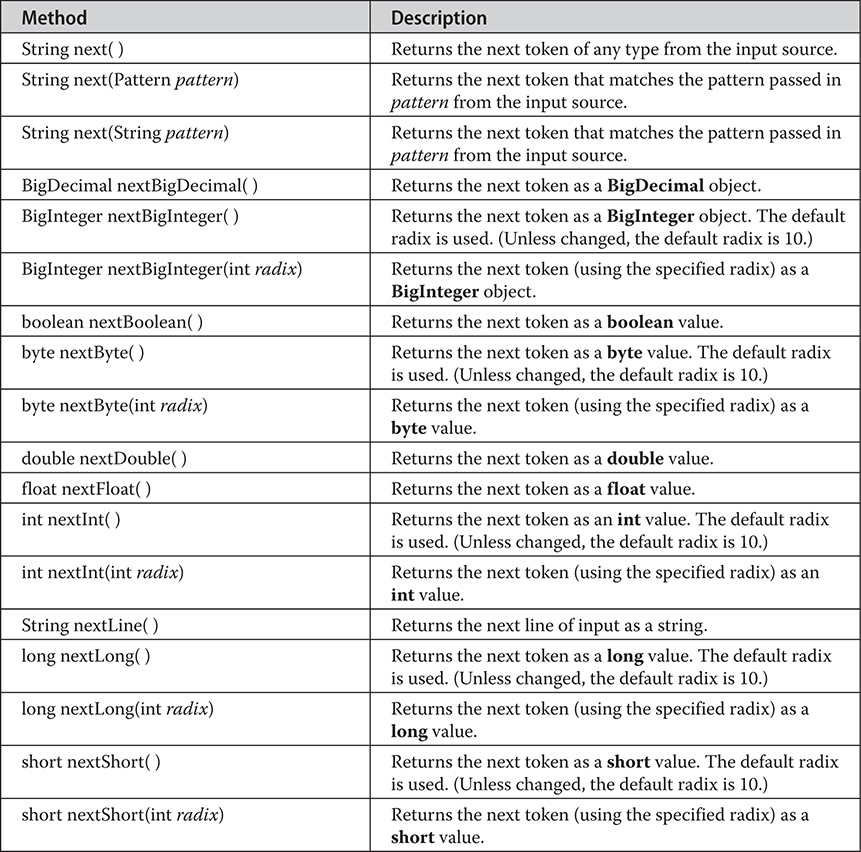
Table 21-16 The Scanner next Methods
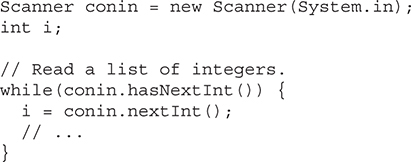
The while loop stops as soon as the next token is not an integer. Thus, the loop stops reading integers as soon as a non-integer is encountered in the input stream.
If a next method cannot find the type of data it is looking for, it throws an InputMismatchException. A NoSuchElementException is thrown if no more input is available. For this reason, it is best to first confirm that the desired type of data is available by calling a hasNext method before calling its corresponding next method.
Scanner makes what could be a tedious task into an easy one. To understand why, let’s look at some examples. The following program averages a list of numbers entered at the keyboard:
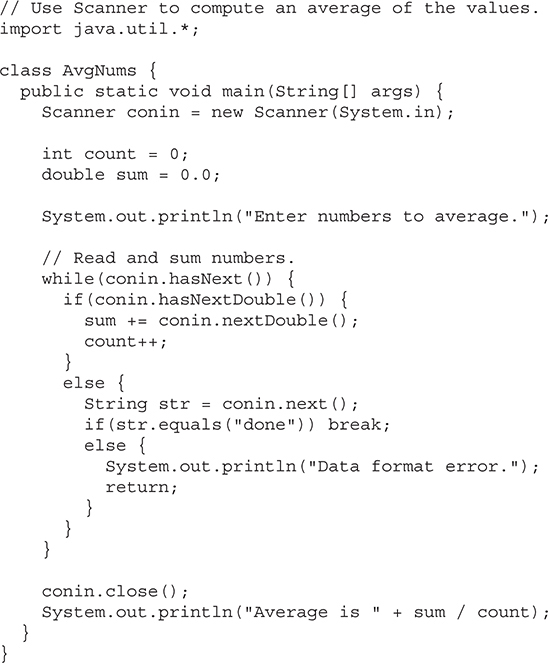
The program reads numbers from the keyboard, summing them in the process, until the user enters the string "done". It then stops input and displays the average of the numbers. Here is a sample run:
Enter numbers to average.
1.2
2
3.4
4
done
Average is 2.65
The program reads numbers until it encounters a token that does not represent a valid double value. When this occurs, it confirms that the token is the string "done". If it is, the program terminates normally. Otherwise, it displays an error.
Notice that the numbers are read by calling nextDouble( ). This method reads any number that can be converted into a double value, including an integer value, such as 2, and a floating-point value like 3.4. Thus, a number read by nextDouble( ) need not specify a decimal point. This same general principle applies to all next methods. They will match and read any data format that can represent the type of value being requested.
One thing that is especially nice about Scanner is that the same technique used to read from one source can be used to read from another. For example, here is the preceding program reworked to average a list of numbers contained in a text file:
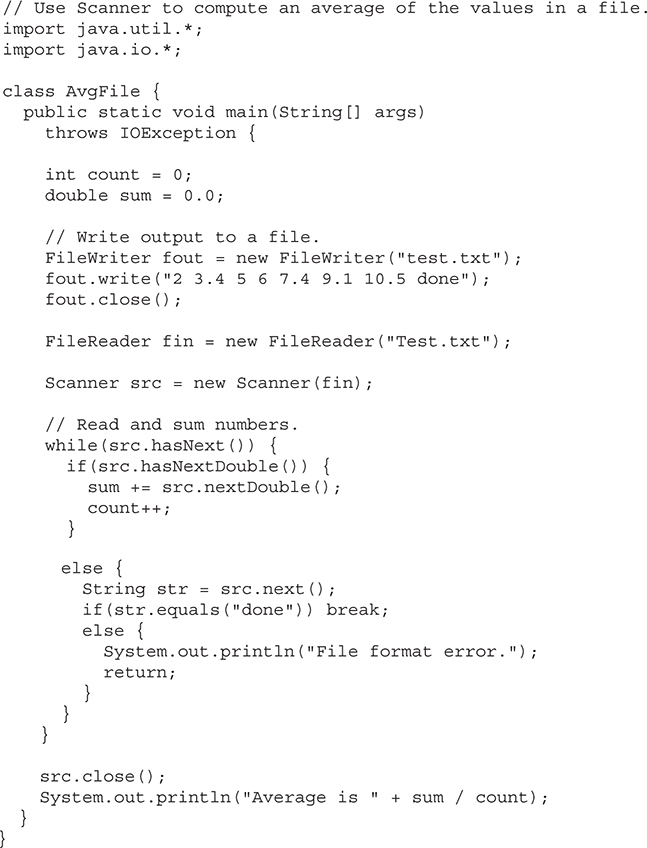
Here is the output:
Average is 6.2
The preceding program illustrates another important feature of Scanner. Notice that the file reader referred to by fin is not closed directly. Rather, it is closed automatically when src calls close( ). When you close a Scanner, the Readable associated with it is also closed (if that Readable implements the Closeable interface). Therefore, in this case, the file referred to by fin is automatically closed when src is closed.
Scanner also implements the AutoCloseable interface. This means that it can be managed by a try-with-resources block. As explained in Chapter 13, when try-with-resources is used, the scanner is automatically closed when the block ends. For example, src in the preceding program could have been managed like this:
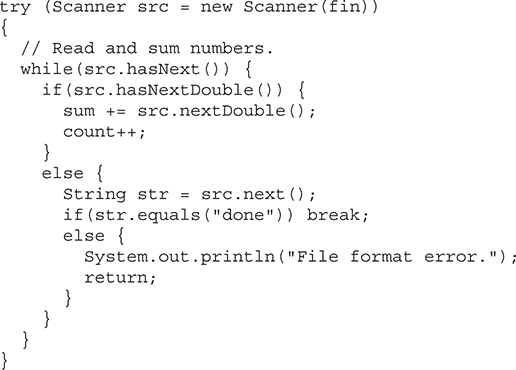
To clearly demonstrate the closing of a Scanner, the following examples will call close( ) explicitly, but you should feel free to use try-with-resources in your own code when appropriate.
One other point: To keep this and the other examples in this section compact, I/O exceptions are simply thrown out of main( ). However, your real-world code will normally handle I/O exceptions itself.
You can use Scanner to read input that contains several different types of data—even if the order of that data is unknown in advance. You must simply check what type of data is available before reading it. For example, consider this program:
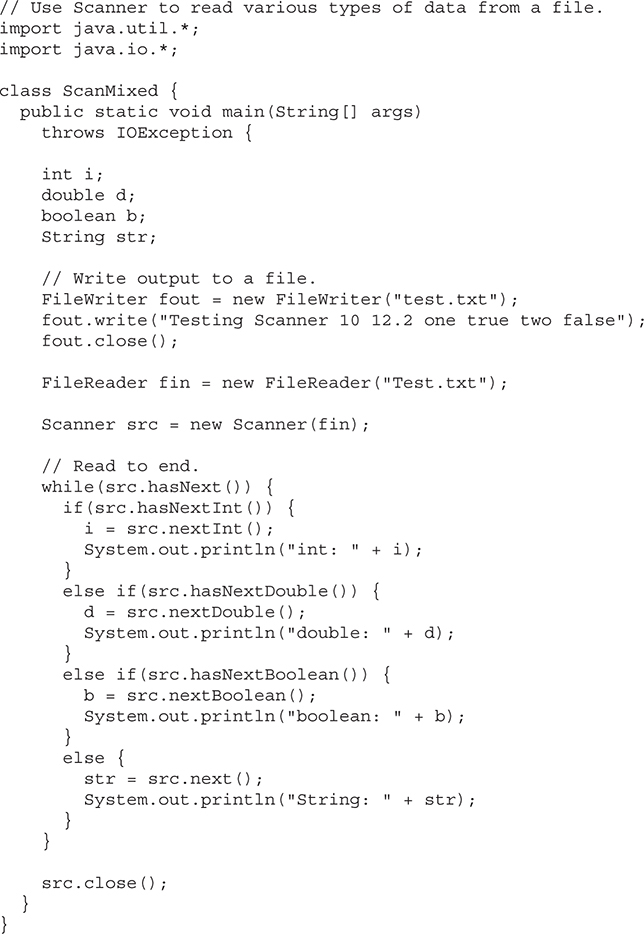
Here is the output:
String: Testing
String: Scanner
int: 10
double: 12.2
String: one
boolean: true
String: two
boolean: false
When reading mixed data types, as the preceding program does, you need to be a bit careful about the order in which you call the next methods. For example, if the loop reversed the order of the calls to nextInt( ) and nextDouble( ), both numeric values would have been read as doubles, because nextDouble( ) matches any numeric string that can be represented as a double.
Scanner defines where a token starts and ends based on a set of delimiters. The default delimiters are the whitespace characters, and this is the delimiter set that the preceding examples have used. However, it is possible to change the delimiters by calling the useDelimiter( ) method, shown here:
Scanner useDelimiter(String pattern)
Scanner useDelimiter(Pattern pattern)
Here, pattern is a regular expression that specifies the delimiter set.
Here is the program that reworks the average program shown earlier so that it reads a list of numbers that are separated by commas, and any number of spaces:
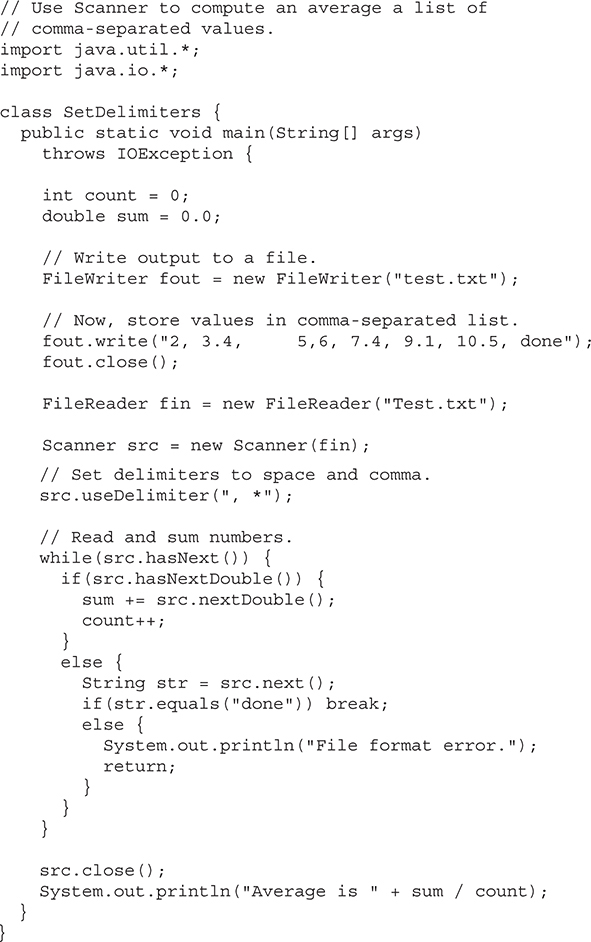
In this version, the numbers written to test.txt are separated by commas and spaces. The use of the delimiter pattern ", * " tells Scanner to match a comma and zero or more spaces as delimiters. The output is the same as before.
You can obtain the current delimiter pattern by calling delimiter( ), shown here:
Pattern delimiter( )
Scanner defines several other methods in addition to those already discussed. One that is particularly useful in some circumstances is findInLine( ). Its general forms are shown here:
String findInLine(Pattern pattern)
String findInLine(String pattern)
This method searches for the specified pattern within the next line of text. If the pattern is found, the matching token is consumed and returned. Otherwise, null is returned. It operates independently of any delimiter set. This method is useful if you want to locate a specific pattern. For example, the following program locates the Age field in the input string and then displays the age:
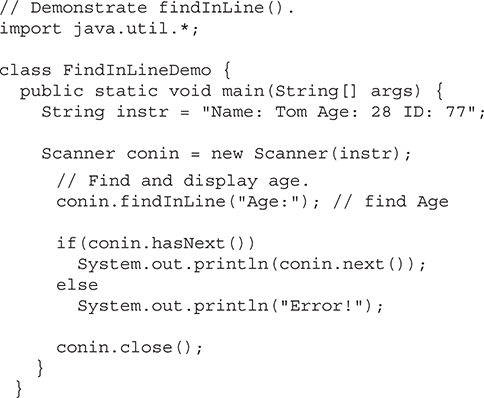
The output is 28. In the program, findInLine( ) is used to find an occurrence of the pattern "Age". Once found, the next token is read, which is the age.
Related to findInLine( ) is findWithinHorizon( ). It is shown here:
String findWithinHorizon(Pattern pattern, int count)
String findWithinHorizon(String pattern, int count)
This method attempts to find an occurrence of the specified pattern within the next count characters. If successful, it returns the matching pattern. Otherwise, it returns null. If count is zero, then all input is searched until either a match is found or the end of input is encountered.
You can bypass a pattern using skip( ), shown here:
Scanner skip(Pattern pattern)
Scanner skip(String pattern)
If pattern is matched, skip( ) simply advances beyond it and returns a reference to the invoking object. If pattern is not found, skip( ) throws NoSuchElementException.
Other Scanner methods include radix( ), which returns the default radix used by the Scanner; useRadix( ), which sets the radix; reset( ), which resets the scanner; and close( ), which closes the scanner. JDK 9 added the methods tokens( ), which returns all tokens in the form of a Stream<String>, and findAll( ), which returns tokens that match the specified pattern in the form of a Stream<MatchResult>.
The java.util package includes three classes that aid in the internationalization of your program. The first is the abstract class ResourceBundle. It defines methods that enable you to manage a collection of locale-sensitive resources, such as the strings that are used to label the user interface elements in your program. You can define two or more sets of translated strings that support various languages, such as English, German, or Chinese, with each translation set residing in its own bundle. You can then load the bundle appropriate to the current locale and use the strings to construct the program’s user interface.
Resource bundles are identified by their family name (also called their base name). To the family name can be added a language code which specifies the language. In this case, if a requested locale matches the language code, then that version of the resource bundle is used. For example, a resource bundle with a family name of SampleRB could have a German version called SampleRB_de and a Russian version called SampleRB_ru. (Notice that an underscore links the family name to the language code.) Therefore, if the locale is Locale.GERMAN, SampleRB_de will be used.
It is also possible to indicate specific variants of a language that relate to a specific country by specifying a country code after the language code, such as AU for Australia or IN for India. A country code is also preceded by an underscore when linked to the resource bundle name. Other variations are also supported. A resource bundle that has only the family name is the default bundle. It is used when no language-specific bundles are applicable.
Note The language codes are defined by ISO standard 639 and the country codes by ISO standard 3166.
The methods defined by ResourceBundle are summarized in Table 21-17. One important point: null keys are not allowed and several of the methods will throw a NullPointerException if null is passed as the key. Notice the nested class ResourceBundle.Control. It is used to control the resource-bundle loading process.
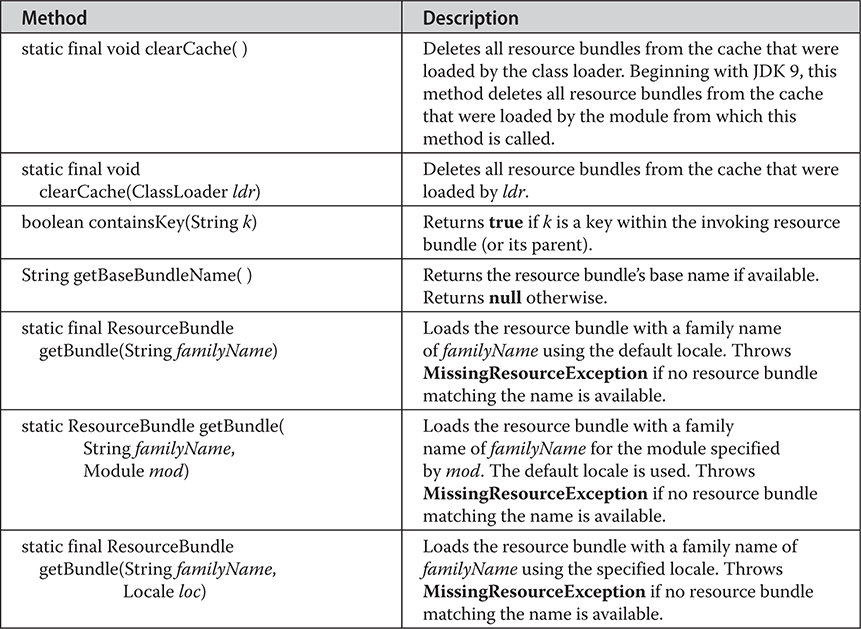
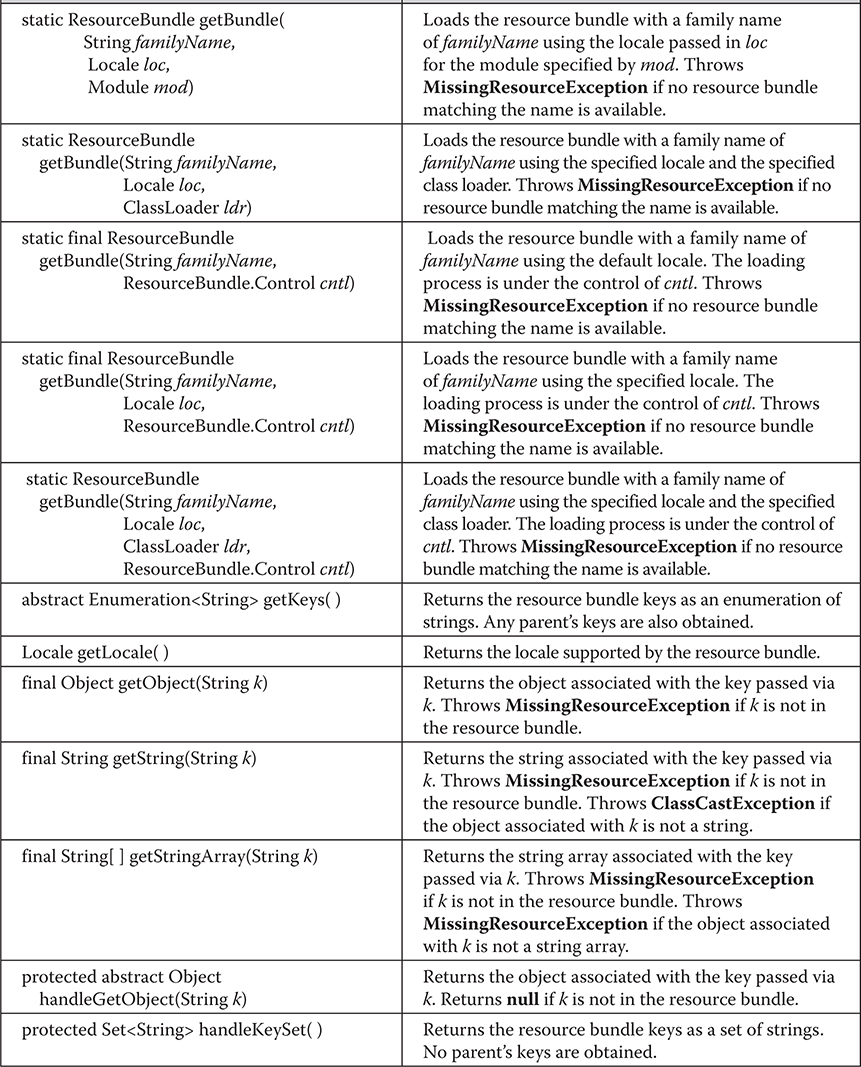

Table 21-17 The Methods Defined by ResourceBundle
Note Notice that JDK 9 added methods to ResourceBundle that support modules. Furthermore, the addition of modules raises several issues related to the use of resource bundles that are beyond the scope of this discussion. Consult the API documentation for details on how modules affect the use of ResourceBundle.
There are two subclasses of ResourceBundle. The first is PropertyResourceBundle, which manages resources by using property files. PropertyResourceBundle adds no methods of its own. The second is the abstract class ListResourceBundle, which manages resources in an array of key/value pairs. ListResourceBundle adds the method getContents( ), which all subclasses must implement. It is shown here:
protected abstract Object[ ][ ] getContents( )
It returns a two-dimensional array that contains key/value pairs that represent resources. The keys must be strings. The values are typically strings, but can be other types of objects.
Here is an example that demonstrates using a resource bundle in an unnamed module. The resource bundle has the family name SampleRB. Two resource bundle classes of this family are created by extending ListResourceBundle. The first is called SampleRB, and it is the default bundle (which uses English). It is shown here:
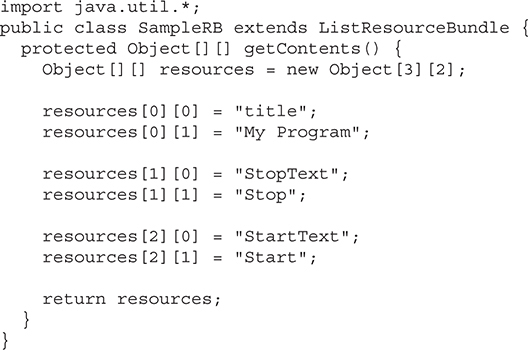
The second resource bundle, shown next, is called SampleRB_de. It contains the German translation.
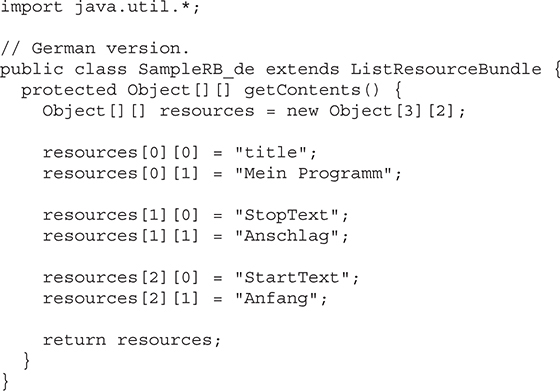
The following program demonstrates these two resource bundles by displaying the string associated with each key for both the default (English) version and the German version:
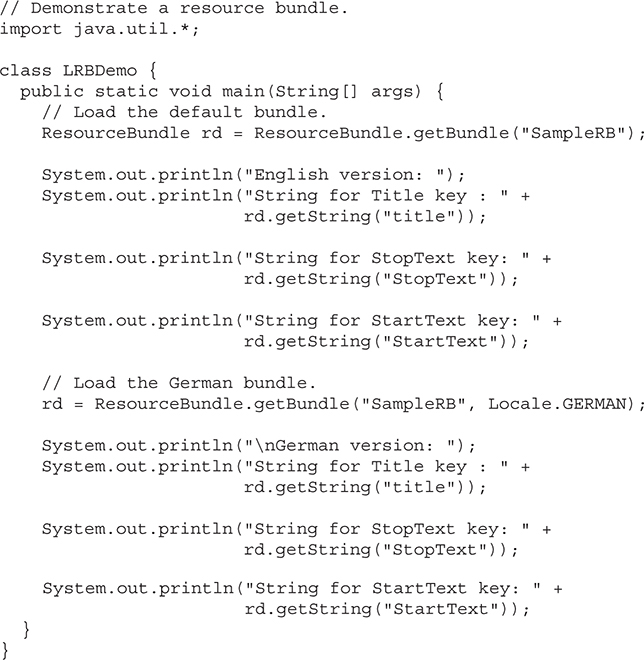
The output from the program is shown here:
English version:
String for Title key : My Program
String for StopText key: Stop
String for StartText key: Start
German version:
String for Title key : Mein Programm
String for StopText key: Anschlag
String for StartText key: Anfang
In addition to the classes already discussed, java.util includes the following classes:
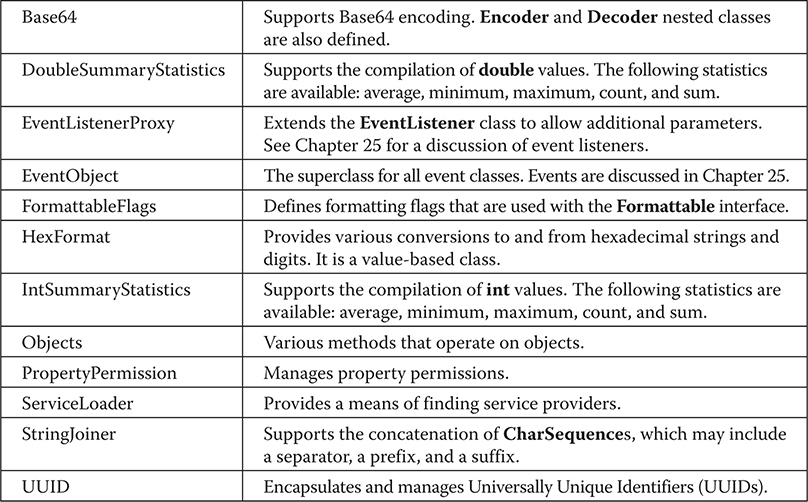
The following interfaces are also packaged in java.util:

Java defines the following subpackages of java.util:
• java.util.concurrent
• java.util.concurrent.atomic
• java.util.concurrent.locks
• java.util.function
• java.util.jar
• java.util.logging
• java.util.prefs
• java.util.random
• java.util.regex
• java.util.spi
• java.util.stream
• java.util.zip
Except as otherwise noted, all are part of the java.base module. Each is briefly examined here.
The java.util.concurrent package along with its two subpackages, java.util.concurrent.atomic and java.util.concurrent.locks, support concurrent programming. These packages provide a high-performance alternative to using Java’s built-in synchronization features when thread-safe operation is required. The java.util.concurrent package also provides the Fork/Join Framework. These packages are examined in detail in Chapter 29.
The java.util.function package defines several predefined functional interfaces that you can use when creating lambda expressions or method references. They are also widely used throughout the Java API. The functional interfaces defined by java.util.function are shown in Table 21-18 along with a synopsis of their abstract methods. Be aware that some of these interfaces also define default or static methods that supply additional functionality. You will want to explore them fully on your own. (For a discussion of the use of functional interfaces, see Chapter 15.)
The java.util.jar package provides the ability to read and write Java Archive (JAR) files.
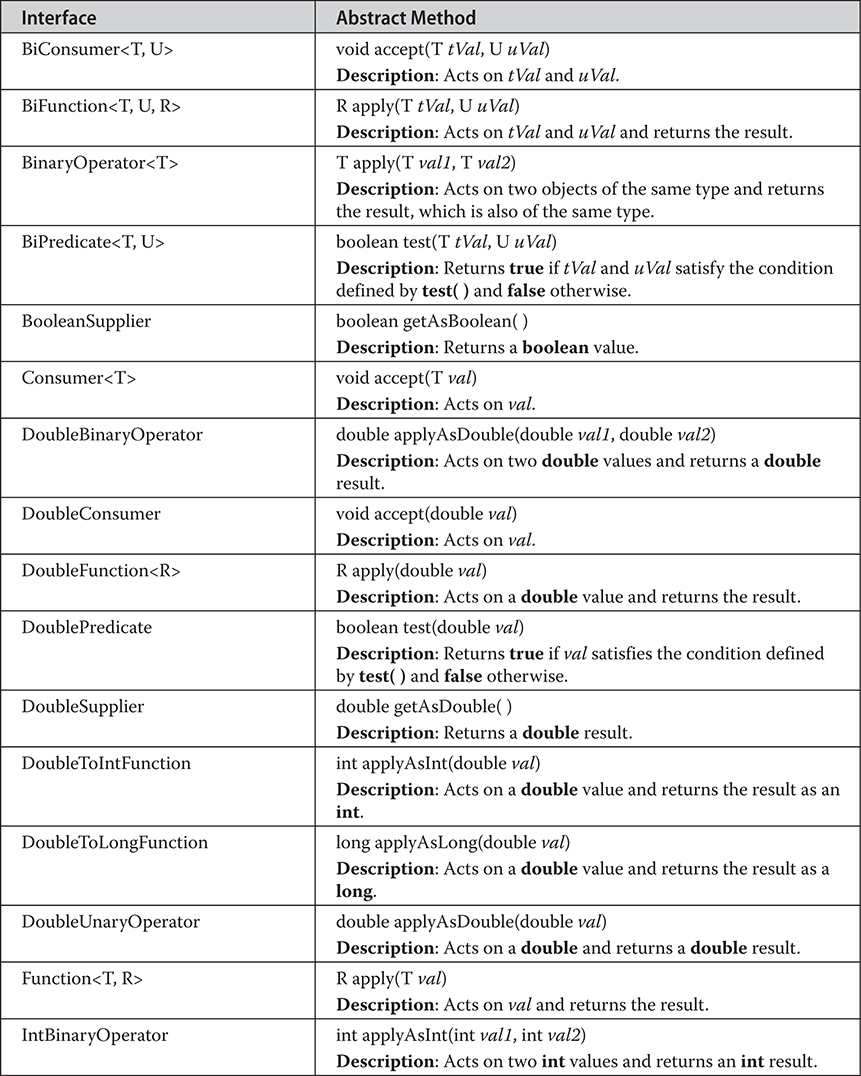
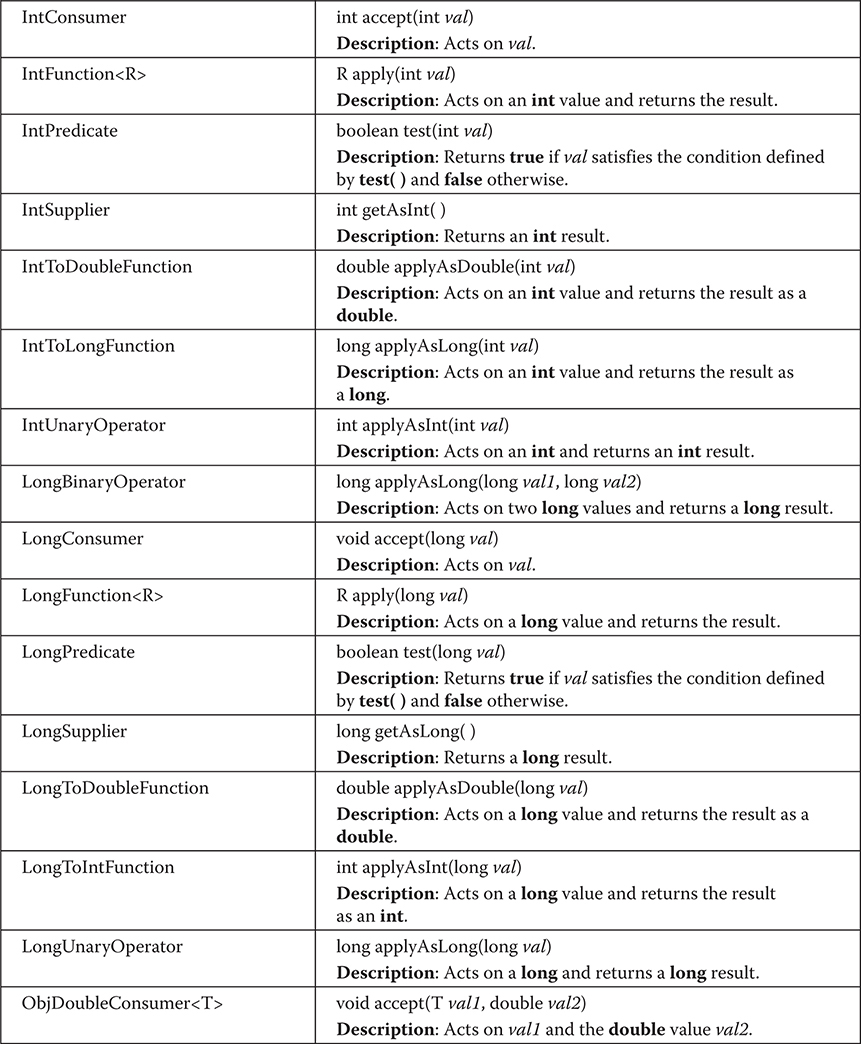
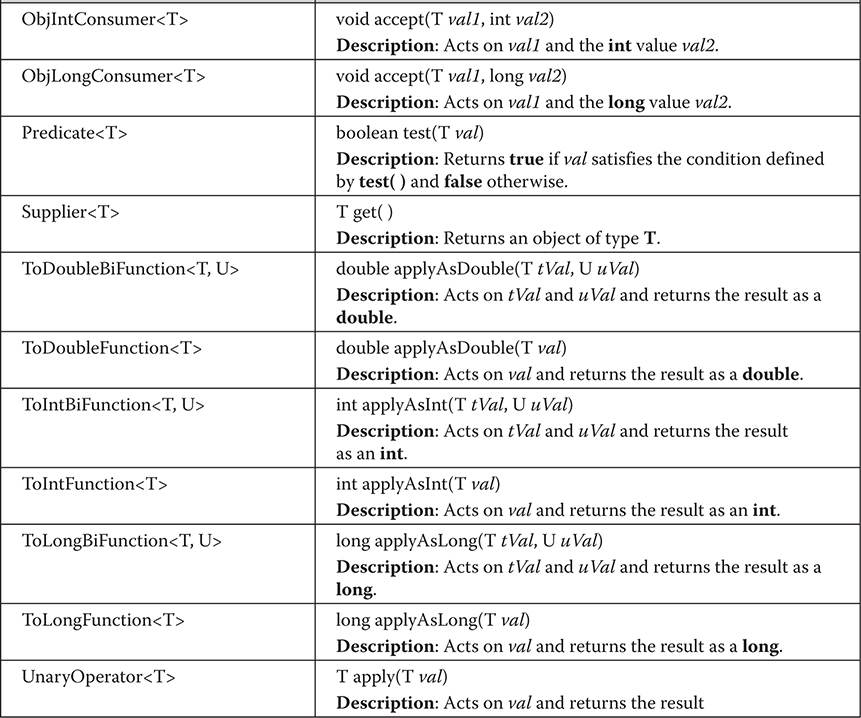
Table 21-18 Functional Interfaces Defined by java.util.function and Their Abstract Methods
The java.util.logging package provides support for program activity logs, which can be used to record program actions, and to help find and debug problems. This package is in the java.logging module.
The java.util.prefs package provides support for user preferences. It is typically used to support program configuration. This package is in the java.prefs module.
The java.util.random package provides extensive support for random number generators. (Added by JDK 17.)
The java.util.regex package provides support for regular expression handling. It is described in detail in Chapter 31.
The java.util.spi package provides support for service providers.
The java.util.stream package contains Java’s stream API. A discussion of the stream API is found in Chapter 30.
The java.util.zip package provides the ability to read and write files in the popular ZIP and GZIP formats. Both ZIP and GZIP input and output streams are available.
This chapter explores java.io, which provides support for I/O operations. Chapter 13 presented an overview of Java’s I/O system, including basic techniques for reading and writing files, handling I/O exceptions, and closing a file. Here, we will examine the Java I/O system in greater detail.
As all programmers learn early on, most programs cannot accomplish their goals without accessing external data. Data is retrieved from an input source. The results of a program are sent to an output destination. In Java, these sources or destinations are defined very broadly. For example, a network connection, memory buffer, or disk file can be manipulated by the Java I/O classes. Although physically different, these devices are all handled by the same abstraction: the stream. An I/O stream, as explained in Chapter 13, is a logical entity that either produces or consumes information. An I/O stream is linked to a physical device by the Java I/O system. All I/O streams behave in the same manner, even if the actual physical devices they are linked to differ.
Note The stream-based I/O system packaged in java.io and described in this chapter has been part of Java since its original release and is widely used. However, beginning with version 1.4, a second I/O system was added to Java. It is called NIO (which was originally an acronym for New I/O). NIO is packaged in java.nio and its subpackages. The NIO system is described in Chapter 23.
Note It is important not to confuse the I/O streams used by the I/O system discussed here with the stream API added by JDK 8. Although conceptually related, they are two different things. Therefore, when the term stream is used in this chapter, it refers to an I/O stream.
The I/O classes defined by java.io are listed here:
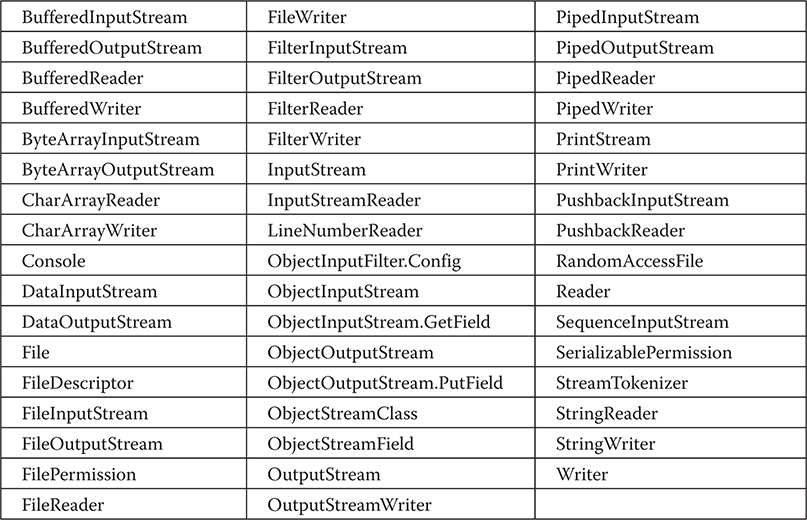
The java.io package also contains two deprecated classes that are not shown in the preceding table: LineNumberInputStream and StringBufferInputStream. These classes should not be used for new code.
The following interfaces are defined by java.io:

As you can see, there are many classes and interfaces in the java.io package. These include byte and character streams, and object serialization (the storage and retrieval of objects). This chapter examines several commonly used I/O components. We begin our discussion with one of the most distinctive I/O classes: File.
Although most of the classes defined by java.io operate on streams, the File class does not. It deals directly with files and the file system. That is, the File class does not specify how information is retrieved from or stored in files; it describes the properties of a file itself. A File object is used to obtain or manipulate the information associated with a disk file, such as the permissions, time, date, and directory path, and to navigate subdirectory hierarchies.
Note The Path interface and Files class, which are part of the NIO system, offer a powerful alternative to File in many cases. See Chapter 23 for details.
Files are a primary source and destination for data within many programs. Although there are severe restrictions on their use within untrusted code for security reasons, files are still a central resource for storing persistent and shared information. A directory in Java is treated simply as a File with one additional property—a list of filenames that can be examined by the list( ) method.
The following constructors can be used to create File objects:
File(String directoryPath)
File(String directoryPath, String filename)
File(File dirObj, String filename)
File(URI uriObj)
Here, directoryPath is the path name of the file; filename is the name of the file or subdirectory; dirObj is a File object that specifies a directory; and uriObj is a URI object that describes a file.
The following example creates three files: f1, f2, and f3. The first File object is constructed with a directory path as the only argument. The second includes two arguments—the path and the filename. The third includes the file path assigned to f1 and a filename; f3 refers to the same file as f2.
File f1 = new File("/");
File f2 = new File("/","autoexec.bat");
File f3 = new File(f1,"autoexec.bat");
Note Java does the right thing with path separators between UNIX and Windows conventions. If you use a forward slash (/) on a Windows version of Java, the path will still resolve correctly. Remember, if you are using the Windows convention of a backslash character (\), you will need to use its escape sequence (\\) within a string.
File defines many methods that obtain the standard properties of a File object. For example, getName( ) returns the name of the file; getParent( ) returns the name of the parent directory; and exists( ) returns true if the file exists, false if it does not. The following example demonstrates several of the File methods. It assumes that a directory called java exists off the root directory and that it contains a file called COPYRIGHT.
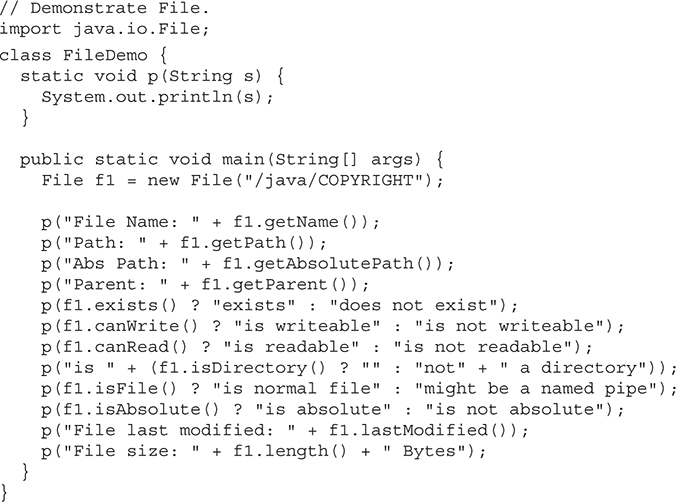
This program will produce output similar to this:
File Name: COPYRIGHT
Path: \java\COPYRIGHT
Abs Path: C:\java\COPYRIGHT
Parent: \java
exists
is writeable
is readable
is not a directory
is normal file
is not absolute
File last modified: 1282832030047
File size: 695 Bytes
Most of the File methods are self-explanatory. isFile( ) and isAbsolute( ) are not. isFile( ) returns true if called on a file and false if called on a directory. Also, isFile( ) returns false for some special files, such as device drivers and named pipes, so this method can be used to make sure the file will behave as a file. The isAbsolute( ) method returns true if the file has an absolute path and false if its path is relative.
File includes two useful utility methods of special interest. The first is renameTo( ), shown here:
boolean renameTo(File newName)
Here, the filename specified by newName becomes the new name of the file. It will return true upon success and false if the file cannot be renamed (if you attempt to rename a file so that it uses an existing filename, for example).
The second utility method is delete( ), which deletes the disk file represented by the path of the invoking File object. It is shown here:
boolean delete( )
You can also use delete( ) to delete a directory if the directory is empty. delete( ) returns true if it deletes the file and false if the file cannot be removed.
Here are some other File methods that you will find helpful:
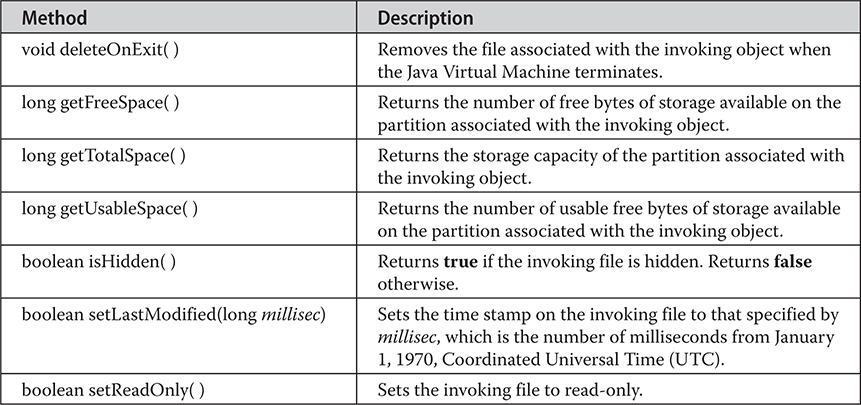
Methods also exist to mark files as readable, writable, and executable. Because File implements the Comparable interface, the method compareTo( ) is also supported.
A method of special interest is called toPath( ), which is shown here:
Path toPath( )
toPath( ) returns a Path object that represents the file encapsulated by the invoking File object. (In other words, toPath( ) converts a File into a Path.) Path is packaged in java.nio.file and is part of NIO. Thus, toPath( ) forms a bridge between the older File class and the newer Path interface. (See Chapter 23 for a discussion of Path.)
A directory is a File that contains a list of other files and directories. When you create a File object that is a directory, the isDirectory( ) method will return true. In this case, you can call list( ) on that object to extract the list of other files and directories inside. It has two forms. The first is shown here:
String[ ] list( )
The list of files is returned in an array of String objects.
The program shown here illustrates how to use list( ) to examine the contents of a directory:
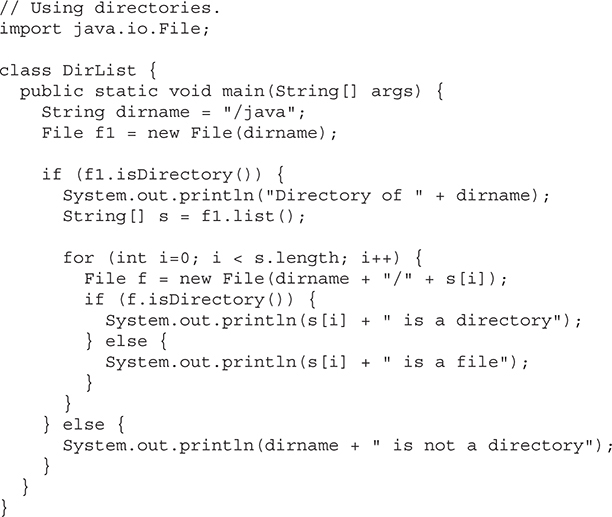
Here is sample output from the program. (Of course, the output you see will be different, based on what is in the directory.)
Directory of /java
bin is a directory
lib is a directory
demo is a directory
COPYRIGHT is a file
README is a file
index.html is a file
include is a directory
src.zip is a file
src is a directory
You will often want to limit the number of files returned by the list( ) method to include only those files that match a certain filename pattern, or filter. To do this, you must use a second form of list( ), shown here:
String[ ] list(FilenameFilter FFObj)
In this form, FFObj is an object of a class that implements the FilenameFilter interface.
FilenameFilter defines only a single method, accept( ), which is called once for each file in a list. Its general form is given here:
boolean accept(File directory, String filename)
The accept( ) method returns true for files in the directory specified by directory that should be included in the list (that is, those that match the filename argument) and returns false for those files that should be excluded.
The OnlyExt class, shown next, implements FilenameFilter. It will be used to modify the preceding program to restrict the visibility of the filenames returned by list( ) to files with names that end in the file extension specified when the object is constructed.
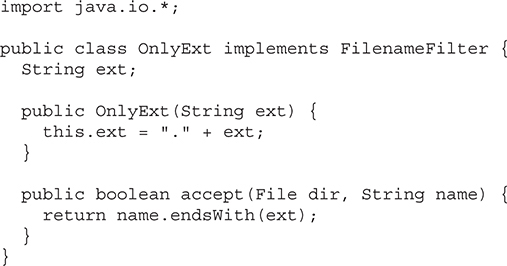
The modified directory listing program is shown here. Now it will only display files that use the .html extension.
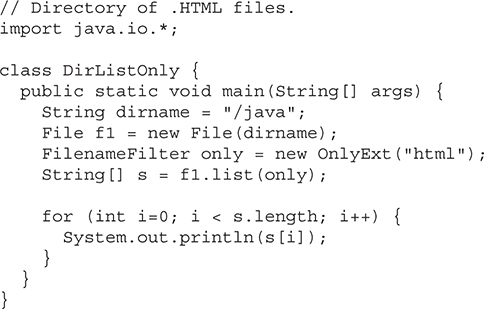
There is a variation to the list( ) method, called listFiles( ), which you might find useful. The signatures for listFiles( ) are shown here:
File[ ] listFiles( )
File[ ] listFiles(FilenameFilter FFObj)
File[ ] listFiles(FileFilter FObj)
These methods return the file list as an array of File objects instead of strings. The first method returns all files, and the second returns those files that satisfy the specified FilenameFilter. Aside from returning an array of File objects, these two versions of listFiles( ) work like their equivalent list( ) methods.
The third version of listFiles( ) returns those files with path names that satisfy the specified FileFilter. FileFilter defines only a single method, accept( ), which is called once for each file in a list. Its general form is given here:
boolean accept(File path)
The accept( ) method returns true for files that should be included in the list (that is, those that match the path argument) and false for those that should be excluded.
Another two useful File utility methods are mkdir( ) and mkdirs( ). The mkdir( ) method creates a directory, returning true on success and false on failure. Failure can occur for various reasons, such as the path specified in the File object already exists, or the directory cannot be created because the entire path does not exist yet. To create a directory for which no path exists, use the mkdirs( ) method. It creates both a directory and all the parents of the directory.
There are three interfaces that are quite important to the stream classes. Two are Closeable and Flushable. They are defined in java.io. The third, AutoCloseable, is packaged in java.lang.
AutoCloseable provides support for the try-with-resources statement, which automates the process of closing a resource. (See Chapter 13.) Only objects of classes that implement AutoCloseable can be managed by try-with-resources. AutoCloseable is discussed in Chapter 18, but it is reviewed here for convenience. The AutoCloseable interface defines only the close( ) method:
void close( ) throws Exception
This method closes the invoking object, releasing any resources that it may hold. It is called automatically at the end of a try-with-resources statement, thus eliminating the need to explicitly call close( ). Because this interface is implemented by all of the I/O classes that open a stream, all such streams can be automatically closed by a try-with-resources statement. Automatically closing a stream ensures that it is properly closed when it is no longer needed, thus preventing memory leaks and other problems.
The Closeable interface also defines the close( ) method. Objects of a class that implement Closeable can be closed. Closeable extends AutoCloseable. Therefore, any class that implements Closeable also implements AutoCloseable.
Objects of a class that implements Flushable can force buffered output to be written to the stream to which the object is attached. It defines the flush( ) method, shown here:
void flush( ) throws IOException
Flushing a stream typically causes buffered output to be physically written to the underlying device. This interface is implemented by all of the I/O classes that write to a stream.
Two exceptions play an important role in I/O handling. The first is IOException. As it relates to most of the I/O classes described in this chapter, if an I/O error occurs, an IOException is thrown. In many cases, if a file cannot be opened, a FileNotFoundException is thrown. FileNotFoundException is a subclass of IOException, so both can be caught with a single catch that catches IOException. For brevity, this is the approach used by most of the sample code in this chapter. However, in your own applications, you might find it useful to catch each exception separately.
Another exception class that is sometimes important when performing I/O is SecurityException. As explained in Chapter 13, in situations in which a security manager is present, several of the file classes will throw a SecurityException if a security violation occurs when attempting to open a file. By default, applications run via java do not use a security manager. For that reason, the I/O examples in this book do not need to watch for a possible SecurityException. However, other applications could generate a SecurityException. In such a case, you will need to handle this exception. Be aware, however, that the security manager was deprecated for removal by JDK 17.
In general, a stream must be closed when it is no longer needed. Failure to do so can lead to memory leaks and resource starvation. The techniques used to close a stream were described in Chapter 13, but because of their importance, they warrant a brief review here before the stream classes are examined.
There are two basic ways in which you can close a stream. The first is to explicitly call close( ) on the stream. This is the traditional approach that has been used since the original release of Java. With this approach, close( ) is typically called within a finally block. Thus, a simplified skeleton for the traditional approach is shown here:
try {
// open and access file
} catch( I/O-exception) {
// ...
} finally {
// close the file
}
This general technique (or variation thereof) is common in code that predates JDK 7.
The second approach to closing a stream is to automate the process by using the try-with-resources statement that was added by JDK 7. The try-with-resources statement is an enhanced form of try that has the following form:
try (resource-specification) {
// use the resource
}
Typically, resource-specification is a statement or statements that declares and initializes a resource, such as a file or other stream-related resource. It consists of a variable declaration in which the variable is initialized with a reference to the object being managed. When the try block ends, the resource is automatically released. In the case of a file, this means that the file is automatically closed. Thus, there is no need to call close( ) explicitly. Beginning with JDK 9, it is also possible for the resource specification of the try to consist of a variable that has been declared and initialized earlier in the program. However, that variable must be effectively final, which means that it has not been assigned a new value after being given its initial value.
Here are three key points about the try-with-resources statement:
• Resources managed by try-with-resources must be objects of classes that implement AutoCloseable.
• A resource declared in the try is implicitly final. A resource declared outside the try must be effectively final.
• You can manage more than one resource by separating each declaration by a semicolon.
Also, remember that the scope of a resource declared inside the try is limited to the try-with-resources statement.
The principal advantage of try-with-resources is that the resource (in this case, a stream) is closed automatically when the try block ends. Thus, it is not possible to forget to close the stream, for example. The try-with-resources approach also typically results in shorter, clearer, easier-to-maintain source code.
Because of its advantages, try-with-resources is expected to be used extensively in new code. As a result, most of the code in this chapter (and in this book) will use it. However, because a large amount of older code still exists, it is important for all programmers to also be familiar with the traditional approach to closing a stream. For example, you will quite likely have to work on legacy code that uses the traditional approach or in an environment that uses an older version of Java. There may also be times when the automated approach is not appropriate because of other aspects of your code. For this reason, a few I/O examples in this book will demonstrate the traditional approach so you can see it in action.
One last point: The examples that use try-with-resources must be compiled by a modern version of Java. They won’t work with an older compiler. The examples that use the traditional approach can be compiled by older versions of Java.
Remember Because try-with-resources streamlines the process of releasing a resource and eliminates the possibility of accidentally forgetting to release a resource, it is the approach recommended for new code when its use is appropriate.
Java’s stream-based I/O is built upon four abstract classes: InputStream, OutputStream, Reader, and Writer. These classes were briefly discussed in Chapter 13. They are used to create several concrete stream subclasses. Although your programs perform their I/O operations through concrete subclasses, the top-level classes define the basic functionality common to all stream classes.
InputStream and OutputStream are designed for byte streams. Reader and Writer are designed for character streams. The byte stream classes and the character stream classes form separate hierarchies. In general, you should use the character stream classes when working with characters or strings and use the byte stream classes when working with bytes or other binary objects.
In the remainder of this chapter, both the byte- and character-oriented streams are examined.
The byte stream classes provide a rich environment for handling byte-oriented I/O. A byte stream can be used with any type of object, including binary data. This versatility makes byte streams important to many types of programs. Since the byte stream classes are topped by InputStream and OutputStream, our discussion begins with them.
InputStream is an abstract class that defines Java’s model of streaming byte input. It implements the AutoCloseable and Closeable interfaces. Most of the methods in this class will throw an IOException when an I/O error occurs. (The exceptions are mark( ) and markSupported( ).) Table 22-1 shows the methods in InputStream.
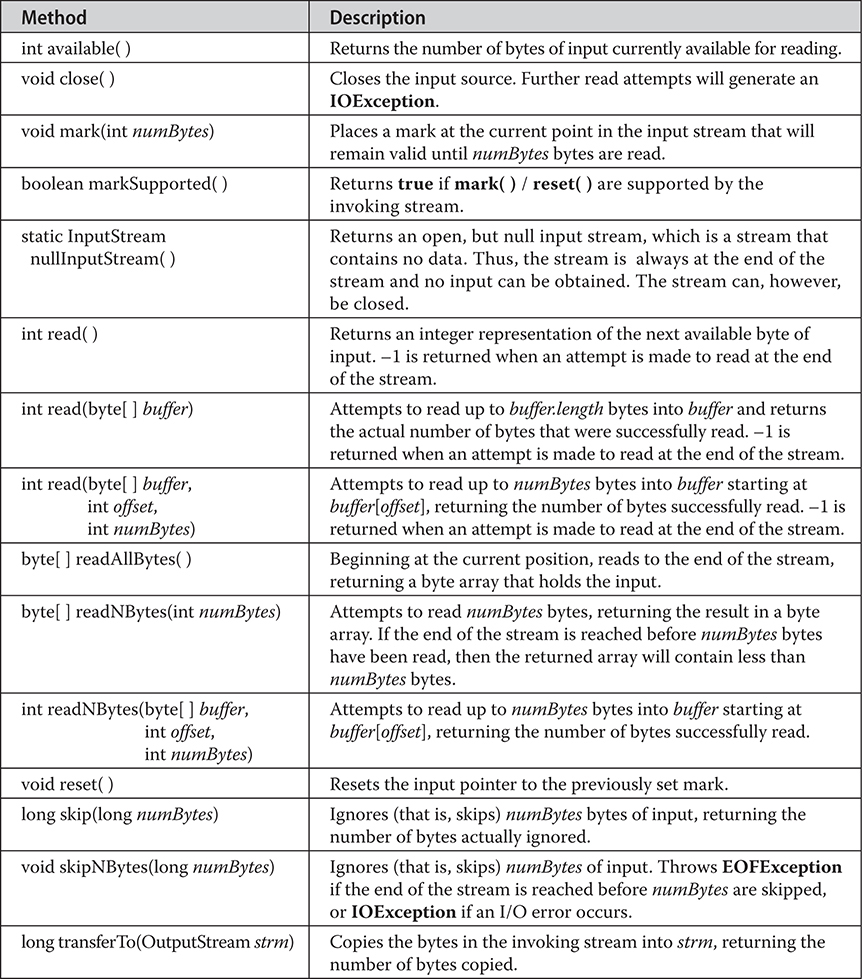
Table 22-1 The Methods Defined by InputStream
Note Most of the methods described in Table 22-1 are implemented by the subclasses of InputStream. The mark( ) and reset( ) methods are exceptions; notice their use, or lack thereof, by each subclass in the discussions that follow.
OutputStream is an abstract class that defines streaming byte output. It implements the AutoCloseable, Closeable, and Flushable interfaces. Most of the methods defined by this class return void and throw an IOException in the case of I/O errors. Table 22-2 shows the methods in OutputStream.
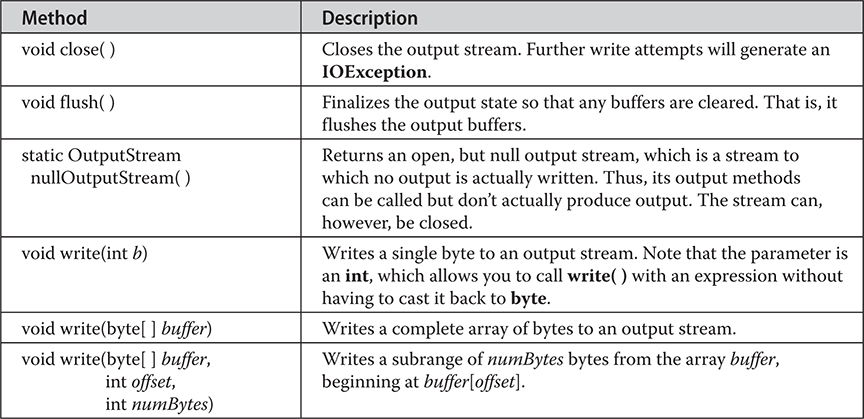
Table 22-2 The Methods Defined by OutputStream
The FileInputStream class creates an InputStream that you can use to read bytes from a file. Two commonly used constructors are shown here:
FileInputStream(String filePath)
FileInputStream(File fileObj)
Either can throw a FileNotFoundException. Here, filePath is the full path name of a file, and fileObj is a File object that describes the file.
The following example creates two FileInputStreams that use the same file and each of the two constructors:
FileInputStream f0 = new FileInputStream("/autoexec.bat")
File f = new File("/autoexec.bat");
FileInputStream f1 = new FileInputStream(f);
Although the first constructor is probably more commonly used, the second allows you to closely examine the file using the File methods, before attaching it to an input stream. When a FileInputStream is created, it is also opened for reading. FileInputStream overrides several of the methods in the abstract class InputStream. The mark( ) and reset( ) methods are not overridden, and any attempt to use reset( ) on a FileInputStream will generate an IOException.
The next example shows how to read a single byte, an array of bytes, and a subrange of an array of bytes. It also illustrates how to use available( ) to determine the number of bytes remaining and how to use the skip( ) method to skip over unwanted bytes. The program reads its own source file, which must be in the current directory. Notice that it uses the try-with-resources statement to automatically close the file when it is no longer needed.
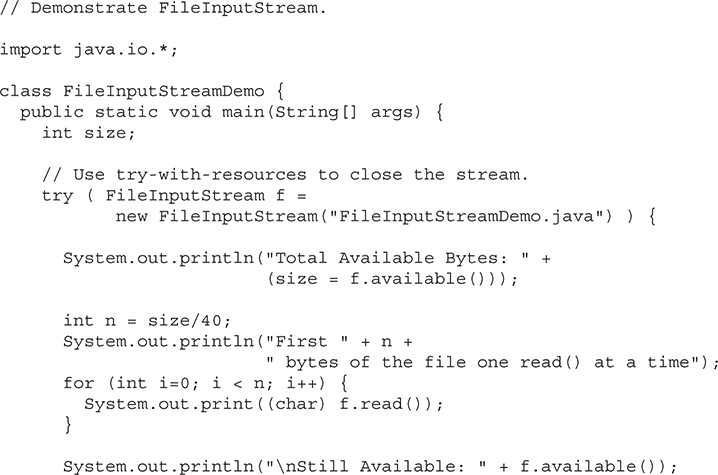
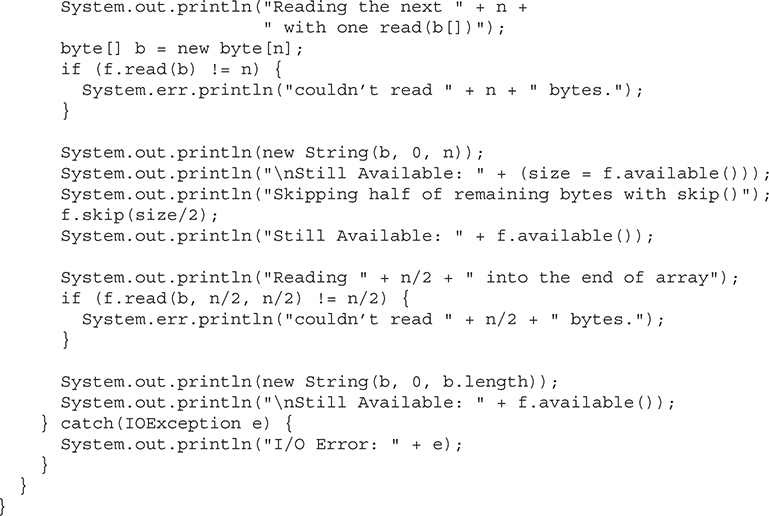
Here is the output produced by this program:
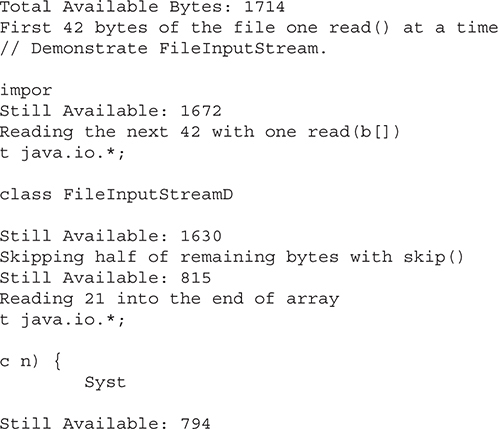
This somewhat contrived example demonstrates how to read three ways, to skip input, and to inspect the amount of data available on a stream.
Note The preceding example and the other examples in this chapter handle any I/O exceptions that might occur as described in Chapter 13. See Chapter 13 for details and alternatives.
FileOutputStream creates an OutputStream that you can use to write bytes to a file. It implements the AutoCloseable, Closeable, and Flushable interfaces. Four of its constructors are shown here:
FileOutputStream(String filePath)
FileOutputStream(File fileObj)
FileOutputStream(String filePath, boolean append)
FileOutputStream(File fileObj, boolean append)
They can throw a FileNotFoundException. Here, filePath is the full path name of a file, and fileObj is a File object that describes the file. If append is true, the file is opened in append mode.
Creation of a FileOutputStream is not dependent on the file already existing. FileOutputStream will create the file before opening it for output when you create the object. In the case where you attempt to open a read-only file, an exception will be thrown.
The following example creates a sample buffer of bytes by first making a String and then using the getBytes( ) method to extract the byte array equivalent. It then creates three files. The first, file1.txt, will contain every other byte from the sample. The second, file2.txt, will contain the entire set of bytes. The third and last, file3.txt, will contain only the last quarter.
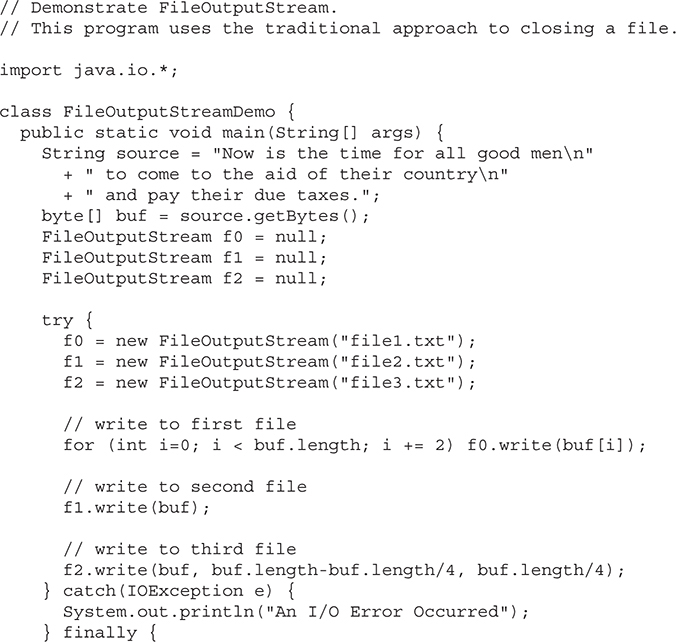
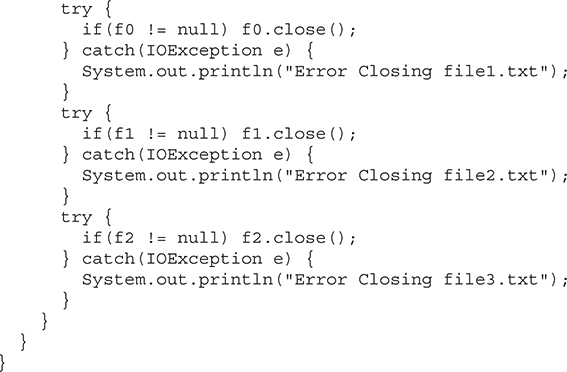
Here are the contents of each file after running this program. First, file1.txt:
Nwi h iefralgo e
t oet h i ftercuty n a hi u ae.
Next, file2.txt:

Finally, file3.txt:
nd pay their due taxes.
As the comment at the top of the program states, the preceding program shows an example that uses the traditional approach to closing a file when it is no longer needed. This approach is required by all versions of Java prior to JDK 7 and is widely used in legacy code. As you can see, quite a bit of rather awkward code is required to explicitly call close( ) because each call could generate an IOException if the close operation fails. This program can be substantially improved by using the try-with-resources statement. For comparison, here is the revised version. Notice that it is much shorter and streamlined:
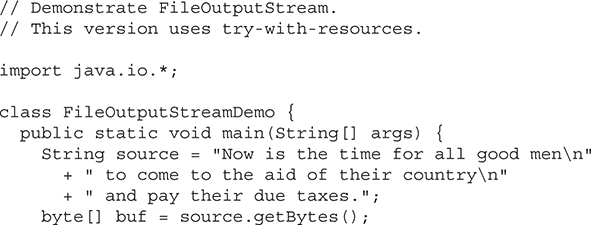
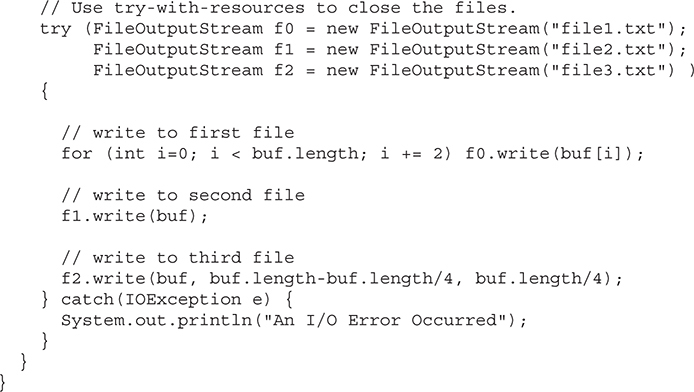
ByteArrayInputStream is an implementation of an input stream that uses a byte array as the source. This class has two constructors, each of which requires a byte array to provide the data source:
ByteArrayInputStream(byte[ ] array)
ByteArrayInputStream(byte[ ] array, int start, int numBytes)
Here, array is the input source. The second constructor creates an InputStream from a subset of the byte array that begins with the character at the index specified by start and is numBytes long.
The close( ) method has no effect on a ByteArrayInputStream. Therefore, it is not necessary to call close( ) on a ByteArrayInputStream, but doing so is not an error.
The following example creates a pair of ByteArrayInputStreams, initializing them with the byte representation of the alphabet:
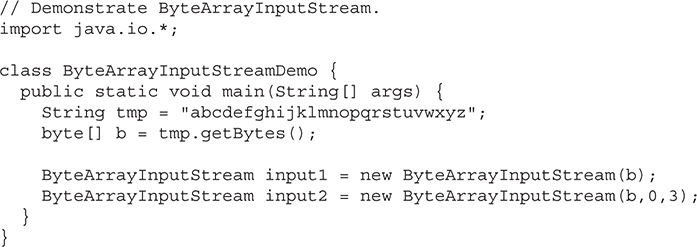
The input1 object contains the entire lowercase alphabet, whereas input2 contains only the first three letters.
A ByteArrayInputStream implements both mark( ) and reset( ). However, if mark( ) has not been called, then reset( ) sets the stream pointer to the start of the stream—which, in this case, is the start of the byte array passed to the constructor. The next example shows how to use the reset( ) method to read the same input twice. In this case, the program reads and prints the letters "abc" once in lowercase and then again in uppercase.
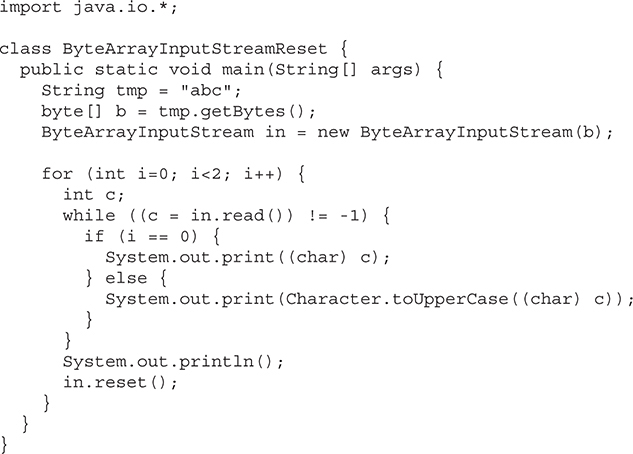
This example first reads each character from the stream and prints it as-is in lowercase. It then resets the stream and begins reading again, this time converting each character to uppercase before printing. Here’s the output:
abc
ABC
ByteArrayOutputStream is an implementation of an output stream that uses a byte array as the destination. ByteArrayOutputStream has two constructors, shown here:
ByteArrayOutputStream( )
ByteArrayOutputStream(int numBytes)
In the first form, a buffer of 32 bytes is created. In the second, a buffer is created with a size equal to that specified by numBytes. The buffer is held in the protected buf field of ByteArrayOutputStream. The buffer size will be increased automatically, if needed. The number of bytes held by the buffer is contained in the protected count field of ByteArrayOutputStream.
The close( ) method has no effect on a ByteArrayOutputStream. Therefore, it is not necessary to call close( ) on a ByteArrayOutputStream, but doing so is not an error.
The following example demonstrates ByteArrayOutputStream:
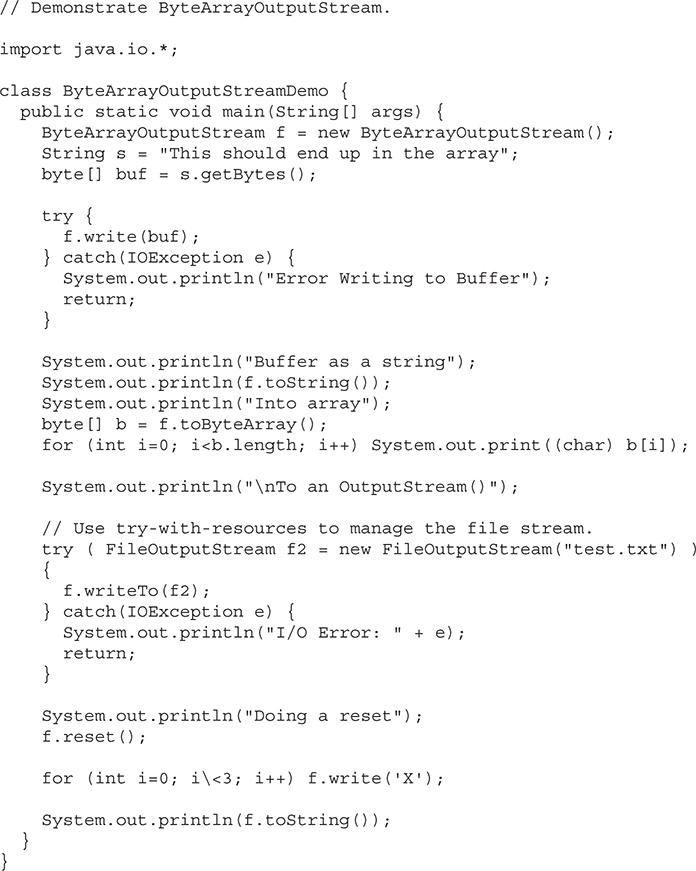
When you run the program, you will create the following output. Notice how after the call to reset( ), the three X’s end up at the beginning.
Buffer as a string
This should end up in the array
Into array
This should end up in the array
To an OutputStream()
Doing a reset
XXX
This example uses the writeTo( ) convenience method to write the contents of f to test.txt. Examining the contents of the test.txt file created in the preceding example shows the result we expected:
This should end up in the array
Filtered streams are simply wrappers around underlying input or output streams that transparently provide some extended level of functionality. These streams are typically accessed by methods that are expecting a generic stream, which is a superclass of the filtered streams. Typical extensions are buffering, character translation, and raw data translation. The filtered byte streams are FilterInputStream and FilterOutputStream. Their constructors are shown here:
FilterOutputStream(OutputStream os)
FilterInputStream(InputStream is)
The methods provided in these classes are identical to those in InputStream and OutputStream.
For the byte-oriented streams, a buffered stream extends a filtered stream class by attaching a memory buffer to the I/O stream. This buffer allows Java to do I/O operations on more than a byte at a time, thereby improving performance. Because the buffer is available, skipping, marking, and resetting of the stream become possible. The buffered byte stream classes are BufferedInputStream and BufferedOutputStream. PushbackInputStream also implements a buffered stream.
Buffering I/O is a very common performance optimization. Java’s BufferedInputStream class allows you to "wrap" any InputStream into a buffered stream to improve performance.
BufferedInputStream has two constructors:
BufferedInputStream(InputStream inputStream)
BufferedInputStream(InputStream inputStream, int bufSize)
The first form creates a buffered stream using a default buffer size. In the second, the size of the buffer is passed in bufSize. Use of sizes that are multiples of a memory page, a disk block, and so on, can have a significant positive impact on performance. This is, however, implementation-dependent. An optimal buffer size is generally dependent on the host operating system, the amount of memory available, and how the machine is configured. To make good use of buffering doesn’t necessarily require quite this degree of sophistication. A good guess for a size is around 8,192 bytes, and attaching even a rather small buffer to an I/O stream is always a good idea. That way, the low-level system can read blocks of data from the disk or network and store the results in your buffer. Thus, even if you are reading the data a byte at a time out of the InputStream, you will be manipulating fast memory most of the time.
Buffering an input stream also provides the foundation required to support moving backward in the stream of the available buffer. Beyond the read( ) and skip( ) methods implemented in any InputStream, BufferedInputStream also supports the mark( ) and reset( ) methods. This support is reflected by BufferedInputStream.markSupported( ) returning true.
The following example contrives a situation where we can use mark( ) to remember where we are in an input stream and later use reset( ) to get back there. This example is parsing a stream for the HTML entity reference for the copyright symbol. Such a reference begins with an ampersand (&) and ends with a semicolon (;) without any intervening whitespace. The sample input has two ampersands to show the case where the reset( ) happens and where it does not.
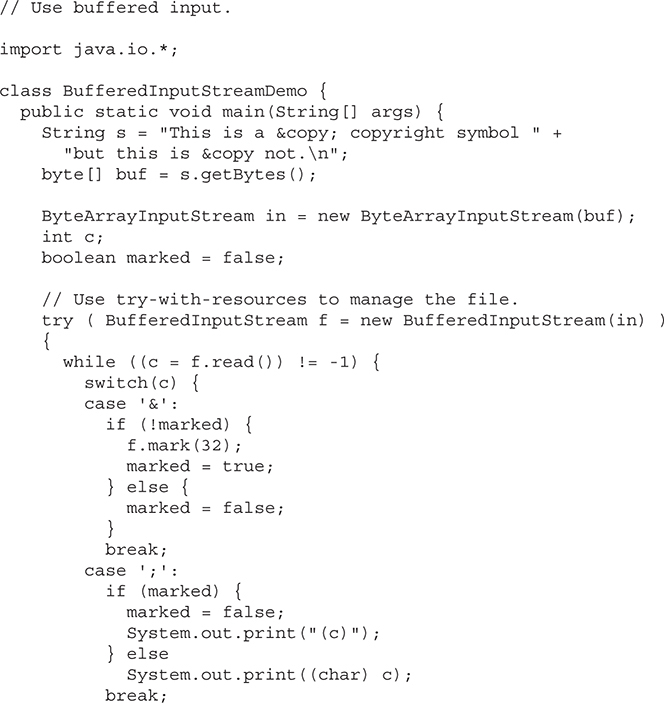
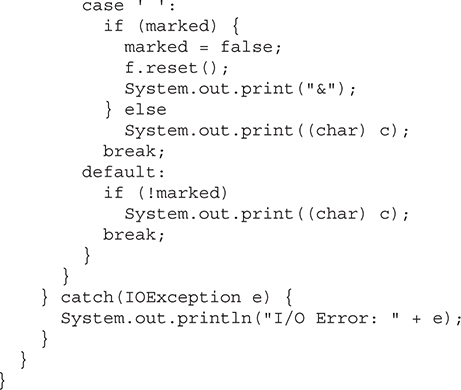
Notice that this example uses mark(32), which preserves the mark for the next 32 bytes read (which is enough for all entity references). Here is the output produced by this program:
This is a (c) copyright symbol but this is © not.
A BufferedOutputStream is similar to any OutputStream with the exception that the flush( ) method is used to ensure that data buffers are written to the stream being buffered. Since the point of a BufferedOutputStream is to improve performance by reducing the number of times the system actually writes data, you may need to call flush( ) to cause any data that is in the buffer to be immediately written.
Unlike buffered input, buffering output does not provide additional functionality. Buffers for output in Java are there to increase performance. Here are the two available constructors:
BufferedOutputStream(OutputStream outputStream)
BufferedOutputStream(OutputStream outputStream, int bufSize)
The first form creates a buffered stream using the default buffer size. In the second form, the size of the buffer is passed in bufSize.
One of the novel uses of buffering is the implementation of pushback. Pushback is used on an input stream to allow a byte to be read and then returned (that is, "pushed back") to the stream. The PushbackInputStream class implements this idea. It provides a mechanism to "peek" at what is coming from an input stream without disrupting it.
PushbackInputStream has the following constructors:
PushbackInputStream(InputStream inputStream)
PushbackInputStream(InputStream inputStream, int numBytes)
The first form creates a stream object that allows one byte to be returned to the input stream. The second form creates a stream that has a pushback buffer that is numBytes long. This allows multiple bytes to be returned to the input stream.
Beyond the familiar methods of InputStream, PushbackInputStream provides unread( ), shown here:
void unread(int b)
void unread(byte[ ] buffer)
void unread(byte buffer, int offset, int numBytes)
The first form pushes back the low-order byte of b. This will be the next byte returned by a subsequent call to read( ). The second form pushes back the bytes in buffer. The third form pushes back numBytes bytes beginning at offset from buffer. An IOException will be thrown if there is an attempt to push back a byte when the pushback buffer is full.
Here is an example that shows how a programming language parser might use a PushbackInputStream and unread( ) to deal with the difference between the = = operator for comparison and the = operator for assignment:
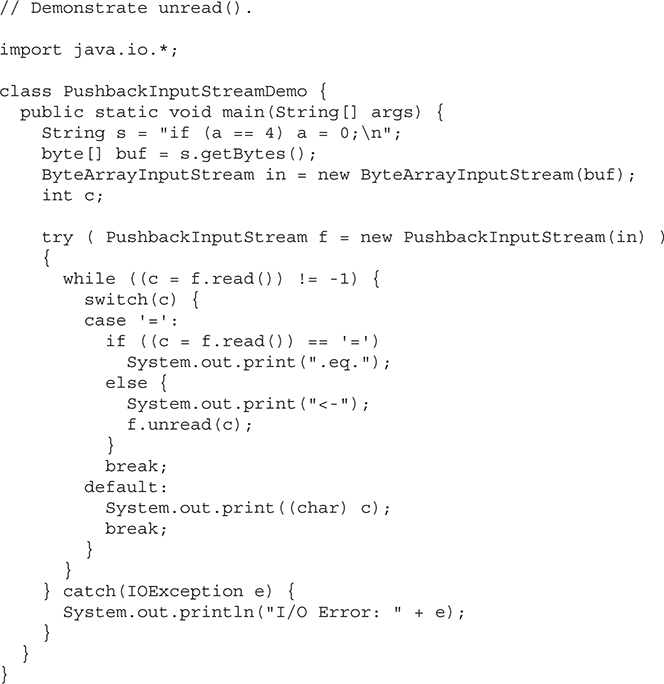
Here is the output for this example. Notice that == was replaced by ".eq." and = was replaced by "<–".
if (a .eq. 4) a <- 0;
Caution PushbackInputStream has the side effect of invalidating the mark( ) or reset( ) methods of the InputStream used to create it. Use markSupported( ) to check any stream on which you are going to use mark( )/reset( ).
The SequenceInputStream class allows you to concatenate multiple InputStreams. The construction of a SequenceInputStream is different from any other InputStream. A SequenceInputStream constructor uses either a pair of InputStreams or an Enumeration of InputStreams as its argument:
SequenceInputStream(InputStream first, InputStream second)
SequenceInputStream(Enumeration <? extends InputStream> streamEnum)
Operationally, the class fulfills read requests from the first InputStream until it runs out and then switches over to the second one. In the case of an Enumeration, it will continue through all of the InputStreams until the end of the last one is reached. When the end of each file is reached, its associated stream is closed. Closing the stream created by SequenceInputStream causes all unclosed streams to be closed.
Here is a simple example that uses a SequenceInputStream to output the contents of two files. For demonstration purposes, this program uses the traditional technique used to close a file. As an exercise, you might want to try changing it to use the try-with-resources statement.
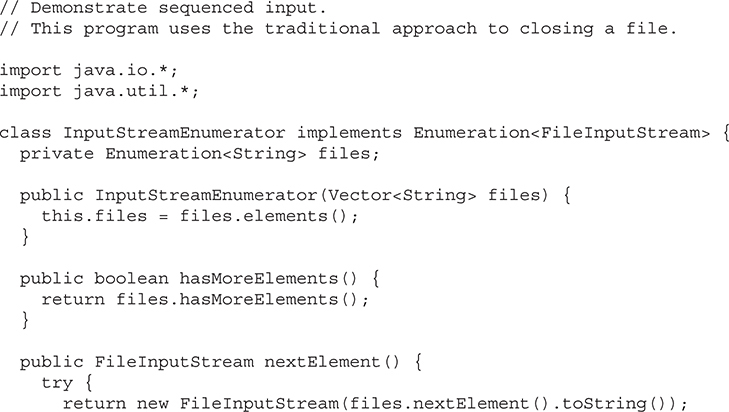
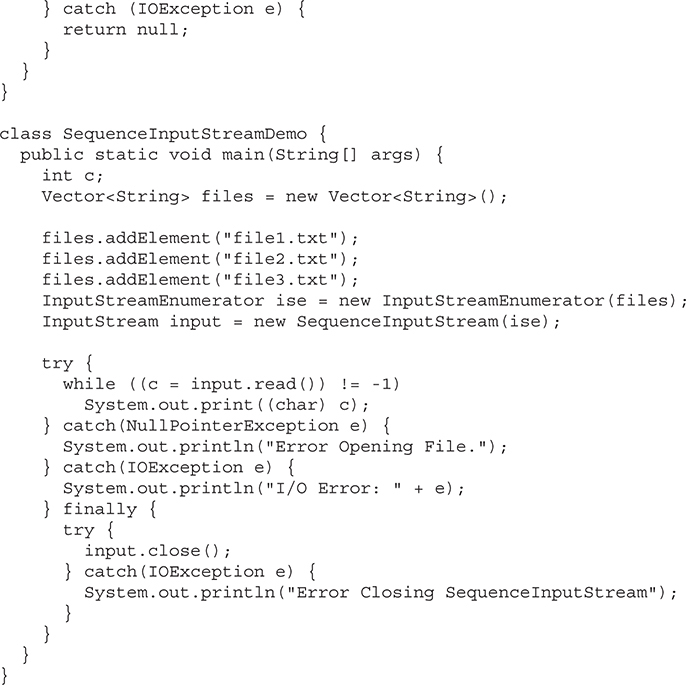
This example creates a Vector and then adds three filenames to it. It passes that vector of names to the InputStreamEnumerator class, which is designed to provide a wrapper on the vector where the elements returned are not the filenames but, rather, open FileInputStreams on those names. The SequenceInputStream opens each file in turn, and this example prints the contents of the files.
Notice in nextElement( ) that if a file cannot be opened, null is returned. This results in a NullPointerException, which is caught in main( ).
The PrintStream class provides all of the output capabilities we have been using from the System file handle, System.out, since the beginning of the book. This makes PrintStream one of Java’s most often used classes. It implements the Appendable, AutoCloseable, Closeable, and Flushable interfaces.
PrintStream defines several constructors. The ones shown next have been specified from the start:
PrintStream(OutputStream outputStream)
PrintStream(OutputStream outputStream, boolean autoFlushingOn)
PrintStream(OutputStream outputStream, boolean autoFlushingOn String charSet)
throws UnsupportedEncodingException
Here, outputStream specifies an open OutputStream that will receive output. The autoFlushingOn parameter controls whether the output buffer is automatically flushed every time a newline (\n) character or a byte array is written or when println( ) is called. If autoFlushingOn is true, flushing automatically takes place. If it is false, flushing is not automatic. The first constructor does not automatically flush. You can specify a character encoding by passing its name in charSet.
The next set of constructors gives you an easy way to construct a PrintStream that writes its output to a file:
PrintStream(File outputFile) throws FileNotFoundException
PrintStream(File outputFile, String charSet)
throws FileNotFoundException, UnsupportedEncodingException
PrintStream(String outputFileName) throws FileNotFoundException
PrintStream(String outputFileName, String charSet) throws FileNotFoundException,
UnsupportedEncodingException
These allow a PrintStream to be created from a File object or by specifying the name of a file. In either case, the file is automatically created. Any preexisting file by the same name is destroyed. Once created, the PrintStream object directs all output to the specified file. You can specify a character encoding by passing its name in charSet. There are also constructors that let you specify a Charset parameter.
Note If a security manager is present, some PrintStream constructors will throw a SecurityException if a security violation occurs. Be aware that the SecurityManager was deprecated for removal by JDK 17.
PrintStream supports the print( ) and println( ) methods for all types, including Object. If an argument is not a primitive type, the PrintStream methods will call the object’s toString( ) method and then display the result. PrintStream also supports a number of write( ) methods, and provides methods that handle errors.
A number of years ago a very useful method called printf( ) was added to PrintStream. It allows you to specify the precise format of the data to be written. The printf( ) method formats as described by the Formatter class discussed in Chapter 21. It then writes this data to the invoking stream. Although formatting can be done manually, by using Formatter directly, printf( ) streamlines the process. It also parallels the C/C++ printf( ) function, which makes it easy to convert existing C/C++ code into Java. Frankly, printf( ) was a much welcome addition to the Java API because it greatly simplified the output of formatted data to the console.
The printf( ) method has the following general forms:
PrintStream printf(String fmtString, Object … args)
PrintStream printf(Locale loc, String fmtString, Object … args)
The first version writes args to standard output in the format specified by fmtString, using the default locale. The second lets you specify a locale. Both return the invoking PrintStream.
In general, printf( ) works in a manner similar to the format( ) method specified by Formatter. The fmtString consists of two types of items. The first type is composed of characters that are simply copied to the output buffer. The second type contains format specifiers that define the way the subsequent arguments, specified by args, are displayed. For complete information on formatting output, including a description of the format specifiers, see the Formatter class in Chapter 20.
Because System.out is a PrintStream, you can call printf( ) on System.out. Thus, printf( ) can be used in place of println( ) when writing to the console whenever formatted output is desired. For example, the following program uses printf( ) to output numeric values in various formats. In the past, such formatting required a bit of work. With the addition of printf( ), this is now an easy task.
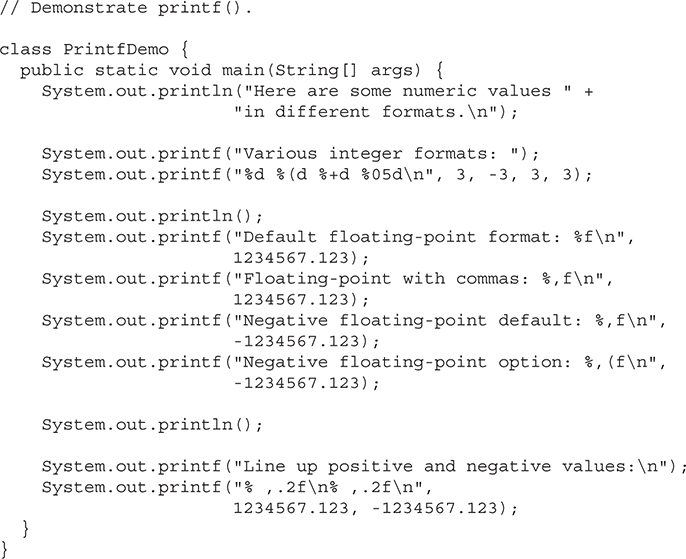
The output is shown here:
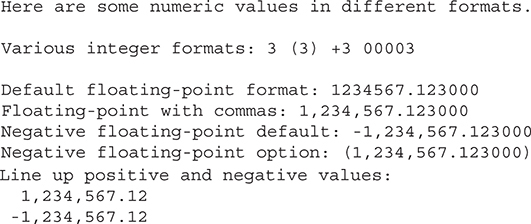
PrintStream also defines the format( ) method. It has these general forms:
PrintStream format(String fmtString, Object … args)
PrintStream format(Locale loc, String fmtString, Object … args)
It works exactly like printf( ).
DataOutputStream and DataInputStream enable you to write or read primitive data to or from a stream. They implement the DataOutput and DataInput interfaces, respectively. These interfaces define methods that convert primitive values to or from a sequence of bytes. These streams make it easy to store binary data, such as integers or floating-point values, in a file. Each is examined here.
DataOutputStream extends FilterOutputStream, which extends OutputStream. In addition to implementing DataOutput, DataOutputStream also implements AutoCloseable, Closeable, and Flushable. DataOutputStream defines the following constructor:
DataOutputStream(OutputStream outputStream)
Here, outputStream specifies the output stream to which data will be written. When a DataOutputStream is closed (by calling close( )), the underlying stream specified by outputStream is also closed automatically.
DataOutputStream supports all of the methods defined by its superclasses. However, it is the methods defined by the DataOutput interface, which it implements, that make it interesting. DataOutput defines methods that convert values of a primitive type into a byte sequence and then writes it to the underlying stream. Here is a sampling of these methods:
final void writeDouble(double value) throws IOException
final void writeBoolean(boolean value) throws IOException
final void writeInt(int value) throws IOException
Here, value is the value written to the stream.
DataInputStream is the complement of DataOuputStream. It extends FilterInputStream, which extends InputStream. In addition to implementing the DataInput interface, DataInputStream also implements AutoCloseable and Closeable. Here is its only constructor:
DataInputStream(InputStream inputStream)
Here, inputStream specifies the input stream from which data will be read. When a DataInputStream is closed (by calling close( )), the underlying stream specified by inputStream is also closed automatically.
Like DataOutputStream, DataInputStream supports all of the methods of its superclasses, but it is the methods defined by the DataInput interface that make it unique. These methods read a sequence of bytes and convert them into values of a primitive type. Here is a sampling of these methods:
final double readDouble( ) throws IOException
final boolean readBoolean( ) throws IOException
final int readInt( ) throws IOException
The following program demonstrates the use of DataOutputStream and DataInputStream:
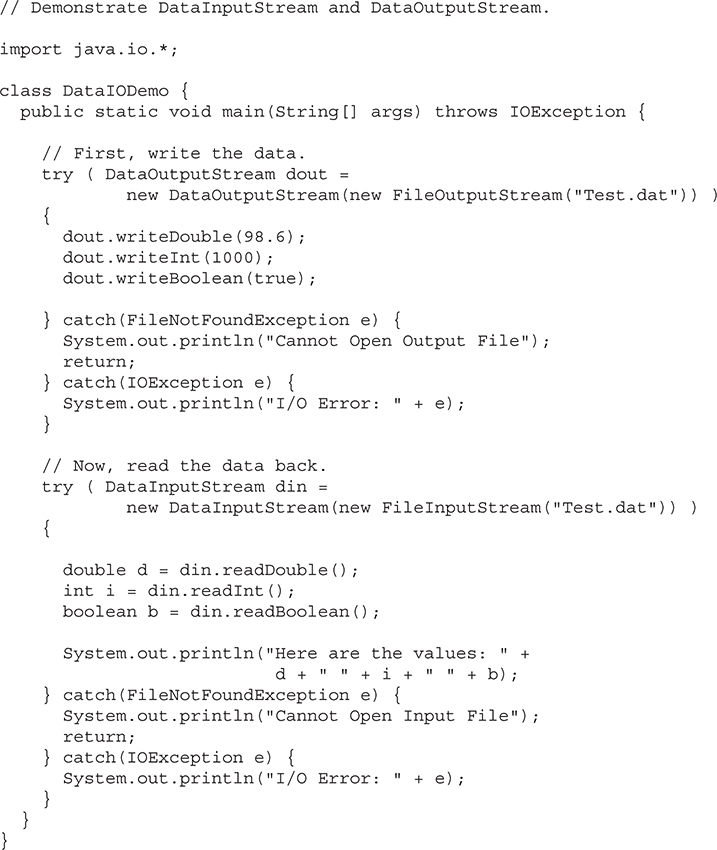
The output is shown here:
Here are the values: 98.6 1000 true
RandomAccessFile encapsulates a random-access file. It is not derived from InputStream or OutputStream. Instead, it implements the interfaces DataInput and DataOutput, which define the basic I/O methods. It also implements the AutoCloseable and Closeable interfaces. RandomAccessFile is special because it supports positioning requests—that is, you can position the file pointer within the file. It has these two constructors:
RandomAccessFile(File fileObj, String access)
throws FileNotFoundException
RandomAccessFile(String filename, String access)
throws FileNotFoundException
In the first form, fileObj specifies the file to open as a File object. In the second form, the name of the file is passed in filename. In both cases, access determines what type of file access is permitted. If it is "r", then the file can be read, but not written. If it is "rw", then the file is opened in read-write mode. If it is "rws", the file is opened for read-write operations and every change to the file’s data or metadata will be immediately written to the physical device. If it is "rwd", the file is opened for read-write operations and every change to the file’s data will be immediately written to the physical device.
The method seek( ), shown here, is used to set the current position of the file pointer within the file:
void seek(long newPos) throws IOException
Here, newPos specifies the new position, in bytes, of the file pointer from the beginning of the file. After a call to seek( ), the next read or write operation will occur at the new file position.
RandomAccessFile implements the standard input and output methods, which you can use to read and write to random access files. It also includes some additional methods. One is setLength( ). It has this signature:
void setLength(long len) throws IOException
This method sets the length of the invoking file to that specified by len. This method can be used to lengthen or shorten a file. If the file is lengthened, the added portion is undefined.
While the byte stream classes provide sufficient functionality to handle any type of I/O operation, they cannot work directly with Unicode characters. Since one of the main purposes of Java is to support the "write once, run anywhere" philosophy, it was necessary to include direct I/O support for characters. In this section, several of the character I/O classes are discussed. As explained earlier, at the top of the character stream hierarchies are the Reader and Writer abstract classes. We will begin with them.
Reader is an abstract class that defines Java’s model of streaming character input. It implements the AutoCloseable, Closeable, and Readable interfaces. All of the methods in this class (except for markSupported( )) will throw an IOException on error conditions. Table 22-3 provides a synopsis of the methods in Reader.
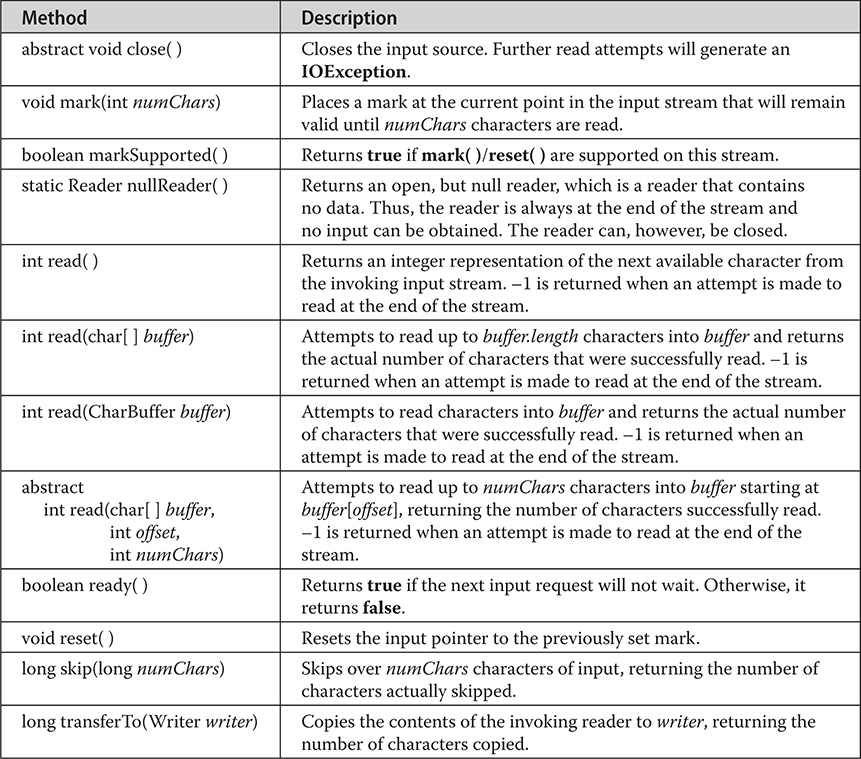
Table 22-3 The Methods Defined by Reader
Writer is an abstract class that defines streaming character output. It implements the AutoCloseable, Closeable, Flushable, and Appendable interfaces. All of the methods in this class throw an IOException in the case of errors. Table 22-4 shows a synopsis of the methods in Writer.
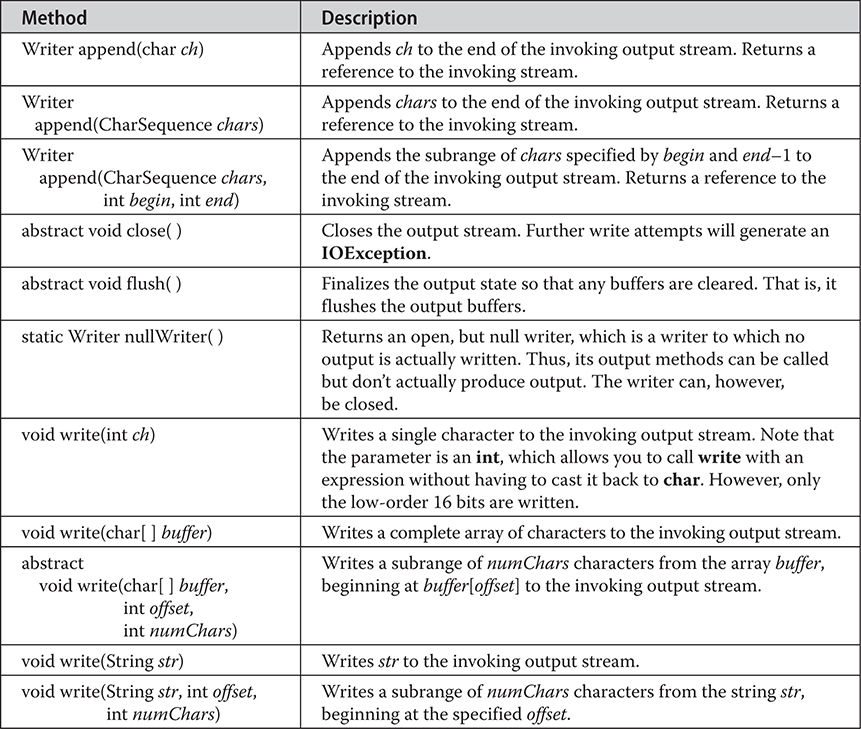
Table 22-4 The Methods Defined by Writer
The FileReader class creates a Reader that you can use to read the contents of a file. Two commonly used constructors are shown here:
FileReader(String filePath)
FileReader(File fileObj)
Either can throw a FileNotFoundException. Here, filePath is the full path name of a file, and fileObj is a File object that describes the file.
The following example shows how to read lines from a file and display them on the standard output device. It reads its own source file, which must be in the current directory.
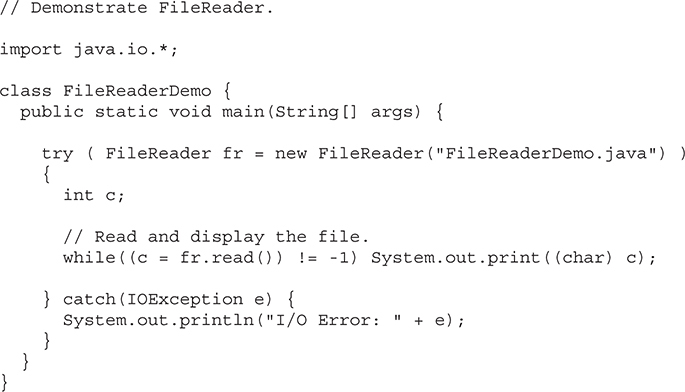
FileWriter creates a Writer that you can use to write to a file. Four commonly used constructors are shown here:
FileWriter(String filePath)
FileWriter(String filePath, boolean append)
FileWriter(File fileObj)
FileWriter(File fileObj, boolean append)
They can all throw an IOException. Here, filePath is the full path name of a file, and fileObj is a File object that describes the file. If append is true, then output is appended to the end of the file.
Creation of a FileWriter is not dependent on the file already existing. FileWriter will create the file before opening it for output when you create the object. In the case where you attempt to open a read-only file, an IOException will be thrown.
The following example is a character stream version of an example shown earlier when FileOutputStream was discussed. This version creates a sample buffer of characters by first making a String and then using the getChars( ) method to extract the character array equivalent. It then creates three files. The first, file1.txt, will contain every other character from the sample. The second, file2.txt, will contain the entire set of characters. Finally, the third, file3.txt, will contain only the last quarter.
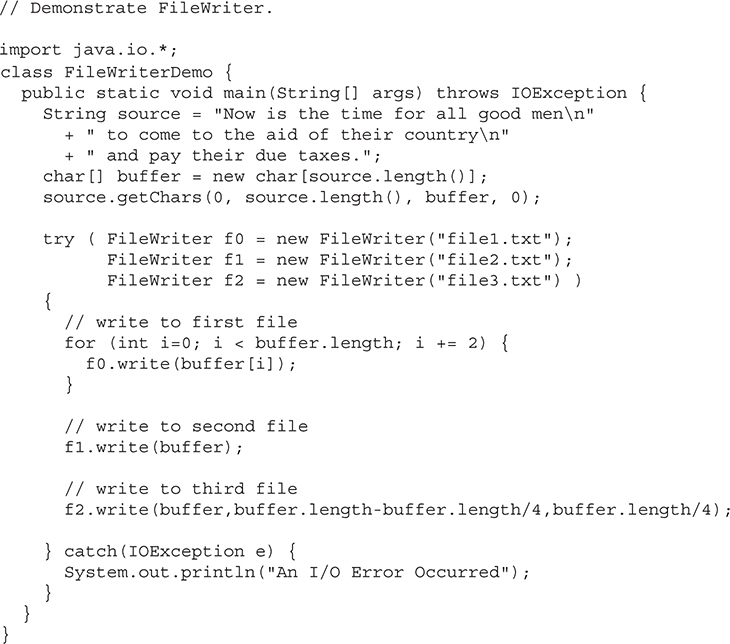
CharArrayReader is an implementation of an input stream that uses a character array as the source. This class has two constructors, each of which requires a character array to provide the data source:
CharArrayReader(char[ ] array)
CharArrayReader(char[ ] array, int start, int numChars)
Here, array is the input source. The second constructor creates a Reader from a subset of your character array that begins with the character at the index specified by start and is numChars long.
The close( ) method implemented by CharArrayReader does not throw any exceptions. This is because it cannot fail.
The following example uses a pair of CharArrayReaders:
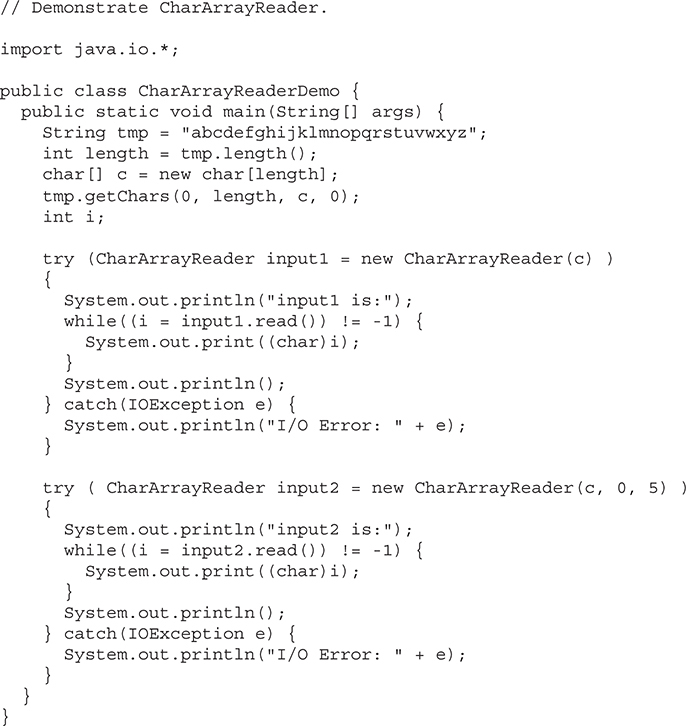
The input1 object is constructed using the entire lowercase alphabet, whereas input2 contains only the first five letters. Here is the output:
input1 is:
abcdefghijklmnopqrstuvwxyz
input2 is:
abcde
CharArrayWriter is an implementation of an output stream that uses an array as the destination. CharArrayWriter has two constructors, shown here:
CharArrayWriter( )
CharArrayWriter(int numChars)
In the first form, a buffer with a default size is created. In the second, a buffer is created with a size equal to that specified by numChars. The buffer is held in the buf field of CharArrayWriter. The buffer size will be increased automatically, if needed. The number of characters held by the buffer is contained in the count field of CharArrayWriter. Both buf and count are protected fields.
The close( ) method has no effect on a CharArrayWriter.
The following example demonstrates CharArrayWriter by reworking the sample program shown earlier for ByteArrayOutputStream. It produces the same output as the previous version.
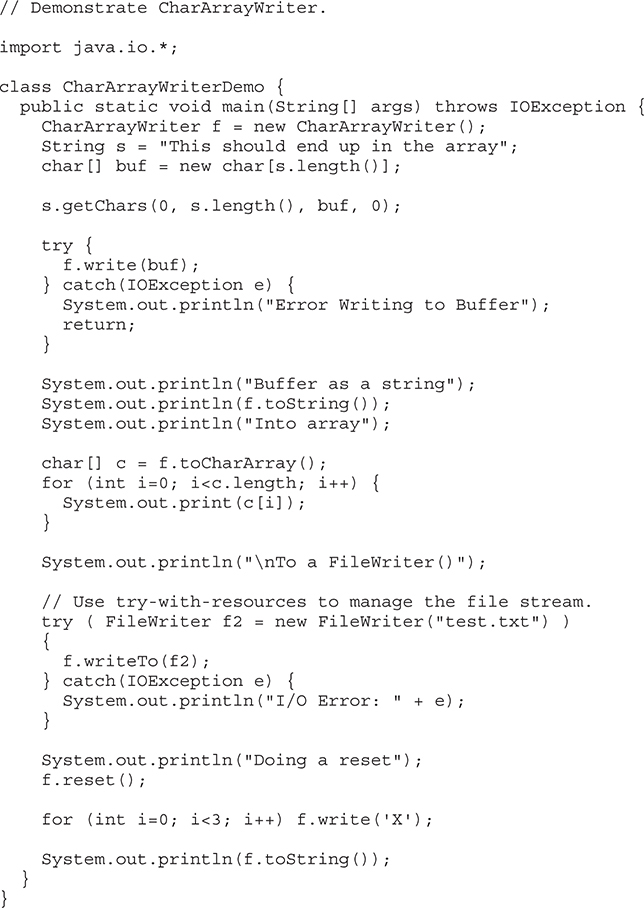
BufferedReader improves performance by buffering input. It has two constructors:
BufferedReader(Reader inputStream)
BufferedReader(Reader inputStream, int bufSize)
The first form creates a buffered character stream using a default buffer size. In the second, the size of the buffer is passed in bufSize.
Closing a BufferedReader also causes the underlying stream specified by inputStream to be closed.
As is the case with the byte-oriented stream, buffering an input character stream also provides the foundation required to support moving backward in the stream within the available buffer. To support this, BufferedReader implements the mark( ) and reset( ) methods, and BufferedReader.markSupported( ) returns true. A relatively recent addition to BufferedReader is called lines( ). It returns a Stream reference to the sequence of lines read by the reader. (Stream is part of the stream API discussed in Chapter 30.)
The following example reworks the BufferedInputStream example, shown earlier, so that it uses a BufferedReader character stream rather than a buffered byte stream. As before, it uses the mark( ) and reset( ) methods to parse a stream for the HTML entity reference for the copyright symbol. Such a reference begins with an ampersand (&) and ends with a semicolon (;) without any intervening whitespace. The sample input has two ampersands to show the case where the reset( ) happens and where it does not. Output is the same as that shown earlier.
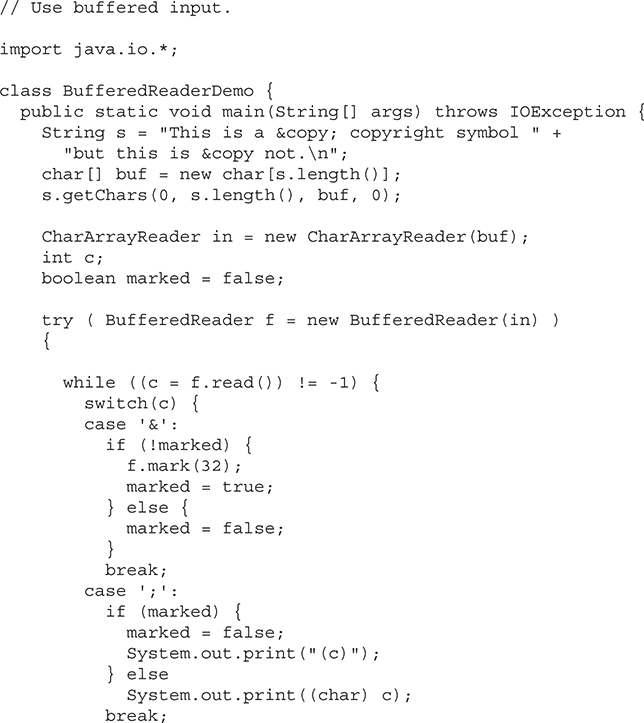
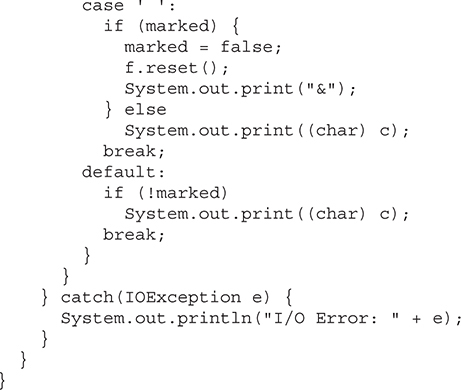
A BufferedWriter is a Writer that buffers output. Using a BufferedWriter can improve performance by reducing the number of times data is actually physically written to the output device.
A BufferedWriter has these two constructors:
BufferedWriter(Writer outputStream)
BufferedWriter(Writer outputStream, int bufSize)
The first form creates a buffered stream using a buffer with a default size. In the second, the size of the buffer is passed in bufSize.
The PushbackReader class allows one or more characters to be returned to the input stream. This allows you to look ahead in the input stream. Here are its two constructors:
PushbackReader(Reader inputStream)
PushbackReader(Reader inputStream, int bufSize)
The first form creates a buffered stream that allows one character to be pushed back. In the second, the size of the pushback buffer is passed in bufSize.
Closing a PushbackReader also closes the underlying stream specified by inputStream.
PushbackReader provides unread( ), which returns one or more characters to the invoking input stream. It has the three forms shown here:
void unread(int ch) throws IOException
void unread(char[ ] buffer) throws IOException
void unread(char[ ] buffer, int offset, int numChars) throws IOException
The first form pushes back the character passed in ch. This will be the next character returned by a subsequent call to read( ). The second form returns the characters in buffer. The third form pushes back numChars characters beginning at offset from buffer. An IOException will be thrown if there is an attempt to return a character when the pushback buffer is full.
The following program reworks the earlier PushbackInputStream example by replacing PushbackInputStream with PushbackReader. As before, it shows how a programming language parser can use a pushback stream to deal with the difference between the == operator for comparison and the = operator for assignment.
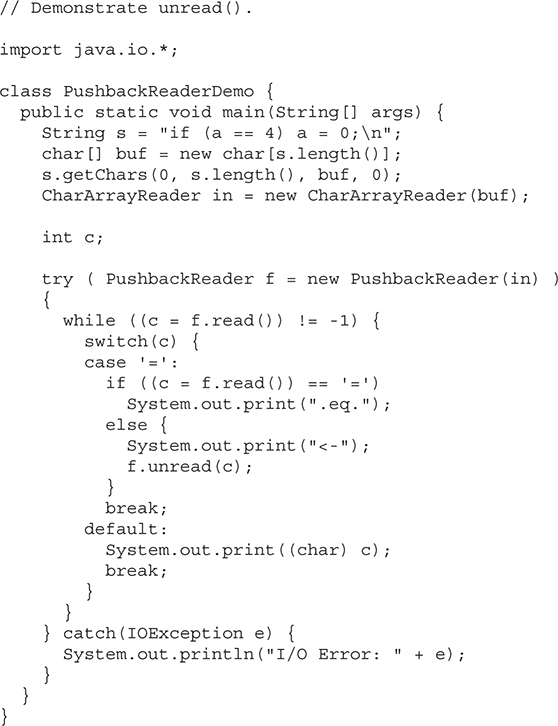
PrintWriter is essentially a character-oriented version of PrintStream. It implements the Appendable, AutoCloseable, Closeable, and Flushable interfaces. PrintWriter has several constructors. The following have been supplied by PrintWriter from the start:
PrintWriter(OutputStream outputStream)
PrintWriter(OutputStream outputStream, boolean autoFlushingOn)
PrintWriter(Writer outputStream)
PrintWriter(Writer outputStream, boolean autoFlushingOn)
Here, outputStream specifies an open OutputStream that will receive output. The autoFlushingOn parameter controls whether the output buffer is automatically flushed every time println( ), printf( ), or format( ) is called. If autoFlushingOn is true, flushing automatically takes place. If false, flushing is not automatic. Constructors that do not specify the autoFlushingOn parameter do not automatically flush.
The next set of constructors gives you an easy way to construct a PrintWriter that writes its output to a file.
PrintWriter(File outputFile) throws FileNotFoundException
PrintWriter(File outputFile, String charSet)
throws FileNotFoundException, UnsupportedEncodingException
PrintWriter(String outputFileName) throws FileNotFoundException
PrintWriter(String outputFileName, String charSet)
throws FileNotFoundException, UnsupportedEncodingException
These allow a PrintWriter to be created from a File object or by specifying the name of a file. In either case, the file is automatically created. Any preexisting file by the same name is destroyed. Once created, the PrintWriter object directs all output to the specified file. You can specify a character encoding by passing its name in charSet. There are also constructors that let you specify a Charset parameter.
PrintWriter supports the print( ) and println( ) methods for all types, including Object. If an argument is not a primitive type, the PrintWriter methods will call the object’s toString( ) method and then output the result.
PrintWriter also supports the printf( ) method. It works the same way it does in the PrintStream class described earlier: It allows you to specify the precise format of the data. Here is how printf( ) is declared in PrintWriter:
PrintWriter printf(String fmtString, Object … args)
PrintWriter printf(Locale loc, String fmtString, Object …args)
The first version writes args to standard output in the format specified by fmtString, using the default locale. The second lets you specify a locale. Both return the invoking PrintWriter.
The format( ) method is also supported. It has these general forms:
PrintWriter format(String fmtString, Object … args)
PrintWriter format(Locale loc, String fmtString, Object … args)
It works exactly like printf( ).
The Console class is used to read from and write to the console, if one exists. It implements the Flushable interface. Console is primarily a convenience class because most of its functionality is available through System.in and System.out. However, its use can simplify some types of console interactions, especially when reading strings from the console.
Console supplies no constructors. Instead, a Console object is obtained by calling System.console( ), which is shown here:
static Console console( )
If a console is available, then a reference to it is returned. Otherwise, null is returned. A console will not be available in all cases. Thus, if null is returned, no console I/O is possible.
Console defines the methods shown in Table 22-5. Notice that the input methods, such as readLine( ), throw IOError if an input error occurs. IOError is a subclass of Error. It indicates an I/O failure that is beyond the control of your program. Thus, you will not normally catch an IOError. Frankly, if an IOError is thrown while accessing the console, it usually means there has been a catastrophic system failure.
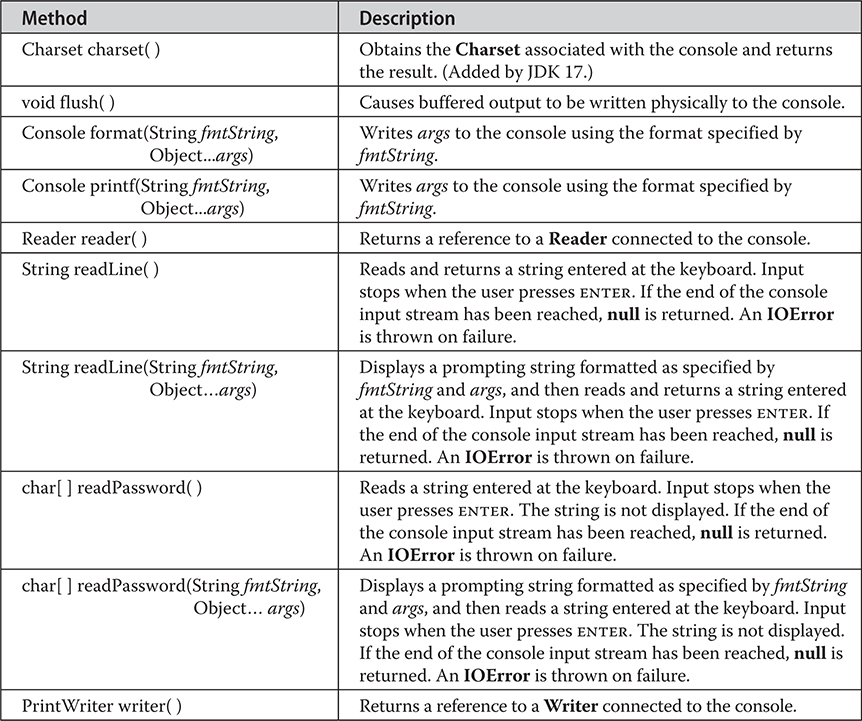
Table 22-5 The Methods Defined by Console
Also notice the readPassword( ) methods. These methods let your application read a password without echoing what is typed. After reading passwords, you should "zero-out" both the array that holds the string entered by the user and the array that holds the password that the string is tested against. This reduces the chance that a malicious program will be able to obtain a password by scanning memory.
Here is an example that demonstrates the Console class:
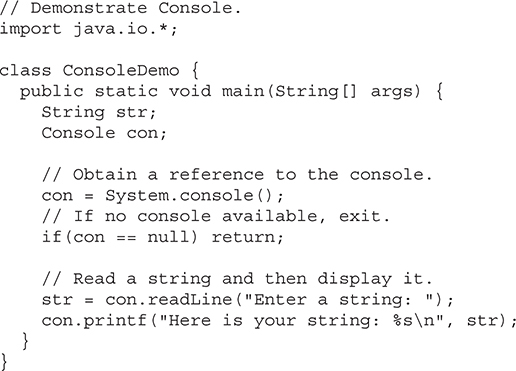
Here is sample output:
Enter a string: This is a test.
Here is your string: This is a test.
Serialization is the process of writing the state of an object to a byte stream. This is useful when you want to save the state of your program to a persistent storage area, such as a file. At a later time, you may restore these objects by using the process of deserialization.
Serialization is also needed to implement Remote Method Invocation (RMI). RMI allows a Java object on one machine to invoke a method of a Java object on a different machine. An object may be supplied as an argument to that remote method. The sending machine serializes the object and transmits it. The receiving machine deserializes it. (More information about RMI appears in Chapter 31.)
Assume that an object to be serialized has references to other objects, which, in turn, have references to still more objects. This set of objects and the relationships among them form a directed graph. There may also be circular references within this object graph. That is, object X may contain a reference to object Y, and object Y may contain a reference back to object X. Objects may also contain references to themselves. The object serialization and deserialization facilities have been designed to work correctly in these scenarios. If you attempt to serialize an object at the top of an object graph, all of the other referenced objects are recursively located and serialized. Similarly, during the process of deserialization, all of these objects and their references are correctly restored. It is important to note that serialization and deserialization can impact security, especially as it relates to the deserialization of items that you do not trust (i.e., untrusted data). Because the topic of security is outside the scope of this book, consult the Java documentation for the latest information about this and about security in general.
An overview of the interfaces and classes that support serialization follows.
Only an object that implements the Serializable interface can be saved and restored by the serialization facilities. The Serializable interface defines no members. It is simply used to indicate that a class may be serialized. If a class is serializable, all of its subclasses are also serializable.
In general, all instance variables are saved by serialization. However, variables that are declared as transient are not saved by the serialization facilities. Also, static variables are not saved. (It is also possible to explicitly specify which variables will be saved by using a serialPersistentFields array.)
The Java facilities for serialization and deserialization have been designed so that much of the work to save and restore the state of an object occurs automatically. However, there are cases in which the programmer may need to have control over these processes. For example, it may be desirable to use compression or encryption techniques. The Externalizable interface is designed for these situations.
The Externalizable interface defines these two methods:
void readExternal(ObjectInput inStream)
throws IOException, ClassNotFoundException
void writeExternal(ObjectOutput outStream)
throws IOException
In these methods, inStream is the byte stream from which the object is to be read, and outStream is the byte stream to which the object is to be written.
The ObjectOutput interface extends the DataOutput and AutoCloseable interfaces and supports object serialization. It defines the methods shown in Table 22-6. Note especially the writeObject( ) method. This is called to serialize an object. All of these methods will throw an IOException on error conditions.
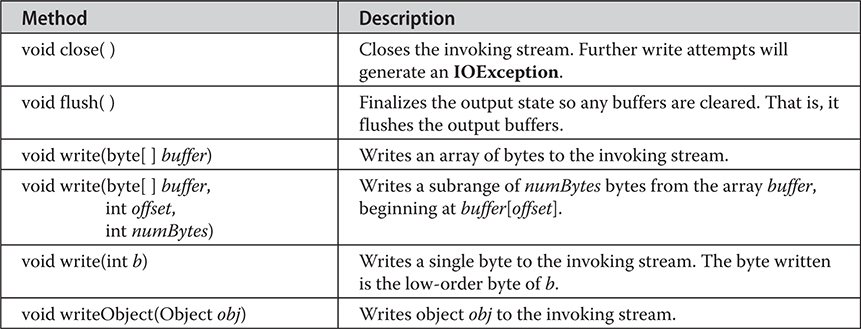
Table 22-6 The Methods Defined by ObjectOutput
The ObjectOutputStream class extends the OutputStream class and implements the ObjectOutput interface. It is responsible for writing objects to a stream. One constructor of this class is shown here:
ObjectOutputStream(OutputStream outStream) throws IOException
The argument outStream is the output stream to which serialized objects will be written. Closing an ObjectOutputStream automatically closes the underlying stream specified by outStream.
Several commonly used methods in this class are shown in Table 22-7. They will throw an IOException on error conditions. There is also a nested class in ObjectOuputStream called PutField. It facilitates the writing of persistent fields, and its use is beyond the scope of this book.
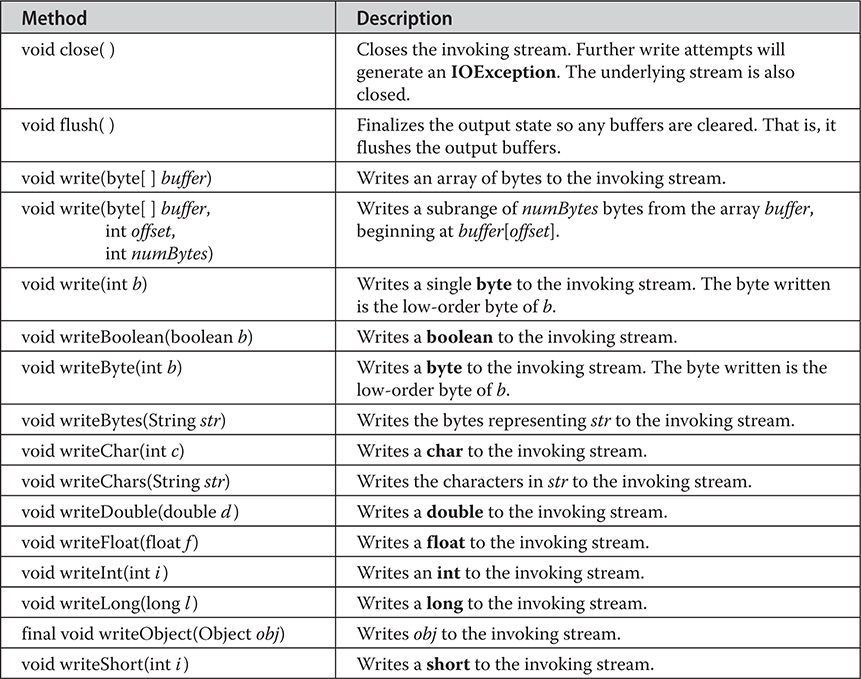
Table 22-7 A Sampling of Commonly Used Methods Defined by ObjectOutputStream
The ObjectInput interface extends the DataInput and AutoCloseable interfaces and defines the methods shown in Table 22-8. It supports object serialization. Note especially the readObject( ) method. This is called to deserialize an object. All of these methods will throw an IOException on error conditions. The readObject( ) method can also throw ClassNotFoundException.
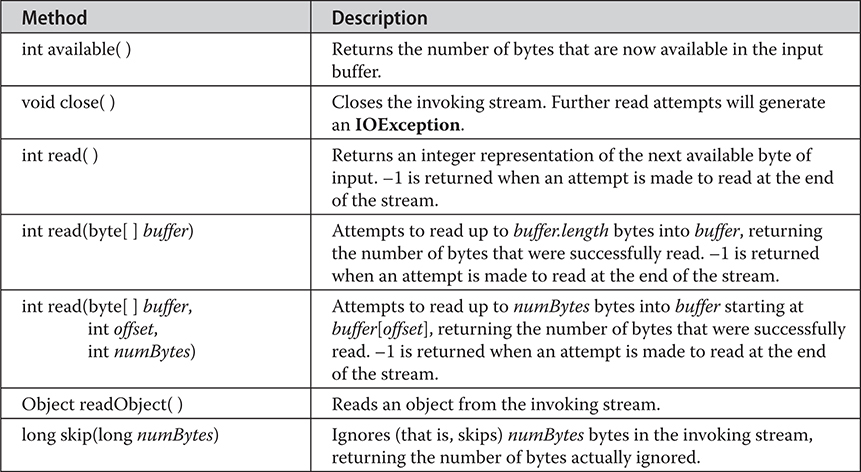
Table 22-8 The Methods Defined by ObjectInput
The ObjectInputStream class extends the InputStream class and implements the ObjectInput interface. ObjectInputStream is responsible for reading objects from a stream. One constructor of this class is shown here:
ObjectInputStream(InputStream inStream) throws IOException
The argument inStream is the input stream from which serialized objects should be read. Closing an ObjectInputStream automatically closes the underlying stream specified by inStream.
Several commonly used methods in this class are shown in Table 22-9. They will throw an IOException on error conditions. The readObject( ) method can also throw ClassNotFoundException. There is also a nested class in ObjectInputStream called GetField. It facilitates the reading of persistent fields, and its use is beyond the scope of this book.
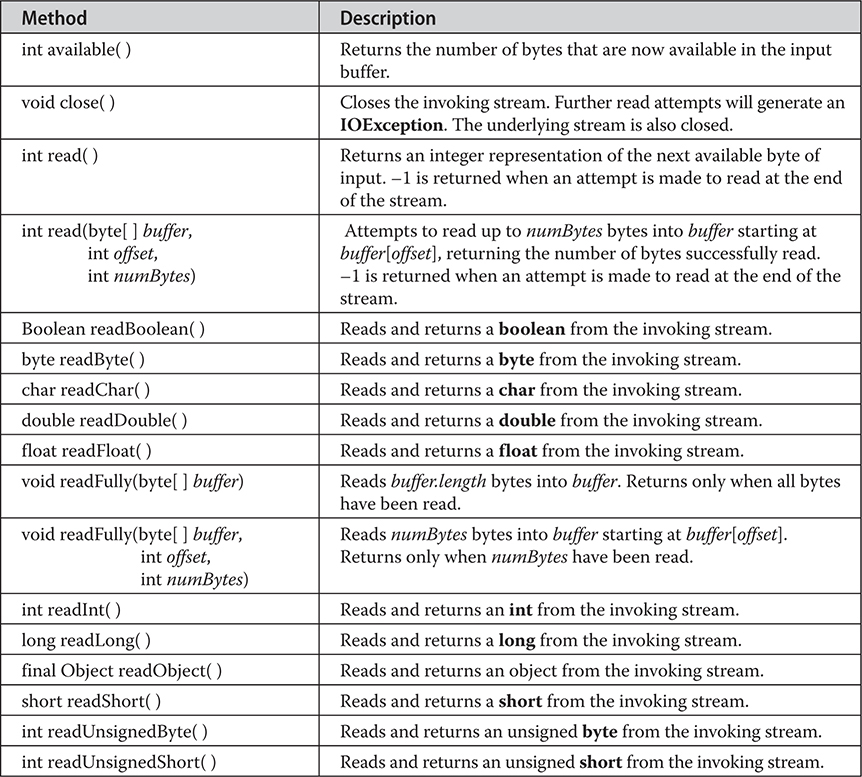
Table 22-9 Commonly Used Methods Defined by ObjectInputStream
Beginning with JDK 9, ObjectInputStream includes the methods getObjectInputFilter( ) and setObjectInputFilter( ). These support the filtering of object input streams through the use of ObjectInputFilter, ObjectInputFilter.FilterInfo, ObjectInputFilter.Config, and ObjectInputFilter.Status, which were all added by JDK 9. Filtering gives you a measure of control over deserialization.
The following program illustrates the basic mechanism of object serialization and deserialization. It begins by instantiating an object of class MyClass. This object has three instance variables that are of types String, int, and double. This is the information we want to save and restore.
A FileOutputStream is created that refers to a file named "serial", and an ObjectOutputStream is created for that file stream. The writeObject( ) method of ObjectOutputStream is then used to serialize our object. The object output stream is flushed and closed.
A FileInputStream is then created that refers to the file named "serial", and an ObjectInputStream is created for that file stream. The readObject( ) method of ObjectInputStream is then used to deserialize our object. The object input stream is then closed.
Note that MyClass is defined to implement the Serializable interface. If this is not done, a NotSerializableException is thrown. Try experimenting with this program by declaring some of the MyClass instance variables to be transient. That data is then not saved during serialization.
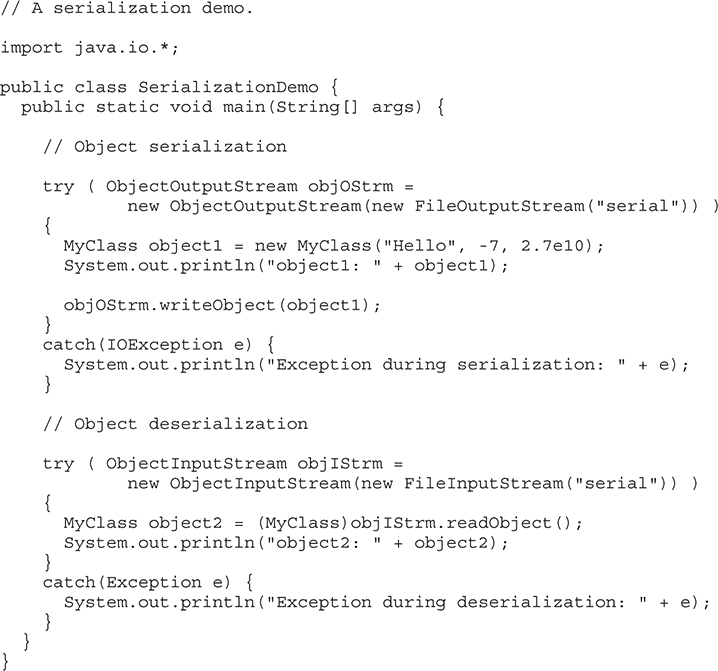
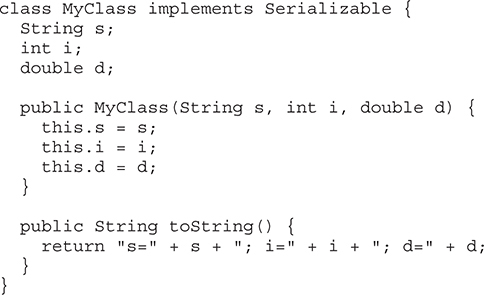
This program demonstrates that the instance variables of object1 and object2 are identical. The output is shown here:
object1: s=Hello; i=-7; d=2.7E10
object2: s=Hello; i=-7; d=2.7E10
For classes that you intend to serialize, you will normally want them to define the static, final, long constant serialVersionUID as a private member. Although Java will automatically define this value (as is the case for MyClass in the preceding example), for real world applications, it is far better for you to define this value explicitly.
The preceding example demonstrated the basic mechanism used to write and read serialized data. Another key feature related to serialization is the deserialization filter. A deserialization filter gives you a degree of control over the deserialization process. Although deserialization filters can be quite sophisticated, it is easy to add a simple one to an ObjectInputStream. The following example illustrates the general steps involved.
Assuming the SerializationDemo program, this sequence adds a deserialization filter to the code that reads a MyClass object. It ensures that objIStrm will deserialize only a MyClass object. An attempt to deserialize any other class will cause an exception at runtime.
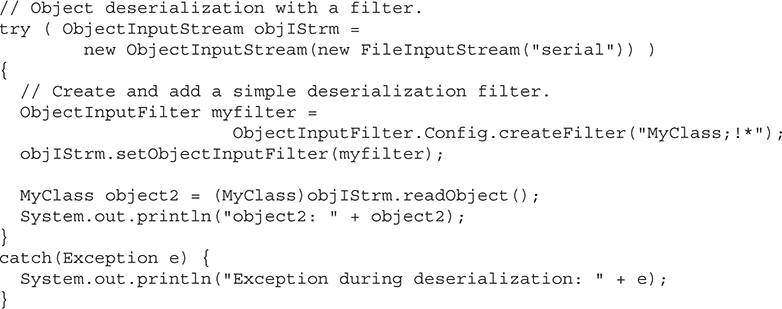
The key lines are

An ObjectInputFilter is created by calling the static createFilter( ) method defined by the ObjectInputFilter.Config nested class. This method lets you specify a string pattern that helps validate input. For example, you can specify one or more class names for which serialization will be allowed, with each name separated by a semicolon. In this case, MyClass is specified. The pattern !* specifies that all other classes are to be rejected. As a result, only instances of MyClass are allowed to be deserialized. In general, putting a ! before a class causes the class to be rejected. The * is a wildcard character that matches all class names. Once the filter has been created, it is associated with objIStrm by a call to setObjectInputFilter( ). After this call, the stream filter will be active on the input stream.
The preceding example specifies a filter specific to objIStrm. Thus, another ObjectInputStream will not have the same filter. You can, however, define a filter that will be used by all ObjectInputStreams. This is called a JVM-wide filter. It is set by calling the setSerialFilter( ) method in ObjectInputFilter.Config. For example, after this sequence, all ObjectInputStreams will use the specified filter:
ObjectInputFilter.Config.setSerialFilter(myfilter);
It is important to understand that whether a JVM-wide filter or a stream-specific filter is used, you must set it before reading from the stream. Furthermore, when a JVM-wide filter is used, it must be set before an ObjectInputStream is created. Also, a filter can only be set once.
When using a filter, you can also check various resource limits. The limits are specified by the maxdepth, maxrefs, maxbytes, and maxarray patterns, which must include a = followed by a value. For example, the maxbytes limits specifies the maximum length of the input stream. Here is the preceding filter, rewritten to include a maximum input stream length of 80 bytes:

Now, any ObjectInputStream that supplies more than 80 bytes will be rejected.
In addition to the examples just shown, there are several other filter pattern options available. Check the Java documentation for additional information on deserialization filters. One last point: There are documentation comments that pertain to serialization. (See Appendix A where documentation comments are discussed.)
Remember There are significant security issues surrounding serialization and deserialization. It is important to consult the latest Java documentation in this regard.
The streaming interface to I/O in Java provides a clean abstraction for a complex and often cumbersome task. The composition of the filtered stream classes allows you to dynamically build the custom streaming interface to suit your data transfer requirements. Java programs written to adhere to the abstract, high-level InputStream, OutputStream, Reader, and Writer classes should continue to function properly in the future even if concrete stream classes evolve. As you will see in Chapter 24, this model works very well when we switch from a file system-based set of streams to the network and socket streams. Finally, serialization of objects plays an important role in many types of Java programs. Java’s serialization I/O classes provide a portable solution to this sometimes tricky task.
Beginning with version 1.4, Java has provided a second I/O system called NIO (which is short for New I/O). It supports a buffer-oriented, channel-based approach to I/O operations. With the release of JDK 7, the NIO system was greatly expanded, providing enhanced support for file-handling and file system features. In fact, so significant were the changes that the term NIO.2 is often used. Because of the capabilities supported by the NIO file classes, NIO has become an important approach to file handling. This chapter explores several of the key features of the NIO system.
The NIO classes are contained in the packages shown here. Beginning with JDK 9, all are in the java.base module.
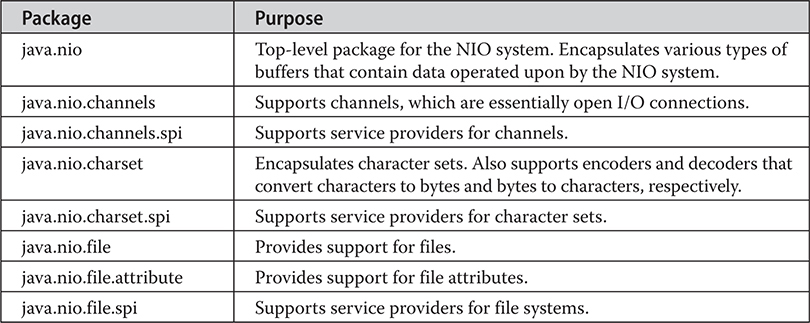
Before we begin, it is important to emphasize that the NIO subsystem does not replace the stream-based I/O classes found in java.io, which are discussed in Chapter 22, and good working knowledge of the stream-based I/O in java.io is helpful to understanding NIO.
Note This chapter assumes that you have read the overview of I/O given in Chapter 13 and the discussion of stream-based I/O supplied in Chapter 22.
The NIO system is built on two foundational items: buffers and channels. A buffer holds data. A channel represents an open connection to an I/O device, such as a file or a socket. In general, to use the NIO system, you obtain a channel to an I/O device and a buffer to hold data. You then operate on the buffer, inputting or outputting data as needed. The following sections examine buffers and channels in more detail.
Buffers are defined in the java.nio package. All buffers are subclasses of the Buffer class, which defines the core functionality common to all buffers: current position, limit, and capacity. The current position is the index within the buffer at which the next read or write operation will take place. The current position is advanced by most read or write operations. The limit is the index value one past the last valid location in the buffer. The capacity is the number of elements that the buffer can hold. Often the limit equals the capacity of the buffer. Buffer also supports mark and reset. Buffer defines several methods, which are shown in Table 23-1.
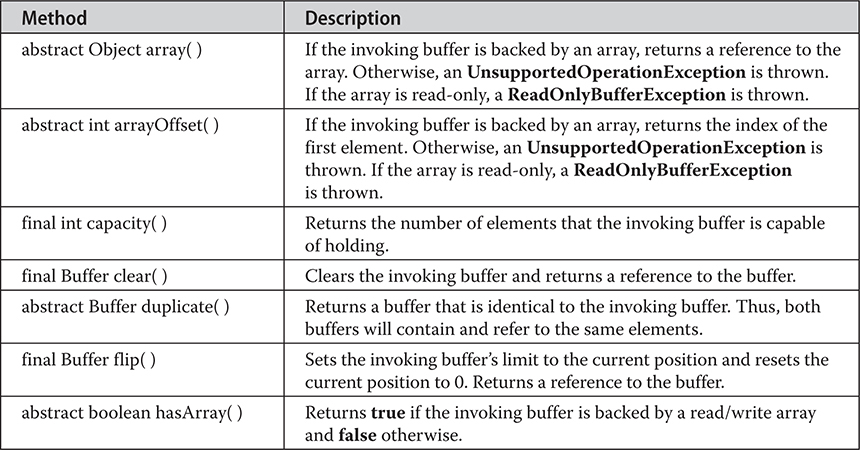
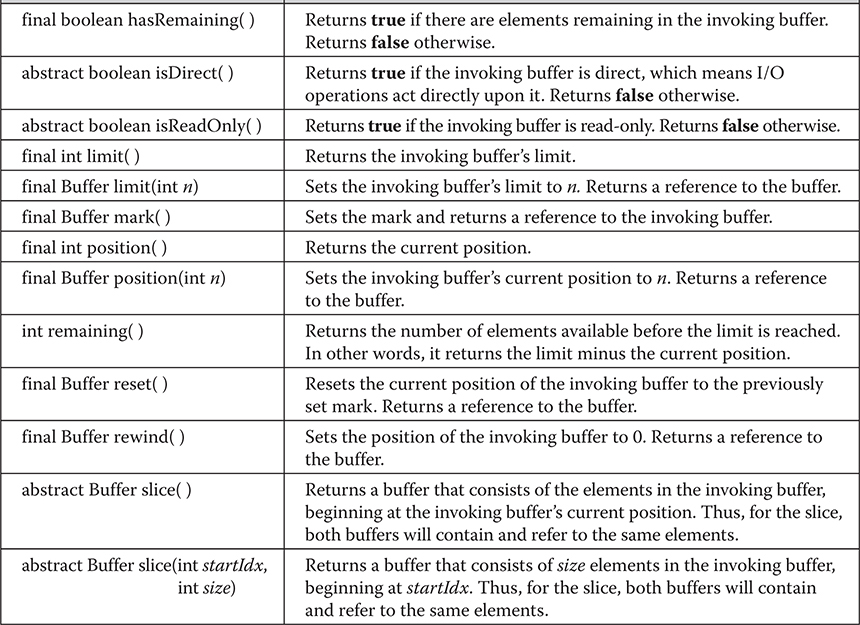
Table 23-1 The Methods Defined by Buffer
From Buffer, the following specific buffer classes are derived, which hold the type of data that their names imply:

MappedByteBuffer is a subclass of ByteBuffer and is used to map a file to a buffer.
All of the aforementioned buffers provide various get( ) and put( ) methods, which allow you to get data from a buffer or put data into a buffer. (Of course, if a buffer is read-only, then put( ) operations are not available.) Table 23-2 shows the get( ) and put( ) methods defined by ByteBuffer. The other buffer classes have similar methods. All buffer classes also support methods that perform various buffer operations. For example, you can allocate a buffer manually using allocate( ). You can wrap an array inside a buffer using wrap( ). You can create a subsequence of a buffer using slice( ).
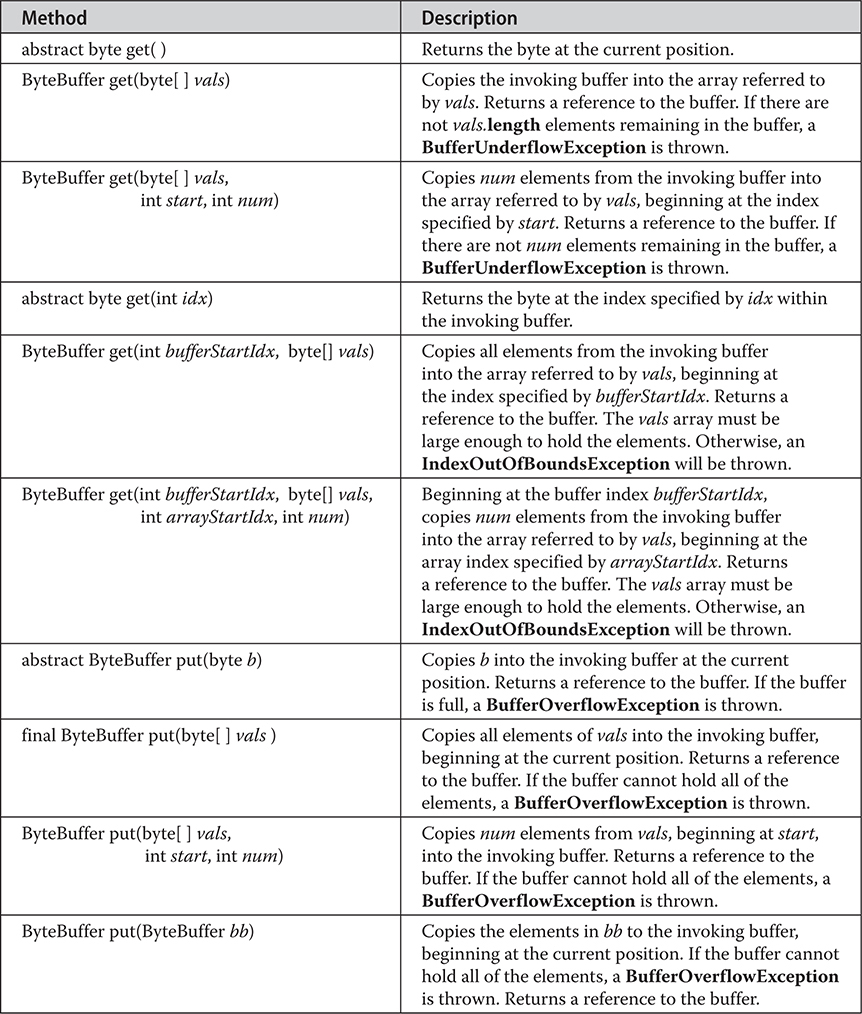
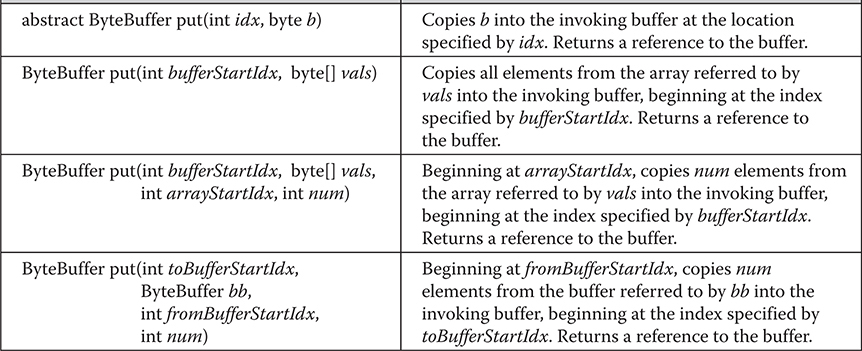
Table 23-2 The get( ) and put( ) Methods Defined for ByteBuffer
Channels are defined in java.nio.channels. A channel represents an open connection to an I/O source or destination. Channels implement the Channel interface. It extends Closeable, and it extends AutoCloseable. By implementing AutoCloseable, channels can be managed with a try-with-resources statement. When used in a try-with-resources block, a channel is closed automatically when it is no longer needed. (See Chapter 13 for a discussion of try-with-resources.)
One way to obtain a channel is by calling getChannel( ) on an object that supports channels. For example, getChannel( ) is supported by the following I/O classes:

The specific type of channel returned depends upon the type of object getChannel( ) is called on. For example, when called on a FileInputStream, FileOutputStream, or RandomAccessFile, getChannel( ) returns a channel of type FileChannel. When called on a Socket, getChannel( ) returns a SocketChannel.
Another way to obtain a channel is to use one of the static methods defined by the Files class. For example, using Files, you can obtain a byte channel by calling newByteChannel( ). It returns a SeekableByteChannel, which is an interface implemented by FileChannel. (The Files class is examined in detail later in this chapter.)
Channels such as FileChannel and SocketChannel support various read( ) and write( ) methods that enable you to perform I/O operations through the channel. For example, here are a few of the read( ) and write( ) methods defined for FileChannel:
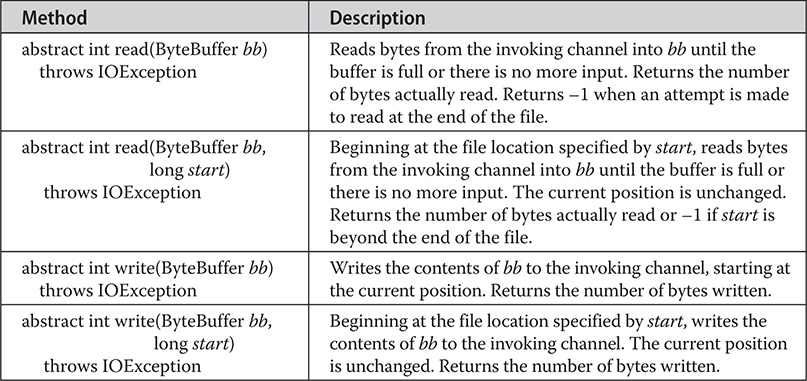
All channels support additional methods that give you access to and control over the channel. For example, FileChannel supports methods to get or set the current position, transfer information between file channels, obtain the current size of the channel, and lock the channel, among others. FileChannel provides a static method called open( ), which opens a file and returns a channel to it. This provides another way to obtain a channel. FileChannel also provides the map( ) method, which lets you map a file to a buffer.
Two other entities used by NIO are charsets and selectors. A charset defines the way that bytes are mapped to characters. You can encode a sequence of characters into bytes using an encoder. You can decode a sequence of bytes into characters using a decoder. Charsets, encoders, and decoders are supported by classes defined in the java.nio.charset package. Because default encoders and decoders are provided, you will not often need to work explicitly with charsets.
A selector supports key-based, non-blocking, multiplexed I/O. In other words, selectors enable you to perform I/O through multiple channels. Selectors are supported by classes defined in the java.nio.channels package. Selectors are most applicable to socket-backed channels.
We will not use charsets or selectors in this chapter, but you might find them useful in your own applications.
Beginning with JDK 7, the NIO system was substantially expanded and enhanced. In addition to support for the try-with-resources statement (which provides automatic resource management), the improvements included three new packages (java.nio.file, java.nio.file.attribute, and java.nio.file.spi); several new classes, interfaces, and methods; and direct support for stream-based I/O. The additions have greatly expanded the ways in which NIO can be used, especially with files. Several of the key additions are described in the following sections.
Perhaps the single most important addition to the NIO system was the Path interface because it encapsulates a path to a file. As you will see, Path is the glue that binds together many of the NIO.2 file-based features. It describes a file’s location within the directory structure. Path is packaged in java.nio.file, and it inherits the following interfaces: Watchable, Iterable<Path>, and Comparable<Path>. Watchable describes an object that can be monitored for changes. The Iterable and Comparable interfaces were described earlier in this book.
Path declares a number of methods that operate on the path. A sampling is shown in Table 23-3. Pay special attention to the getName( ) method. It is used to obtain an element in a path. It works using an index. At index zero is the part of the path nearest the root, which is the leftmost element in a path. Subsequent indexes specify elements to the right of the root. The number of elements in a path can be obtained by calling getNameCount( ). If you want to obtain a string representation of the entire path, simply call toString( ). Notice that you can resolve a relative path into an absolute path by using the resolve( ) method.
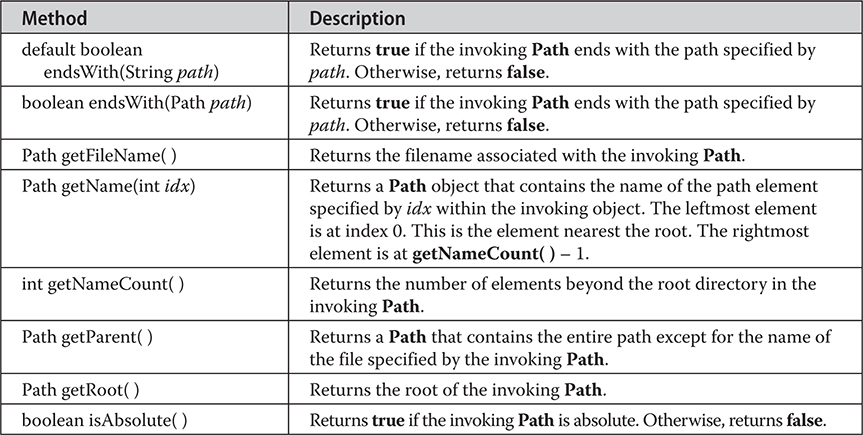
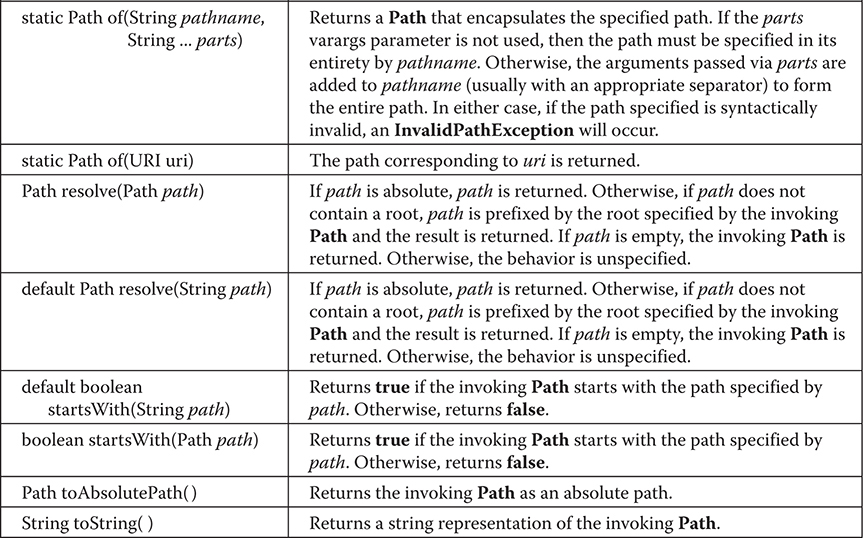
Table 23-3 A Sampling of Methods Specified by Path
Beginning with JDK 11, an important new static factory method called of( ) was added to Path. It returns a Path instance from either a path name or a URI. Thus, of( ) gives you a way to construct a new Path instance.
One other point: When updating legacy code that uses the File class defined by java.io, it is possible to convert a File instance into a Path instance by calling toPath( ) on the File object. Furthermore, it is possible to obtain a File instance by calling the toFile( ) method defined by Path.
Many of the actions that you perform on a file are provided by static methods within the Files class. The file to be acted upon is specified by its Path. Thus, the Files methods use a Path to specify the file that is being operated upon. Files contains a wide array of functionality. For example, it has methods that let you open or create a file that has the specified path. You can obtain information about a Path, such as whether it is executable, hidden, or read-only. Files also supplies methods that let you copy or move files. A sampling is shown in Table 23-4. In addition to IOException, several other exceptions are possible. Files also includes these four methods: list( ), walk( ), lines( ), and find( ). All return a Stream object. These methods help integrate NIO with the stream API described in Chapter 30. Files also includes the methods readString( ) and writeString( ), which returns a String containing the characters in a file or writes a CharSequence (such as a String) to a file.
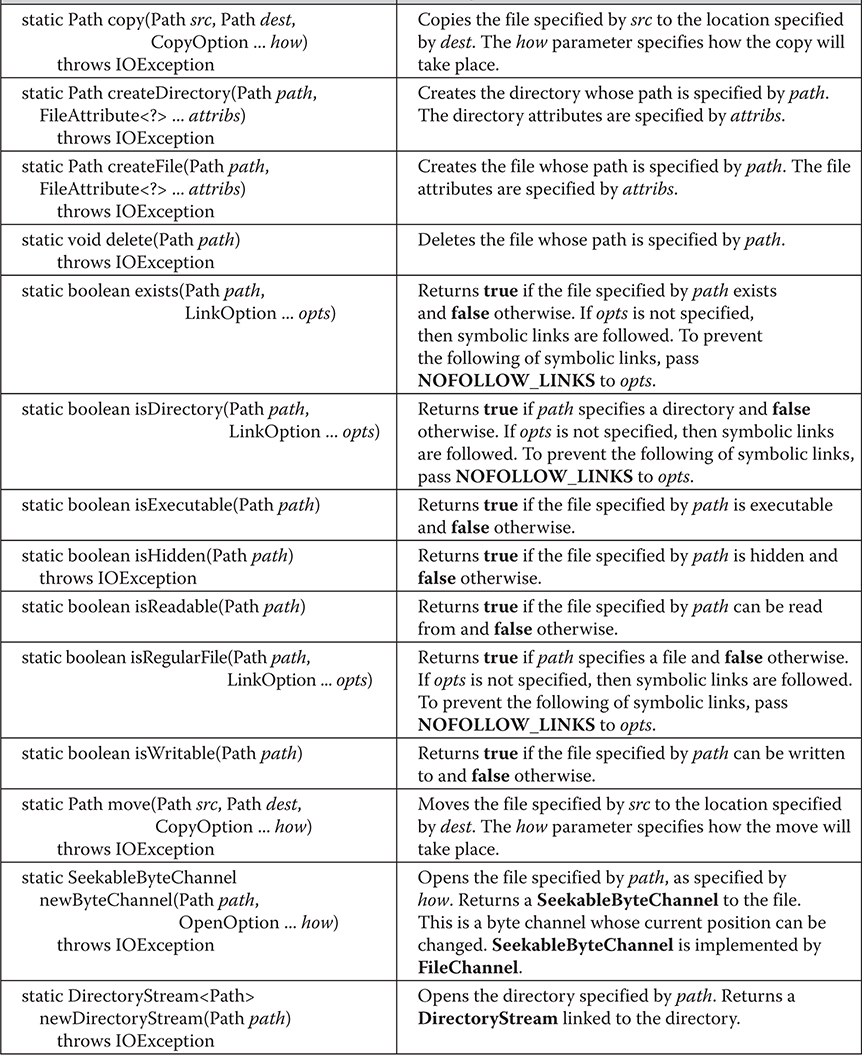
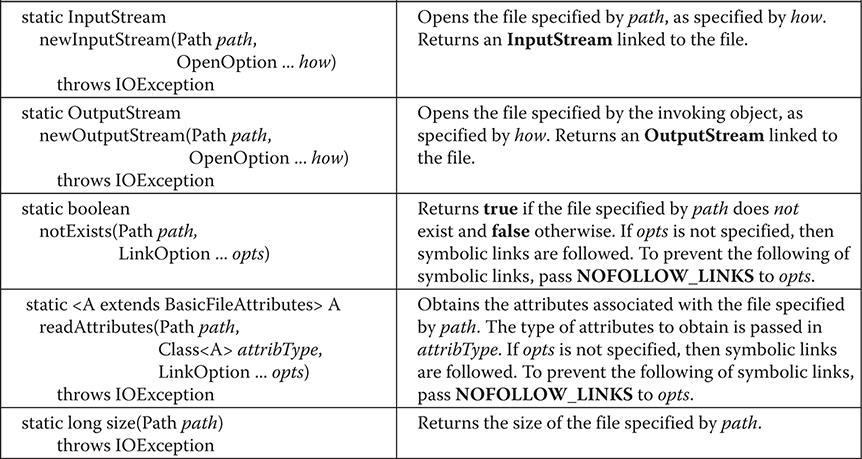
Table 23-4 A Sampling of Methods Defined by Files
Notice that several of the methods in Table 23-4 take an argument of type OpenOption. This is an interface that describes how to open a file. It is implemented by the StandardOpenOption enumeration that has the values shown in Table 23-5.
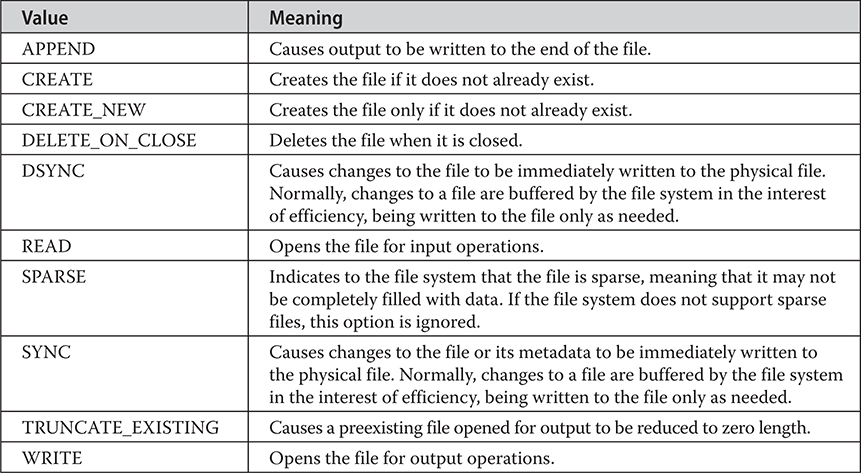
Table 23-5 The Standard Open Options
Because Path is an interface, not a class, you can’t create an instance of Path directly through the use of a constructor. Instead, you obtain a Path by a calling a method that returns one. Prior to JDK 11, you would typically do this by using the get( ) method defined by the Paths class. There are two forms of get( ). The first is shown here:
static Path get(String pathname, String ... parts)
It returns a Path that encapsulates the specified path. The path can be specified in two ways. First, if parts is not used, then the path must be specified in its entirety by pathname. Alternatively, you can pass the path in pieces, with the first part passed in pathname and the subsequent elements specified by the parts varargs parameter. In either case, if the path specified is syntactically invalid, get( ) will throw an InvalidPathException.
The second form of get( ) creates a Path from a URI. It is shown here:
static Path get(URI uri)
The Path corresponding to uri is returned.
Although the Paths.get( ) method just described has been in use since JDK 7 and, at the time of this writing, is still available for use, it is no longer recommended. Instead, the Java API documentation now recommends the use of the new Path.of( ) method, which was added by JDK 11. Because of this, Path.of( ) is now the preferred approach. Of course, if you are using a compiler that predates JDK 11, then you must continue to use Paths.get( ).
It is important to understand that obtaining a Path to a file does not open or create a file. It simply creates an object that encapsulates the file’s directory path.
Associated with a file is a set of attributes. These attributes include such things as the file’s time of creation, the time of its last modification, whether the file is a directory, and its size. NIO organizes file attributes into several different interfaces. Attributes are represented by a hierarchy of interfaces defined in java.nio.file.attribute. At the top is BasicFileAttributes. It encapsulates the set of attributes that are commonly found in a variety of file systems. The methods defined by BasicFileAttributes are shown in Table 23-6.
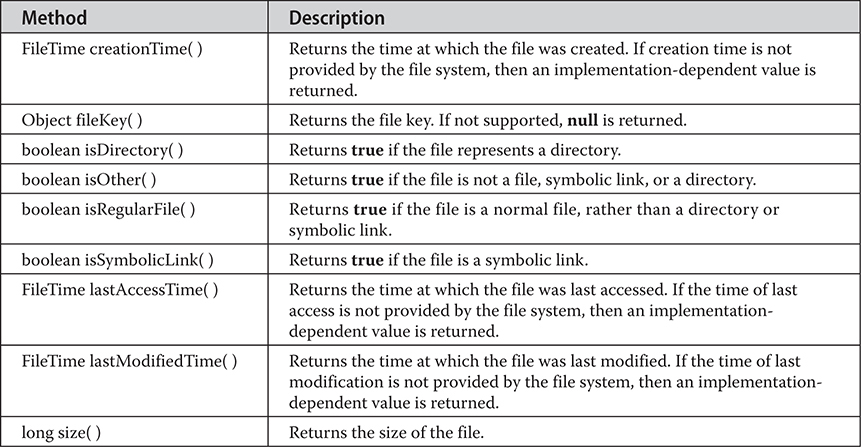
Table 23-6 The Methods Defined by BasicFileAttributes
From BasicFileAttributes two interfaces are derived: DosFileAttributes and PosixFileAttributes. DosFileAttributes describes those attributes related to the FAT file system as first defined by DOS. It defines the methods shown here:

PosixFileAttributes encapsulates attributes defined by the POSIX standards. (POSIX stands for Portable Operating System Interface.) It defines the methods shown here:

There are various ways to access a file’s attributes. First, you can obtain an object that encapsulates a file’s attributes by calling readAttributes( ), which is a static method defined by Files. One of its forms is shown here:
static <A extends BasicFileAttributes>
A readAttributes(Path path, Class<A> attrType, LinkOption... opts)
throws IOException
This method returns a reference to an object that specifies the attributes associated with the file passed in path. The specific type of attributes is specified as a Class object in the attrType parameter. For example, to obtain the basic file attributes, pass BasicFileAttributes.class to attrType. For DOS attributes, use DosFileAttributes.class, and for POSIX attributes, use PosixFileAttributes.class. Optional link options are passed via opts. If not specified, symbolic links are followed. The method returns a reference to requested attributes. If the requested attribute type is not available, UnsupportedOperationException is thrown. Using the object returned, you can access the file’s attributes.
A second way to gain access to a file’s attributes is to call getFileAttributeView( ) defined by Files. NIO defines several attribute view interfaces, including AttributeView, BasicFileAttributeView, DosFileAttributeView, and PosixFileAttributeView, among others. Although we won’t be using attribute views in this chapter, they are a feature that you may find helpful in some situations.
In some cases, you won’t need to use the file attribute interfaces directly because the Files class offers static convenience methods that access several of the attributes. For example, Files includes methods such as isHidden( ) and isWritable( ).
It is important to understand that not all file systems support all possible attributes. For example, the DOS file attributes apply to the older FAT file system as first defined by DOS. The attributes that will apply to a wide variety of file systems are described by BasicFileAttributes. For this reason, these attributes are used in the examples in this chapter.
You can easily access the file system through the FileSystem and FileSystems classes packaged in java.nio.file. In fact, by using the newFileSystem( ) method defined by FileSystems, it is even possible to obtain a new file system. The FileStore class encapsulates the file storage system. Although these classes are not used directly in this chapter, you may find them helpful in your own applications.
This section illustrates how to apply the NIO system to a variety of tasks. Before beginning, it is important to emphasize that beginning with JDK 7, the NIO subsystem was greatly expanded. As a result, its uses have also been greatly expanded. As mentioned, the enhanced version is sometimes referred to as NIO.2. Because the features added by NIO.2 are so substantial, they have changed the way that much NIO-based code is written and have increased the types of tasks to which NIO can be applied. Because of its importance, the remaining discussion and examples in this chapter utilize NIO.2 features and, therefore, require a modern version of Java.
In the past, the primary purpose of NIO was channel-based I/O, and this is still a very important use. However, you can now use NIO for stream-based I/O and for performing file-system operations. As a result, the discussion of using NIO is divided into three parts:
• Using NIO for channel-based I/O
• Using NIO for stream-based I/O
• Using NIO for path and file system operations
Because the most common I/O device is the disk file, the rest of this chapter uses disk files in the examples. Because all file channel operations are byte-based, the type of buffers that we will be using are of type ByteBuffer.
Before you can open a file for access via the NIO system, you must obtain a Path that describes the file. In the past, one way to do this was to call the Paths.get( ) factory method. However, as explained earlier, beginning with JDK 11, the preferred approach is to use Path.of( ) rather than Paths.get( ). Because of this, the examples use Path.of( ). If you are using a version of Java prior to JDK 11, simply substitute Paths.get( ) for Path.of( ) in the programs. The form of of( ) used in the examples is shown here:
static Path of(String pathname, String ... parts)
Recall that the path can be specified in two ways. It can be passed in pieces, with the first part passed in pathname and the subsequent elements specified by the parts varargs parameter. Alternatively, the entire path can be specified in pathname and parts is not used. This is the approach used by the examples.
An important use of NIO is to access a file via a channel and buffers. The following sections demonstrate some techniques that use a channel to read from and write to a file.
There are several ways to read data from a file using a channel. Perhaps the most common way is to manually allocate a buffer and then perform an explicit read operation that loads that buffer with data from the file. It is with this approach that we begin.
Before you can read from a file, you must open it. To do this, first create a Path that describes the file. Then use this Path to open the file. There are various ways to open the file depending on how it will be used. In this example, the file will be opened for byte-based input via explicit input operations. Therefore, this example will open the file and establish a channel to it by calling Files.newByteChannel( ). The version of newByteChannel( ) that we will use has this general form:
static SeekableByteChannel newByteChannel(Path path, OpenOption ... how)
throws IOException
It returns a SeekableByteChannel object, which encapsulates the channel for file operations. The Path that describes the file is passed in path. The how parameter specifies how the file will be opened. Because it is a varargs parameter, you can specify zero or more comma-separated arguments. (The valid values were discussed earlier and shown in Table 23-5.) If no arguments are specified, the file is opened for input operations. SeekableByteChannel is an interface that describes a channel that can be used for file operations. It is implemented by the FileChannel class. When the default file system is used, the returned object can be cast to FileChannel. You must close the channel after you have finished with it. Since all channels, including FileChannel, implement AutoCloseable, you can use a try-with-resources statement to close the file automatically instead of calling close( ) explicitly. This approach is used in the examples.
Next, you must obtain a buffer that will be used by the channel either by wrapping an existing array or by allocating the buffer dynamically. The examples use allocation, but the choice is yours. Because file channels operate on byte buffers, we will use the allocate( ) method defined by ByteBuffer to obtain the buffer. It has this general form:
static ByteBuffer allocate(int cap)
Here, cap specifies the capacity of the buffer. A reference to the buffer is returned.
After you have created the buffer, call read( ) on the channel, passing a reference to the buffer. The version of read( ) that we will use is shown next:
int read(ByteBuffer buf) throws IOException
Each time it is called, read( ) fills the buffer specified by buf with data from the file. The reads are sequential, meaning that each call to read( ) reads the next buffer’s worth of bytes from the file. The read( ) method returns the number of bytes actually read. It returns –1 when there is an attempt to read at the end of the file.
The following program puts the preceding discussion into action by reading a file called test.txt through a channel using explicit input operations:
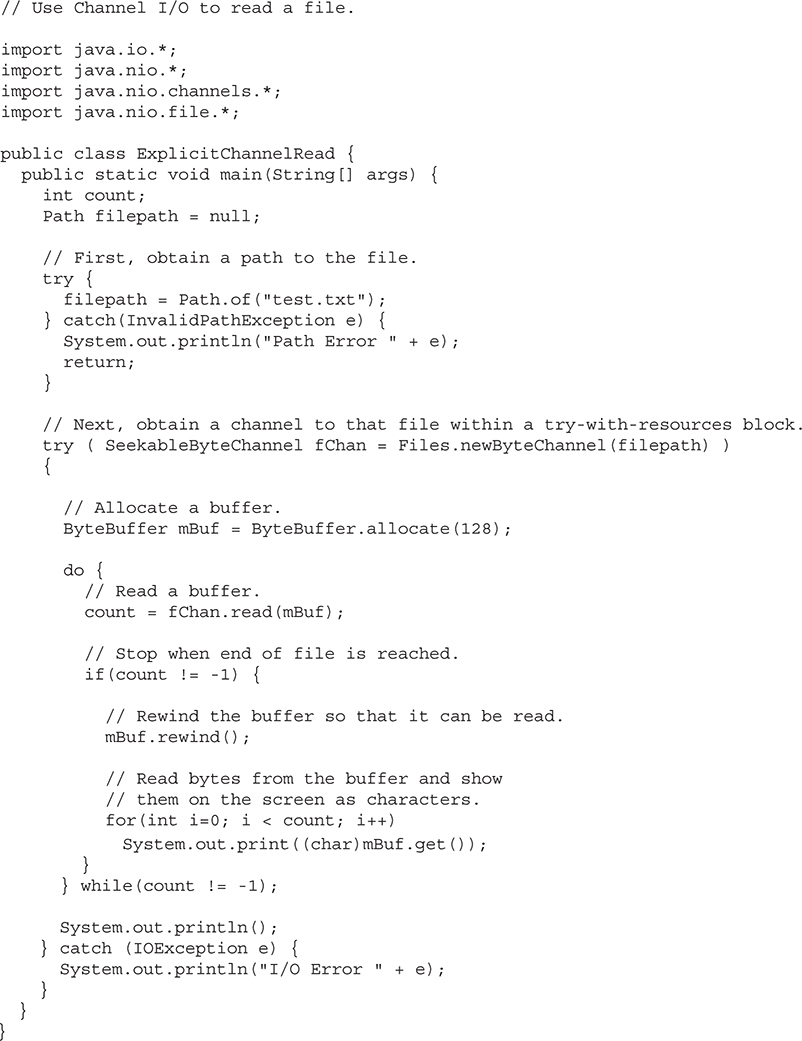
Here is how the program works. First, a Path object is obtained that contains the relative path to a file called test.txt. A reference to this object is assigned to filepath. Next, a channel connected to the file is obtained by calling newByteChannel( ), passing in filepath. Because no open option is specified, the file is opened for reading. Notice that this channel is the object managed by the try-with-resources statement. Thus, the channel is automatically closed when the block ends. The program then calls the allocate( ) method of ByteBuffer to allocate a buffer that will hold the contents of the file when it is read. A reference to this buffer is stored in mBuf. The contents of the file are then read, one buffer at a time, into mBuf through a call to read( ). The number of bytes read is stored in count. Next, the buffer is rewound through a call to rewind( ). This call is necessary because the current position is at the end of the buffer after the call to read( ). It must be reset to the start of the buffer in order for the bytes in mBuf to be read by calling get( ). (Recall that get( ) is defined by ByteBuffer.) Because mBuf is a byte buffer, the values returned by get( ) are bytes. They are cast to char so the file can be displayed as text. (Alternatively, it is possible to create a buffer that encodes the bytes into characters and then read that buffer.) When the end of the file has been reached, the value returned by read( ) will be –1. When this occurs, the program ends, and the channel is automatically closed.
As a point of interest, notice that the program obtains the Path within one try block and then uses another try block to obtain and manage a channel linked to that path. Although there is nothing wrong, per se, with this approach, in many cases, it can be streamlined so that only one try block is needed. In this approach, the calls to Path.of( ) and newByteChannel( ) are sequenced together. For example, here is a reworked version of the program that uses this approach:
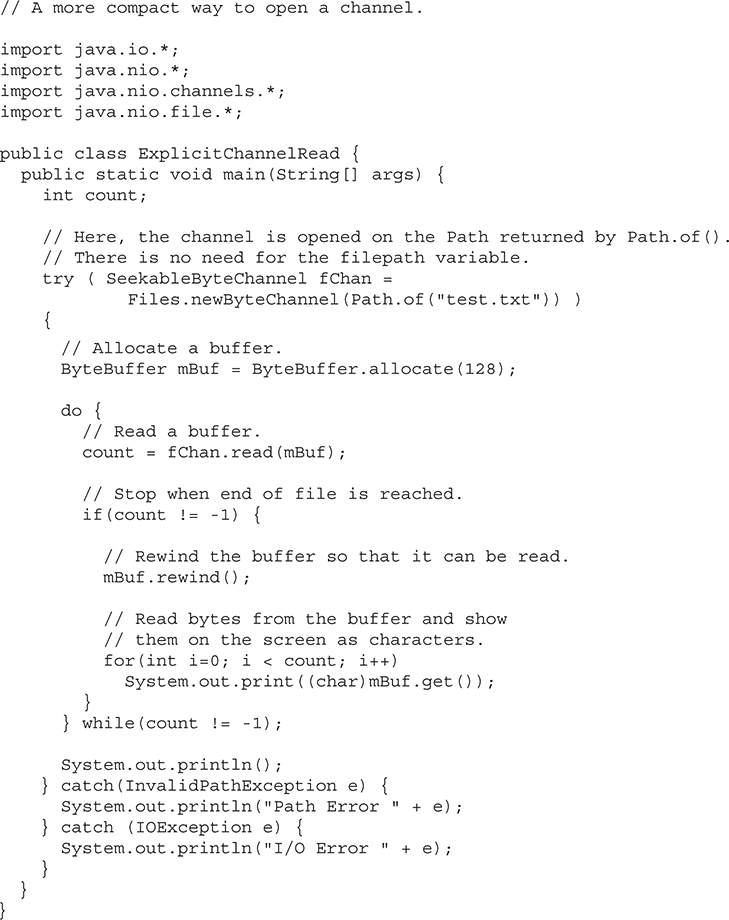
In this version, the variable filepath is not needed and both exceptions are handled by the same try statement. Because this approach is more compact, it is the approach used in the rest of the examples in this chapter. Of course, in your own code, you may encounter situations in which the creation of a Path object needs to be separate from the acquisition of a channel. In these cases, the previous approach can be used.
Another way to read a file is to map it to a buffer. The advantage is that the buffer automatically contains the contents of the file. No explicit read operation is necessary. To map and read the contents of a file, follow this general procedure. First, obtain a Path object that encapsulates the file as previously described. Next, obtain a channel to that file by calling Files.newByteChannel( ), passing in the Path and casting the returned object to FileChannel. As explained, newByteChannel( ) returns a SeekableByteChannel. When using the default file system, this object can be cast to FileChannel. Then, map the channel to a buffer by calling map( ) on the channel. The map( ) method is defined by FileChannel. This is why the cast to FileChannel is needed. The map( ) function is shown here:
MappedByteBuffer map(FileChannel.MapMode how,
long pos, long size) throws IOException
The map( ) method causes the data in the file to be mapped into a buffer in memory. The value in how determines what type of operations are allowed. It must be one of these values:

For reading a file, use MapMode.READ_ONLY. To read and write, use MapMode.READ_WRITE. MapMode.PRIVATE causes a private copy of the file to be made, and changes to the buffer do not affect the underlying file. The location within the file to begin mapping is specified by pos, and the number of bytes to map are specified by size. A reference to this buffer is returned as a MappedByteBuffer, which is a subclass of ByteBuffer. Once the file has been mapped to a buffer, you can read the file from that buffer. Here is an example that illustrates this approach:
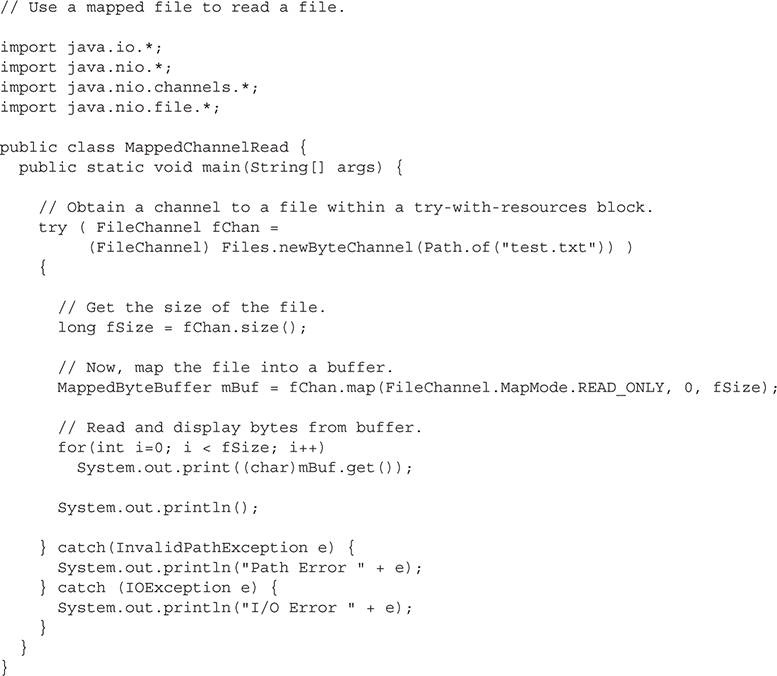
In the program, a Path to the file is created and then opened via newByteChannel( ). The channel is cast to FileChannel and stored in fChan. Next, the size of the file is obtained by calling size( ) on the channel. Then, the entire file is mapped into memory by calling map( ) on fChan and a reference to the buffer is stored in mBuf. Notice that mBuf is declared as a reference to a MappedByteBuffer. The bytes in mBuf are read by calling get( ).
As is the case when reading from a file, there are also several ways to write data to a file using a channel. We will begin with one of the most common. In this approach, you manually allocate a buffer, write data to that buffer, and then perform an explicit write operation to write that data to a file.
Before you can write to a file, you must open it. To do this, first obtain a Path that describes the file and then use this Path to open the file. In this example, the file will be opened for byte-based output via explicit output operations. Therefore, this example will open the file and establish a channel to it by calling Files.newByteChannel( ). As shown in the previous section, the newByteChannel( ) method that we will use has this general form:
static SeekableByteChannel newByteChannel(Path path, OpenOption ... how)
throws IOException
It returns a SeekableByteChannel object, which encapsulates the channel for file operations. To open a file for output, the how parameter must specify StandardOpenOption.WRITE. If you want to create the file if it does not already exist, then you must also specify StandardOpenOption.CREATE. (Other options, which are shown in Table 23-5, are also available.) As explained in the previous section, SeekableByteChannel is an interface that describes a channel that can be used for file operations. It is implemented by the FileChannel class. When the default file system is used, the return object can be cast to FileChannel. You must close the channel after you have finished with it.
Here is one way to write to a file through a channel using explicit calls to write( ). First, obtain a Path to the file and then open it with a call to newByteChannel( ), casting the result to FileChannel. Next, allocate a byte buffer and write data to that buffer. Before the data is written to the file, call rewind( ) on the buffer to set its current position to zero. (Each output operation on the buffer increases the current position. Thus, it must be reset prior to writing to the file.) Then, call write( ) on the channel, passing in the buffer. The following program demonstrates this procedure. It writes the alphabet to a file called test.txt.
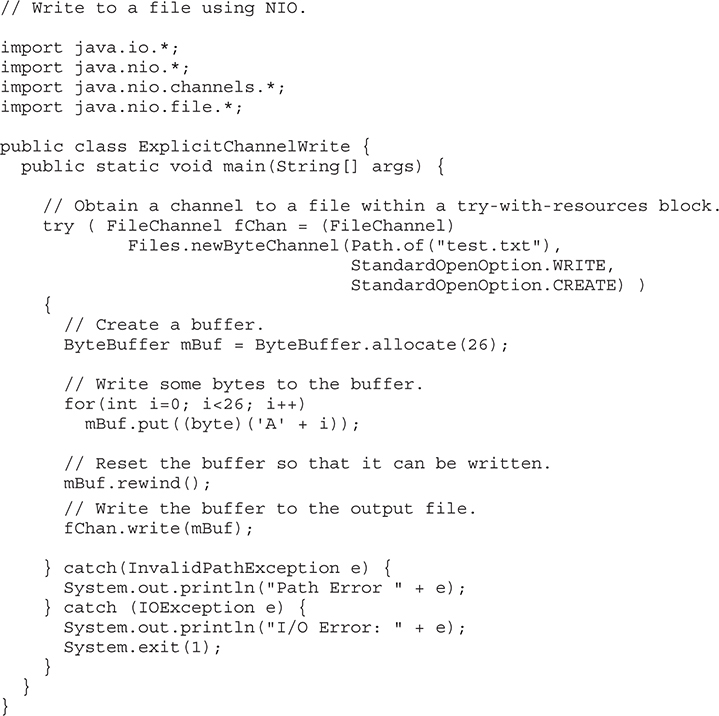
It is useful to emphasize an important aspect of this program. As mentioned, after data is written to mBuf, but before it is written to the file, a call to rewind( ) on mBuf is made. This is necessary in order to reset the current position to zero after data has been written to mBuf. Remember, each call to put( ) on mBuf advances the current position. Therefore, it is necessary for the current position to be reset to the start of the buffer before calling write( ). If this is not done, write( ) will think that there is no data in the buffer.
Another way to handle the resetting of the buffer between input and output operations is to call flip( ) instead of rewind( ). The flip( ) method sets the value of the current position to zero and the limit to the previous current position. In the preceding example, because the capacity of the buffer equals its limit, flip( ) could have been used instead of rewind( ). However, the two methods are not interchangeable in all cases.
In general, you must reset the buffer between read and write operations. For example, assuming the preceding example, the following loop will write the alphabet to the file three times. Pay special attention to the calls to rewind( ).
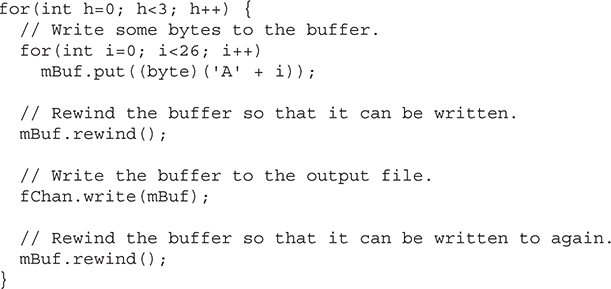
Notice that rewind( ) is called between each read and write operation.
One other thing about the program warrants mentioning: When the buffer is written to the file, the first 26 bytes in the file will contain the output. If the file test.txt was preexisting, then after the program executes, the first 26 bytes of test.txt will contain the alphabet, but the remainder of the file will remain unchanged.
Another way to write to a file is to map it to a buffer. The advantage to this approach is that the data written to the buffer will automatically be written to the file. No explicit write operation is necessary. To map and write the contents of a file, we will use this general procedure. First, obtain a Path object that encapsulates the file and then create a channel to that file by calling Files.newByteChannel( ), passing in the Path. Cast the reference returned by newByteChannel( ) to FileChannel. Next, map the channel to a buffer by calling map( ) on the channel. The map( ) method was described in detail in the previous section. It is summarized here for your convenience. Here is its general form:
MappedByteBuffer map(FileChannel.MapMode how,
long pos, long size) throws IOException
The map( ) method causes the data in the file to be mapped into a buffer in memory. The value in how determines what type of operations are allowed. For writing to a file, how must be MapMode.READ_WRITE. The location within the file to begin mapping is specified by pos, and the number of bytes to map are specified by size. A reference to this buffer is returned. Once the file has been mapped to a buffer, you can write data to that buffer, and it will automatically be written to the file. Therefore, no explicit write operations to the channel are necessary.
Here is the preceding program reworked so that a mapped file is used. Notice that in the call to newByteChannel( ), the open option StandardOpenOption.READ has been added. This is because a mapped buffer can either be read-only or read/write. Thus, to write to the mapped buffer, the channel must be opened as read/write.
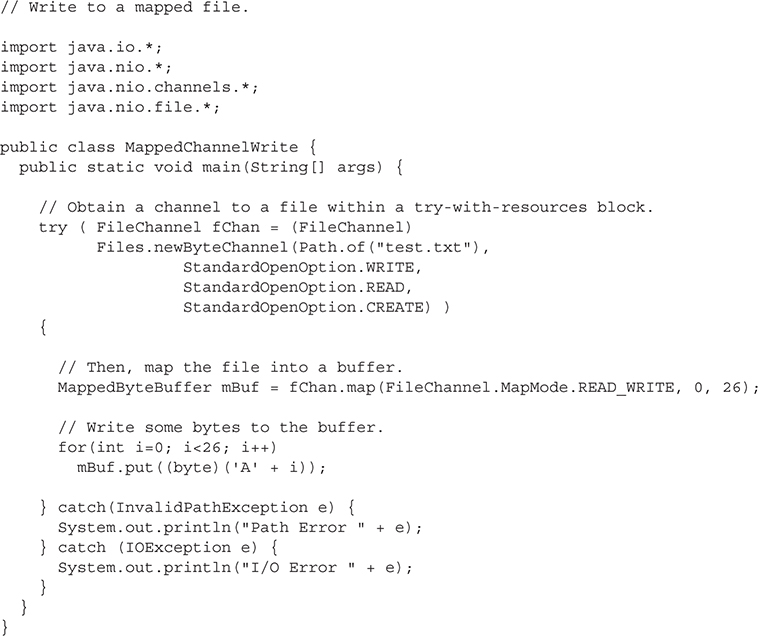
As you can see, there are no explicit write operations to the channel itself. Because mBuf is mapped to the file, changes to mBuf are automatically reflected in the underlying file.
NIO simplifies several types of file operations. Although we can’t examine them all, an example will give you an idea of what is available. The following program copies a file using a call to a single NIO method: copy( ), which is a static method defined by Files. It has several forms. Here is the one we will be using:
static Path copy(Path src, Path dest, CopyOption ... how) throws IOException
The file specified by src is copied to the file specified by dest. How the copy is performed is specified by how. Because it is a varargs parameter, it can be missing. If specified, it can be one or more of these values, which are valid for all file systems:

Other options may be supported, depending on the implementation.
The following program demonstrates copy( ). The source and destination files are specified on the command line, with the source file specified first. Notice how short the program is. You might want to compare this version of the file copy program to the one found in Chapter 13. As you will find, the part of the program that actually copies the file is substantially shorter in the NIO version shown here.
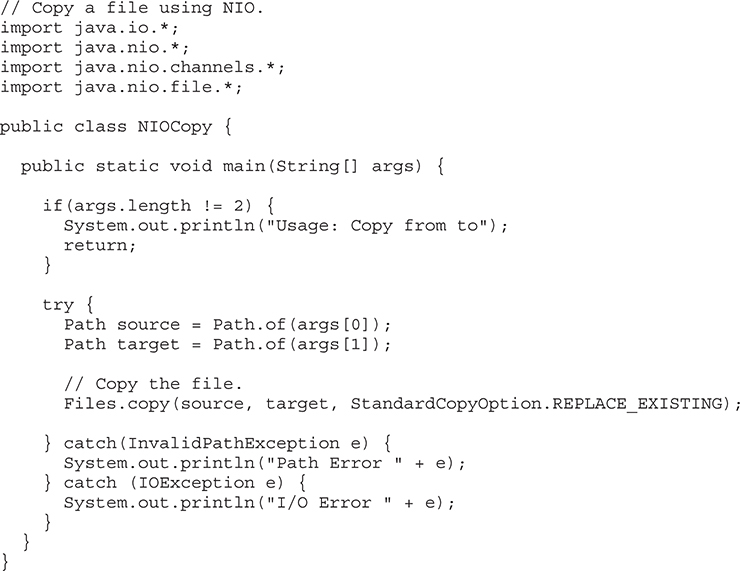
Beginning with NIO.2, you can use NIO to open an I/O stream. Once you have a Path, open a file by calling newInputStream( ) or newOutputStream( ), which are static methods defined by Files. These methods return a stream connected to the specified file. In either case, the stream can then be operated on in the way described in Chapter 21, and the same techniques apply. The advantage of using Path to open a file is that all of the features defined by NIO are available for your use.
To open a file for stream-based input, use Files.newInputStream( ). It is shown here:
static InputStream newInputStream(Path path, OpenOption ... how)
throws IOException
Here, path specifies the file to open and how specifies how the file will be opened. It can be one or more of the values defined by StandardOpenOption, described earlier. (Of course, only those options that relate to an input stream will apply.) If no options are specified, then the file is opened as if StandardOpenOption.READ were passed.
Once opened, you can use any of the methods defined by InputStream. For example, you can use read( ) to read bytes from the file.
The following program demonstrates the use of NIO-based stream I/O. It reworks the ShowFile program from Chapter 13 so that it uses NIO features to open the file and obtain a stream. As you can see, it is very similar to the original, except for the use of Path and newInputStream( ).
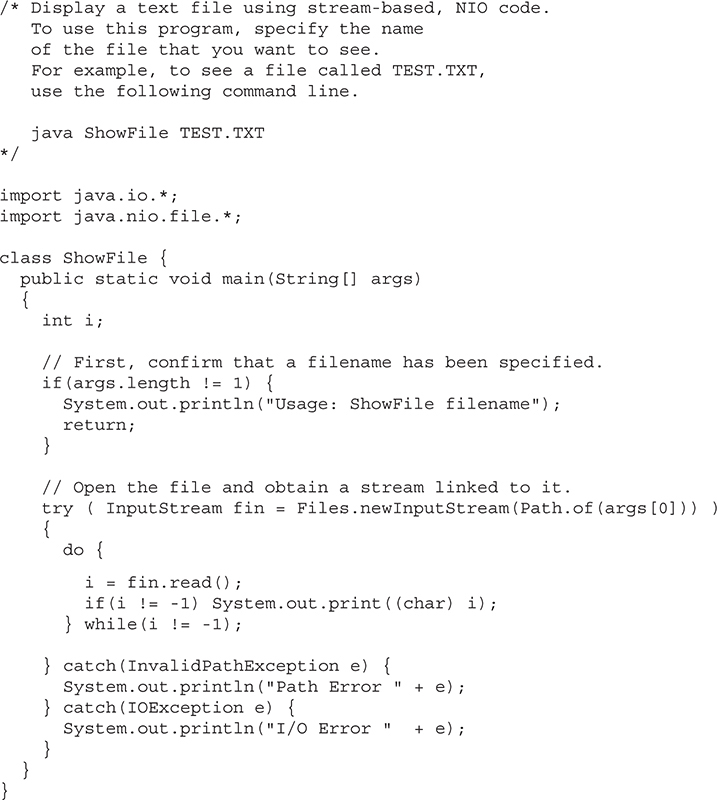
Because the stream returned by newInputStream( ) is a normal stream, it can be used like any other stream. For example, you can wrap the stream inside a buffered stream, such as a BufferedInputStream, to provide buffering, as shown here:
new BufferedInputStream(Files.newInputStream(Path.of(args[0])))
Now, all reads will be automatically buffered.
To open a file for output, use Files.newOutputStream( ). It is shown here:
static OutputStream newOutputStream(Path path, OpenOption ... how)
throws IOException
Here, path specifies the file to open and how specifies how the file will be opened. It must be one or more of the values defined by StandardOpenOption, described earlier. (Of course, only those options that relate to an output stream will apply.) If no options are specified, then the file is opened as if StandardOpenOption.WRITE, StandardOpenOption.CREATE, and StandardOpenOption.TRUNCATE_EXISTING were passed.
The methodology for using newOutputStream( ) is similar to that shown previously for newInputStream( ). Once opened, you can use any of the methods defined by OutputStream. For example, you can use write( ) to write bytes to the file. You can also wrap the stream inside a BufferedOutputStream to buffer the stream.
The following program shows newOutputStream( ) in action. It writes the alphabet to a file called test.txt. Notice the use of buffered I/O.
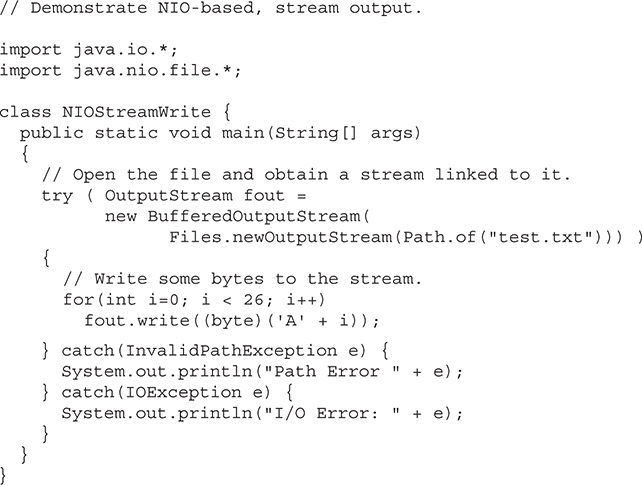
At the beginning of Chapter 22, the File class in the java.io package was examined. As explained there, the File class deals with the file system and with the various attributes associated with a file, such as whether a file is read-only, hidden, and so on. It was also used to obtain information about a file’s path. Although the File class is still perfectly acceptable, the interfaces and classes defined by NIO.2 offer a better way to perform these functions. The benefits include support for symbolic links, better support for directory tree traversal, and improved handling of metadata, among others. The following sections show samples of two common file system operations: obtaining information about a path and file and getting the contents of a directory.
Remember If you want to change code that uses java.io.File to the Path interface, you can use the toPath( ) method to obtain a Path instance from a File instance.
Information about a path can be obtained by using methods defined by Path. Some attributes associated with the file described by a Path (such as whether or not the file is hidden) are obtained by using methods defined by Files. The Path methods used here are getName( ), getParent( ), and toAbsolutePath( ). Those provided by Files are isExecutable( ), isHidden( ), isReadable( ), isWritable( ), and exists( ). These are summarized in Tables 23-3 and 23-4, shown earlier.
Caution Methods such as isExecutable( ), isReadable( ), isWritable( ), and exists( ) must be used with care because the state of the file system may change after the call, in which case a program malfunction could occur. Such a situation could have security implications.
Other file attributes are obtained by requesting a list of attributes by calling Files.readAttributes( ). In the program, this method is called to obtain the BasicFileAttributes associated with a file, but the general approach applies to other types of attributes.
The following program demonstrates several of the Path and Files methods, along with several methods provided by BasicFileAttributes. This program assumes that a file called test.txt exists in a directory called examples, which must be a subdirectory of the current directory.

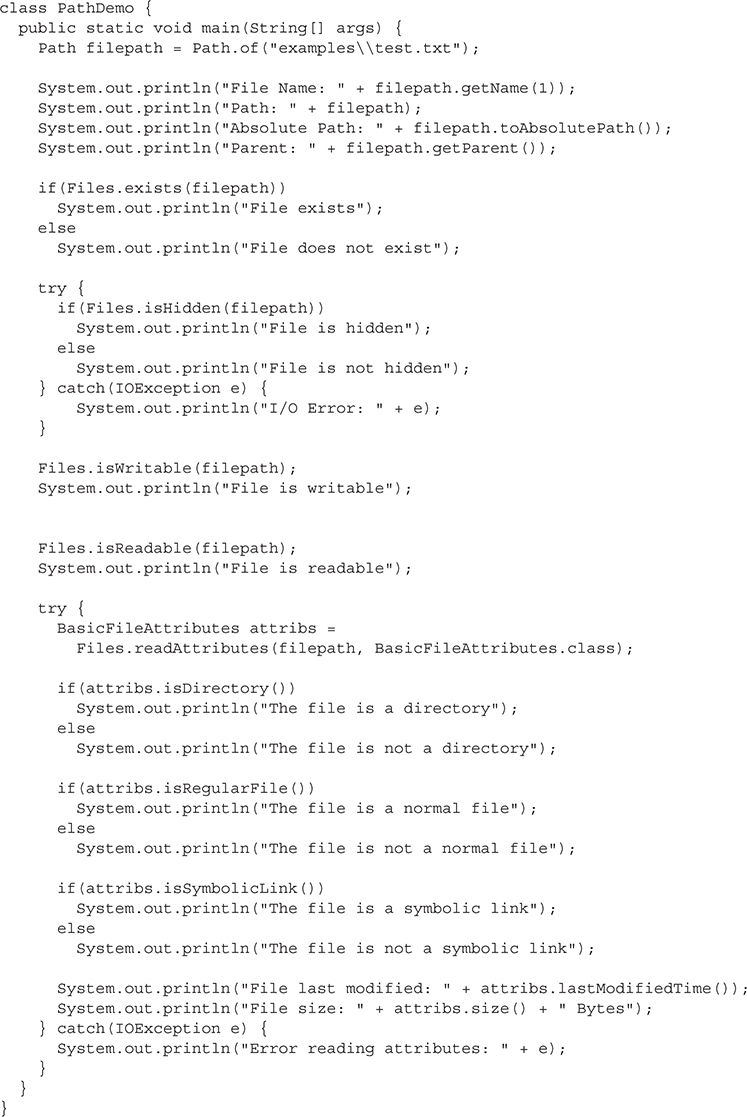
If you execute this program from a directory called MyDir, which has a subdirectory called examples, and the examples directory contains the test.txt file, then you will see output similar to that shown here. (Of course, the information you see will differ.)
File Name: test.txt
Path: examples\test.txt
Absolute Path: C:\MyDir\examples\test.txt
Parent: examples
File exists
File is not hidden
File is writable
File is readable
The file is not a directory
The file is a normal file
The file is not a symbolic link
File last modified: 2017-01-01T18:20:46.380445Z
File size: 18 Bytes
If you are using a computer that supports the FAT file system (i.e., the DOS file system), then you might want to try using the methods defined by DosFileAttributes. If you are using a POSIX-compatible system, then try using PosixFileAttributes.
If a path describes a directory, then you can read the contents of that directory by using static methods defined by Files. To do this, you first obtain a directory stream by calling newDirectoryStream( ), passing in a Path that describes the directory. One form of newDirectoryStream( ) is shown here:
static DirectoryStream<Path> newDirectoryStream(Path dirPath)
throws IOException
Here, dirPath encapsulates the path to the directory. The method returns a DirectoryStream<Path> object that can be used to obtain the contents of the directory. It will throw an IOException if an I/O error occurs and a NotDirectoryException (which is a subclass of IOException) if the specified path is not a directory. A SecurityException is also possible if access to the directory is not permitted.
DirectoryStream<Path> implements AutoCloseable, so it can be managed by a try-with-resources statement. It also implements Iterable<Path>. This means that you can obtain the contents of the directory by iterating over the DirectoryStream object. When iterating, each directory entry is represented by a Path instance. An easy way to iterate over a DirectoryStream is to use a for-each style for loop. It is important to understand, however, that the iterator implemented by DirectoryStream<Path> can be obtained only once for each instance. Thus, the iterator( ) method can be called only once, and a for-each loop can be executed only once.
The following program displays the contents of a directory called MyDir:
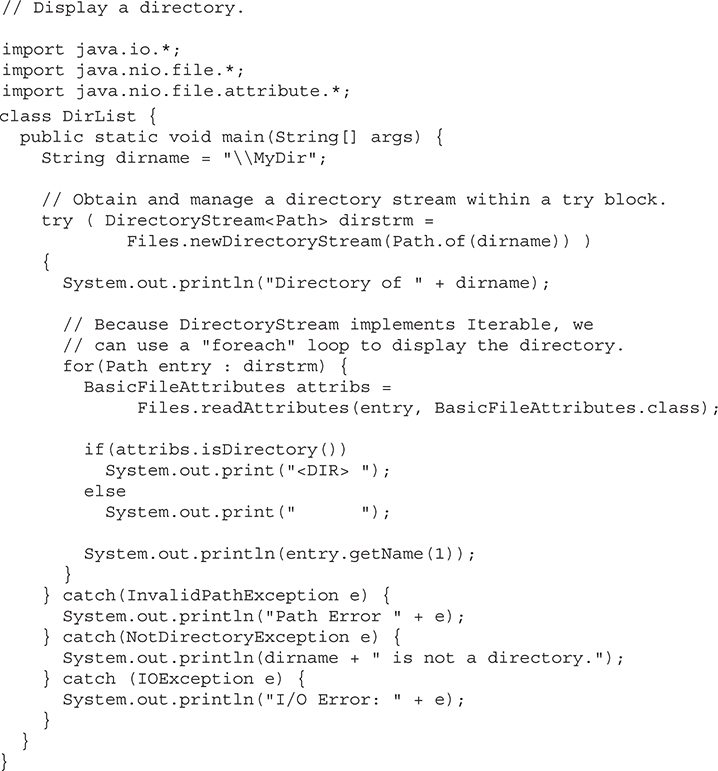
Here is sample output from the program:

You can filter the contents of a directory in two ways. The easiest is to use this version of newDirectoryStream( ):
static DirectoryStream<Path> newDirectoryStream(Path dirPath, String wildcard)
throws IOException
In this version, only files that match the wildcard filename specified by wildcard will be obtained. For wildcard, you can specify either a complete filename or a glob. A glob is a string that defines a general pattern that will match one or more files using the familiar * and ? wildcard characters. These match zero or more of any character and any one character, respectively. The following are also recognized within a glob:

You can specify a * or ? character, using \* and \?. To specify a \, use \\. You can experiment with a glob by substituting this call to newDirectoryStream( ) into the previous program:
Files.newDirectoryStream(Path.of(dirname), "{Path,Dir}*.{java,class}")
This obtains a directory stream that contains only those files whose names begin with either "Path" or "Dir" and use either the "java" or "class" extension. Thus, it would match names like DirList.java and PathDemo.java, but not MyPathDemo.java, for example.
Another way to filter a directory is to use this version of newDirectoryStream( ):
static DirectoryStream<Path> newDirectoryStream(Path dirPath,
DirectoryStream.Filter<? super Path> filefilter)
throws IOException
Here, DirectoryStream.Filter is an interface that specifies the following method:
boolean accept(T entry) throws IOException
In this case, T will be Path. If you want to include entry in the list, return true. Otherwise, return false. This form of newDirectoryStream( ) offers the advantage of being able to filter a directory based on something other than a filename. For example, you can filter based on size, creation date, modification date, or attribute, to name a few.
The following program demonstrates the process. It will list only those files that are writable.
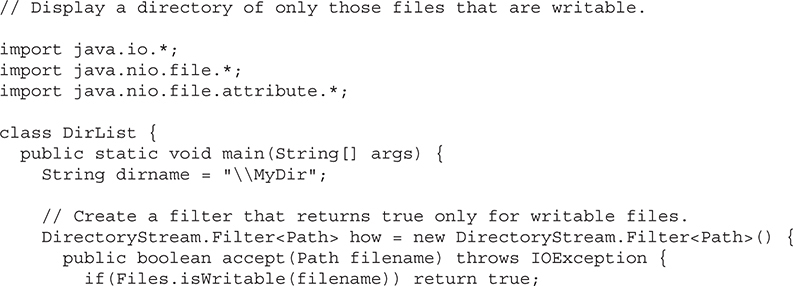
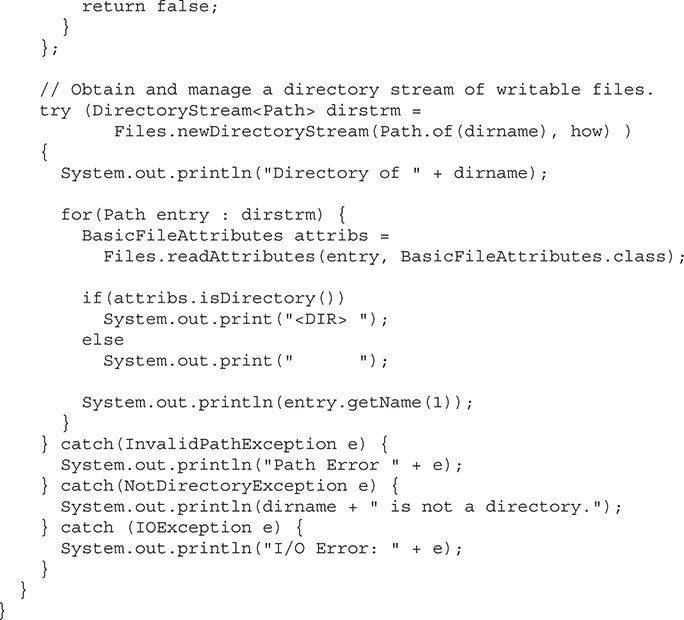
The preceding examples have obtained the contents of only a single directory. However, sometimes you will want to obtain a list of the files in a directory tree. In the past, this was quite a chore, but NIO.2 makes it easy because now you can use the walkFileTree( ) method defined by Files to process a directory tree. It has two forms. The one used in this chapter is shown here:
static Path walkFileTree(Path root, FileVisitor<? super Path> fv)
throws IOException
The path to the starting point of the directory walk is passed in root. An instance of FileVisitor is passed in fv. The implementation of FileVisitor determines how the directory tree is traversed, and it gives you access to the directory information. If an I/O error occurs, an IOException is thrown. A SecurityException is also possible.
FileVisitor is an interface that defines how files are visited when a directory tree is traversed. It is a generic interface that is declared like this:
interface FileVisitor<T>
For use in walkFileTree( ), T will be Path (or any type derived from Path). FileVisitor defines the following methods:
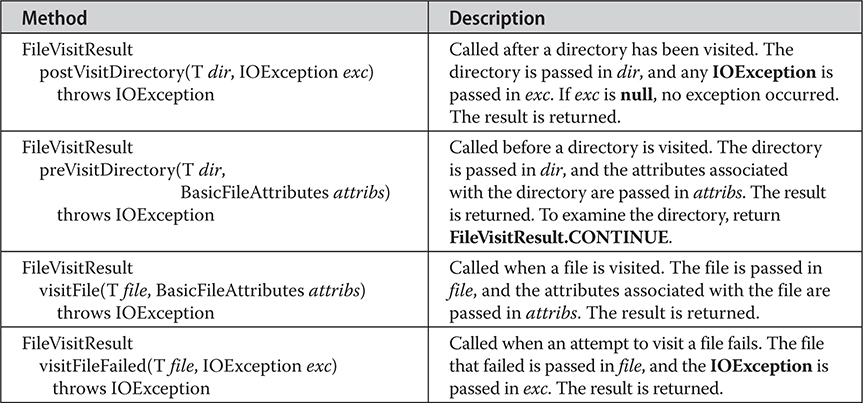
Notice that each method returns a FileVisitResult. This enumeration defines the following values:

In general, to continue traversing the directory and subdirectories, a method should return CONTINUE. For preVisitDirectory( ), return SKIP_SIBLINGS to bypass the directory and its siblings and prevent postVisitDirectory( ) from being called. To bypass just the directory and subdirectories, return SKIP_SUBTREE. To stop the directory traversal, return TERMINATE.
Although it is certainly possible to create your own visitor class that implements these methods defined by FileVisitor, you won’t normally do so because a simple implementation is provided by SimpleFileVisitor. You can just override the default implementation of the method or methods in which you are interested. Here is a short example that illustrates the process. It displays all files in the directory tree that has \MyDir as its root. Notice how short this program is.
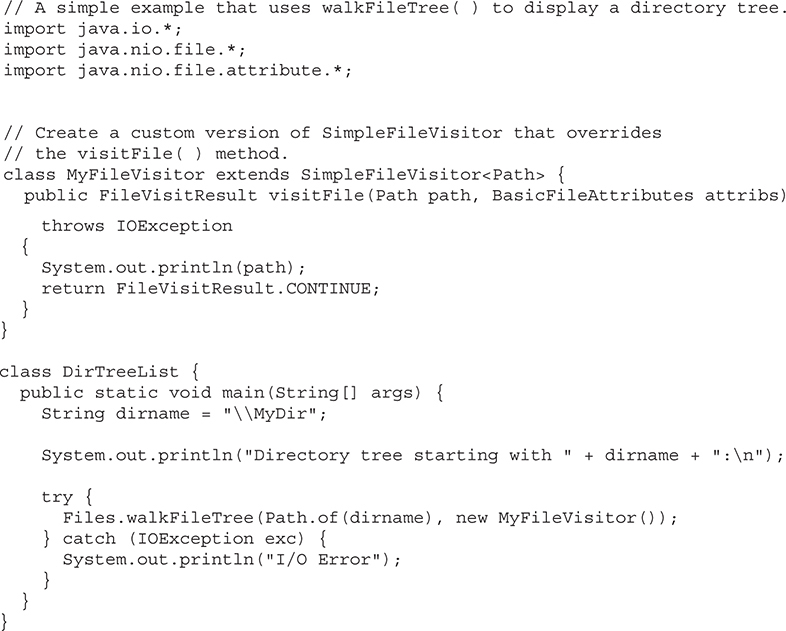
Here is sample output produced by the program when used on the same MyDir directory shown earlier. In this example, the subdirectory called examples contains one file called MyProgram.java.
Directory tree starting with \MyDir:
\MyDir\DirList.class
\MyDir\DirList.java
\MyDir\examples\MyProgram.java
\MyDir\Test.txt
In the program, the class MyFileVisitor extends SimpleFileVisitor, overriding only the visitFile( ) method. In this example, visitFile( ) simply displays the files, but more sophisticated functionality is easy to achieve. For example, you could filter the files or perform actions on the files, such as copying them to a backup device. For the sake of clarity, a named class was used to override visitFile( ), but you could also use an anonymous inner class.
One last point: It is possible to watch a directory for changes by using java.nio.file.WatchService.
Since its beginning, Java has been associated with Internet programming. There are a number of reasons for this, not the least of which is its ability to generate secure, cross-platform, portable code. However, one of the most important reasons that Java became the premier language for network programming are the classes defined in the java.net package. They provide a convenient means by which programmers of all skill levels can access network resources. Beginning with JDK 11, Java has also provided enhanced networking support for HTTP clients in the java.net.http package in a module by the same name. Called the HTTP Client API, it further solidifies Java’s networking capabilities.
This chapter explores the java.net package. It concludes by introducing the java.http.net package. It is important to emphasize that networking is a very large and at times complicated topic. It is not possible for this book to discuss all of the capabilities contained in these two packages. Instead, this chapter focuses on several of their core classes and interfaces.
Before we begin, it will be useful to review some key networking concepts and terms. At the core of Java’s networking support is the concept of a socket. A socket identifies an endpoint in a network. The socket paradigm was part of the 4.2BSD Berkeley UNIX release in the early 1980s. Because of this, the term Berkeley socket is also used. Sockets are at the foundation of modern networking because a socket allows a single computer to serve many different clients at once, as well as to serve many different types of information. This is accomplished through the use of a port, which is a numbered socket on a particular machine. A server process is said to "listen" to a port until a client connects to it. A server is allowed to accept multiple clients connected to the same port number, although each session is unique. To manage multiple client connections, a server process must be multithreaded or have some other means of multiplexing the simultaneous I/O.
Socket communication takes place via a protocol. Internet Protocol (IP) is a low-level routing protocol that breaks data into small packets and sends them to an address across a network, which does not guarantee to deliver said packets to the destination. Transmission Control Protocol (TCP) is a higher-level protocol that manages to robustly string together these packets, sorting and retransmitting them as necessary to reliably transmit data. A third protocol, User Datagram Protocol (UDP), sits next to TCP and can be used directly to support fast, connectionless, unreliable transport of packets.
Once a connection has been established, a higher-level protocol ensues, which is dependent on which port you are using. TCP/IP reserves the lower 1,024 ports for specific protocols. A few might be familiar to you. For example, port number 21 is for FTP; 23 is for Telnet; 25 is for e-mail; 43 is for whois; 80 is for HTTP; 119 is for netnews. It is up to each protocol to determine how a client should interact with the port.
For example, HTTP is the protocol that web browsers and servers use to transfer hypertext pages and images. It is a quite simple protocol for a basic page-browsing web server. Here’s how it works. When a client requests a file from an HTTP server, an action known as a hit, it simply sends the name of the file in a special format to a predefined port and reads back the contents of the file. The server also responds with a status code to tell the client whether or not the request can be fulfilled and why.
A key component of the Internet is the address. Every computer on the Internet has one. An Internet address is a number that uniquely identifies each computer on the Net. Originally, all Internet addresses consisted of 32-bit values, organized as four 8-bit values. This address type was specified by IPv4 (Internet Protocol, version 4). However, a newer addressing scheme, called IPv6 (Internet Protocol, version 6) has come into play. IPv6 uses a 128-bit value to represent an address, organized into eight 16-bit chunks. Although there are several reasons for and advantages to IPv6, the main one is that it supports a much larger address space than does IPv4. Fortunately, when using Java, you won’t normally need to worry about whether IPv4 or IPv6 addresses are used because Java handles the details for you.
Just as the numbers of an IP address describe a network hierarchy, the name of an Internet address, called its domain name, describes a machine’s location in a name space. For example, www.HerbSchildt.com is in the COM top-level domain (used by U.S. commercial sites); it is called HerbSchildt, and www identifies the server for web requests. An Internet domain name is mapped to an IP address by the Domain Naming Service (DNS). This enables users to work with domain names, but the Internet operates on IP addresses.
The java.net package contains Java’s original networking features, which have been available since version 1.0. It supports TCP/IP both by extending the already established stream I/O interface introduced in Chapter 22 and by adding the features required to build I/O objects across the network. Java supports both the TCP and UDP protocol families. TCP is used for reliable stream-based I/O across the network. UDP supports a simpler, hence faster, point-to-point datagram-oriented model. The classes contained in the java.net package are shown here:

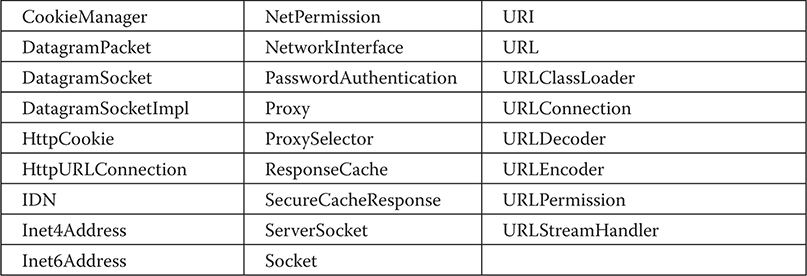
The java.net package’s interfaces are listed here:

Beginning with JDK 9, java.net is part of the java.base module. In the sections that follow, we will examine the main networking classes and show several examples that apply to them. Once you understand these core networking classes, you will be able to easily explore the others on your own.
The InetAddress class is used to encapsulate both the numerical IP address and the domain name for that address. You interact with this class by using the name of an IP host, which is more convenient and understandable than its IP address. The InetAddress class hides the number inside. InetAddress can handle both IPv4 and IPv6 addresses.
The InetAddress class has no visible constructors. To create an InetAddress object, you have to use one of the available factory methods. As explained earlier in this book, factory methods are merely a convention whereby static methods in a class return an instance of that class. This is done in lieu of overloading a constructor with various parameter lists when having unique method names makes the results much clearer. Three commonly used InetAddress factory methods are shown here:
static InetAddress getLocalHost( )
throws UnknownHostException
static InetAddress getByName(String hostName)
throws UnknownHostException
static InetAddress[ ] getAllByName(String hostName)
throws UnknownHostException
The getLocalHost( ) method simply returns the InetAddress object that represents the local host. The getByName( ) method returns an InetAddress for a host name passed to it. If these methods are unable to resolve the host name, they throw an UnknownHostException.
On the Internet, it is common for a single name to be used to represent several machines. In the world of web servers, this is one way to provide some degree of scaling. The getAllByName( ) factory method returns an array of InetAddresses that represent all of the addresses that a particular name resolves to. It will also throw an UnknownHostException if it can’t resolve the name to at least one address.
InetAddress also includes the factory method getByAddress( ), which takes an IP address and returns an InetAddress object. Either an IPv4 or an IPv6 address can be used.
The following example prints the addresses and names of the local machine and two Internet web sites:
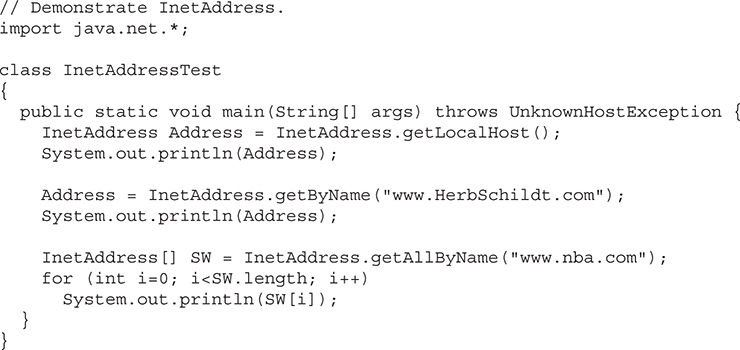
Here is the output produced by this program. (Of course, the output you see may be slightly different.)
default/166.203.115.212
www.HerbSchildt.com/216.92.65.4
www.nba.com/23.67.86.30
www.nba.com/2600:1407:2800:3a4:0:0:0:1f51
www.nba.com/2600:1407:2800:3ad:0:0:0:1f51
The InetAddress class has several other methods, which can be used on the objects returned by the methods just discussed. Here is a sampling:


Internet addresses are looked up in a series of hierarchically cached servers. That means that your local computer might know a particular name-to-IP-address mapping automatically, such as for itself and nearby servers. For other names, it may ask a local DNS server for IP address information. If that server doesn’t have a particular address, it can go to a remote site and ask for it. This can continue all the way up to the root server. This process might take a long time, so it is wise to structure your code so that you cache IP address information locally rather than look it up repeatedly.
Java includes support for both IPv4 and IPv6 addresses. Because of this, two subclasses of InetAddress were created: Inet4Address and Inet6Address. Inet4Address represents a traditional-style IPv4 address. Inet6Address encapsulates a newer IPv6 address. Because they are subclasses of InetAddress, an InetAddress reference can refer to either. This is one way that Java was able to add IPv6 functionality without breaking existing code or adding many more classes. For the most part, you can simply use InetAddress when working with IP addresses because it can accommodate both styles.
TCP/IP sockets are used to implement reliable, bidirectional, persistent, point-to-point, stream-based connections between hosts on the Internet. A socket can be used to connect Java’s I/O system to other programs that may reside either on the local machine or on any other machine on the Internet, subject to security constraints.
There are two kinds of TCP sockets in Java. One is for servers, and the other is for clients. The ServerSocket class is designed to be a "listener," which waits for clients to connect before doing anything. Thus, ServerSocket is for servers. The Socket class is for clients. It is designed to connect to server sockets and initiate protocol exchanges. Because client sockets are the most commonly used by Java applications, they are examined here.
The creation of a Socket object implicitly establishes a connection between the client and server. There are no methods or constructors that explicitly expose the details of establishing that connection. Here are two constructors used to create client sockets:

Socket defines several instance methods. For example, a Socket can be examined at any time for the address and port information associated with it, by use of the following methods:

You can gain access to the input and output streams associated with a Socket by use of the getInputStream( ) and getOuptutStream( ) methods, as shown here. Each can throw an IOException if the socket has been invalidated by a loss of connection. These streams are used exactly like the I/O streams described in Chapter 22 to send and receive data.

Several other methods are available, including connect( ), which allows you to specify a new connection; isConnected( ), which returns true if the socket is connected to a server; isBound( ), which returns true if the socket is bound to an address; and isClosed( ), which returns true if the socket is closed. To close a socket, call close( ). Closing a socket also closes the I/O streams associated with the socket. Socket also implements AutoCloseable, which means that you can use a try-with-resources block to manage a socket.
The following program provides a simple Socket example. It opens a connection to a "whois" port (port 43) on the InterNIC server, sends the command-line argument down the socket, and then prints the data that is returned. InterNIC will try to look up the argument as a registered Internet domain name, and then send back the IP address and contact information for that site.
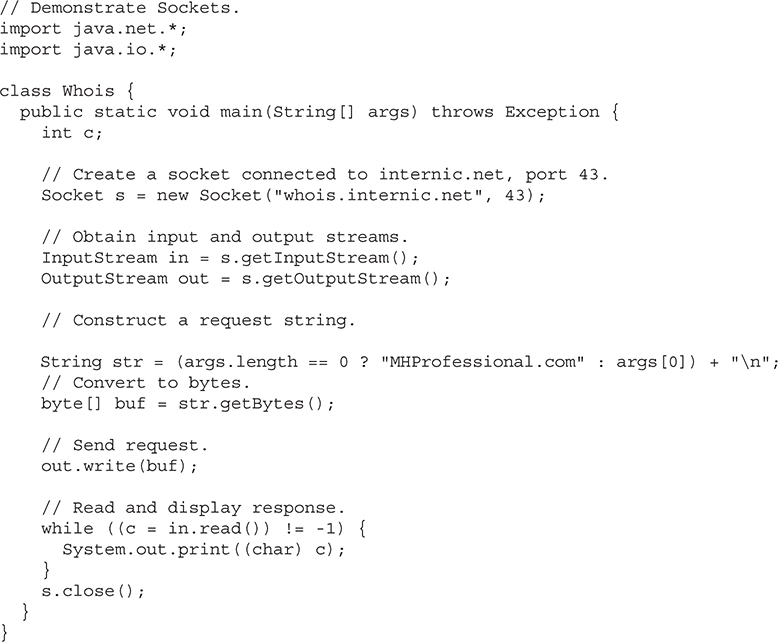
Here is how the program works. First, a Socket is constructed that specifies the host name "whois.internic.net" and the port number 43. Internic.net is the InterNIC web site that handles whois requests. Port 43 is the whois port. Next, both input and output streams are opened on the socket. Then, a string is constructed that contains the name of the web site you want to obtain information about. In this case, if no web site is specified on the command line, then "MHProfessional.com" is used. The string is converted into a byte array and then sent out of the socket. The response is read by inputting from the socket, and the results are displayed. Finally, the socket is closed, which also closes the I/O streams.
In the preceding example, the socket was closed manually by calling close( ). If you are using a modern version of Java, you can use a try-with-resources block to automatically close the socket. For example, here is another way to write the main( ) method of the previous program:
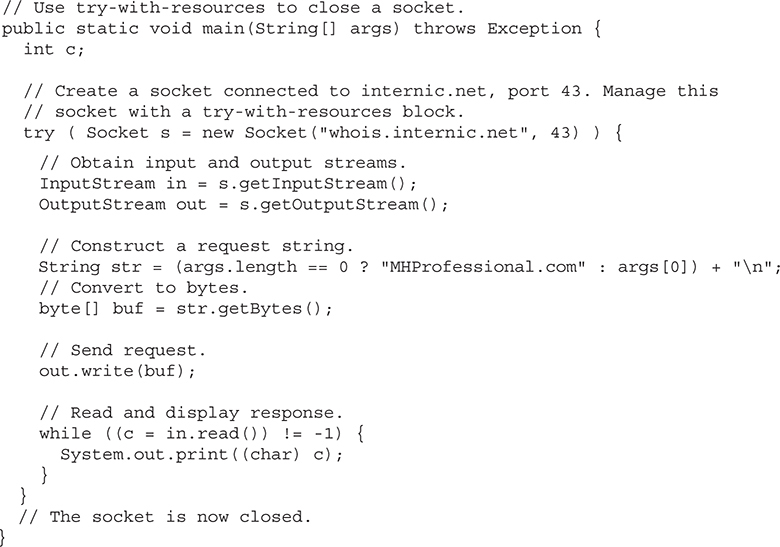
In this version, the socket is automatically closed when the try block ends.
So the examples will work with earlier versions of Java and to clearly illustrate when a network resource can be closed, subsequent examples will continue to call close( ) explicitly. However, in your own code, you should consider using automatic resource management since it offers a more streamlined approach. One other point: In this version, exceptions are still thrown out of main( ), but they could be handled by adding catch clauses to the end of the try-with-resources block.
Note For simplicity, the examples in this chapter simply throw all exceptions out of main( ). This allows the logic of the network code to be clearly illustrated. However, in real-world code, you will normally need to handle the exceptions in an appropriate way.
The preceding example was rather obscure because the modern Internet is not about the older protocols such as whois, finger, and FTP. It is about WWW, the World Wide Web. The Web is a loose collection of higher-level protocols and file formats, all unified in a web browser. One of the most important aspects of the Web is that Tim Berners-Lee devised a scalable way to locate all of the resources of the Net. Once you can reliably name anything and everything, it becomes a very powerful paradigm. The Uniform Resource Locator (URL) does exactly that.
The URL provides a reasonably intelligible form to uniquely identify or address information on the Internet. URLs are ubiquitous; every browser uses them to identify information on the Web. Within Java’s network class library, the URL class provides a simple, concise API to access information across the Internet using URLs.
All URLs share the same basic format, although some variation is allowed. Here are two examples: http://www.HerbSchildt.com/ and http://www.HerbSchildt.com:80/index.htm. A URL specification is based on four components. The first is the protocol to use, separated from the rest of the locator by a colon (:). Common protocols are HTTP, FTP, and file, although these days almost everything is being done via HTTP (in fact, most browsers will proceed correctly if you leave off the "http://" from your URL specification). The second component is the host name or IP address of the host to use; this is delimited on the left by double slashes (//) and on the right by a slash (/) or optionally a colon (:). The third component, the port number, is an optional parameter, delimited on the left from the host name by a colon (:) and on the right by a slash (/). (It defaults to port 80, the predefined HTTP port; thus, ":80" is redundant.) The fourth part is the actual file path. Most HTTP servers will append a file named index.html or index.htm to URLs that refer directly to a directory resource. Thus, http://www.HerbSchildt.com/ is the same as http://www.HerbSchildt.com/index.htm.
Java’s URL class has several constructors; each can throw a MalformedURLException. One commonly used form specifies the URL with a string that is identical to what you see displayed in a browser:
URL(String urlSpecifier) throws MalformedURLException
The next two forms of the constructor allow you to break up the URL into its component parts:
URL(String protocolName, String hostName, int port, String path)
throws MalformedURLException
URL(String protocolName, String hostName, String path)
throws MalformedURLException
Another frequently used constructor allows you to use an existing URL as a reference context and then create a new URL from that context. Although this sounds a little contorted, it’s really quite easy and useful.
URL(URL urlObj, String urlSpecifier) throws MalformedURLException
The following example creates a URL to a page on HerbSchildt.com and then examines its properties:
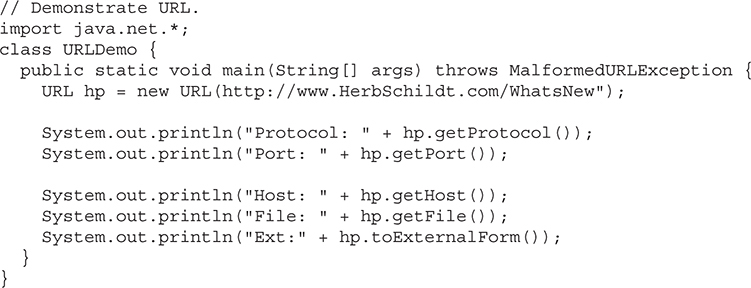
When you run this, you will get the following output:

Notice that the port is –1; this means that a port was not explicitly set. Given a URL object, you can retrieve the data associated with it. To access the actual bits or content information of a URL, create a URLConnection object from it, using its openConnection( ) method, like this:
urlc = url.openConnection()
openConnection( ) has the following general form:
URLConnection openConnection( ) throws IOException
It returns a URLConnection object associated with the invoking URL object. Notice that it may throw an IOException.
URLConnection is a general-purpose class for accessing the attributes of a remote resource. Once you make a connection to a remote server, you can use URLConnection to inspect the properties of the remote object before actually transporting it locally. These attributes are exposed by the HTTP protocol specification and, as such, only make sense for URL objects that are using the HTTP protocol.
URLConnection defines several methods. Here is a sampling:
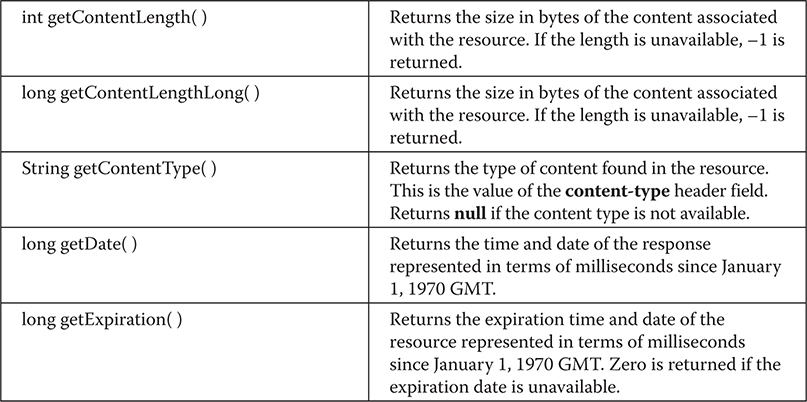
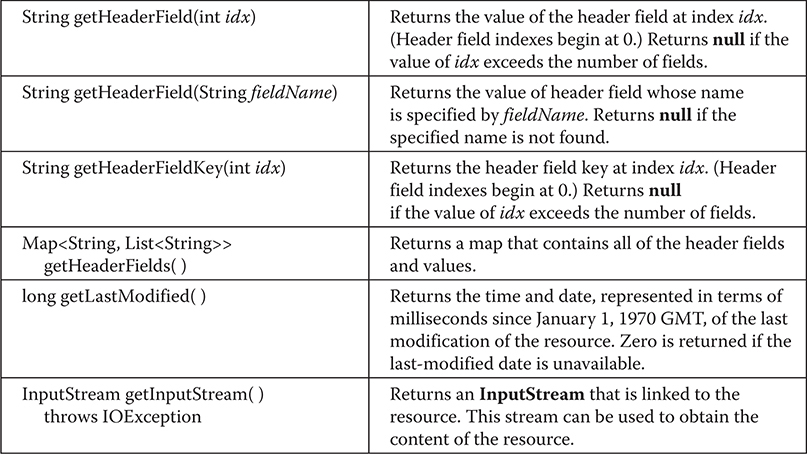
Notice that URLConnection defines several methods that handle header information. A header consists of pairs of keys and values represented as strings. By using getHeaderField( ), you can obtain the value associated with a header key. By calling getHeaderFields( ), you can obtain a map that contains all of the headers. Several standard header fields are available directly through methods such as getDate( ) and getContentType( ).
The following example creates a URLConnection using the openConnection( ) method of a URL object and then uses it to examine the document’s properties and content:
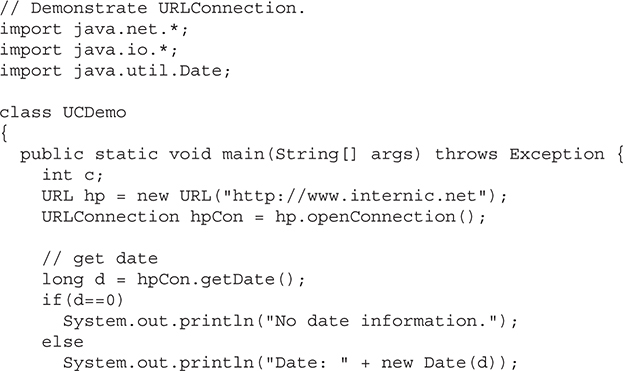
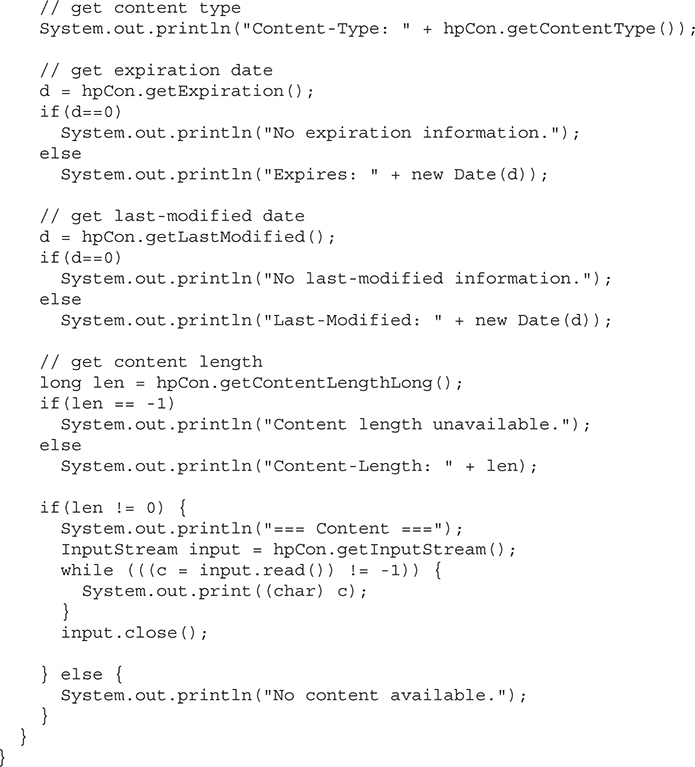
The program establishes an HTTP connection to www.internic.net over port 80. It then displays several header values and retrieves the content. You might find it interesting to try this example, observing the results, and then for comparison purposes try different web sites of your own choosing.
Java provides a subclass of URLConnection that provides support for HTTP connections. This class is called HttpURLConnection. You obtain an HttpURLConnection in the same way just shown, by calling openConnection( ) on a URL object, but you must cast the result to HttpURLConnection. (Of course, you must make sure that you are actually opening an HTTP connection.) Once you have obtained a reference to an HttpURLConnection object, you can use any of the methods inherited from URLConnection. You can also use any of the several methods defined by HttpURLConnection. Here is a sampling:
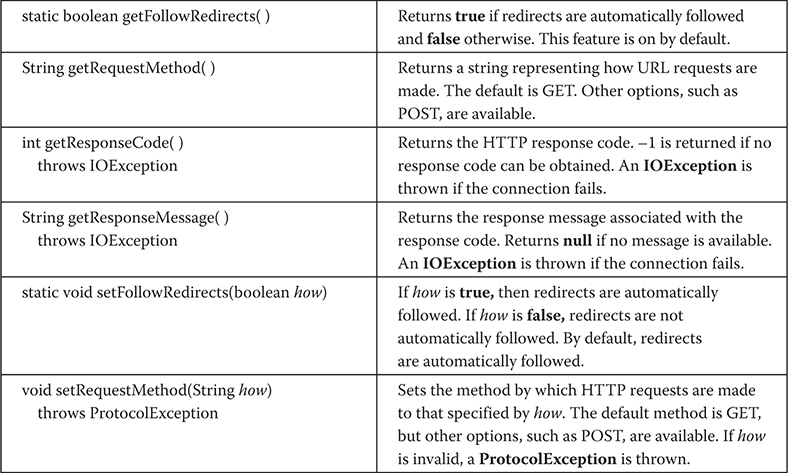
The following program demonstrates HttpURLConnection. It first establishes a connection to www.google.com. Then it displays the request method, the response code, and the response message. Finally, it displays the keys and values in the response header.
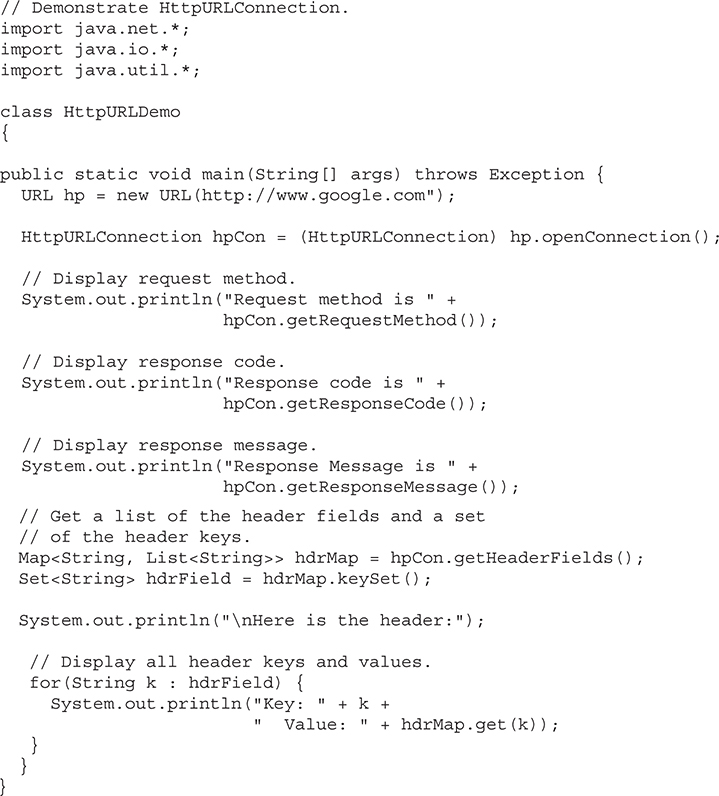
Here is a small portion of the output produced by the program. (Of course, the exact response returned by www.google.com will vary over time.)
Request method is GET
Response code is 200
Response Message is OK
Here is the header:
Key: Transfer-Encoding Value: [chunked]
Key: null Value: [HTTP/1.1 200 OK]
Key: Server Value: [gws]
Notice how the header keys and values are displayed. First, a map of the header keys and values is obtained by calling getHeaderFields( ) (which is inherited from URLConnection). Next, a set of the header keys is retrieved by calling keySet( ) on the map. Then, the key set is cycled through by using a for-each style for loop. The value associated with each key is obtained by calling get( ) on the map.
The URI class encapsulates a Uniform Resource Identifier (URI). URIs are similar to URLs. In fact, URLs constitute a subset of URIs. A URI represents a standard way to identify a resource. A URL also describes how to access the resource.
The java.net package includes classes and interfaces that help manage cookies and can be used to create a stateful (as opposed to stateless) HTTP session. The classes are CookieHandler, CookieManager, and HttpCookie. The interfaces are CookiePolicy and CookieStore. The creation of a stateful HTTP session is beyond the scope of this book.
Note For information about using cookies with servlets, see Chapter 36.
As mentioned earlier, Java has a different socket class that must be used for creating server applications. The ServerSocket class is used to create servers that listen for either local or remote client programs to connect to them on published ports. ServerSockets are quite different from normal Sockets. When you create a ServerSocket, it will register itself with the system as having an interest in client connections. The constructors for ServerSocket reflect the port number that you want to accept connections on and, optionally, how long you want the queue for said port to be. The queue length tells the system how many client connections it can leave pending before it should simply refuse connections. The default is 50. The constructors might throw an IOException under adverse conditions. Here are three of its constructors:

ServerSocket has a method called accept( ), which is a blocking call that will wait for a client to initiate communications and then return with a normal Socket that is then used for communication with the client.
TCP/IP-style networking is appropriate for most networking needs. It provides a serialized, predictable, reliable stream of packet data. This is not without its cost, however. TCP includes many complicated algorithms for dealing with congestion control on crowded networks, as well as pessimistic expectations about packet loss. This leads to a somewhat inefficient way to transport data. Datagrams provide an alternative.
Datagrams are bundles of information passed between machines. They are somewhat like a hard throw from a well-trained but blindfolded catcher to the third baseman. Once the datagram has been released to its intended target, there is no assurance that it will arrive or even that someone will be there to catch it. Likewise, when the datagram is received, there is no assurance that it hasn’t been damaged in transit or that whoever sent it is still there to receive a response.
Java implements datagrams on top of the UDP protocol by using two classes: the DatagramPacket object is the data container, while the DatagramSocket is the mechanism used to send or receive the DatagramPackets. Each is examined here.
DatagramSocket defines four public constructors. They are shown here:
DatagramSocket( ) throws SocketException
DatagramSocket(int port) throws SocketException
DatagramSocket(int port, InetAddress ipAddress) throws SocketException
DatagramSocket(SocketAddress address) throws SocketException
The first creates a DatagramSocket bound to any unused port on the local computer. The second creates a DatagramSocket bound to the port specified by port. The third constructs a DatagramSocket bound to the specified port and InetAddress. The fourth constructs a DatagramSocket bound to the specified SocketAddress. SocketAddress is an abstract class that is implemented by the concrete class InetSocketAddress. InetSocketAddress encapsulates an IP address with a port number. All can throw a SocketException if an error occurs while creating the socket.
DatagramSocket defines many methods. Two of the most important are send( ) and receive( ), which are shown here:
void send(DatagramPacket packet) throws IOException
void receive(DatagramPacket packet) throws IOException
The send( ) method sends a packet to the port specified by packet. The receive( ) method waits for a packet to be received and returns the result.
DatagramSocket also defines the close( )method, which closes the socket. DatagramSocket also implements AutoCloseable, which means that a DatagramSocket can be managed by a try-with-resources block.
Other methods give you access to various attributes associated with a DatagramSocket. Here is a sampling:
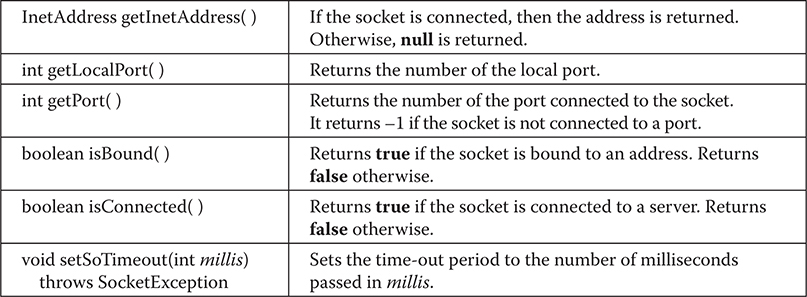
DatagramPacket defines several constructors. Four are shown here:
DatagramPacket(byte[ ] data, int size)
DatagramPacket(byte[ ] data, int offset, int size)
DatagramPacket(byte[ ] data, int size, InetAddress ipAddress, int port)
DatagramPacket(byte[ ] data, int offset, int size, InetAddress ipAddress, int port)
The first constructor specifies a buffer that will receive data and the size of a packet. It is used for receiving data over a DatagramSocket. The second form allows you to specify an offset into the buffer at which data will be stored. The third form specifies a target address and port, which are used by a DatagramSocket to determine where the data in the packet will be sent. The fourth form transmits packets beginning at the specified offset into the data. Think of the first two forms as building an "in box," and the second two forms as stuffing and addressing an envelope.
DatagramPacket defines several methods, including those shown here, that give access to the address and port number of a packet, as well as the raw data and its length:
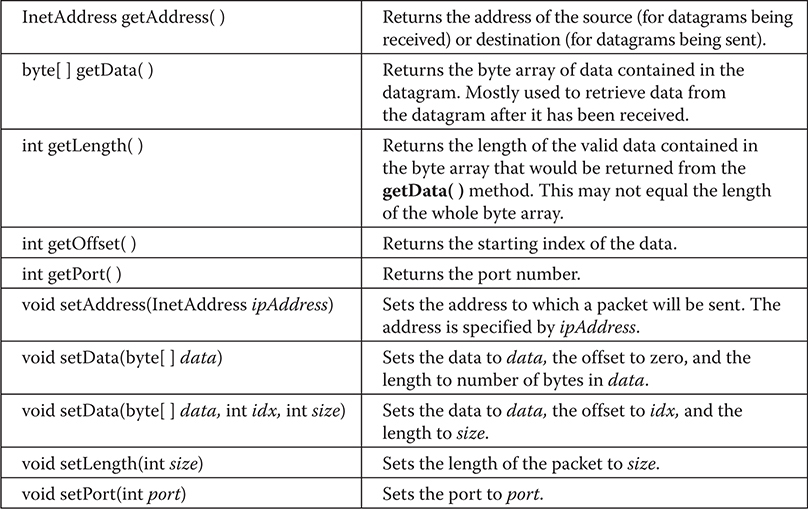
The following example implements a very simple networked communications client and server. Messages are typed into the window at the server and written across the network to the client side, where they are displayed.
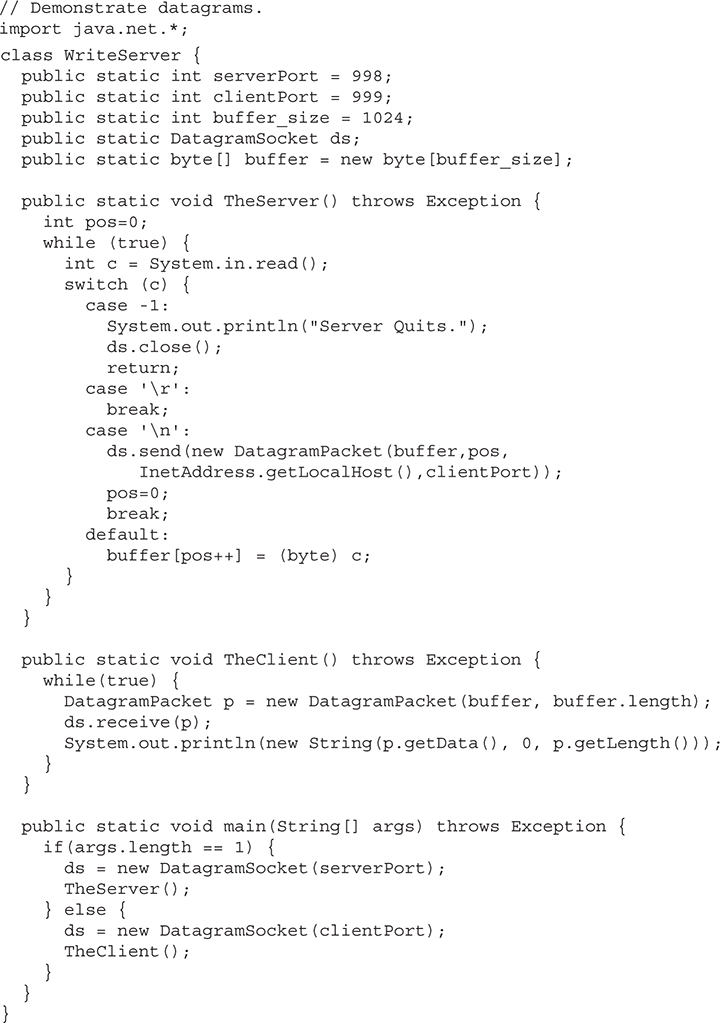
This sample program is restricted by the DatagramSocket constructor to running between two ports on the local machine. To use the program, run
java WriteServer
in one window; this will be the client. Then run
java WriteServer 1
This will be the server. Anything that is typed in the server window will be sent to the client window after a newline is received.
Note The use of datagrams may not be allowed on your computer. (For example, a firewall may prevent their use.) If this is the case, the preceding example cannot be used. Also, the port numbers used in the program work on the author’s system, but may have to be adjusted for your environment.
The preceding material introduced Java’s traditional support for networking provided by java.net. This API is available in all versions of Java and is widely used. Thus, knowledge of Java’s traditional approach to networking is important for all programmers. However, beginning with JDK 11, a new networking package called java.net.http, in the module java.net.http, has been added. It provides enhanced, updated networking support for HTTP clients. This new API is generally referred to as the HTTP Client API.
For many types of HTTP networking, the capabilities defined by the API in java.net.http can provide superior solutions. In addition to offering a streamlined, easy-to-use API, other advantages include support for asynchronous communication, HTTP/2, and flow control. In general, the HTTP Client API is designed as a superior alternative to the functionality provided by HttpURLConnection. It also supports the WebSocket protocol for bidirectional communication.
The following discussion explores several key features of the HTTP Client API. Be aware that it contains much more than described here. If you will be writing sophisticated network-based code, then it is a package that you will want to examine in detail. Our purpose here is to introduce some of the fundamentals associated with this important module.
The focus of the following discussion is centered on three core HTTP Client API elements:

These work together to support the request/response features of HTTP. Here is the general procedure. First, create an instance of HttpClient. Then, construct an HttpRequest and send it by calling send( ) on the HttpClient. The response is returned by send( ). From the response, you can obtain the headers and response body. Before working through an example, we will begin with an overview of these fundamental aspects of the API.
HttpClient encapsulates the HTTP request/response mechanism. It supports both synchronous and asynchronous communication. Here, we will be using only synchronous communication, but you might want to experiment with asynchronous communication on your own. Once you have an HttpClient object, you can use it to send requests and obtain responses. Thus, it is at the foundation of the HTTP Client API.
HttpClient is an abstract class, and instances are not created via a public constructor. Rather, you will use a factory method to build one. HttpClient supports builders with the HttpClient.Builder interface, which provides several methods that let you configure the HttpClient. To obtain an HttpClient builder, use the newBuilder( ) static method. It returns a builder that lets you configure the HttpClient that it will create. Next, call build( ) on the builder. It creates and returns the HttpClient instance. For example, this creates an HttpClient that uses the default settings:
HttpClient myHC = HttpClient.newBuilder().build();
HttpClient.Builder defines a number of methods that let you configure the builder. Here is one example. By default, redirects are not followed. You can change this by calling followRedirects( ), passing in the new redirect setting, which must be a value in the HttpClient.Redirect enumeration. It defines the following values: ALWAYS, NEVER, and NORMAL. The first two are self explanatory. The NORMAL setting causes redirects to be followed unless a redirect is from an HTTPS site to an HTTP site. For example, this creates a builder in which the redirect policy is NORMAL. It then uses that builder to construct an HttpClient.

Among others, builder configuration settings include authentication, proxy, HTTP version, and priority. Therefore, you can build an HTTP client to fit virtually any need.
In cases in which the default configuration is sufficient, you can obtain a default HttpClient directly by calling the newHttpClient( ) method. It is shown here:
static HttpClient newHttpClient( )
An HttpClient with a default configuration is returned. For example, this creates a new default HttpClient:
HttpClient myHC = HttpClient.newHttpClient();
Because a default client is sufficient for the purposes of this book, this is the approach used by the examples that follow.
Once you have an HttpClient instance, you can send a synchronous request by calling its send( ) method, shown here:
<T> HttpResponse <T> send(HttpRequest req,
HttpResponse.BodyHandler<T> handler)
throws IOException, InterruptedException
Here, req encapsulates the request and handler specifies how the response body is handled. As you will shortly see, often, you can use one of the predefined body handlers provided by the HttpResponse.BodyHandlers class. An HttpResponse object is returned. Thus, send( ) provides the basic mechanism for HTTP communication.
The HTTP Client API encapsulates requests in the HttpRequest abstract class. To create an HttpRequest object, you will use a builder. To obtain a builder, call HttpRequest’s newBuilder( ) method. Here are two of its forms:
static HttpRequest.Builder newBuilder( )
static HttpRequest.Builder newBuilder(URI uri)
The first form creates a default builder. The second lets you specify the URI of the resource. There is also a third form lets you obtain a builder that can create an HttpRequest object that will be similar to a specified HttpRequest object.
HttpRequest.Builder lets you specify various aspects of the request, such as what request method to use. (The default is GET.) You can also set header information, the URI, and the HTTP version, among others. Aside from the URI, often the default settings are sufficient. You can obtain a string representation of the request method by calling method( ) on the HttpRequest object.
To actually construct a request, call build( ) on the builder instance. It is shown here:
HttpRequest build( )
Once you have an HttpRequest instance, you can use it use it in a call to HttpClient’s send( ) method, as shown in the previous section.
The HTTP Client API encapsulates a response in an implementation of the HttpResponse interface. It is a generic interface declared like this:
HttpResponse<T>
Here, T specifies the type of body. Because the body type is generic, it enables the body to be handled in a variety of ways. This gives you a wide degree of flexibility in how your response code is written.
When a request is sent, an HttpResponse instance is returned that contains the response. HttpResponse defines several methods that give you access to the information in the response. Arguably, the most important is body( ), shown here:
T body( )
A reference to the body is returned. The specific type of reference is determined by the type of T, which is specified by the body handler specified by the send( ) method.
You can obtain the status code associated with the response by calling statusCode( ), shown here:
int statusCode( )
The HTTP status code is returned. A value of 200 indicates success.
Another method in HttpResponse is headers( ), which obtains the response headers. It is shown here:
HttpHeaders headers( )
The headers associated with the response are encapsulated in an instance of the HttpHeaders class. It contains various methods that give you access to the headers. The one used by the example that follows is map( ), shown here:
Map<String, List<String>> map( )
It returns a map that contains all of the header fields and values.
One of the advantages of the HTTP Client API is that responses can be handled automatically and in a variety of ways. Responses are handled by implementations of the HttpResponse.BodyHandler interface. A number of predefined body handler factory methods are provided in the HttpResponse.BodyHandlers class. Here are three examples:

Other predefined handlers obtain the response body as a byte array, a stream of lines, a download file, and a Flow.Publisher. A non-flow-controlled consumer is also supported. Before moving on, it is important to point out that the stream returned by ofInputStream( ) should be read in its entirety. Doing so enables associated resources to be freed. If the entire body cannot be read for some reason, call close( ) to close the stream, which may also close the HTTP connection. In general, it is best to simply read the entire stream.
The following example puts into action the features of the HTTP Client API just described. It demonstrates the sending of a request, displaying the body of the response, and obtaining a list of the response headers. You should compare it to parallel sections of code in the preceding UCDemo and HttpURLDemo programs shown earlier. Notice that it uses ofInputStream( ) to obtain an input stream linked to the response body.
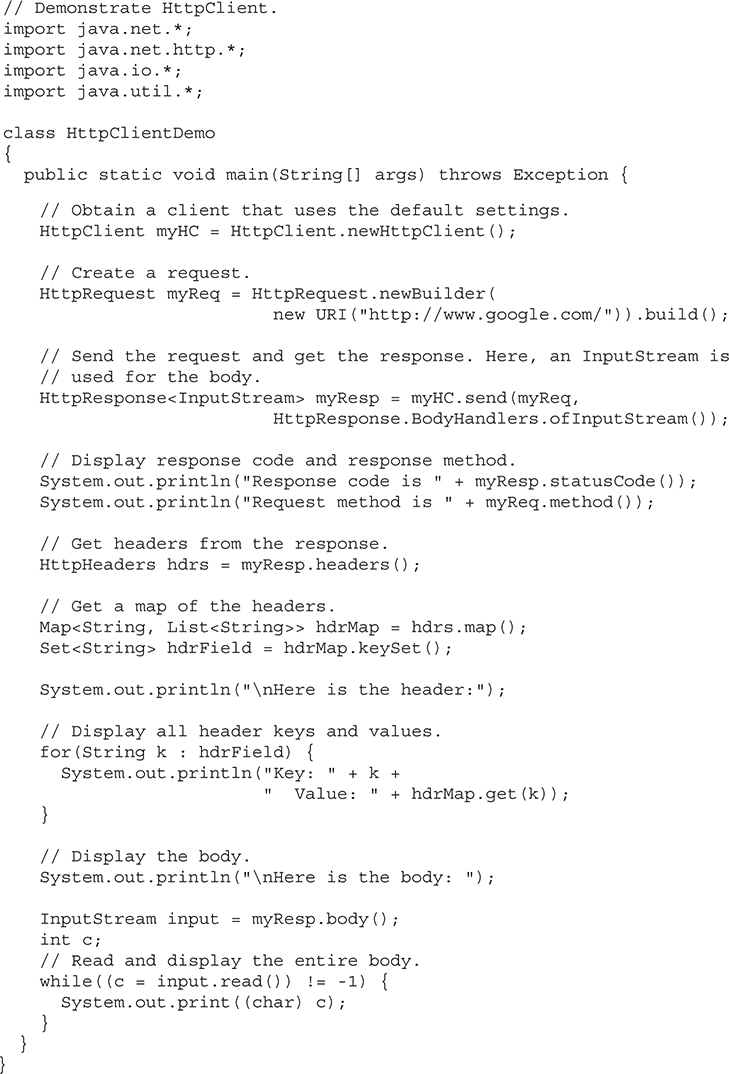
The program first creates an HttpClient and then uses that client to send a request to www.google.com (of course, you can substitute any website you like). The body handler uses an input stream by way of ofInputStream( ). Next, the response status code and the request method are displayed. Then, the header is displayed, followed by the body. Because ofInputStream( ) was specified in the send( ) method, the body( ) method will return an InputStream. This stream is then used to read and display the body.
The preceding program used an input stream to handle the body for comparison purposes with the UCDemo program shown earlier, which uses a parallel approach. However, other options are available. For example, you can use ofString( ) to handle the body as a string. With this approach, when the response is obtained, the body will be in a String instance. To try this, first substitute the line that calls send( ) with the following:

Next, replace the code that uses an input stream to read and display the body with the following line:
System.out.println(myResp.body());
Because the body of the response is already stored in a string, it can be output directly. You might want to experiment with other body handlers. Of particular interest is ofLines( ), which lets you access the body as a stream of lines. One of the benefits of the HTPP Client API is that there are built-in body handlers for a variety of situations.
The preceding introduction described a number of key features in the HTTP Client API in java.net.http, but there are several more that you will want to explore. One of the most important is the WebSocket class, which supports bidirectional communication. Another is the asynchronous capability supported by the API. In general, if network programming is in your future, you will want to thoroughly explore java.net.http. It is an important addition to Java’s networking APIs.
This chapter examines an important aspect of Java: the event. Event handling is fundamental to Java programming because it is integral to the creation of many kinds of applications. For example, any program that uses a graphical user interface, such as a Java application written for Windows, is event driven. Thus, you cannot write these types of programs without a solid command of event handling. Events are supported by a number of packages, including java.util, java.awt, and java.awt.event. Beginning with JDK 9, java.awt and java.awt.event are part of the java.desktop module, and java.util is part of the java.base module.
Many events to which your program will respond are generated when the user interacts with a GUI-based program. These are the types of events examined in this chapter. They are passed to your program in a variety of ways, with the specific method dependent upon the actual event. There are several types of events, including those generated by the mouse, the keyboard, and various GUI controls, such as a push button, scroll bar, or check box.
This chapter begins with an overview of Java’s event handling mechanism. It then examines a number of event classes and interfaces used by the Abstract Window Toolkit (AWT). The AWT was Java’s first GUI framework and it offers a simple way to present the basics of event handling. Next, the chapter develops several examples that demonstrate the fundamentals of event processing. This chapter also introduces key concepts related to GUI programming, and explains how to use adapter classes, inner classes, and anonymous inner classes to streamline event handling code. The examples provided in the remainder of this book make frequent use of these techniques.
Note This chapter focuses on events related to GUI-based programs. However, events are also occasionally used for purposes not directly related to GUI-based programs. In all cases, the same basic event handling techniques apply.
Before beginning our discussion of event handling, an important historical point must be made: The way in which events are handled changed significantly between the original version of Java (1.0) and all subsequent versions of Java, beginning with version 1.1. Although the 1.0 method of event handling is still supported, it is not recommended for new programs. Also, many of the methods that support the old 1.0 event model have been deprecated. The modern approach is the way that events should be handled by all new programs and thus is the method employed by programs in this book.
The modern approach to handling events is based on the delegation event model, which defines standard and consistent mechanisms to generate and process events. Its concept is quite simple: a source generates an event and sends it to one or more listeners. In this scheme, the listener simply waits until it receives an event. Once an event is received, the listener processes the event and then returns. The advantage of this design is that the application logic that processes events is cleanly separated from the user interface logic that generates those events. A user interface element is able to “delegate” the processing of an event to a separate piece of code.
In the delegation event model, listeners must register with a source in order to receive an event notification. This provides an important benefit: notifications are sent only to listeners that want to receive them. This is a more efficient way to handle events than the design used by the original Java 1.0 approach, in which an event was propagated up the containment hierarchy until it was handled by a component. This required components to receive events that they did not process, and it wasted valuable time. The delegation event model eliminates this overhead.
The following sections define events and describe the roles of sources and listeners.
In the delegation model, an event is an object that describes a state change in a source. Among other causes, an event can be generated as a consequence of a person interacting with the elements in a graphical user interface. Some of the activities that cause events to be generated are pressing a button, entering a character via the keyboard, selecting an item in a list, and clicking the mouse. Many other user operations could also be cited as examples.
Events may also occur that are not directly caused by interactions with a user interface. For example, an event may be generated when a timer expires, a counter exceeds a value, a software or hardware failure occurs, or an operation is completed. You are free to define events that are appropriate for your application.
A source is an object that generates an event. This occurs when the internal state of that object changes in some way. Sources may generate more than one type of event.
A source must register listeners in order for the listeners to receive notifications about a specific type of event. Each type of event has its own registration method. Here is the general form:
public void addTypeListener (TypeListener el )
Here, Type is the name of the event, and el is a reference to the event listener. For example, the method that registers a keyboard event listener is called addKeyListener( ). The method that registers a mouse motion listener is called addMouseMotionListener( ). When an event occurs, all registered listeners are notified and receive a copy of the event object. This is known as multicasting the event. In all cases, notifications are sent only to listeners that register to receive them.
Some sources may allow only one listener to register. The general form of such a method is this:
public void addTypeListener(TypeListener el )
throws java.util.TooManyListenersException
Here, Type is the name of the event, and el is a reference to the event listener. When such an event occurs, the registered listener is notified. This is known as unicasting the event.
A source must also provide a method that allows a listener to unregister an interest in a specific type of event. The general form of such a method is this:
public void removeTypeListener(TypeListener el )
Here, Type is the name of the event, and el is a reference to the event listener. For example, to remove a keyboard listener, you would call removeKeyListener( ).
The methods that add or remove listeners are provided by the source that generates events. For example, Component, which is a top-level class defined by the AWT, provides methods to add and remove keyboard and mouse event listeners.
A listener is an object that is notified when an event occurs. It has two major requirements. First, it must have been registered with one or more sources to receive notifications about specific types of events. Second, it must implement methods to receive and process these notifications. In other words, the listener must supply the event handlers.
The methods that receive and process events are defined in a set of interfaces, such as those found in java.awt.event. For example, the MouseMotionListener interface defines two methods to receive notifications when the mouse is dragged or moved. Any object may handle one or both of these events if it provides an implementation of this interface. Other listener interfaces are discussed later in this and other chapters.
Here is one more key point about events: An event handler must return quickly. For the most part, a GUI program should not enter a “mode” of operation in which it maintains control for an extended period. Instead, it must perform specific actions in response to events and then return control to the run-time system. Failure to do this can cause your program to appear sluggish or even non-responsive. If your program needs to perform a repetitive task, such as scrolling a banner, it must do so by starting a separate thread. In short, when your program receives an event, it must process it immediately, and then return.
The classes that represent events are at the core of Java’s event handling mechanism. Thus, a discussion of event handling must begin with the event classes. It is important to understand, however, that Java defines several types of events and that not all event classes can be discussed in this chapter. Arguably, the most widely used events at the time of this writing are those defined by the AWT and those defined by Swing. This chapter focuses on the AWT events. (Most of these events also apply to Swing.) Several Swing-specific events are described in Chapter 32, when Swing is covered.
At the root of the Java event class hierarchy is EventObject, which is in java.util. It is the superclass for all events. Its one constructor is shown here:
EventObject(Object src)
Here, src is the object that generates this event.
EventObject defines two methods: getSource( ) and toString( ). The getSource( ) method returns the source of the event. Its general form is shown here:
Object getSource( )
As expected, toString( ) returns the string equivalent of the event.
The class AWTEvent, defined within the java.awt package, is a subclass of EventObject. It is the superclass (either directly or indirectly) of all AWT-based events used by the delegation event model. Its getID( ) method can be used to determine the type of the event. The signature of this method is shown here:
int getID( )
Typically, you won’t use the features defined by AWTEvent directly. Rather, you will use its subclasses. At this point, it is important to know only that all of the other classes discussed in this section are subclasses of AWTEvent.
To summarize:
• EventObject is a superclass of all events.
• AWTEvent is a superclass of all AWT events that are handled by the delegation event model.
The package java.awt.event defines many types of events that are generated by various user interface elements. Table 25-1 shows several commonly used event classes and provides a brief description of when they are generated. Commonly used constructors and methods in each class are described in the following sections.
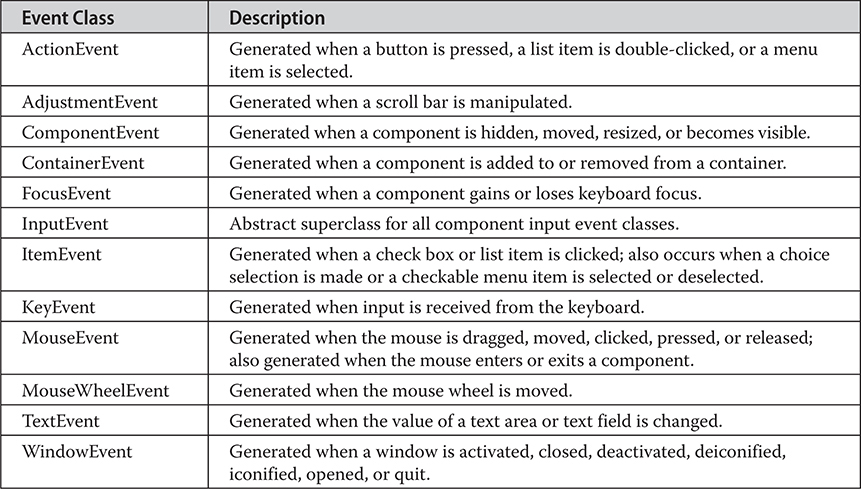
Table 25-1 Commonly Used Event Classes in java.awt.event
An ActionEvent is generated when a button is pressed, a list item is double-clicked, or a menu item is selected. The ActionEvent class defines four integer constants that can be used to identify any modifiers associated with an action event: ALT_MASK, CTRL_MASK, META_MASK, and SHIFT_MASK. In addition, there is an integer constant, ACTION_PERFORMED, which can be used to identify action events.
ActionEvent has these three constructors:
ActionEvent(Object src, int type, String cmd)
ActionEvent(Object src, int type, String cmd, int modifiers)
ActionEvent(Object src, int type, String cmd, long when, int modifiers)
Here, src is a reference to the object that generated this event. The type of the event is specified by type, and its command string is cmd. The argument modifiers indicates which modifier keys (ALT, CTRL, META, and/or SHIFT) were pressed when the event was generated. The when parameter specifies when the event occurred.
You can obtain the command name for the invoking ActionEvent object by using the getActionCommand( ) method, shown here:
String getActionCommand( )
For example, when a button is pressed, an action event is generated that has a command name equal to the label on that button.
The getModifiers( ) method returns a value that indicates which modifier keys (ALT, CTRL, META, and/or SHIFT) were pressed when the event was generated. Its form is shown here:
int getModifiers( )
The method getWhen( ) returns the time at which the event took place. This is called the event’s timestamp. The getWhen( ) method is shown here:
long getWhen( )
An AdjustmentEvent is generated by a scroll bar. There are five types of adjustment events. The AdjustmentEvent class defines integer constants that can be used to identify them. The constants and their meanings are shown here:

In addition, there is an integer constant, ADJUSTMENT_VALUE_CHANGED, that indicates that a change has occurred.
Here is one AdjustmentEvent constructor:
AdjustmentEvent(Adjustable src, int id, int type, int val)
Here, src is a reference to the object that generated this event. The id specifies the event. The type of the adjustment is specified by type, and its associated value is val.
The getAdjustable( ) method returns the object that generated the event. Its form is shown here:
Adjustable getAdjustable( )
The type of the adjustment event may be obtained by the getAdjustmentType( ) method. It returns one of the constants defined by AdjustmentEvent. The general form is shown here:
int getAdjustmentType( )
The amount of the adjustment can be obtained from the getValue( ) method, shown here:
int getValue( )
For example, when a scroll bar is manipulated, this method returns the value represented by that change.
A ComponentEvent is generated when the size, position, or visibility of a component is changed. There are four types of component events. The ComponentEvent class defines integer constants that can be used to identify them. The constants and their meanings are shown here:

ComponentEvent has this constructor:
ComponentEvent(Component src, int type)
Here, src is a reference to the object that generated this event. The type of the event is specified by type.
ComponentEvent is the superclass either directly or indirectly of ContainerEvent, FocusEvent, KeyEvent, MouseEvent, and WindowEvent, among others.
The getComponent( ) method returns the component that generated the event. It is shown here:
Component getComponent( )
A ContainerEvent is generated when a component is added to or removed from a container. There are two types of container events. The ContainerEvent class defines int constants that can be used to identify them: COMPONENT_ADDED and COMPONENT_REMOVED. They indicate that a component has been added to or removed from the container.
ContainerEvent is a subclass of ComponentEvent and has this constructor:
ContainerEvent(Component src, int type, Component comp)
Here, src is a reference to the container that generated this event. The type of the event is specified by type, and the component that has been added to or removed from the container is comp.
You can obtain a reference to the container that generated this event by using the getContainer ( ) method, shown here:
Container getContainer( )
The getChild( ) method returns a reference to the component that was added to or removed from the container. Its general form is shown here:
Component getChild( )
A FocusEvent is generated when a component gains or loses input focus. These events are identified by the integer constants FOCUS_GAINED and FOCUS_LOST.
FocusEvent is a subclass of ComponentEvent and has these constructors:
FocusEvent(Component src, int type)
FocusEvent(Component src, int type, boolean temporaryFlag)
FocusEvent(Component src, int type, boolean temporaryFlag, Component other)
FocusEvent(Component src, int type, boolean temporaryFlag, Component other,
FocusEvent.Cause what)
Here, src is a reference to the component that generated this event. The type of the event is specified by type. The argument temporaryFlag is set to true if the focus event is temporary. Otherwise, it is set to false. (A temporary focus event occurs as a result of another user interface operation. For example, assume that the focus is in a text field. If the user moves the mouse to adjust a scroll bar, the focus is temporarily lost.)
The other component involved in the focus change, called the opposite component, is passed in other. Therefore, if a FOCUS_GAINED event occurred, other will refer to the component that lost focus. Conversely, if a FOCUS_LOST event occurred, other will refer to the component that gains focus.
The fourth constructor was added by JDK 9. Its what parameter specifies why the event was generated. It is specified as a FocusEvent.Cause enumeration value that identifies the cause of the focus event. The FocusEvent.Cause enumeration was also added by JDK 9.
You can determine the other component by calling getOppositeComponent( ), shown here:
Component getOppositeComponent( )
The opposite component is returned.
The isTemporary( ) method indicates if this focus change is temporary. Its form is shown here:
boolean isTemporary( )
The method returns true if the change is temporary. Otherwise, it returns false.
Beginning with JDK 9, you can obtain the cause of the event by calling getCause( ), shown here:
final FocusEvent.Cause getCause( )
The cause is returned in the form of a FocusEvent.Cause enumeration value.
The abstract class InputEvent is a subclass of ComponentEvent and is the superclass for component input events. Its subclasses are KeyEvent and MouseEvent.
InputEvent defines several integer constants that represent any modifiers, such as the control key being pressed, that might be associated with the event. Originally, the InputEvent class defined the following eight values to represent the modifiers, and these modfiers may still be found in older legacy code:

However, because of possible conflicts between the modifiers used by keyboard events and mouse events, and other issues, the following extended modifier values were added:

When writing new code, you should use the new, extended modifiers rather than the original modifiers. Furthermore, the original modifiers have been deprecated since JDK 9.
To test if a modifier was pressed at the time an event is generated, use the isAltDown( ), isAltGraphDown( ), isControlDown( ), isMetaDown( ), and isShiftDown( ) methods. The forms of these methods are shown here:
boolean isAltDown( )
boolean isAltGraphDown( )
boolean isControlDown( )
boolean isMetaDown( )
boolean isShiftDown( )
It is possible to obtain a value that contains all of the original modifier flags by calling the getModifiers( ) method. It is shown here:
int getModifiers( )
Although you may still encounter getModifiers( ) in legacy code, it is important to point out that because the original modifier flags have been deprecated by JDK 9, this method has also been deprecated by JDK 9. Instead, you should obtain the extended modifiers by calling getModifiersEx( ), which is shown here:
int getModifiersEx( )
An ItemEvent is generated when a check box or a list item is clicked or when a checkable menu item is selected or deselected. (Check boxes and list boxes are described later in this book.) There are two types of item events, which are identified by the following integer constants:

In addition, ItemEvent defines the integer constant, ITEM_STATE_CHANGED, that signifies a change of state.
ItemEvent has this constructor:
ItemEvent(ItemSelectable src, int type, Object entry, int state)
Here, src is a reference to the component that generated this event. For example, this might be a list or choice element. The type of the event is specified by type. The specific item that generated the item event is passed in entry. The current state of that item is in state.
The getItem( ) method can be used to obtain a reference to the item that changed. Its signature is shown here:
Object getItem( )
The getItemSelectable( ) method can be used to obtain a reference to the ItemSelectable object that generated an event. Its general form is shown here:
ItemSelectable getItemSelectable( )
Lists and choices are examples of user interface elements that implement the ItemSelectable interface.
The getStateChange( ) method returns the state change (that is, SELECTED or DESELECTED) for the event. It is shown here:
int getStateChange( )
A KeyEvent is generated when keyboard input occurs. There are three types of key events, which are identified by these integer constants: KEY_PRESSED, KEY_RELEASED, and KEY_TYPED. The first two events are generated when any key is pressed or released. The last event occurs only when a character is generated. Remember, not all keypresses result in characters. For example, pressing SHIFT does not generate a character.
There are many other integer constants that are defined by KeyEvent. For example, VK_0 through VK_9 and VK_A through VK_Z define the ASCII equivalents of the numbers and letters. Here are some others:

The VK constants specify virtual key codes and are independent of any modifiers, such as control, shift, or alt.
KeyEvent is a subclass of InputEvent. Here is one of its constructors:
KeyEvent(Component src, int type, long when, int modifiers, int code, char ch)
Here, src is a reference to the component that generated the event. The type of the event is specified by type. The system time at which the key was pressed is passed in when. The modifiers argument indicates which modifiers were pressed when this key event occurred. The virtual key code, such as VK_UP, VK_A, and so forth, is passed in code. The character equivalent (if one exists) is passed in ch. If no valid character exists, then ch contains CHAR_UNDEFINED. For KEY_TYPED events, code will contain VK_UNDEFINED.
The KeyEvent class defines several methods, but probably the most commonly used ones are getKeyChar( ), which returns the character that was entered, and getKeyCode( ), which returns the key code. Their general forms are shown here:
char getKeyChar( )
int getKeyCode( )
If no valid character is available, then getKeyChar( ) returns CHAR_UNDEFINED. When a KEY_TYPED event occurs, getKeyCode( ) returns VK_UNDEFINED.
There are eight types of mouse events. The MouseEvent class defines the following integer constants that can be used to identify them:

MouseEvent is a subclass of InputEvent. Here is one of its constructors:
MouseEvent(Component src, int type, long when, int modifiers,
int x, int y, int clicks, boolean triggersPopup)
Here, src is a reference to the component that generated the event. The type of the event is specified by type. The system time at which the mouse event occurred is passed in when. The modifiers argument indicates which modifiers were pressed when a mouse event occurred. The coordinates of the mouse are passed in x and y. The click count is passed in clicks. The triggersPopup flag indicates if this event causes a pop-up menu to appear on this platform.
Two commonly used methods in this class are getX( ) and getY( ). These return the X and Y coordinates of the mouse within the component when the event occurred. Their forms are shown here:
int getX( )
int getY( )
Alternatively, you can use the getPoint( ) method to obtain the coordinates of the mouse. It is shown here:
Point getPoint( )
It returns a Point object that contains the X,Y coordinates in its integer members: x and y.
The translatePoint( ) method changes the location of the event. Its form is shown here:
void translatePoint(int x, int y)
Here, the arguments x and y are added to the coordinates of the event.
The getClickCount( ) method obtains the number of mouse clicks for this event. Its signature is shown here:
int getClickCount( )
The isPopupTrigger( ) method tests if this event causes a pop-up menu to appear on this platform. Its form is shown here:
boolean isPopupTrigger( )
Also available is the getButton( ) method, shown here:
int getButton( )
It returns a value that represents the button that caused the event. For most cases, the return value will be one of these constants defined by MouseEvent:

The NOBUTTON value indicates that no button was pressed or released.
Also available are three methods that obtain the coordinates of the mouse relative to the screen rather than the component. They are shown here:
Point getLocationOnScreen( )
int getXOnScreen( )
int getYOnScreen( )
The getLocationOnScreen( ) method returns a Point object that contains both the X and Y coordinate. The other two methods return the indicated coordinate.
The MouseWheelEvent class encapsulates a mouse wheel event. It is a subclass of MouseEvent. Not all mice have wheels. If a mouse has a wheel, it is typically located between the left and right buttons. Mouse wheels are used for scrolling. MouseWheelEvent defines these two integer constants:

Here is one of the constructors defined by MouseWheelEvent:
MouseWheelEvent(Component src, int type, long when, int modifiers,
int x, int y, int clicks, boolean triggersPopup,
int scrollHow, int amount, int count)
Here, src is a reference to the object that generated the event. The type of the event is specified by type. The system time at which the mouse event occurred is passed in when. The modifiers argument indicates which modifiers were pressed when the event occurred. The coordinates of the mouse are passed in x and y. The number of clicks is passed in clicks. The triggersPopup flag indicates if this event causes a pop-up menu to appear on this platform. The scrollHow value must be either WHEEL_UNIT_SCROLL or WHEEL_BLOCK_ SCROLL. The number of units to scroll is passed in amount. The count parameter indicates the number of rotational units that the wheel moved.
MouseWheelEvent defines methods that give you access to the wheel event. To obtain the number of rotational units, call getWheelRotation( ), shown here:
int getWheelRotation( )
It returns the number of rotational units. If the value is positive, the wheel moved counterclockwise. If the value is negative, the wheel moved clockwise. Also available is a method called getPreciseWheelRotation( ), which supports high-resolution wheels. It works like getWheelRotation( ), but returns a double.
To obtain the type of scroll, call getScrollType( ), shown next:
int getScrollType( )
It returns either WHEEL_UNIT_SCROLL or WHEEL_BLOCK_SCROLL.
If the scroll type is WHEEL_UNIT_SCROLL, you can obtain the number of units to scroll by calling getScrollAmount( ). It is shown here:
int getScrollAmount( )
Instances of this class describe text events. These are generated by text fields and text areas when characters are entered by a user or program. TextEvent defines the integer constant TEXT_VALUE_CHANGED.
The one constructor for this class is shown here:
TextEvent(Object src, int type)
Here, src is a reference to the object that generated this event. The type of the event is specified by type.
The TextEvent object does not include the characters currently in the text component that generated the event. Instead, your program must use other methods associated with the text component to retrieve that information. This operation differs from other event objects discussed in this section. Think of a text event notification as a signal to a listener that it should retrieve information from a specific text component.
There are ten types of window events. The WindowEvent class defines integer constants that can be used to identify them. The constants and their meanings are shown here:
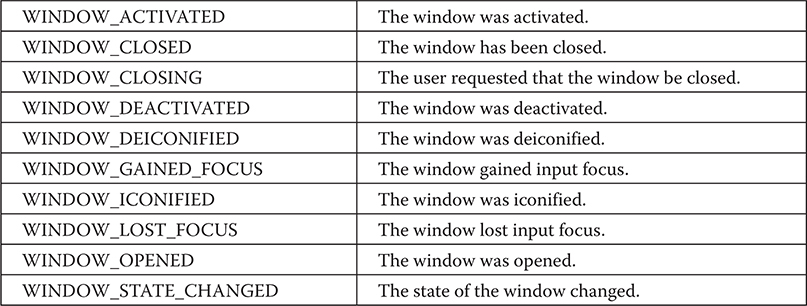
WindowEvent is a subclass of ComponentEvent. It defines several constructors. The first is
WindowEvent(Window src, int type)
Here, src is a reference to the object that generated this event. The type of the event is type.
The next three constructors offer more detailed control:
WindowEvent(Window src, int type, Window other)
WindowEvent(Window src, int type, int fromState, int toState)
WindowEvent(Window src, int type, Window other, int fromState, int toState)
Here, other specifies the opposite window when a focus or activation event occurs. The fromState specifies the prior state of the window, and toState specifies the new state that the window will have when a window state change occurs.
A commonly used method in this class is getWindow( ). It returns the Window object that generated the event. Its general form is shown here:
Window getWindow( )
WindowEvent also defines methods that return the opposite window (when a focus or activation event has occurred), the previous window state, and the current window state. These methods are shown here:
Window getOppositeWindow( )
int getOldState( )
int getNewState( )
Table 25-2 lists some of the user interface components that can generate the events described in the previous section. In addition to these graphical user interface elements, any class derived from Component, such as Frame, can generate events. For example, you can receive key and mouse events from an instance of Frame. In this chapter, we will be handling only mouse and keyboard events, but subsequent chapters will be handling events from a variety of sources.
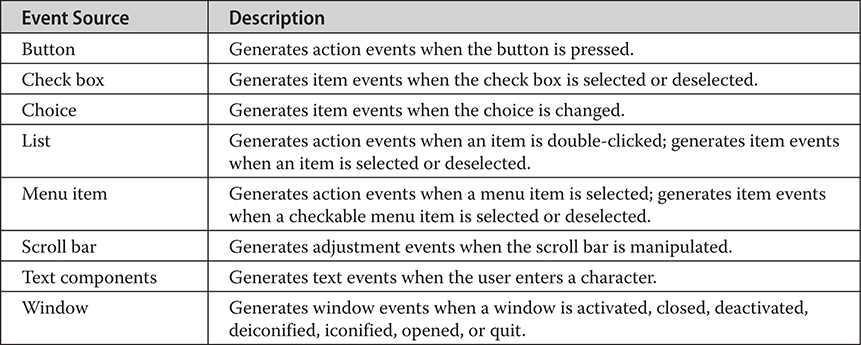
Table 25-2 Event Source Examples
As explained, the delegation event model has two parts: sources and listeners. As it relates to this chapter, listeners are created by implementing one or more of the interfaces defined by the java.awt.event package. When an event occurs, the event source invokes the appropriate method defined by the listener and provides an event object as its argument. Table 25-3 lists several commonly used listener interfaces and provides a brief description of the methods that they define. The following sections examine the specific methods that are contained in each interface.
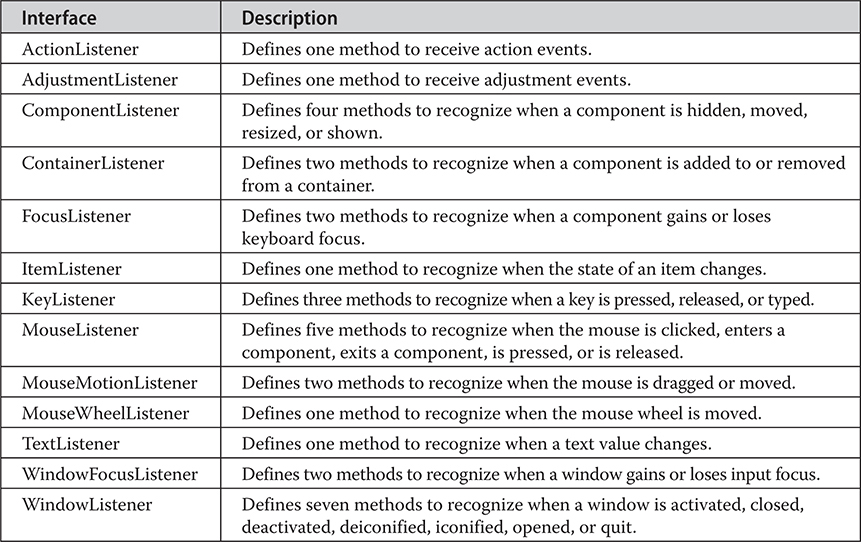
Table 25-3 Commonly Used Event Listener Interfaces
This interface defines the actionPerformed( ) method that is invoked when an action event occurs. Its general form is shown here:
void actionPerformed(ActionEvent ae)
This interface defines the adjustmentValueChanged( ) method that is invoked when an adjustment event occurs. Its general form is shown here:
void adjustmentValueChanged(AdjustmentEvent ae)
This interface defines four methods that are invoked when a component is resized, moved, shown, or hidden. Their general forms are shown here:
void componentResized(ComponentEvent ce)
void componentMoved(ComponentEvent ce)
void componentShown(ComponentEvent ce)
void componentHidden(ComponentEvent ce)
This interface contains two methods. When a component is added to a container, componentAdded( ) is invoked. When a component is removed from a container, componentRemoved( ) is invoked. Their general forms are shown here:
void componentAdded(ContainerEvent ce)
void componentRemoved(ContainerEvent ce)
This interface defines two methods. When a component obtains keyboard focus, focusGained( ) is invoked. When a component loses keyboard focus, focusLost( ) is called. Their general forms are shown here:
void focusGained(FocusEvent fe)
void focusLost(FocusEvent fe)
This interface defines the itemStateChanged( ) method that is invoked when the state of an item changes. Its general form is shown here:
void itemStateChanged(ItemEvent ie)
This interface defines three methods. The keyPressed( ) and keyReleased( ) methods are invoked when a key is pressed and released, respectively. The keyTyped( ) method is invoked when a character has been entered.
For example, if a user presses and releases the A key, three events are generated in sequence: key pressed, typed, and released. If a user presses and releases the HOME key, two key events are generated in sequence: key pressed and released.
The general forms of these methods are shown here:
void keyPressed(KeyEvent ke)
void keyReleased(KeyEvent ke)
void keyTyped(KeyEvent ke)
This interface defines five methods. If the mouse is pressed and released at the same point, mouseClicked( ) is invoked. When the mouse enters a component, the mouseEntered( ) method is called. When it leaves, mouseExited( ) is called. The mousePressed( ) and mouseReleased( ) methods are invoked when the mouse is pressed and released, respectively.
The general forms of these methods are shown here:
void mouseClicked(MouseEvent me)
void mouseEntered(MouseEvent me)
void mouseExited(MouseEvent me)
void mousePressed(MouseEvent me)
void mouseReleased(MouseEvent me)
This interface defines two methods. The mouseDragged( ) method is called multiple times as the mouse is dragged. The mouseMoved( ) method is called multiple times as the mouse is moved. Their general forms are shown here:
void mouseDragged(MouseEvent me)
void mouseMoved(MouseEvent me)
This interface defines the mouseWheelMoved( ) method that is invoked when the mouse wheel is moved. Its general form is shown here:
void mouseWheelMoved(MouseWheelEvent mwe)
This interface defines the textValueChanged( ) method that is invoked when a change occurs in a text area or text field. Its general form is shown here:
void textValueChanged(TextEvent te)
This interface defines two methods: windowGainedFocus( ) and windowLostFocus( ). These are called when a window gains or loses input focus. Their general forms are shown here:
void windowGainedFocus(WindowEvent we)
void windowLostFocus(WindowEvent we)
This interface defines seven methods. The windowActivated( ) and windowDeactivated( ) methods are invoked when a window is activated or deactivated, respectively. If a window is iconified, the windowIconified( ) method is called. When a window is deiconified, the windowDeiconified( ) method is called. When a window is opened or closed, the windowOpened( ) or windowClosed( ) methods are called, respectively. The windowClosing( ) method is called when a window is being closed. The general forms of these methods are
void windowActivated(WindowEvent we)
void windowClosed(WindowEvent we)
void windowClosing(WindowEvent we)
void windowDeactivated(WindowEvent we)
void windowDeiconified(WindowEvent we)
void windowIconified(WindowEvent we)
void windowOpened(WindowEvent we)
Now that you have learned the theory behind the delegation event model and have had an overview of its various components, it is time to see it in practice. Using the delegation event model is actually quite easy. Just follow these two steps:
1. Implement the appropriate interface in the listener so that it can receive the type of event desired.
2. Implement code to register and unregister (if necessary) the listener as a recipient for the event notifications.
Remember that a source may generate several types of events. Each event must be registered separately. Also, an object may register to receive several types of events, but it must implement all of the interfaces that are required to receive these events. In all cases, an event handler must return quickly. As explained earlier, an event handler must not retain control for an extended period of time.
To see how the delegation model works in practice, we will look at examples that handle two common event generators: the mouse and keyboard.
To demonstrate the fundamentals of event handling, we will use several simple, GUI-based programs. As stated earlier, most events to which your program will respond will be generated by user interaction with GUI programs. Although the GUI programs shown in this chapter are very simple, it is still necessary to explain a few key concepts because GUI-based programs differ from the console-based programs found in many other parts of this book.
Before we begin, it is important to point out that all modern versions of Java support two GUI frameworks: the AWT and Swing. The AWT was Java’s first GUI framework, and for very limited GUI programs, it is the easiest to use. Swing, which is built on the foundation of the AWT, was Java’s second GUI framework and is its most popular and widely used. (A third Java GUI called JavaFX was provided with several recent versions of Java. However, beginning JDK 11, it is no longer part of the JDK.) Both the AWT and Swing are discussed later in this book. However, to demonstrate the fundamentals of event handling, simple AWT-based GUI programs are an appropriate choice and are used here.
There are four key AWT features used by the following programs. First, all create a top-level window by extending the Frame class. Frame defines what one would think of as a “normal” window. For example, it has minimize, maximize, and close boxes. It can be resized, covered, and redisplayed. Second, all override the paint( ) method to display output in the window. This method is called by the run-time system to display output in the window. For example, it is called when a window is first shown and after a window has been hidden and then uncovered. Third, when your program needs output displayed, it does not call paint( ) directly. Instead, you call repaint( ). In essence, repaint( ) tells the AWT to call paint( ). You will see how the process works in the examples that follow. Finally, when the top-level Frame window for an application is closed—for example, by clicking its close box—the program must explicitly exit, often through a call to System.exit( ). Clicking the close box, by itself, does not cause the program to terminate. Therefore, it is necessary for an AWT-based GUI program to handle a window-close event.
To handle mouse events, you must implement the MouseListener and the MouseMotionListener interfaces. (You may also want to implement MouseWheelListener, but we won’t be doing so, here.) The following program demonstrates the process. It displays the current coordinates of the mouse in the program’s window. Each time a button is pressed, the phrase “Button Down” is displayed at the location of the mouse pointer. Each time the button is released, the phrase “Button Released” is shown. If a button is clicked, a message stating this fact is displayed at the current mouse location.
As the mouse enters or exits the window, a message is displayed that indicates what happened. When dragging the mouse, a * is shown, which tracks with the mouse pointer as it is dragged. Notice that the two variables, mouseX and mouseY, store the location of the mouse when a mouse pressed, released, or dragged event occurs. These coordinates are then used by paint( ) to display output at the point of these occurrences.
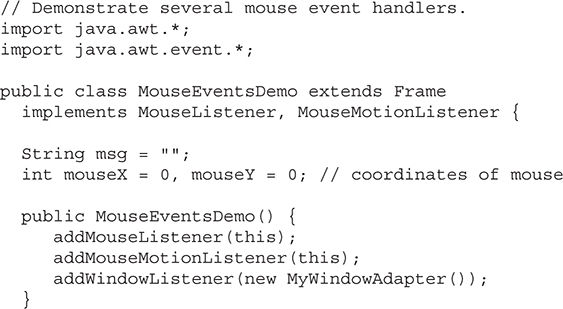
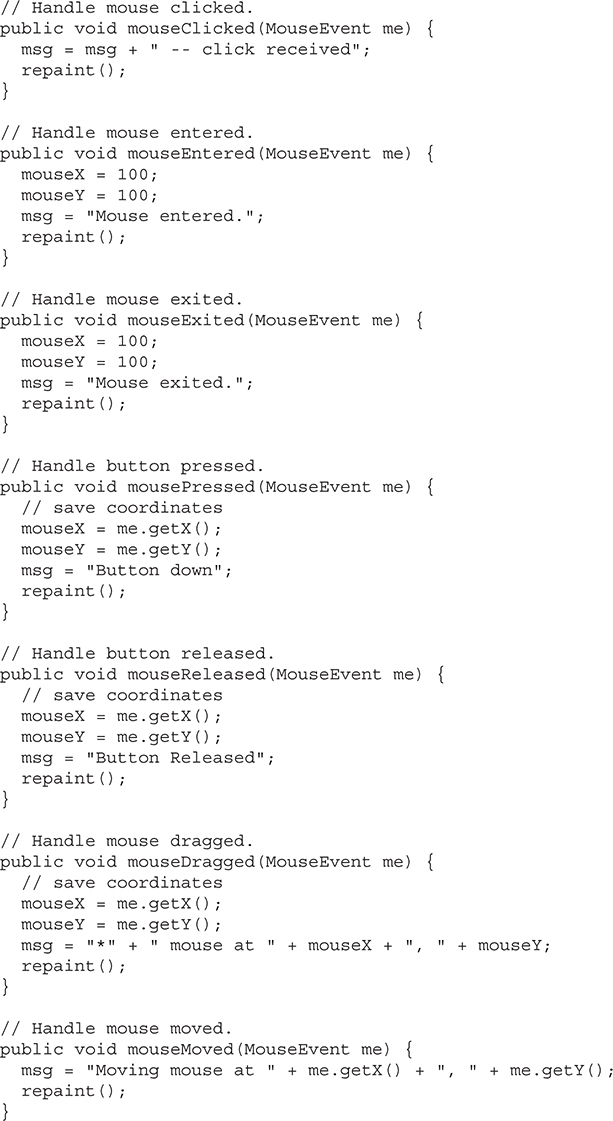
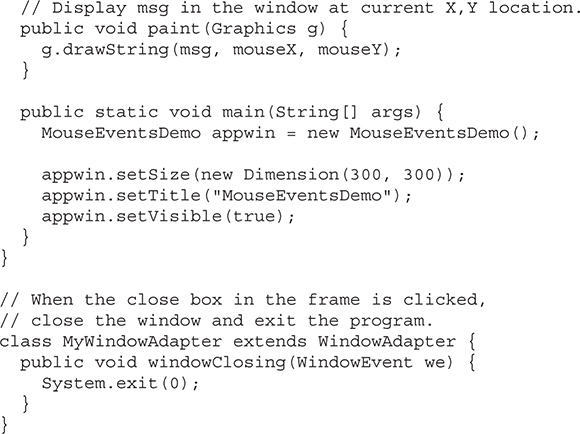
Sample output from this program is shown here:
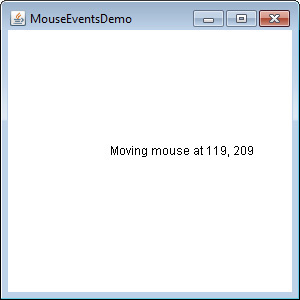
Let’s look closely at this example. First, notice that MouseEventsDemo extends Frame. Thus, it forms the top-level window for the application. Next, notice that it implements both the MouseListener and MouseMotionListener interfaces. These two interfaces contain methods that receive and process various types of mouse events. Notice that MouseEventsDemo is both the source and the listener for these events. This works because Frame supplies the addMouseListener( ) and addMouseMotionListener( ) methods. Being both the source and the listener for events is not uncommon for simple GUI programs.
Inside the MouseEventsDemo constructor, the program registers itself as a listener for mouse events. This is done by calling addMouseListener( ) and addMouseMotionListener( ). They are shown here:
void addMouseListener(MouseListener ml)
void addMouseMotionListener(MouseMotionListener mml)
Here, ml is a reference to the object receiving mouse events, and mml is a reference to the object receiving mouse motion events. In this program, the same object is used for both. MouseEventsDemo then implements all of the methods defined by the MouseListener and MouseMotionListener interfaces. These are the event handlers for the various mouse events. Each method handles its event and then returns.
Notice that the MouseEventsDemo constructor also adds a WindowListener. This is needed to enable the program to respond to a window close event when the user clicks the close box. This listener uses an adapter class to implement the WindowListener interface. Adapter classes supply empty implementations of a listener interface, enabling you to override only the method or methods in which you are interested. They are described in detail later in this chapter, but one is used here to greatly simplify the code needed to close the program. In this case, the windowClosing( ) method is overridden. This method is called by the AWT when the window is closed. Here, it calls System.exit( ) to end the program.
Now notice the mouse event handlers. Each time a mouse event occurs, msg is assigned a string that describes what happened and then repaint( ) is called. In this case, repaint( ) ultimately causes the AWT to call paint( ) to display output. (This process is examined in greater detail in Chapter 26.) Notice that paint( ) has a parameter of type Graphics. This class describes the graphics context of the program. It is required for output. The program uses the drawString( ) method provided by Graphics to actually display a string in the window at the specified X, Y location. The form used in the program is shown here:
void drawString(String message, int x, int y)
Here, message is the string to be output beginning at x, y. In a Java window, the upper-left corner is location 0,0. As mentioned, mouseX and mouseY keep track of the location of the mouse. These values are passed to drawString( ) as the location at which output is displayed.
Finally, the program is started by creating a MouseEventsDemo instance and then setting the size of the window, its title, and making the window visible. These features are described in greater detail in Chapter 26.
To handle keyboard events, you use the same general architecture as that shown in the mouse event example in the preceding section. The difference, of course, is that you will be implementing the KeyListener interface.
Before looking at an example, it is useful to review how key events are generated. When a key is pressed, a KEY_PRESSED event is generated. This results in a call to the keyPressed( ) event handler. When the key is released, a KEY_RELEASED event is generated and the keyReleased( ) handler is executed. If a character is generated by the keystroke, then a KEY_TYPED event is sent and the keyTyped( ) handler is invoked. Thus, each time the user presses a key, at least two and often three events are generated. If all you care about are actual characters, then you can ignore the information passed by the key press and release events. However, if your program needs to handle special keys, such as the arrow or function keys, then it must watch for them through the keyPressed( ) handler.
The following program demonstrates keyboard input. It echoes keystrokes to the window and shows the pressed/released status of each key.
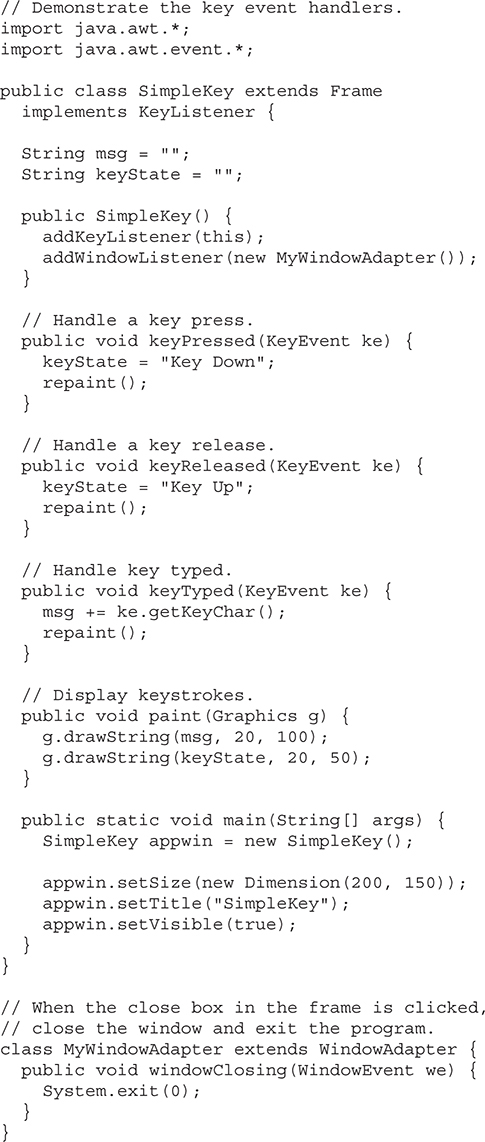
Sample output is shown here:
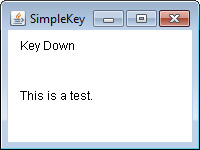
If you want to handle the special keys, such as the arrow or function keys, you need to respond to them within the keyPressed( ) handler. They are not available through keyTyped( ). To identify the keys, you use their virtual key codes. For example, the next program outputs the name of a few of the special keys:
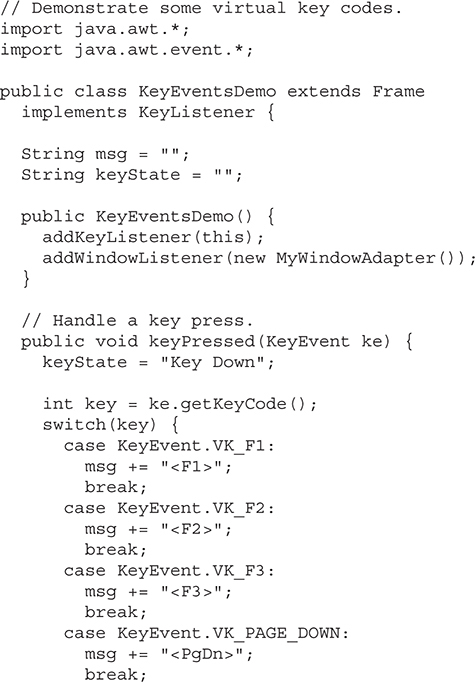
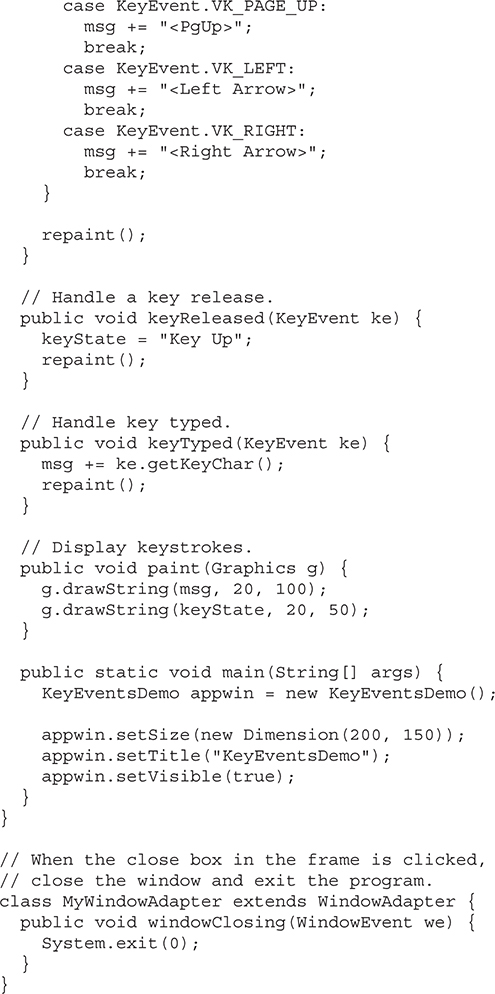
Sample output is shown here:
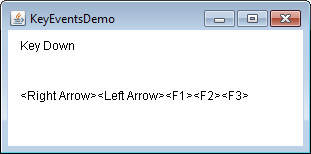
The procedures shown in the preceding keyboard and mouse event examples can be generalized to any type of event handling, including those events generated by controls. In later chapters, you will see many examples that handle other types of events, but they will all follow the same basic structure as the programs just described.
Java provides a special feature, called an adapter class, that can simplify the creation of event handlers in certain situations. An adapter class provides an empty implementation of all methods in an event listener interface. Adapter classes are useful when you want to receive and process only some of the events that are handled by a particular event listener interface. You can define a new class to act as an event listener by extending one of the adapter classes and implementing only those events in which you are interested.
For example, the MouseMotionAdapter class has two methods, mouseDragged( ) and mouseMoved( ), which are the methods defined by the MouseMotionListener interface. If you were interested in only mouse drag events, then you could simply extend MouseMotionAdapter and override mouseDragged( ). The empty implementation of mouseMoved( ) would handle the mouse motion events for you.
Table 25-4 lists several commonly used adapter classes in java.awt.event and notes the interface that each implements.
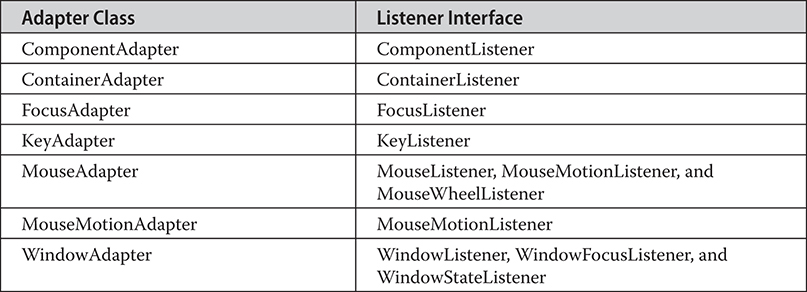
Table 25-4 Commonly Used Listener Interfaces Implemented by Adapter Classes
You have already seen one adapter class in action in the preceding examples: WindowAdapter. Recall that the WindowListener interface defines seven methods, but only one, windowClosing( ), was needed by the programs. The use of the adapter prevented the need to provide empty implementations of the other unused methods, thus avoiding clutter in the examples. As you would expect, the other adapter classes can be employed in a similar fashion.
The following program provides another example of an adapter. It uses MouseAdapter to respond to mouse click and mouse drag events. As shown in Table 25-4, MouseAdapter implements all of the mouse listener interfaces. Thus, you can use it to handle all types of mouse events. Of course, you need override only those methods that are used by your program. In the following example, MyMouseAdapter extends MouseAdapter and overrides the mouseClicked( ) and mouseDragged( ) methods. All other mouse events are silently ignored. Notice that the MyMouseAdapter constructor is passed a reference to the AdapterDemo instance. This reference is saved and then used to assign a string to msg and to invoke repaint( ) on the object that receives the event notification. As before, a WindowAdapter is used to handle a window closing event.
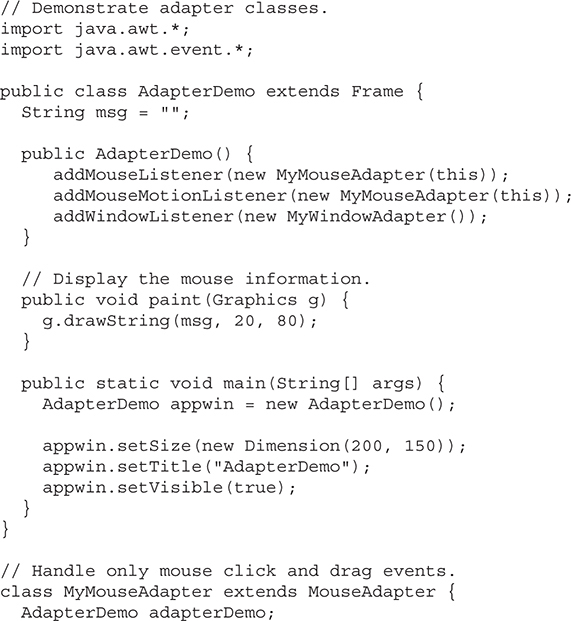
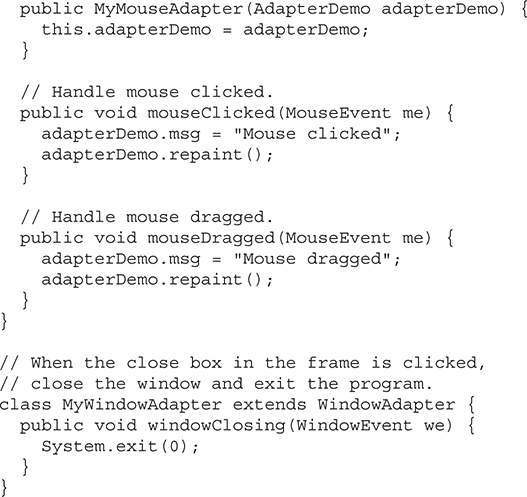
As you can see by looking at the program, not having to implement all of the methods defined by the MouseMotionListener, MouseListener, and MouseWheelListener interfaces saves you a considerable amount of effort and prevents your code from becoming cluttered with empty methods. As an exercise, you might want to try rewriting one of the keyboard input examples shown earlier so that it uses a KeyAdapter.
In Chapter 7, the basics of inner classes were explained. Here, you will see why they are important. Recall that an inner class is a class defined within another class, or even within an expression. This section illustrates how inner classes can be used to simplify the code when using event adapter classes.
To understand the benefit provided by inner classes, consider the program shown in the following listing. It does not use an inner class. Its goal is to display the string "Mouse Pressed" when the mouse is pressed. Similar to the approach used by the preceding example, a reference to the MousePressedDemo instance is passed to the MyMouseAdapter constructor and saved. This reference is used to assign a string to msg and invoke repaint( ) on the object that received the event.
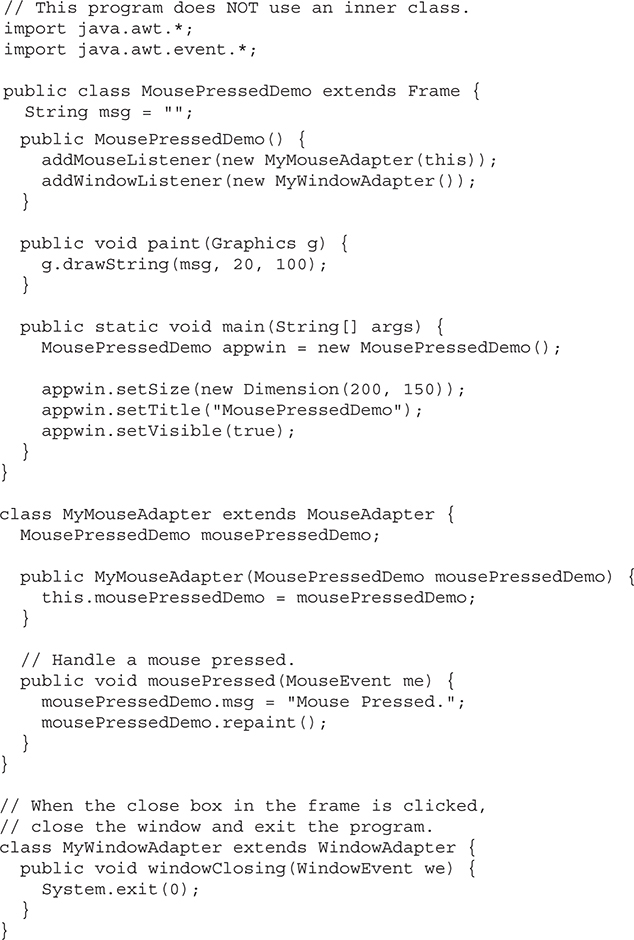
The following listing shows how the preceding program can be improved by using an inner class. Here, InnerClassDemo is the top-level class and MyMouseAdapter is an inner class. Because MyMouseAdapter is defined within the scope of InnerClassDemo, it has access to all of the variables and methods within the scope of that class. Therefore, the mousePressed( ) method can call the repaint( ) method directly. It no longer needs to do this via a stored reference. The same applies to assigning a value to msg. Thus, it is no longer necessary to pass MyMouseAdapter( ) a reference to the invoking object. Also notice that MyWindowAdapter has been made into an inner class.
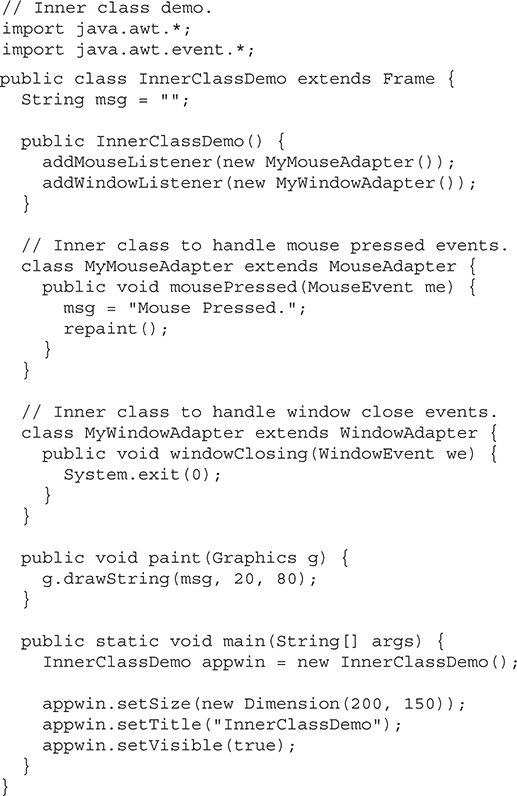
An anonymous inner class is one that is not assigned a name. This section illustrates how an anonymous inner class can facilitate the writing of event handlers. Consider the program shown in the following listing. As before, its goal is to display the string "Mouse Pressed" when the mouse is pressed.
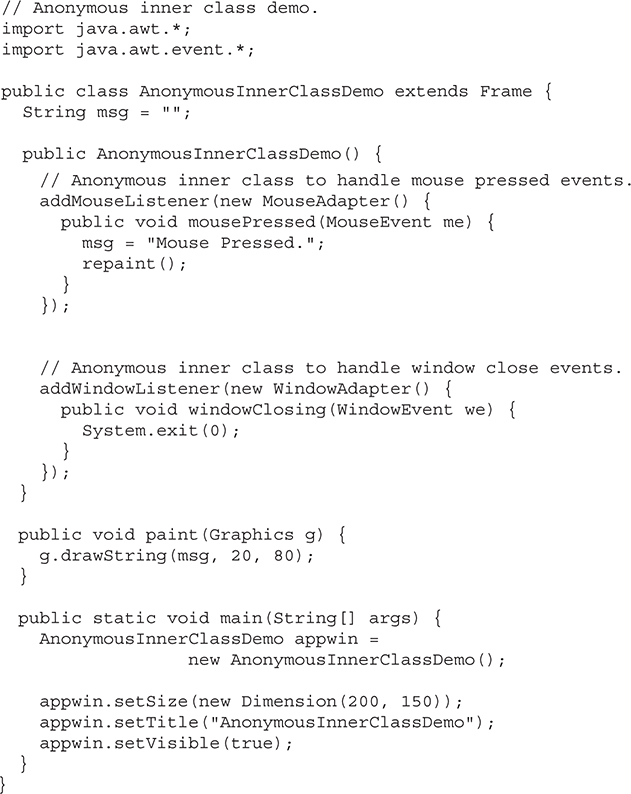
There is one top-level class in this program: AnonymousInnerClassDemo. Its constructor calls the addMouseListener( ) method. Its argument is an expression that defines and instantiates an anonymous inner class. Let’s analyze this expression carefully.
The syntax new MouseAdapter(){...} indicates to the compiler that the code between the braces defines an anonymous inner class. Furthermore, that class extends MouseAdapter. This new class is not named, but it is automatically instantiated when this expression is executed. This syntax can be generalized and is the same when creating other anonymous classes, such as when an anonymous WindowAdapter is created by the program.
Because this anonymous inner class is defined within the scope of AnonymousInnerClassDemo, it has access to all of the variables and methods within the scope of that class. Therefore, it can call the repaint( ) method and access msg directly.
As just illustrated, both named and anonymous inner classes solve some annoying problems in a simple yet effective way. They also allow you to create more efficient code.
The Abstract Window Toolkit (AWT) was Java’s first GUI framework, and it has been part of Java since version 1.0. It contains numerous classes and methods that allow you to create windows and simple controls. The AWT was introduced in Chapter 25, where it was used in several short examples that demonstrated event handling. This chapter begins a more detailed examination. Here, you will learn how to manage windows, work with fonts, output text, and utilize graphics. Chapter 27 describes various AWT controls, layout managers, and menus. It also explains further aspects of Java’s event handling mechanism. Chapter 28 introduces the AWT’s imaging subsystem.
It is important to state at the outset that you will seldom create GUIs based solely on the AWT because more powerful GUI frameworks (such as Swing, described later in this book) have been developed for Java. Despite this fact, the AWT remains an important part of Java. To understand why, consider the following.
At the time of this writing, the framework that is most widely used is Swing. Because Swing provides a richer, more flexible GUI framework than does the AWT, it is easy to jump to the conclusion that the AWT is no longer relevant—that it has been fully superseded by Swing. This assumption is, however, false. Instead, an understanding of the AWT is still important because the AWT underpins Swing, with many AWT classes being used either directly or indirectly by Swing. As a result, a solid knowledge of the AWT is still required to use Swing effectively. Also, for some types of small programs that make only minimal use of a GUI, using the AWT may still be appropriate. Therefore, even though the AWT constitutes Java’s oldest GUI framework, a basic working knowledge of its fundamentals is still important today.
One last point before beginning: The AWT is quite large and a full description would easily fill an entire book. Therefore, it is not possible to describe in detail every AWT class, method, or instance variable. However, this and the following chapters explain the basic techniques needed to use the AWT. From there, you will be able to explore other parts of the AWT on your own. You will also be ready to move on to Swing.
Note If you have not yet read Chapter 25, please do so now. It provides an overview of event handling, which is used by many of the examples in this chapter.
The AWT classes are contained in the java.awt package. It is one of Java’s largest packages. Fortunately, because it is logically organized in a top-down, hierarchical fashion, it is easier to understand and use than you might at first believe. Beginning with JDK 9, java.awt is part of the java.desktop module. Table 26-1 lists some of the many AWT classes.
Although the basic structure of the AWT has been the same since Java 1.0, some of the original methods were deprecated and replaced by new ones. For backward-compatibility, Java still supports all the original 1.0 methods. However, because these methods are not for use with new code, this book does not describe them.
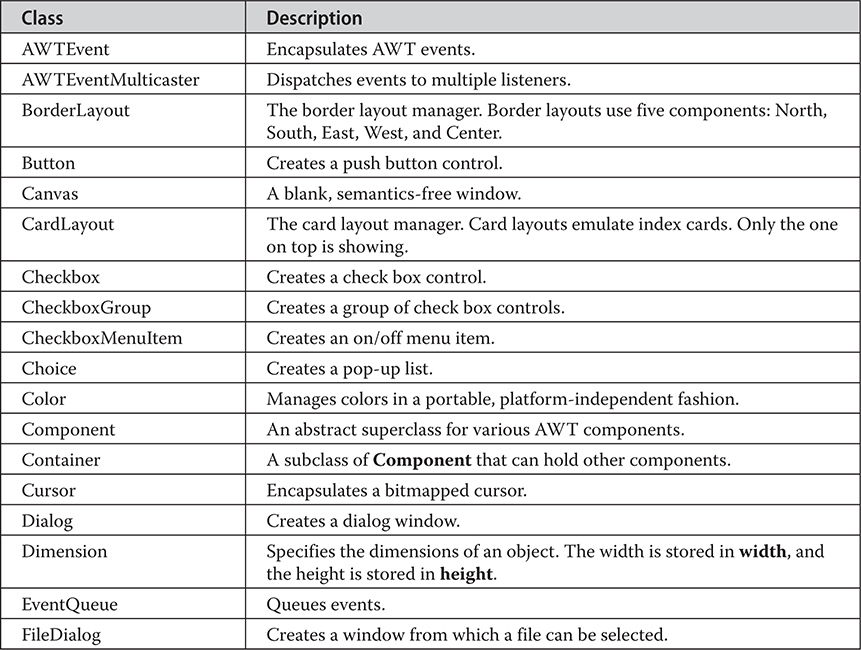
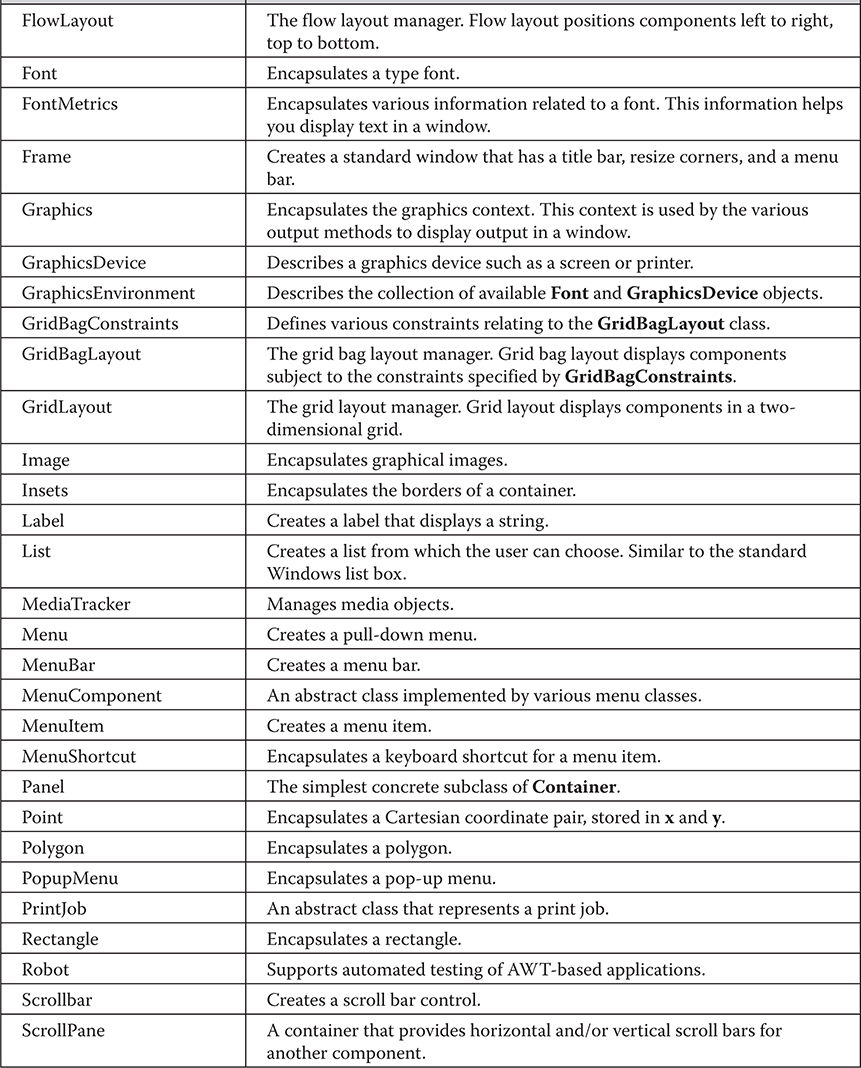

Table 26-1 A Sampling of AWT Classes
The AWT defines windows according to a class hierarchy that adds functionality and specificity with each level. Arguably the two most important window-related classes are Frame and Panel. Frame encapsulates a top-level window and it is typically used to create what would be thought of as a standard application window. Panel provides a container to which other components can be added. (Panel is also a superclass for Applet, which has been deprecated since JDK 9.) Much of the functionality of Frame and Panel is derived from their parent classes. Thus, a description of the class hierarchies relating to these two classes is fundamental to their understanding. Figure 26-1 shows the class hierarchy for Panel and Frame. Let’s look at each of these classes now.
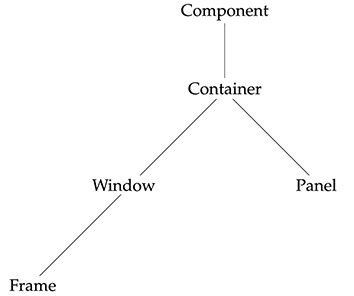
Figure 26-1 The class hierarchy for Panel and Frame
At the top of the AWT hierarchy is the Component class. Component is an abstract class that encapsulates all of the attributes of a visual component. Except for menus, all user interface elements that are displayed on the screen and that interact with the user are subclasses of Component. It defines over a hundred public methods that are responsible for managing events, such as mouse and keyboard input, positioning and sizing the window, and repainting. A Component object is responsible for remembering the current foreground and background colors and the currently selected text font.
The Container class is a subclass of Component. It has additional methods that allow other Component objects to be nested within it. Other Container objects can be stored inside of a Container (since they are themselves instances of Component). This makes for a multileveled containment system. A container is responsible for laying out (that is, positioning) any components that it contains. It does this through the use of various layout managers, which you will learn about in Chapter 27.
The Panel class is a concrete subclass of Container. A Panel may be thought of as a recursively nestable, concrete screen component. Other components can be added to a Panel object by its add( ) method (inherited from Container). Once these components have been added, you can position and resize them manually using the setLocation( ), setSize( ), setPreferredSize( ), or setBounds( ) methods defined by Component.
The Window class creates a top-level window. A top-level window is not contained within any other object; it sits directly on the desktop. Generally, you won’t create Window objects directly. Instead, you will use a subclass of Window called Frame, described next.
Frame encapsulates what is commonly thought of as a “window.” It is a subclass of Window and has a title bar, menu bar, borders, and resizing corners. The precise look of a Frame will differ among environments.
Although it is not part of the hierarchy for Panel or Frame, there is one other class that you will find valuable: Canvas. Derived from Component, Canvas encapsulates a blank window upon which you can draw. You will see an example of Canvas later in this book.
Typically, the type of AWT-based application window you will most often create is derived from Frame. As mentioned, it creates a standard-style, top-level window that has all of the features normally associated with an application window, such as a close box and title.
Here are two of Frame’s constructors:
Frame( ) throws HeadlessException
Frame(String title) throws HeadlessException
The first form creates a standard window that does not contain a title. The second form creates a window with the title specified by title. Notice that you cannot specify the dimensions of the window. Instead, you must set the size of the window after it has been created. A HeadlessException is thrown if an attempt is made to create a Frame instance in an environment that does not support user interaction.
There are several key methods you will use when working with Frame windows. They are examined here.
The setSize( ) method is used to set the dimensions of the window. It is shown here:
void setSize(int newWidth, int newHeight)
void setSize(Dimension newSize)
The new size of the window is specified by newWidth and newHeight, or by the width and height fields of the Dimension object passed in newSize. The dimensions are specified in terms of pixels.
The getSize( ) method is used to obtain the current size of a window. One of its forms is shown here:
Dimension getSize( )
This method returns the current size of the window contained within the width and height fields of a Dimension object.
After a frame window has been created, it will not be visible until you call setVisible( ). Its signature is shown here:
void setVisible(boolean visibleFlag)
The component is visible if the argument to this method is true. Otherwise, it is hidden.
You can change the title in a frame window using setTitle( ), which has this general form:
void setTitle(String newTitle)
Here, newTitle is the new title for the window.
When using a frame window, your program must remove that window from the screen when it is closed. If it is not the top-level window of your application, this is done by calling setVisible(false). For the main application window, you can simply terminate the program by calling System.exit( ) as the examples in Chapter 24 did. To intercept a window-close event, you must implement the windowClosing( ) method of the WindowListener interface. (See Chapter 25 for details on the WindowListener interface.)
As you saw in Chapter 25, output to a window typically occurs when the paint( ) method is called by the run-time system. This method is defined by Component and overridden by Container and Window. Thus, it is available to instances of Frame.
The paint( ) method is called each time an AWT-based application’s output must be redrawn. This situation can occur for several reasons. For example, the program’s window may be overwritten by another window and then uncovered. Or the window may be minimized and then restored. paint( ) is also called when the window is first displayed. Whatever the cause, whenever the window must redraw its output, paint( ) is called. This implies that your program must have some way to retain its output so that it can be redisplayed each time paint( ) executes.
The paint( ) method is shown here:
void paint(Graphics context)
The paint( ) method has one parameter of type Graphics. This parameter will contain the graphics context, which describes the graphics environment in which the program is running. This context is used whenever output to the window is required.
To output a string to a Frame, use drawString( ), which is a member of the Graphics class. It was introduced in Chapter 25, and we will be making extensive use of it here and in the next chapter. This is the form we will use:
void drawString(String message, int x, int y)
Here, message is the string to be output beginning at x,y. In a Java window, the upper-left corner is location 0,0. The drawString( ) method will not recognize newline characters. If you want to start a line of text on another line, you must do so manually, specifying the precise X,Y location where you want the line to begin. (As you will see in the next chapter, there are techniques that make this process easy.)
You can set both the foreground and background colors used by a Frame. To set the background color, use setBackground( ). To set the foreground color (the color in which text is shown, for example), use setForeground( ). These methods are defined by Component, and they have the following general forms:
void setBackground(Color newColor)
void setForeground(Color newColor)
Here, newColor specifies the new color. The class Color defines the constants shown here that can be used to specify colors. (Uppercase versions of these constants are also provided.)

For example, the following sets the background color to green and the foreground color to red:
setBackground(Color.green);
setForeground(Color.red);
You can also create custom colors. A good place to initially set the foreground and background colors is in the constructor for the frame. Of course, you can change these colors as often as necessary during the execution of your program.
You can obtain the current settings for the background and foreground colors by calling getBackground( ) and getForeground( ), respectively. They are also defined by Component and are shown here:
Color getBackground( )
Color getForeground( )
As a general rule, an application writes to its window only when its paint( ) method is called by the AWT. This raises an interesting question: How can the program itself cause its window to be updated to display new output? For example, if a program displays a moving banner, what mechanism does it use to update the window each time the banner scrolls? Remember, one of the fundamental architectural constraints imposed on a GUI program is that it must quickly return control to the run-time system. It cannot create a loop inside paint( ) that repeatedly scrolls the banner, for example. This would prevent control from passing back to the AWT. Given this constraint, it may seem that output to your window will be difficult at best. Fortunately, this is not the case. Whenever your program needs to update the information displayed in its window, it simply calls repaint( ).
The repaint( ) method is defined by Component. As it relates to Frame, this method causes the AWT run-time system to execute a call to the update( ) method (also defined by Component). However, the default implementation of update( ) calls paint( ). Thus, to output to a window, simply store the output and then call repaint( ). The AWT will then execute a call to paint( ), which can display the stored information. For example, if part of your program needs to output a string, it can store this string in a String variable and then call repaint( ). Inside paint( ), you will output the string using drawString( ).
The repaint( ) method has four forms. Let’s look at each one in turn. The simplest version of repaint( ) is shown here:
void repaint( )
This version causes the entire window to be repainted. The following version specifies a region that will be repainted:
void repaint(int left, int top, int width, int height)
Here, the coordinates of the upper-left corner of the region are specified by left and top, and the width and height of the region are passed in width and height. These dimensions are specified in pixels. You save time by specifying a region to repaint. Window updates are costly in terms of time. If you need to update only a small portion of the window, it is more efficient to repaint only that region.
Calling repaint( ) is essentially a request that a window be repainted sometime soon. However, if your system is slow or busy, update( ) might not be called immediately. Multiple requests for repainting that occur within a short time can be collapsed by the AWT in a manner such that update( ) is only called sporadically. This can be a problem in many situations, including animation, in which a consistent update time is necessary. One solution to this problem is to use the following forms of repaint( ):
void repaint(long maxDelay)
void repaint(long maxDelay, int x, int y, int width, int height)
Here, maxDelay specifies the maximum number of milliseconds that can elapse before update( ) is called.
Note It is possible for a method other than paint( ) or update( ) to output to a window. To do so, it must obtain a graphics context by calling getGraphics( ) (defined by Component) and then use this context to output to the window. However, for most applications, it is better and easier to route window output through paint( ) and to call repaint( ) when the contents of the window change.
While it is possible to simply create a window by creating an instance of Frame, you will seldom do so, because you would not be able to do much with it. For example, you would not be able to receive or process events that occur within it or easily output information to it. Therefore, to create a Frame-based application, you will normally create a subclass of Frame. Among other reasons, doing so lets you override paint( ) and provide event handling.
As the event handling examples in Chapter 25 illustrated, creating a new Frame-based application is actually quite easy. In general, you create a subclass of Frame, override paint( ) to supply your output to the window, and implement the necessary event listeners. In all cases, you will need to implement the windowClosing( ) method of the WindowListener interface. In a top-level frame, you will typically call System.exit( ) to terminate the program. To simply remove a secondary frame from the screen, you can call setVisible(false) when the window is closed.
Once you have defined a Frame subclass, you can create an instance of that class. This causes a frame window to come into existence, but it will not be initially visible. You make it visible by calling setVisible(true). When created, the window is given a default height and width. You can set the size of the window explicitly by calling the setSize( ) method. For a top-level frame, you will want to define its title.
The AWT includes several methods that support graphics. All graphics are drawn relative to a window. This can be the main window of an application or a child window. (These methods are also supported by Swing-based windows.) The origin of each window is at the top-left corner and is 0,0. Coordinates are specified in pixels. All output to a window takes place through a graphics context.
A graphics context is encapsulated by the Graphics class. Here are two ways in which a graphics context can be obtained:
• It is passed to a method, such as paint( ) or update( ), as an argument.
• It is returned by the getGraphics( ) method of Component.
Among other things, the Graphics class defines a number of methods that draw various types of objects, such as lines, rectangles, and arcs. In several cases, objects can be drawn edge-only or filled. Objects are drawn and filled in the currently selected color, which is black by default. When a graphics object is drawn that exceeds the dimensions of the window, output is automatically clipped. A sampling of the drawing methods supported by Graphics is presented here.
Note A number of years ago, the graphics capabilities of Java were expanded by the inclusion of several new classes. One of these is Graphics2D, which extends Graphics. Graphics2D supports several enhancements to the basic capabilities provided by Graphics. To gain access to this extended functionality, you must cast the graphics context obtained from a method such as paint( ), to Graphics2D. Although the basic graphics functions supported by Graphics are adequate for the purposes of this book, Graphics2D is a class that you may want to explore fully on your own.
Lines are drawn by means of the drawLine( ) method, shown here:
void drawLine(int startX, int startY, int endX, int endY )
drawLine( ) displays a line in the current drawing color that begins at startX, startY and ends at endX, endY.
The drawRect( ) and fillRect( ) methods display an outlined and filled rectangle, respectively. They are shown here:
void drawRect(int left, int top, int width, int height)
void fillRect(int left, int top, int width, int height)
The upper-left corner of the rectangle is at left, top. The dimensions of the rectangle are specified by width and height.
To draw a rounded rectangle, use drawRoundRect( ) or fillRoundRect( ), both shown here:
void drawRoundRect(int left, int top, int width, int height,
int xDiam, int yDiam)
void fillRoundRect(int left, int top, int width, int height,
int xDiam, int yDiam)
A rounded rectangle has rounded corners. The upper-left corner of the rectangle is at left, top. The dimensions of the rectangle are specified by width and height. The diameter of the rounding arc along the X axis is specified by xDiam. The diameter of the rounding arc along the Y axis is specified by yDiam.
To draw an ellipse, use drawOval( ). To fill an ellipse, use fillOval( ). These methods are shown here:
void drawOval(int left, int top, int width, int height)
void fillOval(int left, int top, int width, int height)
The ellipse is drawn within a bounding rectangle whose upper-left corner is specified by left, top and whose width and height are specified by width and height. To draw a circle, specify a square as the bounding rectangle.
Arcs can be drawn with drawArc( ) and fillArc( ), shown here:
void drawArc(int left, int top, int width, int height, int startAngle,
int sweepAngle)
void fillArc(int left, int top, int width, int height, int startAngle,
int sweepAngle)
The arc is bounded by the rectangle whose upper-left corner is specified by left, top and whose width and height are specified by width and height. The arc is drawn from startAngle through the angular distance specified by sweepAngle. Angles are specified in degrees. Zero degrees is on the horizontal, at the three o’clock position. The arc is drawn counterclockwise if sweepAngle is positive, and clockwise if sweepAngle is negative. Therefore, to draw an arc from twelve o’clock to six o’clock, the start angle would be 90 and the sweep angle 180.
It is possible to draw arbitrarily shaped figures using drawPolygon( ) and fillPolygon( ), shown here:
void drawPolygon(int[ ] x, int[ ] y, int numPoints)
void fillPolygon(int[ ] x, int[ ] y, int numPoints)
The polygon’s endpoints are specified by the coordinate pairs contained within the x and y arrays. The number of points defined by these arrays is specified by numPoints. There are alternative forms of these methods in which the polygon is specified by a Polygon object.
The following program demonstrates the drawing methods just described.
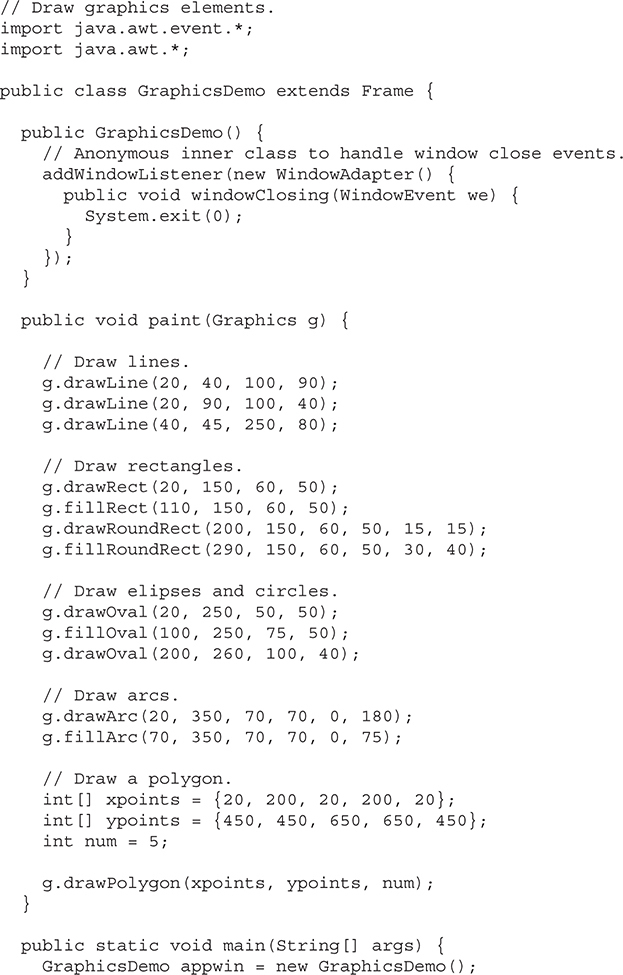

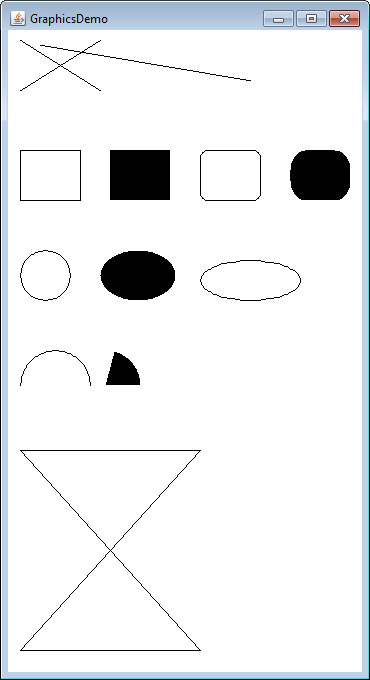
Figure 26-1 Sample output from the GraphicsDemo program
Sample output is shown in Figure 26-1.
Often, you will want to size a graphics object to fit the current size of the frame in which it is drawn. To do so, first obtain the current dimensions of the frame by calling getSize( ). It returns the dimensions as integer values stored in the width and height fields of a Dimension instance. However, the dimensions returned by getSize( ) reflect the overall size of the frame, including border and title bar. To obtain the dimensions of the paintable area, you will need to reduce the size obtained from getSize( ) by the dimensions of the border/title bar. The values that describe the size of the border/title region are called insets. The inset values are obtained by calling getInsets( ), shown here:
Insets getInsets( )
It returns an Insets object that encapsulates the insets dimensions as four int values called left, right, top, and bottom. Therefore, the coordinate of the top-left corner of the paintable area is left, top. The coordinate of the bottom-right corner is width–right, height–bottom. Once you have both the size and insets, you can scale your graphical output accordingly.
To demonstrate this technique, here is a program whose frame starts with dimensions 200 × 200 pixels. It grows by 25 in both width and height each time the mouse is clicked until the size is larger than 500 × 500. At that point, the next click will return it to 200 × 200, and the process starts over. Within the paintable area, an X is drawn so that it fills the region.
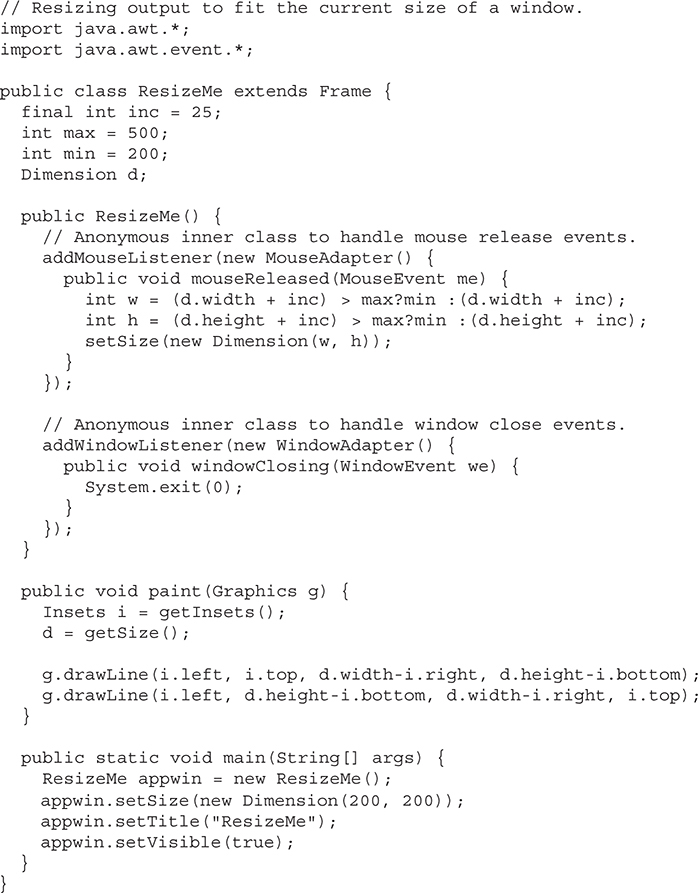
Java supports color in a portable, device-independent fashion. The AWT color system allows you to specify any color you want. It then finds the best match for that color, given the limits of the display hardware currently executing your program. Thus, your code does not need to be concerned with the differences in the way color is supported by various hardware devices. Color is encapsulated by the Color class.
As you saw earlier, Color defines several constants (for example, Color.black) to specify a number of common colors. You can also create your own colors, using one of the Color constructors. Three commonly used forms are shown here:
Color(int red, int green, int blue)
Color(int rgbValue)
Color(float red, float green, float blue)
The first constructor takes three integers that specify the color as a mix of red, green, and blue. These values must be between 0 and 255, as in this example:
new Color(255, 100, 100); // light red
The second color constructor takes a single integer that contains the mix of red, green, and blue packed into an integer. The integer is organized with red in bits 16 to 23, green in bits 8 to 15, and blue in bits 0 to 7. Here is an example of this constructor:
int newRed = (0xff000000 | (0xc0 << 16) | (0x00 << 8) | 0x00);
Color darkRed = new Color(newRed);
The third constructor, Color(float, float, float), takes three float values (between 0.0 and 1.0) that specify the relative mix of red, green, and blue.
Once you have created a color, you can use it to set the foreground and/or background color by using the setForeground( ) and setBackground( ) methods as mentioned earlier. You can also select it as the current drawing color.
The Color class defines several methods that help manipulate colors. Several are examined here.
The hue-saturation-brightness (HSB) color model is an alternative to red-green-blue (RGB) for specifying particular colors. Figuratively, hue is a wheel of color. The hue can be specified with a number between 0.0 and 1.0, which is used to obtain an angle into the color wheel. (The principal colors are approximately red, orange, yellow, green, blue, indigo, and violet.) Saturation is another scale ranging from 0.0 to 1.0, representing light pastels to intense hues. Brightness values also range from 0.0 to 1.0, where 1 is bright white and 0 is black. Color supplies two methods that let you convert between RGB and HSB. They are shown here:
static int HSBtoRGB(float hue, float saturation, float brightness)
static float[ ] RGBtoHSB(int red, int green, int blue, float[ ] values)
HSBtoRGB( ) returns a packed RGB value compatible with the Color(int) constructor. RGBtoHSB( ) returns a float array of HSB values corresponding to RGB integers. If values is not null, then this array is given the HSB values and returned. Otherwise, a new array is created and the HSB values are returned in it. In either case, the array contains the hue at index 0, saturation at index 1, and brightness at index 2.
You can obtain the red, green, and blue components of a color independently using getRed( ), getGreen( ), and getBlue( ), shown here:
int getRed( )
int getGreen( )
int getBlue( )
Each of these methods returns the RGB color component found in the invoking Color object in the lower 8 bits of an integer.
To obtain a packed, RGB representation of a color, use getRGB( ), shown here:
int getRGB( )
The return value is organized as described earlier.
By default, graphics objects are drawn in the current foreground color. You can change this color by calling the Graphics method setColor( ):
void setColor(Color newColor)
Here, newColor specifies the new drawing color.
You can obtain the current color by calling getColor( ), shown here:
Color getColor( )
The following program constructs several colors and draws various objects using these colors:
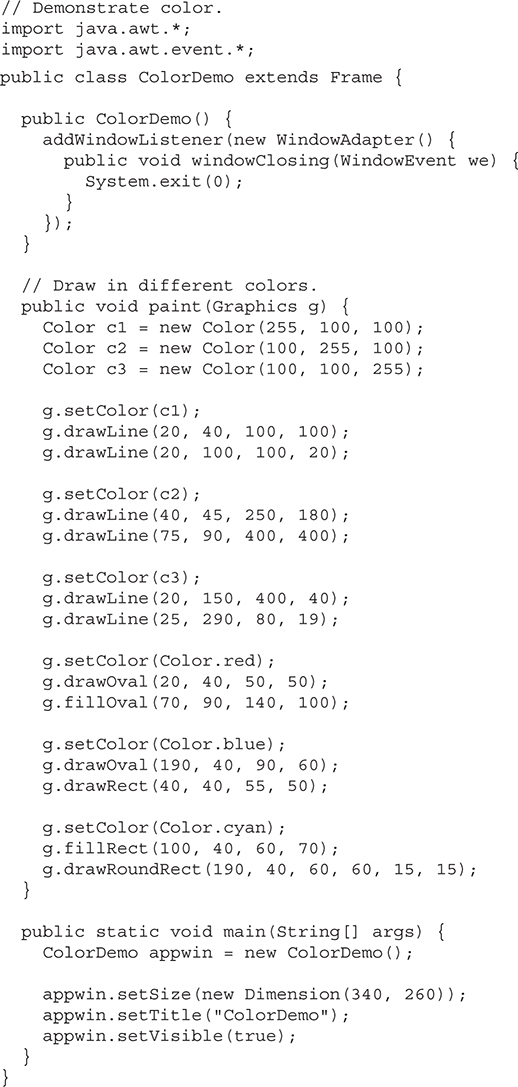
The paint mode determines how objects are drawn in a window. By default, new output to a window overwrites any preexisting contents. However, it is possible to have new objects XORed onto the window by using setXORMode( ), as follows:
void setXORMode(Color xorColor)
Here, xorColor specifies the color that will be XORed to the window when an object is drawn. The advantage of XOR mode is that the new object is always guaranteed to be visible no matter what color the object is drawn over.
To return to overwrite mode, call setPaintMode( ), shown here:
void setPaintMode( )
In general, you will want to use overwrite mode for normal output, and XOR mode for special purposes. For example, the following program displays cross hairs that track the mouse pointer. The cross hairs are XORed onto the window and are always visible, no matter what the underlying color is.
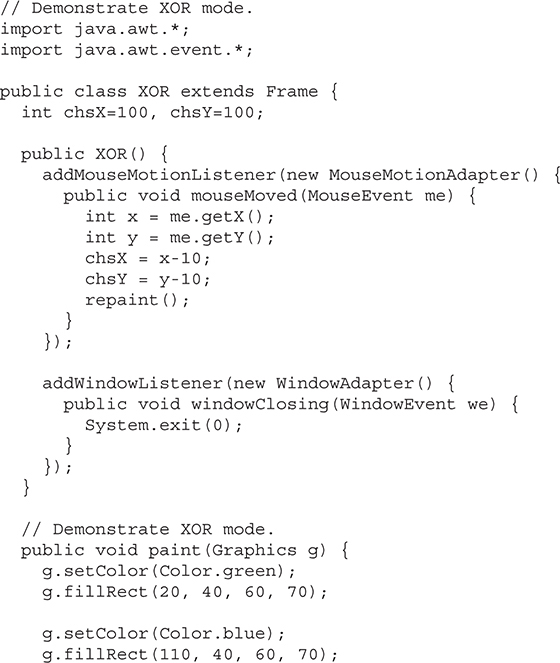
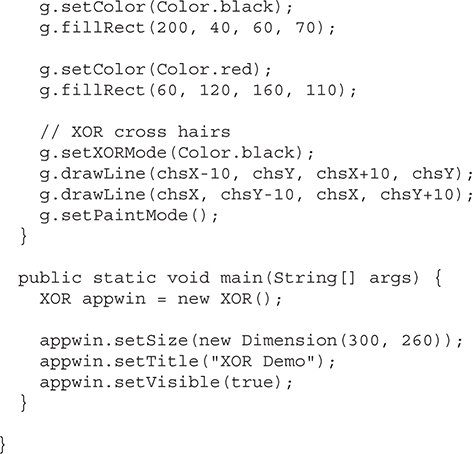
Sample output from this program is shown here:
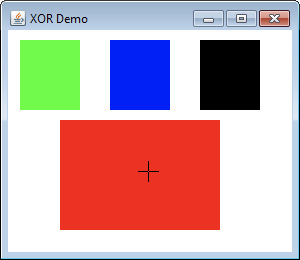
The AWT supports multiple type fonts. Years ago, fonts emerged from the domain of traditional typesetting to become an important part of computer-generated documents and displays. The AWT provides flexibility by abstracting font-manipulation operations and allowing for dynamic selection of fonts.
Fonts have a family name, a logical font name, and a face name. The family name is the general name of the font, such as Courier. The logical name specifies a name, such as Monospaced, that is linked to an actual font at runtime. The face name specifies a specific font, such as Courier Italic.
Fonts are encapsulated by the Font class. Several of the methods defined by Font are listed in Table 26-2.
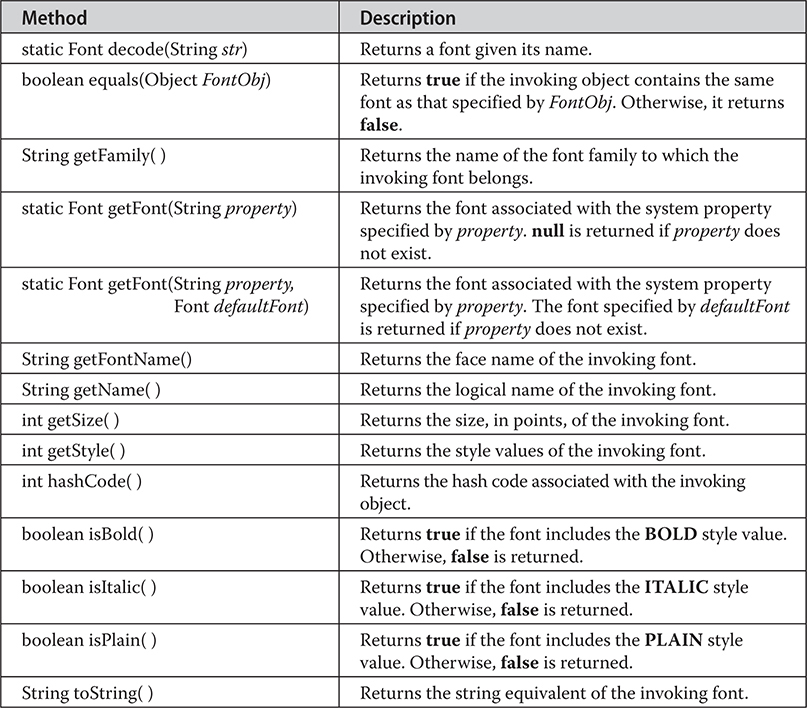
Table 26-2 A Sampling of Methods Defined by Font
The Font class defines these protected variables:

Several static fields are also defined.
When working with fonts, often you need to know which fonts are available on your machine. To obtain this information, you can use the getAvailableFontFamilyNames( ) method defined by the GraphicsEnvironment class. It is shown here:
String[ ] getAvailableFontFamilyNames( )
This method returns an array of strings that contains the names of the available font families.
In addition, the getAllFonts( ) method is defined by the GraphicsEnvironment class. It is shown here:
Font[ ] getAllFonts( )
This method returns an array of Font objects for all of the available fonts.
Since these methods are members of GraphicsEnvironment, you need a GraphicsEnvironment reference to call them. You can obtain this reference by using the getLocalGraphicsEnvironment( ) static method, which is defined by GraphicsEnvironment. It is shown here:
static GraphicsEnvironment getLocalGraphicsEnvironment( )
Here is a program that shows how to obtain the names of the available font families:
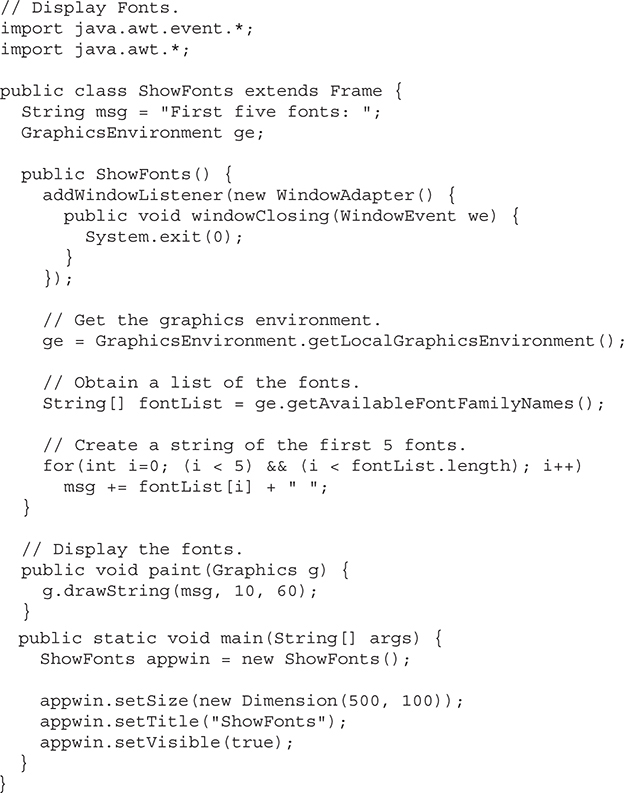
Sample output from this program is shown next. However, when you run this program, you may see a different set of fonts than the one shown in this illustration.

To create a new font, construct a Font object that describes that font. One Font constructor has this general form:
Font(String fontName, int fontStyle, int pointSize)
Here, fontName specifies the name of the desired font. The name can be specified using either the family or face name. All Java environments will support the following fonts: Dialog, DialogInput, SansSerif, Serif, and Monospaced. Dialog is the font used by your system’s dialog boxes. Dialog is also the default if you don’t explicitly set a font. You can also use any other fonts supported by your particular environment, but be careful—these other fonts may not be universally available.
The style of the font is specified by fontStyle. It may consist of one or more of these three constants: Font.PLAIN, Font.BOLD, and Font.ITALIC. To combine styles, OR them together. For example, Font.BOLD | Font.ITALIC specifies a bold, italics style.
The size, in points, of the font is specified by pointSize.
To use a font that you have created, you must select it using setFont( ), which is defined by Component. It has this general form:
void setFont(Font fontObj)
Here, fontObj is the object that contains the desired font.
The following program outputs a sample of each standard font. Each time you click the mouse within its window, a new font is selected and its name is displayed.
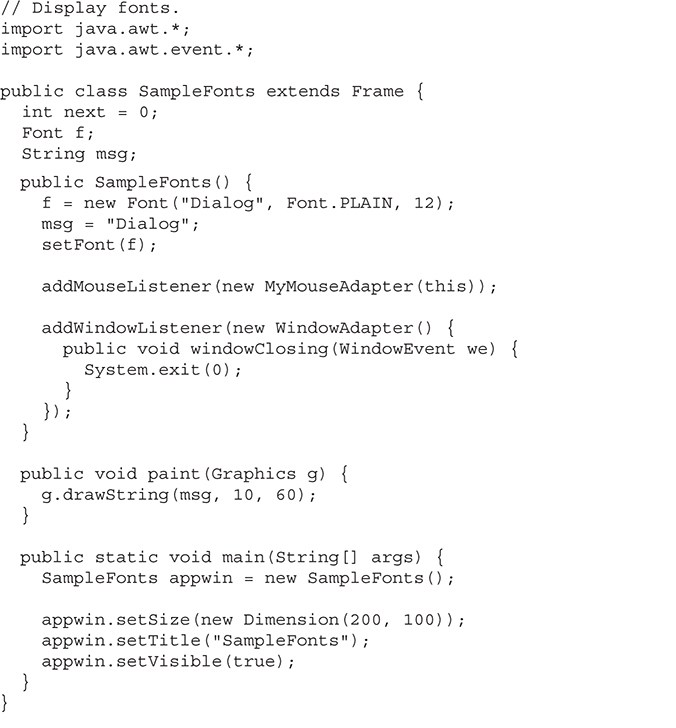
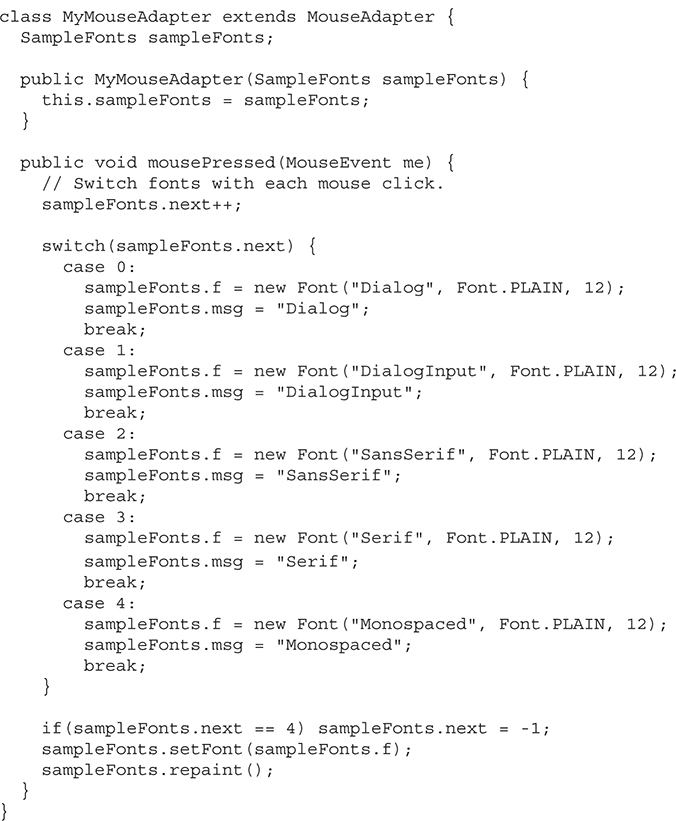
Sample output from this program is shown here:
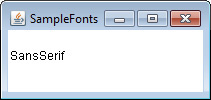
Suppose you want to obtain information about the currently selected font. To do this, you must first get the current font by calling getFont( ). This method is defined by the Graphics class, as shown here:
Font getFont( )
Once you have obtained the currently selected font, you can retrieve information about it using various methods defined by Font. For example, this program displays the name, family, size, and style of the currently selected font:
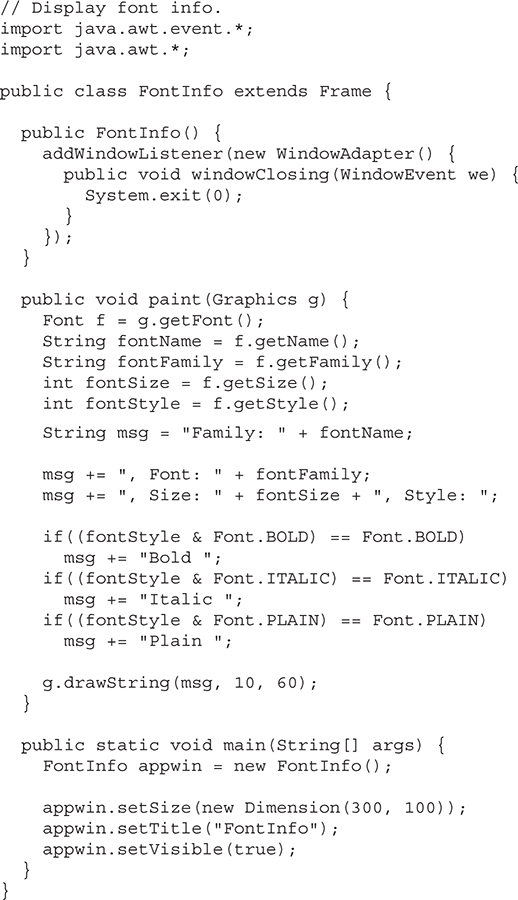
As just explained, Java supports a number of fonts. For most fonts, characters are not all the same dimension—most fonts are proportional. Also, the height of each character, the length of descenders (the hanging parts of letters, such as y), and the amount of space between horizontal lines vary from font to font. Further, the point size of a font can be changed. That these (and other) attributes are variable would not be of too much consequence except that Java demands that you, the programmer, manually manage virtually all text output.
Given that the size of each font may differ and that fonts may be changed while your program is executing, there must be some way to determine the dimensions and various other attributes of the currently selected font. For example, to write one line of text after another implies that you have some way of knowing how tall the font is and how many pixels are needed between lines. To fill this need, the AWT includes the FontMetrics class, which encapsulates various information about a font. Let’s begin by defining the common terminology used when describing fonts:

As you know, we have used the drawString( ) method in many of the previous examples. It paints a string in the current font and color, beginning at a specified location. However, this location is at the left edge of the baseline of the characters, not at the upper-left corner as is usual with other drawing methods. It is a common error to draw a string at the same coordinate that you would draw a box. For example, if you were to draw a rectangle at the top, left location, you would see a full rectangle. If you were to draw the string “Typesetting” at this location, you would only see the tails (or descenders) of the y, p, and g. As you will see, by using font metrics, you can determine the proper placement of each string that you display.
FontMetrics defines several methods that help you manage text output. A number of commonly used ones are listed in Table 26-3. These methods help you properly display text in a window.
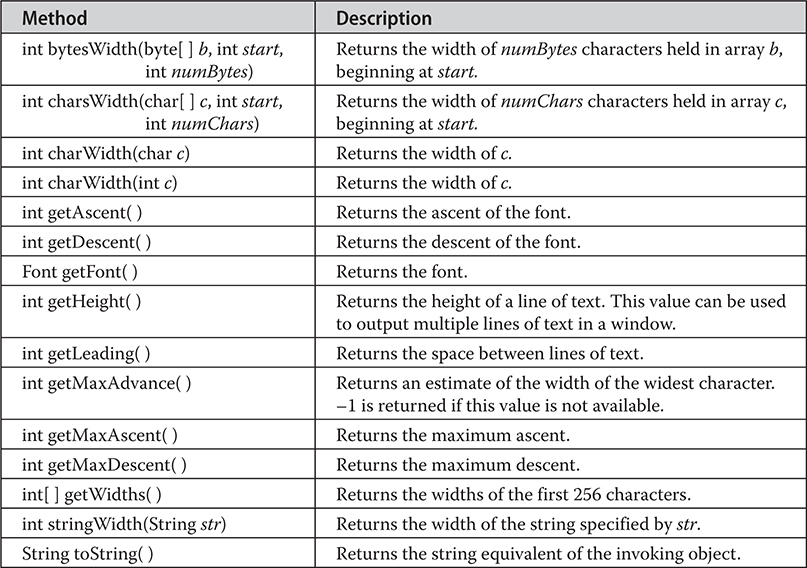
Table 26-3 A Sampling of Methods Defined by FontMetrics
Perhaps the most common use of FontMetrics is to determine the spacing between lines of text. The second most common use is to determine the length of a string that is being displayed. Here, you will see how to accomplish these tasks.
In general, to display multiple lines of text, your program must manually keep track of the current output position. Each time a newline is desired, the Y coordinate must be advanced to the beginning of the next line. Each time a string is displayed, the X coordinate must be set to the point at which the string ends. This allows the next string to be written so that it begins at the end of the preceding one.
To determine the spacing between lines, you can use the value returned by getLeading( ). To determine the total height of the font, add the value returned by getAscent( ) to the value returned by getDescent( ). You can then use these values to position each line of text you output. However, in many cases, you will not need to use these individual values. Often, all that you will need to know is the total height of a line, which is the sum of the leading space and the font’s ascent and descent values. The easiest way to obtain this value is to call getHeight( ). In many cases, you can simply increment the Y coordinate by this value each time you want to advance to the next line when outputting text.
To start output at the end of previous output on the same line, you must know the length, in pixels, of each string that you display. To obtain this value, call stringWidth( ). You can use this value to advance the X coordinate each time you display a line.
The following program shows how to output multiple lines of text in a window. It also displays multiple sentences on the same line. Notice the variables curX and curY. They keep track of the current text output position.
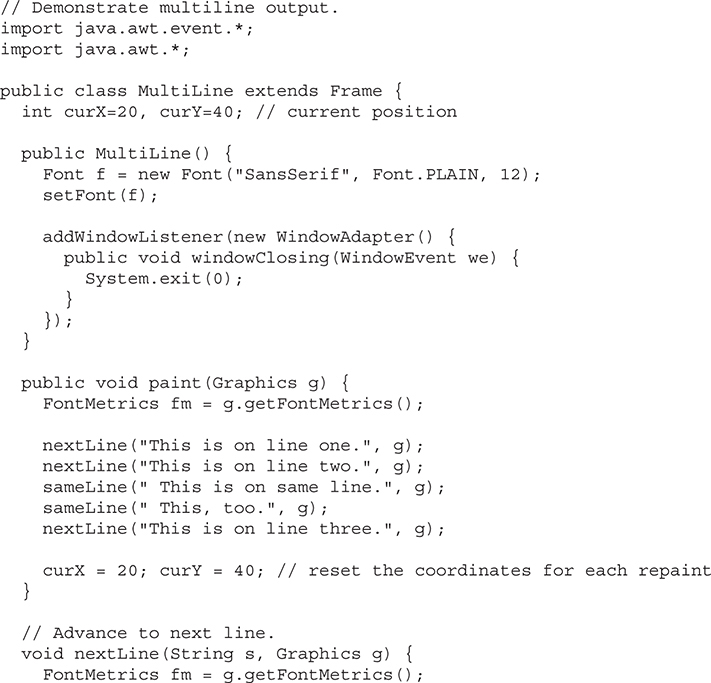
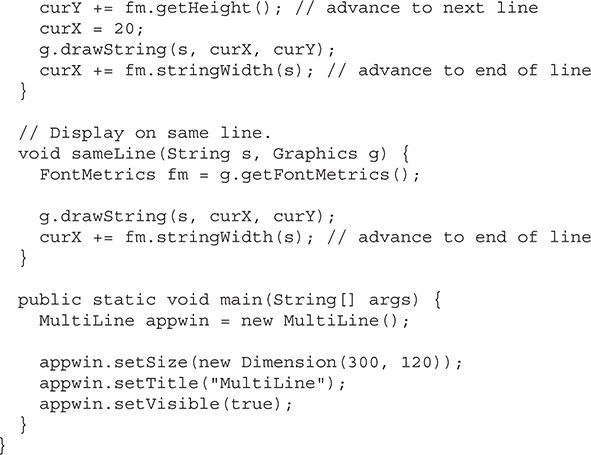
Sample output from this program is shown here:
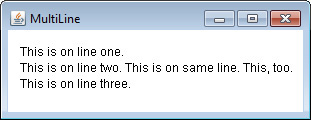
This chapter continues our overview of the Abstract Window Toolkit (AWT). It begins with a look at several of the AWT’s controls and layout managers. It then discusses menus and the menu bar. The chapter also includes a discussion of the dialog box.
Controls are components that allow a user to interact with your application in various ways—for example, a commonly used control is the push button. A layout manager automatically positions components within a container. Thus, the appearance of a window is determined by a combination of the controls that it contains and the layout manager used to position them.
In addition to the controls, a frame window can also include a standard-style menu bar. Each entry in a menu bar activates a drop-down menu of options from which the user can choose. This constitutes the main menu of an application. As a general rule, a menu bar is positioned at the top of a window. Although different in appearance, menu bars are handled in much the same way as are the other controls.
While it is possible to manually position components within a window, doing so is quite tedious. The layout manager automates this task. For the first part of this chapter, which introduces various controls, a simple layout manager will be used that displays components in a container using line-by-line, top-to-bottom organization. Once the controls have been covered, several other layout managers will be examined. There, you will see ways to better manage the positioning of controls.
Before continuing, it is important to emphasize that today you will seldom create GUIs based solely on the AWT because more powerful GUI frameworks have been developed for Java. However, the material presented here remains important for the following reasons. First, much of the information and many of the techniques related to controls and event handling are generalizable to Swing. (As mentioned in the previous chapter, Swing is built upon the AWT.) Second, the layout managers described here are also used by Swing. Third, for some small applications, the AWT components might be the appropriate choice. Finally, you may encounter legacy code that uses the AWT. Therefore, a basic understanding of the AWT is important for all Java programmers.
The AWT supports the following types of controls:
• Labels
• Push buttons
• Check boxes
• Choice lists
• Lists
• Scroll bars
• Text Editing
All AWT controls are subclasses of Component. Although the set of controls provided by the AWT is not particularly rich, it is sufficient for simple applications, such as short utility programs intended for your own use. It is also quite useful for introducing the basic concepts and techniques related to handling events in controls. It is important to point out, however, that Swing provides a substantially larger, more sophisticated set of controls better suited for creating commercial applications.
To include a control in a window, you must add it to the window. To do this, you must first create an instance of the desired control and then add it to a window by calling add( ), which is defined by Container. The add( ) method has several forms. The following form is the one that is used for the first part of this chapter:
Component add(Component compRef)
Here, compRef is a reference to an instance of the control that you want to add. A reference to the object is returned. Once a control has been added, it will automatically be visible whenever its parent window is displayed.
Sometimes you will want to remove a control from a window when the control is no longer needed. To do this, call remove( ). This method is also defined by Container. Here is one of its forms:
void remove(Component compRef)
Here, compRef is a reference to the control you want to remove. You can remove all controls by calling removeAll( ).
Except for labels, which are passive, all other controls generate events when they are accessed by the user. For example, when the user clicks on a push button, an event is sent that identifies the push button. In general, your program simply implements the appropriate interface and then registers an event listener for each control that you need to monitor. As explained in Chapter 25, once a listener has been installed, events are automatically sent to it. In the sections that follow, the appropriate interface for each control is specified.
Most of the AWT controls described in this chapter have constructors that can throw a HeadlessException when an attempt is made to instantiate a GUI component in a non-interactive environment (such as one in which no display, mouse, or keyboard is present). You can use this exception to write code that can adapt to non-interactive environments. (Of course, this is not always possible.) This exception is not handled by the programs in this chapter because an interactive environment is required to demonstrate the AWT controls.
The easiest control to use is a label. A label is an object of type Label, and it contains a string, which it displays. Labels are passive controls that do not support any interaction with the user. Label defines the following constructors:
Label( ) throws HeadlessException
Label(String str) throws HeadlessException
Label(String str, int how) throws HeadlessException
The first version creates a blank label. The second version creates a label that contains the string specified by str. This string is left-justified. The third version creates a label that contains the string specified by str using the alignment specified by how. The value of how must be one of these three constants: Label.LEFT, Label.RIGHT, or Label.CENTER.
You can set or change the text in a label by using the setText( ) method. You can obtain the current label by calling getText( ). These methods are shown here:
void setText(String str)
String getText( )
For setText( ), str specifies the new label. For getText( ), the current label is returned.
You can set the alignment of the string within the label by calling setAlignment( ). To obtain the current alignment, call getAlignment( ). The methods are as follows:
void setAlignment(int how)
int getAlignment( )
Here, how must be one of the alignment constants shown earlier.
The following example creates three labels and adds them to a Frame.
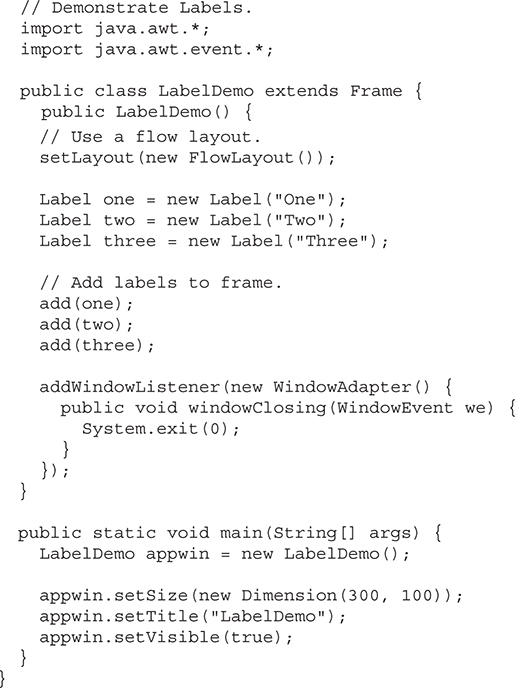
Here is sample output from the LabelDemo program.
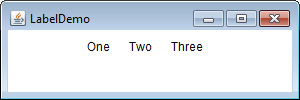
Notice that the labels are organized in the window left-to-right. This is handled automatically by the FlowLayout layout manager, which is one of the layout managers provided by the AWT. Here it is used in its default configuration, which lays out components line-by-line, left-to-right, top-to-bottom, and centered. As you will see later in this chapter, it supports several options, but for now, its default behavior is sufficient. Notice that FlowLayout is selected as the layout manager by use of setLayout( ). This method sets the layout manager associated with the container, which in this case is the enclosing frame. Although FlowLayout is very convenient and sufficient for our purposes at this time, it does not give you detailed control over the placement of components within a window. Later in this chapter, when the topic of layout managers is examined in detail, you will see how to gain more control over the organization of your windows.
Perhaps the most widely used control is the push button. A push button is a component that contains a label and generates an event when it is pressed. Push buttons are objects of type Button. Button defines these two constructors:
Button( ) throws HeadlessException
Button(String str) throws HeadlessException
The first version creates an empty button. The second creates a button that contains str as a label.
After a button has been created, you can set its label by calling setLabel( ). You can retrieve its label by calling getLabel( ). These methods are as follows:
void setLabel(String str)
String getLabel( )
Here, str becomes the new label for the button.
Each time a button is pressed, an action event is generated. This is sent to any listeners that previously registered an interest in receiving action event notifications from that component. Each listener implements the ActionListener interface. That interface defines the actionPerformed( ) method, which is called when an event occurs. An ActionEvent object is supplied as the argument to this method. It contains both a reference to the button that generated the event and a reference to the action command string associated with the button. By default, the action command string is the label of the button. Either the button reference or the action command string can be used to identify the button. (You will soon see examples of each approach.)
Here is an example that creates three buttons labeled "Yes", "No", and "Undecided". Each time one is pressed, a message is displayed that reports which button has been pressed. In this version, the action command of the button (which, by default, is its label) is used to determine which button has been pressed. The label is obtained by calling the getActionCommand( ) method on the ActionEvent object passed to actionPerformed( ).
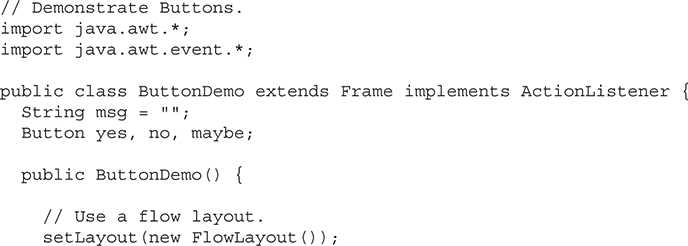
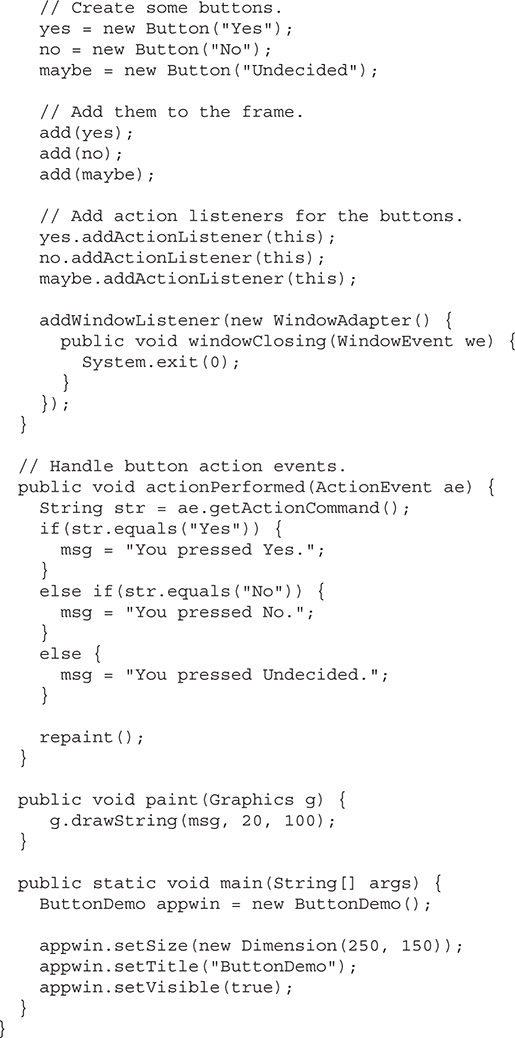
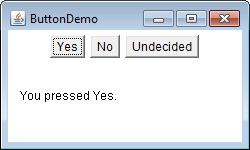
Figure 27-1 Sample output from the ButtonDemo program
Sample output from the ButtonDemo program is shown in Figure 27-1.
As mentioned, in addition to comparing button action command strings, you can also determine which button has been pressed by comparing the object obtained from the getSource( ) method to the button objects that you added to the window. To do this, you must keep a list of the objects when they are added. The following program shows this approach:
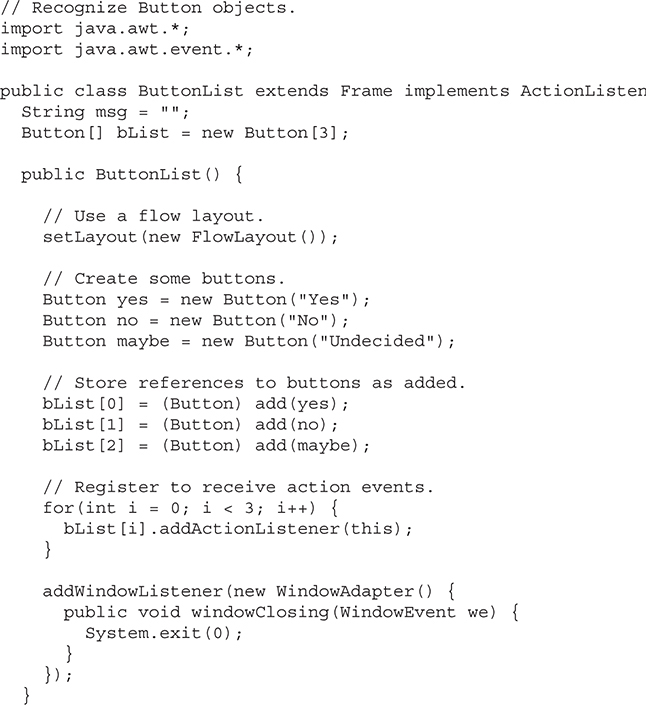
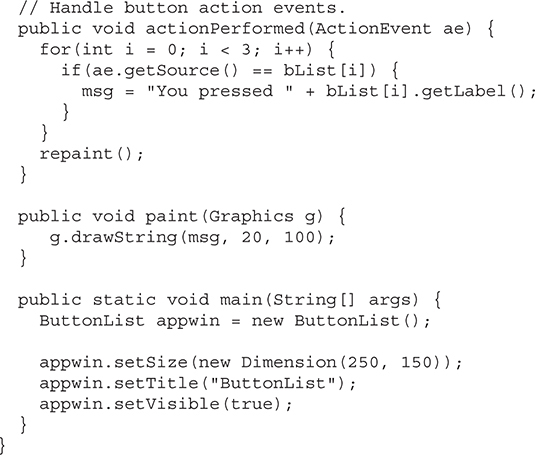
In this version, the program stores each button reference in an array when the buttons are added to the frame. (Recall that the add( ) method returns a reference to the button when it is added.) Inside actionPerformed( ), this array is then used to determine which button has been pressed.
For simple programs, it is usually easier to recognize buttons by their labels. However, in situations in which you will be changing the label inside a button during the execution of your program, or using buttons that have the same label, it may be easier to determine which button has been pushed by using its object reference. It is also possible to set the action command string associated with a button to something other than its label by calling setActionCommand( ). This method changes the action command string, but does not affect the string used to label the button. Thus, setting the action command enables the action command and the label of a button to differ.
In some cases, you can handle the action events generated by a button (or some other type of control) by use of an anonymous inner class (as described in Chapter 25) or a lambda expression (discussed in Chapter 15). For example, assuming the previous programs, here is a set of action event handlers that use lambda expressions:
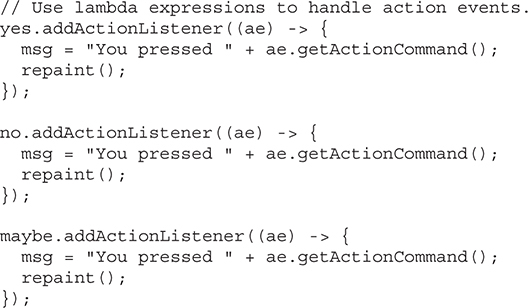
This code works because ActionListener defines a functional interface, which is an interface with exactly one abstract method. Thus, it can be used by a lambda expression. In general, you can use a lambda expression to handle an AWT event when its listener defines a functional interface. For example, ItemListener is also a functional interface. Of course, whether you use the traditional approach, an anonymous inner class, or a lambda expression will be determined by the precise nature of your application.
A check box is a control that is used to turn an option on or off. It consists of a small box that can either contain a check mark or not. There is a label associated with each check box that describes what option the box represents. You change the state of a check box by clicking on it. Check boxes can be used individually or as part of a group. Check boxes are objects of the Checkbox class.
Checkbox supports these constructors:
Checkbox( ) throws HeadlessException
Checkbox(String str) throws HeadlessException
Checkbox(String str, boolean on) throws HeadlessException
Checkbox(String str, boolean on, CheckboxGroup cbGroup) throws HeadlessException
Checkbox(String str, CheckboxGroup cbGroup, boolean on) throws HeadlessException
The first form creates a check box whose label is initially blank. The state of the check box is unchecked. The second form creates a check box whose label is specified by str. The state of the check box is unchecked. The third form allows you to set the initial state of the check box. If on is true, the check box is initially checked; otherwise, it is cleared. The fourth and fifth forms create a check box whose label is specified by str and whose group is specified by cbGroup. If this check box is not part of a group, then cbGroup must be null. (Check box groups are described in the next section.) The value of on determines the initial state of the check box.
To retrieve the current state of a check box, call getState( ). To set its state, call setState( ). You can obtain the current label associated with a check box by calling getLabel( ). To set the label, call setLabel( ). These methods are as follows:
boolean getState( )
void setState(boolean on)
String getLabel( )
void setLabel(String str)
Here, if on is true, the box is checked. If it is false, the box is cleared. The string passed in str becomes the new label associated with the invoking check box.
Each time a check box is selected or deselected, an item event is generated. This is sent to any listeners that previously registered an interest in receiving item event notifications from that component. Each listener implements the ItemListener interface. That interface defines the itemStateChanged( ) method. An ItemEvent object is supplied as the argument to this method. It contains information about the event (for example, whether it was a selection or deselection).
The following program creates four check boxes. The initial state of the first box is checked. The status of each check box is displayed. Each time you change the state of a check box, the status display is updated.
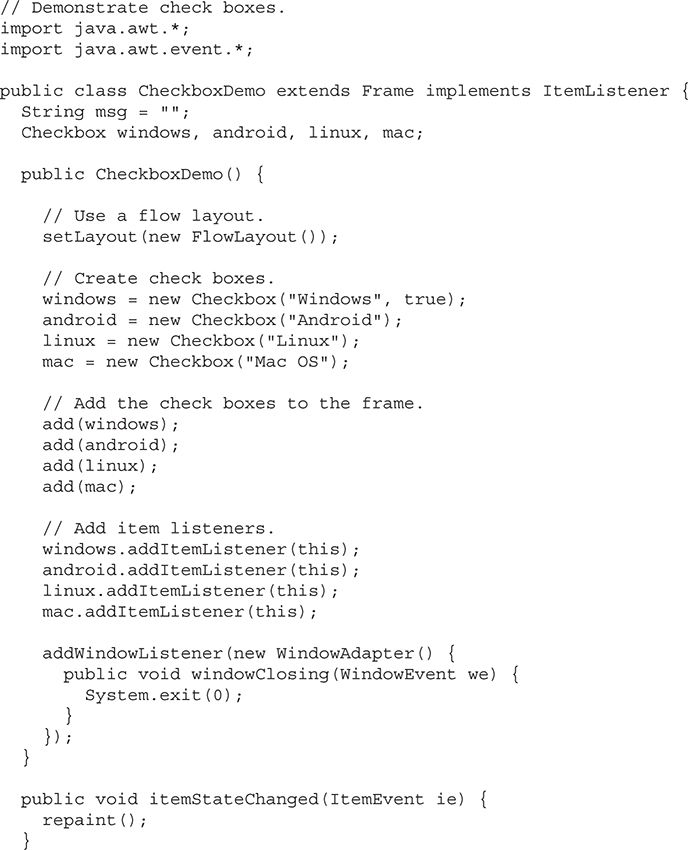
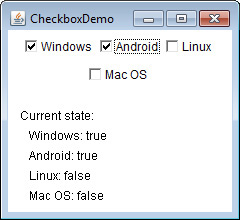
Figure 27-2 Sample output from the CheckboxDemo program
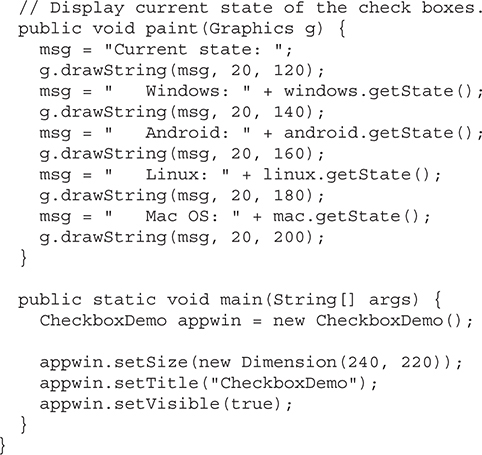
Sample output is shown in Figure 27-2.
It is possible to create a set of mutually exclusive check boxes in which one and only one check box in the group can be checked at any one time. These check boxes are often called radio buttons, because they act like the station selector on a car radio—only one station can be selected at any one time. To create a set of mutually exclusive check boxes, you must first define the group to which they will belong and then specify that group when you construct the check boxes. Check box groups are objects of type CheckboxGroup. Only the default constructor is defined, which creates an empty group.
You can determine which check box in a group is currently selected by calling getSelectedCheckbox( ). You can set a check box by calling setSelectedCheckbox( ). These methods are as follows:
Checkbox getSelectedCheckbox( )
void setSelectedCheckbox(Checkbox which)
Here, which is the check box that you want to be selected. The previously selected check box will be turned off.
Here is a program that uses check boxes that are part of a group:
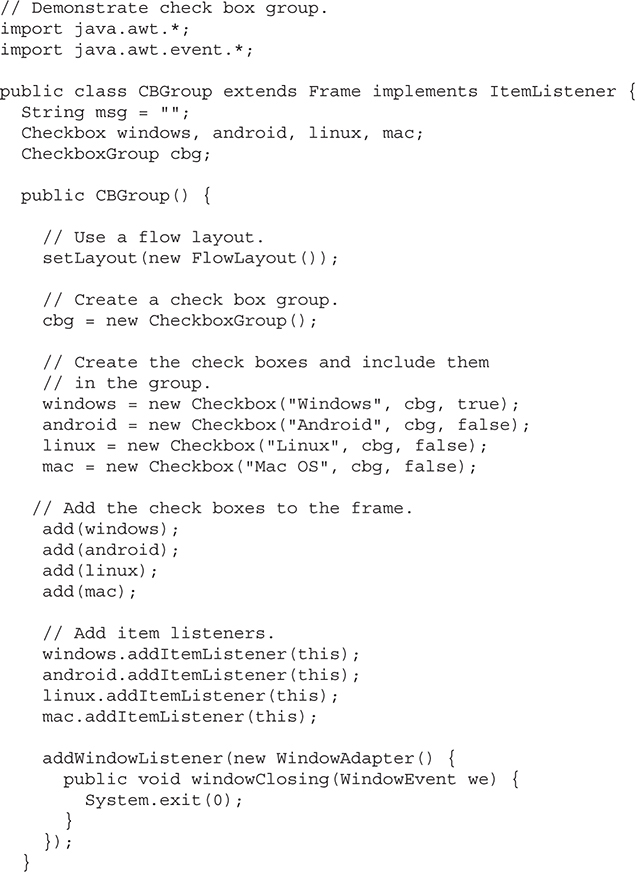
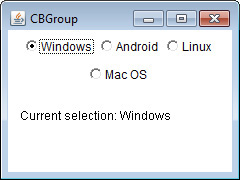
Figure 27-3 Sample output from the CBGroup program
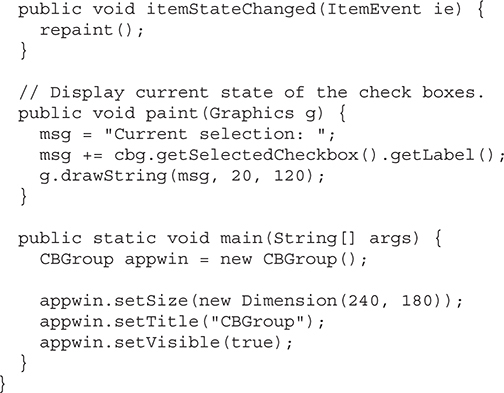
Sample output generated by the CBGroup program is shown in Figure 27-3. Notice that the check boxes are now circular in shape.
The Choice class is used to create a pop-up list of items from which the user may choose. Thus, a Choice control is a form of menu. When inactive, a Choice component takes up only enough space to show the currently selected item. When the user clicks on it, the whole list of choices pops up, and a new selection can be made. Each item in the list is a string that appears as a left-justified label in the order it is added to the Choice object. Choice defines only the default constructor, which creates an empty list.
To add a selection to the list, call add( ). It has this general form:
void add(String name)
Here, name is the name of the item being added. Items are added to the list in the order in which calls to add( ) occur.
To determine which item is currently selected, you may call either getSelectedItem( ) or getSelectedIndex( ). These methods are shown here:
String getSelectedItem( )
int getSelectedIndex( )
The getSelectedItem( ) method returns a string containing the name of the item. getSelectedIndex( ) returns the index of the item. The first item is at index 0. By default, the first item added to the list is selected.
To obtain the number of items in the list, call getItemCount( ). You can set the currently selected item using the select( ) method with either a zero-based integer index or a string that will match a name in the list. These methods are shown here:
int getItemCount( )
void select(int index)
void select(String name)
Given an index, you can obtain the name associated with the item at that index by calling getItem( ), which has this general form:
String getItem(int index)
Here, index specifies the index of the desired item.
Each time a choice is selected, an item event is generated. This is sent to any listeners that previously registered an interest in receiving item event notifications from that component. Each listener implements the ItemListener interface. That interface defines the itemStateChanged( ) method. An ItemEvent object is supplied as the argument to this method.
Here is an example that creates two Choice menus. One selects the operating system. The other selects the browser.
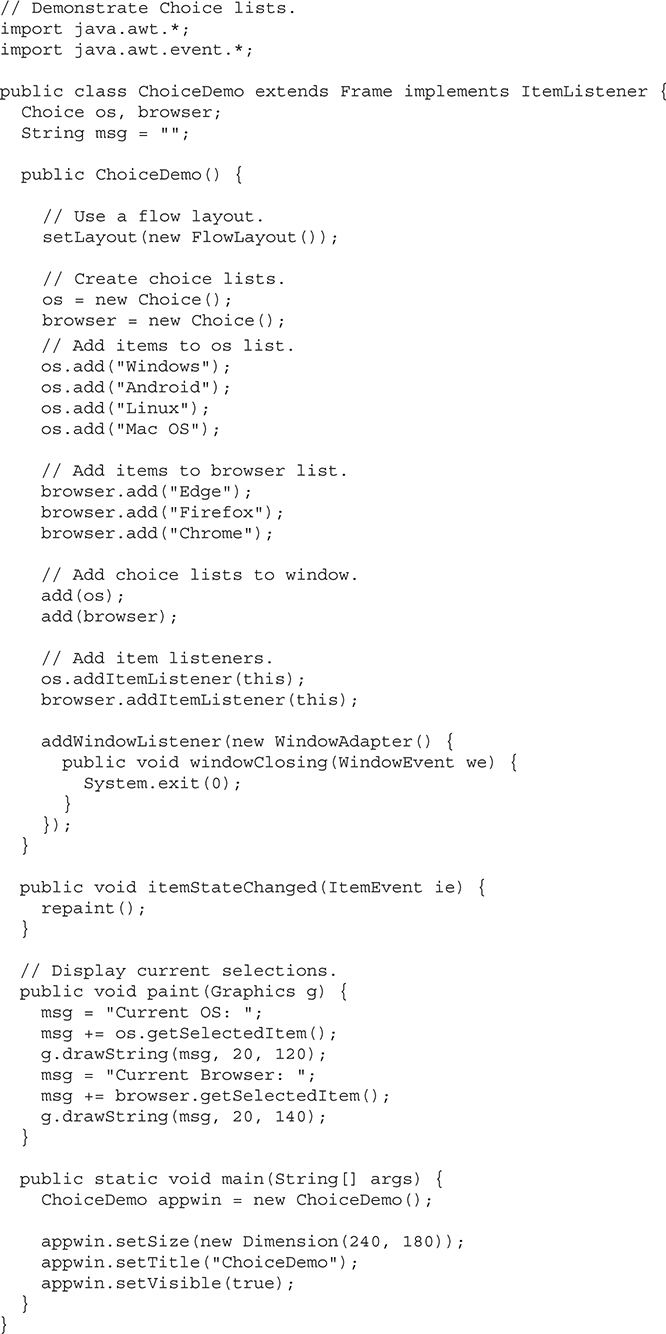
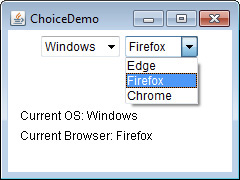
Figure 27-4 Sample output from the ChoiceDemo program
Sample output is shown in Figure 27-4.
The List class provides a compact, multiple-choice, scrolling selection list. Unlike the Choice object, which shows only the single selected item in the menu, a List object can be constructed to show any number of choices in the visible window. It can also be created to allow multiple selections. List provides these constructors:
List( ) throws HeadlessException
List(int numRows) throws HeadlessException
List(int numRows, boolean multipleSelect) throws HeadlessException
The first version creates a List control that allows only one item to be selected at any one time. In the second form, the value of numRows specifies the number of entries in the list that will always be visible (others can be scrolled into view as needed). In the third form, if multipleSelect is true, then the user may select two or more items at a time. If it is false, then only one item may be selected.
To add a selection to the list, call add( ). It has the following two forms:
void add(String name)
void add(String name, int index)
Here, name is the name of the item added to the list. The first form adds items to the end of the list. The second form adds the item at the index specified by index. Indexing begins at zero. You can specify –1 to add the item to the end of the list.
For lists that allow only single selection, you can determine which item is currently selected by calling either getSelectedItem( ) or getSelectedIndex( ). These methods are shown here:
String getSelectedItem( )
int getSelectedIndex( )
The getSelectedItem( ) method returns a string containing the name of the item. If more than one item is selected, or if no selection has yet been made, null is returned. getSelectedIndex( ) returns the index of the item. The first item is at index 0. If more than one item is selected, or if no selection has yet been made, –1 is returned.
For lists that allow multiple selection, you must use either getSelectedItems( ) or getSelectedIndexes( ), shown here, to determine the current selections:
String[ ] getSelectedItems( )
int[ ] getSelectedIndexes( )
getSelectedItems( ) returns an array containing the names of the currently selected items. getSelectedIndexes( ) returns an array containing the indexes of the currently selected items.
To obtain the number of items in the list, call getItemCount( ). You can set the currently selected item by using the select( ) method with a zero-based integer index. These methods are shown here:
int getItemCount( )
void select(int index)
Given an index, you can obtain the name associated with the item at that index by calling getItem( ), which has this general form:
String getItem(int index)
Here, index specifies the index of the desired item.
To process list events, you will need to implement the ActionListener interface. Each time a List item is double-clicked, an ActionEvent object is generated. Its getActionCommand( ) method can be used to retrieve the name of the newly selected item. Also, each time an item is selected or deselected with a single click, an ItemEvent object is generated. Its getStateChange( ) method can be used to determine whether a selection or deselection triggered this event. getItemSelectable( ) returns a reference to the object that triggered this event.
Here is an example that converts the Choice controls in the preceding section into List components, one multiple choice and the other single choice:
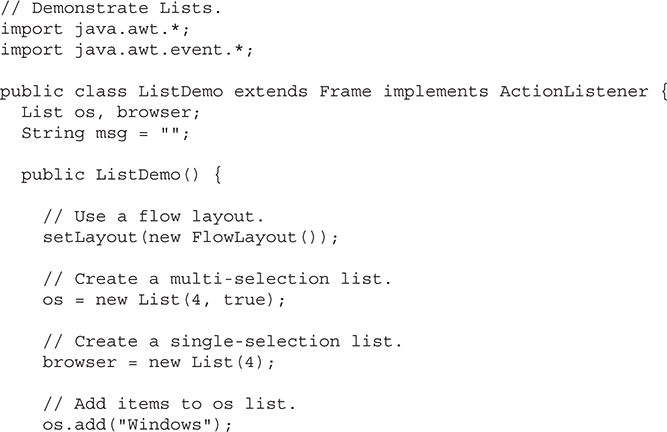
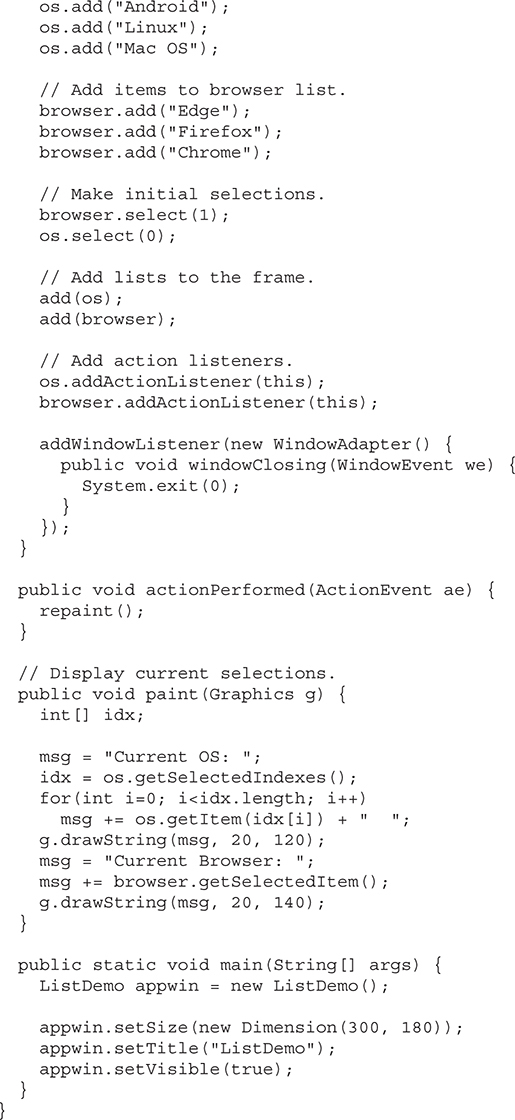
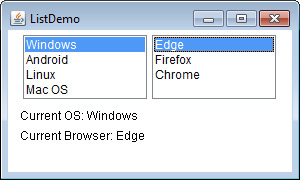
Figure 27-5 Sample output from the ListDemo program
Sample output generated by the ListDemo program is shown in Figure 27-5.
Scroll bars are used to select continuous values between a specified minimum and maximum. Scroll bars may be oriented horizontally or vertically. A scroll bar is actually a composite of several individual parts. Each end has an arrow that you can click to move the current value of the scroll bar one unit in the direction of the arrow. The current value of the scroll bar relative to its minimum and maximum values is indicated by the slider box (or thumb) for the scroll bar. The slider box can be dragged by the user to a new position. The scroll bar will then reflect this value. In the background space on either side of the thumb, the user can click to cause the thumb to jump in that direction by some increment larger than 1. Typically, this action translates into some form of page up and page down. Scroll bars are encapsulated by the Scrollbar class.
Scrollbar defines the following constructors:
Scrollbar( ) throws HeadlessException
Scrollbar(int style) throws HeadlessException
Scrollbar(int style, int initialValue, int thumbSize, int min, int max)
throws HeadlessException
The first form creates a vertical scroll bar. The second and third forms allow you to specify the orientation of the scroll bar. If style is Scrollbar.VERTICAL, a vertical scroll bar is created. If style is Scrollbar.HORIZONTAL, the scroll bar is horizontal. In the third form of the constructor, the initial value of the scroll bar is passed in initialValue. The number of units represented by the height of the thumb is passed in thumbSize. The minimum and maximum values for the scroll bar are specified by min and max.
If you construct a scroll bar by using one of the first two constructors, then you need to set its parameters by using setValues( ), shown here, before it can be used:
void setValues(int initialValue, int thumbSize, int min, int max)
The parameters have the same meaning as they have in the third constructor just described.
To obtain the current value of the scroll bar, call getValue( ). It returns the current setting. To set the current value, call setValue( ). These methods are as follows:
int getValue( )
void setValue(int newValue)
Here, newValue specifies the new value for the scroll bar. When you set a value, the slider box inside the scroll bar will be positioned to reflect the new value.
You can also retrieve the minimum and maximum values via getMinimum( ) and getMaximum( ), shown here:
int getMinimum( )
int getMaximum( )
They return the requested quantity.
By default, 1 is the increment added to or subtracted from the scroll bar each time it is scrolled up or down one line. You can change this increment by calling setUnitIncrement( ). By default, page-up and page-down increments are 10. You can change this value by calling setBlockIncrement( ). These methods are shown here:
void setUnitIncrement(int newIncr)
void setBlockIncrement(int newIncr)
To process scroll bar events, you need to implement the AdjustmentListener interface. Each time a user interacts with a scroll bar, an AdjustmentEvent object is generated. Its getAdjustmentType( ) method can be used to determine the type of the adjustment. The types of adjustment events are as follows:

The following example creates both a vertical and a horizontal scroll bar. The current settings of the scroll bars are displayed. If you drag the mouse while inside the window, the coordinates of each drag event are used to update the scroll bars. An asterisk is displayed at the current drag position. Notice the use of setPreferredSize( ) to set the size of the scrollbars.
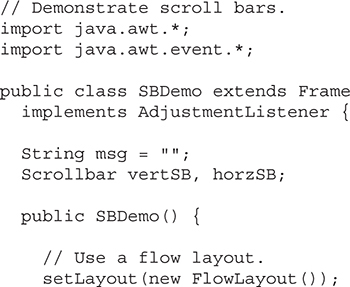
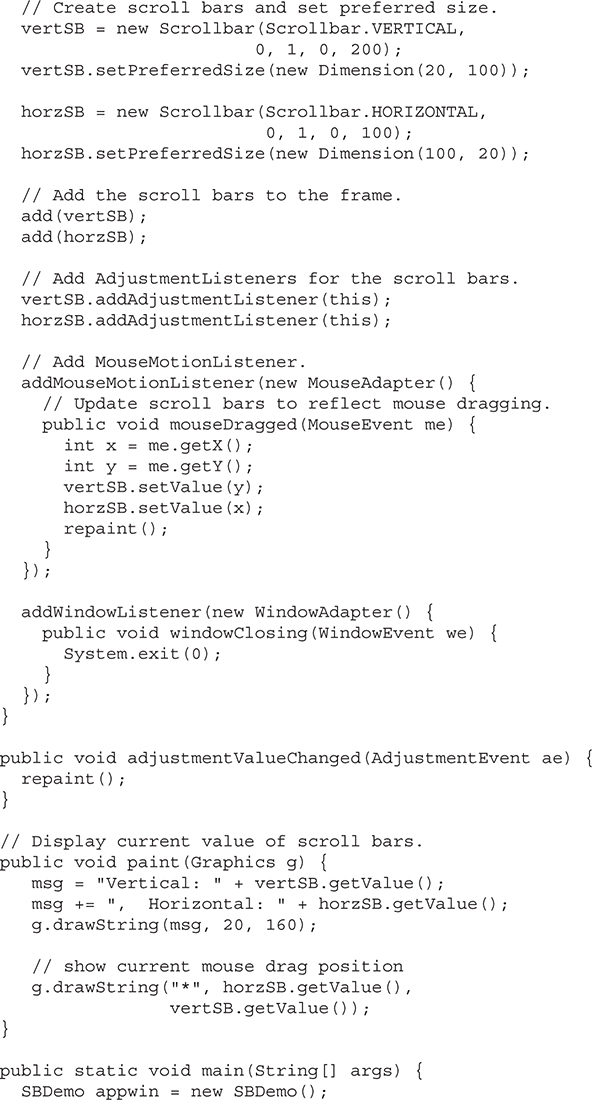
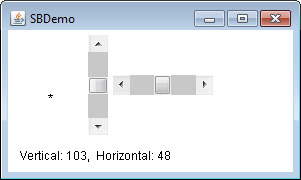
Figure 27-6 Sample output from the SBDemo program

Sample output from the SBDemo program is shown in Figure 27-6.
The TextField class implements a single-line text-entry area, usually called an edit control. Text fields allow the user to enter strings and to edit the text using the arrow keys, cut and paste keys, and mouse selections. TextField is a subclass of TextComponent. TextField defines the following constructors:
TextField( ) throws HeadlessException
TextField(int numChars) throws HeadlessException
TextField(String str) throws HeadlessException
TextField(String str, int numChars) throws HeadlessException
The first version creates a default text field. The second form creates a text field that is numChars characters wide. The third form initializes the text field with the string contained in str. The fourth form initializes a text field and sets its width.
TextField (and its superclass TextComponent) provides several methods that allow you to utilize a text field. To obtain the string currently contained in the text field, call getText( ). To set the text, call setText( ). These methods are as follows:
String getText( )
void setText(String str)
Here, str is the new string.
The user can select a portion of the text in a text field. Also, you can select a portion of text under program control by using select( ). Your program can obtain the currently selected text by calling getSelectedText( ). These methods are shown here:
String getSelectedText( )
void select(int startIndex, int endIndex)
getSelectedText( ) returns the selected text. The select( ) method selects the characters beginning at startIndex and ending at endIndex –1.
You can control whether the contents of a text field may be modified by the user by calling setEditable( ). You can determine editability by calling isEditable( ). These methods are shown here:
boolean isEditable( )
void setEditable(boolean canEdit)
isEditable( ) returns true if the text may be changed and false if not. In setEditable( ), if canEdit is true, the text may be changed. If it is false, the text cannot be altered.
There may be times when you will want the user to enter text that is not displayed, such as a password. You can disable the echoing of the characters as they are typed by calling setEchoChar( ). This method specifies a single character that the TextField will display when characters are entered (thus, the actual characters typed will not be shown). You can check a text field to see if it is in this mode with the echoCharIsSet( ) method. You can retrieve the echo character by calling the getEchoChar( ) method. These methods are as follows:
void setEchoChar(char ch)
boolean echoCharIsSet( )
char getEchoChar( )
Here, ch specifies the character to be echoed. If ch is zero, then normal echoing is restored.
Since text fields perform their own editing functions, your program generally will not respond to individual key events that occur within a text field. However, you may want to respond when the user presses ENTER. When this occurs, an action event is generated.
Here is an example that creates the classic user name and password screen:
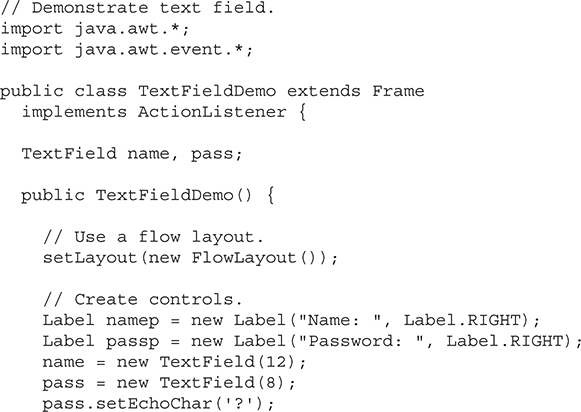
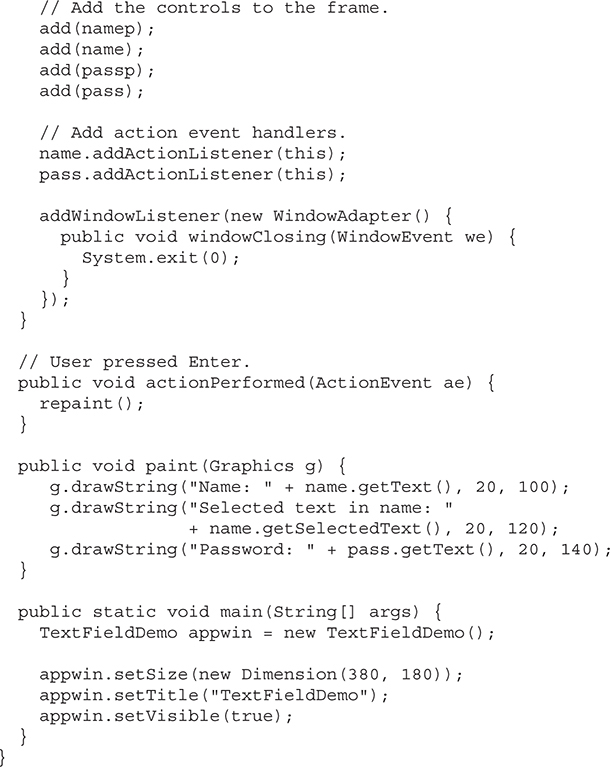
Sample output from the TextFieldDemo program is shown in Figure 27-7. (Of course, a real application would need to handle security concerns related to passwords. Consult the Java documentation for the latest information related to security.)
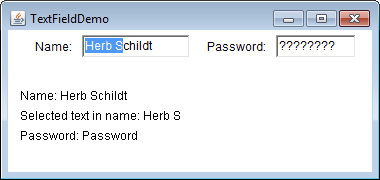
Figure 27-7 Sample output from the TextFieldDemo program
Sometimes a single line of text input is not enough for a given task. To handle these situations, the AWT includes a simple multiline editor called TextArea. Following are the constructors for TextArea:
TextArea( ) throws HeadlessException
TextArea(int numLines, int numChars) throws HeadlessException
TextArea(String str) throws HeadlessException
TextArea(String str, int numLines, int numChars) throws HeadlessException
TextArea(String str, int numLines, int numChars, int sBars) throws HeadlessException
Here, numLines specifies the height, in lines, of the text area, and numChars specifies its width, in characters. Initial text can be specified by str. In the fifth form, you can specify the scroll bars that you want the control to have. sBars must be one of these values:

TextArea is a subclass of TextComponent. Therefore, it supports the getText( ), setText( ), getSelectedText( ), select( ), isEditable( ), and setEditable( ) methods described in the preceding section.
TextArea adds the following editing methods:
void append(String str)
void insert(String str, int index)
void replaceRange(String str, int startIndex, int endIndex)
The append( ) method appends the string specified by str to the end of the current text. insert( ) inserts the string passed in str at the specified index. To replace text, call replaceRange( ). It replaces the characters from startIndex to endIndex–1, with the replacement text passed in str.
Text areas are almost self-contained controls. Your program incurs virtually no management overhead. Normally, your program simply obtains the current text when it is needed. You can, however, listen for TextEvents, if you choose.
The following program creates a TextArea control:
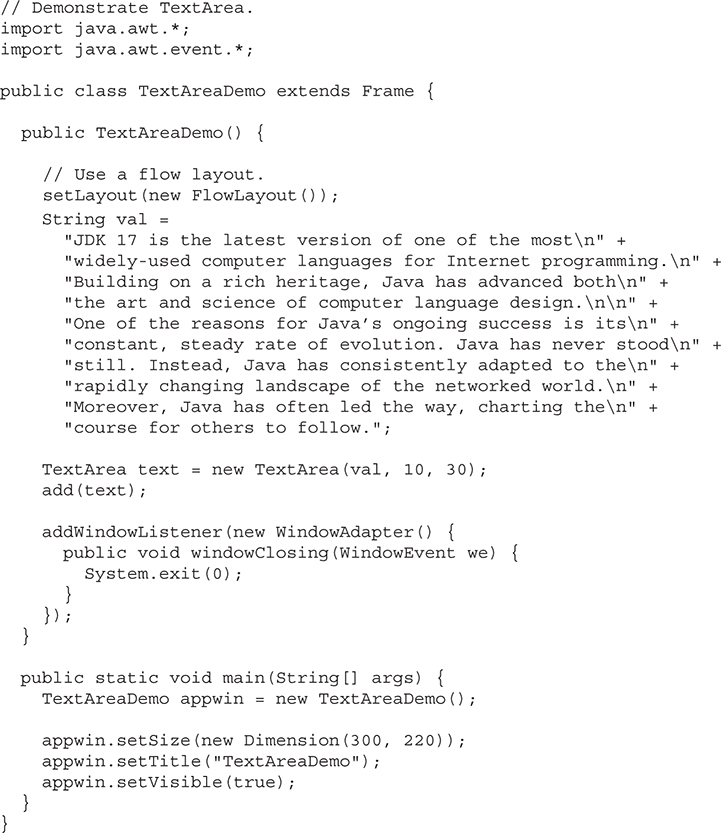
Here is sample output from the TextAreaDemo program:
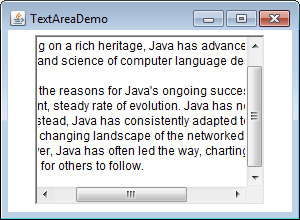
All of the components that we have shown so far have been positioned by the FlowLayout layout manager. As we mentioned at the beginning of this chapter, a layout manager automatically arranges your controls within a window by using some type of algorithm. While it is possible to lay out Java controls by hand, you generally won’t want to, for two main reasons. First, it is very tedious to manually lay out a large number of components. Second, sometimes the width and height information is not yet available when you need to arrange some control, because the native toolkit components haven’t been realized. This is a chicken-and-egg situation; it is pretty confusing to figure out when it is okay to use the size of a given component to position it relative to another.
Each Container object has a layout manager associated with it. A layout manager is an instance of any class that implements the LayoutManager interface. The layout manager is set by the setLayout( ) method. If no call to setLayout( ) is made, then the default layout manager is used. Whenever a container is resized (or sized for the first time), the layout manager is used to position each of the components within it.
The setLayout( ) method has the following general form:
void setLayout(LayoutManager layoutObj)
Here, layoutObj is a reference to the desired layout manager. If you wish to disable the layout manager and position components manually, pass null for layoutObj. If you do this, you will need to determine the shape and position of each component manually, using the setBounds( ) method defined by Component. Normally, you will want to use a layout manager.
Each layout manager keeps track of a list of components that are stored by their names. The layout manager is notified each time you add a component to a container. Whenever the container needs to be resized, the layout manager is consulted via its minimumLayoutSize( ) and preferredLayoutSize( ) methods. Each component that is being managed by a layout manager contains the getPreferredSize( ) and getMinimumSize( ) methods. These return the preferred and minimum size required to display each component. The layout manager will honor these requests if at all possible, while maintaining the integrity of the layout policy. You may override these methods for controls that you subclass. Default values are provided otherwise.
Java has several predefined LayoutManager classes, several of which are described next. You can use the layout manager that best fits your application.
You have already seen FlowLayout in action. It is the layout manager that the preceding examples have used. FlowLayout implements a simple layout style, which is similar to how words flow in a text editor. The direction of the layout is governed by the container’s component orientation property, which, by default, is left to right, top to bottom. Therefore, by default, components are laid out line-by-line beginning at the upper-left corner. In all cases, when a line is filled, layout advances to the next line. A small space is left between each component, above and below, as well as left and right. Here are the constructors for FlowLayout:
FlowLayout( )
FlowLayout(int how)
FlowLayout(int how, int horz, int vert)
The first form creates the default layout, which centers components and leaves five pixels of space between each component. The second form lets you specify how each line is aligned. Valid values for how are as follows:
FlowLayout.LEFT
FlowLayout.CENTER
FlowLayout.RIGHT
FlowLayout.LEADING
FlowLayout.TRAILING
These values specify left, center, right, leading edge, and trailing edge alignment, respectively. The third constructor allows you to specify the horizontal and vertical space left between components in horz and vert, respectively.
You can see the effect of specifying an alignment with FlowLayout by substituting this line in the CheckboxDemo program shown earlier:
setLayout(new FlowLayout(FlowLayout.LEFT));
After making this change, the output will look like that shown here. Compare this with the original output, shown in Figure 27-2.
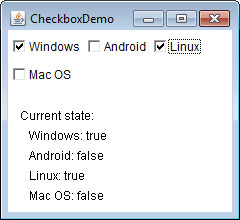
The BorderLayout class implements a layout style that has four narrow, fixed-width components at the edges and one large area in the center. The four sides are referred to as north, south, east, and west. The middle area is called the center. BorderLayout is the default layout manager for Frame. Here are the constructors defined by BorderLayout:
BorderLayout( )
BorderLayout(int horz, int vert)
The first form creates a default border layout. The second allows you to specify the horizontal and vertical space left between components in horz and vert, respectively.
BorderLayout defines the following commonly used constants that specify the regions:

When adding components, you will use these constants with the following form of add( ), which is defined by Container:
void add(Component compRef, Object region)
Here, compRef is a reference to the component to be added, and region specifies where the component will be added.
Here is an example of a BorderLayout with a component in each layout area:
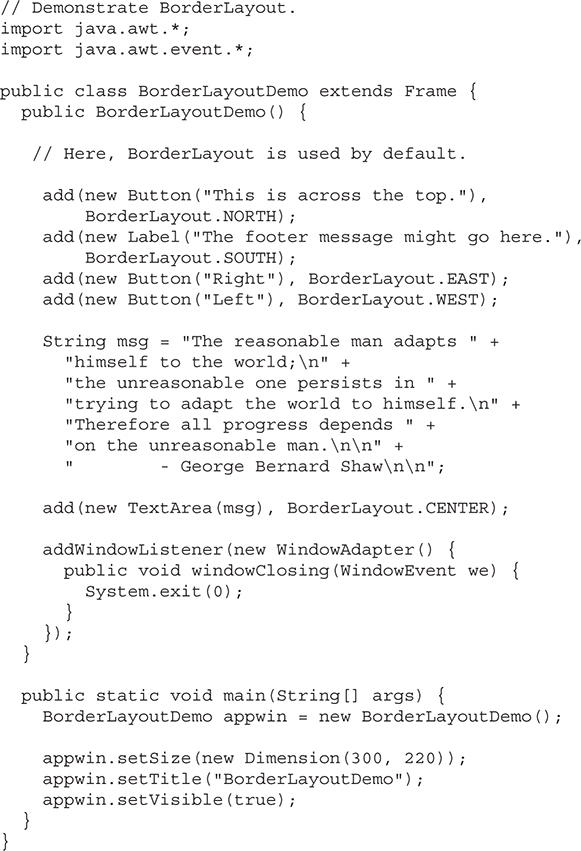
Sample output from the BorderLayoutDemo program is shown here:
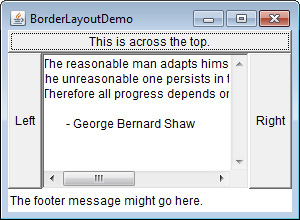
Sometimes you will want to leave a small amount of space between the container that holds your components and the window that contains it. To do this, override the getInsets( ) method that is defined by Container. This method returns an Insets object that contains the top, bottom, left, and right inset to be used when the container is displayed. These values are used by the layout manager to inset the components when it lays out the window. The constructor for Insets is shown here:
Insets(int top, int left, int bottom, int right)
The values passed in top, left, bottom, and right specify the amount of space between the container and its enclosing window.
The getInsets( ) method has this general form:
Insets getInsets( )
When overriding this method, you must return a new Insets object that contains the inset spacing you desire.
Here is the preceding BorderLayout example modified so that it insets its components. The background color has been set to cyan to help make the insets more visible.
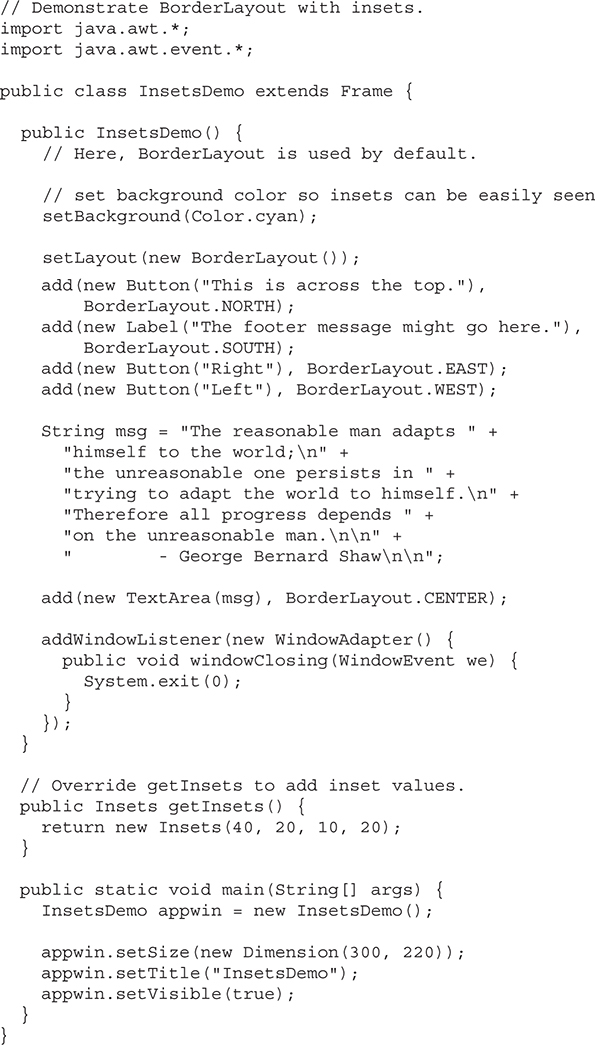
Sample output from the InsetsDemo program is shown here:
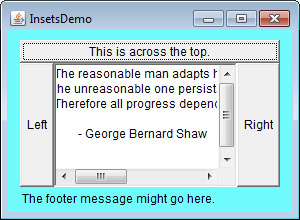
GridLayout lays out components in a two-dimensional grid. When you instantiate a GridLayout, you define the number of rows and columns. The constructors supported by GridLayout are shown here:
GridLayout( )
GridLayout(int numRows, int numColumns)
GridLayout(int numRows, int numColumns, int horz, int vert)
The first form creates a single-column grid layout. The second form creates a grid layout with the specified number of rows and columns. The third form allows you to specify the horizontal and vertical space left between components in horz and vert, respectively. Either numRows or numColumns can be zero. Specifying numRows as zero allows for unlimited-length columns. Specifying numColumns as zero allows for unlimited-length rows.
Here is a sample program that creates a 4×4 grid and fills it in with 15 buttons, each labeled with its index:
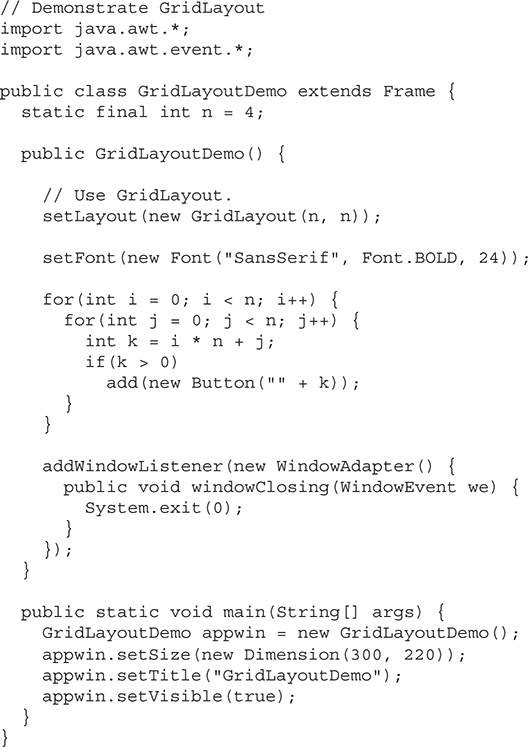
Following is sample output generated by the GridLayoutDemo program:
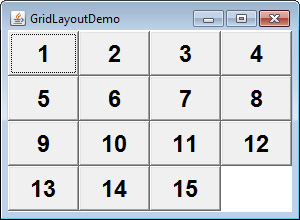
Tip You might try using this example as the starting point for a 15-square puzzle.
The CardLayout class is unique among the other layout managers in that it stores several different layouts. Each layout can be thought of as being on a separate index card in a deck that can be shuffled so that any card is on top at a given time. This can be useful for user interfaces with optional components that can be dynamically enabled and disabled upon user input. You can prepare the other layouts and have them hidden, ready to be activated when needed.
CardLayout provides these two constructors:
CardLayout( )
CardLayout(int horz, int vert)
The first form creates a default card layout. The second form allows you to specify the horizontal and vertical space left between components in horz and vert, respectively.
Use of a card layout requires a bit more work than the other layouts. The cards are typically held in an object of type Panel. This panel must have CardLayout selected as its layout manager. The cards that form the deck are also typically objects of type Panel. Thus, you must create a panel that contains the deck and a panel for each card in the deck. Next, you add to the appropriate panel the components that form each card. You then add these panels to the panel for which CardLayout is the layout manager. Finally, you add this panel to the window. Once these steps are complete, you must provide some way for the user to select between cards. One common approach is to include one push button for each card in the deck.
When card panels are added to a panel, they are usually given a name. One way to do this is to use this form of add( ) when adding cards to a panel:
void add(Component panelRef, Object name)
Here, name is a string that specifies the name of the card whose panel is specified by panelRef.
After you have created a deck, your program activates a card by calling one of the following methods defined by CardLayout:
void first(Container deck)
void last(Container deck)
void next(Container deck)
void previous(Container deck)
void show(Container deck, String cardName)
Here, deck is a reference to the container (usually a panel) that holds the cards, and cardName is the name of a card. Calling first( ) causes the first card in the deck to be shown. To show the last card, call last( ). To show the next card, call next( ). To show the previous card, call previous( ). Both next( ) and previous( ) automatically cycle back to the top or bottom of the deck, respectively. The show( ) method displays the card whose name is passed in cardName.
The following example creates a two-level card deck that allows the user to select an operating system. Windows-based operating systems are displayed in one card. Mac OS, Android, and Linux are displayed in the other card.
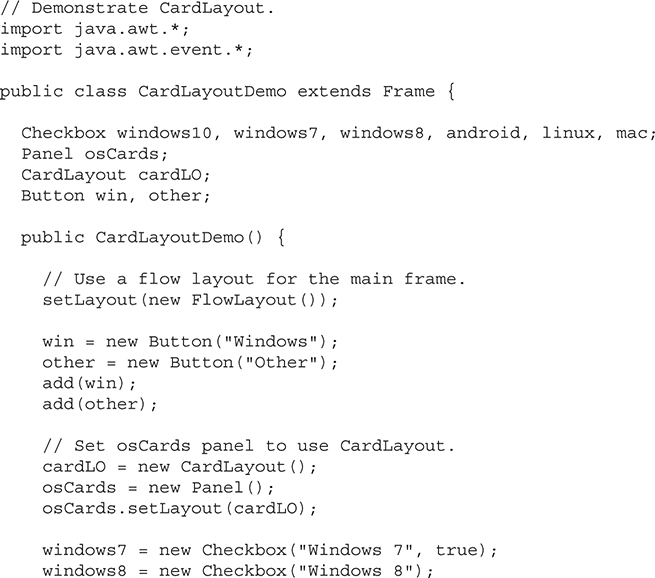
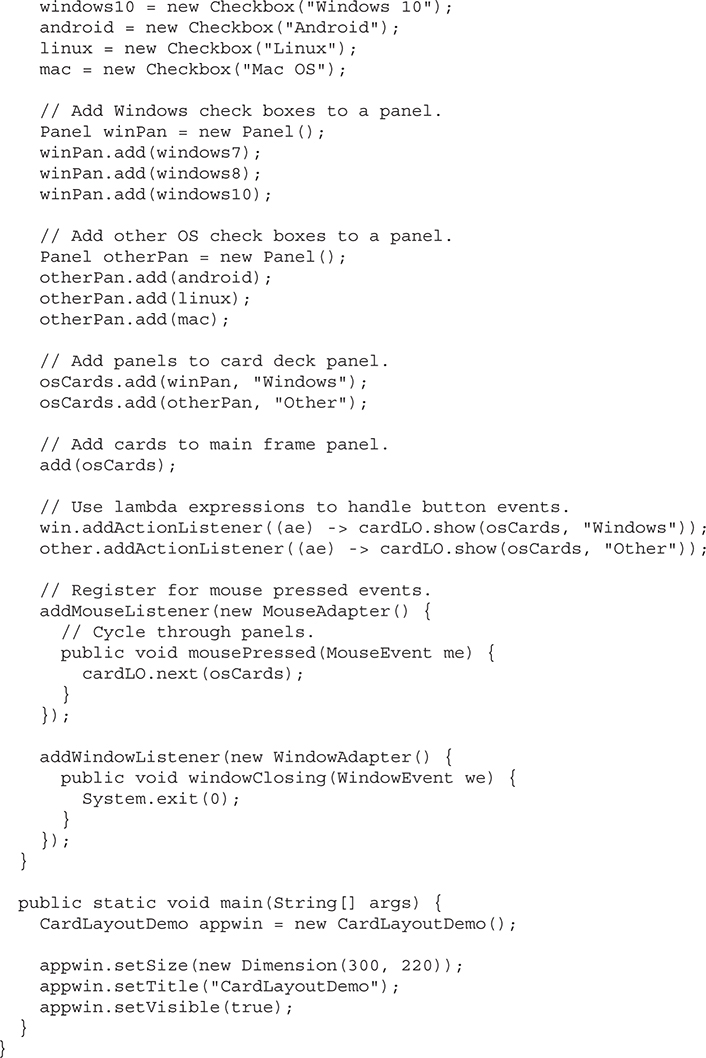
Here is sample output generated by the CardLayoutDemo program. Each card is activated by pushing its button. You can also cycle through the cards by clicking the mouse.

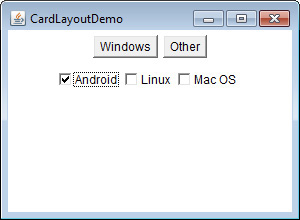
Although the preceding layouts are perfectly acceptable for many uses, some situations will require that you take a bit more control over how the components are arranged. A good way to do this is to use a grid bag layout, which is specified by the GridBagLayout class. What makes the grid bag useful is that you can specify the relative placement of components by specifying their positions within cells inside a grid. The key to the grid bag is that each component can be a different size, and each row in the grid can have a different number of columns. This is why the layout is called a grid bag. It’s a collection of small grids joined together.
The location and size of each component in a grid bag are determined by a set of constraints linked to it. The constraints are contained in an object of type GridBagConstraints. Constraints include the height and width of a cell, and the placement of a component, its alignment, and its anchor point within the cell.
The general procedure for using a grid bag is to first create a new GridBagLayout object and to make it the current layout manager. Then, set the constraints that apply to each component that will be added to the grid bag. Finally, add the components to the layout manager. Although GridBagLayout is a bit more complicated than the other layout managers, it is still quite easy to use once you understand how it works.
GridBagLayout defines only one constructor, which is shown here:
GridBagLayout( )
GridBagLayout defines several methods, of which many are protected and not for general use. There is one method, however, that you must use: setConstraints( ). It is shown here:
void setConstraints(Component comp, GridBagConstraints cons)
Here, comp is the component for which the constraints specified by cons apply. This method sets the constraints that apply to each component in the grid bag.
The key to successfully using GridBagLayout is the proper setting of the constraints, which are stored in a GridBagConstraints object. GridBagConstraints defines several fields that you can set to govern the size, placement, and spacing of a component. These are shown in Table 27-1. Several are described in greater detail in the following discussion.
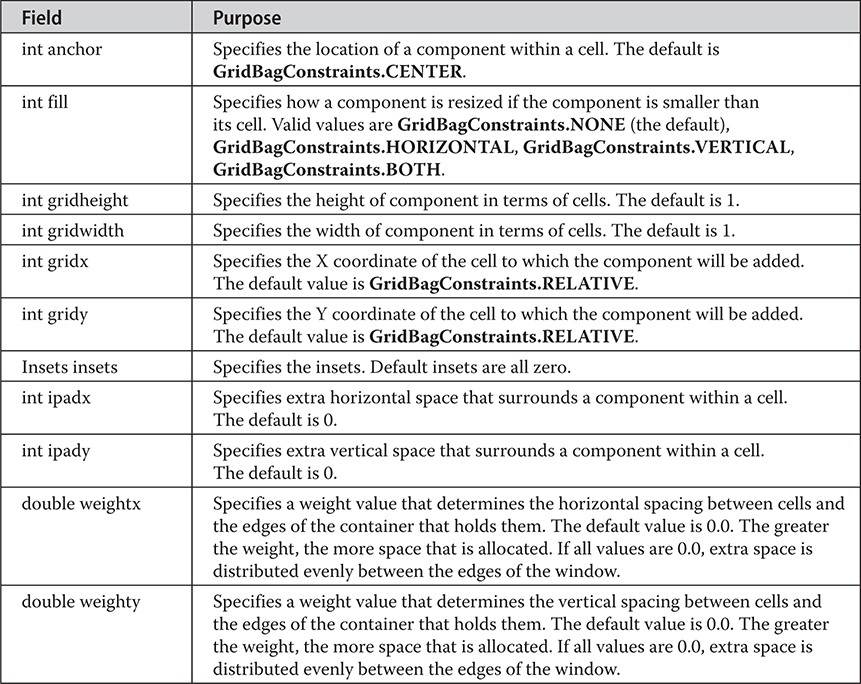
Table 27-1 Constraint Fields Defined by GridBagConstraints
GridBagConstraints also defines several static fields that contain standard constraint values, such as GridBagConstraints.CENTER and GridBagConstraints.VERTICAL.
When a component is smaller than its cell, you can use the anchor field to specify where within the cell the component’s top-left corner will be located. There are three types of values that you can give to anchor. The first are absolute:

As their names imply, these values cause the component to be placed at the specific locations.
The second type of values that can be given to anchor is relative, which means the values are relative to the container’s orientation, which might differ for non-Western languages. The relative values are shown here:

Their names describe the placement.
The third type of values that can be given to anchor allows you to position components relative to the baseline of the row. These values are shown here:

The horizontal position can be either centered, against the leading edge (LEADING), or against the trailing edge (TRAILING).
The weightx and weighty fields are both quite important and quite confusing at first glance. In general, their values determine how much of the extra space within a container is allocated to each row and column. By default, both these values are zero. When all values within a row or a column are zero, extra space is distributed evenly between the edges of the window. By increasing the weight, you increase that row or column’s allocation of space proportional to the other rows or columns. The best way to understand how these values work is to experiment with them a bit.
The gridwidth variable lets you specify the width of a cell in terms of cell units. The default is 1. To specify that a component use the remaining space in a row, use GridBagConstraints.REMAINDER. To specify that a component use the next-to-last cell in a row, use GridBagConstraints.RELATIVE. The gridheight constraint works the same way, but in the vertical direction.
You can specify a padding value that will be used to increase the minimum size of a cell. To pad horizontally, assign a value to ipadx. To pad vertically, assign a value to ipady.
Here is an example that uses GridBagLayout to demonstrate several of the points just discussed:
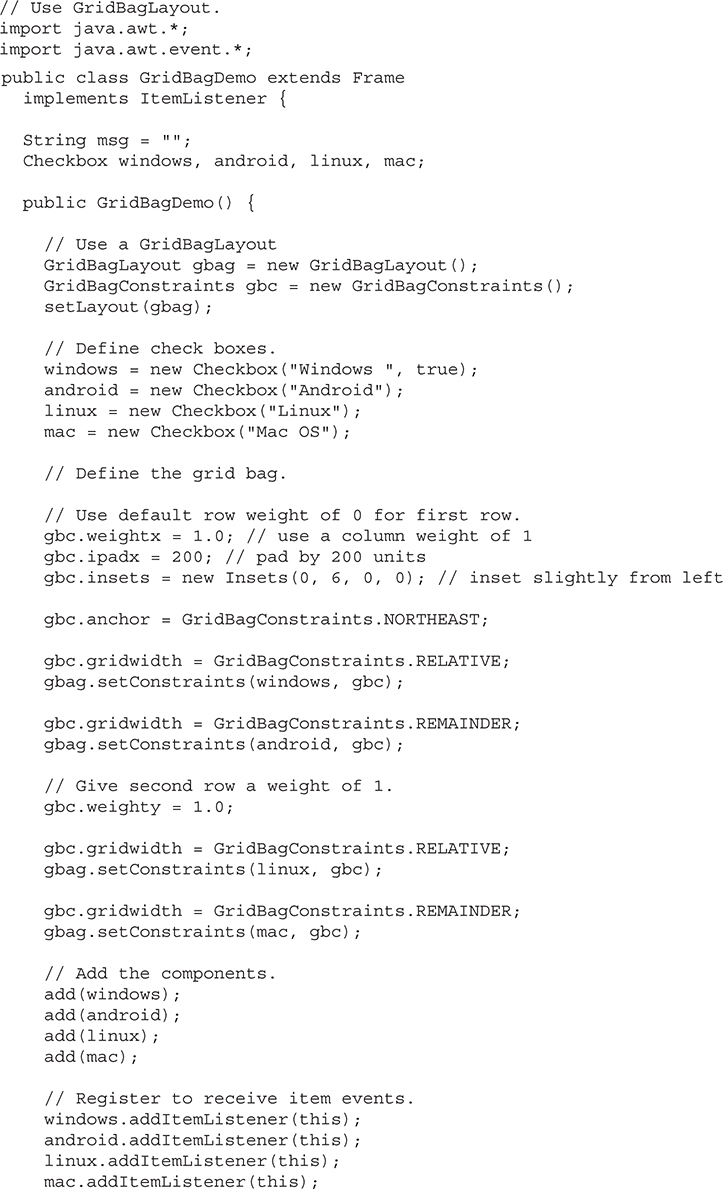
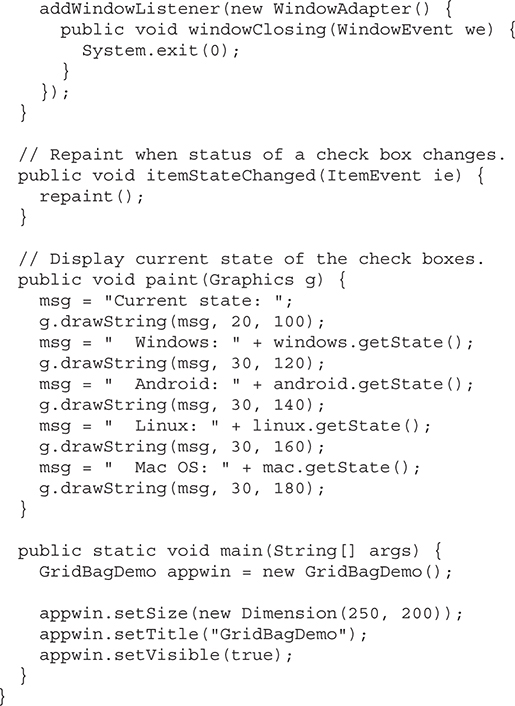
Sample output produced by the program is shown here.
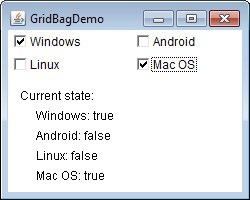
In this layout, the operating system check boxes are positioned in a 2×2 grid. Each cell has a horizontal padding of 200. Each component is inset slightly (by 6 units) from the left. The column weight is set to 1, which causes any extra horizontal space to be distributed evenly between the columns. The first row uses a default weight of 0; the second has a weight of 1. This means that any extra vertical space is added to the second row.
GridBagLayout is a powerful layout manager. It is worth taking some time to experiment with and explore. Once you understand what the various settings do, you can use GridBagLayout to position components with a high degree of precision.
A top-level window can have a menu bar associated with it. A menu bar displays a list of top-level menu choices. Each choice is associated with a drop-down menu. This concept is implemented in the AWT by the following classes: MenuBar, Menu, and MenuItem. In general, a menu bar contains one or more Menu objects. Each Menu object contains a list of MenuItem objects. Each MenuItem object represents something that can be selected by the user. Since Menu is a subclass of MenuItem, a hierarchy of nested submenus can be created. It is also possible to include checkable menu items. These are menu options of type CheckboxMenuItem and will have a check mark next to them when they are selected.
To create a menu bar, first create an instance of MenuBar. This class defines only the default constructor. Next, create instances of Menu that will define the selections displayed on the bar. Following are the constructors for Menu:
Menu( ) throws HeadlessException
Menu(String optionName) throws HeadlessException
Menu(String optionName, boolean removable) throws HeadlessException
Here, optionName specifies the name of the menu selection. If removable is true, the menu can be removed and allowed to float free. Otherwise, it will remain attached to the menu bar. (Removable menus are implementation-dependent.) The first form creates an empty menu.
Individual menu items are of type MenuItem. It defines these constructors:
MenuItem( ) throws HeadlessException
MenuItem(String itemName) throws HeadlessException
MenuItem(String itemName, MenuShortcut keyAccel) throws HeadlessException
Here, itemName is the name shown in the menu, and keyAccel is the menu shortcut for this item.
You can disable or enable a menu item by using the setEnabled( ) method. Its form is shown here:
void setEnabled(boolean enabledFlag)
If the argument enabledFlag is true, the menu item is enabled. If false, the menu item is disabled.
You can determine an item’s status by calling isEnabled( ). This method is shown here:
boolean isEnabled( )
isEnabled( ) returns true if the menu item on which it is called is enabled. Otherwise, it returns false.
You can change the name of a menu item by calling setLabel( ). You can retrieve the current name by using getLabel( ). These methods are as follows:
void setLabel(String newName)
String getLabel( )
Here, newName becomes the new name of the invoking menu item. getLabel( ) returns the current name.
You can create a checkable menu item by using a subclass of MenuItem called CheckboxMenuItem. It has these constructors:
CheckboxMenuItem( ) throws HeadlessException
CheckboxMenuItem(String itemName) throws HeadlessException
CheckboxMenuItem(String itemName, boolean on) throws HeadlessException
Here, itemName is the name shown in the menu. Checkable items operate as toggles. Each time one is selected, its state changes. In the first two forms, the checkable entry is unchecked. In the third form, if on is true, the checkable entry is initially checked. Otherwise, it is cleared.
You can obtain the status of a checkable item by calling getState( ). You can set it to a known state by using setState( ). These methods are shown here:
boolean getState( )
void setState(boolean checked)
If the item is checked, getState( ) returns true. Otherwise, it returns false. To check an item, pass true to setState( ). To clear an item, pass false.
Once you have created a menu item, you must add the item to a Menu object by using add( ), which has the following general form:
MenuItem add(MenuItem item)
Here, item is the item being added. Items are added to a menu in the order in which the calls to add( ) take place. The item is returned.
Once you have added all items to a Menu object, you can add that object to the menu bar by using this version of add( ) defined by MenuBar:
Menu add(Menu menu)
Here, menu is the menu being added. The menu is returned.
Menus generate events only when an item of type MenuItem or CheckboxMenuItem is selected. They do not generate events when a menu bar is accessed to display a drop-down menu, for example. Each time a menu item is selected, an ActionEvent object is generated. By default, the action command string is the name of the menu item. However, you can specify a different action command string by calling setActionCommand( ) on the menu item. Each time a check box menu item is checked or unchecked, an ItemEvent object is generated. Thus, you must implement the ActionListener and/or ItemListener interfaces in order to handle these menu events.
The getItem( ) method of ItemEvent returns a reference to the item that generated this event. The general form of this method is shown here:
Object getItem( )
Following is an example that adds a series of nested menus to a pop-up window. The item selected is displayed in the window. The state of the two check box menu items is also displayed.
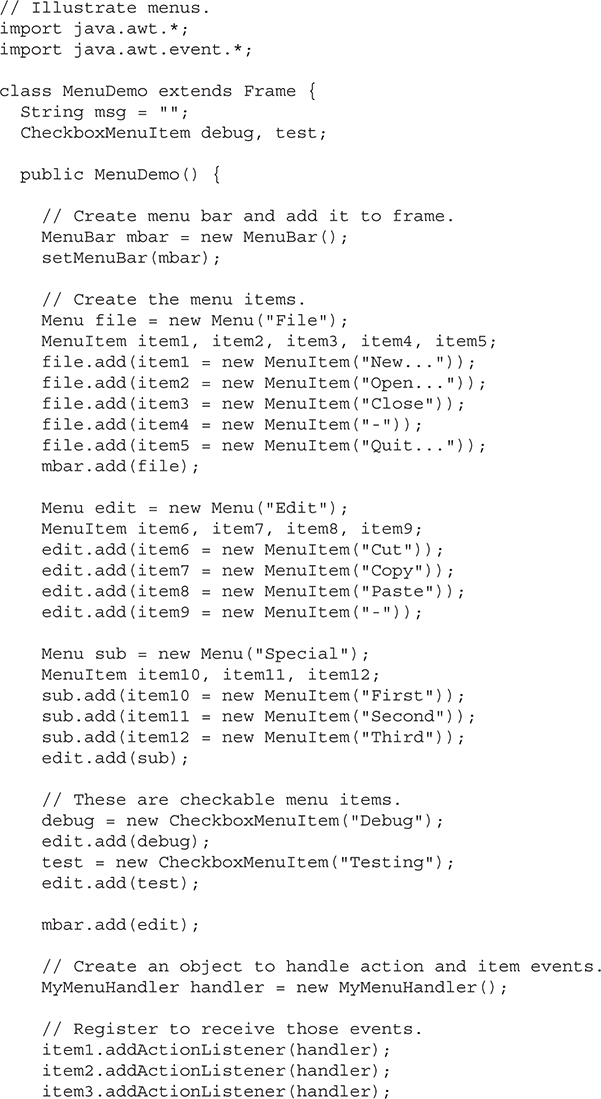
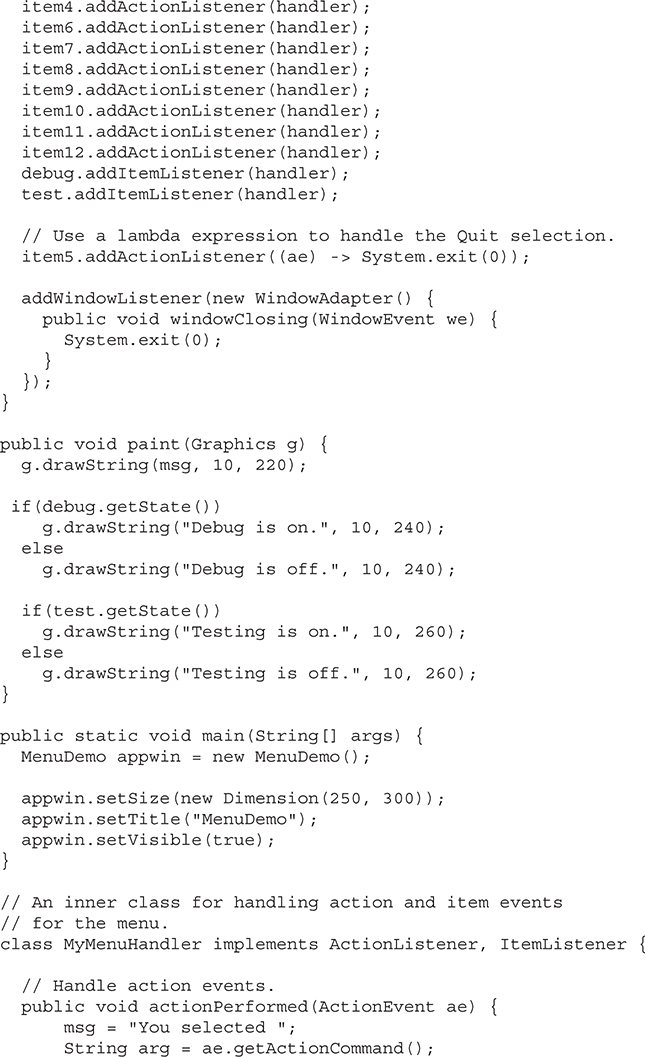
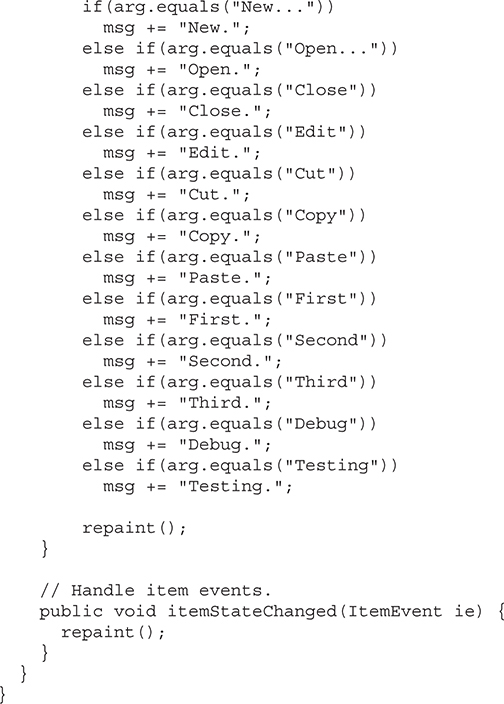
Sample output from the MenuDemo program is shown in Figure 27-8.
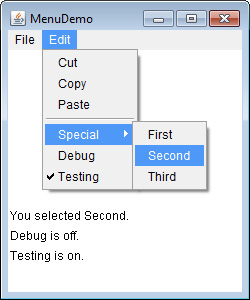
Figure 27-8 Sample output from the MenuDemo program
There is one other menu-related class that you might find interesting: PopupMenu. It works just like Menu, but produces a menu that can be displayed at a specific location. PopupMenu provides a flexible, useful alternative for some types of menuing situations.
Often, you will want to use a dialog box to hold a set of related controls. Dialog boxes are primarily used to obtain user input and are often child windows of a top-level window. Dialog boxes don’t have menu bars, but in other respects, they function like frame windows. (You can add controls to them, for example, in the same way that you add controls to a frame window.) Dialog boxes may be modal or modeless. In general terms, when a modal dialog box is active, you cannot access other windows in your program (except for child windows of the dialog window) until you have closed the dialog box. When a modeless dialog box is active, input focus can be directed to another window in your program. Thus, other parts of your program remain active and accessible. Beginning with JDK 6, modal dialog boxes can be created with three different types of modality, as specified by the Dialog.ModalityType enumeration. The default is APPLICATION_MODAL, which prevents the use of other top-level windows in the application. This is the traditional type of modality. Other types are DOCUMENT_MODAL and TOOLKIT_MODAL. The MODELESS type is also included.
In the AWT, dialog boxes are of type Dialog. Two commonly used constructors are shown here:
Dialog(Frame parentWindow, boolean mode)
Dialog(Frame parentWindow, String title, boolean mode)
Here, parentWindow is the owner of the dialog box. If mode is true, the dialog box uses the default modality. Otherwise, it is modeless. The title of the dialog box can be passed in title. Generally, you will subclass Dialog, adding the functionality required by your application.
Following is a modified version of the preceding menu program that displays a modeless dialog box when the New option is chosen. Notice that when the dialog box is closed, dispose( ) is called. This method is defined by Window, and it frees all system resources associated with the dialog box window.
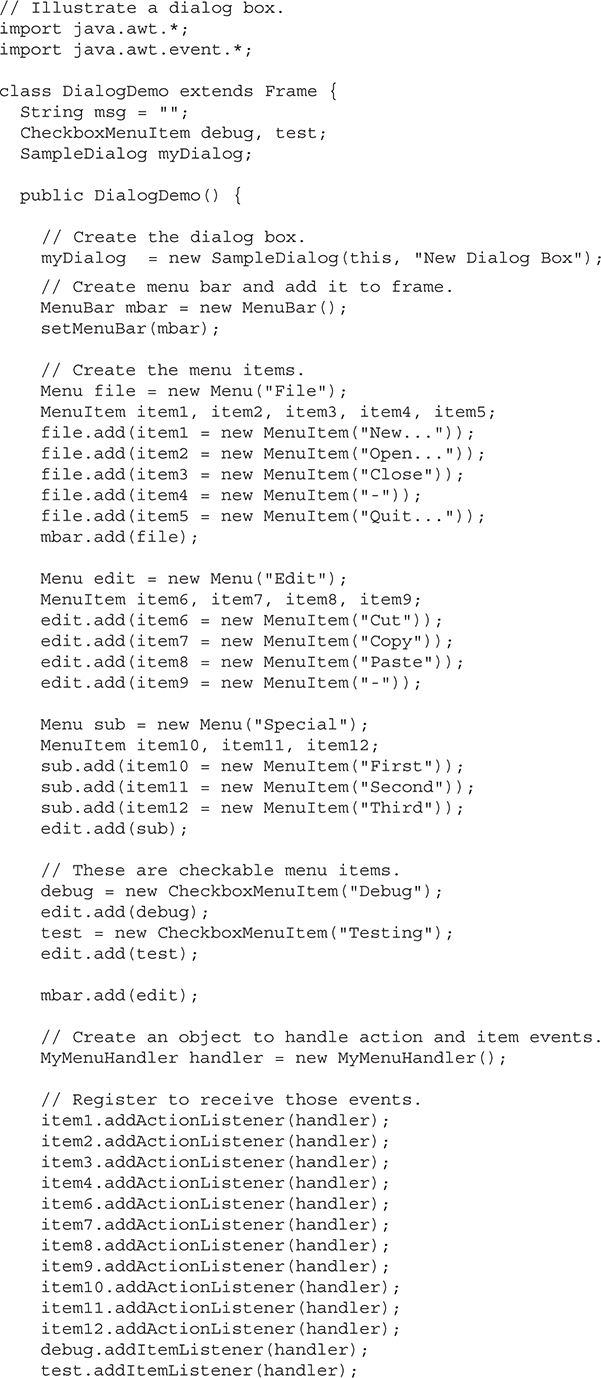
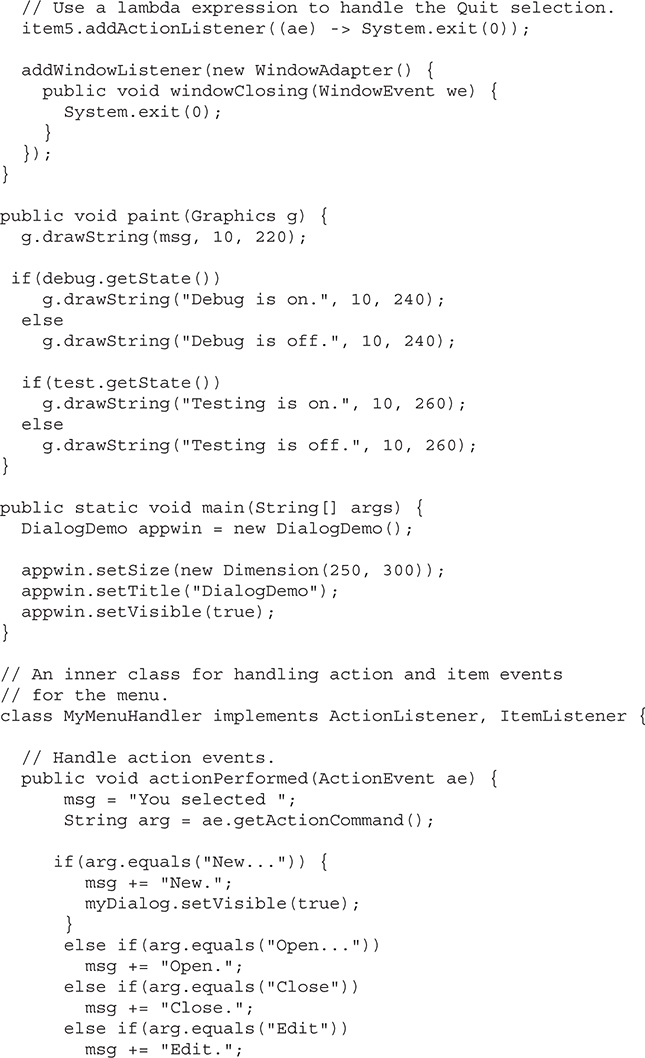
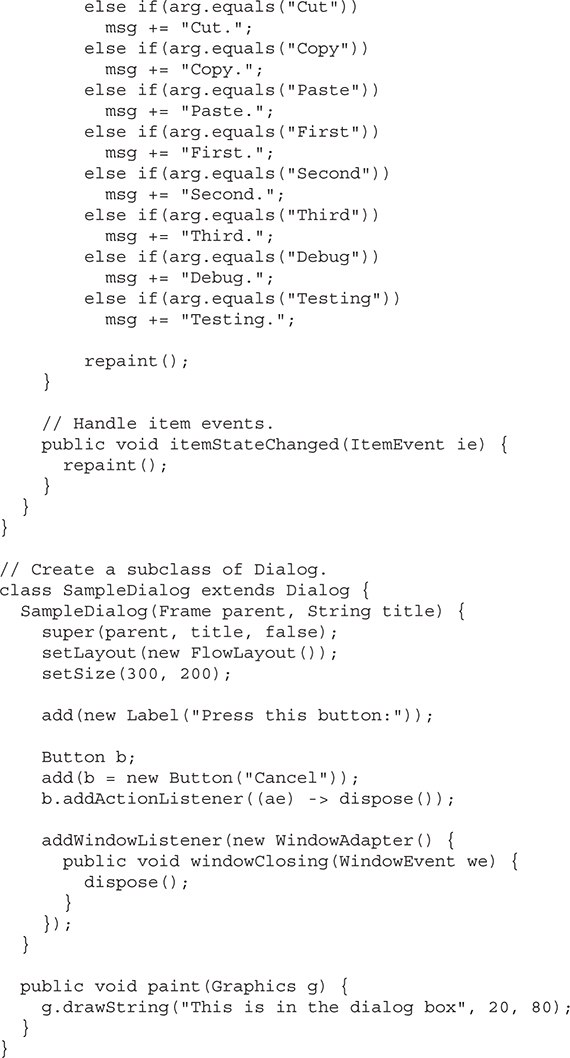
Here is sample output from the DialogDemo program:
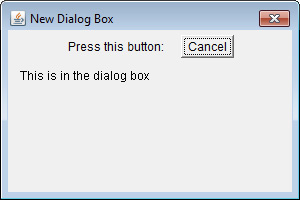
Tip On your own, try defining dialog boxes for the other options presented by the menus.
Before concluding our examination of AWT controls, a short word about overriding paint( ) is in order. Although not relevant to the simple AWT examples shown in this book, when overriding paint( ), there are times when it is necessary to call the superclass implementation of paint( ). Therefore, for some programs, you will need to use this paint( ) skeleton:
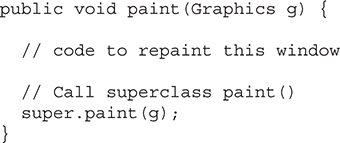
In Java, there are two general types of components: heavyweight and lightweight. A heavyweight component has its own native window, which is called its peer. A lightweight component is implemented completely in Java code and uses the window provided by an ancestor. The AWT controls described and used in this chapter are all heavyweight. However, if a container holds any lightweight components (that is, has lightweight child components), your override of paint( ) for that container must call super.paint( ). By calling super.paint( ), you ensure that any lightweight child components, such as lightweight controls, get properly painted. If you are unsure of a child component’s type, you can call isLightweight( ), defined by Component, to find out. It returns true if the component is lightweight, and false otherwise.
This chapter examines the Image class and the java.awt.image package. Together, they provide support for imaging (the display and manipulation of graphical images). An image is simply a rectangular graphical object. Images are a key component of web design. In fact, the inclusion of the <img> tag in the Mosaic browser at NCSA (National Center for Supercomputer Applications) was a catalyst that helped the Web begin to grow explosively in 1993. This tag was used to include an image inline with the flow of hypertext. Java expands upon this basic concept, allowing images to be managed under program control. Because of its importance, Java provides extensive support for imaging.
Images are supported by the Image class, which is part of the java.awt package. Images are manipulated using the classes found in the java.awt.image package. There are a large number of imaging classes and interfaces defined by java.awt.image, and it is not possible to examine them all. Instead, we will focus on those that form the foundation of imaging. Here are the java.awt.image classes discussed in this chapter:

The interfaces that we will use are ImageConsumer and ImageProducer.
Originally, web images could only be in GIF format. The GIF image format was created by CompuServe in 1987 to make it possible for images to be viewed while online, so it was well suited to the Internet. GIF images can have only up to 256 colors each. This limitation caused the major browser vendors to add support for JPEG images in 1995. The JPEG format was created by a group of photographic experts to store full-color-spectrum, continuous-tone images. These images, when properly created, can be of much higher fidelity as well as more highly compressed than a GIF encoding of the same source image. Another file format is PNG. It too is an alternative to GIF. In almost all cases, you will never care or notice which format is being used in your programs. The Java image classes abstract the differences behind a clean interface.
There are three common operations that occur when you work with images: creating an image, loading an image, and displaying an image. In Java, the Image class is used to refer to images in memory and to images that must be loaded from external sources. Thus, Java provides ways for you to create a new image object and ways to load one. It also provides a means by which an image can be displayed. Let’s look at each.
You might expect that you create a memory image using something like the following:
Image test = new Image(200, 100); // Error -- won’t work
Not so. Because images must eventually be painted on a window to be seen, the Image class doesn’t have enough information about its environment to create the proper data format for the screen. Therefore, the Component class in java.awt has a factory method called createImage( ) that is used to create Image objects. (Remember that all of the AWT components are subclasses of Component, so all support this method.)
The createImage( ) method has the following two forms:
Image createImage(ImageProducer imgProd)
Image createImage(int width, int height)
The first form returns an image produced by imgProd, which is an object of a class that implements the ImageProducer interface. (We will look at image producers later.) The second form returns a blank (that is, empty) image that has the specified width and height. Here is an example:
Canvas c = new Canvas();
Image test = c.createImage(200, 100);
This creates an instance of Canvas and then calls the createImage( ) method to actually make an Image object. At this point, the image is blank. Later, you will see how to write data to it.
Another way to obtain an image is to load one, either from a file on the local file system or from a URL. Here, we will use the local file system. The easiest way to load an image is to use one of the static methods defined by the ImageIO class. ImageIO provides extensive support for reading and writing images. It is packaged in javax.imageio, and beginning with JDK 9, javax.imageio is part of the java.desktop module. The method that loads an image is called read( ). The form we will use is shown here:
static BufferedImage read(File imageFile) throws IOException
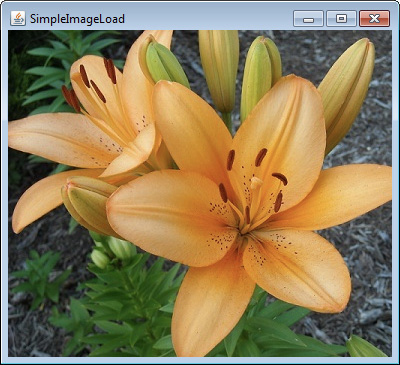
Figure 28-1 Sample output from SimpleImageLoad
Here, imageFile specifies the file that contains the image. It returns a reference to the image in the form of a BufferedImage, which is a subclass of Image that includes a buffer. Null is returned if the file does not contain a valid image.
Once you have an image, you can display it by using drawImage( ), which is a member of the Graphics class. It has several forms. The one we will be using is shown here:
boolean drawImage(Image imgObj, int left, int top, ImageObserver imgOb)
This displays the image passed in imgObj with its upper-left corner specified by left and top. imgOb is a reference to a class that implements the ImageObserver interface. This interface is implemented by all AWT (and Swing) components. An image observer is an object that can monitor an image while it loads. When no image observer is needed, imgOb can be null.
Using read( ) and drawImage( ), it is actually quite easy to load and display an image. Here is a program that loads and displays a single image. The file Lilies.jpg is loaded, but you can substitute any image you like (just make sure it is available in the same directory as the program). Sample output is shown in Figure 28-1.
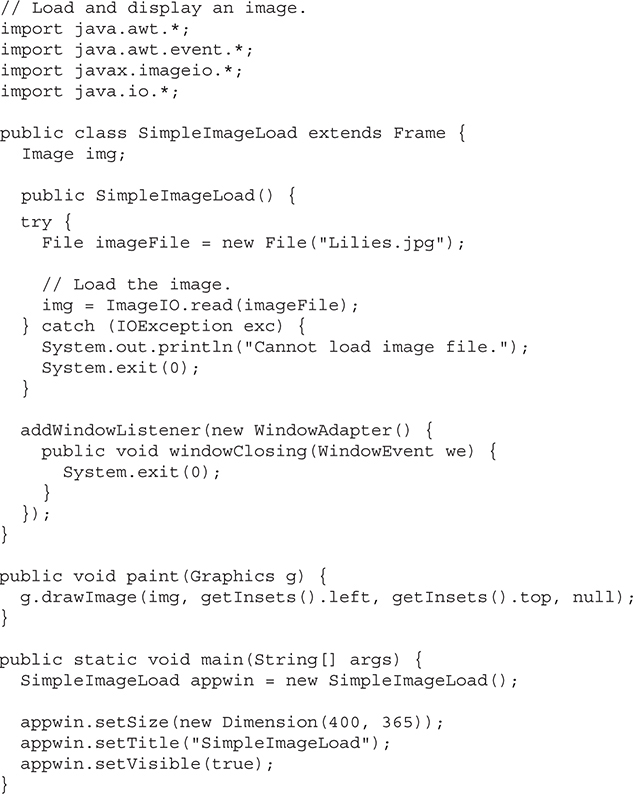
Not only are images useful for storing pictures, as we’ve just shown, but you can also use them as offscreen drawing surfaces. This allows you to render any image, including text and graphics, to an offscreen buffer that you can display at a later time. The advantage to doing this is that the image is seen only when it is complete. Drawing a complicated image could take several milliseconds or more, which can be seen by the user as flashing or flickering. This flashing is distracting and causes the user to perceive your rendering as slower than it actually is. Use of an offscreen image to reduce flicker is called double buffering, because the screen is considered a buffer for pixels, and the offscreen image is the second buffer, where you can prepare pixels for display.
Earlier in this chapter, you saw how to create a blank Image object. Now you will see how to draw on that image rather than the screen. As you recall from earlier chapters, you need a Graphics object in order to use any of Java’s rendering methods. Conveniently, the Graphics object that you can use to draw on an Image is available via the getGraphics( ) method. Here is a code fragment that creates a new image, obtains its graphics context, and fills the entire image with red pixels:

Once you have constructed and filled an offscreen image, it will still not be visible. To actually display the image, call drawImage( ). Here is an example that draws a time-consuming image to demonstrate the difference that double buffering can make in perceived drawing time:
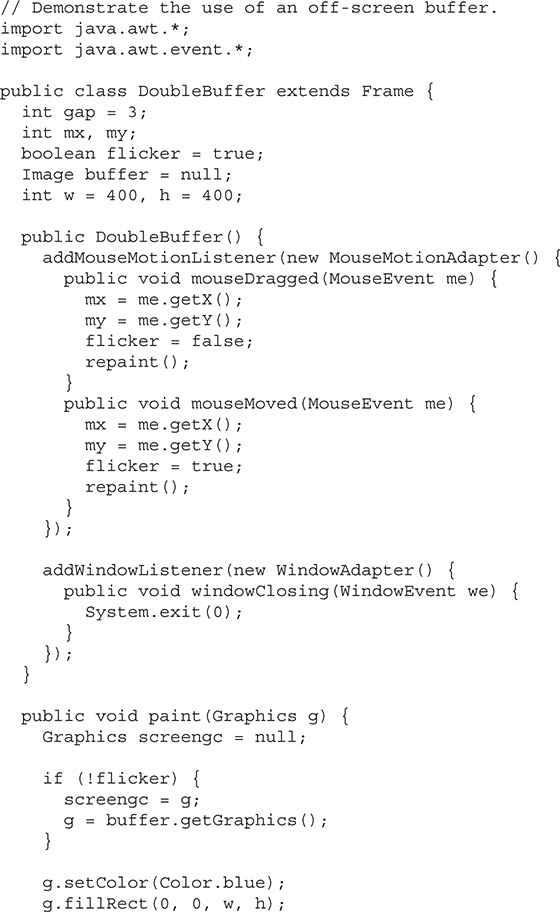
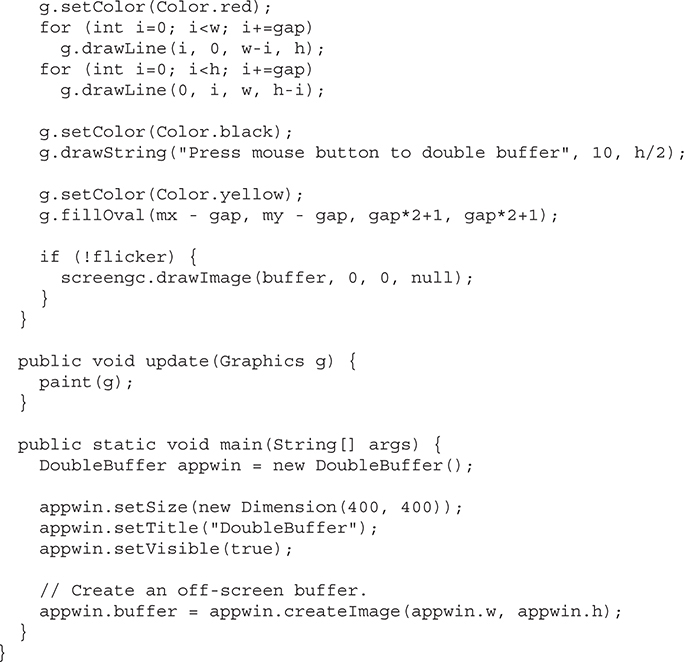
This simple program has a complicated paint( ) method. It fills the background with blue and then draws a red moiré pattern on top of that. It paints some black text on top of that and then paints a yellow circle centered at the coordinates mx, my. The mouseMoved( ) and mouseDragged( ) methods are overridden to track the mouse position. These methods are identical, except for the setting of the flicker Boolean variable. mouseMoved( ) sets flicker to true, and mouseDragged( ) sets it to false. This has the effect of calling repaint( ) with flicker set to true when the mouse is moved (but no button is pressed) and set to false when the mouse is dragged with any button pressed.
When paint( ) gets called with flicker set to true, we see each drawing operation as it is executed on the screen. In the case where a mouse button is pressed and paint( ) is called with flicker set to false, we see quite a different picture. The paint( ) method swaps the Graphics reference g with the graphics context that refers to the offscreen canvas, buffer, which we created in main( ). Then all of the drawing operations are invisible. At the end of paint( ), we simply call drawImage( ) to show the results of these drawing methods all at once.
Sample output is shown in Figure 28-2. The left snapshot is what the screen looks like with the mouse button not pressed. As you can see, the image was in the middle of repainting when this snapshot was taken. The right snapshot shows how, when a mouse button is pressed, the image is always complete and clean due to double buffering.

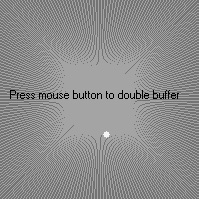
Figure 28-2 Output from DoubleBuffer without (left) and with (right) double buffering
ImageProducer is an interface for objects that want to produce data for images. An object that implements the ImageProducer interface will supply integer or byte arrays that represent image data and produce Image objects. As you saw earlier, one form of the createImage( ) method takes an ImageProducer object as its argument. There are two image producers contained in java.awt.image: MemoryImageSource and FilteredImageSource. Here, we will examine MemoryImageSource and create a new Image object from generated data.
MemoryImageSource is a class that creates a new Image from an array of data. It defines several constructors. Here is the one we will be using:
MemoryImageSource(int width, int height, int[ ] pixel, int offset,
int scanLineWidth)
The MemoryImageSource object is constructed out of the array of integers specified by pixel, in the default RGB color model to produce data for an Image object. In the default color model, a pixel is an integer with Alpha, Red, Green, and Blue (0xAARRGGBB). The Alpha value represents a degree of transparency for the pixel. Fully transparent is 0 and fully opaque is 255. The width and height of the resulting image are passed in width and height. The starting point in the pixel array to begin reading data is passed in offset. The width of a scan line (which is often the same as the width of the image) is passed in scanLineWidth.
The following short example generates a MemoryImageSource object using a variation on a simple algorithm (a bitwise-exclusive-OR of the x and y address of each pixel) from the book Beyond Photography: The Digital Darkroom by Gerard J. Holzmann (Prentice Hall, 1988).
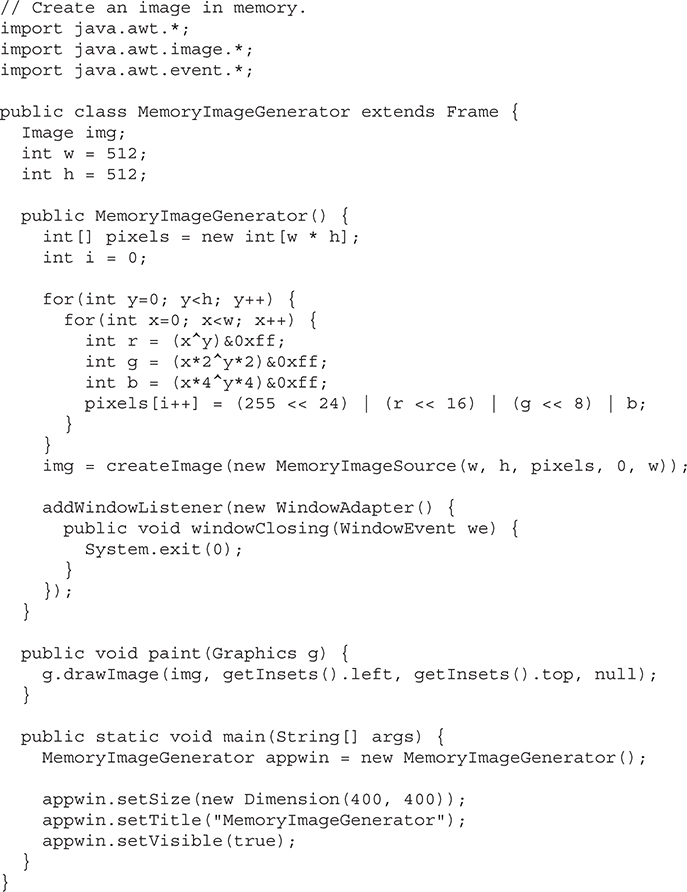
The data for the new MemoryImageSource is created in the constructor. An array of integers is created to hold the pixel values; the data is generated in the nested for loops where the r, g, and b values get shifted into a pixel in the pixels array. Finally, createImage( ) is called with a new instance of a MemoryImageSource created from the raw pixel data as its parameter. Figure 28-3 shows the image.
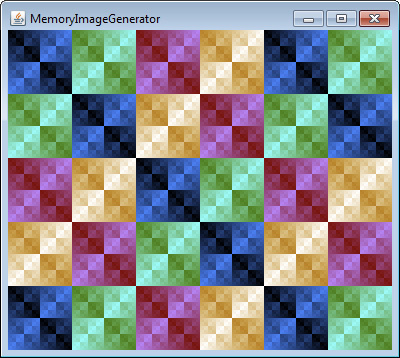
Figure 28-3 Sample output from MemoryImageGenerator
ImageConsumer is an interface for objects that want to take pixel data from images and supply it as another kind of data. This, obviously, is the opposite of ImageProducer, described earlier. An object that implements the ImageConsumer interface is going to create int or byte arrays that represent pixels from an Image object. We will examine the PixelGrabber class, which is a simple implementation of the ImageConsumer interface.
The PixelGrabber class is defined within java.lang.image. It is the inverse of the MemoryImageSource class. Rather than constructing an image from an array of pixel values, it takes an existing image and grabs the pixel array from it. To use PixelGrabber, you first create an array of ints big enough to hold the pixel data, and then you create a PixelGrabber instance passing in the rectangle that you want to grab. Finally, you call grabPixels( ) on that instance.
The PixelGrabber constructor that is used in this chapter is shown here:
PixelGrabber(Image imgObj, int left, int top, int width, int height, int[ ] pixel,
int offset, int scanLineWidth)
Here, imgObj is the object whose pixels are being grabbed. The values of left and top specify the upper-left corner of the rectangle, and width and height specify the dimensions of the rectangle from which the pixels will be obtained. The pixels will be stored in pixel beginning at offset. The width of a scan line (which is often the same as the width of the image) is passed in scanLineWidth.
grabPixels( ) is defined like this:
boolean grabPixels( )
throws InterruptedException
boolean grabPixels(long milliseconds)
throws InterruptedException
Both methods return true if successful and false otherwise. In the second form, milliseconds specifies how long the method will wait for the pixels. Both throw InterruptedException if execution is interrupted by another thread.
Here is an example that grabs the pixels from an image and then creates a histogram of pixel brightness. The histogram is simply a count of pixels that are a certain brightness for all brightness settings between 0 and 255. After the program paints the image, it draws the histogram over the top.
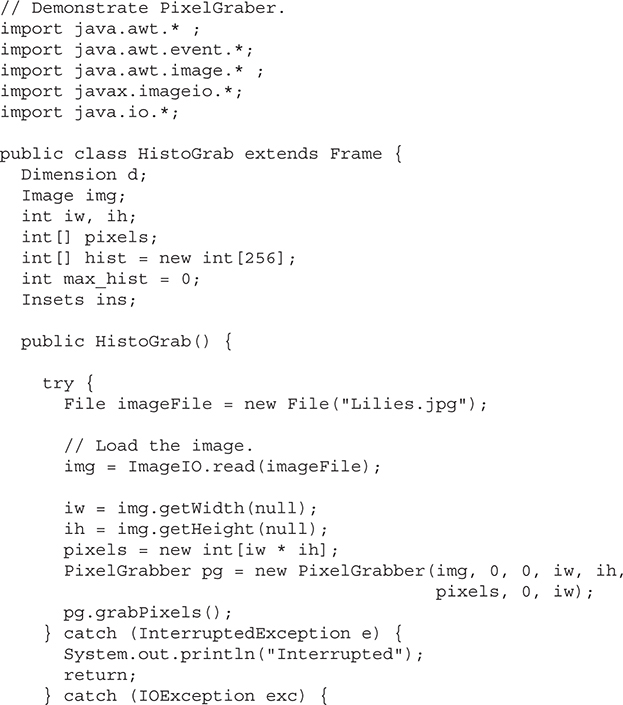
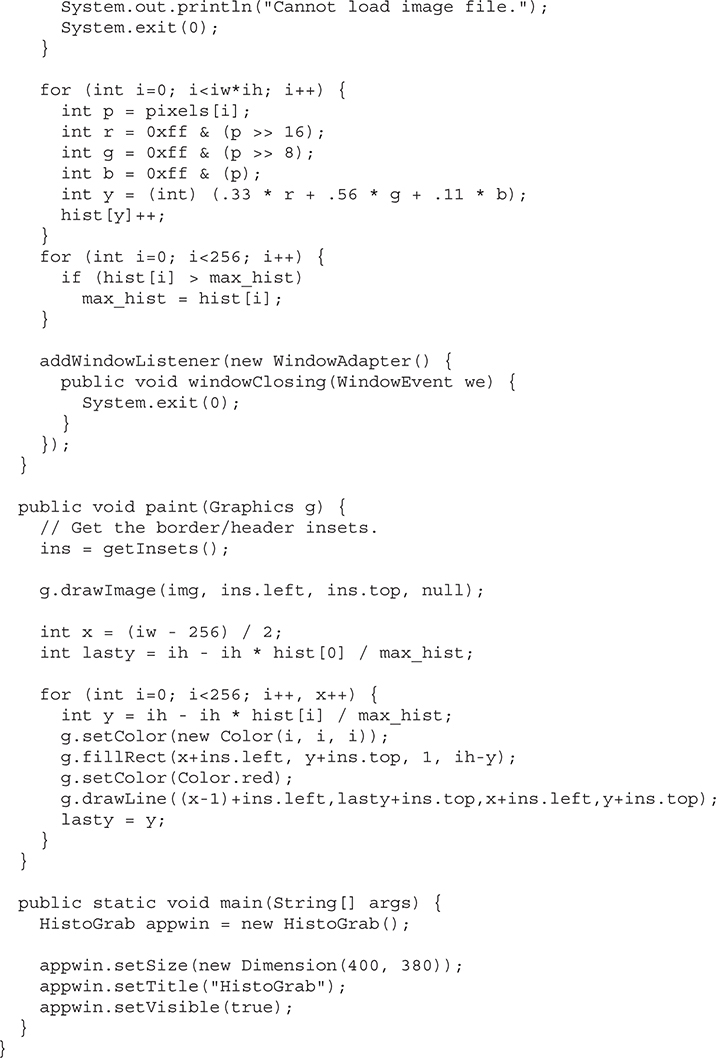
Figure 28-4 shows an example image and its histogram.
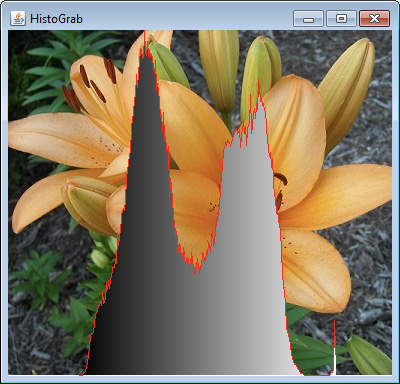
Figure 28-4 Sample output from HistoGrab
Given the ImageProducer and ImageConsumer interface pair—and their concrete classes MemoryImageSource and PixelGrabber—you can create an arbitrary set of translation filters that takes a source of pixels, modifies them, and passes them on to an arbitrary consumer. This mechanism is analogous to the way concrete classes are created from the abstract I/O classes InputStream, OutputStream, Reader, and Writer (described in Chapter 22). This stream model for images is completed by the introduction of the ImageFilter class. Some subclasses of ImageFilter in the java.awt.image package are AreaAveragingScaleFilter, CropImageFilter, ReplicateScaleFilter, and RGBImageFilter. There is also an implementation of ImageProducer called FilteredImageSource, which takes an arbitrary ImageFilter and wraps it around an ImageProducer to filter the pixels it produces. An instance of FilteredImageSource can be used as an ImageProducer in calls to createImage( ), in much the same way that BufferedInputStreams can be used as InputStreams.
In this chapter, we examine two filters: CropImageFilter and RGBImageFilter.
CropImageFilter filters an image source to extract a rectangular region. One situation in which this filter is valuable is where you want to use several small images from a single, larger source image. Loading twenty 2K images takes much longer than loading a single 40K image that has many frames of an animation tiled into it. If every subimage is the same size, then you can easily extract these images by using CropImageFilter to disassemble the block once your program starts. Here is an example that creates 16 images taken from a single image. The tiles are then scrambled by swapping a random pair from the 16 images 32 times.
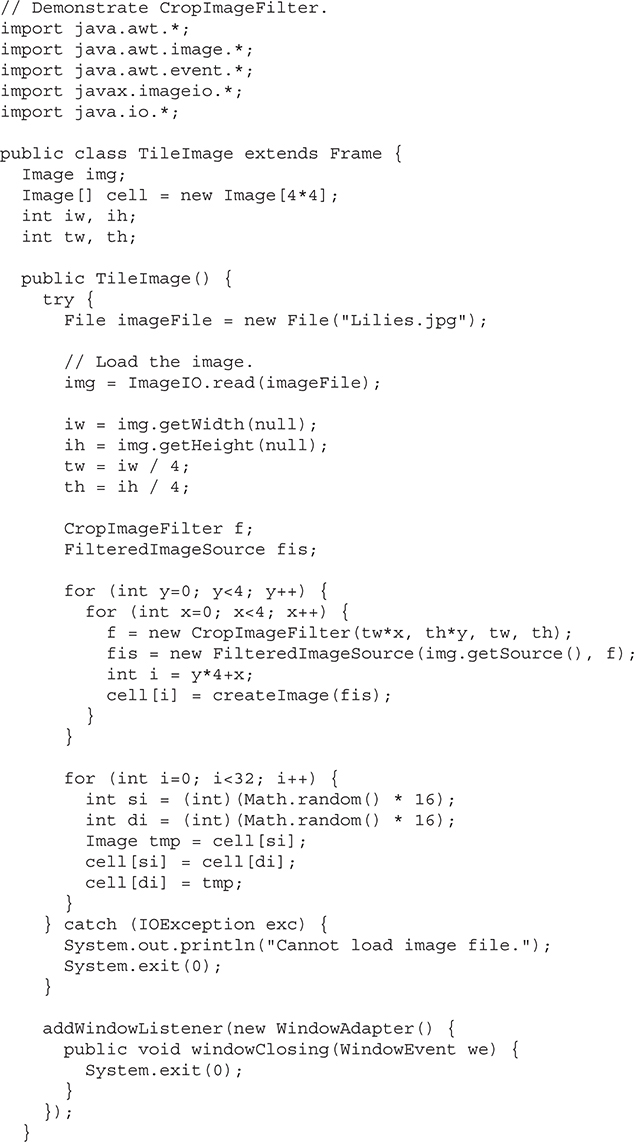
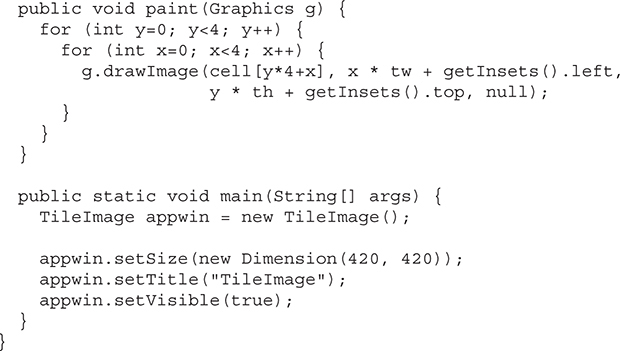
Figure 28-5 shows the flowers image scrambled by TileImage.
The RGBImageFilter is used to convert one image to another, pixel by pixel, transforming the colors along the way. This filter could be used to brighten an image, to increase its contrast, or even to convert it to grayscale.
To demonstrate RGBImageFilter, we have developed a somewhat complicated example that employs a dynamic plug-in strategy for image-processing filters. We’ve created an interface for generalized image filtering so that a program can simply load these filters at run time without having to know about all of the ImageFilters in advance. This example consists of the main class called ImageFilterDemo, the interface called PlugInFilter, and a utility class called LoadedImage. Also included are three filters—Grayscale, Invert, and Contrast—which simply manipulate the color space of the source image using RGBImageFilters, and two more classes—Blur and Sharpen—which do more complicated "convolution" filters that change pixel data based on the pixels surrounding each pixel of source data. Blur and Sharpen are subclasses of an abstract helper class called Convolver. Let’s look at each part of our example.
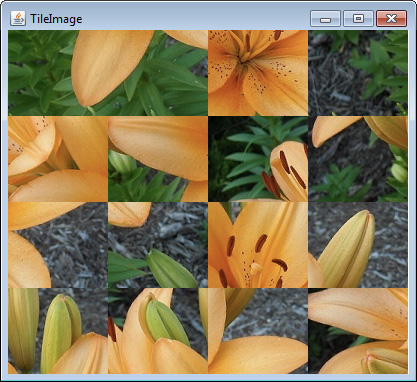
Figure 28-5 Sample output from TileImage
The ImageFilterDemo class is the main class for the sample image filters. It employs the default BorderLayout, with a Panel at the South position to hold the buttons that will represent each filter. A Label object occupies the North slot for informational messages about filter progress. The Center is where the image (which is encapsulated in the LoadedImage Canvas subclass, described later) is put.
The actionPerformed( ) method is interesting because it uses the label from a button as the name of a filter class that it loads. This method is robust and takes appropriate action if the button does not correspond to a proper class that implements PlugInFilter.
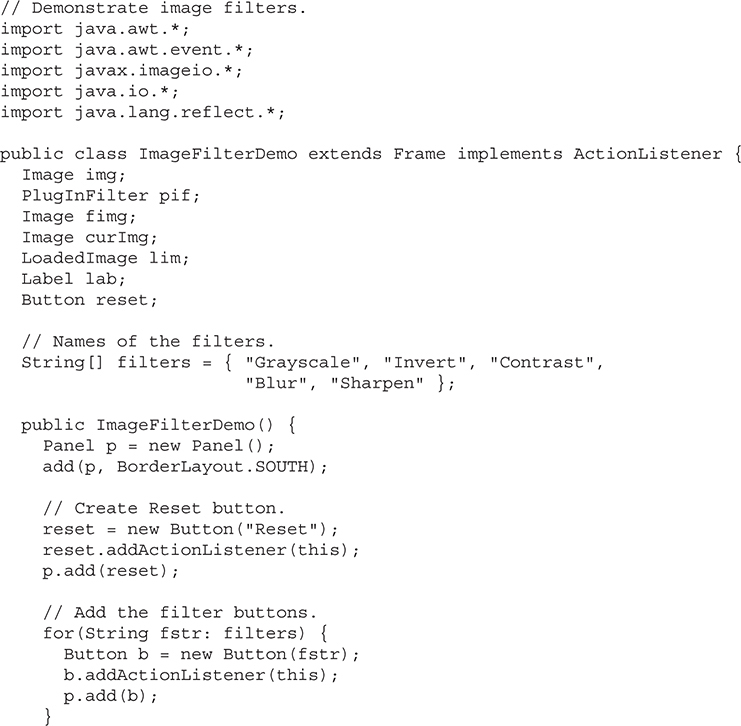
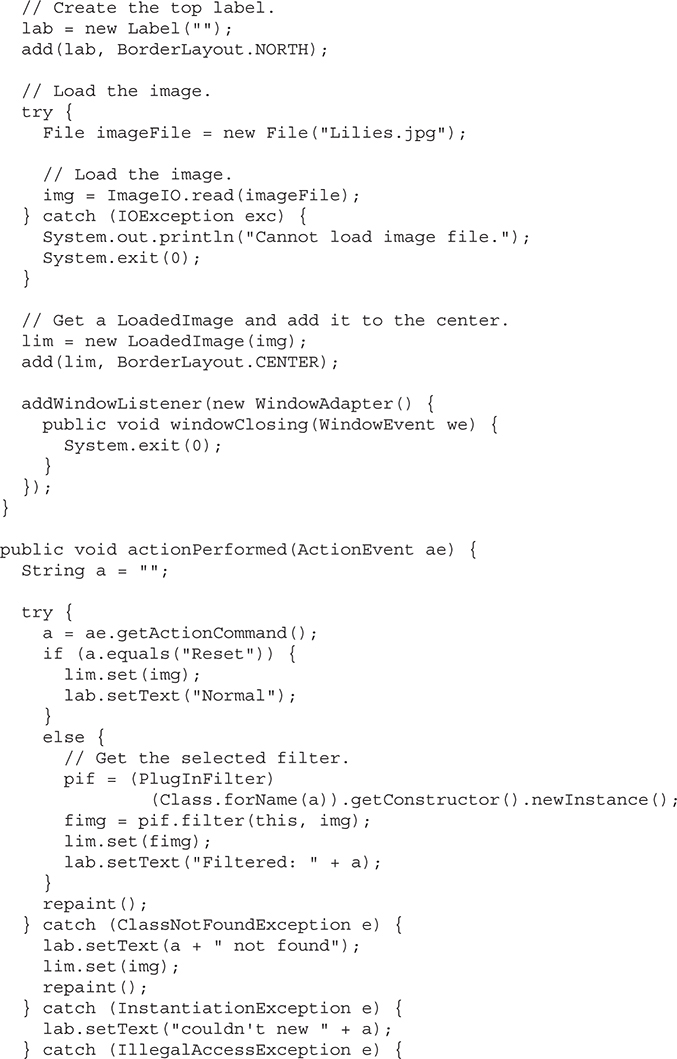
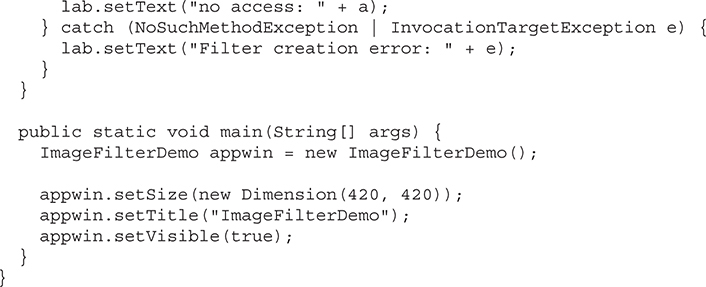
Figure 28-6 shows what the program looks like when it is first loaded.
PlugInFilter is a simple interface used to abstract image filtering. It has only one method, filter( ), which takes the frame and the source image and returns a new image that has been filtered in some way.

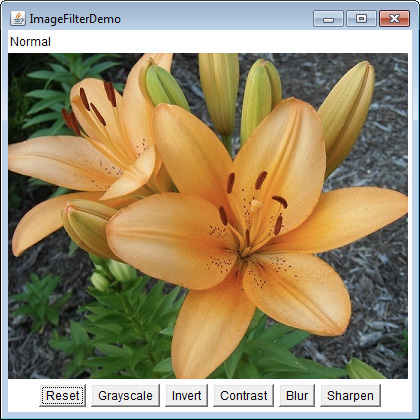
Figure 28-6 Sample normal output from ImageFilterDemo
LoadedImage is a convenient subclass of Canvas. It behaves properly under layout manager control, because it overrides the getPreferredSize( ) and getMinimumSize( ) methods. Also, it has a method called set( ) that can be used to set a new Image to be displayed in this Canvas. That is how the filtered image is displayed after the plug-in is finished.
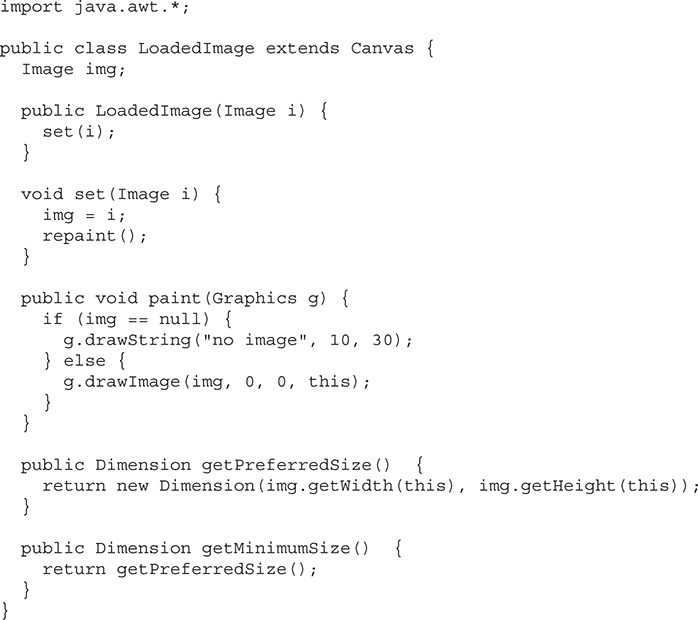
The Grayscale filter is a subclass of RGBImageFilter, which means that Grayscale can use itself as the ImageFilter parameter to FilteredImageSource’s constructor. Then all it needs to do is override filterRGB( ) to change the incoming color values. It takes the red, green, and blue values and computes the brightness of the pixel, using the NTSC (National Television Standards Committee) color-to-brightness conversion factor. It then simply returns a gray pixel that is the same brightness as the color source.
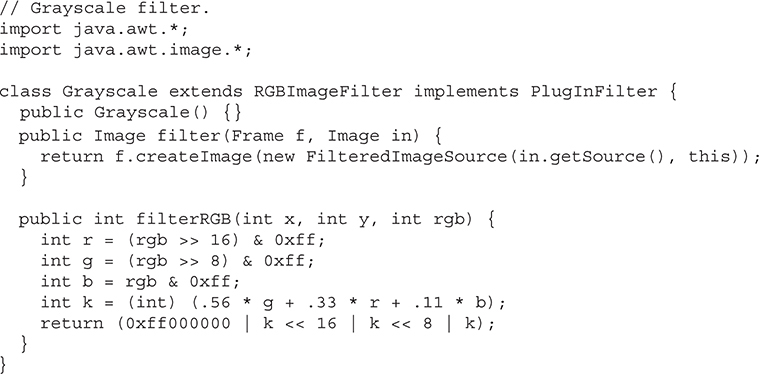
The Invert filter is also quite simple. It takes apart the red, green, and blue values and then inverts them by subtracting them from 255. These inverted values are packed back into a pixel value and returned.
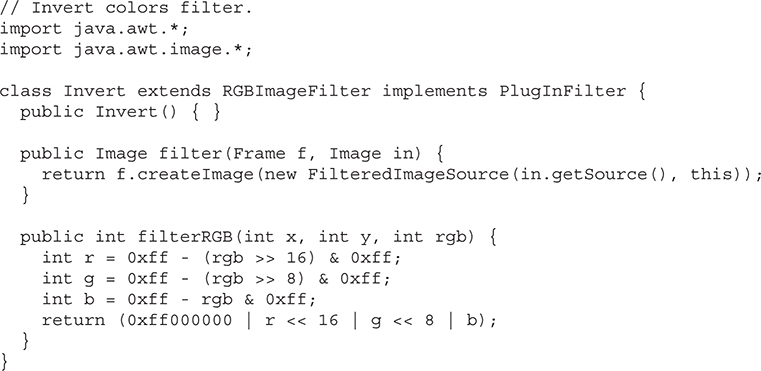
Figure 28-7 shows the image after it has been run through the Invert filter.
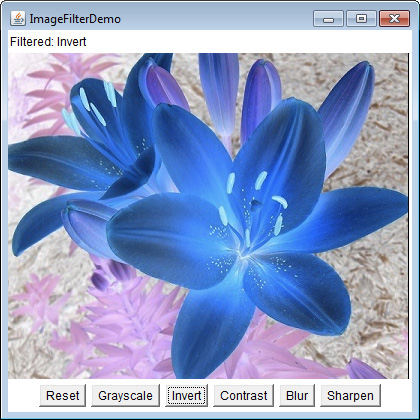
Figure 28-7 Using the Invert filter with ImageFilterDemo
The Contrast filter is very similar to Grayscale, except its override of filterRGB( ) is slightly more complicated. The algorithm it uses for contrast enhancement takes the red, green, and blue values separately and boosts them by 1.2 times if they are already brighter than 128. If they are below 128, then they are divided by 1.2. The boosted values are properly clamped at 255 by the multclamp( ) method.
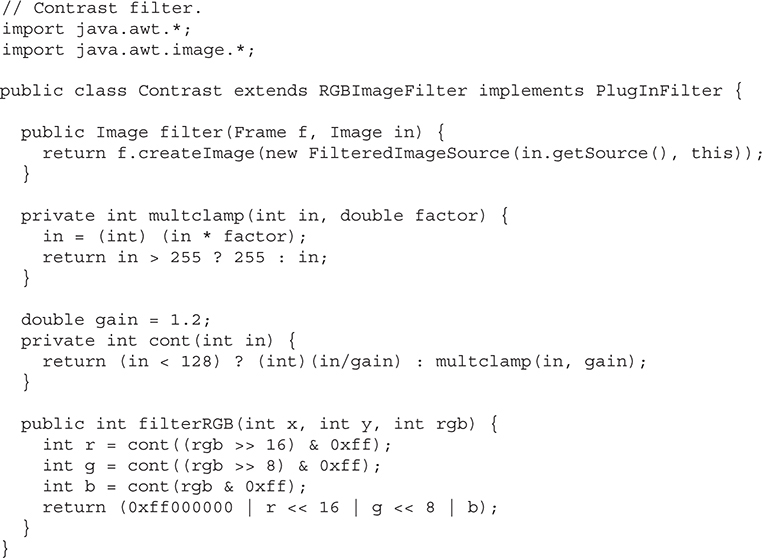
Figure 28-8 shows the image after Contrast is pressed.
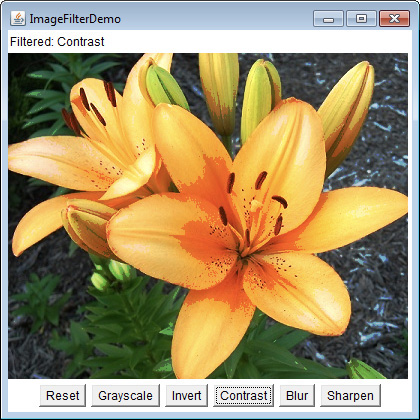
Figure 28-8 Using the Contrast filter with ImageFilterDemo
The abstract class Convolver handles the basics of a convolution filter by implementing the ImageConsumer interface to move the source pixels into an array called imgpixels. It also creates a second array called newimgpixels for the filtered data. Convolution filters sample a small rectangle of pixels around each pixel in an image, called the convolution kernel. This area, 3 × 3 pixels in this demo, is used to decide how to change the center pixel in the area.
Note The reason that the filter can’t modify the imgpixels array in place is that the next pixel on a scan line would try to use the original value for the previous pixel, which would have just been filtered away.
The two concrete subclasses, shown in the next section, simply implement the convolve( ) method, using imgpixels for source data and newimgpixels to store the result.
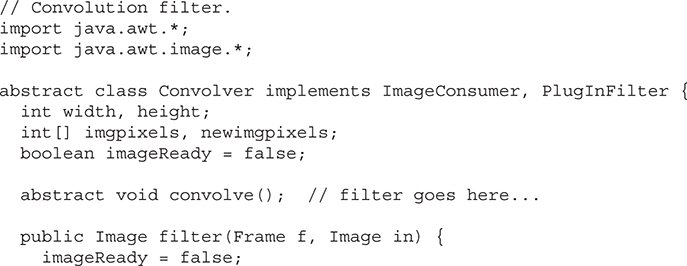
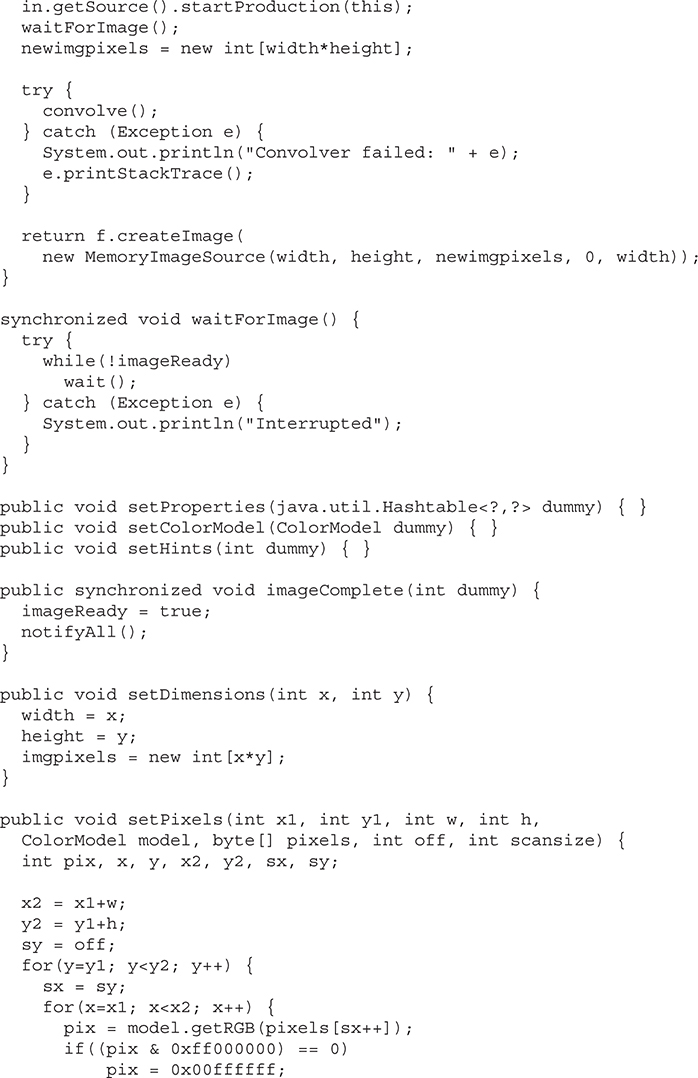
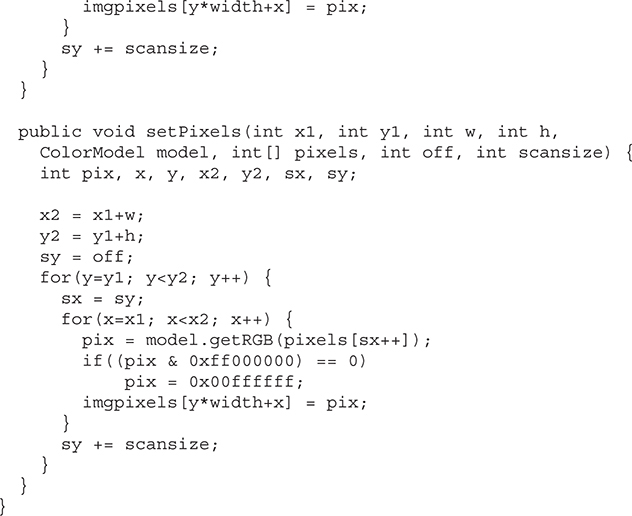
Note A built-in convolution filter called ConvolveOp is provided by java.awt.image. You may want to explore its capabilities on your own.
The Blur filter is a subclass of Convolver and simply runs through every pixel in the source image array, imgpixels, and computes the average of the 3 × 3 box surrounding it. The corresponding output pixel in newimgpixels is that average value.
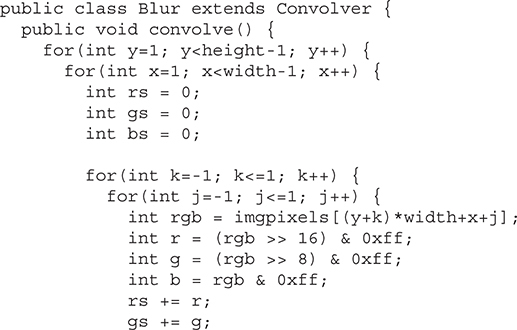
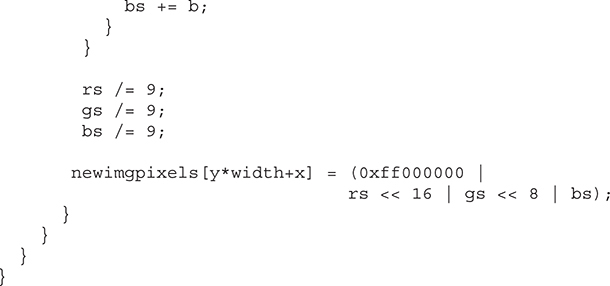
Figure 28-9 shows the image after Blur.
The Sharpen filter is also a subclass of Convolver and is (more or less) the inverse of Blur. It runs through every pixel in the source image array, imgpixels, and computes the average of the 3 × 3 box surrounding it, not counting the center. The corresponding output pixel in newimgpixels has the difference between the center pixel and the surrounding average added to it. This basically says that if a pixel is 30 brighter than its surroundings, make it another 30 brighter. If, however, it is 10 darker, then make it another 10 darker. This tends to accentuate edges while leaving smooth areas unchanged.
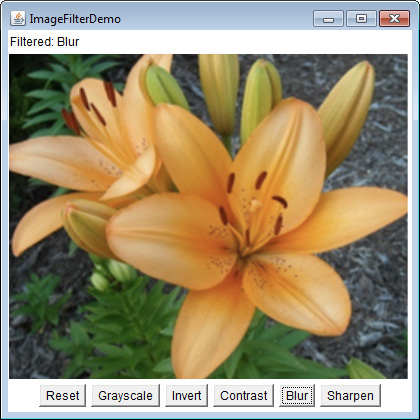
Figure 28-9 Using the Blur filter with ImageFilterDemo
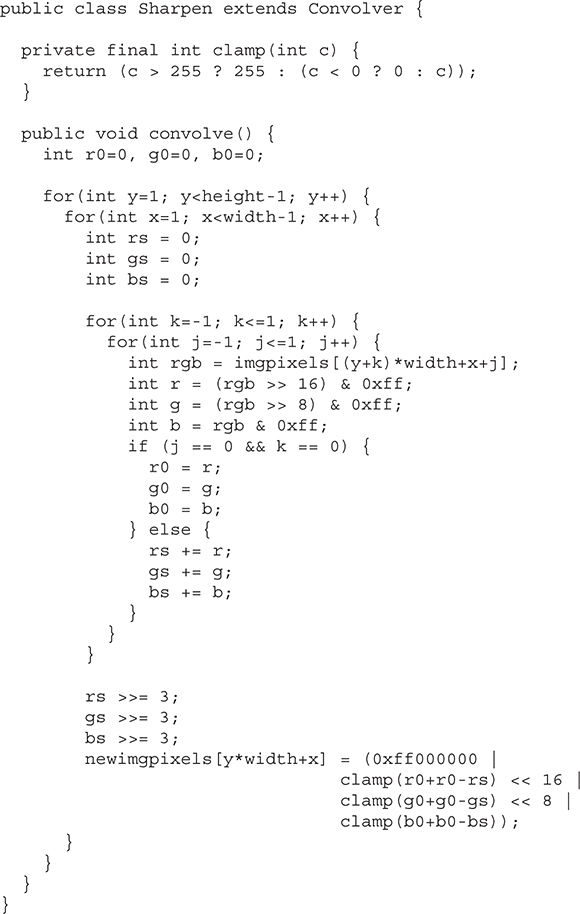
Figure 28-10 shows the image after Sharpen.
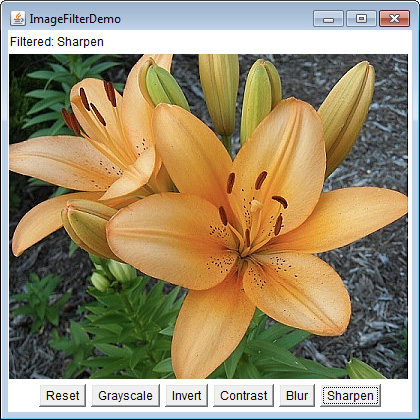
Figure 28-10 Using the Sharpen filter with ImageFilterDemo
In addition to the imaging classes described in this chapter, java.awt.image supplies several others that offer enhanced control over the imaging process and that support advanced imaging techniques. Also available is the imaging package called javax.imageio. It supports reading and writing images, and has plug-ins that handle various image formats. If sophisticated graphical output is of special interest to you, then you will want to explore the additional classes found in java.awt.image and javax.imageio.
From the start, Java has provided built-in support for multithreading and synchronization. For example, new threads can be created by implementing Runnable or by extending Thread; synchronization is available by use of the synchronized keyword; and interthread communication is supported by the wait( ) and notify( ) methods that are defined by Object. In general, this built-in support for multithreading was one of Java’s most important innovations and is still one of its major strengths.
However, as conceptually pure as Java’s original support for multithreading is, it is not ideal for all applications—especially those that make intensive use of multiple threads. For example, the original multithreading support does not provide several high-level features, such as semaphores, thread pools, and execution managers, that facilitate the creation of intensively concurrent programs.
It is important to explain at the outset that many Java programs make use of multithreading and are, therefore, “concurrent.” However, as it is used in this chapter, the term concurrent program refers to a program that makes extensive, integral use of concurrently executing threads. An example of such a program is one that uses separate threads to simultaneously compute the partial results of a larger computation. Another example is a program that coordinates the activities of several threads, each of which seeks access to information in a database. In this case, read-only accesses might be handled differently from those that require read/write capabilities.
To begin to handle the needs of a concurrent program, JDK 5 added the concurrency utilities, also commonly referred to as the concurrent API. The original set of concurrency utilities supplied many features that had long been wanted by programmers who develop concurrent applications. For example, it offered synchronizers (such as the semaphore), thread pools, execution managers, locks, several concurrent collections, and a streamlined way to use threads to obtain computational results.
Although the original concurrent API was impressive in its own right, it was significantly expanded by JDK 7. The most important addition was the Fork/Join Framework. The Fork/Join Framework facilitates the creation of programs that make use of multiple processors (such as those found in multicore systems). Thus, it streamlines the development of programs in which two or more pieces execute with true simultaneity (that is, true parallel execution), not just time-slicing. As you can easily imagine, parallel execution can dramatically increase the speed of certain operations. Because multicore systems are now commonplace, the inclusion of the Fork/Join Framework was as timely as it was powerful. The Fork/Join Framework was further enhanced by JDK 8.
Furthermore, both JDK 8 and JDK 9 added features related to other parts of the concurrent API. Thus, over the years, the concurrent API has evolved and expanded to meet the needs of the contemporary computing environment.
The original concurrent API was quite large, and the additions made over the years have increased its size substantially. As you might expect, many of the issues surrounding the concurrency utilities are quite complex. It is beyond the scope of this book to discuss all of its facets. The preceding notwithstanding, it is important for all programmers to have a general, working knowledge of key aspects of the concurrent API. Even in programs that are not intensively parallel, features such as synchronizers, callable threads, and executors, are applicable to a wide variety of situations. Perhaps most importantly, because of the rise of multicore computers, solutions involving the Fork/Join Framework are becoming more common. For these reasons, this chapter presents an overview of several core features defined by the concurrency utilities and shows a number of examples that demonstrate their use. It concludes with an introduction to the Fork/Join Framework.
The concurrency utilities are contained in the java.util.concurrent package and in its two subpackages: java.util.concurrent.atomic and java.util.concurrent.locks. Beginning with JDK 9, all are in the java.base module. A brief overview of their contents is given here.
java.util.concurrent defines the core features that support alternatives to the built-in approaches to synchronization and interthread communication. These include
• Synchronizers
• Executors
• Concurrent collections
• The Fork/Join Framework
Synchronizers offer high-level ways of synchronizing the interactions between multiple threads. The synchronizer classes defined by java.util.concurrent are

Notice that each synchronizer provides a solution to a specific type of synchronization problem. This enables each synchronizer to be optimized for its intended use. In the early days of Java, these types of synchronization objects had to be crafted by hand. The concurrent API standardized them and made them available to all Java programmers.
Executors manage thread execution. At the top of the executor hierarchy is the Executor interface, which is used to initiate a thread. ExecutorService extends Executor and provides methods that manage execution. There are three implementations of ExecutorService: ThreadPoolExecutor, ScheduledThreadPoolExecutor, and ForkJoinPool. java.util.concurrent also defines the Executors utility class, which includes a number of static methods that simplify the creation of various executors.
Related to executors are the Future and Callable interfaces. A Future contains a value that is returned by a thread after it executes. Thus, its value becomes defined “in the future,” when the thread terminates. Callable defines a thread that returns a value.
java.util.concurrent defines several concurrent collection classes, including ConcurrentHashMap, ConcurrentLinkedQueue, and CopyOnWriteArrayList. These offer concurrent alternatives to their related classes defined by the Collections Framework.
The Fork/Join Framework supports parallel programming. Its main classes are ForkJoinTask, ForkJoinPool, RecursiveTask, and RecursiveAction.
To better handle thread timing, java.util.concurrent defines the TimeUnit enumeration.
Beginning with JDK 9, java.util.concurrent also includes a subsystem that offers a means by which the flow of data can be controlled. It is based on the Flow class and these nested interfaces: Flow.Subscriber, Flow.Publisher, Flow.Processor, and Flow.Subscription. Although a detailed discussion of the Flow subsystem is outside the focus of this chapter, here is a brief description. Flow and its nested interfaces support the reactive streams specification. This specification defines a means by which a consumer of data can prevent the producer of the data from overrunning the consumer’s ability to process the data. In this approach, data is produced by a publisher and consumed by a subscriber. Control is achieved by implementing a form of back pressure.
java.util.concurrent.atomic facilitates the use of variables in a concurrent environment. It provides a means of efficiently updating the value of a variable without the use of locks. This is accomplished through the use of classes, such as AtomicInteger and AtomicLong, and methods, such as compareAndSet( ), decrementAndGet( ), and getAndSet( ). These methods execute as a single, non-interruptible operation.
java.util.concurrent.locks provides an alternative to the use of synchronized methods. At the core of this alternative is the Lock interface, which defines the basic mechanism used to acquire and relinquish access to an object. The key methods are lock( ), tryLock( ), and unlock( ). The advantage to using these methods is greater control over synchronization.
The remainder of this chapter takes a closer look at the constituents of the concurrent API.
Synchronization objects are supported by the Semaphore, CountDownLatch, CyclicBarrier, Exchanger, and Phaser classes. Collectively, they enable you to handle several formerly difficult synchronization situations with ease. They are also applicable to a wide range of programs—even those that contain only limited concurrency. Because the synchronization objects will be of interest to nearly all Java programs, each is examined here in some detail.
The synchronization object that many readers will immediately recognize is Semaphore, which implements a classic semaphore. A semaphore controls access to a shared resource through the use of a counter. If the counter is greater than zero, then access is allowed. If it is zero, then access is denied. What the counter is counting are permits that allow access to the shared resource. Thus, to access the resource, a thread must be granted a permit from the semaphore.
In general, to use a semaphore, the thread that wants access to the shared resource tries to acquire a permit. If the semaphore’s count is greater than zero, then the thread acquires a permit, which causes the semaphore’s count to be decremented. Otherwise, the thread will be blocked until a permit can be acquired. When the thread no longer needs access to the shared resource, it releases the permit, which causes the semaphore’s count to be incremented. If there is another thread waiting for a permit, then that thread will acquire a permit at that time. Java’s Semaphore class implements this mechanism.
Semaphore has the two constructors shown here:
Semaphore(int num)
Semaphore(int num, boolean how)
Here, num specifies the initial permit count. Thus, num specifies the number of threads that can access a shared resource at any one time. If num is one, then only one thread can access the resource at any one time. By default, waiting threads are granted a permit in an undefined order. By setting how to true, you can ensure that waiting threads are granted a permit in the order in which they requested access.
To acquire a permit, call the acquire( ) method, which has these two forms:
void acquire( ) throws InterruptedException
void acquire(int num) throws InterruptedException
The first form acquires one permit. The second form acquires num permits. Most often, the first form is used. If the permit cannot be granted at the time of the call, then the invoking thread suspends until the permit is available.
To release a permit, call release( ), which has these two forms:
void release( )
void release(int num)
The first form releases one permit. The second form releases the number of permits specified by num.
To use a semaphore to control access to a resource, each thread that wants to use that resource must first call acquire( ) before accessing the resource. When the thread is done with the resource, it must call release( ). Here is an example that illustrates the use of a semaphore:
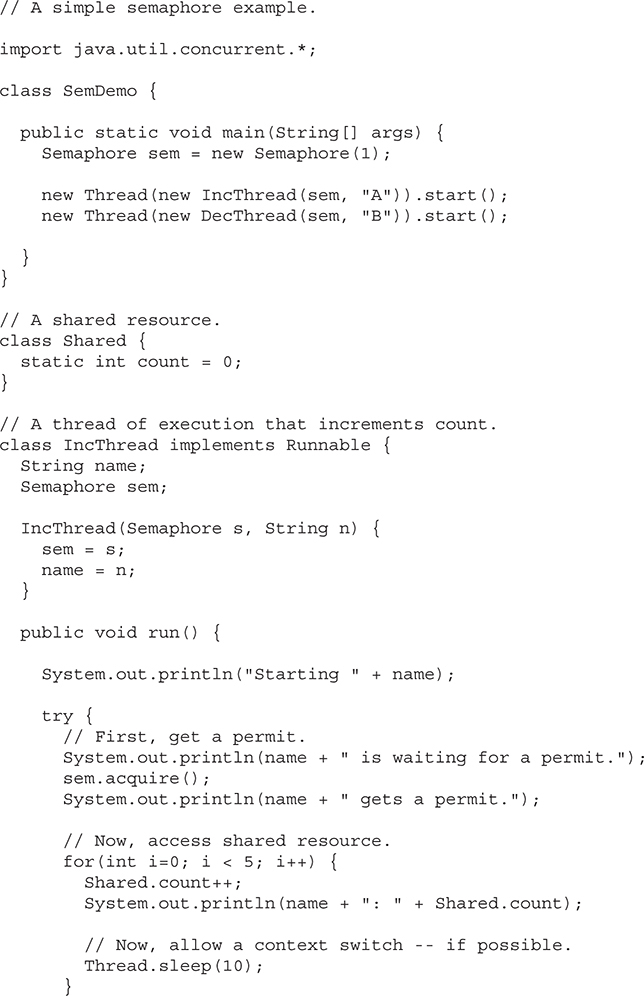
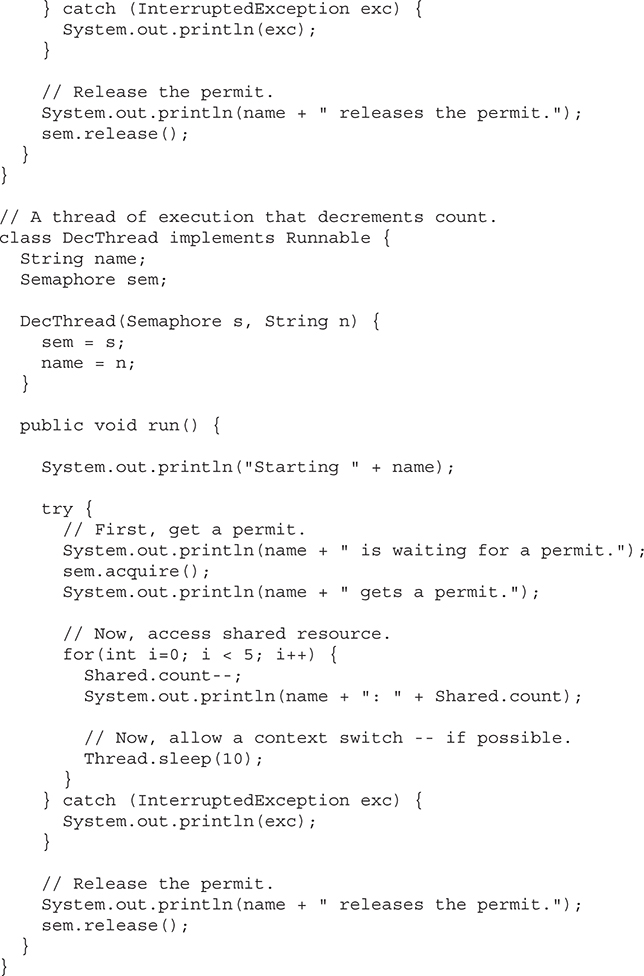
The output from the program is shown here. (The precise order in which the threads execute may vary.)
Starting A
A is waiting for a permit.
A gets a permit.
A: 1
Starting B
B is waiting for a permit.
A: 2
A: 3
A: 4
A: 5
A releases the permit.
B gets a permit.
B: 4
B: 3
B: 2
B: 1
B: 0
B releases the permit.
The program uses a semaphore to control access to the count variable, which is a static variable within the Shared class. Shared.count is incremented five times by the run( ) method of IncThread and decremented five times by DecThread. To prevent these two threads from accessing Shared.count at the same time, access is allowed only after a permit is acquired from the controlling semaphore. After access is complete, the permit is released. In this way, only one thread at a time will access Shared.count, as the output shows.
In both IncThread and DecThread, notice the call to sleep( ) within run( ). It is used to “prove” that accesses to Shared.count are synchronized by the semaphore. In run( ), the call to sleep( ) causes the invoking thread to pause between each access to Shared.count. This would normally enable the second thread to run. However, because of the semaphore, the second thread must wait until the first has released the permit, which happens only after all accesses by the first thread are complete. Thus, Shared.count is incremented five times by IncThread and decremented five times by DecThread. The increments and decrements are not intermixed.
Without the use of the semaphore, accesses to Shared.count by both threads would have occurred simultaneously, and the increments and decrements would be intermixed. To confirm this, try commenting out the calls to acquire( ) and release( ). When you run the program, you will see that access to Shared.count is no longer synchronized, and each thread accesses it as soon as it gets a timeslice.
Although many uses of a semaphore are as straightforward as that shown in the preceding program, more intriguing uses are also possible. Here is an example. The following program reworks the producer/consumer program shown in Chapter 11 so that it uses two semaphores to regulate the producer and consumer threads, ensuring that each call to put( ) is followed by a corresponding call to get( ):

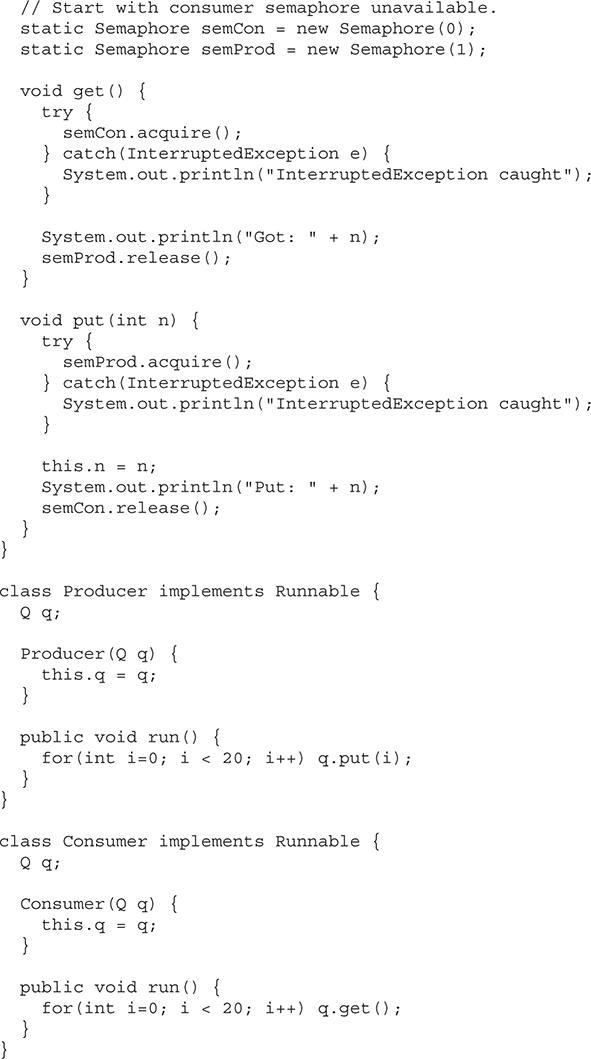

A portion of the output is shown here:
Put: 0
Got: 0
Put: 1
Got: 1
Put: 2
Got: 2
Put: 3
Got: 3
Put: 4
Got: 4
Put: 5
Got: 5
.
.
.
As you can see, the calls to put( ) and get( ) are synchronized. That is, each call to put( ) is followed by a call to get( ) and no values are missed. Without the semaphores, multiple calls to put( ) would have occurred without matching calls to get( ), resulting in values being missed. (To prove this, remove the semaphore code and observe the results.)
The sequencing of put( ) and get( ) calls is handled by two semaphores: semProd and semCon. Before put( ) can produce a value, it must acquire a permit from semProd. After it has set the value, it releases semCon. Before get( ) can consume a value, it must acquire a permit from semCon. After it consumes the value, it releases semProd. This “give and take” mechanism ensures that each call to put( ) must be followed by a call to get( ).
Notice that semCon is initialized with no available permits. This ensures that put( ) executes first. The ability to set the initial synchronization state is one of the more powerful aspects of a semaphore.
Sometimes you will want a thread to wait until one or more events have occurred. To handle such a situation, the concurrent API supplies CountDownLatch. A CountDownLatch is initially created with a count of the number of events that must occur before the latch is released. Each time an event happens, the count is decremented. When the count reaches zero, the latch opens.
CountDownLatch has the following constructor:
CountDownLatch(int num)
Here, num specifies the number of events that must occur in order for the latch to open.
To wait on the latch, a thread calls await( ), which has the forms shown here:
void await( ) throws InterruptedException
boolean await(long wait, TimeUnit tu) throws InterruptedException
The first form waits until the count associated with the invoking CountDownLatch reaches zero. The second form waits only for the period of time specified by wait. The units represented by wait are specified by tu, which is an object the TimeUnit enumeration. (TimeUnit is described later in this chapter.) It returns false if the time limit is reached and true if the countdown reaches zero.
To signal an event, call the countDown( ) method, shown next:
void countDown( )
Each call to countDown( ) decrements the count associated with the invoking object.
The following program demonstrates CountDownLatch. It creates a latch that requires five events to occur before it opens.
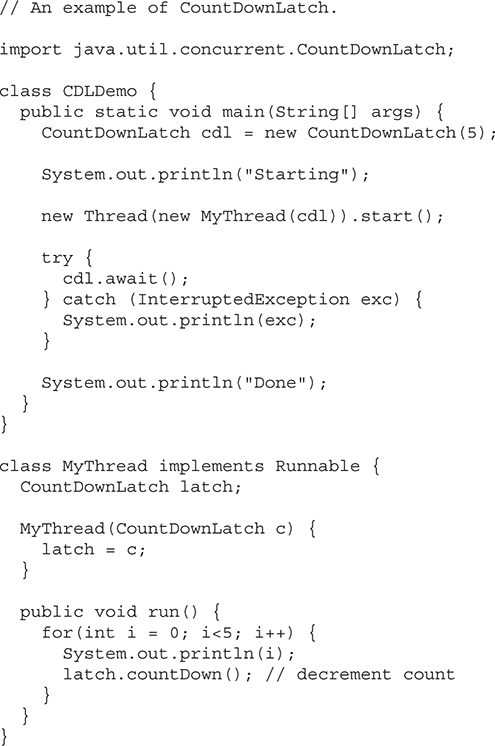
The output produced by the program is shown here:
Starting
0
1
2
3
4
Done
Inside main( ), a CountDownLatch called cdl is created with an initial count of five. Next, an instance of MyThread is created, which begins execution of a new thread. Notice that cdl is passed as a parameter to MyThread’s constructor and stored in the latch instance variable. Then, the main thread calls await( ) on cdl, which causes execution of the main thread to pause until cdl’s count has been decremented five times.
Inside the run( ) method of MyThread, a loop is created that iterates five times. With each iteration, the countDown( ) method is called on latch, which refers to cdl in main( ). After the fifth iteration, the latch opens, which allows the main thread to resume.
CountDownLatch is a powerful yet easy-to-use synchronization object that is appropriate whenever a thread must wait for one or more events to occur.
A situation not uncommon in concurrent programming occurs when a set of two or more threads must wait at a predetermined execution point until all threads in the set have reached that point. To handle such a situation, the concurrent API supplies the CyclicBarrier class. It enables you to define a synchronization object that suspends until the specified number of threads has reached the barrier point.
CyclicBarrier has the following two constructors:
CyclicBarrier(int numThreads)
CyclicBarrier(int numThreads, Runnable action)
Here, numThreads specifies the number of threads that must reach the barrier before execution continues. In the second form, action specifies a thread that will be executed when the barrier is reached.
Here is the general procedure that you will follow to use CyclicBarrier. First, create a CyclicBarrier object, specifying the number of threads that you will be waiting for. Next, when each thread reaches the barrier, have it call await( ) on that object. This will pause execution of the thread until all of the other threads also call await( ). Once the specified number of threads has reached the barrier, await( ) will return and execution will resume. Also, if you have specified an action, then that thread is executed.
The await( ) method has the following two forms:
int await( ) throws InterruptedException, BrokenBarrierException
int await(long wait, TimeUnit tu)
throws InterruptedException, BrokenBarrierException, TimeoutException
The first form waits until all the threads have reached the barrier point. The second form waits only for the period of time specified by wait. The units represented by wait are specified by tu. Both forms return a value that indicates the order that the threads arrive at the barrier point. The first thread returns a value equal to the number of threads waited upon minus one. The last thread returns zero.
Here is an example that illustrates CyclicBarrier. It waits until a set of three threads has reached the barrier. When that occurs, the thread specified by BarAction executes.
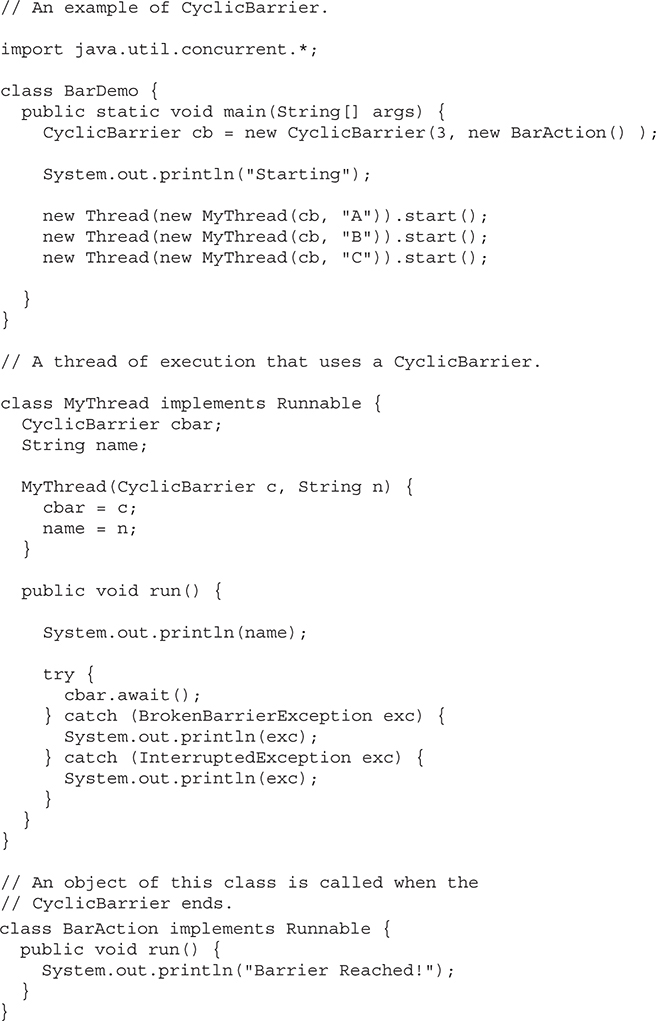
The output is shown here. (The precise order in which the threads execute may vary.)
Starting
A
B
C
Barrier Reached!
A CyclicBarrier can be reused because it will release waiting threads each time the specified number of threads calls await( ). For example, if you change main( ) in the preceding program so that it looks like this:
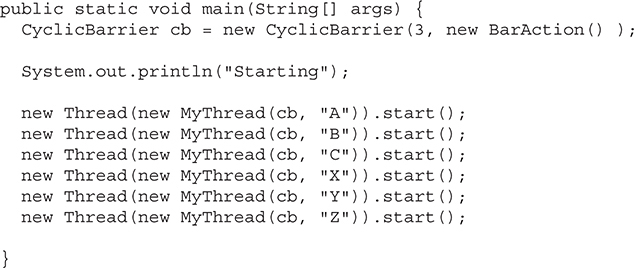
the following output will be produced. (The precise order in which the threads execute may vary.)
Starting
A
B
C
Barrier Reached!
X
Y
Z
Barrier Reached!
As the preceding example shows, the CyclicBarrier offers a streamlined solution to what was previously a complicated problem.
Perhaps the most interesting of the synchronization classes is Exchanger. It is designed to simplify the exchange of data between two threads. The operation of an Exchanger is astoundingly simple: it simply waits until two separate threads call its exchange( ) method. When that occurs, it exchanges the data supplied by the threads. This mechanism is both elegant and easy to use. Uses for Exchanger are easy to imagine. For example, one thread might prepare a buffer for receiving information over a network connection. Another thread might fill that buffer with the information from the connection. The two threads work together so that each time a new buffer is needed, an exchange is made.
Exchanger is a generic class that is declared as shown here:
Exchanger<V>
Here, V specifies the type of the data being exchanged.
The only method defined by Exchanger is exchange( ), which has the two forms shown here:
V exchange(V objRef) throws InterruptedException
V exchange(V objRef, long wait, TimeUnit tu)
throws InterruptedException, TimeoutException
Here, objRef is a reference to the data to exchange. The data received from the other thread is returned. The second form of exchange( ) allows a time-out period to be specified. The key point about exchange( ) is that it won’t succeed until it has been called on the same Exchanger object by two separate threads. Thus, exchange( ) synchronizes the exchange of the data.
Here is an example that demonstrates Exchanger. It creates two threads. One thread creates an empty buffer that will receive the data put into it by the second thread. In this case, the data is a string. Thus, the first thread exchanges an empty string for a full one.
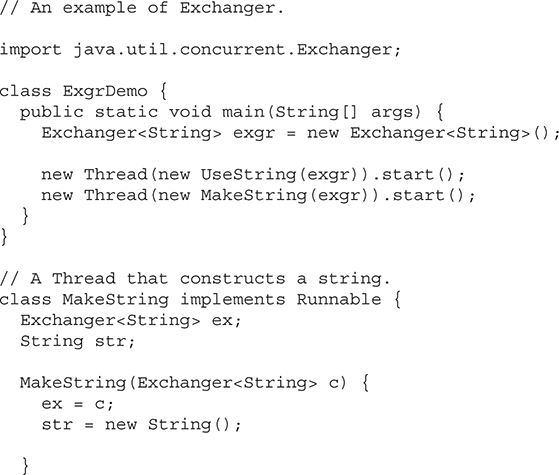
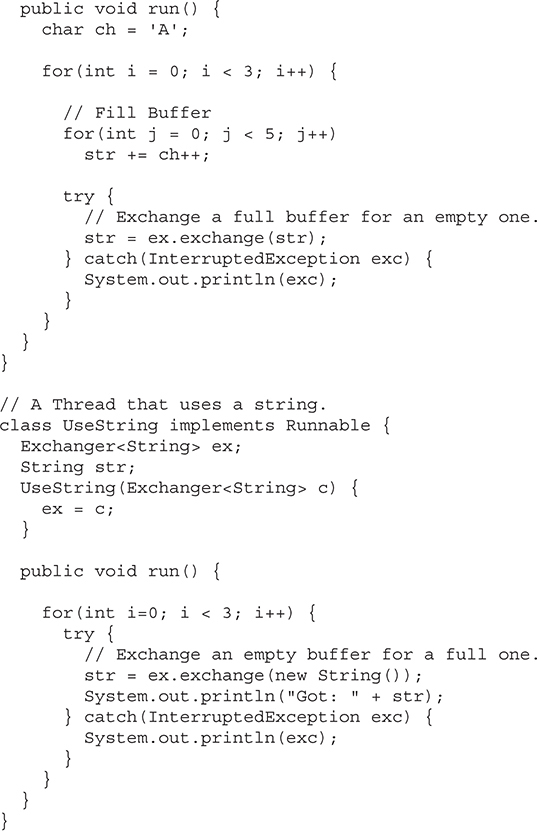
Here is the output produced by the program:
Got: ABCDE
Got: FGHIJ
Got: KLMNO
In the program, the main( ) method creates an Exchanger for strings. This object is then used to synchronize the exchange of strings between the MakeString and UseString classes. The MakeString class fills a string with data. The UseString exchanges an empty string for a full one. It then displays the contents of the newly constructed string. The exchange of empty and full buffers is synchronized by the exchange( ) method, which is called by both classes’ run( ) method.
Another synchronization class is called Phaser. Its primary purpose is to enable the synchronization of threads that represent one or more phases of activity. For example, you might have a set of threads that implement three phases of an order-processing application. In the first phase, separate threads are used to validate customer information, check inventory, and confirm pricing. When that phase is complete, the second phase has two threads that compute shipping costs and all applicable tax. After that, a final phase confirms payment and determines estimated shipping time. In the past, to synchronize the multiple threads that comprise this scenario would require a bit of work on your part. With the inclusion of Phaser, the process is now much easier.
To begin, it helps to know that a Phaser works a bit like a CyclicBarrier, described earlier, except that it supports multiple phases. As a result, Phaser lets you define a synchronization object that waits until a specific phase has completed. It then advances to the next phase, again waiting until that phase concludes. It is important to understand that Phaser can also be used to synchronize only a single phase. In this regard, it acts much like a CyclicBarrier. However, its primary use is to synchronize multiple phases.
Phaser defines four constructors. Here are the two used in this section:
Phaser( )
Phaser(int numParties)
The first creates a phaser that has a registration count of zero. The second sets the registration count to numParties. The term party is often applied to the objects that register with a phaser. Although typically there is a one-to-one correspondence between the number of registrants and the number of threads being synchronized, this is not required. In both cases, the current phase is zero. That is, when a Phaser is created, it is initially at phase zero.
In general, here is how you use Phaser. First, create a new instance of Phaser. Next, register one or more parties with the phaser, either by calling register( ) or by specifying the number of parties in the constructor. For each registered party, have the phaser wait until all registered parties complete a phase. A party signals this by calling one of a variety of methods supplied by Phaser, such as arrive( ) or arriveAndAwaitAdvance( ). After all parties have arrived, the phase is complete, and the phaser can move on to the next phase (if there is one), or terminate. The following sections explain the process in detail.
To register parties after a Phaser has been constructed, call register( ). It is shown here:
int register()
It returns the phase number of the phase to which it is registered.
To signal that a party has completed a phase, it must call arrive( ) or some variation of arrive( ). When the number of arrivals equals the number of registered parties, the phase is completed and the Phaser moves on to the next phase (if there is one). The arrive( ) method has this general form:
int arrive( )
This method signals that a party (normally a thread of execution) has completed some task (or portion of a task). It returns the current phase number. If the phaser has been terminated, then it returns a negative value. The arrive( ) method does not suspend execution of the calling thread. This means that it does not wait for the phase to be completed. This method should be called only by a registered party.
If you want to indicate the completion of a phase and then wait until all other registrants have also completed that phase, use arriveAndAwaitAdvance( ). It is shown here:
int arriveAndAwaitAdvance( )
It waits until all parties have arrived. It returns the next phase number or a negative value if the phaser has been terminated. This method should be called only by a registered party.
A thread can arrive and then deregister itself by calling arriveAndDeregister( ). It is shown here:
int arriveAndDeregister( )
It returns the current phase number or a negative value if the phaser has been terminated. It does not wait until the phase is complete. This method should be called only by a registered party.
To obtain the current phase number, call getPhase( ), which is shown here:
final int getPhase( )
When a Phaser is created, the first phase will be 0, the second phase 1, the third phase 2, and so on. A negative value is returned if the invoking Phaser has been terminated.
Here is an example that shows Phaser in action. It creates three threads, each of which have three phases. It uses a Phaser to synchronize each phase.
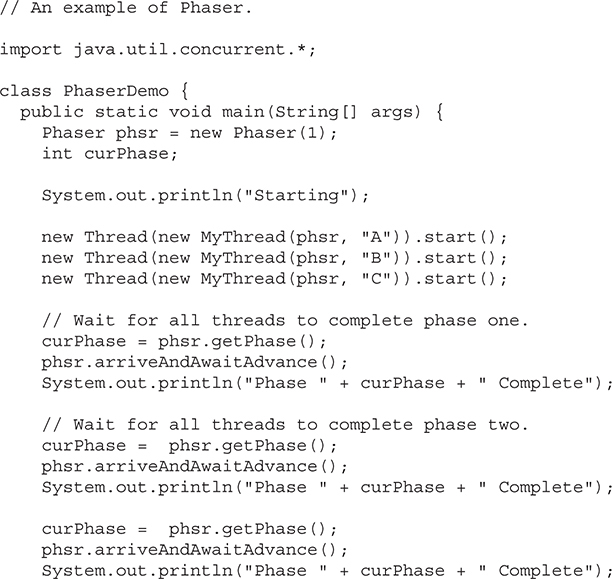
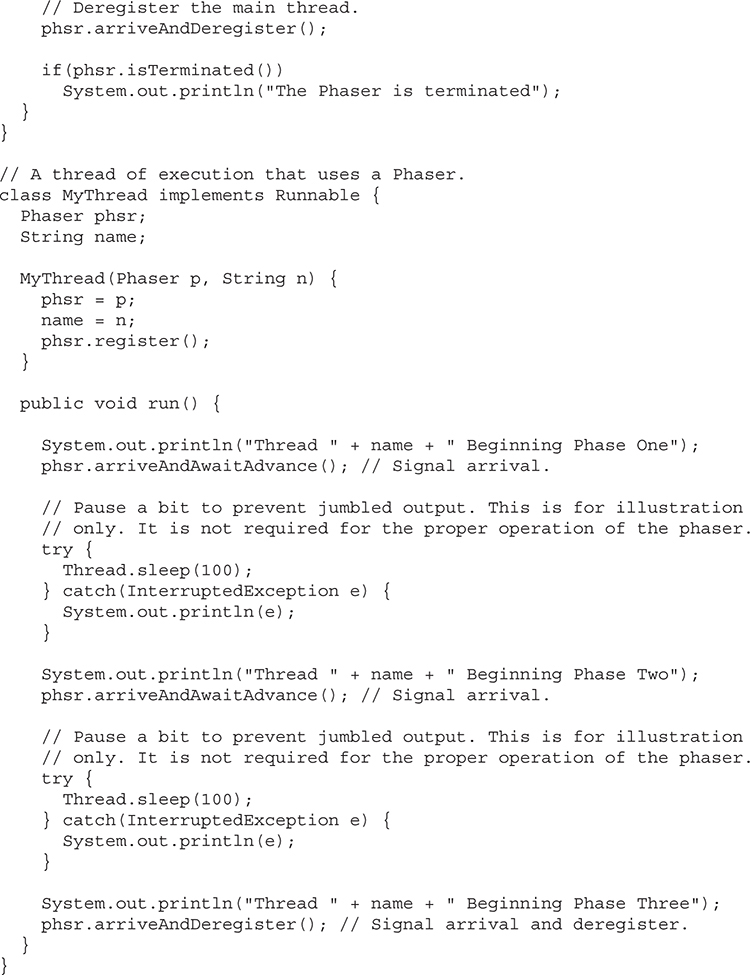
Sample output is shown here. (Your output may vary.)
Starting
Thread A Beginning Phase One
Thread C Beginning Phase One
Thread B Beginning Phase One
Phase 0 Complete
Thread B Beginning Phase Two
Thread C Beginning Phase Two
Thread A Beginning Phase Two
Phase 1 Complete
Thread C Beginning Phase Three
Thread B Beginning Phase Three
Thread A Beginning Phase Three
Phase 2 Complete
The Phaser is terminated
Let’s look closely at the key sections of the program. First, in main( ), a Phaser called phsr is created with an initial party count of 1 (which corresponds to the main thread). Then three threads are started by creating three MyThread objects. Notice that MyThread is passed a reference to phsr (the phaser). The MyThread objects use this phaser to synchronize their activities. Next, main( ) calls getPhase( ) to obtain the current phase number (which is initially zero) and then calls arriveAndAwaitAdvance( ). This causes main( ) to suspend until phase zero has completed. This won’t happen until all MyThreads also call arriveAndAwaitAdvance( ). When this occurs, main( ) will resume execution, at which point it displays that phase zero has completed, and it moves on to the next phase. This process repeats until all three phases have finished. Then, main( ) calls arriveAndDeregister( ). At that point, all three MyThreads have also deregistered. Since this results in there being no registered parties when the phaser advances to the next phase, the phaser is terminated.
Now look at MyThread. First, notice that the constructor is passed a reference to the phaser that it will use and then registers with the new thread as a party on that phaser. Thus, each new MyThread becomes a party registered with the passed-in phaser. Also notice that each thread has three phases. In this example, each phase consists of a placeholder that simply displays the name of the thread and what it is doing. Obviously, in real-world code, the thread would be performing more meaningful actions. Between the first two phases, the thread calls arriveAndAwaitAdvance( ). Thus, each thread waits until all threads have completed the phase (and the main thread is ready). After all threads have arrived (including the main thread), the phaser moves on to the next phase. After the third phase, each thread deregisters itself with a call to arriveAndDeregister( ). As the comments in MyThread explain, the calls to sleep( ) are used for the purposes of illustration to ensure that the output is not jumbled because of the multithreading. They are not needed to make the phaser work properly. If you remove them, the output may look a bit jumbled, but the phases will still be synchronized correctly.
One other point: Although the preceding example used three threads that were all of the same type, this is not a requirement. Each party that uses a phaser can be unique, with each performing some separate task.
It is possible to take control of precisely what happens when a phase advance occurs. To do this, you must override the onAdvance( ) method. This method is called by the run time when a Phaser advances from one phase to the next. It is shown here:
protected boolean onAdvance(int phase, int numParties)
Here, phase will contain the current phase number prior to being incremented and numParties will contain the number of registered parties. To terminate the phaser, onAdvance( ) must return true. To keep the phaser alive, onAdvance( ) must return false. The default version of onAdvance( ) returns true (thus terminating the phaser) when there are no registered parties. As a general rule, your override should also follow this practice.
One reason to override onAdvance( ) is to enable a phaser to execute a specific number of phases and then stop. The following example gives you the flavor of this usage. It creates a class called MyPhaser that extends Phaser so that it will run a specified number of phases. It does this by overriding the onAdvance( ) method. The MyPhaser constructor accepts one argument, which specifies the number of phases to execute. Notice that MyPhaser automatically registers one party. This behavior is useful in this example, but the needs of your own applications may differ.
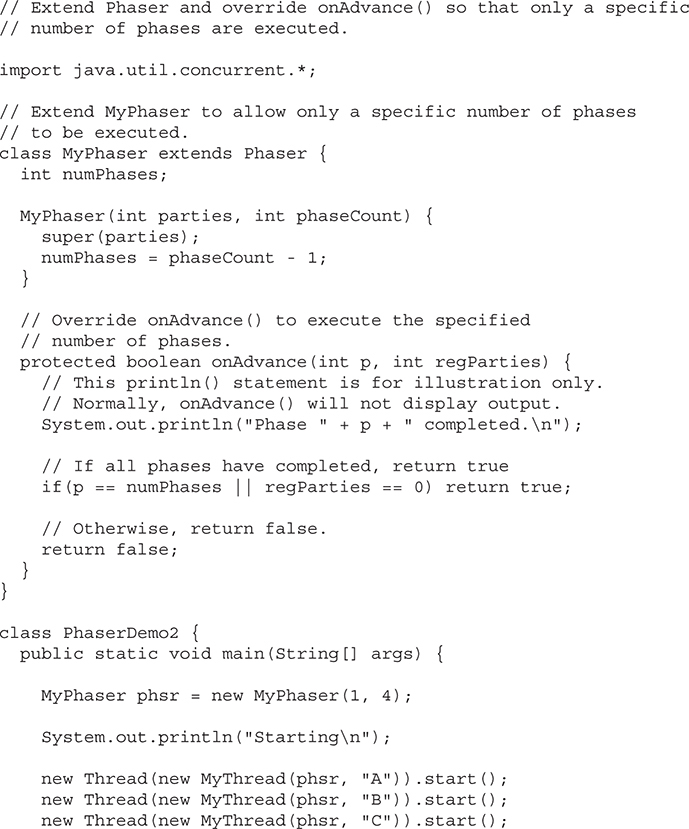
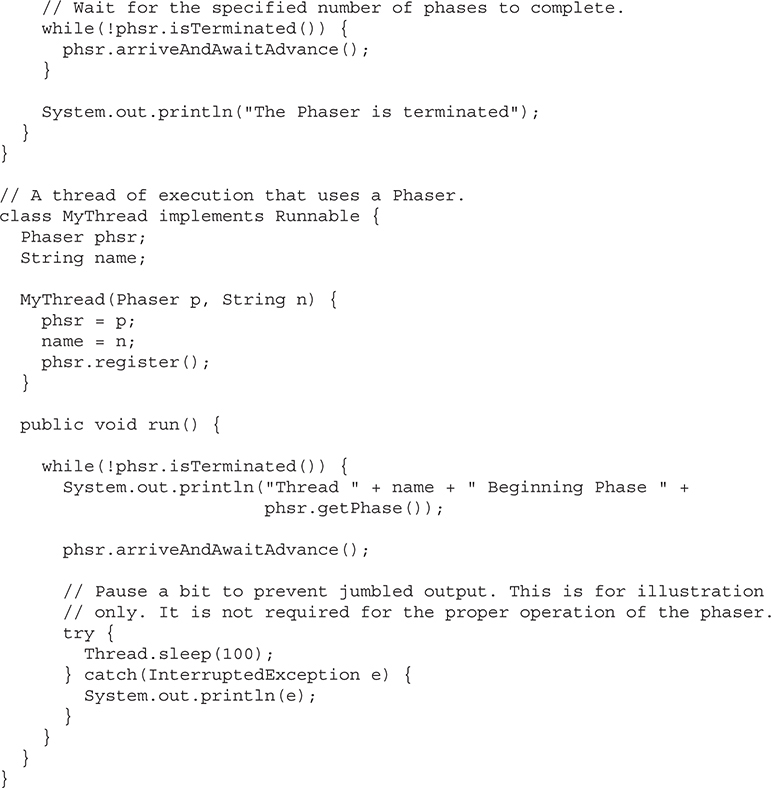
The output from the program is shown here:
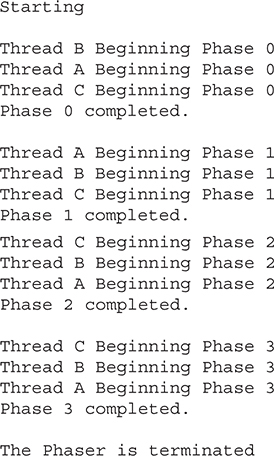
Inside main( ), one instance of Phaser is created. It is passed 4 as an argument, which means that it will execute four phases and then stop. Next, three threads are created and then the following loop is entered:

This loop simply calls arriveAndAwaitAdvance( ) until the phaser is terminated. The phaser won’t terminate until the specified number of phases have been executed. In this case, the loop continues to execute until four phases have run. Next, notice that the threads also call arriveAndAwaitAdvance( ) within a loop that runs until the phaser is terminated. This means that they will execute until the specified number of phases has been completed.
Now, look closely at the code for onAdvance( ). Each time onAdvance( ) is called, it is passed the current phase and the number of registered parties. If the current phase equals the specified phase, or if the number of registered parties is zero, onAdvance( ) returns true, thus stopping the phaser. This is accomplished with this line of code:
// If all phases have completed, return true
if(p == numPhases || regParties == 0) return true;
As you can see, very little code is needed to accommodate the desired outcome.
Before moving on, it is useful to point out that you don’t necessarily need to explicitly extend Phaser as the previous example does to simply override onAdvance( ). In some cases, more compact code can be created by using an anonymous inner class to override onAdvance( ).
Phaser has additional capabilities that may be of use in your applications. You can wait for a specific phase by calling awaitAdvance( ), which is shown here:
int awaitAdvance(int phase)
Here, phase indicates the phase number on which awaitAdvance( ) will wait until a transition to the next phase takes place. It will return immediately if the argument passed to phase is not equal to the current phase. It will also return immediately if the phaser is terminated. However, if phase is passed the current phase, then it will wait until the phase increments. This method should be called only by a registered party. There is also an interruptible version of this method called awaitAdvanceInterruptibly( ).
To register more than one party, call bulkRegister( ). To obtain the number of registered parties, call getRegisteredParties( ). You can also obtain the number of arrived parties and unarrived parties by calling getArrivedParties( ) and getUnarrivedParties( ), respectively. To force the phaser to enter a terminated state, call forceTermination( ).
Phaser also lets you create a tree of phasers. This is supported by two additional constructors, which let you specify the parent, and the getParent( ) method.
The concurrent API supplies a feature called an executor that initiates and controls the execution of threads. As such, an executor offers an alternative to managing threads through the Thread class.
At the core of an executor is the Executor interface. It defines the following method:
void execute(Runnable thread)
The thread specified by thread is executed. Thus, execute( ) starts the specified thread.
The ExecutorService interface extends Executor by adding methods that help manage and control the execution of threads. For example, ExecutorService defines shutdown( ), shown here, which stops the invoking ExecutorService.
void shutdown( )
ExecutorService also defines methods that execute threads that return results, that execute a set of threads, and that determine the shutdown status. We will look at several of these methods a little later.
Also defined is the interface ScheduledExecutorService, which extends ExecutorService to support the scheduling of threads.
The concurrent API defines three predefined executor classes: ThreadPoolExecutor and ScheduledThreadPoolExecutor, and ForkJoinPool. ThreadPoolExecutor implements the Executor and ExecutorService interfaces and provides support for a managed pool of threads. ScheduledThreadPoolExecutor also implements the ScheduledExecutorService interface to allow a pool of threads to be scheduled. ForkJoinPool implements the Executor and ExecutorService interfaces and is used by the Fork/Join Framework. It is described later in this chapter.
A thread pool provides a set of threads that is used to execute various tasks. Instead of each task using its own thread, the threads in the pool are used. This reduces the overhead associated with creating many separate threads. Although you can use ThreadPoolExecutor and ScheduledThreadPoolExecutor directly, most often you will want to obtain an executor by calling one of the static factory methods defined by the Executors utility class. Here are some examples:
static ExecutorService newCachedThreadPool( )
static ExecutorService newFixedThreadPool(int numThreads)
static ScheduledExecutorService newScheduledThreadPool(int numThreads)
newCachedThreadPool( ) creates a thread pool that adds threads as needed but reuses threads if possible. newFixedThreadPool( ) creates a thread pool that consists of a specified number of threads. newScheduledThreadPool( ) creates a thread pool that supports thread scheduling. Each returns a reference to an ExecutorService that can be used to manage the pool.
Before going any further, a simple example that uses an executor will be of value. The following program creates a fixed thread pool that contains two threads. It then uses that pool to execute four tasks. Thus, four tasks share the two threads that are in the pool. After the tasks finish, the pool is shut down and the program ends.
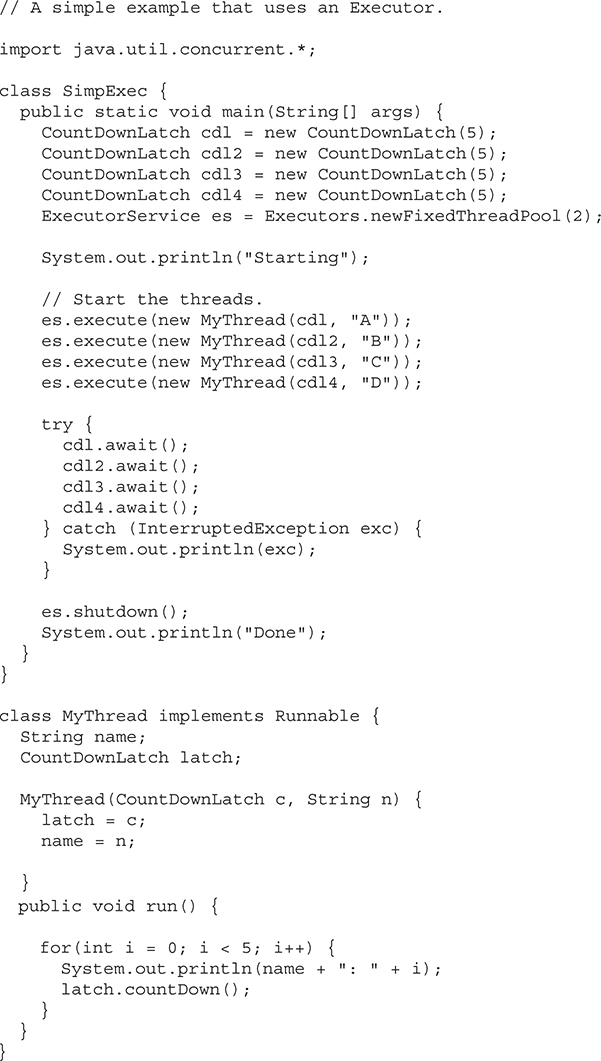
The output from the program is shown here. (The precise order in which the threads execute may vary.)
Starting
A: 0
A: 1
A: 2
A: 3
A: 4
C: 0
C: 1
C: 2
C: 3
C: 4
D: 0
D: 1
D: 2
D: 3
D: 4
B: 0
B: 1
B: 2
B: 3
B: 4
Done
As the output shows, even though the thread pool contains only two threads, all four tasks are still executed. However, only two can run at the same time. The others must wait until one of the pooled threads is available for use.
The call to shutdown( ) is important. If it were not present in the program, then the program would not terminate because the executor would remain active. To try this for yourself, simply comment out the call to shutdown( ) and observe the result.
One of the most interesting features of the concurrent API is the Callable interface. This interface represents a thread that returns a value. An application can use Callable objects to compute results that are then returned to the invoking thread. This is a powerful mechanism because it facilitates the coding of many types of numerical computations in which partial results are computed simultaneously. It can also be used to run a thread that returns a status code that indicates the successful completion of the thread.
Callable is a generic interface that is defined like this:
interface Callable<V>
Here, V indicates the type of data returned by the task. Callable defines only one method, call( ), which is shown here:
V call( ) throws Exception
Inside call( ), you define the task that you want performed. After that task completes, you return the result. If the result cannot be computed, call( ) must throw an exception.
A Callable task is executed by an ExecutorService, by calling its submit( ) method. There are three forms of submit( ), but only one is used to execute a Callable. It is shown here:
<T> Future<T> submit(Callable<T> task)
Here, task is the Callable object that will be executed in its own thread. The result is returned through an object of type Future.
Future is a generic interface that represents the value that will be returned by a Callable object. Because this value is obtained at some future time, the name Future is appropriate. Future is defined like this:
interface Future<V>
Here, V specifies the type of the result.
To obtain the returned value, you will call Future’s get( ) method, which has these two forms:
V get( )
throws InterruptedException, ExecutionException
V get(long wait, TimeUnit tu)
throws InterruptedException, ExecutionException, TimeoutException
The first form waits for the result indefinitely. The second form allows you to specify a timeout period in wait. The units of wait are passed in tu, which is an object of the TimeUnit enumeration, described later in this chapter.
The following program illustrates Callable and Future by creating three tasks that perform three different computations. The first returns the summation of a value, the second computes the length of the hypotenuse of a right triangle given the length of its sides, and the third computes the factorial of a value. All three computations occur simultaneously.
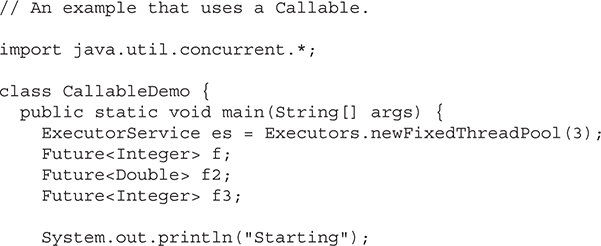
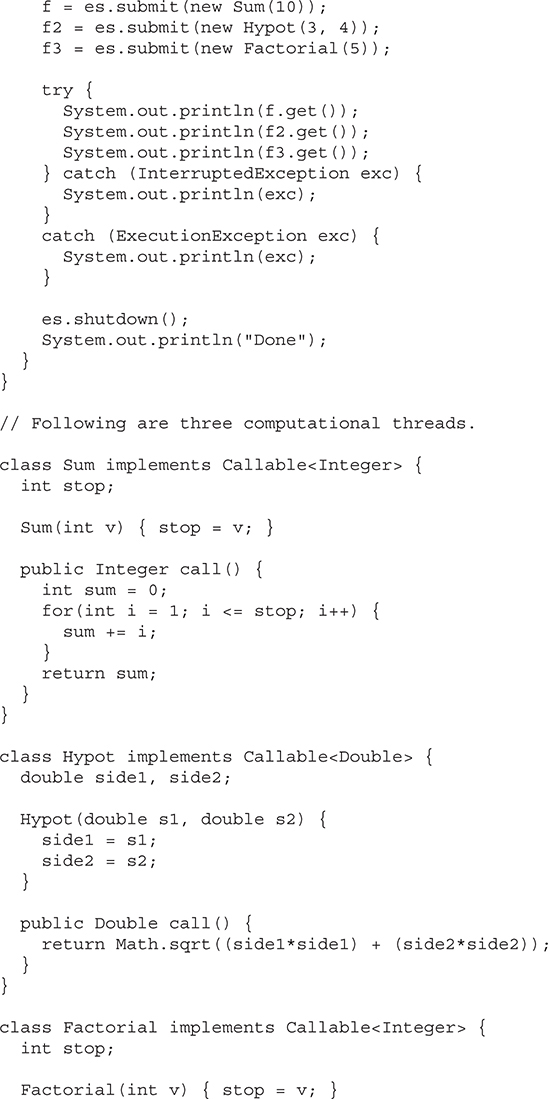
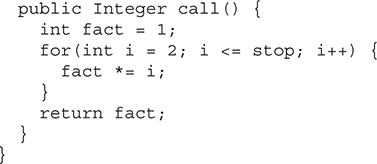
The output is shown here:
Starting
55
5.0
120
Done
The concurrent API defines several methods that take an argument of type TimeUnit, which indicates a time-out period. TimeUnit is an enumeration that is used to specify the granularity (or resolution) of the timing. TimeUnit is defined within java.util.concurrent. It can be one of the following values:
DAYS
HOURS
MINUTES
SECONDS
MICROSECONDS
MILLISECONDS
NANOSECONDS
Although TimeUnit lets you specify any of these values in calls to methods that take a timing argument, there is no guarantee that the system is capable of the specified resolution.
Here is an example that uses TimeUnit. The CallableDemo class, shown in the previous section, is modified as shown next to use the second form of get( ) that takes a TimeUnit argument.
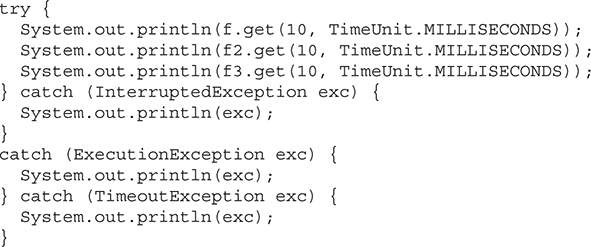
In this version, no call to get( ) will wait more than 10 milliseconds.
The TimeUnit enumeration defines various methods that convert between units. Those originally defined by TimeUnit are shown here:
long convert(long tval, TimeUnit tu)
long toMicros(long tval)
long toMillis(long tval)
long toNanos(long tval)
long toSeconds(long tval)
long toDays(long tval)
long toHours(long tval)
long toMinutes(long tval)
The convert( ) method converts tval into the specified unit and returns the result. The to methods perform the indicated conversion and return the result. To these methods, JDK 9 added the methods toChronoUnit( ) and of( ), which convert between java.time.temporal.ChronoUnits and TimeUnits. JDK 11 added another version of convert( ) that converts a java.time.Duration object into a long.
TimeUnit also defines the following timing methods:
void sleep(long delay) throws InterruptedExecution
void timedJoin(Thread thrd, long delay) throws InterruptedExecution
void timedWait(Object obj, long delay) throws InterruptedExecution
Here, sleep( ) pauses execution for the specified delay period, which is specified in terms of the invoking enumeration constant. It translates into a call to Thread.sleep( ). The timedJoin( ) method is a specialized version of Thread.join( ) in which thrd pauses for the time period specified by delay, which is described in terms of the invoking time unit. The timedWait( ) method is a specialized version of Object.wait( ) in which obj is waited on for the period of time specified by delay, which is described in terms of the invoking time unit.
As explained, the concurrent API defines several collection classes that have been engineered for concurrent operation. They include:
ArrayBlockingQueue
ConcurrentHashMap
ConcurrentLinkedDeque
ConcurrentLinkedQueue
ConcurrentSkipListMap
ConcurrentSkipListSet
CopyOnWriteArrayList
CopyOnWriteArraySet
DelayQueue
LinkedBlockingDeque
LinkedBlockingQueue
LinkedTransferQueue
PriorityBlockingQueue
SynchronousQueue
These offer concurrent alternatives to their related classes defined by the Collections Framework. These collections work much like the other collections except that they provide concurrency support. Programmers familiar with the Collections Framework will have no trouble using these concurrent collections.
The java.util.concurrent.locks package provides support for locks, which are objects that offer an alternative to using synchronized to control access to a shared resource. In general, here is how a lock works. Before accessing a shared resource, the lock that protects that resource is acquired. When access to the resource is complete, the lock is released. If a second thread attempts to acquire the lock when it is in use by another thread, the second thread will suspend until the lock is released. In this way, conflicting access to a shared resource is prevented.
Locks are particularly useful when multiple threads need to access the value of shared data. For example, an inventory application might have a thread that first confirms that an item is in stock and then decreases the number of items on hand as each sale occurs. If two or more of these threads are running, then without some form of synchronization, it would be possible for one thread to be in the middle of a transaction when the second thread begins its transaction. The result could be that both threads would assume that adequate inventory exists, even if there is only sufficient inventory on hand to satisfy one sale. In this type of situation, a lock offers a convenient means of handling the needed synchronization.
The Lock interface defines a lock. The methods defined by Lock are shown in Table 29-1. In general, to acquire a lock, call lock( ). If the lock is unavailable, lock( ) will wait. To release a lock, call unlock( ). To see if a lock is available, and to acquire it if it is, call tryLock( ). This method will not wait for the lock if it is unavailable. Instead, it returns true if the lock is acquired and false otherwise. The newCondition( ) method returns a Condition object associated with the lock. Using a Condition, you gain detailed control of the lock through methods such as await( ) and signal( ), which provide functionality similar to Object.wait( ) and Object.notify( ).
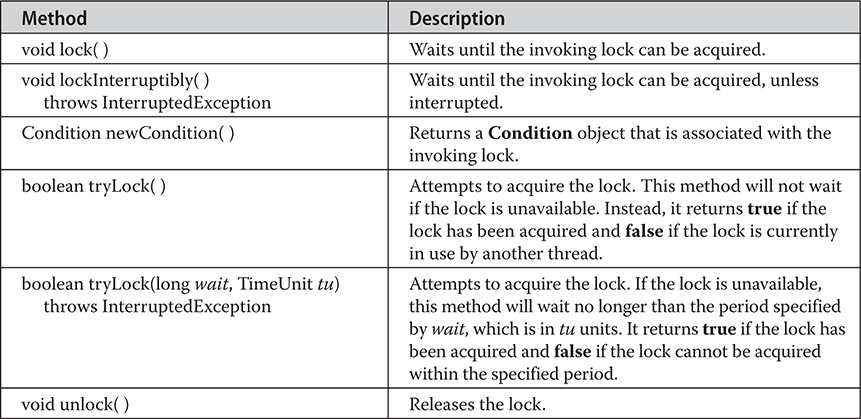
Table 29-1 The Lock Methods
java.util.concurrent.locks supplies an implementation of Lock called ReentrantLock. ReentrantLock implements a reentrant lock, which is a lock that can be repeatedly entered by the thread that currently holds the lock. Of course, in the case of a thread reentering a lock, all calls to lock( ) must be offset by an equal number of calls to unlock( ). Otherwise, a thread seeking to acquire the lock will suspend until the lock is not in use.
The following program demonstrates the use of a lock. It creates two threads that access a shared resource called Shared.count. Before a thread can access Shared.count, it must obtain a lock. After obtaining the lock, Shared.count is incremented and then, before releasing the lock, the thread sleeps. This causes the second thread to attempt to obtain the lock. However, because the lock is still held by the first thread, the second thread must wait until the first thread stops sleeping and releases the lock. The output shows that access to Shared.count is, indeed, synchronized by the lock.
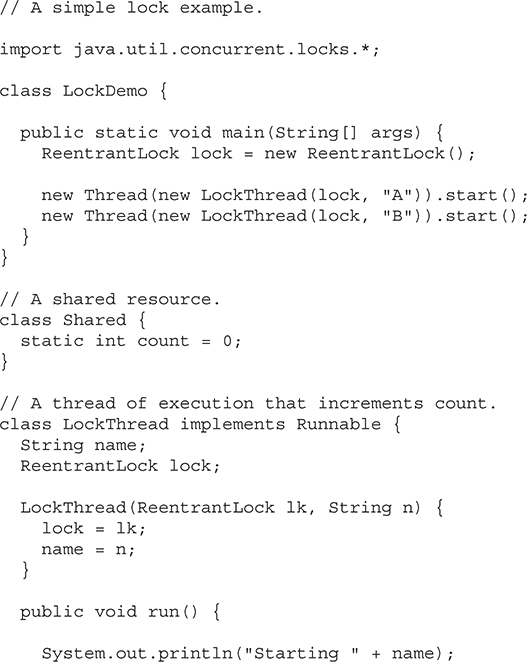
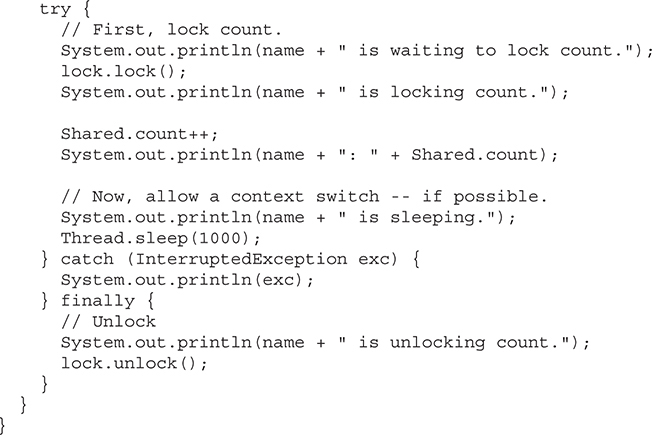
The output is shown here. (The precise order in which the threads execute may vary.)
Starting A
A is waiting to lock count.
A is locking count.
A: 1
A is sleeping.
Starting B
B is waiting to lock count.
A is unlocking count.
B is locking count.
B: 2
B is sleeping.
B is unlocking count.
java.util.concurrent.locks also defines the ReadWriteLock interface. This interface specifies a lock that maintains separate locks for read and write access. This enables multiple locks to be granted for readers of a resource as long as the resource is not being written. ReentrantReadWriteLock provides an implementation of ReadWriteLock.
Note There is a specialized lock called StampedLock. It does not implement the Lock or ReadWriteLock interfaces. It does, however, provide a mechanism that enables aspects of it to be used like a Lock or ReadWriteLock.
java.util.concurrent.atomic offers an alternative to the other synchronization features when reading or writing the value of some types of variables. This package offers methods that get, set, or compare the value of a variable in one uninterruptible (that is, atomic) operation. This means that no lock or other synchronization mechanism is required.
Atomic operations are accomplished through the use of classes, such as AtomicInteger and AtomicLong, and methods such as get( ), set( ), compareAndSet( ), decrementAndGet( ), and getAndSet( ), which perform the action indicated by their names.
Here is an example that demonstrates how access to a shared integer can be synchronized by the use of AtomicInteger:
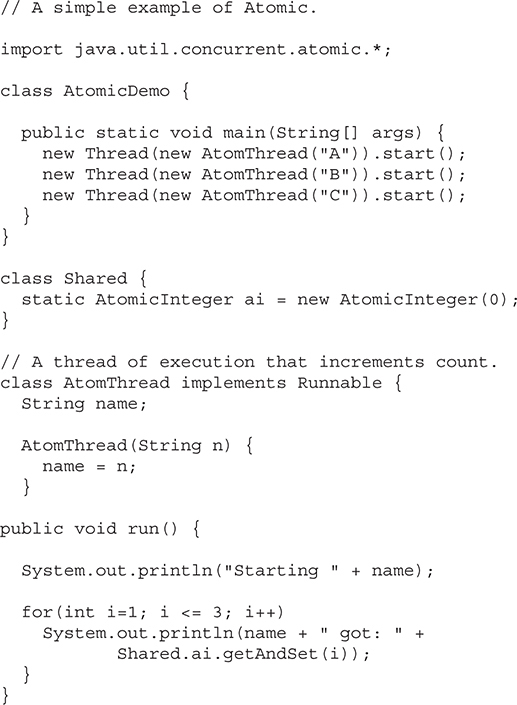
In the program, a static AtomicInteger named ai is created by Shared. Then, three threads of type AtomThread are created. Inside run( ), Shared.ai is modified by calling getAndSet( ). This method returns the previous value and then sets the value to the one passed as an argument. The use of AtomicInteger prevents two threads from writing to ai at the same time.
In general, the atomic operations offer a convenient (and possibly more efficient) alternative to the other synchronization mechanisms when only a single variable is involved. Among other features, java.util.concurrent.atomic also provides four classes that support lock-free cumulative operations. These are DoubleAccumulator, DoubleAdder, LongAccumulator, and LongAdder. The accumulator classes support a series of user-specified operations. The adder classes maintain a cumulative sum.
In recent years, an important trend has emerged in software development: parallel programming. Parallel programming is the name commonly given to the techniques that take advantage of computers that contain two or more processors (multicore). As most readers will know, multicore computers have become commonplace. The advantage that multi-processor environments offer is the ability to significantly increase program performance. As a result, a mechanism was needed that gives Java programmers a simple, yet effective way to make use of multiple processors in a clean, scalable manner. To answer this need, several new classes and interfaces that support parallel programming were incorporated into the concurrent API when JDK 7 was released. They are commonly referred to as the Fork/Join Framework. The Fork/Join Framework is defined in the java.util.concurrent package.
The Fork/Join Framework enhances multithreaded programming in two important ways. First, it simplifies the creation and use of multiple threads. Second, it automatically makes use of multiple processors. In other words, by using the Fork/Join Framework you enable your applications to automatically scale to make use of the number of available processors. These two features make the Fork/Join Framework the recommended approach to multithreading when parallel processing is desired.
Before continuing, it is important to point out the distinction between traditional multithreading and parallel programming. In the past, most computers had a single CPU and multithreading was primarily used to take advantage of idle time, such as when a program is waiting for user input. Using this approach, one thread can execute while another is waiting. In other words, on a single-CPU system, multithreading is used to allow two or more tasks to share the CPU. This type of multithreading is typically supported by an object of type Thread (as described in Chapter 11). Although this type of multithreading will always remain quite useful, it was not optimized for situations in which two or more CPUs are available (multicore computers).
When multiple CPUs are present, a second type of multithreading capability that supports true parallel execution is required. With two or more CPUs, it is possible to execute portions of a program simultaneously, with each part executing on its own CPU. This can be used to significantly speed up the execution of some types of operations, such as sorting, transforming, or searching a large array. In many cases, these types of operations can be broken down into smaller pieces (each acting on a portion of the array), and each piece can be run on its own CPU. As you can imagine, the gain in efficiency can be enormous. Simply put: Parallel programming will be part of nearly every programmer’s future because it offers a way to dramatically improve program performance.
The Fork/Join Framework is packaged in java.util.concurrent. At the core of the Fork/Join Framework are the following four classes:

Here is how they relate. A ForkJoinPool manages the execution of ForkJoinTasks. ForkJoinTask is an abstract class that is extended by the abstract classes RecursiveAction and RecursiveTask. Typically, your code will extend these classes to create a task. Before looking at the process in detail, an overview of the key aspects of each class will be helpful.
Note The class CountedCompleter also extends ForkJoinTask. However, a discussion of CountedCompleter is beyond the scope of this book.
ForkJoinTask<V> is an abstract class that defines a task that can be managed by a ForkJoinPool. The type parameter V specifies the result type of the task. ForkJoinTask differs from Thread in that ForkJoinTask represents lightweight abstraction of a task, rather than a thread of execution. ForkJoinTasks are executed by threads managed by a thread pool of type ForkJoinPool. This mechanism allows a large number of tasks to be managed by a small number of actual threads. Thus, ForkJoinTasks are very efficient when compared to threads.
ForkJoinTask defines many methods. At the core are fork( ) and join( ), shown here:
final ForkJoinTask<V> fork( )
final V join( )
The fork( ) method submits the invoking task for asynchronous execution of the invoking task. This means that the thread that calls fork( ) continues to run. The fork( ) method returns this after the task is scheduled for execution. Prior to JDK 8, fork( ) could be executed only from within the computational portion of another ForkJoinTask, which is running within a ForkJoinPool. (You will see how to create the computational portion of a task shortly.) However, with modern versions of Java, if fork( ) is not called while executing within a ForkJoinPool, then a common pool is automatically used. The join( ) method waits until the task on which it is called terminates. The result of the task is returned. Thus, through the use of fork( ) and join( ), you can start one or more new tasks and then wait for them to finish.
Another important ForkJoinTask method is invoke( ). It combines the fork and join operations into a single call because it begins a task and then waits for it to end. It is shown here:
final V invoke( )
The result of the invoking task is returned.
You can invoke more than one task at a time by using invokeAll( ). Two of its forms are shown here:
static void invokeAll(ForkJoinTask<?> taskA, ForkJoinTask<?> taskB)
static void invokeAll(ForkJoinTask<?> ... taskList)
In the first case, taskA and taskB are executed. In the second case, all specified tasks are executed. In both cases, the calling thread waits until all of the specified tasks have terminated. Like fork( ), originally the invoke( ) and invokeAll( ) methods could be executed only from within the computational portion of another ForkJoinTask, which is running within a ForkJoinPool. The inclusion of the common pool by JDK 8 relaxed this requirement.
A subclass of ForkJoinTask is RecursiveAction. This class encapsulates a task that does not return a result. Typically, your code will extend RecursiveAction to create a task that has a void return type. RecursiveAction specifies four methods, but only one is usually of interest: the abstract method called compute( ). When you extend RecursiveAction to create a concrete class, you will put the code that defines the task inside compute( ). The compute( ) method represents the computational portion of the task.
The compute( ) method is defined by RecursiveAction like this:
protected abstract void compute( )
Notice that compute( ) is protected and abstract. This means that it must be implemented by a subclass (unless that subclass is also abstract).
In general, RecursiveAction is used to implement a recursive, divide-and-conquer strategy for tasks that don’t return results. (See “The Divide-and-Conquer Strategy” later in this chapter.)
Another subclass of ForkJoinTask is RecursiveTask<V>. This class encapsulates a task that returns a result. The result type is specified by V. Typically, your code will extend RecursiveTask<V> to create a task that returns a value. Like RecursiveAction, its abstract compute( ) method is often of the greatest interest because it represents the computational portion of the task. When you extend RecursiveTask<V> to create a concrete class, put the code that represents the task inside compute( ). This code must also return the result of the task.
The compute( ) method is defined by RecursiveTask<V> like this:
protected abstract V compute( )
Notice that compute( ) is protected and abstract. This means that it must be implemented by a subclass. When implemented, it must return the result of the task.
In general, RecursiveTask is used to implement a recursive, divide-and-conquer strategy for tasks that return results. (See “The Divide-and-Conquer Strategy” later in this chapter.)
The execution of ForkJoinTasks takes place within a ForkJoinPool, which also manages the execution of the tasks. Therefore, in order to execute a ForkJoinTask, you must first have a ForkJoinPool. There are two ways to acquire a ForkJoinPool. First, you can explicitly create one by using a ForkJoinPool constructor. Second, you can use what is referred to as the common pool. The common pool (which was added by JDK 8) is a static ForkJoinPool that is automatically available for your use. Each method is introduced here, beginning with manually constructing a pool.
ForkJoinPool defines several constructors. Here are two commonly used ones:
ForkJoinPool( )
ForkJoinPool(int pLevel)
The first creates a default pool that supports a level of parallelism equal to the number of processors available in the system. The second lets you specify the level of parallelism. Its value must be greater than zero and not more than the limits of the implementation. The level of parallelism determines the number of threads that can execute concurrently. As a result, the level of parallelism effectively determines the number of tasks that can be executed simultaneously. (Of course, the number of tasks that can execute simultaneously cannot exceed the number of processors.) It is important to understand that the level of parallelism does not, however, limit the number of tasks that can be managed by the pool. A ForkJoinPool can manage many more tasks than its level of parallelism. Also, the level of parallelism is only a target. It is not a guarantee.
After you have created an instance of ForkJoinPool, you can start a task in a number of different ways. The first task started is often thought of as the main task. Frequently, the main task begins subtasks that are also managed by the pool. One common way to begin a main task is to call invoke( ) on the ForkJoinPool. It is shown here:
<T> T invoke(ForkJoinTask<T> task)
This method begins the task specified by task, and it returns the result of the task. This means that the calling code waits until invoke( ) returns.
To start a task without waiting for its completion, you can use execute( ). Here is one of its forms:
void execute(ForkJoinTask<?> task)
In this case, task is started, but the calling code does not wait for its completion. Rather, the calling code continues execution asynchronously.
For modern versions of Java, it is not necessary to explicitly construct a ForkJoinPool because a common pool is available for your use. In general, if you are not using a pool that you explicitly created, then the common pool will automatically be used. Although it won’t always be necessary, you can obtain a reference to the common pool by calling commonPool( ), which is defined by ForkJoinPool. It is shown here:
static ForkJoinPool commonPool( )
A reference to the common pool is returned. The common pool provides a default level of parallelism. It can be set by use of a system property. (See the API documentation for details.) Typically, the default common pool is a good choice for many applications. Of course, you can always construct your own pool.
There are two basic ways to start a task using the common pool. First, you can obtain a reference to the pool by calling commonPool( ) and then use that reference to call invoke( ) or execute( ), as just described. Second, you can call ForkJoinTask methods such as fork( ) or invoke( ) on the task from outside its computational portion. In this case, the common pool will automatically be used. In other words, fork( ) and invoke( ) will start a task using the common pool if the task is not already running within a ForkJoinPool.
ForkJoinPool manages the execution of its threads using an approach called work-stealing. Each worker thread maintains a queue of tasks. If one worker thread’s queue is empty, it will take a task from another worker thread. This adds to overall efficiency and helps maintain a balanced load. (Because of demands on CPU time by other processes in the system, even two worker threads with identical tasks in their respective queues may not complete at the same time.)
One other point: ForkJoinPool uses daemon threads. A daemon thread is automatically terminated when all user threads have terminated. Thus, there is no need to explicitly shut down a ForkJoinPool. However, with the exception of the common pool, it is possible to do so by calling shutdown( ). The shutdown( ) method has no effect on the common pool.
As a general rule, users of the Fork/Join Framework will employ a divide-and-conquer strategy that is based on recursion. This is why the two subclasses of ForkJoinTask are called RecursiveAction and RecursiveTask. It is anticipated that you will extend one of these classes when creating your own fork/join task.
The divide-and-conquer strategy is based on recursively dividing a task into smaller subtasks until the size of a subtask is small enough to be handled sequentially. For example, a task that applies a transform to each element in an array of N integers can be broken down into two subtasks in which each transforms half the elements in the array. That is, one subtask transforms the elements 0 to N/2, and the other transforms the elements N/2 to N. In turn, each subtask can be reduced to another set of subtasks, each transforming half of the remaining elements. This process of dividing the array will continue until a threshold is reached in which a sequential solution is faster than creating another division.
The advantage of the divide-and-conquer strategy is that the processing can occur in parallel. Therefore, instead of cycling through an entire array using a single thread, pieces of the array can be processed simultaneously. Of course, the divide-and-conquer approach works in many cases in which an array (or collection) is not present, but the most common uses involve some type of array, collection, or grouping of data.
One of the keys to best employing the divide-and-conquer strategy is correctly selecting the threshold at which sequential processing (rather than further division) is used. Typically, an optimal threshold is obtained through profiling the execution characteristics. However, very significant speed-ups will still occur even when a less-than-optimal threshold is used. It is, however, best to avoid overly large or overly small thresholds. At the time of this writing, the Java API documentation for ForkJoinTask<T> states that, as a rule-of-thumb, a task should perform somewhere between 100 and 10,000 computational steps.
It is also important to understand that the optimal threshold value is also affected by how much time the computation takes. If each computational step is fairly long, then smaller thresholds might be better. Conversely, if each computational step is quite short, then larger thresholds could yield better results. For applications that are to be run on a known system, with a known number of processors, you can use the number of processors to make informed decisions about the threshold value. However, for applications that will be running on a variety of systems, the capabilities of which are not known in advance, you can make no assumptions about the execution environment.
One other point: Although multiple processors may be available on a system, other tasks (and the operating system, itself) will be competing with your application for CPU time. Thus, it is important not to assume that your program will have unrestricted access to all CPUs. Furthermore, different runs of the same program may display different run time characteristics because of varying task loads.
At this point, a simple example that demonstrates the Fork/Join Framework and the divide-and-conquer strategy will be helpful. Following is a program that transforms the elements in an array of double into their square roots. It does so via a subclass of RecursiveAction. Notice that it creates its own ForkJoinPool.
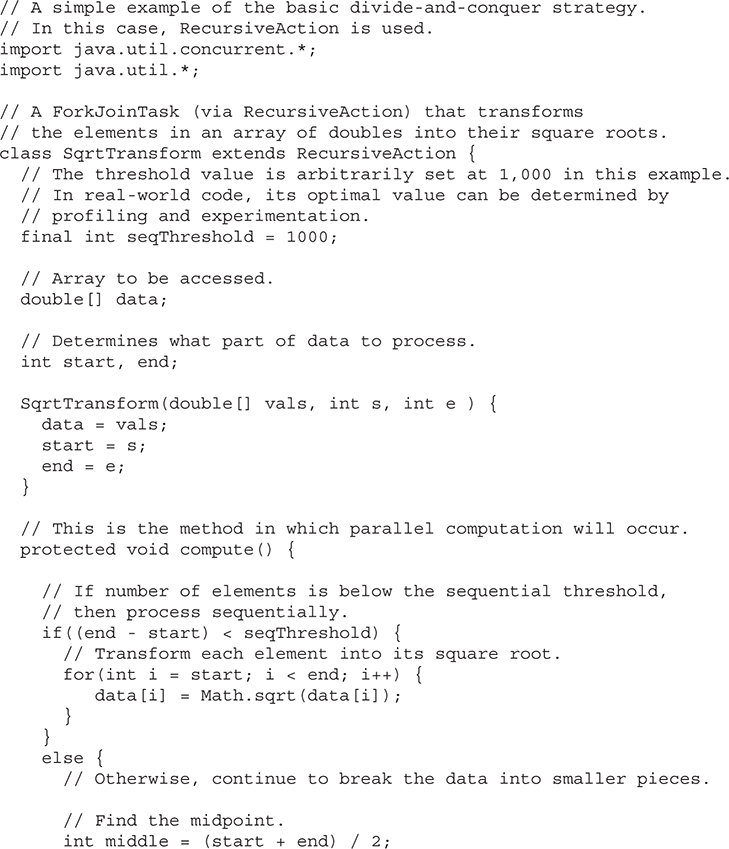
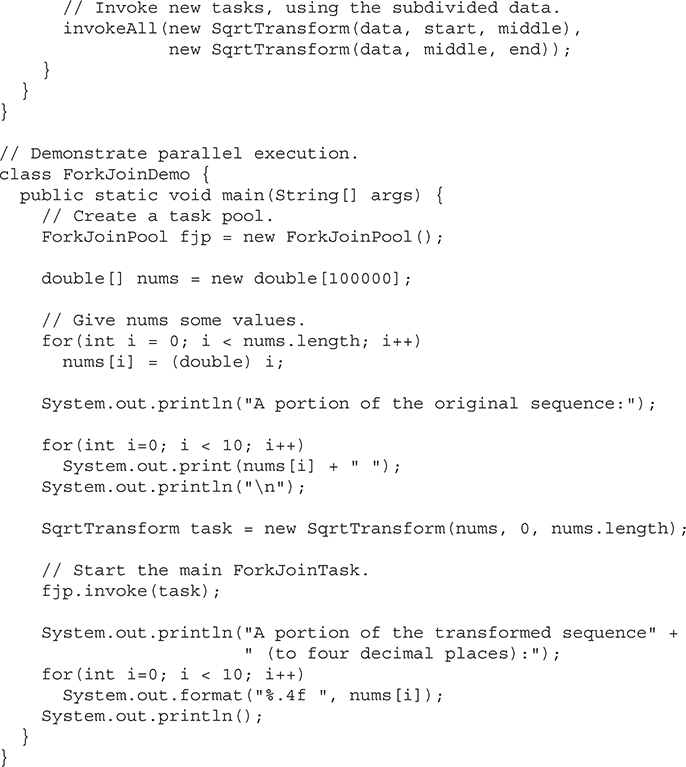
The output from the program is shown here:
A portion of the original sequence:
0.0 1.0 2.0 3.0 4.0 5.0 6.0 7.0 8.0 9.0
A portion of the transformed sequence (to four decimal places):
0.0000 1.0000 1.4142 1.7321 2.0000 2.2361 2.4495 2.6458 2.8284 3.0000
As you can see, the values of the array elements have been transformed into their square roots.
Let’s look closely at how this program works. First, notice that SqrtTransform is a class that extends RecursiveAction. As explained, RecursiveAction extends ForkJoinTask for tasks that do not return results. Next, notice the final variable seqThreshold. This is the value that determines when sequential processing will take place. This value is set (somewhat arbitrarily) to 1,000. Next, notice that a reference to the array to be processed is stored in data and that the fields start and end are used to indicate the boundaries of the elements to be accessed.
The main action of the program takes place in compute( ). It begins by checking if the number of elements to be processed is below the sequential processing threshold. If it is, then those elements are processed (by computing their square root in this example). If the sequential processing threshold has not been reached, then two new tasks are started by calling invokeAll( ). In this case, each subtask processes half the elements. As explained earlier, invokeAll( ) waits until both tasks return. After all of the recursive calls unwind, each element in the array will have been modified, with much of the action taking place in parallel (if multiple processors are available).
As mentioned, today it is not necessary to explicitly construct a ForkJoinPool because a common pool is available for your use. Furthermore, using the common pool is a simple matter. For example, you can obtain a reference to the common pool by calling the static commonPool( ) method defined by ForkJoinPool. Therefore, the preceding program could be rewritten to use the common pool by replacing the call to the ForkJoinPool constructor with a call to commonPool( ), as shown here:
ForkJoinPool fjp = ForkJoinPool.commonPool();
Alternatively, there is no need to explicitly obtain a reference to the common pool because calling the ForkJoinTask methods invoke( ) or fork( ) on a task that is not already part of a pool will cause it to execute within the common pool automatically. For example, in the preceding program, you can eliminate the fjp variable entirely and start the task using this line:
task.invoke();
As this discussion shows, the common pool can be easier to use than creating your own pool. Furthermore, in many cases, the common pool is the preferable approach.
Before moving on, it is important to understand the impact that the level of parallelism has on the performance of a fork/join task and how the parallelism and the threshold interact. The program shown in this section lets you experiment with different degrees of parallelism and threshold values. Assuming that you are using a multicore computer, you can interactively observe the effect of these values.
In the preceding example, the default level of parallelism was used. However, you can specify the level of parallelism that you want. One way is to specify it when you create a ForkJoinPool using this constructor:
ForkJoinPool(int pLevel)
Here, pLevel specifies the level of parallelism, which must be greater than zero and less than the implementation defined limit.
The following program creates a fork/join task that transforms an array of doubles. The transformation is arbitrary, but it is designed to consume several CPU cycles. This was done to ensure that the effects of changing the threshold or the level of parallelism would be more clearly displayed. To use the program, specify the threshold value and the level of parallelism on the command line. The program then runs the tasks. It also displays the amount of time it takes the tasks to run. To do this, it uses System.nanoTime( ), which returns the value of the JVM’s high-resolution timer.
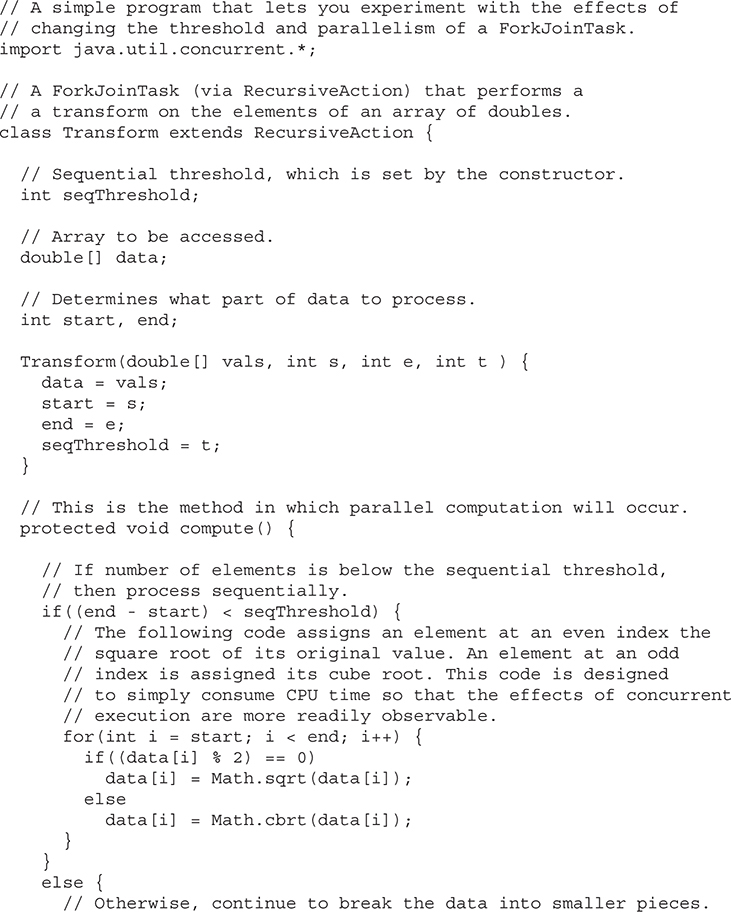
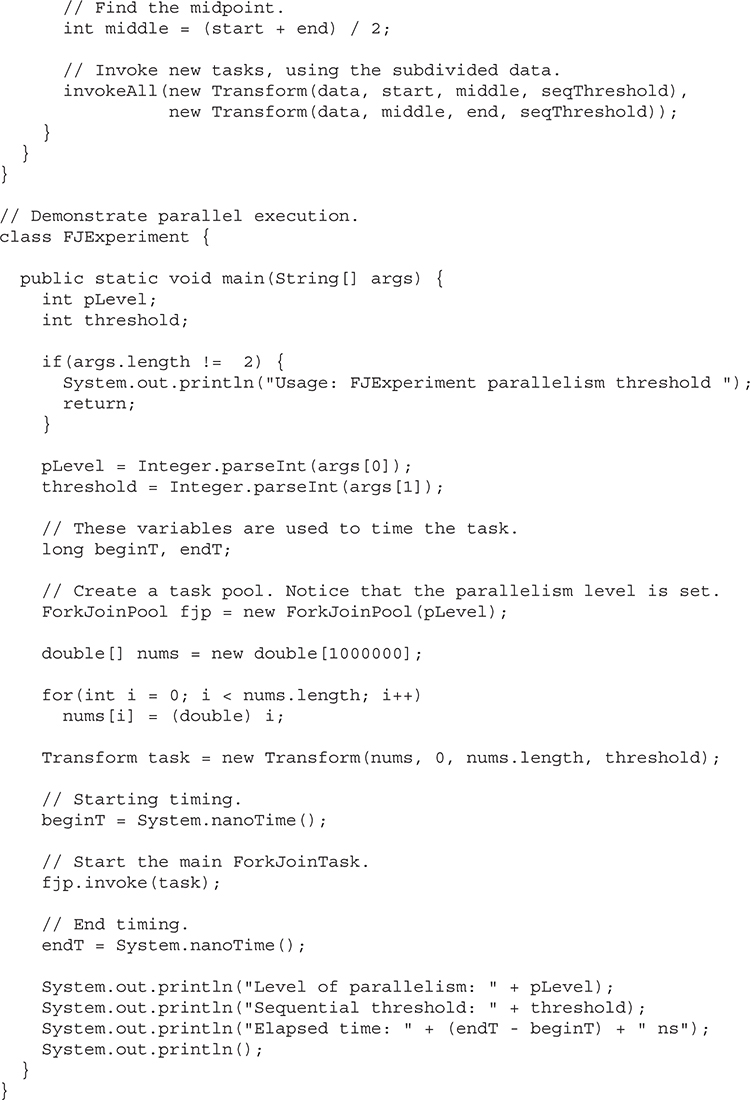
To use the program, specify the level of parallelism followed by the threshold limit. You should try experimenting with different values for each, observing the results. Remember, to be effective, you must run the code on a computer with at least two processors. Also, understand that two different runs may (almost certainly will) produce different results because of the effect of other processes in the system consuming CPU time.
To give you an idea of the difference that parallelism makes, try this experiment. First, execute the program like this:
java FJExperiment 1 1000
This requests 1 level of parallelism (essentially sequential execution) with a threshold of 1,000. Here is a sample run produced on a dual-core computer:
Level of parallelism: 1
Sequential threshold: 1000
Elapsed time: 259677487 ns
Now, specify 2 levels of parallelism like this:
java FJExperiment 2 1000
Here is sample output from this run produced by the same dual-core computer:
Level of parallelism: 2
Sequential threshold: 1000
Elapsed time: 169254472 ns
As is evident, adding parallelism substantially decreases execution time, thus increasing the speed of the program. You should experiment with varying the threshold and parallelism on your own computer. The results may surprise you.
Here are two other methods that you might find useful when experimenting with the execution characteristics of a fork/join program. First, you can obtain the level of parallelism by calling getParallelism( ), which is defined by ForkJoinPool. It is shown here:
int getParallelism( )
It returns the parallelism level currently in effect. Recall that for pools that you create, by default, this value will equal the number of available processors. (To obtain the parallelism level for the common pool, you can also use getCommonPoolParallelism( ). Second, you can obtain the number of processors available in the system by calling availableProcessors( ), which is defined by the Runtime class. It is shown here:
int availableProcessors( )
The value returned may change from one call to the next because of other system demands.
The two preceding examples are based on RecursiveAction, which means that they concurrently execute tasks that do not return results. To create a task that returns a result, use RecursiveTask. In general, solutions are designed in the same manner as just shown. The key difference is that the compute( ) method returns a result. Thus, you must aggregate the results, so that when the first invocation finishes, it returns the overall result. Another difference is that you will typically start a subtask by calling fork( ) and join( ) explicitly (rather than implicitly by calling invokeAll( ), for example).
The following program demonstrates RecursiveTask. It creates a task called Sum that returns the summation of the values in an array of double. In this example, the array consists of 5,000 elements. However, every other value is negative. Thus, the first values in the array are 0, –1, 2, –3, 4, and so on. (Notice that this example creates its own pool. You might try changing it to use the common pool as an exercise.)
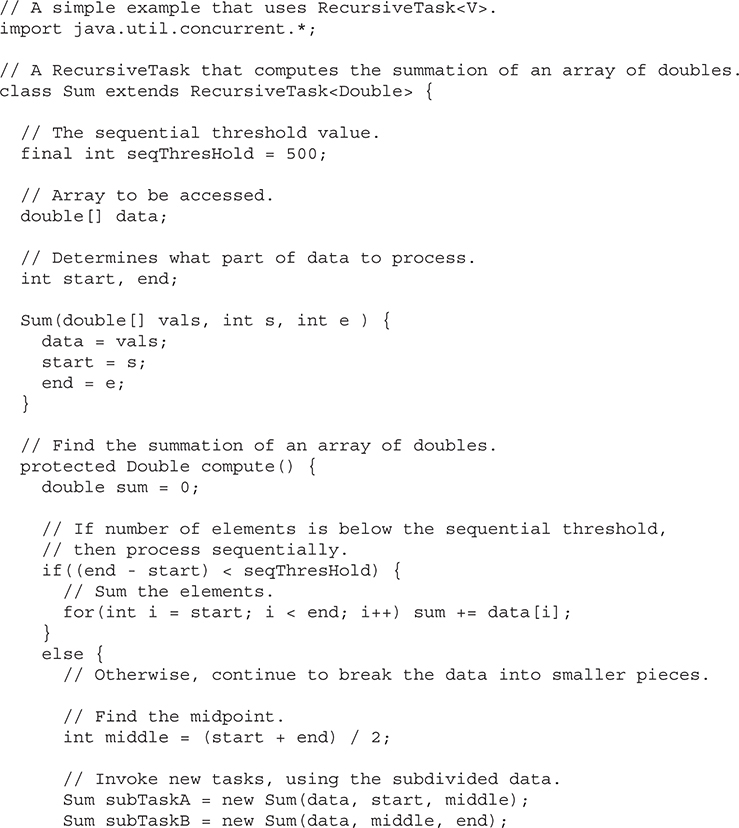
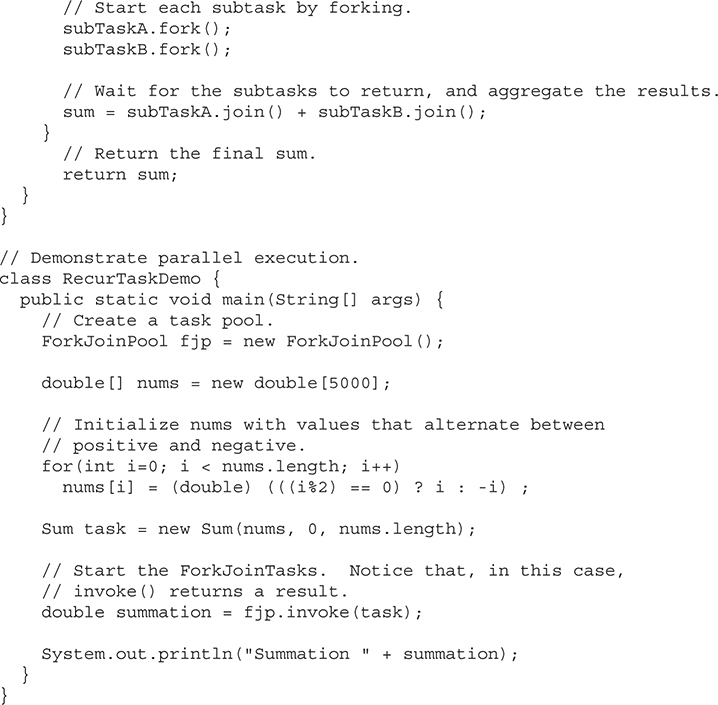
Here’s the output from the program:
Summation -2500.0
There are a couple of interesting items in this program. First, notice that the two subtasks are executed by calling fork( ), as shown here:
subTaskA.fork();
subTaskB.fork();
In this case, fork( ) is used because it starts a task but does not wait for it to finish. (Thus, it asynchronously runs the task.) The result of each task is obtained by calling join( ), as shown here:
sum = subTaskA.join() + subTaskB.join();
This statement waits until each task ends. It then adds the results of each and assigns the total to sum. Thus, the summation of each subtask is added to the running total. Finally, compute( ) ends by returning sum, which will be the final total when the first invocation returns.
There are other ways to approach the handling of the asynchronous execution of the subtasks. For example, the following sequence uses fork( ) to start subTaskA and uses invoke( ) to start and wait for subTaskB:
subTaskA.fork();
sum = subTaskB.invoke() + subTaskA.join();
Another alternative is to have subTaskB call compute( ) directly, as shown here:
subTaskA.fork();
sum = subTaskB.compute() + subTaskA.join();
The preceding programs have called invoke( ) on a ForkJoinPool to initiate a task. This approach is commonly used when the calling thread must wait until the task has completed (which is often the case) because invoke( ) does not return until the task has terminated. However, you can start a task asynchronously. In this approach, the calling thread continues to execute. Thus, both the calling thread and the task execute simultaneously. To start a task asynchronously, use execute( ), which is also defined by ForkJoinPool. It has the two forms shown here:
void execute(ForkJoinTask<?> task)
void execute(Runnable task)
In both forms, task specifies the task to run. Notice that the second form lets you specify a Runnable rather than a ForkJoinTask task. Thus, it forms a bridge between Java’s traditional approach to multithreading and the Fork/Join Framework. It is important to remember that the threads used by a ForkJoinPool are daemon. Thus, they will end when the main thread ends. As a result, you may need to keep the main thread alive until the tasks have finished.
A task can be cancelled by calling cancel( ), which is defined by ForkJoinTask. It has this general form:
boolean cancel(boolean interuptOK)
It returns true if the task on which it was called is cancelled. It returns false if the task has ended or can’t be cancelled. At this time, the interruptOK parameter is not used by the default implementation. In general, cancel( ) is intended to be called from code outside the task because a task can easily cancel itself by returning.
You can determine if a task has been cancelled by calling isCancelled( ), as shown here:
final boolean isCancelled( )
It returns true if the invoking task has been cancelled prior to completion and false otherwise.
In addition to isCancelled( ), which was just described, ForkJoinTask includes two other methods that you can use to determine a task’s completion status. The first is isCompletedNormally( ), which is shown here:
final boolean isCompletedNormally( )
It returns true if the invoking task completed normally, that is, if it did not throw an exception and it was not cancelled via a call to cancel( ). It returns false otherwise.
The second is isCompletedAbnormally( ), which is shown here:
final boolean isCompletedAbnormally( )
It returns true if the invoking task completed because it was cancelled or because it threw an exception. It returns false otherwise.
Normally, you cannot rerun a task. In other words, once a task completes, it cannot be restarted. However, you can reinitialize the state of the task (after it has completed) so it can be run again. This is done by calling reinitialize( ), as shown here:
void reinitialize( )
This method resets the state of the invoking task. However, any modification made to any persistent data that is operated upon by the task will not be undone. For example, if the task modifies an array, then those modifications are not undone by calling reinitialize( ).
The preceding discussion presented the fundamentals of the Fork/Join Framework and described several commonly used methods. However, Fork/Join is a rich framework that includes additional capabilities that give you extended control over concurrency. Although it is far beyond the scope of this book to examine all of the issues and nuances surrounding parallel programming and the Fork/Join Framework, a sampling of the other features are mentioned here.
In some cases, you will want to ensure that methods such as invokeAll( ) and fork( ) are called only from within a ForkJoinTask. This is usually a simple matter, but occasionally, you may have code that can be executed from either inside or outside a task. You can determine if your code is executing inside a task by calling inForkJoinPool( ).
You can convert a Runnable or Callable object into a ForkJoinTask by using the adapt( ) method defined by ForkJoinTask. It has three forms, one for converting a Callable, one for a Runnable that does not return a result, and one for a Runnable that does return a result. In the case of a Callable, the call( ) method is run. In the case of Runnable, the run( ) method is run.
You can obtain an approximate count of the number of tasks that are in the queue of the invoking thread by calling getQueuedTaskCount( ). You can obtain an approximate count of how many tasks the invoking thread has in its queue that are in excess of the number of other threads in the pool that might “steal” them, by calling getSurplusQueuedTaskCount( ). Remember, in the Fork/Join Framework, work-stealing is one way in which a high level of efficiency is obtained. Although this process is automatic, in some cases, the information may prove helpful in optimizing through-put.
ForkJoinTask defines the following variants of join( ) and invoke( ) that begin with the prefix quietly. They are shown here:

In essence, these methods are similar to their non-quiet counterparts except they don’t return values or throw exceptions.
You can attempt to “un-invoke” (in other words, unschedule) a task by calling tryUnfork( ).
Several methods, such as getForkJoinTaskTag( ) and setForkJoinTaskTag( ), support tags. Tags are short integer values that are linked with a task. They may be useful in specialized applications.
ForkJoinTask implements Serializable. Thus, it can be serialized. However, serialization is not used during execution.
One method that is quite useful when tuning fork/join applications is ForkJoinPool’s override of toString( ). It displays a “user-friendly” synopsis of the state of the pool. To see it in action, use this sequence to start and then wait for the task in the FJExperiment class of the task experimenter program shown earlier:

When you run the program, you will see a series of messages on the screen that describe the state of the pool. Here is an example of one. Of course, your output may vary, based on the number of processors, threshold values, task load, and so on.
java.util.concurrent.ForkJoinPool@141d683[Running, parallelism = 2,
size = 2, active = 0, running = 2, steals = 0, tasks = 0, submissions = 1]
You can determine if a pool is currently idle by calling isQuiescent( ). It returns true if the pool has no active threads and false otherwise.
You can obtain the number of worker threads currently in the pool by calling getPoolSize( ). You can obtain an approximate count of the active threads in the pool by calling getActiveThreadCount( ).
To shut down a pool, call shutdown( ). Currently active tasks will still be executed, but no new tasks can be started. To stop a pool immediately, call shutdownNow( ). In this case, an attempt is made to cancel currently active tasks. (It is important to point out, however, that neither of these methods affects the common pool.) You can determine if a pool is shut down by calling isShutdown( ). It returns true if the pool has been shut down and false otherwise. To determine if the pool has been shut down and all tasks have been completed, call isTerminated( ).
Here are a few tips to help you avoid some of the more troublesome pitfalls associated with using the Fork/Join Framework. First, avoid using a sequential threshold that is too low. In general, erring on the high side is better than erring on the low side. If the threshold is too low, more time can be consumed generating and switching tasks than in processing the tasks. Second, usually it is best to use the default level of parallelism. If you specify a smaller number, it may significantly reduce the benefits of using the Fork/Join Framework.
In general, a ForkJoinTask should not use synchronized methods or synchronized blocks of code. Also, you will not normally want to have the compute( ) method use other types of synchronization, such as a semaphore. (The Phaser can, however, be used when appropriate because it is compatible with the fork/join mechanism.) Remember, the main idea behind a ForkJoinTask is the divide-and-conquer strategy. Such an approach does not normally lend itself to situations in which outside synchronization is needed. Also, avoid situations in which substantial blocking will occur through I/O. Therefore, in general, a ForkJoinTask will not perform I/O. Simply put, to best utilize the Fork/Join Framework, a task should perform a computation that can run without outside blocking or synchronization.
One last point: Except under unusual circumstances, do not make assumptions about the execution environment that your code will run in. This means you should not assume that some specific number of processors will be available, or that the execution characteristics of your program won’t be affected by other processes running at the same time.
Given the power and flexibility found in the concurrency utilities, it is natural to ask the following question: Do they replace Java’s traditional approach to multithreading and synchronization? The answer is a resounding no! The original support for multithreading and the built-in synchronization features are still the mechanism that should be employed for many, many Java programs. For example, synchronized, wait( ), and notify( ) offer elegant solutions to a wide range of problems. However, when extra control is needed, the concurrency utilities are available to handle the chore. Furthermore, the Fork/Join Framework offers a powerful way to integrate parallel programming techniques into your more sophisticated applications.
Over the years, Java has been engaged in a process of ongoing evolution, with each release adding features that expand the richness and power of the language. Two such features of special importance are lambda expressions and the stream API. Lambda expressions were described in Chapter 15. The stream API is described here. As you will see, the stream API is designed with lambda expressions in mind. Moreover, the stream API provides some of the most significant demonstrations of the power that lambdas bring to Java.
Although its design compatibility with lambda expressions is impressive, the key aspect of the stream API is its ability to perform very sophisticated operations that search, filter, map, or otherwise manipulate data. For example, using the stream API, you can construct sequences of actions that resemble, in concept, the type of database queries for which you might use SQL. Furthermore, in many cases, such actions can be performed in parallel, thus providing a high level of efficiency, especially when large data sets are involved. Put simply, the stream API provides a powerful means of handling data in an efficient, yet easy to use way.
Before continuing, an important point needs to be made: The stream API uses some of Java’s most advanced features. To fully understand and utilize it requires a solid understanding of generics and lambda expressions. The basic concepts of parallel execution and a working knowledge of the Collections Framework are also needed. (See Chapters 14, 15, 20, and 29.)
Let’s begin by defining the term stream as it applies to the stream API: a stream is a conduit for data. Thus, a stream represents a sequence of objects. A stream operates on a data source, such as an array or a collection. A stream, itself, never provides storage for the data. It simply moves data, possibly filtering, sorting, or otherwise operating on that data in the process. As a general rule, however, a stream operation by itself does not modify the data source. For example, sorting a stream does not change the order of the source. Rather, sorting a stream results in the creation of a new stream that produces the sorted result.
Note It is necessary to state that the term stream as used here differs from the use of stream when the I/O classes were described earlier in this book. Although an I/O stream can act conceptually much like one of the streams defined by java.util.stream, they are not the same. Thus, throughout this chapter, when the term stream is used, it refers to objects based on one of the stream types described here.
The stream API defines several stream interfaces, which are packaged in java.util.stream and contained in the java.base module. At the foundation is BaseStream, which defines the basic functionality available in all streams. BaseStream is a generic interface declared like this:
interface BaseStream<T, S extends BaseStream<T, S>>
Here, T specifies the type of the elements in the stream, and S specifies the type of stream that extends BaseStream. BaseStream extends the AutoCloseable interface; thus, a stream can be managed in a try-with-resources statement. In general, however, only those streams whose data source requires closing (such as those connected to a file) will need to be closed. In most cases, such as those in which the data source is a collection, there is no need to close the stream. The methods declared by BaseStream are shown in Table 30-1.
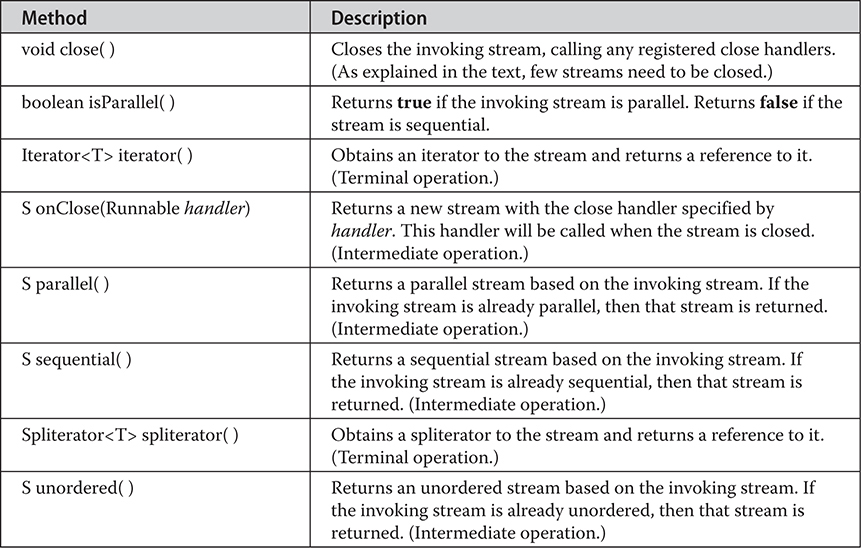
Table 30-1 The Methods Declared by BaseStream
From BaseStream are derived several types of stream interfaces. The most general of these is Stream. It is declared as shown here:
interface Stream<T>
Here, T specifies the type of the elements in the stream. Because it is generic, Stream is used for all reference types. In addition to the methods that it inherits from BaseStream, the Stream interface adds several of its own, a sampling of which is shown in Table 30-2.
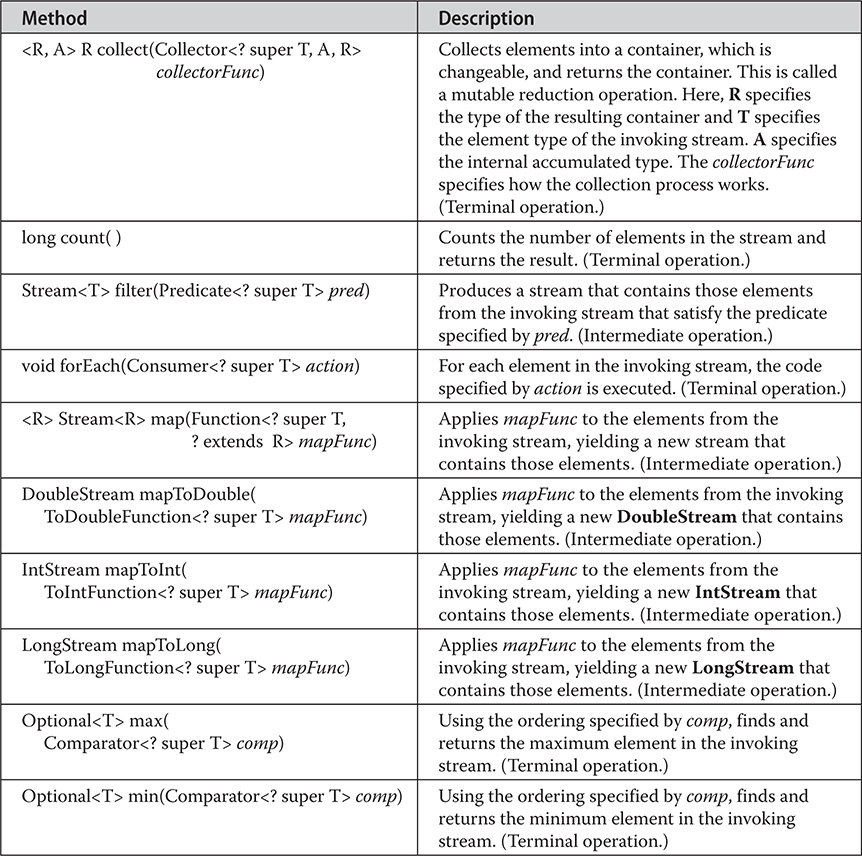

Table 30-2 A Sampling of Methods Declared by Stream
In both tables, notice that many of the methods are notated as being either terminal or intermediate. The difference between the two is very important. A terminal operation consumes the stream. It is used to produce a result, such as finding the minimum value in the stream, or to execute some action, as is the case with the forEach( ) method. Once a stream has been consumed, it cannot be reused. Intermediate operations produce another stream. Thus, intermediate operations can be used to create a pipeline that performs a sequence of actions. One other point: intermediate operations do not take place immediately. Instead, the specified action is performed when a terminal operation is executed on the new stream created by an intermediate operation. This mechanism is referred to as lazy behavior, and the intermediate operations are referred to as lazy. The use of lazy behavior enables the stream API to perform more efficiently.
Another key aspect of streams is that some intermediate operations are stateless and some are stateful. In a stateless operation, each element is processed independently of the others. In a stateful operation, the processing of an element may depend on aspects of the other elements. For example, sorting is a stateful operation because an element’s order depends on the values of the other elements. Thus, the sorted( ) method is stateful. However, filtering elements based on a stateless predicate is stateless because each element is handled individually. Thus, filter( ) can (and should be) stateless. The difference between stateless and stateful operations is especially important when parallel processing of a stream is desired because a stateful operation may require more than one pass to complete.
Because Stream operates on object references, it can’t operate directly on primitive types. To handle primitive type streams, the stream API defines the following interfaces:
DoubleStream
IntStream
LongStream
These streams all extend BaseStream and have capabilities similar to Stream except that they operate on primitive types rather than reference types. They also provide some convenience methods, such as boxed( ), that facilitate their use. Because streams of objects are the most common, Stream is the primary focus of this chapter, but the primitive type streams can be used in much the same way.
You can obtain a stream in a number of ways. Perhaps the most common is when a stream is obtained for a collection. Beginning with JDK 8, the Collection interface was expanded to include two methods that obtain a stream from a collection. The first is stream( ), shown here:
default Stream<E> stream( )
Its default implementation returns a sequential stream. The second method is parallelStream( ), shown next:
default Stream<E> parallelStream( )
Its default implementation returns a parallel stream, if possible. (If a parallel stream can not be obtained, a sequential stream may be returned instead.) Parallel streams support parallel execution of stream operations. Because Collection is implemented by every collection, these methods can be used to obtain a stream from any collection class, such as ArrayList or HashSet.
A stream can also be obtained from an array by use of the static stream( ) method, which was added to the Arrays class. One of its forms is shown here:
static <T> Stream<T> stream(T[ ] array)
This method returns a sequential stream to the elements in array. For example, given an array called addresses of type Address, the following obtains a stream to it:
Stream<Address> addrStrm = Arrays.stream(addresses);
Several overloads of the stream( ) method are also defined, such as those that handle arrays of the primitive types. They return a stream of type IntStream, DoubleStream, or LongStream.
Streams can be obtained in a variety of other ways. For example, many stream operations return a new stream, and a stream to an I/O source can be obtained by calling lines( ) on a BufferedReader. However a stream is obtained, it can be used in the same way as any other stream.
Before going any further, let’s work through an example that uses streams. The following program creates an ArrayList called myList that holds a collection of integers (which are automatically boxed into the Integer reference type). Next, it obtains a stream that uses myList as a source. It then demonstrates various stream operations.

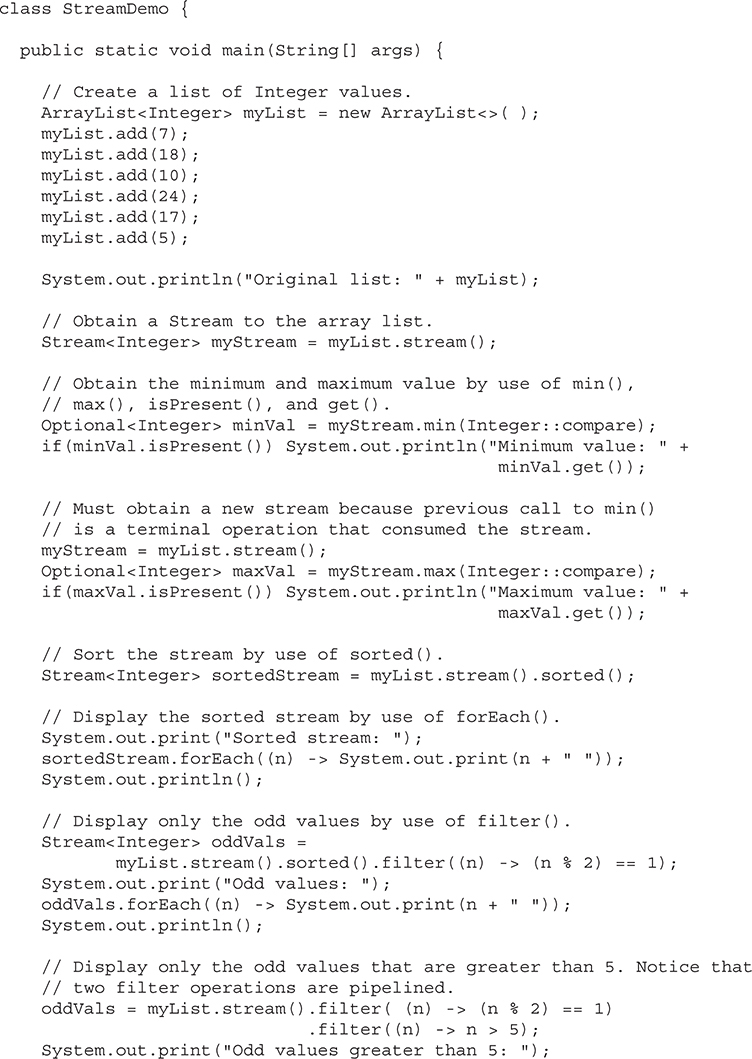

The output is shown here:
Original list: [7, 18, 10, 24, 17, 5]
Minimum value: 5
Maximum value: 24
Sorted stream: 5 7 10 17 18 24
Odd values: 5 7 17
Odd values greater than 5: 7 17
Let’s look closely at each stream operation. After creating an ArrayList, the program obtains a stream for the list by calling stream( ), as shown here:
Stream<Integer> myStream = myList.stream();
As explained, the Collection interface defines the stream( ) method, which obtains a stream from the invoking collection. Because Collection is implemented by every collection class, stream( ) can be used to obtain a stream for any type of collection, including the ArrayList used here. In this case, a reference to the stream is assigned to myStream.
Next, the program obtains the minimum value in the stream (which is, of course, also the minimum value in the data source) and displays it, as shown here:

Recall from Table 30-2 that min( ) is declared like this:
Optional<T> min(Comparator<? super T> comp)
First, notice that the type of min( )’s parameter is a Comparator. This comparator is used to compare two elements in the stream. In the example, min( ) is passed a method reference to Integer’s compare( ) method, which is used to implement a Comparator capable of comparing two Integers. Next, notice that the return type of min( ) is Optional. The Optional class is described in Chapter 21, but briefly, here is how it works. Optional is a generic class packaged in java.util and declared like this:
class Optional<T>
Here, T specifies the element type. An Optional instance can either contain a value of type T or be empty. You can use isPresent( ) to determine if a value is present. Assuming that a value is available, it can be obtained by calling get( ), or if you are using JDK 10 or later, orElseThrow( ). Here, get( ) is used. In this example, the object returned will hold the minimum value of the stream as an Integer object.
One other point about the preceding line: min( ) is a terminal operation that consumes the stream. Thus, myStream cannot be used again after min( ) executes.
The next lines obtain and display the maximum value in the stream:

First, myStream is once again assigned the stream returned by myList.stream( ). As just explained, this is necessary because the previous call to min( ) consumed the previous stream. Thus, a new one is needed. Next, the max( ) method is called to obtain the maximum value. Like min( ), max( ) returns an Optional object. Its value is obtained by calling get( ).
The program then obtains a sorted stream through the use of this line:
Stream<Integer> sortedStream = myList.stream().sorted();
Here, the sorted( ) method is called on the stream returned by myList.stream( ). Because sorted( ) is an intermediate operation, its result is a new stream, and this is the stream assigned to sortedStream. The contents of the sorted stream are displayed by use of forEach( ):
sortedStream.forEach((n) -> System.out.print(n + " "));
Here, the forEach( ) method executes an operation on each element in the stream. In this case, it simply calls System.out.print( ) for each element in sortedStream. This is accomplished by use of a lambda expression. The forEach( ) method has this general form:
void forEach(Consumer<? super T> action)
Consumer is a generic functional interface declared in java.util.function. Its abstract method is accept( ), shown here:
void accept(T objRef)
The lambda expression in the call to forEach( ) provides the implementation of accept( ). The forEach( ) method is a terminal operation. Thus, after it completes, the stream has been consumed.
Next, a sorted stream is filtered by filter( ) so that it contains only odd values:

The filter( ) method filters a stream based on a predicate. It returns a new stream that contains only those elements that satisfy the predicate. It is shown here:
Stream<T> filter(Predicate<? super T> pred)
Predicate is a generic functional interface defined in java.util.function. Its abstract method is test( ), which is shown here:
boolean test(T objRef)
It returns true if the object referred to by objRef satisfies the predicate, and false otherwise. The lambda expression passed to filter( ) implements this method. Because filter( ) is an intermediate operation, it returns a new stream that contains filtered values, which, in this case, are the odd numbers. These elements are then displayed via forEach( ) as before.
Because filter( ), or any other intermediate operation, returns a new stream, it is possible to filter a filtered stream a second time. This is demonstrated by the following line, which produces a stream that contains only those odd values greater than 5:

Notice that lambda expressions are passed to both filters.
Consider the min( ) and max( ) methods in the preceding example program. Both are terminal operations that return a result based on the elements in the stream. In the language of the stream API, they represent reduction operations because each reduces a stream to a single value—in this case, the minimum and maximum. The stream API refers to these as special case reductions because they perform a specific function. In addition to min( ) and max( ), other special case reductions are also available, such as count( ), which counts the number of elements in a stream. However, the stream API generalizes this concept by providing the reduce( ) method. By using reduce( ), you can return a value from a stream based on any arbitrary criteria. By definition, all reduction operations are terminal operations.
Stream defines three versions of reduce( ). The two we will use first are shown here:
Optional<T> reduce(BinaryOperator<T> accumulator)
T reduce(T identityVal, BinaryOperator<T> accumulator)
The first form returns an object of type Optional, which contains the result. The second form returns an object of type T (which is the element type of the stream). In both forms, accumulator is a function that operates on two values and produces a result. In the second form, identityVal is a value such that an accumulator operation involving identityVal and any element of the stream yields that element, unchanged. For example, if the operation is addition, then the identity value will be 0 because 0 + x is x. For multiplication, the value will be 1, because 1 * x is x.
BinaryOperator is a functional interface declared in java.util.function that extends the BiFunction functional interface. BiFunction defines this abstract method:
R apply(T val, U val2)
Here, R specifies the result type, T is the type of the first operand, and U is the type of second operand. Thus, apply( ) applies a function to its two operands (val and val2) and returns the result. When BinaryOperator extends BiFunction, it specifies the same type for all the type parameters. Thus, as it relates to BinaryOperator, apply( ) looks like this:
T apply(T val, T val2)
Furthermore, as it relates to reduce( ), val will contain the previous result and val2 will contain the next element. In its first invocation, val will contain either the identity value or the first element, depending on which version of reduce( ) is used.
It is important to understand that the accumulator operation must satisfy three constraints. It must be
• Stateless
• Non-interfering
• Associative
As explained earlier, stateless means that the operation does not rely on any state information. Thus, each element is processed independently. Non-interfering means that the data source is not modified by the operation. Finally, the operation must be associative. Here, the term associative is used in its normal, arithmetic sense, which means that, given an associative operator used in a sequence of operations, it does not matter which pair of operands are processed first. For example,
(10 * 2) * 7
yields the same result as
10 * (2 * 7)
Associativity is of particular importance to the use of reduction operations on parallel streams, discussed in the next section.
The following program demonstrates the versions of reduce( ) just described:
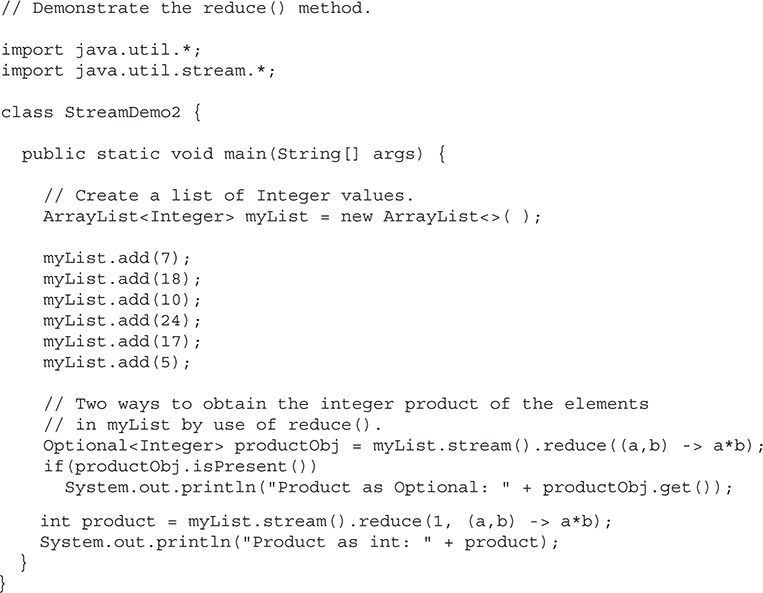
As the output here shows, both uses of reduce( ) produce the same result:
Product as Optional: 2570400
Product as int: 2570400
In the program, the first version of reduce( ) uses the lambda expression to produce a product of two values. In this case, because the stream contains Integer values, the Integer objects are automatically unboxed for the multiplication and reboxed to return the result. The two values represent the current value of the running result and the next element in the stream. The final result is returned in an object of type Optional. The value is obtained by calling get( ) on the returned object.
In the second version, the identity value is explicitly specified, which for multiplication is 1. Notice that the result is returned as an object of the element type, which is Integer in this case.
Although simple reduction operations such as multiplication are useful for examples, reductions are not limited in this regard. For example, assuming the preceding program, the following obtains the product of only the even values:

Pay special attention to the lambda expression. If b is even, then a * b is returned. Otherwise, a is returned. This works because a holds the current result and b holds the next element, as explained earlier.
Before exploring any more of the stream API, it will be helpful to discuss parallel streams. As has been pointed out previously in this book, the parallel execution of code via multicore processors can result in a substantial increase in performance. Because of this, parallel programming has become an important part of the modern programmer’s job. However, parallel programming can be complex and error-prone. One of the benefits that the stream library offers is the ability to easily—and reliably—parallel process certain operations.
Parallel processing of a stream is quite simple to request: just use a parallel stream. As mentioned earlier, one way to obtain a parallel stream is to use the parallelStream( ) method defined by Collection. Another way to obtain a parallel stream is to call the parallel( ) method on a sequential stream. The parallel( ) method is defined by BaseStream, as shown here:
S parallel()
It returns a parallel stream based on the sequential stream that invokes it. (If it is called on a stream that is already parallel, then the invoking stream is returned.) Understand, of course, that even with a parallel stream, parallelism will be achieved only if the environment supports it.
Once a parallel stream has been obtained, operations on the stream can occur in parallel, assuming that parallelism is supported by the environment. For example, the first reduce( ) operation in the preceding program can be parallelized by substituting parallelStream( ) for the call to stream( ):
Optional<Integer> productObj = myList.parallelStream().reduce((a,b) -> a*b);
The results will be the same, but the multiplications can occur in different threads.
As a general rule, any operation applied to a parallel stream must be stateless. It should also be non-interfering and associative. This ensures that the results obtained by executing operations on a parallel stream are the same as those obtained from executing the same operations on a sequential stream.
When using parallel streams, you might find the following version of reduce( ) especially helpful. It gives you a way to specify how partial results are combined:
<U> U reduce(U identityVal, BiFunction<U, ? super T, U> accumulator
BinaryOperator<U> combiner)
In this version, combiner defines the function that combines two values that have been produced by the accumulator function. Assuming the preceding program, the following statement computes the product of the elements in myList by use of a parallel stream:

As you can see, in this example, both the accumulator and combiner perform the same function. However, there are cases in which the actions of the accumulator must differ from those of the combiner. For example, consider the following program. Here, myList contains a list of double values. It then uses the combiner version of reduce( ) to compute the product of the square roots of each element in the list.
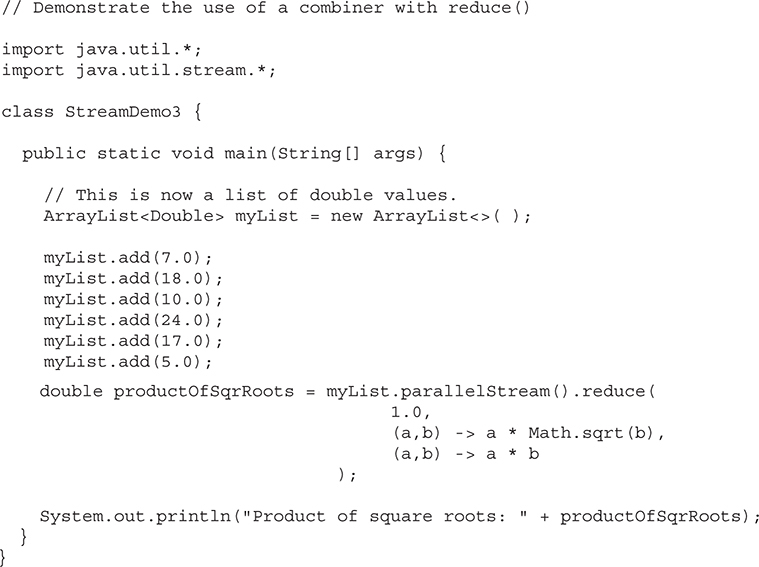
Notice that the accumulator function multiplies the square roots of two elements, but the combiner multiplies the partial results. Thus, the two functions differ. Moreover, for this computation to work correctly, they must differ. For example, if you tried to obtain the product of the square roots of the elements by using the following statement, an error would result:

In this version of reduce( ), the accumulator and the combiner function are one and the same. This results in an error because when two partial results are combined, their square roots are multiplied together rather than the partial results, themselves.
As a point of interest, if the stream in the preceding call to reduce( ) had been changed to a sequential stream, then the operation would yield the correct answer because there would have been no need to combine two partial results. The problem occurs when a parallel stream is used.
You can switch a parallel stream to sequential by calling the sequential( ) method, which is specified by BaseStream. It is shown here:
S sequential( )
In general, a stream can be switched between parallel and sequential on an as-needed basis.
There is one other aspect of a stream to keep in mind when using parallel execution: the order of the elements. Streams can be either ordered or unordered. In general, if the data source is ordered, then the stream will also be ordered. However, when using a parallel stream, a performance boost can sometimes be obtained by allowing a stream to be unordered. When a parallel stream is unordered, each partition of the stream can be operated on independently, without having to coordinate with the others. In cases in which the order of the operations does not matter, it is possible to specify unordered behavior by calling the unordered( ) method, shown here:
S unordered( )
One other point: the forEach( ) method may not preserve the ordering of a parallel stream. If you want to perform an operation on each element in a parallel stream while preserving the order, consider using forEachOrdered( ). It is used just like forEach( ).
Often it is useful to map the elements of one stream to another. For example, a stream that contains a database of name, telephone, and e-mail address information might map only the name and e-mail address portions to another stream. As another example, you might want to apply some transformation to the elements in a stream. To do this, you could map the transformed elements to a new stream. Because mapping operations are quite common, the stream API provides built-in support for them. The most general mapping method is map( ). It is shown here:
<R> Stream<R> map(Function<? super T, ? extends R> mapFunc)
Here, R specifies the type of elements of the new stream; T is the type of elements of the invoking stream; and mapFunc is an instance of Function, which does the mapping. The map function must be stateless and non-interfering. Since a new stream is returned, map( ) is an intermediate method.
Function is a functional interface declared in java.util.function. It is declared as shown here:
Function<T, R>
As it relates to map( ), T is the element type and R is the result of the mapping. Function has the abstract method shown here:
R apply(T val)
Here, val is a reference to the object being mapped. The mapped result is returned.
The following is a simple example of map( ). It provides a variation on the previous example program. As before, the program computes the product of the square roots of the values in an ArrayList. In this version, however, the square roots of the elements are first mapped to a new stream. Then, reduce( ) is employed to compute the product.
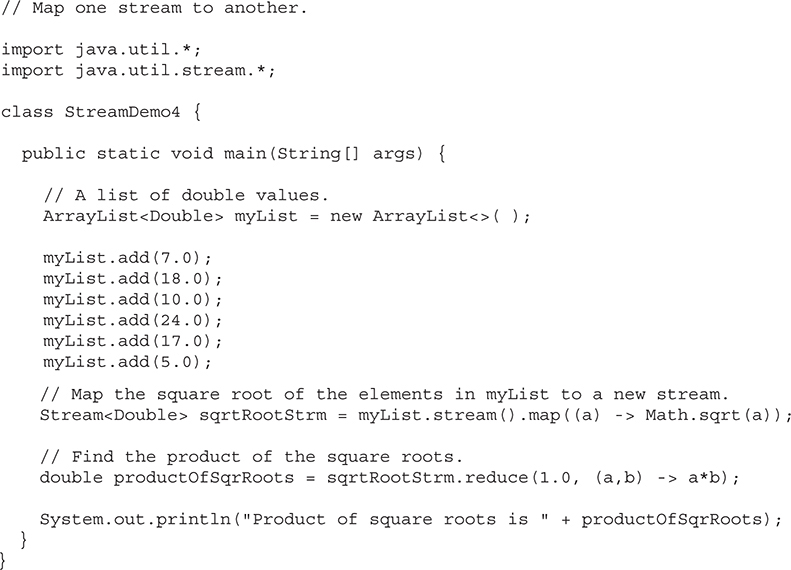
The output is the same as before. The difference between this version and the previous is simply that the transformation (i.e., the computation of the square roots) occurs during mapping, rather than during the reduction. Because of this, it is possible to use the two-parameter form of reduce( ) to compute the product because it is no longer necessary to provide a separate combiner function.
Here is an example that uses map( ) to create a new stream that contains only selected fields from the original stream. In this case, the original stream contains objects of type NamePhoneEmail, which contains names, phone numbers, and e-mail addresses. The program then maps only the names and phone numbers to a new stream of NamePhone objects. The e-mail addresses are discarded.
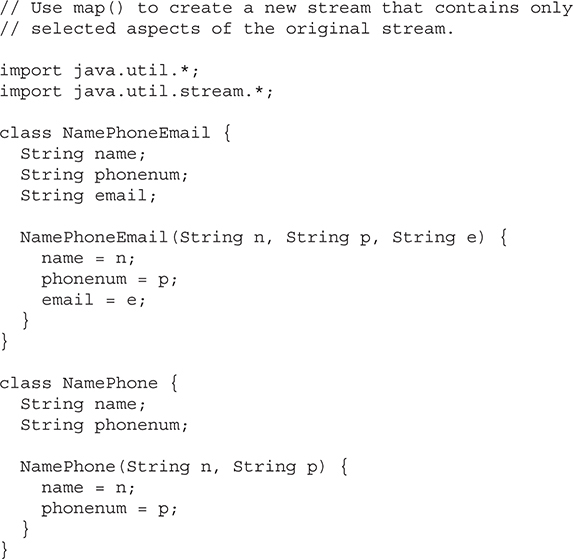
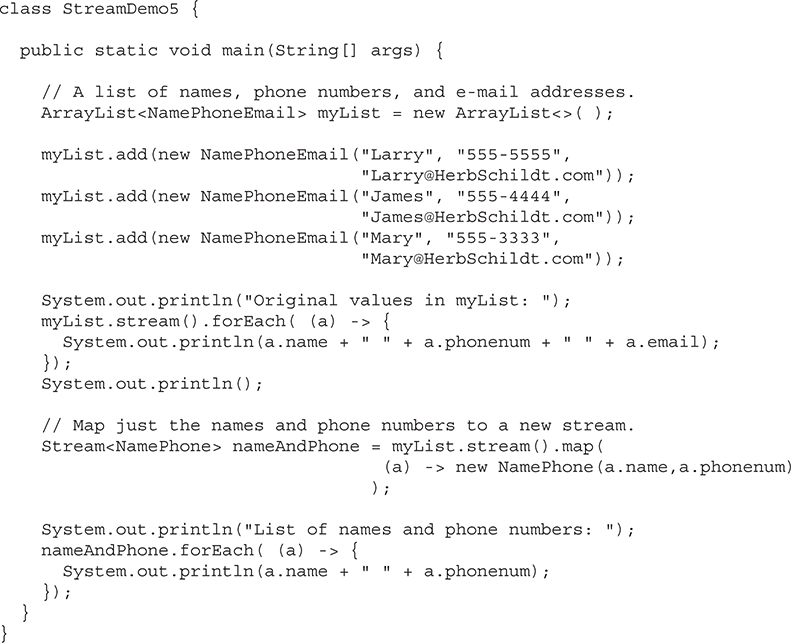
The output, shown here, verifies the mapping:

Because you can pipeline more than one intermediate operation together, you can easily create very powerful actions. For example, the following statement uses filter( ) and then map( ) to produce a new stream that contains only the name and phone number of the elements with the name "James":

This type of filter operation is very common when creating database-style queries. As you gain experience with the stream API, you will find that such chains of operations can be used to create very sophisticated queries, merges, and selections on a data stream.
In addition to the version just described, three other versions of map( ) are provided. They return a primitive stream, as shown here:
IntStream mapToInt(ToIntFunction<? super T> mapFunc)
LongStream mapToLong(ToLongFunction<? super T> mapFunc)
DoubleStream mapToDouble(ToDoubleFunction<? super T> mapFunc)
Each mapFunc must implement the abstract method defined by the specified interface, returning a value of the indicated type. For example, ToDoubleFunction specifies the applyAsDouble(T val ) method, which must return the value of its parameter as a double.
Here is an example that uses a primitive stream. It first creates an ArrayList of Double values. It then uses stream( ) followed by mapToInt( ) to create an IntStream that contains the ceiling of each value.
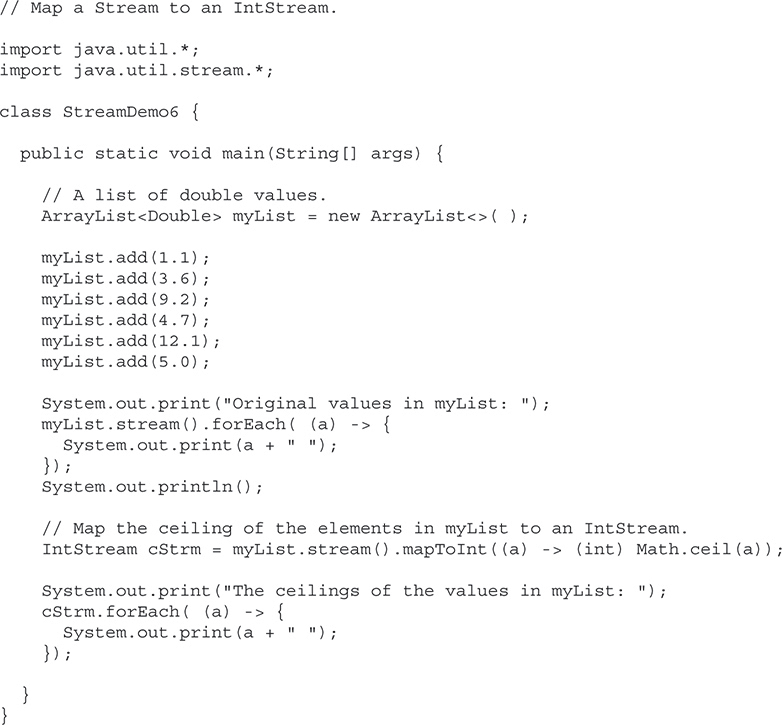
The output is shown here:
Original values in myList: 1.1 3.6 9.2 4.7 12.1 5.0
The ceilings of the values in myList: 2 4 10 5 13 5
The stream produced by mapToInt( ) contains the ceiling values of the original elements in myList.
Before leaving the topic of mapping, it is necessary to point out that the stream API also provides methods that support flat maps. These are flatMap( ), flatMapToInt( ), flatMapToLong( ), and flatMapToDouble( ). The flat map methods are designed to handle situations in which each element in the original stream is mapped to more than one element in the resulting stream. Beginning with JDK 16, Stream also supplies these additional flat map related methods: mapMulti( ), mapMultiToInt( ), mapMultiToLong( ), and mapMulltiToDouble( ).
As the preceding examples have shown, it is possible (indeed, common) to obtain a stream from a collection. Sometimes it is desirable to obtain the opposite: to obtain a collection from a stream. To perform such an action, you will generally use the collect( ) method. It has two forms. The one we will use first is shown here:
<R, A> R collect(Collector<? super T, A, R> collectorFunc)
Here, R specifies the type of the result, and T specifies the element type of the invoking stream. The internal accumulated type is specified by A. The collectorFunc specifies how the collection process works. The collect( ) method is a terminal operation.
The Collector interface is declared in java.util.stream, as shown here:
interface Collector<T, A, R>
T, A, and R have the same meanings as just described. Collector specifies several methods, but for the purposes of this chapter, we won’t need to implement them. Instead, we will use two of the predefined collectors that are provided by the Collectors class, which is packaged in java.util.stream.
The Collectors class defines a number of static collector methods that you can use as-is. The two we will use are toList( ) and toSet( ), shown here:
static <T> Collector<T, ?, List<T>> toList( )
static <T> Collector<T, ?, Set<T>> toSet( )
The toList( ) method returns a collector that can be used to collect elements into a List. The toSet( ) method returns a collector that can be used to collect elements into a Set. For example, to collect elements into a List, you can call collect( ) like this:
collect(Collectors.toList())
The following program puts the preceding discussion into action. It reworks the example in the previous section so that it collects the names and phone numbers into a List and a Set.
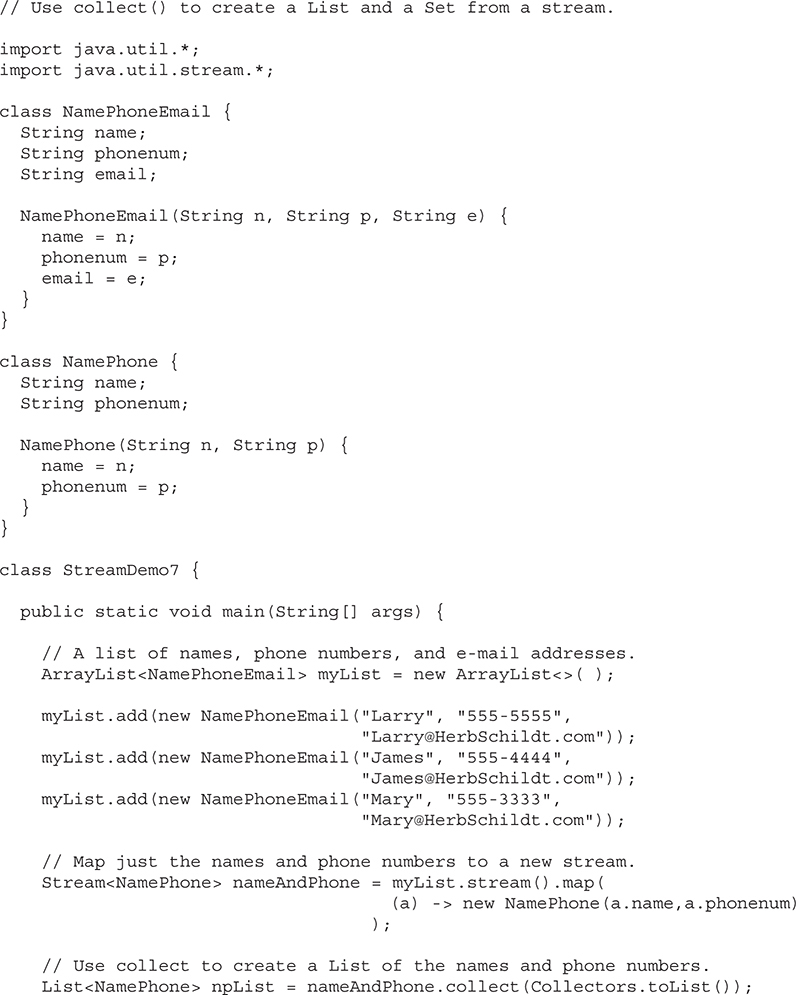
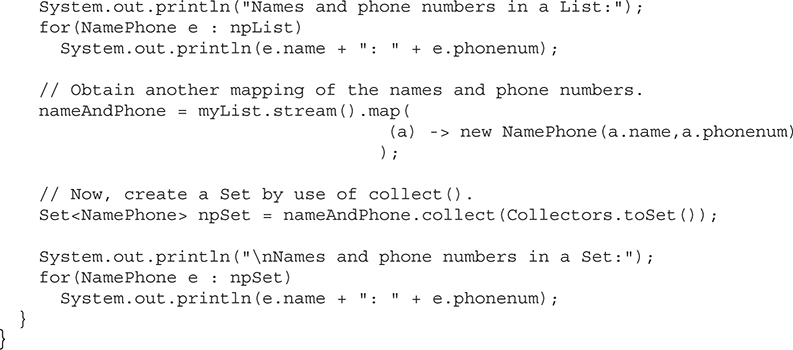
The output is shown here:
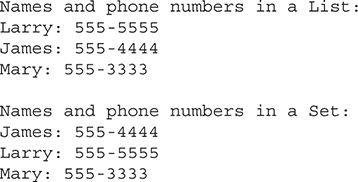
In the program, the following line collects the name and phone numbers into a List by using toList( ):
List<NamePhone> npList = nameAndPhone.collect(Collectors.toList());
After this line executes, the collection referred to by npList can be used like any other List collection. For example, it can be cycled through by using a for-each for loop, as shown in the next line:

The creation of a Set via collect(Collectors.toSet( )) works in the same way. The ability to move data from a collection to a stream, and then back to a collection again is a very powerful attribute of the stream API. It gives you the ability to operate on a collection through a stream, but then repackage it as a collection. Furthermore, the stream operations can, if appropriate, occur in parallel.
The version of collect( ) used by the previous example is quite convenient, and often the one you want, but there is a second version that gives you more control over the collection process. It is shown here:
<R> R collect(Supplier<R> target, BiConsumer<R, ? super T> accumulator,
BiConsumer <R, R> combiner)
Here, target specifies how the object that holds the result is created. For example, to use a LinkedList as the result collection, you would specify its constructor. The accumulator function adds an element to the result and combiner combines two partial results. Thus, these functions work similarly to the way they do in reduce( ). For both, they must be stateless and non-interfering. They must also be associative.
Note that the target parameter is of type Supplier. It is a functional interface declared in java.util.function. It specifies only the get( ) method, which has no parameters and, in this case, returns an object of type R. Thus, as it relates to collect( ), get( ) returns a reference to a mutable storage object, such as a collection.
Note also that the types of accumulator and combiner are BiConsumer. This is a functional interface defined in java.util.function. It specifies the abstract method accept( ) that is shown here:
void accept(T obj, U obj2)
This method performs some type of operation on obj and obj2. As it relates to accumulator, obj specifies the target collection, and obj2 specifies the element to add to that collection. As it relates to combiner, obj and obj2 specify two collections that will be combined.
Using the version of collect( ) just described, you could use a LinkedList as the target in the preceding program, as shown here:

Notice that the first argument to collect( ) is a lambda expression that returns a new LinkedList. The second argument uses the standard collection method add( ) to add an element to the list. The third element uses addAll( ) to combine two linked lists. As a point of interest, you can use any method defined by LinkedList to add an element to the list. For example, you could use addFirst( ) to add elements to the start of the list, as shown here:
(list, element) -> list.addFirst(element)
As you may have guessed, it is not always necessary to specify a lambda expression for the arguments to collect( ). Often, method and/or constructor references will suffice. For example, again assuming the preceding program, this statement creates a HashSet that contains all of the elements in the nameAndPhone stream:

Notice that the first argument specifies the HashSet constructor reference. The second and third specify method references to HashSet’s add( ) and addAll( ) methods.
One last point: In the language of the stream API, the collect( ) method performs what is called a mutable reduction. This is because the result of the reduction is a mutable (i.e., changeable) storage object, such as a collection. If you want to obtain an unmodifiable collection from a stream, then beginning with JDK 16, you can use the toList( ) method in Stream. It returns an unmodifiable List.
Although a stream is not a data storage object, you can still use an iterator to cycle through its elements in much the same way as you would use an iterator to cycle through the elements of a collection. The stream API supports two types of iterators. The first is the traditional Iterator. The second is Spliterator, which was added by JDK 8. It provides significant advantages in certain situations when used with parallel streams.
As just mentioned, you can use an iterator with a stream in just the same way that you do with a collection. Iterators are discussed in Chapter 20, but a brief review will be useful here. Iterators are objects that implement the Iterator interface declared in java.util. Its two key methods are hasNext( ) and next( ). If there is another element to iterate, hasNext( ) returns true, and false otherwise. The next( ) method returns the next element in the iteration.
Note There are additional iterator types that handle the primitive streams: PrimitiveIterator, PrimitiveIterator.OfDouble, PrimitiveIterator.OfLong, and PrimitiveIterator.OfInt. These iterators all extend the Iterator interface and work in the same general way as those based directly on Iterator.
To obtain an iterator to a stream, call iterator( ) on the stream. The version used by Stream is shown here.
Iterator<T> iterator( )
Here, T specifies the element type. (The primitive streams return iterators of the appropriate primitive type.)
The following program shows how to iterate through the elements of a stream. In this case, the strings in an ArrayList are iterated, but the process is the same for any type of stream.
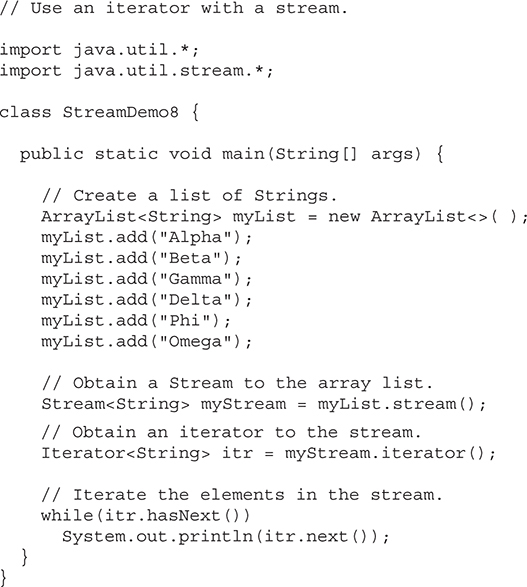
The output is shown here:
Alpha
Beta
Gamma
Delta
Phi
Omega
Spliterator offers an alternative to Iterator, especially when parallel processing is involved. In general, Spliterator is more sophisticated than Iterator, and a discussion of Spliterator is found in Chapter 20. However, it will be useful to review its key features here. Spliterator defines several methods, but we only need to use three. The first is tryAdvance( ). It performs an action on the next element and then advances the iterator. It is shown here:
boolean tryAdvance(Consumer<? super T> action)
Here, action specifies the action that is executed on the next element in the iteration. tryAdvance( ) returns true if there is a next element. It returns false if no elements remain. As discussed earlier in this chapter, Consumer declares one method called accept( ) that receives an element of type T as an argument and returns void.
Because tryAdvance( ) returns false when there are no more elements to process, it makes the iteration loop construct very simple, for example:
while(splitItr.tryAdvance( // perform action here );
As long as tryAdvance( ) returns true, the action is applied to the next element. When tryAdvance( ) returns false, the iteration is complete. Notice how tryAdvance( ) consolidates the purposes of hasNext( ) and next( ) provided by Iterator into a single method. This improves the efficiency of the iteration process.
The following version of the preceding program substitutes a Spliterator for the Iterator:
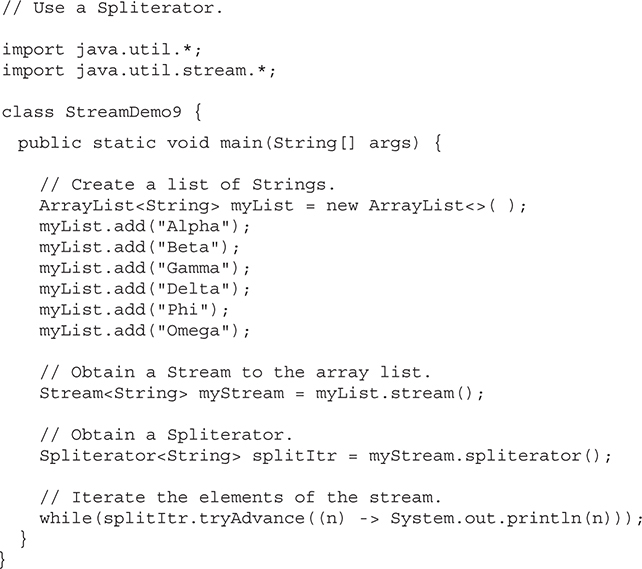
The output is the same as before.
In some cases, you might want to perform some action on each element collectively, rather than one at a time. To handle this type of situation, Spliterator provides the forEachRemaining( ) method, shown here:
default void forEachRemaining(Consumer<? super T> action)
This method applies action to each unprocessed element and then returns. For example, assuming the preceding program, the following displays the strings remaining in the stream:
splitItr.forEachRemaining((n) -> System.out.println(n));
Notice how this method eliminates the need to provide a loop to cycle through the elements one at a time. This is another advantage of Spliterator.
One other Spliterator method of particular interest is trySplit( ). It splits the elements being iterated in two, returning a new Spliterator to one of the partitions. The other partition remains accessible by the original Spliterator. It is shown here:
Spliterator<T> trySplit( )
If it is not possible to split the invoking Spliterator, null is returned. Otherwise, a reference to the partition is returned. For example, here is another version of the preceding program that demonstrates trySplit( ):
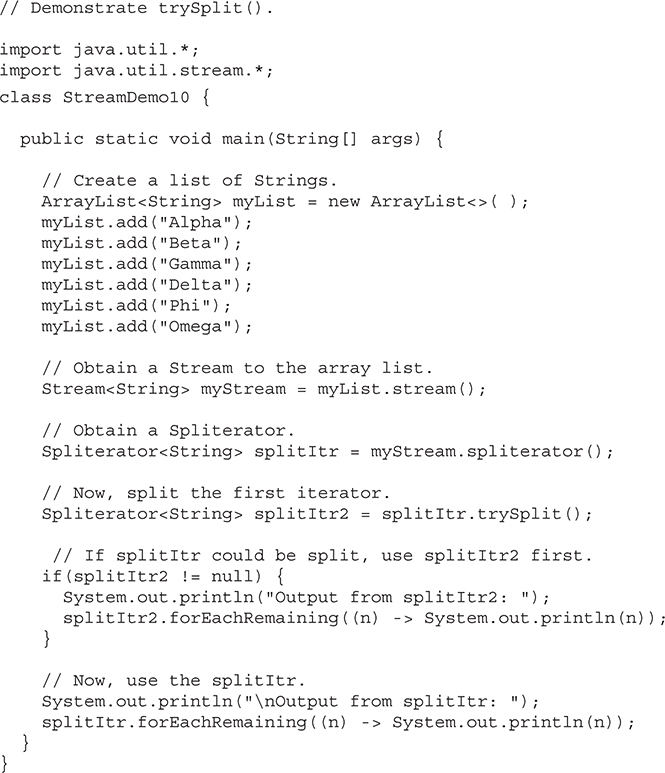
The output is shown here:
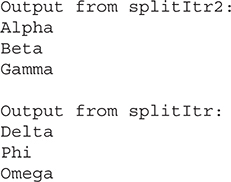
Although splitting the Spliterator in this simple illustration is of no practical value, splitting can be of great value when parallel processing over large data sets. However, in many cases, it is better to use one of the other Stream methods in conjunction with a parallel stream, rather than manually handling these details with Spliterator. Spliterator is primarily for the cases in which none of the predefined methods seems appropriate.
This chapter has discussed several key aspects of the stream API and introduced the techniques required to use them, but the stream API has much more to offer. To begin, here are a few of the other methods provided by Stream that you will find helpful:
• To determine if one or more elements in a stream satisfy a specified predicate, use allMatch( ), anyMatch( ), or noneMatch( ).
• To obtain the number of elements in the stream, call count( ).
• To obtain a stream that contains only unique elements, use distinct( ).
• To create a stream that contains a specified set of elements, use of( ).
One last point: the stream API is a powerful aspect of Java. You will want to explore all of the capabilities that java.util.stream has to offer.
When Java was originally released, it included a set of eight packages, called the core API. Each subsequent release added to the API. Today, the Java API contains a very large number of packages. Many of the packages support areas of specialization that are beyond the scope of this book. However, several packages warrant an introduction here. Four are java.util.regex, java.lang.reflect, java.rmi, and java.text. They support regular expression processing, reflection, Remote Method Invocation (RMI), and text formatting, respectively. The chapter ends by introducing the date and time API in java.time and its subpackages.
The regular expression package lets you perform sophisticated pattern matching operations. This chapter provides an introduction to this package along with extensive examples. Reflection is the ability of software to analyze itself. It is an essential part of the Java Beans technology that is covered in Chapter 35. Remote Method Invocation (RMI) allows you to build Java applications that are distributed among several machines. This chapter provides a simple client/server example that uses RMI. The text formatting capabilities of java.text have many uses. The one examined here formats date and time strings. The date and time API supplies an up-to-date approach to handling date and time.
The java.util.regex package supports regular expression processing. Beginning with JDK 9, java.util.regex is in the java.base module. As the term is used here, a regular expression is a string of characters that describes a character sequence. This general description, called a pattern, can then be used to find matches in other character sequences. Regular expressions can specify wildcard characters, sets of characters, and various quantifiers. Thus, you can specify a regular expression that represents a general form that can match several different specific character sequences.
There are two classes that support regular expression processing: Pattern and Matcher. These classes work together. Use Pattern to define a regular expression. Match the pattern against another sequence using Matcher.
The Pattern class defines no constructors. Instead, a pattern is created by calling the compile( ) factory method. One of its forms is shown here:
static Pattern compile(String pattern)
Here, pattern is the regular expression that you want to use. The compile( ) method transforms the string in pattern into a pattern that can be used for pattern matching by the Matcher class. It returns a Pattern object that contains the pattern.
Once you have created a Pattern object, you will use it to create a Matcher. This is done by calling the matcher( ) method defined by Pattern. It is shown here:
Matcher matcher(CharSequence str)
Here str is the character sequence that the pattern will be matched against. This is called the input sequence. CharSequence is an interface that defines a read-only set of characters. It is implemented by the String class, among others. Thus, you can pass a string to matcher( ).
The Matcher class has no constructors. Instead, you create a Matcher by calling the matcher( ) factory method defined by Pattern, as just explained. Once you have created a Matcher, you will use its methods to perform various pattern matching operations. Several are described here.
The simplest pattern matching method is matches( ), which determines whether the character sequence matches the pattern. It is shown here:
boolean matches( )
It returns true if the sequence and the pattern match, and false otherwise. Understand that the entire sequence must match the pattern, not just a subsequence of it.
To determine if a subsequence of the input sequence matches the pattern, use find( ). One version is shown here:
boolean find( )
It returns true if there is a matching subsequence and false otherwise. This method can be called repeatedly, allowing it to find all matching subsequences. Each call to find( ) begins where the previous one left off.
You can obtain a string containing the last matching sequence by calling group( ). One of its forms is shown here:
String group( )
The matching string is returned. If no match exists, then an IllegalStateException is thrown.
You can obtain the index within the input sequence of the current match by calling start( ). The index one past the end of the current match is obtained by calling end( ). The forms used in this chapter are shown here:
int start( )
int end( )
Both throw IllegalStateException if no match exists.
You can replace all occurrences of a matching sequence with another sequence by calling replaceAll( ). One version is shown here:
String replaceAll(String newStr)
Here, newStr specifies the new character sequence that will replace the ones that match the pattern. The updated input sequence is returned as a string.
Before demonstrating Pattern and Matcher, it is necessary to explain how to construct a regular expression. Although no rule is complicated by itself, there are a large number of them, and a complete discussion is beyond the scope of this chapter. However, a few of the more commonly used constructs are described here.
In general, a regular expression is comprised of normal characters, character classes (sets of characters), wildcard characters, and quantifiers. A normal character is matched as-is. Thus, if a pattern consists of "xy", then the only input sequence that will match it is "xy". Characters such as newline and tab are specified using the standard escape sequences, which begin with a \ . For example, a newline is specified by \n. In the language of regular expressions, a normal character is also called a literal.
A character class is a set of characters. A character class is specified by putting the characters in the class between brackets. For example, the class [wxyz] matches w, x, y, or z. To specify an inverted set, precede the characters with a ^. For example, [^wxyz] matches any character except w, x, y, or z. You can specify a range of characters using a hyphen. For example, to specify a character class that will match the digits 1 through 9, use [1-9].
The wildcard character is the . (dot) and it matches any character. Thus, a pattern that consists of "." will match these (and other) input sequences: "A", "a", "x", and so on.
A quantifier determines how many times an expression is matched. The basic quantifiers are shown here:

For example, the pattern "x+" will match "x", "xx", and "xxx", among others. As you will see, variations are supported that affect how matching is performed.
One other point: In general, if you specify an invalid expression, a PatternSyntaxException will be thrown.
The best way to understand how regular expression pattern matching operates is to work through some examples. The first, shown here, looks for a match with a literal pattern:
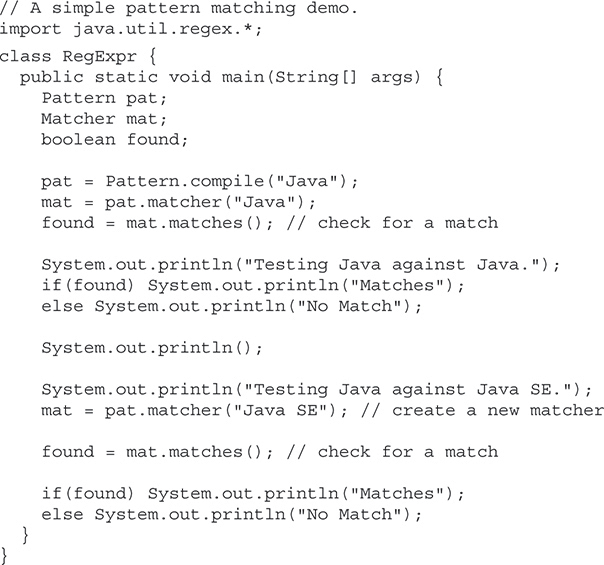
The output from the program is shown here:

Let’s look closely at this program. The program begins by creating the pattern that contains the sequence "Java". Next, a Matcher is created for that pattern that has the input sequence "Java". Then, the matches( ) method is called to determine if the input sequence matches the pattern. Because the sequence and the pattern are the same, matches( ) returns true. Next, a new Matcher is created with the input sequence "Java SE" and matches( ) is called again. In this case, the pattern and the input sequence differ, and no match is found. Remember, the matches( ) function returns true only when the input sequence precisely matches the pattern. It will not return true just because a subsequence matches.
You can use find( ) to determine if the input sequence contains a subsequence that matches the pattern. Consider the following program:
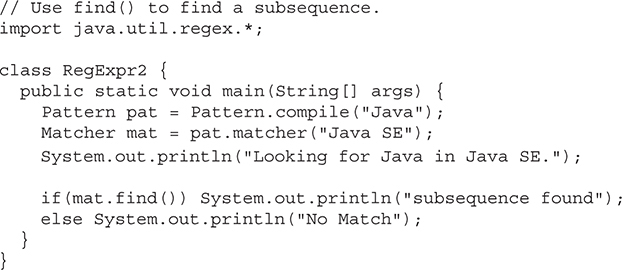
The output is shown here:
Looking for Java in Java SE.
subsequence found
In this case, find( ) finds the subsequence "Java".
The find( ) method can be used to search the input sequence for repeated occurrences of the pattern because each call to find( ) picks up where the previous one left off. For example, the following program finds two occurrences of the pattern "test":
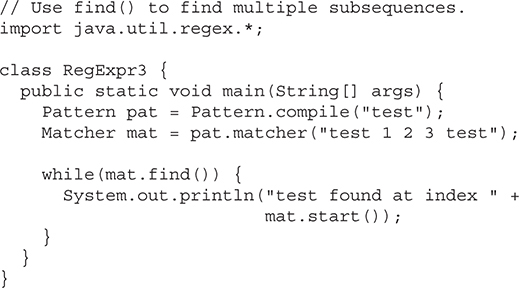
The output is shown here:
test found at index 0
test found at index 11
As the output shows, two matches were found. The program uses the start( ) method to obtain the index of each match.
Although the preceding programs show the general technique for using Pattern and Matcher, they don’t show their power. The real benefit of regular expression processing is not seen until wildcards and quantifiers are used. To begin, consider the following example that uses the + quantifier to match any arbitrarily long sequence of Ws:
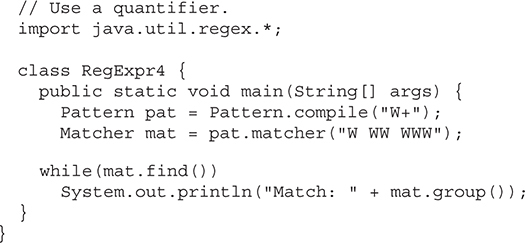
The output from the program is shown here:
Match: W
Match: WW
Match: WWW
As the output shows, the regular expression pattern "W+" matches any arbitrarily long sequence of Ws.
The next program uses a wildcard to create a pattern that will match any sequence that begins with e and ends with d. To do this, it uses the dot wildcard character along with the + quantifier.
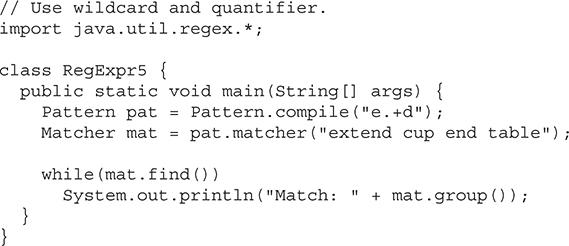
You might be surprised by the output produced by the program, which is shown here:
Match: extend cup end
Only one match is found, and it is the longest sequence that begins with e and ends with d. You might have expected two matches: "extend" and "end". The reason that the longer sequence is found is that the pattern "e.+d" matches the longest sequence that fits the pattern. This is called greedy behavior. You can specify reluctant behavior by adding the ? to the pattern, as shown in this version of the program. It causes the shortest matching pattern to be obtained.
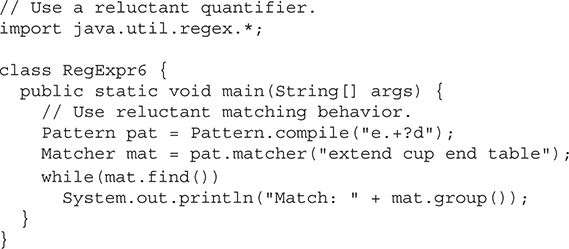
The output from the program is shown here:
Match: extend
Match: end
As the output shows, the pattern "e.+?d" will match the shortest sequence that begins with e and ends with d. Thus, two matches are found.
In general, to convert a greedy quantifier into a reluctant quantifier, add a ?. You can also specify possessive behavior by appending a +. For example, you might want to try the pattern "e.?+d" and observe the result. You can also specify a number of times to match by using {min, limit}, which matches min times, up to limit times. Also supported are {min} and {min,} which match min times, and min times but possibly more, respectively.
Sometimes you will want to match any sequence that contains one or more characters, in any order, that are part of a set of characters. For example, to match whole words, you want to match any sequence of the letters of the alphabet. One of the easiest ways to do this is to use a character class, which defines a set of characters. Recall that a character class is created by putting the characters you want to match between brackets. For example, to match the lowercase characters a through z, use [a-z]. The following program demonstrates this technique:
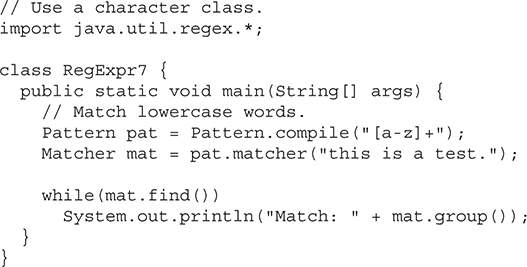
The output is shown here:
Match: this
Match: is
Match: a
Match: test
The replaceAll( ) method supplied by Matcher lets you perform powerful search and replace operations that use regular expressions. For example, the following program replaces all occurrences of sequences that begin with "Jon" with "Eric":
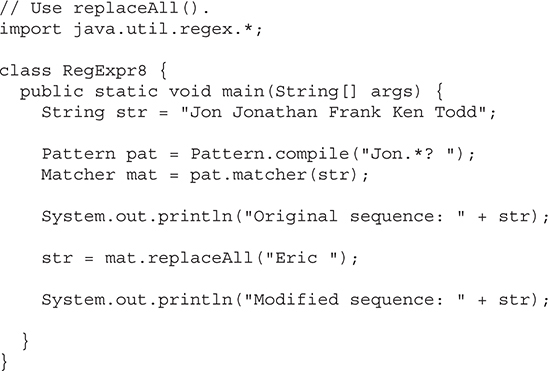
The output is shown here:
Original sequence: Jon Jonathan Frank Ken Todd
Modified sequence: Eric Eric Frank Ken Todd
Because the regular expression "Jon.*? " matches any string that begins with Jon followed by zero or more characters, ending in a space, it can be used to match and replace both Jon and Jonathan with the name Eric. Such a substitution is not easily accomplished without pattern matching capabilities.
You can reduce an input sequence into its individual tokens by using the split( ) method defined by Pattern. One form of the split( ) method is shown here:
String[ ] split(CharSequence str)
It processes the input sequence passed in str, reducing it into tokens based on the delimiters specified by the pattern.
For example, the following program finds tokens that are separated by spaces, commas, periods, and exclamation points:
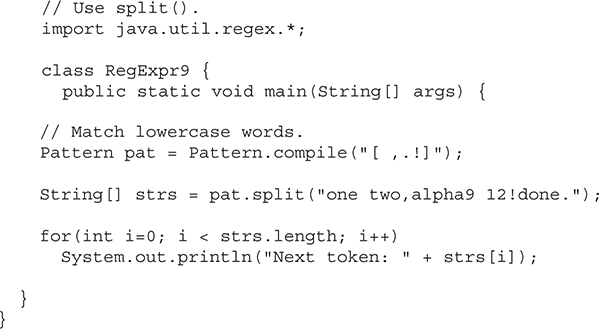
The output is shown here:
Next token: one
Next token: two
Next token: alpha9
Next token: 12
Next token: done
As the output shows, the input sequence is reduced to its individual tokens. Notice that the delimiters are not included.
Although the pattern-matching techniques described in the foregoing offer the greatest flexibility and power, there are two alternatives which you might find useful in some circumstances. If you only need to perform a one-time pattern match, you can use the matches( ) method defined by Pattern. It is shown here:
static boolean matches(String pattern, CharSequence str)
It returns true if pattern matches str and false otherwise. This method automatically compiles pattern and then looks for a match. If you will be using the same pattern repeatedly, then using matches( ) is less efficient than compiling the pattern and using the pattern-matching methods defined by Matcher, as described previously.
You can also perform a pattern match by using the matches( ) method implemented by String. It is shown here:
boolean matches(String pattern)
If the invoking string matches the regular expression in pattern, then matches( ) returns true. Otherwise, it returns false.
The overview of regular expressions presented in this section only hints at their power. Since text parsing, manipulation, and tokenization are a large part of programming, you will likely find Java’s regular expression subsystem a powerful tool that you can use to your advantage. It is, therefore, wise to explore the capabilities of regular expressions. Experiment with several different types of patterns and input sequences. Once you understand how regular expression pattern matching works, you will find it useful in many of your programming endeavors.
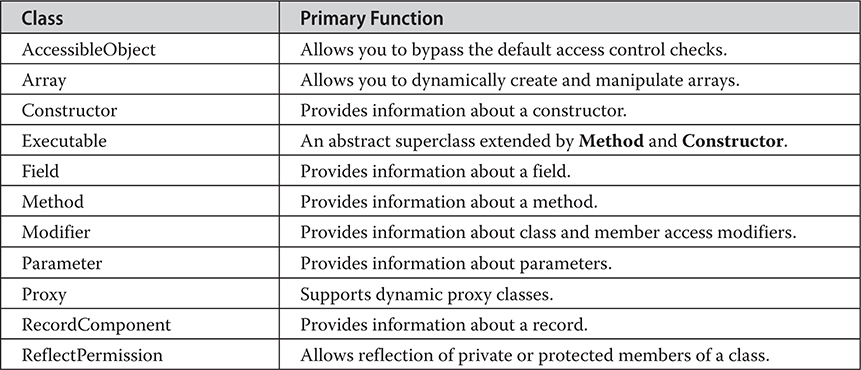
Table 31-1 Classes Defined in java.lang.reflect
Reflection is the ability of software to analyze itself. This is provided by the java.lang.reflect package and elements in Class. Beginning with JDK 9, java.lang.reflect is part of the java.base module. Reflection is an important capability, especially when using components called Java Beans. It allows you to analyze a software component and describe its capabilities dynamically, at run time rather than at compile time. For example, by using reflection, you can determine what methods, constructors, and fields a class supports. Reflection was introduced in Chapter 12. It is examined further here.
The package java.lang.reflect includes several interfaces. Of special interest is Member, which defines methods that allow you to get information about a field, constructor, or method of a class. There are also 11 classes in this package. These are listed in Table 31-1.
The following application illustrates a simple use of the Java reflection capabilities. It prints the constructors, fields, and methods of the class java.awt.Dimension. The program begins by using the forName( ) method of Class to get a class object for java.awt.Dimension. Once this is obtained, getConstructors( ), getFields( ), and getMethods( ) are used to analyze this class object. They return arrays of Constructor, Field, and Method objects that provide the information about the object. The Constructor, Field, and Method classes define several methods that can be used to obtain information about an object. You will want to explore these on your own. However, each supports the toString( ) method. Therefore, using Constructor, Field, and Method objects as arguments to the println( ) method is straightforward, as shown in the program.
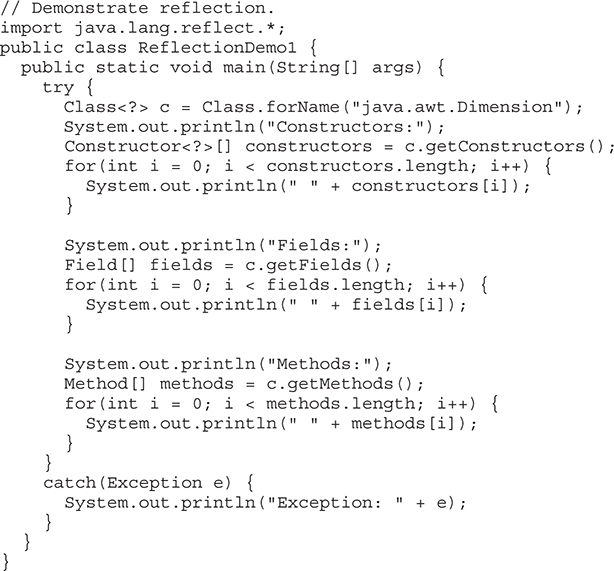
Here is the output from this program. (The output you see when you run the program may differ slightly from that shown.)
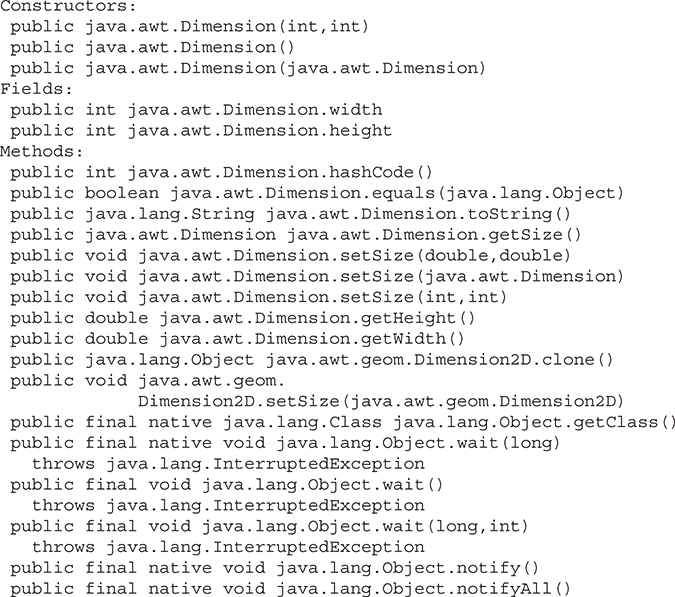
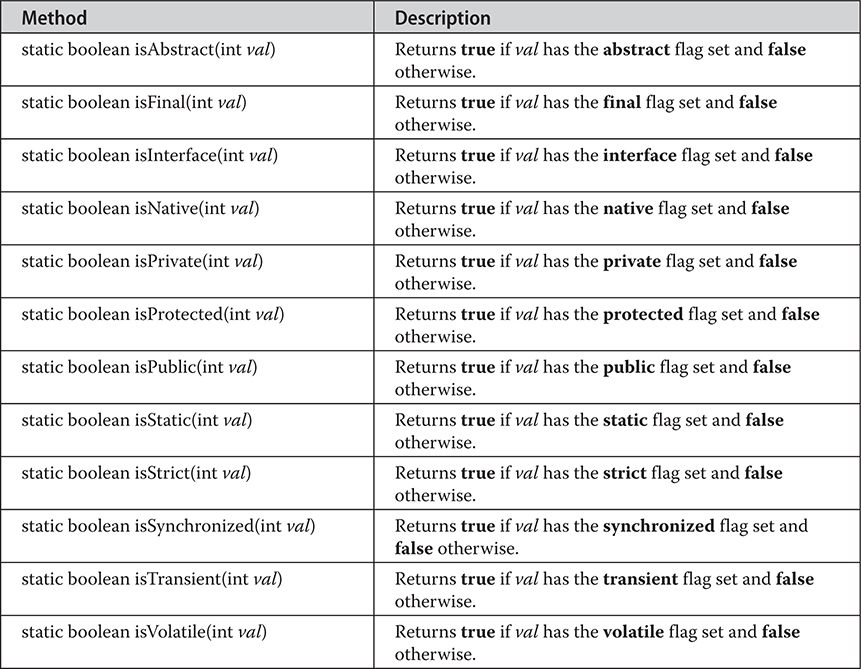
Table 31-2 The “is” Methods Defined by Modifier That Determine Modifiers
The next example uses Java’s reflection capabilities to obtain the public methods of a class. The program begins by instantiating class A. The getClass( ) method is applied to this object reference, and it returns the Class object for class A. The getDeclaredMethods( ) method returns an array of Method objects that describe only the methods declared by this class. Methods inherited from superclasses such as Object are not included.
Each element of the methods array is then processed. The getModifiers( ) method returns an int containing flags that describe which modifiers apply for this element. The Modifier class provides a set of isX methods, shown in Table 31-2, that can be used to examine this value. For example, the static method isPublic( ) returns true if its argument includes the public modifier. Otherwise, it returns false. In the following program, if the method supports public access, its name is obtained by the getName( ) method and is then printed.
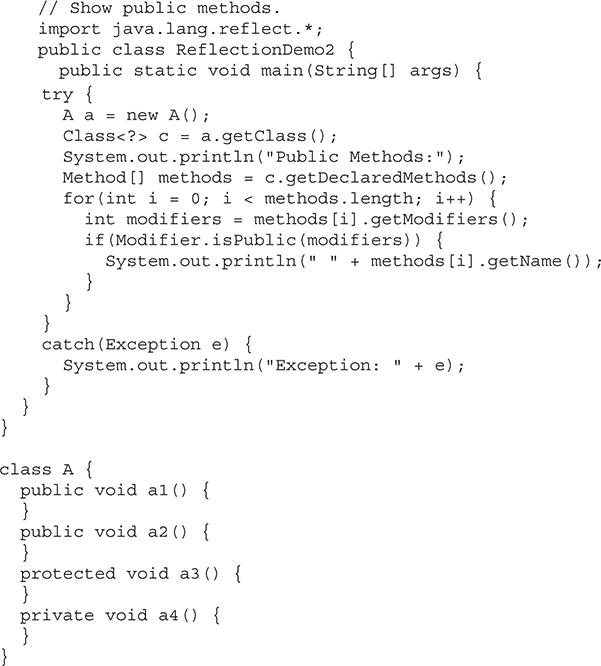
Here is the output from this program:

Modifier also includes a set of static methods that return the type of modifiers that can be applied to a specific type of program element. These methods are
static int classModifiers( )
static int constructorModifiers( )
static int fieldModifiers( )
static int interfaceModifiers( )
static int methodModifiers( )
static int parameterModifiers( )
For example, methodModifiers( ) returns the modifiers that can be applied to a method. Each method returns flags, packed into an int, that indicate which modifiers are legal. The modifier values are defined by constants in Modifier, which include PROTECTED, PUBLIC, PRIVATE, STATIC, FINAL, and so on.
Remote Method Invocation (RMI) allows a Java object that executes on one machine to invoke a method of a Java object that executes on another machine. This is an important feature, because it allows you to build distributed applications. While a complete discussion of RMI is outside the scope of this book, the following simplified example describes the basic principles involved. RMI is supported by the java.rmi package. Beginning with JDK 9, it is part of the java.rmi module.
This section provides step-by-step directions for building a simple client/server application by using RMI. The server receives a request from a client, processes it, and returns a result. In this example, the request specifies two numbers. The server adds these together and returns the sum.
This application uses four source files. The first file, AddServerIntf.java, defines the remote interface that is provided by the server. It contains one method that accepts two double arguments and returns their sum. All remote interfaces must extend the Remote interface, which is part of java.rmi. Remote defines no members. Its purpose is simply to indicate that an interface uses remote methods. All remote methods can throw a RemoteException.

The second source file, AddServerImpl.java, implements the remote interface. The implementation of the add( ) method is straightforward. Remote objects typically extend UnicastRemoteObject, which provides functionality that is needed to make objects available from remote machines.
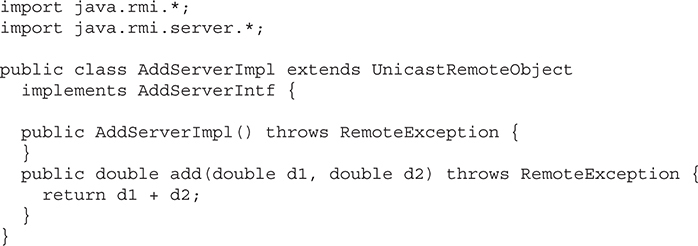
The third source file, AddServer.java, contains the main program for the server machine. Its primary function is to update the RMI registry on that machine. This is done by using the rebind( ) method of the Naming class (found in java.rmi). That method associates a name with an object reference. The first argument to the rebind( ) method is a string that names the server as "AddServer". Its second argument is a reference to an instance of AddServerImpl.
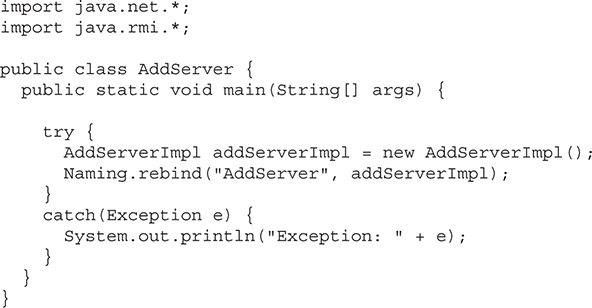
The fourth source file, AddClient.java, implements the client side of this distributed application. AddClient.java requires three command-line arguments. The first is the IP address or name of the server machine. The second and third arguments are the two numbers that are to be summed.
The application begins by forming a string that follows the URL syntax. This URL uses the rmi protocol. The string includes the IP address or name of the server and the string "AddServer". The program then invokes the lookup( ) method of the Naming class. This method accepts one argument, the rmi URL, and returns a reference to an object of type AddServerIntf. All remote method invocations can then be directed to this object.
The program continues by displaying its arguments and then invokes the remote add( ) method. The sum is returned from this method and is then printed.
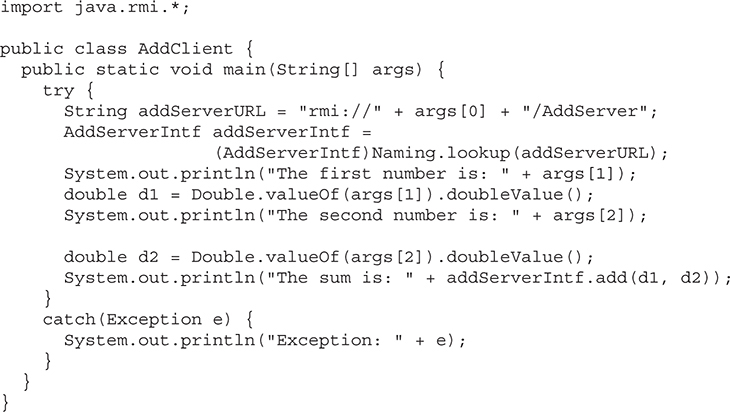
After you enter all the code, use javac to compile the four source files that you created.
In the context of RMI, a stub is a Java object that resides on the client machine. Its function is to present the same interfaces as the remote server. Remote method calls initiated by the client are actually directed to the stub. The stub works with the other parts of the RMI system to formulate a request that is sent to the remote machine.
A remote method may accept arguments that are simple types or objects. In the latter case, the object may have references to other objects. All of this information must be sent to the remote machine. That is, an object passed as an argument to a remote method call must be serialized and sent to the remote machine. Recall from Chapter 21 that the serialization facilities also recursively process all referenced objects.
If a response must be returned to the client, the process works in reverse. Note that the serialization and deserialization facilities are also used if objects are returned to a client.
Prior to Java 5, stubs needed to be built manually by using rmic. This step is not required for modern versions of Java. However, if you are working in a very old legacy environment, then you can use the rmic compiler, as shown here, to build a stub:
rmic AddServerImpl
This command generates the file AddServerImpl_Stub.class. When using rmic, be sure that CLASSPATH is set to include the current directory.
Copy AddClient.class, AddServerImpl_Stub.class (if needed), and AddServerIntf.class to a directory on the client machine. Copy AddServerIntf.class, AddServerImpl.class, AddServerImpl_Stub.class (if needed), and AddServer.class to a directory on the server machine.
The JDK provides a program called rmiregistry, which executes on the server machine. It maps names to object references. First, check that the CLASSPATH environment variable includes the directory in which your files are located. Then, start the RMI Registry from the command line, as shown here:
start rmiregistry
When this command returns, you should see that a new window has been created. You need to leave this window open until you are done experimenting with the RMI example.
The server code is started from the command line, as shown here:
java AddServer
Recall that the AddServer code instantiates AddServerImpl and registers that object with the name "AddServer".
The AddClient software requires three arguments: the name or IP address of the server machine and the two numbers that are to be summed together. You may invoke it from the command line by using one of the two formats shown here:
java AddClient server1 8 9
java AddClient 11.12.13.14 8 9
In the first line, the name of the server is provided. The second line uses its IP address (11.12.13.14).
You can try this example without actually having a remote server. To do so, simply install all of the programs on the same machine, start rmiregistry, start AddServer, and then execute AddClient using this command line:
java AddClient 127.0.0.1 8 9
Here, the address 127.0.0.1 is the “loop back” address for the local machine. Using this address allows you to exercise the entire RMI mechanism without actually having to install the server on a remote computer. (If you are using a firewall, then this approach may not work.)
In either case, sample output from this program is shown here:
The first number is: 8
The second number is: 9
The sum is: 17.0
The package java.text allows you to format, parse, search, and manipulate text. Beginning with JDK 9, java.text is part of the java.base module. This section examines two of java.text's most commonly used classes: those that format date and time information. However, it is important to state at the outset that the new date and time API described later in this chapter offers a modern approach to handling date and time that also supports formatting. Of course, legacy code will continue to use the classes shown here for some time.
DateFormat is an abstract class that provides the ability to format and parse dates and times. The getDateInstance( ) method returns an instance of DateFormat that can format date information. It is available in these forms:
static final DateFormat getDateInstance( )
static final DateFormat getDateInstance(int style)
static final DateFormat getDateInstance(int style, Locale locale)
Here, style is one of the following values: DEFAULT, SHORT, MEDIUM, LONG, or FULL. These are int constants defined by DateFormat. They cause different details about the date to be presented. The parameter locale specifies the locale (refer to Chapter 20 for details on Locale). If the style and/or locale is not specified, defaults are used.
One of the most commonly used methods in this class is format( ). It has several overloaded forms, one of which is shown here:
final String format(Date d)
The argument is a Date object that is to be displayed. The method returns a string containing the formatted information.
The following listing illustrates how to format date information. It begins by creating a Date object. This captures the current date and time information. Then it outputs the date information by using different styles and locales.
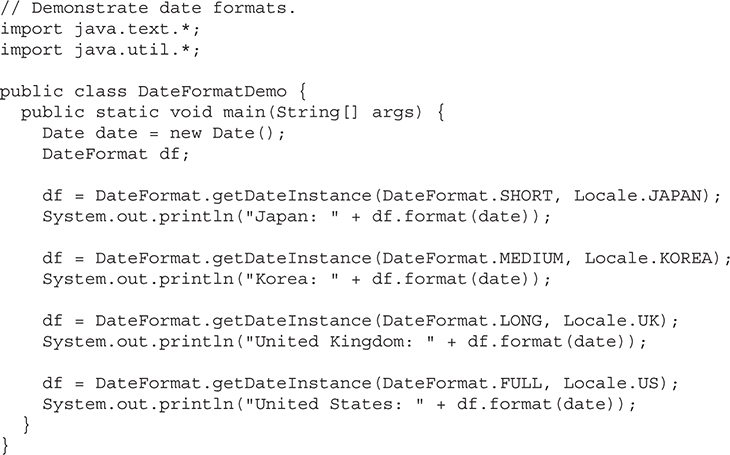
Sample output from this program is shown here:
Japan: 2021/06/30
Korea: 2021. 6. 30.
United Kingdom: 30 June 2021
United States: Wednesday, June 30, 2021
The getTimeInstance( ) method returns an instance of DateFormat that can format time information. It is available in these versions:
static final DateFormat getTimeInstance( )
static final DateFormat getTimeInstance(int style)
static final DateFormat getTimeInstance(int style, Locale locale)
Here, style is one of the following values: DEFAULT, SHORT, MEDIUM, LONG, or FULL. These are int constants defined by DateFormat. They cause different details about the time to be presented. The parameter locale specifies the locale. If the style and/or locale is not specified, defaults are used.
The following listing illustrates how to format time information. It begins by creating a Date object. This captures the current date and time information. Then it outputs the time information by using different styles and locales.

Sample output from this program is shown here:
Japan: 13:03
United Kingdom: 13:03:31 GMT-05:00
Canada: 1:03:31 PM Central Daylight Time
The DateFormat class also has a getDateTimeInstance( ) method that can format both date and time information. You may wish to experiment with it on your own.
SimpleDateFormat is a concrete subclass of DateFormat. It allows you to define your own formatting patterns that are used to display date and time information.
One of its constructors is shown here:
SimpleDateFormat(String formatString)
The argument formatString describes how date and time information is displayed. An example of its use is given here:
SimpleDateFormat sdf = SimpleDateFormat("dd MMM yyyy hh:mm:ss zzz");
The symbols used in the formatting string determine the information that is displayed. Table 31-3 lists these symbols and gives a description of each.
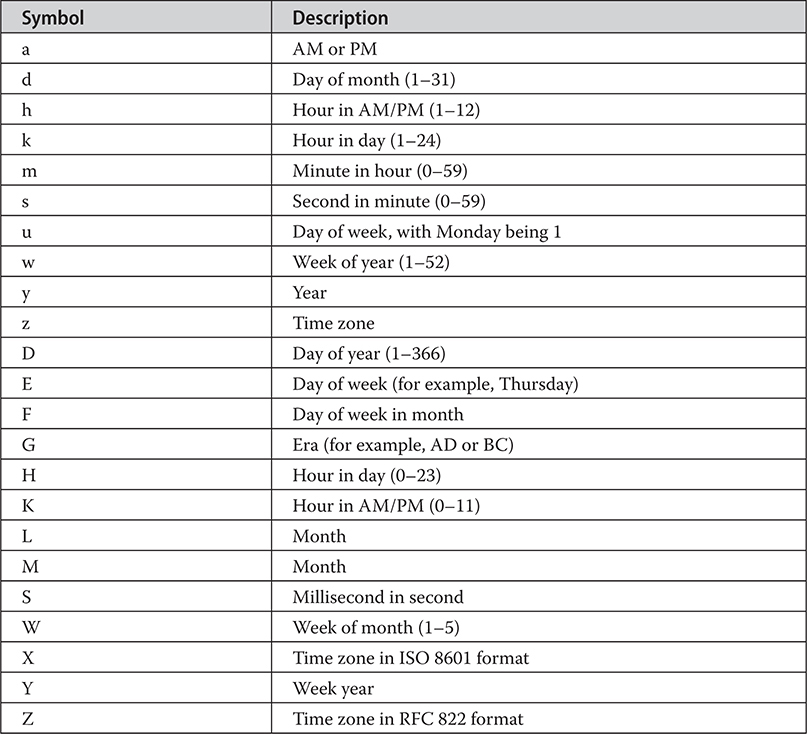
Table 31-3 Formatting String Symbols for SimpleDateFormat
In most cases, the number of times a symbol is repeated determines how that data is presented. Text information is displayed in an abbreviated form if the pattern letter is repeated less than four times. Otherwise, the unabbreviated form is used. For example, a zzzz pattern can display Pacific Daylight Time, and a zzz pattern can display PDT.
For numbers, the number of times a pattern letter is repeated determines how many digits are presented. For example, hh:mm:ss can present 01:51:15, but h:m:s displays the same time value as 1:51:15.
Finally, M or MM causes the month to be displayed as one or two digits. However, three or more repetitions of M cause the month to be displayed as a text string.
The following program shows how this class is used:
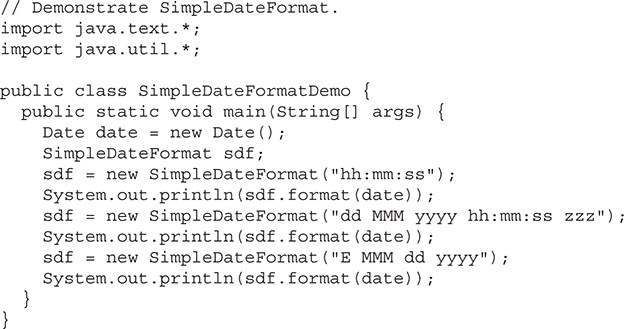
Sample output from this program is shown here:
01:30:51
30 Jun 2021 01:30:51 CDT
Wed Jun 30 2021
In Chapter 20, Java’s long-standing approach to handling date and time through the use of classes such as Calendar and GregorianCalendar was discussed. It is expected that this traditional approach will remain in widespread use for some time and is, therefore, something that all Java programmers need to be familiar with. Since JDK 8, Java has included another approach to handling time and date. This approach is defined in the following packages:

These packages define a large number of classes, interfaces, and enumerations that provide extensive, finely grained support for time and date operations. Because of the number of elements that comprise the new time and date API, it can seem fairly intimidating at first. However, it is well organized and logically structured. Its size reflects the detail of control and flexibility that it provides. Although it is far beyond the scope of this book to examine each element in this extensive API, we will look at several of its main classes. As you will see, these classes are sufficient for many uses. Beginning with JDK 9, these packages are in the java.base module.
In java.time are defined several top-level classes that give you easy access to the time and date. Three of these are LocalDate, LocalTime, and LocalDateTime. As their names suggest, they encapsulate the local date, time, and date and time. Using these classes, it is easy to obtain the current date and time, format the date and time, and compare dates and times, among other operations. These classes are value-based, as are many others in java.time. (See Chapter 13 for information on value-based classes.)
LocalDate encapsulates a date that uses the default Gregorian calendar as specified by ISO 8601. LocalTime encapsulates a time, as specified by ISO 8601. LocalDateTime encapsulates both date and time. These classes contain a large number of methods that give you access to the date and time components, allow you to compare dates and times, add or subtract date or time components, and so on. Because a common naming convention for methods is employed, once you know how to use one of these classes, the others are easy to master.
LocalDate, LocalTime, and LocalDateTime do not define public constructors. Rather, to obtain an instance, you will use a factory method. One very convenient method is now( ), which is defined for all three classes. It returns the current date and/or time of the system. Each class defines several versions, but we will use its simplest form. Here is the version we will use as defined by LocalDate:
static LocalDate now( )
The version for LocalTime is shown here:
static LocalTime now( )
The version for LocalDateTime is shown here:
static LocalDateTime now( )
As you can see, in each case, an appropriate object is returned. The object returned by now( ) can be displayed in its default, human-readable form by use of a println( ) statement, for example. However, it is also possible to take full control over the formatting of date and time.
The following program uses LocalDate and LocalTime to obtain the current date and time and then displays them. Notice how now( ) is called to retrieve the current date and time.
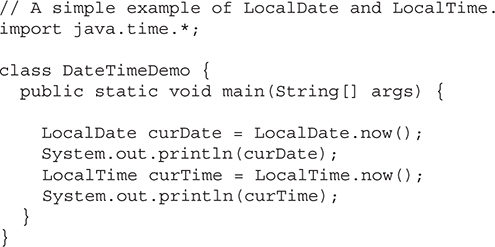
Sample output is shown here:
2021-06-30
14:57:29.621839100
The output reflects the default format that is given to the date and time. (The next section shows how to specify a different format.)
Because the preceding program displays both the current date and the current time, it could have been more easily written using the LocalDateTime class. In this approach, only a single instance needs to be created and only a single call to now( ) is required, as shown here:
LocalDateTime curDateTime = LocalDateTime.now();
System.out.println(curDateTime);
Using this approach, the default output includes both date and time. Here is a sample:
2021-06-30T14:58:56.498907300
One other point: from a LocalDateTime instance, it is possible to obtain a reference to the date or time component by using the toLocalDate( ) and toLocalTime( ) methods, shown here:
LocalDate toLocalDate( )
LocalTime toLocalTime( )
Each returns a reference to the indicated element.
Although the default formats shown in the preceding examples will be adequate for some uses, often you will want to specify a different format. Fortunately, this is easy to do because LocalDate, LocalTime, and LocalDateTime all provide the format( ) method, shown here:
String format(DateTimeFormatter fmtr)
Here, fmtr specifies the instance of DateTimeFormatter that will provide the format.
DateTimeFormatter is packaged in java.time.format. To obtain a DateTimeFormatter instance, you will typically use one of its factory methods. Three are shown here:
static DateTimeFormatter ofLocalizedDate(FormatStyle fmtDate)
static DateTimeFormatter ofLocalizedTime(FormatStyle fmtTime)
static DateTimeFormatter ofLocalizedDateTime(FormatStyle fmtDate,
FormatStyle fmtTime)
Of course, the type of DateTimeFormatter that you create will be based on the type of object it will be operating on. For example, if you want to format the date in a LocalDate instance, then use ofLocalizedDate( ). The specific format is specified by the FormatStyle parameter.
FormatStyle is an enumeration that is packaged in java.time.format. It defines the following constants:
FULL
LONG
MEDIUM
SHORT
These specify the level of detail that will be displayed. (Thus, this form of DateTimeFormatter works similarly to java.text.DateFormat, described earlier in this chapter.)
Here is an example that uses DateTimeFormatter to display the current date and time:
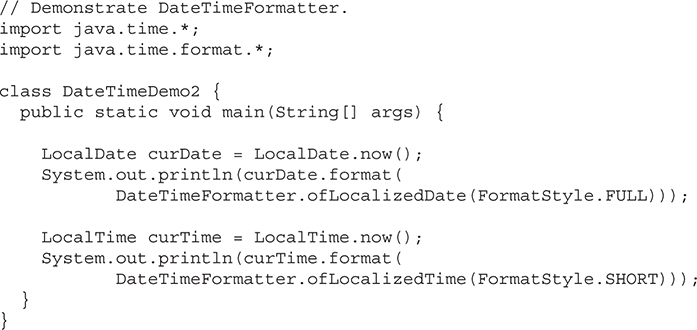
Sample output is shown here:
Wednesday, June 30, 2021
2:16 PM
In some situations, you may want a format different from the ones you can specify by use of FormatStyle. One way to accomplish this is to use a predefined formatter, such as ISO_DATE or ISO_TIME, provided by DateTimeFormatter. Another way is to create a custom format by specifying a pattern. To do this, you can use the ofPattern( ) factory method of DateTimeFormatter. One version is shown here:
static DateTimeFormatter ofPattern(String fmtPattern)
Here, fmtPattern specifies a string that contains the date and time pattern that you want. It returns a DateTimeFormatter that will format according to that pattern. The default locale is used.
In general, a pattern consists of format specifiers, called pattern letters. A pattern letter will be replaced by the date or time component that it specifies. The full list of pattern letters is shown in the API documentation for ofPattern( ). Here is a sampling. Note that the pattern letters are case-sensitive.
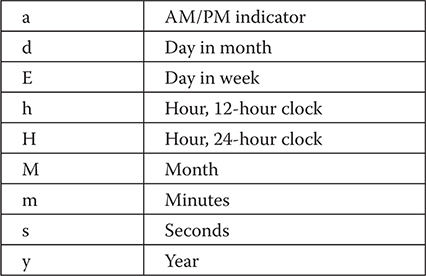
In general, the precise output that you see will be determined by how many times a pattern letter is repeated. (Thus, DateTimeFormatter works a bit like java.text.SimpleDateFormat, described earlier in this chapter.) For example, assuming that the month is April, the patterns:
M MM MMM MMMM
produce the following formatted output:
4 04 Apr April
Frankly, experimentation is the best way to understand what each pattern letter does and how various repetitions affect the output.
When you want to output a pattern letter as text, enclose the text between single quotation marks. In general, it is a good idea to enclose all non-pattern characters within single quotation marks to avoid problems if the set of pattern letters changes in subsequent versions of Java.
The following program demonstrates the use of a date and time pattern:

Sample output is shown here:
June 30, 2021 2:22 PM
One other point about creating custom date and time output: LocalDate, LocalTime, and LocalDateTime define methods that let you obtain various date and time components. For example, getHour( ) returns the hour as an int; getMonth( ) returns the month in the form of a Month enumeration value; and getYear( ) returns the year as an int. Using these, and other methods, you can manually construct output. You can also use these values for other purposes, such as when creating specialized timers.
LocalDate, LocalTime, and LocalDateTime provide the ability to parse date and/or time strings. To do this, call parse( ) on an instance of one of those classes. It has two forms. The first uses the default formatter that parses the date and/or time formatted in the standard ISO fashion, such as 03:31 for time and 2021-08-02 for date. The form of this version of parse( ) for LocalDateTime is shown here. (Its form for the other classes is similar except for the type of object returned.)
static LocalDateTime parse(CharSequence dateTimeStr)
Here, dateTimeStr is a string that contains the date and time in the proper format. If the format is invalid, an exception will be thrown.
If you want to parse a date and/or time string that is in a format other than ISO format, you can use a second form of parse( ) that lets you specify your own formatter. The version specified by LocalDateTime is shown next. (The other classes provide a similar form except for the return type.)
static LocalDateTime parse(CharSequence dateTimeStr,
DateTimeFormatter dateTimeFmtr)
Here, dateTimeFmtr specifies the formatter that you want to use.
Here is a simple example that parses a date and time string by use of a custom formatter:
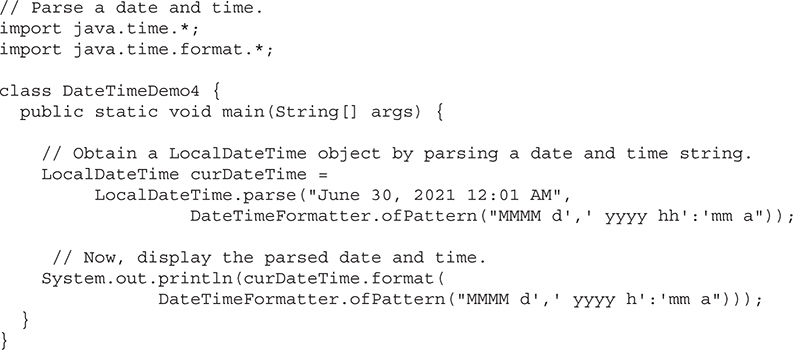
Sample output is shown here:
June 30, 2021 12:01 AM
Although you will want to explore all of the date and time packages, a good place to start is with java.time. It contains a great deal of functionality that you may find useful. Begin by examining the methods defined by LocalDate, LocalTime, and LocalDateTime. Each has methods that let you add or subtract dates and/or times, adjust dates and/or times by a given component, compare dates and/or times, and create instances based on date and/or time components, among others. Other classes in java.time that you may find of particular interest include Instant, Duration, and Period. Instant encapsulates an instant in time. Duration encapsulates a length of time. Period encapsulates a length of date. You will also want to explore the new InstantSource interface added by JDK 17, which is implemented by the Clock class.
In Part II, you saw how to build very simple user interfaces with the AWT classes. Although the AWT is still a crucial part of Java, its component set is no longer widely used to create graphical user interfaces. Today, programmers typically use Swing for this purpose. Swing is a framework that provides more powerful and flexible GUI components than does the AWT. As a result, it is the GUI that has been widely used by Java programmers for more than two decades.
Coverage of Swing is divided between three chapters. This chapter introduces Swing. It begins by describing Swing’s core concepts. It then presents a simple example that shows the general form of a Swing program. This is followed by an example that uses event handling. The chapter concludes by explaining how painting is accomplished in Swing. The next chapter presents several commonly used Swing components. The third chapter introduces Swing-based menus. It is important to understand that the number of classes and interfaces in the Swing packages is quite large, and they can’t all be covered in this book. (In fact, full coverage of Swing requires an entire book of its own.) However, these three chapters will give you a basic understanding of this important topic.
Note For a comprehensive introduction to Swing, see my book Swing: A Beginner's Guide published by McGraw Hill (2007).
Swing did not exist in the early days of Java. Rather, it was a response to deficiencies present in Java’s original GUI subsystem: the Abstract Window Toolkit. The AWT defines a basic set of controls, windows, and dialog boxes that support a usable, but limited graphical interface. One reason for the limited nature of the AWT is that it translates its various visual components into their corresponding, platform-specific equivalents, or peers. This means that the look and feel of a component is defined by the platform, not by Java. Because the AWT components use native code resources, they are referred to as heavyweight.
The use of native peers led to several problems. First, because of variations between operating systems, a component might look, or even act, differently on different platforms. This potential variability threatened the overarching philosophy of Java: write once, run anywhere. Second, the look and feel of each component was fixed (because it is defined by the platform) and could not be (easily) changed. Third, the use of heavyweight components caused some frustrating restrictions. For example, a heavyweight component was always opaque.
Not long after Java’s original release, it became apparent that the limitations and restrictions present in the AWT were sufficiently serious that a better approach was needed. The solution was Swing. Introduced in 1997, Swing was included as part of the Java Foundation Classes (JFC). Swing was initially available for use with Java 1.1 as a separate library. However, beginning with Java 1.2, Swing (and the rest of the JFC) was fully integrated into Java.
Before moving on, it is necessary to make one important point: although Swing eliminates a number of the limitations inherent in the AWT, Swing does not replace it. Instead, Swing is built on the foundation of the AWT. This is why the AWT is still a crucial part of Java. Swing also uses the same event handling mechanism as the AWT. Therefore, a basic understanding of the AWT and of event handling is required to use Swing. (The AWT is covered in Chapters 26 and 27. Event handling is described in Chapter 25.)
As just explained, Swing was created to address the limitations present in the AWT. It does this through two key features: lightweight components and a pluggable look and feel. Together they provide an elegant, yet easy-to-use solution to the problems of the AWT. More than anything else, it is these two features that define the essence of Swing. Each is examined here.
With very few exceptions, Swing components are lightweight. This means that they are written entirely in Java and do not map directly to platform-specific peers. Thus, lightweight components are more efficient and more flexible. Furthermore, because lightweight components do not translate into native peers, the look and feel of each component is determined by Swing, not by the underlying operating system. As a result, each component will work in a consistent manner across all platforms.
Swing supports a pluggable look and feel (PLAF). Because each Swing component is rendered by Java code rather than by native peers, the look and feel of a component is under the control of Swing. This fact means that it is possible to separate the look and feel of a component from the logic of the component, and this is what Swing does. Separating out the look and feel provides a significant advantage: it becomes possible to change the way that a component is rendered without affecting any of its other aspects. In other words, it is possible to “plug in” a new look and feel for any given component without creating any side effects in the code that uses that component. Moreover, it becomes possible to define entire sets of look-and-feels that represent different GUI styles. To use a specific style, its look and feel is simply “plugged in.” Once this is done, all components are automatically rendered using that style.
Pluggable look-and-feels offer several important advantages. It is possible to define a look and feel that is consistent across all platforms. Conversely, it is possible to create a look and feel that acts like a specific platform. It is also possible to design a custom look and feel. Finally, the look and feel can be changed dynamically at run time.
Java provides look-and-feels, such as metal and Nimbus, that are available to all Swing users. The metal look and feel is also called the Java look and feel. It is platform-independent and available in all Java execution environments. It is also the default look and feel. This book uses the default Java look and feel (metal) because it is platform independent.
In general, a visual component is a composite of three distinct aspects:
• The way that the component looks when rendered on the screen
• The way that the component reacts to the user
• The state information associated with the component
No matter what architecture is used to implement a component, it must implicitly contain these three parts. Over the years, one component architecture has proven itself to be exceptionally effective: Model-View-Controller, or MVC for short.
The MVC architecture is successful because each piece of the design corresponds to an aspect of a component. In MVC terminology, the model corresponds to the state information associated with the component. For example, in the case of a check box, the model contains a field that indicates if the box is checked or unchecked. The view determines how the component is displayed on the screen, including any aspects of the view that are affected by the current state of the model. The controller determines how the component reacts to the user. For example, when the user clicks a check box, the controller reacts by changing the model to reflect the user’s choice (checked or unchecked). This then results in the view being updated. By separating a component into a model, a view, and a controller, the specific implementation of each can be changed without affecting the other two. For instance, different view implementations can render the same component in different ways without affecting the model or the controller.
Although the MVC architecture and the principles behind it are conceptually sound, the high level of separation between the view and the controller is not beneficial for Swing components. Instead, Swing uses a modified version of MVC that combines the view and the controller into a single logical entity called the UI delegate. For this reason, Swing’s approach is called either the Model-Delegate architecture or the Separable Model architecture. Therefore, although Swing’s component architecture is based on MVC, it does not use a classical implementation of it.
Swing’s pluggable look and feel is made possible by its Model-Delegate architecture. Because the view (look) and controller (feel) are separate from the model, the look and feel can be changed without affecting how the component is used within a program. Conversely, it is possible to customize the model without affecting the way that the component appears on the screen or responds to user input.
To support the Model-Delegate architecture, most Swing components contain two objects. The first represents the model. The second represents the UI delegate. Models are defined by interfaces. For example, the model for a button is defined by the ButtonModel interface. UI delegates are classes that inherit ComponentUI. For example, the UI delegate for a button is ButtonUI. Normally, your programs will not interact directly with the UI delegate.
A Swing GUI consists of two key items: components and containers. However, this distinction is mostly conceptual because all containers are also components. The difference between the two is found in their intended purpose: As the term is commonly used, a component is an independent visual control, such as a push button or slider. A container holds a group of components. Thus, a container is a special type of component that is designed to hold other components. Furthermore, in order for a component to be displayed, it must be held within a container. Thus, all Swing GUIs will have at least one container. Because containers are components, a container can also hold other containers. This enables Swing to define what is called a containment hierarchy, at the top of which must be a top-level container.
Let’s look a bit more closely at components and containers.
In general, Swing components are derived from the JComponent class. (The only exceptions to this are the four top-level containers, described in the next section.) JComponent provides the functionality that is common to all components. For example, JComponent supports the pluggable look and feel. JComponent inherits the AWT classes Container and Component. Thus, a Swing component is built on and compatible with an AWT component.
All of Swing’s components are represented by classes defined within the package javax.swing. The following table shows the class names for Swing components (including those used as containers).


Notice that all component classes begin with the letter J. For example, the class for a label is JLabel; the class for a push button is JButton; and the class for a scroll bar is JScrollBar.
Swing defines two types of containers. The first are top-level containers: JFrame, JApplet, JWindow, and JDialog. These containers do not inherit JComponent. They do, however, inherit the AWT classes Component and Container. Unlike Swing’s other components, which are lightweight, the top-level containers are heavyweight. This makes the top-level containers a special case in the Swing component library.
As the name implies, a top-level container must be at the top of a containment hierarchy. A top-level container is not contained within any other container. Furthermore, every containment hierarchy must begin with a top-level container. The one most commonly used for applications is JFrame. In the past, the one used for applets was JApplet. As explained in Chapter 1, beginning with JDK 9 applets have been deprecated, and are now deprecated for removal. As a result, JApplet is also deprecated for removal. Furthermore, beginning with JDK 11, applet support has been removed.
The second type of containers supported by Swing are lightweight containers. Lightweight containers do inherit JComponent. An example of a lightweight container is JPanel, which is a general-purpose container. Lightweight containers are often used to organize and manage groups of related components because a lightweight container can be contained within another container. Thus, you can use lightweight containers such as JPanel to create subgroups of related controls that are contained within an outer container.
Each top-level container defines a set of panes. At the top of the hierarchy is an instance of JRootPane. JRootPane is a lightweight container whose purpose is to manage the other panes. It also helps manage the optional menu bar. The panes that comprise the root pane are called the glass pane, the content pane, and the layered pane.
The glass pane is the top-level pane. It sits above and completely covers all other panes. By default, it is a transparent instance of JPanel. The glass pane enables you to manage mouse events that affect the entire container (rather than an individual control) or to paint over any other component, for example. In most cases, you won’t need to use the glass pane directly, but it is there if you need it.
The layered pane is an instance of JLayeredPane. The layered pane allows components to be given a depth value. This value determines which component overlays another. (Thus, the layered pane lets you specify a Z-order for a component, although this is not something that you will usually need to do.) The layered pane holds the content pane and the (optional) menu bar.
Although the glass pane and the layered panes are integral to the operation of a top-level container and serve important purposes, much of what they provide occurs behind the scene. The pane with which your application will interact the most is the content pane, because this is the pane to which you will add visual components. In other words, when you add a component, such as a button, to a top-level container, you will add it to the content pane. By default, the content pane is an opaque instance of JPanel.
Swing is a very large subsystem and makes use of many packages. At the time of this writing, these are the packages defined by Swing.

Beginning the JDK 9, the Swing packages are part of the java.desktop module.
The main package is javax.swing. This package must be imported into any program that uses Swing. It contains the classes that implement the basic Swing components, such as push buttons, labels, and check boxes.
Swing programs differ from both the console-based programs and the AWT-based programs shown earlier in this book. For example, they use a different set of components and a different container hierarchy than does the AWT. Swing programs also have special requirements that relate to threading. The best way to understand the structure of a Swing program is to work through an example. Before we begin, it is necessary to point out that in the past there were two types of Java programs in which Swing was typically used. The first is a desktop application. This type of Swing application is widely used, and is the type of Swing program described here. The second is the applet. Because applets are now deprecated and not suitable for use in new code, they are not discussed in this book.
Although quite short, the following program shows one way to write a Swing application. In the process, it demonstrates several key features of Swing. It uses two Swing components: JFrame and JLabel. JFrame is the top-level container that is commonly used for Swing applications. JLabel is the Swing component that creates a label, which is a component that displays information. The label is Swing’s simplest component because it is passive. That is, a label does not respond to user input. It just displays output. The program uses a JFrame container to hold an instance of a JLabel. The label displays a short text message.
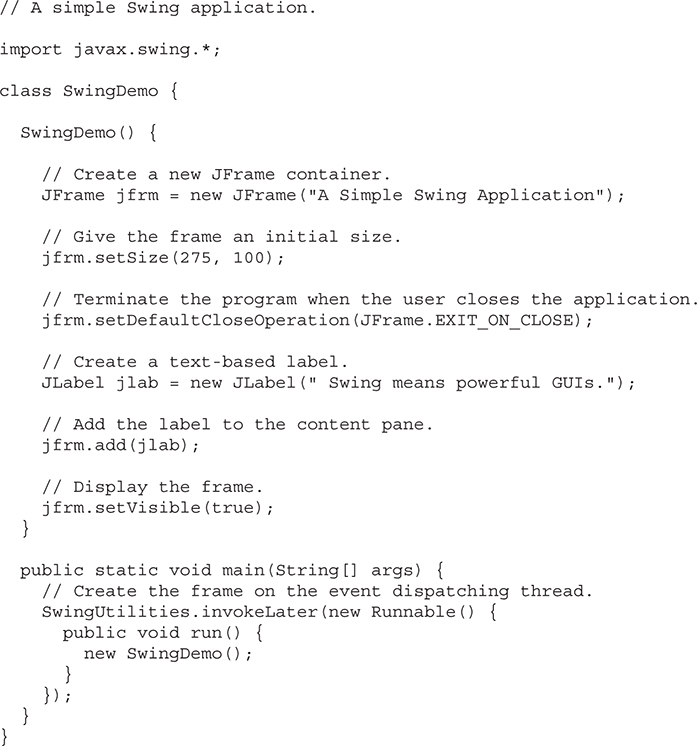
Swing programs are compiled and run in the same way as other Java applications. Thus, to compile this program, you can use this command line:
javac SwingDemo.java
To run the program, use this command line:
java SwingDemo
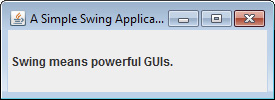
Figure 32-1 The window produced by the SwingDemo program
When the program is run, it will produce a window similar to that shown in Figure 32-1.
Because the SwingDemo program illustrates several core Swing concepts, we will examine it carefully, line by line. The program begins by importing javax.swing. As mentioned, this package contains the components and models defined by Swing. For example, javax.swing defines classes that implement labels, buttons, text controls, and menus. It will be included in all programs that use Swing.
Next, the program declares the SwingDemo class and a constructor for that class. The constructor is where most of the action of the program occurs. It begins by creating a JFrame, using this line of code:
JFrame jfrm = new JFrame("A Simple Swing Application");
This creates a container called jfrm that defines a rectangular window complete with a title bar; close, minimize, maximize, and restore buttons; and a system menu. Thus, it creates a standard, top-level window. The title of the window is passed to the constructor.
Next, the window is sized using this statement:
jfrm.setSize(275, 100);
The setSize( ) method (which is inherited by JFrame from the AWT class Component) sets the dimensions of the window, which are specified in pixels. Its general form is shown here:
void setSize(int width, int height)
In this example, the width of the window is set to 275 and the height is set to 100.
By default, when a top-level window is closed (such as when the user clicks the close box), the window is removed from the screen, but the application is not terminated. While this default behavior is useful in some situations, it is not what is needed for most applications. Instead, you will usually want the entire application to terminate when its top-level window is closed. There are a couple of ways to achieve this. The easiest way is to call setDefaultCloseOperation( ), as the program does:
jfrm.setDefaultCloseOperation(JFrame.EXIT_ON_CLOSE);
After this call executes, closing the window causes the entire application to terminate. The general form of setDefaultCloseOperation( ) is shown here:
void setDefaultCloseOperation(int what)
The value passed in what determines what happens when the window is closed. There are several other options in addition to JFrame.EXIT_ON_CLOSE. They are shown here:
DISPOSE_ON_CLOSE
HIDE_ON_CLOSE
DO_NOTHING_ON_CLOSE
Their names reflect their actions. These constants are declared in WindowConstants, which is an interface declared in javax.swing that is implemented by JFrame.
The next line of code creates a Swing JLabel component:
JLabel jlab = new JLabel(" Swing means powerful GUIs.");
JLabel is the simplest and easiest-to-use component because it does not accept user input. It simply displays information, which can consist of text, an icon, or a combination of the two. The label created by the program contains only text, which is passed to its constructor.
The next line of code adds the label to the content pane of the frame:
jfrm.add(jlab);
As explained earlier, all top-level containers have a content pane in which components are stored. Thus, to add a component to a frame, you must add it to the frame’s content pane. This is accomplished by calling add( ) on the JFrame reference (jfrm in this case). The general form of add( ) is shown here:
Component add(Component comp)
The add( ) method is inherited by JFrame from the AWT class Container.
By default, the content pane associated with a JFrame uses border layout. The version of add( ) just shown adds the label to the center location. Other versions of add( ) enable you to specify one of the border regions. When a component is added to the center, its size is adjusted automatically to fit the size of the center.
Before continuing, an important historical point needs to be made. Prior to JDK 5, when adding a component to the content pane, you could not invoke the add( ) method directly on a JFrame instance. Instead, you needed to call add( ) on the content pane of the JFrame object. The content pane can be obtained by calling getContentPane( ) on a JFrame instance. The getContentPane( ) method is shown here:
Container getContentPane( )
It returns a Container reference to the content pane. The add( ) method was then called on that reference to add a component to a content pane. Thus, in the past, you had to use the following statement to add jlab to jfrm:
jfrm.getContentPane().add(jlab); // old-style
Here, getContentPane( ) first obtains a reference to content pane, and then add( ) adds the component to the container linked to this pane. This same procedure was also required to invoke remove( ) to remove a component and setLayout( ) to set the layout manager for the content pane. This is why you will see explicit calls to getContentPane( ) frequently throughout pre-5.0 legacy code. Today, the use of getContentPane( ) is no longer necessary. You can simply call add( ), remove( ), and setLayout( ) directly on JFrame because these methods have been changed so that they operate on the content pane automatically.
The last statement in the SwingDemo constructor causes the window to become visible:
jfrm.setVisible(true);
The setVisible( ) method is inherited from the AWT Component class. If its argument is true, the window will be displayed. Otherwise, it will be hidden. By default, a JFrame is invisible, so setVisible(true) must be called to show it.
Inside main( ), a SwingDemo object is created, which causes the window and the label to be displayed. Notice that the SwingDemo constructor is invoked using these lines of code:

This sequence causes a SwingDemo object to be created on the event dispatching thread rather than on the main thread of the application. Here’s why. In general, Swing programs are event-driven. For example, when a user interacts with a component, an event is generated. An event is passed to the application by calling an event handler defined by the application. However, the handler is executed on the event dispatching thread provided by Swing and not on the main thread of the application. Thus, although event handlers are defined by your program, they are called on a thread that was not created by your program.
To avoid problems (including the potential for deadlock), all Swing GUI components must be created and updated from the event dispatching thread, not the main thread of the application. However, main( ) is executed on the main thread. Thus, main( ) cannot directly instantiate a SwingDemo object. Instead, it must create a Runnable object that executes on the event dispatching thread and have this object create the GUI.
To enable the GUI code to be created on the event dispatching thread, you must use one of two methods that are defined by the SwingUtilities class. These methods are invokeLater( ) and invokeAndWait( ). They are shown here:
static void invokeLater(Runnable obj)
static void invokeAndWait(Runnable obj)
throws InterruptedException, InvocationTargetException
Here, obj is a Runnable object that will have its run( ) method called by the event dispatching thread. The difference between the two methods is that invokeLater( ) returns immediately, but invokeAndWait( ) waits until obj.run( ) returns. You can use one of these methods to call a method that constructs the GUI for your Swing application, or whenever you need to modify the state of the GUI from code not executed by the event dispatching thread. You will normally want to use invokeLater( ), as the preceding program does. However, when the initial GUI for an applet is constructed, invokeAndWait( ) is required. Thus, you will see its use in legacy applet code.

Figure 32-2 Output from the EventDemo program
The preceding example showed the basic form of a Swing program, but it left out one important part: event handling. Because JLabel does not take input from the user, it does not generate events, so no event handling was needed. However, the other Swing components do respond to user input and the events generated by those interactions need to be handled. Events can also be generated in ways not directly related to user input. For example, an event is generated when a timer goes off. Whatever the case, event handling is a large part of any Swing-based application.
The event handling mechanism used by Swing is the same as that used by the AWT. This approach is called the delegation event model, and it is described in Chapter 25. In many cases, Swing uses the same events as does the AWT, and these events are packaged in java.awt.event. Events specific to Swing are stored in javax.swing.event.
Although events are handled in Swing in the same way as they are with the AWT, it is still useful to work through a simple example. The following program handles the event generated by a Swing push button. Sample output is shown in Figure 32-2.
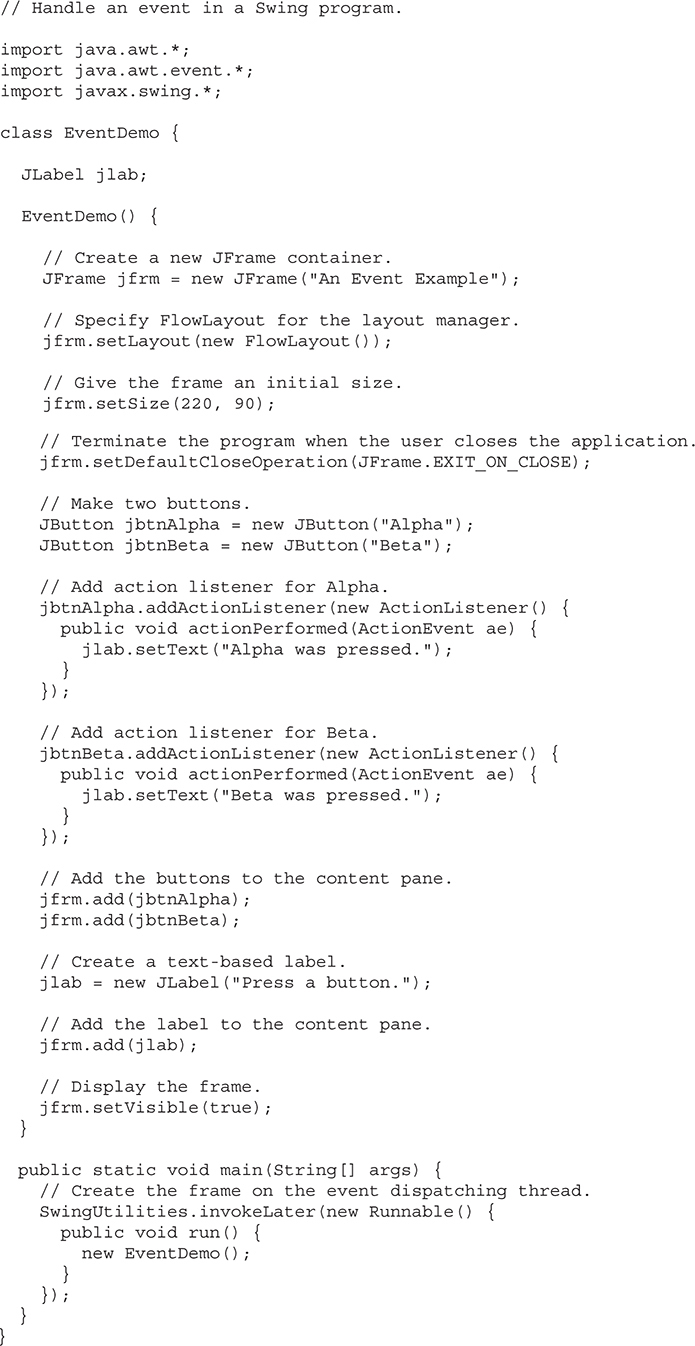
First, notice that the program now imports both the java.awt and java.awt.event packages. The java.awt package is needed because it contains the FlowLayout class, which supports the standard flow layout manager used to lay out components in a frame. (See Chapter 27 for coverage of layout managers.) The java.awt.event package is needed because it defines the ActionListener interface and the ActionEvent class.
The EventDemo constructor begins by creating a JFrame called jfrm. It then sets the layout manager for the content pane of jfrm to FlowLayout. By default, the content pane uses BorderLayout as its layout manager. However, for this example, FlowLayout is more convenient.
After setting the size and default close operation, EventDemo( ) creates two push buttons, as shown here:
JButton jbtnAlpha = new JButton("Alpha");
JButton jbtnBeta = new JButton("Beta");
The first button will contain the text "Alpha" and the second will contain the text "Beta". Swing push buttons are instances of JButton. JButton supplies several constructors. The one used here is
JButton(String msg)
The msg parameter specifies the string that will be displayed inside the button.
When a push button is pressed, it generates an ActionEvent. Thus, JButton provides the addActionListener( ) method, which is used to add an action listener. (JButton also provides removeActionListener( ) to remove a listener, but this method is not used by the program.) As explained in Chapter 25, the ActionListener interface defines only one method: actionPerformed( ). It is shown again here for your convenience:
void actionPerformed(ActionEvent ae)
This method is called when a button is pressed. In other words, it is the event handler that is called when a button press event has occurred.
Next, event listeners for the button’s action events are added by the code shown here:
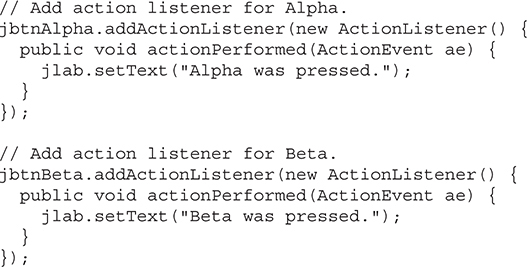
Here, anonymous inner classes are used to provide the event handlers for the two buttons. Each time a button is pressed, the string displayed in jlab is changed to reflect which button was pressed.
Beginning with JDK 8, lambda expressions can also be used to implement some types of event handlers. For example, the event handler for the Alpha button could be written like this:
jbtnAlpha.addActionListener( (ae) -> jlab.setText("Alpha was pressed."));
As you can see, this code is shorter. Of course, the approach you choose will be determined by the situation and your own preferences.
Next, the buttons are added to the content pane of jfrm:
jfrm.add(jbtnAlpha);
jfrm.add(jbtnBeta);
Finally, jlab is added to the content pane and the window is made visible. When you run the program, each time you press a button, a message is displayed in the label that indicates which button was pressed.
One last point: Remember that all event handlers, such as actionPerformed( ), are called on the event dispatching thread. Therefore, an event handler must return quickly in order to avoid slowing down the application. If your application needs to do something time consuming as the result of an event, it must use a separate thread.
Although the Swing component set is quite powerful, you are not limited to using it because Swing also lets you write directly into the display area of a frame, panel, or one of Swing’s other components, such as JLabel. Although many (perhaps most) uses of Swing will not involve drawing directly to the surface of a component, it is available for those applications that need this capability. To write output directly to the surface of a component, you will use one or more drawing methods defined by the AWT, such as drawLine( ) or drawRect( ). Thus, most of the techniques and methods described in Chapter 26 also apply to Swing. However, there are also some very important differences, and the process is discussed in detail in this section.
Swing’s approach to painting is built on the original AWT-based mechanism, but Swing’s implementation offers more finally grained control. Before examining the specifics of Swing-based painting, it is useful to review the AWT-based mechanism that underlies it.
The AWT class Component defines a method called paint( ) that is used to draw output directly to the surface of a component. For the most part, paint( ) is not called by your program. (In fact, only in the most unusual cases should it ever be called by your program.) Rather, paint( ) is called by the run-time system whenever a component must be rendered. This situation can occur for several reasons. For example, the window in which the component is displayed can be overwritten by another window and then uncovered. Or, the window might be minimized and then restored. The paint( ) method is also called when a program begins running. When writing AWT-based code, an application will override paint( ) when it needs to write output directly to the surface of the component.
Because JComponent inherits Component, all Swing’s lightweight components inherit the paint( ) method. However, you will not override it to paint directly to the surface of a component. The reason is that Swing uses a bit more sophisticated approach to painting that involves three distinct methods: paintComponent( ), paintBorder( ), and paintChildren( ). These methods paint the indicated portion of a component and divide the painting process into its three distinct, logical actions. In a lightweight component, the original AWT method paint( ) simply executes calls to these methods, in the order just shown.
To paint to the surface of a Swing component, you will create a subclass of the component and then override its paintComponent( ) method. This is the method that paints the interior of the component. You will not normally override the other two painting methods. When overriding paintComponent( ), the first thing you must do is call super.paintComponent( ), so that the superclass portion of the painting process takes place. (The only time this is not required is when you are taking complete, manual control over how a component is displayed.) After that, write the output that you want to display. The paintComponent( ) method is shown here:
protected void paintComponent(Graphics g)
The parameter g is the graphics context to which output is written.
To cause a component to be painted under program control, call repaint( ). It works in Swing just as it does for the AWT. The repaint( ) method is defined by Component. Calling it causes the system to call paint( ) as soon as it is possible to do so. Because painting is a time-consuming operation, this mechanism allows the run-time system to defer painting momentarily until some higher-priority task has completed, for example. Of course, in Swing the call to paint( ) results in a call to paintComponent( ). Therefore, to output to the surface of a component, your program will store the output until paintComponent( ) is called. Inside the overridden paintComponent( ), you will draw the stored output.
When drawing to the surface of a component, you must be careful to restrict your output to the area that is inside the border. Although Swing automatically clips any output that will exceed the boundaries of a component, it is still possible to paint into the border, which will then get overwritten when the border is drawn. To avoid this, you must compute the paintable area of the component. This is the area defined by the current size of the component minus the space used by the border. Therefore, before you paint to a component, you must obtain the width of the border and then adjust your drawing accordingly.
To obtain the border width, call getInsets( ), shown here:
Insets getInsets( )
This method is defined by Container and overridden by JComponent. It returns an Insets object that contains the dimensions of the border. The inset values can be obtained by using these fields:
int top;
int bottom;
int left;
int right;
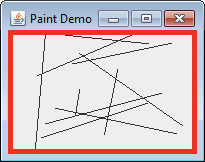
Figure 32-3 Sample output from the PaintPanel program
These values are then used to compute the drawing area given the width and the height of the component. You can obtain the width and height of the component by calling getWidth( ) and getHeight( ) on the component. They are shown here:
int getWidth( )
int getHeight( )
By subtracting the value of the insets, you can compute the usable width and height of the component.
Here is a program that puts into action the preceding discussion. It creates a class called PaintPanel that extends JPanel. The program then uses an object of that class to display lines whose endpoints have been generated randomly. Sample output is shown in Figure 32-3.
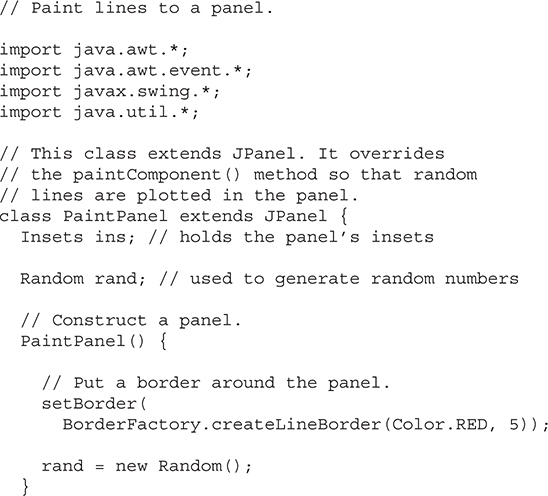
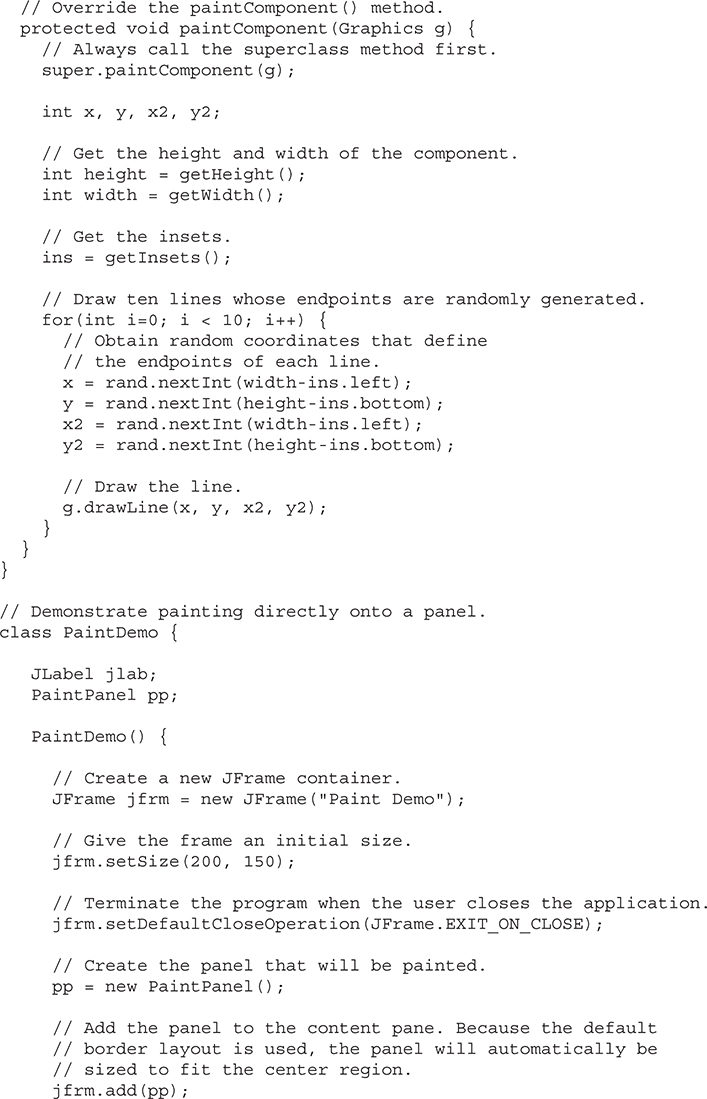
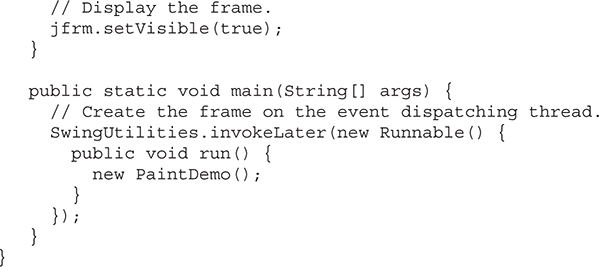
Let’s examine this program closely. The PaintPanel class extends JPanel. JPanel is one of Swing’s lightweight containers, which means that it is a component that can be added to the content pane of a JFrame. To handle painting, PaintPanel overrides the paintComponent( ) method. This enables PaintPanel to write directly to the surface of the component when painting takes place. The size of the panel is not specified because the program uses the default border layout and the panel is added to the center. This results in the panel being sized to fill the center. If you change the size of the window, the size of the panel will be adjusted accordingly.
Notice that the constructor also specifies a 5-pixel wide, red border. This is accomplished by setting the border by using the setBorder( ) method, shown here:
void setBorder(Border border)
Border is the Swing interface that encapsulates a border. You can obtain a border by calling one of the factory methods defined by the BorderFactory class. The one used in the program is createLineBorder( ), which creates a simple line border. It is shown here:
static Border createLineBorder(Color clr, int width)
Here, clr specifies the color of the border and width specifies its width in pixels.
Inside the override of paintComponent( ), notice that it first calls super.paintComponent( ). As explained, this is necessary to ensure that the component is properly drawn. Next, the width and height of the panel are obtained along with the insets. These values are used to ensure the lines lie within the drawing area of the panel. The drawing area is the overall width and height of a component less the border width. The computations are designed to work with differently sized PaintPanels and borders. To prove this, try changing the size of the window. The lines will still all lie within the borders of the panel.
The PaintDemo class creates a PaintPanel and then adds the panel to the content pane. When the application is first displayed, the overridden paintComponent( ) method is called, and the lines are drawn. Each time you resize or hide and restore the window, a new set of lines are drawn. In all cases, the lines fall within the paintable area.
The previous chapter described several of the core concepts relating to Swing and showed the general form of a Swing application. This chapter continues the discussion of Swing by presenting an overview of several Swing components, such as buttons, check boxes, trees, and tables. The Swing components provide rich functionality and allow a high level of customization. Because of space limitations, it is not possible to describe all of their features and attributes. Rather, the purpose of this overview is to give you a feel for the capabilities of the Swing component set.
The Swing component classes described in this chapter are shown here:

These components are all lightweight, which means that they are all derived from JComponent.
Also discussed is the ButtonGroup class, which encapsulates a mutually exclusive set of Swing buttons, and ImageIcon, which encapsulates a graphics image. Both are defined by Swing and packaged in javax.swing.
JLabel is Swing’s easiest-to-use component. It creates a label and was introduced in the preceding chapter. Here, we will look at JLabel a bit more closely. JLabel can be used to display text and/or an icon. It is a passive component in that it does not respond to user input. JLabel defines several constructors. Here are three of them:
JLabel(Icon icon)
JLabel(String str)
JLabel(String str, Icon icon, int align)
Here, str and icon are the text and icon used for the label. The align argument specifies the horizontal alignment of the text and/or icon within the dimensions of the label. It must be one of the following values: LEFT, RIGHT, CENTER, LEADING, or TRAILING. These constants are defined in the SwingConstants interface, along with several others used by the Swing classes.
Notice that icons are specified by objects of type Icon, which is an interface defined by Swing. The easiest way to obtain an icon is to use the ImageIcon class. ImageIcon implements Icon and encapsulates an image. Thus, an object of type ImageIcon can be passed as an argument to the Icon parameter of JLabel’s constructor. There are several ways to provide the image, including reading it from a file or downloading it from a URL. Here is the ImageIcon constructor used by the example in this section:
ImageIcon(String filename)
It obtains the image in the file named filename.
The icon and text associated with the label can be obtained by the following methods:
Icon getIcon( )
String getText( )
The icon and text associated with a label can be set by these methods:
void setIcon(Icon icon)
void setText(String str)
Here, icon and str are the icon and text, respectively. Therefore, using setText( ) it is possible to change the text inside a label during program execution.
The following program illustrates how to create and display a label containing both an icon and a string. It begins by creating an ImageIcon object for the file hourglass.png, which depicts an hourglass. This is used as the second argument to the JLabel constructor. The first and last arguments for the JLabel constructor are the label text and the alignment. Finally, the label is added to the content pane.
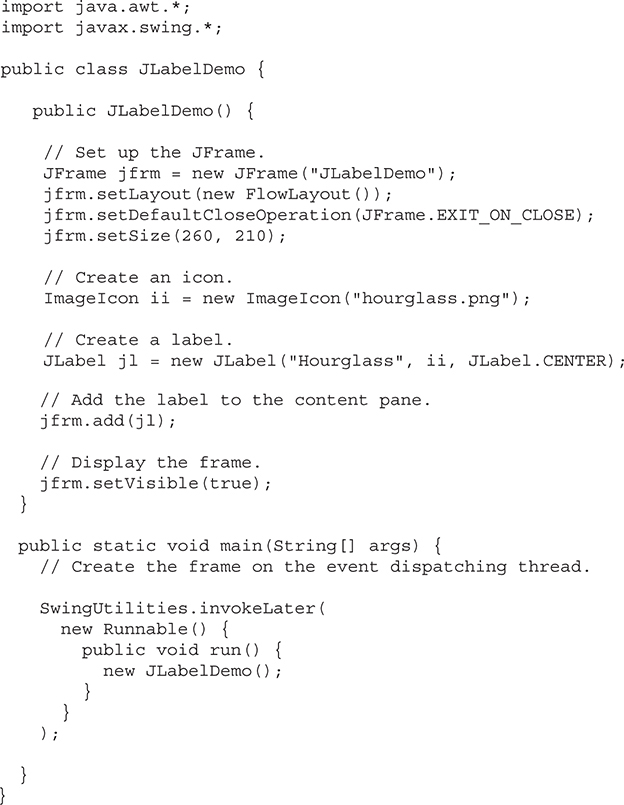
Output from the label example is shown here:
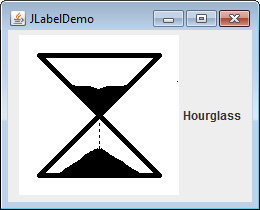
JTextField is the simplest Swing text component. It is also probably its most widely used text component. JTextField allows you to edit one line of text. It is derived from JTextComponent, which provides the basic functionality common to Swing text components. JTextField uses the Document interface for its model. Three of JTextField’s constructors are shown here:
JTextField(int cols)
JTextField(String str, int cols)
JTextField(String str)
Here, str is the string to be initially presented, and cols is the number of columns in the text field. If no string is specified, the text field is initially empty. If the number of columns is not specified, the text field is sized to fit the specified string.
JTextField generates events in response to user interaction. For example, an ActionEvent is fired when the user presses ENTER. A CaretEvent is fired each time the caret (i.e., the cursor) changes position. (CaretEvent is packaged in javax.swing.event.) Other events are also possible. In many cases, your program will not need to handle these events. Instead, you will simply obtain the string currently in the text field when it is needed. To obtain the text currently in the text field, call getText( ).
The following example illustrates JTextField. It creates a JTextField and adds it to the content pane. When the user presses ENTER, an action event is generated. This is handled by displaying the text in a label.
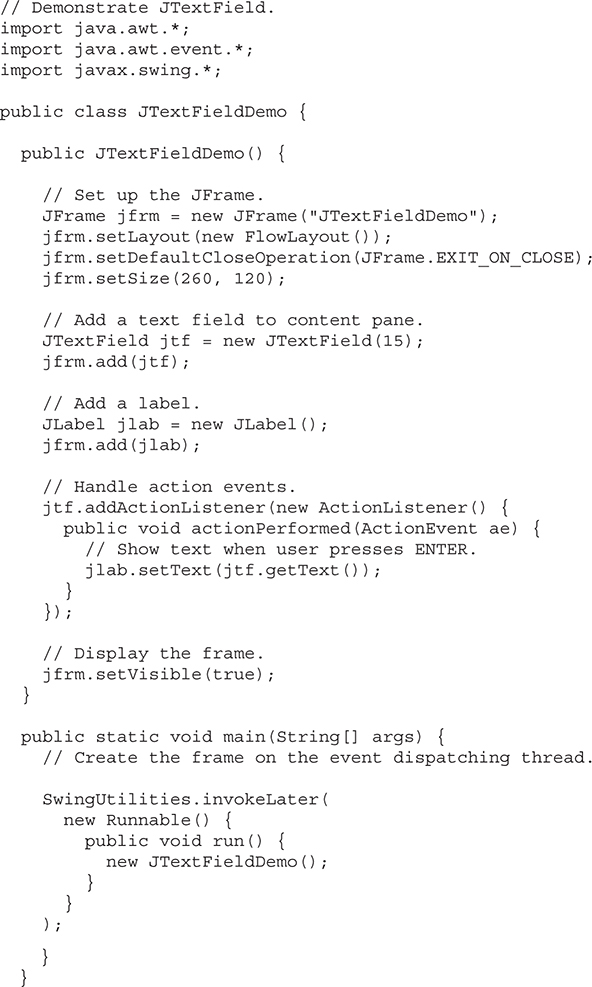
Output from the text field example is shown here:
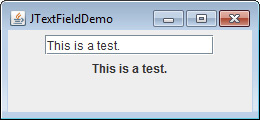
Swing defines four types of buttons: JButton, JToggleButton, JCheckBox, and JRadioButton. All are subclasses of the AbstractButton class, which extends JComponent. Thus, all buttons share a set of common traits.
AbstractButton contains many methods that allow you to control the behavior of buttons. For example, you can define different icons that are displayed for the button when it is disabled, pressed, or selected. Another icon can be used as a rollover icon, which is displayed when the mouse is positioned over a button. The following methods set these icons:
void setDisabledIcon(Icon di)
void setPressedIcon(Icon pi)
void setSelectedIcon(Icon si)
void setRolloverIcon(Icon ri)
Here, di, pi, si, and ri are the icons to be used for the indicated purpose.
The text associated with a button can be read and written via the following methods:
String getText( )
void setText(String str)
Here, str is the text to be associated with the button.
The model used by all buttons is defined by the ButtonModel interface. A button generates an action event when it is pressed. Other events are possible. Each of the concrete button classes is examined next.
The JButton class provides the functionality of a push button. You have already seen a simple form of it in the preceding chapter. JButton allows an icon, a string, or both to be associated with the push button. Three of its constructors are shown here:
JButton(Icon icon)
JButton(String str)
JButton(String str, Icon icon)
Here, str and icon are the string and icon used for the button.
When the button is pressed, an ActionEvent is generated. Using the ActionEvent object passed to the actionPerformed( ) method of the registered ActionListener, you can obtain the action command string associated with the button. By default, this is the string displayed inside the button. However, you can set the action command by calling setActionCommand( ) on the button. You can obtain the action command by calling getActionCommand( ) on the event object. It is declared like this:
String getActionCommand( )
The action command identifies the button. Thus, when using two or more buttons within the same application, the action command gives you an easy way to determine which button was pressed.
In the preceding chapter, you saw an example of a text-based button. The following demonstrates an icon-based button. It displays four push buttons and a label. Each button displays an icon that represents a timepiece. When a button is pressed, the name of that timepiece is displayed in the label.
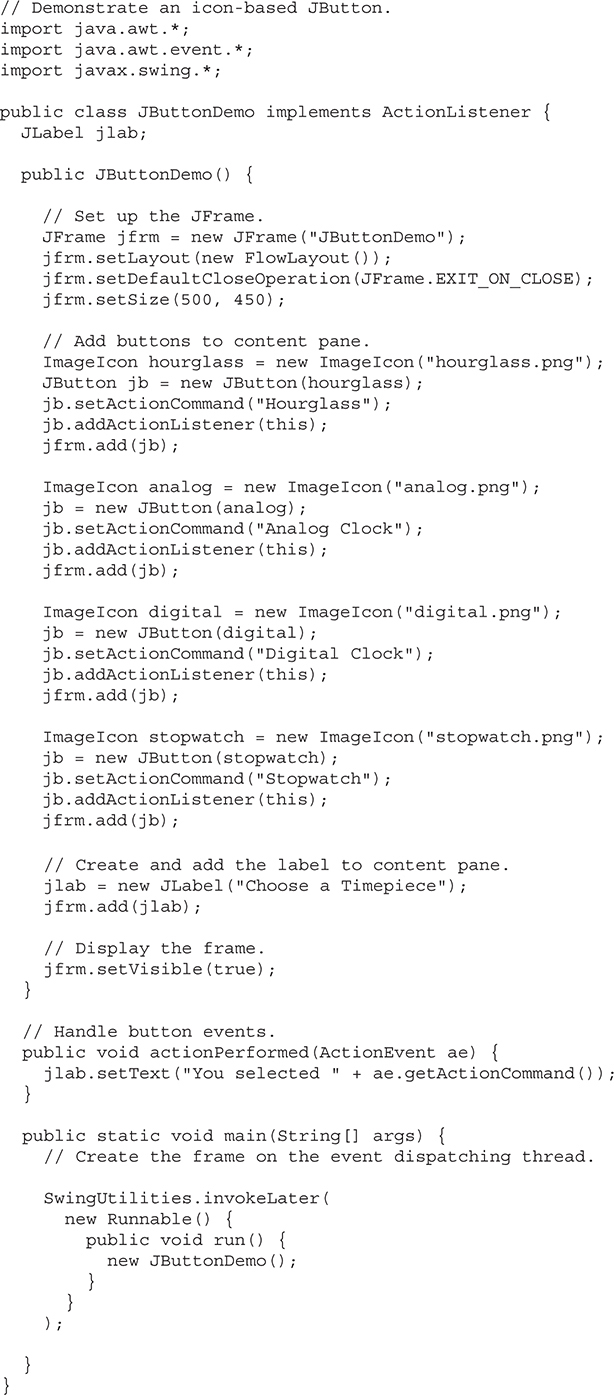
Output from the button example is shown here:
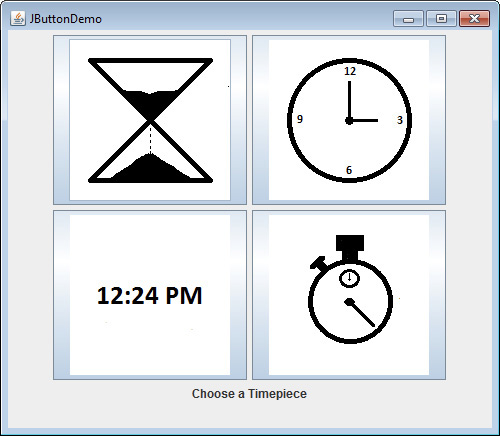
A useful variation on the push button is called a toggle button. A toggle button looks just like a push button, but it acts differently because it has two states: pushed and released. That is, when you press a toggle button, it stays pressed rather than popping back up as a regular push button does. When you press the toggle button a second time, it releases (pops up). Therefore, each time a toggle button is pushed, it toggles between its two states.
Toggle buttons are objects of the JToggleButton class. JToggleButton implements AbstractButton. In addition to creating standard toggle buttons, JToggleButton is a superclass for two other Swing components that also represent two-state controls. These are JCheckBox and JRadioButton, which are described later in this chapter. Thus, JToggleButton defines the basic functionality of all two-state components.
JToggleButton defines several constructors. The one used by the example in this section is shown here:
JToggleButton(String str)
This creates a toggle button that contains the text passed in str. By default, the button is in the off position. Other constructors enable you to create toggle buttons that contain images, or images and text.
JToggleButton uses a model defined by a nested class called JToggleButton.Toggle-ButtonModel. Normally, you won’t need to interact directly with the model to use a standard toggle button.
Like JButton, JToggleButton generates an action event each time it is pressed. Unlike JButton, however, JToggleButton also generates an item event. This event is used by those components that support the concept of selection. When a JToggleButton is pressed in, it is selected. When it is popped out, it is deselected.
To handle item events, you must implement the ItemListener interface. Recall from Chapter 25, that each time an item event is generated, it is passed to the itemStateChanged( ) method defined by ItemListener. Inside itemStateChanged( ), the getItem( ) method can be called on the ItemEvent object to obtain a reference to the JToggleButton instance that generated the event. It is shown here:
Object getItem( )
A reference to the button is returned. You will need to cast this reference to JToggleButton.
The easiest way to determine a toggle button’s state is by calling the isSelected( ) method (inherited from AbstractButton) on the button that generated the event. It is shown here:
boolean isSelected( )
It returns true if the button is selected and false otherwise.
Here is an example that uses a toggle button. Notice how the item listener works. It simply calls isSelected( ) to determine the button’s state.
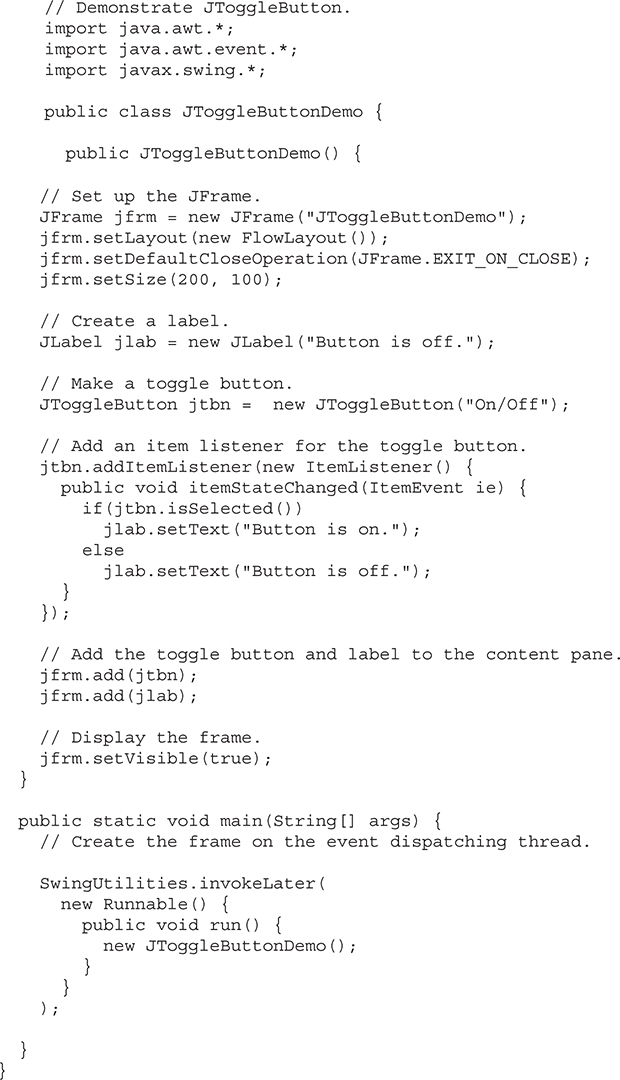
The output from the toggle button example is shown here:
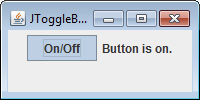
The JCheckBox class provides the functionality of a check box. Its immediate superclass is JToggleButton, which provides support for two-state buttons, as just described. JCheckBox defines several constructors. The one used here is
JCheckBox(String str)
It creates a check box that has the text specified by str as a label. Other constructors let you specify the initial selection state of the button and specify an icon.
When the user selects or deselects a check box, an ItemEvent is generated. You can obtain a reference to the JCheckBox that generated the event by calling getItem( ) on the ItemEvent passed to the itemStateChanged( ) method defined by ItemListener. The easiest way to determine the selected state of a check box is to call isSelected( ) on the JCheckBox instance.
The following example illustrates check boxes. It displays four check boxes and a label. When the user clicks a check box, an ItemEvent is generated. Inside the itemStateChanged( ) method, getItem( ) is called to obtain a reference to the JCheckBox object that generated the event. Next, a call to isSelected( ) determines if the box was selected or cleared. The getText( ) method gets the text for that check box and uses it to set the text inside the label.
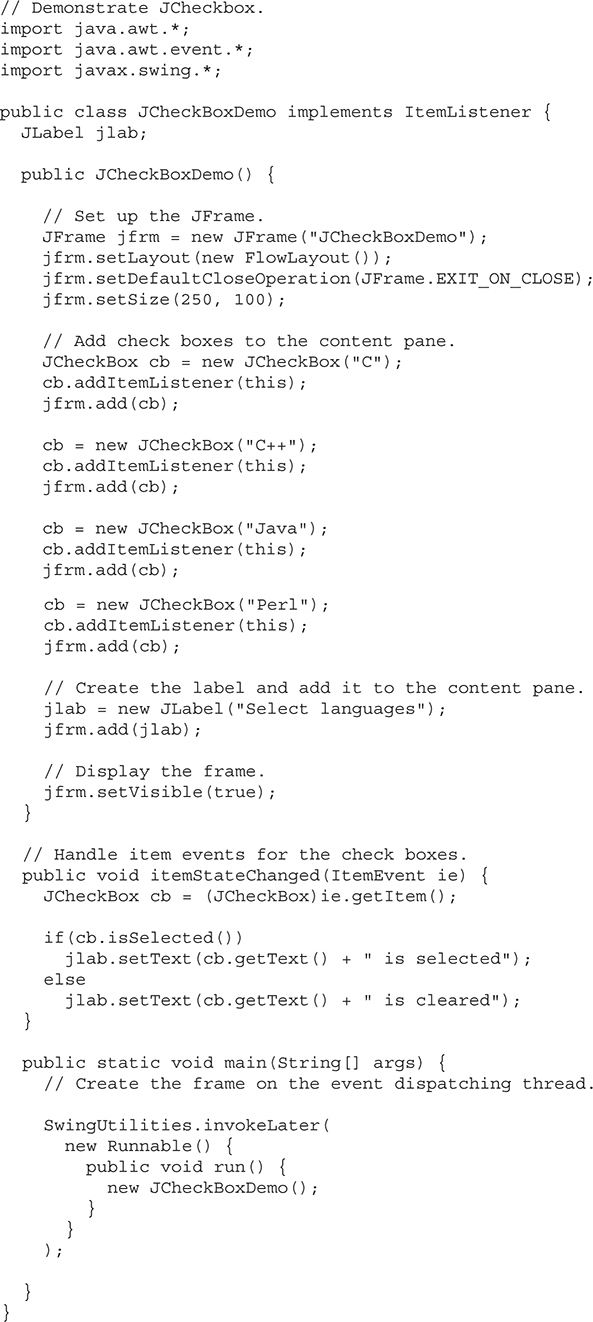
Output from this example is shown here:
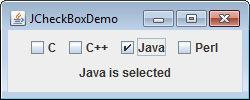
Radio buttons are a group of mutually exclusive buttons, in which only one button can be selected at any one time. They are supported by the JRadioButton class, which extends JToggleButton. JRadioButton provides several constructors. The one used in the example is shown here:
JRadioButton(String str)
Here, str is the label for the button. Other constructors let you specify the initial selection state of the button and specify an icon.
In order for their mutually exclusive nature to be activated, radio buttons must be configured into a group. Only one of the buttons in the group can be selected at any time. For example, if a user presses a radio button that is in a group, any previously selected button in that group is automatically deselected. A button group is created by the ButtonGroup class. Its default constructor is invoked for this purpose. Elements are then added to the button group via the following method:
void add(AbstractButton ab)
Here, ab is a reference to the button to be added to the group.
A JRadioButton generates action events, item events, and change events each time the button selection changes. Most often, it is the action event that is handled, which means that you will normally implement the ActionListener interface. Recall that the only method defined by ActionListener is actionPerformed( ). Inside this method, you can use a number of different ways to determine which button was selected. First, you can check its action command by calling getActionCommand( ). By default, the action command is the same as the button label, but you can set the action command to something else by calling setActionCommand( ) on the radio button. Second, you can call getSource( ) on the ActionEvent object and check that reference against the buttons. Third, you can check each radio button to find out which one is currently selected by calling isSelected( ) on each button. Finally, each button could use its own action event handler implemented as either an anonymous inner class or a lambda expression. Remember, each time an action event occurs, it means that the button being selected has changed and that one and only one button will be selected.
The following example illustrates how to use radio buttons. Three radio buttons are created. The buttons are then added to a button group. As explained, this is necessary to cause their mutually exclusive behavior. Pressing a radio button generates an action event, which is handled by actionPerformed( ). Within that handler, the getActionCommand( ) method gets the text that is associated with the radio button and uses it to set the text within a label.
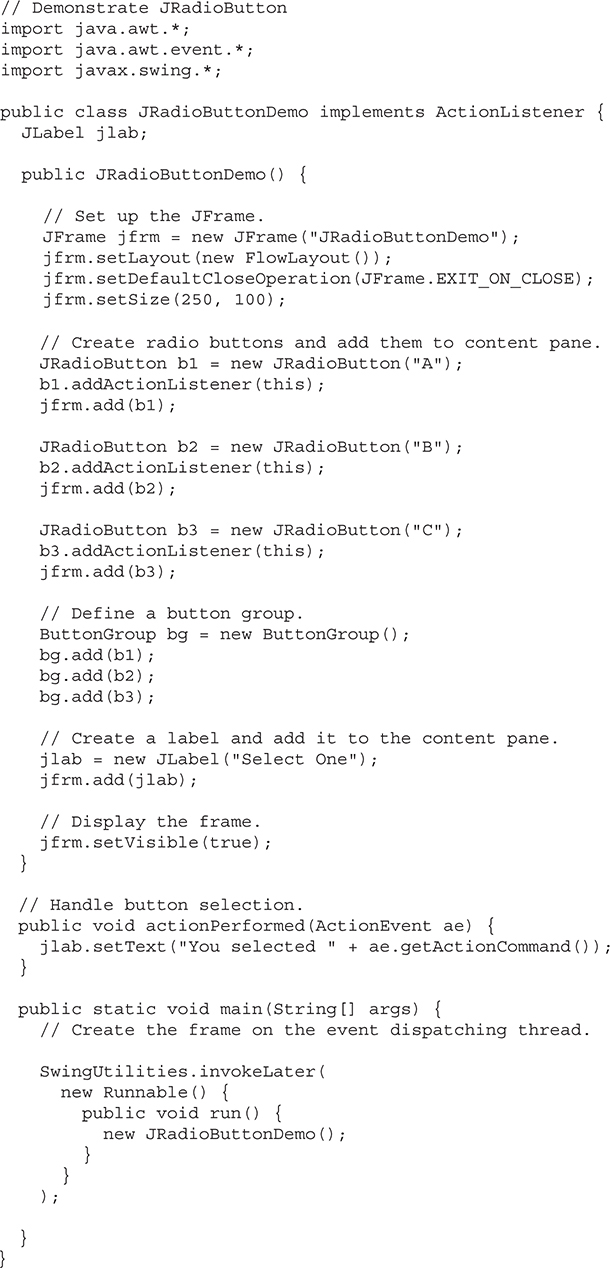
Output from the radio button example is shown here:
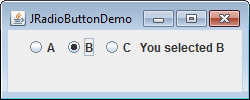
JTabbedPane encapsulates a tabbed pane. It manages a set of components by linking them with tabs. Selecting a tab causes the component associated with that tab to come to the forefront. Tabbed panes are very common in the modern GUI, and you have no doubt used them many times. Given the complex nature of a tabbed pane, they are surprisingly easy to create and use.
JTabbedPane defines three constructors. We will use its default constructor, which creates an empty control with the tabs positioned across the top of the pane. The other two constructors let you specify the location of the tabs, which can be along any of the four sides. JTabbedPane uses the SingleSelectionModel model.
Tabs are added by calling addTab( ). Here is one of its forms:
void addTab(String name, Component comp)
Here, name is the name for the tab, and comp is the component that should be added to the tab. Often, the component added to a tab is a JPanel that contains a group of related components. This technique allows a tab to hold a set of components.
The general procedure to use a tabbed pane is outlined here:
1. Create an instance of JTabbedPane.
2. Add each tab by calling addTab( ).
3. Add the tabbed pane to the content pane.
The following example illustrates a tabbed pane. The first tab is titled "Cities" and contains four buttons. Each button displays the name of a city. The second tab is titled "Colors" and contains three check boxes. Each check box displays the name of a color. The third tab is titled "Flavors" and contains one combo box. This enables the user to select one of three flavors.
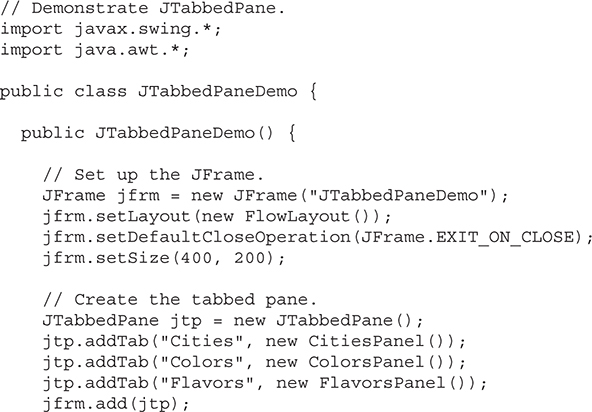
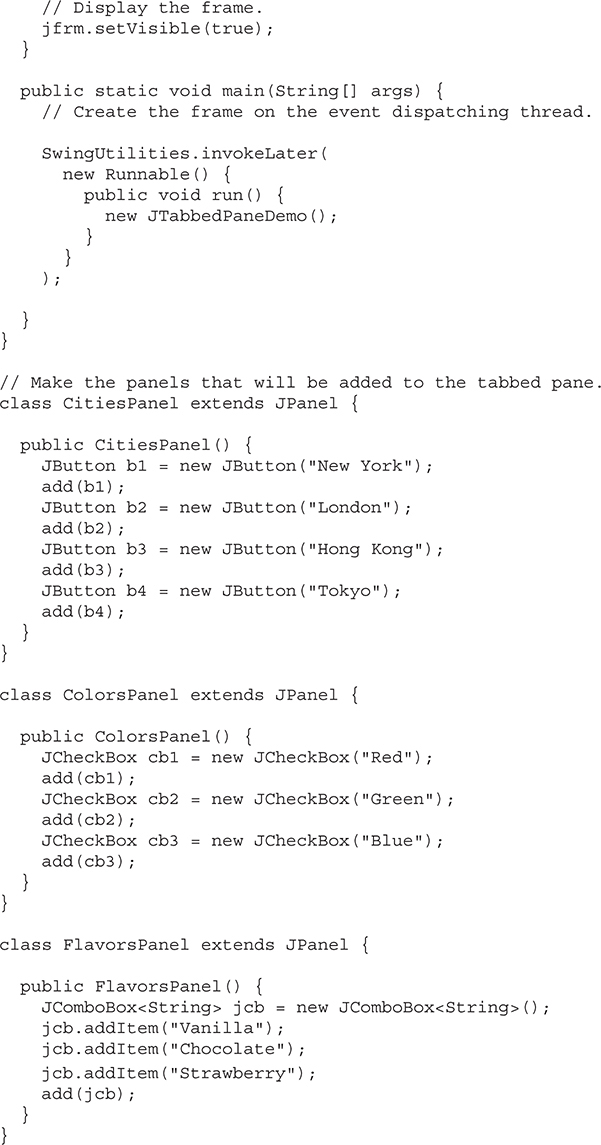
Output from the tabbed pane example is shown in the following three illustrations:
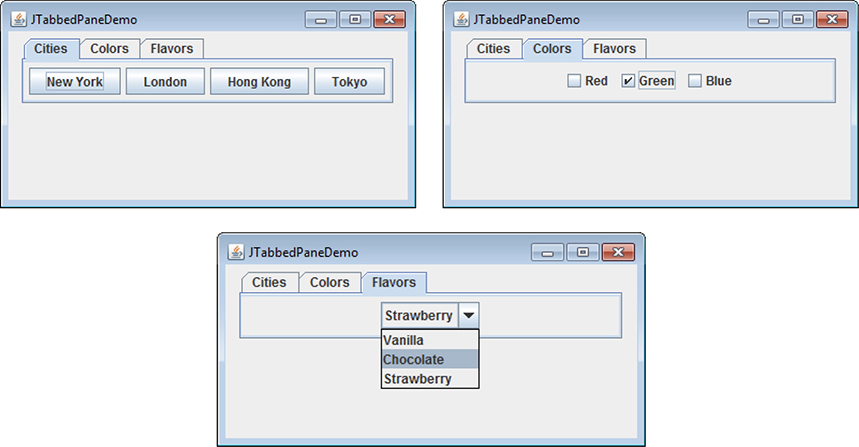
JScrollPane is a lightweight container that automatically handles the scrolling of another component. The component being scrolled can be either an individual component, such as a table, or a group of components contained within another lightweight container, such as a JPanel. In either case, if the object being scrolled is larger than the viewable area, horizontal and/or vertical scroll bars are automatically provided, and the component can be scrolled through the pane. Because JScrollPane automates scrolling, it usually eliminates the need to manage individual scroll bars.
The viewable area of a scroll pane is called the viewport. It is a window in which the component being scrolled is displayed. Thus, the viewport displays the visible portion of the component being scrolled. The scroll bars scroll the component through the viewport. In its default behavior, a JScrollPane will dynamically add or remove a scroll bar as needed. For example, if the component is taller than the viewport, a vertical scroll bar is added. If the component will completely fit within the viewport, the scroll bars are removed.
JScrollPane defines several constructors. The one used in this chapter is shown here:
JScrollPane(Component comp)
The component to be scrolled is specified by comp. Scroll bars are automatically displayed when the content of the pane exceeds the dimensions of the viewport.
Here are the steps to follow to use a scroll pane:
1. Create the component to be scrolled.
2. Create an instance of JScrollPane, passing to it the object to scroll.
3. Add the scroll pane to the content pane.
The following example illustrates a scroll pane. First, a JPanel object is created, and 400 buttons are added to it, arranged into 20 columns. This panel is then added to a scroll pane, and the scroll pane is added to the content pane. Because the panel is larger than the viewport, vertical and horizontal scroll bars appear automatically. You can use the scroll bars to scroll the buttons into view.
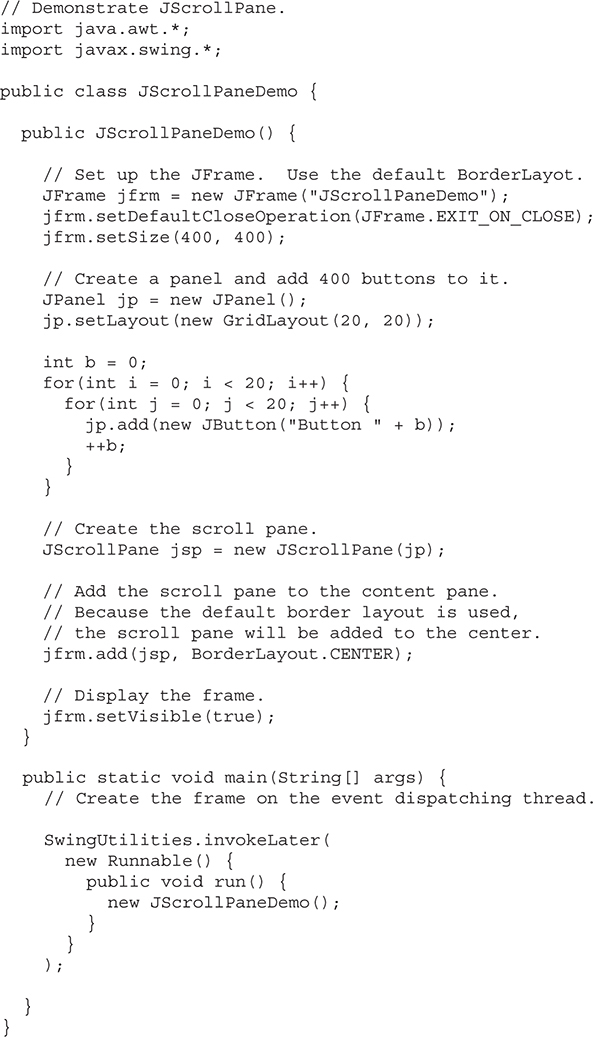
Output from the scroll pane example is shown here:
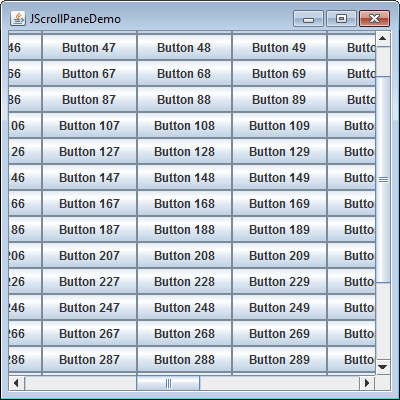
In Swing, the basic list class is called JList. It supports the selection of one or more items from a list. Although the list often consists of strings, it is possible to create a list of just about any object that can be displayed. JList is so widely used in Java that it is highly unlikely that you have not seen one before.
In the past, the items in a JList were represented as Object references. However, beginning with JDK 7, JList was made generic and is now declared like this:
class JList<E>
Here, E represents the type of the items in the list.
JList provides several constructors. The one used here is
JList(E[ ] items)
This creates a JList that contains the items in the array specified by items.
JList is based on two models. The first is ListModel. This interface defines how access to the list data is achieved. The second model is the ListSelectionModel interface, which defines methods that determine what list item or items are selected.
Although a JList will work properly by itself, most of the time you will wrap a JList inside a JScrollPane. This way, long lists will automatically be scrollable, which simplifies GUI design. It also makes it easy to change the number of entries in a list without having to change the size of the JList component.
A JList generates a ListSelectionEvent when the user makes or changes a selection. This event is also generated when the user deselects an item. It is handled by implementing ListSelectionListener. This listener specifies only one method, called valueChanged( ), which is shown here:
void valueChanged(ListSelectionEvent le)
Here, le is a reference to the event. Although ListSelectionEvent does provide some methods of its own, normally you will interrogate the JList object itself to determine what has occurred. Both ListSelectionEvent and ListSelectionListener are packaged in javax.swing.event.
By default, a JList allows the user to select multiple ranges of items within the list, but you can change this behavior by calling setSelectionMode( ), which is defined by JList. It is shown here:
void setSelectionMode(int mode)
Here, mode specifies the selection mode. It must be one of these values defined by ListSelectionModel:
SINGLE_SELECTION
SINGLE_INTERVAL_SELECTION
MULTIPLE_INTERVAL_SELECTION
The default, multiple-interval selection, lets the user select multiple ranges of items within a list. With single-interval selection, the user can select one range of items. With single selection, the user can select only a single item. Of course, a single item can be selected in the other two modes, too. It’s just that they also allow a range to be selected.
You can obtain the index of the first item selected, which will also be the index of the only selected item when using single-selection mode, by calling getSelectedIndex( ), shown here:
int getSelectedIndex( )
Indexing begins at zero. So, if the first item is selected, this method will return 0. If no item is selected, –1 is returned.
Instead of obtaining the index of a selection, you can obtain the value associated with the selection by calling getSelectedValue( ):
E getSelectedValue( )
It returns a reference to the first selected value. If no value has been selected, it returns null.
The following program demonstrates a simple JList, which holds a list of cities. Each time a city is selected in the list, a ListSelectionEvent is generated, which is handled by the valueChanged( ) method defined by ListSelectionListener. It responds by obtaining the index of the selected item and displaying the name of the selected city in a label.

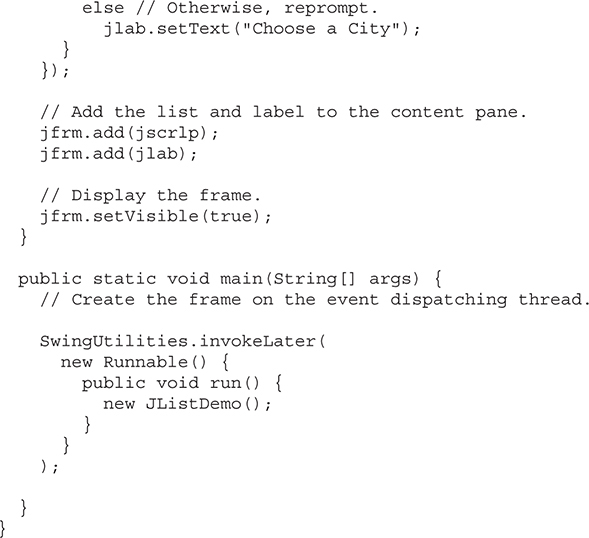
Output from the list example is shown here:
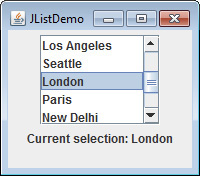
Swing provides a combo box (a combination of a text field and a drop-down list) through the JComboBox class. A combo box normally displays one entry, but it will also display a drop-down list that allows a user to select a different entry. You can also create a combo box that lets the user enter a selection into the text field.
In the past, the items in a JComboBox were represented as Object references. However, beginning with JDK 7, JComboBox was made generic and is now declared like this:
class JComboBox<E>
Here, E represents the type of the items in the combo box.
The JComboBox constructor used by the example is shown here:
JComboBox(E[ ] items)
Here, items is an array that initializes the combo box. Other constructors are available.
JComboBox uses the ComboBoxModel. Mutable combo boxes (those whose entries can be changed) use the MutableComboBoxModel.
In addition to passing an array of items to be displayed in the drop-down list, items can be dynamically added to the list of choices via the addItem( ) method, shown here:
void addItem(E obj)
Here, obj is the object to be added to the combo box. This method must be used only with mutable combo boxes.
JComboBox generates an action event when the user selects an item from the list. JComboBox also generates an item event when the state of selection changes, which occurs when an item is selected or deselected. Thus, changing a selection means that two item events will occur: one for the deselected item and another for the selected item. Often, it is sufficient to simply listen for action events, but both event types are available for your use.
One way to obtain the item selected in the list is to call getSelectedItem( ) on the combo box. It is shown here:
Object getSelectedItem( )
You will need to cast the returned value into the type of object stored in the list.
The following example demonstrates the combo box. The combo box contains entries for "Hourglass", "Analog", "Digital", and "Stopwatch". When a timepiece is selected, an icon-based label is updated to display it. You can see how little code is required to use this powerful component.
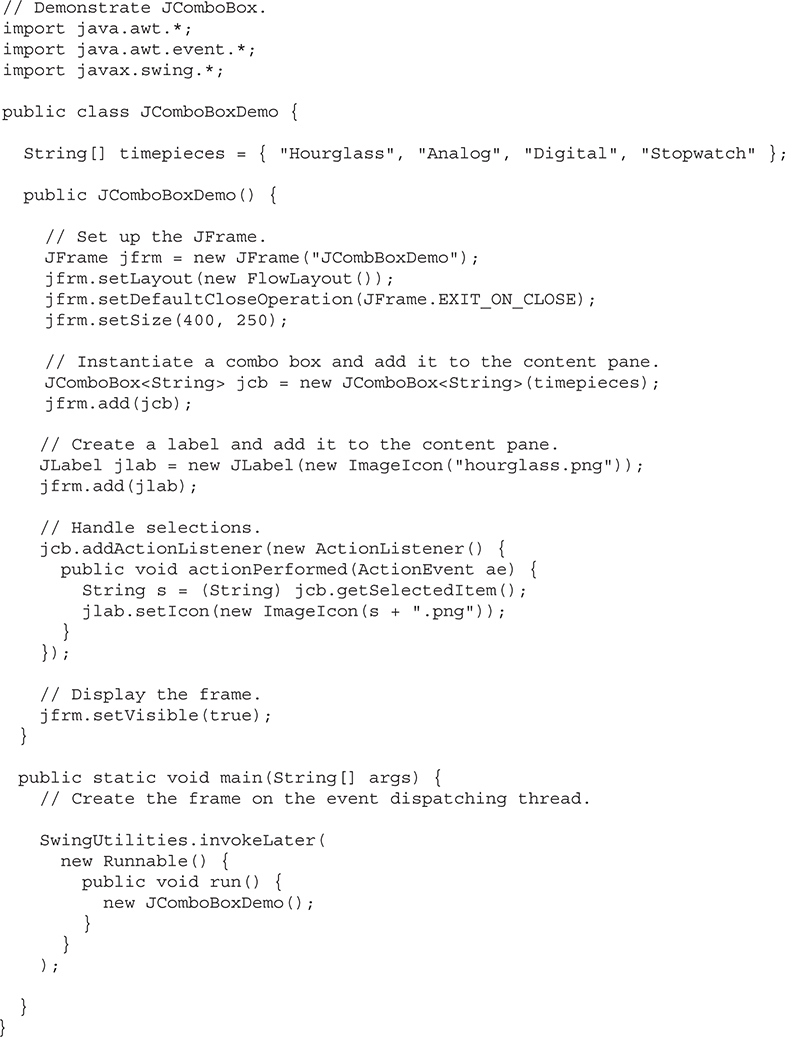
Output from the combo box example is shown here:
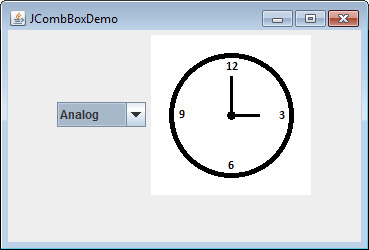
A tree is a component that presents a hierarchical view of data. The user has the ability to expand or collapse individual subtrees in this display. Trees are implemented in Swing by the JTree class. A sampling of its constructors is shown here:
JTree(Object[ ] obj)
JTree(Vector<?> v)
JTree(TreeNode tn)
In the first form, the tree is constructed from the elements in the array obj. The second form constructs the tree from the elements of vector v. In the third form, the tree whose root node is specified by tn specifies the tree.
Although JTree is packaged in javax.swing, its support classes and interfaces are packaged in javax.swing.tree. This is because the number of classes and interfaces needed to support JTree is quite large.
JTree relies on two models: TreeModel and TreeSelectionModel. A JTree generates a variety of events, but three relate specifically to trees: TreeExpansionEvent, TreeSelectionEvent, and TreeModelEvent. TreeExpansionEvent events occur when a node is expanded or collapsed. A TreeSelectionEvent is generated when the user selects or deselects a node within the tree. A TreeModelEvent is fired when the data or structure of the tree changes. The listeners for these events are TreeExpansionListener, TreeSelectionListener, and TreeModelListener, respectively. The tree event classes and listener interfaces are packaged in javax.swing.event.
The event handled by the sample program shown in this section is TreeSelectionEvent. To listen for this event, implement TreeSelectionListener. It defines only one method, called valueChanged( ), which receives the TreeSelectionEvent object. You can obtain the path to the selected object by calling getPath( ), shown here, on the event object:
TreePath getPath( )
It returns a TreePath object that describes the path to the changed node. The TreePath class encapsulates information about a path to a particular node in a tree. It provides several constructors and methods. In this book, only the toString( ) method is used. It returns a string that describes the path.
The TreeNode interface declares methods that obtain information about a tree node. For example, it is possible to obtain a reference to the parent node or an enumeration of the child nodes. The MutableTreeNode interface extends TreeNode. It declares methods that can insert and remove child nodes or change the parent node.
The DefaultMutableTreeNode class implements the MutableTreeNode interface. It represents a node in a tree. One of its constructors is shown here:
DefaultMutableTreeNode(Object obj)
Here, obj is the object to be enclosed in this tree node. The new tree node doesn’t have a parent or children.
To create a hierarchy of tree nodes, the add( ) method of DefaultMutableTreeNode can be used. Its signature is shown here:
void add(MutableTreeNode child)
Here, child is a mutable tree node that is to be added as a child to the current node.
JTree does not provide any scrolling capabilities of its own. Instead, a JTree is typically placed within a JScrollPane. This way, a large tree can be scrolled through a smaller viewport.
Here are the steps to follow to use a tree:
1. Create an instance of JTree.
2. Create a JScrollPane and specify the tree as the object to be scrolled.
3. Add the scroll pane to the content pane.
The following example illustrates how to create a tree and handle selections. The program creates a DefaultMutableTreeNode instance labeled "Options". This is the top node of the tree hierarchy. Additional tree nodes are then created, and the add( ) method is called to connect these nodes to the tree. A reference to the top node in the tree is provided as the argument to the JTree constructor. The tree is then provided as the argument to the JScrollPane constructor. This scroll pane is then added to the content pane. Next, a label is created and added to the content pane. The tree selection is displayed in this label. To receive selection events from the tree, a TreeSelectionListener is registered for the tree. Inside the valueChanged( ) method, the path to the current selection is obtained and displayed.
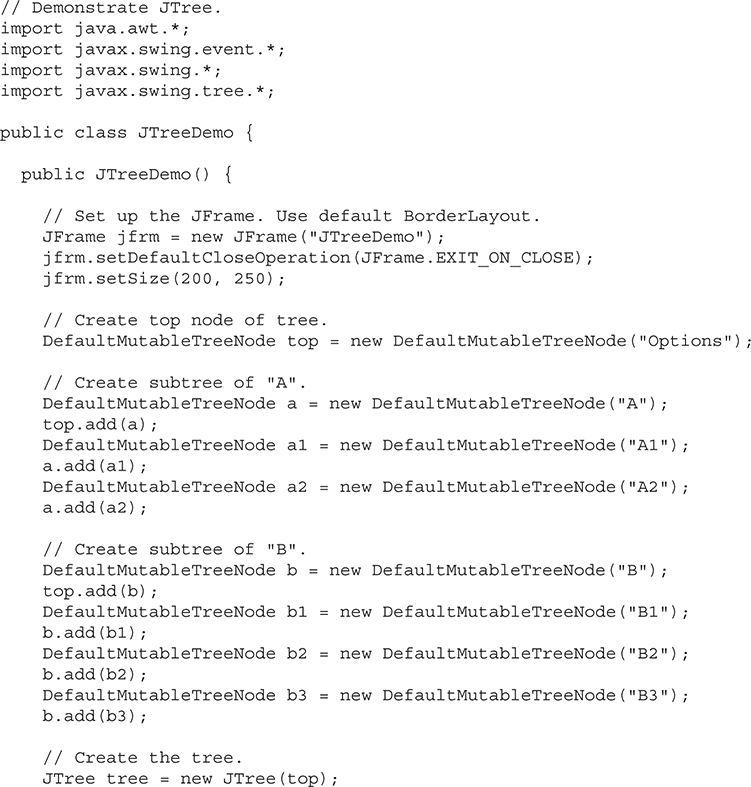
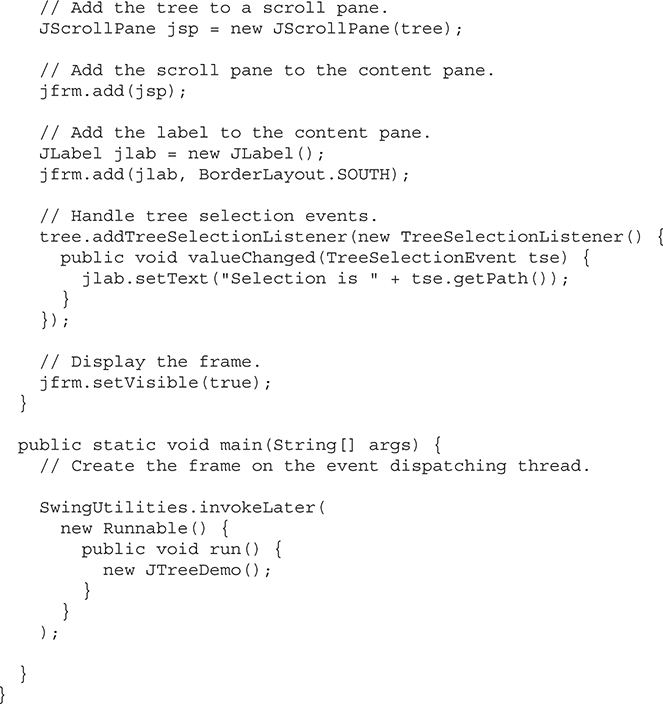
Output from the tree example is shown here:

The string presented in the text field describes the path from the top tree node to the selected node.
JTable is a component that displays rows and columns of data. You can drag the cursor on column boundaries to resize columns. You can also drag a column to a new position. Depending on its configuration, it is also possible to select a row, column, or cell within the table, and to change the data within a cell. JTable is a sophisticated component that offers many more options and features than can be discussed here. (It is perhaps Swing’s most complicated component.) However, in its default configuration, JTable still offers substantial functionality that is easy to use—especially if you simply want to use the table to present data in a tabular format. The brief overview presented here will give you a general understanding of this powerful component.
Like JTree, JTable has many classes and interfaces associated with it. These are packaged in javax.swing.table.
At its core, JTable is conceptually simple. It is a component that consists of one or more columns of information. At the top of each column is a heading. In addition to describing the data in a column, the heading also provides the mechanism by which the user can change the size of a column or change the location of a column within the table. JTable does not provide any scrolling capabilities of its own. Instead, you will normally wrap a JTable inside a JScrollPane.
JTable supplies several constructors. The one used here is
JTable(Object[ ][ ] data, Object[ ] colHeads)
Here, data is a two-dimensional array of the information to be presented, and colHeads is a one-dimensional array with the column headings.
JTable relies on three models. The first is the table model, which is defined by the TableModel interface. This model defines those things related to displaying data in a two-dimensional format. The second is the table column model, which is represented by TableColumnModel. JTable is defined in terms of columns, and it is TableColumnModel that specifies the characteristics of a column. These two models are packaged in javax.swing.table. The third model determines how items are selected, and it is specified by the ListSelectionModel, which was described when JList was discussed.
A JTable can generate several different events. The two most fundamental to a table’s operation are ListSelectionEvent and TableModelEvent. A ListSelectionEvent is generated when the user selects something in the table. By default, JTable allows you to select one or more complete rows, but you can change this behavior to allow one or more columns, or one or more individual cells to be selected. A TableModelEvent is fired when that table’s data changes in some way. Handling these events requires a bit more work than it does to handle the events generated by the previously described components and is beyond the scope of this book. However, if you simply want to use JTable to display data (as the following example does), then you don’t need to handle any events.
Here are the steps required to set up a simple JTable that can be used to display data:
1. Create an instance of JTable.
2. Create a JScrollPane object, specifying the table as the object to scroll.
3. Add the scroll pane to the content pane.
The following example illustrates how to create and use a simple table. A one-dimensional array of strings called colHeads is created for the column headings. A two-dimensional array of strings called data is created for the table cells. You can see that each element in the array is an array of three strings. These arrays are passed to the JTable constructor. The table is added to a scroll pane, and then the scroll pane is added to the content pane. The table displays the data in the data array. The default table configuration also allows the contents of a cell to be edited. Changes affect the underlying array, which is data in this case.
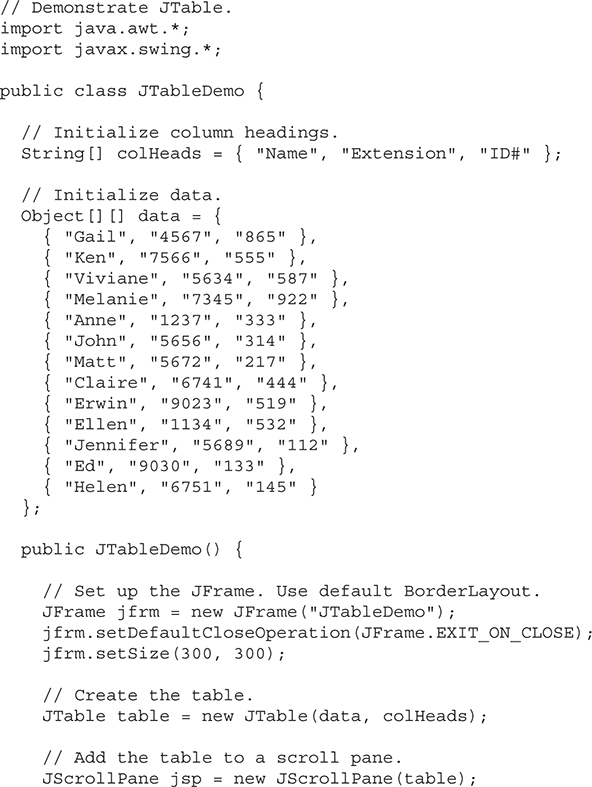
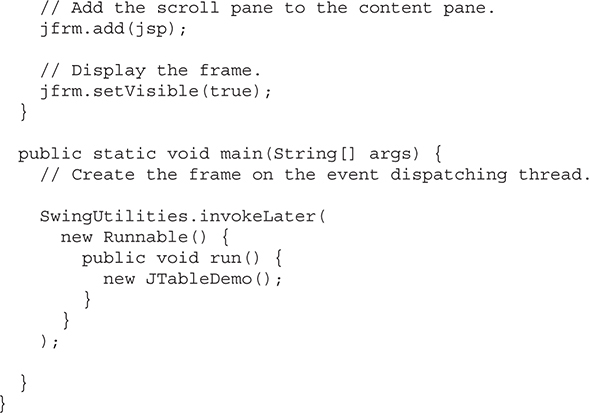
Output from this example is shown here:
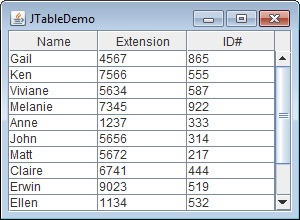
This chapter introduces another fundamental aspect of the Swing GUI environment: the menu. Menus form an integral part of many applications because they present the program’s functionality to the user. Because of their importance, Swing provides extensive support for menus. They are an area in which Swing’s power is readily apparent.
The Swing menu system supports several key elements, including
• The menu bar, which is the main menu for an application.
• The standard menu, which can contain either items to be selected or other menus (submenus).
• The popup menu, which is usually activated by right-clicking the mouse.
• The toolbar, which provides rapid access to program functionality, often paralleling menu items.
• The action, which enables two or more different components to be managed by a single object. Actions are commonly used with menus and toolbars.
Swing menus also support accelerator keys, which enable menu items to be selected without having to activate the menu, and mnemonics, which allow a menu item to be selected by the keyboard once the menu options are displayed.
The Swing menu system is supported by a group of related classes. The ones used in this chapter are shown in Table 34-1, and they represent the core of the menu system. Although they may seem a bit confusing at first, Swing menus are quite easy to use. Swing allows a high degree of customization, if desired; however, you will normally use the menu classes as-is because they support all of the most needed options. For example, you can easily add images and keyboard shortcuts to a menu.
Table 34-1 The Core Swing Menu Classes

Here is a brief overview of how the classes fit together. To create the top-level menu for an application, you first create a JMenuBar object. This class is, loosely speaking, a container for menus. To the JMenuBar instance, you will add instances of JMenu. Each JMenu object defines a menu. That is, each JMenu object contains one or more selectable items. The items displayed by a JMenu are objects of JMenuItem. Thus, a JMenuItem defines a selection that can be chosen by the user.
As an alternative or adjunct to menus that descend from the menu bar, you can also create stand-alone, popup menus. To create a popup menu, first create an object of type JPopupMenu. Then, add JMenuItems to it. A popup menu is normally activated by clicking the right mouse button when the mouse is over a component for which a popup menu has been defined.
In addition to “standard” menu items, you can also include check boxes and radio buttons in a menu. A check box menu item is created by JCheckBoxMenuItem. A radio button menu item is created by JRadioButtonMenuItem. Both of these classes extend JMenuItem. They can be used in standard menus and popup menus.
JToolBar creates a stand-alone component that is related to the menu. It is often used to provide fast access to functionality contained within the menus of the application. For example, a toolbar might provide fast access to the formatting commands supported by a word processor.
JSeparator is a convenience class that creates a separator line in a menu.
One key point to understand about Swing menus is that each menu item extends AbstractButton. Recall that AbstractButton is also the superclass of all of Swing’s button components, such as JButton. Thus, all menu items are, essentially, buttons. Obviously, they won’t actually look like buttons when used in a menu, but they will, in many ways, act like buttons. For example, selecting a menu item generates an action event in the same way that pressing a button does.
Another key point is that JMenuItem is a superclass of JMenu. This allows the creation of submenus, which are, essentially, menus within menus. To create a submenu, you first create and populate a JMenu object and then add it to another JMenu object. You will see this process in action in the following section.
As mentioned in passing previously, when a menu item is selected, an action event is generated. The action command string associated with that action event will, by default, be the name of the selection. Thus, you can determine which item was selected by examining the action command. Of course, you can also use separate anonymous inner classes or lambda expressions to handle each menu item’s action events. In this case, the menu selection is already known, and there is no need to examine the action command string to determine which item was selected.
Menus can also generate other types of events. For example, each time that a menu is activated, selected, or canceled, a MenuEvent is generated that can be listened for via a MenuListener. Other menu-related events include MenuKeyEvent, MenuDragMouseEvent, and PopupMenuEvent. In many cases, however, you need only watch for action events, and in this chapter, we will use only action events.
Before you can create a menu, you need to know something about the three core menu classes: JMenuBar, JMenu, and JMenuItem. These form the minimum set of classes needed to construct a main menu for an application. JMenu and JMenuItem are also used by popup menus. Thus, these classes form the foundation of the menu system.
As mentioned, JMenuBar is essentially a container for menus. Like all components, it inherits JComponent (which inherits Container and Component). It has only one constructor, which is the default constructor. Therefore, initially the menu bar will be empty, and you will need to populate it with menus prior to use. Each application has one and only one menu bar.
JMenuBar defines several methods, but often you will only need to use one: add( ). The add( ) method adds a JMenu to the menu bar. It is shown here:
JMenu add(JMenu menu)
Here, menu is a JMenu instance that is added to the menu bar. A reference to the menu is returned. Menus are positioned in the bar from left to right, in the order in which they are added. If you want to add a menu at a specific location, then use this version of add( ), which is inherited from Container:
Component add(Component menu, int idx)
Here, menu is added at the index specified by idx. Indexing begins at 0, with 0 being the left-most menu.
In some cases, you might want to remove a menu that is no longer needed. You can do this by calling remove( ), which is inherited from Container. It has these two forms:
void remove(Component menu)
void remove(int idx)
Here, menu is a reference to the menu to remove, and idx is the index of the menu to remove. Indexing begins at zero.
Another method that is sometimes useful is getMenuCount( ), shown here:
int getMenuCount( )
It returns the number of elements contained within the menu bar.
JMenuBar defines some other methods that you might find helpful in specialized applications. For example, you can obtain an array of references to the menus in the bar by calling getSubElements( ). You can determine if a menu is selected by calling isSelected( ).
Once a menu bar has been created and populated, it is added to a JFrame by calling setJMenuBar( ) on the JFrame instance. (Menu bars are not added to the content pane.) The setJMenuBar( ) method is shown here:
void setJMenuBar(JMenuBar mb)
Here, mb is a reference to the menu bar. The menu bar will be displayed in a position determined by the look and feel. Usually, this is at the top of the window.
JMenu encapsulates a menu, which is populated with JMenuItems. As mentioned, it is derived from JMenuItem. This means that one JMenu can be a selection in another JMenu. This enables one menu to be a submenu of another. JMenu defines a number of constructors. For example, here is the one used in the examples in this chapter:
JMenu(String name)
This constructor creates a menu that has the title specified by name. Of course, you don’t have to give a menu a name. To create an unnamed menu, you can use the default constructor:
JMenu( )
Other constructors are also supported. In each case, the menu is empty until menu items are added to it.
JMenu defines many methods. Here is a brief description of some commonly used ones. To add an item to the menu, use the add( ) method, which has a number of forms, including the two shown here:
JMenuItem add(JMenuItem item)
Component add(Component item, int idx)
Here, item is the menu item to add. The first form adds the item to the end of the menu. The second form adds the item at the index specified by idx. As expected, indexing starts at zero. Both forms return a reference to the item added. As a point of interest, you can also use insert( ) to add menu items to a menu.
You can add a separator (an object of type JSeparator) to a menu by calling addSeparator( ), shown here:
void addSeparator( )
The separator is added onto the end of the menu. You can insert a separator into a menu by calling insertSeparator( ), shown next:
void insertSeparator(int idx)
Here, idx specifies the zero-based index at which the separator will be added.
You can remove an item from a menu by calling remove( ). Two of its forms are shown here:
void remove(JMenuItem menu)
void remove(int idx)
In this case, menu is a reference to the item to remove and idx is the index of the item to remove.
You can obtain the number of items in the menu by calling getMenuComponentCount( ), shown here:
int getMenuComponentCount( )
You can get an array of the items in the menu by calling getMenuComponents( ), shown next:
Component[ ] getMenuComponents( )
An array containing the components is returned.
JMenuItem encapsulates an element in a menu. This element can be a selection linked to some program action, such as Save or Close, or it can cause a submenu to be displayed. As mentioned, JMenuItem is derived from AbstractButton, and every item in a menu can be thought of as a special kind of button. Therefore, when a menu item is selected, an action event is generated. (This is similar to the way a JButton fires an action event when it is pressed.) JMenuItem defines many constructors. The ones used in this chapter are shown here:
JMenuItem(String name)
JMenuItem(Icon image)
JMenuItem(String name, Icon image)
JMenuItem(String name, int mnem)
JMenuItem(Action action)
The first constructor creates a menu item with the name specified by name. The second creates a menu item that displays the image specified by image. The third creates a menu item with the name specified by name and the image specified by image. The fourth creates a menu item with the name specified by name and uses the keyboard mnemonic specified by mnem. This mnemonic enables you to select an item from the menu by pressing the specified key. The last constructor creates a menu item using the information specified in action. A default constructor is also supported.
Because menu items inherit AbstractButton, you have access to the functionality provided by AbstractButton. One such method that is often useful with menus is setEnabled( ), which you can use to enable or disable a menu item. It is shown here:
void setEnabled(boolean enable)
If enable is true, the menu item is enabled. If enable is false, the item is disabled and cannot be selected.
Traditionally, the most commonly used menu is the main menu. This is the menu defined by the menu bar, and it is the menu that defines all (or nearly all) of the functionality of an application. Fortunately, Swing makes creating and managing the main menu easy. This section shows you how to construct a basic main menu. Subsequent sections will show you how to add options to it.
Constructing the main menu requires several steps. First, create the JMenuBar object that will hold the menus. Next, construct each menu that will be in the menu bar. In general, a menu is constructed by first creating a JMenu object and then adding JMenuItems to it. After the menus have been created, add them to the menu bar. The menu bar, itself, must then be added to the frame by calling setJMenuBar( ). Finally, for each menu item, you must add an action listener that handles the action event fired when the menu item is selected.
A good way to understand the process of creating and managing menus is to work through an example. Here is a program that creates a simple menu bar that contains three menus. The first is a standard File menu that contains Open, Close, Save, and Exit selections. The second menu is called Options, and it contains two submenus called Colors and Priority. The third menu is called Help, and it has one item: About. When a menu item is selected, the name of the selection is displayed in a label in the content pane. Sample output is shown in Figure 34-1.
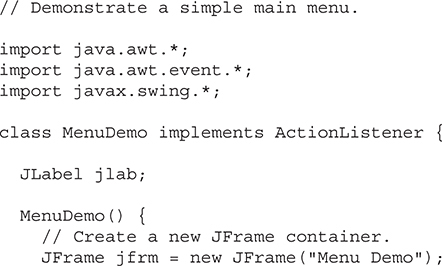
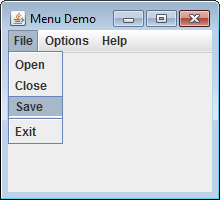
Figure 34-1 Sample output from the MenuDemo program
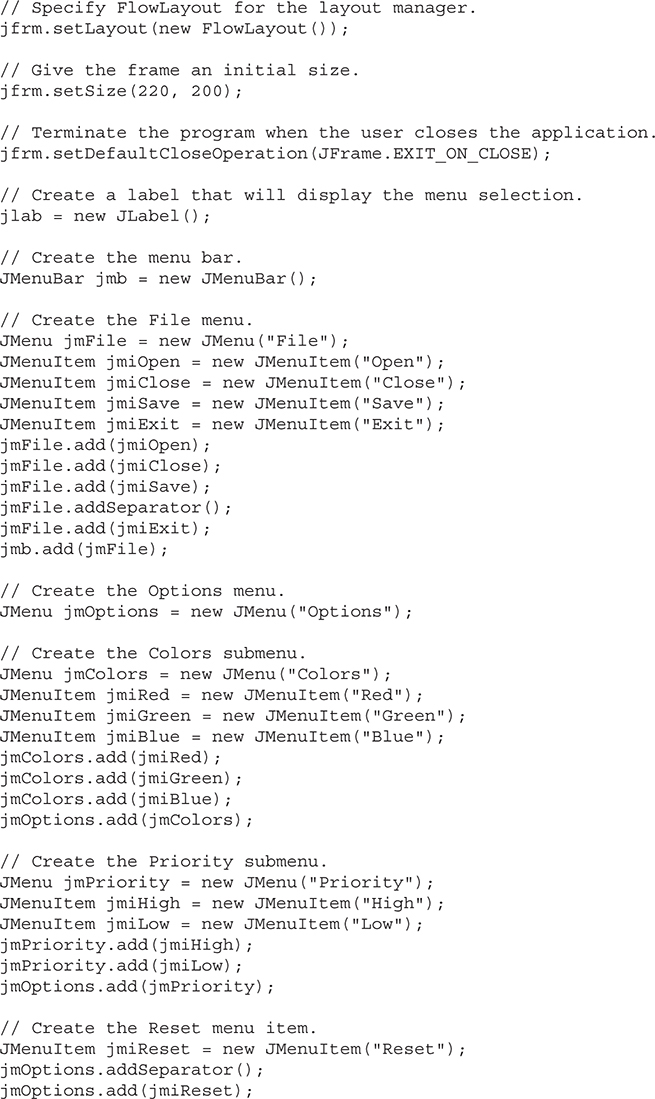
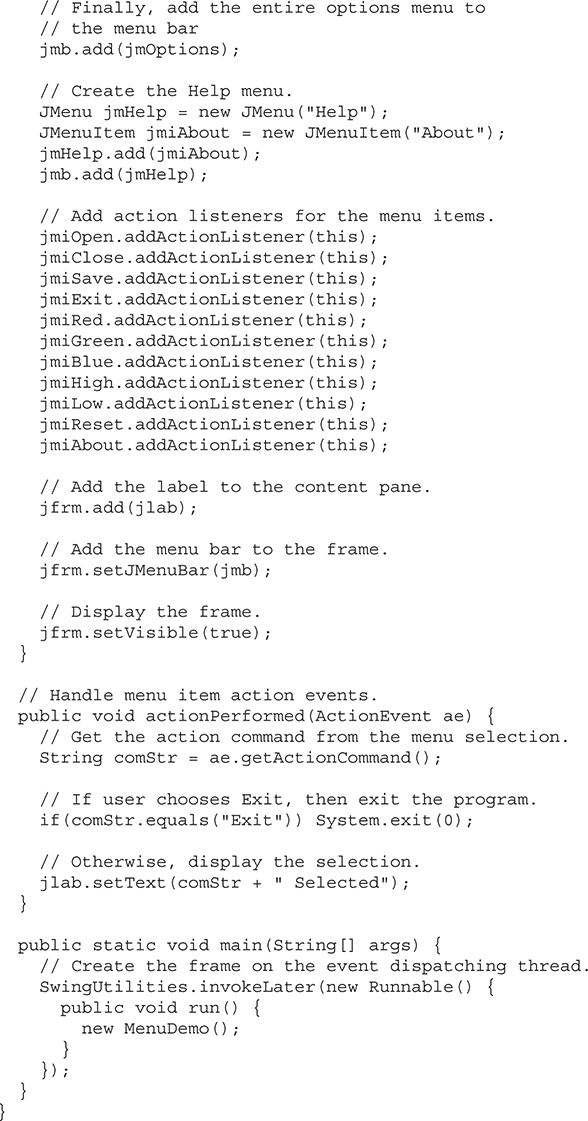
Let’s examine, in detail, how the menus in this program are created, beginning with the MenuDemo constructor. It starts by creating a JFrame and setting its layout manager, size, and default close operation. (These operations are described in Chapter 32.) A JLabel is then constructed. It will be used to display a menu selection. Next, the menu bar is constructed and a reference to it is assigned to jmb by this statement:
// Create the menu bar.
JMenuBar jmb = new JMenuBar();
Then, the File menu jmFile and its menu entries are created by this sequence:
// Create the File menu.
JMenu jmFile = new JMenu("File");
JMenuItem jmiOpen = new JMenuItem("Open");
JMenuItem jmiClose = new JMenuItem("Close");
JMenuItem jmiSave = new JMenuItem("Save");
JMenuItem jmiExit = new JMenuItem("Exit");
The names Open, Close, Save, and Exit will be shown as selections in the menu. Next, the menu entries are added to the file menu by this sequence:
jmFile.add(jmiOpen);
jmFile.add(jmiClose);
jmFile.add(jmiSave);
jmFile.addSeparator();
jmFile.add(jmiExit);
Finally, the File menu is added to the menu bar with this line:
jmb.add(jmFile);
Once the preceding code sequence completes, the menu bar will contain one entry: File. The File menu will contain four selections in this order: Open, Close, Save, and Exit. However, notice that a separator has been added before Exit. This visually separates Exit from the preceding three selections.
The Options menu is constructed using the same basic process as the File menu. However, the Options menu consists of two submenus, Colors and Priority, and a Reset entry. The submenus are first constructed individually and then added to the Options menu. The Reset item is added last. Then, the Options menu is added to the menu bar. The Help menu is constructed using the same process.
Notice that MenuDemo implements the ActionListener interface and action events generated by a menu selection are handled by the actionPerformed( ) method defined by MenuDemo. Therefore, the program adds this as the action listener for the menu items. Notice that no listeners are added to the Colors or Priority items because they are not actually selections. They simply activate submenus.
Finally, the menu bar is added to the frame by the following line:
jfrm.setJMenuBar(jmb);
As mentioned, menu bars are not added to the content pane. They are added directly to the JFrame.
The actionPerformed( ) method handles the action events generated by the menu. It obtains the action command string associated with the selection by calling getActionCommand( ) on the event. It stores a reference to this string in comStr. Then, it tests the action command against "Exit", as shown here:
if(comStr.equals("Exit")) System.exit(0);
If the action command is "Exit", then the program terminates by calling System.exit( ). This method causes the immediate termination of a program and passes its argument as a status code to the calling process, which is usually the operating system. By convention, a status code of zero means normal termination. Anything else indicates that the program terminated abnormally. For all other menu selections, the choice is displayed.
At this point, you might want to experiment a bit with the MenuDemo program. Try adding another menu or adding additional items to an existing menu. It is important that you understand the basic menu concepts before moving on because this program will evolve throughout the course of this chapter.
The menu created in the preceding example is functional, but it is possible to make it better. In real applications, a menu usually includes support for keyboard shortcuts because they give an experienced user the ability to select menu items rapidly. Keyboard shortcuts come in two forms: mnemonics and accelerators. As it applies to menus, a mnemonic defines a key that lets you select an item from an active menu by typing the key. Thus, a mnemonic allows you to use the keyboard to select an item from a menu that is already being displayed. An accelerator is a key that lets you select a menu item without having to first activate the menu.
A mnemonic can be specified for both JMenuItem and JMenu objects. There are two ways to set the mnemonic for JMenuItem. First, it can be specified when an object is constructed using this constructor:
JMenuItem(String name, int mnem)
In this case, the name is passed in name and the mnemonic is passed in mnen. Second, you can set the mnemonic by calling setMnemonic( ). To specify a mnemonic for JMenu, you must call setMnemonic( ). This method is inherited by both classes from AbstractButton and is shown next:
void setMnemonic(int mnem)
Here, mnem specifies the mnemonic. It should be one of the constants defined in java.awt.event.KeyEvent, such as KeyEvent.VK_F or KeyEvent.VK_Z. (There is another version of setMnemonic( ) that takes a char argument, but it is considered obsolete.) Mnemonics are not case sensitive, so in the case of VK_A, typing either a or A will work.
By default, the first matching letter in the menu item will be underscored. In cases in which you want to underscore a letter other than the first match, specify the index of the letter as an argument to setDisplayedMnemonicIndex( ), which is inherited by both JMenu and JMenuItem from AbstractButton. It is shown here:
void setDisplayedMnemonicIndex(int idx)
The index of the letter to underscore is specified by idx.
An accelerator can be associated with a JMenuItem object. It is specified by calling setAccelerator( ), shown next:
void setAccelerator(KeyStroke ks)
Here, ks is the key combination that is pressed to select the menu item. KeyStroke is a class that contains several factory methods that construct various types of keystroke accelerators. The following are three examples:
static KeyStroke getKeyStroke(char ch)
static KeyStroke getKeyStroke(Character ch, int modifier)
static KeyStroke getKeyStroke(int ch, int modifier)
Here, ch specifies the accelerator character. In the first version, the character is specified as a char value. In the second, it is specified as an object of type Character. In the third, it is a value of type KeyEvent, previously described. The value of modifier must be one or more of the following constants, defined in the java.awt.event.InputEvent class:

Therefore, if you pass VK_A for the key character and InputEvent.CTRL_DOWN_MASK for the modifier, the accelerator key combination is CTRL-A.
The following sequence adds both mnemonics and accelerators to the File menu created by the MenuDemo program in the previous section. After making this change, you can select the File menu by typing ALT-F. Then, you can use the mnemonics O, C, S, or E to select an option. Alternatively, you can directly select a File menu option by pressing CTRL-O, CTRL-C, CTRL-S, or CTRL-E. Figure 34-2 shows how this menu looks when activated.

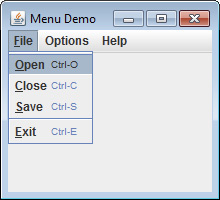
Figure 34-2 The File menu after adding mnemonics and accelerators
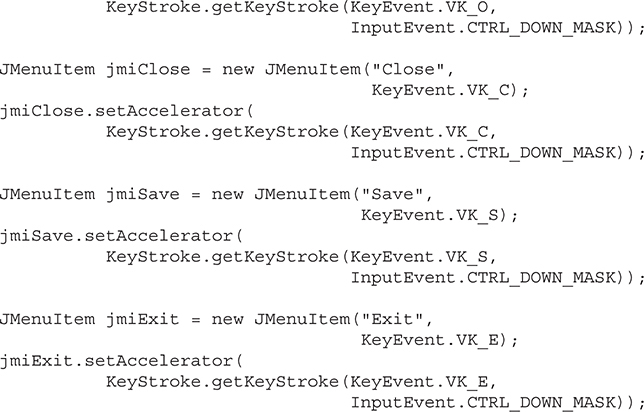
You can add images to menu items or use images instead of text. The easiest way to add an image is to specify it when the menu item is being constructed using one of these constructors:
JMenuItem(Icon image)
JMenuItem(String name, Icon image)
The first creates a menu item that displays the image specified by image. The second creates a menu item with the name specified by name and the image specified by image. For example, here the About menu item is associated with an image when it is created:
ImageIcon icon = new ImageIcon("AboutIcon.gif");
JMenuItem jmiAbout = new JMenuItem("About", icon);
After this addition, the icon specified by icon will be displayed next to the text "About" when the Help menu is displayed. This is shown in Figure 34-3. You can also add an icon to a menu item after the item has been created by calling setIcon( ), which is inherited from AbstractButton. You can specify the horizontal alignment of the image relative to the text by calling setHorizontalTextPosition( ).
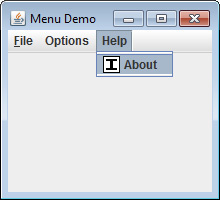
Figure 34-3 The About item with the addition of an icon
You can specify a disabled icon, which is shown when the menu item is disabled, by calling setDisabledIcon( ). Normally, when a menu item is disabled, the default icon is shown in gray. If a disabled icon is specified, then that icon is displayed when the menu item is disabled.
A tooltip is a small message that describes an item. It is automatically displayed if the mouse remains over the item for a moment. You can add a tooltip to a menu item by calling setToolTipText( ) on the item, specifying the text you want displayed. It is shown here:
void setToolTipText(String msg)
In this case, msg is the string that will be displayed when the tooltip is activated. For example, this creates a tooltip for the About item:
jmiAbout.setToolTipText("Info about the MenuDemo program.");
As a point of interest, setToolTipText( ) is inherited by JMenuItem from JComponent. This means you can add a tooltip to other types of components, such as a push button. You might want to try this on your own.
Although the type of menu items used by the preceding examples are, as a general rule, the most commonly used, Swing defines two others: check boxes and radio buttons. These items can streamline a GUI by allowing a menu to provide functionality that would otherwise require additional, stand-alone components. Also, sometimes, including check boxes or radio buttons in a menu simply seems the most natural place for a specific set of features. Whatever your reason, Swing makes it easy to use check boxes and radio buttons in menus, and both are examined here.
To add a check box to a menu, create a JCheckBoxMenuItem. It defines several constructors. This is the one used in this chapter:
JCheckBoxMenuItem(String name)
Here, name specifies the name of the item. The initial state of the check box is unchecked. If you want to specify the initial state, you can use this constructor:
JCheckBoxMenuItem(String name, boolean state)
In this case, if state is true, the box is initially checked. Otherwise, it is cleared. JCheckBoxMenuItem also provides constructors that let you specify an icon. Here is one example:
JCheckBoxMenuItem(String name, Icon icon)
In this case, name specifies the name of the item and the image associated with the item is passed in icon. The item is initially unchecked. Other constructors are also supported.
Check boxes in menus work like stand-alone check boxes. For example, they generate action events and item events when their state changes. Check boxes are especially useful in menus when you have options that can be selected and you want to display their selected/deselected status.
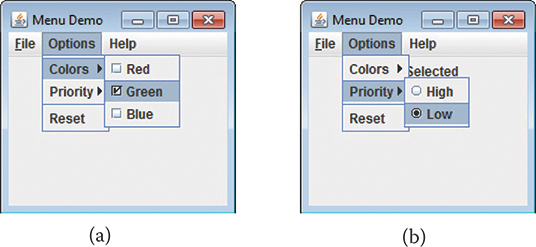
Figure 34-4 The effects of check box (a) and radio button (b) menu items
A radio button can be added to a menu by creating an object of type JRadioButtonMenuItem. JRadioButtonMenuItem inherits JMenuItem. It provides a rich assortment of constructors. The ones used in this chapter are shown here:
JRadioButtonMenuItem(String name)
JRadioButtonMenuItem(String name, boolean state)
The first constructor creates an unselected radio button menu item that is associated with the name passed in name. The second lets you specify the initial state of the button. If state is true, the button is initially selected. Otherwise, it is deselected. Other constructors let you specify an icon. Here is one example:
JRadioButtonMenuItem(String name, Icon icon, boolean state)
This creates a radio button menu item that is associated with the name passed in name and the image passed in icon. If state is true, the button is initially selected. Otherwise, it is deselected. Several other constructors are supported.
A JRadioButtonMenuItem works like a stand-alone radio button, generating item and action events. Like stand-alone radio buttons, menu-based radio buttons must be put into a button group in order for them to exhibit mutually exclusive selection behavior.
Because both JCheckBoxMenuItem and JRadioButtonMenuItem inherit JMenuItem, each has all of the functionality provided by JMenuItem. Aside from having the extra capabilities of check boxes and radio buttons, they act like and are used like other menu items.
To try check box and radio button menu items, first remove the code that creates the Options menu in the MenuDemo example program. Then substitute the following code sequence, which uses check boxes for the Colors submenu and radio buttons for the Priority submenu. After making the substitution, the Options menu will look like those shown in Figure 34-4.
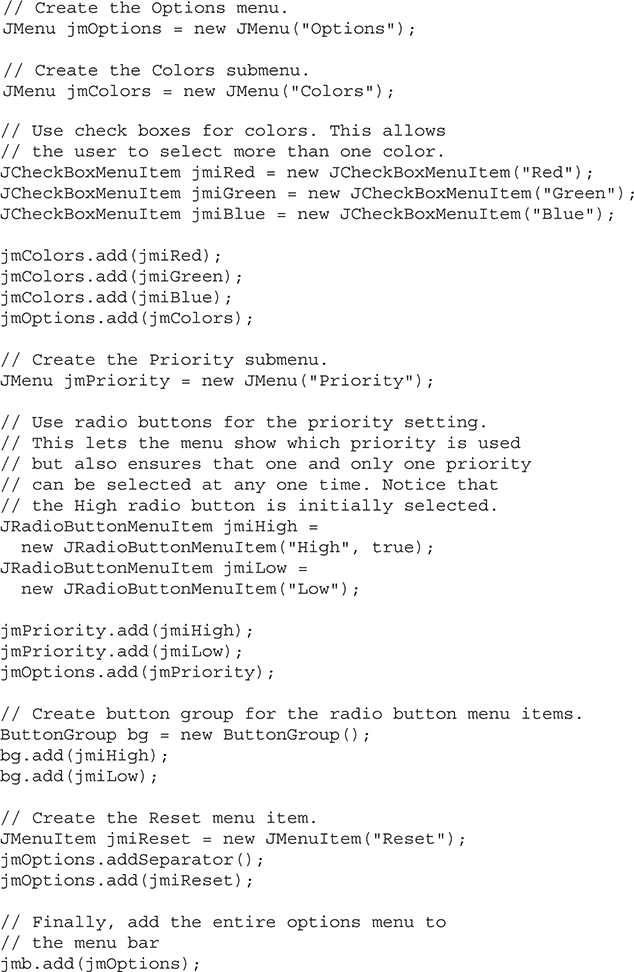
A popular alternative or addition to the menu bar is the popup menu. Typically, a popup menu is activated by clicking the right mouse button when over a component. Popup menus are supported in Swing by the JPopupMenu class. JPopupMenu has two constructors. In this chapter, only the default constructor is used:
JPopupMenu( )
It creates a default popup menu. The other constructor lets you specify a title for the menu. Whether this title is displayed is subject to the look and feel.
In general, popup menus are constructed like regular menus. First, create a JPopupMenu object, and then add menu items to it. Menu item selections are also handled in the same way: by listening for action events. The main difference between a popup menu and regular menu is the activation process.
Activating a popup menu requires three steps:
1. You must register a listener for mouse events.
2. Inside the mouse event handler, you must watch for the popup trigger.
3. When a popup trigger is received, you must show the popup menu by calling show( ).
Let’s examine each of these steps closely.
A popup menu is normally activated by clicking the right mouse button when the mouse pointer is over a component for which a popup menu is defined. Thus, the popup trigger is usually caused by right-clicking the mouse on a popup menu–enabled component. To listen for the popup trigger, implement the MouseListener interface and then register the listener by calling the addMouseListener( ) method. As described in Chapter 25, MouseListener defines the methods shown here:
void mouseClicked(MouseEvent me)
void mouseEntered(MouseEvent me)
void mouseExited(MouseEvent me)
void mousePressed(MouseEvent me)
void mouseReleased(MouseEvent me)
Of these, two are very important relative to the popup menu: mousePressed( ) and mouseReleased( ). Depending on the installed look and feel, either of these two events can trigger a popup menu. For this reason, it is often easier to use a MouseAdapter to implement the MouseListener interface and simply override mousePressed( ) and mouseReleased( ).
The MouseEvent class defines several methods, but only four are commonly needed when activating a popup menu. They are shown here:
int getX( )
int getY( )
boolean isPopupTrigger( )
Component getComponent( )
The current X,Y location of the mouse relative to the source of the event is found by calling getX( ) and getY( ). These are used to specify the upper-left corner of the popup menu when it is displayed. The isPopupTrigger( ) method returns true if the mouse event represents a popup trigger and false otherwise. You will use this method to determine when to pop up the menu. To obtain a reference to the component that generated the mouse event, call getComponent( ).
To actually display the popup menu, call the show( ) method defined by JPopupMenu, shown next:
void show(Component invoker, int upperX, int upperY)
Here, invoker is the component relative to which the menu will be displayed. The values of upperX and upperY define the X,Y location of the upper-left corner of the menu, relative to invoker. A common way to obtain the invoker is to call getComponent( ) on the event object passed to the mouse event handler.
The preceding theory can be put into practice by adding a popup Edit menu to the MenuDemo program shown at the start of this chapter. This menu will have three items called Cut, Copy, and Paste. Begin by adding the following instance variable to MenuDemo:
JPopupMenu jpu;
The jpu variable will hold a reference to the popup menu.
Next, add the following code sequence to the MenuDemo constructor:
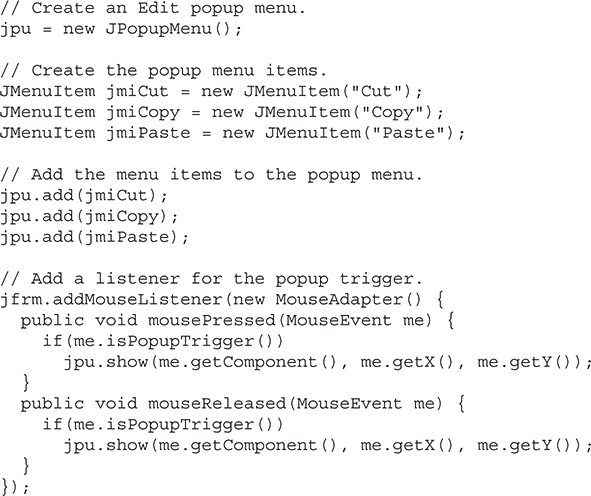
This sequence begins by constructing an instance of JPopupMenu and storing it in jpu. Then, it creates the three menu items, Cut, Copy, and Paste, in the usual way, and adds them to jpu. This finishes the construction of the popup Edit menu. Popup menus are not added to the menu bar or any other object.
Next, a MouseListener is added by creating an anonymous inner class. This class is based on the MouseAdapter class, which means that the listener need only override those methods that are relevant to the popup menu: mousePressed( ) and mouseReleased( ). The adapter provides default implementations of the other MouseListener methods. Notice that the mouse listener is added to jfrm. This means that a right-button click inside any part of the content pane will trigger the popup menu.
The mousePressed( ) and mouseReleased( ) methods call isPopupTrigger( ) to determine if the mouse event is a popup trigger event. If it is, the popup menu is displayed by calling show( ). The invoker is obtained by calling getComponent( ) on the mouse event. In this case, the invoker will be the content pane. The X,Y coordinates of the upper-left corner are obtained by calling getX( ) and getY( ). This makes the menu pop up with its upper-left corner directly under the mouse pointer.
Finally, you also need to add these action listeners to the program. They handle the action events fired when the user selects an item from the popup menu.
jmiCut.addActionListener(this);
jmiCopy.addActionListener(this);
jmiPaste.addActionListener(this);
After you have made these additions, the popup menu can be activated by clicking the right mouse button anywhere inside the content pane of the application. Figure 34-5 shows the result.
One other point about the preceding example. Because the invoker of the popup menu is always jfrm, in this case, you could pass it explicitly rather than calling getComponent( ). To do so, you must make jfrm into an instance variable of the MenuDemo class (rather than a local variable) so that it is accessible to the inner class. Then you can use this call to show( ) to display the popup menu:
jpu.show(jfrm, me.getX(), me.getY());
Although this works in this example, the advantage of using getComponent( ) is that the popup menu will automatically pop up relative to the invoking component. Thus, the same code could be used to display any popup menu relative to its invoking object.
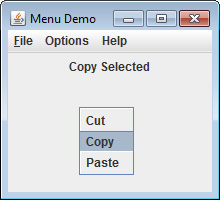
Figure 34-5 A popup Edit menu
A toolbar is a component that can serve as both an alternative and as an adjunct to a menu. A toolbar contains a list of buttons (or other components) that give the user immediate access to various program options. For example, a toolbar might contain buttons that select various font options, such as bold, italics, highlight, or underline. These options can be selected without needing to drop through a menu. Typically, toolbar buttons show icons rather than text, although either or both are allowed. Furthermore, tooltips are often associated with icon-based toolbar buttons. Toolbars can be positioned on any side of a window by dragging the toolbar, or they can be dragged out of the window entirely, in which case they become free floating.
In Swing, toolbars are instances of the JToolBar class. Its constructors enable you to create a toolbar with or without a title. You can also specify the layout of the toolbar, which will be either horizontal or vertical. The JToolBar constructors are shown here:
JToolBar( )
JToolBar(String title)
JToolBar(int how)
JToolBar(String title, int how)
The first constructor creates a horizontal toolbar with no title. The second creates a horizontal toolbar with the title specified by title. The title will show only when the toolbar is dragged out of its window. The third creates a toolbar that is oriented as specified by how. The value of how must be either JToolBar.VERTICAL or JToolBar.HORIZONTAL. The fourth constructor creates a toolbar that has the title specified by title and is oriented as specified by how.
A toolbar is typically used with a window that uses a border layout. There are two reasons for this. First, it allows the toolbar to be initially positioned along one of the four border positions. Frequently, the top position is used. Second, it allows the toolbar to be dragged to any side of the window.
In addition to dragging the toolbar to different locations within a window, you can also drag it out of the window. Doing so creates an undocked toolbar. If you specify a title when you create the toolbar, then that title will be shown when the toolbar is undocked.
You add buttons (or other components) to a toolbar in much the same way that you add them to a menu bar. Simply call add( ). The components are shown in the toolbar in the order in which they are added.
Once you have created a toolbar, you do not add it to the menu bar (if one exists). Instead, you add it to the window container. As mentioned, typically you will add a toolbar to the top (that is, north) position of a border layout, using a horizontal orientation. The component that will be affected is added to the center of the border layout. Using this approach causes the program to begin running with the toolbar in the expected location. However, you can drag the toolbar to any of the other positions. Of course, you can also drag the toolbar out of the window.
To illustrate the toolbar, we will add one to the MenuDemo program. The toolbar will present three debugging options: set a breakpoint, clear a breakpoint, and resume program execution. Three steps are needed to add the toolbar.
First, remove this line from the program:
jfrm.setLayout(new FlowLayout());
By removing this line, the JFrame automatically uses a border layout.
Second, because BorderLayout is being used, change the line that adds the label jlab to the frame, as shown next:
jfrm.add(jlab, BorderLayout.CENTER);
This line explicitly adds jlab to the center of the border layout. (Explicitly specifying the center position is technically not necessary because, by default, components are added to the center when a border layout is used. However, explicitly specifying the center makes it clear to anyone reading the code that a border layout is being used and that jlab goes in the center.)
Next, add the following code, which creates the Debug toolbar:
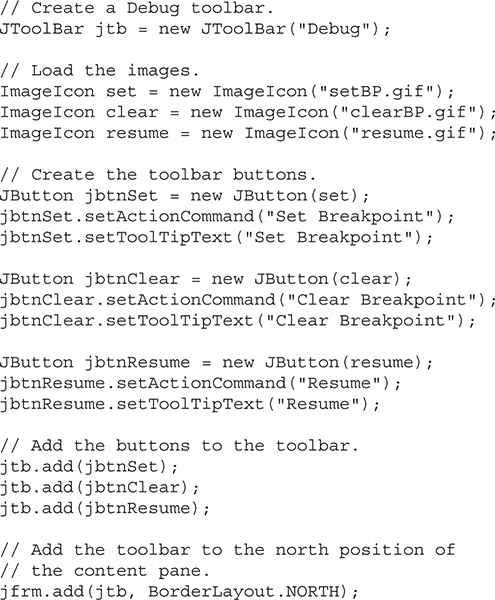
Let’s look at this code closely. First, a JToolBar is created and given the title "Debug". Then, a set of ImageIcon objects are created that hold the images for the toolbar buttons. Next, three toolbar buttons are created. Notice that each has an image, but no text. Also, each is explicitly given an action command and a tooltip. The action commands are set because the buttons are not given names when they are constructed. Tooltips are especially useful when applied to icon-based toolbar components because sometimes it’s hard to design images that are intuitive to all users. The buttons are then added to the toolbar, and the toolbar is added to the north side of the border layout of the frame.
Finally, add the action listeners for the toolbar, as shown here:
// Add the toolbar action listeners.
jbtnSet.addActionListener(this);
jbtnClear.addActionListener(this);
jbtnResume.addActionListener(this);
Each time the user presses a toolbar button, an action event is fired, and it is handled in the same way as the other menu-related events. Figure 34-6 shows the toolbar in action.
Often, a toolbar and a menu item contain items in common. For example, the same functions provided by the Debug toolbar in the preceding example might also be offered through a menu selection. In such a case, selecting an option (such as setting a breakpoint) causes the same action to occur, independently of whether the menu or the toolbar was used. Also, both the toolbar button and the menu item would (most likely) use the same icon. Furthermore, when a toolbar button is disabled, the corresponding menu item would also need to be disabled. Such a situation would normally lead to a fair amount of duplicated, interdependent code, which is less than optimal. Fortunately, Swing provides a solution: the action.
An action is an instance of the Action interface. Action extends the ActionListener interface and provides a means of combining state information with the actionPerformed( ) event handler. This combination allows one action to manage two or more components. For example, an action lets you centralize the control and handling of a toolbar button and a menu item. Instead of having to duplicate code, your program need only create an action that automatically handles both components.
Because Action extends ActionListener, an action must provide an implementation of the actionPerformed( ) method. This handler will process the action events generated by the objects linked to the action.
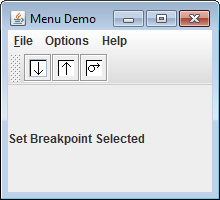
Figure 34-6 The Debug toolbar in action
In addition to the inherited actionPerformed( ) method, Action defines several methods of its own. One of particular interest is putValue( ). It sets the value of the various properties associated with an action and is shown here:
void putValue(String key, Object val)
It assigns val to the property specified by key that represents the desired property. Although not used by the example that follows, it is helpful to note that Action also supplies the getValue( ) method that obtains a specified property. It is shown here:
Object getValue(String key)
It returns a reference to the property specified by key.
The key values used by putValue( ) and getValue( ) include those shown here:
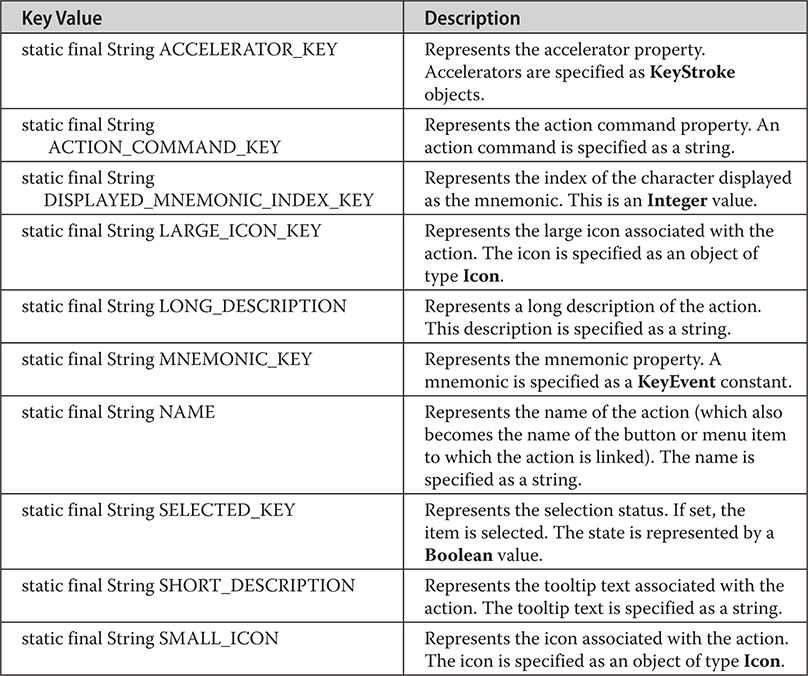
For example, to set the mnemonic to the letter X, use this call to putValue( ):
actionOb.putValue(MNEMONIC_KEY, KeyEvent.VK_X);
One Action property that is not accessible through putValue( ) and getValue( ) is the enabled/disabled status. For this, you use the setEnabled( ) and isEnabled( ) methods. They are shown here:
void setEnabled(boolean enabled)
boolean isEnabled( )
For setEnabled( ), if enabled is true, the action is enabled. Otherwise, it is disabled. If the action is enabled, isEnabled( ) returns true. Otherwise, it returns false.
Although you can implement all of the Action interface yourself, you won’t usually need to. Instead, Swing provides a partial implementation called AbstractAction that you can extend. By extending AbstractAction, you need implement only one method: actionPerformed( ). The other Action methods are provided for you. AbstractAction provides three constructors. The one used in this chapter is shown here:
AbstractAction(String name, Icon image)
It constructs an AbstractAction that has the name specified by name and the icon specified by image.
Once you have created an action, it can be added to a JToolBar and used to construct a JMenuItem. To add an action to a JToolBar, use this version of add( ):
JButton add(Action actObj)
Here, actObj is the action that is being added to the toolbar. The properties defined by actObj are used to create a toolbar button. To create a menu item from an action, use this JMenuItem constructor:
JMenuItem(Action actObj)
Here, actObj is the action used to construct a menu item according to its properties.
Note In addition to JToolBar and JMenuItem, actions are also supported by several other Swing components, such as JPopupMenu, JButton, JRadioButton, and JCheckBox. JRadioButtonMenuItem and JCheckBoxMenuItem also support actions.
To illustrate the benefit of actions, we will use them to manage the Debug toolbar created in the previous section. We will also add a Debug submenu under the Options main menu. The Debug submenu will contain the same selections as the Debug toolbar: Set Breakpoint, Clear Breakpoint, and Resume. The same actions that support these items in the toolbar will also support these items in the menu. Therefore, instead of having to create duplicate code to handle both the toolbar and menu, both are handled by the actions.
Begin by creating an inner class called DebugAction that extends AbstractAction, as shown here:
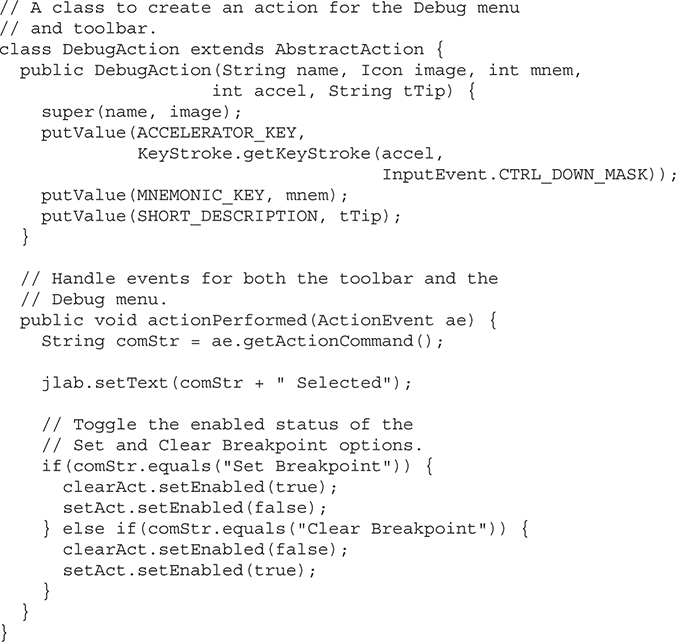
DebugAction extends AbstractAction. It creates an action class that will be used to define the properties associated with the Debug menu and toolbar. Its constructor has five parameters that let you specify the following items:
• Name
• Icon
• Mnemonic
• Accelerator
• Tooltip
The first two are passed to AbstractAction’s constructor via super. The other three properties are set through calls to putValue( ).
The actionPerformed( ) method of DebugAction handles events for the action. This means that when an instance of DebugAction is used to create a toolbar button and a menu item, events generated by either of those components are handled by the actionPerformed( ) method in DebugAction. Notice that this handler displays the selection in jlab. In addition, if the Set Breakpoint option is selected, then the Clear Breakpoint option is enabled and the Set Breakpoint option is disabled. If the Clear Breakpoint option is selected, then the Set Breakpoint option is enabled and the Clear Breakpoint option is disabled. This illustrates how an action can be used to enable or disable a component. When an action is disabled, it is disabled for all uses of that action. In this case, if Set Breakpoint is disabled, then it is disabled both in the toolbar and in the menu.
Next, add these DebugAction instance variables to MenuDemo:
DebugAction setAct;
DebugAction clearAct;
DebugAction resumeAct;
Next, create three ImageIcons that represent the Debug options, as shown here:
// Load the images for the actions.
ImageIcon setIcon = new ImageIcon("setBP.gif");
ImageIcon clearIcon = new ImageIcon("clearBP.gif");
ImageIcon resumeIcon = new ImageIcon("resume.gif");
Now, create the actions that manage the Debug options, as shown here:
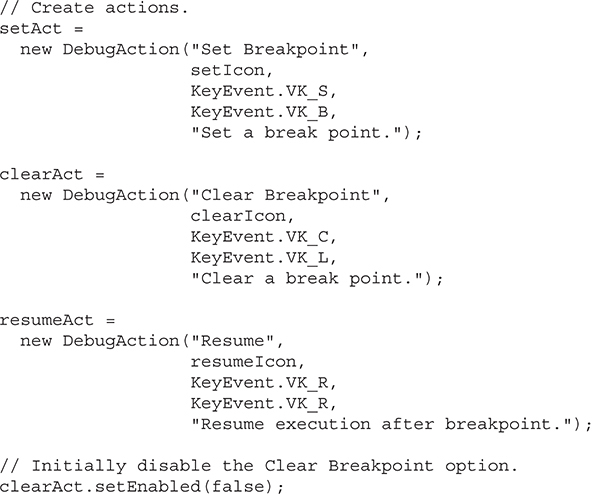
Notice that the accelerator for Set Breakpoint is B and the accelerator for Clear Breakpoint is L. The reason these keys are used rather than S and C is that these keys are already allocated by the File menu for Save and Close. However, they can still be used as mnemonics because each mnemonic is localized to its own menu. Also notice that the action that represents Clear Breakpoint is initially disabled. It will be enabled only after a breakpoint has been set.
Next, use the actions to create buttons for the toolbar and then add those buttons to the toolbar, as shown here:
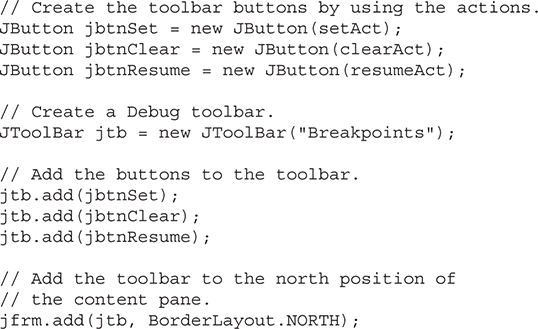
Finally, create the Debug menu, as shown next:
// Now, create a Debug menu that goes under the Options
// menu bar item. Use the actions to create the items.
JMenu jmDebug = new JMenu("Debug");
JMenuItem jmiSetBP = new JMenuItem(setAct);
JMenuItem jmiClearBP = new JMenuItem(clearAct);
JMenuItem jmiResume = new JMenuItem(resumeAct);
jmDebug.add(jmiSetBP);
jmDebug.add(jmiClearBP);
jmDebug.add(jmiResume);
jmOptions.add(jmDebug);
After making these changes and additions, the actions that you created will be used to manage both the Debug menu and the toolbar. Thus, changing a property in the action (such as disabling it) will affect all uses of that action. The program will now look as shown in Figure 34-7.
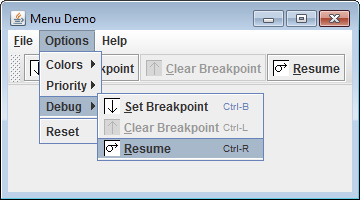
Figure 34-7 Using actions to manage the Debug toolbar and menu
Throughout the course of this discussion, many changes and additions have been made to the MenuDemo program shown at the start of the chapter. Before concluding, it will be helpful to assemble all the pieces. Doing so not only eliminates any ambiguity about the way the pieces fit together, but it also gives you a complete menu demonstration program that you can experiment with.
The following version of MenuDemo includes all of the additions and enhancements described in this chapter. For clarity, the program has been reorganized, with separate methods being used to construct the various menus and toolbar. Notice that several of the menu-related variables, such as jmb, jmFile, and jtb, have been made into instance variables.
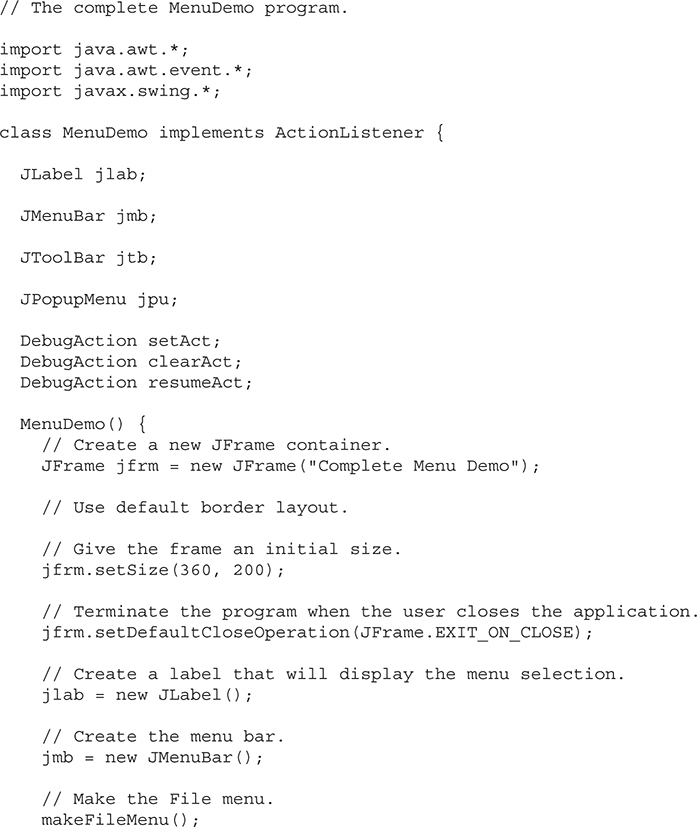
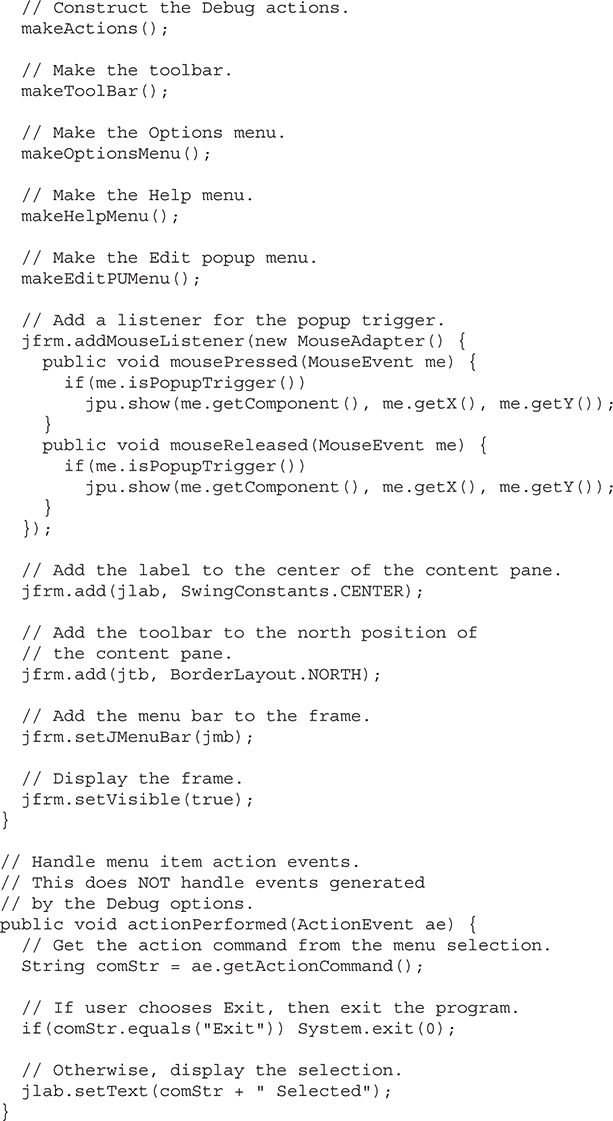
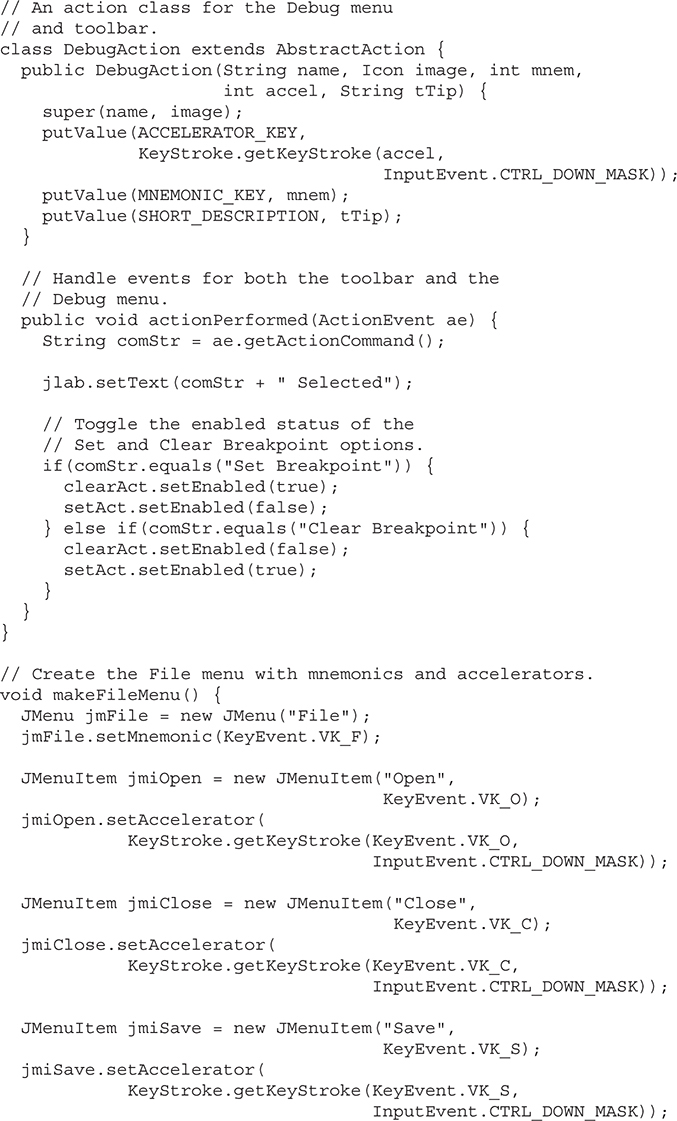
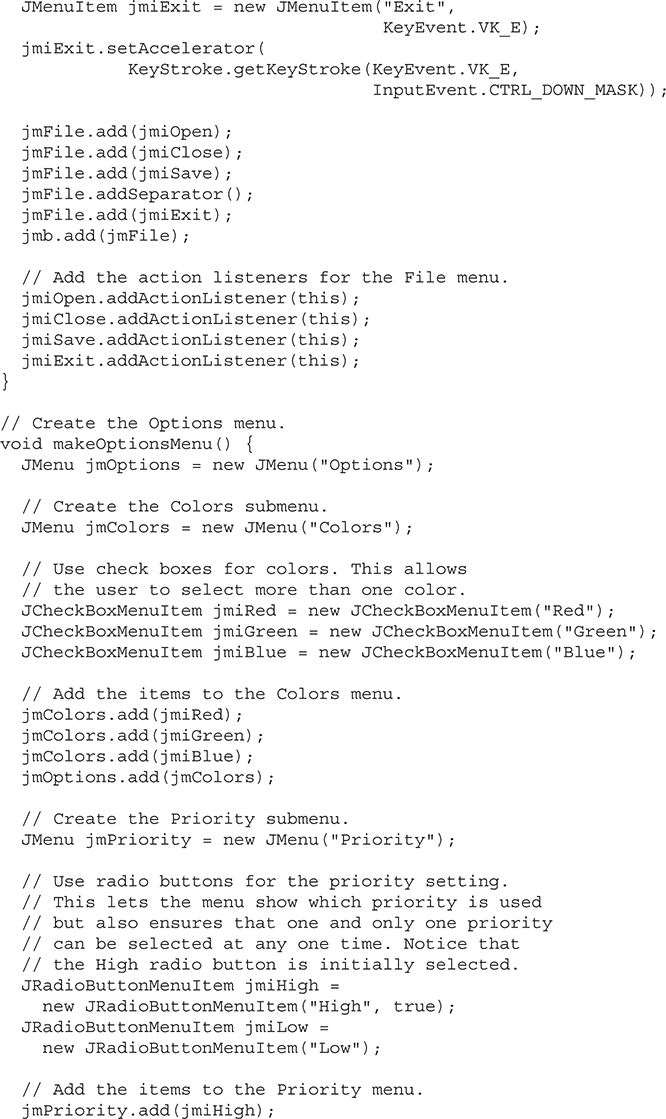
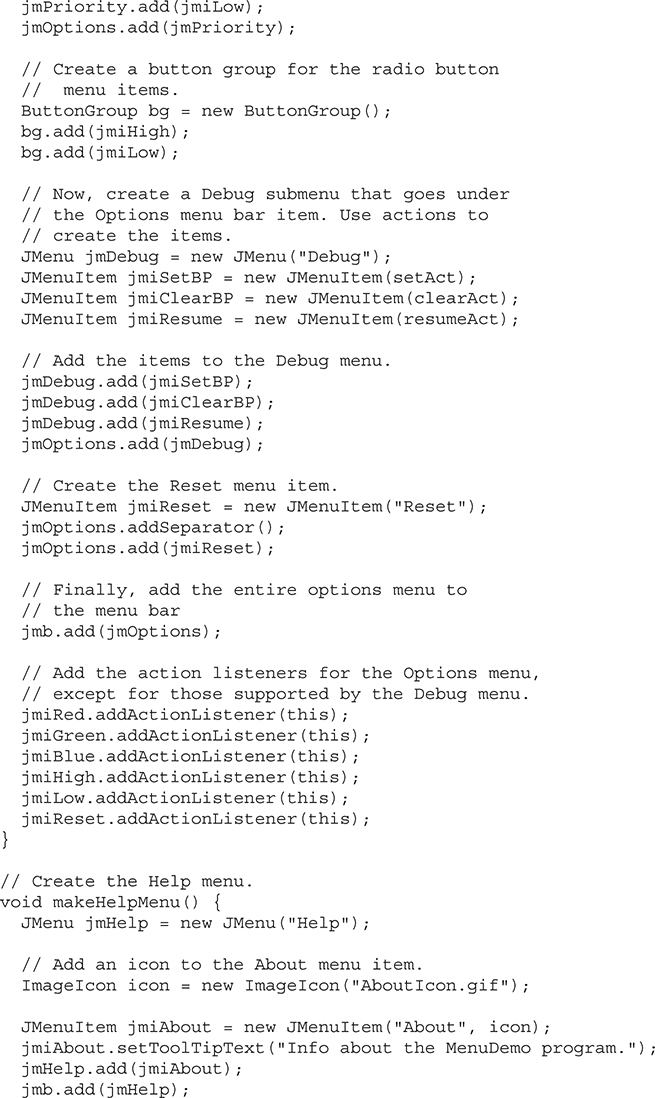
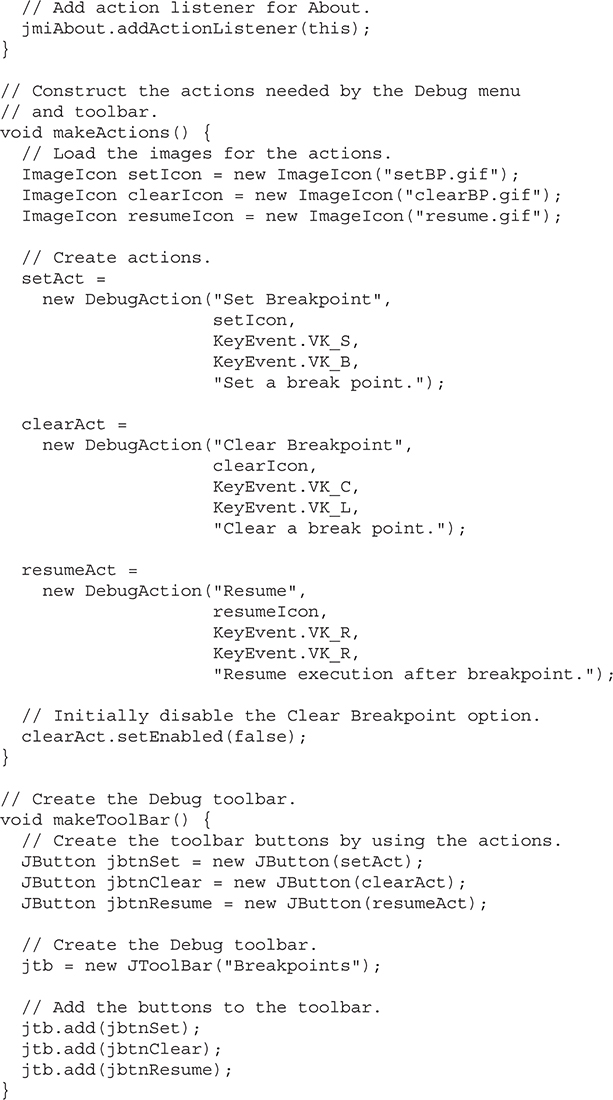
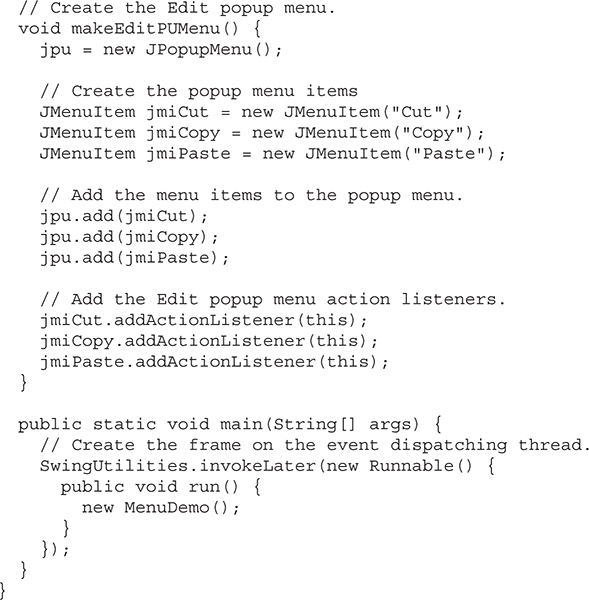
Swing defines a very large GUI toolkit. It has many more features that you will want to explore on your own. For example, it supplies dialog classes, such as JOptionPane and JDialog, that you can use to streamline the construction of dialog windows. It also provides additional controls beyond those introduced in Chapter 33. Two you will want to explore are JSpinner (which creates a spin control) and JFormattedTextField (which supports formatted text). You will also want to experiment with defining your own models for the various components. Frankly, the best way to become familiar with Swing’s capabilities is to experiment with it.
This chapter provides an overview of creating Java Beans. Beans are important because they allow you to build complex systems from software components. These components may be provided by you or supplied by one or more different vendors. Java Beans use an architecture called JavaBeans that specifies how these building blocks can operate together.
To better understand the value of Beans, consider the following. Hardware designers have a wide variety of components that can be integrated together to construct a system. Resistors, capacitors, and inductors are examples of simple building blocks. Integrated circuits provide more advanced functionality. All of these different parts can be reused. It is not necessary or possible to rebuild these capabilities each time a new system is needed. Also, the same pieces can be used in different types of circuits. This is possible because the behavior of these components is understood and documented.
The software industry also sought the benefits of reusability and interoperability of a component-based approach. To realize these benefits, a component architecture is needed that allows programs to be assembled from software building blocks, perhaps provided by different vendors. It must also be possible for a designer to select a component, understand its capabilities, and incorporate it into an application. When a new version of a component becomes available, it should be easy to incorporate this functionality into existing code. JavaBeans provides just such an architecture.
A Java Bean is a software component that has been designed to be reusable in a variety of different environments. There is no restriction on the capability of a Bean. It may perform a simple function, such as obtaining an inventory value, or a complex function, such as forecasting the performance of a stock portfolio. A Bean may be visible to an end user. One example of this is a button on a graphical user interface. A Bean may also be invisible to a user. Software to decode a stream of multimedia information in real time is an example of this type of building block. Finally, a Bean may be designed to work autonomously on a user’s workstation or to work in cooperation with a set of other distributed components. Software to generate a pie chart from a set of data points is an example of a Bean that can execute locally. However, a Bean that provides real-time price information from a stock or commodities exchange would need to work in cooperation with other distributed software to obtain its data.
The following list enumerates some of the benefits that JavaBeans technology provides for a component developer:
• A Bean obtains all the benefits of Java’s “write-once, run-anywhere” paradigm.
• The properties, events, and methods of a Bean that are exposed to another application can be controlled.
• Auxiliary software can be provided to help configure a Bean. This software is only needed when the design-time parameters for that component are being set. It does not need to be included in the run-time environment.
• The state of a Bean can be saved in persistent storage and restored at a later time.
• A Bean may register to receive events from other objects and can generate events that are sent to other objects.
At the core of Bean programming is introspection. This is the process of analyzing a Bean to determine its capabilities. This is an essential feature of the JavaBeans API because it allows another application, such as a design tool, to obtain information about a component. Without introspection, the JavaBeans technology could not operate.
There are two ways in which the developer of a Bean can indicate which of its properties, events, and methods should be exposed. With the first method, simple naming conventions are used. These allow the introspection mechanisms to infer information about a Bean. In the second way, an additional class that extends the BeanInfo interface is provided that explicitly supplies this information. Both approaches are examined here.
A property is a subset of a Bean’s state. The values assigned to the properties determine the behavior and appearance of that component. A property is set through a setter method. A property is obtained by a getter method. There are two types of properties: simple and indexed.
A simple property has a single value. It can be identified by the following design patterns, where N is the name of the property and T is its type:
public T getN( )
public void setN(T arg)
A read/write property has both of these methods to access its values. A read-only property has only a get method. A write-only property has only a set method.
Here are three read/write simple properties along with their getter and setter methods:
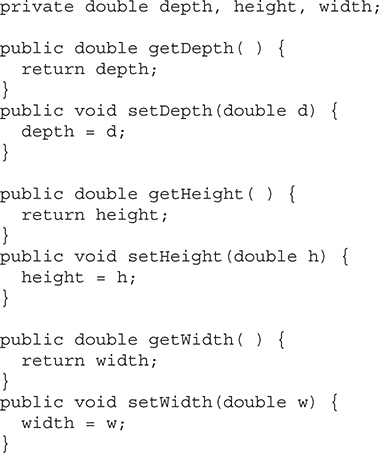
Note For a boolean property, a method of the form isPropertyName( ) can also be used as an accessor.
An indexed property consists of multiple values. It can be identified by the following design patterns, where N is the name of the property and T is its type:
public T getN(int index);
public void setN(int index, T value);
public T[ ] getN( );
public void setN(T[ ] values);
Here is an indexed property called data along with its getter and setter methods:
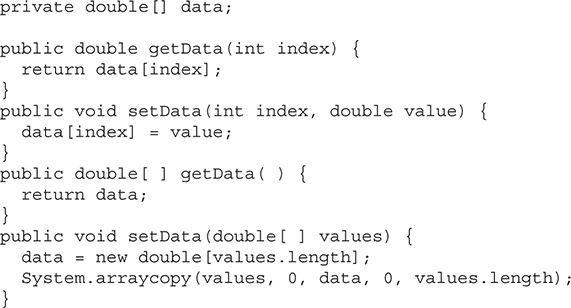
Beans use the delegation event model that was discussed earlier in this book. Beans can generate events and send them to other objects. These can be identified by the following design patterns, where T is the type of the event:
public void addTListener(TListener eventListener)
public void addTListener(TListener eventListener)
throws java.util.TooManyListenersException
public void removeTListener(TListener eventListener)
These methods are used to add or remove a listener for the specified event. The version of addTListener( ) that does not throw an exception can be used to multicast an event, which means that more than one listener can register for the event notification. The version that throws TooManyListenersException unicasts the event, which means that the number of listeners can be restricted to one. In either case, removeTListener( ) is used to remove the listener. For example, assuming an event interface type called TemperatureListener, a Bean that monitors temperature might supply the following methods:

Design patterns are not used for naming nonproperty methods. The introspection mechanism finds all of the public methods of a Bean. Protected and private methods are not presented.
As the preceding discussion shows, design patterns implicitly determine what information is available to the user of a Bean. The BeanInfo interface enables you to explicitly control what information is available. The BeanInfo interface defines several methods, including these:
PropertyDescriptor[ ] getPropertyDescriptors( )
EventSetDescriptor[ ] getEventSetDescriptors( )
MethodDescriptor[ ] getMethodDescriptors( )
They return arrays of objects that provide information about the properties, events, and methods of a Bean. The classes PropertyDescriptor, EventSetDescriptor, and MethodDescriptor are defined within the java.beans package, and they describe the indicated elements. By implementing these methods, a developer can designate exactly what is presented to a user, bypassing introspection based on design patterns.
When creating a class that implements BeanInfo, you must call that class bnameBeanInfo, where bname is the name of the Bean. For example, if the Bean is called MyBean, then the information class must be called MyBeanBeanInfo.
To simplify the use of BeanInfo, JavaBeans supplies the SimpleBeanInfo class. It provides default implementations of the BeanInfo interface, including the three methods just shown. You can extend this class and override one or more of the methods to explicitly control what aspects of a Bean are exposed. If you don’t override a method, then design-pattern introspection will be used. For example, if you don’t override getPropertyDescriptors( ), then design patterns are used to discover a Bean’s properties. You will see SimpleBeanInfo in action later in this chapter.
A Bean that has a bound property generates an event when the property is changed. The event is of type PropertyChangeEvent and is sent to objects that previously registered an interest in receiving such notifications. A class that handles this event must implement the PropertyChangeListener interface.
A Bean that has a constrained property generates an event when an attempt is made to change its value. It also generates an event of type PropertyChangeEvent. It too is sent to objects that previously registered an interest in receiving such notifications. However, those other objects have the ability to veto the proposed change by throwing a PropertyVetoException. This capability allows a Bean to operate differently according to its run-time environment. A class that handles this event must implement the VetoableChangeListener interface.
Persistence is the ability to save the current state of a Bean, including the values of a Bean’s properties and instance variables, to nonvolatile storage and to retrieve them at a later time. The object serialization capabilities provided by the Java class libraries are used to provide persistence for Beans.
The easiest way to serialize a Bean is to have it implement the java.io.Serializable interface, which is simply a marker interface. Implementing java.io.Serializable makes serialization automatic. Your Bean need take no other action. Automatic serialization can also be inherited. Therefore, if any superclass of a Bean implements java.io.Serializable, then automatic serialization is obtained.
When using automatic serialization, you can prevent a field from being saved through the use of the transient keyword. Thus, data members of a Bean specified as transient will not be serialized.
If a Bean does not implement java.io.Serializable, you must provide serialization yourself, such as by implementing java.io.Externalizable. Otherwise, containers cannot save the configuration of your component.
A Bean developer can provide a customizer that helps another developer configure the Bean. A customizer can provide a step-by-step guide through the process that must be followed to use the component in a specific context. Online documentation can also be provided. A Bean developer has great flexibility to develop a customizer that can differentiate his or her product in the marketplace.
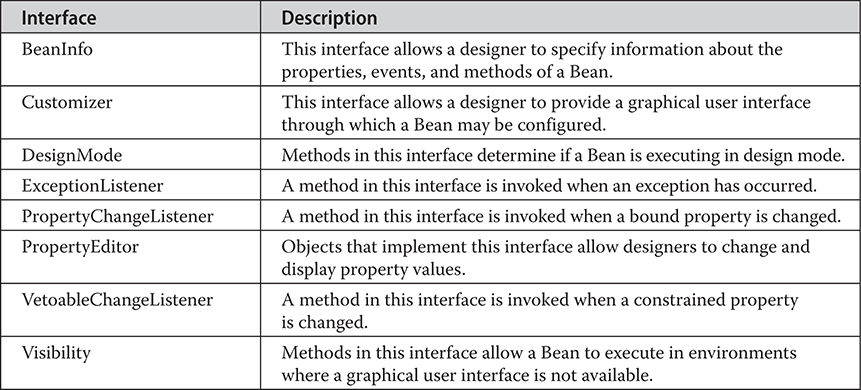
Table 35-1 The Non-Deprecated Interfaces in java.beans
The JavaBeans functionality is provided by a set of classes and interfaces in the java.beans package. Beginning with JDK 9, this package is in the java.desktop module. This section provides a brief overview of its contents. Table 35-1 lists the non-deprecated interfaces in java.beans and provides a brief description of their functionality. Table 35-2 lists the classes in java.beans.
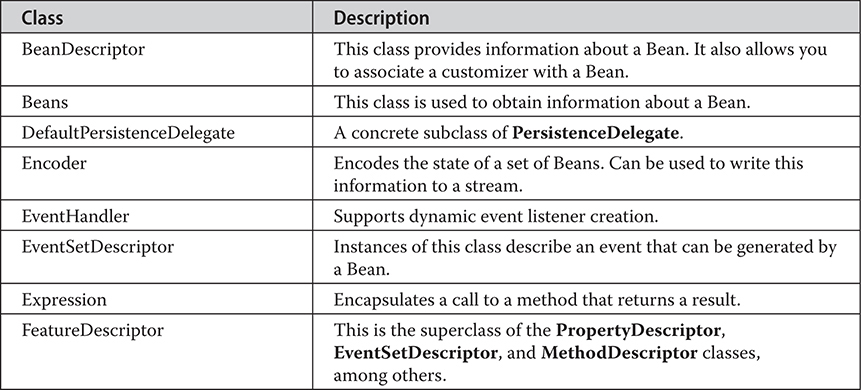
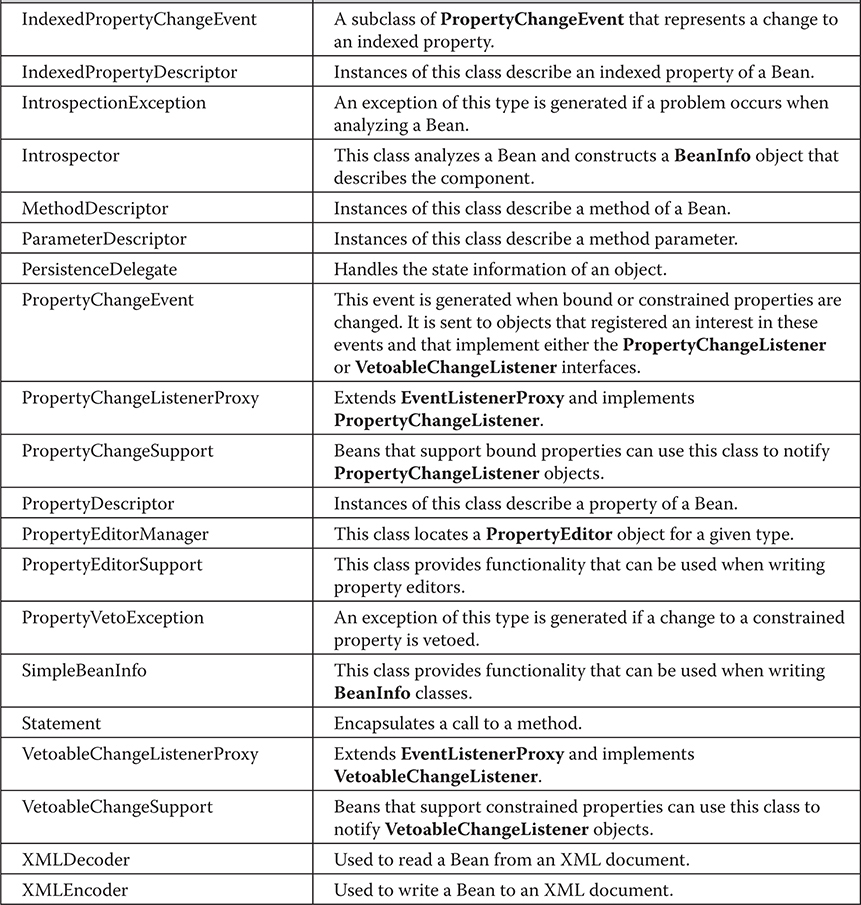
Table 35-2 The Classes in java.beans
Although it is beyond the scope of this chapter to discuss all of the classes, four are of particular interest: Introspector, PropertyDescriptor, EventSetDescriptor, and MethodDescriptor. Each is briefly examined here.
The Introspector class provides several static methods that support introspection. Of most interest is getBeanInfo( ). This method returns a BeanInfo object that can be used to obtain information about the Bean. The getBeanInfo( ) method has several forms, including the one shown here:
static BeanInfo getBeanInfo(Class<?> bean) throws IntrospectionException
The returned object contains information about the Bean specified by bean.
The PropertyDescriptor class describes the characteristics of a Bean property. It supports several methods that manage and describe properties. For example, you can determine if a property is bound by calling isBound( ). To determine if a property is constrained, call isConstrained( ). You can obtain the name of a property by calling getName( ).
The EventSetDescriptor class represents a set of Bean events. It supports several methods that obtain the methods that a Bean uses to add or remove event listeners, and to otherwise manage events. For example, to obtain the method used to add listeners, call getAddListenerMethod( ). To obtain the method used to remove listeners, call getRemoveListenerMethod( ). To obtain the type of a listener, call getListenerType( ). You can obtain the name of an event set by calling getName( ).
The MethodDescriptor class represents a Bean method. To obtain the name of the method, call getName( ). You can obtain information about the method by calling getMethod( ), shown here:
Method getMethod( )
An object of type Method that describes the method is returned.
This chapter concludes with an example that illustrates various aspects of Bean programming, including introspection and using a BeanInfo class. It also makes use of the Introspector, PropertyDescriptor, and EventSetDescriptor classes. The example uses three classes. The first is a Bean called Colors, shown here:
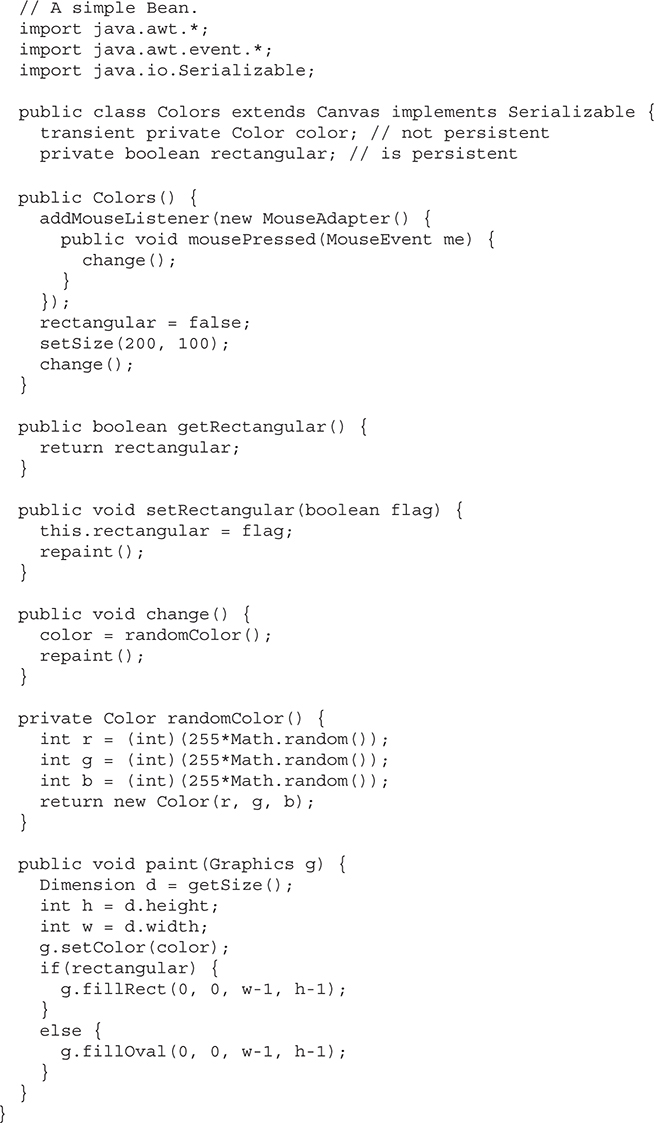
The Colors Bean displays a colored object within a frame. The color of the component is determined by the private Color variable color, and its shape is determined by the private boolean variable rectangular. The constructor defines an anonymous inner class that extends MouseAdapter and overrides its mousePressed( ) method. The change( ) method is invoked in response to mouse presses. It selects a random color and then repaints the component. The getRectangular( ) and setRectangular( ) methods provide access to the one property of this Bean. The change( ) method calls randomColor( ) to choose a color and then calls repaint( ) to make the change visible. Notice that the paint( ) method uses the rectangular and color variables to determine how to present the Bean.
The next class is ColorsBeanInfo. It is a subclass of SimpleBeanInfo that provides explicit information about Colors. It overrides getPropertyDescriptors( ) in order to designate which properties are presented to a Bean user. In this case, the only property exposed is rectangular. The method creates and returns a PropertyDescriptor object for the rectangular property. The PropertyDescriptor constructor that is used is shown here:
PropertyDescriptor(String property, Class<?> beanCls)
throws IntrospectionException
Here, the first argument is the name of the property, and the second argument is the class of the Bean.
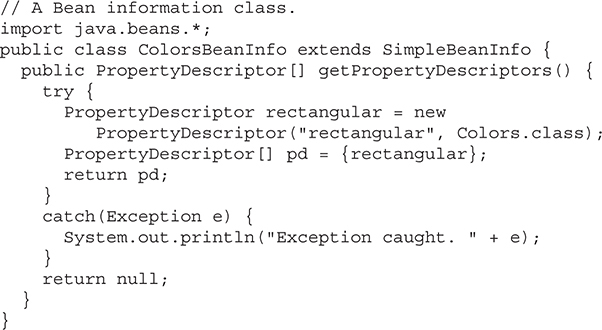
The final class is called IntrospectorDemo. It uses introspection to display the properties and events that are available within the Colors Bean.
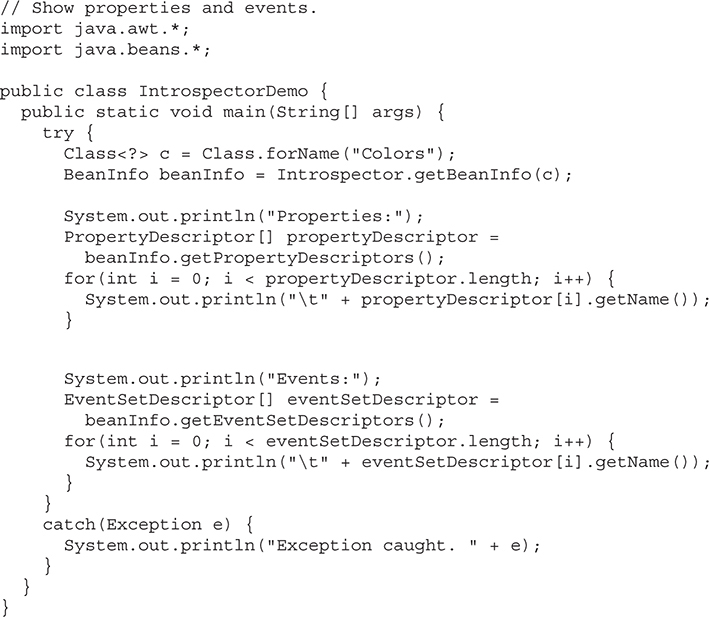
The output from this program is the following:
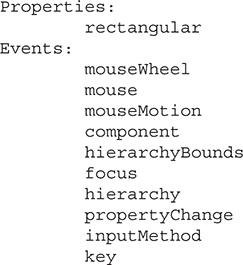
Notice two things in the output. First, because ColorsBeanInfo overrides getPropertyDescriptors( ) such that the only property returned is rectangular, only the rectangular property is displayed. However, because getEventSetDescriptors( ) is not overridden by ColorsBeanInfo, design-pattern introspection is used, and all events are found, including those in Colors’ superclass, Canvas. Remember, if you don’t override one of the “get” methods defined by SimpleBeanInfo, then the default, design-pattern introspection is used. To observe the difference that ColorsBeanInfo makes, erase its class file and then run IntrospectorDemo again. This time it will report more properties.
This chapter presents an introduction to servlets. Servlets are small programs that execute on the server side of a web connection. The topic of servlets is quite large, and it is beyond the scope of this chapter to cover it all. Instead, we will focus on the core concepts, interfaces, and classes, and develop several examples.
In order to understand the advantages of servlets, you must have a basic understanding of how web browsers and servers cooperate to provide content to a user. Consider a request for a static web page. A user enters a Uniform Resource Locator (URL) into a browser. The browser generates an HTTP request to the appropriate web server. The web server maps this request to a specific file. That file is returned in an HTTP response to the browser. The HTTP header in the response indicates the type of the content. The Multipurpose Internet Mail Extensions (MIME) are used for this purpose. For example, ordinary ASCII text has a MIME type of text/plain. The Hypertext Markup Language (HTML) source code of a web page has a MIME type of text/html.
Now consider dynamic content. Assume that an online store uses a database to store information about its business. This would include items for sale, prices, availability, orders, and so forth. It wishes to make this information accessible to customers via web pages. The contents of those web pages must be dynamically generated to reflect the latest information in the database.
In the early days of the Web, a server could dynamically construct a page by creating a separate process to handle each client request. The process would open connections to one or more databases in order to obtain the necessary information. It communicated with the web server via an interface known as the Common Gateway Interface (CGI). CGI allowed the separate process to read data from the HTTP request and write data to the HTTP response. A variety of different languages were used to build CGI programs. These included C, C++, and Perl.
However, CGI suffered serious performance problems. It was expensive in terms of processor and memory resources to create a separate process for each client request. It was also expensive to open and close database connections for each client request. In addition, the CGI programs were not platform-independent. Therefore, other techniques were introduced. Among these are servlets.
Servlets offer several advantages in comparison with CGI. First, performance is significantly better. Servlets execute within the address space of a web server. It is not necessary to create a separate process to handle each client request. Second, servlets are platform-independent because they are written in Java. Third, it is possible to enforce a set of restrictions to protect the resources on a server machine. Finally, the full functionality of the Java class libraries is available to a servlet. It can communicate with other software via the sockets and RMI mechanisms that you have seen already.
Three methods are central to the life cycle of a servlet. These are init( ), service( ), and destroy( ). They are implemented by every servlet and are invoked at specific times by the server. Let us consider a typical user scenario to understand when these methods are called.
First, assume that a user enters a Uniform Resource Locator (URL) to a web browser. The browser then generates an HTTP request for this URL. This request is then sent to the appropriate server.
Second, this HTTP request is received by the web server. The server maps this request to a particular servlet. The servlet is dynamically retrieved and loaded into the address space of the server.
Third, the server invokes the init( ) method of the servlet. This method is invoked only when the servlet is first loaded into memory. It is possible to pass initialization parameters to the servlet so it may configure itself.
Fourth, the server invokes the service( ) method of the servlet. This method is called to process the HTTP request. You will see that it is possible for the servlet to read data that has been provided in the HTTP request. It may also formulate an HTTP response for the client.
The servlet remains in the server’s address space and is available to process any other HTTP requests received from clients. The service( ) method is called for each HTTP request.
Finally, the server may decide to unload the servlet from its memory. The algorithms by which this determination is made are specific to each server. The server calls the destroy( ) method to relinquish any resources such as file handles that are allocated for the servlet. Important data may be saved to a persistent store. The memory allocated for the servlet and its objects can then be garbage collected.
To experiment with servlets, you will need access to a servlet container/server. Two popular ones are Glassfish and Apache Tomcat. The one used in this chapter is Tomcat. Apache Tomcat is an open-source product maintained by the Apache Software Foundation.
Although IDEs such as NetBeans and Eclipse are very useful and can streamline the creation of servlets, they are not used in this chapter. The way you develop and deploy servlets differs among IDEs, and it is simply not possible for this book to address each environment. Furthermore, many readers will be using the command-line tools rather than an IDE. Therefore, if you are using an IDE, you must refer to the instructions for that environment for information concerning the development and deployment of servlets. For this reason, the instructions given here and elsewhere in this chapter assume that only the command-line tools are employed. Thus, they will work for nearly any reader.
As stated, this chapter uses Tomcat in the examples. It provides a simple, yet effective way to experiment with servlets using only the command line tools. It is also widely available in various programming environments. Furthermore, since only command-line tools are used, you don’t need to download and install an IDE just to experiment with servlets. Understand, however, that even if you are developing in an environment that uses a different servlet container, the concepts presented here still apply. It is just that the mechanics of preparing a servlet for testing will be slightly different.
Remember The instructions for developing and deploying servlets in this chapter are based on Tomcat and use only command-line tools. If you are using an IDE and/or a different servlet container/server, consult the documentation for your environment.
Tomcat contains the class libraries, documentation, and run-time support that you will need to create and test servlets. Several versions of Tomcat are available, and at the time of this writing, the latest released version is 10.0.7. The instructions that follow will also use 10.0.7. This version of Tomcat is used here because it is a modern version of Tomcat and will work for a very wide range of readers. You can download Tomcat from tomcat.apache.org. You should choose a version appropriate to your environment.
The examples in this chapter assume a 64-bit Windows environment. Assuming that a 64-bit version of Tomcat 10.0.7 was unpacked from the root directly, the default location is
C:\apache-tomcat-10.0.7
This is the location assumed by the examples in this book. If you load Tomcat in a different location (or use a different version of Tomcat), you will need to make appropriate changes to the examples. You may need to set the environmental variable JAVA_HOME to the top-level directory in which the Java Development Kit is installed.
Note All of the directories shown in this section assume Tomcat 10.0.7. If you install a different version
of Tomcat, then you will need to adjust the directory names and paths to match those used by the version you installed.
Once installed, you start Tomcat by selecting startup.bat from the bin directly under the apache-tomcat-10.0.7 directory. To stop Tomcat, execute shutdown.bat, also in the bin directory.
The classes and interfaces needed to build servlets are contained in servlet-api.jar, which is in the following directory:
C:\apache-tomcat-10.0.7\lib
To make servlet-api.jar accessible, update your CLASSPATH environment variable so that it includes
C:\apache-tomcat-10.0.7\lib\servlet-api.jar
Alternatively, you can specify this file when you compile the servlets. For example, the following command compiles the first servlet example:
javac HelloServlet.java -classpath "C:\apache-tomcat-10.0.7\lib\servlet-api.jar"
Once you have compiled a servlet, you must enable Tomcat to find it. For our purposes, this means putting it into a directory under Tomcat’s webapps directory and entering its name into a web.xml file. To keep things simple, the examples in this chapter use the directory and web.xml file that Tomcat supplies for its own example servlets. This way, you won’t have to create any files or directories just to experiment with the sample servlets. Here is the procedure that you will follow.
First, copy the servlet’s class file into the following directory:
C:\apache-tomcat-10.0.7\webapps\examples\WEB-INF\classes
Next, add the servlet’s name and mapping to the web.xml file in the following directory:
C:\apache-tomcat-10.0.7\webapps\examples\WEB-INF
For instance, assuming the first example, called HelloServlet, you will add the following lines in the section that defines the servlets:

Next, you will add the following lines to the section that defines the servlet mappings:

Follow this same general procedure for all of the examples.
To become familiar with the key servlet concepts, we will begin by building and testing a simple servlet. The basic steps are the following:
1. Create and compile the servlet source code. Then, copy the servlet’s class file to the proper directory, and add the servlet’s name and mappings to the proper web.xml file.
2. Start Tomcat.
3. Start a web browser and request the servlet.
Let us examine each of these steps in detail.
To begin, create a file named HelloServlet.java that contains the following program:
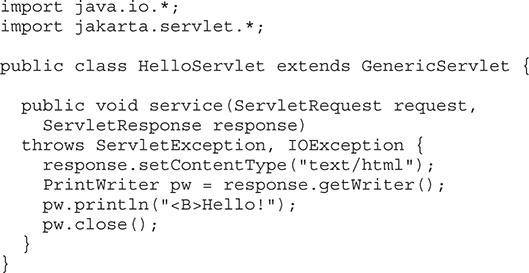
Let’s look closely at this program. First, note that it imports the jakarta.servlet package. This package contains the classes and interfaces required to build servlets. You will learn more about these later in this chapter. Next, the program defines HelloServlet as a subclass of GenericServlet. The GenericServlet class provides functionality that simplifies the creation of a servlet. For example, it provides versions of init( ) and destroy( ), which may be used as is. You need supply only the service( ) method.
Inside HelloServlet, the service( ) method (which is inherited from GenericServlet) is overridden. This method handles requests from a client. Notice that the first argument is a ServletRequest object. This enables the servlet to read data that is provided via the client request. The second argument is a ServletResponse object. This enables the servlet to formulate a response for the client.
The call to setContentType( ) establishes the MIME type of the HTTP response. In this program, the MIME type is text/html. This indicates that the browser should interpret the content as HTML source code.
Next, the getWriter( ) method obtains a PrintWriter. Anything written to this stream is sent to the client as part of the HTTP response. Then println( ) is used to write some simple HTML source code as the HTTP response.
Compile this source code and place the HelloServlet.class file in the proper Tomcat directory as described in the previous section. Also, add HelloServlet to the web.xml file, as described earlier.
Start Tomcat as explained earlier. Tomcat must be running before you try to execute a servlet.
Start a web browser and enter the URL shown here:
http://localhost:8080/examples/servlets/servlet/HelloServlet
Alternatively, you may enter the URL shown here:
http://127.0.0.1:8080/examples/servlets/servlet/HelloServlet
This can be done because 127.0.0.1 is defined as the IP address of the local machine.
You will observe the output of the servlet in the browser display area. It will contain the string Hello! in bold type.
Two packages contain the classes and interfaces that are required to build the servlets described in this chapter. These are jakarta.servlet and jakarta.servlet.http. They constitute the core of the Servlet API. Keep in mind that these packages are not part of the Java core packages. Therefore, they are not included with Java SE. Instead, they are provided by the servlet implementation, which is Tomcat in this case.
The Servlet API has been in a process of ongoing development and enhancement. The servlet specification supported by Tomcat 10.0.7 is version 5.0. At the time of this writing, this is the most recent servlet specification. Thus, it is used in this edition of this book. However, because this chapter discusses the core of the Servlet API, the information presented here applies to most versions of the servlet specification (and Tomcat), except as noted as follows.
Before continuing an important point needs to be made. Prior to servlet specification 5, the servlet API packages began with javax, not jakarta. Therefore, if you are using a version of Tomcat earlier than 10 (or a servlet implementation based on a specification prior to 5), then you will need to change all references in the example programs from jakarta to javax. For example, jakarta.servlet would become javax.servlet.
Remember For servlet implementations based on servlet specifications prior to 5, the API will be in javax, not jakarta, packages.
The jakarta.servlet package contains a number of interfaces and classes that establish the framework in which servlets operate. The following table summarizes several key interfaces that are provided in this package. The most significant of these is Servlet. All servlets must implement this interface or extend a class that implements the interface. The ServletRequest and ServletResponse interfaces are also very important.

The following table summarizes the core classes that are provided in the jakarta.servlet package:

Let us examine these interfaces and classes in more detail.
All servlets must implement the Servlet interface. It declares the init( ), service( ), and destroy( ) methods that are called by the server during the life cycle of a servlet. A method is also provided that allows a servlet to obtain any initialization parameters. The methods defined by Servlet are shown in Table 36-1.
The init( ), service( ), and destroy( ) methods are the life cycle methods of the servlet. These are invoked by the server. The getServletConfig( ) method is called by the servlet to obtain initialization parameters. A servlet developer overrides the getServletInfo( ) method to provide a string with useful information (for example, the version number). This method is also invoked by the server.
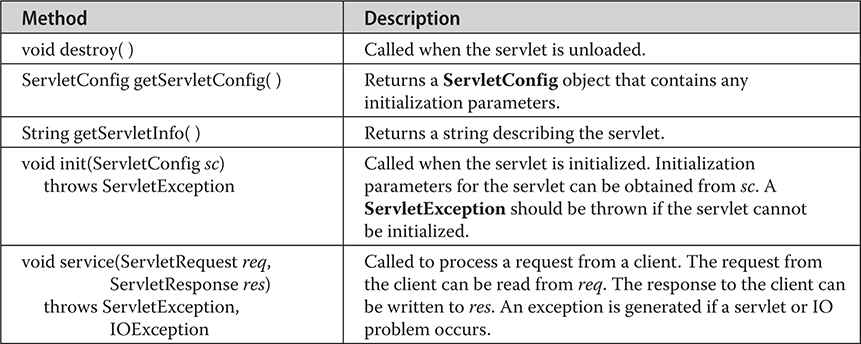
Table 36-1 The Methods Defined by Servlet
The ServletConfig interface allows a servlet to obtain configuration data when it is loaded. The methods declared by this interface are summarized here:

The ServletContext interface enables servlets to obtain information about their environment. Several of its methods are summarized in Table 36-2.
The ServletRequest interface enables a servlet to obtain information about a client request. Several of its methods are summarized in Table 36-3.
The ServletResponse interface enables a servlet to formulate a response for a client. Several of its methods are summarized in Table 36-4.
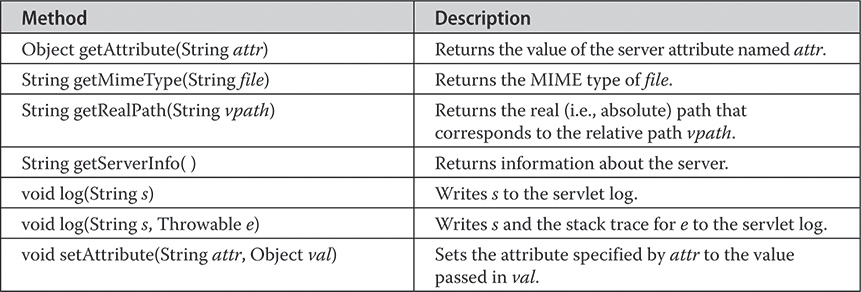
Table 36-2 Various Methods Defined by ServletContext
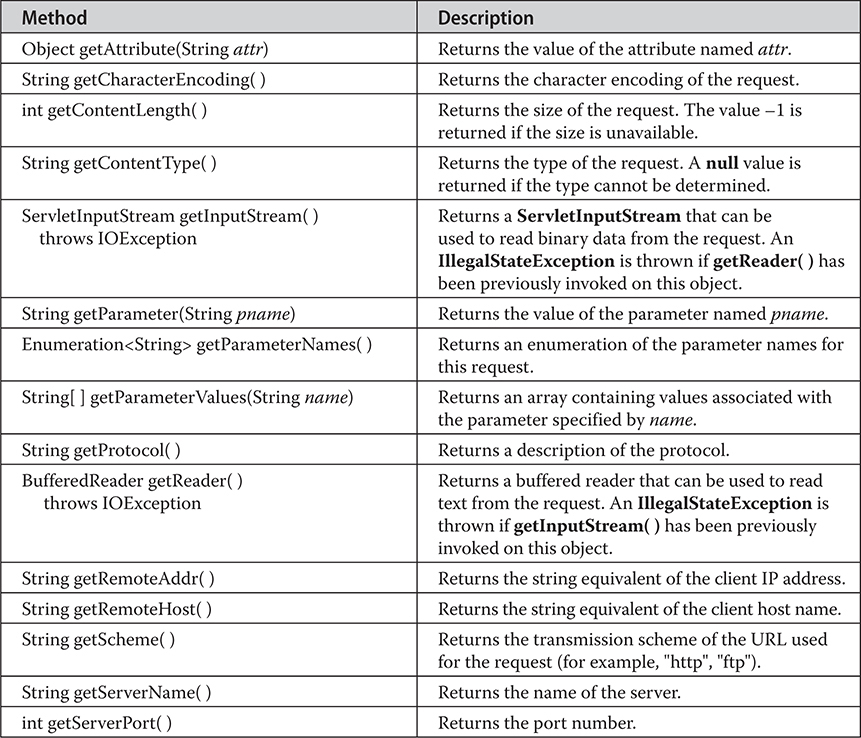
Table 36-3 Various Methods Defined by ServletRequest

Table 36-4 Various Methods Defined by ServletResponse
The GenericServlet class provides implementations of the basic life cycle methods for a servlet. GenericServlet implements the Servlet and ServletConfig interfaces. In addition, a method to append a string to the server log file is available. The signatures of this method are shown here:
void log(String s)
void log(String s, Throwable e)
Here, s is the string to be appended to the log, and e is an exception that occurred.
The ServletInputStream class extends InputStream. It is implemented by the servlet container and provides an input stream that a servlet developer can use to read the data from a client request. In addition to the input methods inherited from InputStream, a method is provided to read bytes from the stream. It is shown here:
int readLine(byte[ ] buffer, int offset, int size) throws IOException
Here, buffer is the array into which size bytes are placed starting at offset. The method returns the actual number of bytes read or –1 if an end-of-stream condition is encountered.
The ServletOutputStream class extends OutputStream. It is implemented by the servlet container and provides an output stream that a servlet developer can use to write data to a client response. In addition to the output methods provided by OutputStream, it also defines the print( ) and println( ) methods, which output data to the stream.
jakarta.servlet defines two exceptions. The first is ServletException, which indicates that a servlet problem has occurred. The second is UnavailableException, which extends ServletException. It indicates that a servlet is unavailable.
The ServletRequest interface includes methods that allow you to read the names and values of parameters that are included in a client request. We will develop a servlet that illustrates their use. The example contains two files. A web page is defined in PostParameters.html, and a servlet is defined in PostParametersServlet.java.
The HTML source code for PostParameters.html is shown in the following listing. It defines a table that contains two labels and two text fields. One of the labels is Employee and the other is Phone. There is also a submit button. Notice that the action parameter of the form tag specifies a URL. The URL identifies the servlet to process the HTTP POST request.
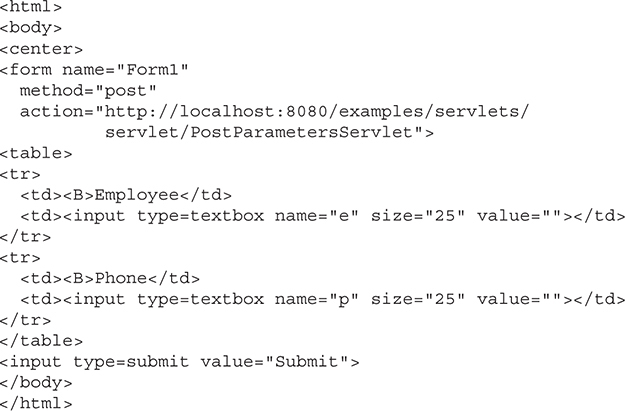
The source code for PostParametersServlet.java is shown in the following listing. The service( ) method is overridden to process client requests. The getParameterNames( ) method returns an enumeration of the parameter names. These are processed in a loop. You can see that the parameter name and value are output to the client. The parameter value is obtained via the getParameter( ) method.
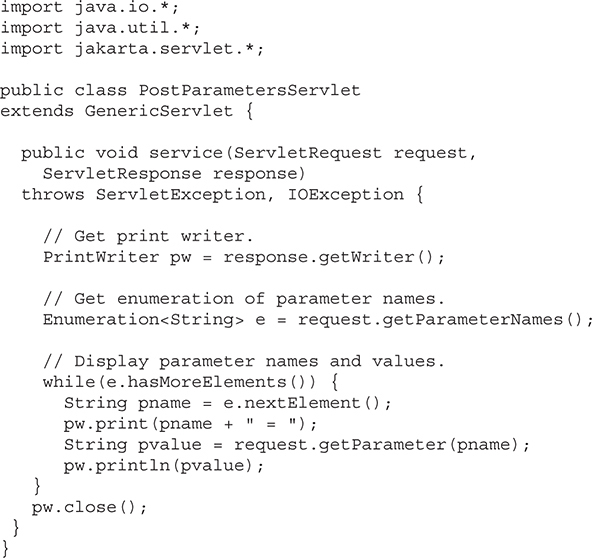
Compile the servlet. Next, copy it to the appropriate directory, and update the web.xml file, as previously described. Then, perform these steps to test this example:
1. Start Tomcat (if it is not already running).
2. Display the web page in a browser.
3. Enter an employee name and phone number in the text fields.
4. Submit the web page.
After following these steps, the browser will display a response that is dynamically generated by the servlet.
The preceding examples have used the classes and interfaces defined in jakarta.servlet, such as ServletRequest, ServletResponse, and GenericServlet, to illustrate the basic functionality of servlets. However, when working with HTTP, you will normally use the interfaces and classes in jakarta.servlet.http. As you will see, its functionality makes it easy to build servlets that work with HTTP requests and responses.
The following table summarizes the interfaces used in this chapter:

The following table summarizes the classes used in this chapter. The most important of these is HttpServlet. Servlet developers typically extend this class in order to process HTTP requests.

The HttpServletRequest interface enables a servlet to obtain information about a client request. Several of its methods are shown in Table 36-5.
The HttpServletResponse interface enables a servlet to formulate an HTTP response to a client. Several constants are defined. These correspond to the different status codes that can be assigned to an HTTP response. For example, SC_OK indicates that the HTTP request succeeded, and SC_NOT_FOUND indicates that the requested resource is not available. Several methods of this interface are summarized in Table 36-6.
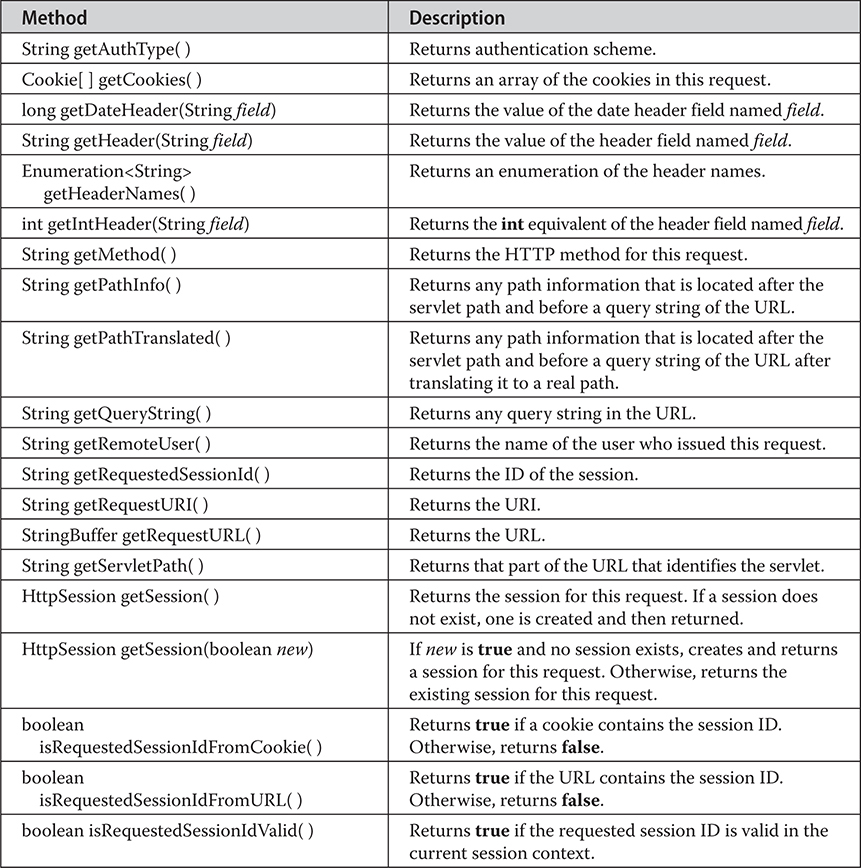
Table 36-5 Various Methods Defined by HttpServletRequest
The HttpSession interface enables a servlet to read and write the state information that is associated with an HTTP session. Several of its methods are summarized in Table 36-7. All of these methods throw an IllegalStateException if the session has already been invalidated.
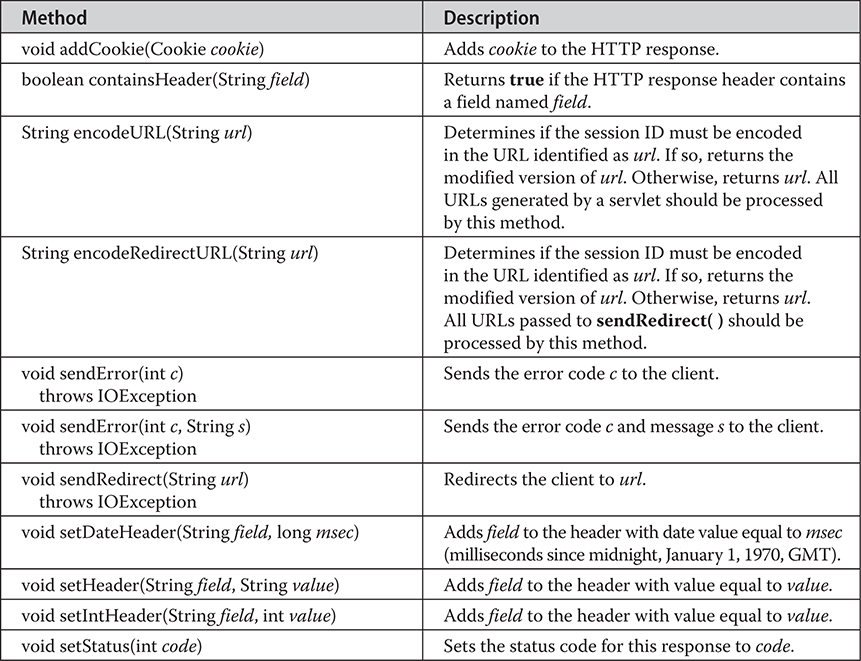
Table 36-6 Various Methods Defined by HttpServletResponse
The Cookie class encapsulates a cookie. A cookie is stored on a client and contains state information. Cookies are valuable for tracking user activities. For example, assume that a user visits an online store. A cookie can save the user’s name, address, and other information. The user does not need to enter this data each time he or she visits the store.
A servlet can write a cookie to a user’s machine via the addCookie( ) method of the HttpServletResponse interface. The data for that cookie is then included in the header of the HTTP response that is sent to the browser.
The names and values of cookies are stored on the user’s machine. Some of the information that can be saved for each cookie includes the following:
• The name of the cookie
• The value of the cookie
• The expiration date of the cookie
• The domain and path of the cookie
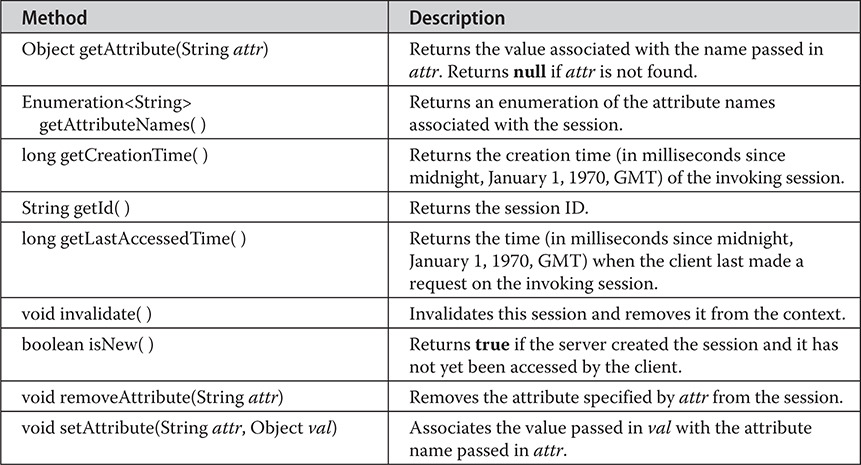
Table 36-7 Various Methods Defined by HttpSession
The expiration date determines when this cookie is deleted from the user’s machine. If an expiration date is not explicitly assigned to a cookie, it is deleted when the current browser session ends.
The domain and path of the cookie determine when it is included in the header of an HTTP request. If the user enters a URL whose domain and path match these values, the cookie is then supplied to the web server. Otherwise, it is not.
There is one constructor for Cookie. It has the signature shown here:
Cookie(String name, String value)
Here, the name and value of the cookie are supplied as arguments to the constructor. The methods of the Cookie class are summarized in Table 36-8.
The HttpServlet class extends GenericServlet. It is commonly used when developing servlets that receive and process HTTP requests. The methods defined by the HttpServlet class are summarized in Table 36-9.
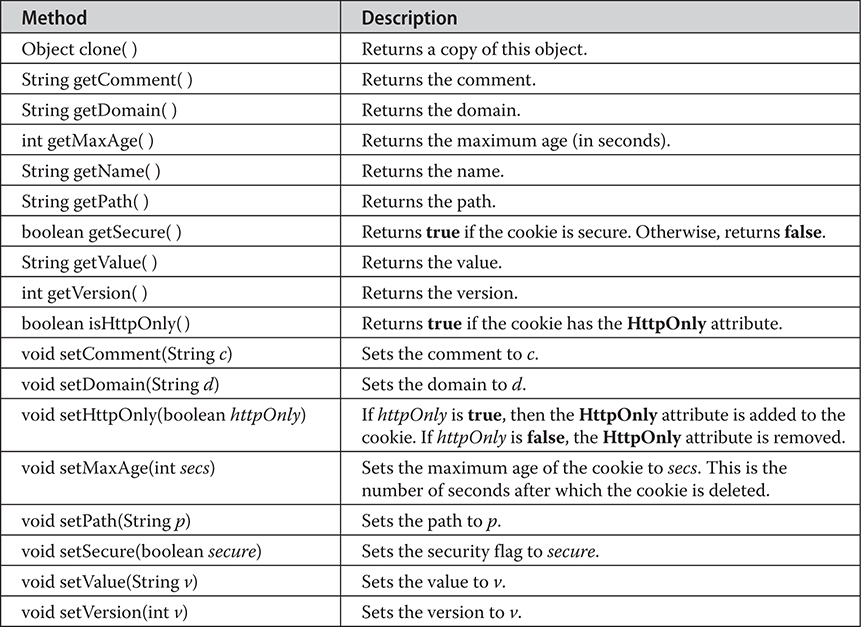
Table 36-8 The Methods Defined by Cookie
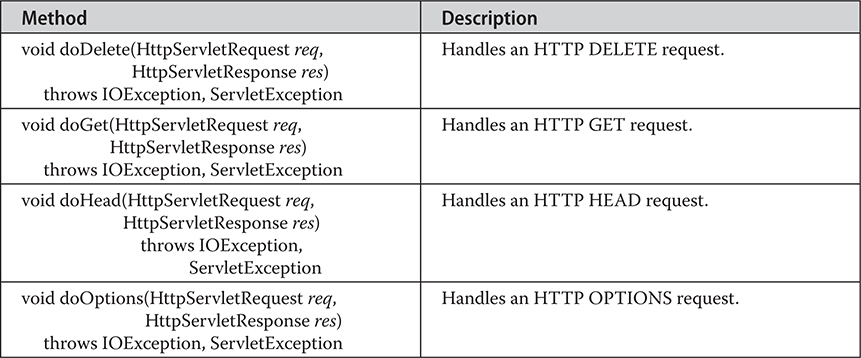
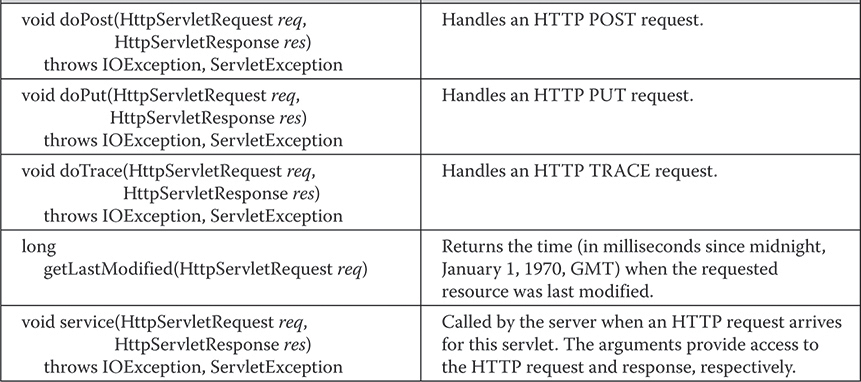
Table 36-9 The Methods Defined by HttpServlet
The HttpServlet class provides specialized methods that handle the various types of HTTP requests. A servlet developer typically overrides one of these methods. These methods are doDelete( ), doGet( ), doHead( ), doOptions( ), doPost( ), doPut( ), and doTrace( ). A complete description of the different types of HTTP requests is beyond the scope of this book. However, the GET and POST requests are commonly used when handling form input. Therefore, this section presents examples of these cases.
Here we will develop a servlet that handles an HTTP GET request. The servlet is invoked when a form on a web page is submitted. The example contains two files. A web page is defined in ColorGet.html, and a servlet is defined in ColorGetServlet.java. The HTML source code for ColorGet.html is shown in the following listing. It defines a form that contains a select element and a submit button. Notice that the action parameter of the form tag specifies a URL. The URL identifies a servlet to process the HTTP GET request.
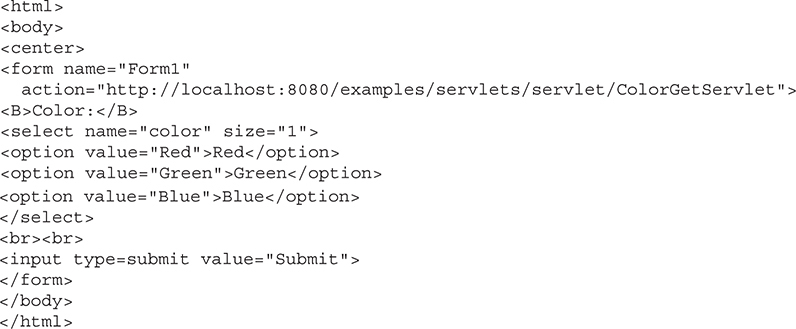
The source code for ColorGetServlet.java is shown in the following listing. The doGet( ) method is overridden to process any HTTP GET requests that are sent to this servlet. It uses the getParameter( ) method of HttpServletRequest to obtain the selection that was made by the user. A response is then formulated.
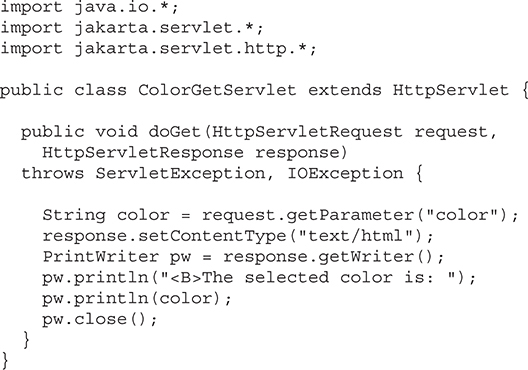
Compile the servlet. Next, copy it to the appropriate directory, and update the web.xml file, as previously described. Then, perform these steps to test this example:
1. Start Tomcat, if it is not already running.
2. Display the web page in a browser.
3. Select a color.
4. Submit the web page.
After completing these steps, the browser will display the response that is dynamically generated by the servlet.
One other point: Parameters for an HTTP GET request are included as part of the URL that is sent to the web server. Assume that the user selects the red option and submits the form. The URL sent from the browser to the server is
http://localhost:8080/examples/servlets/servlet/ColorGetServlet?color=Red
The characters to the right of the question mark are known as the query string.
Here we will develop a servlet that handles an HTTP POST request. The servlet is invoked when a form on a web page is submitted. The example contains two files. A web page is defined in ColorPost.html, and a servlet is defined in ColorPostServlet.java.
The HTML source code for ColorPost.html is shown in the following listing. It is identical to ColorGet.html except that the method parameter for the form tag explicitly specifies that the POST method should be used, and the action parameter for the form tag specifies a different servlet.
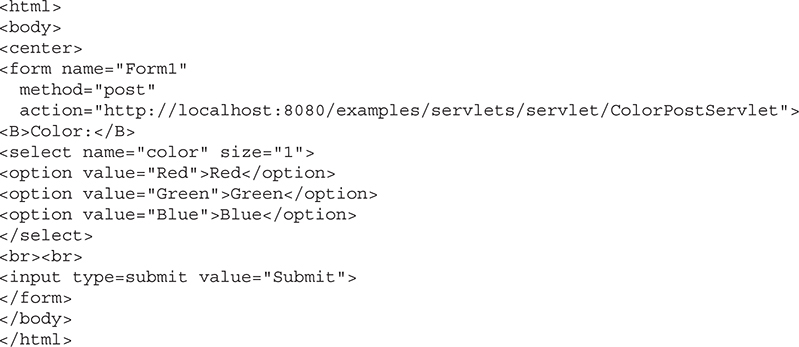
The source code for ColorPostServlet.java is shown in the following listing. The doPost( ) method is overridden to process any HTTP POST requests that are sent to this servlet. It uses the getParameter( ) method of HttpServletRequest to obtain the selection that was made by the user. A response is then formulated.
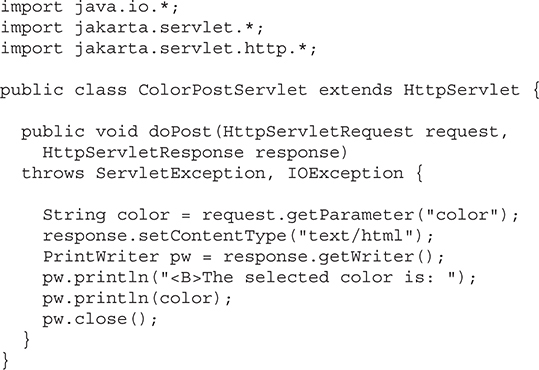
Compile the servlet and perform the same steps as described in the previous section to test it.
Note Parameters for an HTTP POST request are not included as part of the URL that is sent to
the web server. In this example, the URL sent from the browser to the server is http://localhost:8080/examples/servlets/servlet/ColorPostServlet. The parameter names and values are sent in the body of the HTTP request.
Now, let’s develop a servlet that illustrates how to use cookies. The servlet is invoked when a form on a web page is submitted. The example contains three files as summarized here:

The HTML source code for AddCookie.html is shown in the following listing. This page contains a text field in which a value can be entered. There is also a submit button on the page. When this button is pressed, the value in the text field is sent to AddCookieServlet via an HTTP POST request.

The source code for AddCookieServlet.java is shown in the following listing. It gets the value of the parameter named "data". It then creates a Cookie object that has the name "MyCookie" and contains the value of the "data" parameter. The cookie is then added to the header of the HTTP response via the addCookie( ) method. A feedback message is then written to the browser.
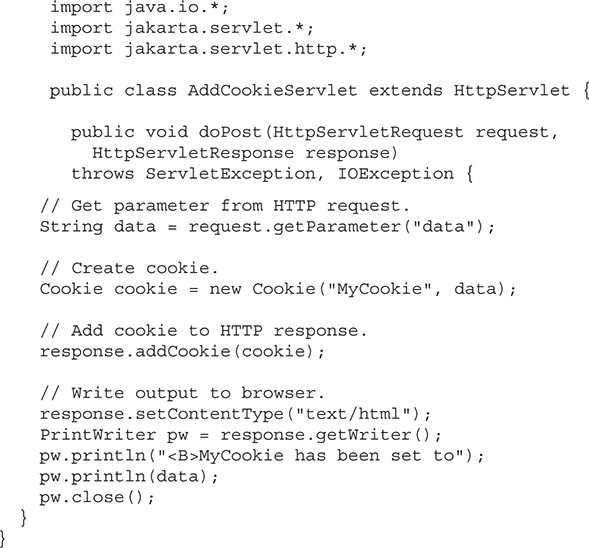
The source code for GetCookiesServlet.java is shown in the following listing. It invokes the getCookies( ) method to read any cookies that are included in the HTTP GET request. The names and values of these cookies are then written to the HTTP response. Observe that the getName( ) and getValue( ) methods are called to obtain this information.
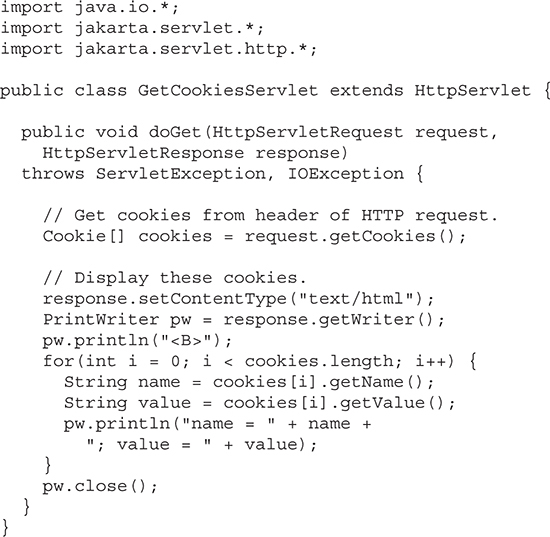
Compile the servlets. Next, copy them to the appropriate directory, and update the web.xml file, as previously described. Then, perform these steps to test this example:
1. Start Tomcat, if it is not already running.
2. Display AddCookie.html in a browser.
3. Enter a value for MyCookie.
4. Submit the web page.
After completing these steps, you will observe that a feedback message is displayed by the browser.
Next, request the following URL via the browser:
http://localhost:8080/examples/servlets/servlet/GetCookiesServlet
Observe that the name and value of the cookie are displayed in the browser.
In this example, an expiration date is not explicitly assigned to the cookie via the setMaxAge( ) method of Cookie. Therefore, the cookie expires when the browser session ends. You can experiment by using setMaxAge( ) and observe that the cookie is then saved on the client machine.
HTTP is a stateless protocol. Each request is independent of the previous one. However, in some applications, it is necessary to save state information so that information can be collected from several interactions between a browser and a server. Sessions provide such a mechanism.
A session can be created via the getSession( ) method of HttpServletRequest. An HttpSession object is returned. This object can store a set of bindings that associate names with objects. The setAttribute( ), getAttribute( ), getAttributeNames( ), and removeAttribute( ) methods of HttpSession manage these bindings. Session state is shared by all servlets that are associated with a client.
The following servlet illustrates how to use session state. The getSession( ) method gets the current session. A new session is created if one does not already exist. The getAttribute( ) method is called to obtain the object that is bound to the name "date". That object is a Date object that encapsulates the date and time when this page was last accessed. (Of course, there is no such binding when the page is first accessed.) A Date object encapsulating the current date and time is then created. The setAttribute( ) method is called to bind the name "date" to this object.
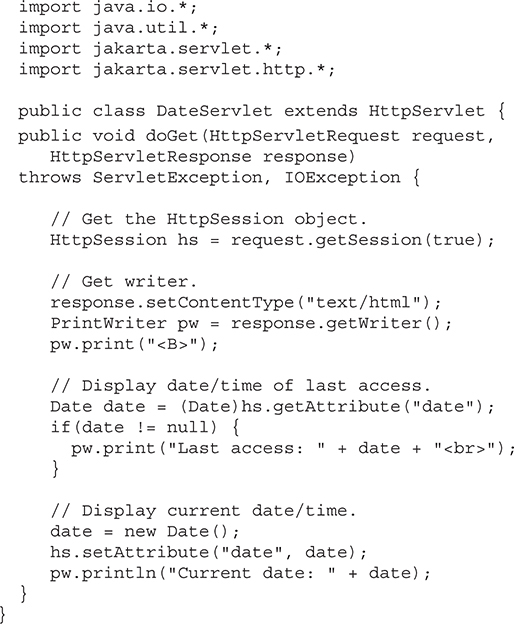
When you first request this servlet, the browser displays one line with the current date and time information. On subsequent invocations, two lines are displayed. The first line shows the date and time when the servlet was last accessed. The second line shows the current date and time.
As explained in Part I, Java supports three types of comments. The first two are the // and the /* */. The third type is called a documentation comment. It begins with the character sequence /**. It ends with */. Documentation comments allow you to embed information about your program into the program itself. You can then use the javadoc utility program (supplied with the JDK) to extract the information and put it into an HTML file. Documentation comments make it convenient to document your programs. You have almost certainly seen documentation that uses such comments because that is the way the Java API library was documented. Beginning with JDK 9, javadoc includes support for modules.
The javadoc utility recognizes several tags, including those shown here:
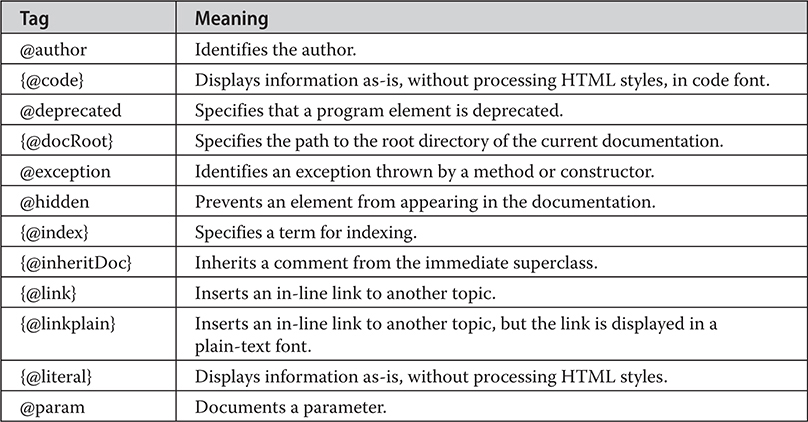
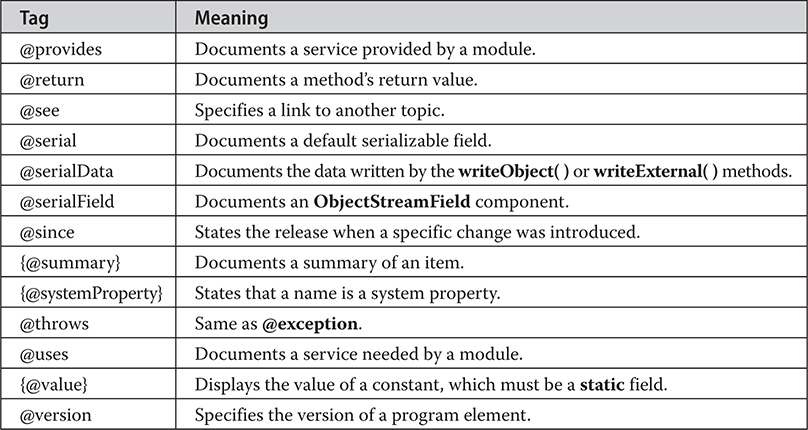
Document tags that begin with an “at” sign (@) are called block tags (also called stand-alone tags), and they must be used at the beginning of their own line. Tags that begin with a brace, such as {@code}, are called inline tags, and they can be used within a larger description. You may also use other, standard HTML tags in a documentation comment. However, some tags, such as headings, should not be used because they disrupt the look of the HTML file produced by javadoc.
As it relates to documenting source code, you can use documentation comments to document classes, interfaces, fields, constructors, methods, packges, and modules. In all cases, the documentation comment must immediately precede the item being documented. Some tags, such as @see, @since, and @deprecated, can be used to document any element. Other tags apply only to the relevant elements. A brief synopsis of each tag follows.
Note As one would expect, the capabilities of javadoc and the documentation comment tags have evolved over time, often in response to new Java features. You will want to refer to the javadoc documentation for information on the latest javadoc features.
The @author tag documents the author of a program element. It has the following syntax:
@author description
Here, description will usually be the name of the author. You will need to specify the -author option when executing javadoc in order for the @author field to be included in the HTML documentation.
The {@code} tag enables you to embed text, such as a snippet of code, into a comment. That text is then displayed as-is in code font, without any further processing, such as HTML rendering. It has the following syntax:
{@code code-snippet}
The @deprecated tag specifies that a program element is deprecated. It is recommended that you include @see or {@link} tags to inform the programmer about available alternatives. The syntax is the following:
@deprecated description
Here, description is the message that describes the deprecation. The @deprecated tag can be used in documentation for fields, methods, constructors, classes, modules, and interfaces.
{@docRoot} specifies the path to the root directory of the current documentation.
The @exception tag describes an exception to a method. Today, @throws is the preferred alternative, but @exception is still supported. It has the following syntax:
@exception exception-name explanation
Here, the fully qualified name of the exception is specified by exception-name, and explanation is a string that describes how the exception can occur. The @exception tag can only be used in documentation for a method or constructor.
The @hidden tag prevents an element from appearing in the documentation.
The {@index} tag specifies an item that will be indexed, and thus found when using the search feature. It has the following syntax:
{ @index term usage-str }
Here, term is the item (which can be a quoted string) to be indexed. usage-str is optional. Thus, in the following @throws tag, {@index} causes the term “error” to be added to the index:
@throws IOException On input {@index error}.
Note that the word “error” is still displayed as part of the description. It’s just that now it is also indexed. If you include the optional usage-str, then that description will be shown in the index and in the search box to indicate how the term is used. For example, {@index error Serious execution failure} will show “Serious execution failure” under “error” in the index and in the search box.
This tag inherits a comment from the immediate superclass.
The {@link} tag provides an in-line link to additional information. It has the following syntax:
{@link mod-name/pkg-name.class-name#member-name text}
Here, mod-name/pkg-name.class-name#member-name specifies the name of a class or method to which a link is added, and text is the string that is displayed.
The text field is optional. If not included, member is displayed as the link. Notice that the module name (if present) is separated from the package name with a /. For example,
{@link java.base/java.io.Writer#write}
defines a link to the write( ) method of Writer in java.io, in the module java.base.
Inserts an in-line link to another topic. The link is displayed in plain-text font. Otherwise, it is similar to {@link}.
The {@literal} tag enables you to embed text into a comment. That text is then displayed as-is, without any further processing, such as HTML rendering. It has the following syntax:
{@literal description}
Here, description is the text that is embedded.
The @param tag documents a parameter. It has the following syntax:
@param parameter-name explanation
Here, parameter-name specifies the name of a parameter. The meaning of that parameter is described by explanation. The @param tag can be used only in documentation for a method or constructor, or a generic class or interface.
The @provides tag documents a service provided by a module. It has the following syntax:
@provides type explanation
Here, type specifies a service provider type and explanation describes the service provider.
The @return tag describes the return value of a method. It has two forms. The first is the block tag show here:
@return explanation
Here, explanation describes the type and meaning of the value returned by a method. Thus, the tag can be used only in documentation for a method. JDK 16 added an inline tag version:
{@return explanation}
This form must be at the top of the method’s documentation comment.
The @see tag provides a reference to additional information. Two commonly used forms are shown here:
@see anchor
@see mod-name/pkg-name.class-name#member-name text
In the first form, anchor is a link to an absolute or relative URL. In the second form, mod-name/pkg-name.class-name#member-name specifies the name of the item, and text is the text displayed for that item. The text parameter is optional, and if not used, then the item specified by mod-name/pkg-name.class-name#member-name is displayed. The member name, too, is optional. Thus, you can specify a reference to a module, package, class, or interface in addition to a reference to a specific method or field. The name can be fully qualified or partially qualified. However, the dot that precedes the member name (if it exists) must be replaced by a hash character. There is a third form of @see that lets you simply specify a text-based description.
The @serial tag defines the comment for a default serializable field. Here is its basic form:
@serial description
Here, description is the comment for that field. Two other forms, shown here, let you indicate if a class or package will be part of the Serialized Form documentation page.
@serial include
@serial exclude
The @serialData tag documents the data written by the writeObject( ) and writeExternal( ) methods. It has the following syntax:
@serialData description
Here, description is the comment for that data.
For a class that implements Serializable, the @serialField tag provides comments for an ObjectStreamField component. It has the following syntax:
@serialField name type description
Here, name is the name of the field, type is its type, and description is the comment for that field.
The @since tag states that an element was introduced in a specific release. It has the following syntax:
@since release
Here, release is a string that designates the release or version in which this feature became available.
The {@summary} tag explicitly specifies the summary text that will be used for an item. It must be the first tag in the documentation for the item. It has the following syntax:
@summary explanation
Here, explanation provides a summary of the tagged item, which can span multiple lines. Without the use of {@summary}, the first line in an item’s documentation comment is used as the summary.
The {@systemProperty} tag lets you indicate a system property. It has this general form:
{@systemProperty propName}
Here, propName is the name of the property.
The @throws tag has the same meaning as the @exception tag, but is now the preferred form.
The @uses tag documents a service provider needed by a module. It has the following syntax:
@uses type explanation
Here, type specifies a service provider type and explanation describes the service.
{@value} has two forms. The first displays the value of the constant that it precedes, which must be a static field. It has this form:
{@value}
The second form displays the value of a specified static field. It has this form:
{@value pkg.class#field}
Here, pkg.class#field specifies the name of the static field.
The @version tag specifies the version of a program element. It has the following syntax:
@version info
Here, info is a string that contains version information, typically a version number, such as 2.2. You will need to specify the -version option when executing javadoc in order for the @version field to be included in the HTML documentation.
After the beginning /**, the first line or lines become the main description of your class, interface, field, constructor, method, or module. After that, you can include one or more of the various @ tags. Each @ tag must start at the beginning of a new line or follow one or more asterisks (*) that are at the start of a line. Multiple tags of the same type should be grouped together. For example, if you have three @see tags, put them one after the other. Inline tags (those that begin with a brace) can be used within any description.
Here is an example of a documentation comment for a class:

The javadoc program takes as input your Java program’s source file and outputs several HTML files that contain the program’s documentation. Information about each class will be in its own HTML file. javadoc will also output an index and a hierarchy tree. Other HTML files can be generated. Beginning with JDK 9, a search box feature is also included.
Following is a sample program that uses documentation comments. Notice the way each comment immediately precedes the item that it describes. After being processed by javadoc, the documentation about the SquareNum class will be found in SquareNum.html.

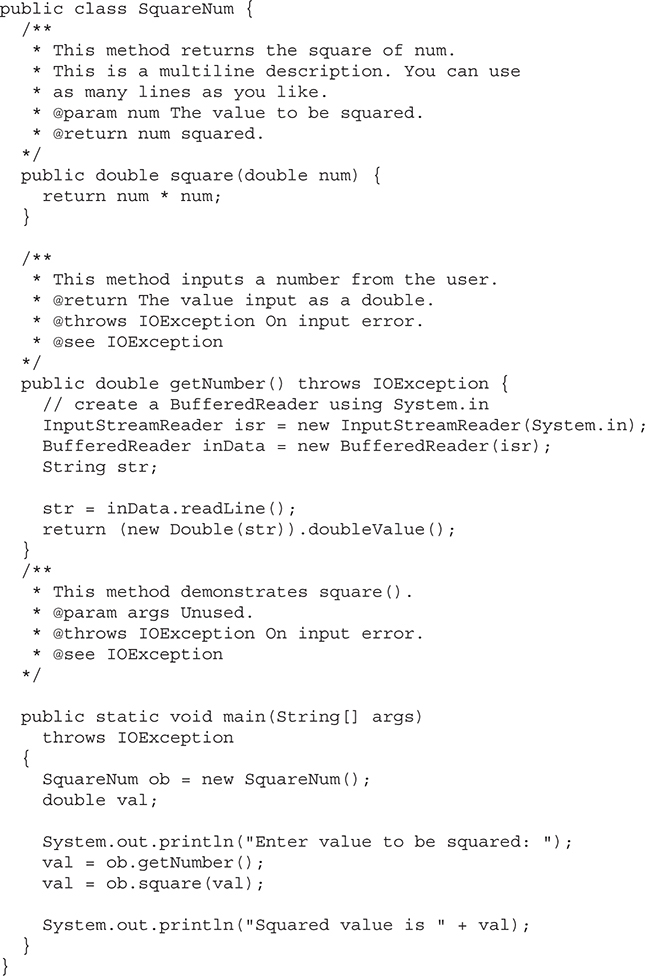
Beginning with JDK 9, Java has included a tool called JShell. It provides an interactive environment that enables you to quickly and easily experiment with Java code. JShell implements what is referred to as read-evaluate-print loop (REPL) execution. Using this mechanism, you are prompted to enter a fragment of code. This fragment is then read and evaluated. Next, JShell displays output related to the code, such as the output produced by a println( ) statement, the result of an expression, or the current value of a variable. JShell then prompts for the next piece of code, and the process continues (i.e., loops). In the language of JShell, each code sequence you enter is called a snippet.
A key point to understand about JShell is that you do not need to enter a complete Java program to use it. Each snippet you enter is simply evaluated as you enter it. This is possible because JShell handles many of the details associated with a Java program for you automatically. This lets you concentrate on a specific feature without having to write a complete program, which makes JShell especially helpful when you are first learning Java.
As you might expect, JShell can also be useful to experienced programmers. Because JShell stores state information, it is possible to enter multiline code sequences and run them inside JShell. This makes JShell quite useful when you need to prototype a concept because it lets you interactively experiment with your code without having to develop and compile a complete program.
This appendix introduces JShell and explores several of its key features, with the primary focus being on those features most useful to beginning Java programmers.
JShell is a command-line tool. Thus, it runs in a command-prompt window. To start a JShell session, execute jshell from the command line. After doing so, you will see the JShell prompt:
jshell>
When this prompt is displayed, you can enter a code snippet or a JShell command.
In its simplest form, JShell lets you enter an individual statement and immediately see the result. To begin, think back to the first example Java program in this book. It is shown again here:

In this program, only the println( ) statement actually performs an action, which is displaying its message on the screen. The rest of the code simply provides the required class and method declarations. In JShell, it is not necessary to explicitly specify the class or method in order to execute the println( ) statement. JShell can execute it directly on its own. To see how, enter the following line at the JShell prompt:
System.out.println("This is a simple Java program.");
Then, press ENTER. This output is displayed:
This is a simple Java program.
jshell>
As you can see, the call to println( ) is evaluated and its string argument is output. Then, the prompt is redisplayed.
Before moving on, it is useful to explain why JShell can execute a single statement, such as the call to println( ), when the Java compiler, javac, requires a complete program. JShell is able to evaluate a single statement because JShell automatically provides the necessary program framework for you, behind the scenes. This consists of a synthetic class and a synthetic method. Thus, in this case, the println( ) statement is embedded in a synthetic method that is part of a synthetic class. As a result, the preceding code is still part of a valid Java program even though you don’t see all of the details. This approach provides a very fast and convenient way to experiment with Java code.
Next, let’s look at how variables are supported. In JShell, you can declare a variable, assign the variable a value, and use it in any valid expressions. For example, enter the following line at the prompt:
int count;
After doing so you will see the following response:
count ==> 0
This indicates that count has been added to the synthetic class and initialized to zero. Furthermore, it has been added as a static variable of the synthetic class.
Next, give count the value 10 by entering this statement:
count = 10;
You will see this response:
count ==> 10
As you can see, count’s value is now 10. Because count is static, it can be used without reference to an object.
Now that count has been declared, it can be used in an expression. For example, enter this println( ) statement:
System.out.println("Reciprocal of count: " + 1.0 / count);
JShell responds with:
Reciprocal of count: 0.1
Here, the result of the expression 1.0 / count is 0.1 because count was previously assigned the value 10.
In addition to demonstrating the use of a variable, the preceding example illustrates another important aspect of JShell: it maintains state information. In this case, count is assigned the value 10 in one statement and then this value is used in the expression 1.0 / count in the subsequent call to println( ) in a second statement. Between these two statements, JShell stores count’s value. In general, JShell maintains the current state and effect of the code snippets that you enter. This lets you experiment with larger code fragments that span multiple lines.
Before moving on, let’s try one more example. In this case, we will create a for loop that uses the count variable. Begin by entering this line at the prompt:
for(count = 0; count < 5; count++)
At this point, JShell responds with the following prompt:
...>
This indicates that additional code is required to finish the statement. In this case, the target of the for loop must be provided. Enter the following:
System.out.println(count);
After entering this line, the for statement is complete and both lines are executed. You will see the following output:
0
1
2
3
4
In addition to statements and variable declarations, JShell lets you declare classes and methods, and use import statements. Examples are shown in the following sections. One other point: Any code that is valid for JShell will also be valid for compilation by javac, assuming the necessary framework is provided to create a complete program. Thus, if a code fragment can be executed by JShell, then that fragment represents valid Java code. In other words, JShell code is Java code.
JShell supports a large number of commands that let you control the operation of JShell. At this point, three are of particular interest because they let you list the code that you have entered, edit a line of code, and rerun a code snippet. As the subsequent examples become longer, you will find these commands to be very helpful.
In JShell, all commands start with a / followed by the command. Perhaps the most commonly used command is /list, which lists the code that you have entered. Assuming that you have followed along with the examples shown in the preceding section, you can list your code by entering /list at this time. Your JShell session will respond with a numbered list of the snippets you entered. Pay special attention to the entry that shows the for loop. Although it consists of two lines, it constitutes one statement. Thus, only one snippet number is used. In the language of JShell, the snippet numbers are referred to as snippet IDs. In addition to the basic form of /list just shown, other forms are supported, including those that let you list specific snippets by name or number. For example, you can list the count declaration by using /list count.
You can edit a snippet by using the /edit command. This command causes an edit window to open in which you can modify your code. Here are three forms of the /edit command that you will find helpful at this time. First, if you specify /edit by itself, the edit window contains all of the lines you have entered and lets you edit any part of it. Second, you can specify a specific snippet to edit by using /edit n, where n specifies the snippet’s number. For example, to edit snippet 3, use /edit 3. Finally, you can specify a named element, such as a variable. For example, to change the value of count, use /edit count.
As you have seen, JShell executes code as you enter it. However, you can also rerun what you have entered. To rerun the last fragment that you entered, use /!. To rerun a specific snippet, specify its number using this form: /n, where n specifies the snippet to run. For example, to rerun the fourth snippet, enter /4. You can rerun a snippet by specifying its position relative to the current fragment by use of a negative offset. For example, to rerun a fragment that is three snippets before the current one, use /-3.
Before moving on, it is helpful to point out that several commands, including those just shown, allow you to specify a list of names or numbers. For example, to edit lines 2 and 4, you could use /edit 2 4. For recent versions of JShell, several commands allow you specify a range of snippets. These include the /list, /edit, and /n commands just described. For example, to list snippets 4 through 6, you would use /list 4-6.
There is one other important command that you need to know about now: /exit. This terminates JShell.
As explained in Chapter 6, methods occur within classes. However, when using JShell it is possible to experiment with a method without having to explicitly declare it within a class. As mentioned earlier, this is because JShell automatically wraps code fragments within a synthetic class. As a result, you can easily and quickly write a method without having to provide a class framework. You can also call the method without having to create an object. This feature of JShell is especially beneficial when learning the basics of methods in Java or when prototyping new code. To understand the process, we will work through an example.
To begin, start a new JShell session and enter the following method at the prompt:

This creates a method that returns the reciprocal of its argument. After you enter this, JShell responds with the following:
| created method reciprocal(double)
This indicates the method has been added to JShell’s synthetic class and is ready for use.
To call reciprocal( ), simply specify its name, without any object or class reference. For example, try this:
System.out.println(reciprocal(4.0));
JShell responds by displaying 0.25.
You might be wondering why you can call reciprocal( ) without using the dot operator and an object reference. Here is the answer. When you create a stand-alone method in JShell, such as reciprocal( ), JShell automatically makes that method a static member of the synthetic class. As you know from Chapter 7, static methods are called relative to their class, not on a specific object. So, no object is required. This is similar to the way that stand-alone variables become static variables of the synthetic class, as described earlier.
Another important aspect of JShell is its support for a forward reference inside a method. This feature lets one method call another method, even if the second method has not yet been defined. This enables you to enter a method that depends on another method without having to worry about which one you enter first. Here is a simple example. Enter this line in JShell:
void myMeth() { myMeth2(); }
JShell responds with the following:

As you can see, JShell knows that myMeth2( ) has not yet been declared, but it still lets you define myMeth( ). As you would expect, if you try to call myMeth( ) at this time, you will see an error message since myMeth2( ) is not yet defined, but you are still able to enter the code for myMeth( ).
Next, define myMeth2( ) like this:
void myMeth2() { System.out.println("JShell is powerful."); }
Now that myMeth2( ) has been defined, you can call myMeth( ).
In addition to its use in a method, you can use a forward reference in a field initializer in a class.
Although JShell automatically supplies a synthetic class that wraps code snippets, you can also create your own class in JShell. Furthermore, you can instantiate objects of your class. This allows you to experiment with classes inside JShell’s interactive environment. The following example illustrates the process.
Start a new JShell session and enter the following class, line by line:
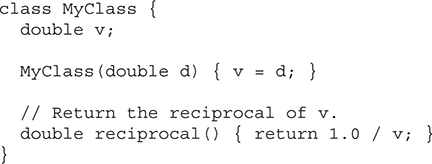
When you finish entering the code, JShell will respond with
| created class MyClass
Now that you have added MyClass, you can use it. For example, you can create a MyClass object with the following line:
MyClass ob = new MyClass(10.0);
JShell will respond by telling you that it added ob as a variable of type MyClass. Next, try the following line:
System.out.println(ob.reciprocal());
JShell responds by displaying the value 0.1.
As a point of interest, when you add a class to JShell, it becomes a static nested member of a synthetic class.
Interfaces are supported by JShell in the same way as classes. Therefore, you can declare an interface and implement it by a class within JShell. Let’s work through a simple example. Before beginning, start a new JShell session.
The interface that we will use declares a method called isLegalVal( ) that is used to determine if a value is valid for some purpose. It returns true if the value is legal and false otherwise. Of course, what constitutes a legal value will be determined by each class that implements the interface. Begin by entering the following interface into JShell:

JShell responds with
| created interface MyIf
Next, enter the following class, which implements MyIF:
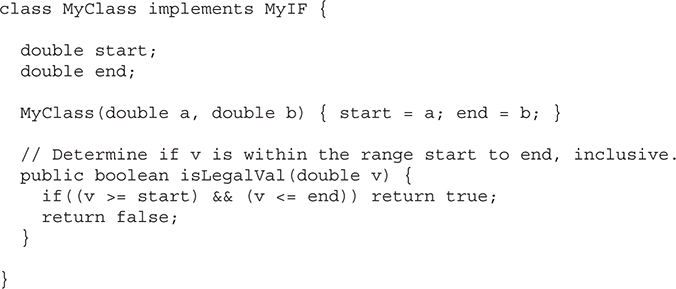
JShell responds with
| created class MyClass
Notice that MyClass implements isLegalVal( ) by determining if the value v is within the range (inclusive) of the values in the MyClass instance variables start and end.
Now that both MyIF and MyClass have been added, you can create a MyClass object and call isLegalVal( ) on it, as shown here:
MyClass ob = new MyClass(0.0, 10.0);
System.out.println(ob.isLegalVal(5.0));
In this case, the value true is displayed because 5 is within the range 0 through 10.
Because MyIF has been added to JShell, you can also create a reference to an object of type MyIF. For example, the following is also valid code:
MyIF ob2 = new MyClass(1.0, 3.0);
boolean result = ob2.isLegalVal(1.1);
In this case, the value of result will be true and will be reported as such by JShell.
One other point: enumerations and annotations are supported in JShell in the same way as classes and interfaces.
JShell includes the ability to directly evaluate an expression without it needing to be part of a full Java statement. This is especially useful when you are experimenting with code and don’t need to execute the expression in a larger context. Here is a simple example. Using a new JShell session, enter the following at the prompt:
3.0 / 16.0
JShell responds with:
$1 ==> 0.1875
As you can see, the result of the expression is computed and displayed. However, note that this value is also assigned to a temporary variable called $1. In general, each time an expression is evaluated directly, its result is stored in a temporary variable of the proper type. Temporary variable names all begin with a $ followed by a number, which is increased each time a new temporary variable is needed. You can use these temporary variables like any other variable. For example, the following displays the value of $1, which is 0.1875 in this case.
System.out.println($1);
Here is another example:
double v = $1 * 2;
Here, the value $1 times 2 is assigned to v. Thus, v will contain 0.375.
You can change the value of a temporary variable. For example, this reverses the sign of $1:
$1 = -$1
JShell responds with
$1 ==> -0.1875
Expressions are not limited to numeric values. For example, here is one that concatenates a String with the value returned by Math.abs($1).
"The absolute value of $1 is " + Math.abs($1)
This results in a temporary variable that contains the string
The absolute value of $1 is 0.1875
As described in Chapter 9, an import statement is used to bring members of a package into view. Furthermore, any time you use a package other than java.lang, you must import it. The situation is much the same in JShell except that by default, JShell imports several commonly used packages automatically. These include java.io and java.util, among several others. Since these packages are already imported, no explicit import statement is required to use them.
For example, because java.io is automatically imported, the following statement can be entered:
FileInputStream fin = new FileInputStream("myfile.txt");
Recall that FileInputStream is packaged in java.io. Since java.io is automatically imported, it can be used without having to include an explicit import statement. Assuming that you actually have a file called myfile.txt in the current directory, JShell will respond by adding the variable fin and opening the file. You can then read and display the file by entering these statements:

This is the same basic code that was discussed in Chapter 13, but no explicit import java.io statement is required.
Keep in mind that JShell automatically imports only a handful of packages. If you want to use a package not automatically imported by JShell, then you must explicitly import it as you do with a normal Java program. One other point: you can see a list of the current imports by using the /imports command.
In the I/O example shown in the preceding section on imports, the code snippets also illustrate another very important aspect of JShell. Notice that there are no try/catch blocks that handle I/O exceptions. If you look back at the similar code in Chapter 13, the code that opens the file catches a FileNotFoundException, and the code that reads the file watches for an IOException. The reason that you don’t need to catch these exceptions in the snippets shown earlier is because JShell automatically handles them for you. More generally, JShell will automatically handle checked exceptions in many cases.
In addition to the commands discussed earlier, JShell supports several others. One command that you will want to try immediately is /help. It displays a list of the commands. You can also use /? to obtain help. Some of the more commonly used commands are examined here.
You can reset JShell by using the /reset command. This is especially useful when you want to change to a new project. By use of /reset you avoid the need to exit and then restart JShell. Be aware, however, that /reset resets the entire JShell environment, so all state information is lost.
You can save a session by using /save. Its simplest form is shown here:
/save filename
Here, filename specifies the name of the file to save into. By default, /save saves your current source code, but it supports several options, of which two are of particular interest. By specifying -all you save all lines that you enter, including those that you entered incorrectly. You can use the -history option to save your session history (i.e., the list of the commands that you have entered).
You can load a saved session by using /open. Its form is shown next:
/open filename
Here, filename is the name of the file to load.
JShell provides several commands that let you list various elements of your work. They are shown here:

For example, if you entered the following lines:
int start = 0;
int end = 10;
int count = 5;
and then entered the /vars command, you would see
| int start = 0;
| int end = 10;
| int count = 5;
Another often useful command is /history. It lets you view the history of the current session. The history contains a list of what you have typed at the command prompt.
The best way to get proficient with JShell is to work with it. Try entering several different Java constructs and watching the way that JShell responds. As you experiment with JShell, you will find the usage patterns that work best for you. This will enable you to find effective ways to integrate JShell into your learning or development process. Also, keep in mind that JShell is not just for beginners. It also excels when prototyping code. Thus, even if you are an experienced pro, you will still find JShell helpful whenever you need to explore new areas.
Simply put: JShell is an important tool that further enhances the overall Java development experience.
In Chapter 2, you were shown how to compile a Java program into bytecode using the javac compiler and then run the resulting .class file(s) using the Java launcher java. This is how Java programs have been compiled and run since Java’s beginning, and it is the method that you will use when developing applications. However, beginning with JDK 11, it is possible to compile and run some types of simple Java programs directly from the source file without having to first invoke javac. To do this, pass the name of the source file, using the .java file extension, to java. This causes java to automatically invoke the compiler and execute the program.
For example, the following automatically compiles and runs the first example in this book:
java Example.java
In this case, the Example class is compiled and then run in a single step. There is no need to use javac. Be aware, however, that no .class file is created. Instead, the compilation is done behind the scenes. As a result, to rerun the program, you must execute the source file again. You can’t execute its .class file because one won’t be created.
One use of the source-file launch capability is to facilitate the use of Java programs in script files. It can also be useful for short one-time-use programs. In some cases, it makes it a little easier to run simple example programs when you are experimenting with Java. It is not, however, a general-purpose substitute for Java’s normal compilation/execution process.
Although this new ability to launch a Java program directly from its source file is appealing, it comes with some restrictions. First, the entire program must be contained in a single source file. However, most real-world programs use multiple source files. Second, it will always execute the first class it finds in the file, and that class must contain a main( ) method. If the first class in the file does not contain a main( ) method, the launch will fail. This means that you must follow a strict organization for your code, even if you would prefer to organize it otherwise. Third, because no .class files are created, using java to run a single-file program does not result in a class file that can be reused, possibly by other programs. As a result of these restrictions, using java to run a single-file source program can be useful, but it constitutes what is, essentially, a special-case technique.
As it relates to this book, it is possible to use the single source-file launch feature to try many of the examples; just be sure that the class with the main( ) method is first in your file. That said, it is not, however, applicable or appropriate in all cases. Furthermore, the discussions (and many of the examples) in the book assume that you are using the normal compilation process of invoking javac to compile a source file into bytecode and then using java to run that bytecode. This is the mechanism used for real-world development, and understanding this process is an important part of learning Java. It is imperative that you are thoroughly familiar with it. For these reasons, when trying the examples in this book, it is strongly recommended that in all cases you use the normal approach to compiling and running a Java program. Doing so ensures that you have a solid foundation in the way Java works. Of course, you might find it fun to experiment with the single source-file launch option!
Note It is possible to execute a single-file program from a file that does not use the .java extension. To do so, you must specify the --source APIVer option, where APIVer specifies the JDK version number.
&
Boolean logical AND, 81, 82, 83
and bounded type declarations, 359
&& (short-circuit AND), 81, 83
*
multiplication operator, 31, 67, 68
regular expression quantifier, 1033
used in import statement, 206, 341–342
used with createFilter( ), 761
** (glob syntax), 791
@
used with tags (javadoc), 1184, 1189
|
[ ], 37, 55, 56, 58, 62, 64, 67
character class specification, 1033, 1037
^
bitwise exclusive OR (XOR), 72, 73, 74–75
Boolean logical exclusive OR (XOR), 81, 82
character class specification, 1033
:
used with a label, 112
::
constructor reference, 37, 414, 418
method reference, 37, 406, 412
{ }, 29, 30, 34, 37, 49, 50, 57, 60, 87, 88, 95, 99, 231, 306, 398, 422
used with javadoc tags, 1184
{…} anonymous inner class syntax, 849
$ used in temporary variable name, 1198
= = (Boolean logical operator), 81
= = (relational operator), 32, 80, 81, 278, 284
argument index syntax, 689–690
< >
diamond operator (type inference), 382–383
and generic type parameter, 350
<=, 80
format flag, 686
– >
lambda expression arrow operator, 18, 67, 85, 392
used with a case statement, 450, 454–459
%
used in format conversion specifier syntax, 677
used in a lambda expression, 392, 396, 397
used to raise the precedence of operations, 37, 45, 85, 488
. (period)
and calling static interface methods, 223
dot operator, 85, 119, 125, 154, 180, 206, 223
in import statement, 206
in multileveled package statement, 200, 206
and nested interfaces, 213
regular expression wildcard character, 1033, 1036
separator, 37
...
and enabling/disabling assertions syntax, 339–340
variable-length argument syntax, 37, 164, 167
+
concatenation operator, 31, 160–161, 487–488
regular expression quantifier, 1033, 1035–1037
?
regular expression quantifier, 1033, 1036–1037
wildcard argument specifier, 360, 363, 366, 380, 389, 790, 791
?: (ternary if-then-else operator), 82, 84
""" text block delimiter, 459–460, 461–462, 463
>=, 80
; (semicolon), 30, 37, 96, 209, 454, 761
used in try-with-resources statement, 332, 722
~ (bitwise unary NOT operator), 72, 73, 74–75
_ (underscore), 37, 38, 46, 47
A
and lambda expressions, 392, 393, 394, 395
abstract type modifier, 192, 195, 212, 393
Abstract Window Toolkit. See AWT (Abstract Window Toolkit)
AbstractAction interface, 1131, 1132
AbstractButton class, 1083, 1086, 1110, 1113, 1118, 1121
AbstractCollection class, 585, 587, 594
AbstractMap class, 612, 614, 616
AbstractSequentialList class, 585, 589
AbstractSet class, 585, 590, 592, 595
accept( ), 600, 708, 709, 710, 719, 720, 791, 809, 1012, 1025, 1027
and inheritance, 150, 152, 173–174
and modules, 150
and packages, 150, 199, 202–206
Access modifiers, 29, 150, 202–203
Action (Swing), 1109, 1129–1134
Action interface, 1129, 1130, 1131
ActionEvent class, 822–823, 883, 907, 920, 1072, 1073, 1081, 1083, 1090
ActionListener interface, 833, 883, 887, 895, 920, 1072, 1073, 1083, 1090, 1117, 1129
actionPerformed( ), 833, 883, 886, 1073, 1074, 1083, 1090, 1117, 1118, 1129, 1131, 1132–1133
adapt( ), 1002
add( ), 575, 576, 577, 578, 590, 597, 662, 855, 880, 886, 891, 894, 907, 911, 920, 1025, 1044, 1045, 1069–1070, 1090, 1102, 1103, 1111, 1112, 1127, 1131
addActionListener( ), 1073
addAll( ), 575, 576, 577, 578, 1025
addElement( ), 638
addExports( ), 561
addFirst( ), 583, 584, 589, 1025
addItem( ), 1100
addKeyListener( ), 821
addLast( ), 583, 584, 589, 590
addMouseListener( ), 839–840, 849, 1124
addMouseMotionListener( ), 821, 839–840
addOpens( ), 561
addReads( ), 561
Address, Internet, 796, 797–799, 802–803
addSeparator( ), 1112
addTab( ), 1092
addTListener( ) 1148
addUses( ), 561
AdjustmentEvent class, 823, 824, 898
AdjustmentListener interface, 833, 834, 898
adjustmentValueChanged( ), 833
Algorithms, collection, 573, 625–630, 636
allMatch( ), 1030
anchor constraint field, 915–916
AND expression, using instanceof in a logical, 474–475
AND operator
Boolean logical (&), 81, 82, 83
and bounded type declarations (&), 359
AnnotatedElement interface, 301, 303, 313, 569
Annotation interface, 295, 301, 568
Annotation member, 295
assigning a value to an, 295, 304, 305
default values for an, 302–303, 305
obtaining the value of an, 297, 298
Annotation(s), 16, 294–314, 568
declaration example, 295
and JShell, 1197
member. See Annotation member
reflection to obtain, using, 296–301
restrictions on, 314
annotationType( ), 295
anyMatch( ), 1030
Apache Software Foundation, 1158
Apache Tomcat, 1158. See also Tomcat
APPEND, 538
Appendable interface, 566, 679, 737, 744, 751
appendTo( ), 538
API deprecated for removal, 11, 20
removal of support for the, 9, 11, 19, 1065
Applet class, 854
Applet, Swing, 1065, 1066, 1071
Application launcher (java). See java (Java application launcher)
apply( ), 419, 708, 709, 710, 1013–1014, 1018
applyAsDouble( ), 708, 709, 710, 1021
AreaAveragingScaleFilter class, 940
areFieldsSet Calendar class instance variable, 662
lambda expressions passed as, 401–403
and overloaded constructors, 142
type. See Type argument(s)
variable-length. See Varargs
wildcard. See Wildcard arguments
ArithmeticException, 229, 230, 240, 551
boundary checks, 57
and collections, 631
constructor reference for, 418
converting collections into, 576, 587–588
copying with arraycopy( ), 539, 541
declaration syntax, alternative, 62
dynamic, 585–587, 594, 637–641
and the for-each loop, 103–107
implemented as objects, 155
length instance variable of, 155–157
multidimensional, 58–62, 105–106
serialPersistentFields, 755
and spliterators, 634
and a stream API stream, 1009
string using a byte, initializing a, 485
and valueOf( ), 499
and varargs, 164
ArrayBlockingQueue class, 983
ArrayDeque class, 585, 594–595, 643
ArrayIndexOutOfBoundsException, 233, 240, 632
ArrayList class, 585–588, 604, 637, 638, 1009
examples using a stream API stream, 1009–1013, 1018–1022, 1023–1024, 1026–1029
arriveAndAwaitAdvance( ), 970, 971, 973, 976
arriveAndDeregister( ), 971, 973
Arrow operator (–>), 18, 67, 85, 392
ASCII character set, 43, 44, 47, 494
and strings on the Internet, 485
asIterator(), 637
asList( ), 631
AssertionError, 337
Assignment operator
arithmetic compound (op=), 67, 69–70
Boolean logical, 81
AttributeView interface, 775
Autoboxing/unboxing, 16, 287, 289–294, 351–352
Boolean and Character values, 292–293
and collections, 588
definition of, 289
Autocloseable interface, 325, 330, 331, 567, 690, 697, 720, 722, 723, 727, 737, 740, 742, 743, 744, 751, 755, 757, 767, 776, 789, 800, 810, 1006
Automatic resource management (ARM), 228, 330–333, 567, 690, 802
available( ), 725–726, 757, 758
availableProcessors( ), 998
await( ), 964, 965–966, 967, 985
awaitAdvance( ), 976
awaitAdvanceInterruptibly( ), 976
AWT (Abstract Window Toolkit), 819, 836, 851–852, 879
classes, table of some, 852–854
color system, 865
controls. See Controls, AWT
layout managers. See Layout manager(s)
support for imaging, 929
support for text and graphics, 860
and Swing, 851, 879, 1061–1062
B
B, 4
Base64 class, 706
BaseStream interface, 1006–1007, 1008, 1015, 1017
methods, table of, 1006
BASIC, 4
Basic multilingual plane (BMP), 528
BasicFileAttributes class, 773, 774, 775, 787
methods, table of, 774
BasicFileAttributeView interface, 775
BCPL, 4
BeanInfo interface, 1146, 1148–1149, 1150, 1152
naming convention for a class implementing the, 1148
Beans, Java. See Java Beans
Bell curve, 670
Bell Laboratories, 6
Berkeley UNIX, 795
Berners-Lee, Tim, 802
Beyond Photography: The Digital Darkroom (Holzmann), 936
BiConsumer functional interface, 708, 1025
BiFunction functional interface, 708, 1013
Binary
exponent, 46
literals, 46
BinaryOperator<T> predefined functional interface, 419, 708, 1013
binarySearch( )
algorithm defined by Collections, 625
Arrays method, 631
Block lambdas, 392, 397–399. See also Lambda expression(s)
BLOCKED, 274
Blocks of code. See Code blocks
Body handlers, HTTP Client API, 814, 815, 816, 817, 818
Boolean, 39
literals, 47
and autoboxing/unboxing, 292–293
methods, table of commonly used, 531
boolean data type, 39, 44–45, 47, 52
and relational operators, 44, 45, 80–81
Border interface, 1078
BorderFactory class, 1078
BorderLayout class, 852, 906–908, 1073, 1128
boxed( ), 1008
Boxing, 289
break statement, 90, 91–93, 109–113, 452, 454, 455
and the for-each loop, 105
BufferedImage class, 931
BufferedInputStream class, 317, 732–734, 785
BufferedOutputStream class, 317, 732, 734, 785
BufferedReader class, 318, 319, 320–322, 748–750, 1009
BufferedWriter class, 318, 750
bulkRegister( ), 977
Button(s)
as event sources, 823, 832, 883
push. See Push buttons, AWT; Push buttons, JavaFX; Push buttons, Swing
radio. See Radio buttons
Swing menu items as, 1110
toggle. See Toggle button, Swing
ButtonModel interface, 1064, 1083
ButtonUI, 1064
Byte class, 287, 288, 511, 517, 524, 525
methods defined by the, table of commonly used, 518
and automatic type conversion, 52
and automatic type promotion, 54, 75–76, 78–79
ByteArrayInputStream class, 317, 729–730
ByteArrayOutputStream class, 317, 730–732
ByteBuffer class, 765, 775, 776, 780
get( ) and put( ) methods, table of, 766–767
Bytecode, 10–11, 12, 14–15, 20, 28, 337, 344, 553, 1157, 1158
byteValue( ), 288, 512, 514, 515, 518, 519, 520, 522
C
C Programming Language, The (Kernighan and Ritchie), 5
C++
C# and Java, 8
Calendar class, 660, 661, 662–665, 666, 670, 1051
constants, 664
methods defined by, table of a sampling of, 662–664
Call-by-reference, 144, 145–146
Callable interface, 957, 979–982, 1002
CallSite class, 568
cancel( ), 673, 674, 1001, 1002
canRead( ), 561
canUse( ), 561
Canvas class, AWT, 852, 855, 930
capacityIncrement Vector data member, 638
CardLayout class, 852, 911–914
case constant(s), 91, 92, 94, 95, 450
Case sensitivity and Java, 27, 29, 36, 200
case statement, 90–95, 451–452
and switch expressions, 453–454
Casts, 52–54, 348, 351, 352, 354
and casting one instance of a generic class into another, 380
using instanceof with, 334–336
using a type intersection with, 359
catch clause(s), 227, 228, 230–234, 236, 237–238, 246
displaying exception description within, 232
and the more precise (final) rethrow feature, 245, 246
multi-catch feature of, 245–246
and nested try statements, 231, 234
CGI (Common Gateway Interface), 12, 1157–1158
Channel interface, 767
Channel(s), NIO, 764, 767–768. See also NIO and channel-based I/O
char data type, 39, 43–44, 46, 72, 485
and arithmetic operators, 67
and automatic type conversion, 52
and automatic type promotion, 54
Character class, 287, 511, 526–529
and autoboxing/unboxing, 292–293
methods, table of various, 527, 530
support for 34-bit Unicode, 528–529
basic multilingual plane (BMP), 528
changing case of, 499–500, 526, 527
classes (regular expressions), 1033, 1037
code point, 528
escape sequences. See Escape sequences
extraction from String objects, 489–490
formatting an individual, 679
literals, 47
supplemental, 528
Character.Subset class, 528
Character.UnicodeBlock class, 528
CharArrayReader class, 318, 746–747
CharArrayWriter class, 318, 747–748
charAt( ), 161, 489, 504–505, 565
CharBuffer class, 765
CharSequence interface, 483, 500, 506, 565, 1032
methods defined by, table of, 565
Charsets
and NIO, 768
Check boxes
as event sources, 823, 827, 832, 888
and Swing menus, 1121, 1122–1123
checkAccess( ), 554
Checkbox class, AWT, 852, 887–889
CheckboxGroup class, 852, 889–891
CheckboxMenuItem class, 852, 919, 920
checked... methods, 625–626, 629
checkedCollection( ), 625, 629
Choice controls, 832, 880, 891–897
as event source, 823, 827, 832
Class class, 296–297, 298, 300, 301, 350, 436–437, 529, 545–548, 774, 1040, 1042
methods, table of some, 545–547
.class file, 120, 200, 201, 1201
.class filename extension, 28
CLASS retention policy, 295–296
anonymous, 18, 63. See also Inner classes
character, regular expression, 1033, 1037
in collections, storing user-defined, 602–604
constructor, 297, 300, 301, 569, 1040
controlling access to. See Access control
as a data type, 117, 119, 121, 122, 123, 134
definition of the term, 23
encapsulation achieved through, 23, 134
final, 195
generic. See Generic class
inner. See Inner classes
instance of a, 23, 117, 119, 122
and interfaces, 199, 208, 210–213, 371
JShell to experiment with, using, 1196
member. See Member, class
name and source file name, 27, 28
packages as containers for, 199, 202, 206
path, 430
public, 203
a record as a special-purpose, 464
scope defined by a, 50
sealed, 20, 37, 195, 449, 476–480, 548
and state information, 220, 223
type for bounded types, using a, 357–359
value-based, 345, 512, 658, 1052
ClassCastException, 240, 574–575, 577, 580, 582, 584, 605, 608, 609, 617, 629, 631, 633, 634
ClassDefinition class, 568
ClassFileTransformer interface, 568
ClassLoader class, 548
classModifiers( ), 1043
ClassNotFoundException, 241, 757
–classpath option, 201
ClassValue class, 565
clear( ), 575, 576, 606, 645, 655, 663, 764
Client/server model, 8–9, 11, 795
Clock class, 1057
clone( ), 197, 542–545, 564, 638, 645, 655, 661, 663, 667, 1172
CloneNotSupportedException, 241, 542, 564
Cloning
and enumerations, 564
potential dangers of, 543, 545
close( ), 325, 326–328, 330, 331, 333, 567, 677, 690, 692, 697, 701, 720, 721, 722, 724, 725, 728, 729, 730, 740, 743, 744, 746, 747, 755, 756, 757, 758, 776, 800, 801, 802, 810, 816, 1006
within a finally block, calling, 326–330, 721
Closeable interface, 325, 330–331, 697, 720, 723, 727, 737, 740, 742, 743, 744, 751, 767
Closures, 391
COBOL, 4
Code blocks, 32, 34–35, 49, 88–89
and the break statement, 111–113
static, 153
as target of an arrow case, 454, 456–457
Code point, definition of, 528
Code
snippet, 1191, 1193, 1194, 1196, 1199
codePointAt( ), 501, 508, 529, 530
codePointBefore( ), 501, 508, 530
Collection interface, 574–577, 582, 587, 605, 1009, 1011, 1015
methods defined by, table of, 575–576
Collection-view, 573, 604, 605, 646
into arrays, converting, 576, 587–588
and autoboxing, 588
cycling through, 573, 595–602, 641
dynamically typesafe view of a, 629
and the for-each version of the for loop, 103, 107, 599–600, 641
Framework. See Collections Framework
and iterators, 573, 577, 595–599, 600–602
and legacy classes and interfaces, 636–652
modifiable versus unmodifiable, 574
random access to, 604
storing user-defined classes in, 602–604
and the stream API, 652, 1005, 1006, 1009, 1011, 1024
stream API stream to obtain a, using a, 1022–1025
and synchronization, 584, 629, 636
and type safety, 629
when to use, 652
Collections class, 412, 573, 629, 636
algorithms defined by, table of, 625–629
Collections Framework, 15, 103, 107, 289, 571–652, 984
advantages of generics as applied to the, 347
legacy classes and interfaces, 636–652
and method references, 412–414
Collector interface, 1022
Collectors class, 1022
Color class, AWT, 852, 857–858, 865–867
constants to specify colors, list of, 858
methods to manipulate colors, 865–866
ComboBoxModel interface, 1100
documentation, 36–37, 1183–1190
Common Gateway interface (CGI), 12, 1157–1158
Comparable interface, 368, 371, 493, 566, 661, 717
Comparable<Path> interface, 769
Comparator interface, 413, 414, 574, 609, 614, 617, 1011
Comparators, 592, 593, 594, 614, 615, 616–624
using a lambda expression with, 620–621, 624
compare( ), 413–414, 514, 515, 518, 519, 520, 522, 531, 565, 617, 619–620, 635, 1011
compareTo( ), 283–285, 493–494, 514, 515, 518, 519, 520, 522, 528, 531, 536, 564, 566, 620, 661, 717
compareToIgnoreCase( ), 494
compareToIgnoreOptional( ), 536
compareUnsigned( ), 635
comparingByKey( ), 609
comparingByValue( ), 609
comparingDouble( ), 619
comparingInt( ), 619
comparingLong( ), 619
Compilation unit, 27
compile( ), 1032
Compiler
ahead-of-time, 11
Compiler class, 553
and main( ), 29
Component class, 821, 832, 852, 854–855, 857, 858, 859, 860, 872, 880, 905, 928, 930, 1064, 1065, 1068, 1070, 1074, 1075, 1111
ComponentAdapter class, 845
componentAdded( ), 834
ComponentEvent class, 823, 824–825, 826, 832
componentHidden( ), 834
ComponentListener interface, 833, 834, 845
componentMoved( ), 834
componentRemoved( ), 834
componentResized( ), 834
Components, AWT, 1061–1062, 1064
lightweight versus heavyweight, 928
and overriding paint( ), 928
Components and Java Beans, software, 1145
Components, Swing, 1064–1065, 1079–1107
class names for, table of, 1064–1065
and the Swing event dispatching thread, 1070
heavyweight, 1065
and pluggable look and feel, 1062–1063, 1064
componentShown( ), 834
ComponentUI, 1064
compute( ), 990, 995, 999, 1001, 1004
concat( ), 497
Concurrency utilities, 16, 955–1004
versus traditional multithreading and synchronization, 955, 1004
Concurrent collection classes, 956, 983–984
list of, 983
Concurrent program, definition of the term, 955
ConcurrentHashMap class, 957, 983
ConcurrentLinkedDeque, 983
ConcurrentLinkedQueue class, 957, 983
ConcurrentSkipListMap class, 983
ConcurrentSkipListSet class, 983
Condition class, 985
connect( ), 800
Console class, 319, 320, 752–754
methods, table of, 753
Console I/O, 30, 99, 315, 319–324, 752–754
Constable interface, 502, 513, 517, 528, 529, 545, 564
ConstantDesc interface, 502, 513, 517
Constants, 36
case. See Case constant(s)
using an interface to define shared, 216–218
Constructor class, 297, 300, 301, 569, 1040
Constructor reference, 414–418
for an array, 418
in class hierarchy, order of execution of, 184–185
factory methods versus overloaded, 797
generic, 369
object parameters for, 143–144
reference. See Constructor reference(s)
record. See Record constructors
and super( ), 177–180, 184, 344
this( ) and overloaded, 342–344
constructorModifiers( ), 1043
Consumer<T> predefined functional interface, 419, 567, 600, 708, 1012, 1027
Container class, 852, 855, 857, 880, 905, 907, 908, 1064, 1065, 1069, 1075, 1111
Container(s), Swing, 1064, 1065
lightweight versus heavyweight, 1065
panes, 1065–1066. See also Content pane
ContainerAdapter class, 845
ContainerEvent class, 823, 825
ContainerListener interface, 833, 834, 845
Containment hierarchy, 1064, 1065
contains( ), 501, 575, 576, 590, 638, 645
Content pane, 1065, 1066, 1069–1070, 1078, 1092, 1095, 1103, 1106, 1112, 1117
adding a component to a, 1069–1070
default layout manager of a JFrame, 1069, 1072–1073
Context switching, 247, 263, 276
rules for, 249
CONTINUE, 793
Control statements. See Statements, control
action events, using an anonymous inner class or lambda expression to handle, 886–887
adding, 880
definition of an, 879
removing, 880
convert( ), 983
ConvolveOp built-in convolution filter, 951
Convolution filters, 943, 949, 951
Cookie class, 1168, 1170–1171, 1176, 1178
methods, table of, 1172
CookieHandler class, 808
CookieManager class, 808
CookiePolicy interface, 808
example servlet using, 1176–1178
CookieStore interface, 808
copyOf( ), 578, 580, 595, 596, 606, 609, 631–632
copyOfRange( ), 632
CopyOnWriteArrayList class, 957, 983
CopyOnWriteArraySet class, 983
CountDownLatch class, 956, 958, 963–965
CountedCompleter class, 989
countStackFrames( ), 554
createFilter( ), 761
createImage( ), 930, 935, 936, 940
createLineBorder( ), 1078
CropImageFilter class, 940–942
methods, table of, 675
currentTimeMillis( ), 539, 540–541
CyclicBarrier class, 956, 958, 965–967, 970
D
Data
types, 31. See also Type(s); Types, primitive
untrusted, 754
DatagramPacket class, 809, 811
methods, list of some, 811
server/client example, 811–813
DatagramSocket class, 767, 809–810, 812
DataInput interface, 740, 741, 742, 757
DataInputStream class, 317, 714, 740–741
DataOutput interface, 714, 740, 742, 755
DataOutputStream class, 317, 740–742
Date and time. See Time and date; Time and date API
Date class, 660–662, 1048, 1049
methods, table of, 661
DateFormat class, 660, 670, 1047–1049, 1054
DateTimeFormatter class, 1053–1056
Decoder class, 706
Decrement operator (– –), 34, 67, 70–71
deepHashCode( ), 635
deepToString( ), 635
default
clause for annotation member, 302–303
to declare a default interface method, using, 220
DefaultMutableTreeNode class, 1102, 1103
defaults Properties instance variable, 647
DelayQueue class, 983
Delegation event model, 820–821
and Beans, 1148
and event listeners, 820, 821, 833–836
and event sources, 820–821, 832–833
and Swing, 1071
delete operator, 133
deleteCharAt( ), 507
deleteOnExit( ), 717
delimiter( ), 700
@Deprecated built-in annotation, 305, 307
Deprecated, definition of the term, 11
Deque interface, 574, 583–584, 589, 594
descendingIterator( ), 581, 583, 584
describeConstable( ), 564
Deserialization
and servlets, 1158, 1161, 1163
Dialog windows, 1141
Diamond operator (<>), 382–383
Dictionary class, 572, 636, 643–644
abstract methods, table of, 643
digit( ), 528
Dimension class, 852, 856, 863
reflection example using the, 1040–1041
Directories as File objects, 715, 717–718
creating, 720
Directories and packages, file system, 200
Directory, listing the contents of a
Directory tree, obtaining a list of files in a, 792–794
DirectoryStream<Path> class, 789
DirectoryStream.Filter interface, 791
DISCARD, 538
dispose( ), 924
distinct( ), 1030
and continue, 113
instanceof used with the, pattern matching form of, 476
Document interface, 1081
@Documented built-in annotation, 305, 306
Domain Naming Service (DNS), 796
doPut( ), 1173
DosFileAttributes class, 773, 774, 789
DosFileAttributeView interface, 775
Dot operator (.), 85, 119, 125, 154, 180, 206, 223
doTrace( ), 1173
Double class, 287, 288, 512–517, 524
methods, table of commonly used, 515–516
double data type, 39, 42–43, 46
and automatic type conversion, 52
and automatic type promotion, 54–55
DoubleAccumulator class, 987
DoubleAdder class, 987
DoubleBinaryOperator functional interface, 634
DoubleBuffer class, 765
doubles( ), 672
DoubleStream interface, 1008, 1009
DoubleSummaryStatistics class, 706
doubleValue( ), 288, 357, 512, 514, 515, 518, 519, 520, 522
drawArc( ), 861
drawOval( ), 861
drawRoundRect( ), 861
drawString( ), 840, 857, 858, 875, 876
Dynamic method
lookup, 211
resolution, 208, 211, 212, 216
E
E (Math constant), 548
Early binding, 194
echoCharIsSet( ), 901
Eclipse IDE, 1158
Edit control, 900
element( ), 582
elementAt( ), 638
elementCount Vector data member, 638
elementData Vector data member, 638
elements( ), 638, 643, 644, 645
ElementType enumeration, 306, 568
ElementType.FIELD, 311
ElementType.METHOD, 311
ElementType.TYPE_USE, 308, 311
EMPTY_LIST static variable, 629
EMPTY_MAP static variable, 629
EMPTY_SET static variable, 629
Encapsulation, 5, 22–23, 24, 26–27, 134, 177
and access control, 149
and scope rules, 50
Encoder class, 706
ensureCapacity( ), 504, 587, 638
entrySet( ), 605, 606, 609, 613, 646
methods, table of, 564
Enum.EnumDesc class, 564
Enumeration interface, 636–637, 639–641, 644, 653, 654, 736
Enumeration(s), 16, 277–286, 564
= = relational operator and, 278, 254
as a class type in Java, 277, 281–283
constants, 277, 278, 279, 280, 281, 282, 283
and JShell, 1197
restrictions, 283
values in switch statements, using, 278–280
variable, declaring an, 278
factory methods, table of, 596
Environment properties, list of, 542
equals( ), 161, 197, 284–285, 295, 464, 466, 491, 514, 515, 516, 518, 519, 520, 522, 528, 531, 536, 543, 563, 564, 565, 575, 577, 606, 611, 617, 620, 632, 644, 655, 658, 661, 663, 798, 870
equalsIgnoreCase( ), 491
equalsIgnoreOptional( ), 536
err, 318, 538. See also System.err
Error class, 228, 229, 237, 244, 752
errorReader( ), 531
Errors
assertions to check for, using, 337–339
autoboxing/unboxing and prevention of, 293–294
automatic type promotions and compile-time, 54
compile-time versus run-time, 354
generics and prevention of, 352–354
raw types and run-time, 374
run-time, 13–14, 227, 334. See also Exception handling
Event
definition of an, 820
design patterns for a Java Bean, 1148
dispatching thread and Swing, 1070, 1074, 1110
model, delegation. See Delegation event model
multicasting and unicasting, 821, 1148
timestamp, 823
Event handling, 819–849. See also Delegation event model
and immediate and quick event processing, 821, 836, 858, 1074
and inner classes, 159, 846–849, 886, 887
and lambda expressions, 886–887, 1073–1074
and Swing, 822, 1062, 1071–1074
Event listener interfaces, 833–836
table of commonly used, 833
EventListener interface, 706
EventListenerProxy class, 706
EventSetDescriptor class, 1148, 1150, 1152
Exception class, 228, 229, 241, 243, 244
Exception classes
and generics, 389
hierarchy of the built-in, 228–229
Exception handling, 14, 99, 109, 227–246, 326–330
block, general form of, 228
and chained exceptions, 16, 244–245
and creating custom exceptions, 241–243
and the default exception handler, 229–230, 236
and the more precise (final) rethrow feature, 245, 246
and suppressed exceptions, 242, 333
and uncaught exceptions, 229–230, 567
Exception(s)
definition of the term, 227
and JShell, 1199
checked, table of, 241
run-time, constructors for, 237
unchecked, table of, 240
Exceptions, I/O, 721
Exchanger class, 956, 958, 967–969
Execution point, 563
ExecutorService interface, 957, 977, 978, 980
exit( ). See System.exit( )
exports, context-sensitive keyword, 37, 38, 422
exports statement, 422, 426, 428
Expression lambda, 397. See also Lambda expression(s)
Expressions
and autoboxing/unboxing, 291–292
automatic type promotion in, 54–55
JShell to evaluate, using, 1198
regular. See Regular expressions
extends, 171, 173, 218, 357, 362, 375
and bounded wildcard arguments, 363, 366
Externalizable interface, 755, 1149
F
false, 38, 44, 45, 47, 81, 82, 83, 131
FALSE, 529
FAT file system, 773, 775, 789
Field class, 297, 300, 301, 569, 1040
fieldModifiers( ), 1043
fields array (Calendar class), 662
File attribute(s)
File to access, using, 715–720, 787
NIO to access, using, 774–775, 787–789
view interfaces, 775
File class, 691, 715–720, 723, 727, 738, 742, 744, 752, 787
instance into a Path instance, converting a, 717, 769, 787
File system directories and packages, 200
file( ), 538
File(s)
to a buffer, map a, 768, 779–780, 782–783
close( ) to close a, using, 325–330, 333, 728
I/O, 324–333, 715–720. See also NIO; NIO and channel-based I/O
path to a, obtaining a, 769, 772–773, 776
pointer, 742
source. See Source file(s)
system, accessing the, 775
try-with-resources to automatically close a, using, 325, 330–333, 728
FileChannel class, 767–768, 776, 779, 780, 781, 783
FileDialog class, 852
FileFilter interface, 720
FileInputStream class, 317, 324–325, 723–726, 767
FilenameFilter interface, 718–719, 720
FileNotFoundException, 324, 328, 721, 723, 727, 744
FileOutputStream class, 317, 324–325, 329, 727–729, 767
FileReader class, 318, 691, 744–745
Files class, 715, 767, 770–772, 774, 775, 784, 785, 787, 789, 792
methods defined by the, table of a sampling of, 771–772
FileStore class, 775
FileSystem class, 775
FileSystems class, 775
FileVisitor interface, 792–794
FileVisitResult enumeration, 793
FileWriter class, 318, 745–746
fill( )
algorithm defined by Collections, 626
Arrays method, 633
fillArc( ), 861
fillOval( ), 861
fillRoundRect( ), 861
filter( ), 658, 660, 1007, 1008, 1012–1013, 1020
FilteredImageSource class, 935, 940
FilterInputStream class, 317, 732, 740
FilterOutputStream class, 317, 732, 740
FilterReader class, 318
FilterWriter class, 318
to prevent class inheritance, 195
to prevent method overriding, 194
finally block, 227, 228, 238–239, 326–328, 721
findAll( ), 701
findWithinHorizon( ), 701
Finger protocol, 802
firstElement( ), 638
firstKey( ), 609
flatMapToDouble( ), 1022
flatMapToInt( ), 1022
flatMapToLong( ), 1022
Float class, 287, 288, 512–515, 516–517, 524
methods, table of commonly used, 514–515
strictfp and, 336
FloatBuffer class, 765
floatValue( ), 288, 512, 514, 515, 518, 519, 520, 522
Flow class, 957
Flow subsystem to control data flow, 957
Flow.Processor interface, 957
Flow.Publisher interface, 816, 957
Flow.Subscriber interface, 957
Flow.Subscription interface, 957
FlowLayout class, 853, 882, 904, 905–906, 1072–1073
flush( ), 677, 720, 725, 734, 744, 753, 755, 756
Flushable interface, 720, 723, 727, 737, 740, 744, 751, 752
FocusAdapter class, 845
FocusEvent class, 823, 825–826
FocusEvent.Cause enumeration, 826
focusGained( ), 834
FocusListener interface, 833, 834, 845
focusLost( ), 834
followRedirects( ), 814
Font class, AWT, 853, 870, 871, 872, 874
methods, table of some, 870
creating and selecting, 872–874
determining available, 871–872
information, obtaining, 874–875
metrics to manage text output, using, 875–878
terminology used to describe, 875
FontMetrics class, 853, 875–878
methods, table of some, 876
and continue, 113
enhanced. See For-each version of the for loop
instanceof used with the, pattern matching form of, 475–476
and local variable type inference, 108
For-each version of the for loop, 16, 99, 103–107
and the break statement, 105
and collections, 103, 107, 574, 599–600
general form, 103
and the Iterable interface, 566–567, 574, 599
and maps, 604
forceTermination( ), 977
forDigit( ), 528
forEach( ), 567, 597, 1007, 1008, 1012, 1017
forEachOrdered( ), 1017
forEachRemaining( ), 596, 597, 600–602, 1028
Fork/Join Framework, 17–18, 249, 276, 707, 955–956, 957, 977, 988–1004
advantages to using the, 988, 1004
tips for using the, 1004
Fork/Join Framework divide-and-conquer strategy, 990, 992–995, 1004
and the sequential processing threshold interaction with the level of
Fork/Join Framework tasks, 989
asynchronous execution of, 1001
cancelling, 1001
completion status of, 1002
and the parallelism level, 991, 1004
restarting, 1002
tags, 1003
that do not return a result, 990, 994, 998
that return a result, 990, 998–1001
fork( ), 989, 991, 995, 999, 1000, 1002
ForkJoinPool class, 957, 977, 988, 989, 990–992, 993, 994, 995, 998, 1001, 1003–1004
common pool, 990, 991, 995, 998, 1004
ForkJoinTask class, 957, 988, 989, 990, 991, 994, 995, 1001, 1002–1003, 1004
ForkJoinTask<T> class, 992
Format specifiers (conversions), 676, 677–690
argument index with, using an, 689–690
and specifying minimum field width, 683–684
and specifying precision, 685
suffixes for the time and date, table of, 681–682
table of, 678
uppercase versions of, 688–689
format( ), 501, 677–679, 689, 739, 740, 752, 753, 1048, 1053
FormatStyle enumeration, 1054
Formattable interface, 706
FormattableFlags class, 706
Formatted input, using Scanner to read, 691–701
Formatter class, 676–691, 738, 739. See also Format specifiers
closing an instance of the, 690–691
methods, table of, 677
Forward reference, 1195
Frame class, 832, 833, 837, 839, 853, 854, 855, 857, 906
and creating a Frame-based application, 859–860
default layout manager for, 906
methods used to work with a, 856–858
requesting repainting of a, 858–859
Frank, Ed, 6
FTP (File Transfer Protocol), 796, 802
Function<T, R> predefined functional interface, 419, 618, 688, 1018
Functional interfaces, 18, 307, 391, 392, 393–394, 396, 887
and their abstract methods, table of, 708–710
and lambda expressions passed as arguments, 401–403
and public Object methods, 392
@FunctionalInterface built-in annotation, 305, 307
Future interface, 957, 980–982
G
Garbage collection, 14, 133, 147, 569, 1158
Generic class
and casting, 380
definition of the term, 348
example program with one type parameter, 348–352
example program with two type parameters, 355–356
general form of a, 356
overriding methods in a, 380–381
Generic constructors, 369
Generic interfaces, 348, 370–372
and classes, 371
Generic method, 348, 360, 366–369, 388
and annotations, 314
and the Collections Framework, 347
and compatibility with pre-generics code, 372–374, 383
and exception classes, 389
restrictions when using, 387–389
type checking and safety, 351, 352–354, 373, 389
GenericServlet class, 1161, 1163, 1166, 1171
get( ), 577, 578, 590, 605, 606, 612, 643, 644, 645, 655, 658, 659, 663, 710, 772–773, 775–776, 780, 808, 980, 982–983, 987, 1011, 1012, 1025
getActionCommand( ), 823, 883, 895, 1084, 1090, 1118
getActiveThreadCount( ), 1003
getAddListenerMethod( ), 1152
getAdjustable( ), 824
getAdjustmentType( ), 824, 898
getAlignment( ), 881
getAllFonts( ), 871
getAnnotation( ), 297, 301, 312–313, 545, 560, 562
getAnnotations( ), 300–301, 545, 560
getAnnotationsByType( ), 301, 313, 545, 560
getArrivedParties( ), 977
getAsDouble( ), 660
getAsInt( ), 660
getAsLong( ), 660
getAttribute( ), 1164, 1165, 1171, 1178
getAttributeNames( ), 1171, 1178
getAvailableFontFamilyNames( ), 871
getBackground( ), 858
getBeanInfo( ), 1152
getBlue( ), 866
getButton(), 830
getByAddress( ), 798
getCause( ), 242, 244–245, 826
getChannel( ), 767
getChars( ), 489–490, 505, 745
getChild( ), 825
getClass( ), 197, 296–297, 350, 543, 545, 547–548, 1042
getClickCount( ), 829
getColor( ), 866
getCommonPoolParallelism( ), 998
getComponent( ), 825, 1124, 1125, 1126
getContainer( ), 825
getContents( ), 704
getDateTimeInstance( ), 1049
getDeclaredAnnotation( ), 301, 561
getDeclaredAnnotations( ), 301, 546, 561, 562
getDeclaredAnnotationsByType( ), 301, 313, 546, 561
getDeclaredMethods( ), 546, 1042
getDescriptor( ), 562
getDirectionality( ), 528
getDisplayCountry( ), 669
getDisplayLanguage( ), 669
getEchoChar( ), 901
getEventSetDescriptors( ), 1148, 1155
getFileAttributeView( ), 775
getForeground( ), 858
getForkJoinTaskTag( ), 1003
getFreeSpace( ), 717
getGreen( ), 866
getHeaderField( ), 805
getHostAddress( ), 799
getHostName( ), 799
getHour( ), 1056
getIcon( ), 1080
getID( ) AWTEvent class method, 822
getInitParameter( ), 1164
getInitParameterNames( ), 1164
getInputStream( ), 532, 535, 800, 805
getInsets( ), 864, 908, 1075–1076
getInstance( ), 564, 663, 665, 675
getISOCountries( ), 670
getItem( ), 827, 892, 895, 920, 1086, 1088
getItemSelectable( ), 828, 895
getKeyChar( ), 828
getKeyCode( ), 828
getKeyStroke( ), 1119
getLabel( ), 883, 887, 919–920
getLayer( ), 562
getListenerType( ), 1152
getLocalGraphicsEnvironment( ), 871
getLocationOnScreen( ), 830
getMaximum( ), 898
getMenuComponentCount( ), 1113
getMenuComponents( ), 1113
getMenuCount( ), 1111
getMethod( ), 297, 299, 546, 1152, 1169
getMethodDescriptors( ), 1148
getMinimum( ), 898
getMinimumSize( ), 905
getModifiers( ), 823, 827, 1042
getModifiersEx( ), 827
getMonth( ), 1056
getN( ) getter method design pattern, 1146, 1147
getName( ), 250, 252, 350, 547, 554, 557, 561, 562, 715, 769, 787, 870, 1042, 1152, 1172, 1177
getNameCount( ), 769
getNestHost( ), 548
getNestMembers( ), 548
getNewState( ), 832
getObjectInputFilter( ), 758
getOldState( ), 832
getOppositeComponent( ), 826
getOppositeWindow( ), 832
getOutputStream( ), 532, 535, 800, 1165
getParallelism( ), 998
getParameter( ), 1165, 1167, 1174, 1175
getParameterNames( ), 1165, 1167
getParent( ), 557, 715, 769, 787, 977
getPermittedSubclasses( ), 548
getPoint( ), 829
getPoolSize( ), 1003
getPreciseWheelRotation( ), 831
getPreferredSize( ), 905
getProperty( ), 539, 542, 648–649
getPropertyDescriptors( ), 1148, 1149, 1154, 1155
getQueuedTaskCount( ), 1002
getRecordComponents( ), 548
getRed( ), 866
getRegisteredParties( ), 977
getRemoveListenerMethod( ), 1152
getResourceAsStream( ), 562
getRGB( ), 866
getScript( ), 670
getScrollAmount( ), 831
getScrollType( ), 831
getSelectedCheckbox( ), 890
getSelectedIndex( ), 892, 894, 1097
getSelectedIndexes( ), 895
getSelectedItem( ), 892, 894, 1100
getSelectedItems( ), 895
getSelectedText( ), 900–901, 903
getSelectedValue( ), 1097
getServletConfig( ), 1163
getServletContext( ), 1164
getServletInfo( ), 1163
getServletName( ), 1164
getStackTrace( ), 242, 554, 564
getState( ), 274–275, 554, 887, 920
getSubElements( ), 1112
getSurplusQueuedTaskCount( ), 1002–1003
getText( ), 881, 900, 903, 1080, 1082, 1083, 1088
getUnarrivedParties( ), 977
getTotalSpace( ), 717
getUsableSpace( ), 717
getValue( ), 611, 613, 824, 897, 1130–1131, 1172, 1177
getWhen( ), 823
getWidth( ), 1076
getWindow( ), 832
getXOnScreen( ), 830, 1124, 1126
getY( ), 829
getYear( ), 1056
getYOnScreen( ), 830
Glassfish, 1158
Gosling, James, 6
Goto statement, using labeled break as form of, 111–113
Graphical User Interface. See GUI (Graphical User Interface)
Graphics
Graphics class, 840, 853, 857, 860, 866, 874, 931, 932
Graphics2D class, 860
GraphicsEnvironment class, 853, 871
Greedy behavior (regular expression pattern matching), 1036, 1037
GregorianCalendar class, 662, 665–667, 670, 1051
GridBagConstraints class, 853, 914–916
constraint fields, table of, 915
GridBagLayout class, 853, 915, 916, 919
gridheight constraint field, 915, 916
GridLayout class, 853, 910–911
gridwidth constraint field, 915, 916
group( ) Matcher class method, 1032
GIU (Graphical User Interface), 315, 851, 879
frameworks, Java’s three, 836–837
programs, handling events generated by, 819–849, 858
GZIP file format, 711
H
hasCharacteristics( ), 601, 602
hashCode( ), 197, 295, 464, 466, 514, 515, 518, 519, 520, 522, 528, 531, 543, 561, 563, 564, 565, 575, 606, 611, 635, 644, 655, 658, 661, 870
HashMap class, 612–614, 615, 616, 644
HashSet class, 585, 590–591, 612, 1009
from a stream API stream, obtaining a, 1025
Hashtable class, 585, 635, 644–647
legacy methods, table of, 645
hasMoreTokens( ), 654
hasNext( ), 596, 597, 600, 1026, 1027
hasNextX( ) Scanner methods, 692, 695
table of, 693
Headers, 805
as character values, 47
and string literals, 48
HexFormat class, 706
Hierarchical abstraction and classification, 22
High surrogate char, 529
Hoare, C.A.R., 250
Holzmann, Gerard J., 936
HotSpot technology,10
HSB (hue-saturation-brightness) color model, 865
HSBtoRGB( ), 866
HTML (Hypertext Markup Language), 1157, 1161
and javadoc, 1183, 1184, 1185, 1189
GET requests, handling, 1173–1174
and HttpURLConnection class, 806
port, 796
POST requests, handling, 1173, 1175–1176
requests, 1157, 1158, 1168–1169, 1173
response, 1157, 1158, 1161, 1168–1169, 1170
and URLConnection class, 804
HTTP Client API, 19, 795, 813–818
and asynchronous communication, 813, 818
and bidirectional communication, 813, 818
HTTP session
stateful, 808
HttpClient.Builder interface, 814
HttpClient.Redirect enumeration, 814
HttpCookie class, 808
HttpHeaders class, 816
HttpRequest.Builder, 815
HttpResponse interface, 813, 814, 815–816
HttpResponse.BodyHandler interface, 816
HttpResponse.BodyHandlers class, 814, 816
HttpServlet class, 1168, 1171, 1173
HttpServletRequest interface, 1168, 1174, 1175, 1178
methods, table of several, 1169
HttpServletResponse interface, 1168–1169, 1170
methods, table of, 1170
HttpSession interface, 1168, 1169, 1178
methods, table of several, 1171
HttpURLConnection class, 806–808, 813
methods, sampling of, 807
I
Icon interface, 1080
Icons
Swing label, 1080
Identifiers, 29, 36, 38, 48, 49
IdentityHashMap class, 612, 616
if statement, 32–33, 34, 44, 45, 87–90
Boolean object used to control the, 293
boolean variable used to control the, 88, 293
instanceof used with the, pattern matching form of, 474, 475
nested, 89
and recursive methods, 148
switch statement versus, 94–95
IllegalAccessException, 237, 241
IllegalArgumentException, 240, 575–576, 577, 580, 582, 584, 595, 605, 608, 609, 632
IllegalFormatException, 679
IllegalStateException, 240, 576, 582, 584, 1032, 1033, 1169
Image class, AWT, 853, 929, 930, 931, 932, 935, 937
ImageConsumer interface, 937–939, 940
ImageIcon class, 1079, 1080, 1128
ImageIO class, 930
Image observer, 931
ImageObserver interface, 931
ImageProducer interface, 930, 935, 937, 940
creating, loading, displaying, 930–932
stream model for, 940
Imaging, 929
implements clause, 210
and generic interfaces, 371, 372
import statement, 206–207, 1199
in, 318, 535, 538, 691, 752. See also System.in
Increment operator (++), 34, 67, 70–72
indexOf( ), 494–496, 508, 509, 577, 578, 638
IndexOutOfBoundsException, 240, 577
Inet4Address class, 799
Inet6Address class, 799
InetAddress class, 797–799, 810
InetSocketAddress class, 810
infinity (IEEE floating-point specification value), 516
inForkJoinPool( ), 1002
INHERIT, 538
InheritableThreadLocal class, 560
Inheritance, 5, 22, 23–24, 26–27, 150, 152, 171–195
and annotations, 314
and enumerations, 283
and interfaces, 199, 208, 218–219, 222–223, 224
and local variable type inference, 195–196
and multiple superclasses, 173, 199
and sealed classes and interfaces, 20, 195, 476–480
@Inherited built-in annotation, 305, 306
init( ) and servlets, 1158, 1161, 1163
Inline method calls, 194
Inner classes, 157–159, 846–849
anonymous, 159, 848–849, 886, 887, 976, 1073, 1090, 1111, 1125–1126
InputEvent class, 823, 826–827, 828, 829, 1119
InputMismatchException, 695
InputStream class, 316, 317, 319, 691, 722, 723, 724, 729, 732, 733, 735, 736, 740, 757, 762, 785, 816, 817, 1166
methods, table of, 724
objects, concatenating, 736
InputStreamReader class, 318, 319, 320
insertSeparator( ), 1112
Insets
definition of the term, 863–864
Insets class, 853, 864, 908–909, 1075
Instance of a class, 23, 117, 119, 122. See also Object(s)
Instance variables
default values of, 131
definition of the term, 23, 118
hiding, 133
and interfaces, 220
transient, 333
as unique to their object, 119, 120–121
using super to access hidden, 180–181
instanceof operator, 67, 334–336, 604
and pattern matching, 20, 334, 336, 473–476
InstantSource interface, 1057
Instrumentation interface, 568
and automatic type conversion, 52
and automatic type promotion, 54–55, 75–76, 78–79
and integer literals, 45
IntBuffer class, 765
Integer class, 287, 288, 289, 292, 511, 517, 524–525, 1011
constructors, 288
methods, table of commonly used, 520–522
and annotations, 295
Interface methods
default, 18, 19, 209, 219–223, 391, 393
extension, 219
functional. See Functional interfaces
general form of, 209
generic. See Generic interfaces
inheritance hierarchy, 208
member, 212
methods. See Interface methods
reference variables, 210–212, 216
sealed, 20, 37, 449, 476, 478–480, 548
and state information, 220, 223
types for bounded types, using, 359
interfaceModifiers( ), 1043
Internet, 3, 6, 7, 8, 9, 15, 20, 795
addressing scheme, 796
Internet Engineering Task Force (IETF) BCP 49, 670
Internet of Things (IoT), 421
Internet Protocol (IP)
addresses, 796
definition of the term, 795
InterruptedException, 241, 251–252, 938
Introspection, 1146–1149, 1152, 1154–1155
Introspector class, 1151, 1152
ints( ), 672
IntStream interface, 1008, 1009, 1021
IntSummaryStatistics class, 706
intValue( ), 288, 289, 512, 514, 515, 518, 519, 520, 523
InvalidPathException, 772
invoke( ), 989, 991, 995, 1001, 1003
invokeAll( ), 989, 995, 999, 1002
invokeLater( ), 1070
channel-based, 15, 316, 763. See also NIO; NIO and channel-based I/O
classes, list of, 714
console, 30, 99, 315, 319–324, 752–754
exceptions, 721
formatted. See I/O, formatted
interfaces, list of, 714
and Java’s GUI frameworks, 315
new. See NIO
redirection, 539
streams. See Streams, I/O
I/O, formatted, 16
format specifiers. See Format specifiers
using Formatter, 676–691. See also Formatter class
using Scanner, 691–701. See also Scanner class
io package. See java.io package
IOError, 753
IOException, 99, 320, 324, 325, 328, 329, 721, 723, 724, 728, 735, 743, 744, 745, 751, 756, 757, 770, 789, 792, 800, 804, 809
ipadx constraint field, 915, 916
ipady constraint field, 915, 916
IPv4 (Internet Protocol, version 4), 796, 797, 798, 799
IPv6 (Internet Protocol, version 6), 796, 797, 798, 799
isAlive( ), 250, 258–260, 531, 532, 555
isAltDown( ), 827
isAltGraphDown( ), 827
isAnnotationPresent( ), 301, 303, 561
isClosed( ), 800
isCompletedAbnormally( ), 1002
isCompletedNormally( ), 1002
isConstrained( ), 1152
isControlDown( ), 827
isDirectory( ), 717–718, 771, 774
isEmpty( ), 501, 565, 575, 576, 606, 639, 643, 644, 645, 656, 659
isExported( ), 562
isFile( ), 716
isHidden( ), 717, 771, 772, 775, 787
isLeapYear( ), 666
isLightweight( ), 928
isMetaDown( ), 827
isMulticastAddress( ), 799
isNamed( ), 562
isNestMateOf( ), 548
ISO-Latin-1 character set, 43, 47
isOpen( ), 562
isPopupTrigger( ), 829, 1124, 1126
isPropertyName( ), 1147
isPublic( ), 1042
isQuiescent( ), 1003
isRecord( ), 548
isSelected( ), 1086, 1088, 1090, 1112
isSet array (Calendar class), 662
isShiftDown( ), 827
isShutdown( ), 1004
isTemporary( ), 826
isTerminated( ), 1004
isTimeSet (Calendar class instance variable), 662
ItemEvent class, 823, 827–828, 888, 892, 895, 920, 1086, 1088
ItemListener interface, 833, 834, 887, 888, 892, 920, 1086, 1088
ItemSelectable interface, 828
itemStateChanged( ), 834, 888, 892, 1086, 1088
Iterable interface, 501, 566–567, 574, 599, 604, 637
Iterable<Path> interface, 769, 789
Iteration statements, 87, 95–109
Iterator interface, 573, 574, 595, 597–599, 600, 636, 637, 1026, 1027
methods, table of, 596
iterator( ), 566, 575, 577, 597, 789, 1006, 1026
Iterator(s), 573, 577, 595–599, 600–602
and maps, 604
obtaining an, 597
and primitive types, 573
and PriorityQueue, 594
and stream API streams, 1026–1029
and synchronized collections, 629
J
J2SE 5, features added by, 16
jakarta.servlet package, 1161, 1162–1166, 1168
classes, list of core, 1165
interfaces, list of core, 1162
jakarta.servlet.http package, 1162, 1168–1173
interfaces and classes, list of some, 1168
JApplet class, 1065
JAR files. See Java Archive (JAR) files
jar tool, 447
Java
and C#, 8
design features (buzzwords), 13–15
incubator modules, 480
and the Internet, 3, 6, 7–10, 14, 20, 795
as an interpreted language, 10, 14–15
keywords. See Keywords
look and feels, 1063
open-source implementations of, 20, 27
preview features, 480
as a strongly typed language, 14, 39, 45
Java Archive (JAR) files, 448, 707
modular, 447
Java Beans, 547, 569, 1031, 1040, 1145–1155
advantages of, 1146
customizers, 1149
definition of the term, 1145
demonstration program, 1152–1155
events, design pattern for, 1148
introspection, 1146–1149, 1152, 1154–1155
persistence, 1149
properties. See Property, Java Bean
serialization, 1149
Java Community Process (JCP), 20
.java filename extension, 27, 1201
Java Foundation Classes (JFC), 1062
java (Java application launcher), 28, 29, 201, 324, 448, 1201, 1202
and main( ), 29
Java Runtime Environment (JRE), 10, 11, 429
Java Virtual Machine (JVM), 10, 11, 14, 15, 20, 28, 29, 532, 554, 568
java.awt package, 819, 822, 852, 930, 1072
classes, tables of some, 852–854
java.awt.Dimension class, reflection example using the, 1040–1041
java.awt.event package, 819, 821, 822, 833, 844, 1071, 1072
adapter classes, table of commonly used, 845
event classes, table of commonly used, 823
interfaces, table of commonly used, 833
java.awt.event.InputEvent class. See InputEvent class
java.awt.event.KeyEvent class. See KeyEvent class
java.awt.image package, 929, 935, 940, 951, 954
java.base module, 429, 511, 568, 571, 707, 763, 797, 819, 852, 956, 1006, 1031, 1040, 1047, 1052
java.beans package, 1148, 1150–1152
interfaces in the, table of non-deprecated, 1150
java.desktop module, 429, 819, 930, 1066, 1150
java.instrument module, 568
java.io package, 315, 316–318, 325, 330, 713–714, 720, 763, 787
automatically imported by JShell, 1199
classes, list of, 714. See also Streams, byte; Streams, character
interfaces, list of, 714
java.io.Externalizable interface, 755, 1149
java.io.IOException. See IOException
java.io.Serializable interface, 1149. See also Serializable interface
java.lang package, 207, 240, 296, 305, 318, 325, 330, 368, 371, 483, 429, 511–569, 720
classes and interfaces, list of, 511
implicit importation of the, 207, 511
java.lang.annotation package, 295, 305, 312, 568
java.lang.annotation.RententionPolicy enumeration, 295, 568
java.lang.constant package, 568
java.lang.image package, 937
java.lang.instrument package, 568
java.lang.invoke package, 568
java.lang.management package, 568
java.lang.module package, 562, 568, 569
java.lang.Record, 466
java.lang.ref package, 568, 569
java.lang.reflect package, 296, 301, 568, 569, 1031, 1040
classes, table of, 1040
java.management module, 568
java.net package, 795, 808, 813
classes and interfaces, list of, 796–797
java.net.http, 19, 795, 813–818
java.nio package, 316, 713, 763, 764
java.nio.channels package, 763, 767, 768
java.nio.channels.spi package, 763
java.nio.charset package, 763, 768
java.nio.charset.spi package, 763
java.nio.file package, 717, 763, 768
java.nio.file.attribute package, 763, 768, 773
java.nio.file.spi package, 763, 769
java.nio.file.WatchService, 794
java.prefs module, 710
java.rmi module, 1044
java.time package, 662, 1031, 1051, 1052, 1057
java.time.format package, 1051, 1053, 1054
java.time.temporal.ChronoUnits, 983
java.util package, 436, 571–572, 636, 653, 819, 822, 1011, 1026
automatically imported by JShell, 1199
classes, list of top-level, 571–572
interfaces defined by, list of, 572
java.util.concurrent package, 707, 956–957, 982, 988
java.util.concurrent.atomic package, 707, 956, 957, 986, 987
java.util.concurrent.locks package, 707, 956, 957, 984, 985, 986
java.util.function package, 18, 419, 567, 600, 618, 634, 653, 707, 1012, 1013, 1018, 1025
functional interfaces defined by, table of, 708–710
java.util.jar package, 707
java.util.List class. See List class (java.util)
java.util.logging package, 707, 710
java.util.prefs package, 707, 710
java.util.random package, 707, 711
java.util.regex package, 707, 711, 1031
java.util.spi package, 707, 711
java.util.stream package, 18, 707, 711, 1006, 1022, 1030
java.util.zip package, 707, 711
java.xml module, 429
JAVA_HOME environmental variable, 446
javac (Java compiler), 27–28, 201, 308, 374, 1192, 1194, 1201, 1202
and modules, 421, 422, 426–427, 448
and multi-module compilation mode, 431
javap, 385
javax.imageio package, 930, 954
javax.servlet package, 1162
javax.swing package, 1064, 1066, 1068, 1069, 1079, 1102
javax.swing.event package, 1071, 1082, 1097, 1102
javax.swing.table package, 1105
javax.swing.tree package, 1102
JButton class, 1065, 1073, 1079, 1083–1085, 1110, 1113, 1131
JCheckBox class, 1079, 1083, 1086, 1088–1089, 1131
JCheckBoxMenuItem class, 1110, 1121, 1122–1123, 1131
JComboBox class, 1079, 1099–1101
JComponent class, 1064, 1065, 1074, 1075, 1079, 1083, 1111, 1121
JFormattedTextField class, 1141
JFrame class, 1065, 1066–1067, 1068, 1069–1070, 1078
adding a menu bar to a, 1112, 1114, 1117
content pane layout manager, 1069, 1072–1073
JIT (Just-In-Time) compiler, 10, 14
JLabel class, 1065, 1066, 1067, 1069, 1071, 1074, 1079–1081, 1117
JLayeredPane class, 1066
JMenu class, 1110, 1111, 1112–1113, 1114
mnemonic, 1118
JMenuBar class, 1110, 1111–1112, 1114
JMenuItem class, 1110, 1111, 1112, 1113, 1114, 1121, 1122
action to create a, using an, 1131
and action events, 1113, 1114, 1117, 1118
join( ), 250, 258–260, 500–501, 555, 983, 989, 999, 1000, 1003
JOptionPane class, 1141
Joy, Bill, 6
JPanel class, 1065, 1066, 1076, 1078, 1092, 1094
JPEG image file format, 929
JPopupMenu class, 1110, 1123–1126, 1131
and mouse events, 1124, 1125–1126
JRadioButton class, 1079, 1083, 1086, 1089–1091, 1131
JRadioButtonMenuItem class, 1110, 1122–1123, 1131
JRootPane class, 1065
JScrollBar class, 1065
JScrollPane class, 1079, 1094–1096, 1097, 1102, 1103, 1105
jshell, 1191
and state information, 1191, 1193
JSpinner class, 1141
JTabbedPane class, 1079, 1092–1094
JTextCompenent class, 1081
JTextField class, 1079, 1081–1083
JToggleButton class, 1079, 1083, 1085–1087, 1089
JToggleButton.ToggleButtonModel class, 1086
JToolbar class, 1110, 1127–1129
adding an action to a, 1131
Just In Time (JIT) compiler, 10, 14
JVM (Java Virtual Machine), 10, 11, 14, 15, 20, 28, 29, 532, 554, 568
JWindow class, 1065
K
Kernighan, Brian, 4
Keyboard events, handling, 840–844
KeyEvent class, 823, 825, 826, 828, 1118, 1119
KeyListener interface, 833, 834–835, 840–844, 845
keyPressed( ), 834–835, 840, 842
keySet( ), 605, 607, 646, 704, 808
KeyStroke class, 1119
keyTyped( ), 834–835, 840, 842
Keywords
context-sensitive, 37, 38, 63, 422
table of Java, 38
L
Label
AWT standard control, 880, 881–882
used with break statement, 111–113
used with continue statement, 114
Lambda expression(s), 18, 391–408, 418–419, 600
as arguments, passing, 401–403
definition of, 391
and generics, 399
to handle action events, 886–887, 1073–1074, 1090, 1111
parameters, 392–393, 394, 395–397, 405
and the stream API, 1005
target type, 392, 393, 394, 399, 401, 403, 405
and var, 19
Lambda arrow operator (–>), 18, 67, 85, 392
lastIndexOf( ), 494, 495–496, 508, 509, 577, 578, 638, 639
lastKey( ), 609
Late binding, 194
Layout managers, AWT, 855, 879, 882, 904–919
default, 905
LayoutManager interface, 905
Lazy behavior (stream API stream), 1008
length instance variable of arrays, 155–157
length( ), 161, 486, 503, 565, 656
Lexer (lexical analyzer), 653
Lindholm, Tim, 6
LineNumberInputStream deprecated class, 714
LineNumberReader class, 318
LinkedBlockingDeque class, 983
LinkedBlockingQueue class, 983
LinkedHashMap class, 612, 615–616
LinkedHashSet class, 585, 591–592
LinkedList class, 585, 589–590
example program using the, 603–604
from a stream API stream, obtaining a, 1025
LinkedTransferQueue class, 983
LinkOption.NOFOLLOW_LINKS, 784
List
event source, as an, 823, 827, 832, 895
pop-up, 891
List class (java.awt), 853, 894, 895
List interface (java.util), 574, 577–579, 585, 589, 590, 597, 598, 631, 637, 638
from a stream API stream, obtaining an instance of the, 1022–1024
methods, table of, 578
obtaining an unmodifiable, 1025
list( ), ThreadGroup, 557
ListIterator interface, 574, 595, 597–599, 600
methods, table of, 597
ListModel interface, 1097
ListResourceBundle class, 704–706
ListSelectionEvent class, 1097, 1098, 1105
ListSelectionListener interface, 1097, 1098
ListSelectionModel interface, 1097, 1105
class, 298
regular expression, 1033
string. See String literals
load( ), 436–437, 441–442, 533, 540, 648, 650–652
LocalDate class, 1052, 1053, 1056, 1057
LocalDateTime class, 1052, 1053, 1056, 1057
Locale class, 500, 669–670, 1048
Locale Data Markup Language (LDML), 670
Locale.Builder class, 670
Locale.IsoCountryCode, 670
LocalTime class, 1052, 1053, 1056, 1057
Lock interface, 957, 984, 985, 986
methods, table of, 984
Log, program, 542
log( )
math method, 549
Logical operators
and automatic type conversion, 52
and automatic type promotion, 54
Long class, 287, 288. 511, 517, 524, 525
methods, table of commonly used, 522–524
Long-term support (LTS) release, 12
LongAccumulator class, 987
LongAdder class, 987
LongBuffer class, 765
longs( ), 672
LongStream interface, 1008, 1009
longValue( ), 288, 512, 514, 516, 518, 519, 520, 523
lookup( ), 1045
Loop(s), 87
Boolean object to control, using a, 293
continue statement and, 113–114
do-while. See do-while loop
for. See for loop
while. See while loop
Low surrogate char, 529
M
main (default name of main thread), 252
main( ), 29–30, 117, 118, 120, 150, 153
and the Java application launcher, 29
and command-line arguments, 29, 162–163
and the source-file launch feature, 1201, 1202
and Swing programs, 1070
major( ), 536
MalformedURLException, 803
Map interface, 605–608, 609, 612, 616, 643, 644, 646
map( ), 659, 660, 768, 779, 780, 783, 816
and stream API streams, 1007, 1018–1022
collection-view of a, obtaining a, 573, 604, 605
flat, 1022
and stream API streams, 1018–1022
Map.Entry interface, 605, 609, 613
methods, table of non-static, 611
MapMode.READ_WRITE, 779, 780, 783
mapMulti( ), 1022
mapMultiToDouble( ), 1022
mapMultiToInt( ), 1022
mapMultiToLong( ), 1022
MappedByteBuffer class, 765, 780
mark( ), 723, 724, 729, 733, 736, 743, 749, 765
markSupported( ), 723, 724, 733, 736, 743, 749
Matcher class, 1031, 1032–1033, 1034, 1035, 1038, 1039
matcher( ), 1032
matches( ), 502, 1032, 1036, 1039
exponential functions, methods for, 549
miscellaneous methods, table of, 551–552
rounding methods, table of, 550–551
and static import example, 340–342
trigonometric functions, methods, for, 549
max( ), 412–414, 514, 516, 520, 523, 550, 1007, 1012, 1013
algorithm defined by Collections, 627, 630
MAX_EXPONENT, 513
MAX_RADIX, 526
MediaTracker class, 853
access and inheritance, 173–174
access, table of, 203
controlling access to a, 149–152, 202–206
Memory
allocation using new, 56, 57, 121–122
deallocation, 133
MemoryImageSource class, 935–937, 940
Menu bars and AWT menus, 879, 919–924
action command string of, 920
and events, 920
Menu, Choice control as a form of, 891
Menu class, AWT, 853, 919, 920, 924
Menu item as an event source, AWT, 823, 827, 832, 920
accelerator keys, 1109, 1118, 1119–1120, 1133
action command string, 1110–1111, 1118
action to manage multiple components of a, using an, 1109, 1129–1134
and check boxes, 1121, 1122–1123
classes, interaction of core, 1110–1111
demonstration program, 1135–1141
events, 1110–1111, 1113, 1114, 1117–1118, 1121, 1122, 1124, 1125–1126
item as an event source, 822, 827, 832
menu bar, 1109, 1111–1112, 1114, 1117, 1125, 1127
mnemonics, 1109, 1113, 1118, 1119–1120, 1133–1134
and radio buttons, 1121, 1122–1123
and submenus, 1110, 1112, 1113, 1114
and toolbars, 1109, 1110, 1127–1129
and tooltips, 1121, 1127, 1128, 1129
MenuBar class, AWT, 853, 919, 920
MenuDragMouseEvent, 1111
MenuEvent, 1111
MenuItem class, AWT, 853, 919–920
MenuKeyEvent, 1111
MenuListener, 1111
Metadata, 289, 294. See also Annotation(s)
Metal look and feel, 1063
Method class, 297, 300, 301, 569, 1040, 1042, 1152
Method reference(s), 391, 406–414
and the Collections Framework, 412–414
to a superclass version of a method, 411
method( ), 815
abstract. See Abstract method(s)
and autoboxing/unboxing, 290–291
collector, 1022
default interface, 18, 19, 209, 219–223, 391, 393
and the dot (.) operator, 119, 125
generic, 348, 360, 366–369, 388
getter, 464, 465, 472–473, 1146–1147
hidden, using super to access, 180–181, 186
inlining, 194
interface. See Interface methods
and Java Bean introspection, 1148
lookup, dynamic, 211
native, 337
overloading, 137–142, 166–168, 187, 386–387
overriding. See Overriding, method
reference. See Method reference(s)
resolution, dynamic, 208, 211, 212, 216
returning an object from, 146–147
returning a value from, 124, 126–127
static, 153–154, 223–224, 340–342, 406–407
subclasser responsibility, 192
synchronized, 250, 261–263, 957, 1004
synthetic, 1192
type inference and, 368, 382–383
varargs. See Varargs
variable-arity, 163
MethodDescriptor class, 1148, 1151, 1152
MethodHandle class, 568
methodModifiers( ), 1043
MethodType class, 568
Microsoft, 8
MIME (Multipurpose Internet Mail Extensions) type, 1157, 1161
min( ), 514, 516, 520, 523, 550, 1007, 1011, 1012, 1013
algorithm defined by Collections, 627, 630
minimumLayoutSize( ), 905
minor( ), 536
MIN_EXPONENT, 513
MIN_NORMAL, 513
MIN_RADIX, 526
mismatch( ), 635
mkdir( ), 720
mkdirs( ), 720
Model-Delegate component architecture, 1064
Model-View-Controller (MVC) component architecture, 1063–1064
Modifier class, 1040, 1042, 1043
“is” methods, table of, 1042
module, context-sensitive keyword, 37, 38, 422
module statement, 422, 428, 445
and access control, 150, 421, 422, 428, 430–431, 445
automatic, 448
compiling and running code based on, 426–427
creating code based on, 422–426
definition of the term, 421
description, 422
Java API library packages and, 18, 421, 429
layers, 448
and multi-module compilation mode, 431, 435
naming conventions, 423
open, 445
and packages, 201
and services and service providers, example application demonstrating, 437–444
unnamed, 429
module-info.java file, 422, 426, 427, 428
ModuleDescriptor class, 562, 569
ModuleFinder interface, 569
ModuleLayer class, 562
ModuleLayer.Controller class, 562
ModuleReader interface, 569
ModuleReference class, 569
Monitor, 250, 261, 264, 265, 271
Mouse events, handling, 837–840
MouseAdapter class, 844, 845, 849, 1124, 1125–1126, 1153
mouseClicked( ), 835, 844, 1124
mouseDragged( ), 835, 844, 934
MouseEvent class, 823, 825, 826, 829–830, 1124
MouseListener interface, 833, 835, 837–840, 845, 846, 1124, 1125–1126
MouseMotionAdapter class, 844, 845
MouseMotionListener interface, 821, 833, 835, 837–840, 844, 845, 846
mousePressed( ), 835, 847, 1124, 1126, 1153
mouseReleased( ), 835, 1124, 1126
MouseWheelEvent class, 823, 830–831
MouseWheelListener interface, 833, 835, 837, 845, 846
mouseWheelMoved( ), 835
Multicore systems, 17–18, 248, 276, 391, 955, 956, 988, 992, 995, 1015
Multitasking, 247
preemptive, 249
process-based versus thread-based, 247
Multithreaded programming, 8, 14, 247–276, 553
and context switching. See Context switching
effectively using, 276
and multicore versus single-core systems, 248
and spurious wakeup, 266
and StringBuilder class, 509
and synchronization. See Synchronization
and threads. See Thread(s)
versus the concurrency utilities, traditional, 955, 1004
and parallel programming, 988
versus single-threaded system, 248
MutableComboBoxModel, 1100
MutableTreeNode interface, 1102
MVC (Model-View-Controller) component architecture, 1063–1064
N
Namespace collisions
between instance variables and local variables, 133
and static import, 342
@Native built-in annotation, 305
native modifier, 337
naturalOrder( ), 617
Naughton, Patrick, 6
NavigableMap interface, 605, 609, 614
NavigableSet interface, 574, 581–582, 592, 593
methods, table of, 581
Negative numbers in Java, representation of, 72–73
NEGATIVE_INFINITY, 513
NegativeArraySizeException, 240, 632
Nest, 548
host, 548
.NET Framework, 8
NetBeans, 1158
bidirectional communication and, 813, 818
classes and interfaces, list of, 796–797
new, 56, 57, 121–122, 129, 131, 133, 147, 192, 236, 237, 465
constructor reference and, 414, 418
and type inference, 382
NEW, 274
New I/O. See NIO
newByteChannel( ), 767, 771, 776, 778, 779, 780, 781, 783
newCachedThreadPool( ), 977
newDirectoryStream( ), 771, 789, 790–792
newFileSystem( ), 775
newFixedThreadPool( ), 977–978
newHttpClient( ), 814
newInputStream( ), 772, 785–786
Newline, inserting a, 683
newOutputStream( ), 772, 785, 786–787
newScheduledThreadPool( ), 977, 978
next( ), 596, 597, 600, 694, 912, 1026, 1027
nextDouble( ), 218, 670, 671, 694, 696, 699
nextInt( ), 670, 671, 694, 699
nextToken( ), 654
nextX( ) Scanner methods, 692, 694–695, 696, 699
table of, 694
charsets, 768
packages, list of, 763
for path and file system operations, using, 787–794
selectors, 768
and the stream API, 770
for stream-based I/O, using, 775, 785–787
NIO and channel-based I/O
copying a file using, 784
writing to a file using, 780–783
non-sealed, context-sensitive keyword, 20, 37, 38, 477, 479
noneMatch( ), 1030
NoSuchElementException, 580, 582, 584, 608, 637, 659, 695, 701
NoSuchMethodException, 241, 297
NOT operator
bitwise unary (~), 72, 73, 74–75
Boolean logical unary (!), 81, 82
NotDirectoryException, 789
notify( ), 197, 265–266, 268–269, 272–274, 543, 955, 985, 1004
notifyAll( ), 197, 265–266, 543
NotSerializableException, 759
alternative to using, 658
Null statement, 96
NullPointerException, 237, 240, 575, 577, 580, 582, 584, 595, 605, 608, 609, 632, 644, 702, 737
using Optional to prevent a, 658, 660
Number class, 288, 357, 511, 512
NumberFormatException, 240, 288
Numbers
pseudorandom, 670
O
Oak, 6
Object class, 196–197, 265, 348, 350, 384, 542–544
as a data type, problems with using the, 352–354
Object class methods
and functional interfaces, 392
Object reference variables
and abstract classes, 192–193, 194
and argument passing, 144, 145–146
and cloning, 543
declaring, 121
and dynamic method dispatch, 188–191
to superclass reference variable, assigning subclass, 176, 180, 188
Object-oriented programming (OOP), 5, 6, 21–27, 117
model in Java, 13
creating/declaring, 119, 121–122
exact copy (clone) of, 542–543
initialization with a constructor, 129–132
serialization of. See Serialization
type at run time, determining, 334–336
Object.notify( ). See notify( )
Object.wait( ). See wait( )
ObjectInput interface, 757
methods defined by, table of, 757
ObjectInputFilter, 758
ObjectInputFilter.Config, 758, 761
ObjectInputFilter.FilterInfo, 758
ObjectInputFilter.Status, 758
ObjectInputStream class, 317, 757–758
methods defined by, table of, 758
ObjectOutput interface, 755–756
methods defined by, table of, 755
ObjectOutputStream class, 317, 756–757
methods defined by, table of, 756
Objects class, 706
Observable class, 653
Observer interface, 653
Octals, 45
as character values, 47
and string literals, 48
of( ), 577, 578, 579–580, 595, 596, 605, 607, 608, 659, 660, 769, 770, 773, 776, 778–779, 983, 1030
ofFile( ), 816
offsetByCodePoints( ), 502, 508
ofLines( ), 818
ofLocalizedDate( ), 1053, 1054
ofLocalizedDateTime( ), 1053
ofLocalizedTime( ), 1053
pattern letters, 1055
open
context-sensitive keyword, 37, 38, 422
modifier, 445
open( ), 768
openConnection( ), 804, 805–806
OpenOption interface, 772
opens
context-sensitive keyword, 37, 38, 422
statement, 445
Operator(s)
assignment. See Assignment operator(s)
conditional-and, 83
conditional-or, 83
precedence, table of, 85
ternary if-then-else (?:), 82, 84
Optional class, 658–660, 1011, 1012, 1013
optional( ), 536
OptionalDouble class, 658, 660
OR operator
bitwise exclusive (^), 72, 73, 74–75
Boolean logical exclusive (^), 81, 82
OR operator, short-circuit (||) Boolean logical, 81, 83
Oracle, 17
Ordinal value, enumeration constant’s, 283, 284
out output stream, 30, 38, 318, 319, 322, 323–324, 535, 538. See also System.out
OutputStream class, 316, 317, 323, 722, 723, 726, 732, 734, 738, 740, 752, 756, 762, 785, 1166
methods, table of, 725
OutputStreamWriter class, 318
Overloading methods, 137–142, 166–168, 187, 386–387
@Override, built-in annotation, 305, 307
and dynamic method dispatch, 188–191
final to prevent, using, 194
and run-time polymorphism, 188, 189, 191
P
access to classes contained in, 202–206, 207
built-in standard Java classes and, 206, 207
defining, 200
and modules, 201
Swing, 1066
Paint mode, setting the, 868–869
paint( ), 837, 840, 857, 858, 860, 934, 1074–1075, 1154
lightweight AWT components and overriding, 928
Paintable area, computing, 1075–1076
paintComponent( ), 1074–1075, 1078
Panel class, 853, 854, 855, 911
Panes, Swing container, 1065–1066. See also Content pane
Parallel processing, 18, 391, 600, 602
of a stream API stream, 1005, 1008, 1009, 1015–1017, 1024, 1027, 1029
Parallel programming. See Programming, parallel
parallelPrefix( ), 634
parallelSetAll( ), 634
parallelStream( ), 575, 577, 1009, 1015, 1016
Parameter(s), 29, 124, 127–129
final, 155
and lambda expressions, 392–393, 394, 395–397, 405
names and instance variable names, 133
and overloaded constructors, 140–141
and overloaded methods, 137, 187
and the scope of a method, 50
type. See Type parameter(s)
variable-length (varargs), 165, 579
parameterModifiers( ), 1043
parseDouble( ), 516
parseFloat( ), 514
Parsing, definition of, 653
Pascal, 4
Passwords, reading, 754
Path interface, 715, 717, 769–770, 776, 787, 789–790, 793
converting a File object into an instance of the, 717, 769, 787
instance for stream-based I/O, using a, 785–787
methods, table of a sampling of, 769–790
obtaining an instance of the, 772–773, 775–776, 778, 779, 780, 781, 782–783
Paths.get( ), 772–773, 775–776
Pattern class, 1031, 1032, 1035, 1038, 1039
Pattern matching
and regular expressions, 1031–1039
and switch, 480
PatternSyntaxException, 1033
Payne, Jonathan, 6
Period class, 1057
permits
context-sensitive keyword, 37, 38, 477
Persistence (Java Beans), 1149
Phaser class, 956, 958, 970–977
compatability with fork/join, 1004
PI (Math constant), 548
PIPE, 538
Pipeline for actions on stream API streams, 18, 391, 1008, 1020–1021
PipedInputStream class, 317
PipedOutputStream class, 317
PipedReader class, 318
PipedWriter class, 318
Pluggable look and feel (PLAF), 1062–1063, 1064
Plug-in and pluggable application architecture, 436, 438
PNG file format, 930
Polymorphism, 5, 22, 25–27, 195
and dynamic method dispatch, 188–191, 192
and overloaded methods, 137, 139, 140
PopupMenuEvent, 1111
Portable Operating System Interface (POSIX), 774
Portability problem, 6–7, 8, 9–10, 12, 14, 20
and data types, 40
and thread context switching, 249
POSITIVE_INFINITY, 513
PosixFileAttributes class, 773, 774, 789
PosixFileAttributeView interface, 775
Possessive behavior (regular expression pattern matching), 1037
postVisitDirectory( ), 793
pre( ), 536
Predicate<T> predefined functional interface, 419, 710, 1012
preferredLayoutSize( ), 905
preVisitDirectory( ), 793
PrimitiveIterator interface, 573, 1026
PrimitiveIterator.OfDouble interface, 573, 1026
PrimitiveIterator.OfInt interface, 1026
PrimitiveIterator.OfLong interface, 1026
print( ), 31, 38, 323, 488, 738, 752, 1166
printf( )
method, Java, 163, 691, 738–740, 752, 753
println( ), 30, 31, 38, 197, 323, 488–489, 679, 738, 752, 1166
and Boolean output, 45
and String objects, 65
PrintStream class, 317, 319, 323, 691, 737–740
PrintWriter class, 318, 323–324, 691, 751–752, 1161
PriorityBlockingQueue class, 983
PriorityQueue class, 585, 593–594
private access modifier, 29, 150–152, 202–203
Process class, 529–530, 534, 536
methods, table of some, 532
Process, definition of, 247, 529
Process-based versus thread-based multitasking, 247
ProcessBuilder class, 529, 536–538
ProcessBuilder.Redirect class, 536, 538
ProcessBuilder.Redirect.Type enumeration, 538
Program log, 542
Programming
multithreaded. See Multithreaded programming
object-oriented. See Object-oriented programming
Programming, parallel, 17–18, 249, 600, 956, 957, 988, 1015
and the level of parallelism, 991
and specifying the level of parallelism, 991, 995–998, 1004
Project Coin, 17
Properties class, 572, 636, 647–652
methods, table of, 648
Properties, environment, 542
Property, Java Bean, 1146, 1154
boolean, 1147
bound and constrained, 1149, 1152
design patterns for, 1146–1147, 1149
PropertyChangeEvent, 1149
PropertyChangeListener interface, 1149, 1150
PropertyDescriptor class, 1148, 1151, 1152, 1154
PropertyPermission class, 706
PropertyResourceBundle class, 704
PropertyVetoException, 1149
protected access modifier, 150, 202–203
Protocols, overview of networking, 795–796
provides
context-sensitive keyword, 37, 38, 422
Pseudorandom numbers, 670
public access modifier, 29, 150–152, 202–203
Push buttons, AWT, 880, 883–887
action command string of, 883, 885, 886, 1083–1094
Push buttons, Swing, 1071–1074, 1083–1085
action command string of, 1083–1084
PushbackInputStream, 317, 732, 734–736
PushbackReader class, 318, 750–751
put( ), 605, 607, 612, 614, 616, 643, 644, 645
and buffers, 765, 766, 767, 782
Q
Query string, 1174
Queue interface, 574, 582, 583, 589, 593, 594
methods, table of, 582
quietlyInvoke( ), 1003
quietlyJoin( ), 1003
R
Race condition, 263
Radio buttons, 889
Radix, 517
radix( ), 701
methods, table of core, 671
RandomAccess interface, 574, 604
RandomAccessFile class, 742, 767
RandomGenerator interface, 670
READ, 538
read( ), 99, 317, 318, 320–321, 325–326, 567, 724, 733, 735, 743, 750, 757, 758, 768, 777, 778, 785, 930–931
Readable interface, 567, 691, 697, 743
ReadableByteChannel interface, 691
readAttributes( ), 772, 774, 787–789
Reader class, 317–318, 319, 320, 722, 723, 742–743, 744, 746, 755
methods defined by, table of, 743
reader( ), 320
readExternal( ), 755
readLine( ), 321–322, 524, 753, 1166
readPassword( ), 753
readString( ), 770
ReadWriteLock interface, 986
Real numbers, 42
receive( ), 810
Record class, 565
Record constructors, 465, 466–471
record, context-sensitive keyword, 20, 37, 38, 464
Record(s), 20, 37, 449, 457, 464–473, 548, 565
component list, 464
getter methods, 464, 465, 472–473
immutability of, 465, 470, 472
rules for, 466
and the Fork/Join Framework divide-and-conquer strategy, 992
RecursiveAction class, 957, 988, 990, 992, 993, 994, 998
RecursiveTask class, 957, 988, 990, 992
example program using, 998–1001
reduce( ), 1008, 1013–1015, 1016–1017, 1018–1019
Reduction operations, 1013–1015
mutable, 1025
ReentrantLock, 985
ReentrantReadWriteLock, 986
Reflection, 296, 445, 569, 1031, 1040–1043
and nests, 548
register( ), 970
Regular expressions, 502, 653, 691, 699, 711, 1031–1039
definition of the term, 1031
syntax, 1033
wildcards and quantifiers, 1031, 1033, 1035–1037
reinitialize( ), 1002
Relational operators, 32, 44, 45, 80–81
Reluctant behavior (regular expression pattern matching), 1036–1037
Remote interface, 1044
Remote method invocation (RMI), 15, 754, 1031, 1044–1047
RemoteException, 1044
remove( ), 575, 576, 578, 582, 590, 595, 596, 597, 607, 643, 644, 645, 880, 1070, 1111, 1113
removeActionListener( ), 1073
removeAttribute( ), 1171, 1178
removeEldestEntry( ), 616
removeKeyListener( ), 821
removeTListener( ), 1148
removeTypeListener( ), 821
renameTo( ), 716
repaint( ), 837, 840, 845, 846, 847, 858–859, 1075, 1154
@Repeatable annotation, 305, 312, 313
REPL (read-evaluate-print loop) execution, 1191
replaceAll( ), 502, 577, 578, 607, 1033, 1038
replaceRange( ), 903
ReplicateScaleFilter class, 940
requires, context-sensitive keyword, 37, 38, 422
requires statement, 422, 428, 429
using transitive with a, 432–436
reset( ), 701, 723, 724, 729, 731, 733–734, 736, 743, 749, 765
and modules, 704
ResourceBundle.Control class, 702
@Retention built-in annotation, 296, 305
RetentionPolicy enumeration, 296, 568
in a lambda expression, 398
reverse( )
algorithm defined by Collections, 627
StringBuffer method, 506
reverseOrder( )
collection algorithm, 627, 629–630
Comparator method, 617
RGB (red-green-blue) color model, 865
default, 935
RGBImageFilter class, 940, 942–943
example program demonstrating the, 943–954
RGBtoHSB( ), 866
Richards, Martin, 4
rmi protocol, 1045
RMI (Remote Method Invocation), 15, 754, 1031, 1044–1047, 1158
rmic compiler, 1046
rmiregistry (RMI registry), 1046, 1047
Run-time
system, Java,10. See also Java Virtual Machine (JVM)
type information, 15, 334, 378–380, 547
run( ), 250, 253, 254, 392, 553, 555, 673, 1002, 1070
using a flag variable with, 272–274
RUNNABLE, 274
Runnable interface, 250, 252, 392, 553–554, 672, 673, 955, 1001, 1002, 1070
implementing the, 253–254, 256
Runtime class, 529, 532–535, 998
executing other programs and the, 534–535
methods, table of some, 533
RUNTIME retention policy, 295–296, 297, 300
Runtime.exec( ), 529, 533, 534–535, 536
Runtime.Version class, 535–536
RuntimeException class, 228, 229, 237, 240, 244
RuntimePermission class, 562
S
@SafeVarargs built-in annotation, 305, 307
SAM (Single Abstract Method) type, 392
Sandbox, 10
save( ), 647
Scanner, 653
closing an instance of the, 697
demonstration programs, 695–699
hasNextX( ) methods, table of, 693
methods, miscellaneous, 700–701
nextX( ) methods, table of, 694
ScheduledExecutorService interface, 977
ScheduledThreadPoolExecutor class, 957, 977
Scientific notation, 46, 679–680
Scroll bars, 880, 897–900, 1094, 1095
as an event source, 824, 832, 898
ScrollPane class, 853
sealed, context-sensitive keyword, 20, 37, 38, 477, 478
Security manager, 324, 540, 721, 738
Security problem, 8, 9, 10, 12, 20, 754, 761
security( ), 536
SecurityException, 240, 324, 532, 540, 721, 738, 789, 792
SecurityManager class, 562
seek( ), 742
SeekableByteChannel interface, 767, 776, 779, 781
select( ), 892, 895, 900–901, 903
Selectors, 768
Semaphore, 955, 956, 958–963, 1004
and setting initial synchronization state, 963
send( ), 810, 813, 814, 815, 817, 818
Separable Model architecture, 1064
Separators, 37
SequenceInputStream class, 317, 736–737
Serializable interface, 755, 759, 1003, 1149
and deserialization filters, 760–761
and Java Beans, 1149
and security, 754
and static variables, 755
and transient variables, 755, 759
serialPersistentFields array, 755
serialVersionUID constant, 760
Server process, 795
ServerSocket class, 767, 799, 809
service( ), 1158, 1161, 1163, 1167, 1173
Services and service providers, 436–444
definition of the terms, 436
module-based example application demonstrating, 437–444
and modules, 437
Servlet interface, 1162, 1163, 1166
methods, table of, 1163
advantages of, 1158
API, 1162
development options, 1158–1160
example program for a simple, 1160–1162
life cycle of, 1158
parameters, reading, 1166–1168
and portability, 12
and session tracking, 1178–1179
using Tomcat to develop, 1158, 1159–1162
ServletConfig interface, 1162, 1164, 1166
ServletContext interface, 1162, 1164
methods, table of various, 1164
ServletException class, 1163, 1166
ServletInputStream class, 1163, 1166
ServletOutputStream class, 1163, 1166
ServletRequest interface, 1161, 1162, 1164, 1166
methods, table of various, 1165
ServletResponse interface, 1161, 1162, 1164
methods, table of various, 1165
Session tracking, HTTP, 1178, 1179
Set interface, 574, 579–580, 590, 595, 605, 609
from a stream API stream, obtaining an instance of the, 1022–1024
set( ), 577, 578, 590, 597, 656, 663, 987
setAccelerator( ), 1119
setActionCommand( ), 886, 920, 1083–1084, 1090
setAlignment( ), 881
setAll( ), 634
setAttribute( ), 1164, 1171, 1178
setBlockIncrement( ), 898
setBorder( ), 1078
setColor( ), 866
setConstraints( ), 914
setDefaultCloseOperation( ), 1068–1069
setDisabledIcon( ), 1083, 1121
setDisplayedMnemonicIndex( ), 1118
setEchoChar( ), 901
setEnabled( ), 919, 1113, 1131
setFont( ), 872
setForkJoinTaskTag( ), 1003
setHorizontalTextPosition( ), 1121
setLabel( ), 883, 887, 919–920
setLastModified( ), 717
setLocation( ), 855
setMnemonic( ), 1118
setN( ) setter method design pattern, 1146, 1147
setObjectInputFiller( ), 758
setPaintMode( ), 868
setPressedIcon( ), 1083
setReadOnly( ), 717
setRolloverIcon( ), 1083
setSelectedCheckbox( ), 890
setSelectedIcon( ), 1083
setSelectionMode( ), 1097
setSerialFilter( ), 761
setSize( ), 639, 855, 856, 860, 1068
setText( ), 881, 900, 903, 1080, 1083
setTitle( ), 856
setToolTipText( ), 1121
setUnitIncrement( ), 898
setValue( ), 611, 897–898, 1172
setValues( ), 897
setVisible( ), 856, 859, 860, 1070
Sheridan, Mike, 6
Shift operators, bitwise, 72, 75–79
Short class, 287, 288, 511, 517, 524, 525
methods, table of commonly used, 519
short data type, 39, 40, 41, 45
and automatic type conversion, 52
and automatic type promotion, 54, 75
ShortBuffer class, 765
shortValue( ), 288, 512, 514, 516, 518, 519, 521, 523
show( ), 912, 1124, 1125, 1126
shuffle( ) algorithm defined by Collections, 627, 628, 630
shutdown( ), 977, 979, 992, 1003–1004
signal( ), 985
SimpleBeanInfo class, 1149, 1154, 1155
SimpleDateFormat class, 670, 1049–1051, 1055
formatting string symbols, table of, 1050
SimpleFileVisitor class, 793, 794
SingleSelectionModel, 1092
size( ), 575, 576, 590, 608, 639, 643, 644, 645, 656, 772, 774, 780
skip( ), 701, 725–726, 733, 743, 757
SKIP_SIBLINGS, 793
SKIP_SUBTREE, 793
sleep( ), 250, 251–252, 257, 556, 983
slice( ), 765
Slider box, 897
Snippet
code, 1191, 1193, 1194, 1196, 1199
ID, 1194
Socket class, 767, 799–802, 809
Socket(s)
and servlets, 1158
SocketAddress class, 810
SocketException, 810
algorithm defined by Collections, 628
SortedMap interface, 605, 608–609
methods, table of, 609
SortedSet interface, 574, 580, 581
methods, table of, 580
Source code file, naming a, 27
annotations and, 294
compiling and running a program directly from a, 28, 1201–1202
naming a, 27
SOURCE retention policy, 295–296
Spliterator, 567, 573, 577, 600–602
and arrays, 634
characteristics, 602
Spliterator interface, 567, 573, 574, 595, 600–602
methods declared by, table of, 601
and streamAPI streams, 1026, 1027–1029
spliterator( ), 567, 575, 577, 634, 1006
Spliterator.OfDouble interface, 602
Spliterator.OfInt interface, 602
Spliterator.OfLong interface, 602
Spliterator.OfPrimitive interface, 602
Stack
walking, 564
ways to implement a, 213
Stack class, 572, 585, 636, 641–643
methods, table of, 642
StackTraceElement class, 242, 563
methods, table of, 563
StackWalker class, 564
StackWalker.Option enumeration, 564
StackWalker.StackFrame interface, 564
StampedLock interface, 986
StandardCopyOption.COPY_ATTRIBUTES, 784
StandardCopyOption.REPLACE_EXISTING, 784
StandardOpenOption enumeration, 772, 785, 786
table of values for the, 773
StandardOpenOption.CREATE, 773, 781, 786
StandardOpenOption.READ, 773, 783, 785
StandardOpenOption.TRUNCATE_EXISTING, 773, 786
StandardOpenOption.WRITE, 773, 781, 786
Standard Template Library (STL), 573
start( ), 250, 253, 254, 255, 529, 538, 556, 1032–1033, 1035
State enumeration, 274
Statements, 30
null, 96
used in a requires statement, 446
statusCode( ), 815
str( ), 295
and collections, 652, 1005, 1006, 1009, 1011, 1024
and lambda expressions, 1005
and NIO, 770
Stream interface, 577, 634, 749, 770, 1007–1008, 1022, 1029, 1030
methods, table of some, 1007–1008
and primitive types, 1008, 1009
Stream, intermediate operations on a stream API, 1008
to create a pipeline of actions, 1008, 1020–1021
lazy behavior of, 1008
stateless versus stateful, 1008
Stream, stream API
and accumulator operations, 1013, 1014, 1016–1017, 1025
collection from a, obtaining a, 1022–1025
and combiner operations, 1016–1017, 1019, 1025
definition of the term, 1005–1006
obtaining a, 1009
operations on a, terminal versus intermediate, 1008
ordered versus unordered, 1017
parallel processing of a, 1005, 1008, 1009, 1015–1017, 1024, 1027, 1029
parallel, using a, 1015–1017, 1029
reduction operations, 1013–1015
stream( ), 576, 577, 634, 656, 659, 1009, 1011, 1016, 1021
Stream(s), byte, 316–317, 319, 320, 323, 324, 723–742
classes in java.io, table of, 317
filtered, 732
Stream(s), character, 316, 317–318, 319, 320, 324, 723, 742–752
classes in java.io, table of, 318
Stream(s), I/O
benefits, 762
concatenating input to, 736–737
definition of the term, 316, 743
flushing, 720
reactive, 957
variables, predefined, 318–319
versus stream API streams, 1006
StrictMath class, 553
String class, 29, 65, 160–162, 483, 502, 565, 691, 1032
methods, table of some, 501–502
String literals, 47–48, 463, 486. See also Text blocks
String(s)
changing case of characters in, 499–500, 526–528
concatenating, 31, 160–161, 487–488, 497, 500–501, 505
converting data into a, 488–489, 499
extracting characters from, 489–490
formatted, creating a, 677–679
immutability of, 160, 483, 496, 502
length of a, obtaining the, 161, 486
modifiable, creating and working with, 502–509
numbers to and from, converting, 524–526
parsing a formatted input, 653–655
StringBuffer class, 160, 483, 485, 496, 502–509, 565
methods, table of some, 508
StringBufferInputStream deprecated class, 714
StringBuilder class, 160, 483, 485, 496, 509, 565, 676, 677
and synchronization, 509
StringJoiner class, 706
StringReader class, 318
StringTokenizer class, 653–655
methods, table of, 654
StringWriter class, 318
strip( ), 498
stripIndent( ), 499
Stroustrup, Bjarne, 6
Stubs (RMI), 1046
submit( ), 980
Sun Microsystems, 6, 15, 16, 17
and bounded wildcard arguments, 366
and interface default methods, 223
and method references, 411
and methods or instance variables, 180–181, 186
super( ) and superclass constructors, 177–180, 184, 256
Superclass, 24, 171–174, 189, 199
Supplemental character, definition of, 528
Supplier<T> predefined functional interface, 419, 710, 1025
@SuppressWarnings built-in annotation, 305, 307
Swing, 15, 315, 836–837, 879, 1061–1107
applet, 1066
application, example of a simple, 1066–1071
and the AWT, 851, 879, 1061–1062
component classes, list of, 1064–1065
components. See Components, Swing
containers. See Container(s), Swing
menus. See Menu(s), Swing
and MVC architecture, 1063–1064
packages, list of, 1066
Swing: A Beginner’s Guide (Schildt), 1061
SwingConstants interface, 1080
SwingUtilities class, 1070
switch expression, 20, 449, 450–459
and records, 457
and yield, 37, 452–454, 455, 457
switch statement, traditional, 90–95, 109, 111, 449, 450
and auto-unboxing, 292
pattern matching and the, 480
using enumeration constants to control a, 91, 278–280
using a String to control a, 16, 91, 93–94
versus the if statement, 94–95
Synchronization, 14, 249–250, 261–265
and atomic operations, 986–987
and collections, 584, 629, 636
and interprocess communication, 265–270
race condition and, 263
and StringBuilder class, 509
and value-based classes, 345, 512
via synchronized block, 263–265, 629
via synchronized method, 250, 261–262
versus concurrency utilities, traditional, 955, 1004
synchronized modifier, 261, 955, 984, 1004
SynchronousQueue class, 983
System class, 30, 38, 318, 538–542
methods, table of non-deprecated, 539–540
System.console( ), 320, 539, 752–753
System.err standard error stream, 318, 319, 538
System.exit( ), 539, 837, 840, 857, 859, 1118
System.getProperties( ), 539, 647
System.getProperty( ), 539, 542
System.in standard input stream, 318, 319, 535, 538, 691, 752
System.in.read( ), 99
System.Logger interface, 542
System.LoggerFinder class, 542
System.nanoTime( ), 540, 541, 996
System.out standard output stream, 30, 38, 318, 319, 322, 323, 324, 535, 538, 691, 737, 739, 752
and static import, 342
T
TableColumnModel, 1105
TableModel, 1105
TableModelEvent class, 1105
@Target built-in annotation, 305, 306, 308
disadvantages of, 809
See also Transmission Control Protocol (TCP)
TemporalAccessor, 681
TERMINATE, 793
TERMINATED, 274
Ternary if-then-else operator (?:), 82, 84
test( ), 419, 708, 709, 710, 1012–1013
Text
components as an event source, 831, 832
editing controls, 880, 900–904
formatting using java.text classes, 1031, 1047–1052
output using font metrics, managing, 875–878
Text blocks, 20, 48, 449, 459–463
and escape sequences, 459, 462–463
Text fields, 831
TextArea class, AWT, 854, 903–904
TextComponent class, 854, 900, 903
TextEvent class, 823, 831, 903
TextField class, AWT, 854, 900–901
TextListener interface, 833, 835
textValueChanged( ), 835
thenComparing( ), 618, 623–624
thenComparingDouble( ), 618
thenComparingInt( ), 618
thenComparingLong( ), 618
and lambda expressions, 405
and type annotations, 307, 308, 311
Thompson, Ken, 4
Thread class, 15, 250, 251, 256, 272, 274, 553–556, 672, 955, 988
constructors, 253, 256, 553–554
methods, table of non-deprecated, 554–556
Thread pool, 955, 977–979, 989, 990–992, 995, 998, 1003–1004
common, 989, 990, 991, 992, 995, 998, 1004
Thread(s)
creating and starting a, 275–276
and deadlock, 270–271, 554, 1070
definition of the term, 247
executors to manage, using, 957, 977–979
local variables, 560
main, 250–252, 254, 256, 257, 258, 1070
messaging, 250
race condition of, 263
and spurious wakeup, 266
states of, possible, 249, 274–275
stopping, 272
suspending, 250, 252, 272–274, 557–560
and Swing, event dispatching, 1070, 1074
synchronization. See Synchronization
Thread.UncaughtExceptionHandler interface, 567
ThreadGroup class, 553, 556–560, 567
methods, table of non-deprecated, 556–557
ThreadLocal class, 560
ThreadPoolExecutor class, 957, 977
Throwable class, 228, 229, 232, 236, 237, 241, 244, 333, 389, 562, 563
methods defined by, table of, 242
obtaining an object of the, 236–237
Thumb, 897
time Calendar class instance variable, 662
Time and date
formatting, 681–682, 1031, 1047–1051, 1053–1056
java.util classes that deal with, 660–670
Time and Date API, 662, 1031, 1047, 1051–1057
packages, list of, 1051
timedJoin( ), 983
timedWait( ), 983
TIMED_WAITING, 274
methods, table of, 674
methods, table of, 673
Timestamp, event, 823
TimeUnit enumeration, 957, 964, 980, 982–983
methods defined by, table of some, 667–668
to
context-sensitive keyword, 37, 38, 422
to( ), 538
toArray( ), 576, 587–588, 1008
toBinaryString( ), 521, 523, 524, 525–526
toCharArray( ), 490
toChronoUnit( ), 983
toDays( ), 983
ToDoubleFunction functional interface, 710, 1021
toFile( ), 769
Toggle button, Swing, 1085–1087
toHexString( ), 515, 516, 521, 524, 525–526
toHours( ), 983
tokens( ), 701
toLanguageTag( ), 670
toList( ), 1008, 1022, 1024, 1025
toLocalDate( ), 1053
toLocalTime( ), 1053
toLowerCase( ), 499–500, 527, 529
toMicros( ), 983
toMillis( ), 983
toMinutes( ), 983
toNanos( ), 983
toOctalString( ), 521, 524, 525–526
Toolbars, 1109, 1110, 1127–1129
undocked, 1127
Tooltips, 1121, 1127, 1128, 1129
TooManyListenersException, 1148
toSeconds( ), 983
toString( ), 197, 232, 241, 242, 288, 295, 301, 323, 464, 466, 488, 499, 515, 516, 518, 519, 521, 524, 525, 531, 543, 547, 556, 557, 561, 562, 563, 564, 565, 587, 634, 639, 645, 656, 657, 659, 661, 675, 677, 679, 738, 752, 769, 770, 799, 822, 870, 876, 1003, 1040, 1102
advantages to overriding, 197, 488–489
totalCPUDuration( ), 531
toZonedDateTime( ), 666
transitive, context-sensitive keyword, 37, 48, 422, 432–436
translateEscapes( ), 499
translatePoint( ), 829
Transmission Control Protocol (TCP)
and stream-based I/O, 796
See also TCP/IP
TreeExpansionEvent class, 1102
TreeExpansionListener interface, 1102
TreeMap class, 612, 614–615, 616, 652
example using a comparator, 621–624
TreeModel, 1102
TreeModelEvent class, 1102
TreeModelListener interface, 1102
TreeNode interface, 1102
TreePath class, 1102
TreeSelectionEvent class, 1102
TreeSelectionListener interface, 1102, 1103
TreeSelectionModel, 1102
TreeSet class, 585, 591, 592–593, 616, 652
example using a comparator for sorting an instance of the, 619–621
true, 38, 44, 45, 47, 81, 82, 83
TRUE, 529
True and false in Java, 47, 81
try block(s), 227, 228, 230–236, 237–239, 246
try-with-resources statement, 17, 228, 245, 325, 330–333, 567, 690, 697, 720, 721–722, 728, 767, 768, 776, 789, 800, 801–802, 810, 1006
advantages to using, 330, 331, 722
and local variable type inference, 332
tryUnfork( ), 1003
Type argument(s), 350–351, 352, 356
and generic class hierarchies, 374
and generic interface implementation, 372
and type inference, 368, 382–383
Type conversion
narrowing, 52
widening, 52
Type enumeration, 538
Type inference, local variable, 19, 62–65
advantages of using, 63
in a for loop, 108
and generics, 383
and lambda expressions, 396
and streamlining code, 19, 63, 168–169, 383
and the try-with-resources statement, 332
Type interface, 569
Type parameter(s)
and bounded types, 356–359, 371–372
cannot create an instance of a, 387
and class hierarchies, 375–378
and primitive types, 352
and type safety, 352
used with a class, 350, 355–357 359
used with a method, 350, 366–369
and wildcard arguments, 359–368
Type safety
and collections, 629
and generic methods, 369
and generics, 347, 348, 351, 352–354
and wildcard arguments, 359–362, 363
type( ), 538
Type(s), 31
aggregate, 464
checking, 13, 17, 39, 351, 352, 373, 389
class as a data, 117, 119, 121, 122, 123, 134
inference, 368, 382–383, 393, 396, 399, 405
inference, local variable. See Type inference, local variable
intersection, 359
non-reifiable, 307
SAM (Single Abstract Method), 392
simple, 39
TypeDescriptor interface, 545
Types, primitive (simple), 39–40, 122, 144, 286, 352, 512
autoboxing/unboxing and, 289–292, 294, 588
and collections, 588
iterators for, 573
to a string representation, converting, 487, 488, 499
to or from a sequence of bytes, converting, 740–742
wrappers for, 286–289, 294, 352, 512–529
Typesafe view of a collection, obtaining a dynamically, 629
U
UI delegate, 1064
UnaryOperator<T> functional interface, 419, 710
UnavailableException, 1163, 1166
Unboxing, 289
UncaughtExceptionHandler interface, 567
method uncaughtException( ), 567
Unchecked warnings and raw types, 374
UnicastRemoteObject, 1044
Unicode, 43, 44, 47, 316, 317, 485, 486, 490, 528, 742
code points, table of some Character methods providing support for, 530
Unicode Technical Standard (UTS) 37, 670
Uniform Resource Identifier (URI), 808
Uniform Resource Locator (URL). See URL (Uniform Resource Locator)
UnknownHostException, 798
unmodifiable... collections methods, 628–629
UnsupportedOperationException, 222, 240, 574, 577, 595, 605, 629, 774
update( ), 535–536, 858, 859, 860
URI (Uniform Resource Identifier), 808
URI class, 808
URL (Uniform Resource Locator), 802–803, 808, 1157, 1158
query string, 1174
URLConnection class, 804–807, 808
methods, list of some, 804–805
User Datagram Protocol (UDP), 796, 809
useRadix( ), 701
uses
context-sensitive keyword, 37, 38, 422
UUID class, 706
V
val( ), 295
value (annotation member name), 304, 305
Value-based classes, 345, 512, 658, 1052
valueChanged( ), 1097, 1098, 1102, 1103
valueOf( ), 280–281, 287, 288, 488, 499, 513, 515, 516, 517, 518, 519, 522, 524, 526, 529, 531, 564, 656
van Hoff, Arthur, 6
var, context-sensitive keyword, 19, 37, 38, 63–65, 108, 169, 195, 332, 383, 396
restrictions on using, 64–65, 350
and Java’s printf( ), 163
declaration, 31, 33, 48–49, 50–52, 62–65
definition of the term, 30, 48
dynamic initialization of, 49
enumeration, 278
instance. See Instance variables
interface reference, 210–212, 216
member, 23
object reference. See Object reference variables
temporary, 1198
type inference, local. See Type inference, local variable
volatile, 334
Vector class, 572, 585, 604, 636, 637–641
legacy methods, table of, 638–639
Version information, obtaining, 535–536
VetoableChangeListener interface, 1149, 1150
Viewport, scroll pane, 1094, 1095
Void class, 529
volatile modifier, 334
W
wait( ), 197, 265–266, 268–269, 272–274, 543, 955, 983, 985, 1004
WAITING, 274
WALL_TIME, 669
Warth, Chris, 6
Watchable interface, 769
WeakHashMap class, 612
Web. See World Wide Web
Web browser, 802, 1157, 1158, 1160, 1161
Web server and servlets, 1158
Web Start. See Java Web Start
WebSocket
class, 818
protocol, 813
weightx constraint field, 915, 916
weighty constraint field, 915, 916
and break, 110
and continue, 113
instanceof used with the, pattern matching form of, 476
characters, 653
from a string, removing, 498–499
and text blocks, leading, 460–462
Wildcard arguments, 359–366, 380
used in creating an array, 389
Window, AWT-based
close event, 837, 840, 845, 857
frame. See Frame window
and graphics, 860
paint mode, setting the, 868–869
top-level, 855
Window class, 832, 854, 855, 857, 924
Window, Swing JFrame, 1068
windowActivated( ), 836
windowClosed( ), 836
windowClosing( ), 836, 840, 844, 857, 859
WindowConstants interface, 1069
windowDeactivated( ), 836
windowDeiconified( ), 836
WindowEvent class, 823, 825, 831–832
WindowFocusListener interface, 833, 835, 845
windowGainedFocus( ), 835
windowIconified( ), 836
WindowListener interface, 833, 836, 840, 844, 845, 857, 859
windowLostFocus( ), 835
windowOpened( ), 836
WindowStateListener interface, 845
with, context-sensitive keyword, 37, 38, 422, 437
World Wide Web (WWW), 6, 7, 13, 20, 803
wrap( ), 765
Wrappers, primitive type, 286–289, 294, 352, 512–529
WRITE, 538
write( ), 317, 318, 323, 329–330, 725, 738, 744, 755, 756, 768, 781, 782, 786
writeExternal( ), 755
Writer class, 317–318, 722, 723, 742, 743–744, 745, 755
methods defined by, table of, 744
writeString( ), 770
writeTo( ), 732
X
XOR (exclusive OR) operator (^)
Y
Yellin, Frank, 6
yield
context-sensitive keyword, 37, 38, 452
statement, 450, 452–454, 455, 457
Z
Zero crossing, 73
ZIP file format, 711